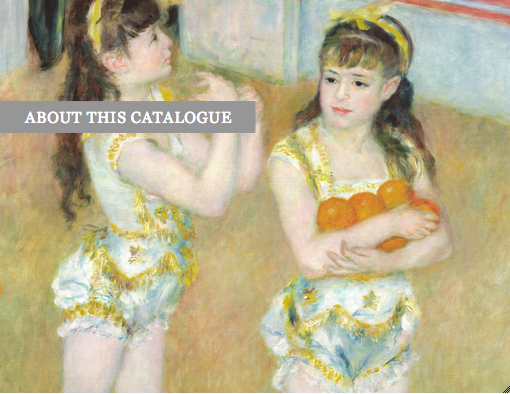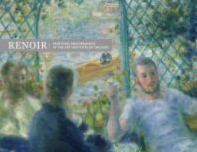

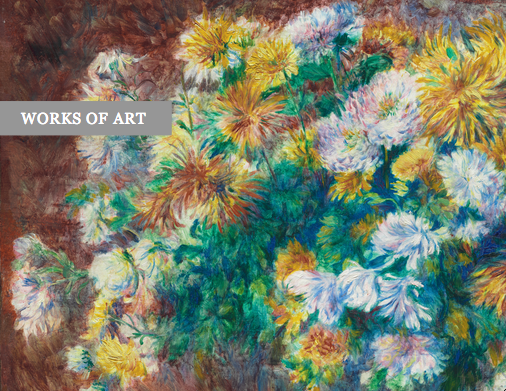
Vase of Flowers
May 1857
Graphite on grayish off-white wove paper; 173 × 103 mm1
The Art Institute of Chicago, gift of Dorothy Braude Edinburg to the Harry B. and Bessie K. Braude Memorial Collection, 2013.1011
This highly detailed study, rather labored in its execution, dates from Renoir’s early career. It stands as evidence of a precocious talent; he was still a teenager at the time it was made. It is unlikely that the young artist viewed the stylized motif firsthand; instead, as was usual in nineteenth-century art practice, he probably worked from a preexisting pattern. Copying was a standard component of artistic training at this time and, a few years after he made this work, Renoir enrolled at the École des Beaux-Arts, where the demand for classes on ornamental drawing had grown considerably.2
It seems that Renoir took considerable care over this sheet, even adding the date. Vase of Flowers is ambitious despite its small scale. The level of detail in the work is remarkable. Though only a sketchbook sheet, the center of the bouquet is highly developed, with each petal or frond differentiated. The container that holds the blooms appears to have two tiers; the second is undeveloped, with only a loose suggestion of further decoration. Renoir used graphite in this particular drawing but, through variance of pressure, he created a range of effects. The faint outer edges, for instance, contrast with the intense heart of the arrangement.
Some of these characteristics—together with the decorative subject matter—point to his training as a painter of ceramics. In 1854, Renoir was apprenticed in a porcelain workshop on the rue des Fossés du Temple3 and purportedly spent four years painting cups and saucers, stopping only to spend his lunchtime at the Musée du Louvre.4 In the current sheet, occasional indentations in the paper, for instance, suggest that he applied the pencil with a steadiness that was surely an asset in his chosen, commercial line of work.
In 1858 (one year after making this drawing), Renoir stopped painting porcelain for a living, as the process had become mechanized and the profession declined. Nevertheless, it is clear that he valued this training, and in later years emphasized the value of apprenticeships. “Painting isn’t about daydreaming,” he complained. “First and foremost it is a manual trade, and one should do it as a good workman.”5 If Renoir’s later works exude leisurely ease, as this little drawing indicates, his virtuosity took years to hone.
Nancy Ireson
Vase of Flowers was executed in [glossary:graphite] on smooth, grayish–off-white [glossary:wove] paper. The smoothness of the paper perfectly suited this detailed composition, enabling the graphite to glide over the surface. The paper was formerly bound in a sketchbook along the bottom, as evidenced by the irregular edge and binding holes (fig. 1.1). Using a relatively hard graphite, Renoir outlined the forms and, with a series of fine parallel lines, modeled the container and the flowers in the foreground (fig. 1.2). Under magnification, the darkest lines reveal a slight embossing—the result of pressing the graphite tip more firmly into the paper. Renoir employed fewer and fewer strokes of graphite as he worked outward from the center of the composition, suggesting the foot of the container with a bare minimum of lines. The drawing technique is direct, with no visible compositional revisions or alterations.
Grayish–off-white, medium-thick, smooth wove paper, taken from a bound sketchbook.6
Uniform, without visible inclusions or colored fibers.
Even, machine made.
The bottom edge was torn from a former binding, producing an irregular edge with folds and creases and four binding holes, spaced 1.1 cm, 2.9 cm, 7.3 cm and 9.1 cm from the left edge. The left, top, and right edges are trimmed straight.
173 × 103 mm.
No artistic surface alterations or coatings are visible under normal conditions or magnification. Under [glossary:UV] illumination, there is a pale-yellow visible-light [glossary:fluorescence] overall on the paper surface that is characteristic of a light gelatin surface [glossary:sizing].
The work was drawn directly in graphite. Examination under magnification reveals that modeling was created with thin strokes of hard graphite; there is no evidence of [glossary:stumping]. Erasure may have been used to create some small areas of highlights on the flowers and their container.
No revisions or changes to the composition are visible under normal conditions or magnification.
No artistic surface fixative or coatings are visible under normal conditions, UV illumination, or magnification. A light gelatin sizing is visible under UV illumination.
The drawing is in very good condition. There is a loss in the upper right corner of the support. Light discoloration is visible overall and is a little more pronounced at the edges. The support lifts slightly upward off the mat at the top and bottom edges. There is light smudging of the graphite medium overall. Mild surface soiling and smudges are evident around the perimeter of the drawing.
On the verso, there is a strip of transparent, colorless adhesive residue along the right edge. The center left edge exhibits a small area of [glossary:skinning].
Kimberly Nichols
Estate of the artist.7
By descent to the artist’s grandson, Paul Renoir (born 1924), Cagnes.8
Paul Renoir, Cagnes, to at least Aug. 1977.9
Consigned by Mrs. J. Trent, Toronto, to Odon Wagner Gallery, Toronto, by 1991.10
Sold by Odon Wagner Gallery, Toronto, through Christie’s, New York, Feb. 14, 1991, lot 2, to Dorothy Braude Edinburg.11
Given by Dorothy Braude Edinburg to the Art Institute of Chicago, 2013.
Turin, Galeria Stefano Pirra, 125 Dessins inédits de Pierre Auguste Renoir, 1971, p. 58 (ill.).
Art Institute of Chicago, Drawings in Dialogue: Old Master through Modern; The Harry B. and Bessie K. Braude Memorial Collection, June 3–July 30, 2006, p. 106, cat. 71 (ill.).
Inscription
Location: right bottom edge
Method: graphite
Content: Mai 1857 (fig. 1.3)
Paper [glossary:support] characteristics identified.
Paper mold characteristics identified.
Light surface sizing detected overall.
Media identified.
The image inventory compiles records of all known images of the artwork on file in the Imaging Department and in the conservation and curatorial files in the Department of Prints and Drawings at the Art Institute of Chicago (fig. 1.4).
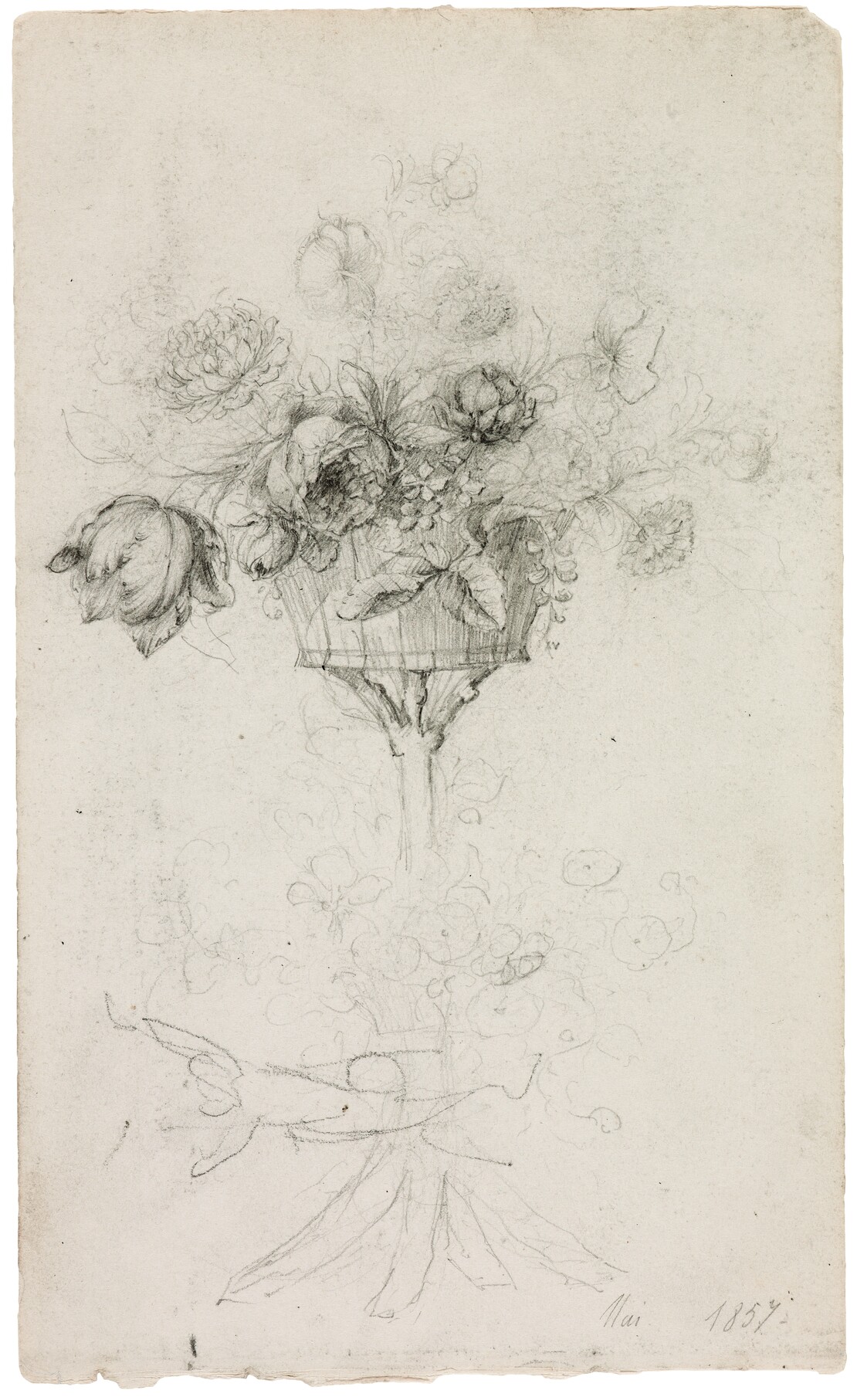
cat. 1 Vase of Flowers, May 1857.
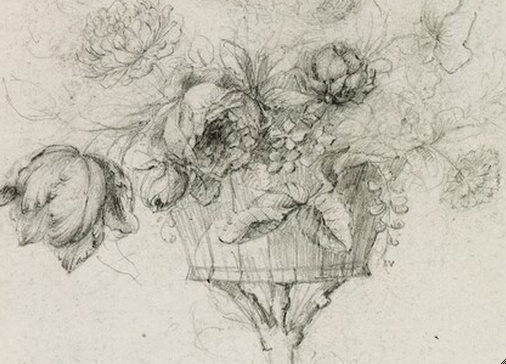
Detail of Renoir’s Vase of Flowers (1857) showing the fine graphite lines. The Art Institute of Chicago, 2013.1011.
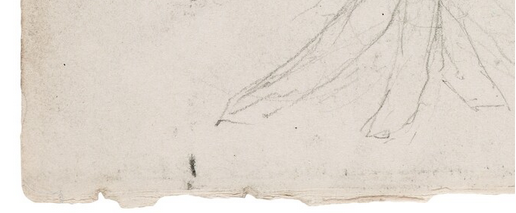
Detail of Renoir’s Vase of Flowers (1857) showing sketchbook binding holes. The Art Institute of Chicago, 2013.1011.

Detail of Renoir’s Vase of Flowers (1857) showing the inscribed date. The Art Institute of Chicago, 2013.1011.

| Loc/Neg# | Format | Purpose | Date | Lighting, Notes |
| 40380 | Digital | Unknown | Recto | |
| G22529 | Digital | Nov. 29, 2004 | Recto | |
| G40580 | Digital | 5-Jul-12 | Recto | |
| Conservation | Digital | OSCI | Dec. 10, 2012 | Recto, detail |
Lunch at the Restaurant Fournaise (The Rowers’ Lunch)12
187513
Oil on canvas; 55 × 65.9 cm (21 5/8 × 25 15/16 in.)
Signed: Renoir. (lower left, in warm-black paint)
The Art Institute of Chicago, Potter Palmer Collection, 1922.437
In this painting, Renoir shows a group of boaters—two oarsmen and a female companion (dressed for the water in blue flannel)—relishing an alfresco lunch. Bottles on a silver tray, fluted wine glasses, and a compote of fruit have been offered for their enjoyment on a brilliant white tablecloth. Judging from the bustle of boating traffic in the background, this is only one of many such groups that took to the waters of the Seine on a summer day, but Renoir transformed this commonplace scene into an idyllic episode of sensuality and pleasure. Lunch at the Restaurant Fournaise was sold to Potter Palmer by Durand-Ruel, New York, on April 9, 1892, with the title Déjeuner de canotiers, just weeks before the May 1 opening of Renoir’s retrospective at the Durand-Ruel in Paris, which included the renowned scene of a boating luncheon along the Seine painted between 1880 and 1881, now in the Phillips Collection in Washington, D.C. (fig. 2.5 [Daulte 379; Dauberville 224]).14 In the catalogue that accompanied the retrospective, the Washington work was given the erroneous title Déjeuner à Bougival.15 Both the Chicago and Washington paintings, however, are set in the restaurant of the Maison Fournaise (fig. 2.6), located on what was then known as the Île du Chiard in the Seine, part of the municipality of Chatou, about one mile farther upriver and north of Bougival. The relationship of subject and site that the two paintings share determined for decades the dating of Lunch at the Restaurant Fournaise to 1879. The earlier date of 1875 came to light in 1986, when the Chicago work was identified as that included in the second Impressionist exhibition held in April 1876. An astute connection was made between the catalogue title Déjeuner chez Fournaise and the snide though accurate description of it as “Tonnelle des Canotiers sans jambes” by the critic of Le soleil.16
With the new dating, Lunch at the Restaurant Fournaise can be placed with a group of paintings thought to be executed during Renoir’s extended stay at the Maison Fournaise in the summer of 1875, which opened an important chapter in his portrayal of boating along the Seine. The other paintings include an interior luncheon or breakfast (fig. 2.7); at least two landscapes, one of a rowing subject (fig. 2.8 [Dauberville 141]) and another showing the nearby bridge at Chatou (Dauberville 136); and portraits of the proprietor of the restaurant, Alphonse Fournaise (fig. 2.9) and his daughter Alphonsine, both of which are dated and share the loose, flowing brushwork that characterizes Lunch at the Restaurant Fournaise.17 Why Renoir was drawn to the Maison Fournaise in the summer of 1875 remains a mystery, as he was no doubt aware of its local fame as a destination for boat rental before that time. His parents lived in Louveciennes just downriver, near Bougival, and he had been painting in the area since the mid-1860s, most significantly in the summer of 1869 at La Grenouillère on the Île de Croissy, where he and Claude Monet completed plein air sketches of visitors and moored boats at the popular restaurant and bathing establishment in preparation for the Salon of 1870.18 Renoir’s interest in the Fournaise establishment came to an end as abruptly as it began. After 1881 he produced no further paintings with Chatou subjects, and his letter to Théodore Duret on Easter Monday of that year, during the execution of Two Sisters (On the Terrace) (cat. 11), was written during his last recorded stay in the town.19 The restaurant and hotel would continue to thrive for many years, gaining celebrity in a short story by Guy de Maupassant as the Restaurant Grillon, a “stronghold of canotiers.”20
Renoir’s earliest depictions of leisure boating date to the 1860s and recall the paintings of Eugène Boudin and Gustave Courbet. In addition to peopling the landscape views of La Grenouillère in 1869 mentioned above, boaters continued to appear elliptically in such works as La promenade (fig. 2.10 [Daulte 55; Dauberville 257]), in which the male protagonist wears a boater’s straw hat decorated with red ribbon, and Bather with a Griffon Dog (fig. 2.11 [Daulte 54; Dauberville 596]), a classically posed scene of modern life that Renoir exhibited at the Salon of 1870, depicting two women who arrived at their secluded bathing spot by rowboat.21 Renoir also took a personal interest in rowing, boating, and regattas, a passion he shared with his Impressionist colleagues.22 In July 1865 he sailed down the Seine with Alfred Sisley’s brother, Henri, and a model from Édouard Manet’s studio to see the regattas at Le Havre, taking his paint box to make sketches along the way. Renoir wrote enthusiastically to his friend the artist Frédéric Bazille to join them in the adventure.23
Renoir’s work alongside Monet on the shores of the Seine at Argenteuil during the summer of 1874 apparently rekindled his interest in depicting leisure life along the river and boating subjects.24 On July 22 Renoir and Monet were joined by Manet, who was summering across the river at Petit-Gennevilliers and also painted a number of pictures of boaters that summer.25 Manet sent one of these, an explicitly Impressionist work with a bright palette depicting a boater and his female companion sitting by the docks, titled Argenteuil (Musée des Beaux-Arts, Tournai), to the Salon in May 1875. It received a lukewarm reception and was caricatured several times in the satiric journal Charivari. One caricature claimed that the pair of boaters had clearly run aground.26
Thus Renoir’s decision to paint at the Restaurant Fournaise in the summer of 1875 was likely informed by his experience the previous summer on the banks of the Seine at Argenteuil and by Manet’s recent attempt to bring Impressionism to the Salon with a boating theme. The question for Renoir was how to make the theme his own: how to break free of Monet’s predominantly landscape example, how to be a figure painter and create a genre scene based in reality but open to broader readings of idyllic leisure. At Fournaise he found ideal subject matter and willing models. Fournaise was a family-run establishment with a long history in the community that attracted a serious sporting clientele, artists, and members of the Parisian theater world, as well as the odd aristocrat seeking the outdoor experience (who was invariably out of place). Its Parisian equivalent was the Moulin de la Galette, the Montmartre dance hall. As Renoir’s close friend and biographer Georges Rivière later commented, “The exuberant rowers and the grisettes who accompanied them resembled the young folk and dancers of Moulin de la Galette; the infectious gaiety of this carefree crowd, boastful without arrogance and mocking without malice, attracted the painter, for whom the spectacle of popular enjoyments had always been of interest.”27
The subjects of boating and dancing shared an association with youthful bohemia and student life during the July Monarchy and inspired many treatments in popular culture, such as vaudeville theater, as early as 1845 (fig. 2.12). Before the expansion of the city during the Second Empire and the extension of the railway in the 1840s and 1850s, Parisians boated for pleasure at Bercy, on the east side of Paris near the current location of the finance ministry (fig. 2.13). Boating at Chatou became popular after the area was made accessible by rail and the land was acquired for commercial development by boatbuilder Alphonse Fournaise in 1857. The terrace upon which Renoir’s models sit for the Washington Luncheon of the Boating Party dates from 1867, when a Neoclassical, two-story, red-brick structure was constructed as a restaurant, a function it still serves today.28 Judging from the point of view of the Chicago Lunch at the Restaurant Fournaise, the tonnelles or arbors were on the first floor under this terrace.
As with many of Renoir’s genre paintings inspired by popular pastimes, the models for Lunch at the Restaurant Fournaise were drawn from his immediate circle of acquaintances and may very well have been habitués of the place in which they are shown. The sunburned figure in the white shirt on the right has never been identified but may have been inspired by Renoir’s younger brother, the journalist Edmond Renoir, who served frequently as a model for his brother during the 1870s (fig. 2.14 [Daulte 319; Dauberville 554]).29 In a series of articles promoting the leisurely pleasures of Bougival and its environs, written for La vie moderne in 1883, Edmond wrote perceptively of boating on the Seine and insisted on extending his survey to Chatou and the Restaurant Fournaise because it reflected the “same world, same joviality, same insouciance.”30 The fact that the figure is sunburned suggests an intentional light mockery of the city dilettante who has forgotten his hat—license that one would expect a sibling of the modern family to take.
François Daulte first identified the figure on the left with the distinctive fan beard as “Monsieur de Lauradour,” a regular at La Grenouillère and the Restaurant Fournaise.31 This model appears in three closely dated Renoir paintings, including a bust portrait (The Rower of Bougival, c. 1876; Kunstmuseum Basel) in the same stipple technique used by the artist in Alfred Sisley (1876; cat. 4).32 Although the nature of their relationship is unclear, Renoir must have been on friendly terms with Lauradour, as at this time he rarely painted portraits of men he did not know.33 The third painting in which Lauradour appears is the Luncheon in the Barnes Collection (fig. 2.7), which is almost certainly an indoor scene set at the Restaurant Fournaise during a cooler time of day, as the woman in the picture wears the same blue dress, but under a white jacket.
That Renoir used the same two models for a complementary theme raises the question of whether the Barnes Luncheon and Lunch at the Restaurant Fournaise were conceived as pendants. Luncheon of the Boating Party is slightly smaller but shares a horizontal format. Significant changes to the number and position of the figures in Lunch at the Restaurant Fournaise suggest that Renoir may have originally intended to include only two people, a male and a female, as in the Barnes Luncheon. Visible in the [glossary:X-ray] (fig. 2.15) is what seems to be the outline of a figure in profile; the shape of the head suggests a woman with her hair pulled up off her neck. Renoir was able to accommodate a second male with his final placement of the female closer to the center of the painting. He thus established a pyramidal arrangement with the woman resting her elbow on the table and the relaxed, smoking oarsman on the right. The pose of the seated figures, together with the perspectival lines of the table, acts to carry the eye diagonally toward a sun-filled river playground, resulting in a superbly balanced composition.
The comparison of Lunch at the Restaurant Fournaise with contemporary caricature reveals that Renoir followed up-to-date trends in sport fashion. Both male models may be identified as rowers by their white costume and the rowboats seen on the river through the trellis. A woman in a skiff near the shoreline wears a blue flannel dress that matches the one worn by the female figure seated at the table.34 In J. Pelcoq’s satiric image of boaters modeling their clothes for the Journal amusant in 1875, a number of male and female costumes for nautical outings are displayed, such as the collarless shirt with buttons and the sleeveless shirt for men, and the half-length jacket for women (fig. 2.16). A more distinguished “outdoor gentleman’s” look “à l’anglaise,” as suggested by the caption, is modeled by the man wearing a dark jacket, wide-collared shirt with lavaliere, and visored cap. Around his waist this figure sports what appears to be a sash. In Renoir’s painting, Lauradour is portrayed in a combination of these fashions, including the collarless shirt, white jacket, and blue sash. Renoir’s bust portrait of Lauradour shows him to be as meticulous about the stylish trim of his moustache and beard as any of the sportsmen in Pelcoq’s illustration. It is worth noting that on the bank to the right of this scene of boaters sits a woman dressed in a jacket and pants—an outfit that would better accommodate outdoor physical activity.
In this relatively small canvas—a no. 15 portrait ([glossary:figure]) standard-size canvas turned horizontally to become a landscape format—Renoir indulged his predilection for pure color. In a remarkably audacious move for the mid-1870s, the artist limited his palette to emphasize the primary colors (see Technical Report). Most distinctive in this regard is the contrasting treatment of the two male boaters. The folds and shadows in the shirt of the smoking figure on the right are rendered in cool blue tones, whereas the trim of Lauradour’s jacket and shirt is entirely yellow. The hair color of the two men is consistent with this yellow/blue color distinction (fig. 2.17). Yellow highlights are found throughout the painting, from the tablecloth and glassware to the flowers, the tree by the water, and the opposite shoreline. Generous application of lead white paint in the men’s shirts, the tablecloth, and the surface of the river behind them contributes to the striking luminosity of the scene (see Palette in the Technical Report). The brushwork of the shirt on the right (fig. 2.18) can be compared to that of the white shirt in the portrait of Alphonse Fournaise (fig. 2.9), in which a flat brush was used to apply the paint and model the folds of the sleeves. In this bold display of color, the blue of the woman’s dress acts as a neutral tone to anchor the composition, while yellow and white encourage movement of the eye over the picture plane.
The abrupt vertical of the trellis, with its flowering vine, divides interior from exterior, relaxation from physical activity—especially the focused task of navigating a boat. The riverscape in the background here functions to keep the active life of water sports at a distance from the main action of a contemplative smoke and casual conversation over an outdoor meal during summer. What we see in the considered composition and execution of Lunch at the Restaurant Fournaise, though based in observed reality of a popular nineteenth-century pastime, has more to do with memory and ideals, with a peaceful utopian existence as envisioned by the artist. Robert Herbert has noted that Lunch at the Restaurant Fournaise “has the air of a fable,” while Richard Brettell has likened it to the fêtes galantes of Jean-Antoine Watteau.35 This is not the place to address the degree to which eighteenth-century art influenced Renoir’s development of the modern genre subject, with its youthful cast of characters in quiet conversation, whose mundane moment of leisure has been infused with a decided sensuality. But Lunch at the Restaurant Fournaise suggests a renewed appreciation of the art of the ancien régime and a revisiting of the pastoral tradition through the eyes of an indefatigable colorist.
John Collins
Renoir’s Lunch at the Restaurant Fournaise (The Rowers’ Lunch) was painted in several [glossary:wet-in-wet] campaigns and shows evidence of a number of compositional changes. The artist began with a [glossary:commercially primed], no. 15 portrait ([glossary:figure]) standard-size [glossary:canvas] turned on its side, onto which he probably added a selective preparatory layer covering specific parts of the compositional area.36 This selective layer has a warmer hue and probably contains added [glossary:oil] medium, which allowed for minimum absorption of subsequent paint layers and provided a warm background off of which Renoir could play the cool colors of the background and water.
There are significant compositional changes in the left half of the composition. [glossary:X-ray] and raking-light images suggest that, in an earlier version of the painting, there was a figure situated in the space between the two individuals who appear on the left in the final composition. Summary [glossary:underdrawing] lines in a dry medium may be related to this figure’s head; additional lines seem to indicate the left side of the trellis opening and the outer curve of the far-left visible figure’s leg, but the nature of these lines is rather intermittent and haphazard. The left side of the original composition seems to have featured only this single figure painted in profile. Heavy brushwork under the far-left visible figure suggests additional changes before the artist executed the forward-facing male figure.
There are also some minor and partially developed alterations to the right side of the canvas. In the X-ray, a curvilinear form beginning just to the right of the figure and continuing through the torso and a second form just below it may suggest elements of the back of a chair. As these elements were abandoned in their early stages, it is unclear how this placement would have affected the posture of the male figure.
Renoir used a limited [glossary:palette], and many of the hues were mixed on the surface of the painting. Instead of carefully blending mixtures before dabbing them onto the surface, the artist appears to have dipped his brush in two or more colors and applied them directly to the canvas, where they exist almost side by side; in other areas, he applied a new color into a still-wet stroke to create this effect. The structure of the paint layers suggests that the painting was probably executed in a limited number of sessions, with each wet-in-wet layer allowed to dry before the next layer was applied. The brushwork ranges from heavily blended and smooth to thick [glossary:impasto], and the heaviest texture appears primarily in the bottom half of the composition. Various small daubs and details, including the highlights on the bottles in the foreground and the small flowers above the figures’ heads, seem to be the final steps of the process.
The multilayer interactive image viewer is designed to facilitate the viewer’s exploration and comparison of the technical images (fig. 2.19).37
Signed: Renoir. (lower left, in warm-black paint)38 (fig. 1.1, fig. 1.2).
Flax (commonly known as linen).39
The original dimensions of the canvas were approximately 54 × 64.7 cm, according to 1971 pretreatment measurements.40 This probably corresponds to a no. 15 portrait (figure) standard-size (65 × 54 cm) canvas, turned horizontally.41
[glossary:Plain weave]. Average [glossary:thread count] (standard deviation): 22.0V (0.9) × 23.9H (0.8) threads/cm. The horizontal threads were determined to correspond to the [glossary:warp] and the vertical threads to the [glossary:weft].42
The canvas has very mild [glossary:cusping] around the edges, especially on the left, corresponding to the placement of the original tacks.
Current stretching: When the painting was lined in 1971, the original dimensions were slightly increased on all sides (see Conservation History).
Original stretching: Based on cusping visible in the X-ray, the original tacks were placed 5–6 cm apart.
Current stretcher: Four-member redwood [glossary:ICA spring stretcher]. Depth: 2.6 cm.
Original stretcher: Five-member keyable stretcher with vertical [glossary:crossbar]. Depth: Approximately 1.8 cm (fig. 2.20).43
Stamp
Location: original canvas (covered by [glossary:lining])
Method: stamp
Content: M_DEFORGE CARPENTIER Sr / COULEURS FINES / ET TOILES [á] PEINDRE / 6 Rue Halevy 6 / PARIS / [. . .] Rue Legendre, 62 [. . .] (fig. 1.3; fig. 1.4)44
Not determined (probably glue).45
The canvas was prepared with commercially applied priming that extends to the edges of the [glossary:tacking margins]. This commercial priming appears to be a single layer, is rather thin and porous (measuring approximately 5–60 µm), and does not completely fill the [glossary:weave] (fig. 2.21).
Renoir appears to have added a selective preparatory layer to parts of the canvas, especially visible in the top half of the composition.46 This selective layer is thicker, smoother, and more medium-rich than the commercial [glossary:ground]; it leaves some of the canvas texture visible. The outer perimeter of this layer has a soft edge, suggesting that it was applied with a brush; however, the overall texture of this layer is very smooth with no discernible brushstrokes (fig. 2.22).
The color of the commercially applied ground appears to be off-white, but it is difficult to determine. While from the surface there is no microscopic evidence of additional pigment particles in this layer, analysis indicates the presence of a small amount of an iron-containing pigment, such as iron oxide red or yellow. This commercial layer is slightly porous and has darkened due to the combined effects of accumulated grime and the saturation of the [glossary:wax-resin lining] material (see Condition Summary and Conservation History). Because of this discoloration, it is difficult to determine what effect this limited amount of colored pigment might have had on the overall tone of this layer.
The selective preparatory layer is slightly tinted to appear warm beige, and dark particles are visible in it under [glossary:stereomicroscopic examination] (fig. 2.23). In some areas, largely in the upper portions of the background, this layer was left exposed by the artist to provide a warm contrast to the cool tones of the river (fig. 2.24).
The commercial ground is predominantly lead white with a significant amount of barium sulfate. There are also small amounts of iron oxide red or yellow, iron-containing aluminosilicates, silica, calcium-based whites, and trace amounts of bone black.47
The selective preparatory layer is also predominantly lead white with iron oxide red or yellow and barium- and calcium-containing compounds. Stereomicroscopic examination of this layer suggests the presence of black or dark-brown particles.48 The [glossary:binder] for both layers is estimated to be oil.49
Infrared examination reveals very summary contour outlines that may relate to compositional elements in the left half of the painting, including the possible outline of a head (visible in the X-ray) located between the two visible figures (see Paint Layer and Technical Summary); the continuation of the vertical line that forms the left side of the trellis opening; and a faint, curved line near the bottom left corner that relates to the outer contour of the far-left visible figure’s leg (fig. 2.25).50
Dry media (chalk or charcoal?) (fig. 2.26).
No compositional changes noted in drawing stage; see Paint Layer.
It seems that Renoir began this composition with the figures, bringing up the background colors around them after they were painted and also after any major compositional changes. This is especially evident in the female figure, which was painted in relatively radio transparent [glossary:pigments] easily penetrated by the X-ray. [glossary:X-radiography] also indicates that landscape elements do not pass under the female figure’s head, and brushstrokes come up to and abruptly end around the figures, creating a kind of halo effect (fig. 2.27). The table in the center seems to be one of the earliest compositional elements, with the figures and much of the background brought in around it.
There is evidence that the artist made significant changes to this composition. Thick, directional brushwork visible in the lower left of the canvas does not match the final composition, suggesting that there are possible pentimenti in this area (fig. 2.28); these changes are clearer in [glossary:raking light] and X-radiography. The X-ray documents what appears to be a profile and head (perhaps corresponding with some of the underdrawing lines) situated between the two visible figures in the left half of the composition (fig. 2.29). The right arm of the figure in profile appears to extend to the table, along a line similar to that of the visible female figure. The thickness of the added paint layers in this area obscures the original colors of the underlying composition, making a clear identification difficult. [glossary:Cross-sectional analysis] in this area indicates that the lower part of the original figure’s costume was a light bluish-white, with areas of reddish and purple highlights, similar in tone to the clothing of the figure on the right side of the painting, but with greater impasto (fig. 2.30).51 The composition appears to have featured only two figures in this early stage: one on the right and one on the left (in profile). Examination of the left side of the painting in raking light calls attention to a ridge of paint that echoes the curved line of this figure’s back (though it is farther to the left). This may indicate movement of the original figure farther to the left or an adjustment to the position of the visible figure on the far left. Examination in raking light also suggests that Renoir painted out original compositional choices on the far left in thick, short, diagonal brushstrokes before he executed the almost forward-facing head of the figure in the final composition (fig. 2.31). The bulk of this original figure, however, does not appear to have been painted out, but merely covered in the process of executing the two visible figures.
Examination in raking light and X-radiography suggest that elements on the right side of the canvas may also have been altered. A horizontal, curvilinear form beginning just to the right of the figure and passing in front of his torso, with a smaller, horizontal element below it, suggests a change in the position of the chair. It is unclear how the placement of the chair would have affected the posture of the figure, and these elements appear to have been abandoned in their early stages (fig. 2.32). In natural light as well as in the X-ray, it appears that the angle of the right arm of this figure was also changed. The elbow was raised and the forearm made narrower in the final paint layers; however, the original position of the elbow is still visible on the surface (fig. 2.33). The exact placement of the figure’s left arm and hand also appear to have been slightly adjusted. Downward directional strokes through the torso as well as the thick strokes of background and [glossary:underpainting] across and around the head may hint at further changes to this figure’s posture.
In the top half of the composition, the background, the initial layers of the water, and the shoreline were painted first. The outline of the trellis opening was established next, followed by the boats and rowers, and finally the trellis and climbing foliage; each layer was allowed to dry before the subsequent elements were executed. Renoir developed the water with heavy, textured brushstrokes and added color throughout the process (generally before the trellis lattice and climbing foliage) (fig. 2.34); however, the initial layers seem relatively thin in most areas, passing under various compositional elements in the top half.
Overall, the paint was largely applied wet-in-wet over a few campaigns, and each layer was allowed to dry between sessions. Most of the colors were mixed directly on the canvas rather than on the palette (fig. 2.35). At times, the artist dipped his brush into two or three separate colors before applying a stroke to the canvas, and swirls of unmixed paint can be seen throughout the work (fig. 2.36).
The soft edges of the objects and figures—at times defined as much by the texture of the brushstroke, a physical ridge of paint, as by the color shift itself—indicate that Renoir alternated between thicker paint applied with a soft brush and more medium-rich or sometimes thinned paint applied with a stiffer brush (fig. 2.37). In some areas, soft, curled peaks of paint call attention not to the application of paint but to the lift of the brush (fig. 2.38). It is also noteworthy that he used medium-rich toning layers, sometimes called glazes. The glazes seem limited to the woman in the dark-blue dress, for which he layered translucent, oil-rich dark reds and greens over an opaque blue-and-white mixture to add tonal nuance and a sense of volume, incorporating pure blue, red lake, yellow, and perhaps black (fig. 2.39). This smoothness is countered by heavy brushwork elsewhere and by the artist’s manipulation of the canvas texture. Despite the smoother texture offered by a thick preparation, the artist accentuated the weave texture in many areas, dragging a loaded brush across the surface and catching only the thread tops (fig. 2.40).
Brushes, mostly soft to medium, flat and round, with strokes up to 1 cm wide.
Analysis indicates the presence of the following pigments:52 lead white, cobalt blue,53 chrome yellow, viridian, emerald green, vermilion, two red lakes, and possibly chrome orange.54
Stereomicroscopic examination of the surface suggests the presence of black.
The observation of a characteristic salmon-colored [glossary:fluorescence] under [glossary:UV] light indicates that Renoir used fluorescing red lake in areas of the female figure’s costume and chair, and mixed it with other colors in the signature and flesh tones (fig. 2.41).55 Cross-sectional analysis reveals that he used a second, nonfluorescing red lake in selected areas of the composition.56
Oil (estimated).57
A [glossary:natural-resin varnish] was removed and replaced with the current [glossary:synthetic varnish] in 1971. Pretreatment photographs of the verso indicate that the natural-resin varnish had penetrated cracks in the paint layer and stained the back of the canvas (fig. 2.42). This suggests that either the natural-resin varnish was applied after the painting had aged, or the work was cleaned in the past, causing partially dissolved varnish and solvent to stain the canvas (see Conservation History). There are residues of the earlier natural-resin varnish around the areas of impasto. Because the paint is medium rich and the artist-applied ground is nonporous, the current [glossary:varnish] has probably had minimal impact on the overall tonality of the painting. The thin, synthetic surface coating only slightly saturates the painting, adds more gloss, and emphasizes the overall texture of the work.
The painting’s condition was first documented in 1921, when it was noted that the darks were cracking.58 In 1971 the painting was cleaned, restretched, lined, and revarnished.59 The 1971 pretreatment condition notes indicate that the work was stretched on a five-member stretcher and had brittle fabric and a discolored varnish. Before the lining was applied, grime and the natural-resin varnish were removed with solvents, while additional overpaint on the right figure’s pants was removed mechanically. The lining process involved facing the work with starch paste, and then adhering a new piece of linen with wax resin. The painting was restretched on a redwood ICA spring stretcher slightly larger than the composition, leaving a small, unpainted border around the perimeter. The changes to the dimensions are as follows: in the pretreatment report, the work measured 21 5/16 × 25 1/2 in., while in the posttreatment report it was listed as 21 5/8 × 25 7/8 in. After the painting had been restretched and the facing removed, it was given three coats of synthetic varnish (an isolating layer of polyvinyl acetate [PVA] AYAA, followed by methacrylate resin L-46, and a final coat of AYAA) and retouched.
The work is in good condition. It is wax-resin lined and attached to a four-member spring stretcher with tacks. The wax resin has saturated the commercial priming layer and, in conjunction with accumulated grime, has altered the ground color from white to taupe, while the heat and pressure of the lining process slightly increased the textural presence of the weave. Due to the thickness of the selective preparatory layer and subsequent paint layers, the overall tonality of the painting does not appear to be affected. Some areas of thinner paint, areas of exposed commercial priming, and thinner areas of artist-applied priming were slightly pushed into the canvas by the pressure and heat of the lining process (microcracking is visible under the microscope). The original tacking margins were flattened when the painting was lined, and much abrasion is present around the original edges of the work. Some of this abrasion, as well as other mild abrasion throughout the work, is likely a result of the prelining cleaning. The restretching increased the dimensions on all sides, leaving an unpainted border almost one-quarter-inch wide around the edges of the composition. The paint layer is in very good condition, with few areas of cracking and localized minor losses. Pronounced cracking is limited to the dark-blue dress of the female figure on the left, where Renoir apparently employed medium-rich glazes. The work has a glossy synthetic varnish, and minor residues of discolored natural-resin varnish are present around areas of impasto.
Kelly Keegan
Current frame (2008): The frame is not original to the painting. It is a French (Paris), mid-nineteenth-century, Neoclassical Revival, cove frame with cabled fluting, acanthus leaves at the miters, and a stepped frieze. The frame has water and oil gilding over red bole on gesso and compo ornament. The ornament and sight molding are selectively burnished; the cove is burnished and retains its original gilding and glue sizing. The pine molding is mitered and joined with angled, dovetailed splines. The molding, from the perimeter to the interior, is guilloche outer molding; cove side; fillet; torus with molded, centered, imbricated laurel-and-berry ornament and acanthus leaves at the miters; fillet; cove with cabled fluting and buds and acanthus leaves at the miters; and stepped frieze in three sections: ribbon and stave followed by fillet, leaf tip followed by fillet and cove, and fillet with cove sight edge (fig. 2.43).60
Previous frame (removed 2008): The painting was previously housed in an American (New York), mid-twentieth-century, French Regency, stylized frame of water-gilt, carved basswood with a décapé finish (fig. 2.44).61
Previous frame (installed by 1933, removed sometime between 1960 and c. 1975): The work was previously housed in a late-nineteenth–early-twentieth-century, Louis XIV Revival, convex frame with deeply recessed cast plaster ornament of alternating flowers and pendent bellflowers, bracketed by foliate scrolls, with acanthus leaves at the miters.62 The frame had water and oil gilding on a dark red-brown bole over gesso and cast plaster. The sides and frieze were burnished, and the ornament was selectively burnished. The gilding was toned with raw umber and a white wash and speckled overall with black and white. The molding was mitered and nailed. The molding, from the perimeter to the interior, was ovolo with leaf-tip ornament; scotia side; convex face with alternating flower and pendent bellflower ornament, bracketed by foliate scrolls, with acanthus leaves at the miters; hollow frieze; ogee with leaf-tip ornament; cove; and fillet with cove sight edge (fig. 2.45).
Kirk Vuillemot
Sold by the artist to Durand-Ruel, Paris, July 8, 1881, for 600 francs.63
Acquired by Alphonse Legrand, Paris, by Nov. 21, 1887.64
Sold by Alphonse Legrand, Paris, to Boussod, Valadon & Cie (Theo van Gogh), Paris, Nov. 21, 1887, for 200 francs.65
Sold by Boussod, Valadon & Cie (Theo van Gogh), Paris, to Guyotin, Paris, Nov. 22, 1887, for 350 francs.66
Sold by Guyotin, Paris, to Durand-Ruel, Paris, Mar. 21, 1892, for 1,300 francs.67
Transferred from Durand-Ruel, Paris, to Durand-Ruel, New York, Mar. 22, 1892.68
Sold by Durand-Ruel, New York, to Potter Palmer, Chicago, Apr. 9, 1892, for $1,100.69
By descent from Potter Palmer (died 1902), Chicago, to the Palmer family.70
Given by the Palmer family to the Art Institute of Chicago, 1922.
Paris, 11, rue Le Peletier, 2e exposition de peinture [second Impressionist exhibition], Apr. 1876, cat. 221, as Déjeûner chez Fournaise.71
Art Institute of Chicago, Paintings from the Collection of Mrs. Potter Palmer, May 10–Nov. 1910, cat. 51, as Breakfast by the river.72
Art Institute of Chicago, “A Century of Progress”: Loan Exhibition of Paintings and Sculpture, May 23–Nov. 1, 1933, cat. 350. (fig. 2.46)73
Philadelphia, Pennsylvania Museum of Art, Manet and Renoir, Nov. 29, 1933–Jan. 1, 1934, no cat. no. (ill.).74
Art Institute of Chicago, “A Century of Progress”: Loan Exhibition of Paintings and Sculpture for 1934, June 1–Oct. 31, 1934, cat. 239.75
Boston, Museum of Fine Arts, Independent Painters of Nineteenth Century Paris, Mar. 15–Apr. 28, 1935, cat. 45 (ill.).
Arts Club of Chicago, Origins of Modern Art, Apr. 2–30, 1940, cat. 13.
Birmingham (Ala.) Museum of Art, Opening Exhibition, Apr. 8–June 3, 1951, no cat. no. (ill.).
New York, Metropolitan Museum of Art, Apr. 4–May 18, 1952, no cat.76
New York, Wildenstein, Olympia’s Progeny: French Impressionist and Post-Impressionist Paintings (1865–1905); Loan Exhibition for the Benefit of the Association for Mentally Ill Children in Manhattan, Inc., Oct. 28–Nov. 27, 1965, cat. 23 (ill.).
Milwaukee Art Center, The Inner Circle, Sept. 15–Oct. 23, 1966, cat. 81 (ill.).
Portland (Ore.) Art Museum, 75 Masterworks: An Exhibition of Paintings in Honor of the Seventy-Fifth Anniversary of the Portland Art Association, 1892–1967, Dec. 12, 1967–Jan. 21, 1968, cat. 13 (ill.).
Art Institute of Chicago, Paintings by Renoir, Feb. 3–Apr. 1, 1973, cat. 28 (ill.).
Manchester, N.H., Currier Gallery of Art, Feb. 18–May 28, 1975, no cat.77
Pasadena, Calif., Norton Simon Museum of Art, Jan. 27–Oct. 31, 1978, no cat.78
Albi, Musée Toulouse-Lautrec, Trésors impressionnistes du Musée de Chicago, June 27–Aug. 31, 1980, cat. 21 (ill.).
London, Hayward Gallery, Renoir, Jan. 30–Apr. 21, 1985, cat. 48 (ill.); Paris, Galeries Nationales du Grand Palais, May 14–Sept. 2, 1985, cat. 47 (ill.); Boston, Museum of Fine Arts, Oct. 9, 1985–Jan. 5, 1986.
Art Institute of Chicago, Tour de France: Paintings, Photographs, Prints, and Drawings from the Collection of the Art Institute of Chicago, Dec. 9, 1989–Mar. 4, 1990, no cat. no. (ill.).
Washington, D.C., Phillips Collection, Impressionists on the Seine: A Celebration of Renoir’s “Luncheon of the Boating Party,” Sept. 21, 1996–Feb. 23, 1997, cat. 40 (ill.).79
Ottawa, National Gallery of Canada, Renoir’s Portraits: Impressions of an Age, June 27–Sept. 14, 1997, not in cat.; Art Institute of Chicago, Oct. 17, 1997–Jan. 4, 1998; Fort Worth, Tex., Kimbell Art Museum, Feb. 8–Apr. 26, 1998 (Chicago only). (fig. 2.47)80
Amsterdam, Van Gogh Museum, Theo van Gogh (1857–1891): Art Dealer, Collector, and Brother of Vincent, June 24–Sept. 5, 1999, cat. 125 (ill.); Paris, Musée d’Orsay, Sept. 27, 1999–Jan. 9, 2000.<
Art Institute of Chicago, Seurat and the Making of “La Grande Jatte,” June 16–Sept. 19, 2004, cat. 107 (ill.).
London, National Gallery, Renoir Landscapes, 1865–1883, Feb. 21–May 20, 2007, cat. 34 (ill.); Ottawa, National Gallery of Canada, June 8–Sept. 9, 2007; Philadelphia Museum of Art, Oct. 4, 2007–Jan. 6, 2008.
Fort Worth, Tex., Kimbell Art Museum, The Impressionists: Master Paintings from the Art Institute of Chicago, June 29–Nov. 2, 2008, cat. 23 (ill.).
Art Institute of Chicago, A Case for Wine: From King Tut to Today, July 11–Sept. 20, 2009, no cat.81
Kunstmuseum Basel, Renoir: Between Bohemia and Bourgeoisie; The Early Years, Apr. 1–Aug. 12, 2012, cat. 40 (ill.).
Catalogue de la 2e exposition de peinture, exh. cat. (Alcan-Lévy, 1876), p. 21, cat. 221.82
Émile Porcheron, “Promenades d’un flâneur: Les impressionnistes,” Le soleil, Apr. 4, 1876, pp. 2–3.83
Art Institute of Chicago, Paintings from the Collection of Mrs. Potter Palmer, exh. cat. (Art Institute of Chicago, 1910), cat. 51.
Art Institute of Chicago, “Library Notes,” Bulletin of the Art Institute of Chicago 15, 5 (Sep.–Oct. 1921), p. 161 (ill.).
Art Institute of Chicago, Handbook of Sculpture, Architecture, and Paintings, pt. 2, Paintings (Art Institute of Chicago, 1922), p. 69, cat. 844.84
Art Institute of Chicago, “Accessions and Loans,” Bulletin of the Art Institute of Chicago 16, 3 (May 1922), p. 47.
Art Institute of Chicago, A Guide to the Paintings in the Permanent Collection (Art Institute of Chicago, 1925), pp. 67 (ill.); 150, cat. 844.85
M. C., “Renoirs in the Institute,” Bulletin of the Art Institute of Chicago 19, 3 (Mar. 1925), p. 33 (ill.).
Julius Meier-Graefe, Renoir (Klinkhardt & Biermann, 1929), p. 124, no. 102 (ill.).
Reginald Howard Wilenski, French Painting (Hale, Cushman & Flint, 1931), p. 262.
Daniel Catton Rich, “The Mrs. L. L. Coburn Collection,” in Exhibition of the Mrs. L. L. Coburn Collection: Modern Paintings and Watercolors, exh. cat. (Art Institute of Chicago, 1932), p. 7.
Art Institute of Chicago, Catalogue of “A Century of Progress”: Exhibition of Paintings and Sculpture; Lent from American Collections, ed. Daniel Catton Rich, 3rd ed., exh. cat. (Art Institute of Chicago, 1933), p. 50, cat. 350.
Daniel Catton Rich, “Französische Impressionisten im Art Institute zu Chicago,” Pantheon: Monatsschrift für Freunde und Sammler der Kunst 11, 3 (Mar. 1933), pp. 77–78. Translated by C. C. H. Drechsel as “French Impressionists in the Art Institute of Chicago,” Pantheon/Cicerone (Mar. 1933), p. 18.
Art Institute of Chicago, “The Rearrangement of the Paintings Galleries,” Bulletin of the Art Institute of Chicago 27, 7 (Dec. 1933), p. 115.
Pennsylvania Museum of Art, “Manet and Renoir,” Pennsylvania Museum Bulletin 29, 158 (Dec. 1933), pp. 16 (ill.), 19.
Art Institute of Chicago, Catalogue of “A Century of Progress”: Exhibition of Paintings and Sculpture, 1934, ed. Daniel Catton Rich, exh. cat. (Art Institute of Chicago, 1934), p. 40, cat. 239.
“Fourteen Notable Modern Paintings,” Fortune 9 (Jan. 1934), p. 33 (ill.).
Art Institute of Chicago, A Brief Illustrated Guide to the Collections (Art Institute of Chicago, 1935), p. 28.86
George Harold Edgell, Independent Painters of Nineteenth Century Paris, exh. cat. (Museum of Fine Arts, Boston, 1935), pp. 30, cat. 45; 73 (ill.).
Arts Club of Chicago, Origins of Modern Art, exh. cat. (Arts Club of Chicago, 1940), cat. 13.
Reginald Howard Wilenski, Modern French Painters (Reynal & Hitchcook, [1940]), p. 338.87
Art Institute of Chicago, “The United States Now an Art Publishing Center,” Bulletin of the Art Institute of Chicago 36, 2 (Feb. 1942), p. 30.
Frederick A. Sweet, “Potter Palmer and the Painting Department,” Bulletin of the Art Institute of Chicago 37, 6 (Nov. 1943), p. 86.
Art Institute of Chicago, An Illustrated Guide to the Collections of the Art Institute of Chicago (Art Institute of Chicago, 1945), p. 36.88
Birmingham (Ala.) Museum of Art, Catalogue of the Opening Exhibition, exh. cat. (Birmingham Museum of Art, 1951), cover (ill.), p. 31.
Dorothy Bridaham, Renoir in the Art Institute of Chicago (Conzett & Huber, 1954), pl. 4.
Art Institute of Chicago, “The Artist Looks at People,” Art Institute of Chicago Quarterly 52, 4 (Dec. 1, 1958), p. 100.
Raymond Cogniat, Le siècle des impressionnistes (Flammarion, 1959), cover (ill.).
Ishbel Ross, Silhouette in Diamonds: The Life of Mrs. Potter Palmer (Harper & Bros., 1960), p. 155.
Art Institute of Chicago, Paintings in the Art Institute of Chicago: A Catalogue of the Picture Collection (Art Institute of Chicago, 1961), pp. 292 (ill.), 396.89
Kermit S. Champa, “Olympia’s Progeny,” in Wildenstein, Olympia’s Progeny: French Impressionist and Post-Impressionist Paintings (1865–1905); Loan Exhibition for the Benefit of the Association for Mentally Ill Children in Manhattan, Inc., exh. cat. (Wildenstein, 1965), n.pag.
Wildenstein, Olympia’s Progeny: French Impressionist and Post-Impressionist Paintings (1865–1905); Loan Exhibition for the Benefit of the Association for Mentally Ill Children in Manhattan, Inc., exh. cat. (Wildenstein, 1965), cat. 23 (ill.).
J. M., “Art Israel: 26 Painters and Sculptors,” Calendar of the Art Institute of Chicago 59, 3 (May 1965), p. 8 (detail).
Milwaukee Art Center, The Inner Circle, exh. cat. (Milwaukee Art Center/Arrow, 1966), cat. 81 (ill.).
Charles C. Cunningham, Instituto de arte de Chicago, El mundo de los museos 2 (Editorial Codex, 1967), pp. 11, ill. 31; 58, fig. 1.
Portland (Ore.) Art Museum, 75 Masterworks: An Exhibition of Paintings in Honor of the Seventy-Fifth Anniversary of the Portland Art Association, 1892–1967, exh. cat. (Portland Art Museum/Graphic Arts Center, [1967]), cat. 13 (ill.).
André Parinaud and Charles C. Cunningham, Art Institute of Chicago, Grands Musées 2 (Hachette-Filipacchi, 1969), pp. 36, fig. 1; 69, no. 31 (ill.).
Charles C. Cunningham and Satoshi Takahashi, Shikago bijutsukan [Art Institute of Chicago], Museums of the World 32 (Kodansha, 1970), pp. 47, pl. 33; 159.
William Gaunt, Impressionism: A Visual History (Praeger, 1970), pp. 236–37, pl. 91.
William Gaunt, The Impressionists (Thames & Hudson, 1970), pp. 236–37, pl. 91; 242; 291.90
John Maxon, The Art Institute of Chicago (Abrams, 1970), p. 86 (ill.).91
François Daulte, Auguste Renoir: Catalogue raisonné de l’oeuvre peint, vol. 1, Figures, 1860–1890 (Durand-Ruel, 1971), pp. 232–33, cat. 305 (ill.).
Elda Fezzi, L’opera completa di Renoir: Nel periodo impressionista, 1869–1883, Classici dell’arte 59 (Rizzoli, 1972), pp. 65, pl. IL; 108–09, cat. 452 (ill.).92
Art Institute of Chicago, Paintings by Renoir, exh. cat. (Art Institute of Chicago, 1973), pp. 24; 84–85, cat. 28 (ill.).
John Rewald, “Theo van Gogh, Goupil, and the Impressionists,” Gazette des beaux-arts 81, 1248 (Jan. 1973), cover (detail); pp. 13, fig. 7; 14; 15.
John Rewald, “Theo van Gogh, Goupil, and the Impressionists—II,” Gazette des beaux-arts 81, 1249 (Feb. 1973), p. 103.
Mike Samuels and Nancy Samuels, Seeing with the Mind’s Eye: The History, Techniques, and Uses of Visualization (Random House, 1975), p. 71 (ill.).
Walter Pach, Auguste Renoir: Leben und Werk (M. DuMont Schauberg, 1976), pp. 115, fig. 51; 173.
Art Institute of Chicago, 100 Masterpieces (Art Institute of Chicago, 1978), pp. 20; 100–01, pl. 56.
Musée Toulouse-Lautrec and Art Institute of Chicago, Trésors impressionnistes du Musée de Chicago, exh. cat. (Musée Toulouse-Lautrec, 1980), pp. 15, no. 21 (ill.); 68.
Art Institute of Chicago, “Subscription Series,” Bulletin of the Art Institute of Chicago 74, 1 (Jan.–Mar. 1980), p. 18 (ill.).
Joel Isaacson, “Impressionism and Journalistic Illustration,” Arts Magazine 56, 10 (June 1982), p. 105, fig. 37.
Hayward Gallery, Galeries Nationales du Grand Palais, Paris, and Museum of Fine Arts, Boston, Renoir, exh. cat. (Réunion des Musées Nationaux, 1985), pp. 166–67, cat. 47 (ill.); 168.
Hayward Gallery, Galeries Nationales du Grand Palais, Paris, and Museum of Fine Arts, Boston, Renoir, exh. cat. (Arts Council of Great Britain, 1985), pp. 94, no. 48 (ill.); 216, no. 48 (ill.); 217.
Denys Sutton, “Renoir’s Kingdom,” Apollo 121, 278 (Apr. 1985), pp. 244; 247, fig. 8.
Charles S. Moffett, ed., with the assistance of Ruth Berson, Barbara Lee Williams, and Fronia E. Wissman, The New Painting: Impressionism, 1874–1886, exh. cat. (Fine Arts Museums of San Francisco, 1986), p. 164.
Richard R. Brettell, French Impressionists (Art Institute of Chicago/Abrams, 1987), pp. 30–31 (detail), 32 (ill.), 119.
Françoise Cachin and Bogomila Welsh-Ovcharov, with the assistance of Monique Nonne, Van Gogh à Paris, exh. cat. (Réunion des Musées Nationaux, 1988), p. 375 (ill.).
Robert L. Herbert, Impressionism: Art, Leisure, and Parisian Society (Yale University Press, 1988), cover (ill.); pp. 246–47, pl. 250; 253.
Raffaele De Grada, Renoir (Giorgio Mondadori, 1989), p. 72, pl. 49.
Gloria Groom and J. Russell Harris, Tour de France: Paintings, Photographs, Prints, and Drawings from the Collection of the Art Institute of Chicago, exh. cat. (Art Institute of Chicago, 1989), fig. 8.
Sophie Monneret, Renoir, Profils de l’art (Chêne, 1989), p. 78, fig. 1.
Martha Kapos, ed., The Impressionists: A Retrospective (Hugh Lauter Levin/Macmillan, 1991), p. 183, pl. 55.
Russell Ash and Bernard Higton, eds., The Impressionists’ River: Views of the Seine (Universe, 1992), p. 12 (ill.).
James Yood, Feasting: A Celebration of Food in Art; Paintings from the Art Institute of Chicago (Art Institute of Chicago/Universe, 1992), pp. 15 (detail); 50–51, pl. 16.
Anne Distel, “Pierre-Auguste Renoir, The Luncheon (Le déjeuner),” in Richard J. Wattenmaker et al., Great French Paintings from the Barnes Foundation: Impressionist, Post-Impressionist, and Early Modern (Knopf/Lincoln University Press, 1993), p. 54, fig. 1.
Anne Distel, Renoir: “Il faut embellir,” Découvertes Gallimard: Peinture 177 (Gallimard/Réunion des Musées Nationaux, 1993), pp. 73 (detail), 169. Translated by Lory Frankel as Renoir: A Sensuous Vision (Thames & Hudson, 1995), pp. 73 (detail), 169.
Art Institute of Chicago, Treasures of 19th- and 20th-Century Painting: The Art Institute of Chicago, with an introduction by James N. Wood (Art Institute of Chicago/Abbeville, 1993), pp. 10, 64 (ill.).
Gerhard Gruitrooy, Renoir: A Master of Impressionism (Todtri, 1994), pp. 47 (ill.), 49, 73.
Tom Frederickson, Culinary Art: Recipes from Great Chicago Restaurants Illustrated with Works of Art from the Collections of the Art Institute of Chicago (Art Institute of Chicago, 1995), p. 17 (ill.).
Ruth Berson, ed., The New Painting: Impressionism, 1874–1886; Documentation, vol. 1, Reviews (Fine Arts Museums of San Francisco/University of Washington Press, 1996), pp. 51, 103.
Ruth Berson, ed., The New Painting: Impressionism, 1874–1886; Documentation, vol. 2, Exhibited Works (Fine Arts Museums of San Francisco/University of Washington Press, 1996), pp. 44–45, 63 (ill.).
Francesca Castellani, Pierre-Auguste Renoir: La vita e l’opera (Mondadori, 1996), p. 129 (ill.).
Stephen Kern, Eyes of Love: The Gaze in English and French Paintings and Novels, 1840–1900 (Reaktion, 1996), pp. 59, ill. 25; 60.
Eliza E. Rathbone, “Renoir’s Luncheon of the Boating Party: Tradition and the New,” in Eliza E. Rathbone, Katherine Rothkopf, Richard R. Brettell, and Charles S. Moffett, Impressionists on the Seine: A Celebration of Renoir’s “Luncheon of the Boating Party,” exh. cat. (Phillips Collection/Counterpoint, 1996), p. 32.
Eliza E. Rathbone, Katherine Rothkopf, Richard R. Brettell, and Charles S. Moffett, Impressionists on the Seine: A Celebration of Renoir’s “Luncheon of the Boating Party,” exh. cat. (Phillips Collection/Counterpoint, 1996), pp. 198, pl. 40; 258.
Katherine Rothkopf, “From Argenteuil to Bougival: Life and Leisure on the Seine, 1868–1882,” in Eliza E. Rathbone, Katherine Rothkopf, Richard R. Brettell, and Charles S. Moffett, Impressionists on the Seine: A Celebration of Renoir’s “Luncheon of the Boating Party,” exh. cat. (Phillips Collection/Counterpoint, 1996), p. 73.
Colin B. Bailey, with the assistance of John B. Collins, Renoir’s Portraits: Impressions of an Age, exh. cat. (National Gallery of Canada/Yale University Press, 1997), pp. 186; 308, n. 8. Translated by Danielle Chaput and Julie Desgagné, with support from Nada Kerpan for the texts by Linda Nochlin, as Les portraits de Renoir: Impressions d’une époque, exh. cat. (Gallimard/Musée des Beaux-Arts du Canada, 1997), pp. 186; 308, n. 8.
Douglas W. Druick, Renoir, Artists in Focus (Art Institute of Chicago/Abrams, 1997), pp. 6; 8 (detail); 27–28; 30; 35; 47–48; 59; 72; 83, pl. 2; 109.
Charlotte Gere and Marina Vaizey, Great Woman Collectors (Philip Wilson/Abrams, 1999), p. 133.
Kawamura Memorial Museum of Art, Miyagi Museum of Art, and Hokkaido Museum of Modern Art, Runowāru ten/Renoir: Modern Eyes, exh. cat. (Hokkaido Shinbunsha, 1999), p. 185, fig. 5.
Chris Stolwijk and Richard Thomson, with a contribution by Sjraar van Heugten, Theo van Gogh (1857–1891): Art Dealer, Collector, and Brother of Vincent, exh. cat. (Van Gogh Museum/Waanders, 1999), p. 216, cat. 125.
Richard Thomson, “Theo van Gogh: An Honest Broker,” in Chris Stolwijk and Richard Thomson, with a contribution by Sjraar van Heugten, Theo van Gogh (1857–1891): Art Dealer, Collector, and Brother of Vincent, exh. cat. (Van Gogh Museum/Waanders, 1999), pp. 123; 125, cat. 125 (ill.).
Art Institute of Chicago, Impressionism and Post-Impressionism in the Art Institute of Chicago, selected by James N. Wood (Art Institute of Chicago/Hudson Hills, 2000), pp. 9, 43, 45 (ill.), 50, 71, 77.
Gilles Néret, Renoir: Painter of Happiness, 1841–1919, trans. Josephine Bacon (Taschen, 2001), p. 130 (ill.).
Sylvie Patin, L’impressionisme (Bibliothèque des Arts, 2002), p. 119.
Christie’s, London, Impressionist and Modern Art Evening Sale, sale cat. (Christie’s, Feb. 3, 2003), p. 31 (ill.).
Robert L. Herbert et al., Seurat and the Making of “La Grande Jatte,” exh. cat. (Art Institute of Chicago/University of California Press, 2004), pp. 112, cat. 107 (ill.); 113; 277.
Norio Shimada, Inshoha bijutsukan [The history of Impressionism] (Shogakukan, 2004), pp. 144–45 (ill.).
Eleanor Dwight, ed., The Letters of Pauline Palmer: A Great Lady of Chicago’s First Family (M. T. Train/Scala, 2005), pp. 301, 302–03 (ill.).
Kyoko Kagawa, Runowaru [Pierre-Auguste Renoir], Seiyo kaiga no kyosho [Great masters of Western art] 4 (Shogakukan, 2006), p. 70 (ill.).
Colin B. Bailey, “‘The Greatest Luminosity, Colour, and Harmony’: Renoir’s Landscapes, 1862–1883,” in Renoir Landscapes, 1865–1883, ed. Colin B. Bailey and Christopher Riopelle, exh. cat. (National Gallery, London, 2007), pp. 58, fig. 38; 59. Translated as Colin B. Bailey, “‘Un maximum de luminosité; de coloration, et d’harmonie”: Les paysages de Renoir, 1862–1883,” in Les paysages de Renoir, 1865–1883, ed. Colin B. Bailey and Christopher Riopelle, trans. Marie-Françoise Dispa, Lise-Éliane Pomier, and Laura Meijer, exh. cat. (National Gallery, London/5 Continents, 2007), pp. 58, fig. 38; 59.
Colin B. Bailey and Christopher Riopelle, eds., Renoir Landscapes, 1865–1883, exh. cat. (National Gallery, London, 2007), pp. 168; 170–71, cat. 34 (ill.); 210; 214. Translated by Marie-Françoise Dispa, Lise-Éliane Pomier, and Laura Meijer as Les paysages de Renoir, 1865–1883, exh. cat. (National Gallery, London/5 Continents, 2007), pp. 168; 170–71, cat. 34 (ill.); 210; 214.
Guy-Patrice Dauberville and Michel Dauberville, with the collaboration of Camille Frémontier-Murphy, Renoir: Catalogue raisonné des tableaux, pastels, dessins et aquarelles, vol. 1, 1858–1881 (Bernheim-Jeune, 2007), p. 262, cat. 218 (ill.).
Robert McDonald Parker, “Topographical Chronology 1860–1883,” in Renoir Landscapes, 1865–1883, ed. Colin B. Bailey and Christopher Riopelle, exh. cat. (National Gallery, London, 2007), p. 275. Translated as Robert McDonald Parker, “Chronologie,” in Les paysages de Renoir, 1865–1883, ed. Colin B. Bailey and Christopher Riopelle, trans. Marie-Françoise Dispa, Lise-Éliane Pomier, and Laura Meijer, exh. cat. (National Gallery, London/5 Continents, 2007), p. 275.
Peter Bürger, “Media Differences: Caillebotte and Maupassant as Storytellers,” in Anne Birgitte Fonsmark, Dorothee Hansen, and Gry Hedin, Gustave Caillebotte, exh. cat. (Hatje Cantz, 2008), pp. 24; 25, fig. 3.
Gloria Groom and Douglas Druick, with the assistance of Dorota Chudzicka and Jill Shaw, The Impressionists: Master Paintings from the Art Institute of Chicago, exh. cat. (Art Institute of Chicago/Kimbell Art Museum, 2008), cover (detail); pp. 20 (ill.); 64–65, cat. 23 (ill.); 73; 111. Simultaneously published as Gloria Groom and Douglas Druick, with the assistance of Dorota Chudzicka and Jill Shaw, The Age of Impressionism at the Art Institute of Chicago (Art Institute of Chicago/Yale University Press, 2008), front cover (detail); pp. 20 (ill.); 64–65, cat. 23 (ill.); 73; 111.93
Anne Distel, Renoir (Citadelles & Mazenod, 2009), pp. 118–19, ill. 101; 190; 192.
Adrien Goetz, Comment Regarder . . . Renoir (Hazan, 2009), pp. 160–61 (ill.).
John House, The Genius of Renoir: Paintings from the Clark, with an essay by James A. Ganz, exh. cat. (Sterling and Francine Clark Art Institute/Museo Nacional del Prado/Yale University Press, 2010), p. 59.
John House, “Catalogue 4: Luncheon (Le Déjeuner),” in Martha Lucy and John House, Renoir in the Barnes Foundation (Barnes Foundation/Yale University Press, 2012), p. 75, fig. 1.
Stefanie Manthey, “Chronology,” in Renoir: Between Bohemia and Bourgeoisie; The Early Years, ed. Nina Zimmer, exh. cat. (Kunstmuseum Basel/Hatje Cantz, 2012), p. 286.
Stefanie Manthey and Nina Zimmer, “Catalogue of Exhibited Works,” in Renoir: Between Bohemia and Bourgeoisie; The Early Years, ed. Nina Zimmer, exh. cat. (Kunstmuseum Basel/Hatje Cantz, 2012), pp. 114–15; 200–01, cat. 40 (ill.).
Christopher Lloyd, “Coastal Adventures, Riparian Pleasures: The Impressionists and Boating,” in Christopher Lloyd, Daniel Charles, and Phillip Dennis Cate, with a contribution by Giles Chardeau, Impressionists on the Water, exh. cat. (Fine Arts Museums of San Francisco/Skira Rizzoli, 2013), pp. 28; 29, ill. 24.
Inventory number
Stock Durand-Ruel Paris 2064, Livre de stock Paris 189194
Inventory number
Stock Durand-Ruel New York 932, Livre de stock New York 1888–9395
Inventory number
Stock Boussod, Valadon & Cie Paris 18877
Stock book 12, 1887–189197
Stamp
Location: verso of original canvas (covered by lining)
Method: stamp
Content: M_DEFORGE CARPENTIER Sr / COULEURS FINES / ET TOILES [á] PEINDRE / 6 Rue Halevy 6 / PARIS / [. . .] Rue Legendre, 62 [. . .] (fig. 2.49, fig. 2.50, fig. 2.51)98
Label
Location: original stretcher (discarded); preserved in conservation file
Method: handwritten script on printed label
Content: DURAND-RUEL / PARIS, 16, Rue Laffitte / NEW YORK, 315 Fifth Avenue / Renoir No. 932 / déjeuner de canotiers / Moss (fig. 2.48)
Label
Location: original stretcher (discarded), 1969 photograph in conservation file
Method: handwritten script on printed label
Content: [DURA]ND-RUEL / PA[RIS], 16, Rue Laffitte / NEW-Y[ORK], 315, Fifth avenu[e] / [. . .] No. [. . .] / [. . .] Canotiers / nsss (fig. 2.52)
Number
Location: original stretcher (discarded), 1969 photograph in conservation file
Method: handwritten script
Content: [2]2.437 (fig. 2.53)
Number
Location: original stretcher (discarded), 1969 photograph in conservation file99
Method: handwritten script
Content: 565 (fig. 2.54)
Stamp
Location: previous frame (removed), transcribed in curatorial file
Method: unknown
Content: 2987
Label
Location: [glossary:backing board]
Method: printed label
Content: THE NATIONAL GALLERY / Trafalgar Square, London WC2N 5DN / Telephone 020 7839 3321 / Exhibition: Renoir Landscapes 1865–1881 / Venue(s): The National Gallery (London) 21/02/2007 to 20/05/2007 / National Gallery of Canada 08/06/2007 to 09/09/2007 / Philadelphia Museum of Art 30/09/2007 to 06/01/2008 / Number: X5651 Cat No: 34 / Artist: Pierre-Auguste RENOIR / Title: Luncheon at La Fournaise / Credit Line: The Art Institute of Chicago, Potter Palmer Collection, 1922.437 (fig. 2.55)
Label
Location: backing board
Method: printed label
Content: THE ART INSTITUTE OF CHICAGO / artist Pierre Auguste Renoir / title The Rowers Lunch / medium oil on cavas [sic] / credit Potter Palmer Collection / acc. # 1922.437 / LZ-341-001 1M 1/90 (Rev. 1/90) (fig. 2.56)
Label
Location: backing board
Method: printed label with handwritten script and stamp
Content: [logo] Réunion des musées nationaux Paris / THEO VAN GOGH / Musée d’Orsay / 27 septembre 1999–10 janvier 2000 / Titre de l’œuvre: Pierre Auguste Renoir, Les Canotiers / Propriétaire: Chicago, The Art Institute of Chicago / No du Catalogue: 64 (fig. 2.57)
Label
Location: backing board
Method: printed label
Content: The Phillips Collection / America’s first museum of modern art / 1600 21st Street NW Washington, D.C. 20009-1090 / Impressionists on the Seine: A Celebration / of Renoir’s “Luncheon of the Boating Party” / September 21, 1996–February 9, 1997 / Artist Renoir / Title The Rowers’ Lunch / Date 1875 / Medium oil on canvas / Dimensions 21 5/8 x 25 7/8 in. (55.1 × 65.9 cm) / Lender Art Institute of Chicago / Reg # 1996.53.2 Plate # 40 (fig. 2.58)
Westinghouse X-ray unit, scanned on Epson Expressions 10000XL flatbed scanner. Scans were digitally composited by Robert G. Erdmann, University of Arizona.
Inframetrics Infracam with 1.5–1.73 µm filter; Fujifilm S5 Pro with X-Nite 1000B/2 mm filter (1.0–1.1 µm); Goodrich/Sensors Unlimited SU640SDV-1.7RT with H filter (1.1–1.4 µm) and J filter (1.5–1.7 µm).
Fujifilm S5 Pro with X-Nite 1000B/2 mm filter (1.0–1.1 µm).
Natural-light, raking-light, and [glossary:transmitted-light] overalls and macrophotography: Fujifilm S5 Pro with X-NiteCC1 filter.
Fujifilm S5 Pro with X-NiteCC1 filter and Kodak Wratten 2E filter.
Sinar P3 camera with Sinarback eVolution 75 H (B+W 486 UV/IR cut MRC filter).
Sample and cross-sectional analysis were performed using a Zeiss Axioplan 2 research microscope equipped with reflected light/[glossary:UV fluorescence] and a Zeiss AxioCam MRc5 digital camera. Types of illumination used: [glossary:darkfield], differential interference contrast ([glossary:DIC]), and UV. In situ photomicrographs were taken with a Wild Heerbrugg M7A StereoZoom microscope fitted with an Olympus DP71 microscope digital camera.
Several spots on the painting were analyzed in situ with a Bruker/Keymaster TRACeR III-V with rhodium tube.
Zeiss Universal research microscope.
[glossary:Cross sections] were analyzed after carbon coating with a Hitachi S-3400N-II VP-SEM with an Oxford EDS and a Hitachi solid-state [glossary:BSE] detector. Analysis was performed at the Northwestern University Atomic and Nanoscale Characterization Experimental (NUANCE) Center, Electron Probe Instrumentation Center (EPIC) facility.
Thread count and weave information were determined by Thread Count Automation Project software.100
Overlay images were registered using a novel image-based algorithm developed by Damon M. Conover (GW), Dr. John K. Delaney (GW, NGA), and Murray H. Loew (GW) of the George Washington University’s School of Engineering and Applied Science and the National Gallery of Art, Washington, D.C.101
The image inventory compiles records of all known images of the artwork on file in the Conservation Department, the Imaging Department, and the Department of Medieval to Modern European Painting and Sculpture at the Art Institute of Chicago (fig. 2.59).
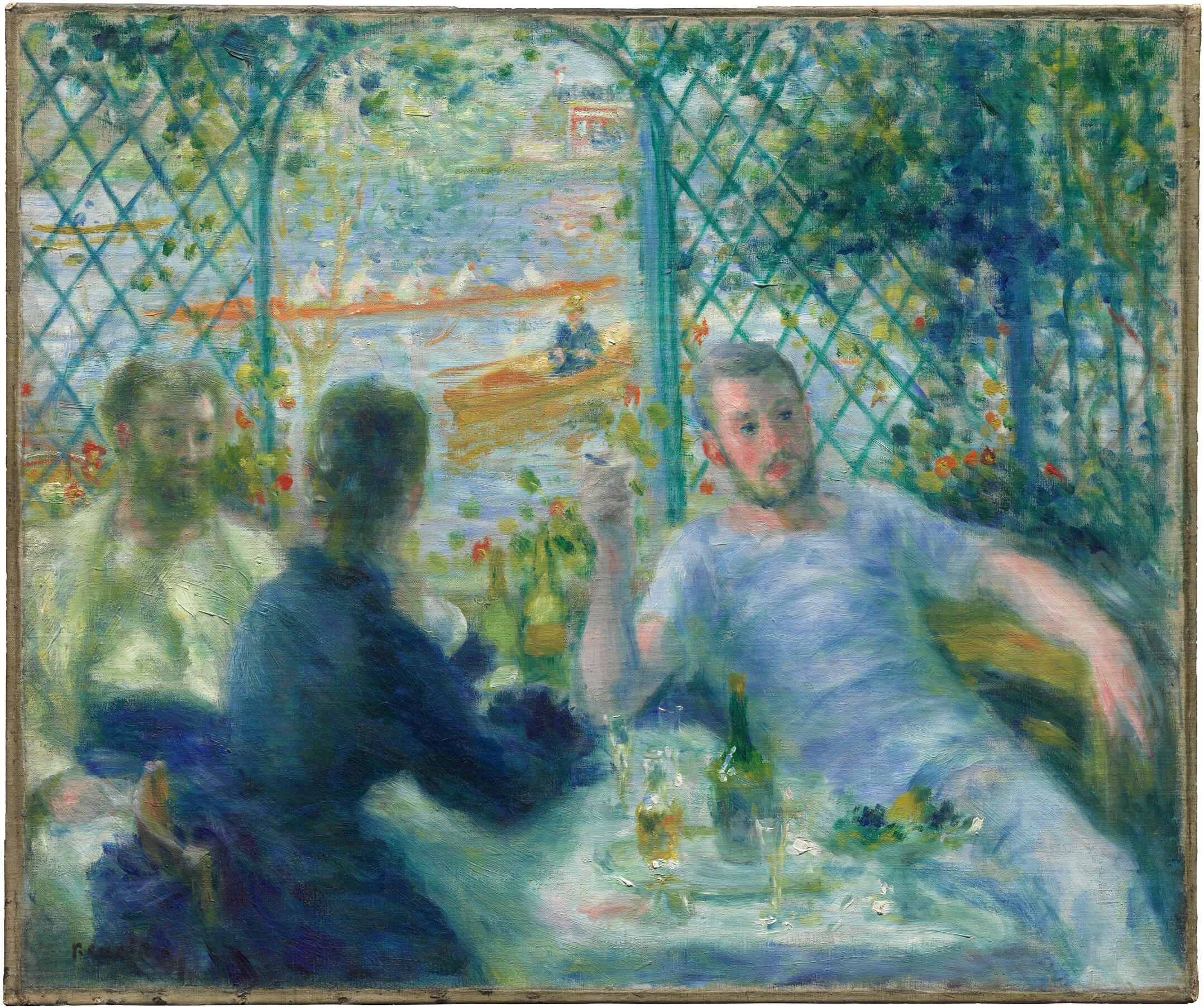
cat. 2 Lunch at the Restaurant Fournaise (The Rowers’ Lunch), 1875.
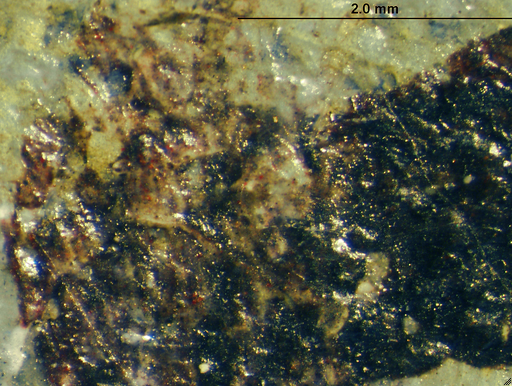
Photomicrograph of the signature in Renoir’s Lunch at the Restaurant Fournaise (The Rowers’ Lunch) (1875) showing the mixture of black and red lake pigments. The Art Institute of Chicago, 1922.437.
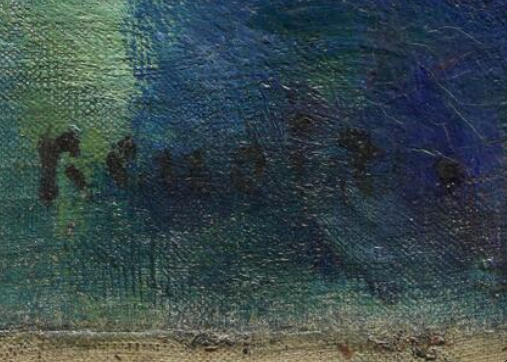
Detail of the signature in Renoir’s Lunch at the Restaurant Fournaise (The Rowers’ Lunch) (1875). The Art Institute of Chicago, 1922.437.
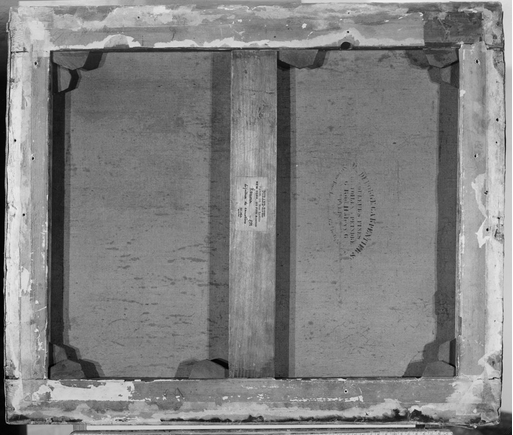
Pretreatment image from 1971 of the verso of Renoir’s Lunch at the Restaurant Fournaise (The Rowers’ Lunch) (1875) showing the original stretcher. The Art Institute of Chicago, 1922.437.
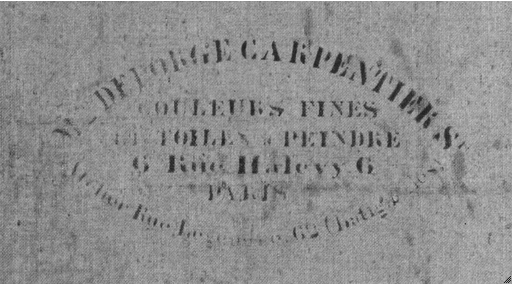
Detail of the verso of the canvas of Renoir’s Lunch at the Restaurant Fournaise (The Rowers’ Lunch) (1875), from a 1971 pretreatment image. The Art Institute of Chicago, 1922.437.
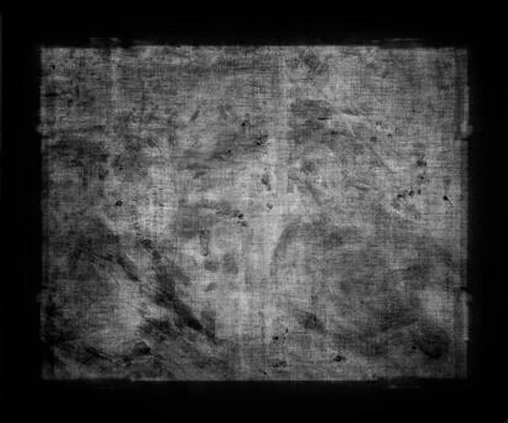
Transmitted-infrared (Fuji, 1.0–1.1 µm) image of Renoir’s Lunch at the Restaurant Fournaise (The Rowers’ Lunch) (1875). The Carpentier canvas stamp on the verso is visible at left. The Art Institute of Chicago, 1922.437.
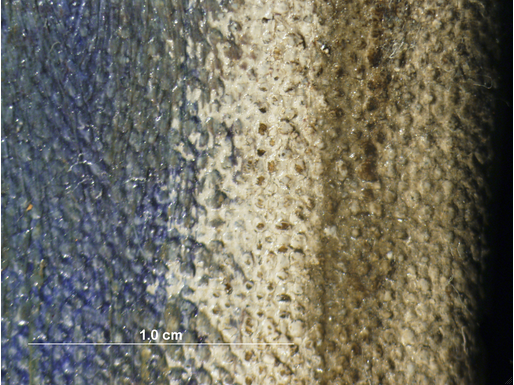
Photomicrograph of the right edge of Renoir’s Lunch at the Restaurant Fournaise (The Rowers’ Lunch) (1875) showing the edge of the artist-applied ground. The Art Institute of Chicago, 1922.437.
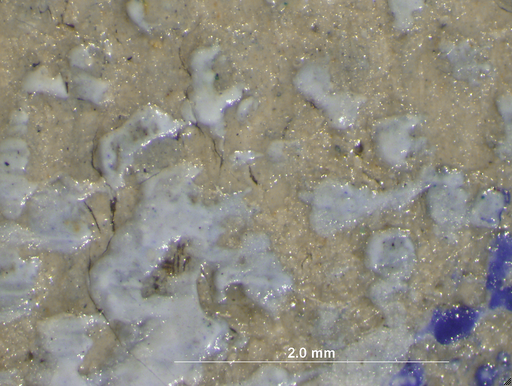
Photomicrograph of the background in Renoir’s Lunch at the Restaurant Fournaise (The Rowers’ Lunch) (1875). The tint of the ground is especially apparent when it is seen next to white paint. The Art Institute of Chicago, 1922.437.
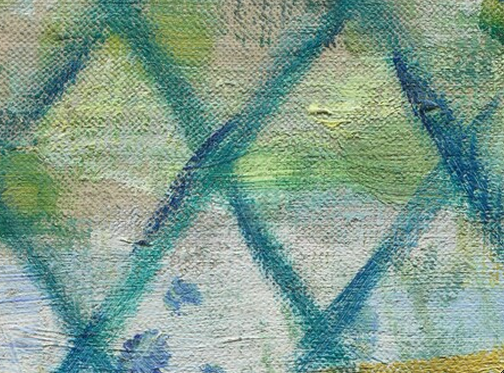
Detail of the background in Renoir’s Lunch at the Restaurant Fournaise (The Rowers’ Lunch) (1875) showing an area of exposed ground and the artist’s exaggeration of the canvas texture. The Art Institute of Chicago, 1922.437.
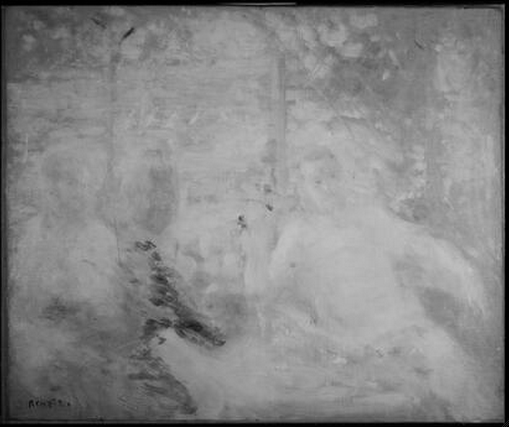
Infrared reflectogram (Fuji, 1.0–1.1 µm) of Renoir’s Lunch at the Restaurant Fournaise (The Rowers’ Lunch) (1875). The Art Institute of Chicago, 1922.437.
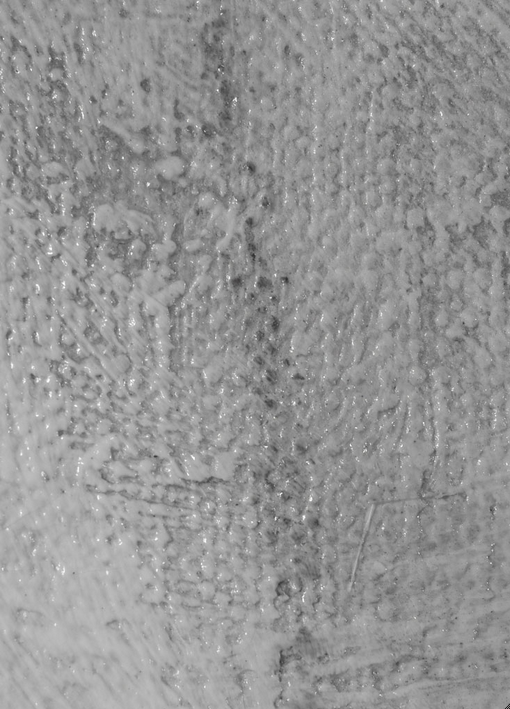
Infrared-reflectogram (Fuji, 1.0–1.1 µm) detail of Renoir’s Lunch at the Restaurant Fournaise (The Rowers’ Lunch) (1875) showing the media used for the underdrawing. The Art Institute of Chicago, 1922.437.
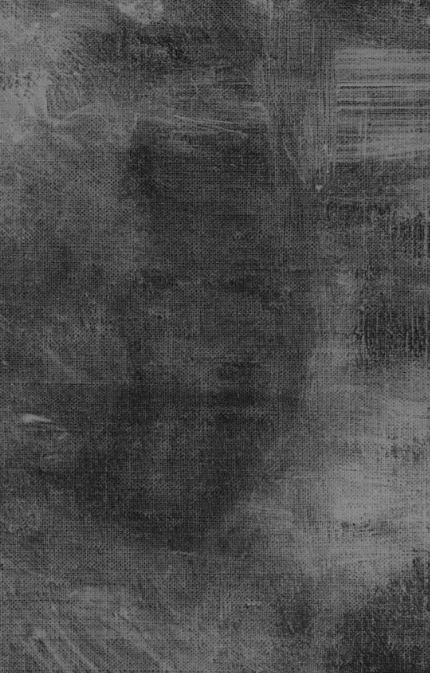
X-ray detail of Renoir’s Lunch at the Restaurant Fournaise (The Rowers’ Lunch) (1875) showing the background paint coming up to and around the currently visible female figure’s head. The Art Institute of Chicago, 1922.437. X-ray digitally composited by Robert G. Erdmann, University of Arizona.
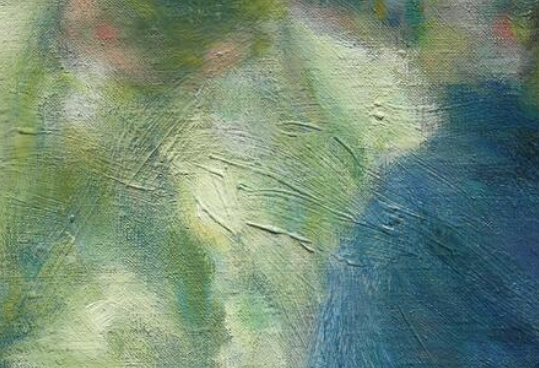
Detail of the bottom left quadrant of Renoir’s Lunch at the Restaurant Fournaise (The Rowers’ Lunch) (1875). Heavy brushstrokes from the earlier figure are visible under normal viewing conditions. The Art Institute of Chicago, 1922.437.
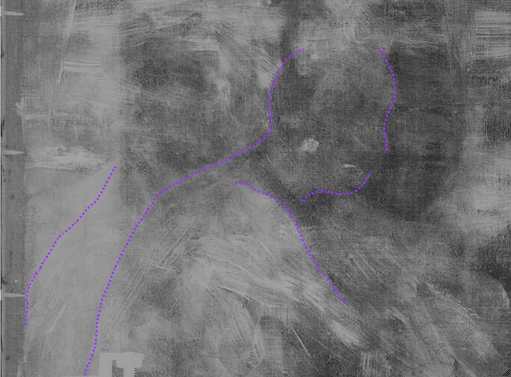
X-ray, raking-light, and natural-light details of the figures on the left in Renoir’s Lunch at the Restaurant Fournaise (The Rowers’ Lunch) (1875). The Art Institute of Chicago, 1922.437. Interactive image.
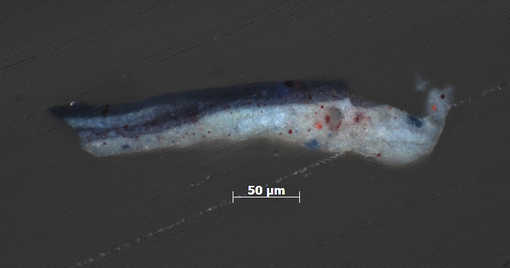
Photomicrograph of a cross section from Renoir’s Lunch at the Restaurant Fournaise (The Rowers’ Lunch) (1875) showing the lighter blue from the earlier figure’s costume below the currently visible dark blue. Original magnification 200×. The Art Institute of Chicago, 1922.437.
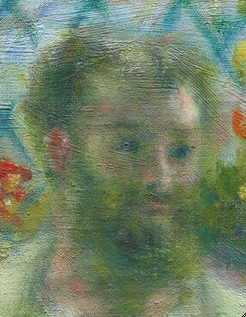
Detail of the far left figure in Renoir’s Lunch at the Restaurant Fournaise (The Rowers’ Lunch) (1875) showing heavy underlying brushwork where the artist painted out previous compositional choices. The Art Institute of Chicago, 1922.437.
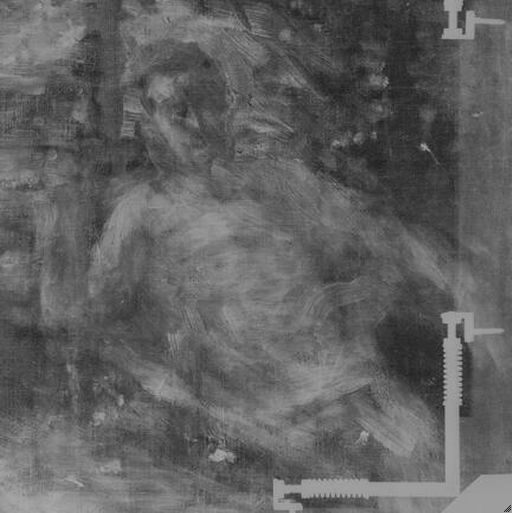
X-ray and natural-light details of Renoir’s Lunch at the Restaurant Fournaise (The Rowers’ Lunch) (1875) showing changes to the figure on the right. The Art Institute of Chicago, 1922.437. Interactive image.
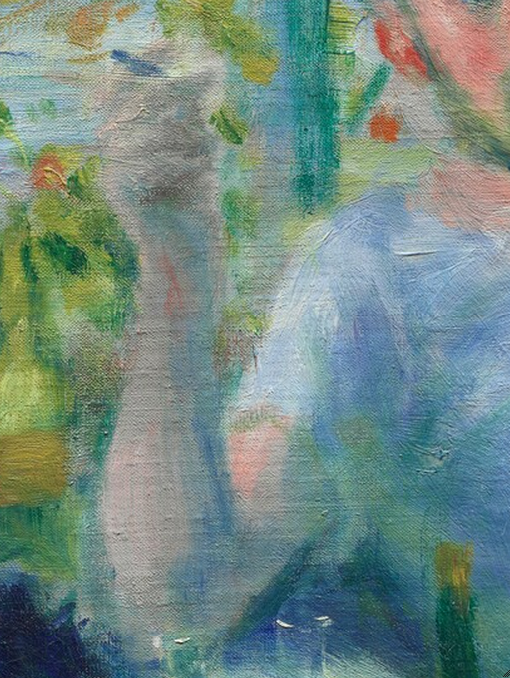
Detail of the hand and arm of the figure on the right in Renoir’s Lunch at the Restaurant Fournaise (The Rowers’ Lunch) (1875). The Art Institute of Chicago, 1922.437.
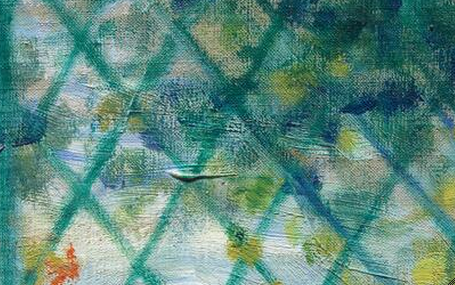
Detail of the background in Renoir’s Lunch at the Restaurant Fournaise (The Rowers’ Lunch) (1875) showing thick strokes of the water under the trellis and foliage. The Art Institute of Chicago, 1922.437.
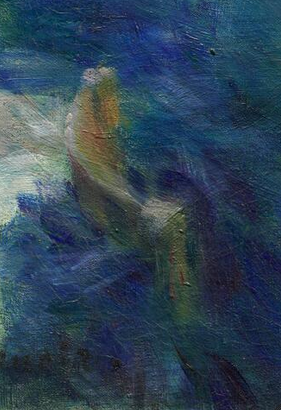
Detail of the chair on the left in Renoir’s Lunch at the Restaurant Fournaise (The Rowers’ Lunch) (1875) showing wet-in-wet paint mixing. The Art Institute of Chicago, 1922.437.
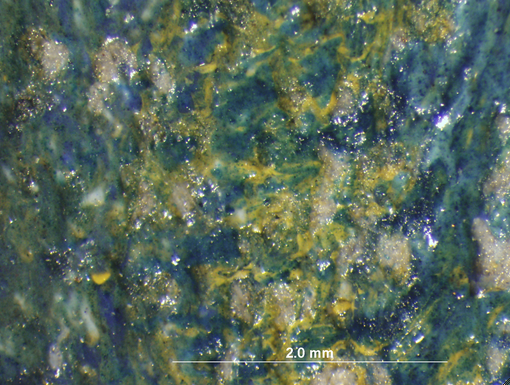
Detail of the foliage in the upper right of Renoir’s Lunch at the Restaurant Fournaise (The Rowers’ Lunch) (1875). The Art Institute of Chicago, 1922.437.
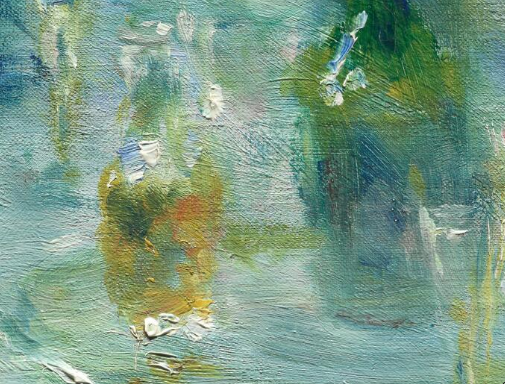
Detail of the bottles and glassware in Renoir’s Lunch at the Restaurant Fournaise (The Rowers’ Lunch) (1875). The Art Institute of Chicago, 1922.437.
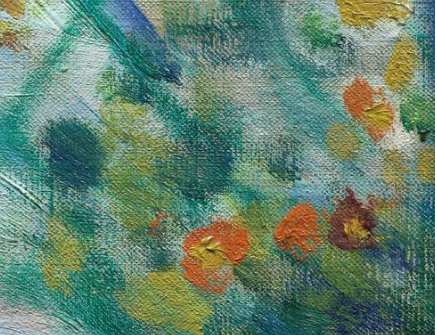
Detail of the flowers on the trellis in Renoir’s Lunch at the Restaurant Fournaise (The Rowers’ Lunch) (1875). The Art Institute of Chicago, 1922.437.
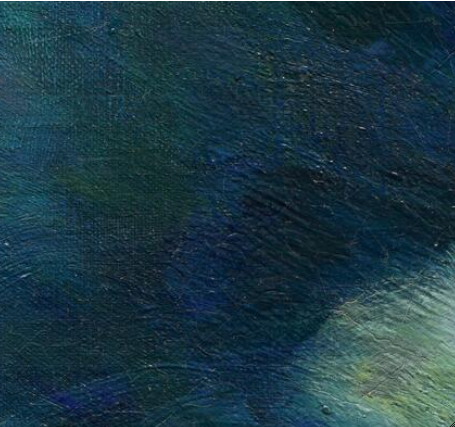
Detail of the female figure’s dress in Renoir’s Lunch at the Restaurant Fournaise (The Rowers’ Lunch) (1875) showing the artist’s use of medium-rich, glaze-like paint. The Art Institute of Chicago, 1922.437.
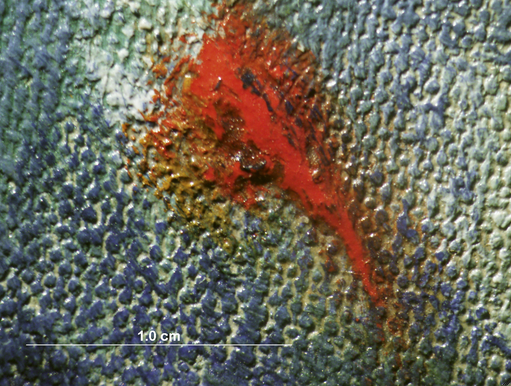
Detail of the background in Renoir’s Lunch at the Restaurant Fournaise (The Rowers’ Lunch) (1875) showing the artist’s manipulation of the canvas texture. The Art Institute of Chicago, 1922.437.
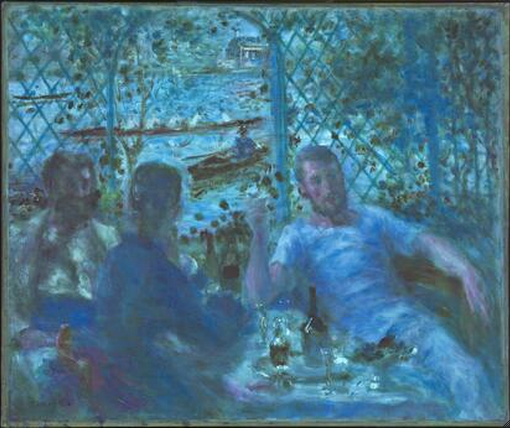
Ultraviolet image of Renoir’s Lunch at the Restaurant Fournaise (The Rowers’ Lunch) (1875). Fluorescing red lakes can be seen in the female figure’s costume and in the signature and flesh tones. The Art Institute of Chicago, 1922.437.
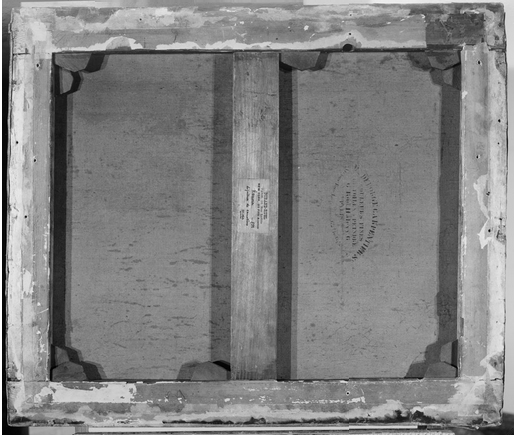
Pretreatment image from 1971 of the verso of Renoir’s Lunch at the Restaurant Fournaise (The Rowers’ Lunch) (1875) showing the original stretcher. The Art Institute of Chicago, 1922.437.
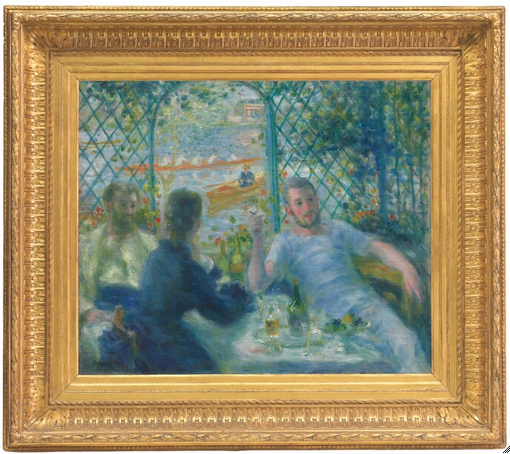
Renoir’s Lunch at the Restaurant Fournaise (The Rowers’ Lunch) (1875) in its current frame. The Art Institute of Chicago, 1922.437.
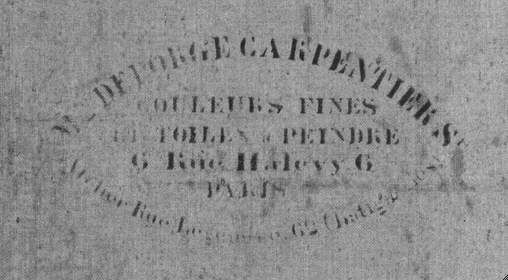
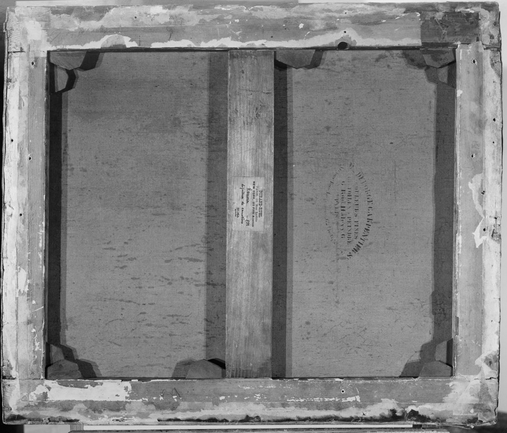
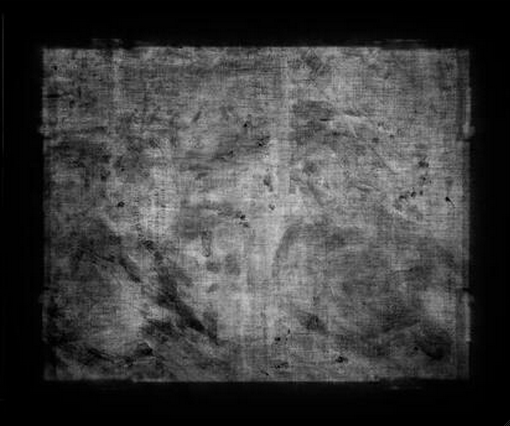
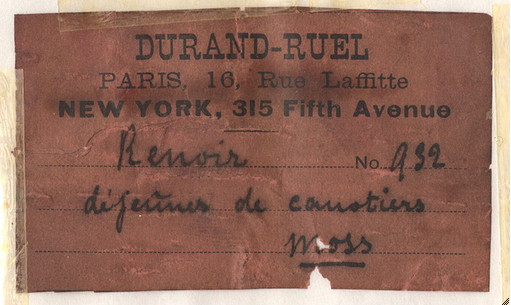
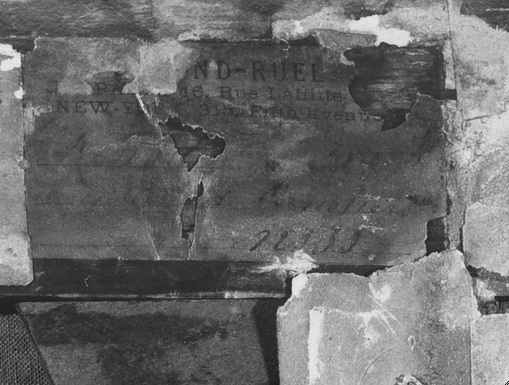
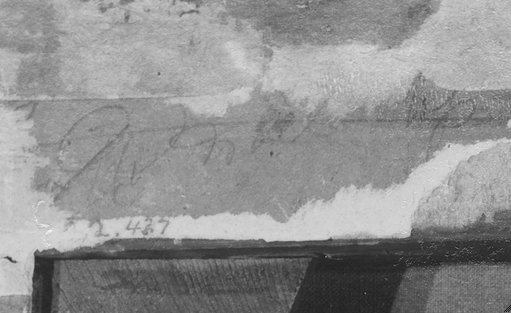
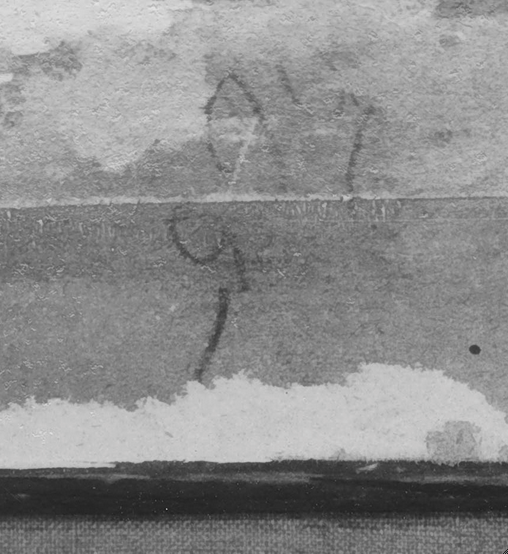
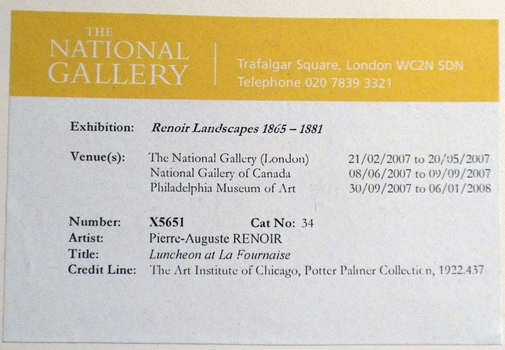
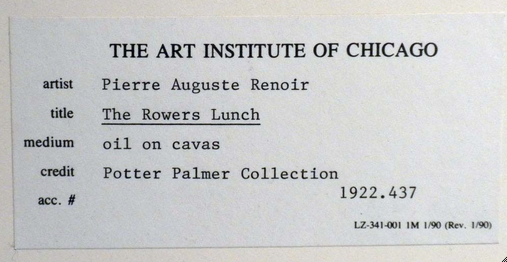
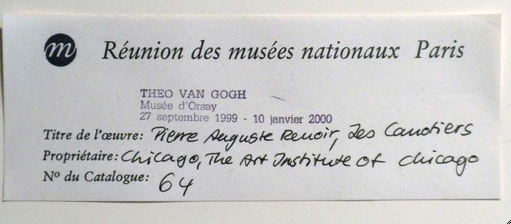
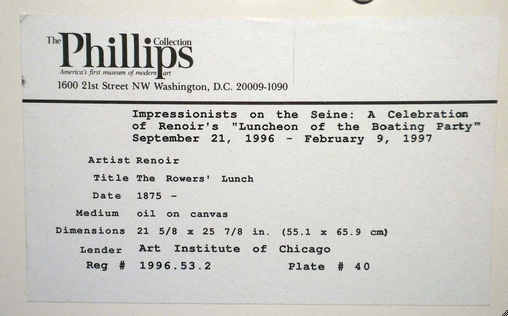
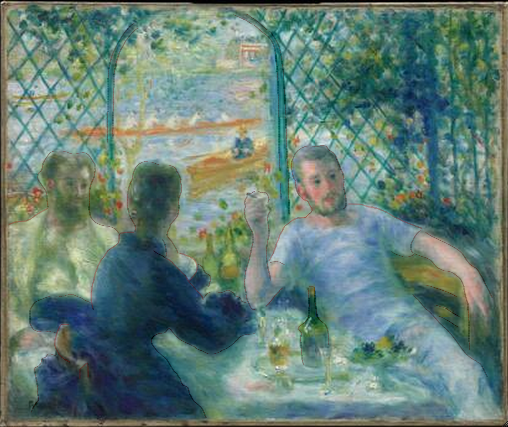
Renoir’s Lunch at the Restaurant Fournaise (The Rowers’ Lunch) (1875). The Art Institute of Chicago, 1922.437. Interactive image.
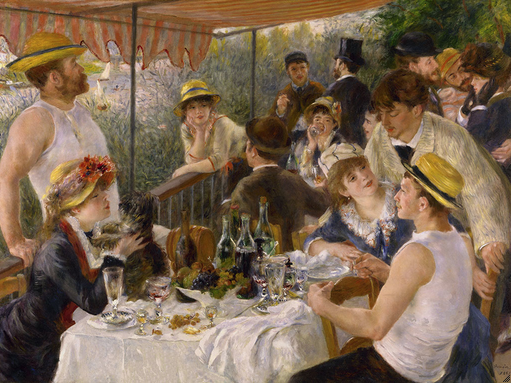
Pierre-Auguste Renoir (French, 1841–1919). Luncheon of the Boating Party, 1880–81. Oil on canvas; 130.2 × 175.6 cm (51 1/4 × 68 1/8 in.). The Phillips Collection, Washington, D.C., acquired 1923, 1637. Bridgeman Images.
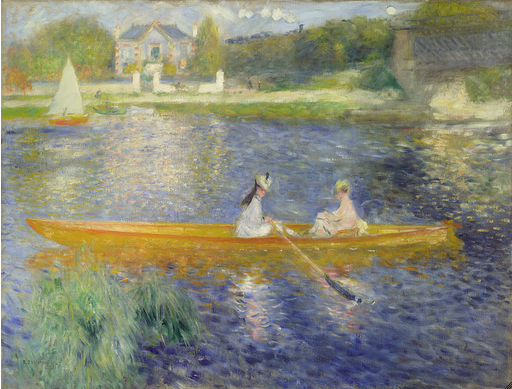
Pierre-Auguste Renoir (French, 1841–1919). The Skiff (La yole), 1875. Oil on canvas; 71 × 92 cm (16 1/8 × 36 1/4 in.). The National Gallery, London, NG 6478. © National Gallery, London/Art Resource, NY.
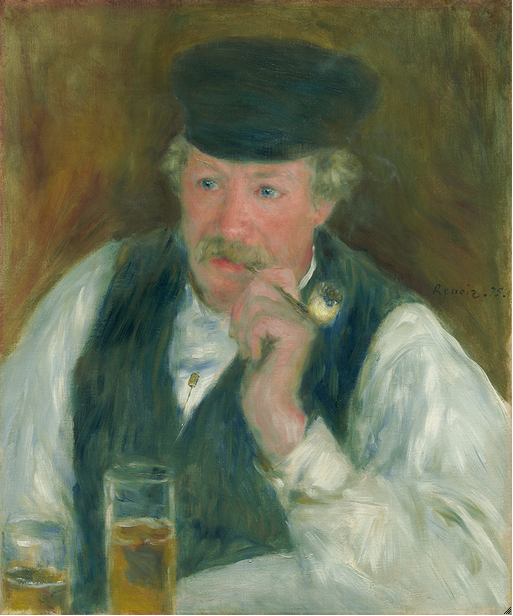
Pierre-Auguste Renoir (French, 1841–1919). Monsieur Fournaise (Man with a Pipe), 1875. Oil on canvas; 55.9 × 47 cm (22 × 18 1/2 in.). Sterling and Francine Clark Art Institute, Williamstown, Mass., 1955.55. The Bridgeman Art Library.
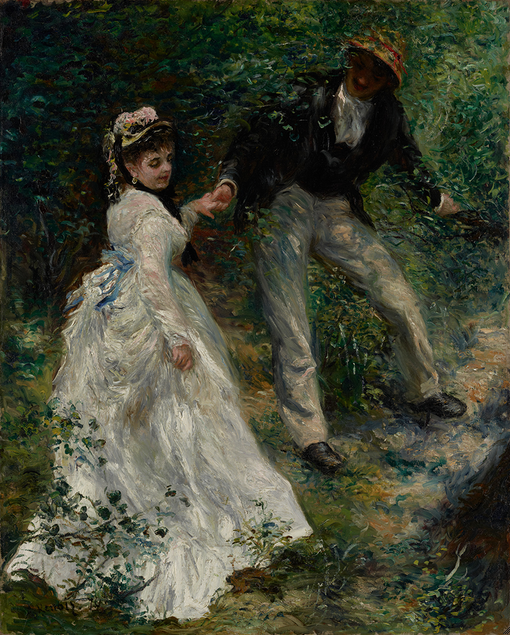
Pierre-Auguste Renoir (French, 1841–1919). La promenade, 1870. Oil on canvas; 81 × 65 cm (32 × 25 1/2 in.). The J. Paul Getty Museum, Los Angeles. Digital Image courtesy of the Getty’s Open Content Program.
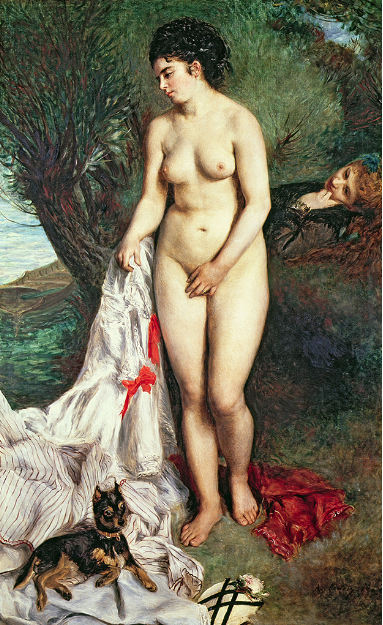
Pierre-Auguste Renoir (French, 1841–1919). Bather with a Griffon Dog, 1870. Oil on canvas; 184 × 115 cm (72 7/16 × 45 5/16 in.). Museu de Arte de São Paulo, Brazil. The Bridgeman Art Library.
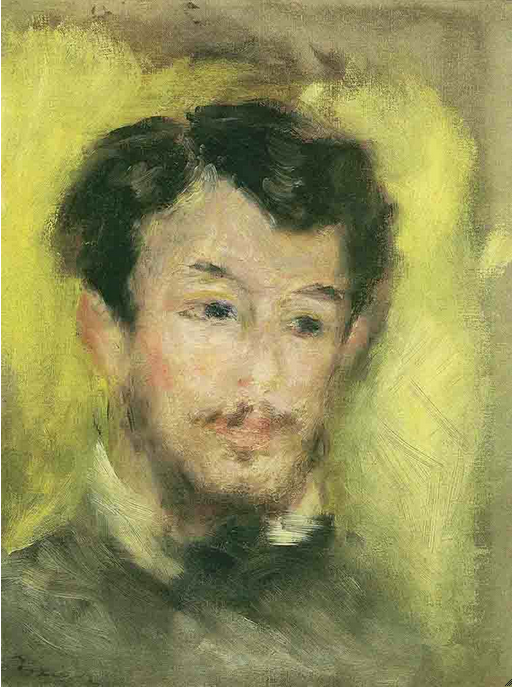
Pierre-Auguste Renoir (French, 1841–1919). Portrait of Edmond Renoir, 1879. Oil on canvas; 32.8 × 24.5 cm (12 15/16 × 9 5/8 in.). Private collection. Courtesy of Galerie Schmit, Paris.
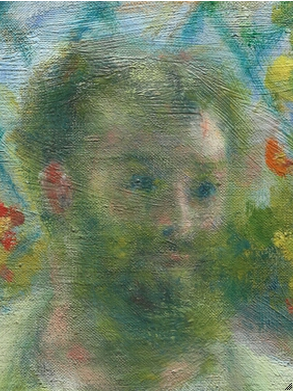
Detail of Renoir’s Lunch at the Restaurant Fournaise (1875) showing the head of the male figure on the left. The Art Institute of Chicago, 1922.437.
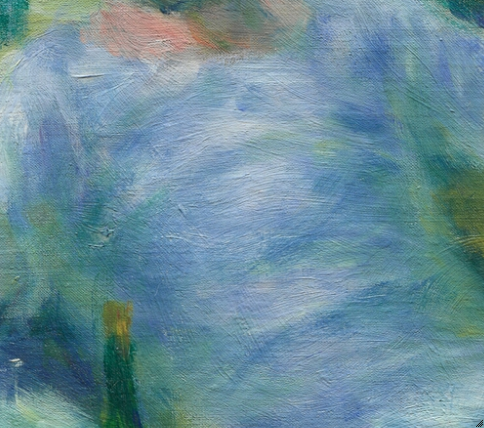
Detail of Renoir’s Lunch at the Restaurant Fournaise (1875) showing the shirt of the male figure on the right. The Art Institute of Chicago, 1922.437.
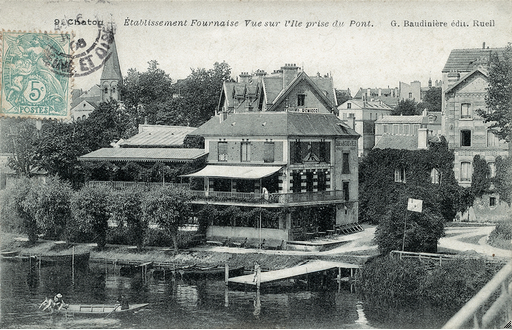
View of the Restaurant Fournaise on the island of Chatou, from the bridge, c. 1905. Black and white postcard; 9 × 14 cm (3 9/16 × 5 1/2 in.). © Musée Fournaise de Chatou, © Service des Musées de France, 2011, © Vincent de la Faille, 2009—use subject to authorization.
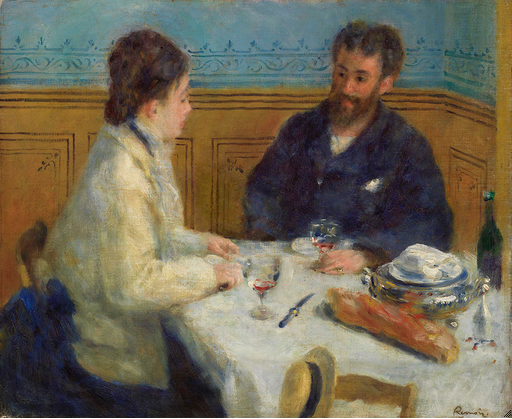
Pierre-Auguste Renoir (French, 1841–1919). The Luncheon (Le déjeuner), 1875. Oil on canvas; 49.2 × 60 cm (19 3/8 × 23 5/8 in.). The Barnes Foundation. Image © 2014 The Barnes Foundation.
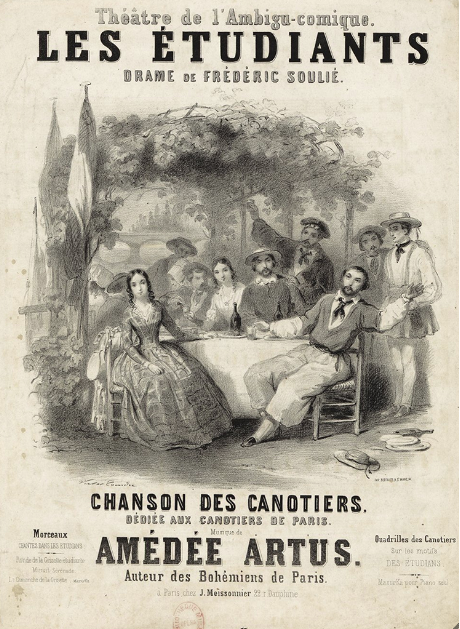
Victor Coindre (French, 19th century). Title page illustration for sheet music of Chanson des canotiers, part of the Théâtre de l'Ambigu-comique production of Les étudiants, a drama by Frédéric Soulié with music by Amédée Artus, 1845. Lithograph on paper; 29.5 × 23 cm (11 5/8 × 9 1/16 in.). Bibliothèque Nationale, Paris.
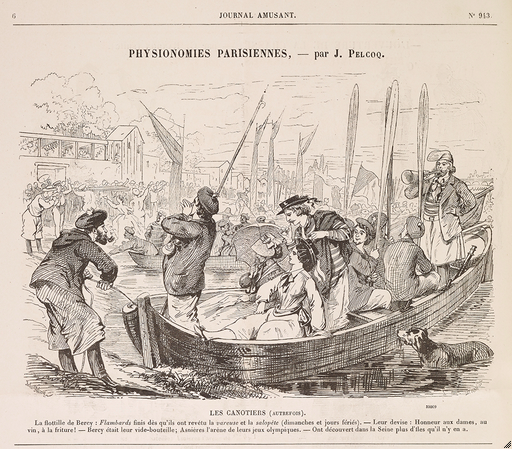
J. Pelcoq, “Physionomies Parisiennes. Les Canotiers (autrefois). La flottille de Bercy,” Le journal amusant, no. 943 (Sept. 25, 1874), p. 6.
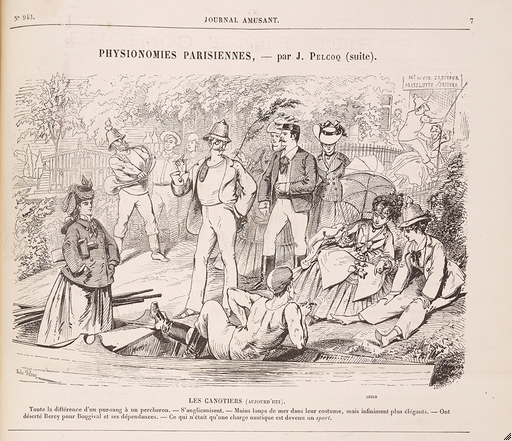
J. Pelcoq, “Physionomies Parisiennes. Les Canotiers (aujourd’hui),” Le journal amusant, no. 943 (Sept. 25, 1874), p. 7. Courtesy The Getty Research Institute.
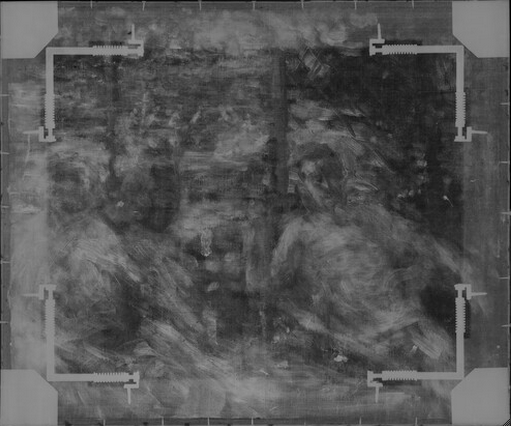
X-ray of Renoir’s Lunch at the Restaurant Fournaise (The Rowers’ Lunch) (1875). X-ray digitally composited by Robert G. Erdmann, University of Arizona. The Art Institute of Chicago, 1922.437.
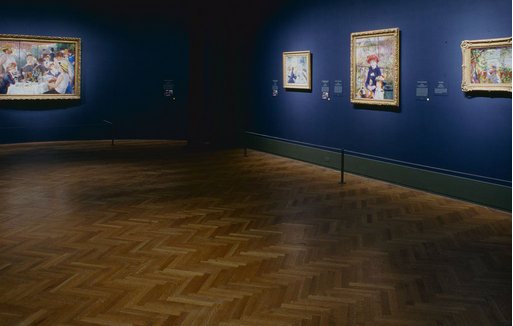
Installation of Renoir’s Lunch at the Restaurant Fournaise (The Rowers’ Lunch) (1875) in Renoir’s Portraits: Impressions of an Age, Art Institute of Chicago, Oct. 17, 1997–Jan. 4, 1998. Institutional Archives, Art Institute of Chicago.
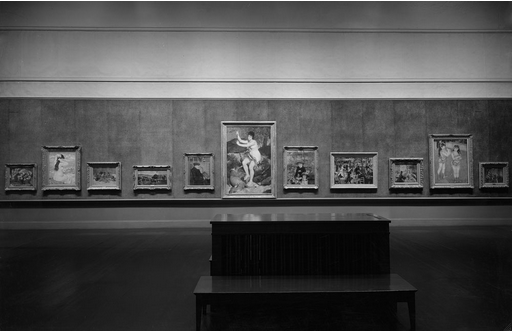
Installation of Renoir’s Lunch at the Restaurant Fournaise (The Rowers’ Lunch) (1875) in “A Century of Progress”: Loan Exhibition of Paintings and Sculpture, Art Institute of Chicago, May 23–Nov. 1, 1933. Institutional Archives, Art Institute of Chicago.
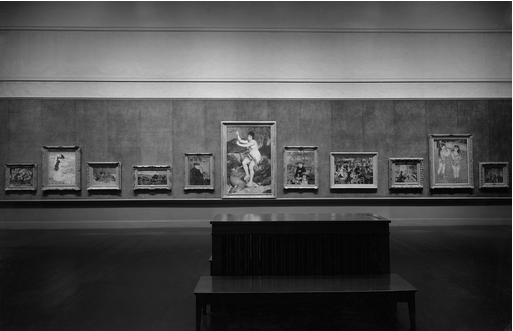
Renoir’s Lunch at the Restaurant Fournaise (The Rowers’ Lunch) (1875) in a previous frame, installed in “A Century of Progress”: Loan Exhibition of Paintings and Sculpture, Art Institute of Chicago, May 23–Nov. 1, 1933. Institutional Archives, Art Institute of Chicago.
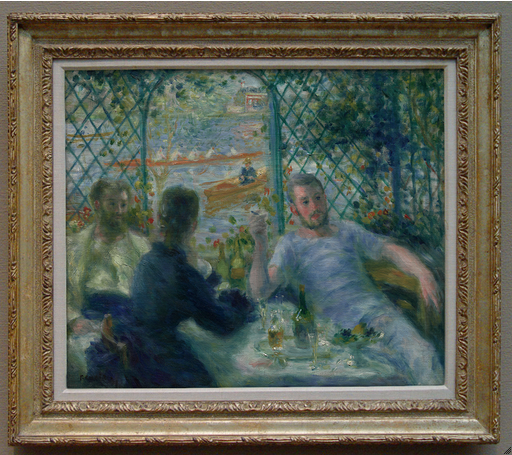
Renoir’s Lunch at the Restaurant Fournaise (The Rowers’ Lunch) (1875) in a previous frame. The Art Institute of Chicago, 1922.437.
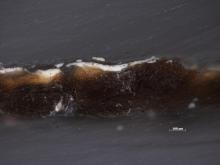
Photomicrograph of a cross-section from Renoir’s Lunch at the Restaurant Fournaise (The Rowers’ Lunch) (1875) showing the canvas and ground layer. Original magnification: 100×. The Art Institute of Chicago, 1922.437.
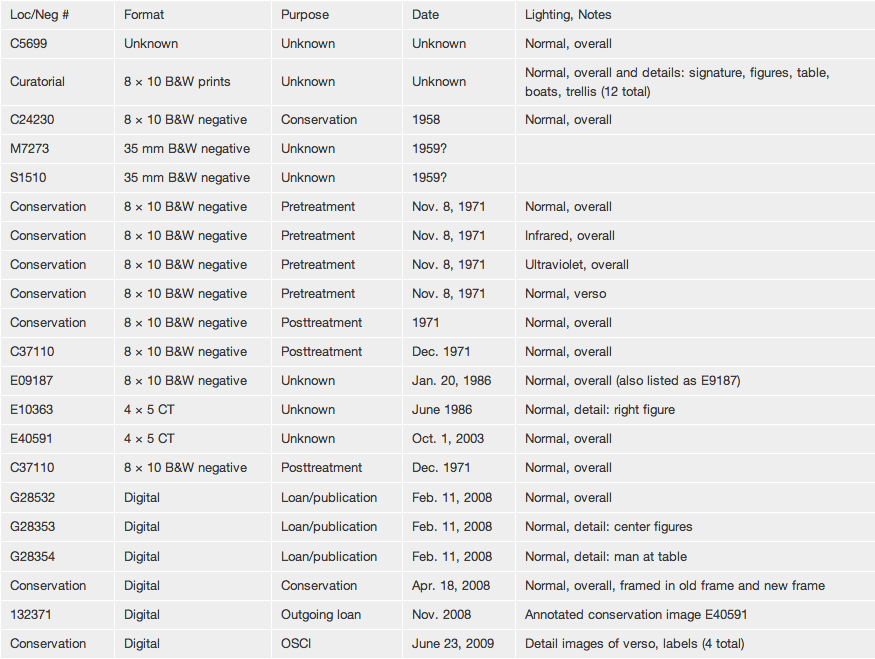
| Loc/Neg # | Format | Purpose | Date | Lighting, Notes |
| C5699 | Unknown | Unknown | Unknown | Normal, overall |
| Curatorial | 8 × 10 B&W prints | Unknown | Unknown | Normal, overall and details: signature, figures, table, boats, trellis (12 total) |
| C24230 | 8 × 10 B&W negative | Conservation | 1958 | Normal, overall |
| M7273 | 35 mm B&W negative | Unknown | 1959? | |
| S1510 | 35 mm B&W negative | Unknown | 1959? | |
| Conservation | 8 × 10 B&W negative | Pretreatment | Nov. 8, 1971 | Normal, overall |
| Conservation | 8 × 10 B&W negative | Pretreatment | Nov. 8, 1971 | Infrared, overall |
| Conservation | 8 × 10 B&W negative | Pretreatment | Nov. 8, 1971 | Ultraviolet, overall |
| Conservation | 8 × 10 B&W negative | Pretreatment | Nov. 8, 1971 | Normal, verso |
| Conservation | 8 × 10 B&W negative | Posttreatment | 1971 | Normal, overall |
| C37110 | 8 × 10 B&W negative | Posttreatment | Dec. 1971 | Normal, overall |
| E09187 | 8 × 10 B&W negative | Unknown | Jan. 20, 1986 | Normal, overall (also listed as E9187) |
| E10363 | 4 × 5 CT | Unknown | June 1986 | Normal, detail: right figure |
| E40591 | 4 × 5 CT | Unknown | Oct. 1, 2003 | Normal, overall |
| C37110 | 8 × 10 B&W negative | Posttreatment | Dec. 1971 | Normal, overall |
| G28532 | Digital | Loan/publication | Feb. 11, 2008 | Normal, overall |
| G28353 | Digital | Loan/publication | Feb. 11, 2008 | Normal, detail: center figures |
| G28354 | Digital | Loan/publication | Feb. 11, 2008 | Normal, detail: man at table |
| Conservation | Digital | Conservation | Apr. 18, 2008 | Normal, overall, framed in old frame and new frame |
| 132371 | Digital | Outgoing loan | Nov. 2008 | Annotated conservation image E40591 |
| Conservation | Digital | OSCI | June 23, 2009 | Detail images of verso, labels (4 total) |
| Conservation | X-ray | OSCI | June 24, 2009 | X-ray films scanned/digitally composited, overall |
| Conservation | Digital | OSCI | June 26, 2009 | Photomicrographs of surface (11 total) |
| Conservation | Digital | OSCI | July 21, 2009 | Normal, overall |
| Conservation | Digital | OSCI | July 21, 2009 | Raking light, overall |
| Conservation | Digital | OSCI | July 21, 2009 | Raking light, detail; L figures |
| Conservation | Digital | OSCI | July 21, 2009 | Ultraviolet, overall |
| Conservation | Digital | OSCI | July 21, 2009 | Infrared (Fuji, 1000B/2 mm filter), overall |
| Conservation | Digital | OSCI | Sep. 30, 2009 | Macro details of surface (17 total) |
| Conservation | Digital | OSCI | Sep. 30, 2009 | Infrared details (Fuji, 1000B/2 mm filter), (2 details) |
| Conservation | Digital | OSCI | Jan. 4, 2012 | Infrared (Goodrich, 1.1–1.4 µm H filter), overall; composite |
| Conservation | Digital | OSCI | Jan. 4, 2012 | Transmitted light, overall |
| Conservation | Digital | OSCI | Jan. 4, 2012 | Transmitted infrared (Fuji, 1000B/2 mm filter), overall |
| G39103 | Digital | OSCI | Jan. 6, 2012 | Normal, overall; high-resolution composite of G39112–G39127 |
| G39104 | Digital | OSCI | Jan. 6, 2012 | Ultraviolet, overall |
| G39105 | Digital | OSCI | Jan. 6, 2012 | Normal, frame only |
| G39112 | Digital | OSCI | Jan. 6, 2012 | Section |
| G39113 | Digital | OSCI | Jan. 6, 2012 | Section |
| G39114 | Digital | OSCI | Jan. 6, 2012 | Section |
| G39115 | Digital | OSCI | Jan. 6, 2012 | Section |
| G39116 | Digital | OSCI | Jan. 6, 2012 | Section |
| G39117 | Digital | OSCI | Jan. 6, 2012 | Section |
| G39118 | Digital | OSCI | Jan. 6, 2012 | Section |
| G39119 | Digital | OSCI | Jan. 6, 2012 | Section |
| G39120 | Digital | OSCI | Jan. 6, 2012 | Section |
| G39121 | Digital | OSCI | Jan. 6, 2012 | Section |
| G39122 | Digital | OSCI | Jan. 6, 2012 | Section |
| G39123 | Digital | OSCI | Jan. 6, 2012 | Section |
| G39124 | Digital | OSCI | Jan. 6, 2012 | Section |
| G39125 | Digital | OSCI | Jan. 6, 2012 | Section |
| G39126 | Digital | OSCI | Jan. 6, 2012 | Section |
| G39127 | Digital | OSCI | Jan. 6, 2012 | Section |
Woman at the Piano102
1875/76103
Oil on canvas; 93 × 74 cm (36 9/16 × 29 1/8 in.)
Signed: Renoir. (lower left, in warm-black paint)
The Art Institute of Chicago, Mr. and Mrs. Martin A. Ryerson Collection, 1937.1025
With its elevated vantage point giving an unobstructed view of the woman’s hands on the keyboard, Woman at the Piano invites the viewer to associate the sensual act of listening with the visual harmony of the beautiful redhead wearing a luxurious, brilliantly lit peignoir.104 The woman—likely Renoir’s favorite model of the late 1870s, Nini Lopez—plays an upright piano appropriate for modest living quarters. The interior furnishings depicted in this painting are not opulent but are typical of a bourgeois home of the 1870s: an oriental carpet, subdued wall coverings in dark colors, and a fringed portiere to divide rooms. In the background on the left, a large, glazed ceramic planter with a footed base, remarkable for its iridescence, may be of chinoiserie design. Above the piano hangs a pastel or print framed in a mat, another sign of middle-class living. The bound volumes of music on top of the piano, piled together with loose, illustrated sheets that often accompanied popular tunes, hint at the pianist’s broad repertoire. As the writer Émile Zola related in his novel Nana of 1879, learning to play the piano was a common element of a middle-class French girl’s education, along with English lessons.105 The comfortable ambience of the room in Woman at the Piano places it outside Renoir’s rue Saint-Georges studio, which was described as a rectangular room furnished with old armchairs, where three walls were covered in gray wallpaper and a third was entirely glazed for maximum light.106
Sensuality was often an aspect of Renoir’s paintings of the Parisienne—a woman dressed in the latest fashion—which were intended primarily for the enjoyment of the wealthy male viewer.107 Woman at the Piano can be considered an image of the Parisienne because the peignoir is the star of the painting, occupying most of the picture and making the canvas the equivalent of a fashion plate. The raised viewing angle opens up the foreground to accommodate the full extent of the flowing skirt. The artist made adjustments to the piano, which in overall profile appears more foreshortened in the [glossary:X-ray], suggesting that he stepped back from the subject in order to encompass the woman’s entire figure in the composition; the artist also lowered his point of view to a slightly less steep angle (fig. 2.57). Demonstrating an expressive and gestural technique, Renoir rendered the peignoir to appear as a willowy mass of brushwork over an off-white or beige underlayer painted over with white, blue, and some light green, all blended together to convey the garment’s voluminous folds (fig. 2.58). The only lines are the dark blue decorative trim. Blended blue shadow becomes more dominant toward the bottom of the peignoir, in keeping with a diminishing light source. Originally painted over a larger area, the peignoir was slimmed and the line of the woman’s lower back was adjusted to include more of the piano seat (see Application/technique and artist’s revisions in the technical report). The flattened perspective and graphic outline of the peignoir that result from Renoir’s elaborate handling recall the gowns of female saints in altarpieces of the Northern Renaissance artist Jan van Eyck.108
Comparable sensuality in an interior setting can be seen in A Girl Crocheting (fig. 2.19 [Daulte 154; Dauberville 390]).109 This painting is a genre scene with little emphasis on the fashion or urbanity present in the image of the Parisienne. The woman shares the long red hair of the figure in Woman at the Piano and might also be Nini Lopez, whom Renoir employed from 1875 to 1880 and who was known for being “punctual, serious, and discreet.”110 By showing her in A Girl Crocheting with a bared shoulder and her hair unbound and flowing down her back, Renoir introduced eroticism into an otherwise traditional genre painting—not unlike the effect he achieved with the peignoir in Woman at the Piano. With its iridescent blue vase and mantel ornaments that include a framed picture, the dark interior of A Girl Crocheting is also comparable to that in Woman at the Piano. In both works comfortable, fashionable surroundings are combined with an alluring image of femininity. Renoir heightened the sensuality of Woman at the Piano with subtle adjustments to the figure. In the X-ray the woman’s face is profil perdu (fig. 3.60). In the final placement of the figure in full profile Renoir showed her youthful features to better advantage. The X-ray also indicates that the woman’s hair was at an earlier stage gathered low at the back of her head, while in the final composition it is swept up to reveal more of her neck.
One can get a good sense of how Renoir transformed the subject of the woman at the piano into an image of the Parisienne by comparing it to a contemporary work by Frédéric Samuel Cordey, Captive Audience of 1877 (fig. 2.5).111 In this painting the instrument is also placed in the corner of a room decorated with wallpaper and framed pictures; however, both the plain design of the pianist’s day dress and the meditative pose of her companion place this scene some distance from the sensual retreat of Renoir’s painting. The dull wall color, uniform ambient lighting, and mundane furnishings of Cordey’s interior are pedestrian and undistinguished compared to the elegance and visual appeal displayed in Woman at the Piano.112
While the emphasis on fashion and femininity in Woman at the Piano marks it as a representation of the Parisienne, the depiction of a woman playing the piano alone in an interior setting defines it as a genre painting or a view of everyday life. The theme of young women at the piano was one that Renoir would make his own in the 1890s, when the French State acquired Young Girls at the Piano (fig. 2.8 [Dauberville 993]), the first work by the artist to enter the collection of contemporary art housed in the Musée du Luxembourg, the occasion that marks the beginning of the artist’s official recognition.113 Such a significant career milestone makes Woman at the Piano all the more compelling, as it is the artist’s first treatment of a piano-playing subject.114 It was his only example of the theme until 1888, when he painted the portrait commission The Daughters of Catulle Mendès (Metropolitan Museum of Art, New York [Daulte 545; Dauberville 966]).115
Renoir seems to have come late to the theme of the woman at the piano compared to his Impressionist colleagues.116 Certainly there was a commercial necessity to expand the range of his successful Parisienne images and genre repertoire. Alternatively it could be argued that his growing social circle of poets and musicians in the mid-1870s may have alerted him to the broader context in which painting, music, and the arts coexisted. What kinds of tunes are shown in the stack of music in Woman at the Piano: popular operettas, classical sonatas, works by German composer Richard Wagner?117 The relative merits of these musical styles would have been as passionate a point of discussion as painting technique and color for many of Renoir’s friends in the 1870s. In his biography of Renoir, Georges Rivière devoted an entire chapter to Ernest Cabaner, a pianist and early supporter of the Impressionists who lived in Montmartre on the rue de Clichy until his death in 1881.118 Renoir’s inner circle also included gifted pianists Edmond Maître and Emmanuel Chabrier. In the larger salons, where dozens of socialites would gather for gossip and conversation, music had a substantial role in the entertainment of guests. Renoir’s caricature of the novelist Alphonse Daudet at the piano wearing an evening jacket (fig. 2.9) suggests a command performance at one of these events.119 The more intimate surroundings in Woman at the Piano evoke the idea of an active listening experience on the part of the viewer. It is a painting addressed to a client drawn to the fashionably dressed Parisienne, yet one who may also have supported progressive music as openly as progressive art.
It is fairly certain that Woman at the Piano was the work exhibited at the second Impressionist exhibition in April 1876 as Femme au piano, since it is the only work of that title dating from the 1870s.120 Renoir submitted eighteen works to the exhibition, including Lunch at the Restaurant Fournaise (The Rowers’ Lunch) (1875; cat. 2). This work received only a brief mention by the critics, and Woman at the Piano was passed over completely. Much of the commentary about Renoir’s work focused on his controversial female torso, titled Étude (fig. 2.10 [Daulte 201; Dauberville 603]).121 Art critics more comfortable with the academic nude in historic or mythological contexts found Renoir’s provocative play of light and shadow on human flesh in a garden setting deeply disturbing. The powerful and influential critic of Le figaro, Albert Wolff, compared the nude to a mass of decomposing flesh.122 Woman at the Piano is equally innovative in its lighting of the figure. The brilliant whites of the flowing peignoir and the woman’s glowing flesh tones visible through the sheer fabric of her sleeve suggest conditions of bright sunlight seemingly at odds with the somber tones of the apartment’s interior. Direct sunlight from a window would presumably cast distinct shadows, but no such shadows are apparent.
One of the few positive comments about Renoir’s work at the 1876 exhibition came from Zola, who had been a supporter of the Impressionists for a decade. Zola’s review was sympathetic: “M. Renoir is above all a figure painter. He favors a blonde palette of colors that lighten and blend with an admirable harmony. One would say these are works by Rubens lit by the strongest sunlight of Velázquez.”123 While Zola did not mention Woman at the Piano, his review nevertheless raises the question of Renoir’s engagement with the Old Masters in 1875–76 and how these sources might have played a role in the inspiration for the painting. The theme of the woman at the piano can be traced to seventeenth-century Dutch artists such as Gabriel Metsu, whose Lady at the Virginals (1662; Petit Palais, Musée des Beaux-Arts de la Ville de Paris) was reproduced in Charles Blanc’s Histoire de peintres de toutes les écoles: École hollandaise in 1862. Another Dutch work, Johannes Vermeer’s A Young Woman Standing at a Virginal (fig. 2.11), appeared in an exhibition of Old Master paintings from private collections held in Paris in 1866.124 Vermeer’s work had not been previously seen in a Paris exhibition and was just beginning to be understood by French art historians.125 In 1870 the Louvre acquired its first painting by Vermeer, The Lace Maker of 1669/70, which later became a highlight of Renoir’s visits to the museum.126 While it is uncertain how familiar Renoir would have been with Vermeer’s work in the mid-1870s, Woman at the Piano succeeds magnificently in updating the traditional paradigm of painting’s relationship to music by merging Impressionist concerns with color and light with references to history, tradition, and the attentive listener.
John Collins
Renoir began with a [glossary:commercially primed] [glossary:canvas] and roughly separated broad areas of the compositional space with thin layers of opaque paint; a thin, dark-red [glossary:wash] was used to define the piano on the right. This dark red extends past the apparent [glossary:foldover] edge and may indicate that the artist began his composition on an unstretched canvas or on a canvas on a slightly larger, nonstandard [glossary:stretcher] that he later moved to a smaller stretcher. With a relatively limited [glossary:palette], Renoir created textural differences by manipulating the paint in many ways, including thin washes, scraping, thick [glossary:impasto], [glossary:wet-in-wet] [glossary:modeling], and dragging a stiff brush across wet paint. [glossary:X-radiography] indicates compositional changes to both the figure and the piano. Renoir established the initial forms of these elements and brought the background in around them before making subsequent changes to the composition. He altered the figure’s pose—originally in profile, in the final composition she is turned slightly toward the viewer—as well as her dress and hairstyle. After executing the figure in her initial form, Renoir slimmed her overall silhouette and greatly diminished the volume of her skirt. Her hair was altered from a simple, downswept roll to an upswept style with added volume at the crown. The piano was widened, perhaps painted from a different perspective. Initially the overall profile of the piano was more foreshortened, projecting farther into space; however, the top of the piano was slightly less foreshortened, signaling a change in vantage not only farther to the left with respect to the subject, but perhaps also slightly lower. Once the figure and the piano were executed in their final forms, the artist smoothed the transition between figure and ground with a combination of wet-in-wet modeling and working thin, translucent layers over dry paint.
The multilayer interactive image viewer is designed to facilitate the viewer’s exploration and comparison of the technical images (fig. 1.2).127
Signed: Renoir. (lower left, in warm-black paint) (fig. 1.1, fig. 2.20).128
Flax (commonly known as linen).129
Measuring from a ridge around the perimeter that appears to be a flattened foldover, the original dimensions appear to be approximately 91.5 × 73 cm; cusping visible in the [glossary:X-ray] corresponds to tack placement for this size. This most likely corresponds to a no. 30 portrait ([glossary:figure]) standard-size (92 × 73 cm) canvas.130
Determining the original size of the canvas is complicated by many factors, as the dimensions may have been changed by the artist and the original foldover edge does not appear to be a straight line. Additional canvas was left exposed around the perimeter when the painting was lined, and during the same treatment it was mounted slightly askew.131
Aspects of the painting’s construction suggest that Renoir may have changed the size of the canvas himself after beginning his composition off the stretcher or stretched to a larger secondary support. The work features uneven edges on all sides, the straightest of which appears to be the left. Folding the painting at the apparent foldover on the right would also make it correspond to a no. 30 portrait (figure) standard-size canvas; some sense of the original dimensions and the nature of the original edges are more apparent in clean-state photos from the 1972 treatment (fig. 1.3). The artist appears to have lined up the painting for stretching on a standard stretcher by the left side, folding over a small portion of the scraped-back, dark-red piano paint (fig. 1.4). After numerous compositional changes, small margins of background paint on the lower left and upper right were likely added by Renoir to square the composition to fit a standard size.
[glossary:Plain weave]. Average [glossary:thread count] (standard deviation): 22.4V (0.8) × 26.1H (0.5) threads/cm. The horizontal threads were determined to correspond to the [glossary:warp] and the vertical threads to the [glossary:weft].132
The canvas has mild [glossary:cusping] on the top, bottom, and left edges, corresponding to the placement of the original tacks. On the right, cusping corresponds to the inner set of tack holes (visible along the foldover edge) rather than to the secondary set of tack holes on the current tacking margin (fig. 2.28). There is a double thread fault on the lower left (fig. 2.18).
Current stretching: When the painting was lined in 1937, it was placed slightly askew, and the original dimensions were increased on all sides by up to 1 cm. It is possible that the right margin was also extended as part of this treatment (see Conservation History).133
Original stretching: Based on cusping visible in the X-ray, the original tacks were placed approximately 3.5–7 cm apart.
Current stretcher: Five-member keyable stretcher with a horizontal [glossary:crossbar]. This stretcher is not believed to be original to the painting and probably dates from the 1937 treatment (see Conservation History).
Original stretcher: Unknown.
No manufacturer’s or supplier’s marks were observed during the current examination or documented in previous examinations.
[glossary:Cross-sectional analysis] indicates a thin, brownish layer of material between the canvas and the [glossary:ground] that closely follows the canvas texture. This material is organic, based on its characteristic bluish [glossary:fluorescence] in UV light, and is estimated to be glue (fig. 2.22).134
There is a smooth, single-layer, commercially applied ground, approximately 10–40 µm thick, that extends to the edges of the [glossary:tacking margins] (fig. 2.23).
The ground appears to be warm white, with dark particles visible under [glossary:stereomicroscopic examination] (fig. 2.24). Small percentages of black and iron oxide yellow and red were found in cross-sectional analysis and contribute to this warm appearance. This layer is porous and has darkened over time due to the combined effects of accumulated grime and saturation by the [glossary:wax-resin lining] material (see Conservation History and Condition Summary).
The ground is predominantly lead white, with small amounts of calcium-based white, iron oxide yellow and red (and associated silicates), and traces of bone black, complex silicates, and barium sulfate extenders.135 The [glossary:binder] is estimated to be [glossary:oil].136
No [glossary:underdrawing] was observed with [glossary:infrared reflectography] or under stereomicroscopic examination.
Renoir began the painting by laying in localized colors, some in opaque layers, and loosely defining various areas of the composition. On the upper left and across much of the top, a bright-white underlayer serves to visually brighten the top half of the painting (fig. 2.25). Underneath the figure and foreground, however, the underlayers appear thick and beige, a color very similar to that of the ground. It is unclear whether this beige layer was intended to function like the white in the top half of the composition or was used to cover previous compositional choices in certain areas. Comparatively wide strokes (up to 3 cm wide) of this warm beige are seen in raking-light and X-ray images throughout the left foreground rug, on either side of the dress (fig. 2.26).
On the right, the artist used a dark-red wash for the piano that extends past the apparent original foldover edge.137 The paint along this edge is very thin, appears scraped back and abraded, and includes only the lower layers of paint and none of the upper details of the gold ornament on the side of the piano or the music books on top of the piano.138 It is possible that Renoir began the work off the stretcher or on a larger, nonstandard stretcher and later shortened it to correspond to a standard-size stretcher. The paint layers present on the far right edge suggest that this change was made before the upper layers of the piano were added. The artist scraped back the paint along the right side and may have changed the size of the work before changing the angle of the piano and adding details such as the gold decorative ornament and the sheet music (fig. 2.27). Once the work was stretched, he “squared” the composition on the upper right and lower left with additional background paint. As these areas lack the previously mentioned opaque underpaints that define their surroundings, they appear quite different in color and texture than the rest of the canvas, but they do appear to be original.
Renoir made substantial changes to both the figure and the piano in this composition. The X-ray indicates that the piano originally appeared thinner and taller. The top of the piano was painted from a slightly downward perspective, with more of the surface visible and featuring additional sheet music and a curved decorative element. The top now appears more foreshortened, and the overall profile of the piano is wider and angled more toward the viewer (fig. 2.28). The sheet music just above the keyboard appears longer and curved in the X-ray, possibly indicating turning or buckling pages, and a [glossary:radio-opaque] form just under the music suggests that a music ledge was articulated at this stage. The X-ray also suggests that the artist raised the position of the candlesticks and altered the curve along the side and legs of the piano in the foreground.
Renoir made numerous changes to the figure’s hairstyle, dress, and profile. Originally her hair, swept down smoothly along the side of her head, was tucked back in a simple roll. Brushstrokes in the hair indicate that the artist simply layered thin strokes in a different direction over the previous arrangement to suggest a more upswept style with added volume at the crown (fig. 2.29). Traction cracking in this area resulted from the thinness of these layers compared to the heavier paint underneath, a trait also visible in [glossary:raking light]. In the X-ray, the figure’s dress appears more voluminous, bowing out around the knees and coming in atop a larger ruffled bottom. The skirt seems to bend in on itself, and the piano seat is almost entirely hidden by it. A [glossary:radio-transparent] band along this inward fold of the skirt indicates that it was originally higher than it appears in the visible composition. In the final arrangement, Renoir reduced the volume of the skirt on both sides of the piano seat, revealing more of the seat and cushion and giving definition to the bottom half of the figure. The artist slimmed her overall silhouette, straightened her neck, and brought up her neck and chin slightly to suggest a more upright posture. The figure appears in full profile, with her head angled more toward the viewer. To accomplish this, Renoir moved her forehead, chin, eyes, and hairline slightly to the left with respect to her nose (fig. 2.30). A visible buildup of the paint in the flesh tones, where the artist subtly altered the head, can be seen in raking light. The figure’s arms remain in the same position in the X-ray and the final composition, but her left hand was moved farther back in space, and paint revealed by cracking in this area indicates that the ruffle at the cuff of her sleeve was probably extended after the wrist was executed (fig. 2.31). Similar cracks also reveal that the artist added flesh tones over the white of the sleeve to create the illusion of a translucent garment.
Renoir established both the female figure and the piano before bringing in the background. In the X-ray, heavy strokes of background paint come up to and around these elements; this is especially noticeable around the figure’s head, where a kind of radio-opaque halo is visible. After the artist settled on the final composition, he softened the transition between figure and ground with additional background paint applied either wet-in-wet or in thin, translucent layers over dry paint.
Renoir’s paint application varies in thickness and texture, from washes and areas scraped with a palette knife, to heavy impasto and visible brushwork (fig. 2.32). The artist mixed many hues directly on the surface of the painting, working wet-in-wet to varying degrees to produce smooth blending, as seen in the figure’s dress and flesh (fig. 2.33). In some areas, short strokes of color or highlights pick up a small amount of the surrounding paint, as on the vase on the left (fig. 2.34). To create the illusion of individual strands of hair framing the figure’s face, Renoir dragged a stiff brush across wet paint, allowing the bristles to cut through and reveal the light underpaint (fig. 2.35). The artist also added details in very dry paint, dragging his brush across the surface, as in the foliage, highlights on the candlesticks, parts of the vase, and upper details of the foreground rug (fig. 2.36).
Soft- and stiff-bristle brushes (strokes up to 1 cm wide); [glossary:palette knife] for scraping; possible wider brushes (strokes about 3 cm wide) used in the foreground underlayers.
Analysis indicates the presence of the following [glossary:pigments]:139 lead white, zinc white, cobalt blue, cerulean blue, emerald green, viridian, chrome yellow, zinc yellow, bone black, vermilion, madder lake, carmine lake,140 iron oxide red, and red lead.
Analysis suggests that the paint mixtures vary in their complexity, with some simpler mixtures of two or three pigments and other more complex combinations. The flesh tones, for example, contain lead white, vermilion, and red lake.141 The dark-blue ribbon running through the lower portion of the figure’s dress, however, is more complex; in addition to cobalt blue, there is some cerulean blue and chrome yellow, with traces of bone black, zinc yellow, and possibly red lake. The observation of a characteristic bright orange fluorescence under UV light indicates that the artist used a fluorescing red lake in the flesh tones, parts of the front of the piano, and the figure’s hair (fig. 2.37).142 It is likely that Renoir used a different red lake for the main body of the piano. Cross-sectional analysis of a sample from the piano indicates that the artist mixed both lakes; in UV light, the fluorescing and nonfluorescing red lakes are visible side by side (fig. 2.38).143
Oil (estimated).144
The current [glossary:synthetic varnish] was applied in 1972, replacing a natural-resin [glossary:varnish]. It is unclear whether the natural-resin varnish dates from the 1937 lining or from a proposed 1940 treatment (see Conservation History).
The painting was treated by Chicago private conservator Leo Marzolo just before it was acquired by the Art Institute in 1937.145 Treatment at this time included wax-resin lining to a secondary canvas and mounting the lined canvas onto Masonite before restretching the entire structure on a five-member keyable stretcher.146 The painting was minimally scratched in transit in 1940 and repaired in November of the same year by Marzolo.147 The examination report for this treatment confirmed that the work was already wax-resin lined, “then placed onto Masonite.” This record also indicated dissatisfaction with the surface coating and recommended removing the excess wax and replacing it with a wax-damar-mastic mixture. As there is no further documentation, both the specific nature of the previous coating and whether this treatment was completed remain unclear.
The work was superficially treated in 1969, including grime removal with detergent water, thinning of the surface coating, toning of discolored [glossary:retouching], and resaturation of the surface with three coats of synthetic varnish (an isolating layer of polyvinyl acetate [PVA] AYAA, followed by methacrylate resin L-46, and a final coat of AYAA).148 The painting was treated again in 1972 in preparation for exhibition.149 An aged natural-resin varnish and extensive retouching along the edges were removed, along with the 1969 synthetic varnish system, at this time with a combination of solvent and mechanical cleaning. The painting was again given a three-layer varnish (an isolating layer of polyvinyl acetate [PVA] AYAA, followed by methacrylate resin L-46, and a final coat of AYAA) and retouched. Heavy retouching along the edges compensates for the slightly skewed lining and the abraded paint along the right edge.
The painting is in good condition, planar and with few losses. It is wax-resin lined to a secondary canvas and is secure. A piece of Masonite was inserted between the lined painting and the restoration stretcher, but it is unclear at this time whether the Masonite panel is attached to the painting with adhesive or held in place by the pressure of the stretching. The overall flatness and planarity of the painting and increased textural presence of the weave are the result of the lining process. The original tacking margins were flattened during the lining process, making the original dimensions somewhat unclear and causing abrasion and minor losses around the perimeter. The work was stretched slightly askew and has been retouched along the left edge near the bottom, the bottom edge on the right, parts of the upper edge, and the entire right side to compensate. Cracking appears to be limited to the figure’s dress, along the arms and shoulders and at the knee, and along areas of dark blue, including the ribbon detail and the shadowed piano seat. The work is slightly saturated by a combination of lining material and a somewhat glossy synthetic varnish.
Kelly Keegan
Current frame (installed 2008): The frame is not original to the painting. It is a French (Parisian), late-seventeenth-century, Louis XIV convex frame with alternating acanthus leaves, scrolls, and flowers on a hazzled bed with ribbon-and-leaf sight molding. The frame has water gilding over red and red brown bole on gesso. The ornament and sight moldings are selectively burnished; all other gilding is matte. The frame retains its original gilding and glue [glossary:sizing]. The carved oak molding is mitered and joined with angled, dovetailed splines. The molding, from the perimeter to the interior, is ovolo with flowers outer molding; scotia side; convex face with alternating acanthus leaves, scrolls, and flowers on a hazzled, recut bed; cove frieze; and torus with ribbon-and-leaf sight molding (fig. 2.39).150
Previous frame (installed sometime after 1937, removed 2008): The painting was previously housed in an American, twentieth-century, Louis XVI reproduction, fluted scotia frame with corner acanthus leaves, made of carved basswood with a distressed gilt finish (fig. 2.40).
Previous frame (installed prior to or upon the 1911 purchase by the Ryerson family; removed after 1937): The work was previously housed in a late-nineteenth-century, Louis XIV Revival, reverse ogee frame with straight sides and projecting cast plaster fleur-de-lis corner cartouches connected by a symmetrical rhythm of scroll-linked fleurs-de-lis on a quadrillage bed. The frame had an outer leaf-tip and inner linked-bellflower molding with cove sight edge, and an independent fillet liner with cove sight edge (fig. 2.41, fig. 2.17).
Kirk Vuillemot
Acquired by Paul-Victor Poupin, Paris, by Apr. 1876.151
Possibly acquired by Durand-Ruel, Paris, by Apr. 1883.152
Sold (possibly by Renoir) to Durand-Ruel, Paris, Sept. 8, 1886, for 1,200 francs.153
Possibly sold at Moore’s Art Galleries, New York, May 6, 1887, lot 93, for $675.154
Acquired by Durand-Ruel, New York, by Dec. 16, 1911.155
Sold by Durand-Ruel, New York, to Martin A. Ryerson, Chicago, Dec. 16, 1911, for $16,000.156
By descent from Martin A. Ryerson (died 1932), to his wife, Mrs. Martin A. Ryerson, Chicago.157
Bequeathed by Mrs. Martin A. Ryerson (died 1937), to the Art Institute of Chicago, 1937.
Paris, 11, rue Le Peletier, 2e exposition de peinture [second Impressionist exhibition], Apr. 1876, cat. 219, as Femme au Piano. Appartient à M. Poupin.158
Possibly London, Dowdeswell and Dowdeswell, Paintings, Drawings and Pastels by Members of “La société des impressionnistes,” Apr.–July 1883, cat. 13, as Femme au piano.159
New York, Durand-Ruel, Exhibition of Paintings by Claude Monet and Pierre Auguste Renoir, Apr. 1900, cat. 39, as Jeune Femme au Piano.160
New York, Durand-Ruel, Exhibition of Paintings by Pierre Auguste Renoir, Nov. 14–Dec. 5, 1908, cat. 5, as Jeune femme au piano, 1878.161
New York, Durand-Ruel, 1911.162
Possibly New York, Durand-Ruel, Exhibition of Paintings by Renoir, Feb. 14–Mar. 16, 1912, cat. 19, as Fillette en robe bleue.163
Renaissance Society of the University of Chicago, Some Modern Primitives: International Exhibition of Paintings and Prints, Summer 1931, July 2–Aug. 16, 1931, cat. 73.164
Renaissance Society of the University of Chicago, Commemorative Exhibition from the Martin A. Ryerson Collection, Oct. 9–30, 1932, cat. 18.
Art Institute of Chicago, “A Century of Progress”: Loan Exhibition of Paintings and Sculpture, May 23–Nov. 1, 1933, cat. 337 (ill.).165 (fig. 2.56)
Philadelphia, Pennsylvania Museum of Art, Manet and Renoir, Nov. 29, 1933–Jan. 1, 1934, no cat. no.166
Art Institute of Chicago, “A Century of Progress”: Loan Exhibition of Paintings and Sculpture for 1934, June 1–Oct. 31, 1934, cat. 226.167
Toledo (Ohio) Museum of Art, French Impressionists and Post-Impressionists, Nov. 1934, cat. 16.168
New York, Metropolitan Museum of Art, Renoir: A Special Exhibition of His Paintings, May 18–Sept. 12, 1937, cat. 27 (ill.).
Toledo (Ohio) Museum of Art, Paintings by French Impressionists and Post-Impressionists, Nov. 7–Dec. 12, 1937, cat. 24 (ill.).
Art Institute of Chicago, Special Exhibition of the Ryerson Bequest: Paintings, Oriental and Decorative Arts, Jan. 26–31, 1938, no cat.169
San Francisco, Palace of Fine Arts, Golden Gate International Exposition, May 25–Sept. 29, 1940, cat. 292 (ill.).170
San Diego, Fine Arts Gallery, Special Loans of Old Masters and Contemporary Paintings from the San Francisco Exposition and Los Angeles County Fair, Oct. 12–Nov. 2, 1940, no cat.171
New York, Duveen Galleries, Renoir: Centennial Loan Exhibition, 1841–1941; For the Benefit of the Free French Relief Committee, Nov. 8–Dec. 6, 1941, cat. 14 (ill.).
Art Institute of Chicago, Paintings by Renoir, Feb. 3–Apr. 1, 1973, cat. 20 (ill.).
New York, Wildenstein, Renoir: The Gentle Rebel; A Loan Exhibition for the Benefit of the Association for Mentally Ill Children, Oct. 24–Nov. 30, 1974, cat. 10 (ill.).
Art Institute of Chicago, Art at the Time of the Centennial, June 19–Aug. 8, 1976, no cat.172
Tokyo, Isetan Museum of Art, Exposition Renoir, Sept. 26–Nov. 6, 1979, cat. 16 (ill.); Kyoto Municipal Museum, Nov. 10–Dec. 9, 1979.
Albi, Musée Toulouse-Lautrec, Trésors impressionnistes du Musée de Chicago, June 27–Aug. 31, 1980, cat. 19 (ill.).
London, Hayward Gallery, Renoir, Jan. 30–Apr. 21, 1985, cat. 35 (ill.); Paris, Galeries Nationales du Grand Palais, May 14–Sept. 2, 1985, cat. 34 (ill.); Boston, Museum of Fine Arts, Oct. 9, 1985–Jan. 5, 1986.
Leningrad (now Saint Petersburg), State Hermitage Museum, Ot Delakrua do Matissa: Shedevry frantsuzskoĭ zhivopisi XIX–nachala XX veka, iz Muzeia Metropoliten v N’iu-Iorke i Khudozhestvennogo Instituta v Chikago [From Delacroix to Matisse: Great masterpieces of French painting of the nineteenth to the beginning of the twentieth century from the Metropolitan Museum of Art, New York, and the Art Institute of Chicago], Mar. 15–May 16, 1988, cat. 20 (ill.); Moscow, Pushkin Museum of Fine Arts, May 30–July 30, 1988.
Nagaoka, Niigata Prefectural Museum of Modern Art, Shikago bijutsukan ten: Kindai kaiga no 100-nen [Masterworks of modern art from the Art Institute of Chicago], Apr. 20–May 29, 1994, cat. 6 (ill.); Nagoya, Aichi Prefectural Museum of Art, June 10–July 24, 1994; Yokohama Museum of Art, Aug. 6–Sept. 25, 1994.
Atlanta, High Museum of Art, Rings: Five Passions in World Art, July 4–Sept. 29, 1996, no cat. no.173
Fort Worth, Tex., Kimbell Art Museum, The Impressionists: Master Paintings from the Art Institute of Chicago, June 29–Nov. 2, 2008, cat. 24 (ill.).
Musée d’Orsay, Paris, L’impressionnisme et la mode, Sept. 25, 2012–Jan. 20, 2013, cat. 100; Metropolitan Museum of Art, New York, Feb. 26–May 27, 2013, cat. 55, as Impressionism, Fashion, and Modernity; Art Institute of Chicago, June 26–Sept. 29, 2013.174
Catalogue de la 2e exposition de peinture, exh. cat. (Alcan-Lévy, 1876), p. 21, cat. 219.175
Possibly Dowdeswell and Dowdeswell/Société des Impressionnistes, Catalogue of Paintings, Drawings and Pastels by Members of “La société des impressionnistes,” exh. cat. (Dowdeswell and Dowdeswell, 1883), p. 9, cat. 13.176
Possibly unsigned review of Paintings, Drawings and Pastels by Members of “La société des impressionnistes,” Standard, Apr. 25, 1883, p. 2.177
“Good Prices Realized. Close of the Durand-Ruel Sale of Paintings,” New York Times, May 7, 1887, p. 5.178
Durand-Ruel, New York, Exhibition of Paintings by Claude Monet and Pierre Auguste Renoir, exh. cat. (Durand-Ruel, 1900), no. 39.179
“Art Notes and News,” New York Times, Apr. 8, 1900, p. 9.
Durand-Ruel, New York, Exhibition of Paintings by Pierre Auguste Renoir, exh. cat. (Durand-Ruel, 1908), no. 5.180
Possibly Durand-Ruel, New York, Exhibition of Paintings by Renoir, exh. cat. (Durand-Ruel, 1912), cat. 19.181
“Renoir at Durand-Ruel’s,” American Art News 10, 19 (Feb. 17, 1912), pp. 2, 9 (ill.).
Renaissance Society of the University of Chicago, Some Modern Primitives: International Exhibition of Paintings and Prints, Summer 1931, exh. cat. (Renaissance Society of the University of Chicago, 1931), cat. 73.
Renaissance Society of the University of Chicago, Renaissance Society of the University of Chicago Bulletin (Spring and Summer 1931), p. 33 (ill.).
Renaissance Society of the University of Chicago, Commemorative Exhibition from the Martin A. Ryerson Collection, exh. cat. (Renaissance Society of the University of Chicago, 1932), cat. 18.
Art Institute of Chicago, Catalogue of “A Century of Progress”: Exhibition of Paintings and Sculpture; Lent from American Collections, ed. Daniel Catton Rich, exh. cat. (Art Institute of Chicago, 1933), p. 48, cat. 337; pl. 56/cat. 337.
Art Institute of Chicago, “The Century of Progress Exhibition of the Fine Arts,” Bulletin of the Art Institute of Chicago 27, 4 (Apr.–May 1933), p. 67.
Art Institute of Chicago, “The Rearrangement of the Paintings Galleries,” Bulletin of the Art Institute of Chicago 27, 7 (Dec. 1933), p. 115.
Pennsylvania Museum of Art, “Manet and Renoir,” Pennsylvania Museum Bulletin 29, 158 (Dec. 1933), p. 19.
Art Institute of Chicago, Catalogue of “A Century of Progress”: Exhibition of Paintings and Sculpture, 1934, ed. Daniel Catton Rich, exh. cat. (Art Institute of Chicago, 1934), p. 38, cat. 226.
Toledo (Ohio) Museum of Art, French Impressionists and Post-Impressionists, exh. cat. (Toledo Museum of Art, 1934), cat. 16.
Albert C. Barnes and Violette de Mazia, The Art of Renoir (Minton, Balch, 1935), pp. 261, no. 97 (ill.); 401, no. 97; 451.
Henry McBride, “The Renoirs of America: An Appreciation of the Metropolitan Museum’s Exhibition,” Art News 35, 31 (May 1, 1937), p. 158.
Toledo (Ohio) Museum of Art, Paintings by French Impressionists and Post-Impressionists, exh. cat. (Toledo Museum of Art, 1937), cat. 24 (ill.).
Metropolitan Museum of Art, Renoir: A Special Exhibition of His Paintings, exh. cat. (Metropolitan Museum of Art/Bradford, 1937), no. 27 (ill.).
Josephine L. Allen, “Paintings by Renoir,” Bulletin of the Metropolitan Museum of Art 32, 5 (May 1937), p. 112.
Art Institute of Chicago, “Annual Report of the Director,” Bulletin of the Art Institute of Chicago Report for the Year Nineteen Hundred Thirty-Seven 32, 3, pt. 3 (Mar. 1938), p. 46.
Art Institute of Chicago, “Exhibition of the Ryerson Gift,” Bulletin of the Art Institute of Chicago 32, 1 (Jan. 1938), front cover (ill.), p. 4.
Josephine L. Allen, “The Entire Ryerson Collection Goes to the Chicago Art Institute,” Art News 36, 21 (Feb. 19, 1938), pp. 10 (ill.), 11.
Lionello Venturi, Les archives de l’impressionnisme: Lettres de Renoir, Monet, Pissarro, Sisley, et autres; Mémoires de Paul Durand-Ruel; Documents, vol. 2 (Durand-Ruel, 1939), p. 258.
Alfred M. Frankfurter, “Master Paintings and Drawings of Six Centuries at the Golden Gate,” Art News 38, 38 (July 13, 1940), pp. 11 (ill.), 14.
Julia G. Andrews, “Rare Paintings Displayed,” San Diego Union, Oct. 13, 1940, p. 7C.
Golden Gate International Exposition, Art, Official Catalog, exh. cat. (Recorder/H. S. Crocker/Schwabacher-Frey, 1940), pp. 20, cat. 292; 66, cat. 292 (ill.).
Reginald Howard Wilenski, Modern French Painters (Reynal & Hitchcook, [1940]), p. 337.182
Duveen Galleries, Renoir: Centennial Loan Exhibition, 1841–1941; For the Benefit of the Free French Relief Committee (Vilmorin/Bradford, 1941), pp. 36, cat. 14 (ill.); 123–124, cat. 14.
Art Institute of Chicago, “The United States Now an Art Publishing Center,” Bulletin of the Art Institute of Chicago 36, 2 (Feb. 1942), p. 30.
“Chicago Perfects Its Renoir Group,” Art News 44, 16, pt. 1 (Dec. 1–14, 1945), p. 18.
Bruno F. Schneider, Renoir (Safari, [1957]), pp. 24, 26 (ill.). Translated into English by Desmond and Camille Clayton as Renoir (Crown, 1978), pp. 26 (ill.), 34.
Art Institute of Chicago, Masterpieces in the Art Institute of Chicago (Art Institute of Chicago, 1952), (ill.).
Charles Fabens Kelley, “Chicago: Record Years,” Art News 51, 4 (June–Aug. 1952), p. 107.
Dorothy Bridaham, Renoir in the Art Institute of Chicago (Conzett & Huber, 1954), pl. 1.
Art Institute of Chicago, Paintings in the Art Institute of Chicago: A Catalogue of the Picture Collection (Art Institute of Chicago, 1961), pp. 277 (ill.), 394.183
Frederick A. Sweet, “Great Chicago Collectors,” Apollo 84, 55 (Sept. 1966), pp. 200, fig. 28; 202.
Charles C. Cunningham, Instituto de arte de Chicago, El mundo de los museos 2 (Editorial Codex, 1967), pp. 11, ill. 32; 58, ill. 2.
André Parinaud and Charles C. Cunningham, Art Institute of Chicago, Grands musées 2 (Hachette-Filipacchi, 1969), pp. 36, fig. 2; 69, no. 32.
Charles C. Cunningham and Satoshi Takahashi, Shikago bijutsukan [Art Institute of Chicago], Museums of the World 32 (Kodansha, 1970), pp. 50, pl. 36; 159.
John Maxon, The Art Institute of Chicago (Abrams, 1970), p. 84 (ill.).184
François Daulte, Auguste Renoir: Catalogue raisonné de l’oeuvre peint, vol. 1, Figures, 1860–1890 (Durand-Ruel, 1971), pp. 170–71, cat. 187 (ill.).
Elda Fezzi, L’opera completa di Renoir: Nel periodo impressionista, 1869–1883, Classici dell’arte 59 (Rizzoli, 1972), p. 99, cat. 232 (ill.).185
Art Institute of Chicago, Paintings by Renoir, exh. cat. (Art Institute of Chicago, 1973), pp. 26; 68–69, cat. 20 (ill.); 74; 138; 210; 211; 214.
Wildenstein, Renoir: The Gentle Rebel; A Loan Exhibition for the Benefit of the Association for Mentally Ill Children, with a foreword by François Daulte, exh. cat. (Wildenstein, 1974), cat. 10 (ill.).
Art Institute of Chicago, 100 Masterpieces (Art Institute of Chicago, 1978), pp. 22; 98–99, pl. 55.
Patricia Erens, Masterpieces: Famous Chicagoans and Their Paintings (Chicago Review, 1979), p. 36.
J. Patrice Marandel, The Art Institute of Chicago: Favorite Impressionist Paintings (Crown, 1979), pp. 68–69 (ill.).
Isetan Museum of Art and Kyoto Municipal Museum, Exposition Renoir, exh. cat. (Isetan Museum of Art/Kyoto Municipal Museum/Yomiuri Shimbun Sha, 1979), cat. 16 (ill.).
Charles F. Stuckey, with the assistance of Naomi E. Maurer, Toulouse-Lautrec: Paintings, exh. cat. (Art Institute of Chicago, [1979]), p. 158, fig. 2 (ill.).
Diane Kelder, The Great Book of French Impressionism (Abbeville, 1980), pp. 259 (ill.), 438.186
Diane Kelder, The Great Book of French Impressionism, Tiny Folios (Abbeville, 1980), p. 156, pl. 16.
Musée Toulouse-Lautrec and Art Institute of Chicago, Trésors impressionnistes du Musée de Chicago, exh. cat. (Musée Toulouse-Lautrec, 1980), pp. 38, no. 19 (ill.); 68.
Possibly Kate Flint, ed., Impressionists in England: The Critical Reception (Routledge & Kegan Paul, 1984), pp. 58, 361.187
Anne Distel, “Renoir’s Collector: The Pâtissier, the Priest and the Prince,” in Hayward Gallery, Galeries Nationales du Grand Palais, Paris, and Museum of Fine Arts, Boston, Renoir, exh. cat. (Arts Council of Great Britain, 1985), p. 27, n. 22.
Anne Distel, “Les amateurs de Renoir: Le prince, le prêtre et le pâtissier,” in Hayward Gallery, Galeries Nationales du Grand Palais, Paris, and Museum of Fine Arts, Boston, Renoir, exh. cat. (Réunion des Musées Nationaux, 1985), p. 32, n. 22.
Hayward Gallery, Galeries Nationales du Grand Palais, Paris, and Museum of Fine Arts, Boston, Renoir, exh. cat. (Arts Council of Great Britain, 1985), pp. 80, cat. 35 (ill.); 208, cat. 35 (ill.); 256.
Hayward Gallery, Galeries Nationales du Grand Palais, Paris, and Museum of Fine Arts, Boston, Renoir, exh. cat. (Réunion des Musées Nationaux, 1985), pp. 136–137, cat. 34 (ill.).
Denys Sutton, “Renoir’s Kingdom,” Apollo 121, 278 (Apr. 1985), pp. 244; 245, pl. 10.
Charles S. Moffett, ed., with the assistance of Ruth Berson, Barbara Lee Williams, and Fronia E. Wissman, The New Painting: Impressionism, 1874–1886, exh. cat. (Fine Arts Museums of San Francisco, 1986), pp. 164.
Phillippe Ariès and Georges Duby, eds., Histoire de la vie privée: De la Révolution à la Grande Guerre, vol. 4 (Éd. du Seuil, 1987), p. 487 (ill.). Translated by Arthur Goldhammer as A History of Private Life: From the Fires of Revolution to the Great War, vol. 4 (Belknap Press/Harvard University Press, 1990), p. 532 (ill.).
Richard R. Brettell, French Impressionists (Art Institute of Chicago/Abrams, 1987), pp. 31, 33 (ill.), 119.
Horst Keller, Auguste Renoir (Bruckmann, 1987), pp. 56, fig. 41; 165.
Ministry of Culture; State Hermitage Museum; Pushkin State Museum of Fine Arts; Metropolitan Museum of Art, New York; and Art Institute of Chicago, Ot Delakrua do Matissa: Shedevry frantsuzskoi zhivopisi XIX–nachala XX veka, iz Muzeia Metropoliten v N’iu-Iorke i Khudozhestvennogo Instituta v Chikago [From Delacroix to Matisse: Masterpieces of French painting of the nineteenth to the beginning of the twentieth century from the Metropolitan Museum of Art, New York, and the Art Institute of Chicago], trans. from English by Iu. A. Kleiner and A. A. Zhukov, exh. cat. (Avrora, 1988), cat. 20.
Robert Trachtenberg, “Great Art Where You Least Expect It: The Pioneers of Hollywood Art Colleting,” Spy (Sept. 1988), pp. 97–98.
Art Institute of Chicago, Master Paintings in the Art Institute of Chicago, selected by James N. Wood and Katharine C. Lee (Art Institute of Chicago/New York Graphic Society Books/Little, Brown, 1988), pp. 9, 56 (ill.).
Birger Carlström, Hide-and-Seek: Text and Picture in the Pictures; Impressionists from Turner from [sic] Gainsborough (Carlström, 1989), pp. 42; 164, pl. 36; 165, pl. 36.
Raffaele De Grada, Renoir (Giorgio Mondadori, 1989), p. 48, pl. 27.
Sophie Monneret, Renoir, Profils de l’art (Chêne, 1989), pp. 64–65, fig. 3.
Violette de Mazia, “Form and Matter: The Form of Renoir’s Color,” Vistas (V.O.L.N./Barnes Foundation) 5, 2 (1991), pp. 15; pl. 38.
M. Therese Southgate, “The Cover,” JAMA: The Journal of the American Medical Association 270, 18 (Nov. 10, 1993), front cover (ill.), p. 2145.
Art Institute of Chicago, Treasures of 19th- and 20th-Century Painting: The Art Institute of Chicago, with an introduction by James N. Wood (Art Institute of Chicago/Abbeville, 1993), p. 56 (ill.).
Art Institute of Chicago and Niigata Prefectural Museum of Modern Art, Shikago bijutsukan ten: Kindai kaiga no 100-nen [Masterworks of modern art from the Art Institute of Chicago], exh. cat. (Asahi Shinbunsha, 1994), pp. 50–51, cat. 6 (ill.).
Anne Distel, Douglas Druick, Gloria Groom, and Rodolphe Rapetti, Gustave Caillebotte: Urban Impressionist, exh. cat. (Réunion des Musées Nationaux/Musée d’Orsay/Art Institute of Chicago/Abbeville, 1995), p. 193, fig. 1. Translated into French by Jeanne Bouniort as Gustave Caillebotte: 1848–1894, exh. cat. (Réunion des Musées Nationaux, 1994), p. 231, fig. 1.
Gerhard Gruitrooy, Renoir: A Master of Impressionism (Todtri, 1994), p. 29 (ill.).
Ruth Berson, ed., The New Painting: Impressionism, 1874–1886; Documentation, vol. 2, Exhibited Works (Fine Arts Museums of San Francisco/University of Washington Press, 1996), pp. 44, 63 (ill.).
Michael Shapiro, ed., Rings: Five Passions in World Art, exh. cat. (High Museum of Art/Abrams, 1996), pp. 298–99 (ill.).
Karin Sagner-Düchting, Renoir: Paris and the Belle Époque, trans. Fiona Elliott (Prestel, 1996), p. 72 (ill.).
Douglas W. Druick, Renoir, Artists in Focus (Art Institute of Chicago/Abrams, 1997), pp. 6; 15 (detail); 28; 30; 46; 84, pl. 3; 109.
Charlotte Nalle Eyerman, “The Composition of Femininity: The Significance of the ‘Woman at the Piano’ Motif in Nineteenth-Century French Culture from Daumier to Renoir” (Ph.D. diss., University of California, Berkeley, 1997), pp. 143; 245, fig. 58.
James Elkins, Why Are Our Pictures Puzzles? On the Modern Origins of Pictorial Complexity (Routledge, 1999), opp. p. 1, pl. 1; pp. xviii; 1; 4; 5, pl. 3; 8–9; 49; 78; 228.
Renaud Temperini, “Estetiche della modernità,” in La pittura Francese, vol. 3, ed. Pierre Rosenberg, trans. Cosima Campagnolo, Valentina Palombi, and Stefano Salpietro (Electra, 1999), pp. 816, fig. 832; 818.188
Art Institute of Chicago, Impressionism and Post-Impressionism in the Art Institute of Chicago, selected by James N. Wood (Art Institute of Chicago/Hudson Hills, 2000), pp. 9, 52 (ill.).
Patrick Shaw Cable, “Questions of Work, Class, Gender, and Style in the Art and Life of Gustave Caillebotte” (Ph.D. diss., Case Western Reserve University, 2000), pp. 47; 258, fig. 15.
Bridgestone Museum of Art and Nagoya City Art Museum, Renoir: From Outsider to Old Master, 1870–1892, exh. cat. (Bridgestone Museum of Art/Nagoya City Art Museum/Chunichi Shimbun, 2001), p. 84, fig. 40.
Gilles Néret, Renoir: Painter of Happiness, 1841–1919, trans. Josephine Bacon (Taschen, 2001), pp. 84–85 (ill); 110.
Michael Marrinan, “Caillebotte as Professional Painter: From Studio to the Public Eye,” in Gustave Caillebotte and the Fashioning of Identity in Impressionist Paris, ed. Norma Broude (Rutgers University Press, 2002), pp. 50; 51, fig. 21.
Sylvie Patin, L’impressionisme (Bibliothèque des Arts, 2002), pp. 119; 120–21, fig. 88.
John House, Impressionism: Paint and Politics (Yale University Press, 2004), pp. 56, 57, pl. 44.
Aviva Burnstock, Klaas Jan van den Berg, and John House, “Painting Techniques of Pierre-Auguste Renoir: 1868–1919,” Art Matters: Netherlandish Technical Studies in Art 3 (2005), pp. 51, 52, 54.
Ann Dumas, “Renoir and the Feminine Ideal: An Introduction to Renoir’s Women,” in Ann Dumas and John Collins, Renoir’s Women, exh. cat. (Columbus Museum of Art/Merrell, 2005), pp. 26; 29, fig. 18.
Richard R. Brettell, “Gauguin’s Paintings in the Impressionist Exhibition of 1882,” in Richard R. Brettell and Anne-Brigitte Fonsmark, Gauguin and Impressionism, exh. cat. (Kimbell Art Museum/Ordrupgaard, 2005), pp. 158; 159, fig. 123.
Kyoko Kagawa, Runowaru [Pierre-Auguste Renoir], Seiyo kaiga no kyosho [Great masters of Western art] 4 (Shogakukan, 2006), p. 25 (ill.).
Guy-Patrice Dauberville and Michel Dauberville, with the collaboration of Camille Frémontier-Murphy, Renoir: Catalogue raisonné des tableaux, pastels, dessins et aquarelles, vol. 1, 1858–1881 (Bernheim-Jeune, 2007), p. 403, cat. 372 (ill.).
Gloria Groom and Douglas Druick, with the assistance of Dorota Chudzicka and Jill Shaw, The Impressionists: Master Paintings from the Art Institute of Chicago, exh. cat. (Art Institute of Chicago/Kimbell Art Museum, 2008), pp. 16 (ill.); 66–67, cat. 24 (ill.); 69. Simultaneously published as Gloria Groom and Douglas Druick, with the assistance of Dorota Chudzicka and Jill Shaw, The Age of Impressionism at the Art Institute of Chicago (Art Institute of Chicago/Yale University Press, 2008), pp. 16 (ill.); 66–67, cat. 24 (ill.); 69.189
Gloria Groom, “The Social Network of Fashion,” in Impressionism, Fashion, and Modernity, ed. Gloria Groom, exh. cat. (Art Institute of Chicago/Metropolitan Museum of Art/Musée d’Orsay/Yale University Press, 2012), p. 35.
Gloria Groom, “Les réseaux mondains de la mode,” in L’impressionnisme et la mode, ed. Gloria Groom, exh. cat. (Musée d’Orsay/Skira Flammarion, 2012), p. 77.
Gloria Groom, ed., Impressionism, Fashion, and Modernity, exh. cat. (Art Institute of Chicago/Metropolitan Museum of Art/Musée d’Orsay/Yale University Press, 2012), p. 289, cat. 55 (ill.).
Gloria Groom, ed., L’Impressionnisme et la mode, exh. cat. (Musée d’Orsay/Skira Flammarion, 2012), p. 301, cat. 100.
Justine de Young, “Fashion and Intimate Portraits,” in Impressionism, Fashion, and Modernity, ed. Gloria Groom, exh. cat. (Art Institute of Chicago/Metropolitan Museum of Art/Musée d’Orsay/Yale University Press, 2012), pp. 120; 121, cat. 55 (ill.).
Justine de Young, “La mode en portraits intimes,” in L’impressionnisme et la mode, ed. Gloria Groom, exh. cat. (Musée d’Orsay/Skira Flammarion, 2012), pp. 150; 158, cat. 100 (ill.).
Janet Whitmore, “Whitmore Reviews: Impressionism, Fashion and Modernity,” Nineteenth-Century Art Worldwide 13, 1 (Spring 2014), p. 20, fig. 8.
Inventory number
Stock Durand-Ruel, Paris, 1200, Livre de stock Paris 1884–90190
Inventory number
Stock Durand-Ruel, New York, 112, Livre de stock New York 1888–93191
Inventory number
Stock Durand-Ruel, New York, 134, Livre de stock New York 1888–91192
Photograph number
Photo Durand-Ruel New York A 222193
Number
Location: stretcher
Method: handwritten script (graphite)
Content: 30 (fig. 2.42)
Number
Location: stretcher
Method: handwritten script (graphite)
Content: to 29 1/8 (fig. 2.43)
Number
Location: stretcher
Method: handwritten script (graphite)
Content: 40 1/4 (fig. 2.49)
Number
Location: stretcher
Method: handwritten script (graphite)
Content: 4[. . .] 1 / [. . .] (fig. 2.50)
Number
Location: stretcher
Method: handwritten script (graphite)
Content: T[o] 36 1/2 (fig. 2.51)
Number
Location: stretcher
Method: handwritten script (graphite)
Content: 37 (fig. 2.6)
Number
Location: stretcher
Method: handwritten script (graphite)
Content: 41 3/8 / + (fig. 2.48)
Label
Location: stretcher
Method: handwritten script on red-and-white label
Content: 1827/3 (fig. 2.52)
Label
Location: stretcher
Method: handwritten script on red-and-white label
Content: C11650 / Art Institute / of Chicago (fig. 2.7)
Label
Location: Masonite mount
Method: printed and typed label
Content: S. L. No. 2733 / THE METROPOLITAN MUSEUM/ OF ART / SPECIAL LOAN EXHIBITION / OF / PAINTINGS BY PIERRE AUGUSTE RENOIR / Title Lady at the Piano / Artist Renoir / Owner Mrs. Martin A Ryerson / Address 4851 South [Dr]exel Avenue, / Chicago Ill. / Return Addr[. . .] Art Institute (fig. 2.12)
Number
Location: stretcher
Method: handwritten script (black marker)
Content: 37.1025 (fig. 2.13)
Inscription
Location: stretcher
Method: handwritten script (graphite)
Content: no [strips?] / Oct 14- [5]7 (fig. 2.53)
Label
Location: stretcher
Method: printed and typed label with blue stamp
Content: FROM / THE ART INSTITUTE OF CHICAGO / CHICAGO 3, ILLINOIS, U. S. A. / To RENOIR—LADY AT THE PIANO—37.1025 / [blue stamp] Inventory—1980–1981 (fig. 2.47)
Label
Location: [glossary:backing board]
Method: printed label
Content: THE ART INSTITUTE OF CHICAGO / ARTIST: Pierre Auguste Renoir / TITLE: Woman at the Piano (1875/76) / MEDIUM: Oil on canvas / CREDIT: Mr. and Mrs. Martin A. Ryerson Coll. / ACC.#: 1937.1025 (fig. 2.16)
Label
Location: backing board
Method: printed label
Content: [logo] / JAPAN / YAMATO TRANSPORT CO.,LTD. / FINE ARTS DIVISION / JAPAN 94’ / EXHIBT. [Japanese characters] / CASE NO. 23 / CATAL. NO. 6 (fig. 2.15)
Stamp
Location: stretcher
Method: blue stamp
Content: Inventory—1980–1981 (fig. 2.55)
Stamp
Location: stretcher
Method: blue stamp
Content: Inventory—1980–1981 (fig. 2.54)
Westinghouse X-ray unit, scanned on Epson Expressions 10000XL flatbed scanner. Scans were digitally composited by Robert G. Erdmann, University of Arizona.
Inframetrics Infracam with 1.5–1.73 µm filter; Fujifilm S5 Pro with X-Nite 1000B/2 mm filter (1.0–1.1 µm); Goodrich/Sensors Unlimited SU640SDV-1.7RT with H filter (1.1–1.4 µm) and J filter (1.5–1.7 µm).
Fujifilm S5 Pro with X-Nite 1000B/2 mm filter (1.0–1.1 µm).
Natural-light, raking-light, and transmitted-light overalls and macrophotography: Fujifilm S5 Pro with X-NiteCC1 filter.
Fujifilm S5 Pro with X-NiteCC1 filter and Kodak Wratten 2E filter.
Sinar P3 camera with Sinarback eVolution 75 H (X-NiteCC1 filter, Kodak Wratten 2E filter).
Sample and cross-sectional analysis were performed using a Zeiss Axioplan 2 research microscope equipped with reflected light/[glossary:UV fluorescence] and a Zeiss AxioCam MRc5 digital camera. Types of illumination used: [glossary:darkfield], brightfield, differential interference contrast ([glossary:DIC]), and UV. In situ photomicrographs were taken with a Wild Heerbrugg M7A StereoZoom microscope fitted with an Olympus DP71 microscope digital camera.
Several spots on the painting were analyzed in situ with a Bruker/Keymaster TRACeR III-V with rhodium tube.
Zeiss Universal research microscope.
[glossary:Cross sections] were analyzed after carbon coating with a Hitachi S-3400N-II VPSEM with an Oxford EDS and a Hitachi solid-state [glossary:BSE] detector. Analysis was performed at the Northwestern University Atomic and Nanoscale Characterization Experimental (NUANCE) Center, Electron Probe Instrumentation Center (EPIC) facility.
A Jobin Yvon Horiba LabRAM 300 confocal Raman microscope was used, equipped with an Andor multichannel, Peltier-cooled, open-electrode charge-coupled device detector (Andor DV420-OE322; 1024×256), an Olympus BXFM open microscope frame, a holographic notch filter, and an 1,800-grooves/mm dispersive grating.
The excitation line of an air-cooled, frequency-doubled, He-Ne laser (632.8 nm) was focused through a 20× objective onto the samples, and Raman scattering was back collected through the same microscope objective. Power at the samples was kept very low (never exceeding a few mW) by a series of neutral density filters in order to avoid any thermal damage.194
Thread count and weave information were determined by Thread Count Automation Project software.195
Overlay images were registered using a novel image-based algorithm developed by Damon M. Conover (GW), Dr. John K. Delaney (GW, NGA), and Murray H. Loew (GW) of the George Washington University’s School of Engineering and Applied Science and the National Gallery of Art, Washington, D.C.196
The image inventory compiles records of all known images of the artwork on file in the Conservation Department, the Imaging Department, and the Department of Medieval to Modern European Painting and Sculpture at the Art Institute of Chicago (fig. 2.14).
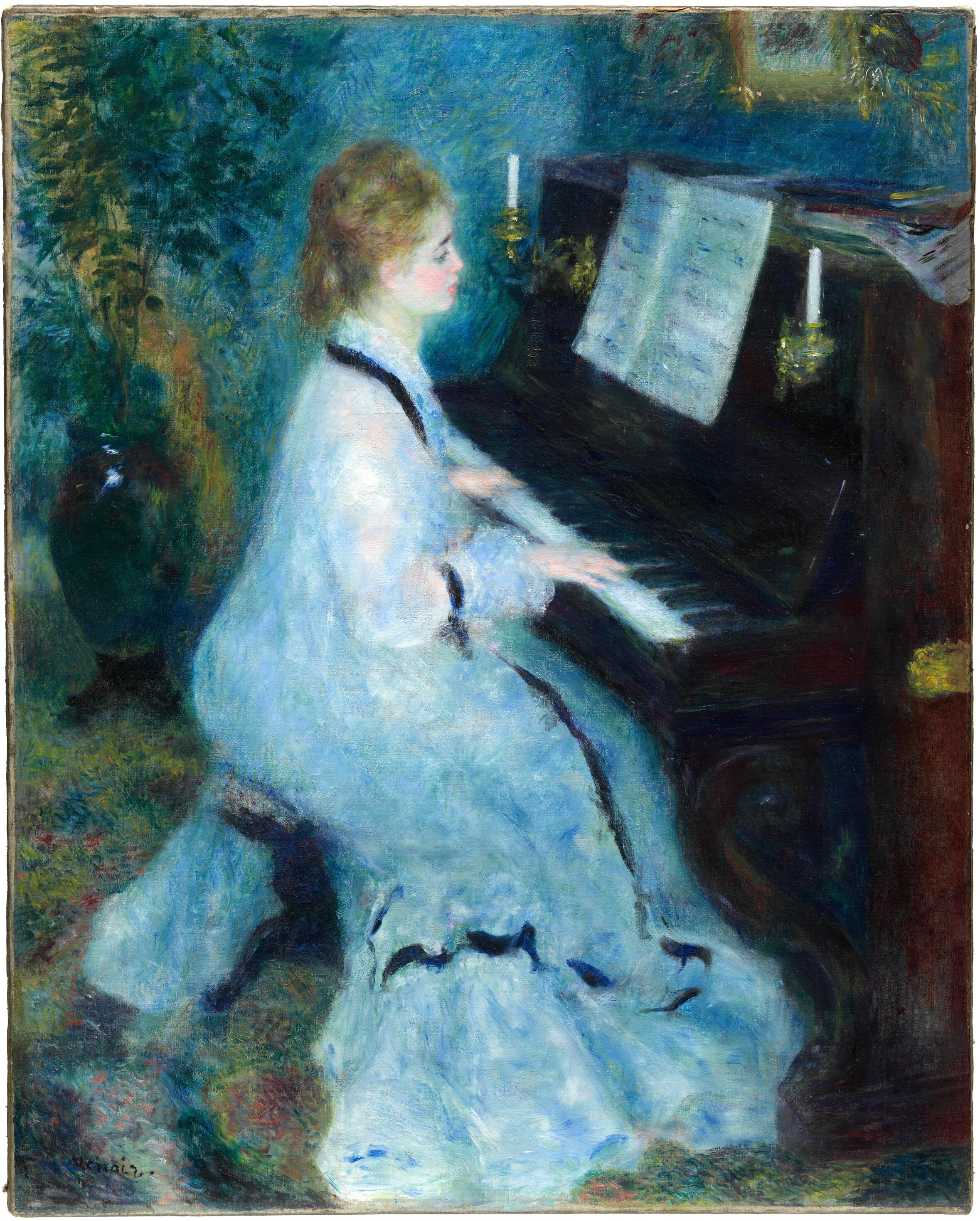
cat. 3 Woman at the Piano, 1875/76.
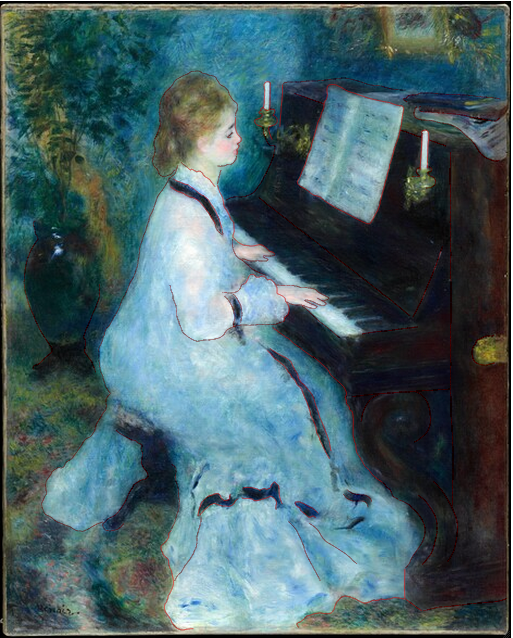
Renoir’s Woman at the Piano (1875/76). The Art Institute of Chicago, 1937.1025. Interactive image.
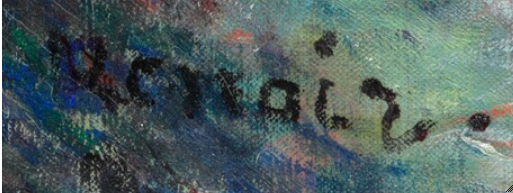
Detail of the artist’s signature in Renoir’s Woman at the Piano (1875/76). The Art Institute of Chicago, 1937.1025.
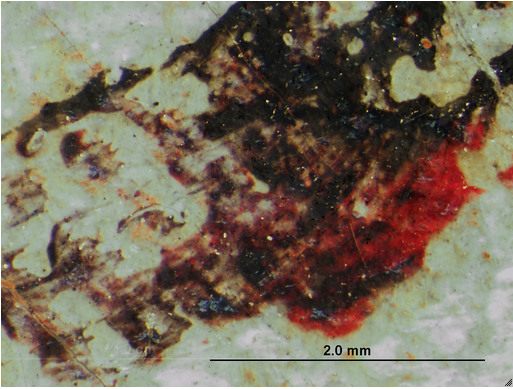
Photomicrograph of the signature in Renoir’s Woman at the Piano (1875/76) showing the mixture of translucent black and red paint. The Art Institute of Chicago, 1937.1025.
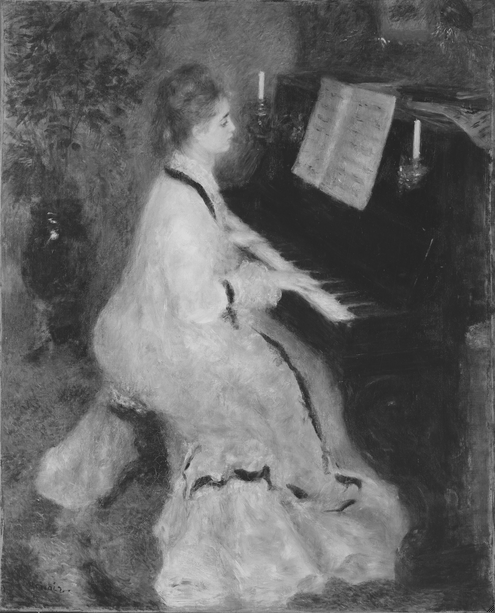
Clean-state photograph from the 1972 treatment of Renoir’s Woman at the Piano (1875/76). The Art Institute of Chicago, 1937.1025.
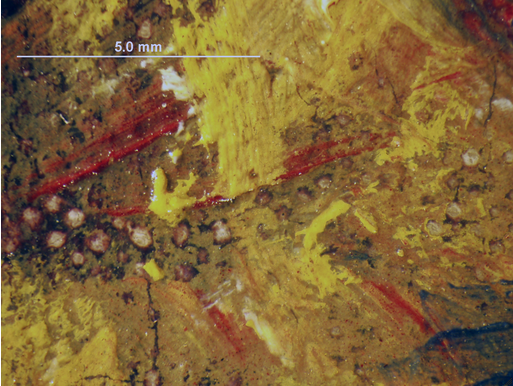
Photomicrograph of the piano in Renoir’s Woman at the Piano (1875/76). The original dark red paint that the artist scraped back can be seen between strokes of the heavier impasto of later layers. The Art Institute of Chicago, 1937.1025.
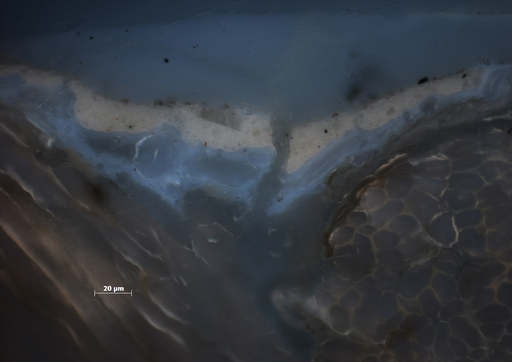
Photomicrograph in UV light of a cross section of the ground and canvas in Renoir’s Woman at the Piano (1875/76). The thin sizing layer between the canvas and the ground exhibits a bluish fluorescence. Original magnification: 500×. The Art Institute of Chicago, 1937.1025.
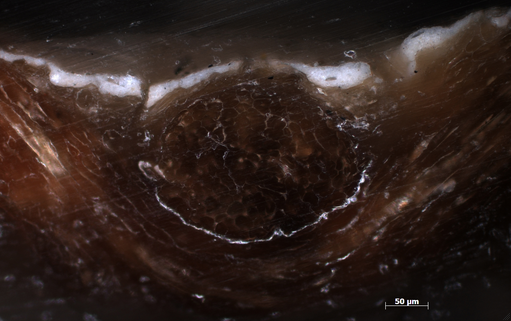
Photomicrograph of a cross section of the ground and canvas in Renoir’s Woman at the Piano (1875/76). Original magnification: 200×. The Art Institute of Chicago, 1937.1025.
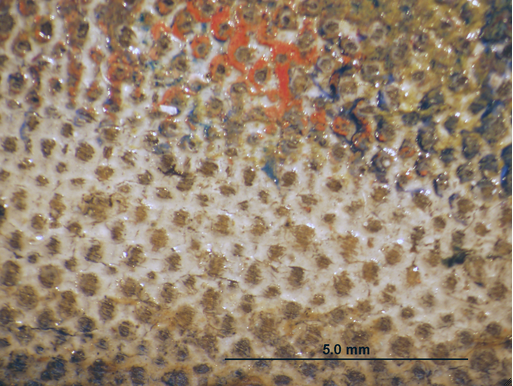
Photomicrograph of the warm-white ground in Renoir’s Woman at the Piano (1875/76). The Art Institute of Chicago, 1937.1025.
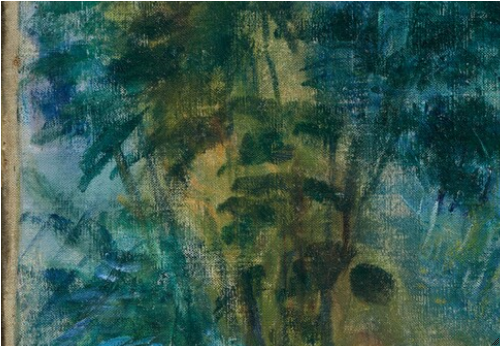
Detail of the upper left portion of Renoir’s Woman at the Piano (1875/76). The overall brightness of this area is the result of the artist’s use of bright white underpaint. The Art Institute of Chicago, 1937.1025.
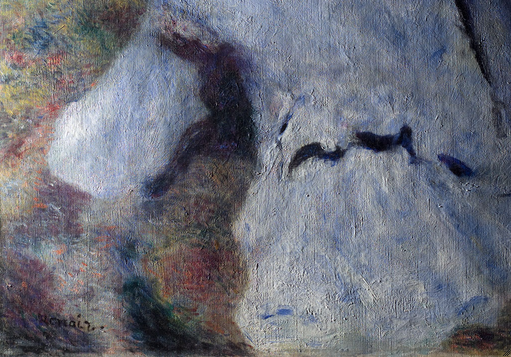
Raking-light detail of the lower left corner in Renoir’s Woman at the Piano (1875/76) showing the residual texture from the wide strokes of underpainting. The Art Institute of Chicago, 1937.1025.
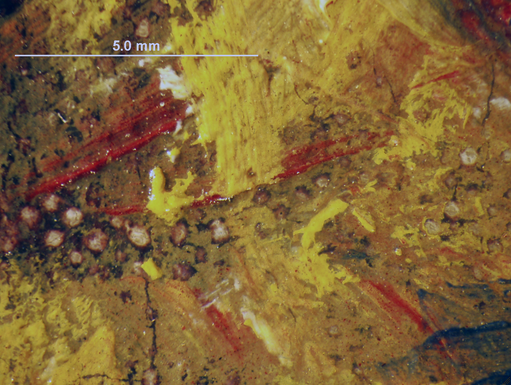
Photomicrograph of the impasted, yellow details on the side of the piano in Renoir’s Woman at the Piano (1875/76). The Art Institute of Chicago, 1937.1025.
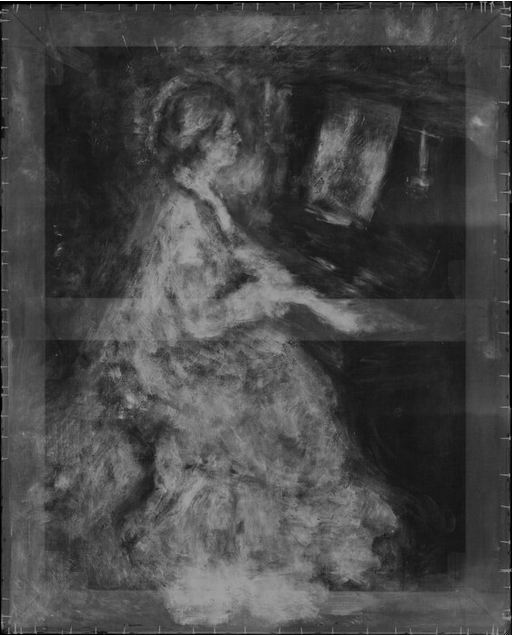
X-ray of Renoir’s Woman at the Piano (1875/76). The Art Institute of Chicago, 1937.1025. X-ray digitally composited by Robert G. Erdmann, University of Arizona.
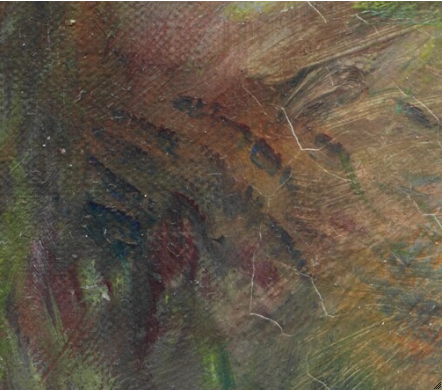
Detail of the figure’s hair in Renoir’s Woman at the Piano (1875/76) showing the artist’s layering of contrasting, directional strokes. The Art Institute of Chicago, 1937.1025.
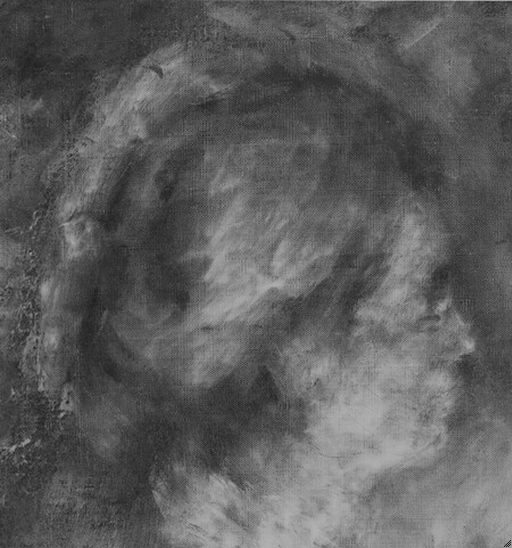
X-ray, raking-light, and natural-light details of the figure’s head in Renoir’s Woman at the Piano (1875/76). The Art Institute of Chicago, 1937.1025. Interactive image.
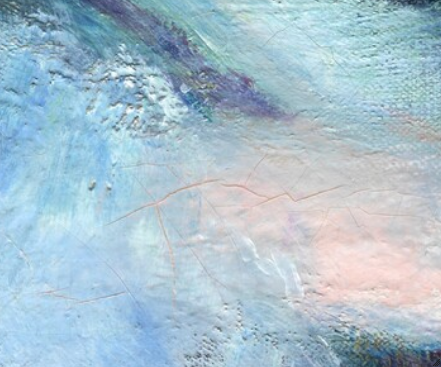
Detail of the figure’s arm in Renoir’s Woman at the Piano (1875/76) showing the sequence of paint layers. The Art Institute of Chicago, 1937.1025.
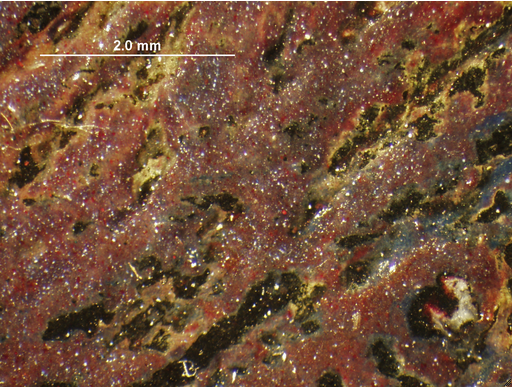
Photomicrograph of the piano in Renoir’s Woman at the Piano (1875/76) showing the artist’s use of scraping. The Art Institute of Chicago, 1937.1025.
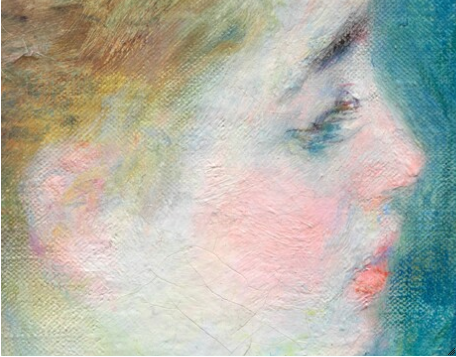
Detail of the figure’s face in Renoir’s Woman at the Piano (1875/76) showing the smooth modeling used in the flesh tones. The Art Institute of Chicago, 1937.1025.

Photomicrograph of the bright highlight on the vase in Renoir’s Woman at the Piano (1875/76). The Art Institute of Chicago, 1937.1025.
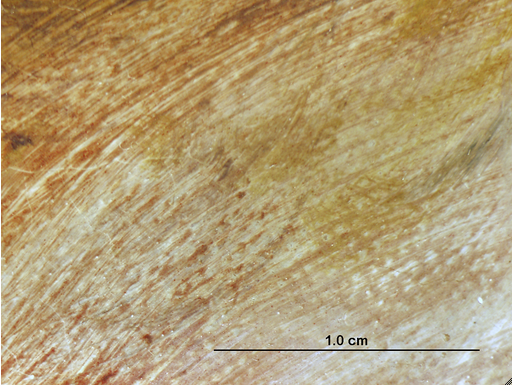
Photomicrograph of the figure’s hair in Renoir’s Woman at the Piano (1875/76) showing the artist’s use of stiff-bristle brushes. The Art Institute of Chicago, 1937.1025.
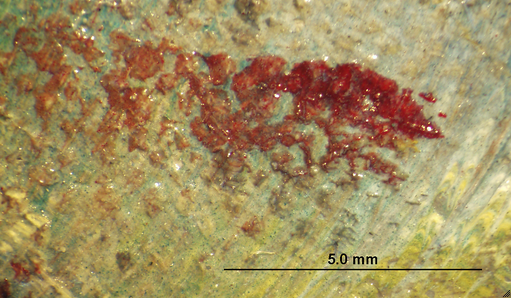
Photomicrograph of the rug in Renoir’s Woman at the Piano (1875/76). Bright and saturated details like this were added throughout the painting as a final step. The Art Institute of Chicago, 1937.1025.
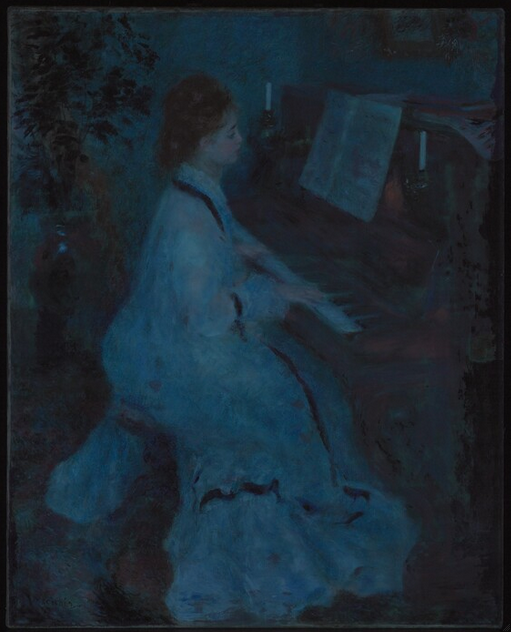
Ultraviolet image of Renoir’s Woman at the Piano (1875/76). The Art Institute of Chicago, 1937.1025.
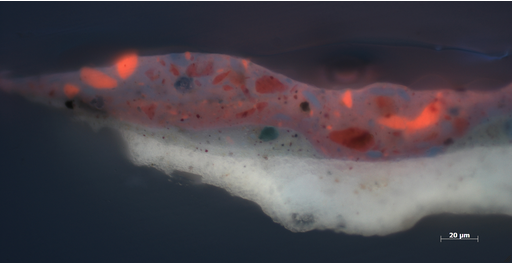
Photomicrograph in UV light of a cross section of the ground and paint layers in Renoir’s Woman at the Piano (1875/76). The paint mixture shows the artist’s use of fluorescing and nonfluorescing red lakes side by side. Original magnification: 500×. The Art Institute of Chicago, 1937.1025.
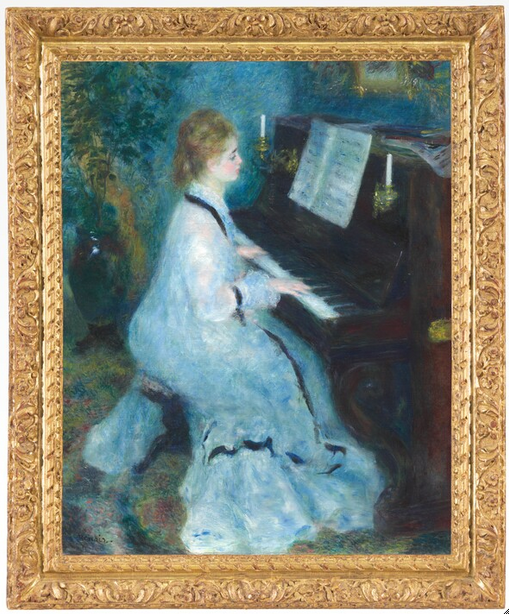
Renoir’s Woman at the Piano (1875/76) in its current frame. The Art Institute of Chicago, 1937.1025.
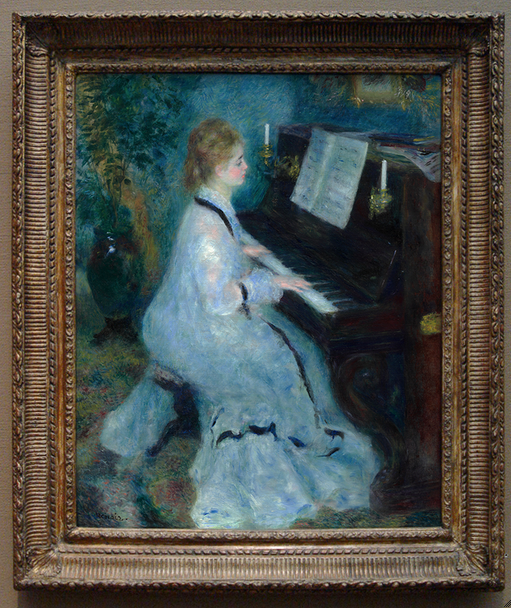
Renoir’s Woman at the Piano (1875/76) in a previous frame. The Art Institute of Chicago, 1937.1025.
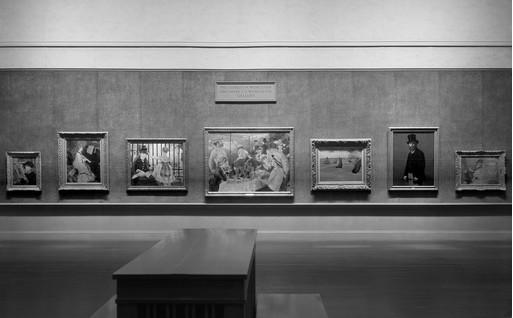
Renoir’s Woman at the Piano (1875/76) in a previous frame, second from left, installed in “A Century of Progress”: Loan Exhibition of Paintings and Sculpture, Art Institute of Chicago, May 23–Nov. 1, 1933. Institutional Archives, Art Institute of Chicago.
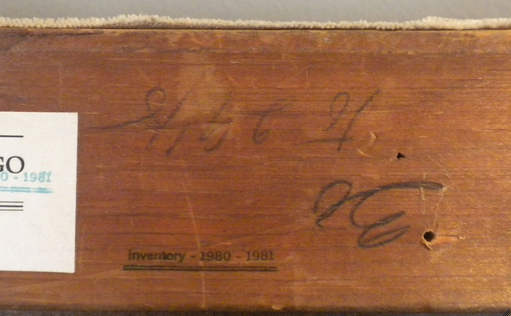
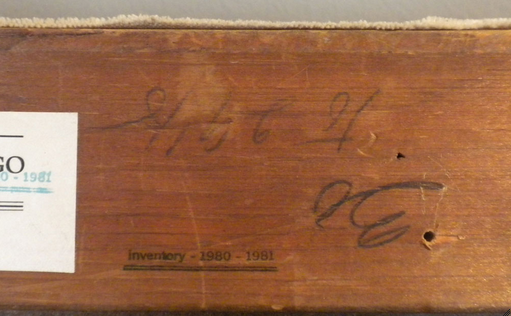
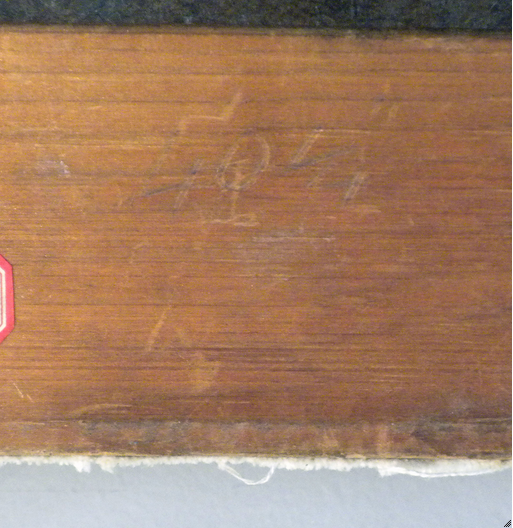
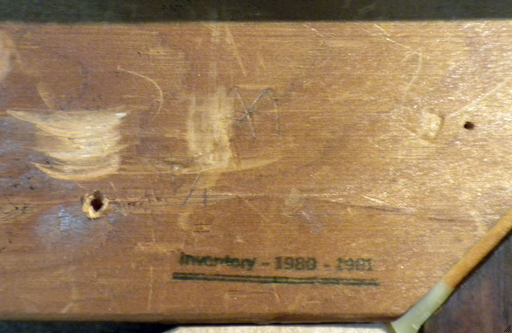
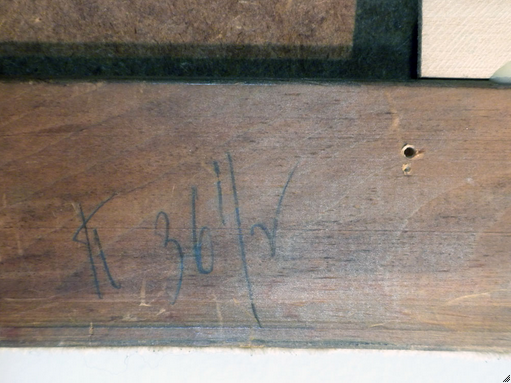
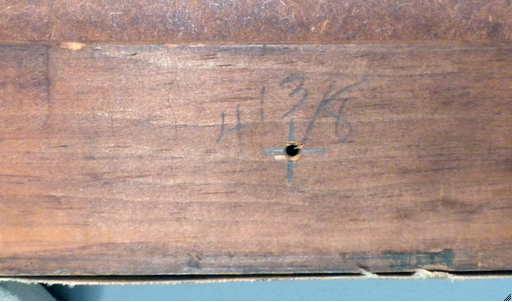
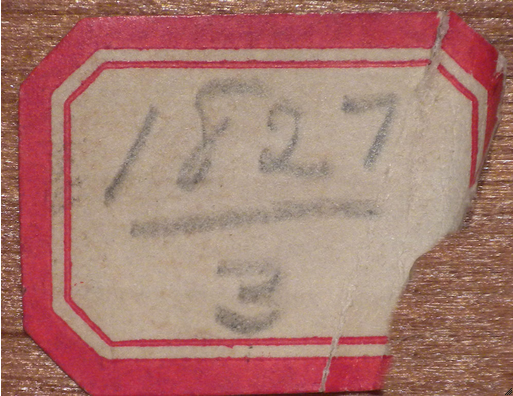
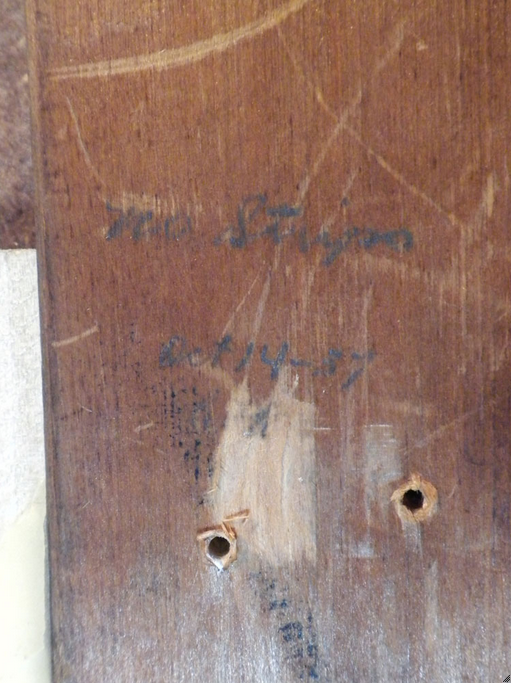
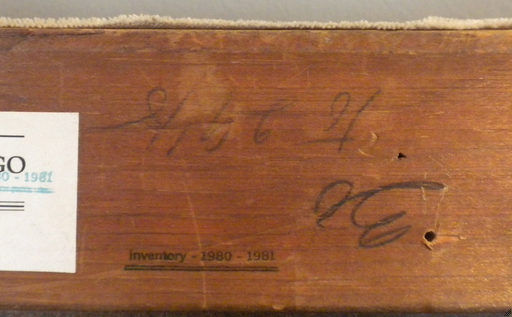
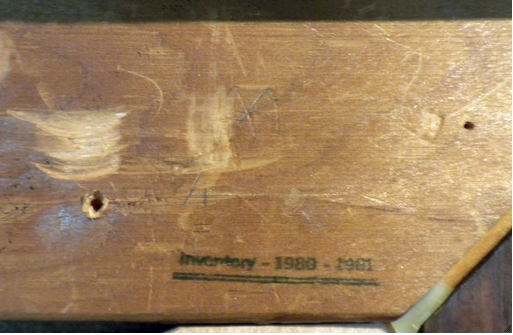
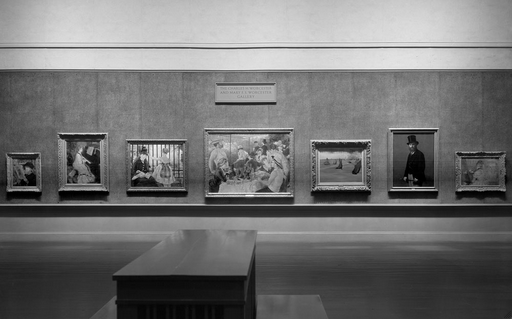
Installation of Renoir’s Woman at the Piano (1875/76) in “A Century of Progress”: Loan Exhibition of Paintings and Sculpture, May 23–Nov. 1, 1933. Institutional Archives, Art Institute of Chicago.
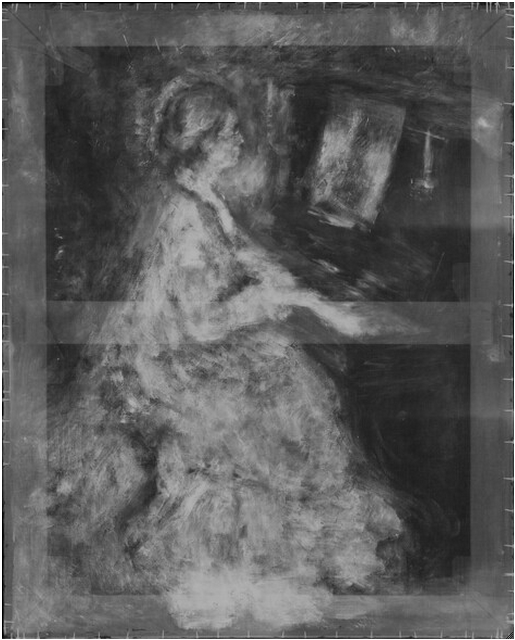
X-ray of Renoir’s Woman at the Piano (1875/76) showing artist’s changes to the piano. The Art Institute of Chicago, 1937.1025. X-ray digitally composited by Robert G. Erdmann, University of Arizona.
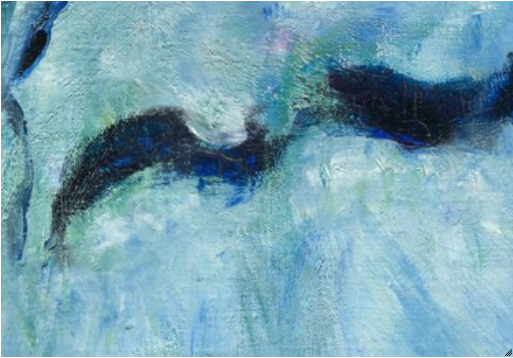
Detail of the peignoir in Renoir’s Woman at the Piano (1875/76). The Art Institute of Chicago, 1937.1025.
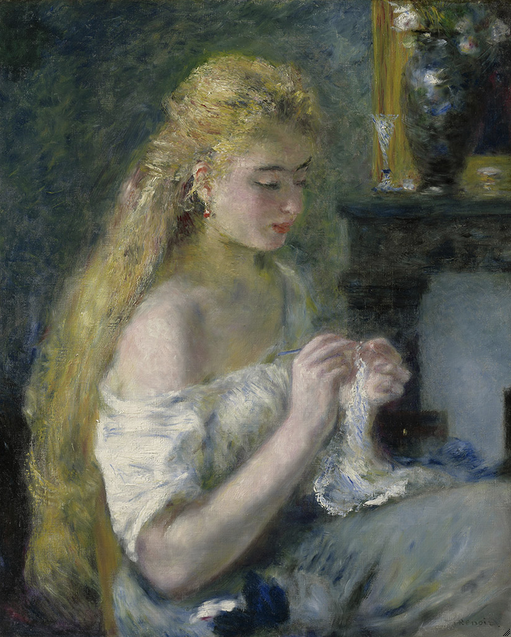
Pierre-Auguste Renoir (French, 1841–1919). A Girl Crocheting, c. 1875. Oil on canvas; 73.3 × 60.5 cm (28 7/8 × 23 13/16 in.). Sterling and Francine Clark Art Institute, Williamstown, Mass., 1955.603. Bridgeman Images.
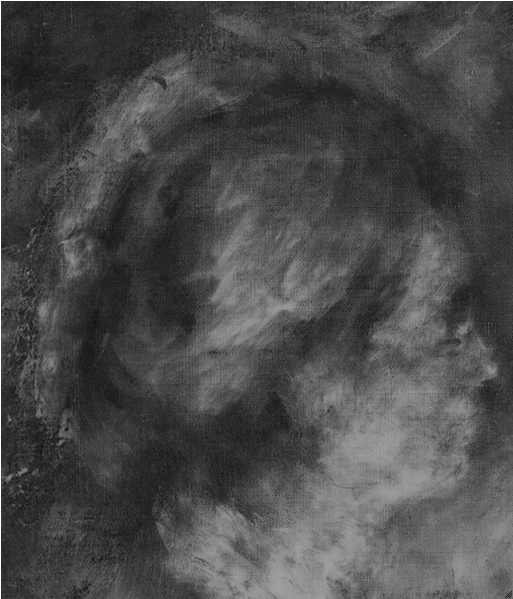
X-ray detail of the figure’s head in Renoir’s Woman at the Piano (1875/76) showing its previous position as profil perdu. The Art Institute of Chicago, 1937.1025. X-ray digitally composited by Robert G. Erdmann, University of Arizona.
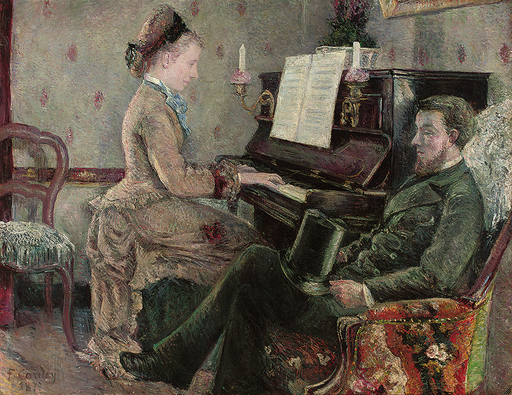
Frédéric Samuel Cordey (French, 1854–1911). Captive Audience, 1877. Oil on canvas; 114.3 × 146.7 cm (45 × 57 3/4 in.). Private collection. Photo © Christie's Images / The Bridgeman Art Library.
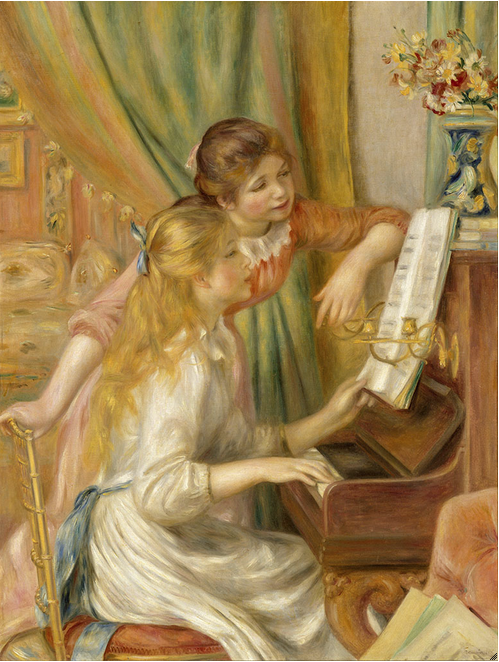
Pierre-Auguste Renoir (French, 1841–1919). Young Girls at the Piano, 1892. Oil on canvas; 116 × 90 cm (45 1/2 × 35 1/2 in.). Musée d’Orsay, Paris, RF755. © RMN-Grand Palais/Art Resource, NY. Photograph: Hervé Lewandowski.
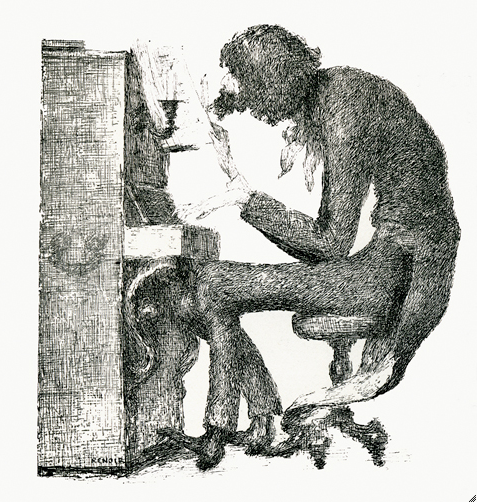
Pierre-Auguste Renoir (French, 1841–1919). Ornamental Letter D (Alphonse Daudet), c. 1878. Photomechanical reproduction of a pen and ink drawing, from Alphonse Daudet’s “Les salons bourgeois,” Les chefs-d’oeuvre d’art à l’exposition universelle (Ludovic Baschet, 1878), p. 29. Photograph: The National Gallery of Canada, Ottawa.
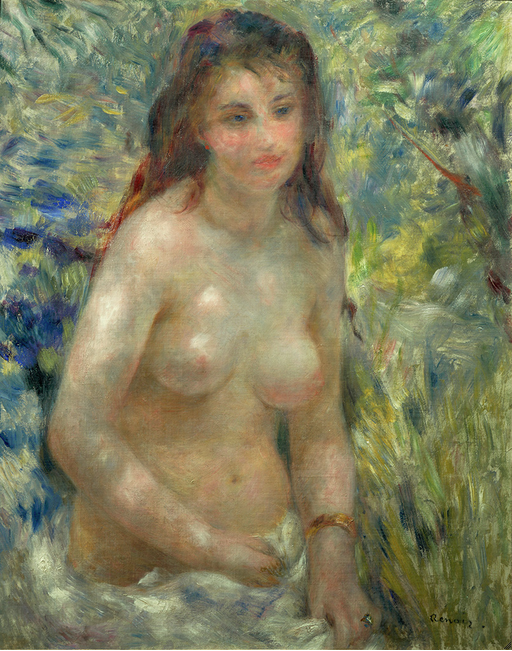
Pierre-Auguste Renoir (French, 1841–1919). Study of a Torso (Sunlight Effect), 1875/76. Oil on canvas; 81 × 65 cm (31 7/8 × 25 5/8 in.). Musée d’Orsay, Paris, France, RF2740. © RMN-Grand Palais/Art Resource, NY.
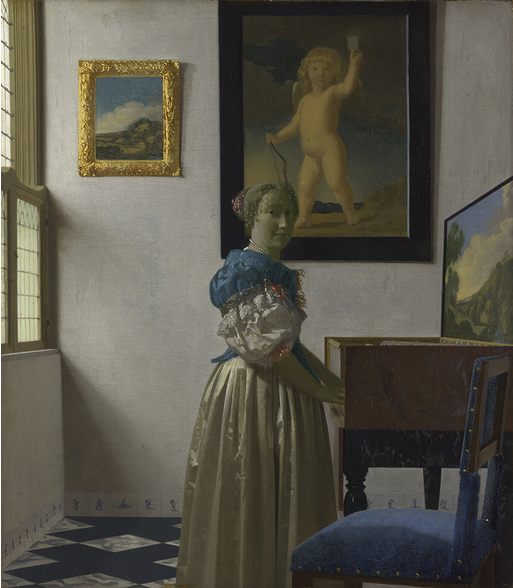
Johannes Vermeer (Dutch, 1632–1675). A Young Woman Standing at a Virginal, 1670/72. Oil on canvas; 51.7 × 45.2 cm (20 3/8 × 17 3/4 in). The National Gallery, London. © National Gallery, London/Art Resource, NY.
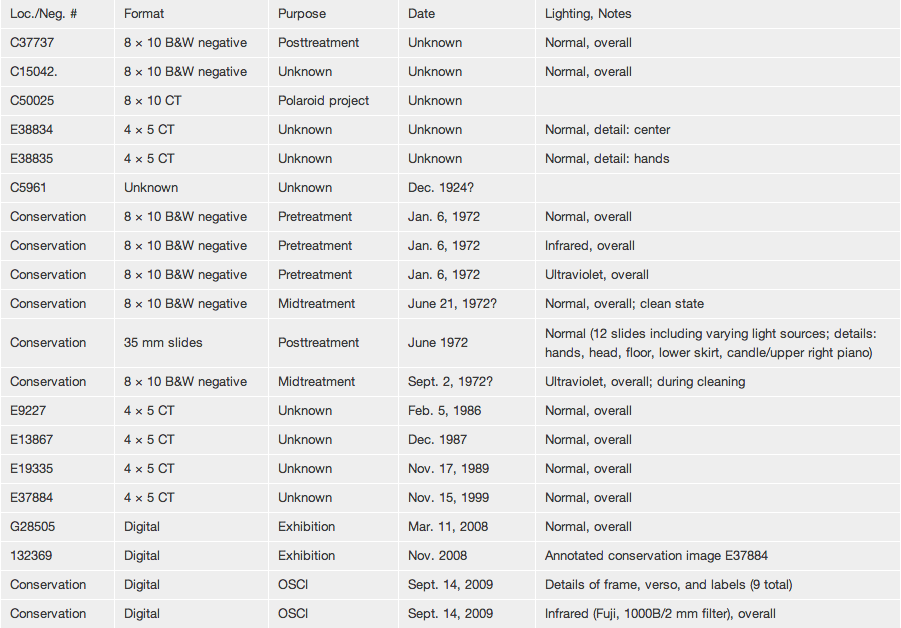
| Loc./Neg. # | Format | Purpose | Date | Lighting, Notes |
| C37737 | 8 × 10 B&W negative | Posttreatment | Unknown | Normal, overall |
| C15042. | 8 × 10 B&W negative | Unknown | Unknown | Normal, overall |
| C50025 | 8 × 10 CT | Polaroid project | Unknown | |
| E38834 | 4 × 5 CT | Unknown | Unknown | Normal, detail: center |
| E38835 | 4 × 5 CT | Unknown | Unknown | Normal, detail: hands |
| C5961 | Unknown | Unknown | Dec. 1924? | |
| Conservation | 8 × 10 B&W negative | Pretreatment | Jan. 6, 1972 | Normal, overall |
| Conservation | 8 × 10 B&W negative | Pretreatment | Jan. 6, 1972 | Infrared, overall |
| Conservation | 8 × 10 B&W negative | Pretreatment | Jan. 6, 1972 | Ultraviolet, overall |
| Conservation | 8 × 10 B&W negative | Midtreatment | June 21, 1972? | Normal, overall; clean state |
| Conservation | 35 mm slides | Posttreatment | June 1972 | Normal (12 slides including varying light sources; details: hands, head, floor, lower skirt, candle/upper right piano) |
| Conservation | 8 × 10 B&W negative | Midtreatment | Sept. 2, 1972? | Ultraviolet, overall; during cleaning |
| E9227 | 4 × 5 CT | Unknown | Feb. 5, 1986 | Normal, overall |
| E13867 | 4 × 5 CT | Unknown | Dec. 1987 | Normal, overall |
| E19335 | 4 × 5 CT | Unknown | Nov. 17, 1989 | Normal, overall |
| E37884 | 4 × 5 CT | Unknown | Nov. 15, 1999 | Normal, overall |
| G28505 | Digital | Exhibition | Mar. 11, 2008 | Normal, overall |
| 132369 | Digital | Exhibition | Nov. 2008 | Annotated conservation image E37884 |
| Conservation | Digital | OSCI | Sept. 14, 2009 | Details of frame, verso, and labels (9 total) |
| Conservation | Digital | OSCI | Sept. 14, 2009 | Infrared (Fuji, 1000B/2 mm filter), overall |
| Conservation | Digital | OSCI | Sept. 14–15, 2009 | Details of surface (12 total) |
| Conservation | Digital | OSCI | Sept. 15, 2009 | Raking light, overall |
| Conservation | Digital | OSCI | Sept. 15, 2009 | Normal, overall |
| Conservation | Digital | OSCI | Sept. 15, 2009 | Ultraviolet, overall |
| Conservation | X-ray | OSCI | Sept. 15, 2009 | X-ray films scanned/digitally composited, overall |
| Conservation | Digital | OSCI | Sept. 16, 2009 | Photomicrographs of sample sites and surface (24 total) |
| Conservation | Digital | OSCI | Sept. 21, 2009 | Infrared (Inframetrics 1.5–1.73 µm filter), overall; composite |
| Conservation | Digital | OSCI | Sept. 28, 2009 | Raking light details: lower left and figure face |
| G39028 | Digital | OSCI | Feb. 23, 2012 | Normal, overall; composite of G39729–G39753 |
| G39030 | Digital | OSCI | Feb. 23, 2012 | Normal, frame only |
| G39729 | Digital | OSCI | Feb. 23, 2012 | Section |
| G39730 | Digital | OSCI | Feb. 23, 2012 | Section |
| G39731 | Digital | OSCI | Feb. 23, 2012 | Section |
| G39732 | Digital | OSCI | Feb. 23, 2012 | Section |
| G39733 | Digital | OSCI | Feb. 23, 2012 | Section |
| G39734 | Digital | OSCI | Feb. 23, 2012 | Section |
| G39735 | Digital | OSCI | Feb. 23, 2012 | Section |
| G39736 | Digital | OSCI | Feb. 23, 2012 | Section |
| G39737 | Digital | OSCI | Feb. 23, 2012 | Section |
| G39738 | Digital | OSCI | Feb. 23, 2012 | Section |
| G39739 | Digital | OSCI | Feb. 23, 2012 | Section |
| G39740 | Digital | OSCI | Feb. 23, 2012 | Section |
| G39741 | Digital | OSCI | Feb. 23, 2012 | Section |
| G39742 | Digital | OSCI | Feb. 23, 2012 | Section |
| G39743 | Digital | OSCI | Feb. 23, 2012 | Section |
| G39744 | Digital | OSCI | Feb. 23, 2012 | Section |
| G39745 | Digital | OSCI | Feb. 23, 2012 | Section |
| G39746 | Digital | OSCI | Feb. 23, 2012 | Section |
| G39747 | Digital | OSCI | Feb. 23, 2012 | Section |
| G39748 | Digital | OSCI | Feb. 23, 2012 | Section |
| G39749 | Digital | OSCI | Feb. 23, 2012 | Section |
| G39750 | Digital | OSCI | Feb. 23, 2012 | Section |
| G39751 | Digital | OSCI | Feb. 23, 2012 | Section |
| G39752 | Digital | OSCI | Feb. 23, 2012 | Section |
| G39753 | Digital | OSCI | Feb. 23, 2012 | Section |
| G39029 | Digital | OSCI | July 24, 2012 | Ultraviolet, overall |
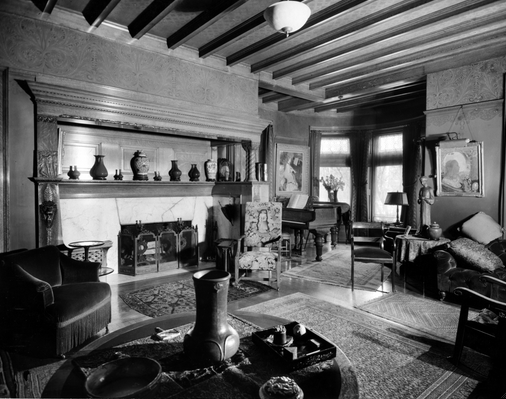
Renoir’s Woman at the Piano (1875/76) in a previous frame, on display in the home of Mr. and Mrs. Martin A. Ryerson. Institutional Archives, Art Institute of Chicago.
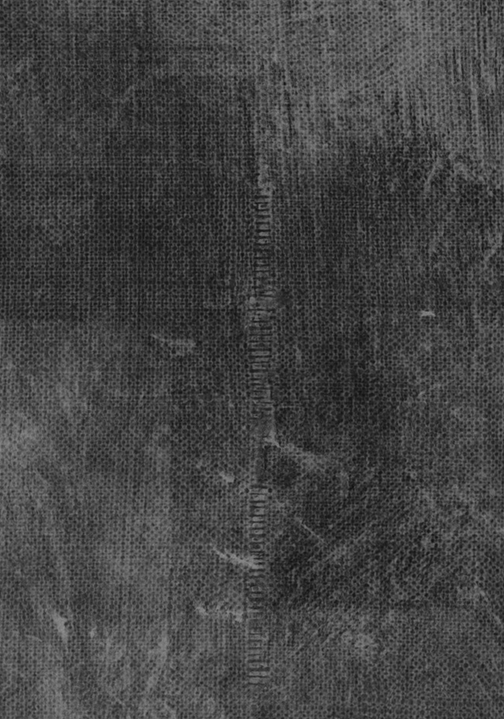
X-ray detail of Renoir’s Woman at the Piano (1875/76) showing the double thread fault. The Art Institute of Chicago, 1937.1025.
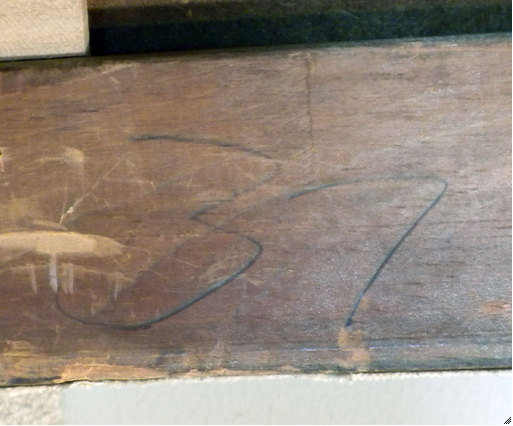
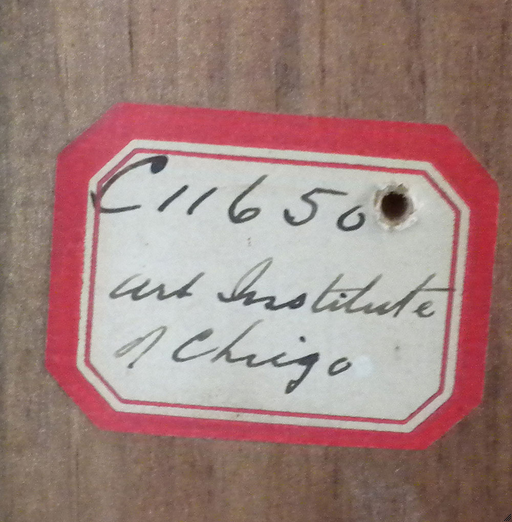
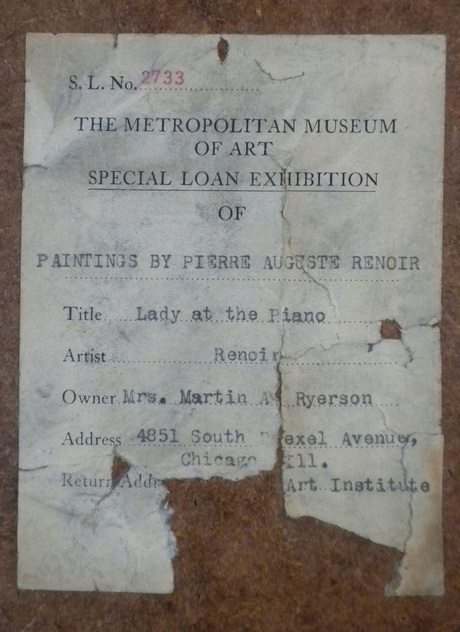
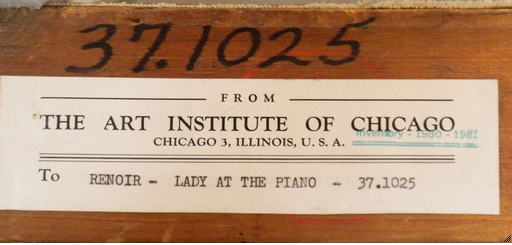
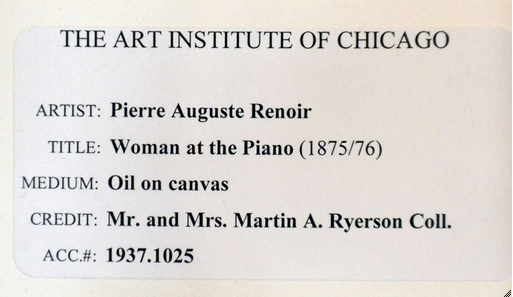
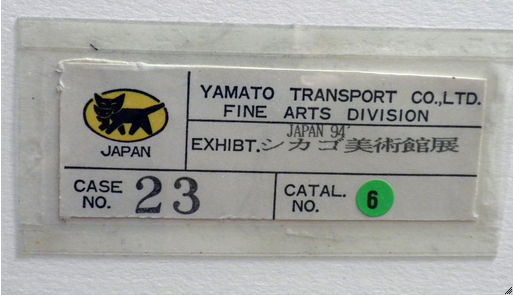
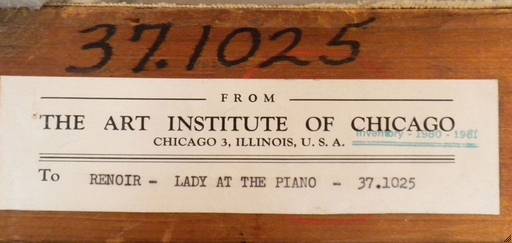
Alfred Sisley197
1876198
Oil on canvas; 66.2 × 54.8 cm (26 × 21 9/16 in.)
Signed: Renoir. (lower right, in dark red paint)
The Art Institute of Chicago, Mr. and Mrs. Lewis Larned Coburn Memorial Collection, 1933.453
In this painting of a close friend, Renoir dispensed with the formality typical of male portraiture in favor of an audacious originality of pose and execution. Comparing this work to his first portrait of Alfred Sisley (fig. 2.58 [Daulte 37; Dauberville 525]) and his picture of Alfred’s father, William Sisley (fig. 2.19 [Daulte 11; Dauberville 524]), makes clear how much Renoir’s pursuit of Impressionism over more than a decade opened up innovative paths of exploration.199 The elder Sisley moved to Paris from London in 1839 to manage a company dealing in luxury goods, with a specialty in imported gloves. Alfred was born on October 30 of the same year.200 Renoir’s portraits of the two Sisley men, depicted at the height of their prosperity, were important early commissions for the young artist, and he did not stray far from convention in pose, handling, and color. The image of William was accepted at the Salon of 1865 and ably proclaimed Renoir’s competence and skill as a portraitist to the Parisian public.
Eleven years later, in 1876, Renoir presented Alfred in a very different aspect. No longer is he the self-assured son of a comfortable bourgeois family, confident of his future. Instead he sits casually, facing the back of a mass-produced, bamboo-style side chair, with a distracted gaze that conveys a thoughtful introspection uncharacteristic of representations of men in nineteenth-century France, which for the most part coded authority and action. In 1926, near the end of his life, Claude Monet remembered the circumstances of the portrait’s creation: “I know of only one portrait of Sisley by Renoir. It’s the one he did at my house at Argenteuil, where he’s sitting astride my chair.”201 This would have been Monet’s second home in the riverside town of Argenteuil, the newly built Pavillon Flament, into which he moved with his family in October 1874.202 Monet, Renoir, and Sisley’s gathering there in 1876 was undoubtedly the occasion for earnest discussion of the future of Impressionist group exhibitions. Alfred Sisley is a fundamentally Impressionist painting in its freedom of handling and novel treatment of subject. While not intended as a manifesto for the movement, the portrait nevertheless acted as an affirmation of shared aesthetic goals that the three artists had cultivated over a decade and a half.203
Though the Chicago portrait would be the last of Renoir’s paintings for which Sisley posed, it was not the first time he had appeared in a painting that implied shared aesthetic views between the artist and the sitter. During the 1860s, he posed for a number of Renoir’s genre paintings. In 1868 he modeled with Renoir’s mistress Lise Tréhot for The Couple (fig. 3.60 [Daulte 34; Dauberville 256]), a bold demonstration of the artist’s awareness of the latest fashion trends and his mastery of colorful design.204 Firm adherents of the plein air school, Renoir and Sisley painted landscapes together in the forest of Fontainebleau during the summer of 1866. The occasion became the subject of Renoir’s first monumental group portrait, The Inn of Mère Antony (fig. 2.5 [Daulte 20; Dauberville 229]), in which Sisley is joined by fellow artist Jules Le Coeur and an unidentified figure.205 Sisley, dapper in a white felt hat and dark suit, engages his attentive companions in conversation. On the table before him sits a copy of L’événement, for which Émile Zola had been the art critic until that spring. The presence of the journal likely signifies Sisley’s involvement in progressive art debates of the day.206 His portrayal as a member of the avant-garde in The Inn of Mère Antony thus provides meaningful context for Renoir’s representation of him in the same capacity ten years later, though in the later work the point was made through provocative use of Impressionistic brushwork.
Monet, Renoir, and Sisley’s friendship began in 1862 in the studio of Charles Gleyre, where they first discovered that they shared common artistic interests. Recalling the first time she saw her future husband, probably in 1878 or 1879, Aline Charigot said that he was walking with Sisley and Monet on the rue Saint-Georges.207 Her description of the three as wearing their hair long and causing a spectacle by their appearance belies Sisley’s reputation for sporting elegant attire; in Renoir’s portrait he looks the perfect English gentleman, complete with starched shirt, cuff links, and lavaliere. Indeed, a photograph of Sisley usually dated to the early 1880s shows him meticulously clothed (fig. 2.8). Though Sisley may not have dressed the part of the struggling artist, there was no question about his aesthetic allegiances, allying himself as he did with Monet and Renoir to form a bloc within the Impressionist movement. In 1879 Renoir and Sisley declined to participate in the fourth Impressionist exhibition, choosing instead to send their paintings to the Salon that year (which Renoir had also done the year before). In 1880 Monet followed their example, exhibiting a landscape at the Salon (The Seine at Lavacourt, 1880; Dallas Museum of Art) rather than contributing to the fifth Impressionist exhibition in April. Sisley’s refusal by the Salon jury of 1879 weighed heavily on Renoir, whose portrait Madame Georges Charpentier and Her Children (1878; Metropolitan Museum of Art, New York [Daulte 266; Dauberville 239]) encountered no such resistance.208 In June 1879 Renoir wrote a letter to Georges Charpentier encouraging the publisher to hold an exhibition of Sisley’s work at the offices of La vie moderne, but this did not come about until November 1881.209 Possibly feeling betrayed by what he perceived as careerism trumping group ideals, Sisley grew distant from Renoir, eventually becoming so bitter and withdrawn that he preferred to cross the road rather than meet his former friend on the sidewalk.210
Though the art dealer Paul Durand-Ruel had been buying Sisley’s paintings since 1872, the commencement of the Impressionist exhibitions in April 1874 brought Sisley critical attention and hopes of an improved financial situation, much needed after his father’s bankruptcy following the outbreak of the Franco-Prussian War. The second Impressionist exhibition in April 1876 also proved salutary for Sisley’s career. His submission consisted of eight landscape views of his home at the time, Marly-le-Roi, located fifteen miles west of Paris near Bougival. They included two winter scenes and a view of the notorious floods that struck in March. The paint could hardly have been dry, but the works were already on the market; all of Sisley’s paintings in the exhibition were borrowed from art dealers, suggesting a growing appreciation of and demand for his work. Indeed, at least two critics of the exhibition singled him out as an artist of notable talent.211 A sense of Sisley’s rising star is conveyed in Renoir’s portrait, which first appeared as part of Renoir’s submission to the third Impressionist exhibition in April 1877. That exhibition was also the occasion of an ambitious display of work by Sisley. The catalogue listed seventeen Sisley landscapes, eleven of which had owners, including some of the most important Impressionist collectors: Georges Charpentier, Théodore Duret, and Georges de Bellio.
The portrait of Sisley probably remained in Renoir’s studio until it was sent to the exhibition. There is no evidence that Sisley himself ever owned the work. Indeed, an inscription on the original stretcher, portrait du peintre Sisley—par Renoir, displays characteristics of Renoir’s hand (in the formation of the p, for example) and may date from this time (fig. 2.7). The 1877 Impressionist exhibition included Renoir’s masterpiece Dance at the Moulin de la Galette (1876; Musée d’Orsay, Paris [Daulte 209; Dauberville 211]) and was pivotal to establishing his reputation as the preeminent Impressionist figure painter and portraitist.212 The portrait of Sisley was one of several to demonstrate Renoir’s ability in this genre. The others he exhibited represented a virtual assembly of the select members of Parisian society who supported him, including many of the same patrons who purchased work by Sisley: Marguerite Charpentier, wife of Georges (1876–77; Musée d’Orsay, Paris [Daulte 226; Dauberville 465]); Jeanne Samary (fig. 2.9 [Daulte 229; Dauberville 462]), actress of the Comédie Française; and Jacques-Eugène Spuller (c. 1877; private collection [Daulte 71; Dauberville 545]), a Republican politician who had been elected deputy of the Seine in March 1876.213 The emphasis on portrait painting in the context of an Impressionist exhibition was not simply self-promotion for Renoir; it was also an attempt to establish a new interest in the genre as an art form. Georges Rivière, one of Renoir’s closest friends at the time and his future biographer, provided one of the few contemporary comments on the Sisley portrait, highlighting its importance to Renoir’s development as an artist: “The series of portraits ends with one of Sisley, one of the establishment regulars. This portrait achieves an extraordinary likeness and possesses great value as a work of art.”214
In claiming that the Sisley portrait was not only an accurate likeness but also artistically significant, Rivière expanded the usual critical discourse surrounding portraiture at the Salon, which was limited in breadth as the genre did not invite progressive approaches to painting. Renoir’s example at the 1877 exhibition also inspired critics close to the Impressionists to reconsider portraiture’s validity as a pursuit for progressive artists. In a brief but pioneering historical survey of Impressionism published as a brochure in 1878, Duret alluded to Renoir’s gifts as a portrait painter: “Renoir excels at portraits. Not only does he catch the external features, but through them he pinpoints the model’s character and inner self.”215 Duret’s comments suggest that there existed a level of familiarity between the sitter and the artist in Renoir’s work that was unusual in nineteenth-century portrait painting. Sisley’s pose, as if he has been caught in a moment of reflection, is remarkably original, but it also reveals that Renoir looked to the past in developing his innovative approach: Alfred Sisley shares the psychological awareness and spontaneity of pose visible in the work of Frans Hals and Dutch seventeenth-century portraiture more generally (see fig. 2.10).
Renoir did not arrive easily at Sisley’s pose, however. [glossary:X-ray] and transmitted infrared images of the painting show that the artist made many changes to the position of the arms. It is possible that both arms were initially folded over the chair back (fig. 2.11; see Paint Layer in the technical report). But once resolved, the pose must have satisfied Renoir, as he returned to it in late 1877 for the commissioned portrait of the collector Eugène Murer (fig. 2.14 [Daulte 246; Dauberville 547]).216
It was in 1876 or early 1877 that Renoir and Sisley made the acquaintance of Murer, a pastry cook turned artist, who became one of Sisley’s most devoted patrons.217 Alfred Sisley was among eleven Renoir paintings that Murer apparently purchased in a lot for 500 francs, probably not long after the close of the third Impressionist exhibition at the end of April 1877.218 This transaction had taken place by early 1883, when the artist approached Murer about borrowing the portrait for his retrospective exhibition, organized by Durand-Ruel and scheduled to open April 1 of that year. But the portrait is not identified in the catalogue of the retrospective, nor is Murer credited as a lender to that exhibition, and thus it may not have been on display or may have been exhibited but not catalogued.219 Renoir’s request for the Sisley portrait suggests that he still felt kindly toward his friend, though little is known about their relationship during this period.220 Sisley’s own show of some seventy works, held June 1–25, 1883, followed the solo exhibitions of Monet, Renoir, Eugène Boudin, and Camille Pissarro and completed the series of Impressionist exhibitions at Durand-Ruel’s boulevard de la Madeleine location. Sisley remained an important member of the Impressionist circle of artists promoted by Durand-Ruel and kept up regular contact with Pissarro.221
This undated portrait has been assigned dates ranging from 1874 to 1879, but it was most likely made shortly after the second Impressionist exhibition of 1876, for a variety of reasons.222 First, an earlier date would be inconsistent with Renoir’s tendency in the mid-1870s to exhibit his paintings soon after they were finished. Second, the distinctive stippled appearance of the work, in which short brushstrokes rich with paint were used to create a highly textured surface, is shared by many works executed in 1876 and 1877, including the five other oil portraits in the 1877 Impressionist exhibition. This visually dynamic technique did not sit well with one art critic: “Some of Renoir’s Portraits look all right—at a distance—so that you do not notice too much his way of applying brushstrokes like pastel hatchings and the peculiar scratches that make his style seem so painful.”223 The comparison of Renoir’s brushstrokes to “pastel hatchings” can most readily be read as referring to the crisscross strokes in the arms and the overall lighter tone of Jeanne Samary (fig. 2.9). The brazen handling of the pale flesh tones in Sisley’s face, where, in addition to fine brushes, the artist used a palette knife to bring up the bright reddish-orange hues below (fig. 2.17), contrasts with the impeccably bourgeois presentation of the sitter and identifies Renoir irrefutably as a member of the Impressionist circle.
In 1902 Camille Mauclair suggested that Alfred Sisley anticipated the pointillism of the Neo-Impressionists, but the portrait displays little of the controlled construction of form and scientific approach to color that define that movement.224 Rather, Renoir achieved volume and depth by using a small brush to apply a wide range of colors. This is particularly noticeable in the small directional strokes of the beard (fig. 2.18). In addition, Renoir assigned as much importance to the layering of colors as to their juxtaposition. Around the eyes, for example, he applied the paint using several different methods in order to produce a variety of surface textures, from visible canvas weave to thick impasto that yields a sculptural effect (fig. 2.6). This technique of unifying the entire canvas with a stippled effect is frequently seen in Renoir’s more experimental painting style during the mid-1870s and is especially evident on close examination, where the details seem so gestural.
Renoir’s portrait of Sisley has long been recognized as an honorable tribute to an important friendship and artistic alliance. A photograph of the portrait, reproduced en lettre (in the body of the paragraph), was the opening illustration for a lengthy obituary of Sisley published in the March 1899 issue of the Gazette des beaux-arts.225 Appearing at a sensitive time following the Musée du Luxembourg’s acceptance of Gustave Caillebotte’s collection of Impressionist paintings, the obituary included an assessment of Impressionism’s place in art history.
John Collins
Renoir’s portrait of Alfred Sisley is heavily worked, making use of the various textures afforded by the [glossary:oil] medium. Beginning with a standard-size, commercially prepared [glossary:canvas], the artist appears to have sketched the initial contours of the figure in blue paint; some of these blue contours also initiated the painting process. Crosshatching and the play of competing textures and colors layered over one another are common throughout the background and the figure’s coat. The flesh tones show the heaviest working, especially in the face, where Renoir employed a [glossary:palette knife] to model the features, scraping away the paler layers to reveal the brighter paint beneath. The paint is often of a stiff consistency and contrasts with more traditional [glossary:wet-in-wet] modeling through its pronounced texture and limited intermixing. For the figure’s beard, the artist used a wide array of colors and very small brushes to create the sense of volume and depth. Lastly, small touches of bright color were added to the beard, eyes, and highlights of the chair.
Renoir made alterations to the main contours of the figure’s body, widening both arms, moving both cuffs, and raising the right shoulder. Evidence in the [glossary:transmitted-infrared] and [glossary:X-ray] images also suggests that Sisley may initially have been portrayed with his right hand crossed over his left across the top of the chair back. The chair itself was also changed: the vertical stiles were moved slightly to the left, and the curved, horizontal rails were tapered and curved further downward on the right side. The X-ray, raking-light, and infrared images show a number of unidentified forms around Sisley’s right hand and on the far right, which may indicate other changes.226 The work is coated with a thin [glossary:natural-resin varnish], which serves to saturate the colors and visually differentiate them, especially in the coat, hair, and dark background, but it is not original to the painting.
The multilayer interactive image viewer is designed to facilitate the viewer’s exploration and comparison of the technical images (fig. 2.52).227
Signed: Renoir. (lower right, in dark-red paint) (fig. 1.2, fig. 1.1).228
Flax (commonly known as linen).229
The original dimensions of the canvas were approximately 65 × 53.8 cm, measuring from the original foldover. This is consistent with a no. 15 portrait ([glossary:figure]) standard-size (65 × 54 cm) canvas; this is also the number stenciled on the verso of the original [glossary:stretcher] (fig. 2.20, fig. 1.3).230
[glossary:Plain weave]. Average [glossary:thread count] (standard deviation): 22.6V (0.7) × 16.8 (1.3) threads/cm. The vertical threads were determined to correspond to the [glossary:warp] and the horizontal threads to the [glossary:weft].231
There is [glossary:cusping] around the perimeter of the canvas corresponding to the placement of the original tacks; cusping along the vertical warp threads is particularly pronounced. In addition, the canvas is marked by irregular thread thickness, especially the horizontal threads, resulting in a wide variation in thread density (6.9–32.9 threads/cm) (fig. 2.53).232
Current stretching: When the painting was lined in 1972, the original dimensions were increased by approximately 0.25 cm (1/10 in.) on all sides (see Conservation History).
Original stretching: Based on cusping visible in the X-ray, the original tacks were placed approximately 4.5–6.5 cm apart.
Current stretcher: Four-member redwood ICA spring stretcher. Depth: 2.7 cm.
Original stretcher: Five-member keyable stretcher with blind mortise-and-tenon construction and a horizontal [glossary:crossbar]. Depth: 0.8 cm.233
Stamp
Location: original stretcher (discarded); 1972 photograph in conservation file
Method: ovular stamp
Content: TOILES ET COULEURS FINES / REY & Cie / PARIS. / x [5]1 RUE DE LA ROCHEFOUCAULD x (fig. 1.4)234
Stamp
Location: original stretcher (discarded); 1972 photograph in conservation file
Method: stamp
Content: 15 (fig. 1.3)
Stamp
Location: verso of original canvas (covered by lining)
Method: ovular stamp
Content: [. . .] / RE[Y] & [. . .] / PARI[S] / [. . .] RUE [. . .] (fig. 2.22)235
Not determined (probably glue).236
The canvas has a commercial [glossary:ground] layer that extends to the edges of the [glossary:tacking margins]. The preparation is smooth and thin, ranging from approximately 10–105 µm in depth, and partially fills the canvas [glossary:weave] (fig. 2.24).
The commercial preparation appears to be almost white, with dark particles visible under [glossary:stereomicroscopic examination] (fig. 2.23).237 The ground remains visible in selected areas of the background, especially on the right (fig. 2.12).
The ground is predominantly lead white with small amounts of barium sulfate; iron oxide yellow, orange, and/or brown; and associated silicates and clay minerals, calcium-based compounds, and traces of alumina.238 The binder is estimated to be oil.239
Reflected- and transmitted-infrared examinations indicate that Renoir outlined the figure’s coat and major contours; however, microscopic examination suggests that these contours also initiated the painting stage (fig. 2.54).240
Blue paint.
No compositional changes noted in drawing stage; see Paint Layer.
Renoir vigorously worked the paint throughout this composition, using various textures and exercising his ability to manipulate the medium. The work seems to have been executed in a number of stages, probably beginning with Sisley’s sitting for the artist while he established the basic composition, followed by further working up of the paint layers either with additional sittings or later in the studio; the paint layers appear to have mostly dried between painting campaigns. The paint in many areas is rather stiff, paste-like, and thick, reinforcing the textures of the canvas weave and underlying paint with each brushstroke. This is very evident on the upper right, where Renoir began with a heavy zigzag pattern in an ocher-beige color before layering blues and light greens over it (fig. 2.25). These cooler colors, which caught only the upper ridges of the texture beneath, contrast with the warmer undertones and create an interesting play of competing textures and directional strokes. A similar style of paint application, while less pronounced, can be seen in the background on the upper left (fig. 2.26). The crosshatched effect visible in the background, created with heavy strokes of a stiff-bristle brush, is characteristic of the modeling used throughout the work, and a comparable pattern of strokes in much flatter paint can be seen across the coat. As a finishing highlight on the figure’s left sleeve, the artist applied paint in thin, diagonal strokes that run against the curved contours of the arm. Here he allowed the bulk of the paint to load on one side of a flat brush, creating a thin line akin to that made by the edge of a palette knife.
The flesh tones were heavily worked, especially in the face, where Renoir employed very thick paint that he scraped back with a palette knife in some areas. The artist began these areas with thin strokes using a fine brush and almost-dry paint; the paint in these areas—under the eyes, for example—skipped the depressions in the canvas weave and left the ground exposed. Once the contours were established, he applied strong reddish-orange and blue hues in selected areas of the face, over which he put down thin layers of pale-pink and peachy colors for the flesh; then he scraped the flat surface of the palette knife across the upper, still-soft paint layers, revealing the brighter colors below (fig. 2.27). The stiffer paint consistency overall lent itself to a different kind of wet-in-wet [glossary:modeling], in which each stroke with a soft-bristle brush picked up less of the surrounding and underlying colors, but more of the texture. This is very evident in the figure’s beard, where the artist seems to have used all the colors on his [glossary:palette] with very small brushes in a series of small, directional strokes that blend with one another to varying degrees. Within the beard, traditional wet-in-wet modeling with paint of a more liquid consistency appears side by side with the stiffer paint (fig. 2.28), and a few bright touches were applied as final details once the majority of the paint was dry. Renoir used similar small dabs of bright color or white throughout the work, for example, the bright orange-reds and white highlights on the bamboo chair in the foreground and the blue, green, and yellow in the figure’s eyes (fig. 2.13).
The artist changed some of the major contours in this composition, adjusting Sisley’s pose and the space he occupies. The head and the hair immediately around it were established early in the process and the background brought in before the feathering curls on the right were added. The X-ray suggests that there may have been slight changes to the figure’s face and the placement of the nose and eyes; however, the nature of these revisions is unclear. The figure’s right shoulder was raised, and his right arm widened along its outer edge. Comparing the finished painting with the X-ray and infrared images suggests that Renoir altered this outer contour more than once. Similarly, the figure’s left sleeve was also widened along the forearm; this and a slight repositioning caused the elbow to largely obscure the top right corner of the chair. The X-ray suggests that the cuff of this sleeve may originally have been farther away from the face and farther down, which may have affected the position of the hand. The cuff was then moved up toward the face, making the sleeve longer, and the heel of the hand and the cuff in their current position were widened to make them proportionate to the sleeve. The X-ray and transmitted- and reflected-infrared images show other forms near the dangling right hand and on the far right that suggest that the artist may have made other compositional changes; for instance, it is possible that Sisley was initially portrayed with both elbows out and hands crossed over the back of the chair. In the transmitted-infrared image it looks as if the top edge of the figure’s right arm might have been higher than its final placement, while the [glossary:infrared reflectogram] shows the faint outline of his elbow out toward the right edge of the painting. The area around the fingers in the infrared and X-ray images suggests that both hands were once toward the center of the work, possibly with the right hand crossed over the left; as there is little evidence of the top edge of the figure’s left arm in any of the technical images, this idea appears to have been abandoned early in the process in favor of the current pose.241
While the thin, vertical spindles of the chair were executed over Sisley’s finished form, the larger elements—the vertical stiles and the horizontal rails—seem to have been established before Renoir brought in the dark-blue surroundings. After initially placing the two outer stiles and adjusting the figure’s coat and the background paint, the artist moved the chair slightly to the left. Under normal viewing conditions, the left edges of both stiles pass over the textured, diagonal strokes of the figure’s costume (fig. 2.29). The curved, horizontal rails of the chair back were also subtly altered; in front of the figure’s dangling right hand, the forms were slimmed and angled slightly further downward, to make them more symmetrical with the left side.
Stiff- and soft-bristle brushes with strokes up to 1 cm wide; small, round brushes; palette knife for scraping/removal of paint.
Analysis indicates the presence of the following [glossary:pigments]:242 lead white, cobalt blue, cerulean blue, chrome yellow,243 cadmium yellow,244 iron oxide yellow-brown, viridian, emerald green, carbon black, vermilion, madder lake, and a second red lake.
The observation of a characteristic salmon-colored [glossary:fluorescence] under [glossary:UV] light indicates that Renoir used fluorescing red lake in the flesh tones, hair, chair, and some areas of the coat (fig. 2.55). [glossary:Cross-sectional analysis] reveals that he used a second, nonfluorescing red lake in other areas (fig. 2.30). A small section from a sample containing both fluorescing and nonfluorescing red lakes was analyzed and found to contain madder lake.245
Binding media
Oil (estimated).246
The current very thin natural-resin varnish (damar) was applied during the 1996–97 treatment. UV examination reveals residues of an earlier natural-resin varnish around areas of thick [glossary:impasto] throughout the painting.
The work has been varnished at least three times in its history. The current [glossary:varnish] replaced a [glossary:synthetic varnish] applied during the 1972 treatment (see Conservation History). During that treatment, a discolored natural-resin varnish was removed. A 1968 condition report notes the presence of cleaning abrasions and subsequent “glazing” to hide them.247 Such abrasions indicate that the work was treated and cleaned prior to 1968, and therefore the natural-resin varnish present at that time was not original to the painting. In 1996 a very thin damar varnish was applied, locally blotted, and dry brushed to produce a lean surface while maintaining proper saturation.248
The painting has been treated on three documented occasions since the Art Institute acquired it in 1933. In 1968 the work was observed to have a yellowed natural-resin varnish and to be generally abraded, with retouched glazes to minimize the appearance of damage.249 The abraded appearance noted at this time is thought to be the result of a previous, undocumented cleaning, possibly prior to acquisition. A pulpboard insert was placed between the canvas and the stretcher at an unknown date; however, labels and stamps indicate that the painting retained its original stretcher. During the 1968 treatment, the work was cleaned of grime, and the heavy varnish was slightly thinned with solvents. The more noticeable losses and abrasions were inpainted, and the painting was varnished with three coats of synthetic varnish (an isolating layer of polyvinyl acetate [PVA] AYAA, followed by methacrylate resin L-46, and a final coat of AYAA).
The next treatment, in 1972, sought to address both structural and aesthetic issues.250 The work was cleaned of grime, varnish, and [glossary:overpaint] with solvents, then faced with starch paste in preparation for lining. The painting was wax-resin lined and attached to a new ICA spring stretcher of slightly larger dimensions. Pretreatment dimensions were listed as 65.5 × 54 cm, and the replacement stretcher measured 66 × 54.6 cm (26 × 21 1/2 in.). Before it was discarded, the original stretcher was photographed, labels were preserved, and stamps were documented with tracings. The work was inpainted and varnished with three coats of synthetic varnish, using the methods and materials of the 1968 treatment.
In 1996 the painting was treated in preparation for exhibition, and the synthetic surface coatings, [glossary:inpainting], and residual starch paste were removed.251 The painting was examined in its unvarnished state by a group of curators and conservators, who decided that the work was not intended to be completely unvarnished (see Surface Finish). While the flesh tones seemed improved by the cleaning, modeling of the figure’s dark coat and the background was obscured in the unvarnished state. The work was lightly varnished with damar, locally blotted, and dry brushed to achieve proper saturation and balance; finally, it was retouched.
The work is in good condition, wax lined, planar, and stable. The ground layer has darkened slightly due to the combined effects of grime, age, and saturation of the fabric by the lining material. There is cracking in and around more thickly painted areas, including parts of the coat, flesh tones, and background on the upper left, and there is a concentric impact crack near the figure’s elbow on the lower right. Small, localized losses, some inpainted, occur throughout, and the work has some [glossary:retouching] along the edges. The painting has a thin natural-resin varnish, which imparts saturation and an even gloss.
Kelly Keegan
The current frame appears to be original to the painting.252 It is a French, late-nineteenth–early-twentieth-century, Louis XIV reproduction, gilt torus frame with cast plaster anthemia corner cartouches and fleur-de-lis center cartouches linked by foliate scrolls and strapwork. The frame has oil and water gilding over red bole on cast plaster and gesso. The sight moldings are burnished, and the ornament is selectively burnished. The gilding is heavily rubbed and toned with a casein or gouache raw umber wash with a gray overwash. The molding is constructed of several woods, including oak, pine, and possibly linden, and is mitered and nailed. At some point in the frame’s history, the original verso was planed flat, removing all construction history and provenance, a back frame was added, and all back and interior surfaces were painted. The molding, from the perimeter to the interior, is torus with dentil outer molding; sanded back frieze bordered with fillets; scotia side; torus face with anthemia corner cartouches and fleur-de-lis center cartouches on diamond beds, linked by scrolls and strapwork with flower heads on a quadrillage bed; fillet; sanded front frieze; ogee with leaf-tip ornament linked by c-scrolls and strapping on a recut bed; and quirked ogee sight molding (fig. 2.57, fig. 2.44).
Kirk Vuillemot
Sold by the artist to Eugène Murer, Paris, by Apr. 1883, as part of a lot of eleven paintings sold for 500 francs.253
Deposited by Eugène Murer, Paris, at Durand-Ruel, Paris, 1883.254
Returned by Durand-Ruel, Paris, to Eugène Murer, Paris, 1883.255
Possibly sold by Eugène Murer, Paris, to Durand-Ruel, Paris, 1896.256
Acquired by Ivan Shchukin, Paris, by Mar. 1899.257
Sold at the Shchukin Sale, Hôtel Drouot, Paris, Mar. 24, 1900, lot 17, to Dr. George Viau, Paris, for 6,100 francs.258
Dr. George Viau, Paris, to at least June 20, 1912.259
Acquired by Herman Heilbuth, by 1921.260
Acquired by Howard Young, New York.261
Acquired by Mrs. Lewis Larned (Annie Swan) Coburn, Chicago, by 1929.262
Bequeathed by Mrs. Lewis Larned (Annie Swan) Coburn (died 1932), Chicago, to the Art Institute of Chicago, 1933.
Paris, 6, rue Le Peletier, 3e exposition de peinture [third Impressionist exhibition], Apr. 1877, cat. 190, as Portrait de M. Sisley.263
Rouen, Hôtel du Dauphin et d’Espagne, Magnifique collection d’impressionnistes dont 30 toiles du grand artiste Renoir, May 1896.264
Expos. Rétrosp. 1900.265
Dresden, Der Grosse Kunstausstellung Dresden 1904, Retrospekive Abteilung, May 1–end of Oct., 1904, cat. 2246, as Bildnis des Malers Sisley.266
Possibly Paris, Grand Palais, Salon d’Automne, Oct. 15–Nov. 15, 1904.267
Paris, Durand-Ruel, Portraits par Renoir, June 5–20, 1912, cat. 34, as Portrait de Sisley, 1876.268
Barcelona, Palacio de Bellas Artes, Exposition d’arts Français, Salon d’automne, 1917, possibly exhibited, but not in cat.269
Copenhagen, Ny Carlsberg Glyptotek Malerisale, August Renoir: Udstilling af hans Arbejder I Skandinavisk Eje samt Udlaan fra Franske Samlere, Mar. 17–Apr. 10, 1921, cat. 5.270
Art Institute of Chicago, Exhibition of the Mrs. L. L. Coburn Collection: Modern Paintings and Watercolors, Apr. 6–Oct. 9, 1932, cat. 31 (ill.).
New York, Wildenstein and Company, Great Portraits from Impressionism to Modernism, Mar. 1–29, 1938, cat. 39.
Milwaukee Art Institute, Masters of Impressionism, Oct. 8–Nov. 15, 1948, cat. 39.
Art Institute of Chicago, Paintings by Renoir, Feb. 3–Apr. 1, 1973, cat. 16 (ill.).
Washington, D.C., National Gallery of Art, The New Painting: Impressionism, 1874–1886, Jan. 17–Apr. 6, 1986, cat. 63 (ill.); Fine Arts Museums of San Francisco, M. H. de Young Memorial Museum, Apr. 19–July 6, 1986.
Tokyo, National Museum of Western Art, 1874 nen—Pari: (dai ikkai inshoha ten) to sono jidai/Paris en 1874: L’année de l’impressionnisme, Sept. 20–Nov. 27, 1994, cat. 44 (ill.).
Ottawa, National Gallery of Canada, Renoir’s Portraits: Impressions of an Age, June 27–Sept. 14, 1997, cat. 26 (ill.); Art Institute of Chicago, Oct. 17, 1997–Jan. 4, 1998; Fort Worth, Tex., Kimbell Art Museum, Feb. 8–Apr. 26, 1998. (fig. 2.16)
Fort Worth, Tex., Kimbell Art Museum, The Impressionists: Master Paintings from the Art Institute of Chicago, June 29–Nov. 2, 2008, cat. 22 (ill.).
Catalogue de la 3e exposition de peinture, exh. cat. (E. Capiomont et V. Renault, 1877), p. 13, cat. 190.271
Georges Rivière, “L’exposition des impressionnistes,” L’impressionniste 1 (Apr. 6, 1877), p. 4.
Paul Sébillot, “Exposition des impressionnistes,” Le bien public, Apr. 7, 1877, p. 2. Reprinted in Ruth Berson, ed., The New Painting: Impressionism, 1874–1886; Documentation, vol. 1, Reviews (Fine Arts Museums of San Francisco/University of Washington Press, 1996), p. 190.272
“Exposition des impressionnistes: 6, rue Le Peletier; 6,” La petite republique française, Apr. 10, 1877, p. 2. Reprinted in Ruth Berson, ed., The New Painting: Impressionism, 1874–1886; Documentation, vol. 1, Reviews (Fine Arts Museums of San Francisco/University of Washington Press, 1996), p. 176.
Émile Bergerat, “Revue artistique: Les impressionistes et leur exposition,” Journal officiel de la république française 105 (Apr. 17, 1877), p. 2918.
Trublot [Paul Alexis], “La collection Murer,” Le cri du peuple 43 (Oct. 21, 1887). Reprinted in Paul Gachet, Le docteur Gachet et Murer: Deux amis des impressionnistes (Musées Nationaux, 1956), p. 172.
Julien Leclercq, “Alfred Sisley,” Gazette des beaux-arts 21, 3 (Mar. 1899), pp. 227 (ill.), 534.
“Collection d’un amateur,” Gazette de l’hôtel Drouot 86–87 (Mar. 27–28, 1900), n. pag.
Camille Mauclair, “L’oeuvre d’Auguste Renoir,” L’art décoratif 41, pt. 1 (Feb. 1902), pp. 180, 182 (ill.).
Camille Mauclair, L’impressionnisme: Son histoire, son esthétique, ses maîtres, 2nd ed. (Librairie de l’Art Ancien et Moderne, 1904), pp. 112, 229. Translated by P. G. Konody as The French Impressionists (1860–1900) (Duckworth/E. P. Dutton, [1903]), p. 120.273
Grossen Kunstausstellung, Offizieller Katalog der Grossen Kunstausstellung Dresden 1904, exh. cat. (Alwin Arnold & Gröschel, Apr. 30, 1904), p. 123, cat. 2246.274
Henry Morrison, “Auguste Renoir, Impressionist,” Brush and Pencil 17, 5 (May 1906), p. 202.
Louis Vauxcelles, “Portraits contemporains,” L’art et les artistes 6 (Oct. 1907–Mar. 1908), p. 536 (ill.).
Durand-Ruel, Paris, Portraits par Renoir, exh. cat. (Durand-Ruel, Paris, 1912), p. 5, cat. 34.
Ambroise Vollard, La vie and l’oeuvre de Pierre-Auguste Renoir (A. Vollard, 1919), p. 48. Translated by Harold L. Van Doren and Randolph T. Weaver as Renoir: An Intimate Record (Knopf, 1925), pp. 53, 237.275
Georges Lecomte, “L’oeuvre de Renoir,” L’art et les artistes 4, 14 (Jan. 1920), p. 146 (ill.).
Ny Carlsberg Glyptotek Malerisale, Copenhagen, August Renoir: Udstilling af hans Arbejder I Skandinavisk Eje samt Udlaan fra Franske Samlere, exh. cat. (Ny Carlsberg Glyptotek Malerisale, 1921), p. 7, cat. 5.
Georges Rivière, Renoir et ses amis (H. Floury, 1921), opp. p. 50 (ill.).
Théodore Duret, Renoir (Bernheim-Jeune, 1924), p. 72. Translated into English by Madeleine Boyd as Renoir (Crown, 1937), p. 54.276
Gustave Geffroy, Sisley (G. Crès, 1927), p. 4 (ill.).
Julius Meier-Graefe, Renoir (Klinkhardt & Biermann, 1929), pp. 99–100, no. 1; 136, no. 106 (ill.).
Reginald Howard Wilenski, French Painting (Hale, Cushman & Flint, 1931), p. 262.
Hans Heilmaier, “Alfred Sisley,” Die Kunst 63, 5 (Feb. 1931), p. 137 (ill.).
Art Institute of Chicago, Exhibition of the Mrs. L. L. Coburn Collection: Modern Paintings and Watercolors, exh. cat. (Art Institute of Chicago, 1932), pp. 6; 22, no. 31; 53, no. 31 (ill.).
“Mrs. Coburn Leaves 83 Pictures, $200,000 Funds, to Chicago,” Art Digest 6, 18 (July 1, 1932), p. 5 (ill.).
Daniel Catton Rich, “The Bequest of Mrs. L. L. Coburn,” Bulletin of the Art Institute of Chicago 26, 6 (Nov. 1932), p. 68.
Ulrich Thieme and Felix Becker, “Renoir,” in Allgemeines Lexikon der Bildenden Künstler, vol. 28, Ramsden–Rosa (Seemann, 1934), p. 170.
Great Portraits from Impressionism to Modernism, with a foreword by Frank Crowninshield, exh. cat. (Wildenstein and Co./Marchbanks, 1938), p. 35, cat. 39.
Lionello Venturi, Les archives de l’impressionnisme: Lettres de Renoir, Monet, Pissarro, Sisley, et autres; Mémoires de Paul Durand-Ruel; Documents, vol. 2 (Durand-Ruel, 1939), opp. p. 52 (ill.); pp. 261, 310.
Lo Duca, “Il centenario di Alfred Sisley (1839–1939),” Emporium 90, 539 (Nov. 1939), p. 236 (ill.).
Rosamund Frost, Pierre Auguste Renoir, ed. Aimèe Crane, Hyperion Art Monographs (Hyperion/Duell, Sloan and Pearce, 1944), p. 21 (ill.).
John Rewald, The History of Impressionism (Museum of Modern Art/Simon & Schuster, 1946), pp. 296 (ill.), 313. Translated by Nancy Goldet-Bouwens as Histoire de l’impressionisme (A. Michel, 1955), p. 243.
Milwaukee Art Institute, Masters of Impressionism (Milwaukee Art Institute, 1948), cat. 39.
Marcelle Berr de Turique, Renoir (Phaidon, [1953]), pl. 34.
Paul Gachet, Le docteur Gachet et Murer: Deux amis des impressionnistes (Musées Nationaux, 1956), opp. p. 28, fig. 19; pp. 172; 176.
Paul Gachet, Lettres impressionnistes: Pissarro, Cézanne, Guillaumin, Renoir, Monet, Sisley, Vignon, Van Gogh, et autres . . . (Grasset, 1957), opp. p. 120 (ill.); p. 92.
François Daulte, Alfred Sisley: Catalogue raisonné de l’oeuvre peint (Durand-Ruel, 1959), p. 33, fig. 3.
Art Institute of Chicago, Paintings in the Art Institute of Chicago: A Catalogue of the Picture Collection (Art Institute of Chicago, 1961), p. 395.277
François Fosca, Renoir: L’homme et son oeuvre (A. Somogy, 1961), p. 114. Translated by Mary I. Martin as Renoir: His Life and Work (Prentice-Hall, 1962), p. 114.
Frederick A. Sweet, “Great Chicago Collectors,” Apollo 84, 55 (Sept. 1966), p. 203.
Charles C. Cunningham and Satoshi Takahashi, Shikago bijutsukan [Art Institute of Chicago], Museums of the World 32 (Kodansha, 1970), p. 163 (ill.).
François Daulte, Auguste Renoir: Catalogue raisonné de l’oeuvre peint, vol. 1, Figures, 1860–1890 (Durand-Ruel, 1971), pp. 136–37, cat. 117 (ill.).
Elda Fezzi, L’opera completa di Renoir: Nel periodo impressionista, 1869–1883, Classici dell’arte 59 (Rizzoli, 1972), p. 95, cat. 138 (ill.).278
Art Institute of Chicago, Paintings by Renoir, exh. cat. (Art Institute of Chicago, 1973), pp. 26; 60–61, cat. 16 (ill.); 66; 210; 211; 214.
Raymond Cogniat, Sisley, trans. Alice Sachs (Crown, 1978), pp. 3–4 (ill.).279
J. Patrice Marandel, The Art Institute of Chicago: Favorite Impressionist Paintings (Cross River, 1979), pp. 66–67 (ill.).
Diane Kelder, The Great Book of French Impressionism (Abbeville, 1980), pp. 255 (ill.), 438.280
Diane Kelder, The Great Book of French Impressionism, Tiny Folios (Abbeville, 1980), p. 152, pl. 12.
Sylvie Gache-Patin and Jacques Lassaigne, Sisley (Nouvelles Éd. Françaises, 1983), pp. 51; 52, ill. 57.
Barbara Ehrlich White, Renoir: His Life, Art, and Letters (Abrams, 1984), pp. 51, 54 (ill.), 74.
Daniel Wildenstein, Claude Monet: Biographie et catalogue raisonné, vol. 4, Peintures, 1899–1926 (Bibliothèque des Arts, 1985), p. 421, letter 2623.281
Richard R. Brettell, “The ‘First’ Exhibition of Impressionist Painters,” in The New Painting: Impressionism, 1874–1886, ed. Charles S. Moffett, with the assistance of Ruth Berson, Barbara Lee Williams, and Fronia E. Wissman, exh. cat. (Fine Arts Museums of San Francisco, 1986), p. 194.
Melissa McQuillan, Impressionist Portraits (Thames & Hudson, 1986), pp. 110–11 (ill.), 197.
Charles S. Moffett, ed., with the assistance of Ruth Berson, Barbara Lee Williams, and Fronia E. Wissman, The New Painting: Impressionism, 1874–1886, exh. cat. (Fine Arts Museums of San Francisco, 1986), pp. 206; 237, cat. 63 (ill.).
Richard R. Brettell, French Impressionists (Art Institute of Chicago/Abrams, 1987), pp. 36 (ill.), 37, 119.
Nicholas Wadley, ed., Renoir: A Retrospective (Hugh Lauter Levin/Macmillan, 1987), p. 211 (ill.).
Sophie Monneret, Renoir, Profils de l’art (Chêne, 1989), p. 150, cat. 17 (ill.).
David Bomford, Jo Kirby, John Leighton, and Ashok Roy, Art in the Making: Impressionism, exh. cat. (National Gallery, London/Yale University Press, 1990), p. 203, fig. 94.
Isabelle Cahn, “Documentary Chronology,” in Alfred Sisley, ed. MaryAnne Stevens, exh. cat. (Royal Academy of Arts, London/Musée d’Orsay/Walters Art Gallery/Yale University Press, 1992), p. 264, fig. 140.
Vivienne Couldrey, Alfred Sisley: The English Impressionist (David & Charles, 1992), p. 47.282
Iain Gale, Sisley (Studio, 1992), p. 28 (ill.).
Richard Shone, Sisley, Impressionists/Post-Impressionists (Phaidon, 1992), pp. 108–09, pl. 80; 110; 112; 122–23. Translated into French by Atelier d’Édition Européen as Richard Shone, Sisley (Phaidon, 2004), pp. 108–09, pl. 80; 110; 112; 122.
Art Institute of Chicago, Treasures of 19th- and 20th-Century Painting: The Art Institute of Chicago, with an introduction by James N. Wood (Art Institute of Chicago/Abbeville, 1993), p. 66 (ill.).
Anne Distel, Renoir: “Il faut embellir,” Découvertes Gallimard: Peinture 177 (Gallimard/Réunion des Musées Nationaux, 1993), pp. 38 (ill.), 168. Translated by Lory Frankel as Renoir: A Sensuous Vision (Thames & Hudson, 1995), pp. 38 (ill.), 168.
Akiya Takahashi and Ruth Berson, 1874 nen—Pari: (dai ikkai inshoha ten) to sono jidai/Paris en 1874: L’année de l’impressionnisme, exh. cat. (Kokuritsu Seiyo Bijutsukan/Yomiuri Shimbunsha, 1994), pp. 113, cat. 44 (ill.); 206.
Ruth Berson, ed., The New Painting: Impressionism, 1874–1886; Documentation, vol. 1, Reviews (Fine Arts Museums of San Francisco/University of Washington Press, 1996), pp. 120, 129, 176, 180, 190.
Ruth Berson, ed., The New Painting: Impressionism, 1874–1886; Documentation, vol. 2, Exhibited Works (Fine Arts Museums of San Francisco/University of Washington Press, 1996), pp. 82, 101 (ill.).
Natalia Brodskaïa, Auguste Renoir: He Made Colour Sing, trans. Paul Williams, Great Painters (Parkstone/Aurora Art, 1996), p. 28 (ill.).
Eliza E. Rathbone, “Renoir’s Luncheon of the Boating Party: Tradition and the New,” in Eliza E. Rathbone, Katherine Rothkopf, Richard R. Brettell, and Charles S. Moffett, Impressionists on the Seine: A Celebration of Renoir’s “Luncheon of the Boating Party,” exh. cat. (Phillips Collection/Counterpoint, 1996), p. 31.
Colin B. Bailey, “Portrait of the Artist as a Portrait Painter,” in Colin B. Bailey, with the assistance of John B. Collins, Renoir’s Portraits: Impressions of an Age, exh. cat. (National Gallery of Canada/Yale University Press, 1997), pp. 21; 51, n. 224. Translated as Colin B. Bailey, “Portrait de l’artiste en portraitiste,” in Colin B. Bailey, with the assistance of John B. Collins, Les portraits de Renoir: Impressions d’une époque, trans. Danielle Chaput and Julie Desgagné, exh. cat. (Gallimard/Musée des Beaux-Arts du Canada, 1997), p. 21.
Colin B. Bailey, with the assistance of John B. Collins, Renoir’s Portraits: Impressions of an Age, exh. cat. (National Gallery of Canada/Yale University Press, 1997), pp. 149–51, cat. 26 (ill.); 290, cat. 26. Translated by Danielle Chaput and Julie Desgagné, with support from Nada Kerpan for the texts by Linda Nochlin, as Les portraits de Renoir: Impressions d’une époque, exh. cat. (Gallimard/Musée des Beaux-Arts du Canada, 1997), pp. 50, n. 224; 149–51, cat. 26 (ill.); 290, cat. 26.
Douglas W. Druick, Renoir, Artists in Focus (Art Institute of Chicago/Abrams, 1997), pp. 10–11; 30; 82, pl. 1; 109.
Art Institute of Chicago, Impressionism and Post-Impressionism in the Art Institute of Chicago, selected by James N. Wood (Art Institute of Chicago/Hudson Hills, 2000), pp. 51 (ill.), 65.
John B. Collins, “Seeking l’Esprit Gaulois: Renoir’s Bal du Moulin de la Galette and Aspects of French Social History and Popular Culture” (Ph.D. diss., McGill University, 2001), p. 143.
Gilles Néret, Renoir: Painter of Happiness, 1841–1919, trans. Josephine Bacon (Taschen, 2001), pp. 188 (ill.), 202.
Sylvie Patin, L’impressionisme (Bibliothèque des Arts, 2002), pp. 164; 168, no. 128 (ill.); 299.
Norio Shimada, Inshoha bijutsukan [The history of impressionism] (Shogakukan, 2004), p. 91 (ill.).
Sylvie Patry, “L’invention du modèle,” in Serge Lemoine and Serge Toubiana, Renoir Renoir, exh. cat. (Martinière, 2005), p. 29, n. 8.
Susan Roe, The Private Lives of the Impressionists (Chatto & Windus, 2006), p. 211 (ill.).
Nathalia Brodskaïa, Impressionism, trans. Rebecca Brimacombe and Richard Swanson (Parkstone, 2007), pp. 170–71 (ill.).
Guy-Patrice Dauberville and Michel Dauberville, with the collaboration of Camille Frémontier-Murphy, Renoir: Catalogue raisonné des tableaux, pastels, dessins et aquarelles, vol. 1, 1858–1881 (Bernheim-Jeune, 2007), p. 532, cat. 543 (ill.).
Frances Suzman Jowell, “Impressionism and the Golden Age of Dutch Art,” in Inspiring Impressionism: The Impressionists and the Art of the Past, ed. Ann Dumas, exh. cat. (Denver Art Museum/Yale University Press, 2007), pp. 93; 104, fig. 40.
Robert McDonald Parker, “Topographical Chronology 1860–1883,” in Renoir Landscapes, 1865–1883, ed. Colin B. Bailey and Christopher Riopelle, exh. cat. (National Gallery, London, 2007), p. 275. Translated as Robert McDonald Parker, “Chronologie,” in Les paysages de Renoir, 1865–1883, ed. Colin B. Bailey and Christopher Riopelle, trans. Marie-Françoise Dispa, Lise-Éliane Pomier, and Laura Meijer, exh. cat. (National Gallery, London/5 Continents, 2007), p. 275.
Gloria Groom and Douglas Druick, with the assistance of Dorota Chudzicka and Jill Shaw, The Impressionists: Master Paintings from the Art Institute of Chicago, exh. cat. (Art Institute of Chicago/Kimbell Art Museum, 2008), pp. 62 (detail); 63, cat. 22 (ill.). Simultaneously published as Gloria Groom and Douglas Druick, with the assistance of Dorota Chudzicka and Jill Shaw, The Age of Impressionism at the Art Institute of Chicago (Art Institute of Chicago/Yale University Press, 2008), pp. 62 (detail); 63, cat. 22 (ill.).283
Adrien Goetz, Comment Regarder . . . Renoir (Hazan, 2009), p. 28 (ill.).
Peter Kropmanns, “Renoir’s Friendships with Fellow Artists,” in Renoir: Between Bohemia and Bourgeoisie; The Early Years, ed. Nina Zimmer, exh. cat. (Kunstmuseum Basel/Hatje Cantz, 2012), pp. 247 (ill.); 253, fig. 58; 254.
David Pullins, “Renoir and the Arts of Eighteenth-Century France,” in Renoir: Between Bohemia and Bourgeoisie; The Early Years, ed. Nina Zimmer, exh. cat. (Kunstmuseum Basel/Hatje Cantz, 2012), p. 264.
Inventory number
Deposit Durand-Ruel Paris 3913, livre de dépôt Paris 1879–84284
Photograph number
Photo Durand-Ruel Paris 1221285
Photograph number
Photo Bernheim-Jeune 10705286
Inscription
Location: frame
Method: handwritten script (blue pen) on masking tape
Content: “Portrait of Alfred Sisley” / By Renoir #33.453 / Renoir Exhib. (fig. 2.31)
Stamp
Location: original stretcher (discarded); 1972 photograph in conservation file
Method: ovular stamp
Content: TOILES ET COULEURS FINES / REY & Cie / PARIS. / x [5]1 RUE DE LA ROCHEFOUCAULD x (fig. 2.15)287
Stamp
Location: original stretcher (discarded); 1972 photograph in conservation file
Method: stamp
Content: 15 (fig. 2.46)
Stamp
Location: verso of original canvas (covered by lining)
Method: ovular stamp
Content: [. . .] / RE[Y] & [. . .] / PARI[S] / [. . .] RUE [. . .] (fig. 2.47)288
Number
Location: original stretcher (discarded); 1972 photograph in conservation file
Method: handwritten script
Content: 33.453 (fig. 2.32)
Number
Location: original stretcher (discarded); 1972 photograph in conservation file
Method: handwritten script
Content: 41 (fig. 2.33)
Label
Location: original stretcher (discarded); preserved in conservation file
Method: handwritten script on printed label
Content: Collection George Viau / Boulevard Haussmann, 47 / No / Renoir / Portrait de Sisley [top left, partial script] Expos[. . .] / de Dresde[. . .] / 1904 [top right, partial script] Expo. / Durand Ru[. . .] / 191[. . .] [center right, partial script] Ex[. . .] (fig. 2.34)
Number
Location: original stretcher (discarded); 1972 photograph in conservation file
Method: handwritten script
Content: 01442 (fig. 2.35)
Label
Location: original stretcher (discarded); fragment preserved in conservation file
Method: handwritten script on blue-and-white label
Content: 41 / Renoir. / [. . .] 00 (fig. 2.45)
Label
Location: original stretcher (discarded); preserved in conservation file
Method: printed label
Content: MAISON POTTIER (FONDÉE EN 1802) / CH. POTTIER / EMBALLEUR—PACKER / Spécialité pour Tableaux et Objets d’Art / 14, Rue Gaillon— / PARIS / Près l’Avenue de l’Opéra / 483 (fig. 2.36)
Label
Location: original stretcher (discarded); preserved in conservation file
Method: typed label
Content: 2677 (fig. 2.37)
Stamp
Location: original stretcher (discarded); 1972 photograph in conservation file
Method: stamp?
Content: Cahier / [. . .]onze / [. . .] / [. . .] (fig. 2.56)
Inscription
Location: original stretcher (discarded); 1972 photograph in conservation file
Method: handwritten script
Content: portrait du peintre / Sisley—[par] Renoir (fig. 2.38)
Number
Location: original stretcher (discarded); 1972 photograph in conservation file
Method: handwritten script
Content: 9 × 1[6] (fig. 2.39)
Label
Location: original stretcher (discarded); fragment preserved in conservation file
Method: printed label
Content: EXPOSITION D’[. . .] / 1[. . .]17—BARCE[. . .] (fig. 2.40)
Label
Location: stretcher
Method: printed and typed label with blue stamp
Content: FROM / THE ART INSTITUTE OF CHICAGO / CHICAGO ILLINOIS 60603, U. S. A. / To / Renoir, Pierre Auguste / Alfred Sisley c. 1875–76 / 1933.453 [blue stamp, lower right] Inventory—1980–1981 (fig. 2.41)
Label
Location: previous backing board (discarded); preserved in curatorial file
Method: printed and typed label with handwritten script
Content: [logo] National Gallery of Art / Washington, D.C. / Exhibition: THE NEW PAINTING: IMPRESSIONISM / 3-190 / Date: 1/17/86–4/6/86 / Cat. # 63 / Artist: Pierre-Auguste Renoir / Title: Portrait de M. Sisley / Lender: Art Institute of Chicago 1933.453 (fig. 2.42)
Label
Location: previous backing board (discarded); preserved in curatorial file
Method: typed label with handwritten script
Content: The New Painting: IMPRESSIONISM / National Gallery of Art 16 Jan.–6 April, 1986 / The Fine Arts Museums of San Francisco / 19 April–6 July, 1986 / Title: Portrait de M. Sisley / Artist: Pierre-Auguste Renoir / Lender: The Art Institute of Chicago / Crate # 97 / Cat # 63 / 1933.453 (fig. 2.43)
Label
Location: backing board
Method: printed and typed label with handwritten script (red marker, graphite)
Content: [logo] Japan / YAMATO TRANSPORT CO.,LTD. / FINE ARTS DIVISION / EXHIBT. 1874: The Year of / Impressionism / 44 / CASE [Japanese characters] 8782-1 / NO. 131-[7?]2695906 / CATAL. IUP-IV/ NO. 8782-1 (fig. 2.49)
Label
Location: backing board
Method: printed label
Content: Renoir’s Portraits: Impressions of an Age / Cat.No.: 26 / Artist: Pierre-Auguste Renoir / Title: Alfred Sisley / Owner: Art Institute of Chicago (fig. 2.50)
Label
Location: backing board
Method: printed and typed label
Content: THE ART INSTITUTE OF CHICAGO / artist Renoir, Pierre Auguste / title Portrait of Alfred Sisley / medium oil on canvas / credit / acc. # 1933.453 (fig. 2.51)
Label
Location: backing board
Method: printed and typed label
Content: THE ART INSTITUTE OF CHICAGO / “Renoir’s Portraits: Impressions of an Age” / October 17, 1997–January 4, 1998 / 26 / Pierr-Auguste [sic] Renoir / Alfred Sisley / The Art Institute of Chicago (fig. 2.48)
Westinghouse X-ray unit, scanned on Epson Expressions 10000XL flatbed scanner. Scans were digitally composited by Robert G. Erdmann, University of Arizona.
Inframetrics Infracam with 1.5–1.73 µm filter; Fujifilm S5 Pro with X-Nite 1000B/2 mm filter (1.0–1.1 µm); Goodrich/Sensors Unlimited SU640SDV-1.7RT with H filter (1.1–1.4 µm) and J filter (1.5–1.7 µm).
Fujifilm S5 Pro with X-Nite 1000B/2 mm filter (1.0–1.1 µm).
Natural-light, raking-light, and transmitted-light overalls and macrophotography: Fujifilm S5 Pro with X-NiteCC1 filter.
Fujifilm S5 Pro with X-NiteCC1 filter and Kodak Wratten 2E filter.
Sinar P3 camera with Sinarback eVolution 75 H (X-NiteCC1 filter and Kodak Wratten 2E filter).
Sample and cross-sectional analysis were performed using a Zeiss Axioplan2 research microscope equipped with reflected light/UV fluorescence and a Zeiss AxioCam MRc5 digital camera. Types of illumination used: darkfield, brightfield, differential interference contrast (DIC), and UV. In situ photomicrographs were taken with a Wild Heerbrugg M7A StereoZoom microscope fitted with an Olympus DP71 microscope digital camera.
Several spots on the painting were analyzed in situ with a Bruker/Keymaster TRACeR III-V with rhodium tube.
Zeiss Universal research microscope.
Cross sections were analyzed after carbon coating with a Hitachi S-3400N-II VPSEM with an Oxford EDS and a Hitachi solid-state BSE detector. Analysis was performed at the Northwestern University Atomic and Nanoscale Characterization Experimental (NUANCE) Center, Electron Probe Instrumentation Center (EPIC) facility.
A Jobin Yvon Horiba LabRAM 300 confocal Raman microscope was used, equipped with an Andor multichannel, Peltier-cooled, open-electrode charge-coupled device detector (Andor DV420-OE322; 1024×256), an Olympus BXFM open microscope frame, a holographic notch filter, and an 1,800-grooves/mm dispersive grating.
The excitation line of an air-cooled, frequency-doubled, He-Ne laser (632.8 nm) was focused through a 20× objective onto the samples, and Raman scattering was back collected through the same microscope objective. Power at the samples was kept very low (never exceeding a few mW) by a series of neutral density filters in order to avoid any thermal damage.289
Thread count and weave information were determined by Thread Count Automation Project software.290
Overlay images were registered using a novel image-based algorithm developed by Damon M. Conover (GW), Dr. John K. Delaney (GW, NGA), and Murray H. Loew (GW) of the George Washington University’s School of Engineering and Applied Science and the National Gallery of Art, Washington, D.C.291
The image inventory compiles records of all known images of the artwork on file in the Conservation Department, the Imaging Department, and the Department of Medieval to Modern European Painting and Sculpture at the Art Institute of Chicago (fig. 2.21).
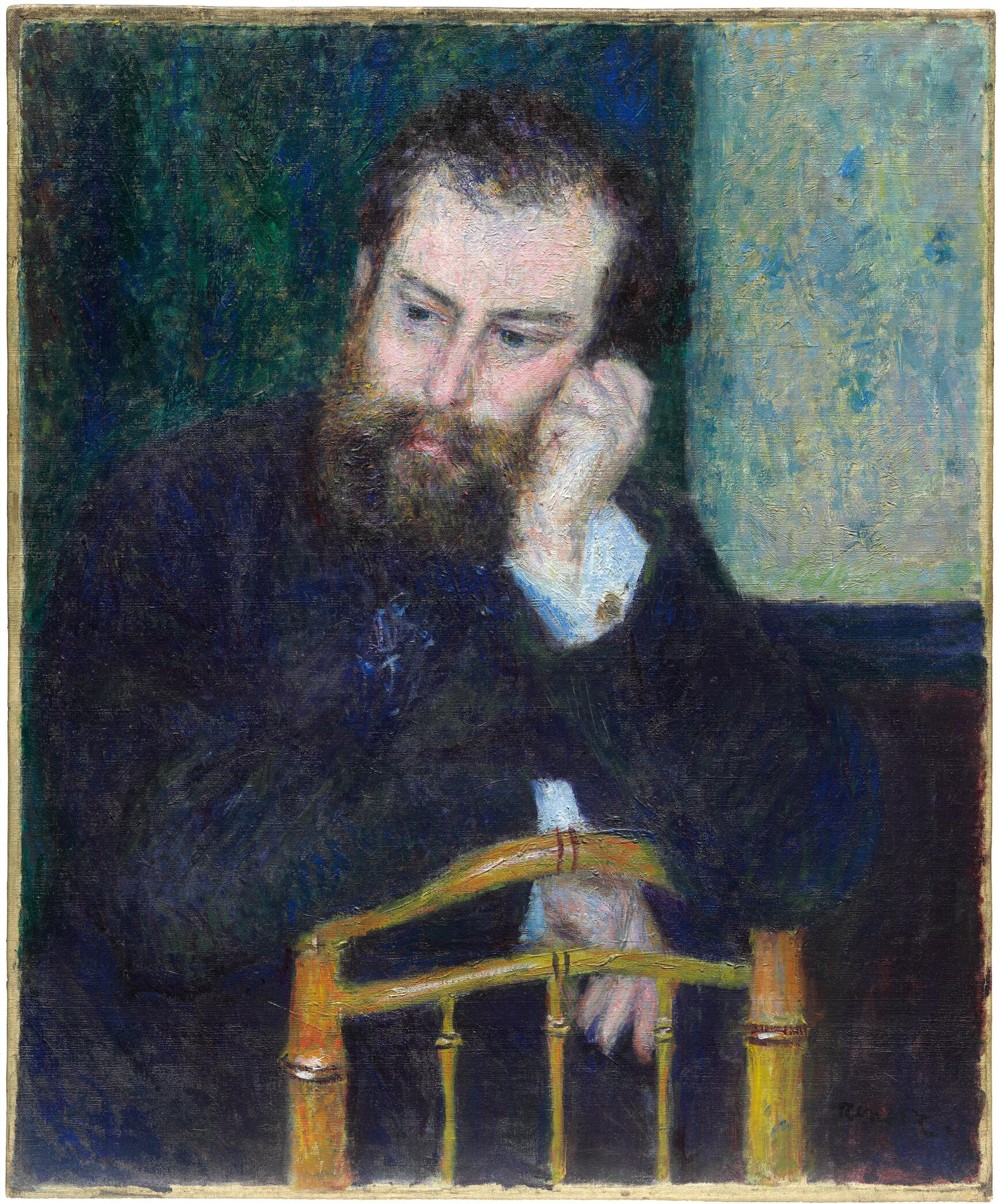
cat. 4 Alfred Sisley, 1876.
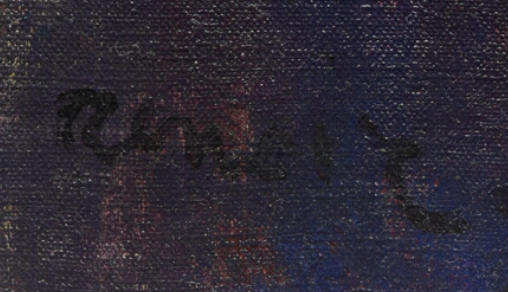
Detail of the signature in Renoir’s Alfred Sisley (1876). The Art Institute of Chicago, 1933.453.
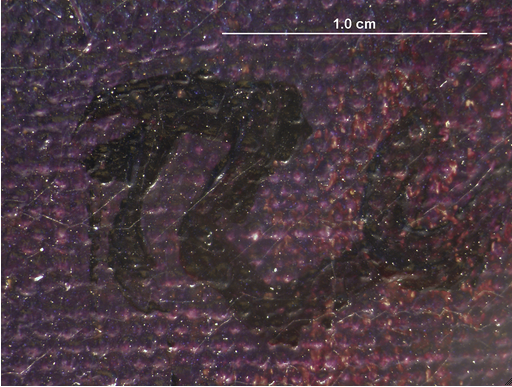
Photomicrograph of the signature in Renoir’s Alfred Sisley (1876) showing the dark-red paint mixture. The Art Institute of Chicago, 1933.453.
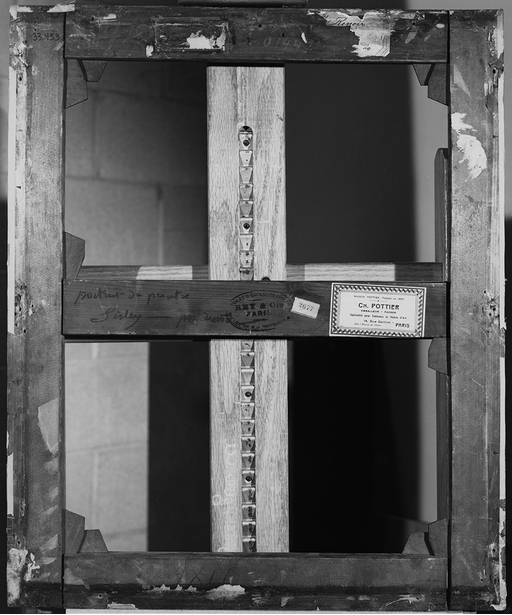
Image of the stretcher verso during the 1972 treatment of Renoir’s Alfred Sisley (1876) showing the original inscriptions and labels. The Art Institute of Chicago, 1933.453.
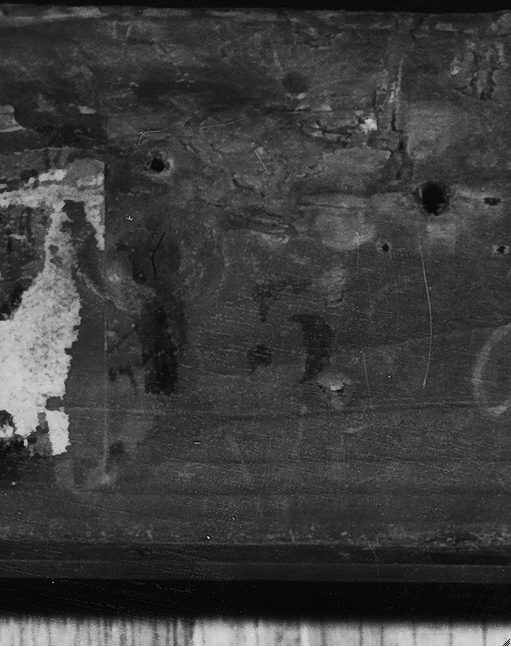
Detail of the verso of the original stretcher of Renoir’s Alfred Sisley (1876) showing the standard size stamp (15). The Art Institute of Chicago, 1933.453.
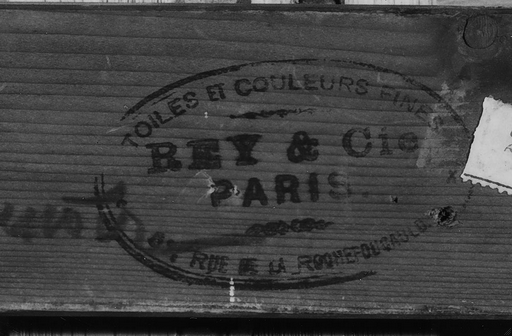
Detail of the verso of the original stretcher of Renoir’s Alfred Sisley (1876) showing the Rey & Cie color merchant stamp. The Art Institute of Chicago, 1933.453.
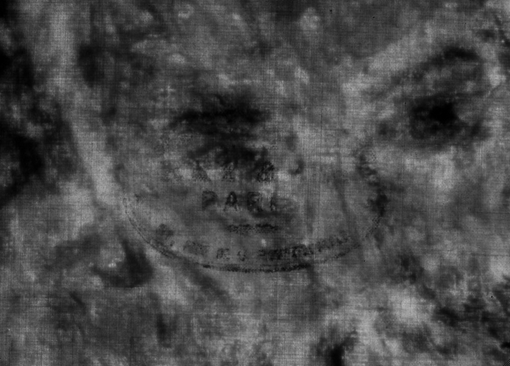
Transmitted-infrared (Fuji, 1.0–1.1 µm) detail of Renoir’s Alfred Sisley (1876) showing the Rey & Cie color merchant stamp on the verso of the now-lined canvas. The Art Institute of Chicago, 1933.453.
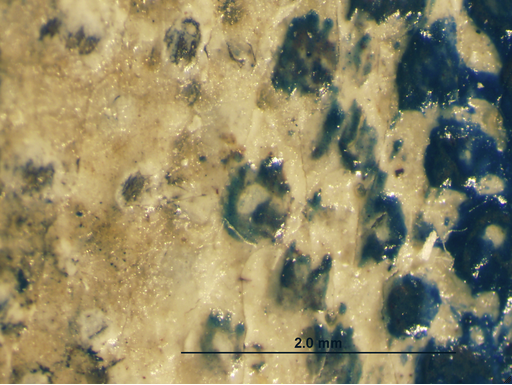
Photomicrograph of the ground along the left edge of Renoir’s Alfred Sisley (1876). The Art Institute of Chicago, 1933.453.
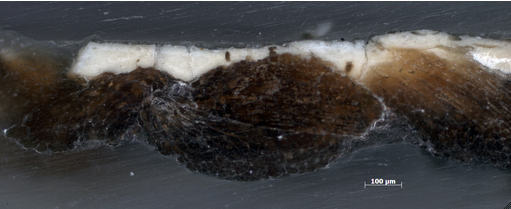
Photomicrograph of a cross section from Renoir’s Alfred Sisley (1876) showing the canvas and ground. Original magnification 100×. The Art Institute of Chicago, 1933.453.
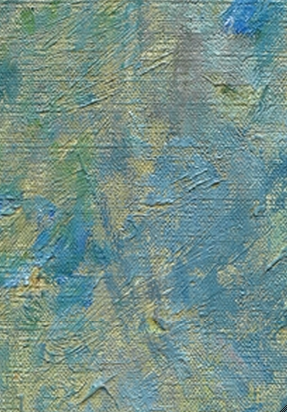
Detail of the background on the upper right in Renoir’s Alfred Sisley (1876) showing the zigzag brushwork. The Art Institute of Chicago, 1933.453.
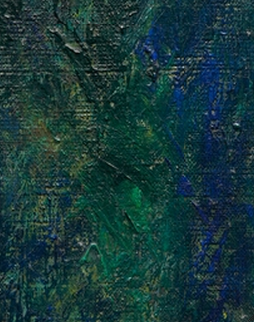
Detail of the background on the left in Renoir’s Alfred Sisley (1876) showing crosshatched brushwork. The Art Institute of Chicago, 1933.453.
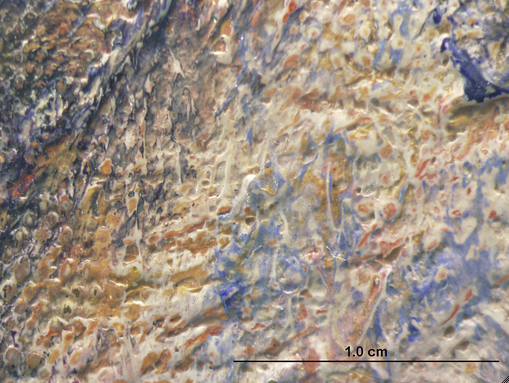
Photomicrograph of the figure’s forehead in Renoir’s Alfred Sisley (1876). The artist scraped back the pale flesh tones to reveal the brighter colors underneath. The Art Institute of Chicago, 1933.453.
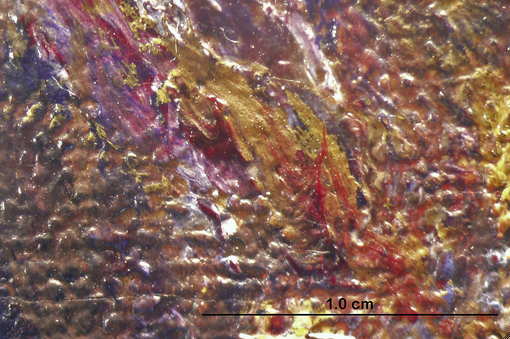
Photomicrograph of the figure’s beard in Renoir’s Alfred Sisley (1876) showing variation in paint consistency. The Art Institute of Chicago, 1933.453.
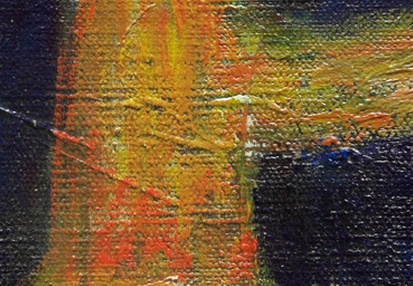
Detail of the chair back in Renoir’s Alfred Sisley (1876) showing the textured strokes that make up the figure’s coat passing under the chair. The Art Institute of Chicago, 1933.453.
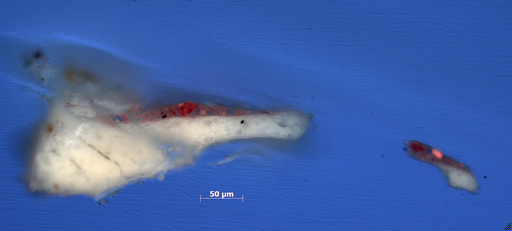
Photomicrograph in UV light of a cross section from Renoir’s Alfred Sisley (1876). Fluorescing red lake and nonfluorescing madder lake were both used in this paint mixture. Original magnification 200×. The Art Institute of Chicago, 1933.453.
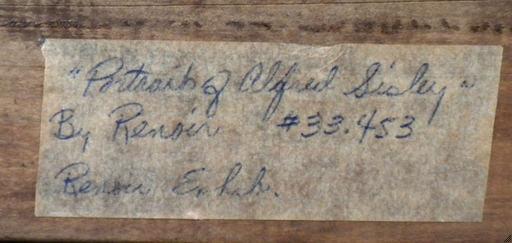
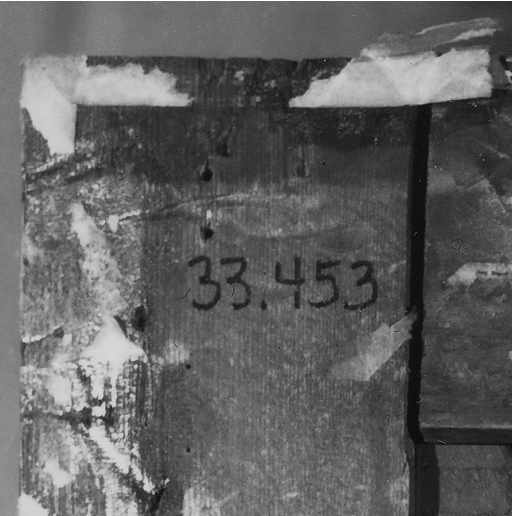
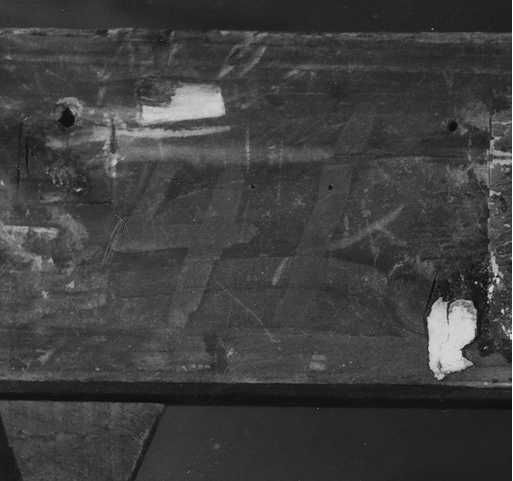
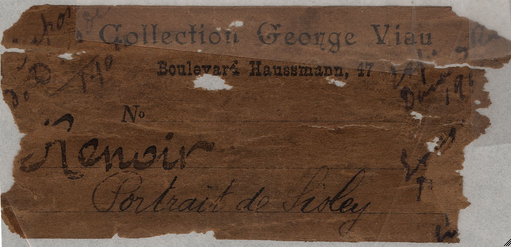
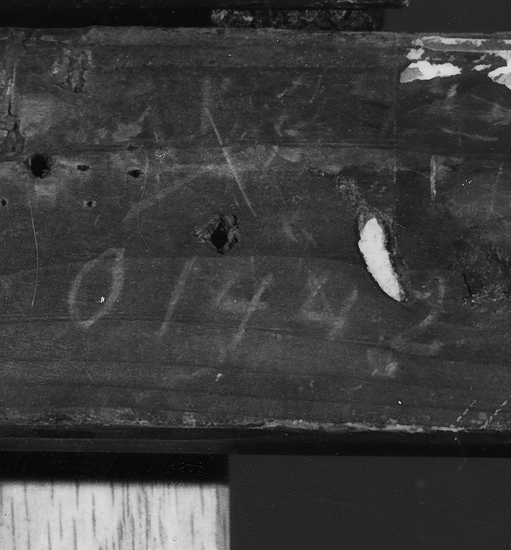
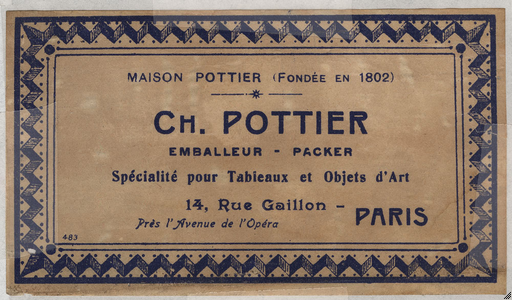
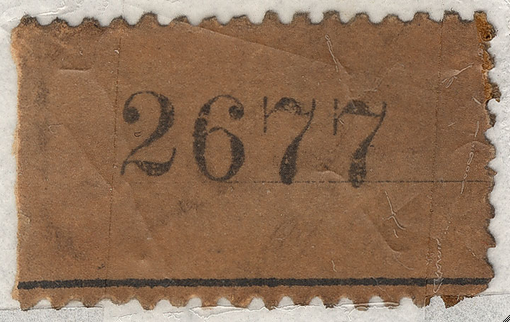
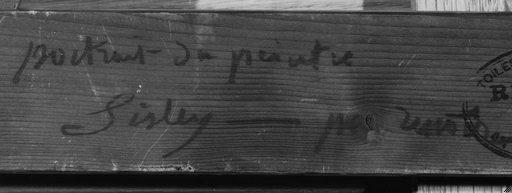
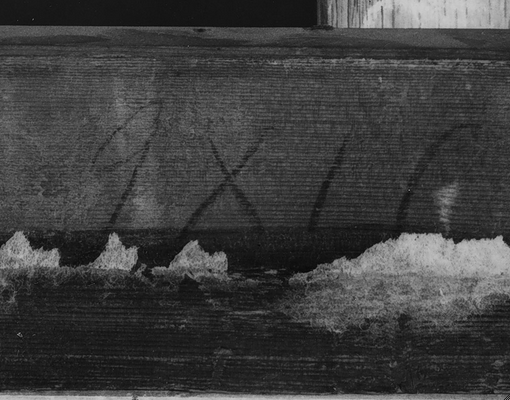
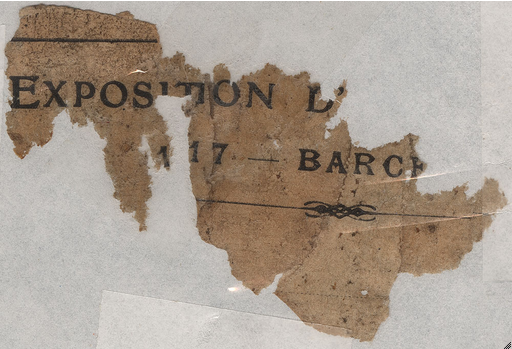
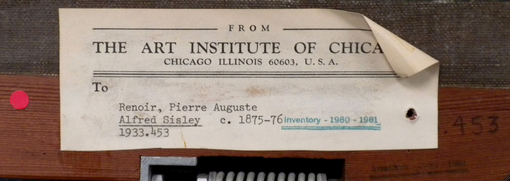
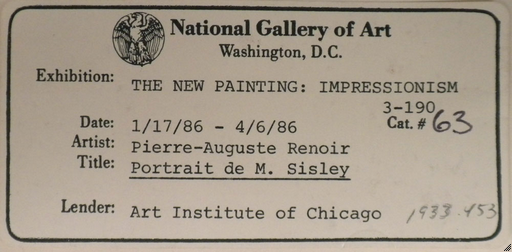
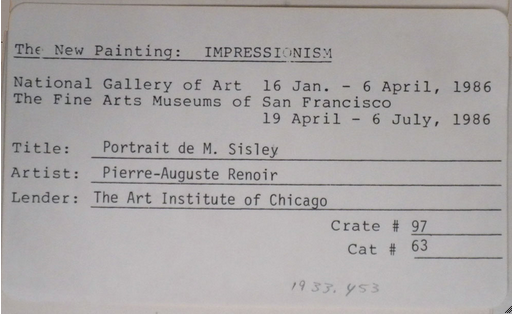
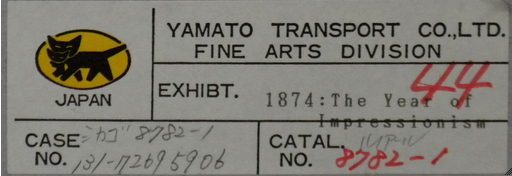
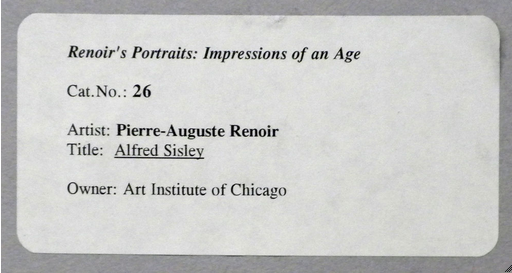
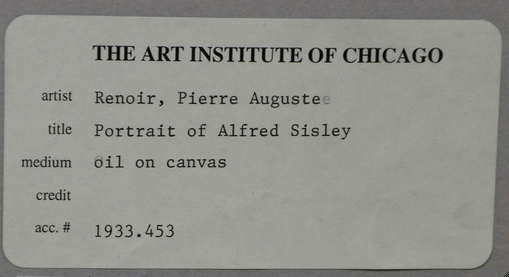
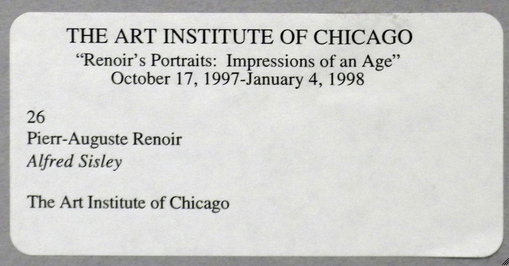
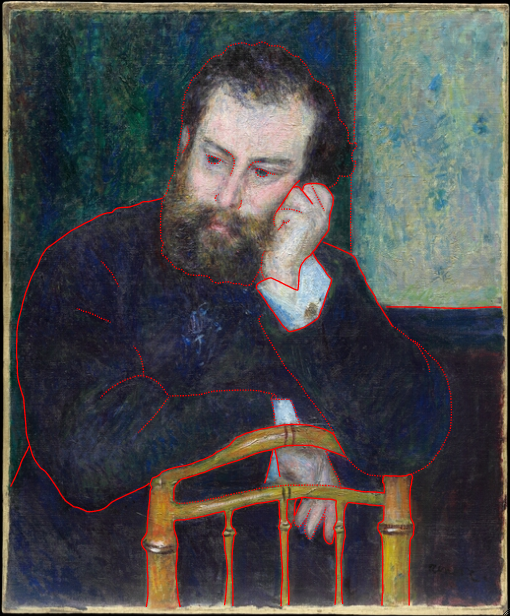
Renoir’s Alfred Sisley (1876). The Art Institute of Chicago, 1933.453. Interactive image.
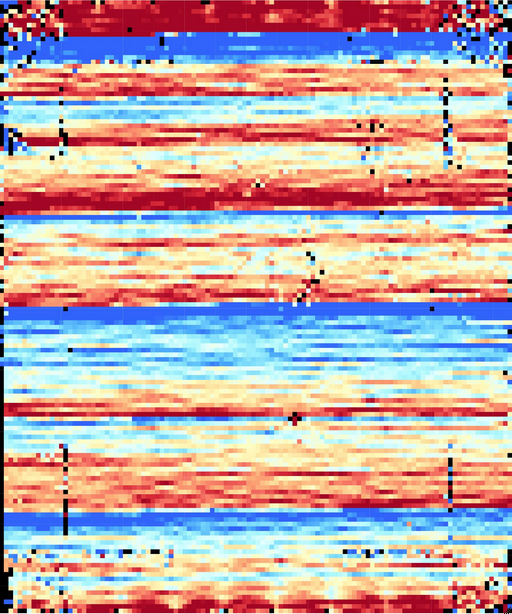
Weft-thread-density map of Renoir’s Alfred Sisley (1876) showing the wide range of thread counts across the horizontal threads. The Art Institute of Chicago, 1933.453. Image created by Don H. Johnson using Thread Count Automation Project software.

Transmitted-infrared (Fuji, 1.0–1.1 µm) image of Renoir’s Alfred Sisley (1876). Fluid lines describing the main contours suggest that the artist executed a basic underdrawing before painting this portrait. The Art Institute of Chicago, 1933.453.
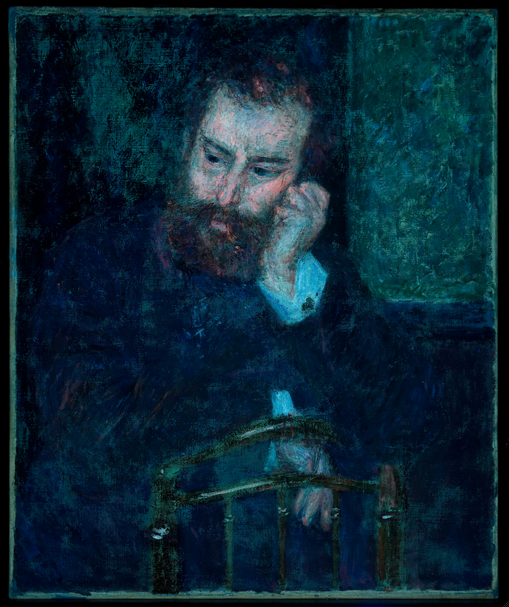
Ultraviolet image of Renoir’s Alfred Sisley (1876). The Art Institute of Chicago, 1933.453.
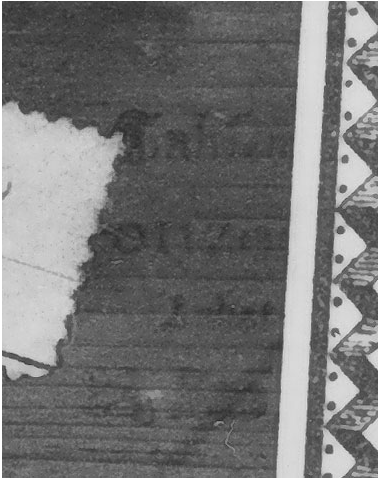
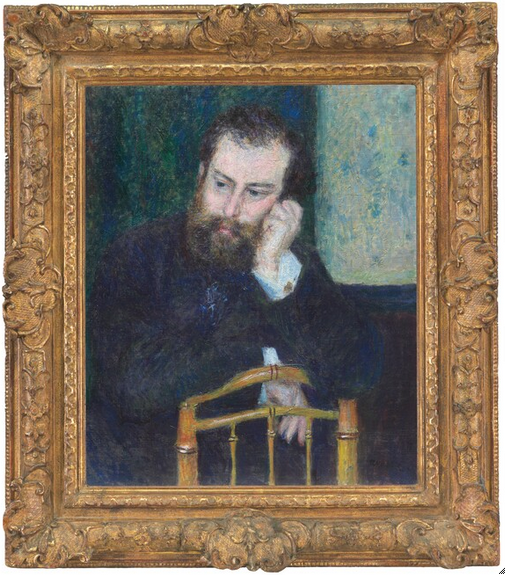
Renoir’s Alfred Sisley (1876) in its original frame. The Art Institute of Chicago, 1933.453.
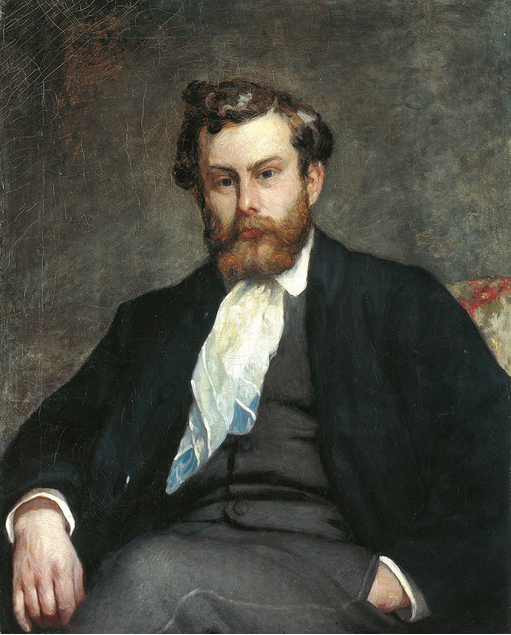
Pierre-Auguste Renoir (French, 1841–1919). Alfred Sisley, 1864. Oil on canvas; 81 × 65 cm (31 7/8 × 25 5/8 in.). Fondation E. G. Bührle Collection, Zurich.
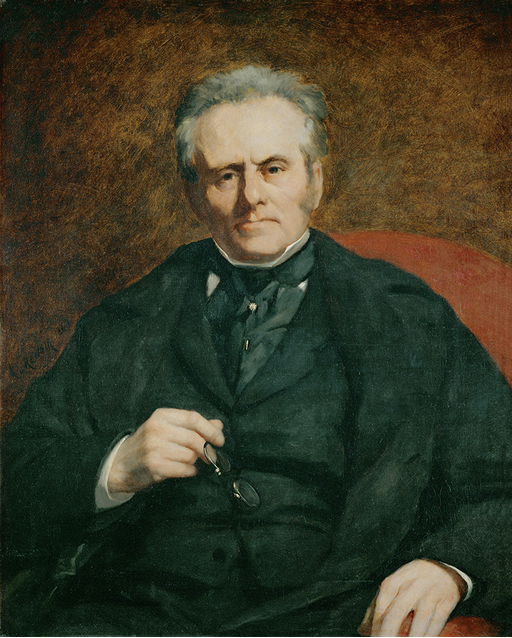
Pierre-Auguste Renoir (French, 1841–1919). William Sisley, 1864. Oil on canvas; 81 × 65 cm (31 7/8 × 25 5/8 in.). Musée d’Orsay, Paris, RF 1952-3. Erich Lessing/Art Resource, NY.
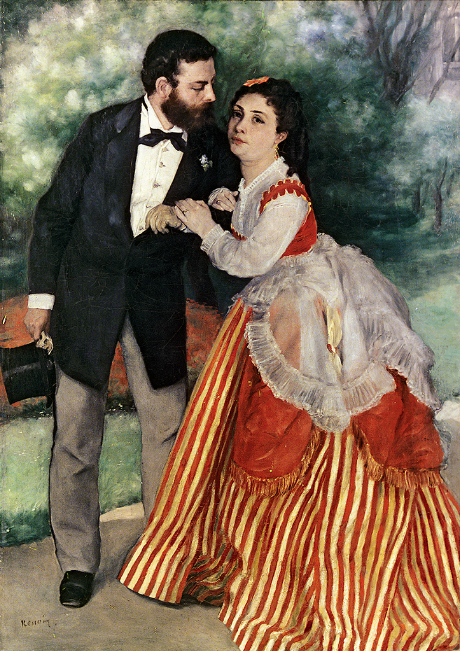
Pierre-Auguste Renoir (French, 1841–1919). The Couple, 1868. Oil on canvas; 105 × 75 cm (41 5/16 × 29 1/2 in.). Wallraf-Richartz-Museum & Fondation Corboud, Cologne, WRM 1199. bpk, Berlin/Photo: Hermann Buresch/Art Resource, NY.
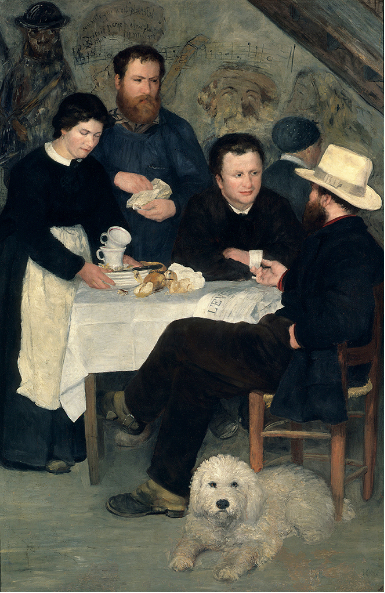
Pierre-Auguste Renoir (French, 1841–1919). The Inn of Mère Antony, 1866. Oil on canvas; 195 × 131 cm (76 3/4 × 51 9/16 in.). Nationalmuseum Stockholm, NM 2544. Scala/White Images/Art Resource, NY.
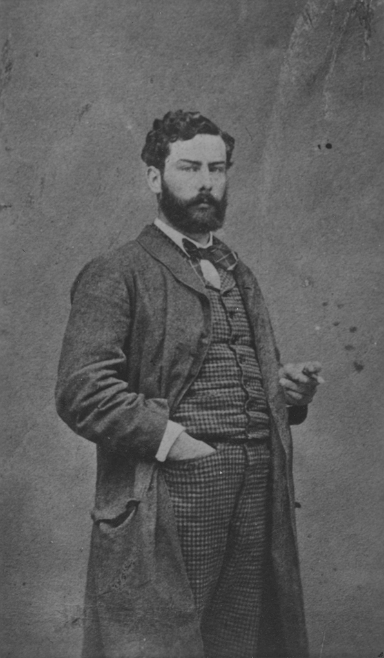
Alfred Sisley, c. 1882. Archives Durand-Ruel, Paris. © Durand-Ruel & Cie.
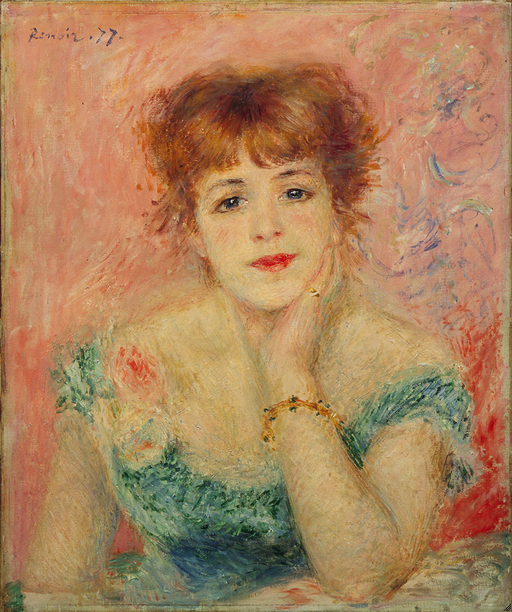
Pierre-Auguste Renoir (French, 1841–1919). Jeanne Samary (La Rêverie), 1877. Oil on canvas; 56 × 46 cm (22 1/16 × 18 1/8 in.). Pushkin State Museum of Fine Arts, Moscow. Scala/Art Resource, NY.
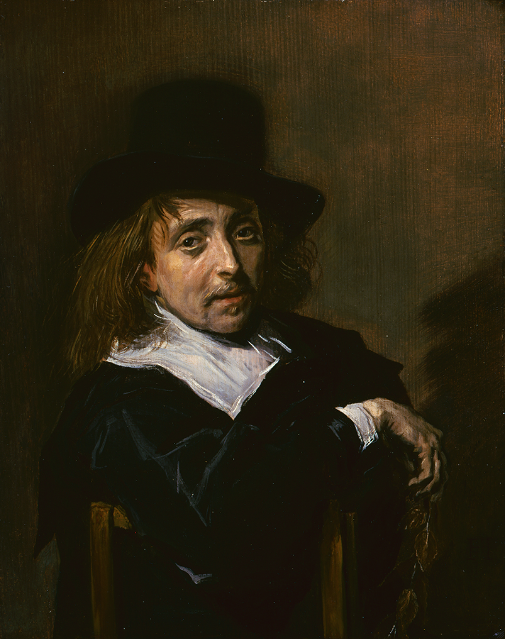
Frans Hals (Dutch, 1581/85–1666). Portrait of a Seated Man, c. 1645. Oil on oak; 42.4 × 33 cm (16 11/16 × 13 in.). National Gallery of Canada, Ottawa, 15901.
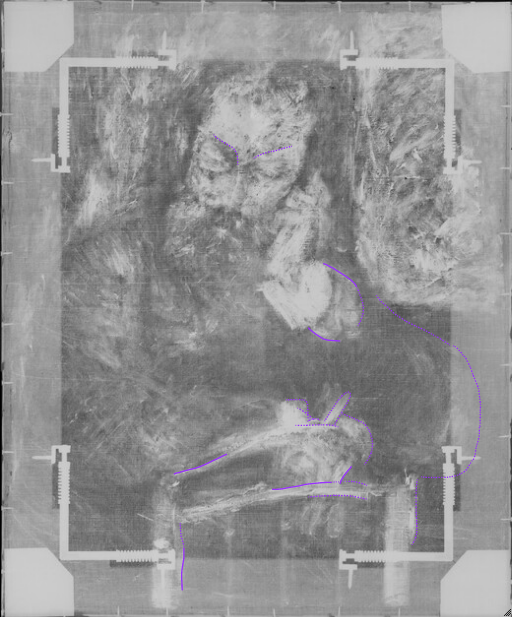
X-ray, reflected- and transmitted-infrared, and natural-light images of Renoir’s Alfred Sisley (1876). The Art Institute of Chicago, 1933.453. Interactive image.
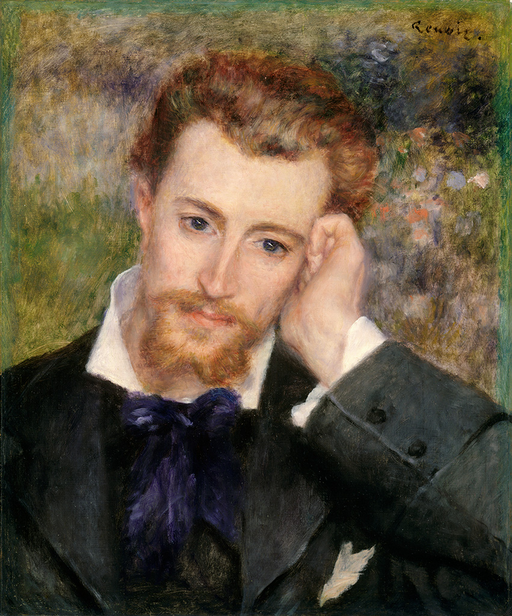
Pierre-Auguste Renoir (French, 1841–1919). Eugène Murer, 1877. Oil on canvas. 47.1 × 39.3 cm (18 9/16 × 15 1/2 in.). The Metropolitan Museum of Art, New York, The Walter H. and Leonore Annenberg Collection, Bequest of Walter H. Annenberg, 2002, 2003.20.9. Image copyright © The Metropolitan Museum of Art. Image source: Art Resource, NY.
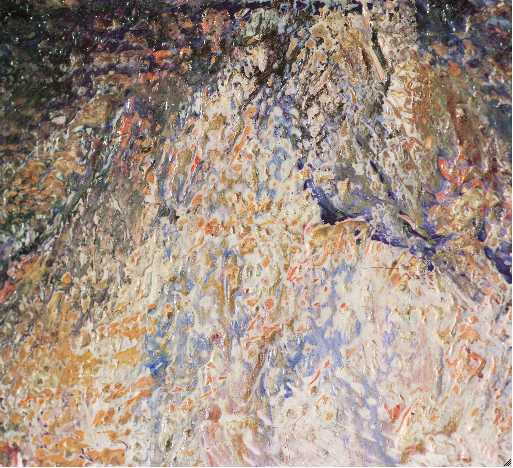
Detail of the figure’s forehead in Renoir’s Alfred Sisley (1876) showing how the artist scraped through the upper paint layers to expose the reddish-orange underlayer. The Art Institute of Chicago, 1933.453.
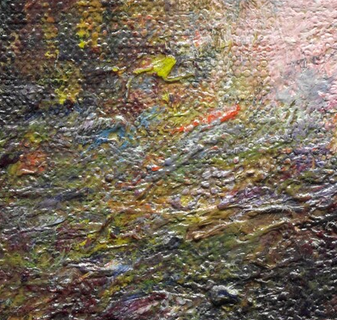
Detail of the figure’s beard in Renoir’s Alfred Sisley (1876) showing the wide range of colors used by the artist. The Art Institute of Chicago, 1933.453.
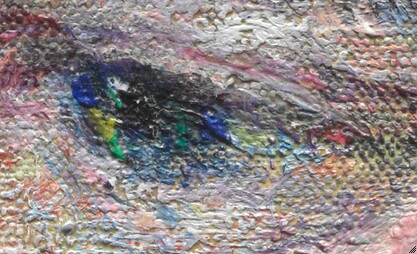
Detail of the figure’s left eye in Renoir’s Alfred Sisley (1876) showing the variety of textures used by the artist. The Art Institute of Chicago, 1933.453.
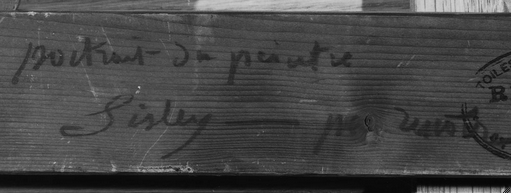
Inscription written on the original stretcher of Renoir’s Alfred Sisley (1876). The Art Institute of Chicago, 1933.453.
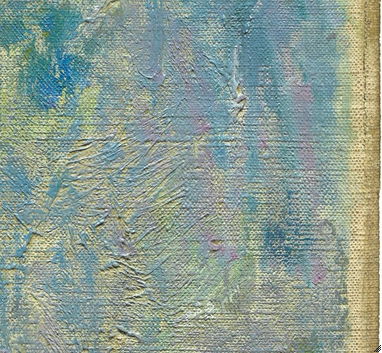
Detail of the background near the right edge of Renoir’s Alfred Sisley (1876). The haphazard brushwork in this area leaves the ground visible between paint strokes. The Art Institute of Chicago, 1933.453.
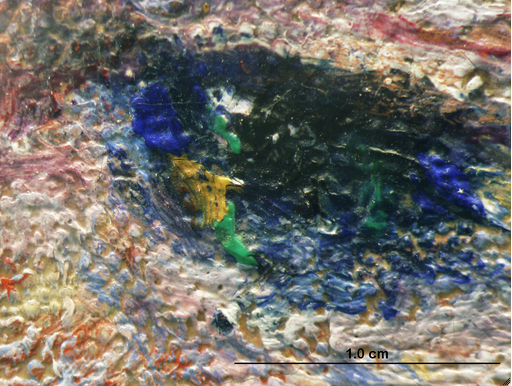
Photomicrograph of Sisley’s left eye in Renoir’s Alfred Sisley (1876) showing the bright yellow, green, and blue daubs added as final details. The Art Institute of Chicago, 1933.453.
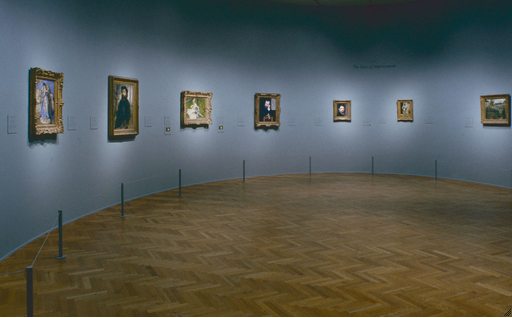
Installation of Renoir’s Alfred Sisley (1876) in Renoir’s Portraits: Impressions of an Age, Art Institute of Chicago, Oct. 17, 1997–Jan. 4, 1998. Institutional Archives, Art Institute of Chicago.
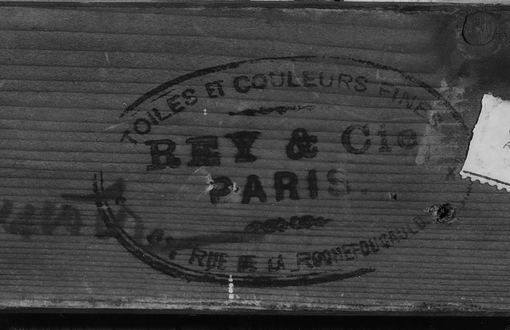
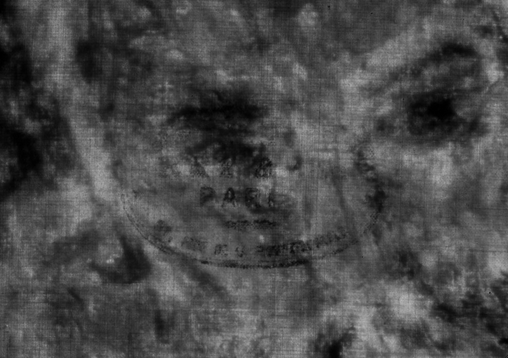
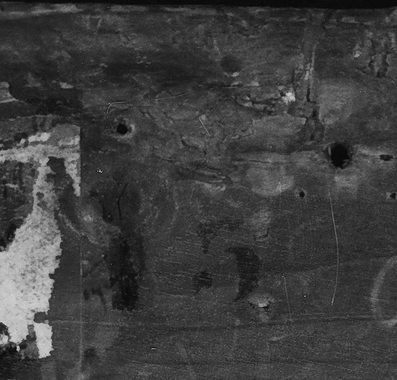
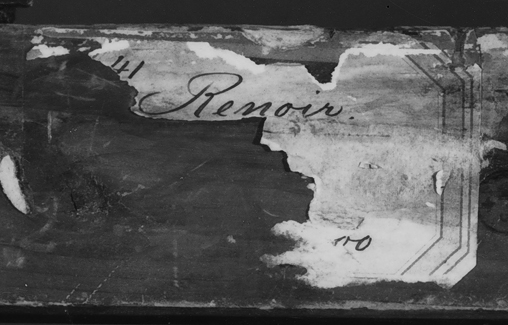
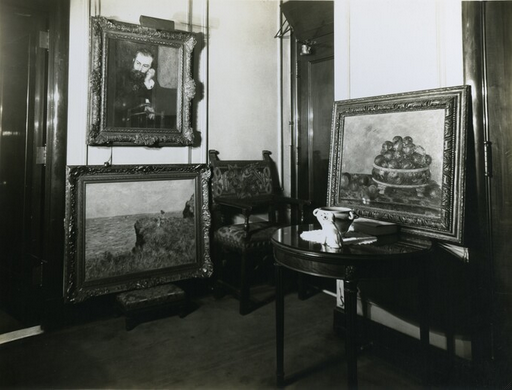
Renoir’s Alfred Sisley (1876) in its original frame, on display in Mrs. Lewis Larned (Annie Swan) Coburn’s Blackstone Hotel apartment. Institutional Archives, Art Institute of Chicago.
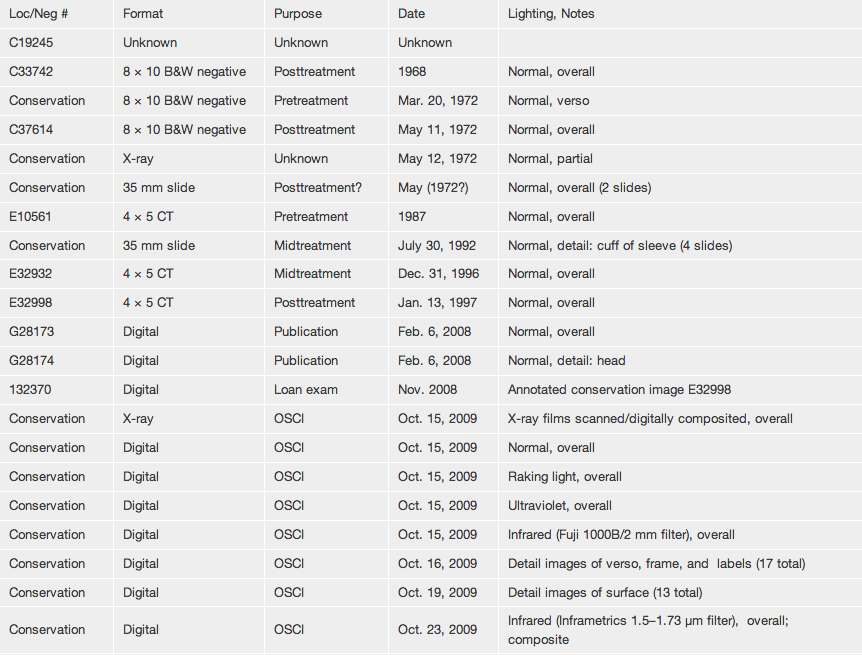
| Loc/Neg # | Format | Purpose | Date | Lighting, Notes |
| C19245 | Unknown | Unknown | Unknown | |
| C33742 | 8 × 10 B&W negative | Posttreatment | 1968 | Normal, overall |
| Conservation | 8 × 10 B&W negative | Pretreatment | Mar. 20, 1972 | Normal, verso |
| C37614 | 8 × 10 B&W negative | Posttreatment | May 11, 1972 | Normal, overall |
| Conservation | X-ray | Unknown | May 12, 1972 | Normal, partial |
| Conservation | 35 mm slide | Posttreatment? | May (1972?) | Normal, overall (2 slides) |
| E10561 | 4 × 5 CT | Pretreatment | 1987 | Normal, overall |
| Conservation | 35 mm slide | Midtreatment | July 30, 1992 | Normal, detail: cuff of sleeve (4 slides) |
| E32932 | 4 × 5 CT | Midtreatment | Dec. 31, 1996 | Normal, overall |
| E32998 | 4 × 5 CT | Posttreatment | Jan. 13, 1997 | Normal, overall |
| G28173 | Digital | Publication | Feb. 6, 2008 | Normal, overall |
| G28174 | Digital | Publication | Feb. 6, 2008 | Normal, detail: head |
| 132370 | Digital | Loan exam | Nov. 2008 | Annotated conservation image E32998 |
| Conservation | X-ray | OSCI | Oct. 15, 2009 | X-ray films scanned/digitally composited, overall |
| Conservation | Digital | OSCI | Oct. 15, 2009 | Normal, overall |
| Conservation | Digital | OSCI | Oct. 15, 2009 | Raking light, overall |
| Conservation | Digital | OSCI | Oct. 15, 2009 | Ultraviolet, overall |
| Conservation | Digital | OSCI | Oct. 15, 2009 | Infrared (Fuji 1000B/2 mm filter), overall |
| Conservation | Digital | OSCI | Oct. 16, 2009 | Detail images of verso, frame, and labels (17 total) |
| Conservation | Digital | OSCI | Oct. 19, 2009 | Detail images of surface (13 total) |
| Conservation | Digital | OSCI | Oct. 23, 2009 | Infrared (Inframetrics 1.5–1.73 µm filter), overall; composite |
| Conservation | Digital | OSCI | Oct. 29, 2009 | Macro details (4 total) |
| Conservation | Digital | OSCI | Nov. 2, 2009 | Raking light, overall |
| G32633 | Digital | OSCI | Nov. 6, 2009 | Normal, overall |
| G32634 | Digital | OSCI | Nov. 6, 2009 | Ultraviolet, overall |
| G32635 | Digital | OSCI | Nov. 6, 2009 | Normal, detail; signature |
| Conservation | Digital | OSCI | Nov. 9, 2009 | Photomicrographs of sample sites and surface (22 total) |
| G39052 | Digital | OSCI | Feb. 1, 2012 | Normal, overall; composite of G39426–G39437 |
| G39053 | Digital | OSCI | Feb. 1, 2012 | Ultraviolet, overall |
| G39054 | Digital | OSCI | Feb. 1, 2012 | Normal, frame only |
| G39426 | Digital | OSCI | Feb. 1, 2012 | Section |
| G39427 | Digital | OSCI | Feb. 1, 2012 | Section |
| G39428 | Digital | OSCI | Feb. 1, 2012 | Section |
| G39429 | Digital | OSCI | Feb. 1, 2012 | Section |
| G39430 | Digital | OSCI | Feb. 1, 2012 | Section |
| G39431 | Digital | OSCI | Feb. 1, 2012 | Section |
| G39432 | Digital | OSCI | Feb. 1, 2012 | Section |
| G39433 | Digital | OSCI | Feb. 1, 2012 | Section |
| G39434 | Digital | OSCI | Feb. 1, 2012 | Section |
| G39435 | Digital | OSCI | Feb. 1, 2012 | Section |
| G39436 | Digital | OSCI | Feb. 1, 2012 | Section |
| G39437 | Digital | OSCI | Feb. 1, 2012 | Section |
| Conservation | Digital | OSCI | Feb. 1, 2012 | Transmitted light, overall |
| Conservation | Digital | OSCI | Feb. 1, 2012 | Transmitted infrared (Fuji 1000B/2 mm filter), overall |
| Conservation | Digital | OSCI | Feb. 1, 2012 | Transmitted infrared (Fuji 1000B/ 2mm filter), detail: stamp |
Workers’ Daughters on the Outer Boulevard (Illustration for Émile Zola’s “L’assommoir”)292
1877/78
Pen and brown ink, over black chalk, on ivory laid paper; 275 × 399 mm
The Art Institute of Chicago, Regenstein Collection, 1986.420
A group of six young women stand on a Paris street, close together, their arms intertwined. One strains forward, her chest pushed out, hands on hips. Behind, at the far right of the sheet, stand two men. One cups his hands to his mouth as if to shout; the other, more subdued, wears his cap tipped down. They wear smocks rather than jackets, perhaps just having left work. A man in a top hat stands before them; he hunches over a newspaper, ignoring their provocations. At the far left of the composition a family, presumably mother, father, and son, is distanced spatially and socially from the band of young women.
To read this image as a narrative is entirely appropriate. It illustrates a scene from Émile Zola’s L’assommoir, an exposé about hard drinking and its social consequences that caused something of a scandal in the late 1870s. The seventh in Zola’s series chronicling the Rougon-Macquart family, the story revolves around the laundress Gervaise. Her headstrong daughter Anna, nicknamed Nana, first appears to the reader toward the close of the book. In this drawing she appears simply as the most prominent of the cavorting adolescents.
Another drawing by the artist—now in the collection of Jean Bonna—is also clearly associated with L’assommoir. That sheet (fig. 2.25 [Dauberville 677]), a looser, more freely worked study executed in brush and ink, includes Zola’s inscription and even a page number at the bottom: “Off they went, the six of them, taking up the whole width of the road, arm in arm in their light dresses, their hair tied with ribbons.”293 It seems likely that the Art Institute’s version of the scene was produced in pen and ink because the Bonna drawing, lacking definition, would have been unsuitable for reproduction.294
Renoir did not make his illustration for the novel’s debut appearance in print. L’assommoir was serialized in 1876 in the democratic newspaper Le bien publique.295 In 1877 Georges Charpentier published it in full; its popularity soon necessitated reprints. Like Zola, Renoir found a supporter in Charpentier, and in the same year that he made the book illustrations, he painted the publisher’s wife (fig. 2.30 [Daulte 266; Dauberville 239]).296 The Art Institute’s work was commissioned by Charles Marpon and Ernest Flammarion for a deluxe edition of the novel published in 1878.297 They requested contributions from ten artists, including Henri Gervex, André Gill, Georges Clairin, and Frédéric Régamey. Renoir’s four contributions differed markedly from the others, which focused on the violence and unpleasantness of the novel. The sympathetic appearance of the present scene is in evident contrast to such images as Gill’s Fight between Gervaise and Virginie, in which the two characters attack one another ferociously, their bare legs and arms on show.298
In its multifigure composition and rich detail, Workers on the Outer Boulevard is the most elaborate of Renoir’s efforts for L’assommoir. Whether by design or coincidence, the subject of the passage was well suited to the artist’s flair for the sensual. The section in which the drawing appears tells of the fifteen-year-old Nana’s precocious beauty—“fully developed and no corset, with a real magpie face, milky complexion and skin as velvety as a peach.”299 Zola explains that Nana and her friends were born and raised on the streets—and, consequently, assumed ownership thereof—but Renoir subdues the vulgarity of the laughing, shouting characters even while depicting their exuberance. In the drawing, Nana is the third figure from the left among the group of girls. In a sheet in which the surface is mostly covered with a network of fine, closely spaced lines, Renoir’s relatively sparse use of media in her description makes her appear all the more vivid. An absence of ink creates an effect of falling light, which accentuates her bust and skirt, drawing attention to her curves. The artist emphasizes the attractiveness of the young women, perhaps mindful of Zola’s description of them “bursting their bodices by displaying their swelling forms.”300 Nana excited “obvious admiration”; an admiration, perhaps, that Renoir encouraged the viewer to ape.
There may have been no agenda behind the artist’s focus on the positive aspects of the text, but his dissatisfaction with Zola’s vision of the working classes may have informed his choice. Some years later, in conversation with the dealer Ambroise Vollard, Renoir recounted how he had frequented the salon of Madame Charpentier with Zola and others in the 1870s. Zola’s novel L’oeuvre (The Masterpiece), which depicts the life of a failed artist, had been the cause of many arguments in such circles, Renoir admitted, but his annoyance went beyond that infamous case. “I’ve always hated what he [Zola] writes,” he related. “When you want to paint an environment, you should start, so it seems to me, by putting yourself in your characters’ shoes. Zola, he is happy to open a little window, have a quick look outside, and assume that he has painted the people by saying that they smell bad.”301
In addition to being an unabashed sensualist, Renoir had a well-documented preference for uneducated women.302 Finding lack of sophistication a virtue, it is likely that he delighted in—rather than disapproved of—the type of girl that Zola found crude. It is clear that in major works of this era, including Dance at the Moulin de la Galette (fig. 2.26 [Daulte 209; Dauberville 211]), shown in the third Impressionist exhibition of 1877, Renoir portrayed women of Nana’s class in a sympathetic light.303 And in 1898, as the art historian Colin Bailey has noted, Julie Manet recorded that Renoir viewed Montmartre families as sensitive souls, in marked contrast to Zola’s description of them as “atrocious beings.”304
A painting of a laundress in the collection of the Art Institute (fig. 2.27 [cat. 6]) [Daulte 348; Dauberville 382]) also relates to L’assomoir and, once more, appears rather picturesque, given the novel’s general tone.305 Ostensibly it shows a washerwoman taking a moment’s pause. Renoir also revisited the theme some years later, in Washerwomen (fig. 2.28 [Dauberville 948]) and in a lightly drawn study, Laundress (1885–89; Courtauld Gallery, London);306 but these quasi-pastoral images are far removed from the celebration of youthful idleness that is Workers’ Daughters on the Outer Boulevard.
Nancy Ireson
Workers’ Daughters on the Outer Boulevard (Illustration for Émile Zola’s “L’assommoir”) is one of three known drawings of the same subject.307 This work is executed in pen and dark-brown ink on ivory [glossary:laid paper]. [glossary:Infrared reflectography] has captured the faint, slightly smudged [glossary:underdrawing] in black chalk that Renoir used to lay out the composition. The final composition in ink follows the initial chalk underdrawing quite faithfully, providing great detail, as seen in an infrared overlay comparison (fig. 2.24). There are some additional lines at the upper center area, although they do not appear to form discrete elements in the composition (fig. 1.2).
The brown ink lines are thin and fairly consistent in length and thickness. Crosshatching and closely spaced lines are used to establish shading and modeling, and an absence of line creates areas of highlights (fig. 1.1). The ink lines bleed together in the dog’s spots at the left lower area to form the densest passages in the composition (fig. 2.20). The pen lines are generally oriented vertically or diagonally from the lower left to upper right, as is characteristic of right-handed artists. Changes in the direction of line distinguish the various elements in the composition: for instance, the lines delineating the tree foliage in the upper left corner are oriented diagonally/horizontally, whereas those establishing the background shop walls are straight and vertical. Slight deformations of the paper can be seen in the ink lines due to the pressure of the fine pen nib on the paper.
Renoir (recto, lower left corner, in pen and brown ink) (fig. 1.4).
Ivory, medium-thick, slightly textured laid paper.308
BFK (for Rives BFK [Blanchet, Freres, & Kiebler]; in shield with two flowers and a crescent above and possibly a golden fleece below, complete, in center of sheet; 14.8 × 7.5 cm) (fig. 2.23).
Horizontal, 2.7 cm.
7–8 per cm.
Uniform, without significant inclusions or colored fibers.
Even, likely machine made.
All edges appear to have been trimmed and are slightly irregular.
275 × 399 mm.
No artistic surface alterations or coatings are visible in normal conditions or under magnification. Under [glossary:UV] illumination, there is a light-yellow visible-light [glossary:fluorescence] overall on the paper surface that is characteristic of light gelatin surface [glossary:sizing]; the fluorescence is most pronounced around the perimeter where the window mat protected it from exposure to light.
The drawing was created in pen and brown ink over traces of black-chalk underdrawing; the ink lines are thin and fairly consistent in length and thickness.
Black-chalk underdrawing is visible in the overall composition, as it was used initially to establish and define the figures before the drawing was worked out in pen and brown ink (fig. 2.24).
No artistic surface alterations or coatings are visible in normal conditions or under magnification. There is a light-yellow visible-light fluorescence that suggests the presence of light gelatin surface sizing.
There are numerous losses and skinned areas along the edges on the verso, which may have resulted from the removal of a former edge mounting; the losses are filled. There is also light discoloration and staining from adhesive along the edges, visible on the recto. Soft undulations are visible in the sheet at the sides. There are faint inscriptions or smudges along the bottom edge. A strong vertical crease is visible through the center of the sheet; it is most evident on the verso. Dense areas of ink in the dog at the lower left penetrated through to the verso.
Kimberly Nichols
Sold by Maurice Sachs (1906–1945), Paris, to De Hauke and Company, Inc., New York, July 1, 1929.309
Sold by De Hauke and Company, Inc., New York, to John Nicholas Brown II (1900–1979), Newport, R.I., Oct. 16, 1929.310
Estate of John Nicholas Brown II, Newport, R.I., from 1979.311
Sold by the estate of John Nicholas Brown II to David Tunick, Incorporated, New York, c. 1986.312
Sold by David Tunick, Incorporated, to the Art Institute of Chicago, 1986.
New York, De Hauke and Company, Watercolors and Drawings of the 19th and 20th Century, Dec. 1929, no cat.313
Providence, Rhode Island School of Design, Drawings and Paintings from the Collection of Mr. John Nicholas Brown, Apr. 2–27, 1931, no. cat.314
Buffalo, N.Y., Albright Art Gallery, Master Drawings, Jan. 1935, cat. 122 (ill.).
New London, Conn., Lyman Allyn Museum, Drawings, Mar. 2–Apr. 15, 1936, cat. 162.
Boston, Museum of Fine Arts, Art in New England, June 8–Sept. 10, 1939, cat. 200 (ill.).
San Francisco, Calif., Palace of Fine Arts, Master Drawings: An Exhibition of Drawings from American Museums and Private Collections, 1940, pp. 22, 87, cat. 85 (ill.).
Omaha, Neb., Joslyn Art Museum, Dec. 1941.315
San Francisco, California Palace of the Legion of Honor, 19th Century French Drawings, Mar. 8–Apr. 6, 1947, p. 64, cat. 105 (ill.).
Rotterdam, Boymans Museum, French Drawings in American Collections, 1958, cat. 181, pl. 165; Paris, Musée de Orangerie, 1959; New York, Metropolitan Museum of Art, 1959.
Newark, N.J., Newark Museum, Nineteenth Century Master Drawings, Mar. 16–Apr. 30, 1961, cat. 45 (ill.).
Cambridge, Mass., Fogg Art Museum, Forty Master Drawings from the Collection of John Nicholas Brown, Summer 1962, cat. 23.
Art Institute of Chicago, Masterpieces from the Helen Regenstein Collection, 1974–1989, Feb. 2–May 8, 1990, no cat.
New York, Frick Collection, From Pontormo to Seurat: Drawings Recently Acquired by The Art Institute of Chicago, Apr. 23–July 7, 1991, cat. 51; Art Institute of Chicago, Sept. 10, 1991–Jan. 5, 1992.
Vienna, Albertina, Impressionism: Pastels, Watercolors, Drawings, Feb. 9–May 13, 2012, p. 239, cat. 138 (ill.).
Théodore Duret, Histoire des peintres impressionistes (H. Floury, 1906), p. 102 (ill.).
Ambroise Vollard, La vie et l’oeuvre de Pierre-Auguste Renoir (A. Vollard, 1919), p. 161 (ill.).
Joachim Gasquet, “Le paradis de Renoir,” L’amour de l’art 2 (Feb. 1921) (ill.).
Kimon Nicolaides, The Natural Way to Draw (Houghton Mifflin, 1941), p. 98 (ill.).316
John Rewald, Renoir Drawings (H. Bittner, 1946), p. 15–16, no. 4 (ill.).
H. J. Wechsler, French Impressionists and Their Circle (Abrams, 1953), fig. 4, (ill.).
Ira Moskowitz, Great Drawings of All Time, vol. 3 (Shorewood, 1962), no. 798 (ill.).
Barbara Ehrlich White, Renoir: His Life, Art, and Letters (Abrams, 1984) pp. 83–84 (ill.).
Sophie Monneret, Renoir, Profils de l’art (Chêne, 1989) n.p., fig. 2 (ill.).
Hollis Clayson, Painted Love: Prostitution in French Art of the Impressionist Era (Yale University Press, 1991) p. 73–75, fig. 39 (ill.).
Douglas W. Druick, Renoir, Artists in Focus (Art Institute of Chicago/Abrams, 1997) p. 31–37, 83, no. 5, 109 (ill.).
Art Institute of Chicago, Treasures from The Art Institute of Chicago, selected by James N. Wood, commentaries by Debra N. Mancoff (Art Institute of Chicago/Hudson Hills, 2000), p. 206 (ill.).
Martha Tedeschi, “Pierre Auguste Renoir, Workers’ Daughters on the Outer Boulevard (Illustration for Emile Zola’s ‘L’Assommoir’), 1877/78,” in “Maineri to Miró: The Regenstein Collection since 1975,” special issue, Art Institute of Chicago Museum Studies 26, 1 (2000), pp. 78–79, no. 34 (ill.).
Suzanne Folds McCullagh, “‘A Lasting Monument’: The Regenstein Collection at The Art Institute of Chicago,” special issue, Art Institute of Chicago Museum Studies 26, 1 (2000), p. 13.
Paul Hayes Tucker, “Renoir in the 1870s and ’80s: Modernity, Tradition, and Individuality,” in Renoir: From Outsider to Old Master, 1870–1892, exh. cat. (Chūnichi Shinbunsha, 2001), p. 220, fig. 11.
Guy-Patrice Dauberville and Michel Dauberville, Renoir: Catalogue raisonné des tableaux, pastels, dessins, et aquarelles, vol. 3, 1858–1881 (Bernheim-Jeune, 2007), p. 619, no. 664 (ill.).
Mark
Location: center bottom edge
Method: graphite
Content: possibly J or L C (erased)
Paper support characteristics identified.
Watermark captured.
Paper mold characteristics identified.
Light surface sizing detected.
Overall faint black-chalk underdrawing captured.
Media identified.
The image inventory compiles records of all known images of the artwork on file in the Imaging Department and in the conservation and curatorial files in the Department of Prints and Drawings at the Art Institute of Chicago (fig. 2.29).
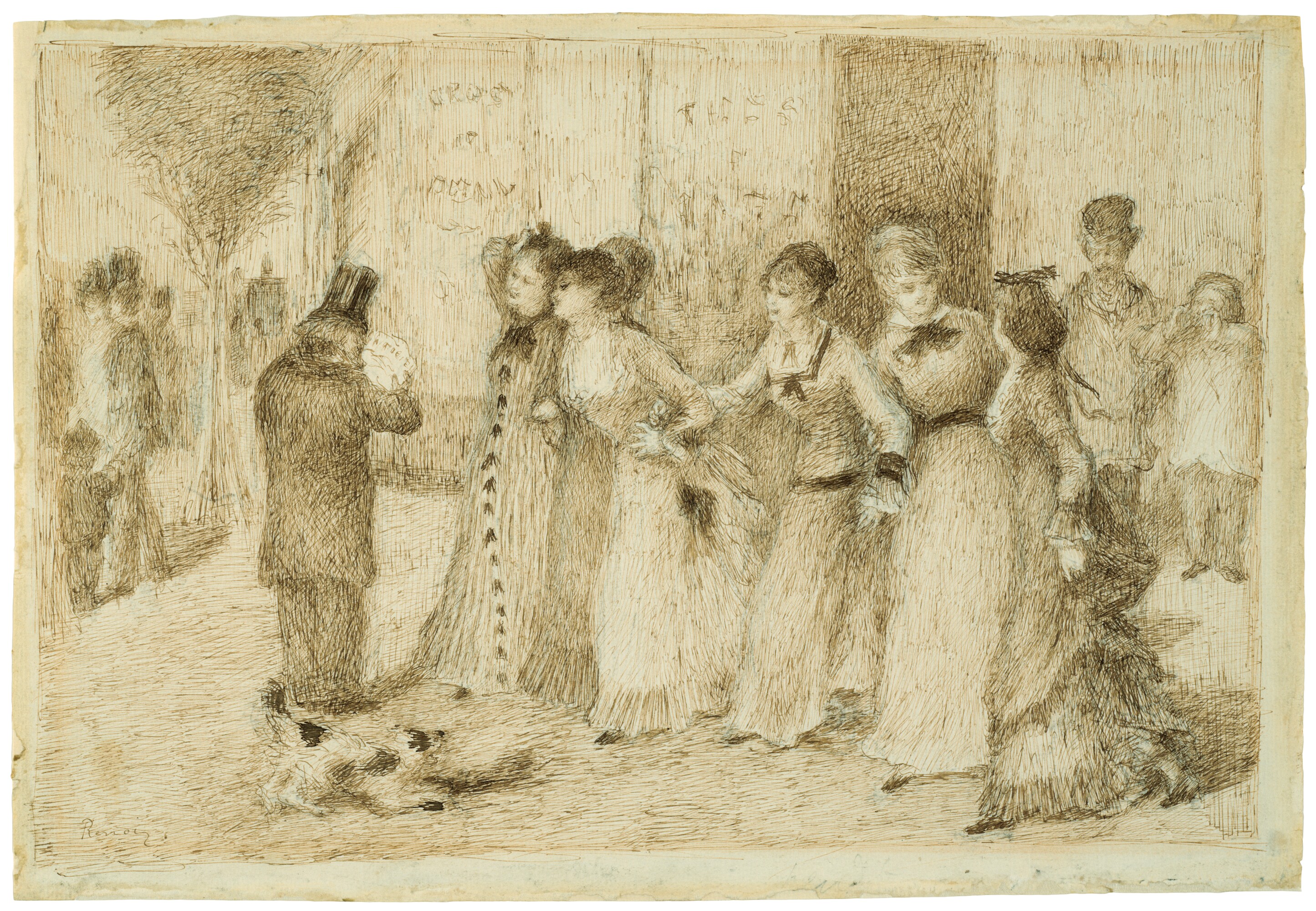
cat. 5 Workers' Daughters on the Outer Boulevard (Illustration for Émile Zola's "L'assommoir"), 1877/78.
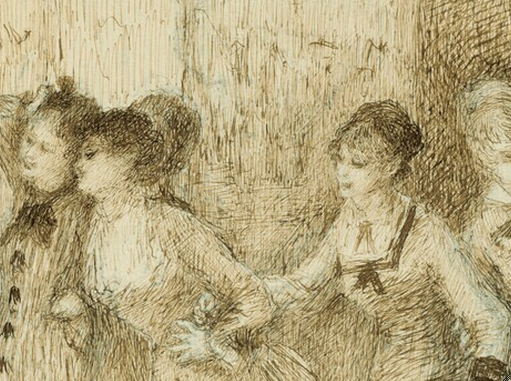
Detail of Renoir’s Workers’ Daughters on the Outer Boulevard (Illustration for Émile Zola’s "L’assommoir”) (1877/78) showing faint additional black chalk lines between the figures. The Art Institute of Chicago, 1986.420.
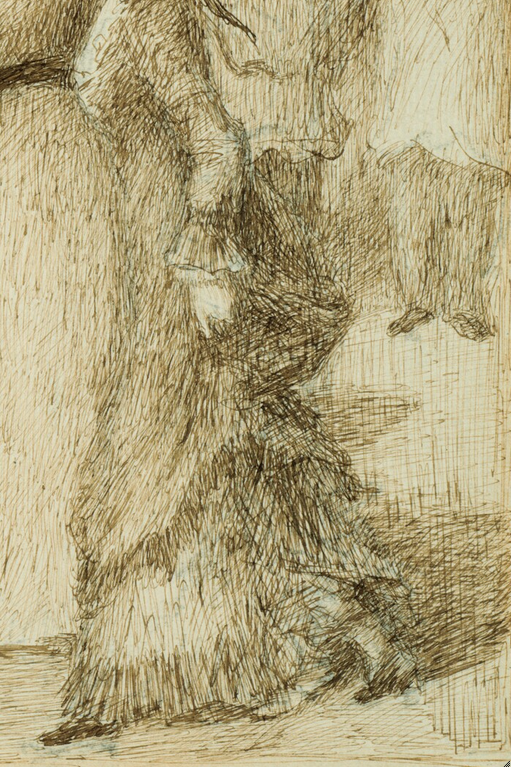
Detail of Renoir’s Workers’ Daughters on the Outer Boulevard (Illustration for Émile Zola’s "L’assommoir”) (1877/78) showing crosshatched lines used for shading. The Art Institute of Chicago, 1986.420.
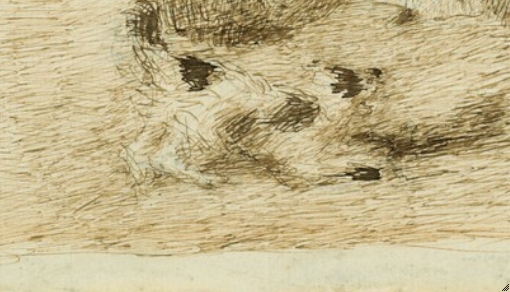
Detail of Renoir’s Workers’ Daughters on the Outer Boulevard (Illustration for Émile Zola’s "L’assommoir”) (1877/78) showing the finely spaced lines that bleed together to form the dog’s spots. The Art Institute of Chicago, 1986.420.

Detail of Renoir's Workers' Daughters on the Outer Boulevard (Illustration for Émile Zola's "L'assommoir") (1877/78) showing how the line direction has shifted in order to establish form. The Art Institute of Chicago, 1986.420.
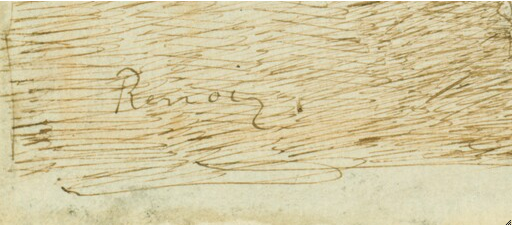
Detail of Renoir’s Workers’ Daughters on the Outer Boulevard (Illustration for Émile Zola’s "L’assommoir”) (1877/78) showing Renoir’s signature in pen and brown ink. The Art Institute of Chicago, 1986.420.
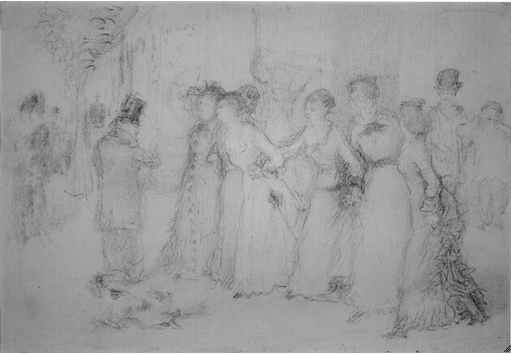
Infrared (Fuji, 1.0–1.1 µm) and natural-light images of Renoir’s Workers’ Daughters on the Outer Boulevard (Illustration for Émile Zola’s “L’assommoir”) (1877/78) revealing the black-chalk underdrawing beneath the final pen and brown-ink lines. The Art Institute of Chicago, 1986.420. Interactive image.
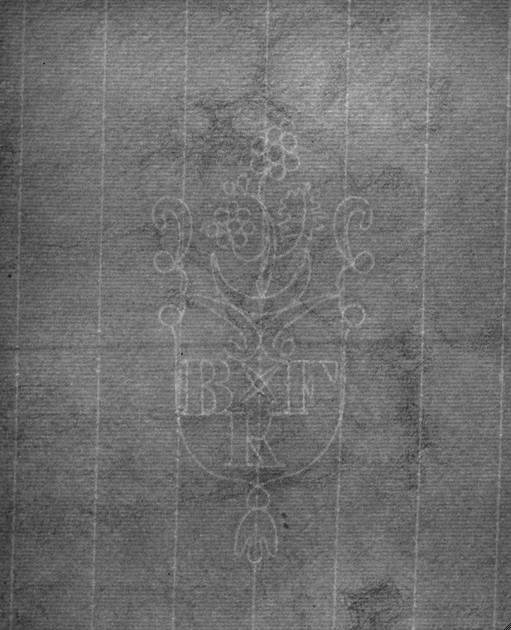
Detail of transmitted-infrared image (Fuji, 1.0–1.1 µm) of Renoir’s Workers’ Daughters on the Outer Boulevard (Illustration for Émile Zola’s “L’assommoir”) (1877/78) showing the sheet’s watermark. The Art Institute of Chicago, 1986.420.
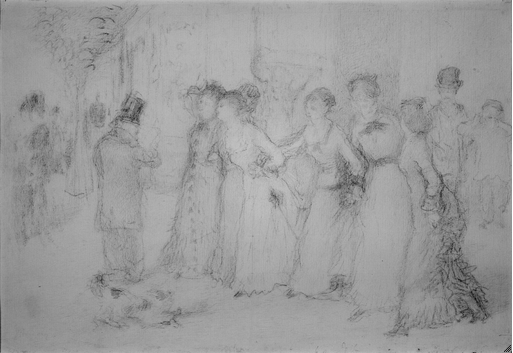
Infrared image (Fuji, 1.0–1.1 µm) of Renoir’s Workers’ Daughters on the Outer Boulevard (Illustration for Émile Zola’s “L’assommoir”) (1877/78) showing the black-chalk underdrawing. The Art Institute of Chicago, 1986.420.
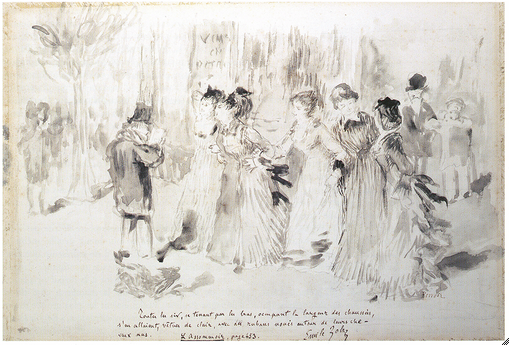
Pierre-Auguste Renoir (French, 1841–1919). Les filles d’ouvriers se promenant sur le boulevard extérieur, n.d. Ink wash over crayon; 29 × 43 cm (11 7/16 × 16 15/16 in.). Jean Bonna Collection.
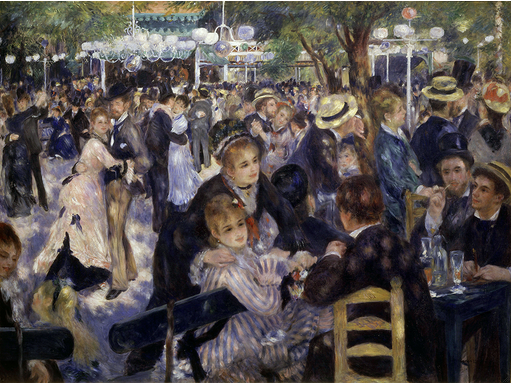
Pierre-Auguste Renoir (French, 1841–1919). Dance at the Moulin de la Galette, 1876. Oil on canvas; 131 × 175 cm (51 9/16 × 68 15/16 in.). Musée d’Orsay, Paris, bequest of Gustave Caillebotte, 1894, RF 2739. Gianni Dagli Orti/The Art Archive at Art Resource, NY.
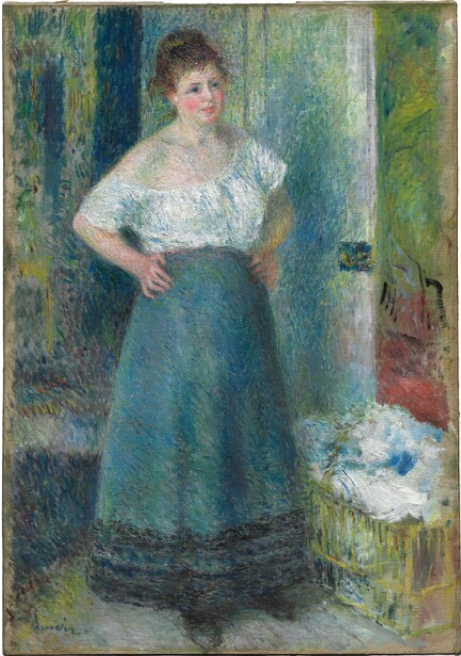
Pierre-Auguste Renoir (French, 1841-1919). The Laundress, 1877/79. Oil on canvas; 80 .8 × 56.5 cm (31 13/16 × 22 1/4 in.). The Art Institute of Chicago, Charles H. and Mary F. S. Worcester Collection, 1947.102.
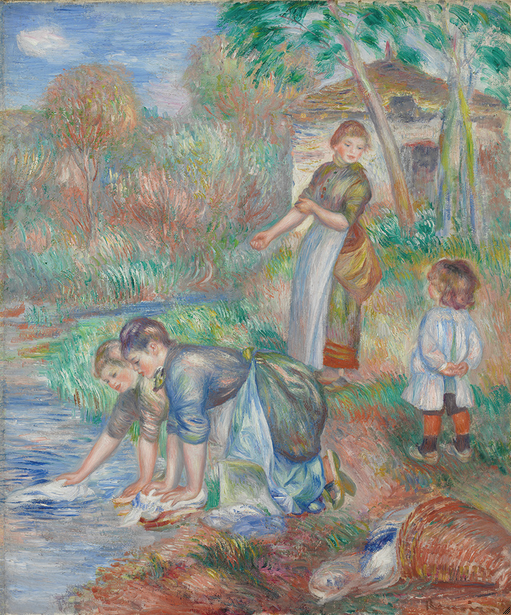
Pierre-Auguste Renoir (French, 1841–1919). Washerwomen, c. 1886. Oil on canvas; 56.5 × 47.5 cm (22 1/4 × 18 11/16 in.). The Baltimore Museum of Art, London, The Cone Collection, formed by Dr. Claribel Cone and Miss Etta Cone of Baltimore, Maryland, 1950.282.

| Loc/Neg# | Format | Purpose | Date | Lighting, Notes |
| E10243 | 4 × 5 CT | Unknown | Recto | |
| D14320 | 35 mm slide | Unknown | Recto | |
| G40591 | Digital | 3-Jul-12 | Recto | |
| Conservation | Digital | OSCI | Sept. 10, 2012 | Infrared (Fuji, 1000B/2 mm filter), recto, overall |
| Conservation | Digital | OSCI | Sept. 12, 2013 | Transmitted infrared (Fuji, 1000B/2 mm filter), watermark |
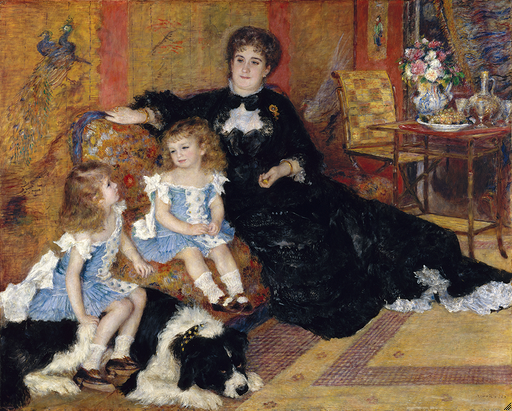
Pierre-Auguste Renoir (French, 1841–1919). Madame Georges Charpentier and Her Children, 1878. Oil on canvas; 153.7 × 190.2 cm (60 1/2 × 74 7/8 in.). The Metropolitan Museum of Art, New York, Catherine Lorillard Wolfe Collection, 07.122. Image copyright © The Metropolitan Museum of Art. Image source: Art Resource, NY.
The Laundress317
1877/79318
Oil on canvas; 80.8 × 56.5 cm (31 13/16 × 22 1/4 in.)
The Art Institute of Chicago, Charles H. and Mary F. S. Worcester Collection, 1947.102
The theme of the laundress was prevalent in the visual and literary culture of middle-class nineteenth-century France. Aside from Edgar Degas, however, the Impressionists did not regularly take up this subject in their paintings of modern life; when the theme did appear in Impressionist work, it was typically “subordinated to the atmospheric surroundings.”319 The Laundress is indeed an anomaly in the oeuvre of Pierre-Auguste Renoir. Although he returned to the subject in the mid-1880s and later—though only a handful of times—this canvas is likely the artist’s first and only incorporation of the motif during the time when he was actively engaged with the concerns of Impressionism.
As noted by Douglas Druick, Renoir probably made The Laundress—which is signed, but not dated—after completing his illustrations for Émile Zola’s gritty novel L’assommoir, a tragic tale centered around a laundress named Gervaise Macquart, which exposed the blight of poverty and alcoholism in contemporary working-class Paris.320 Originally published by Renoir’s patron, Georges Charpentier, in 1877, the first illustrated edition of L’assommoir appeared the following year. At Zola’s request, Renoir created four illustrations for it. But while Zola could present his vivid narrative with words, Renoir had to find a way to visualize select scenes in a two-dimensional format. As the Art Institute’s original drawing for one of the illustrations (fig. 1.2 (cat. 5) demonstrates, the artist—using pen, brown ink, and black chalk—combined areas of shading with a web of thin, scratchy lines in order to produce a vibrating surface that teems with an almost restless energy.
By the mid-1870s, Renoir was also creating similar effects in his paintings, as The Laundress exemplifies. Using a limited palette and a variety of techniques, he crafted a shimmering surface through a complex, built-up network of feathery brushstrokes. Combined with some areas of smooth modeling and heavy impasto, Renoir’s brushwork and use of complementary-color contrasts construct a tapestry of textures to suggest space and form. Precise contours were dissolved and details of the background were obscured as the artist decreased the density of his web of brushstrokes around the edges of the painting, allowing more of the warm gray ground layer to peek through (fig. 1.1).
The casualness of Renoir’s brushstrokes and the confidence demonstrated by his use of [glossary:wet-in-wet] paint and his juxtaposition of individual strokes of unmixed, bold color to create areas like the figure’s hair (fig. 2.20) suggest that he executed this painting quickly. It seems that he actually developed it relatively systematically, however. The traditional triangular composition provides stability to the otherwise vibrating surface, and [glossary:X-ray] imaging indicates that the artist reinforced this form by straightening out the hemline of the model’s skirt (fig. 1.3).
Renoir also altered the posture of the model as he worked out his composition. In an earlier state of the painting, the figure was slightly more frontal, and her elbows projected out from her body more symmetrically. By adjusting her arms and both sides of her skirt, Renoir shifted her body ever so slightly to a three-quarter angle. The alteration he made to her left arm is still visible with the naked eye: flesh tones appear around the area where her wrist meets her awkwardly disproportionate hand (fig. 1.4). Renoir also lowered the height of her hair and the frothy pile of laundry beside her in order to achieve the exact balance that he was seeking.
There is something very deliberate and even disconcerting about the way Renoir constructed—or rather, deconstructed—his young laundress. The model for this painting was identified by François Daulte as Nini Lopez, whom Renoir employed regularly between approximately 1874 and 1880.321 A resident of Montmartre, the Parisian quarter where Renoir moved in the summer of 1876, Nini was characterized by critic Georges Rivière as the ideal model, for she was “punctual, serious, [and] discreet.”322 But while she can be identified in The Laundress, this is not a portrait; her features are generalized and dissolve into a frenzy of brushstrokes. Instead, Renoir depicted a Parisian type—in this case, a young, working-class girl.323
Renoir also used Nini as his model in another, probably slightly earlier painting entitled First Step (Le premier pas) (fig. 2.22 [Daulte 347; Dauberville 250]). In this picture, however, Nini—who appears to be wearing the same blouse and skirt that she wore when posing for The Laundress—seems to embody a different type of Parisian woman. The figure that Renoir presented in Le premier pas is more refined and polished. Her facial features—though still generalized—are more delicate; using minimized brushstrokes, Renoir gave her skin a porcelain-like finish that glows like mother-of-pearl. Set in what appears to be the interior of a bourgeois dwelling—as indicated by the richly patterned, colorful carpet underfoot—she looks lovingly at a child, encouraging it to take its first steps. In many ways, Renoir made Nini a radiant, modern Madonna in this painting.
But, simultaneously, Renoir infused a degree of ambiguity in Le premier pas that makes us question this characterization. While both of Nini’s shoulders are covered, the hint of cleavage revealed as she leans toward the child highlights her sexuality; she is both demure and provocative. Her garment is simple and pulled together with the red sash at her waist, but its silhouette is not of the period. As a result of her pose, the waist appears to be cinched higher than was fashionable at the time, recalling instead coquettish Rococo fashion. Moreover, a white garment and striped socks draped over the chair suggest two possible identities for the woman. Perhaps she is the child’s mother and lady of the house awaiting the arrival of her laundress through the half-open door at right, or she might be a domestic caring for the child before undertaking her laundry chores, a woman who might even be sexually available. At this time, Renoir’s audience would have been aware that working women were known to sometimes supplement their incomes with prostitution.324
As part of the Impressionist group, Renoir was interested in depicting themes of modern life, but his worldview was much more tempered than those of Zola and some of his other Naturalist and Impressionist colleagues. Even in his own era Renoir was accused of viewing the world with rose-colored glasses. As John House has explained, “Even in their original contexts, the vision of the world presented by Renoir’s canvases was escapist; his smiling world-view was an attempt to erase the fundamental anxieties of the late nineteenth century, about the breakdown of order and of the sense of social and personal identity in a society that was rapidly changing, with the emergence of industrialisation and urban capitalism.”325
But however tame Renoir’s imagery may seem, the subtle ambiguities that he infused into Le premier pas remind us of the disconnects between class and gender in modern life and highlight the difficulty of expressing these ideas visually on a flat surface. Such uncertainties are even more exaggerated in The Laundress. Despite its similarities to Le premier pas, The Laundress is radically different in execution. The artist’s brushwork recalls the graphic, hatched quality of the drawings he made for Zola’s novel, which he also employed in a painted portrait of his friend and fellow Impressionist painter Alfred Sisley (fig. 2.23 [cat. 4]).
In large part because of the nature of the paint handling, much of the painting is impossible to read. Aside from the laundress, very few details of the composition can be definitively identified: the model stands next to a half-open door, on the other side of which is a completely illegible space; to the left of the laundress, there is only a vague impression of a yellow table or chair in what appears to be a hallway or another room; shadows on the floor do not consistently correspond with the light source coming from the upper left; and the clothes in the laundry basket—composed of swirls of paint—are not identifiable (fig. 2.24).
It is also curious that although the surface of The Laundress pulsates insistently, no substantial action is being depicted in the scene. With her flushed face, reddened hands, and basket of unfolded laundry sitting on the floor next to her, the laundress’s work is evident; this is perhaps the moment after the laundry was washed but before it was ironed, for the streaks of blue visible throughout the laundry pile may indicate that it has just been treated with bluing, a product used during laundering to enhance whitening. But in this particular moment, as Druick has observed, the laundress is not actively undertaking difficult labor, and there is no reason for her blouse to have slipped off of one of her shoulders.326 Renoir’s depiction of the young woman with décolletage—a motif he would feature in many other paintings of young women throughout his career—encourages a sexual, voyeuristic reading.327 At the same time that the young woman exhibits sexual and social vulnerability, however, she also conveys a sense of defiance. Solidly placed in the center of the composition with her hands on her hips, she has a certain resolve and confidence that suggests she is perhaps more in control of her own destiny than Zola’s laundress, Gervaise.
In the 1880s, Renoir abandoned his pursuit of urban, modern-life subjects and his broken, textured brushwork for more timeless, idyllic imagery inspired by the French countryside and the more precise forms and techniques of the Old Masters. When he picked up the theme of the laundress again nearly ten years later, his model was not Nini Lopez but rather his future wife, Aline Charigot, holding their first son, Pierre (fig. 2.25). Although his 1870s depiction speaks to the modern life of the city, Renoir—from the mid-1880s onward—related the theme of the laundress to the country, nature, hard work, and maternity.
Gloria Groom and Jill Shaw
Renoir began this work on a warm-gray, [glossary:commercially primed] [glossary:canvas]; the color of the [glossary:priming] is visible in many areas of the background and gives the work a unifying undertone. The original size of the composition is unclear; however, it appears that the work may have been slightly larger than a standard size. Unfinished edges and individual brushstrokes that pass onto the tacking margin complicate an assessment of the painting’s original size. There is no discernible compositional planning, and the [glossary:X-ray] and infrared images show that the artist shifted the pose of the figure through a series of small alterations in the paint stages. Initially, the figure’s gaze was more frontal, her hair pulled tighter toward the top of the head, her hips pushed slightly to the right, and the hem of her skirt shorter on the sides, making her appear longer in relation to her surroundings than she does in the final composition. Renoir also made slight changes in the placement of her arms, especially her left one, some of which are visible under normal viewing conditions.
The artist used a limited [glossary:palette] and varied the size and concentration of brushstrokes throughout the work. In the figure, areas of very fine strokes of unmixed color placed side by side while still wet contrast with smoothly modeled areas and heavy [glossary:impasto] created by dragging stiff paint with a fine, soft brush. These effects are seen in the figure’s hair, skirt, and blouse, respectively. The flesh tones—primarily lead white with some vermilion and red lake—were modeled with a combination of these methods. As the artist moved from the figure to her surroundings, covering his compositional changes with strokes of background colors, the composition became less detailed, marked by broader brushstrokes and large areas of exposed ground.
The multilayer interactive image viewer is designed to facilitate the viewer’s exploration and comparison of the technical images (fig. 2.26).328
Signed (lower left, in warm blue paint): Renoir. (fig. 2.27 and fig. 2.28).329
Flax (commonly known as linen).330
As there is no obvious painted edge, the original size of the canvas is unclear and depends largely on whether the [glossary:stretcher] is original. If this is the original stretcher, the dimensions appear to have been approximately 80.7 × 56 cm. The closest standard sizes are seascape ([glossary:marine]) 25 [glossary:haute] and [glossary:basse], which measure 81 × 54 cm and 81 × 56.7 cm, respectively.331
[glossary:Plain weave]. Average [glossary:thread count] (standard deviation): 16.4V (0.7) × 13.8H (0.4) threads/cm. The horizontal threads were determined to correspond to the [glossary:warp] and the vertical threads to the [glossary:weft].332
There is mild cusping along the top and bottom edges corresponding to the placement of the original tacks and some variation in thread thickness in both directions. The thread-count [glossary:weft-angle map] also indicates two places in the upper right quadrant where there was a [glossary:warp-thread repair], causing the perpendicular weft threads to distort around it (fig. 2.29).333
Current stretching: The painting was lined and restretched prior to 1956 (see Conservation History). It is unclear if the dimensions changed during this treatment. The X-ray indicates that although some of the old tack holes were reused at this time, cusping along the top and bottom edges does not correspond to current tack placement. Where the tacking margin is not obscured by paper tape, it appears the painting is currently attached with steel tacks through both the original and [glossary:lining] canvases.
Original stretching: As the edges are largely covered with paper tape, it is not clear how many times the painting was stretched. Based on cusping visible along the top and bottom in the X-ray, tacks were placed approximately 5–7 cm apart. There is almost no discernible scalloping in the weft-angle map or the X-ray for the left side and very little information on the right. Along the right edge, there is a crease approximately 0.5 cm from the edge, and a corresponding set of extra tack holes appears just beyond the current foldover. These holes are not always visible but may correspond to the faint angle changes illustrating cusping on the right edge in the weft-angle map (fig. 2.30). If this crease represents an earlier foldover, the width of the painting would be about 56 cm. Gaps between stretcher members on the verso suggest that closing the members of the current, expanded stretcher (tapping in) would accommodate this 0.5 cm.
While the height of this painting corresponds to a standard size, the width has a larger discrepancy. The edges of the composition are not clear, as they are often unfinished or have brushstrokes running over the foldover, but there is no physical evidence to suggest the work was ever smaller than 56 cm wide.334
Current stretcher: Six-member keyable mortise-and-tenon stretcher with vertical and horizontal crossbars.
The stretcher may be original to the painting, but this remains unclear, as the painting was lined, mounted to [glossary:hardboard], and restretched (see Conservation History). The stretcher’s structure and patina suggest that if it is not original to the painting, it was added early in the painting’s lifetime (fig. 2.31). Depth: 1.7 cm.
[glossary:Cross-sectional analysis] indicates a thin brownish layer of material between the paint and canvas that closely follows the canvas texture. This material is organic in nature and estimated to be glue (fig. 2.32).335
The preparation is a two-layered (or [glossary:lisse]), commercially applied [glossary:ground] that extends to the edges of the [glossary:tacking margins]. The lower layer of the ground has an approximate thickness of 10–60 µm, while the upper, toned layer is approximately 15–45 µm thick. It is smooth, somewhat fills the canvas weave, and is left visible throughout the background.
The upper ground layer is a warm gray, with black and yellow particles visible microscopically. Microscopic examination reveals the creamy white initial ground layer visible along the tops of some of the abraded threads (fig. 2.33).
The commercial ground is a two-layered preparation with a whitish first layer consisting of primarily lead white with small amounts of iron oxide yellow, associated silicates, barium sulfate, and calcium sulfate. The upper layer is a warm gray made of a complex mixture of lead white, bone black, and iron oxide red and yellow, with associated complex silicates, quartz, calcium sulfate, and a trace amount of Naples yellow (fig. 2.34).336 Both layers are estimated to be bound in an [glossary:oil] medium.337
No compositional planning visible with infrared or microscopy.
Renoir made many changes to the figure’s posture in The Laundress. There are heavy strokes of underpaint above and to the right of the figure that may mask some changes (fig. 2.35); however, a number of small later changes can still be discerned on the painting’s surface. X-ray analysis suggests that the skirt was originally placed slightly to the right, with a lower red waistband (fig. 2.36), as if the figure were shifting her weight slightly to one side. In response, the artist swung her left arm farther out to the side, while her right arm was placed slightly closer to her body (fig. 2.37). Some of the changes to the figure’s arms and hands were made quickly and remain visible on the work’s surface (fig. 2.38). The initial profile of the woman’s left arm and hand were roughly painted out with fine background strokes. Close examination of the surface reveals flesh tones visible between these fine strokes along the outer edge of the arm and hand. From the [glossary:infrared reflectogram] (IRR) and X-ray, it appears that the artist may have moved the figure’s left arm more than once, as the flesh tone extends under the background paint for a distance. Specific movements are difficult to discern, however. Renoir also quickly indicated an extension of the figure’s blouse at the neckline, bringing up the top slightly near her left shoulder. Initially, the skirt’s profile appeared thinner and the figure seemed to be turned more toward the viewer (fig. 2.26). [glossary:Raking light] and infrared examination also indicate changes to her hairstyle in the final version of the painting: her bun was higher on her head and more tightly held in place with a dark band. The general effect of these changes is that the figure appears bulkier, with a less defined waist. Renoir also reduced the laundry pile at the lower right, adding a bright red background to trim the upper edge of the pile.
Renoir used wider brushstrokes toward the edges of the picture, in the laundry, and along the right side, which broadly contrast with the densely applied, finer strokes associated with the figure (fig. 2.39) and her immediate surroundings. After masking some compositional changes with heavy strokes of paint that tonally mimic the ground color, he continued changing the figure’s posture. The composition’s background wraps around the figure in fine, separate strokes, often directly covering later pentimenti. Renoir alternated individual strokes of unmixed, bold color placed side by side, as in the figure’s hair (fig. 2.40), with more blended, softer transitions between colors and crisscross patterns, as in the skirt. In some areas, soft, fine brushes dragged stiff paint across the surface, leaving heavy impasto with small peaks from lifting the brush (fig. 2.41). The flesh tones appear to alternate between these three techniques; the artist began with a smoother modeling that he later textured with heavy impasto and directional strokes. In other areas, such as the laundry pile and the figure’s blouse, he utilized stiff-bristled brushes, leaving a heavy texture in the paint surface.
Very fine brushes, flat and round, up to 1 cm width.
Analysis indicates the presence of the following [glossary:pigments]:338 lead white, vermilion, two red lakes,339 chrome yellow, cobalt blue, cerulean blue,340 emerald green, iron oxide red and/or iron oxide yellow, and bone black.
[glossary:UV] examination suggests the presence of fluorescing red lake, particularly in the flesh tones and limited portions of the background, based on the observation of a characteristic, orange [glossary:fluorescence] (fig. 2.42).341 Visible through microscopic analysis of the surface and [glossary:cross sections] of other portions of the composition, such as the background along the left edge, is a second, nonfluorescing red lake.
Oil (estimated).342
The current [glossary:synthetic varnish] was applied in 1969 and replaced a different synthetic varnish from the 1956–57 treatment. Application of this earlier synthetic varnish followed removal of a discolored oil-resin [glossary:varnish]. As the painting was already lined at the time of this treatment (1956–57), it is unclear whether the oil-resin varnish was original to the painting.
The painting has had two documented treatments since acquisition. The earliest notes on the painting come from a 1937 memo indicating that the canvas was in good condition and the frame miters were opening.343 By 1956 the painting was noted as lined and mounted to a board (either a thin wooden panel or a Masonite-type hardboard), with a secondary, unprimed fabric on the verso of the board, indicating previous undocumented treatment.344 Although lined, the painting retained its stretcher; the stretcher is either original or evidence of a very early treatment. In January 1957, the work was treated, and an oil-resin varnish was removed along with a heavy layer of grime using a combination of solvent and mechanical cleaning.345 The work was given a spray coat of synthetic varnish (n/butyl isobutyl methacrylate copolymer resin); [glossary:retouching] was not deemed necessary at the time. In 1969 the work was given a second aesthetic treatment during which the 1957 varnish was removed and replaced with three coats of synthetic varnish (an isolating layer of polyvinyl acetate [PVA] AYAA, followed by methacrylate resin L-46, and a final coat of AYAA).346
The work is in good condition, aqueously lined to a secondary canvas and mounted to an unidentified thin panel. The panel features unprimed canvas on its verso and therefore cannot be positively identified. The panel is concave, creating a slightly dished appearance, but appears stable at this time. There are minimal localized losses to the paint layer, cracking throughout the sections of blue paint (including the skirt and the background left of center), and stretcher-bar creases corresponding to the horizontal [glossary:crossbar]. Along the foldover on all sides, there is abrasion and grime, in addition to localized cracking of both the paint and the support resulting from the lining process.
Kelly Keegan
Current frame (installed after 1948): The frame is not original to the painting. It is a French, late-eighteenth-century, Louis XVI, scotia frame with acanthus leaves, beading, and leaf-and-tongue sight molding. The frame has water and oil gilding over red bole on gesso. The ornament and outer fillet are burnished. The frame sustained water damage and was subsequently painted with bronze powder paint. It retains most of the original gilding, except on the heavily damaged bottom section. The carved oak molding is mitered and joined with angled, dovetailed splines. At some point in the frame’s history, the original verso was planed flat, removing all construction history and provenance, a back frame was added, and all back and interior surfaces were painted. The molding, from the perimeter to the interior, is fillet; scotia side; stepped fillet; scotia with acanthus leaves and beaded fillet; frieze; fillet; ogee with leaf-and-tongue ornament; fillet with a cove sight edge; and an independent fillet liner with a cove sight edge that was added when the painting was paired with the frame (fig. 2.43).347
Previous frame (installed by 1948): The work was previously housed in a late-nineteenth–early-twentieth-century, Louis XIV reproduction, reverse ogee frame with cast plaster anthemia corner cartouches and shell center cartouches linked by foliate scrollwork (fig. 2.18).
Kirk Vuillemot
Possibly sold by the artist to Durand-Ruel, Paris, June 15, 1882.348
Sold by Durand-Ruel, Paris, to Bernheim-Jeune, Paris, Aug. 3, 1905, for 8,500 francs.349
Sold by Bernheim-Jeune, Paris, to the Prince de Wagram (Alexandre Berthier, 4th Prince de Wagram), Paris, by Feb. 24, 1906.350
Resold by the Prince de Wagram (Alexandre Berthier, 4th Prince de Wagram), Paris, to Bernheim-Jeune, Paris, Feb. 24, 1906, for 9,000 francs.351
Possibly sold by Bernheim-Jeune, Paris, to Léon Orosdi, Paris (died 1922), Mar. 2, 1906.352
Acquired by Galérie Barbazanges, Paris, by Jan. 4, 1923.353
Acquired by Meyer Goodfriend, New York and Paris, by Jan. 4, 1923.354
Sold at the sale of Meyer Goodfriend, New York and Paris, New American Art Galleries, New York, Jan. 5, 1923, lot 109, to John Levy Galleries, New York, for $2,000.355
Acquired by Howard Young, New York, by Mar. 28, 1923.356
Sold by Howard Young, New York, to Charles H. Worcester, Chicago, by Mar. 28, 1923.357
Given by Charles H. and Mary F. S. Worcester to the Art Institute of Chicago, 1947.358
Paris, Galeries Durand-Ruel, Exposition A. Renoir, May 1892, cat. 8, as Laveuse.359
Art Institute of Chicago, Exhibition of the Worcester Collection, July 24–Sept. 23, 1923, no cat.360
Toledo Museum of Art, Paintings by French Impressionists and Post-Impressionists, Nov. 7–Dec. 12, 1937, cat. 30 (ill.).
New York, Wildenstein, Renoir: A Loan Exhibition for the Benefit of the American Association of Museums in Commemoration of the Fiftieth Anniversary of Renoir’s Death, Mar. 27–May 3, 1969, cat. 37 (ill.).
Art Institute of Chicago, Paintings by Renoir, Feb. 3–Apr. 1, 1973, cat. 31 (ill.).
Atlanta, High Museum of Art, May 25, 1984–May 30, 1985, no cat.361
Tokyo, Bridgestone Museum of Art, Renoir: From Outsider to Old Master, 1870–1892, Feb. 10–Apr. 15, 2001, cat. 13 (ill.); Nagoya City Art Museum, Apr. 21–June 24, 2001.
Columbus (Ohio) Museum of Art, Renoir’s Women, Sept. 23, 2005–Jan. 8, 2006, cat. 2.
Fort Worth, Tex., Kimbell Art Museum, The Impressionists: Master Paintings from the Art Institute of Chicago, June 29–Nov. 2, 2008, cat. 25 (ill.).
Galeries Durand-Ruel, Exposition A. Renoir, exh. cat. (Imp. de l’Art, E. Ménard et Cie, 1892), p. 37, cat. 8.
“Renoir Painting Sold for $7,000,” New York Times, Jan. 6, 1923, p. 13.
Toledo Museum of Art, Paintings by French Impressionists and Post-Impressionists, exh. cat. (Toledo Museum of Art, 1937), n.pag., cat. 30 (ill.).
Daniel Catton Rich, Catalogue of the Charles H. and Mary F. S. Worcester Collection of Paintings, Sculpture and Drawings (Lakeside, 1938), pp. 77–78; pl. 46/cat. 80.
Edith Weigle, “Gift of Art,” Chicago Daily Tribune, May 25, 1947, p. C6 (ill.).
“Donor to Get Honor Degree at Art Institute,” Chicago Daily Tribune, June 13, 1947, p. 21.
Art Institute of Chicago, “Complete List of Works,” Bulletin of the Art Institute of Chicago 41, 5 [pt. 3] (Sept.–Oct. 1947), p. 63.
Art Institute of Chicago, “The Magnificent Worcester Gift,” Bulletin of the Art Institute of Chicago, 42, 2, pt. 3 (Feb. 1948), p. 4 (ill.).
Frederick A. Sweet, “The Charles H. and Mary F. S. Worcester Collection,” Art Institute of Chicago Quarterly 50, 3 (Sept. 15, 1956), p. 44.
Art Institute of Chicago, Paintings in the Art Institute of Chicago: A Catalogue of the Picture Collection (Art Institute of Chicago, 1961; reissue, 1968), p. 396.
Frederick A. Sweet, “Great Chicago Collectors,” Apollo 84, 55 (Sept. 1966), p. 203.
François Daulte, Renoir: A Loan Exhibition for the Benefit of the American Association of Museums in Commemoration of the Fiftieth Anniversary of Renoir’s Death, exh. cat. (Wildenstein, 1969), cat. 37 (ill.).
François Daulte, Auguste Renoir: Catalogue raisonné de l’oeuvre peint, vol. 1, Figures, 1860–1890 (Durand-Ruel, 1971), pp. 254–55, cat. 348 (ill.); 416.
Elda Fezzi, L’opera completa di Renoir, nel periodo impressionista, 1869–1883, Classici dell’arte 59 (Rizzoli, 1972), p. 108, cat. 434 (ill.).
Art Institute of Chicago, Paintings by Renoir, exh. cat. (Art Institute of Chicago, 1973), pp. 26; 86; 90–91, cat. 31 (ill.).
Sophie Monneret, Renoir, Profils de l’art (Chêne, 1989), p. 153, cat. 8 (ill.).
Art Institute of Chicago, Treasures of 19th- and 20th-Century Painting: The Art Institute of Chicago, with an introduction by James N. Wood (Art Institute of Chicago/Abbeville, 1993), p. 79 (ill.).
Gerhard Gruitrooy, Renoir: A Master of Impressionism (Todtri Productions, 1994), p. 109 (ill.).
Douglas W. Druick, Renoir, Artists in Focus (Art Institute of Chicago/Abrams, 1997), pp. 30; 37–38; 87, pl. 6; 108 (detail).
Katsunori Fukaya, “The Laundress,” in Bridgestone Museum of Art and Nagoya City Art Museum, Renoir: From Outsider to Old Master, 1870–1892, exh. cat. (Bridgestone Museum of Art/Nagoya City Art Museum/Chunichi Shimbun, 2001), pp. 82–83, cat. 13 (ill.).
Paul Hayes Tucker, “Renoir in the 1870s and ’80s: Modernity, Tradition, and Individuality,” in Bridgestone Museum of Art and Nagoya City Art Museum, Renoir: From Outsider to Old Master, 1870–1892, trans. Yumiko Yamazaki and Yuko Tatsuno, exh. cat. (Bridgestone Museum of Art/Nagoya City Art Museum/Chunichi Shimbun, 2001), pp. 37–38, 223.
Ann Dumas and John Collins, Renoir’s Women, exh. cat. (Columbus Museum of Art/Merrell, 2005), pp. 11, fig. 2; 118.
Guy-Patrice Dauberville and Michel Dauberville, with the collaboration of Camille Frémontier-Murphy, Renoir: Catalogue raisonné des tableaux, pastels, dessins et aquarelles, 1858–1881, vol. 1 (Bernheim-Jeune, 2007), p. 409, cat. 382 (ill.).
Gloria Groom and Douglas Druick, with the assistance of Dorota Chudzicka and Jill Shaw, The Impressionists: Master Paintings from the Art Institute of Chicago, exh. cat. (Art Institute of Chicago/Kimbell Art Museum, 2008), pp. 17; 68–69, cat. 25 (ill.). Simultaneously published as Gloria Groom and Douglas Druick, with the assistance of Dorota Chudzicka and Jill Shaw, The Age of Impressionism at the Art Institute of Chicago (Art Institute of Chicago/Yale Unversity Press, 2008), pp. 17; 68-69, cat. 25 (ill.).362
Anne Distel, Renoir, Les Phares (Citadelles et Mazenod, 2009), pp. 158–59, ill. 142; 310.
Inventory number
Stock Durand-Ruel Paris 2464. Ce tableau a peut-être été acheté à l’artiste par Durand-Ruel le 15 juin 1882, livre de stock Paris 1880–84, stock no. 2464.363
Inventory number
Stock Durand-Ruel Paris 1520. Blanchisseuse, Livre de stock Paris 1891; Blanchisseuse, livre de stock Paris 1901.364
Photograph number
Photo Durand-Ruel Paris 1647. Blanchisseuse, photo entre 1899 et 1901.365
Inventory number
No. de stock Bernheim-Jeune 1485352366
Photograph number
Photographie Bernheim-Jeune no. 1066553367
Number
Location: stretcher
Method: handwritten script
Content: #18799 (fig. 2.49)
Label
Location: stretcher
Method: blue label
Content: [blank] (fig. 2.49)
Number
Location: stretcher
Method: handwritten script
Content: 30 [circled and crossed out] (fig. 2.49)
Inscription
Location: stretcher
Method: handwritten script
Content: P (fig. 2.49)
Number
Location: stretcher
Method: red stamp
Content: 2096 (fig. 2.52)
Label
Location: stretcher
Method: handwritten script (graphite) on red-and-white label
Content: 1828/2 (fig. 2.50)
Number
Location: stretcher
Method: stamp
Content: 341[6]7 (fig. 2.19)
Number
Location: stretcher
Method: handwritten script
Content: 580 (fig. 2.11)
Number
Location: stretcher
Method: handwritten script
Content: 1337 [?] (fig. 2.10)
Number
Location: stretcher
Method: handwritten script
Content: 2093 (fig. 2.9)
Label
Location: stretcher
Method: red stamp on label
Content: 1337 (fig. 2.5)
Inscription
Location: stretcher
Method: handwritten script
Content: 289 / 34167 / XR 118 (fig. 2.54)
Number
Location: stretcher
Method: handwritten script
Content: 409 [crossed out] (fig. 2.55)
Number
Location: stretcher
Method: handwritten script
Content: 14426 [crossed out] (fig. 2.55)
Label
Location: stretcher
Method: handwritten script (red pencil) on red-and-white label
Content: M [ . . . ] / 268 (fig. 2.56)
Inscription
Location: stretcher
Method: handwritten script
Content: DR [ . . . ] / 1520 (fig. 3.60)
Number
Location: stretcher
Method: red stamp
Content: 14853 (fig. 2.57)
Number
Location: stretcher
Method: handwritten script (pen)
Content: 1947.102 (fig. 2.8)
Number
Location: stretcher
Method: hand-painted script
Content: 47.102 (fig. 2.49)
Label
Location: stretcher
Method: typed label
Content: THE LAUNDRESS by RENOIR / PROPERTY OF THE ART INSTITUTE OF CHICAGO / GIFT CHARLES H. AND MARY F. S. WORCESTER, / AS PART OF THE [WOR]CESTER COLLECTION (fig. 2.48)
Label
Location: stretcher
Method: printed/typed label
Content: FROM / THE ART INSTITUTE OF CHICAGO / CHICAGO ILLINOIS 60603, U.S.A. / To / Renoir, Pierre Auguste / Inventory 1980–1981 / The Laundress c. 1880 / 1947.102 (fig. 2.51)
Westinghouse X-ray unit, films scanned on Epson Expressions 10000XL flatbed scanner.
Inframetrics Infracam with 1.5–1.73 µm filter; Fujifilm S5 Pro with X-Nite 1000B/2 mm filter (1.0–1.1 µm); Goodrich/Sensors Unlimited SU640SDV-1.7RT with H filter (1.1–1.4 µm) J filter (1.5–1.7 µm); X-Nite 1000B/2 mm filter (1.0–1.7 µm).
Normal light, raking light, transmitted light overalls, and macrophotography: Fujifilm S5 Pro with X-NiteCC1 filter.
Fujifilm S5 Pro with X-NiteCC1 filter and Kodak Wratten 2E filter.
Sinar P3 camera with Sinarback eVolution 75 H (B+W 486 UV/IR cut MRC filter).
Sample and cross-sectional analysis using Zeiss Axioplan2 research microscope equipped with reflected light/UV fluorescence and a Zeiss AxioCam MRc5 digital camera. Types of illumination used: darkfield, differential interference contrast (DIC), and UV. In situ photomicrographs with Wild Heerbrugg M7A StereoZoom microscope fitted with Olympus DP71 microscope digital camera.
Several spots on the painting were analyzed in situ with a Bruker/Keymaster TRACeR III-V with rhodium tube ; Bruker ArTAX.
Zeiss Universal research microscope.
Cross sections analyzed after carbon coating with Hitachi S-3400N-II VPSEM with an Oxford EDS and a Hitachi solid-state BSE detector. Analysis was performed at the Northwestern University Atomic and Nanoscale Characterization Experimental (NUANCE) Center, Electron Probe Instrumentation Center (EPIC) facility.
Thread count and weave information determined by Thread Count Automation Project software.368
Overlay images registered by Damon M. Conover (GW), Dr. John K. Delaney (GW, NGA), and Murray H. Loew (GW) of the George Washington University’s School of Engineering and Applied Science and the National Gallery of Art, Washington, D.C., using a novel image-based correlation algorithm.369
The image inventory compiles records of all known images of the artwork on file in the Conservation Department, the Imaging Department, and the Department of Medieval to Modern European Painting and Sculpture at the Art Institute of Chicago (fig. 2.6).
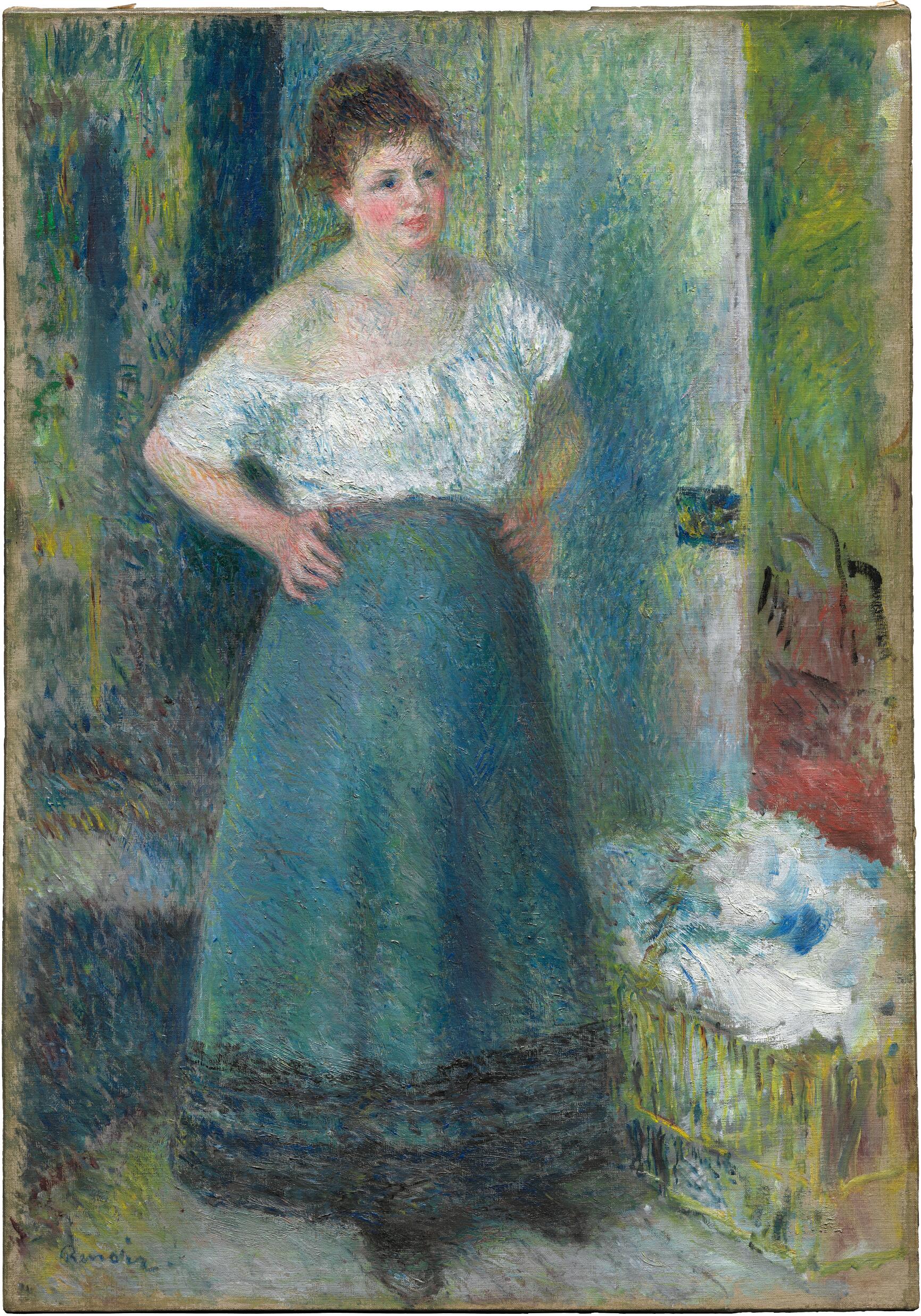
cat. 6 The Laundress, 1877/79.

Pierre-Auguste Renoir (French, 1841–1919). Workers’ Daughters on the Outer Boulevard (Illustration for Émile Zola’s “L’assommoir”), 1877/78. Pen and brown ink, over black chalk, on ivory laid paper; 275 × 399 mm. The Art Institute of Chicago, Regenstein Collection, 1986.420.
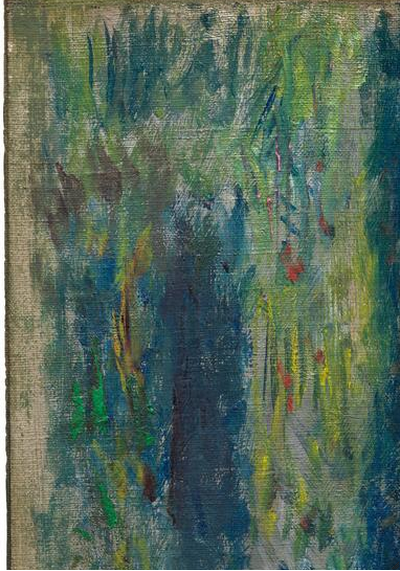
Detail of Renoir’s The Laundress (1877/79) showing the exposed ground. The Art Institute of Chicago, 1947.102.
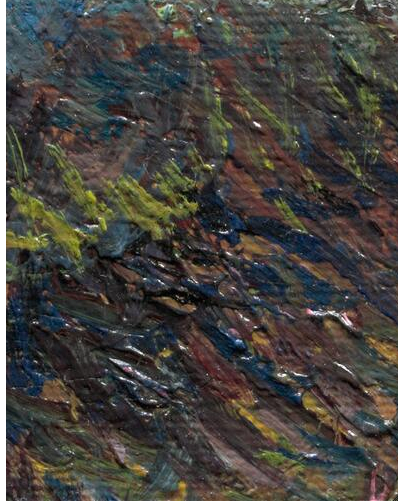
Detail of the figure’s hair in Renoir’s The Laundress (1877/79) showing individual brushstrokes of unmixed color. The Art Institute of Chicago, 1947.102.
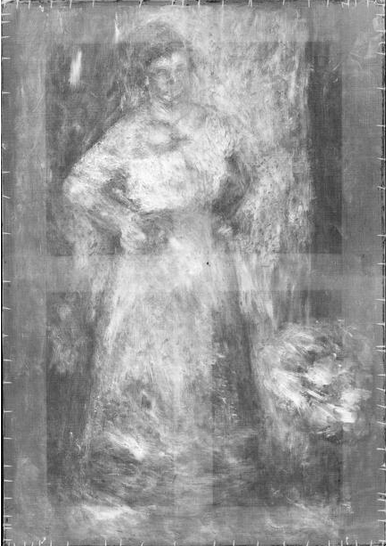
X-ray, natural-light, and infrared reflectogram (Goodrich, 1.0–1.7 µm) images of Renoir’s The Laundress (1877/79) showing changes made by the artist. The Art Institute of Chicago, 1947.102. Interactive image.
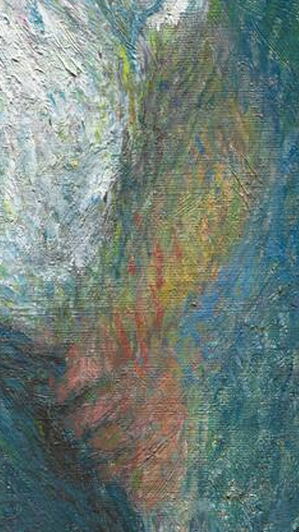
Detail of Renoir’s The Laundress (1877/79) showing the figure’s left forearm. The Art Institute of Chicago, 1947.102.
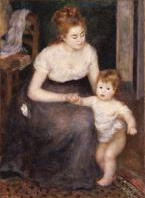
Pierre-Auguste Renoir (French, 1841–1919). Le premier pas, 1876. Oil on canvas; 111 × 80.5 cm (43 11/16 × 31 11/16 in.). Sold, Christie’s, London, Feb. 4, 2002, lot 17. Photograph © Christie’s Images/Bridgeman Images.
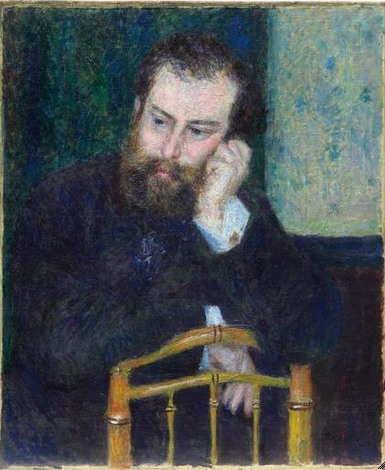
Pierre-Auguste Renoir (French, 1841–1919). Alfred Sisley, 1876. Oil on canvas; 66.2 × 54.8 cm (26 × 21 9/16 in.). The Art Institute of Chicago, Mr. and Mrs. Lewis Larned Coburn Memorial Collection, 1933.453.
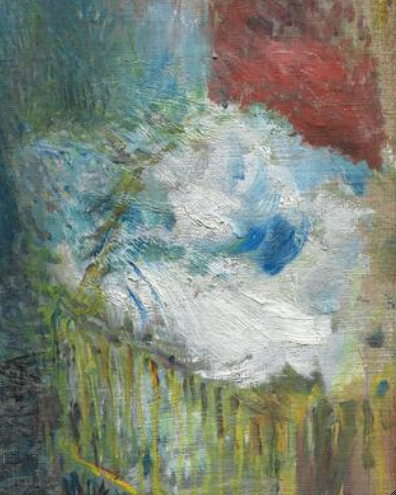
Detail of the laundry basket in Renoir’s The Laundress (1877/79). The Art Institute of Chicago, 1947.102.
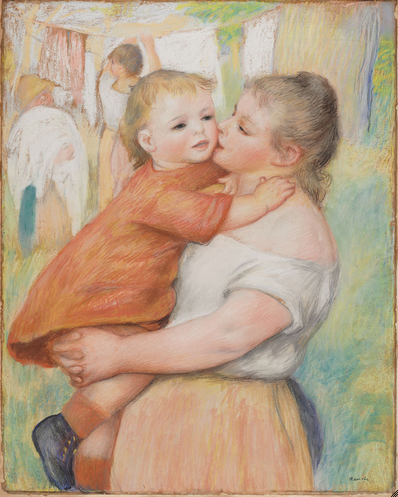
Pierre-Auguste Renoir (French, 1841–1919). Mother and Child, 1886. Pastel; 79.1 × 63.5 cm (31 1/8 × 25 in.). The Cleveland Museum of Art, bequest of Alexander Ginn 1977.167. Photograph © The Cleveland Museum of Art.
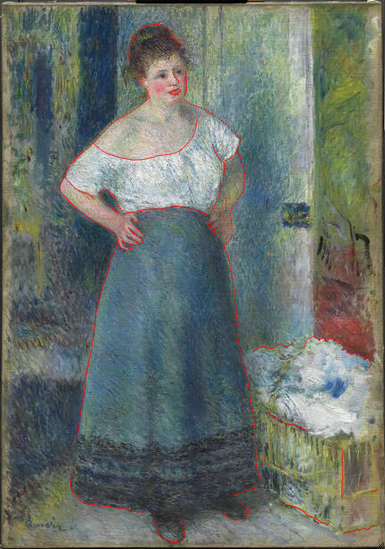
Renoir’s The Laundress (1877/79). The Art Institute of Chicago, 1947.102. Interactive image.
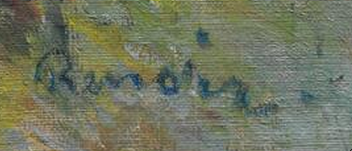
Detail of Renoir’s The Laundress (1877/79) showing the artist’s signature. The Art Institute of Chicago, 1947.102.
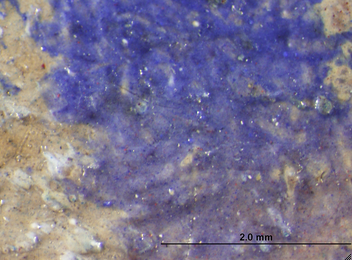
Photomicrograph of Renoir’s The Laundress (1877/79) showing the different paint colors used in the signature. The Art Institute of Chicago, 1947.102.
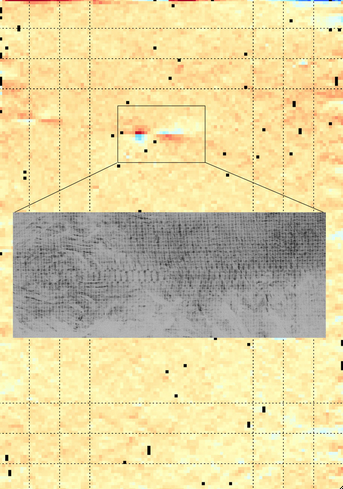
Weft-angle map of Renoir’s The Laundress (1877/79) showing areas of warp-thread repair with an X-ray detail showing an area of visible warp-thread repair. The Art Institute of Chicago, 1947.102.
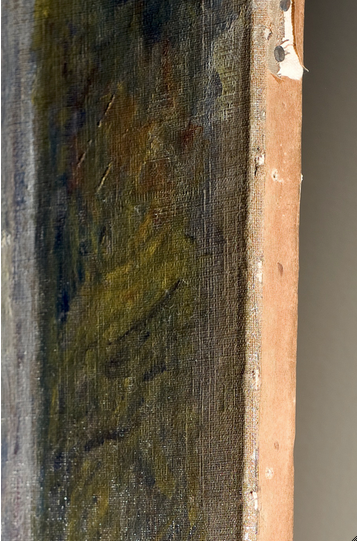
Detail of Renoir’s The Laundress (1877/79) showing previous tack holes just beyond the current foldover. The Art Institute of Chicago, 1947.102.
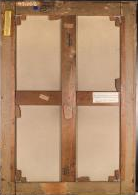
Verso of Renoir’s The Laundress (1877/79) showing the keyable stretcher and labels. The Art Institute of Chicago, 1947.102.
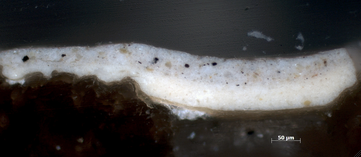
Photomicrograph of a cross section of the ground and canvas in Renoir’s The Laundress (1877/79). Original magnification: 200×. The Art Institute of Chicago, 1947.102.
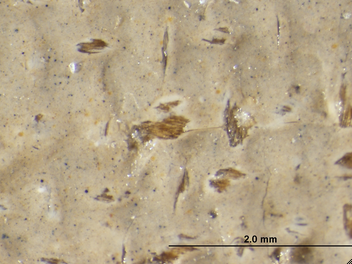
Photomicrograph of Renoir’s The Laundress (1877/79) showing areas of abrasion that reveal lower white ground layer and canvas threads. The Art Institute of Chicago, 1947.102.

Photomicograph of a cross section of the ground with blue and yellow paint layers in Renoir’s The Laundress (1877/79). Original magnification: 200×. The Art Institute of Chicago, 1947.102.
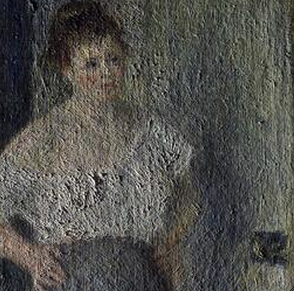
Raking-light detail of Renoir’s The Laundress (1877/79) showing the heavy paint application around the figure covering the changes made by the artist. The Art Institute of Chicago, 1947.102.
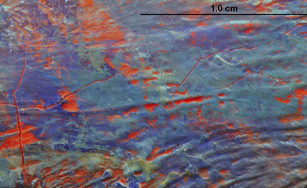
Photomicrograph of the figure’s waistband in Renoir’s The Laundress (1877/79) showing exposed red paint from an earlier compositional stage. The Art Institute of Chicago, 1947.102.
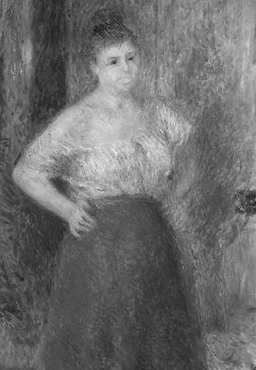
Infrared reflectogram (Goodrich, 0.9-1.7 µm), X-ray, infrared reflectogram (Fuji, 1.0-1.1µm), and natural-light details of Renoir’s The Laundress (1877/79) showing changes made by the artist to the position of the figure. The Art Institute of Chicago, 1947.102. Interactive image.
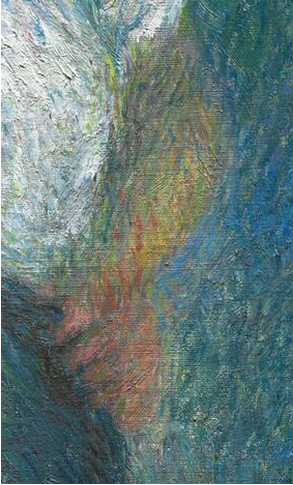
Detail of the figure’s left arm in Renoir’s The Laundress (1877/79) showing changes made by the artist that remain visible. The Art Institute of Chicago, 1947.102.

Detail of Renoir’s The Laundress (1877/79) showing the very fine brushwork used for the figure. The Art Institute of Chicago, 1947.102.
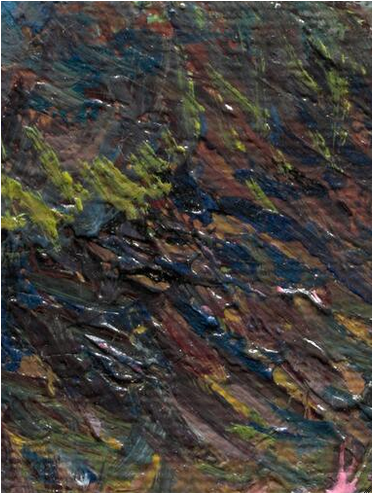
Detail of the figure’s hair in Renoir’s The Laundress (1877/79) showing individual brushstrokes of unmixed color. The Art Institute of Chicago, 1947.102.
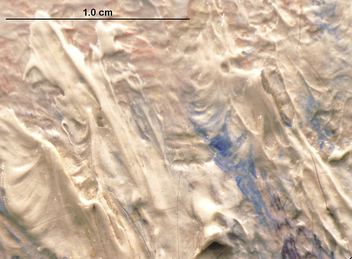
Photomicrograph of Renoir’s The Laundress (1877/79) showing the artist’s use of impasto brushstrokes. The Art Institute of Chicago, 1947.102.
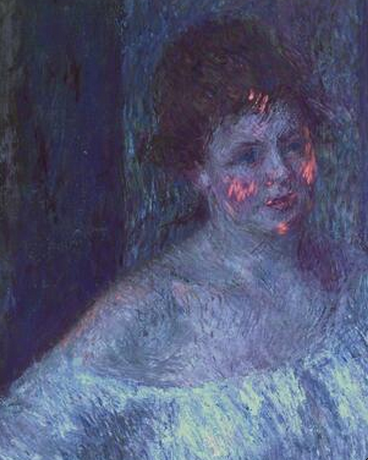
Ultraviolet and natural-light details of Renoir’s The Laundress (1877/79) showing fluorescing pigments. The Art Institute of Chicago, 1947.102. Interactive image.
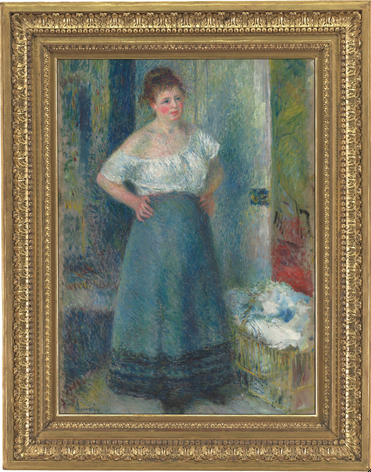
Renoir’s The Laundress (1877/79) in its current frame. The Art Institute of Chicago, 1947.102.

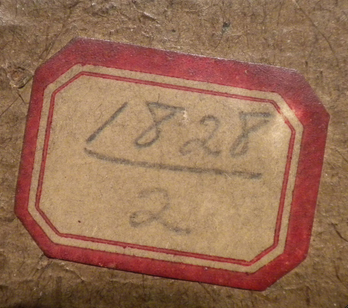
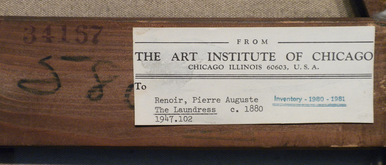
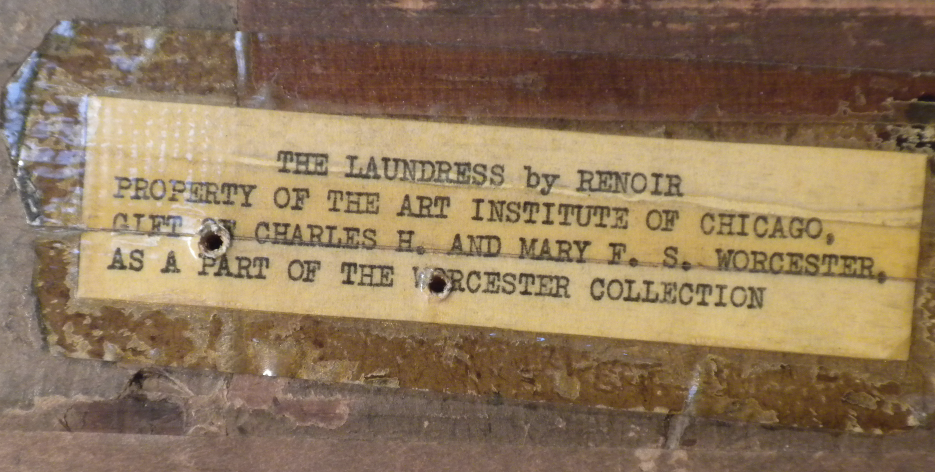
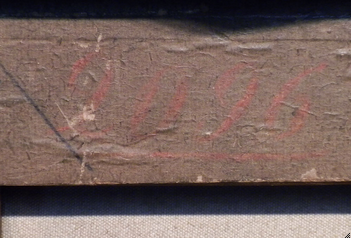
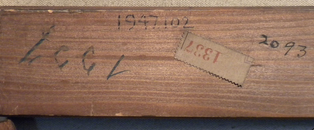
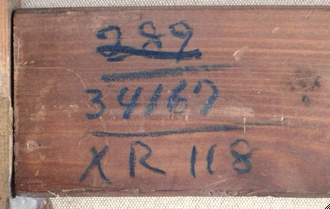
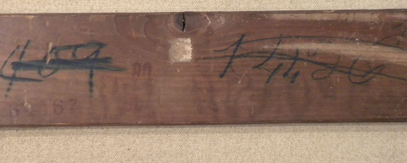
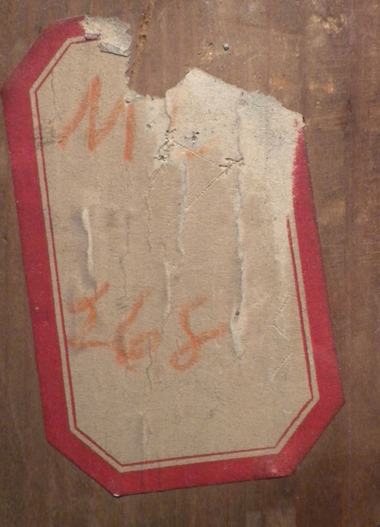
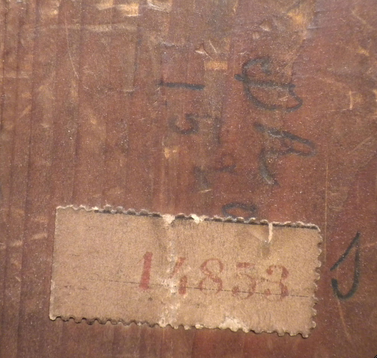
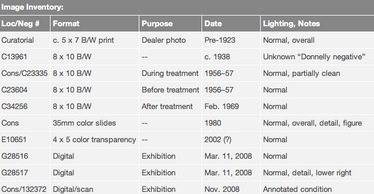
| Image Inventory: | ||||
|---|---|---|---|---|
| Loc/Neg # | Format | Purpose | Date | Lighting, Notes |
| Curatorial | c. 5 x 7 B/W print | Dealer photo | Pre-1923 | Normal, overall |
| C13961 | 8 x 10 B/W | -- | c. 1938 | Unknown “Donnelly negative” |
| Cons/C23335 | 8 x 10 B/W | During treatment | 1956–57 | Normal, partially clean |
| C23604 | 8 x 10 B/W | Before treatment | 1956–57 | Normal |
| C34256 | 8 x 10 B/W | After treatment | Feb. 1969 | Normal |
| Cons | 35mm color slides | -- | 1980 | Normal, overall, detail, figure |
| E10651 | 4 x 5 color transparency | -- | 2002 (?) | Normal |
| G28516 | Digital | Exhibition | Mar. 11, 2008 | Normal |
| G28517 | Digital | Exhibition | Mar. 11, 2008 | Normal, detail, lower right |
| Cons/132372 | Digital/scan | Exhibition | Nov. 2008 | Annotated condition |
| Cons | Digital | OSCI | Nov. 3, 2009 | Detail images of verso/ labels (10 total details) |
| Cons | X-radiograph | OSCI | Nov. 4, 2009 | X-ray films scanned/digitally composited, overall |
| Cons | Digital | OSCI | Nov. 5, 2009 | Normal |
| Cons | Digital | OSCI | Nov. 5, 2009 | Raking light, overall |
| Cons | Digital | OSCI | Nov. 5, 2009 | UV, overall |
| Cons | Digital | OSCI | Nov. 5, 2009 | Infrared (Fuji, 1000B—2mm filter) overall |
| Cons | Digital | OSCI | Nov. 5, 2009 | Macro details of surface (20 total details) |
| Cons | Digital | OSCI | Nov. 10, 2009 | Infrared (Inframetrics, 1.5–1.73 filter) overall |
| Cons | Digital | OSCI | Nov. 11, 2009 | Photomicrographs of surface (17 total details) |
| G32708 | Digital | OSCI | Dec. 3, 2009 | Normal |
| G32709 | Digital | OSCI | Dec. 3, 2009 | Normal, detail, lower-right quadrant |
| G32710 | Digital | OSCI | Dec. 3, 2009 | Normal, detail, laundry basket |
| G32711 | Digital | OSCI | Dec. 3, 2009 | Normal, detail, right shoulder |
| G32712 | Digital | OSCI | Dec. 3, 2009 | UV, overall |
| G32718 | Digital | OSCI | Dec. 3, 2009 | Normal, detail, signature |
| G32719 | Digital | OSCI | Dec. 3, 2009 | Normal, frame only |
| G32918 | Digital | OSCI | Dec. 3, 2009 | Composite, frame with painting |
| Cons | Digital | OSCI | Jan.–Feb, 2010 | Photomicrographs of 3 cross sections (45 total details) |
| Cons | Digital | OSCI | May 21, 2010 | Normal, verso, overall |
| Cons | Digital | OSCI | May 21, 2010 | Infrared (Fuji, 100b—2mm filter), verso, overall |
| Cons | Digital | OSCI | Aug. 25, 2011 | Infrared (Goodrich, 1000B—2mm filter), overall |
| Cons | Digital | OSCI | Aug. 26, 2011 | Normal, macrophotographs of surface/tacking edges (6 total details) |
| Cons | Digital | OSCI | Aug. 26, 2011 | UV, detail, figure’s face |
| Cons | Digital | OSCI | Aug. 26, 2011 | Infrared (Fuji, 1000B—2mm filter) detail, figure’s face |
| G38546 | Digital | OSCI | Sept. 15, 2011 | Normal, detail, upper-left corner |
| G38547 | Digital | OSCI | Sept. 15, 2011 | Normal, detail, upper center |
| G38548 | Digital | OSCI | Sept. 15, 2011 | Normal, detail, upper-right corner |
| G38549 | Digital | OSCI | Sept. 15, 2011 | Normal, detail, upper mid-left |
| G38550 | Digital | OSCI | Sept. 15, 2011 | Normal, detail, upper center |
| G38551 | Digital | OSCI | Sept. 15, 2011 | Normal, detail, upper mid-right |
| G38552 | Digital | OSCI | Sept. 15, 2011 | Normal, detail, lower mid-left |
| G38553 | Digital | OSCI | Sept. 15, 2011 | Normal, detail, lower center |
| G38554 | Digital | OSCI | Sept. 15, 2011 | Normal, detail, lower mid-right |
| G38555 | Digital | OSCI | Sept. 15, 2011 | Normal, detail, lower-left corner |
| G38556 | Digital | OSCI | Sept. 15, 2011 | Normal, detail, lower center |
| G38557 | Digital | OSCI | Sept. 15, 2011 | Normal, detail, lower-right corner |
| G38558 | Digital | OSCI | Sept. 15, 2011 | Normal, composite overall |
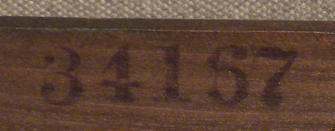
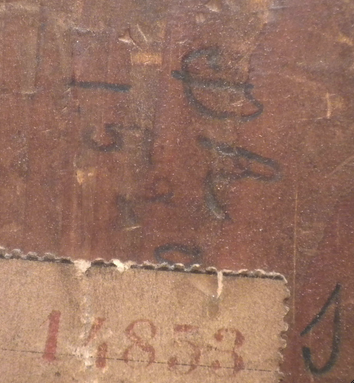
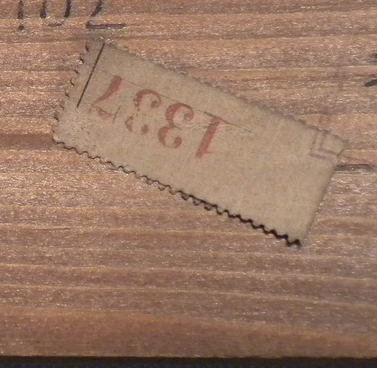
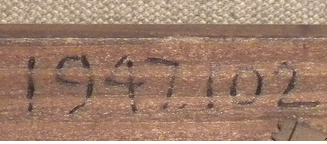
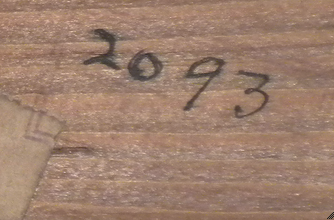
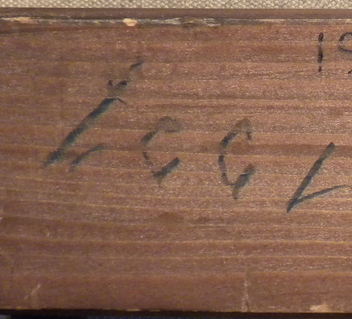
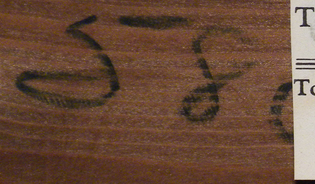
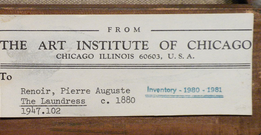
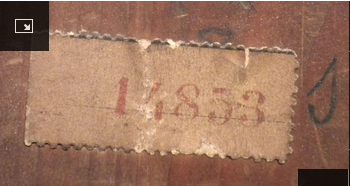
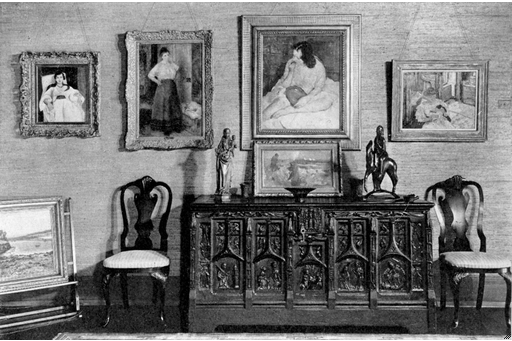
Renoir’s The Laundress (1877/79) in a previous frame, on display in the home of Charles H. and Mary F. S. Worcester. Photograph published in Art Institute of Chicago, “The Magnificent Worcester Gift,” Bulletin of the Art Institute of Chicago, 42, 2, pt. 3 (Feb. 1948), p. 4.
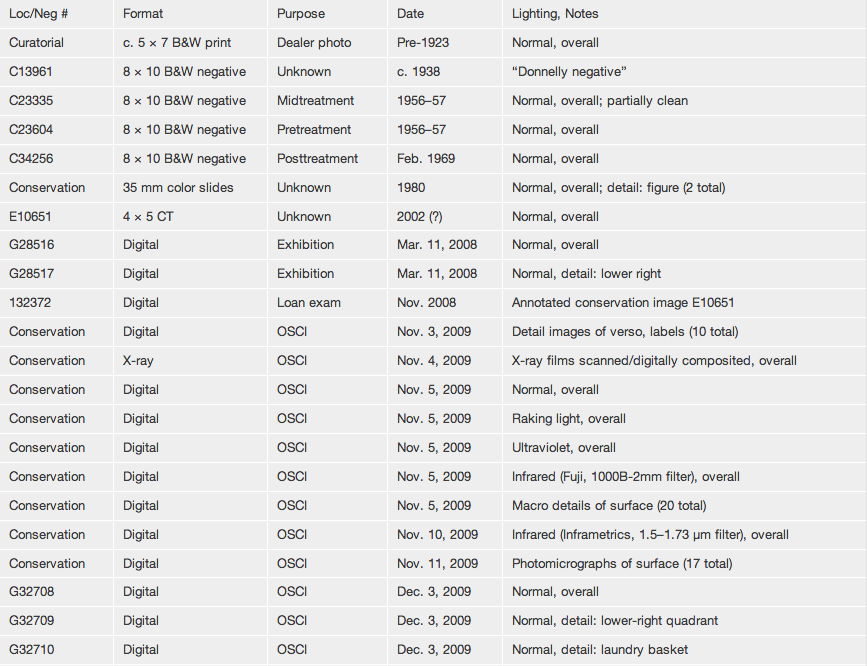
| Loc/Neg # | Format | Purpose | Date | Lighting, Notes |
| Curatorial | c. 5 × 7 B&W print | Dealer photo | Pre-1923 | Normal, overall |
| C13961 | 8 × 10 B&W negative | Unknown | c. 1938 | “Donnelly negative” |
| C23335 | 8 × 10 B&W negative | Midtreatment | 1956–57 | Normal, overall; partially clean |
| C23604 | 8 × 10 B&W negative | Pretreatment | 1956–57 | Normal, overall |
| C34256 | 8 × 10 B&W negative | Posttreatment | Feb. 1969 | Normal, overall |
| Conservation | 35 mm color slides | Unknown | 1980 | Normal, overall; detail: figure (2 total) |
| E10651 | 4 × 5 CT | Unknown | 2002 (?) | Normal, overall |
| G28516 | Digital | Exhibition | Mar. 11, 2008 | Normal, overall |
| G28517 | Digital | Exhibition | Mar. 11, 2008 | Normal, detail: lower right |
| 132372 | Digital | Loan exam | Nov. 2008 | Annotated conservation image E10651 |
| Conservation | Digital | OSCI | Nov. 3, 2009 | Detail images of verso, labels (10 total) |
| Conservation | X-ray | OSCI | Nov. 4, 2009 | X-ray films scanned/digitally composited, overall |
| Conservation | Digital | OSCI | Nov. 5, 2009 | Normal, overall |
| Conservation | Digital | OSCI | Nov. 5, 2009 | Raking light, overall |
| Conservation | Digital | OSCI | Nov. 5, 2009 | Ultraviolet, overall |
| Conservation | Digital | OSCI | Nov. 5, 2009 | Infrared (Fuji, 1000B-2mm filter), overall |
| Conservation | Digital | OSCI | Nov. 5, 2009 | Macro details of surface (20 total) |
| Conservation | Digital | OSCI | Nov. 10, 2009 | Infrared (Inframetrics, 1.5–1.73 µm filter), overall |
| Conservation | Digital | OSCI | Nov. 11, 2009 | Photomicrographs of surface (17 total) |
| G32708 | Digital | OSCI | Dec. 3, 2009 | Normal, overall |
| G32709 | Digital | OSCI | Dec. 3, 2009 | Normal, detail: lower-right quadrant |
| G32710 | Digital | OSCI | Dec. 3, 2009 | Normal, detail: laundry basket |
| G32711 | Digital | OSCI | Dec. 3, 2009 | Normal, detail: right shoulder |
| G32712 | Digital | OSCI | Dec. 3, 2009 | Ultraviolet, overall |
| G32718 | Digital | OSCI | Dec. 3, 2009 | Normal, detail: signature |
| G32719 | Digital | OSCI | Dec. 3, 2009 | Normal, frame only |
| G32918 | Digital | OSCI | Dec. 3, 2009 | Normal, composite, frame with painting |
| Conservation | Digital | OSCI | May 21, 2010 | Normal, verso, overall |
| Conservation | Digital | OSCI | May 21, 2010 | Infrared (Fuji, 1000B/2 mm filter), verso, overall |
| Conservation | Digital | OSCI | Aug. 25, 2011 | Infrared (Fuji, 1000B/2 mm filter), overall |
| Conservation | Digital | OSCI | Aug. 26, 2011 | Macro details of surface/tacking edges (6 total) |
| Conservation | Digital | OSCI | Aug. 26, 2011 | Ultraviolet, detail: figure’s face |
| Conservation | Digital | OSCI | Aug. 26, 2011 | Infrared (Fuji, 1000B/2 mm filter), detail: figure’s face |
| G38546 | Digital | OSCI | Sept. 15, 2011 | Section |
| G38547 | Digital | OSCI | Sept. 15, 2011 | Section |
| G38548 | Digital | OSCI | Sept. 15, 2011 | Section |
| G38549 | Digital | OSCI | Sept. 15, 2011 | Section |
| G38550 | Digital | OSCI | Sept. 15, 2011 | Section |
| G38551 | Digital | OSCI | Sept. 15, 2011 | Section |
| G38552 | Digital | OSCI | Sept. 15, 2011 | Section |
| G38553 | Digital | OSCI | Sept. 15, 2011 | Section |
| G38554 | Digital | OSCI | Sept. 15, 2011 | Section |
| G38555 | Digital | OSCI | Sept. 15, 2011 | Section |
| G38556 | Digital | OSCI | Sept. 15, 2011 | Section |
| G38557 | Digital | OSCI | Sept. 15, 2011 | Section |
| G38558 | Digital | OSCI | Sept. 15, 2011 | Normal, overall; composite of G38546–G38557 |
Young Woman Sewing370
1879
Oil on canvas; 61.4 × 50.5 cm (24 3/16 × 19 7/8 in.)
Signed and dated: Renoir. 79. (upper left, in blue paint)
The Art Institute of Chicago, Mr. and Mrs. Lewis Larned Coburn Memorial Collection, 1933.452
Embroidering and sewing, along with music recitals and reading, feature prominently in Renoir’s repertoire of images depicting the daily life of the French bourgeois woman. The theme is one of a range of domestic genre subjects—also including the governess or servant and child, getting dressed, and playing games—that were carried over into the nineteenth century from past art and given a new sense of contemporaneity and psychological insight by the Realists and the Impressionists. In her biography of the artist, Jeanne Baudot (a student of Renoir’s from 1893 to 1895) reported on a visit to the Musée du Louvre with her mentor: “He particularly liked [Gerard] Terborch and [Pieter] de Hooch, but his favorite was the Lacemaker by Vermeer.”371 This small oil painting (fig. 2.41) entered the collection of the Louvre in 1870. In Vermeer’s novel treatment of natural light, representation of ephemeral moments of everyday life, and sensitivity to male and female spheres of experience, Renoir found a precedent for his own Impressionist enterprise.
The artist’s earliest representation of needlework, Lise Sewing (fig. 2.42 [Daulte 16; Dauberville 396]), portrays his mistress Lise Tréhot, who modeled for him frequently from 1866 until 1872.372 In other paintings, Lise played the role of sultry odalisque or nude bather, but here she is represented simply as herself, dressed in modest but elegant attire that is ambiguous as to class. There are signs of staged domesticity in this portrayal. Though unmarried, she wears a wedding ring, and her jeweled earrings with their distinctive teardrop stones may well have been studio props—they reappeared two years later on Lise in Woman in a Garden (1868; Kunstmuseum Basel [Daulte 83; Dauberville 286]).373 It is worth noting that the figure in Young Woman Sewing also wears teardrop earrings, but the lack of detail makes it difficult to tell whether they are of the same design.
The splendor of the asters and chrysanthemums arranged in a shimmering vase, possibly of glazed ceramic, has led Gloria Groom and Douglas Druick to conclude that Young Woman Sewing was painted late in the summer of 1879 during the final days of Renoir’s first stay at the Château de Wargemont, the Normandy home of his patron Paul Berard.374 It seems unlikely, however, that the artist would have executed such a large and stunningly provocative color work of an anonymous young woman when his commissioned portraits of the Berard family and staff members are conservatively composed and set against conventional dark backgrounds. Rather, the possibility should be entertained that Young Woman Sewing was executed after Renoir’s return to Paris in late September, where he could have acquired the flowers from one of the many Montmartre flower vendors.
The most remarkable aspect of Young Woman Sewing is the way Renoir was able to energize the traditionally subdued indoor subject with a brilliant flourish of natural light and a profusion of color in the bouquet. His Realist and Impressionist predecessors may have influenced this bold juxtaposition. For example, Gustave Courbet linked women and flowers in The Trellis (fig. 2.43), in which floral bounty verges on the fantastic and makes allegorical allusion to youth and love.375 Flowers also abound in Edgar Degas’s A Woman Seated beside a Vase of Flowers (fig. 2.49) to such an extent that the off-center figure appears to be a late addition, though this is probably not the case. Rather, Degas seized the opportunity to be visually innovative with the subject. The seemingly informal arrangement of blossoms in Young Woman Sewing dominates the composition less than the flowers in the works by Courbet and Degas, but the abundance of variety and texture allowed Renoir a certain freedom in handling that amply demonstrates his technical skill.
No attempt has been made to identify Renoir’s beautiful young model with her round face, plump lips, and reddish hair. The artist lost his regular model, Alma-Henriette Leboeuf, called Margot, to smallpox in February 1879 and would have needed another Montmartre resident he could call on for figure paintings. Three additional models posed for Renoir in 1879 and 1880: Ellen Andrée, an aspiring actress; Angèle, a young florist in Montmartre whose last name is not known; and Aline Charigot, Renoir’s future wife. Both Andrée and Charigot had red hair and can be seen in Luncheon of the Boating Party (fig. 2.50 [Daulte 379; Dauberville 224]).376 Angèle, who appears in Sleeping Girl with a Cat (1880; Sterling and Francine Clark Art Institute, Williamstown, Mass. [Daulte 330; Dauberville 487]), had darker hair and somewhat slimmer facial features.377
Though little is known of Aline’s early years in Montmartre or exactly when she met Renoir, it is likely that she had begun modeling for him by the fall of 1879.378 She was then twenty years old and working as a seamstress, and thus part of a milieu with which Renoir was already acquainted.379 According to her son Jean Renoir, at the time Aline lived with her mother on rue Saint-Georges, the street on which Renoir’s studio was located.380 By 1880 Renoir and Aline seem to have been on intimate terms. That summer he paid her board at the Maison Fournaise in Chatou, where she modeled for Luncheon of the Boating Party after Renoir arrived from Normandy in September.381 If Aline was the model for Young Woman Sewing, the difference between the tranquil concentration and demure costume of the figure in that painting and the coquettish, fashionably dressed canotière (rower) playing with her dog in Luncheon of the Boating Party could reflect Aline’s change in status from occasional model under the watchful eye of her mother to “my dear friend,” as Renoir addressed her in correspondence after their relationship began.382 In the fall of 1881, Aline accompanied Renoir to Italy. Most scholars agree that, while the couple was in Capri, she modeled for Blonde Bather (fig. 2.51 [Daulte 387; Dauberville 583]).383 No photographs of Aline from this period of her relationship with Renoir have yet come to light, but there is a compelling resemblance between the figures in Young Woman Sewing and Blonde Bather. Despite the title of the Italian work, there is some red in the woman’s hair, a strawberry-blonde color shared with the figure in Young Woman Sewing. In addition, the two have similar features, including rosy cheeks, wide-set eyes, and prominent noses.
It may never be possible to confidently identify Renoir’s model, but Aline’s occupation as a seamstress would have lent additional significance to the artist’s choosing her as a model for this subject. This painting is usually referred to as Young Woman Sewing, or La couseuse, but an early handwritten label from a previous backing or stretcher reads Femme brodant et fleurs (Woman embroidering and flowers; fig. 2.48) and almost certainly dates to the period when Charles Deudon owned the painting, prior to his death in 1914.384 The brightly colored fabric that the figure holds in her hand suggests that she may be embroidering a pattern on white cloth. The distinction between sewing and embroidery is significant. Repairs to clothing and other fabrics were carried out by domestics or hired out to seamstresses, and undoubtedly Aline undertook such work. Decorative embroidery, however, was reserved for the middle and upper classes and was performed primarily on domestic linens, such as antimacassars and slipcovers, and clothing.
Embroidery acquired even greater status in the late nineteenth century as a form of craft, especially for artists such as Renoir. In 1884, he included embroiderers in his prospectus for a “Société des Irrégularistes,” whose members would also be drawn from the ranks of architects, goldsmiths, and decorators—all professions that shared a belief in the importance of the arts in everyday life.385 As Gloria Groom has suggested, acknowledging that embroidery was recognized as a craft enriches our understanding of Gustave Caillebotte’s painting of his very haute bourgeoise mother stitching a patterned cloth (1877; private collection).386 The portrait was shown at the third Impressionist exhibition in April 1877. In July of that year, Caillebotte, Renoir, and the art dealer Alphonse Legrand were collaborators in a business venture to paint decoration on a fine white plaster cement, used to make faux marbre. Though it dissolved in April 1878, the enterprise was indicative of how strongly both Caillebotte and Renoir felt about Impressionism’s involvement in the decorative arts.
Young Woman Sewing is a vibrant, light-filled canvas in which Renoir exploited the expressive potential of color with a surprising freedom of handling. Cobalt blue dominates the deep shadows of the legged vase and the body of the commode and is present as well in blended glazes in the background and in the young woman’s costume. The blue makes a striking contrast against the red surface on which the vase sits. Touches of blue applied with a fine-tip brush appear throughout the hair, flesh, comb, and eyelashes (fig. 2.52). Shades of both red and blue run through the woman’s clothing, either applied with long strokes of a fine-tip brush or blended over existing underlayers, and merge into violet in the shadows (fig. 2.53), a velvety Impressionist equivalent of traditional chiaroscuro. With a more sparing use of yellows in the flowers, hair, flesh, and subtle highlights around the vase, Renoir managed to convey middle tones and a convincing verisimilitude through the optical mixing of primary colors (fig. 2.54).
The innovative exploration of color in Young Woman Sewing is evident when the painting is viewed in the context of Renoir’s more conservative portrait painting or compared to a work such as Madame Georges Charpentier and Her Children (fig. 2.55 [Daulte 266; Dauberville 239]),387 which was exhibited at the Salon of 1879.388 Renoir clearly considered black an important color and fully understood its aesthetic potential, as indicated by his virtuoso representation of the richly detailed black silk of the luxurious couture dress seen in this painting.389 By contrast, the dominance of primary hues, especially blue, in Young Woman Sewing makes it the figural equivalent of the stormy Seascape (fig. 2.5 [cat. 8]). The artist established comparable textural patterns in both paintings by juxtaposing areas of translucent color washes with areas of minimally worked impasto. Using the same basic palette, however, Renoir evoked very different moods in the two paintings by varying the representation of light.
The light source in Young Woman Sewing is as ambiguous as that in Vermeer’s Lace Maker. In both paintings, it is presumably a window just outside the space of the picture. The vagueness of the source gave Vermeer latitude to bathe his image in light, giving it a mystical quality. The light in Renoir’s painting can be said to be as much the subject of the piece as the figure’s attentive work with the needle. She radiates warmth, and her features shine with reflected light. The inside of her collar and the top of her head are rendered in pure white, contributing to the intense luminosity of the picture. Even shaded areas away from the light source seem to glow, particularly the figure’s hair (see Palette in the technical report), with its reddish-orange tones (fig. 2.8). Renoir was able to achieve such dazzling effects by using very thin glazes over a thick white ground.
Critics who knew the Impressionists and supported their agenda in the press recognized the fundamental role of color in the group’s work. On the occasion of the second Impressionist exhibition in 1876, Edmond Duranty wrote a pamphlet titled The New Painting, which provided a justification for the kinds of issues Renoir sought to address in Young Woman Sewing: “Proceeding from intuition to intuition, they have little by little succeeded in breaking down sunlight into its rays, its elements, and [in] reconstituting its unity by means of the general harmony of spectrum colors—which they spread on their canvases.”390 Young Woman Sewing holds an important place in Renoir’s oeuvre not only by virtue of its subject matter, drawn from the Old Masters, but also because it reveals Renoir forging his independence as a modern colorist even as he sought greater commercial success at the Salon.
John Collins
Renoir executed this painting on a fine-weave, standard-size [glossary:canvas] with a thick, white, commercially applied ground that fills the [glossary:weave], appears systematically textured with diagonal strokes, and extends to the edges of the [glossary:tacking margins]. The [glossary:X-ray] shows a large vertical form left of center that does not correspond to any visible element in the painting; it seems to be an artifact of an imperfectly applied [glossary:ground] layer.391
In most of the composition, Renoir layered thin veils of paint in glaze- and semiglaze-like layers in order to make use of the reflective qualities of the ground. To achieve this translucency, he alternately thinned and added fluid medium to his paint and used translucent [glossary:pigments] like red lake and cobalt blue. Some parts of the background and figure are so thin that they do not register in the X-ray, in contrast with the thicker, heavily textured application of paint in the flowers on the upper right. The artist appears to have made few compositional changes to the work, perhaps only lowering the profile of the woman’s right shoulder. The slightly shaded look of the area immediately to the right of the figure may also indicate changes to either the figure or the background that Renoir subsequently wiped away with a cloth, leaving a thin residue behind. In the foreground, the artist employed wiping as a painting technique; the remnants of paint left in the depressions of the textured ground create shadow and give the gathered fabric in the woman’s hand a soft edge. Toward the end of the process, Renoir firmly established the light source on the upper right with heavy white highlights on the vase and flowers, and in the comb in the figure’s hair.
The work has a [glossary:synthetic varnish] that imparts some saturation and gloss. The current [glossary:varnish] replaced an oil-resin varnish, but it is unknown whether that was original to the painting.
The multilayer interactive image viewer is designed to facilitate the viewer’s exploration and comparison of the technical images (fig. 2.40).392
Signed and dated: Renoir. 79. (upper left, in blue paint).393
The signature was painted [glossary:wet-in-wet] with the upper layers of the background and picks up some of the surrounding red lake through the center. The n appears to have been reinforced by the artist during the process (fig. 1.2, fig. 1.1).
Flax (commonly known as linen).394
The original dimensions of the canvas were 61.1 × 50.2 cm, according to 1969 pretreatment measurements.395 An early exhibition label preserved from the original [glossary:stretcher] lists the painting as 61 × 50 cm (fig. 2.20), and a possibly related published exhibition record from 1922 lists the same measurements.396 This probably corresponds to a no. 12 portrait ([glossary:figure]) standard-size (60 × 50 cm) canvas.397
[glossary:Plain weave]. Average [glossary:thread count] (standard deviation): 29.8V (0.5) × 24.9H (1.2) threads/cm. The vertical threads were determined to correspond to the [glossary:warp] and the horizontal threads to the [glossary:weft].398
There is very mild [glossary:cusping] corresponding to the placement of the original tacks. The canvas is also marked by numerous nubs and imperfections.
Current stretching: When the painting was lined in 1969, the original dimensions were slightly increased on all sides (see Conservation History).
Original stretching: Based on cusping visible in the X-ray, the original tacks were placed approximately 4.5–6.5 cm apart.
Current stretcher: Four-member ICA spring stretcher. Depth: 2.5 cm.
Original stretcher: Five-member keyable stretcher with horizontal [glossary:crossbar]. Depth: Approximately 1.5 cm.399
Stamp
Location: verso of original canvas (covered by lining)
Method: stamp
Content: C[OU]LEURS FINES TOILES PEINDRE / TABLEAUX / REY & PERROD / [5]1 Rue de la Rochefou[cauld] / PARIS (fig. 2.33)400
Not determined (probably glue).401
The canvas was prepared with a white ground that extends to the edges of the tacking margins and fills the fine canvas weave. The thickness of the [glossary:priming], averaging approximately 50–100 µm, suggests that there may have been multiple applications. [glossary:Cross-sectional analysis] indicates that the preparation is probably a double layer, with both layers of very similar composition and the second applied shortly after the first. The X-ray shows an apparent buildup of paint or ground material in a vertical section just left of center that does not correspond to any visible element in the painting. The haphazard, sometimes sharp-edged marks seen in the X-ray may indicate application of a (perhaps localized) preparatory layer with a [glossary:palette knife] (fig. 2.38). Toward the edges of this area, especially near the top, brushstrokes are visible, suggesting that this layer may initially have been applied with a palette knife, then worked into the surface with a brush. This layer also looks different from the surrounding areas: it is more heavily and unevenly textured and contains a number of large lead-containing protrusions (fig. 1.3).402 Elsewhere on the surface, however, a shallow, fine, diagonal texture can be seen, which may mean that the upper layer was applied or finished with a brush (fig. 1.4). This texture appears to go to the edges of the tacking margins, passing over the foldover on all sides. As the weave is very fine, such a thick ground application, had it been applied with a palette knife alone, would have resulted in an extremely smooth, almost glassy surface. Adding a systematic texture to the upper layer allowed the surface to hold more paint, something especially important in this work because the paint layers are so thin.
Reasons for the localized application of additional priming left of center are unclear. There are small scratches in the ground layers (visible in the X-ray as diagonal marks on the lower and center left) that seem to have occurred before the work was painted and possibly before the additional ground layer was applied.403 It is possible that the extra material was added to cover these marks. The increased texture in this area makes the colors appear darker, because of increased saturation as the thin, translucent paint layers sank into the depressions, pooling more thickly and thus appearing more intense. These darker areas where the paint has pooled more thickly do not correspond to, cover, or accentuate compositional forms; therefore, it is unlikely that this was an intentional effect desired or requested by the artist. However, Renoir would have been aware of the effect immediately, and while he may not have intended it, there is no evidence that he made any attempt to diminish it.
The ground is exposed throughout the painting, especially on the upper right. In many areas, the paint layers are very thin, allowing the lightness and texture of the ground to show through (fig. 2.22).
Careful stereomicroscopic examination of the surface indicates a bright white ground with very few dark or colored particles visible (fig. 2.23).
The commercial ground appears to be a double application of priming material containing predominantly lead white with barium sulfate and variable trace amounts of silica; calcium-based white; silicate minerals with associated iron oxides, including umber; alumina; and small particles of ultramarine blue. The area of apparent additional preparation, just left of center, was found to have the same composition.404 The [glossary:binder] is estimated to be [glossary:oil]; the upper layer of the ground application looks less dense in the backscattered electron ([glossary:BSE]) image, which may indicate that this layer contains slightly more medium (fig. 2.24).405
No [glossary:underdrawing] was observed with [glossary:infrared reflectography] or under microscopic examination.
The primary technique Renoir employed in making this painting was to layer very thin, translucent veils of paint in order to make use of the reflective qualities of the white ground. On the upper right, he left the ground mostly exposed to hint at the light source. On the left, the paint layers that make up the woman and her costume are so thin that they are not readily visible in the X-ray (fig. 2.38). The X-ray does show a few of the highly textured flower petals and white highlights, in addition to an apparent buildup of ground material as a vertical form left of center. To create the flesh tones, the artist mixed red lake and cobalt blue, sometimes with a small amount of yellow or vermilion, but generally without white, layering the colors so thinly that the highlights and glow of the flesh are largely a result of light reflecting off of the priming (fig. 2.25).406
Renoir both thinned and added fluid medium to his paints to achieve translucent washes and glazes. The thinness of the underlying washes is apparent throughout the background and contrasts with the more glaze-like handling of the figure’s dress and flesh tones (fig. 2.57). In some areas, the artist used a cloth to wipe paint away, leaving only a small amount in the depressions of the canvas weave. This technique can be seen in the cloth the woman holds in the foreground, where the shadow across the top curve is indicated by the residue of blue paint that has been largely wiped away (fig. 2.26). Renoir may also have employed this technique in the underlayers throughout the figure, especially in her hair and costume. The only obvious indication of a change to the figure is along the top of the woman’s right shoulder, which appears to have been slightly lowered before it was fully defined. Because the paint layers are so thin, evidence of this change is still visible on the left (fig. 2.27). The somewhat darkened appearance of the paint immediately to the right of the figure suggests that the artist made additional changes and wiped away some paint; however, the nature and subject of these changes are unclear.
In contrast to his handling of the rest of the picture, Renoir built up the flowers on the upper right with thicker paint and small dabs of heavy [glossary:impasto] (fig. 2.28). As a final touch, the artist added highlights in pure white on the vase (fig. 2.29) and on the comb holding the figure’s hair (fig. 2.30) to clarify the light source on the upper right.
Very fine, round brushes, some with wider strokes up to 1 cm wide; cloth for wiping.
Analysis indicates the presence of the following [glossary:pigments]:407 lead white, cobalt blue, iron oxide red, vermilion, madder lake, bone black, zinc yellow, chrome yellow, strontium yellow, and possibly barium yellow.408
Stereomicroscopic examination and cross-sectional analysis indicate that the dull yellow, almost ocher-colored paint used in some of the flowers and in the gathered fabric in the foreground is not the common earth pigment, but a complex mixture including zinc yellow, black, and madder lake (fig. 2.31).409
The observation of a characteristic orange [glossary:fluorescence] under UV light indicates that the artist used large amounts of fluorescing red lake, identified as madder lake, mixed with other colors to create the flesh tones, hair, and costume (fig. 2.32). In the UV image, the tabletop on the right appears to be painted almost entirely with this lake color (fig. 2.34).410
Oil (estimated).411
The current synthetic varnish was applied during the 1969 treatment and replaced an oil-resin varnish. There are residues of this earlier varnish around areas of impasto (especially the signature). It is unknown whether this varnish was original to the painting; however, abrasion noted in the pretreatment report suggests that the painting had been cleaned previously (see Conservation History).
The painting’s only documented treatment was a 1969 [glossary:lining].412 Grime and a discolored oil-resin varnish were removed, and the work was taken off of its original stretcher. The painting was faced with mulberry-fiber paper and starch paste and wax-resin lined to a secondary piece of linen. The lined painting was restretched on an ICA spring stretcher of slightly larger dimensions, leaving a margin of exposed ground around the perimeter. The work was inpainted and given three coats of synthetic varnish (an isolating layer of polyvinyl acetate [PVA] AYAA, followed by [glossary:inpainting], a layer of methacrylate resin L-46, and a final coat of AYAA).
The work is in good condition, planar with a stable [glossary:wax-resin lining]. Heavy [glossary:craquelure] can be seen throughout the work, especially in [glossary:raking light], and includes stretcher-bar marks corresponding to the original stretcher. There is a small loss along the line of buttons just under the figure’s left hand and a loss of impasto in the flowers to the right of her hair. Long diagonal creases, which extend from the left edge behind the figure’s head down toward her hands, seem to have occurred during the preparation of the canvas, and original paint settled into the depressions associated with them. The inpainting is discolored and visible in many areas of the face, hair, and hands, and around the edges. In most cases, the [glossary:retouching] addresses areas of abrasion and traction cracking. The work has a synthetic varnish imparting even saturation and gloss; there are two large, matte surface drips in the lower left quadrant.
Kelly Keegan
The current frame appears to be original to the painting.413 It is a French, late-nineteenth–early-twentieth-century, Louis XIV reproduction, gilt ogee frame with cast plaster anthemia corner cartouches and fleur-de-lis center cartouches, linked by fleurs-de-lis surrounded by scrolls and strapwork. The frame has oil and water gilding over red bole on cast plaster and gesso. The ornament and sight molding are selectively burnished. The gilding is heavily rubbed and toned with a casein or gouache raw umber wash with a gray overwash and dark flecking. The pine molding is mitered and nailed. At some point in the frame’s history, the original verso was planed flat, removing all construction history and provenance, a back frame was added, and all back and interior surfaces were painted. The molding, from the perimeter to the interior, is torus with dentil outer molding; scotia side; ogee face with anthemia corner cartouches and fleur-de-lis center cartouches on diamond-punched beds, linked by fleurs-de-lis surrounded by foliate scrolls and strapwork on a quadrillage bed; sanded front frieze bordered with fillets; and ogee sight molding with leaf-tip ornament linked by scrolls and strapping on a recut bed (fig. 2.10, fig. 2.17).
Kirk Vuillemot
Acquired from [unknown] by Charles Deudon (died 1914), Paris and Nice.414
Acquired by Paul Rosenberg and Co., Paris and New York, by Feb. 1921.415
Acquired by Howard Young, New York.416
Acquired by Mrs. Lewis Larned (Annie Swan) Coburn, Chicago, by June 1931.417
Bequeathed by Mrs. Lewis Larned (Annie Swan) Coburn (died 1932) to the Art Institute of Chicago, 1933.
Paris, Paul Rosenberg, Exposition d’oeuvres de grands maîtres du dix-neuvième siècle, May 3–June 3, 1922, cat. 74.
Art Institute of Chicago, Exhibition of the Mrs. L. L. Coburn Collection: Modern Paintings and Watercolors, Apr. 6–Oct. 9, 1932, cat. 32.
Art Institute of Chicago, “A Century of Progress”: Loan Exhibition of Paintings and Sculpture, May 23–Nov. 1, 1933, cat. 344.418 (fig. 2.11)
Art Institute of Chicago, “A Century of Progress”: Loan Exhibition of Paintings and Sculpture for 1934, June 1–Oct. 31, 1934, cat. 235.419
New York, Metropolitan Museum of Art, Renoir: A Special Exhibition of His Paintings, May 18–Sept. 12, 1937, cat. 25 (ill.).
Columbus (Ohio) Gallery of Fine Arts, Six Paintings by Renoir, Oct. 6–Nov. 6, 1938, cat. 1 (ill.).420
New York, Paul Rosenberg, Great French Masters of the Nineteenth Century: Corot to van Gogh, May 4–29, 1942, cat. 8 (ill.).
Art Gallery of Toronto, Fifty Paintings by Old Masters, Apr. 21–May 21, 1950, cat. 37.
New York, Wildenstein, Renoir: A Loan Exhibition for the Benefit of the American Association of Museums in Commemoration of the Fiftieth Anniversary of Renoir’s Death, Mar. 27–May 3, 1969, cat. 28 (ill.).
Art Institute of Chicago, Paintings by Renoir, Feb. 3–Apr. 1, 1973, cat. 25 (ill.).
Tokyo, National Museum of Western Art, Masterpieces of World Art from American Museums: From Ancient Egyptian to Contemporary Art, Sept. 11–Oct. 17, 1976, cat. 45 (ill.); Kyoto National Museum, Nov. 2–Dec. 5, 1976.
Ann Arbor, University of Michigan Museum of Art, The Crisis of Impressionism, 1878–1882, Nov. 2, 1979–Jan. 6, 1980, cat. 47 (ill.).
Albi, Musée Toulouse-Lautrec, Trésors impressionnistes du Musée de Chicago, June 27–Aug. 31, 1980, cat. 20 (ill.).
Hartford, Conn., Wadsworth Atheneum Museum of Art, June 27, 1997–May 6, 1998, no cat.421
Tokyo, Seiji Togo Memorial Yasuda Kasai Museum of Art, Aug. 24, 2001–June 12, 2002, no cat.422
Fort Worth, Tex., Kimbell Art Museum, The Impressionists: Master Paintings from the Art Institute of Chicago, June 29–Nov. 2, 2008, cat. 29 (ill.).
Tokyo, National Art Center, Renoir: Tradition and Innovation, Jan. 20–Apr. 5, 2010, cat. 54 (ill.); Osaka, National Museum of Art, Apr. 17–June 27, 2010.
“La curiosité: La collection Deudon,” Le bulletin de la vie artistique 1, 11 (May 1, 1920), p. 306 (ill.).
Jacques-Émile Blanche, “La technique de Renoir,” L’amour de l’art 2, 2 (Feb. 1921), opp. p. 33 (ill.).
Paul Rosenberg, Paris, Exposition d’oeuvres de grands maîtres du dix-neuvième siècle, exh. cat. (Frazier-Soye, 1922), p. 23, cat. 74.
Julius Meier-Graefe, Renoir (Klinkhardt & Biermann, 1929), pp. 99, n. 1; 122, no. 108 (ill.).
“French Masterpieces That One Day Will Belong to Art Institute,” Chicago Daily News, June 1931, p. 14 (ill.).
Reginald Howard Wilenski, French Painting (Hale, Cushman & Flint, 1931), p. 262.
Art Institute of Chicago, Exhibition of the Mrs. L. L. Coburn Collection: Modern Paintings and Watercolors, exh. cat. (Art Institute of Chicago, 1932), pp. 6; 22–23, no. 32.
Daniel Catton Rich, “The Bequest of Mrs. L. L. Coburn,” Bulletin of the Art Institute of Chicago 26, 6 (Nov. 1932), p. 68.
Art Institute of Chicago, Catalogue of “A Century of Progress”: Exhibition of Paintings and Sculpture; Lent from American Collections, ed. Daniel Catton Rich, 3rd ed., exh. cat. (Art Institute of Chicago, 1933), p. 49, cat. 344.
Art Institute of Chicago, “The Rearrangement of the Paintings Galleries,” Bulletin of the Art Institute of Chicago 27, 7 (Dec. 1933), p. 115.
Art Institute of Chicago, Catalogue of “A Century of Progress”: Exhibition of Paintings and Sculpture, 1934, ed. Daniel Catton Rich, exh. cat. (Art Institute of Chicago, 1934), pp. 39–40, cat. 235.
Art Institute of Chicago, A Brief Illustrated Guide to the Collections (Art Institute of Chicago, 1935), p. 28.423
Hans Tietz, ed., Meisterwerke europäischer Malerei in Amerika (Phaidon, 1935), pp. 295 (ill.), p. 345.
Metropolitan Museum of Art, Renoir: A Special Exhibition of His Paintings, exh. cat. (Metropolitan Museum of Art/Bradford, 1937), no. 25 (ill.).
Harry B. Wehle, “The Painting of Renoir,” in Metropolitan Museum of Art, Renoir: A Special Exhibition of His Paintings, exh. cat. (Metropolitan Museum of Art/Bradford, 1937), p. 7.
Josephine L. Allen, “Paintings by Renoir,” Bulletin of the Metropolitan Museum of Art 32, 5 (May 1937), p. 112.
Columbus (Ohio) Gallery of Fine Arts, “Six Paintings by Renoir,” Monthly Bulletin 9, 1 (Oct. 1938), front cover (ill.); no. 1.
Lionello Venturi, Les archives de l’impressionnisme: Lettres de Renoir, Monet, Pissarro, Sisley, et autres; Mémoires de Paul Durand-Ruel; Documents, vol. 1 (Durand-Ruel, 1939), p. 152.424
Reginald Howard Wilenski, Modern French Painters (Reynal & Hitchcok, [1940]), pp. 62, 337.425
Harry B. Wehle, “The Painting of Renoir,” in Duveen Galleries, New York, Renoir: Centennial Loan Exhibition, 1841–1941; For the Benefit of the Free French Relief Committee, exh. cat. (Vilmorin/Bradford, 1941), p. 18.
Paul Rosenberg, New York, Great French Masters of the Nineteenth Century: Corot to Van Gogh, exh. cat. (Rosenberg, 1942), pp. 24–25, no. 8 (ill.).
Art Institute of Chicago, An Illustrated Guide to the Collections of the Art Institute of Chicago (Art Institute of Chicago, 1945), p. 36.426
Isabel Bishop, “Concerning Edges,” Magazine of Art 38, 5 (May 1945), p. 172 (ill.).
Art Institute of Chicago, “Bulletin Board,” Bulletin of the Art Institute of Chicago 40, 1 (Jan. 1946), p. 6.
Art Institute of Chicago, “Bulletin Board,” Bulletin of the Art Institute of Chicago 40, 4, pt. 2 (Apr.–May 1946), p. 52.
“What the Piece Goods Buyer Can Learn from the Apparel Business,” American Fabrics 4 (Fall 1947), p. 88 (ill.).
Art Gallery of Toronto, Fifty Paintings by Old Masters, exh. cat. (Art Gallery of Toronto, 1950), cat. 37.
Dorothy Bridaham, Renoir in the Art Institute of Chicago (Conzett & Huber, 1954), pl. 2.
Art Institute of Chicago, Paintings in the Art Institute of Chicago: A Catalogue of the Picture Collection (Art Institute of Chicago, 1961), p. 395.427
Frederick A. Sweet, “Great Chicago Collectors,” Apollo 84, 55 (Sept. 1966), p. 203.
François Daulte, Renoir: A Loan Exhibition for the Benefit of the American Association of Museums in Commemoration of the Fiftieth Anniversary of Renoir’s Death, exh. cat. (Wildenstein, 1969), cat. 28 (ill.).
François Daulte, Auguste Renoir: Catalogue raisonné de l’oeuvre peint, vol. 1, Figures, 1860–1890 (Durand-Ruel, 1971), pp. 230–31, cat. 299 (ill.).
Elda Fezzi, L’opera completa di Renoir: Nel periodo impressionista, 1869–1883, Classici dell’arte 59 (Rizzoli, 1972), pp. 103, cat. 339; 104, cat. 339 (ill.).428
Art Institute of Chicago, Paintings by Renoir, exh. cat. (Art Institute of Chicago, 1973), pp. 78–79, cat. 25 (ill.).
National Museum of Western Art, Tokyo, and Kyoto National Museum, Masterpieces of World Art from American Museums: From Ancient Egyptian to Contemporary Art, exh. cat. (National Museum of Western Art, Tokyo, 1976), no. 45 (ill.).
Patricia Erens, Masterpieces: Famous Chicagoans and Their Paintings (Chicago Review, 1979), n. pag. (ill.).
J. Patrice Marandel, The Art Institute of Chicago: Favorite Impressionist Paintings (Cross River, 1979), pp. 72–73 (ill.).
Joel Isaacson, The Crisis of Impressionism, 1878–1882, exh. cat. (University of Michigan Museum of Art, 1980), pp. 30; 178–79, cat. 47 (ill.).
Diane Kelder, The Great Book of French Impressionism (Abbeville, 1980), pp. 266 (ill.), 438.429
Diane Kelder, The Great Book of French Impressionism, Tiny Folios (Abbeville, 1980), p. 148, pl. 8.
Musée Toulouse-Lautrec and Art Institute of Chicago, Trésors impressionnistes du Musée de Chicago, exh. cat. (Musée Toulouse-Lautrec, 1980), pp. 39, no. 20 (ill.); 68.
Nicholas Wadley, ed., Renoir: A Retrospective (Hugh Lauter Levin/Macmillan, 1987), p. 66, pl. 18.
Anne Distel, “Charles Deudon (1832–1914) collectionneur,” Revue de l’art 86 (1989), p. 64, no. 10 (ill.).
Sophie Monneret, Renoir, Profils de l’art (Chêne, 1989), p. 152, cat. 23 (ill.).
Art Institute of Chicago, Treasures of 19th- and 20th-Century Painting: The Art Institute of Chicago, with an introduction by James N. Wood (Art Institute of Chicago/Abbeville, 1993), p. 77 (ill.).
Douglas W. Druick, Renoir, Artists in Focus (Art Institute of Chicago/Abrams, 1997), pp. 45–46; 88, pl. 7; 110.
Gilles Néret, Renoir: Painter of Happiness, 1841–1919, trans. Josephine Bacon (Taschen, 2001), pp. 124–25 (ill.).
John Collins, “Christine Lerolle Embroidering: Between Genre Painting and Portraiture,” in Ann Dumas and John Collins, Renoir’s Women, exh. cat. (Columbus Museum of Art/Merrell, 2005), pp. 102, 106.
Guy-Patrice Dauberville and Michel Dauberville, with the collaboration of Camille Frémontier-Murphy, Renoir: Catalogue raisonné des tableaux, pastels, dessins et aquarelles, vol. 1, 1858–1881 (Bernheim-Jeune, 2007), pp. 416–17, cat. 393 (ill.).
Gloria Groom and Douglas Druick, with the assistance of Dorota Chudzicka and Jill Shaw, The Impressionists: Master Paintings from the Art Institute of Chicago, exh. cat. (Art Institute of Chicago/Kimbell Art Museum, 2008), pp. 15 (ill.); 76, cat. 29 (ill.). Simultaneously published as Gloria Groom and Douglas Druick, with the assistance of Dorota Chudzicka and Jill Shaw, The Age of Impressionism at the Art Institute of Chicago (Art Institute of Chicago/Yale University Press, 2008), pp. 15 (ill.); 76, cat. 29 (ill.).430
Anne Distel, Renoir (Citadelles & Mazenod, 2009), pp. 154–55, ill. 138.
Toru Arayashiki et al., Renoir: Tradition and Innovation, trans. Stanley N. Anderson, Martha J. McClintock, and Cheryl A. Silverman, exh. cat. (National Museum of Art, Osaka/National Art Center, Tokyo/Yomiuri Shimbun, 2010), pp. 25 (ill.); 146–47, cat. 54 (ill.); 148–49 (detail); 249, cat. 54 (ill.).
Stamp
Location: verso of original canvas (covered by lining)431
Method: stamp
Content: C[OU]LEURS FINES TOILES PEINDRE / TABLEAUX / REY & PERROD / [5]1 Rue de la Rochefou[cauld] / PARIS (fig. 2.33)432
Label
Location: previous stretcher or backing (discarded); preserved in conservation file
Method: handwritten script on white label
Content: Renoir / Femme brodant / et fleurs / h. 0,61 × l. 0,50 / [center right, blue script] 25 (fig. 2.9)
Label
Location: previous stretcher or backing (discarded); preserved in conservation file
Method: stamp on round label
Content: DOUANE / PARIS / CENTRALE (fig. 2.35)
Label
Location: previous stretcher or backing (discarded); preserved in conservation file
Method: printed and typed label
Content: S. L. No. 2732.2. / THE METROPOLITAN MUSEUM / OF ART / SPECIAL LOAN EXHIBITION / OF / PAINTINGS BY PIERRE AUGUSTE RENOIR / Title Lady Sewing / Artist Renoir / Owner Chicago Art Institute / Address Chicago, Ill. / Return Address Same (fig. 2.36)
Number
Location: stretcher
Method: handwritten script (black marker)
Content: 33.452 (fig. 2.37)
Label
Location: previous backing (discarded); transcription preserved in curatorial file
Method: printed label
Content: Le Musee National d’art Occidental / Tokyo, Japan / cat. no. 45433
Stamp
Location: stretcher
Method: blue stamp
Content: Inventory—1980–1981 (fig. 2.19)
Label
Location: backing board
Method: typed label
Content: THE ART INSTITUTE OF CHICAGO / artist Pierre Auguste Renoir / title Lady Sewing / medium oil on canvas / credit Mr.&Mrs. Lewis Lanard [sic] Coburn Collection / acc. # 1933.452 / LZ-341-001 1M 1/90 (Rev. 1/90) (fig. 3.60)
Label
Location: backing board
Method: typed label
Content: WADSWORTH ATHENEUM / HARTFORD, CONN. / No. T.L.16.1997.1 / Artist Pierre Auguste Renoir / Title Young Woman Sewing, 1879 / (La Couseuse) / Owner Art Institute of Chicago / Return to " (fig. 2.58)
Westinghouse X-ray unit, scanned on Epson Expressions 10000XL flatbed scanner. Scans were digitally composited by Robert G. Erdmann, University of Arizona.
Inframetrics Infracam with 1.5–1.73 µm filter; Fujifilm S5 Pro with X-Nite 1000B/2 mm filter (1.0–1.1 µm); Goodrich/Sensors Unlimited SU640SDV-1.7RT with H filter (1.1–1.4 µm) and J filter (1.5–1.7 µm).
Fujifilm S5 Pro with X-Nite 1000B/2 mm filter (1.0–1.1 µm).
Natural-light, raking-light, and transmitted-light overalls and macrophotography: Fujifilm S5 Pro with X-NiteCC1 filter.
Fujifilm S5 Pro with X-NiteCC1 filter and Kodak Wratten 2E filter.
Sinar P3 camera with Sinarback eVolution 75 H (X-NiteCC1 filter and Kodak Wratten 2E filter).
Sample and cross-sectional analysis were performed using a Zeiss Axioplan2 research microscope equipped with reflected light/UV fluorescence and a Zeiss AxioCam MRc5 digital camera. Types of illumination used: darkfield, differential interference contrast (DIC), and UV. In situ photomicrographs were taken with a Wild Heerbrugg M7A StereoZoom microscope fitted with an Olympus DP71 microscope digital camera.
Several spots on the painting were analyzed in situ with a Bruker/Keymaster TRACeR III-V with rhodium tube.
Zeiss Universal research microscope.
Cross sections were analyzed after carbon coating with a Hitachi S-3400N-II VPSEM with an Oxford EDS and a Hitachi solid-state BSE detector. Analysis was performed at the Northwestern University Atomic and Nanoscale Characterization Experimental (NUANCE) Center, Electron Probe Instrumentation Center (EPIC) facility.
A Jobin Yvon Horiba LabRAM 300 confocal Raman microscope was used, equipped with an Andor multichannel, Peltier-cooled, open-electrode charge-coupled device detector (Andor DV420-OE322; 1024×256), an Olympus BXFM open microscope frame, a holographic notch filter, and an 1,800-grooves/mm dispersive grating.
The excitation line of an air-cooled, frequency-doubled, He-Ne laser (632.8 nm) was focused through a 20× objective onto the samples, and Raman scattering was back collected through the same microscope objective. Power at the samples was kept very low (never exceeding a few mW) by a series of neutral density filters in order to avoid any thermal damage.434
Thread count and weave information were determined by Thread Count Automation Project software.435
Overlay images were registered using a novel image-based algorithm developed by Damon M. Conover (GW), Dr. John K. Delaney (GW, NGA), and Murray H. Loew (GW) of the George Washington University’s School of Engineering and Applied Science and the National Gallery of Art, Washington, D.C.436
The image inventory compiles records of all known images of the artwork on file in the Conservation Department, the Imaging Department, and the Department of Medieval to Modern European Painting and Sculpture at the Art Institute of Chicago (fig. 2.18).
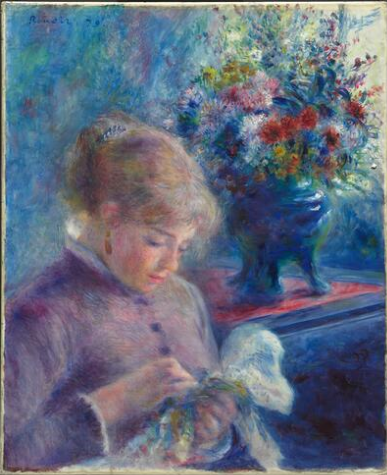
cat. 7 Young Woman Sewing, 1879.

Detail of the signature in Renoir’s Young Woman Sewing (1879). The Art Institute of Chicago, 1933.452.
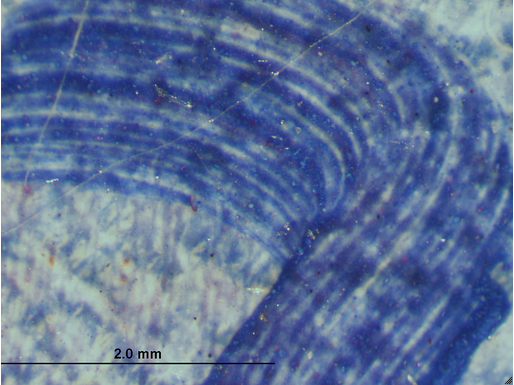
Photomicrograph of the signature in Renoir’s Young Woman Sewing (1879). The Art Institute of Chicago, 1933.452.
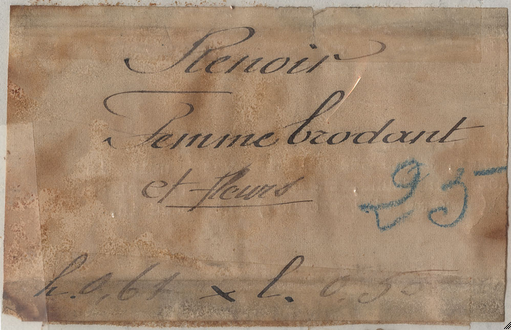
Image of an archival label from a previous stretcher or backing on Renoir’s Young Woman Sewing (1879), possibly from the Exposition d’oeuvres de Grands Maitres du dix-neuvième siècle, May 3–June 3, 1922. The Art Institute of Chicago, 1933.452.
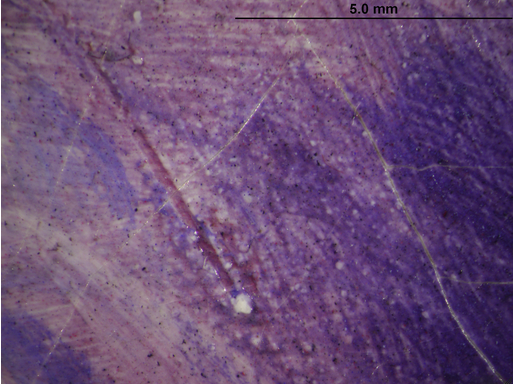
Photomicrograph of the figure’s costume in Renoir’s Young Woman Sewing (1879). White lumps of ground were dragged through the preparation, causing scratches. The Art Institute of Chicago, 1933.452.
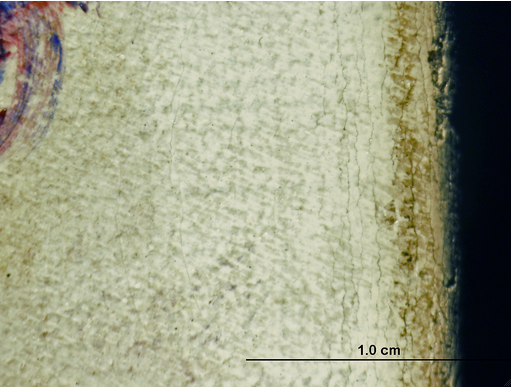
Photomicrograph of the ground in Renoir’s Young Woman Sewing (1879). The Art Institute of Chicago, 1933.452.
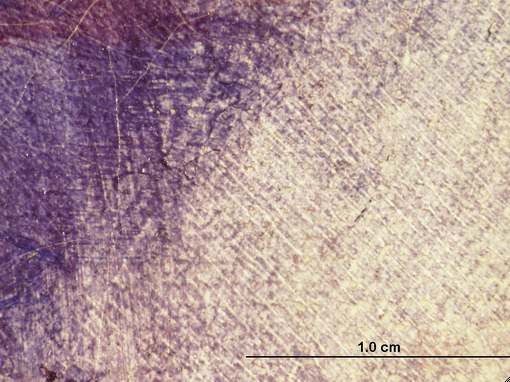
Photomicrograph of the white cloth held by the figure in Renoir’s Young Woman Sewing (1879). The thin paint has been wiped away and remains only in the depressions of the ground. The Art Institute of Chicago, 1933.452.

Photomicrograph of a cross section from the canvas and ground of Renoir’s Young Woman Sewing (1879). Original magnification: 50×. The Art Institute of Chicago, 1933.452.
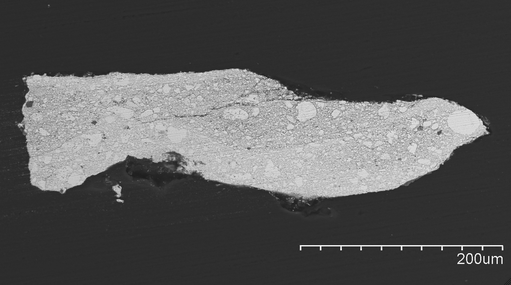
Backscattered electron image of a cross section of the ground in Renoir’s Young Woman Sewing (1879). A faint line differentiating what may be two applications of ground material can be discerned. Original magnification: 250×. The Art Institute of Chicago, 1933.452.
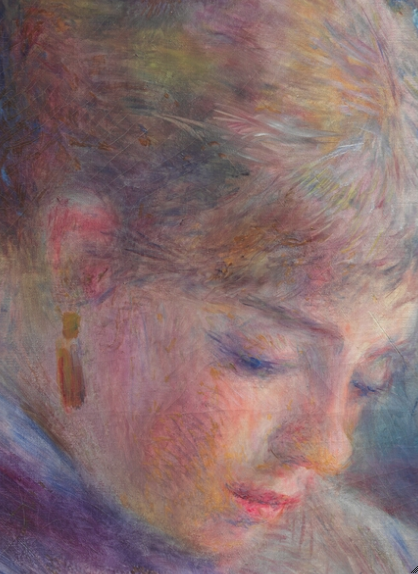
Detail of the figure’s face in Renoir’s Young Woman Sewing (1879) showing the artist’s use of thin, translucent paint layers. The Art Institute of Chicago, 1933.452.
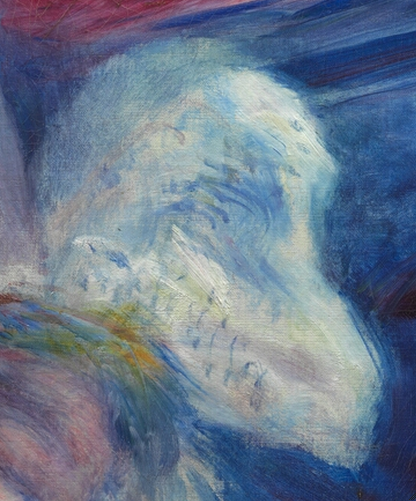
Detail of the white cloth held by the figure in Renoir’s Young Woman Sewing (1879). The artist used wiping to leave paint only in the depressions of the ground to create a shadow. The Art Institute of Chicago, 1933.452.
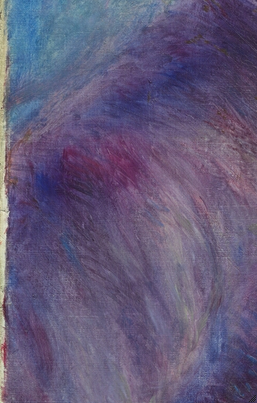
Detail of the figure’s right shoulder in Renoir’s Young Woman Sewing (1879). The line of the previous position of the shoulder is visible just above the final placement. The Art Institute of Chicago, 1933.452.
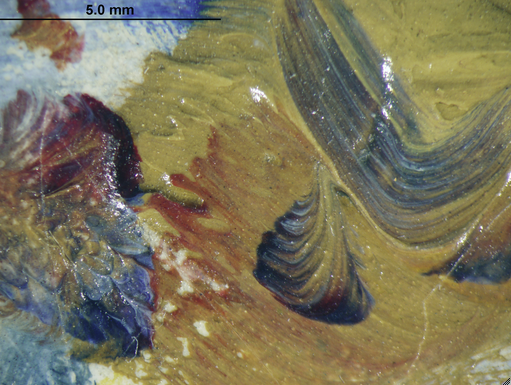
Photomicrograph of an impasted, yellow flower in Renoir’s Young Woman Sewing (1879). The Art Institute of Chicago, 1933.452.
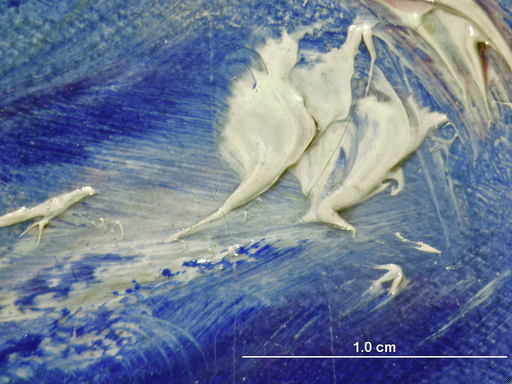
Photomicrograph of the highlight on the vase in Renoir’s Young Woman Sewing (1879). The Art Institute of Chicago, 1933.452.
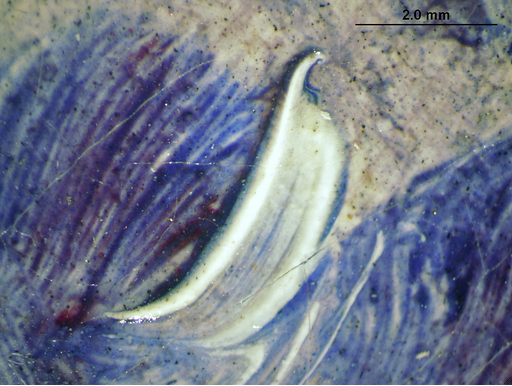
Photomicrograph of the woman’s hair comb in Renoir’s Young Woman Sewing (1879). Thick white highlights were added as a final touch. The Art Institute of Chicago, 1933.452.
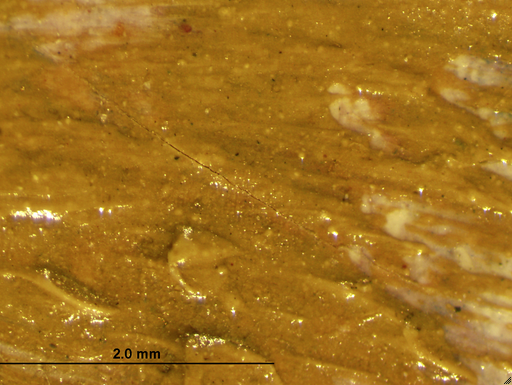
Photomicrograph of the ocher-colored paint in Renoir’s Young Woman Sewing (1879). Not ocher at all, this is actually a mixture of several colors. The Art Institute of Chicago, 1933.452.

Ultraviolet image of Renoir’s Young Woman Sewing (1879). The Art Institute of Chicago, 1933.452.
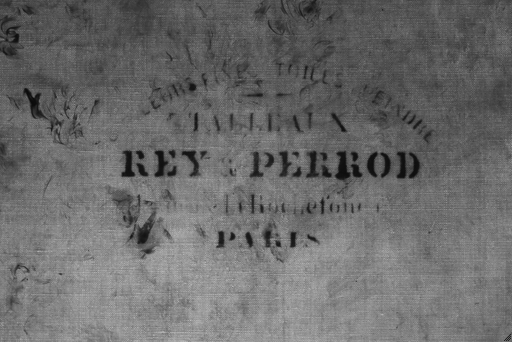
Transmitted-infrared (Fuji, 1.0–1.1 µm) detail from the verso of Renoir’s Young Woman Sewing (1879) showing the ovular Rey & Perrod color merchant stamp. The Art Institute of Chicago, 1933.452.
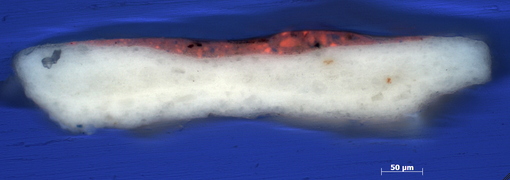
Photomicrograph in UV light of a cross section from the woman's sleeve in Renoir’s Young Woman Sewing (1879) showing bright fluorescence of the madder lake. Original magnification: 200×. The Art Institute of Chicago, 1933.452.
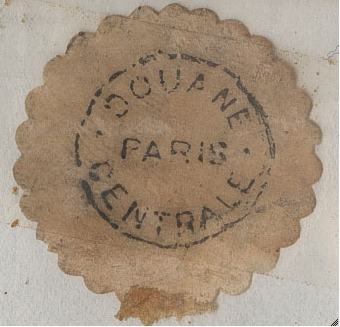
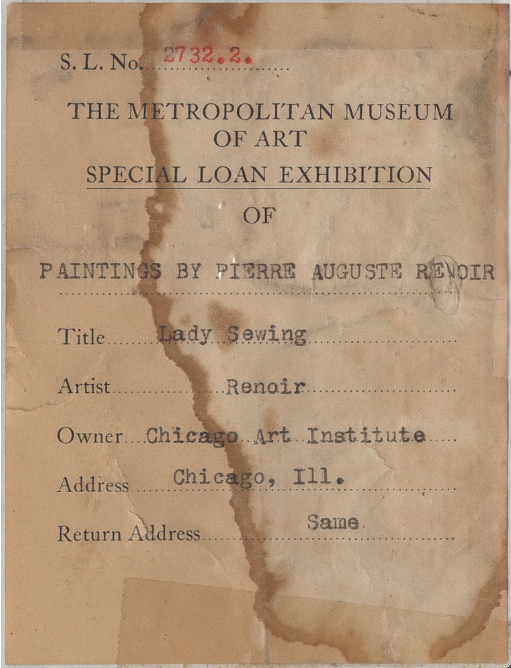
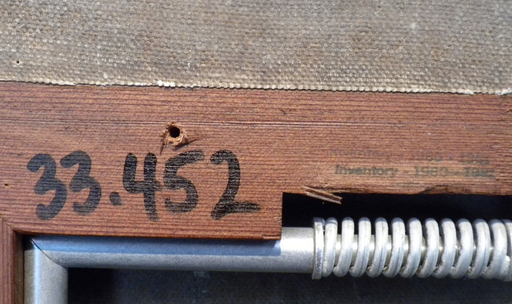
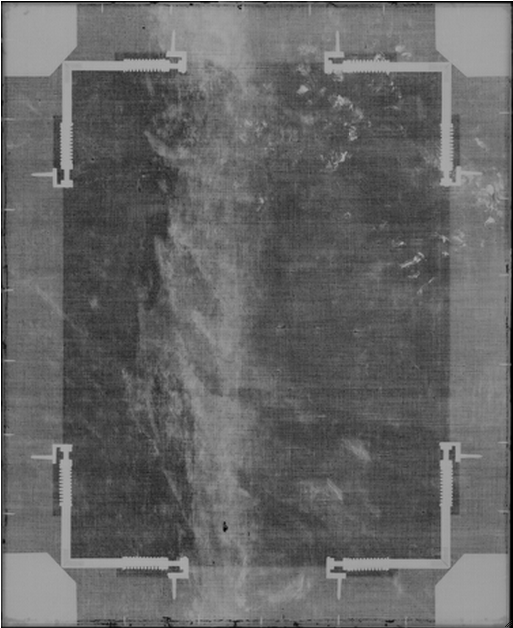
X-ray of Renoir’s Young Woman Sewing (1879). The Art Institute of Chicago, 1933.452. X-ray digitally composited by Robert G. Erdmann, University of Arizona.

2nd x-ray
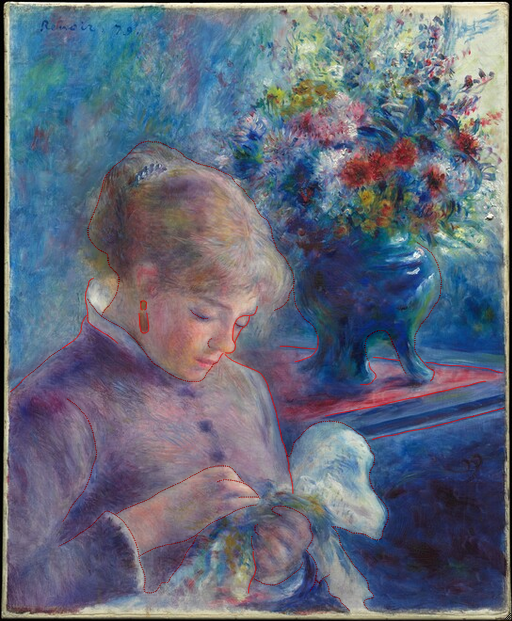
Renoir’s Young Woman Sewing (1879). The Art Institute of Chicago, 1933.452. Interactive image.
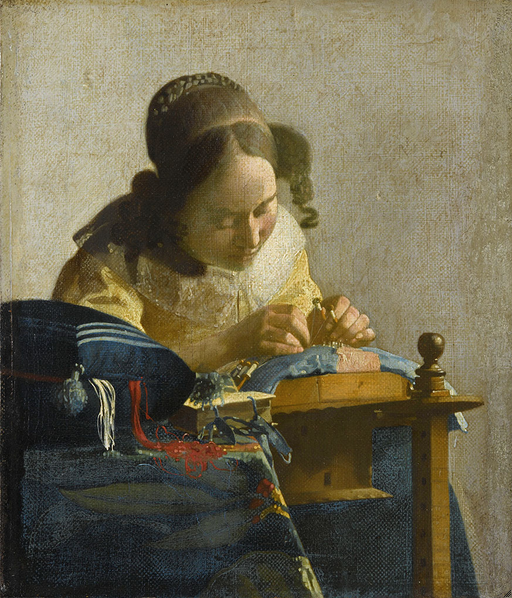
Johannes Vermeer (Dutch, 1632–1675). The Lace Maker, 1669/70. Oil on canvas laid down on wood; 31 × 24 cm (12 3/16 × 9 7/16 in.). Musée du Louvre, Paris, M.I. 1448. © RMN-Grand Palais/Art Resource, NY.
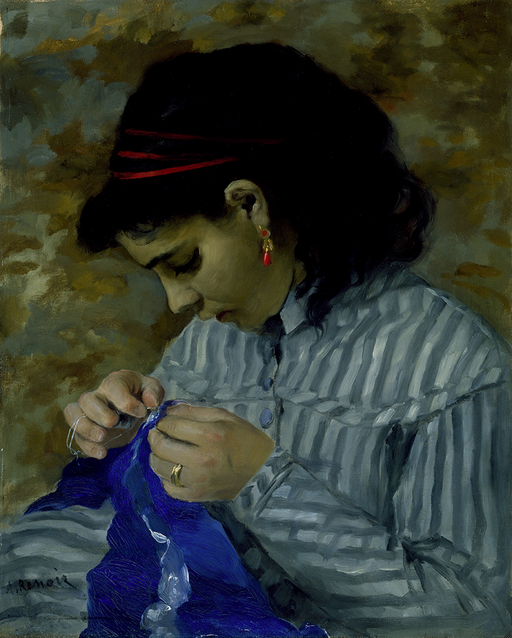
Pierre-Auguste Renoir (French, 1841–1919). Lise Sewing, 1866/67. Oil on canvas; 56 × 47 cm (22 × 18 1/2 in.). Dallas Museum of Art, The Wendy and Emery Reves Collection, 1985.R.59.
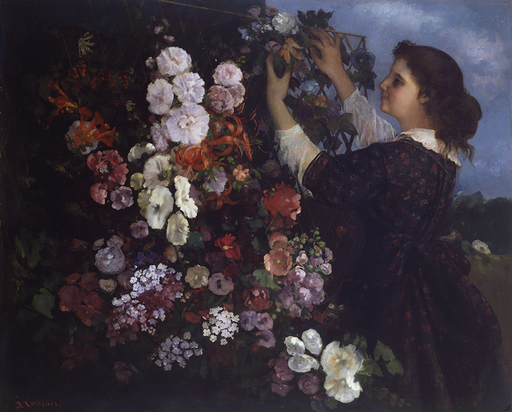
Gustave Courbet (French, 1819–1877). The Trellis, 1862. Oil on canvas; 109.8 × 135.2 cm (43 1/4 × 53 1/4 in.). The Toledo Museum of Art, Purchased with funds from the Libbey Endowment, Gift of Edward Drummond Libbey, 1950.309.
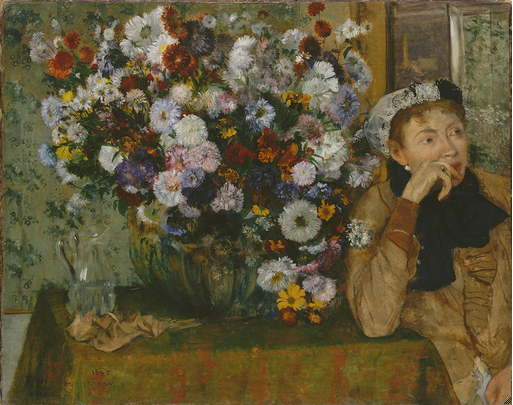
Edgar Degas (French, 1834–1917). A Woman Seated beside a Vase of Flowers (Madame Paul Valpinçon?), 1865. Oil on canvas; 73.7 × 92.7 cm (29 × 36 1/2 in.). The Metropolitan Museum of Art, New York, H. O. Havemeyer Collection, Bequest of Mrs. H. O. Havemeyer, 1929, 29.100.128. Image copyright © The Metropolitan Museum of Art. Image source: Art Resource, NY.
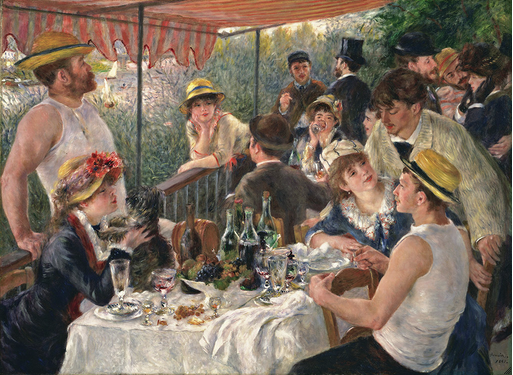
Pierre-Auguste Renoir (French, 1841–1919). Luncheon of the Boating Party, 1880–81. Oil on canvas; 130.2 × 175.6 cm (51 1/4 × 68 1/8 in.). The Phillips Collection, Washington, D.C., Acquired 1923, 1637. Bridgeman Images.
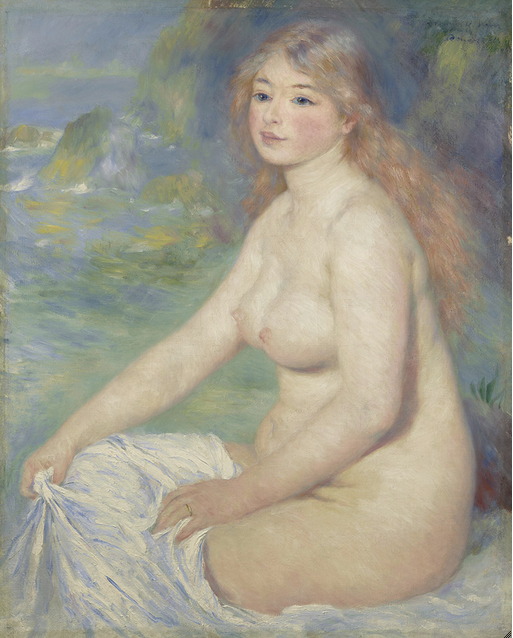
Pierre-Auguste Renoir (French, 1841–1919). Blonde Bather, 1881. Oil on canvas; 81.8 × 65.7 cm (32 3/16 × 25 7/8 in.). Sterling and Francine Clark Art Institute, Williamstown, Mass., 1955.609. Bridgeman Images.
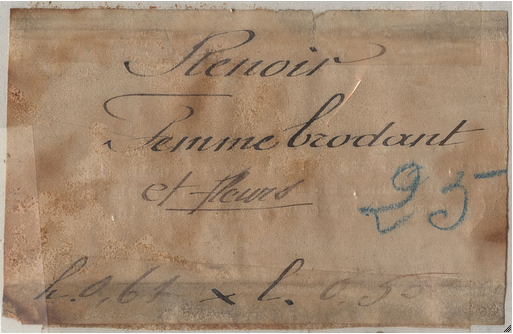
Label with the inscription Femme brodant et fleurs (Woman embroidering and flowers) from a previous backing or stretcher of Renoir’s Young Woman Sewing (1879). The Art Institute of Chicago, 1933.452.
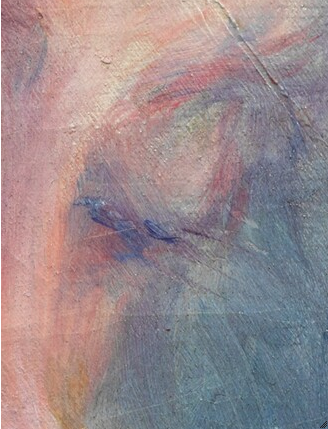
Detail of the figure’s eyelash in Renoir’s Young Woman Sewing (1879). The Art Institute of Chicago, 1933.452.
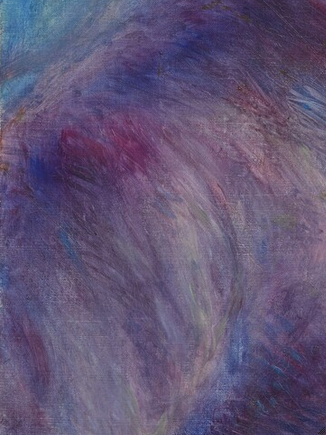
Detail of the figure’s shoulder in Renoir’s Young Woman Sewing (1879). The Art Institute of Chicago, 1933.452.
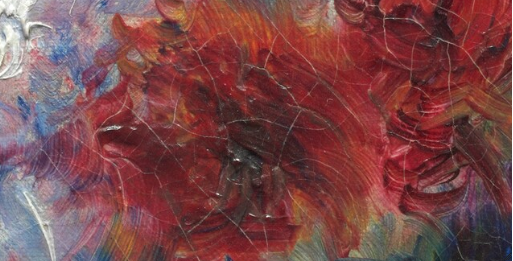
Detail of Renoir’s Young Woman Sewing (1879) showing yellow highlights in a red flower. The Art Institute of Chicago, 1933.452.
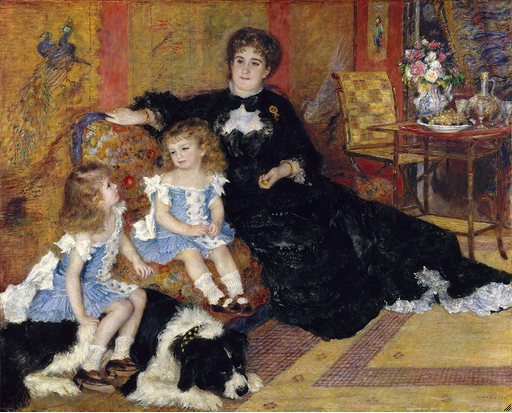
Pierre-Auguste Renoir (French, 1841–1919). Madame Georges Charpentier and Her Children, 1878. Oil on canvas; 153.7 × 190.2 cm (60 1/2 × 74 7/8 in.). The Metropolitan Museum of Art, New York, Catherine Lorillard Wolfe Collection, 07.122. Image copyright © The Metropolitan Museum of Art. Image source: Art Resource, NY.
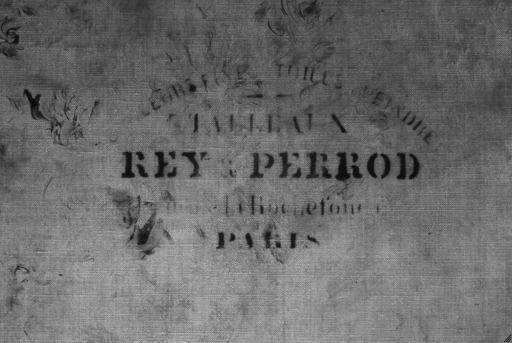
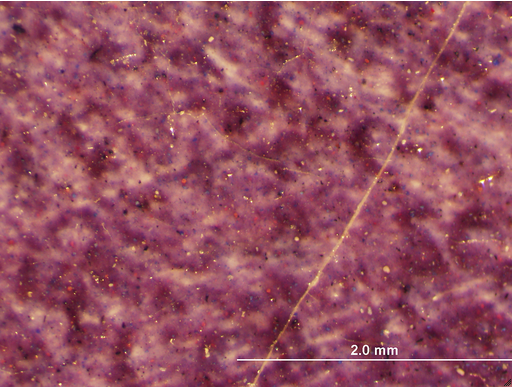
Photomicrograph of the figure’s costume in Renoir’s Young Woman Sewing (1879) showing the translucency of the glaze-like paint layers. The Art Institute of Chicago, 1933.452.
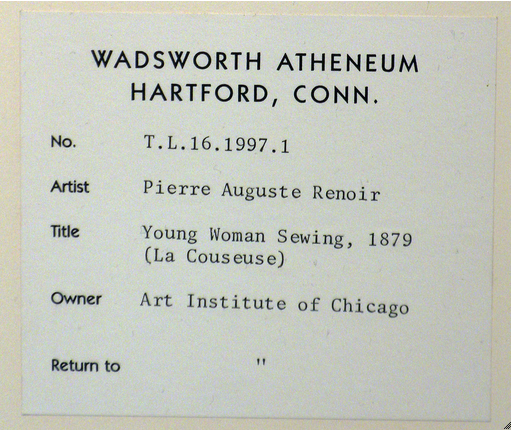
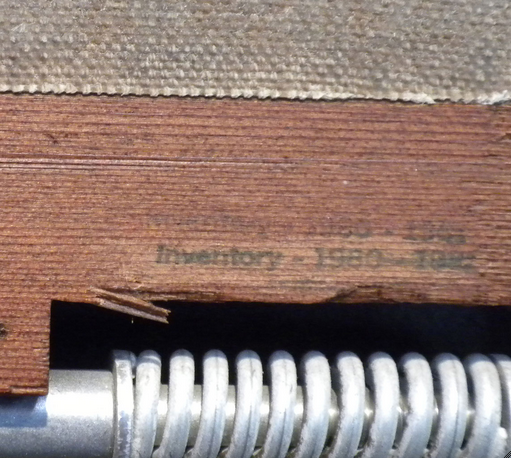
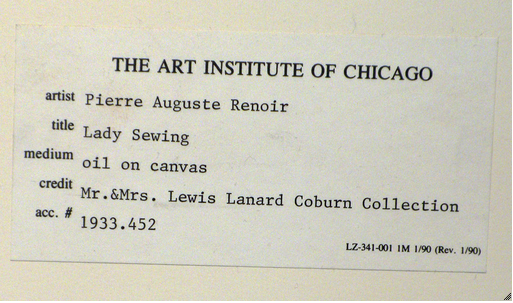
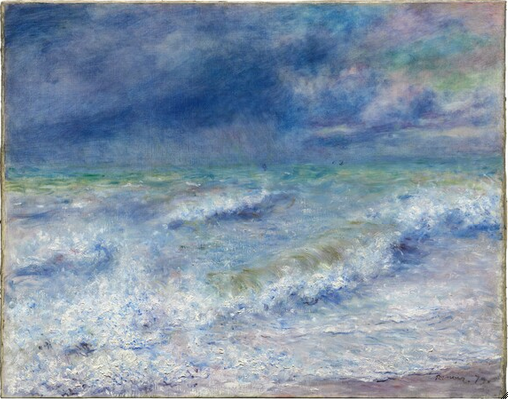
Pierre-Auguste Renoir (French, 1841–1919). Seascape, 1879. Oil on canvas; 72.6 × 91.6 cm (28 1/2 × 36 in.). The Art Institute of Chicago, Potter Palmer Collection, 1922.438. See cat. 8.
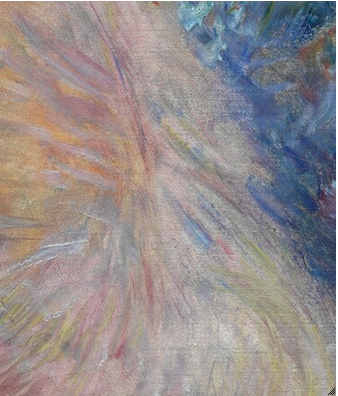
Detail of the top of the figure’s head in Renoir’s Young Woman Sewing (1879). The Art Institute of Chicago, 1933.452.
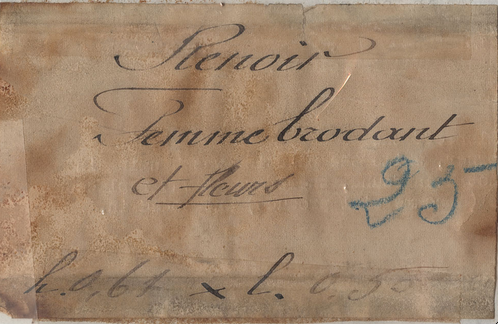
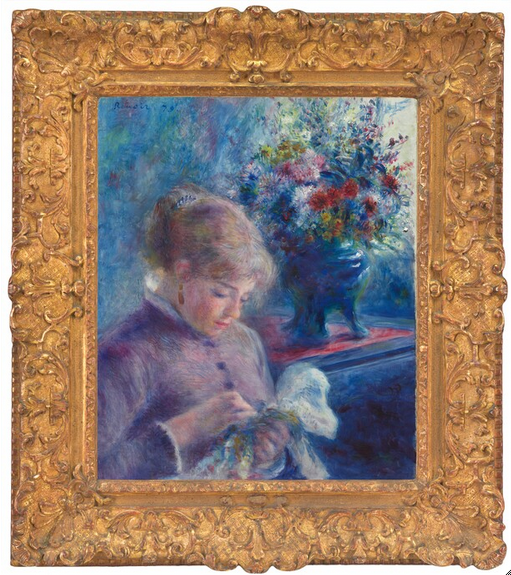
Renoir’s Young Woman Sewing (1879) in its original frame. The Art Institute of Chicago, 1933.452.
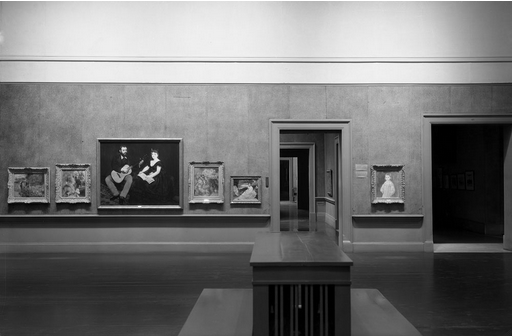
Installation of Renoir’s Young Woman Sewing (1879) in “A Century of Progress”: Loan Exhibition of Paintings and Sculpture, Art Institute of Chicago, May 23–Nov. 1, 1933. Institutional Archives, Art Institute of Chicago.
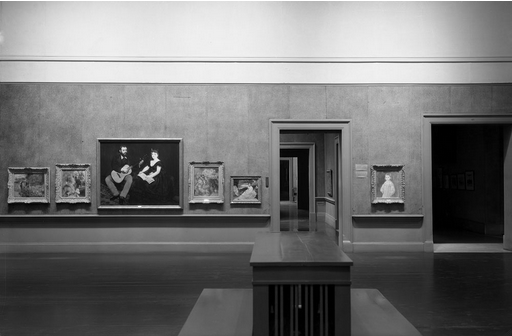
frame history
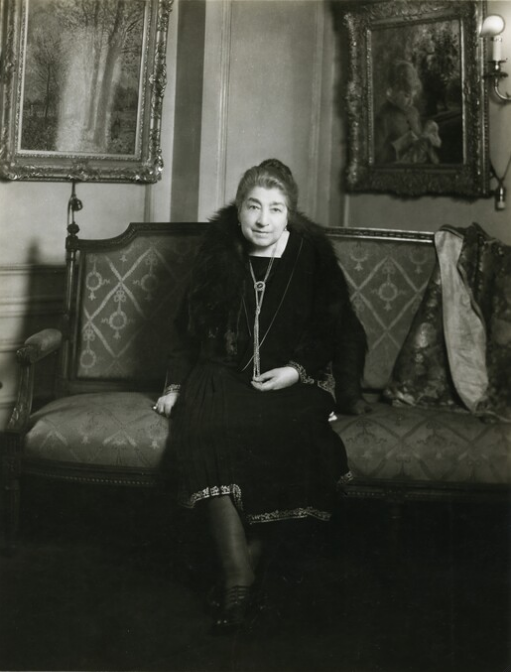
Renoir’s Young Woman Sewing (1879) in its original frame, on display in Mrs. Lewis Larned (Annie Swan) Coburn’s Blackstone Hotel apartment. Institutional Archives, Art Institute of Chicago.
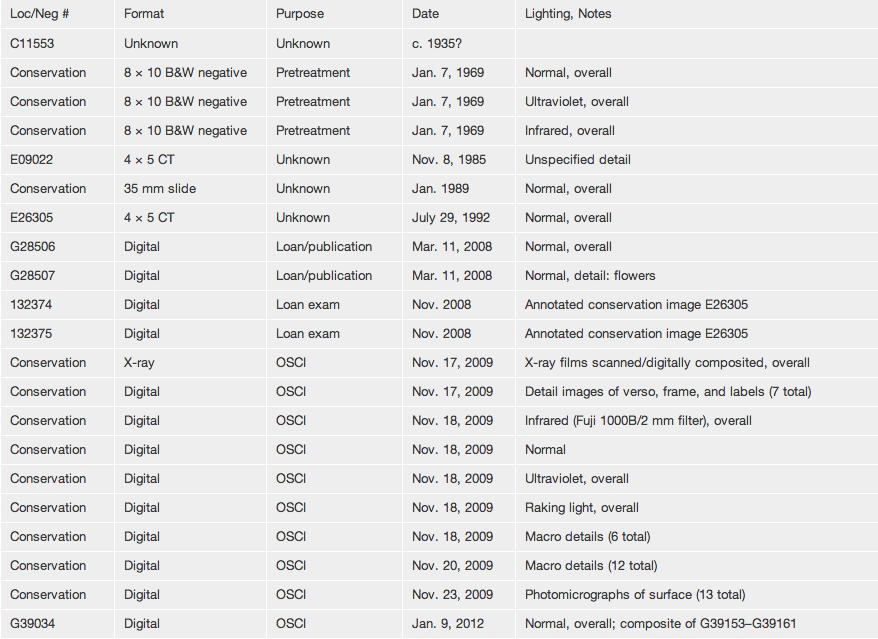
| Loc/Neg # | Format | Purpose | Date | Lighting, Notes |
| C11553 | Unknown | Unknown | c. 1935? | |
| Conservation | 8 × 10 B&W negative | Pretreatment | Jan. 7, 1969 | Normal, overall |
| Conservation | 8 × 10 B&W negative | Pretreatment | Jan. 7, 1969 | Ultraviolet, overall |
| Conservation | 8 × 10 B&W negative | Pretreatment | Jan. 7, 1969 | Infrared, overall |
| E09022 | 4 × 5 CT | Unknown | Nov. 8, 1985 | Unspecified detail |
| Conservation | 35 mm slide | Unknown | Jan. 1989 | Normal, overall |
| E26305 | 4 × 5 CT | Unknown | July 29, 1992 | Normal, overall |
| G28506 | Digital | Loan/publication | Mar. 11, 2008 | Normal, overall |
| G28507 | Digital | Loan/publication | Mar. 11, 2008 | Normal, detail: flowers |
| 132374 | Digital | Loan exam | Nov. 2008 | Annotated conservation image E26305 |
| 132375 | Digital | Loan exam | Nov. 2008 | Annotated conservation image E26305 |
| Conservation | X-ray | OSCI | Nov. 17, 2009 | X-ray films scanned/digitally composited, overall |
| Conservation | Digital | OSCI | Nov. 17, 2009 | Detail images of verso, frame, and labels (7 total) |
| Conservation | Digital | OSCI | Nov. 18, 2009 | Infrared (Fuji 1000B/2 mm filter), overall |
| Conservation | Digital | OSCI | Nov. 18, 2009 | Normal |
| Conservation | Digital | OSCI | Nov. 18, 2009 | Ultraviolet, overall |
| Conservation | Digital | OSCI | Nov. 18, 2009 | Raking light, overall |
| Conservation | Digital | OSCI | Nov. 18, 2009 | Macro details (6 total) |
| Conservation | Digital | OSCI | Nov. 20, 2009 | Macro details (12 total) |
| Conservation | Digital | OSCI | Nov. 23, 2009 | Photomicrographs of surface (13 total) |
| G39034 | Digital | OSCI | Jan. 9, 2012 | Normal, overall; composite of G39153–G39161 |
| G39035 | Digital | OSCI | Jan. 9, 2012 | Ultraviolet, overall |
| G39036 | Digital | OSCI | Jan. 10, 2012 | Normal, frame only |
| G39153 | Digital | OSCI | Jan. 9, 2012 | Section |
| G39154 | Digital | OSCI | Jan. 9, 2012 | Section |
| G39155 | Digital | OSCI | Jan. 9, 2012 | Section |
| G39156 | Digital | OSCI | Jan. 9, 2012 | Section |
| G39157 | Digital | OSCI | Jan. 9, 2012 | Section |
| G39158 | Digital | OSCI | Jan. 9, 2012 | Section |
| G39159 | Digital | OSCI | Jan. 9, 2012 | Section |
| G39160 | Digital | OSCI | Jan. 9, 2012 | Section |
| G39161 | Digital | OSCI | Jan. 9, 2012 | Section |
| Conservation | Digital | OSCI | Jan. 10, 2012 | Transmitted light, overall |
| Conservation | Digital | OSCI | Jan. 10, 2012 | Transmitted infrared (Fuji 1000B/2 mm filter), overall |
| Conservation | Digital | OSCI | Jan. 10, 2012 | Transmitted infrared (Fuji 1000B/2 mm filter), detail: stamp |
Seascape437
1879
Oil on canvas; 72.6 × 91.6 cm (28 1/2 × 36 in.)
Signed and dated: Renoir. 79. (lower right, in purple paint)
The Art Institute of Chicago, Potter Palmer Collection, 1922.438
The name Renoir is closely associated with paintings of dancers, boaters, women, the celebration of life, and the enjoyment of leisure, which makes Seascape and its storm-tossed ocean quite unusual and unexpected. For his landscapes, Renoir preferred sunny days with blue skies and calm winds; rarely do we see unsettled weather, and there are only four known winter scenes.438 Regarding his 1868 painting Skaters in the Bois de Boulogne (fig. 2.48 [Dauberville 110]), he commented to Ambroise Vollard, “I have never been able to stand the cold. . . . Even if you can bear the cold, why paint snow? It is a malady of Nature.”439 Nonetheless, in Seascape the bleak, overcast sky, churning surf, and dominant cool, blue tone convey a sense of vulnerable exposure and sea-drenched cold with astonishing effectiveness.
The year 1879 would prove pivotal in Renoir’s career. In May he sent four works to the Salon, achieving a major triumph with the monumental Madame Georges Charpentier and Her Children (1878; Metropolitan Museum of Art, New York [Daulte 266; Dauberville 239]), which received an excellent hanging position thanks to Madame Charpentier’s sway with the jury.440 It also won high praise from the critics, albeit tempered by some skepticism about an Impressionist’s return to the fold.441 This success was followed in June by his solo exhibition of pastels and paintings in the offices of La vie moderne, a journal published by Madame Charpentier’s husband. That summer he returned to Chatou and the Restaurant Fournaise on the Seine to paint landscapes and portraits, and in August he arrived via supply wagon at Château de Wargemont, the Norman estate of Paul Berard. This was the first of many visits to the banking heir, who was well placed to assist the artist in obtaining commissions and new patrons. Earlier that year, Renoir had painted portraits of Berard’s eldest daughter, Marthe, and his son, André, dressed for school and carrying books.442 Over the course of his stay at Wargemont, Renoir completed portraits of the Berard family and staff in addition to landscapes (see fig. 2.41 [Dauberville 77]), still-life decorations for the château that were in keeping with its eighteenth-century architecture, and two genre paintings of Roma children.443 Renoir sent one of the genre works, Mussel Fishers at Berneval (1879; Barnes Foundation, Philadelphia [Daulte 292; Dauberville 215]), set on the Berards’ private beach on the English Channel, to the Salon in May of the next year.444 Two decorative panels illustrating the opera Tannhauser for the Dieppe home of Dr. Émile Blanche, a fan of the composer Richard Wagner, rounded out this lucrative period of commissions.445
At this time Renoir also began mentoring Dr. Blanche’s eighteen-year-old son, Jacques-Émile, in painting. This relationship continued over the next two years, even though Madame Blanche had grave reservations about Renoir as a role model. During a visit Renoir made to Dieppe in July 1881, she became so disturbed by the artist’s table manners that she banished him from the household. At another point, she expressed exasperation when she learned that he had done a sunset in ten minutes, calling it a waste of paint.446
Whether the portraits became too routine, or the bourgeois company of Normandy too constraining, Renoir’s choice of subject in Seascape allowed him an artistic freedom he did not enjoy with figure paintings intended for exhibition or resulting from commissions.447 Ocean views were already associated with modernism and the avant-garde. The Realist painter Gustave Courbet is reported to have reinvented the storm as a modernist theme in 1869 with a depiction of seawater blowing against the windows of his Étretat beach house.448 In treating the subject that year, Courbet was aware that he was attempting something new.449 An ambitious work resulting from his Étretat campaign, Stormy Sea (fig. 2.42), was exhibited to critical acclaim at the Salon of 1870 and became the first of Courbet’s paintings to enter the collection of the Musée du Luxembourg, in 1878. An enormous canvas measuring more than four feet high and six feet wide, and extensively worked with a palette knife, Stormy Sea no doubt made an indelible impression on Renoir, as it did on writer and critic Émile Zola when it was exhibited as part of the French Paintings section of the Exposition Universelle, which opened in May 1878. Angered that Courbet was represented by only one work when multiple paintings by academic painters William Bouguereau and Jean-Léon Gérôme were on view in the next gallery, Zola identified Stormy Sea as a rallying point for the avant-garde in his review of the Exposition Universelle.450 Another of Courbet’s wave paintings, one of a smaller scale, was included in the exhibition of French “modern masters” at Durand-Ruel, June 20–October 15, 1878, an exhibition reportedly intended to compensate for the underrepresentation of the school at the Exposition Universelle.451
The sea took on profound metaphorical significance in the writings of Courbet’s contemporaries Charles Baudelaire, Victor Hugo, and Jules Michelet.452 Though inspired by direct observation, there is a literary sensibility to Courbet’s Stormy Sea, with its single powerful wave about to crash on the shore near wooden herring boats, thus emphasizing the potentially destructive power of nature. Renoir’s Seascape resists such narrative content. Rather, as John House has pointed out, Renoir “seems to have been more concerned with the visual spectacle before him than with any weightier significance in the theme.”453 Courbet maintained a certain distance from the shore, but Renoir dramatically shifted the point of view by placing the picture plane much closer to the water, thus transforming the viewing experience by emphasizing the visceral—a modern, secular approach to landscape akin to the idea of the individual “sensation,” which Camille Pissarro thought essential to an understanding of Impressionism.454
Renoir’s Impressionist colleague Claude Monet also placed the viewer close to the water’s edge in the sea paintings he made in the early 1880s. Though Renoir’s Seascape preceded the first of Monet’s wave paintings by two years, it is useful to compare the two artists’ treatments, as the sea and water are so prevalent in Monet’s work, and he is so closely identified with the wave theme. There are distinct differences in the two artists’ approaches to the wave painting. Monet’s Waves Breaking (fig. 2.43), for example, shows a moment when the clouds are dispersed, allowing the sunlight to create diverse color and light effects. Judging by the indicated wind direction and clouds on the horizon in Seascape, Renoir instead strove to capture the brooding, ominous atmosphere of an approaching storm. The difference in viewpoint of the two paintings is also significant. Renoir positioned the viewer at an angle to the shoreline, looking down, so that the waves are seen following one another to the shore from the left. He depicted waves in various aspects, such as the upward surge of spray on the lower left where seawater crashes into a rock. In contrast, Monet’s canvas looks directly out to sea, waves roll in with rhythmic regularity, and there are fewer reference points for identifying a specific viewing position. The elimination of the shoreline altogether in Waves Breaking represented a bold departure from traditional sea painting and may have owed something to Japanese prints by Hokusai, as well as to Renoir’s example.455 Monet and Renoir had the opportunity to compare notes on wave painting when they met in Pourville during the summer of 1882 with the art dealer Paul Durand-Ruel.456 Regardless of whether Renoir shared Monet’s opinions on wave painting at this meeting, his later treatment of the subject in 1882 (fig. 2.52 [Dauberville 798]) took further Monet’s gambit of the absent shoreline.457 Moreover, by devoting most of that picture to the crest of a single breaking wave, he produced a work that Christopher Riopelle has compared to twentieth-century action painting.458 Renoir’s 1882 Wave is like a detail of Seascape. The viewing angle is much more restricted, and the horizon has been raised so that the artist could take full advantage of the potential for painterly effects in the visual play of foam and sea spray. At this point, however, Renoir may have decided that the painting of waves lay on a path he did not want to pursue further. After 1882 he made no more pictures of the subject.
The anecdote about Renoir painting a sunset in ten minutes reinforces the common perception that the Impressionists worked rapidly and without concern for detail or accurate representation of the motif. But close examination of Seascape as outlined in the Technical Report reveals a surprisingly complex working process. In his choice of such a large canvas (corresponding to a no. 30 portrait [[glossary:figure]] standard-size canvas, turned horizontally), Renoir may have been emboldened by Courbet’s earlier wave painting. The size of Seascape’s canvas and its degree of finish suggest that it was intended for public view, possibly for the Salon, to which Renoir had returned in 1878. It seems unlikely that he could have worked in strong winds for any length of time on a canvas of this size without substantial shelter. Thus it seems possible that he only painted the wash-like underlayers of the scene on site and then worked from a smaller sketch, perhaps a second wave painting executed during his stay in Normandy in 1879 on a more diminutive no. 15 portrait (figure) standard-size canvas (fig. 2.49 [Dauberville 149]).459 This smaller work was painted in the cursory style of a preparatory sketch and shows different lighting conditions and possibly a different location. Most of the brushstrokes are clearly visible; they consist of long strokes with a flat brush, and little attempt was made to differentiate surface textures. Such treatment is typical of rapid execution. By contrast, Seascape displays an astounding variety of brush techniques and colors—subtleties that must have taken some time to consider and apply (fig. 2.53). Given the rather elusive nature of waves, the smaller work could have been executed as a preliminary study that later inspired the artist as he painted Seascape in his studio.
The sky in the top half of Seascape consists of broad washes of cobalt blue over a white ground, resulting in a brilliant atmospheric effect. Rain falling from low-hanging clouds on the horizon was rendered in a sure hand with diagonal strokes from a stiff-bristle brush (fig. 2.54). Renoir applied thicker layers of green and yellow paint over the blue washes along the horizon to suggest the depths of the sea. All these effects seem carefully considered and range dramatically in application technique. In the bottom half of the canvas, as the rolling surf approaches the shore and begins to form waves, the impasto layers gradually build and become more tactile. In the surging spout of foam in the left foreground, white paint was applied with such gusto that one can almost hear the hiss of the foam as it breaks from the cresting waves (fig. 2.55). Rich color accents are present throughout the canvas, including the red tones in the sand under the receding waves, and the rhythmic arcs of green and red defining the volumes of water that propel the frothy crests of the waves, masterfully linking the foreground with the deeper water near the horizon (see Palette in the technical report).
Whether Monet was aware of Renoir’s Seascape and influenced by it remains an unresolved question, as the history of the painting before 1890 is unknown. The first record of the painting is its sale by the art dealer Alphonse Legrand to Durand-Ruel on February 21, 1890, where it was listed simply as Marine and assigned the stock number 2637.460 Though the painting was an ideal size for the Salon, Renoir did not submit the work to its juries, nor did he include it in his 1883 retrospective on the boulevard de la Madeleine organized by Durand-Ruel. It is possible that Legrand held the work for years unsold or in reserve for his Impressionist painting venture with Knoedler and Company, New York. Alternatively, Legrand may not have acquired Seascape until later, as it is known that Renoir frequently held back his more experimental works, not showing them until they had been “bottled away” for at least a year.461 Renoir is not as closely identified with the sea as Monet, but like Monet he felt the burden of Courbet’s influence and, when he took on the motif, addressed it in an experimental way.
John Collins
Renoir began this painting with a [glossary:commercially primed], standard-size [glossary:canvas] with a rich, white [glossary:ground]. Areas of the ground layer appear to have a fairly uniform, diagonal, brushy texture. In some places, a stronger diagonal texture appears in subsequent paint layers, as in the center, where the artist used strokes of thick white or light-blue paint that suggest rain, over which he applied a thin blue [glossary:wash] that sank into the depressions left by the brush. While the thin layers of paint in many parts of the background suggest a wider, stiff-bristle brush that scratched through the thin paint to reveal the ground, the foreground seems for the most part to have been articulated with fine, soft-bristle brushes that left very little impression on the thick paint. Many of the early layers are relatively thin, may have been wiped or rubbed, and were allowed to dry before the later layers were applied, suggesting a limited number of [glossary:wet-in-wet] campaigns. The sky is generally described through translucent films of color, while the foreground waves are smoothly blended, opaque combinations of pale pink, blue, and gray. Thinly painted deep blues and, sometimes, brown hint at the depth beyond the translucent waves. As a final step, Renoir employed heavy [glossary:impasto], often in pure white, to articulate the frothy, breaking waves.
The multilayer interactive image viewer is designed to facilitate the viewer’s exploration and comparison of the technical images (fig. 2.51).462
Signed and dated: Renoir. 79. (lower right, in purple paint) (fig. 1.2, fig. 1.1).463
Flax (commonly known as linen).464
The original dimensions of the canvas were approximately 72 × 92.5 cm, measuring from the original foldover edge. This probably corresponds to a no. 30 portrait ([glossary:figure]) standard-size (92 × 73 cm) canvas, turned horizontally.465
[glossary:Plain weave]. Average [glossary:thread count] (standard deviation): 30.2V (0.7) × 24.3H (0.9) threads/cm. The vertical threads were determined to correspond to the [glossary:warp] and the horizontal threads to the [glossary:weft].466
The [glossary:X-ray] shows mild [glossary:cusping] corresponding to the placement of the original tacks. There are also some thread irregularities and double thread faults. The strongest fault appears in the X-ray as a horizontal line across the top of the painting (parallel to and below the top stretcher bar). Here the irregularity of the canvas caught more of the ground layer during preparation, resulting in a denser, more [glossary:radio-opaque] area. Similar horizontal bands are visible throughout the top half of the painting.
Current stretching: The painting was lined at an unknown date, and its dimensions appear slightly altered (extended horizontally and somewhat shortened vertically) as a result. In addition, a [glossary:hardboard] panel was placed between the lined painting and the stretcher; it is unclear whether the painting is attached to the hardboard (see Conservation History).
Original stretching: Based on cusping visible in the X-ray, the original tacks were placed approximately 6.5 cm apart.
Though the painting was lined as part of a previous, undocumented conservation treatment, it appears to have retained its original [glossary:stretcher] (see Conservation History).467 The canvas is tacked to a five-member, keyable, mortise-and-tenon stretcher with vertical [glossary:crossbar] (fig. 2.20). Depth: 1.5 cm.
Not determined (probably glue).468
The artist began with a commercially primed canvas, with the preparation extending to the edges of the tacking margin. The X-ray shows sweeping, radio-opaque forms that extend from the top edge and curve downward and to the right, possibly suggesting that additional ground material was added to the compositional area by the artist or a color merchant.469 The shape of the sweeps suggests application with a [glossary:palette knife] (fig. 2.39). Additionally, there is a ridge of ground material at the right foldover edge, where a strong, curving stroke visible in the X-ray—starting along the top edge at the center and sweeping to the right edge—appears to end; it may be excess ground material that was pushed over during application (fig. 1.3). A close look at the surface reveals evidence of a brushy, diagonal texture (fig. 1.4).470 This texture was probably applied lightly to the surface of the ground after initial application and working, but while the preparation was still wet.
In the cross section, a clear distinction between the separate layers of ground material is not evident; rather, the ground appears to be either a very thick, single layer or two or more layers of a similar composition applied in quick succession (fig. 3.60).471 The overall thickness of the ground is approximately 10–90 µm.
The ground appears white; no additional colored particles were observed under stereomicroscopic examination of the surface or in cross section (fig. 2.50).
The ground is predominantly lead white with barium sulfate and small amounts of silicates, calcium compounds, and traces of bone black.472 The [glossary:binder] is estimated to be [glossary:oil].473
No [glossary:underdrawing] was observed with [glossary:infrared reflectography] or under microscopic examination.
The work is very thinly painted in many areas, especially in the top half, where Renoir made use of the reflective qualities of the ground and [glossary:underpainting]. The thinness of the paint layer, the sketchy brushwork, and the impasto that is limited to the foreground suggest rapid execution and a limited number of wet-in-wet campaigns. The artist utilized translucent [glossary:pigments] such as red lake, emerald green, and cobalt blue, in addition to thinning his paint with turpentine for a wash (e.g., in the sky), and using additional medium for a glaze-like effect (fig. 2.22).474 Above the horizon line on the far right, Renoir may have used a cloth or similar tool to wipe away some of the paint, leaving an even thinner, more translucent film of color with a soft, indistinct edge. These kinds of thin applications also form the underlayers throughout most of the foreground, creating a play of colors between the translucent washes and the more opaque paints applied in later stages. In some areas, particularly in the center, Renoir used long, downward diagonal brushstrokes of white or light blue to establish texture and space, then crossed the pattern with dilute blue applied with a stiff-bristle brush. This directional underpaint can be seen in the X-ray, especially in the upper left quadrant (fig. 2.39). The fluid blue paint application produced two effects: first, the blue settled into the depressions of the underlying white paint, accentuating the diagonal texture; and second, the use of a stiff-bristle brush (which cut through the thin paint, exposing the white underpaint and ground) created a much finer, subtler set of diagonals, which sometimes run almost perpendicular to the textured strokes beneath (fig. 2.23). The effect was further complicated where the brush caught the thread tops, creating the illusion of droplets. In other areas of the sky and clouds, the artist applied paint with a stiff-bristle brush and used varying pressure to increase or decrease the presence of the stroke and overall texture.
In the foreground, Renoir seems to have initially established the space with thin, opaque, modulated blue-grays, over which he layered extensive impasto with soft-bristle brushes to describe the crash and froth of the waves (fig. 2.24). In some areas, he appears to have used a palette knife initially to spread the paint onto the canvas, and then worked it further with a soft brush (fig. 2.25). Along the bottom edge to the left of center, the artist dragged a brush or possibly a palette knife loaded with thick, dry paint horizontally across the surface, catching just the tops of the vertical threads, to create the illusion of water pulling away from the beach (fig. 2.26). While the painting appears somewhat monochromatic, with shades of blue and blue-green throughout punctuated by the white froth of the waves, Renoir chose to emphasize and add depth to specific locations in the waves with a riot of color applied with a fine-tip brush (fig. 2.27).
Soft- and stiff-bristle brushes with strokes up to 1.5 cm wide; palette knife; possibly cloth for wiping.
Analysis indicates the presence of the following pigments:475 lead white, cobalt blue,476 emerald green, iron oxide red and/or yellow, chrome-based yellow,477 bone black, and red lake.
The observation of a characteristic salmon-colored [glossary:fluorescence] under [glossary:UV] light suggests the presence of red lake in the upper right sky, foreground beach, and waves near the horizon on the left (fig. 2.40).478
Oil (estimated).479
The work has a [glossary:synthetic varnish] with residues of natural resin in areas of impasto; these residues are readily visible under UV examination, appearing milky yellow-green. The current varnish was applied in 1962 and replaced a discolored [glossary:natural-resin varnish] applied in 1922. It is not clear whether the earliest documented natural-resin varnish was original to the painting.
The earliest documented treatment of the painting was near the time of its acquisition in 1922, when it was cleaned and varnished.480 A letter from 1921 recommending treatment suggests that the cleaning was a grime cleaning “to be sure the surface is free from smoke and dirt” and makes no mention of an existing varnish or varnish removal.481 The next documented treatment occurred in 1962.482 At this time, the painting was described as being lined with glue paste, stretched over a hardboard panel, and tacked to a five-member stretcher. The presence of French newspaper on the verso as an interleaf between the stretcher and a layer of brown paper tape may indicate that the work was first treated in France. Abrasions, [glossary:cleavage], and loss, especially on the right side of the painting, were also noted at this time, and the painting had a discolored natural-resin varnish. During the 1962 treatment, grime and varnish were removed, and areas of cleavage, mostly on the right, were consolidated with wax.483 Losses were retouched with oil methacrylate paints, and the work was given a synthetic varnish (an isolating layer of polyvinyl acetate [PVA] AYAA, followed by methacrylate resin L-46, inpainting, and a final spray of L-46).
The work is in good condition, with a stable [glossary:aqueous lining] and hardboard backing between the canvas and the stretcher. The board is slightly warped, causing the bottom left corner of the canvas to pull away from the stretcher and giving the painting a somewhat concave appearance. The stretcher is tapped out slightly, to dimensions a bit larger than the hardboard, and covered almost entirely with brown paper tape. Beneath this tape in many areas are spots of red adhesive that appear to be vermilion- and iron oxide–containing sealing wax, used here to hold an interleaf of French newspaper between the stretcher and the paper tape (fig. 2.28).484 Cleavage and loss have been noted repeatedly throughout the painting’s history and seem to relate to the ground separating from the canvas (especially on the right). This is probably the result of canvas shrinkage either before or during the lining process. There is also abrasion along raised canvas threads and rebate abrasion.
Kelly Keegan
Current frame (2004): The frame is not original to the painting. It is an Italian, eighteenth-century, gilt torus frame with a scotia frieze. The frame has water gilding over yellow-orange bole on gesso. The gilding is burnished overall, highly on the torus and ovolos and lightly in other areas. The frame retains its original gilding and glue sizing. The poplar molding is face and side mitered and joined with blind-bridled tenons. Parchment was glued over the face miters prior to gessoing. The molding, from the perimeter to the interior, is ovolo outer molding; scotia side; torus face with a three-quarter-round profile; fillet; scotia-edged frieze; ovolo; and fillet sight molding (fig. 2.56).485
Previous frame (installed mid-1960s, removed 2004): The painting was previously housed in an American (New York), mid-twentieth-century reproduction of an Italian Baroque bolection frame with a centered, spiraled leaf outer molding and a fruit, flower, and husk sight molding. The frame had water gilding over red bole and gesso and was very heavily toned. The carved basswood molding was mitered and nailed (fig. 2.58).486
Previous frame (installed by 1933, removed mid-1960s): The work was previously housed in a late-nineteenth–early-twentieth-century, Louis XIV Revival, convex frame with very deeply recessed cast plaster ornament of acanthus leaves at the miters and floral and foliate-scroll centers bracketed by undulating foliage and pendent bellflowers. The frame had water and oil gilding on a dark red-brown bole over gesso and cast plaster. The sides and frieze were burnished, and the ornament was selectively burnished. The gilding was toned with dark raw umber and a white wash and speckled with black and white. The molding was mitered and nailed. The molding, from the perimeter to the interior, was ovolo with leaf-tip ornament; scotia side; convex face with acanthus leaves at the miters, floral and foliate-scroll centers bracketed by undulating foliage and pendent bellflowers on a quadrillage bed; hollow frieze; ogee with leaf-tip ornament; cove; and fillet with cove sight edge (fig. 2.57).
Kirk Vuillemot
Acquired from [unknown] by Alphonse Legrand, Paris, by Feb. 21, 1890.487
Sold by Alphonse Legrand, Paris, to Durand-Ruel, Paris, Feb. 21, 1890.488
Sold by Durand-Ruel, New York, to W. C. Van Horne, Montreal, Apr. 19, 1892, for $1,000.489
Acquired by Eugene Glaenzer, New York, by Dec. 14, 1892.490
Sold by Eugene Glaenzer, New York, to Durand-Ruel, New York, Dec. 14, 1892.491
Sold by Durand-Ruel, New York, to Potter Palmer, Chicago, Dec. 14, 1892, for $1,250.492
By descent from Potter Palmer (died 1902), Chicago, to the Palmer family.493
Given by the Palmer family to the Art Institute of Chicago, 1922.
Possibly Paris, Durand-Ruel, Exposition A. Renoir, May 1892, cat. 100.494
Art Institute of Chicago, Paintings by Renoir, Feb. 3–Apr. 1, 1973, cat. 27 (ill.).
Highland Park, Ill., Neison Harris, Mar. 7–May 21, 1975, no cat.495
Los Angeles County Museum of Art, A Day in the Country: Impressionism and the French Landscape, June 28–Sept. 16, 1984, cat. 120 (ill.); Art Institute of Chicago, Oct. 23, 1984–Jan. 6, 1985; Paris, Galeries Nationales, Grand Palais, as L’impressionnisme et le paysage français, Feb. 4–Apr. 22, 1985.
Edinburgh, Royal Scottish Academy, Monet: The Seine and the Sea, 1878–1883, Aug. 6–Oct. 26, 2003, cat. 89 (ill.).496
Art Institute of Chicago, Manet and the Sea, Oct. 20, 2003–Jan. 19, 2004, cat. 117 (ill.); Philadelphia Museum of Art, Feb. 15–May 30, 2004; Amsterdam, Van Gogh Museum, June 18–Sept. 26, 2004.
London, National Gallery, Renoir Landscapes, 1865–1883, Feb. 21–May 20, 2007, cat. 45 (ill.); Ottawa, National Gallery of Canada, June 8–Sept. 9, 2007; Philadelphia Museum of Art, Oct. 4, 2007–Jan. 6, 2008.
Possibly Durand-Ruel, Paris, Exposition A. Renoir, exh. cat. (Imp. de l’Art/E. Ménard, 1892), p. 47, no. 100.497
Art Institute of Chicago, Handbook of Sculpture, Architecture, and Paintings, pt. 2, Paintings (Art Institute of Chicago, 1922), p. 69, cat. 845.498
Art Institute of Chicago, “Accessions and Loans,” Bulletin of the Art Institute of Chicago 16, 3 (May 1922), p. 47.
Art Institute of Chicago, “The Potter Palmer Collection of Paintings,” Bulletin of the Art Institute of Chicago 16, 3 (May 1922), p. 38.499
Art Institute of Chicago, A Guide to the Paintings in the Permanent Collection (Art Institute of Chicago, 1925), p. 150, cat. 845.500
Ambroise Vollard, Renoir: An Intimate Record, trans. Harold L. Van Doren and Randolph T. Weaver (Knopf, 1925), p. 239.
M. C., “Renoirs in the Institute,” Bulletin of the Art Institute of Chicago 19, 3 (Mar. 1925), p. 32.
M. C., “Renoirs in the Institute (Continued),” Bulletin of the Art Institute of Chicago 19, 4 (Apr. 1925), p. 47 (ill.).
Julius Meier-Graefe, Renoir (Klinkhardt & Biermann, 1929), p. 120, no. 109 (ill.).
Daniel Catton Rich, “Französische Impressionisten im Art Institute zu Chicago,” Pantheon: Monatsschrift für Freunde und Sammler der Kunst 11, 3 (Mar. 1933), p. 78. Translated by C. C. H. Drechsel as “French Impressionists in the Art Institute of Chicago,” Pantheon/Cicerone (Mar. 1933), p. 18.
Ulrich Thieme and Felix Becker, “Renoir,” in Allgemeines Lexikon der Bildenden Künstler, vol. 28, Ramsden–Rosa (Seemann, 1934), p. 170.
Albert C. Barnes and Violette de Mazia, The Art of Renoir (Minton, Balch, 1935), pp. 74; 75; 451, no. 92.
Duveen Galleries, New York, Renoir: Centennial Loan Exhibition, 1841–1941; For the Benefit of the Free French Relief Committee, exh. cat. (Vilmorin/Bradford, 1941), p. 132.
Frederick A. Sweet, “Potter Palmer and the Painting Department,” Bulletin of the Art Institute of Chicago 37, 6 (Nov. 1943), p. 86.
Florence Hope, “A Late Renoir Recently Added to the Institute’s Collection,” Bulletin of the Art Institute of Chicago 39, 7 (Dec. 1945), p. 98.
Ishbel Ross, Silhouette in Diamonds: The Life of Mrs. Potter Palmer (Harper & Bros., 1960), p. 155.
Art Institute of Chicago, Paintings in the Art Institute of Chicago: A Catalogue of the Picture Collection (Art Institute of Chicago, 1961), p. 396.501
Charles C. Cunningham and Satoshi Takahashi, Shikago bijutsukan [Art Institute of Chicago], Museums of the World 32 (Kodansha, 1970), pp. 53, pl. 39; 160.
Art Institute of Chicago, Paintings by Renoir, exh. cat. (Art Institute of Chicago, 1973), pp. 80; 82–83, cat. 27 (ill.).
Andrea P. A. Belloli, ed., A Day in the Country: Impressionism and the French Landscape, exh. cat. (Los Angeles County Museum of Art, 1984), p. 366.
Sylvie Gache-Patin and Scott Schaefer, “Impressionism and the Sea,” in A Day in the Country: Impressionism and the French Landscape, ed. Andrea P. A. Belloli, exh. cat. (Los Angeles County Museum of Art, 1984), pp. 288; 290; 291, no. 120 (ill.).
Sylvie Gache-Patin and Scott Schaefer, “La mer,” in Réunion des Musées Nationaux, L’impressionnisme et le paysage français, exh. cat. (Réunion des Musées Nationaux, 1985), pp. 308; 312–13, no. 120 (ill.).
Nicholas Wadley, ed., Renoir: A Retrospective (Hugh Lauter Levin/Macmillan, 1987), p. 195, pl. 65.
Michael Howard, ed., The Impressionists by Themselves: A Selection of Their Paintings, Drawings, and Sketches with Extracts from Their Writings (Conran Octopus, 1991), pp. 256 (ill.), 320.
Lesley Stevenson, Renoir (Bison Group, 1991), pp. 100–01 (ill.).
Shigenobu Kimura et al., Seikimatsu no yume / The Dream of Fin de Siècle, Meigo e no tabi / Journey into the Masterpieces 21 (Kodansha, 1992), pp. 70, pl. 3-24; 144.
Charles F. Stuckey, with the assistance of Sophia Shaw, Claude Monet, 1840–1926, exh. cat. (Art Institute of Chicago/Thames & Hudson, 1995), p. 204, fig. 36.
Francesca Castellani, Pierre-Auguste Renoir: La vita e l’opera (Mondadori, 1996), pp. 73, 137 (ill.).
Douglas W. Druick, Renoir, Artists in Focus (Art Institute of Chicago/Abrams, 1997), pp. 33 (detail); 46; 72; 89, pl. 8; 110.
Gilles Néret, Renoir: Painter of Happiness, 1841–1919, trans. Josephine Bacon (Taschen, 2001), p. 121 (ill.).
Michael Clarke and Richard Thomson, Monet: The Seine and the Sea, 1878–1883, exh. cat. (National Galleries of Scotland, 2003), p. 165, cat. 89 (ill.).
Joseph J. Rishel, “Pierre-Auguste Renoir,” in Juliet Wilson-Bareau and David Degener, Manet and the Sea, exh. cat. (Philadelphia Museum of Art, 2003), p. 243.
Richard Thomson, “Looking to Paint: Monet 1878–1883,” in Michael Clarke and Richard Thomson, Monet: The Seine and the Sea, 1878–1883, exh. cat. (National Galleries of Scotland, 2003), p. 33.
Juliet Wilson-Bareau and David Degener, Manet and the Sea, exh. cat. (Philadelphia Museum of Art, 2003), pp. 248, pl. 117; 261.
Frank Whitford, “A Lasting Impression,” Sunday Times (Scotland), Aug. 10, 2003, p. 17.
Isabelle Cahn, L’impressionnisme, ou l’oeil naturel, L’aventure de l’art (Chêne, 2005), pp. 52 (ill.), 219.
Kyoko Kagawa, Runowaru [Pierre-Auguste Renoir], Seiyo kaiga no kyosho [Great masters of Western art] 4 (Shogakukan, 2006), pp. 33–34 (ill.).
Heather Lemonedes, Lynn Federle Orr, and David Steel, eds., Monet in Normandy, exh. cat. (Fine Arts Museums of San Francisco/North Carolina Museum of Art/Cleveland Museum of Art/Rizzoli, 2006), pp. 33; 34, fig. 21.
Colin B. Bailey, “‘The Greatest Luminosity, Colour and Harmony’: Renoir’s Landscapes, 1862–1883,” in Renoir Landscapes, 1865–1883, ed. Colin B. Bailey and Christopher Riopelle, exh. cat. (National Gallery, London, 2007), p. 65. Translated as Colin B. Bailey, “‘Un maximum de luminosité; de coloration, et d’harmonie”: Les paysages de Renoir, 1862–1883,” in Les paysages de Renoir, 1865–1883, ed. Colin B. Bailey and Christopher Riopelle, trans. Marie-Françoise Dispa, Lise-Éliane Pomier, and Laura Meijer, exh. cat. (National Gallery, London/5 Continents, 2007), p. 65.
Colin B. Bailey and Christopher Riopelle, eds., Renoir Landscapes, 1865–1883, exh. cat. (National Gallery, London, 2007), pp. 2–3 (detail); 4; 199–202, cat. 45 (ill.); 256. Translated by Marie-Françoise Dispa, Lise-Éliane Pomier, and Laura Meijer as Les paysages de Renoir, 1865–1883, exh. cat. (National Gallery, London/5 Continents, 2007), pp. 2–3 (detail); 4; 199–202, cat. 45 (ill.); 256.
Guy-Patrice Dauberville and Michel Dauberville, with the collaboration of Camille Frémontier-Murphy, Renoir: Catalogue raisonné des tableaux, pastels, dessins et aquarelles, vol. 1, 1858–1881 (Bernheim-Jeune, 2007), p. 211, cat. 152 (ill.).
Robert McDonald Parker, “Topographical Chronology 1860–1883,” in Renoir Landscapes, 1865–1883, ed. Colin B. Bailey and Christopher Riopelle, exh. cat. (National Gallery, London, 2007), p. 276. Translated as Robert McDonald Parker, “Chronologie,” in Les paysages de Renoir, 1865–1883, ed. Colin B. Bailey and Christopher Riopelle, trans. Marie-Françoise Dispa, Lise-Éliane Pomier, and Laura Meijer, exh. cat. (National Gallery, London/5 Continents, 2007), p. 276.
Charles Stuckey, “The Predications and Implications of Monet’s Series,” in The Repeating Image: Multiples in French Painting from David to Matisse, ed. Eik Kahng, exh. cat. (Walters Art Museum/Yale University Press, 2007), pp. 122–23, n. 22.
Richard R. Brettell and C. D. Dickerson III, From the Private Collections of Texas: European Art, Ancient to Modern (Kimbell Art Museum/Yale University Press, 2009), p. 302, fig. 2.
John House, The Genius of Renoir: Paintings from the Clark, with an essay by James A. Ganz, exh. cat. (Sterling and Francine Clark Art Institute/Museo Nacional del Prado/Yale University Press, 2010), p. 74.
Inventory number
Stock Durand-Ruel Paris 2637, livre de stock Paris 1884–90502
Inventory number
Stock Durand-Ruel New York 900, livre de stock New York 1888–93
Inventory number
Stock Durand-Ruel New York 1011, livre de stock New York 1888–93503
Label (fig. 2.32)
Inscription (fig. 2.33)
Number
Location: stretcher
Method: handwritten script (black marker)
Content: 1922.438 (fig. 2.29)
Number
Location: stretcher
Method: handwritten script (red paint)
Content: 22.438 (fig. 2.30)
Number
Location: stretcher
Method: handwritten script
Content: [#] 21 (fig. 2.31)
Label
Location: stretcher
Method: printed label with handwritten script
Content: DURAND-RUEL / PARIS, 16, Rue Laffitte / NEW YORK, 315 Fifth Avenue / Renoir No 900 / marine / iss (fig. 2.32)
Inscription
Location: stretcher
Method: handwritten script (graphite)
Content: D.R. N.Y. / 900 (fig. 2.33)
Inscription
Location: stretcher
Method: handwritten script
Content: BVC1 1471NY (fig. 2.33)
Number
Location: stretcher
Method: handwritten script
Content: 4129N.Y. (fig. 2.33)
Label
Location: stretcher bar
Method: printed and typed label with blue stamp
Content: FROM / THE ART INSTITUTE OF CHICAGO / CHICAGO ILLINOIS 60603, U. S. A. / To / Renoir, Pierre Auguste / The Wave 1879 / 1922.438 / [blue stamp, lower right] Inventory—1980–1981 (fig. 2.34)
Stamp
Location: stretcher bar
Method: blue stamp
Content: Inventory—1980–1981 (fig. 2.34)
Label
Location: backing board
Method: printed and typed label
Content: THE ART INSTITUTE OF CHICAGO / artist Pierre Auguste Renoir / title The Wave, 1879 / medium oil on canvas / credit / acc. # 1922.438 / LZ-341-001 1M 1/90 (Rev. 1/90) (fig. 2.35)
Label
Location: backing board
Method: printed label with handwritten script
Content: Monet: THE SEINE AND THE SEA—Vétheuil and Normandy, / UK, Edinburgh, Royal Scottish Academy Crate 21 TELNG 03.068 / 089 / Pierre-Auguste Renoir / Seascape (The Wave) / Oil on canvas / 64.80 x 99.20 cm / USA, Chicago, The Art Institute (fig. 2.36)
Label
Location: backing board
Method: printed label with handwritten script
Content: THE ART INSTITUTE OF CHICAGO / Manet and the Sea / The Art Institute of Chicago: 10/20/03–1/4/04 / Philadelphia Museum of Art: 2/15–5/30/04 / Van Gogh Museum: 6/18–9/26/04 / AIC/PMA/VGM / Cat. #: 117 / Pierre Auguste Renoir, French; 1841–1919 / SEASCAPE, 1879 / oil on canvas / 64.8 × 99.2 × cm., (25 1/2 × 39 1/8 in.) / The Art Institute of Chicago, Chicago, IL, USA / Crate No 76 (fig. 2.37)
Label
Location: backing board
Method: printed label
Content: THE NATIONAL GALLERY / Trafalgar Square, London WC2N 5DN / Telephone 020 7839 3321 / Exhibition: Renoir Landscapes 1865–1881 / Venue(s): The National Gallery (London) 21/02/2007 to 20/05/2007 / National Gallery of Canada 08/06/2007 to 09/09/2007 / Philadelphia Museum of Art 30/09/2007 to 06/01/2008 / Number: X5663 Cat No: 45 / Artist: Pierre-Auguste RENOIR / Title: The Wave / Credit Line: The Art Institute of Chicago, Potter Palmer Collection, 1922.438 (fig. 2.38)
Westinghouse X-ray unit, scanned on Epson Expressions 10000XL flatbed scanner. Scans were digitally composited by Robert G. Erdmann, University of Arizona.
Inframetrics Infracam with 1.5–1.73 µm filter; Fujifilm S5 Pro with X-Nite 1000B/2 mm filter (1.0–1.1 µm); Goodrich/Sensors Unlimited SU640SDV-1.7RT with H filter (1.1–1.4 µm) and J filter (1.5–1.7 µm).
Fujifilm S5 Pro with X-Nite 1000B/2 mm filter (1.0–1.1 µm).
Natural-light, raking-light, and transmitted-light overalls and macrophotography: Fujifilm S5 Pro with X-NiteCC1 filter.
Fujifilm S5 Pro with X-NiteCC1 filter and Kodak Wratten 2E filter.
Sinar P3 camera with Sinarback eVolution 75 H (B+W 486 UV/IR cut MRC filter).
Sample and cross-sectional analysis were performed using a Zeiss Axioplan 2 research microscope equipped with reflected light/UV fluorescence and a Zeiss AxioCam MRc5 digital camera. Types of illumination used: darkfield, brightfield, differential interference contrast (DIC), and UV. In situ photomicrographs were taken with a Wild Heerbrugg M7A StereoZoom microscope fitted with an Olympus DP71 microscope digital camera.
Several spots on the painting were analyzed in situ with a Bruker/Keymaster TRACeR III-V with rhodium tube.
Zeiss Universal research microscope.
Cross sections were analyzed after carbon coating with a Hitachi S-3400N-II VP-SEM with an Oxford EDS and a Hitachi solid-state BSE detector. Analysis was performed at the Northwestern University Atomic and Nanoscale Characterization Experimental (NUANCE) Center, Electron Probe Instrumentation Center (EPIC) facility.
Thread count and weave information were determined by Thread Count Automation Project software.504
Overlay images were registered using a novel image-based algorithm developed by Damon M. Conover (GW), Dr. John K. Delaney (GW, NGA), and Murray H. Loew (GW) of the George Washington University’s School of Engineering and Applied Science and the National Gallery of Art, Washington, D.C.505
The image inventory compiles records of all known images of the artwork on file in the Conservation Department, the Imaging Department, and the Department of Medieval to Modern European Painting and Sculpture at the Art Institute of Chicago (fig. 2.19).
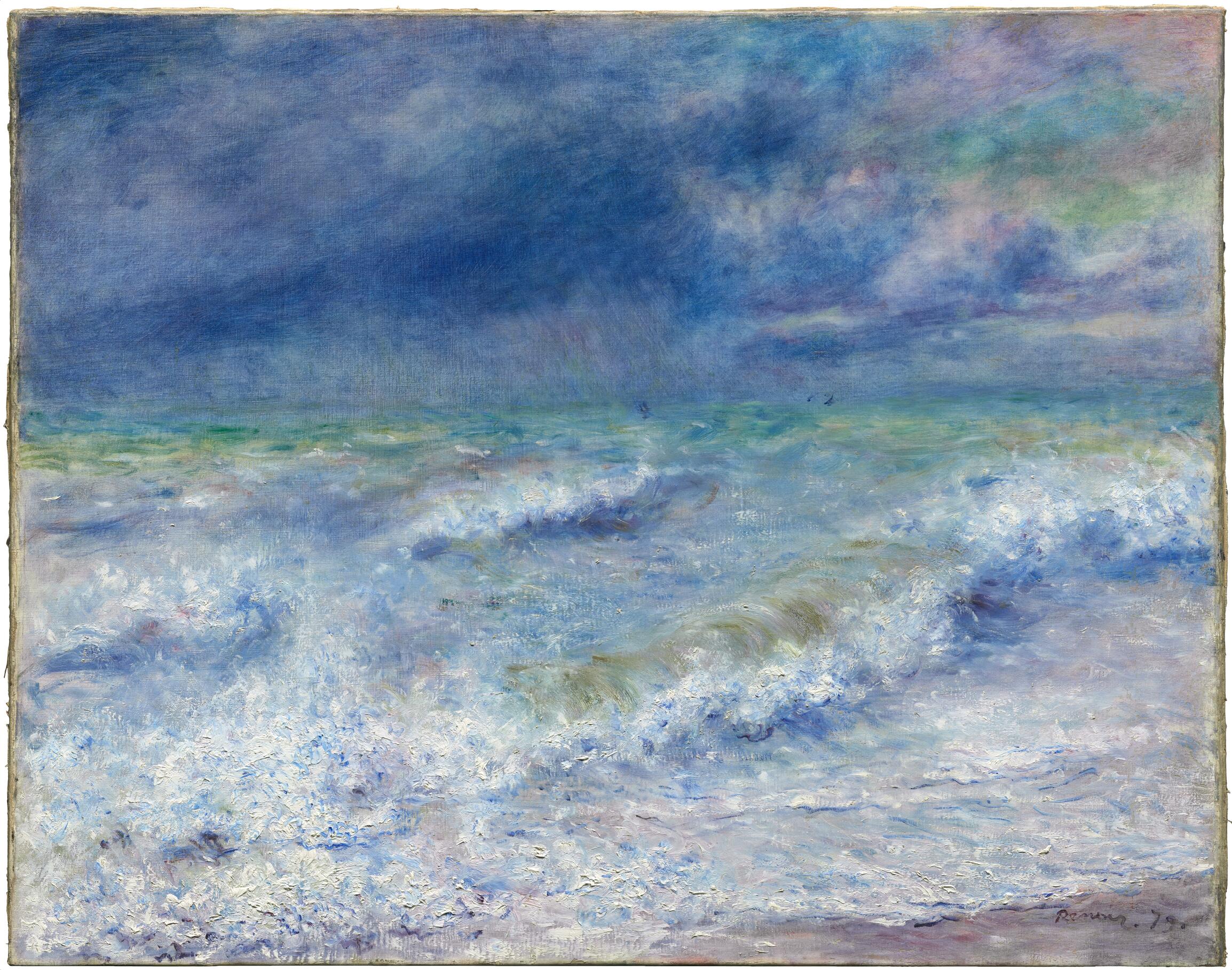
cat. 8 Seascape, 1879.
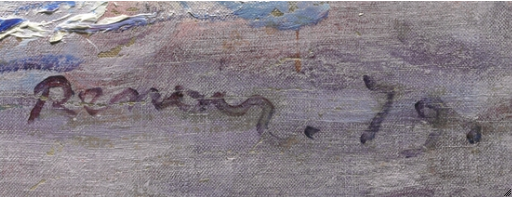
Detail of the signature in Renoir’s Seascape (1879). The Art Institute of Chicago, 1922.438.
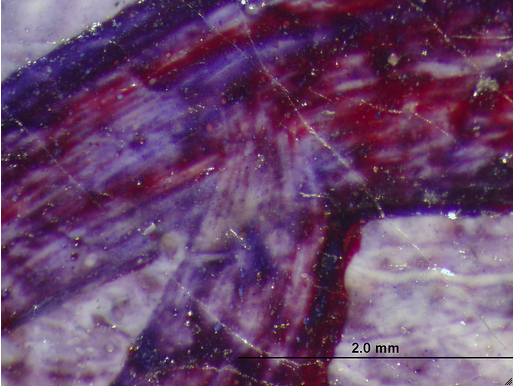
Photomicrograph of the signature in Renoir’s Seascape (1879) showing the mixture of cobalt blue and red lake pigments. The Art Institute of Chicago, 1922.438.
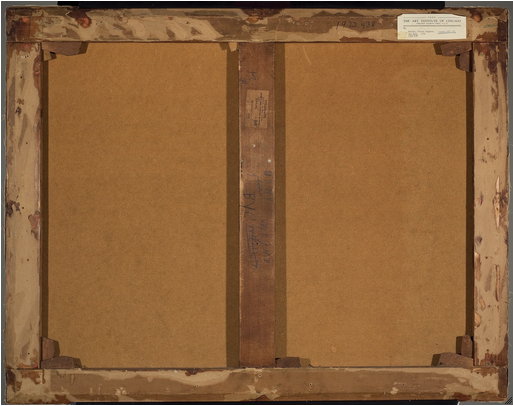
Verso of Renoir’s Seascape (1879). The Art Institute of Chicago, 1922.438.
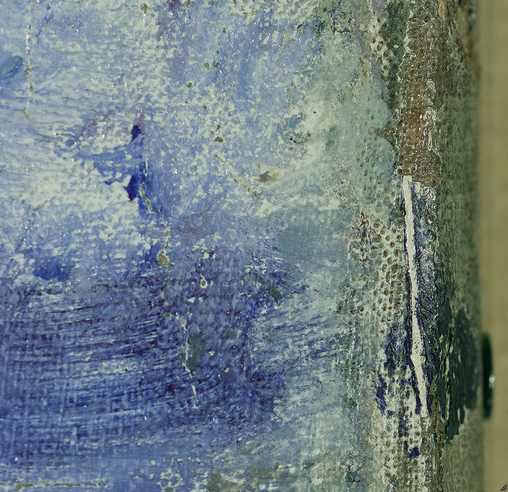
Detail of the right edge of Renoir’s Seascape (1879). What appears to be excess ground material was pushed over the edge with a palette knife. The Art Institute of Chicago, 1922.438.
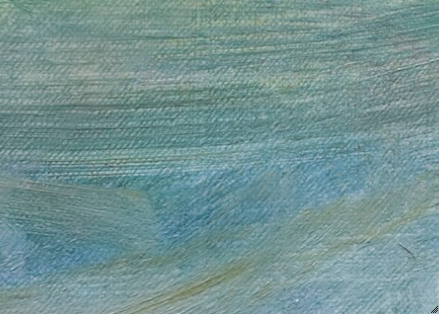
Detail of the horizon in Renoir’s Seascape (1879). The diagonal, brushy ground texture is visible through the thin, upper paint layers. The Art Institute of Chicago, 1922.438.
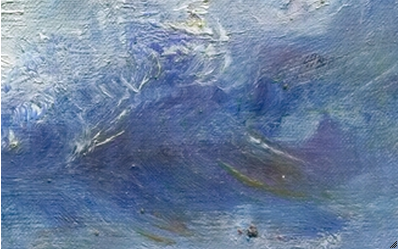
Detail of a wave in Renoir’s Seascape (1879) showing the artist’s use of translucent pigments to create visual depth. The Art Institute of Chicago, 1922.438.
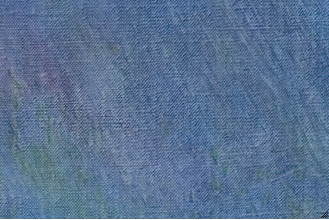
Detail of the sky in Renoir’s Seascape (1879) showing the complicated directional brushwork used to create the illusion of rain. The Art Institute of Chicago, 1922.438.
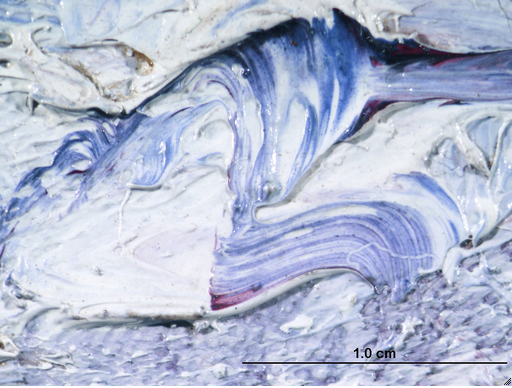
Photomicrograph of a wave in Renoir’s Seascape (1879) showing the minimally worked impasto. The Art Institute of Chicago, 1922.438.
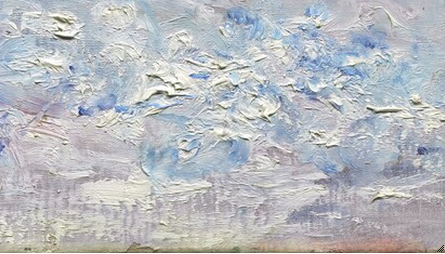
Detail of the froth on the lower left in Renoir’s Seascape (1879) showing possible palette-knife working and heavy impasto. The Art Institute of Chicago, 1922.438.
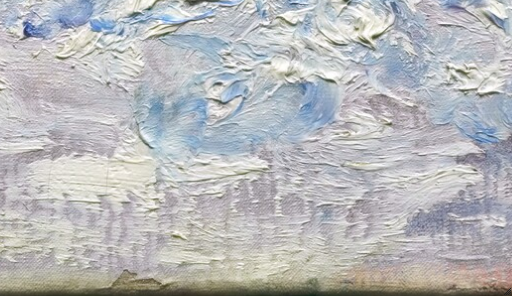
Detail of the shore in Renoir’s Seascape (1879) showing texture created by dragging a loaded brush across the surface. The Art Institute of Chicago, 1922.438.
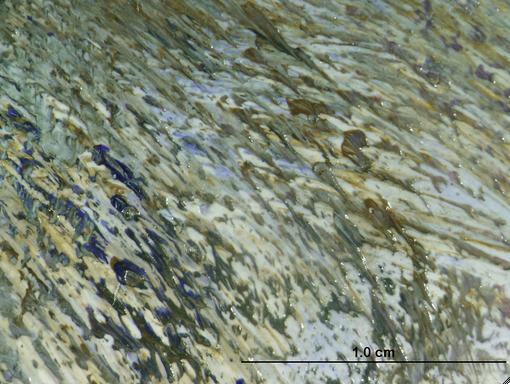
Photomicrograph of a wave in Renoir’s Seascape (1879) showing a variety of color and small strokes. The Art Institute of Chicago, 1922.438.
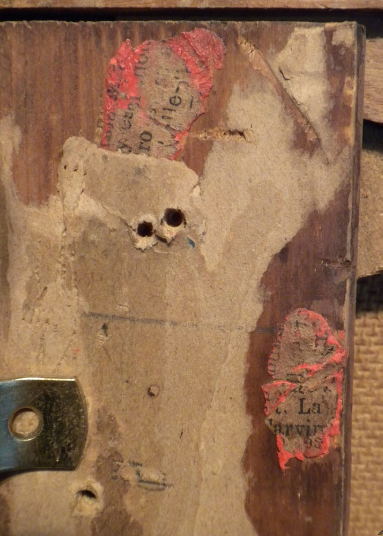
Detail of the verso of Renoir’s Seascape (1879). French newsprint under the paper tape suggests that the work was lined in France prior to its acquisition by the Art Institute. The Art Institute of Chicago, 1922.438.
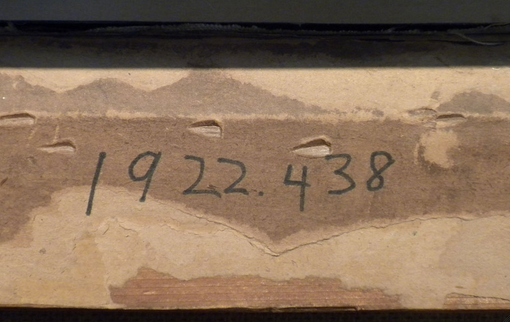
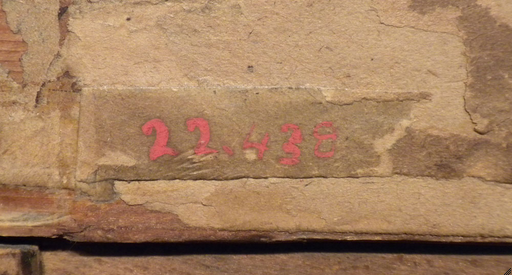
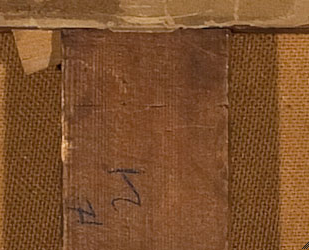
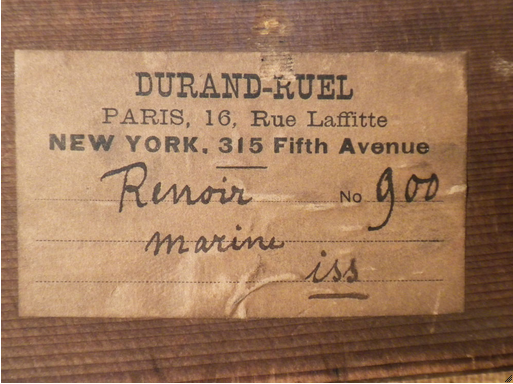
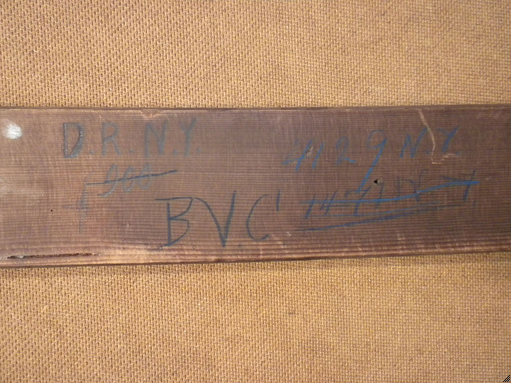
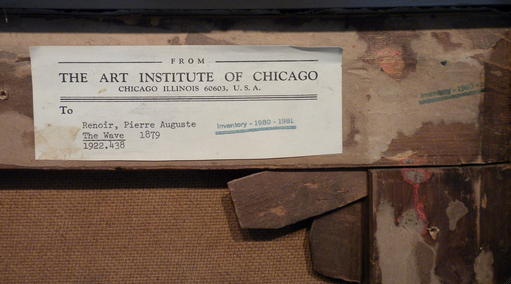

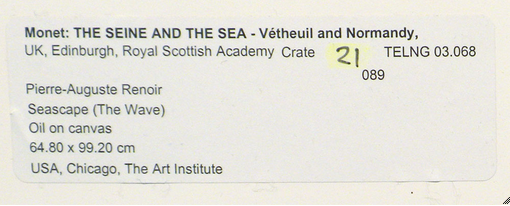
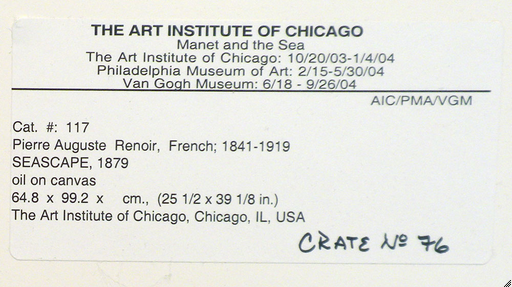
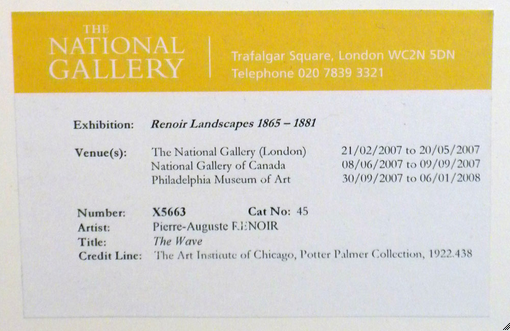
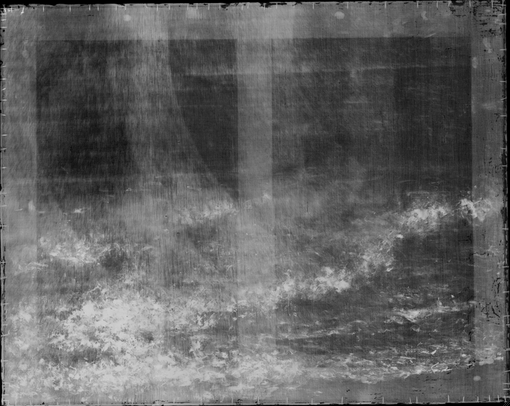
X-ray of Renoir’s Seascape (1879) showing the directional underpaint in the top left quadrant. The Art Institute of Chicago, 1922.438. X-ray digitally composited by Robert G. Erdmann, University of Arizona.
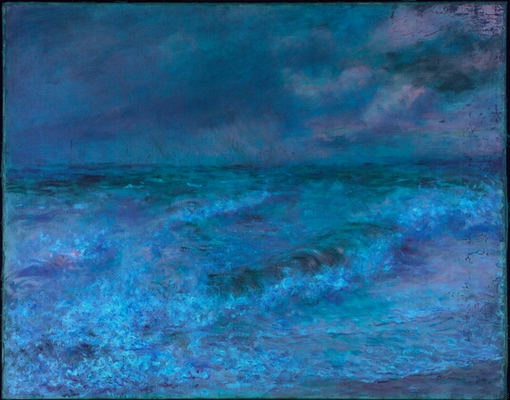
Ultraviolet image of Renoir’s Seascape (1879). Salmon-fluorescing red lakes are visible in the upper right sky, beach, and horizon line. The Art Institute of Chicago, 1922.438.
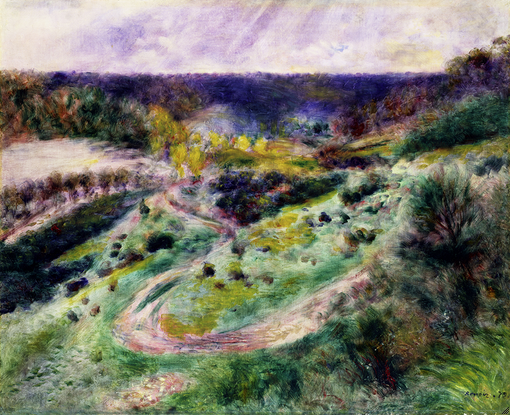
Pierre-Auguste Renoir (French, 1841–1919). Road at Wargemont, 1879. Oil on canvas; 80.6 × 100 cm (31 3/4 × 39 3/8 in.). The Toledo Museum of Art, Gift of Edward Drummond Libbey, 1957.33. Bridgeman Images.
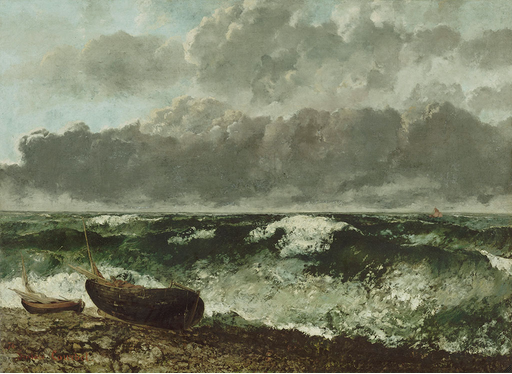
Gustave Courbet (French, 1819–1877). Stormy Sea, 1869. Oil on canvas; 117 × 160.5 cm (46 1/16 × 63 3/16 in.). Musée d’Orsay, Paris, RF 213. © RMN-Grand Palais / Art Resource, NY.
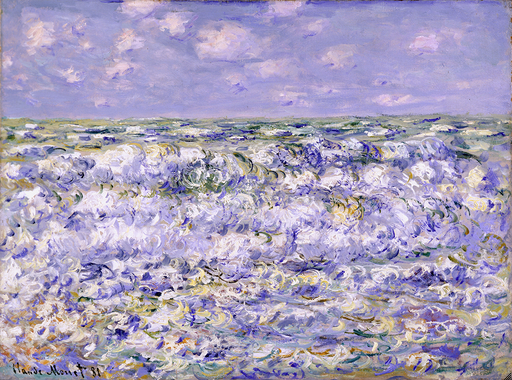
Claude Monet (French, 1840–1926). Waves Breaking, 1881. Oil on canvas; 60 × 81 cm (23 5/8 × 31 7/8 in.). The Fine Arts Museums of San Francisco, Gift of Prentis Cobb Hale, 1970.10. © Fine Arts Museums of San Francisco.
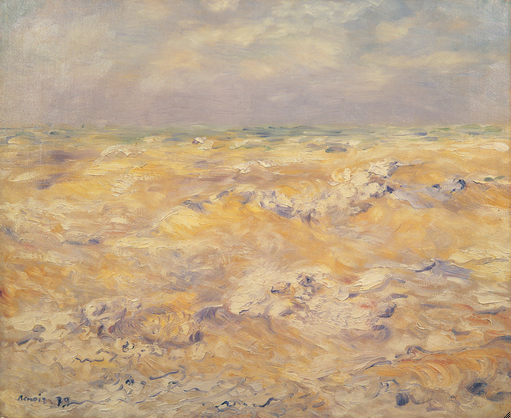
Pierre-Auguste Renoir (French, 1841–1919). The Wave, 1879. Oil on canvas; 54 × 65 cm (21 1/4 × 25 5/8 in.). Private collection.

Photomicrograph of a cross section from the ground layer in Renoir’s Seascape (1879) showing possible double ground application. Original magnification: 200×. The Art Institute of Chicago, 1922.438.
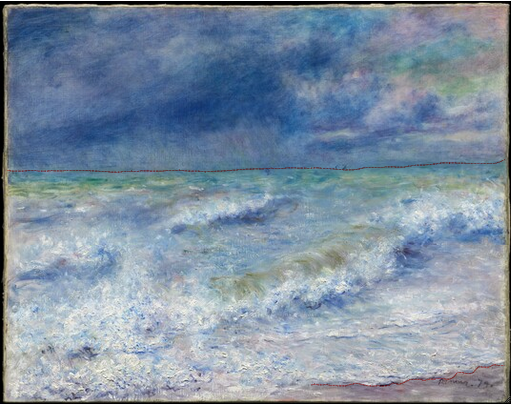
Renoir’s Seascape (1879). The Art Institute of Chicago, 1922.438. Interactive image.
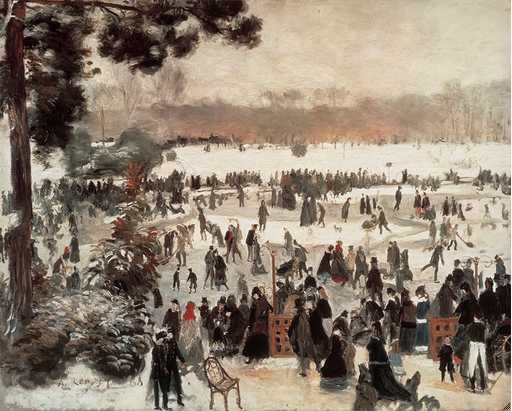
Pierre-Auguste Renoir (French, 1841–1919). Skaters in the Bois de Boulogne, 1868. Oil on canvas; 72 × 90 cm (28 3/8 × 35 7/16 in.). Collection of William I. Koch. Photo: akg-images.
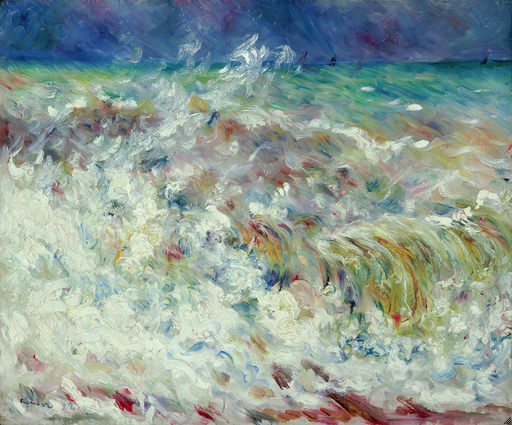
Pierre-Auguste Renoir (French, 1841–1919). The Wave, 1882. Oil on canvas; 54 × 65.1 cm (21 × 26 in.). Collection of The Dixon Gallery and Gardens, Memphis, Tennessee. Museum purchase from Cornelia Ritchie Bivins and Ritchie Trust No. 4, provided through a gift from the Robinson Family Fund, 1996.2.12.
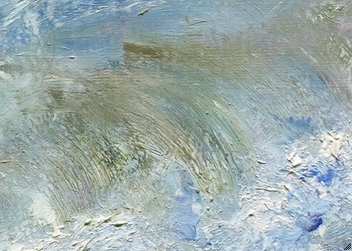
Detail showing multiple brush techniques and colors in Renoir’s Seascape (1879). The Art Institute of Chicago, 1922.438.
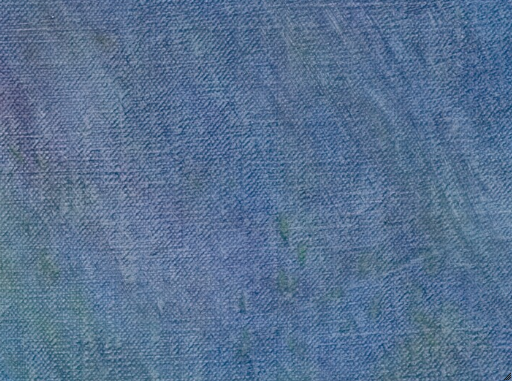
Detail showing rain in Renoir’s Seascape (1879). The Art Institute of Chicago, 1922.438.
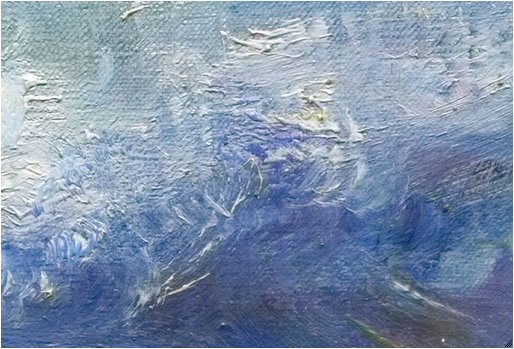
Detail showing foam in Renoir’s Seascape (1879). The Art Institute of Chicago, 1922.438.
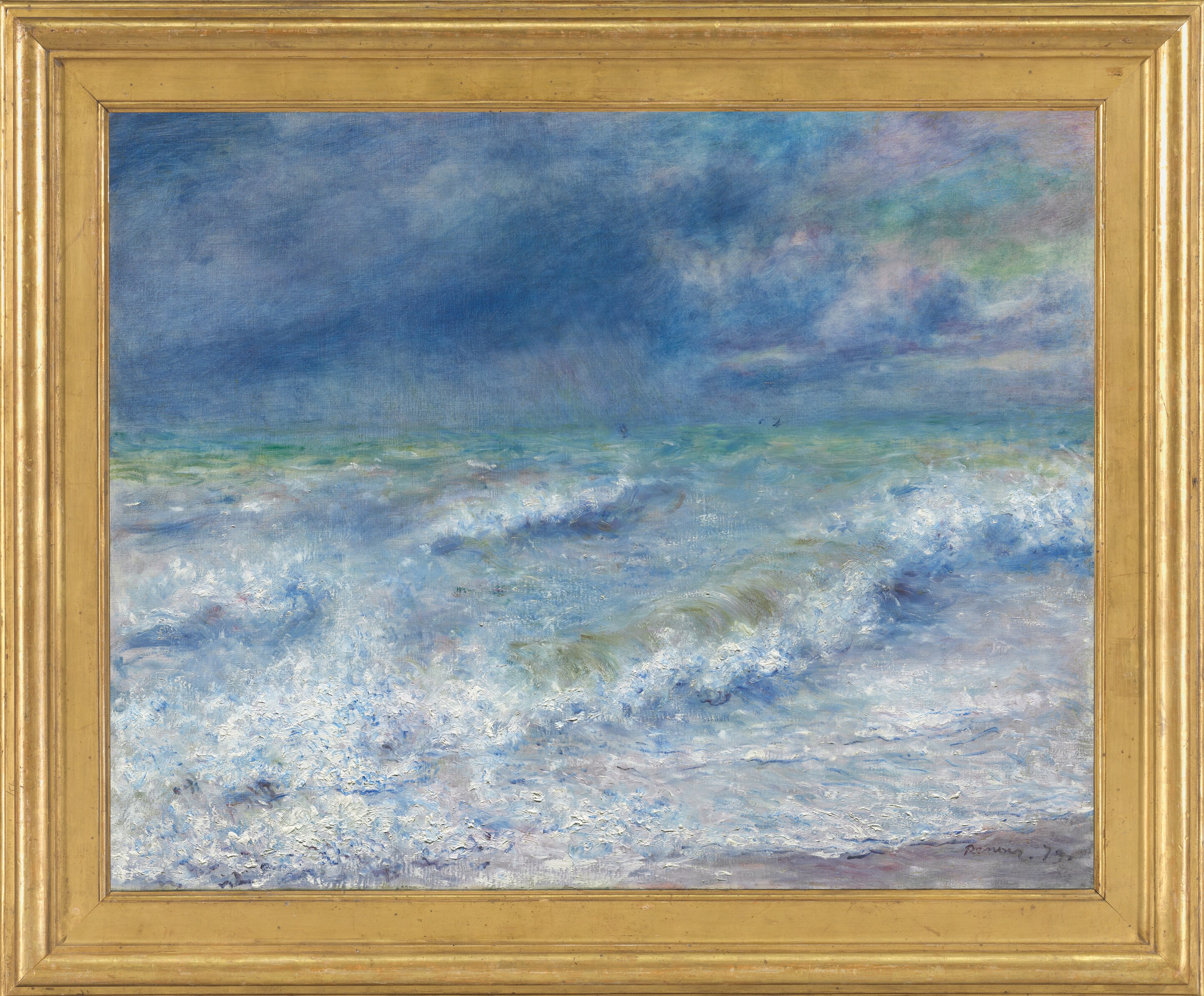
Renoir’s Seascape (1879) in its current frame. The Art Institute of Chicago, 1922.438.
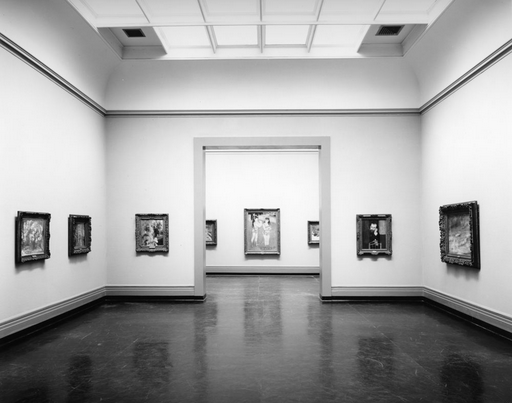
Renoir’s Seascape (1879) in a previous frame, gallery installation, c. 1960. Institutional Archives, Art Institute of Chicago.
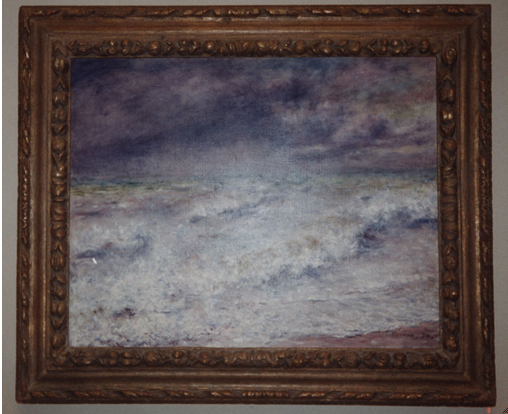
Renoir’s Seascape (1879) in a previous frame. The Art Institute of Chicago, 1922.438.
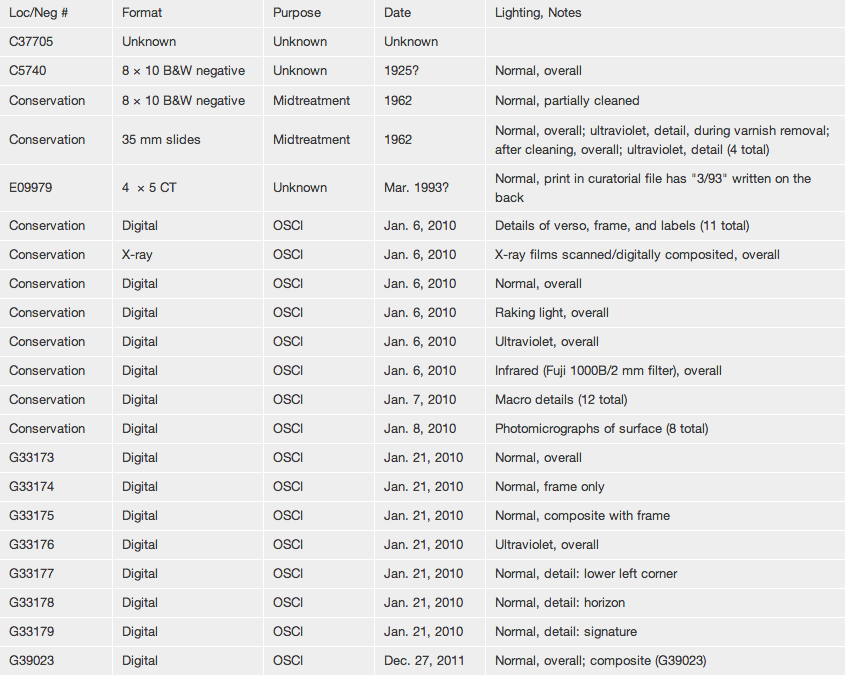
| Loc/Neg # | Format | Purpose | Date | Lighting, Notes |
| C37705 | Unknown | Unknown | Unknown | |
| C5740 | 8 × 10 B&W negative | Unknown | 1925? | Normal, overall |
| Conservation | 8 × 10 B&W negative | Midtreatment | 1962 | Normal, partially cleaned |
| Conservation | 35 mm slides | Midtreatment | 1962 | Normal, overall; ultraviolet, detail, during varnish removal; after cleaning, overall; ultraviolet, detail (4 total) |
| E09979 | 4 × 5 CT | Unknown | Mar. 1993? | Normal, print in curatorial file has "3/93" written on the back |
| Conservation | Digital | OSCI | Jan. 6, 2010 | Details of verso, frame, and labels (11 total) |
| Conservation | X-ray | OSCI | Jan. 6, 2010 | X-ray films scanned/digitally composited, overall |
| Conservation | Digital | OSCI | Jan. 6, 2010 | Normal, overall |
| Conservation | Digital | OSCI | Jan. 6, 2010 | Raking light, overall |
| Conservation | Digital | OSCI | Jan. 6, 2010 | Ultraviolet, overall |
| Conservation | Digital | OSCI | Jan. 6, 2010 | Infrared (Fuji 1000B/2 mm filter), overall |
| Conservation | Digital | OSCI | Jan. 7, 2010 | Macro details (12 total) |
| Conservation | Digital | OSCI | Jan. 8, 2010 | Photomicrographs of surface (8 total) |
| G33173 | Digital | OSCI | Jan. 21, 2010 | Normal, overall |
| G33174 | Digital | OSCI | Jan. 21, 2010 | Normal, frame only |
| G33175 | Digital | OSCI | Jan. 21, 2010 | Normal, composite with frame |
| G33176 | Digital | OSCI | Jan. 21, 2010 | Ultraviolet, overall |
| G33177 | Digital | OSCI | Jan. 21, 2010 | Normal, detail: lower left corner |
| G33178 | Digital | OSCI | Jan. 21, 2010 | Normal, detail: horizon |
| G33179 | Digital | OSCI | Jan. 21, 2010 | Normal, detail: signature |
| G39023 | Digital | OSCI | Dec. 27, 2011 | Normal, overall; composite (G39023) |
| G39024 | Digital | OSCI | Dec. 27, 2011 | Ultraviolet, overall |
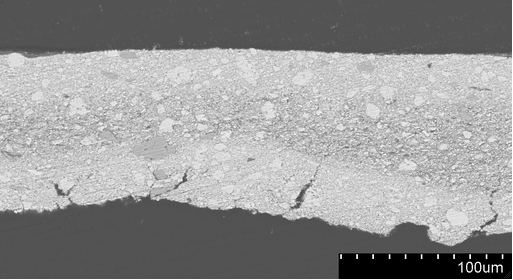
Backscattered electron image of a cross section of the ground in Renoir’s Seascape (1879) showing double application of the ground. Original magnification: 400×. The Art Institute of Chicago, 1922.438.
Acrobats at the Cirque Fernando (Francisca and Angelina Wartenberg)506
1879507
Oil on canvas; 131.2 × 99.2 cm (51 1/2 × 39 1/16 in.)
Signed: Renoir. (lower left, in blue-purple paint)
The Art Institute of Chicago, Potter Palmer Collection, 1922.440
As a septuagenarian long retired from the circus ring, Angelina Wartenberg, the model for the girl on the right in this painting, wrote in 1938 from her home in London to her niece, Marguerite Streckfus, of San Rafael, California: “I am sending you now a little picture that will interest you [Acrobats]; it is your mother [Francisca] and myself when we were beginning our careers as Circus Kids; the big one is of course your dear Ma, being three years my Senior—so you see, I am the greedy one, and collar most of the oranges the public pelted us with.”508 In this delightful firsthand account from a Renoir model, Angelina clarified that she and her sister were not jugglers, as the artist’s biographer Georges Rivière identified them in 1921, but rather were participating in a traditional ritual of appreciation shown toward child performers in the circus. This custom was recounted by Edmond de Goncourt in his novel Les frères Zemganno, published in 1879, in which a child gymnast, age five, receives a similar ovation.509 Until Angelina’s reminiscences became known, the girls’ identities had long been forgotten; indeed, they appear to have been irrelevant to Renoir when he described the work in the early twentieth century to the art dealer Ambroise Vollard as “des fillettes jouaient avec des oranges.”510 The models may simply have represented for Renoir a generalized subject of leisure entertainment in the Third Republic. Throughout the nineteenth century, clowns and acrobats brought distraction and momentary joy to Parisian audiences. During the 1870s, the Wartenberg girls were just two of a teeming multitude of itinerant circus performers who passed through Paris—to date no notice of their performance has come to light in the daily schedules of circuses that appeared in city newspapers—yet Renoir endowed them with an elegance of form and a sensitivity that is usually associated with portraiture. His models would be forgotten today were it not for the serendipitous introduction of biographical detail in 1938, which transformed Acrobats into a noncommissioned portrait, allowing us to test the accuracy of the artist’s rendering.
The artist’s brother Edmond Renoir attested to the truthfulness of the representation in an article of 1879 for La vie moderne, in which he used the painting’s correct title, Acrobats, and praised it as “authentic to modern life,” though without mentioning the names of the models, their family background, or details of their routine.511 His comments appeared in a short biographical sketch written on the occasion of an exhibition primarily of pastels held at the office of La vie moderne in June: “Quite apart from its artistic value, his work has all the distinctive charm of an authentic scene of modern life. What he has painted, we see every day; it is our own existence that he records in passages [pages] which will surely remain among the most vivid and harmonious of their time. Thus for the Acrobats the arrangement really doesn’t matter. One could say that by a process of incomprehensible subtlety and instantaneity, he has captured the actual movement of the two children. It’s just the way they walked, bowed, smiled in the circus ring. I will not use big words like realism or impressionism to say that this is real life with all its poetry and all its character.”512
This article functions less as a review than as a survey of Renoir’s artistic development. Here we learn for the first time of Renoir’s teenage years as a porcelain painter; of his first painting, Eve and the Serpent; of his debt to artists such as Gustave Courbet and Narcisse Diaz de la Peña.513 Mention is made of major Renoir paintings including Lise (1867; Museum Folkwang, Essen [Daulte 29 Dauberville 283]), Dance at the Moulin de la Galette (1876; Musée d’Orsay, Paris [Daulte 209; Dauberville 211]), and Madame Georges Charpentier and Her Children (1878; Metropolitan Museum of Art, New York [Daulte 266; Dauberville 239]), a painting then on view at the Salon of 1879, depicting the family of the publisher of La vie moderne.514 Edmond’s lengthy discussion of Acrobats follows this list of Renoir’s major accomplishments. La vie moderne was an odd choice of venue for the debut of this large painting, which was of a scale one might have expected to see at the Salon. It must have looked out of place among the smaller pastels. A second review in La presse, possibly also written by Edmond under a pseudonym, is only slightly more helpful in describing the exhibition as comprising “about thirty works, portraits in pastel, landscape paintings, decorative sketches.” This second review also highlights the poetic reality (“poésie réelle”) of Acrobats, though it suggests that the satin costumes worn by the girls were originally pink.515
Douglas Druick has challenged Edmond’s contention that Acrobats is absent of convention or artifice.516 The warmth of the flesh tones of the two girls, the luminosity of their pink tights, wrinkled at the knee, and the bright tones of the white and yellow costumes all suggest that they were painted in natural light, rather than the harsh artificial light of the circus arena. Such lighting repelled Renoir because it contorted faces and transformed gestures into distorted caricature.517 This would imply that while the background may have been painted in situ, at the circus—a hypothesis supported by the accurate yet schematic treatment of the spectators and the environment—the girls themselves may not have been.
While Edmond claimed that his brother portrayed the Wartenberg sisters just as they moved in the circus ring, there is nothing about their poses that conveys how they might have performed. The static appearance of the girls’ positions may be the result of a studio setting. Renoir endowed his young acrobats with all the elegance of ballet dancers in their gestures and postures, which mimic ballet’s third (Angelina) and fourth (Francisca) positions.518 Renoir’s initial painted guidelines for the legs of the figures, visible in transmitted- and reflected-infrared images of Acrobats (fig. 2.52), suggest that he later adjusted Angelina’s feet so that they overlap slightly and placed Francisca’s left leg farther from her right in order to make this point precisely. Such a portrayal of the Wartenberg sisters is not consistent with the sensationalism and physical daring of their tableau vivant and human pyramid acrobatic acts. Renoir’s presentation of the girls in a way that equates them with the highbrow world of the ballet is a prime demonstration of his “oeil bienveillant,” or what Colin Bailey has referred to as “aesthetic leveling.”519
The elegant poses and full-length treatment of the figures in Acrobats recall Renoir’s earlier painting of an aspiring child performer, The Dancer (fig. 2.56) [Daulte 110; Dauberville 493]), exhibited at the first Impressionist exhibition, which opened in April 1874.520 With dimensions of 142.5 × 94.5 cm, The Dancer is just eleven centimeters taller and five centimeters narrower than Acrobats, which was executed on a no. 60 portrait (figure) standard-size canvas. Renoir’s ballerina appears to be a younger trainee known as a “rat de l’Opéra,” commonly of an age between eight and fourteen.521 In Acrobats Renoir drew on the same strategy of harmonized color application throughout the canvas that he used in The Dancer, which is dominated by cooler tones—blues and greens, with blue accents in the shadows of the shimmering white ballet costume. Acrobats was rendered in a contrasting palette of mostly yellows and oranges. The costumes of the two Wartenberg girls, from the yellow boots to the tassels and stars to the ribbons in their hair, serve to establish a color theme. Renoir then developed the color harmonies in the extensive use of yellow in the arena floor, which acts essentially as a diaphanous background of the kind he presented in The Dancer.
Additional evidence exists that Renoir’s portrayal departs from the actual circumstances of the girls’ performance. A rare preliminary study for Acrobats, a chalk drawing executed on canvas, includes a clown in the bottom right (fig. 2.57), and, in fact, the two young girls likely would have shared the arena with other circus acts.522 The absence of the clown in the painting and the centering of the Wartenberg sisters in the composition subdue the ribald ambience of the circus in order to better focus on the girls’ contentment and pleasure at collecting the oranges, thus giving this circus genre painting a stronger emotional impact. It is evident from the drawing that Renoir had already decided on the raised point of view with its limited details of the circus arena and the unusual balletic poses.523 In the painting, the circus-ring wall is taller and closer to the top of the composition, eliminating all but one of the spectators’ faces and leaving only the legs of the staff and other performers waiting their turns, thus further distancing the children from the boisterous adult realm of the circus arena.
Francisca and Angelina were the eldest siblings in a family of Franco-German gymnasts. There were seven Wartenberg children by the mid-1880s, all of whom collaborated in performances such as “le Montagne,” a variation on the human pyramid (fig. 2.58). As anchors for the pyramid, Angelina and Francisca were of a robust and muscular build by that time, much more physically developed than their diminutive likenesses in Renoir’s painting. A promotional photograph of the Wartenberg children performing in Saint Petersburg, possibly from 1880, shows the two older girls with two of their younger siblings, who appear to be about five or six years old (fig. 2.19).524 In this photograph, Angelina and Francisca look more mature than they do in the painting. As the two appear alone in Renoir’s Acrobats, presumably either none of their siblings were old enough to participate in the act, or the two were performing as a duo on that occasion.
Angelina was baptized in Berlin on March 13, 1864, by her parents, Carl Richard Ludwig Wartenberg, “Gymnastischer Künstler,” and Joséphine Hermine Wartenberg, née Decamps.525 While Angelina stayed in London after the family became naturalized British citizens in 1889, Francisca sought opportunity as a circus performer in the United States (fig. 3.60) where she eventually married George Sebastian Miehling, a “professional instructor” at the Olympic Club of San Francisco.526
Variously ascribed dates from 1868 to 1882 within Renoir’s lifetime, the current accepted dating of Acrobats to 1879 (based on the painting’s first appearance at exhibition) would mean that Angelina and Francisca are shown at the ages of fourteen and seventeen, respectively.527 Earlier references to the painting suggest that the models were perceived as younger. In her 1938 letter to her niece, Angelina stated that Renoir portrayed the sisters as “Circus Kids” at the beginning of their careers. In 1879 Edmond Renoir referred to the girls as “enfants” in his review in La vie moderne, and Paul Durand-Ruel recorded the painting’s title as Les petites acrobates when it was deposited by Renoir in April 1881.528 Renoir himself referred to them as “fillettes” (little girls)—a term not usually applied to postpubescent teenagers. Acquired by Potter Palmer from Durand-Ruel in May 1892 as Dans le cirque, the painting carried the title Two Little Circus Girls for more than fifty years in the collection of the Art Institute of Chicago.529 The firm handling of the figures, the signature, the elevated point of view, and the thematic emphasis on the color yellow all point to Renoir’s Impressionist style of the later 1870s, such as that seen in Mussel Fishers at Berneval (fig. 2.5 [Daulte 292; Dauberville 215]).530 Clearly the lighting and the elegance of the poses of the two models were not the only aspects of the painting with which Renoir took license.531
Angelina’s letter of 1938 suggests that the Wartenberg family enjoyed a happy and thriving life in the circus. This was not the case for other circus troupes that included young children. Fernand Pelez’s Grimaces and Misery (The Saltimbanques), shown at the Salon of 1888 (fig. 2.8), is a sad testimony to the common exploitation of children, who were often unwillingly pressed into a life of grinding poverty and long hours. Pelez practiced a style of Realism compatible with the novels of Émile Zola, who often wrote about the harsh conditions of urban living for the lower classes. In his description of his brother’s painting Acrobats as “real life with all its poetry and character,” Edmond pointed to an alternative kind of Realism, one that sought beauty and dignity in those conditions and in the most lowbrow of popular distractions. Edmond de Goncourt made the same argument when he called for a “roman réaliste de l’élégance” in the preface to Les frères Zemganno.532 In creating a circus performer who was a sympathetic figure with complex emotions, Goncourt followed the example of writers such as Charles Baudelaire and the Parnassian poet Théodore de Banville, who endowed the circus theme with a new level of literary significance.533
In 1868 Renoir departed from his usual routine of preparing large-scale paintings for the Salon to fulfill a request from a café owner at the Cirque Napoléon (today the Cirque d’Hiver) for a portrait of the clown James Bollinger Mazutreek (fig. 2.9 [Daulte 38; Dauberville 230]).534 The Impressionists were often drawn to the circus as a subject of modern life, but in this painting the artist did not convey the spectacle of performance. Rather, in the calm poise of Mazutreek’s bearing and the outstretched gesture of his bow arm, Renoir presented the performer in a pose that recalls the Apollo Belvedere (albeit an unusually frizzy-haired version), just as he later elevated the popular context of Acrobats by showing it through the lens of high art. The natural light in which the Wartenberg sisters are portrayed sets Acrobats apart from the earlier Clown, in which Mazutreek’s painted white face gives off an eerie luminosity, while his dark, butterfly-bedecked costume and the dull brown of the circus floor absorb rather than reflect the light. In both circus paintings, Renoir altered how the subject was generally viewed. As his brother Edmond asserted, Renoir created a “poetic reality” out of the discordant atmosphere of the circus ring. In doing so, he drew on his gifts as a portrait painter to see beyond the thespian mask, thus drawing attention to the acrobats as sensitive individuals.
The year 1875 marked an important milestone in French circus history, with the completion in June of the Cirque Fernando’s permanent building in Montmartre at the corner of the boulevard de Rochechouart and the rue des Martyrs, just a short walk from Renoir’s rue Saint-Georges studio. Though never specifically identified as such during Renoir’s lifetime, it is likely that the Cirque Fernando is the setting for Acrobats.535 From 1873 to 1875, the Cirque Fernando operated at the site under a temporary tent supported by a timber structure strong enough to hold a musician’s box; this box can be seen in Maurice Blum’s Rehearsal at the Cirque Fernando, which was accepted to the Salon of 1874 (fig. 2.10).536 The multiple figures shown at work in this painting provide evidence that individual performers often shared the arena with other acts or roaming clowns.
Acrobats is not simply a return to a favorite leitmotif, or a variation on the theme of popular culture; it can be interpreted as a parable of childhood experience in the commercial world of leisure in nineteenth-century Paris. The appearance of children in Renoir’s Impressionist work often symbolizes the same joy and happiness he intended to convey with the presence of sunlight.537 It is significant that, in returning to the subject of the circus later in life, he chose to portray his own sons—Jean as Pierrot (fig. 2.11 [Dauberville 2390]) and Claude as a clown (fig. 2.14 [Dauberville 3455]), at the ages of seven and seven or eight, respectively—as if the world of the funambule were a rite of passage.538 These portraits depict whimsical, costumed role-playing, but they also evoke Renoir’s working-class roots and a youth spent enthralled by the theatrical life of the boulevard du Temple.539
John Collins
Renoir began this painting with a large, no. 60 portrait ([glossary:figure]) standard-size canvas with a commercially applied white [glossary:ground]; a [glossary:radio-opaque] area in the [glossary:X-ray] as well as areas of visible palette-knife texture may indicate that either the artist or the [glossary:color merchant] added more ground material locally or overall to the compositional area.540 Renoir executed a gestural contour drawing of the figures in deep-blue paint, making many alterations and adjustments to each figure before settling on the final composition.541 There are also indications that finer drawing, perhaps in [glossary:graphite], is present in the faces of the figures. The figure on the right appears to have been more forward-facing and slightly bent at the waist, while the figure on the left may have stood with her legs closer together, slightly to the left of their current position, and with a more arched back and curved arms. Though some of these changes were painted out, others (such as the hands of the figure on the left) remain visible under normal viewing conditions due to the translucence of the background paint. In the background and upper portion of the composition, thinned [glossary:oil] paint, translucent [glossary:pigments] such as red lake, and the artist’s use of wiping and scraping combine to create an overall lightness and render the ground visible. The two figures were executed in a series of [glossary:wet-in-wet] campaigns over, in some areas, a still-wet [glossary:underdrawing]. Often the underdrawing functions as a cool shadow along the edges of forms, as in the figures’ tights. Final touches of opaque paint and [glossary:impasto] appear only on selected areas of the figures, mostly in the embellishments on their costumes.
The multilayer interactive image viewer is designed to facilitate the viewer’s exploration and comparison of the technical images (fig. 2.36).542
Signed: Renoir. (lower left, in blue-purple paint) (fig. 1.2, fig. 1.1).543
Flax (commonly known as linen).544
The original dimensions of the canvas were approximately 130.5 × 97 cm, measuring from the original [glossary:foldover]. This is close to pretreatment measurements that list the painting at 130.8 × 97 cm, which closely correspond to a no. 60 portrait (figure) standard-size (130 × 97 cm) canvas.545
[glossary:Plain weave]. Average [glossary:thread count] (standard deviation): 28.1V (1.2) × 29.4H (0.6) threads/cm. The horizontal threads were determined to correspond to the [glossary:warp] and the vertical threads to the [glossary:weft].546
The canvas is relatively fine, especially considering its size, and has extremely faint [glossary:cusping] along all four sides, corresponding to the placement of the original tacks. The [glossary:warp-angle map] (horizontal threads) indicates [glossary:primary cusping] along the lower edge from the commercial preparation process (fig. 2.35).547
Current stretching: When the painting was relined in 1972, the original dimensions were increased slightly on all sides.
Original stretching: Based on cusping visible in the X-ray, the original tacks were placed approximately 7–8.5 cm apart.
Current [glossary:stretcher]: Four-member redwood [glossary:ICA spring stretcher]. Depth: 2.5 cm.
Previous stretcher: Six-member keyable stretcher with vertical and horizontal crossbars. Depth: Unknown. Since the painting was lined at some point before this stretcher was removed in 1972, it is unclear whether it was the original stretcher.
No manufacturer’s or supplier’s marks were observed during the current examination or documented in previous examinations.
[glossary:Cross-sectional analysis] indicates a very thin, brownish layer of material between the ground and the [glossary:canvas] that closely follows the canvas texture. This material has a blue fluorescence in UV, is organic in nature, and is estimated to be glue (fig. 2.49).548
The canvas is coated with a commercial [glossary:priming] layer approximately 5–75 µm thick, that fills the [glossary:weave] and extends to the edges of the [glossary:tacking margins].
Renoir or a color merchant may have added more ground material in some areas, or perhaps an overall but very uneven layer.549 A horizontal band just above the center of the painting appears more radio-opaque in the X-ray, suggesting thicker application. Elsewhere, rough palette-knife marks appear in this white layer, creating a play of texture beneath the thinly painted surface (fig. 2.20). The artist painted the background largely in thin, translucent layers with a stiff-bristle brush that cut through to the ground beneath, exploiting its light, reflective qualities.
The ground is white, with no additional particles visible under stereomicroscopic or cross-sectional examination (fig. 1.3).
The commercial ground is a single layer, predominantly lead white with a small amount of calcium-based white (including calcium sulfate) and trace amounts of alumina, silica, and iron-containing complex silicates. The additional selective [glossary:preparatory layer] is also mostly lead white with some calcium sulfate and barium sulfate.550 The [glossary:binder] for both layers is estimated to be oil.551
Infrared examination suggests that Renoir sketched some of the major features of the figures, including the heads, hands, and legs, in long, sometimes very gestural lines (fig. 2.22). These contours appear to constitute the initial phase of the paint layer and in some areas were worked wet-in-wet into the flesh tones, where they appear as shadows (fig. 1.4). The brushstrokes vary greatly in thickness and assurance, with longer lines along the figures’ legs and shorter, broader, more gestural strokes made with a wider brush in other areas, such as the left figure’s hands and arms. Looking closely at the infrared image, it is also possible to see finer drawing throughout the figures’ faces (fig. 2.23).552
The contour sketch was executed in fluid, blue paint, while the finer drawing may be in a dry medium such as graphite.
It is unclear to what extent the underdrawing lines were worked into the paint layer and thereby obscured, but there are visible changes to both figures. The speed with which the artist executed the many iterations of each figure resulted in a series of underdrawing lines in relatively close proximity that can be difficult to decipher.553
Underdrawing lines for the right figure suggest that she may have originally been shown somewhat bent at the waist, leaning slightly to her left, and holding a mound of oranges topped by four of the fruits rather than three (fig. 2.42).554 Lines sketching wider legs and a fuller costume around the waist and hips can also be discerned. Around the head, Renoir painted out his changes, and thus it is unclear to what extent the head was realized before he executed its final position. Eventually he straightened the figure’s posture and rotated her left shoulder and hip backward. The arms and the placement of the elbows and fingers were adjusted numerous times. A set of lines also indicates that this figure’s legs may have been positioned side by side, rather than slightly overlapping, so that the shadow between the legs as well as the outer edge of the figure’s left leg were both further to the right. A combination of turning the figure’s upper body and moving her left leg slightly in front of her right, into ballet’s third position, resulted in legs that appear slimmer and more compact.555
The artist also made changes to the arms and legs of the left figure; he adjusted the precise angle of the arms at each of the major joints (shoulder, elbow, and wrist) numerous times before arriving at the final placement (fig. 2.43). The nature of the underdrawing lines indicating the left figure seems more gestural, aimed at determining the pose and general placement of the figure rather than delineating specific anatomical features. The lines for the figure’s hands, arms, and lower legs, for example, appear impossibly curved and likely served to work out the sense of movement in her pose. Lines visible in the infrared image also suggest that the figure’s left leg was initially further to the left, directly below and in line with her ear and the back of her head.556 Renoir moved the left leg away from the right, into ballet’s fourth position, in line with the figure’s profile; the angle of her right foot was also turned out further, so that her laces face the viewer. A painted line further to the right that echoes the shape of this leg may indicate yet another previous placement, or that the leg was once wider.
Renoir executed a contour sketch of the figures in blue paint, adjusting their postures many times before settling on the visible composition. In many areas, these sketched lines appear to have been wet when the upper paint layers were added, and as a result they were partially, and in some cases entirely, incorporated into these layers. Transmitted- and reflected-infrared imaging and [glossary:X-radiography] indicate that many of the changes were made in the underdrawing stage and not executed in heavier paint before additional alterations were made. The artist exploited the coolness of these lines in relation to the other colors in the painting, bringing smooth, blended figure-ground transitions over them to create a blue shadow around the edges of the figures, especially in the flesh tones and tights (fig. 2.24). In other areas, where the contours of the underdrawing deviate greatly from the surface composition, the lines can be seen under normal viewing conditions as echoes of existing forms or dark, somewhat muddy areas. For instance, on each side of the right figure’s legs, parallel curving lines are visible, evidence of previous compositional forays. In some areas, the underdrawing material was swept into the upper layers to varying degrees, necessitating a more opaque application of background colors to completely cover the white ground, as in the area around the left figure’s hands (fig. 2.25). In other places, the visibility of changes between the underdrawing and the surface composition is diminished by the addition of white or very light-colored paint before the application of the background, for example, above and to the right of the right figure’s head (fig. 2.26).
The artist made minor changes to the two figures in the painting stage, slimming the legs and lowering the eyelids of both. The pointed chin of the figure on the right was softened, her neck was widened on the left side, and the costume embellishment was brought up around the nape of her neck; the overall effect of these alterations is that the once heart-shaped face now looks more elongated and oval-shaped. The left figure’s profile in the underdrawing and early paint stages appears fine featured, with a diminutive nose and small chin. The chin was preserved, but the nose was enlarged and the lips brought forward so that the figure now appears to have an overbite in profile.
The work is very thinly painted, and the paint was applied using stiff-bristle brushes that scratched through the paint layers to the ground. Renoir used wiping and scraping, especially in the background, to increase this effect and give the paint layer additional translucency, making use of the reflective qualities of the ground. The almost watercolor-like appearance of the paint in some areas indicates that the artist thinned his paints with turpentine or a turpentine-and-oil mixture. In contrast with much of the background, the figures are painted in flat, medium-rich layers of opaque paint and feature smooth transitions, both between light and shadow and between figure and ground. The figures were executed in a series of wet-in-wet campaigns with soft brushes, and Renoir sometimes used an array of colors in a single area (fig. 2.27). The upper portion of the painting seems to have been executed mostly freehand and wet-in-wet, with an initial campaign of broader [glossary:modeling] primarily with translucent browns, black, and red lake, followed by a campaign of details, contours, and patches of opaque paint (fig. 2.28). In some areas showing the audience, the paint appears to have been partially rubbed away with a cloth or other soft material, leaving a thin film of paint, mostly in the interstices of the weave. In the left figure’s hair, for example, a thin [glossary:reserve] was created for the bow; after the hair was painted, the artist seems to have wiped away some of this paint before adding heavier, opaque details for the bow (fig. 2.29). The final touches of white and yellow impasto are generally limited to decorative details on the figures’ costumes (fig. 2.30).
Soft- and stiff-bristle brushes with strokes up to 1 cm wide; cloth and/or [glossary:palette knife] for wiping and scraping; small palette knife for specific details such as the orange rinds.
Analysis indicates the presence of the following pigments: lead white, cobalt blue, cerulean blue, vermilion, emerald green, chrome yellow, red lake, iron oxide red and/or yellow, and bone black.557
The observation of a characteristic salmon-colored [glossary:fluorescence] under [glossary:UV] light suggests the presence of a fluorescing red lake in the flesh tones, details of the figure’s boots, and parts of the background (fig. 2.31).558
Cross-sectional analysis also suggests that some of the pigment mixtures employed in this painting were quite complex. A sample from the orange on the ground between the two figures, for example, contains a mixture of vermilion, red lake, chrome yellow, lead white, and cobalt blue, with traces of iron oxide red and/or yellow.559
Oil (estimated).560
The work has a [glossary:synthetic varnish] with residues of [glossary:natural-resin varnish] in areas of impasto. The synthetic varnish dates from the 1971–72 treatment, and the previous natural-resin varnish may date from a 1922 cleaning. Though the work was varnished in 1922, it is unclear whether it had been varnished prior to that time.
Early documentation indicates that the work was first treated, cleaned, and varnished on April 20, 1922.561 A 1937 document requests an estimate for a wax [glossary:lining] from Chicago conservator Leo Marzolo; there is, however, no evidence that this treatment was ever completed.562 A 1955 loan condition report notes a “gouge” along the left side near the bottom and heavy abrasion on the lower right.563 The work was treated again in 1971–72, when it was recorded as having an [glossary:aqueous lining] and a discolored natural-resin varnish.564 Before this 1971–72 treatment, the work also had small holes with associated vertical abrasion, as if it had fallen or scraped against an unidentified surface. During this treatment, grime, varnish, and the lining were removed, and the work was faced with mulberry-fiber paper and starch paste in preparation for lining. The old six-member stretcher was discarded when the work was wax-resin lined, and the lined painting was tacked onto a four-member redwood ICA spring stretcher of slightly larger dimensions (131.1 × 99.1 cm). The work was inpainted and given a synthetic varnish (an isolating layer of polyvinyl acetate [PVA] AYAA, followed by methacrylate resin L-46, [glossary:inpainting], and a final coat of L-46). In 2008 part of the original tacking margin was found to be delaminating from the lining; this area was consolidated.565
The painting is in good condition: it is planar with a stable [glossary:wax-resin lining] and an even synthetic varnish. The work is damaged in a few places, and there is some minor age cracking intermittently throughout the figures’ costumes. The overall abraded look of the background is the combined effect of the artist’s wiping away paint layers and damage to the thinly painted areas due to the lining procedure. The lining process also increased the weave impression overall. There are a few minor losses that have been retouched, and there is slightly discolored [glossary:retouching] around the perimeter related to the expansion of the painting’s dimensions during lining.
Kelly Keegan
Current frame (installed 2003–04): The frame is not original to the painting. It is a French, mid-seventeenth-century, Louis XIII–Louis XIV, carved gilt convex frame with alternating pendent bellflower and flower ornament, bracketed by foliate scrolls connected by strapwork, with acanthus leaves at the miters. The frame has water gilding over red-brown bole on gesso and retains its original gilding, though it has been abraded. The ornament and sight molding are selectively burnished, and the cove is burnished. The carved oak molding is mitered and joined with angled, dovetailed splines. The molding, from the perimeter to the interior, is ovolo with undulating scroll and bellflowers (a miniature version of the inner molding); scotia side; convex face with alternating pendent bellflower and flowers, bracketed by foliate scrolls connected by strapwork, with acanthus leaves at the miters, on a quadrillage bed; hollow frieze; and ogee sight molding with undulating scroll and bellflowers and acanthus leaves at the miters (fig. 2.55).566
Previous frame (installed mid-1960s, removed 2003–04): The painting was previously housed in an American, mid-twentieth-century, Louis XVI reproduction, gilt architrave frame with leaf-tip sight molding and a wide, independent gilt liner. The frame was basswood, mitered and nailed, with heavily rubbed and selectively burnished water gilding over red bole on sprayed gesso (fig. 2.53).567
Previous frame (installed by 1933, removed mid-1960s): The painting was previously housed in a late-nineteenth–early-twentieth-century, Louis XIV reproduction, convex frame with alternating flower and pendent bellflower ornament bracketed by foliate scrolls, and anthemia corner cartouches and floral center cartouches. The frame had water and oil gilding over gesso and cast plaster. The sides were burnished, and the ornament was selectively burnished. The molding was mitered and nailed. The molding, from the perimeter to the interior, was square outer edge; scotia side; convex face with alternating flower and pendent bellflower ornament bracketed by foliate scrolls, and anthemia corner cartouches and floral center cartouches; sanded frieze; ovolo with dentil; cove sight; and an independent fillet liner with cove sight edge (fig. 2.50, fig. 2.54).
Kirk Vuillemot
Deposited by the artist with Durand-Ruel, Paris, Apr. 6, 1881.568
Sold by the artist to Durand-Ruel, Paris, May 12, 1882, for 2,000 francs.569
Sold by Durand-Ruel, Paris, to Potter Palmer, Chicago, May 11, 1892, for 8,000 francs.570
By descent from Potter Palmer (died 1902), Chicago, to the Palmer family.571
Given by the Palmer family to the Art Institute of Chicago, 1922.
Paris, Offices of La vie moderne, Cinquième exposition de La vie moderne, P.-A. Renoir, June 19–July 3, 1879, no cat.572
Paris, 251, rue Saint-Honoré, Salons du Panorama de Reischoffen, 7me exposition des artistes independants [seventh Impressionist exhibition], Mar. 1–31, 1882, no cat. no.573
New York, American Art Galleries, Works in Oil and Pastel by the Impressionists of Paris, Apr. 10–28, 1886, cat. 209; New York, National Academy of Design, May 25–June 30, 1886, as Au Cirque.574
Paris, Durand-Ruel, Exposition A. Renoir, May 1892, cat. 3, as Au Cirque.575
Cambridge, Mass., Fogg Art Museum, Exhibition of French Painting of the Nineteenth and Twentieth Centuries, Mar. 6–Apr. 7, 1929, cat. 80 (ill.).576
Northampton, Mass., Smith College Museum of Art, One Picture Exhibition, Oct. 29–Nov. 29, 1932, no cat.577
Art Institute of Chicago, Children’s Museum, Circus Scenes, Dec. 2–19, 1932, no cat.578
Art Institute of Chicago, “A Century of Progress”: Loan Exhibition of Paintings and Sculpture, May 23–Nov. 1, 1933, cat. 351 (ill.).579 (fig. 2.51)
Art Institute of Chicago, “A Century of Progress”: Loan Exhibition of Paintings and Sculpture for 1934, June 1–Oct. 31, 1934, cat. 240.580
Baltimore Museum of Art, A Survey of French Painting, Nov. 23, 1934–Jan. 1, 1935, cat. 33 (ill.).
Pittsburgh, Carnegie Institute, A Survey of French Painting, Apr. 2–May 14, 1936, cat. 42.
Cleveland Museum of Art, The Twentieth Anniversary Exhibition: The Official Art Exhibit of the Great Lakes Exposition, June 26–Oct. 4, 1936, cat. 302.
New York, Metropolitan Museum of Art, Renoir: A Special Exhibition of His Paintings, May 18–Sept. 12, 1937, cat. 15 (ill.).
Art Institute of Chicago, The Masterpiece of the Month: Two Little Circus Girls, by August Renoir (French, 1841–1919), Jan. 3–31, 1939, no cat.581
Paris, Musée de l’Orangerie, De David à Toulouse Lautrec: Chefs-d’oeuvre des collections américaines, Apr. 20–July 3, 1955, cat. 46 (ill.).582
Art Institute of Chicago, Paintings by Renoir, Feb. 3–Apr. 1, 1973, cat. 24 (ill.).
Pittsburgh, Carnegie Institute, Celebration: Inaugural Exhibition of the Sarah Scaife Gallery of the Museum of Art, Oct. 26, 1974–Jan. 5, 1975, cat. 7 (ill.).
Tokyo, Seibu Museum of Art, Shikago bijutsukan insho-ha ten [The Impressionist tradition: Masterpieces from the Art Institute of Chicago], Oct. 18–Dec. 17, 1985, cat. 33 (ill.); Fukuoka Art Museum, Jan. 5–Feb. 2, 1986; Kyoto Municipal Museum of Art, Mar. 4–Apr. 13, 1986.
Washington, D.C., National Gallery of Art, The New Painting: Impressionism, 1874–1886, Jan. 17–Apr. 6, 1986, cat. 134 (ill.); Fine Arts Museums of San Francisco, M. H. de Young Memorial Museum, Apr. 19–July 6, 1986 (San Francisco only).
Leningrad (now Saint Petersburg), State Hermitage Museum, Ot Delakrua do Matissa: Shedevry frantsuzskoi zhivopisi XIX–nachala XX veka, iz Muzeia Metropoliten v N’iu-Iorke i Khudozhestvennogo Instituta v Chikago [From Delacroix to Matisse: Great masterpieces of French painting of the nineteenth to the beginning of the twentieth century from the Metropolitan Museum of Art, New York, and the Art Institute of Chicago], Mar. 15–May 16, 1988, cat. 21 (ill.); Moscow, Pushkin Museum of Fine Arts, May 30–July 30, 1988.
Art Institute of Chicago, Chicago’s Dream, a World’s Treasure: The Art Institute of Chicago, 1893–1993, Nov. 1, 1993–Jan. 9, 1994, no cat. no.583
Ottawa, National Gallery of Canada, Renoir’s Portraits: Impressions of an Age, June 27–Sept. 14, 1997, cat. 35 (ill.); Art Institute of Chicago, Oct. 17, 1997–Jan. 4, 1998; Fort Worth, Tex., Kimbell Art Museum, Feb. 8–Apr. 26, 1998. (fig. 2.48)
Fort Worth, Tex., Kimbell Art Museum, The Impressionists: Master Paintings from the Art Institute of Chicago, June 29–Nov. 2, 2008, cat. 26 (ill.).
New York, Frick Collection, Renoir, Impressionism, and Full-Length Painting, Feb. 7–May 13, 2012, cat. 44 (ill.).
Edmond Renoir, “Cinquième exposition de La vie moderne, P.-A. Renoir,” La vie moderne 1, 11 (June 19, 1879) p. 175.584
L. de Beaumarchez, “5e exposition de la ‘Vie moderne.’ P.-A. Renoir,” La presse, June 23, 1879, p. 2.
Fichtre, “L’actualité: L’exposition des peintres independents,” Le réveil, Mar. 2, 1882, p. 1. Reprinted in Ruth Berson, ed., The New Painting: Impressionism, 1874–1886; Documentation, vol. 1, Reviews (Fine Arts Museums of San Francisco/University of Washington Press, 1996), p. 387.
American Art Association, Works in Oil and Pastel by the Impressionists of Paris, exh. cat. (J. J. Little/American Art Galleries, 1886), p. 35, cat. 209.
American Art Association, Works in Oil and Pastel by the Impressionists of Paris, exh. cat. (National Academy of Design, 1886), p. 48, cat. 209.
“French Impressionists,” New York Times, May 28, 1886, p. 5.
Durand-Ruel, Paris, Exposition A. Renoir, exh. cat. (Imp. de l’Art/E. Ménard, 1892), p. 37, no. 3.
Julius Meier-Graefe, Auguste Renoir (R. Piper, 1911), p. 16. Translated into French by A. S. Maillet as Auguste Renoir (H. Floury, 1912), p. 12.
Ambroise Vollard, Tableaux, pastels et dessins de Pierre-Auguste Renoir, vol. 1 (A. Vollard, 1918), p. 87, no. 348 (ill.).
Ambroise Vollard, La vie and l’oeuvre de Pierre-Auguste Renoir (A. Vollard, 1919), p. 67. Translated by Harold L. Van Doren and Randolph T. Weaver as Renoir: An Intimate Record (Knopf, 1925), pp. 69, 237.
Georges Rivière, Renoir et ses amis (H. Floury, 1921), pp. 145 (ill.), 146.
Art Institute of Chicago, Forty-Third Annual Report for the Year 1921 (Art Institute of Chicago, 1921), p. 39 (ill.).
Art Institute of Chicago, Handbook of Sculpture, Architecture, and Paintings, pt. 2, Paintings (Art Institute of Chicago, 1922), p. 69, cat. 847.585
Art Institute of Chicago, “The Potter Palmer Collection of Paintings,” Bulletin of the Art Institute of Chicago 16, 3 (May 1922), pp. 37, 38 (ill.).
Art Institute of Chicago, “Accessions and Loans,” Bulletin of the Art Institute of Chicago 16, 3 (May 1922), p. 47.
Art Institute of Chicago, A Guide to the Paintings in the Permanent Collection (Art Institute of Chicago, 1925), pp. 66 (ill.); 150, cat. 847.586
M. C., “Renoirs in the Institute,” Bulletin of the Art Institute of Chicago 19, 3 (Mar. 1925), pp. 32, 33 (ill.).
Albert André, Renoir (G. Crès, 1928), pl. 36.
Fogg Art Museum, Exhibition of French Painting of the Nineteenth and Twentieth Centuries, exh. cat. (Harvard University Press, 1929), p. 19, no. 80; pl. 33.
Julius Meier-Graefe, Renoir (Klinkhardt & Biermann, 1929), pp. 29, n. 1; 56, no. 6 (ill.).
Forbes Watson, “The Fogg Museum Celebrates,” The Arts 15, 4 (Apr. 1929), p. 226 (ill.).
Albert Franz Cochrane, “Fogg Museum Stages Magnificent Exhibition of French Art,” Boston Evening Transcript, Mar. 9, 1929, p. 13.
C. J. Bulliet, “Fogg Museum Joins in Fight on Fog [Pardon!],” Chicago Evening Post, Apr. 16, 1929, pp. 1, 4 (ill.).
James O’Donnell Bennett, “A Layman Views Art Institute’s Rare Paintings,” Chicago Daily Tribune, June 7, 1931, p. 8.
Reginald Howard Wilenski, French Painting (Hale, Cushman & Flint, 1931), p. 262; pl. 107.
Jacques-Émile Blanche, Les arts plastiques (Éd. de France, 1931), p. 73.587
Art Institute of Chicago, Catalogue of “A Century of Progress”: Exhibition of Paintings and Sculpture; Lent from American Collections, ed. Daniel Catton Rich, exh. cat. (Art Institute of Chicago, 1933), p. 50, cat. 351; pl. 58/cat. 351.
Art Institute of Chicago, “The Century of Progress Exhibition of the Fine Arts,” Bulletin of the Art Institute of Chicago 27, 4 (Apr.–May 1933), p. 67.
Art Institute of Chicago, “The Rearrangement of the Painting Galleries,” Bulletin of the Art Institute of Chicago 27, 7 (Dec. 1933), p. 115.
J. A., “Exhibitions,” Bulletin of Smith College Museum of Art 14 (May 1933), pp. 13 (ill.), 16.
Smith College Museum of Art, “Accessions and Loans,” Bulletin of Smith College Museum of Art 14 (May 1933), p. 22.
Daniel Catton Rich, “Französische Impressionisten im Art Institute zu Chicago,” Pantheon: Monatsschrift für Freunde und Sammler der Kunst 11, 3 (Mar. 1933), pp. 72 (ill.), 77. Translated by C. C. H. Drechsel as “French Impressionists in the Art Institute of Chicago,” Pantheon/Cicerone (Mar. 1933) p. 18.
Daniel Catton Rich, “The Exhibition of French Art, ‘Art Institute’ of Chicago,” Formes 33 (1933), p. 382.
Clarence Joseph Bulliet, Art Masterpieces in a Century of Progress Fine Arts Exhibition at the Art Institute of Chicago, vol. 1 (Chicago Daily News/North-Mariano Press, 1933), no. 14 (ill.).
Art Institute of Chicago, Catalogue of “A Century of Progress”: Exhibition of Paintings and Sculpture, 1934, ed. Daniel Catton Rich, exh. cat. (Art Institute of Chicago, 1934), p. 40, cat. 240.
Ulrich Thieme and Felix Becker, “Renoir,” in Allgemeines Lexikon der Bildenden Künstler, vol. 28, Ramsden–Rosa (Seemann, 1934), p. 169.
Baltimore Museum of Art, A Survey of French Painting Exhibition, exh. cat. (Baltimore Museum of Art, 1934), pp. 11; 19, cat. 33; 47, cat. 33 (ill.).
Albert C. Barnes and Violette de Mazia, The Art of Renoir (Minton, Balch, 1935), pp. 71; 72–74; 89; 188; 262, no. 99 (ill.); 451, no. 99.
Art Institute of Chicago, A Brief Illustrated Guide to the Collections (Art Institute of Chicago, 1935), p. 28 (ill.).588
Carnegie Institute, A Survey of French Painting, exh. cat. (Carnegie Institute, 1936), cat. 42.
Cleveland Museum of Art, Catalogue of the Twentieth Anniversary Exhibition of the Cleveland Museum of Art: The Official Art Exhibit of the Great Lakes Exposition, exh. cat. (Cleveland Museum of Art, 1936), pp. 115–16, cat. 302.
Clarence Joseph Bulliet, The Significant Moderns and Their Pictures (Covici, Friede, 1936), pl. 33.
Henry McBride, “The Renoirs of America: An Appreciation of the Metropolitan Museum’s Exhibition,” Art News 35, 31 (May 1, 1937), pp. 60, 68 (ill.), 158.
Metropolitan Museum of Art, Renoir: A Special Exhibition of His Paintings, exh. cat. (Metropolitan Museum of Art/Bradford, 1937), p. 5; no. 15 (ill.).
Lionello Venturi, Les archives de l’impressionnisme: Lettres de Renoir, Monet, Pissarro, Sisley et autres; Mémoires de Paul Durand-Ruel; Documents, vol. 2 (Durand-Ruel, 1939), p. 337.
Josephine L. Allen, “Paintings by Renoir,” Bulletin of the Metropolitan Museum of Art 32, 5 (May 1937), p. 112.589
Art Institute of Chicago, “Exhibitions,” Bulletin of the Art Institute of Chicago 33, 1 (Jan. 1939), p. 15.
Reginald Howard Wilenski, Modern French Painters (Reynal & Hitchcook, [1940]), p. 337.590
“Chicago Art Institute,” Life (Sept. 8, 1941), pp. 54 (ill.), 59 (ill.).
Regina Shoolman and Charles E. Slatkin, The Enjoyment of Art in America: A Survey of the Permanent Collections of Painting, Sculpture, Ceramics and Decorative Arts in American and Canadian Museums; Being an Introduction to the Masterpieces of Art from Prehistoric to Modern Times (Lippincott, 1942), p. 557; pl. 541.
Daniel Catton Rich, “Potter Palmer and the Art Development of the Museum,” Bulletin of the Art Institute of Chicago 37, 6 (Nov. 1943), p. 84 (ill.).
Frederick A. Sweet, “Potter Palmer and the Painting Department,” Bulletin of the Art Institute of Chicago 37, 6 (Nov. 1943), p. 86.
Michel Drucker, Renoir, with a preface by Germain Bazin (P. Tisné, 1944), pp. 55, 185, 201–02; pl. 56.591
Art Institute of Chicago, An Illustrated Guide to the Collections of the Art Institute of Chicago (Art Institute of Chicago, 1945), p. 36.592
“Chicago Perfects Its Renoir Group,” Art News 44, 16, pt. 1 (Dec. 1–14, 1945), p. 18 (ill.).
Hans Huth, “Impressionism Comes to America,” Gazette des beaux-arts 29 (1946), pp. 239, n. 22; 240; 241, fig. 15.
Art Institute of Chicago, A Picture Book: Masterpieces of Painting, XIX Century, in the Collections of the Art Institute of Chicago, prepared by Helen F. Mackenzie (Art Institute of Chicago, 1946), pp. 1, 21, 22 (ill.), 23.
Art Institute of Chicago, “Notes,” Bulletin of the Art Institute of Chicago 41, 7 (Dec. 1947), p. 96.
Walter Pach, Pierre Auguste Renoir, Library of Great Painters (Abrams, 1950), pp. 52–53 (ill.).593
Daniel Catton Rich, “Midwest Art Capital,” Town and Country 105 (Mar. 1951), pp. 72–73 (ill.).
Art Institute of Chicago, Masterpieces in the Art Institute of Chicago (Art Institute of Chicago, 1952), (ill.).
Charles Fabens Kelley, “Chicago: Record Years,” Art News 51, 4 (June–Aug. 1952), pp. 55 (ill.), 107.
Marcelle Berr de Turique, Renoir (Phaidon, [1953]), p. 8; pl. 36.
Jean-Louis Vaudoyer, Renoir, Le grand art en livres de poche (Flammarion, 1953), pl. 11.
Dorothy Bridaham, Renoir in the Art Institute of Chicago (Conzett & Huber, 1954), pl. 3.
M. K. R., “An Exhibition for Paris,” Art Institute of Chicago Quarterly 49, 2 (Apr. 1955), p. 28.
Musée de l’Orangerie, De David à Toulouse Lautrec: Chefs-d’oeuvre des collections américaines, exh. cat. (Musée de l’Orangerie, 1955), cat. 46; pl. 48.
Theodore Rousseau, “De David a [sic] Toulouse-Lautrec dans les collections et musées Americains,” Art et style 34 (1955), (ill.).
“Les expositions a [sic] Paris,” Connaissance des arts 39 (May 15, 1955), p. 77.
Ishbel Ross, Silhouette in Diamonds: The Life of Mrs. Potter Palmer (Harper & Bros., 1960), p. 155.
Art Institute of Chicago, Paintings in the Art Institute of Chicago: A Catalogue of the Picture Collection (Art Institute of Chicago, 1961), pp. 282 (ill.), 394.594
François Fosca, Renoir: L’homme et son oeuvre (A. Somogy, 1961), pp. 112 (ill.), 118, 281. Translated by Mary I. Martin as Renoir, His Life and Work (Prentice-Hall, 1962), pp. 112 (ill.), 117, 269.
Rodolfo Pallucchini, “L’Art Institute di Chicago,” L’illustrazione del medico 33, 218 (Feb. 1966), pp. 14; 15, fig. 7.
Frederick A. Sweet, “Great Chicago Collectors,” Apollo 84 (Sept. 1966), pp. 192, fig. 7; 194.
Charles C. Cunningham, Instituto de arte de Chicago, El mundo de los museos 2 (Editorial Codex, 1967), p. 19.
André Parinaud and Charles C. Cunningham, Art Institute of Chicago, Grands musées 2 (Hachette-Filipacchi, 1969), p. 11.
Charles C. Cunningham and Satoshi Takahashi, Shikago bijutsukan [Art Institute of Chicago], Museums of the World 32 (Kodansha, 1970), pp. 51, pl. 37 (detail); 159–60 (ill.).
John Maxon, The Art Institute of Chicago (Abrams, 1970), pp. 85–86 (ill.).595
François Daulte, Auguste Renoir: Catalogue raisonné de l’oeuvre peint, vol. 1, Figures, 1860–1890 (Durand-Ruel, 1971), pp. 228–29, cat. 297 (ill.).
Elda Fezzi, L’opera completa di Renoir: Nel periodo impressionista, 1869–1883, Classici dell’arte 59 (Rizzoli, 1972), pp. 103–04, cat. 333 (ill.).596
Art Institute of Chicago, “Lecturer’s Choice,” Bulletin of the Art Institute of Chicago 67, 4 (Jul.–Aug. 1973), p. 11.
Art Institute of Chicago, Paintings by Renoir, exh. cat. (Art Institute of Chicago, 1973), pp. 38; 76–77, cat. 24 (ill.).
Carnegie Institute, Carnegie Institute Celebration, exh. cat. (Carnegie Institute, 1975), cat. 7 (ill.).
Walter Pach, Auguste Renoir: Leben und Werk, trans. Walter Pach (M. DuMont Schauberg, 1976), pp. 78–79; 167; fig. 5.
Anthea Callen, Renoir (Oresko, 1978), p. 66, no. 46 (ill.).
Art Institute of Chicago, 100 Masterpieces (Art Institute of Chicago, 1978), pp. 20; 102, pl. 57.
Yomiuri Shimbun Sha, Exposition Renoir, exh. cat. (Isetan Museum of Art/Kyoto Municipal Museum/Yomiuri Shimbun Sha, 1979), (ill.).
J. Patrice Marandel, The Art Institute of Chicago: Favorite Impressionist Paintings (Crown, 1979), pp. 70–71 (ill.).
Sophie Monneret, L’impressionnisme et son époque: Dictionnaire international illustré, vol. 2 (Denoël, 1979), p. 175.
Diane Kelder, The Great Book of French Impressionism (Abbeville, 1980), p. 269 (ill.).597
Diane Kelder, The Great Book of French Impressionism, Tiny Folios (Abbeville, 1980), p. 158, pl. 18.
Horst Keller, The Great Book of French Impressionism, trans. from the German by Alexis Brown (Hudson Hills, 1980), fig. 122.598
Art Institute of Chicago, Pocket Guide to the Art Institute of Chicago (Art Institute of Chicago, 1983), pp. 25, no. 27 (ill.); 62.599
Barbara Ehrlich White, Renoir: His Life, Art, and Letters (Abrams, 1984), pp. 82–83 (ill.), 165, 192.
Art Institute of Chicago, Seibu Museum of Art, Kyoto Municipal Museum of Art, and Fukuoka Art Museum, eds., Shikago bijutsukan insho-ha ten [The Impressionist tradition: Masterpieces from the Art Institute of Chicago], trans. Akihiko Inoue, Hideo Namba, Heisaku Harada, and Yoko Maeda, exh. cat. (Nippon Television Network, 1985), pp. 16; 17; 78, cat. 33 (ill.); 79 (detail); 146, cat. 33 (ill.).
Joel Isaacson, “The Painters Called Impressionists,” in The New Painting: Impressionism, 1874–1886, ed. Charles S. Moffett, with the assistance of Ruth Berson, Barbara Lee Williams, and Fronia E. Wissman, exh. cat. (Fine Arts Museums of San Francisco, 1986), pp. 380; 395; 417, cat. 134 (ill.).
Christopher Lloyd, “The Impact of Impressionism,” in Christopher Lloyd and Richard Thomson, Impressionist Drawings from British Public and Private Collections, exh. cat. (Phaidon/Arts Council, 1986), pp. 19; 23, fig. 24.
Richard R. Brettell, French Impressionists (Art Institute of Chicago/Abrams, 1987), pp. 54 (ill.), 55, 119.
Nicholas Wadley, ed., Renoir: A Retrospective (Hugh Lauter Levin/Macmillan, 1987), pp. 131; 177, pl. 63.
Art Institute of Chicago, Master Paintings in the Art Institute of Chicago, selected by James N. Wood and Katharine C. Lee (Art Institute of Chicago/New York Graphic Society Books/Little, Brown, 1988), pp. 8, 61 (ill.), 65.
Ministry of Culture; State Hermitage Museum; Pushkin State Museum of Fine Arts; Metropolitan Museum of Art, New York; and Art Institute of Chicago, Ot Delakrua do Matissa: Shedevry frantsuzskoi zhivopisi XIX–nachala XX veka, iz Muzeia Metropoliten v N’iu-Iorke i Khudozhestvennogo Instituta v Chikago [From Delacroix to Matisse: Masterpieces of French painting of the nineteenth to the beginning of the twentieth century from the Metropolitan Museum of Art, New York, and the Art Institute of Chicago], trans. from English by Iu. A. Kleiner and A. A. Zhukov, exh. cat. (Avrora, 1988), cat. 21 (ill.).
Raffaele De Grada, Renoir (Giorgio Mondadori, 1989), p. 59, pl. 37.
Sophie Monneret, Renoir, Profils de l’art (Chêne, 1989), pp. 82–83, fig. 4.
Edward Lucie-Smith, Impressionist Women (Weidenfeld & Nicolson, 1989), pp. 137, pl. 124; 139.
Eric Darragon, “Pégase à Fernando. A propos de Cirque et du réalisme de Seurat en 1891,” Revue de l’art 86 (1989), p. 57, n. 68.600
Lesley Stevenson, H. de Toulouse Lautrec (Weidenfeld & Nicolson, 1991), p. 65.
Lesley Stevenson, Renoir (Bison Group, 1991), pp. 102–03 (ill.).
Catherine Strasser, Seurat: Cirque pour un monde nouveau (Biro, 1991), p. 12, ill. 7.
William R. Johnston, “Alfred Sisley and Early Interest in Impressionism in America, 1865–1913,” in Alfred Sisley, ed. MaryAnne Stevens, exh. cat. (Royal Academy of Arts/Musée d’Orsay/Walters Art Gallery/Yale University Press, 1992), p. 66.
Richard Thomson, “Représentations de Montmartre,” in Hayward Gallery and Galeries Nationales du Grand Palais, Toulouse-Lautrec, exh. cat. (South Bank Centre/Réunion des Musées Nationaux, 1992), p. 231.
Anne Distel, Renoir: “Il faut embellir,” Découvertes Gallimard: Peinture 177 (Gallimard/Réunion des Musées Nationaux, 1993), p. 59 (ill.). Translated by Lory Frankel as Renoir: A Sensuous Vision (Thames & Hudson, 1995), p. 59 (ill.).
Art Institute of Chicago, Treasures of 19th- and 20th-Century Painting: The Art Institute of Chicago, with an introduction by James N. Wood (Art Institute of Chicago/Abbeville, 1993), p. 75 (ill.).
Art Institute of Chicago, The Art Institute of Chicago: The Essential Guide, selected by James N. Wood and Teri J. Edelstein, entries written and compiled by Sally Ruth May (Art Institute of Chicago, 1993), pp. 156 (ill.), 157.601
Neil Harris, Chicago’s Dream, a World’s Treasure: The Art Institute of Chicago, 1893–1993, with an afterword by James N. Wood, ed. Teri J. Edelstein, exh. cat. (Art Institute of Chicago, 1993), p. 32, pl. 10.
Gerhard Gruitrooy, Renoir: A Master of Impressionism (Todtri, 1994), pp. 82, 86–87 (detail), 97 (ill.).
Margherita Andreotti, “The Joseph Winterbotham Collection,” Art Institute of Chicago Museum Studies 20, 2 (1994), p. 124.
Francesca Castellani, Pierre-Auguste Renoir: La vita e l’opera (Mondadori, 1996), pp. 124–25 (ill.).
Ruth Berson, ed., The New Painting: Impressionism, 1874–1886; Documentation, vol. 1, Reviews (Fine Arts Museums of San Francisco/University of Washington Press, 1996), p. 387.
Ruth Berson, ed., The New Painting: Impressionism, 1874–1886; Documentation, vol. 2, Exhibited Works (Fine Arts Museums of San Francisco/University of Washington Press, 1996), pp. 212, 232 (ill.).
Karin Sagner-Düchting, Renoir: Paris and the Belle Époque, trans. Fiona Elliott (Prestel, 1996), pp. 42–43 (ill.).
Douglas W. Druick, Renoir, Artists in Focus (Art Institute of Chicago/Abrams, 1997), pp. 2 (detail); 38–41; 72; 85, pl. 4; 109.
Colin B. Bailey, with the assistance of John B. Collins, Renoir’s Portraits: Impressions of an Age, exh. cat. (National Gallery of Canada/Yale University Press, 1997), pp. 28; 172–174, cat. 35 (ill.); 302–304, cat. 35. Translated by Danielle Chaput and Julie Desgagné, with support from Nada Kerpan for the texts by Linda Nochlin, as Les portraits de Renoir: Impressions d’une époque, exh. cat. (Gallimard/Musée des Beaux-Arts du Canada, 1997), pp. 31; 172–74, cat. 35 (ill.); 302–04, cat. 35 (ill.).
Kimbell Art Museum, “Renoir’s Portraits: Impressions of an Age,” Calendar (Aug. 1997–Jan. 1998), p. 15 (ill.).
Art Institute of Chicago, Master Paintings in the Art Institute of Chicago, selected by James N. Wood (Art Institute of Chicago/Hudson Hills, 1999), pp. 8, 57 (ill.).
Charlotte Gere and Marina Vaizey, Great Women Collectors (Philip Wilson/Abrams, 1999), pp. 132, 133.
Janet Snyder Matthews and Linda Williams Mansperger, Mrs. Potter Palmer: Legendary Lady of Sarasota, exh. cat. (Gulf Coast Heritage Association, [1999]), pp. 8, 130.
Art Institute of Chicago, Shikago bijutsukan [Art Institute of Chicago], Museums of the World 22 (Kodansha, 2000), pp. 8–9 (ill.), 25 (ill.).
Art Institute of Chicago, Impressionism and Post-Impressionism in the Art Institute of Chicago, selected by James N. Wood (Art Institute of Chicago/Hudson Hills, 2000), pp. 9, 55, 57 (ill.).
Art Institute of Chicago, Treasures from the Art Institute of Chicago, selected by James N. Wood, with commentaries by Debra N. Mancoff (Art Institute of Chicago/Hudson Hills, 2000), pp. 183, 206–07 (ill.).
Gilles Néret, Renoir: Painter of Happiness, 1841–1919, trans. Josephine Bacon (Taschen, 2001), pp. 110–11 (ill.), 130.
John Collins, “Marguerite (Francisca) and Angelina Wartenberg,” in Dictionary of Artist’s Models, ed. Jill Berk Jiminez (Fitzroy Dearborn, 2001), pp. 557–60 (ill.).
John B. Collins, “Seeking l’Esprit Gaulois: Renoir’s Bal du Moulin de la Galette and Aspects of French Social History and Popular Culture” (Ph.D. diss., McGill University, 2001), pp. 86, n. 24; 87; 174; fig. 93.
Eleanor Dwight, ed., The Letters of Pauline Palmer: A Great Lady of Chicago’s First Family (M. T. Train/Scala, 2005), pp. 293 (ill.), 295.
Sue Roe, The Private Lives of the Impressionists (Chatto & Windus, 2006), p. 262.
Zeev Gourarier, “1874–1963. Fernando et Medrano: Artistes de cirque et cirque des artistes,” in Picasso et le cirque, ed. Dominique Dupuis-Labbé and Maria Teresa Ocaña, exh. cat. (Fondation Pierre Gianadda, 2006), pp. 49, fig. 1; 52.
Huub Beurskens, Ed Wingen, Leo Duppen, et al., Het circus in de beeldende kunst (KcH, 2006), fig. 3.
Guy-Patrice Dauberville and Michel Dauberville, with the collaboration of Camille Frémontier-Murphy, Renoir: Catalogue raisonné des tableaux, pastels, dessins et aquarelles, vol. 1, 1858–1881 (Bernheim-Jeune, 2007), pp. 292; 294, cat. 251 (ill.).
Anna Green, French Paintings of Childhood and Adolescence, 1848–1886 (Ashgate, 2007), pp. 97; 98; pl. 5.
Gloria Groom and Douglas Druick, with the assistance of Dorota Chudzicka and Jill Shaw, The Impressionists: Master Paintings from the Art Institute of Chicago, exh. cat. (Art Institute of Chicago/Kimbell Art Museum, 2008), pp. 14 (ill.); 70–71, cat. 26 (ill.); 129. Simultaneously published as Gloria Groom and Douglas Druick, with the assistance of Dorota Chudzicka and Jill Shaw, The Age of Impressionism at the Art Institute of Chicago (Art Institute of Chicago/Yale University Press, 2008), pp. 14 (ill.); 70–71, cat. 26 (ill.); 129.602
Art Institute of Chicago, Master Paintings in the Art Institute of Chicago, selected by James Cuno (Art Institute of Chicago/Yale University Press, 2009), pp. 8, 56 (ill.), 62.
Anne Distel, Renoir (Citadelles & Mazenod, 2009), pp. 165, 239.
Colin B. Bailey, Renoir, Impressionism, and Full-Length Painting, exh. cat. (Frick Collection/Yale University Press, 2012), pp. iii (ill.); 23; 102; 124; 125 (ill.); 126–33; 134–35 (detail); 135–37; 224, cat. 44 (ill.).
Gloria Groom, “Spaces of Modernity,” in Impressionism, Fashion, and Modernity, ed. Gloria Groom, exh. cat. (Art Institute of Chicago/Metropolitan Museum of Art/Musée d’Orsay/Yale University Press, 2012), p. 182.
Translated as “Les espaces de la modernité,” in L’impressionnisme et la mode, ed. Gloria Groom, exh. cat. (Musée d’Orsay/Skira Flammarion, 2012), p. 52.
Karen Rosenberg, “Soigné Parisians, Fit for a Grand Canvas,” New York Times, Feb. 10, 2012, p. 27.
Nancy Ireson, “New Arenas: Degas’s Legacy at the Cirque Fernando,” in Linda Wolk-Simon, Degas, Miss La La, and the Cirque Fernando, with contributions by Nancy Ireson and Eveline Baseggio Omiccioli, exh. cat. (Morgan Library & Museum, New York, 2013), pp. 31; 32, fig. 13.
Inventory number
Deposit Durand-Ruel, Paris 3155, Livre de dépôt Paris 1879–84603
Inventory number
Stock Durand-Ruel, Paris 319, Livre de stock Paris 1891604
Inventory number
Stock Durand-Ruel, Paris 2362, Livre de stock Paris 1880–82605
Photograph
Photo Durand-Ruel Paris 193606
Label
Location: frame verso
Method: printed label
Content: Arnold Wiggins & Sons / Limited / Nos. 30–34 Woodfield Place / Harrow Road / London W9 2BJ / Telephone: 071-286 9656 / Picture Frame Makers / Carvers and Gilders / [left] BY APPOINTMENT / TO H.M. QUEEN ELIZABETH II / PICTURE FRAME MAKERS / [right] BY APPOINTMENT / TO H.M. QUEEN ELIZABETH / THE QUEEN MOTHER / PICTURE FRAME MAKERS (fig. 2.32)
Label
Location: stretcher bar
Method: handwritten script (blue pen) and blue stamp on printed label
Content: THE ART INSTITUTE OF CHICAGO / Chicago, Illinois 60603 / ARTIST RENOIR, P.A. / TITLE Two Little Circus Girls / MEDIUM oil/can. / DATE _____ SIZE _____ / COLLECTION 1922.440 / [stamp] Inventory‑1980–1981 (fig. 2.37)
Stamp
Location: stretcher bar
Method: blue stamp
Content: Inventory‑1980–1981 (fig. 2.38)
Number
Location: stretcher bar
Method: handwritten script (pen)
Content: 1922.440 (fig. 2.33)
Label
Location: [glossary:backing board]
Method: printed and typed label
Content: THE ART INSTITUTE OF CHICAGO / artist Auguste Renoir/ title Jugglers at the Circus Fernando / medium oil on canvas / credit The Potter Palmer Collection / acc. # 1922.440 / LZ-341-001 1M 1/90 (Rev. 1/90) (fig. 2.39)
Label
Location: backing board
Method: printed label
Content: Renoir’s Portraits: Impressions of an Age / Cat.No.: 35 / Artist: Pierre-Auguste Renoir / Title: Acrobats at the Cirque Fernando (Francisca and / Angelina Wartenberg / Owner: Art Institute of Chicago (fig. 2.40)
Label
Location: backing board
Method: printed label
Content: THE ART INSTITUTE OF CHICAGO / “Renoir’s Portraits: Impressions of an Age” / October 17, 1997–January 4, 1998 / 35 / Pierr-Auguste [sic] Renoir / Jugglers at The Circus Fernando (Francisca and Angelina / Wartenberg) / The Art Institute of Chicago (fig. 2.41)
Label
Location: backing board
Method: printed label
Content: TFC, NY / Loan No. 2012.15.06 (fig. 2.34)
Westinghouse [glossary:X-ray] unit, scanned on Epson Expressions 10000XL flatbed scanner. Scans were digitally composited by Robert G. Erdmann, University of Arizona.
Inframetrics Infracam with 1.5–1.73 µm filter; Fujifilm S5 Pro with X-Nite 1000B/2 mm filter (1.0–1.1 µm); Goodrich/Sensors Unlimited SU640SDV-1.7RT with H filter (1.1–1.4 µm) and J filter (1.5–1.7 µm).
Fujifilm S5 Pro with X-Nite 1000B/2 mm filter (1.0–1.1 µm).
Natural-light, raking-light, and [glossary:transmitted-light] overalls and macrophotography: Fujifilm S5 Pro with X-NiteCC1 filter.
Fujifilm S5 Pro with X-NiteCC1 filter and Kodak Wratten 2E filter.
Sinar P3 camera with Sinarback eVolution 75 H (Kodak Wratten 2E filter, PECA 918 [glossary:UV]/IR interference cut filter).
Sample and cross-sectional analysis were performed using a Zeiss Axioplan2 research microscope equipped with reflected light/[glossary:UV fluorescence] and a Zeiss AxioCam MRc5 digital camera. Types of illumination used: [glossary:darkfield], brightfield, differential interference contrast ([glossary:DIC]), and UV. In situ photomicrographs were taken with a Wild Heerbrugg M7A StereoZoom microscope fitted with an Olympus DP71 microscope digital camera.
Several spots on the painting were analyzed in situ with a Bruker/Keymaster TRACeR III-V with rhodium tube.
Zeiss Universal research microscope.
[glossary:Cross sections] were analyzed after carbon coating with a Hitachi S-3400N-II VPSEM with an Oxford EDS and a Hitachi solid-state [glossary:BSE] detector. Analysis was performed at the Northwestern University Atomic and Nanoscale Characterization Experimental (NUANCE) Center, Electron Probe Instrumentation Center (EPIC) facility.
Thread count and weave information were determined by Thread Count Automation Project software.607
Overlay images were registered using a novel image-based algorithm developed by Damon M. Conover (GW), Dr. John K. Delaney (GW, NGA), and Murray H. Loew (GW) of the George Washington University’s School of Engineering and Applied Science and the National Gallery of Art, Washington, D.C.608
The image inventory compiles records of all known images of the artwork on file in the Conservation Department, the Imaging Department, and the Department of Medieval to Modern European Painting and Sculpture at the Art Institute of Chicago (fig. 2.17).
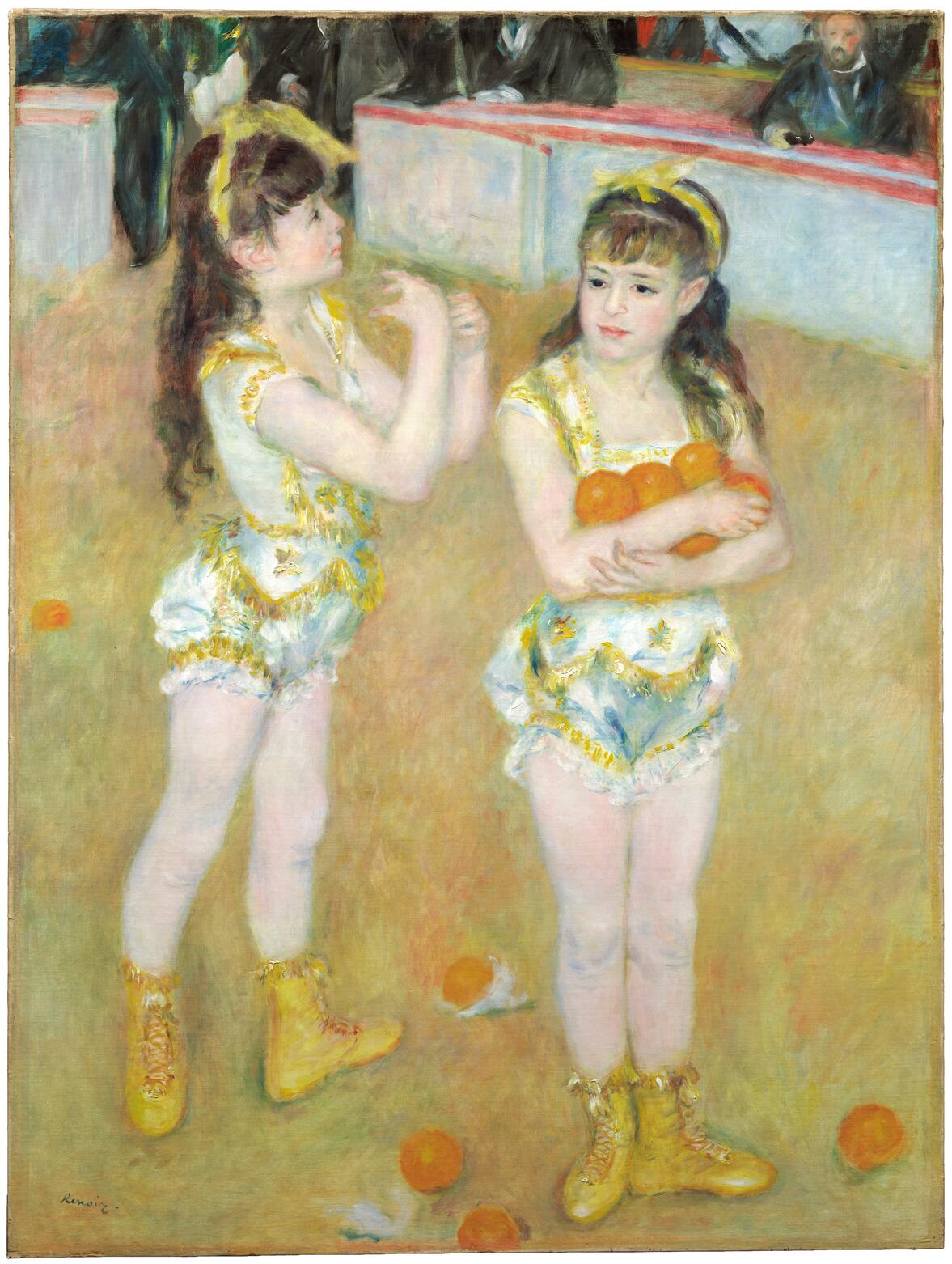
cat. 9 Acrobats at the Cirque Fernando (Francisca and Angelina Wartenberg) (1879).
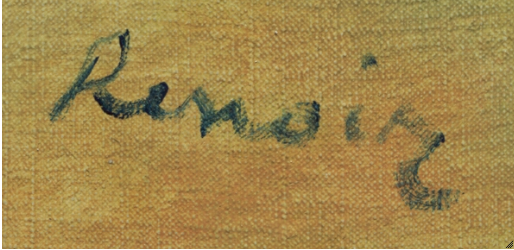
Detail of the signature in Renoir’s Acrobats at the Cirque Fernando (Francisca and Angelina Wartenberg) (1879). The Art Institute of Chicago, 1922.440.
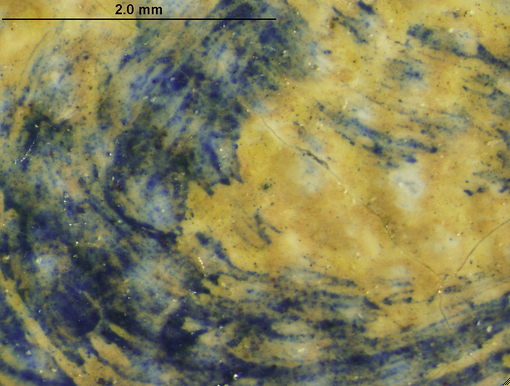
Photomicrograph of the signature in Renoir’s Acrobats at the Cirque Fernando (Francisca and Angelina Wartenberg) (1879). The Art Institute of Chicago, 1922.440.
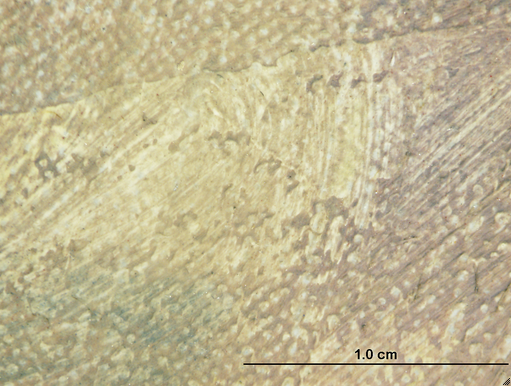
Photomicrograph of the background in Renoir’s Acrobats at the Cirque Fernando (Francisca and Angelina Wartenberg) (1879) showing marks from palette-knife application. The Art Institute of Chicago, 1922.440.
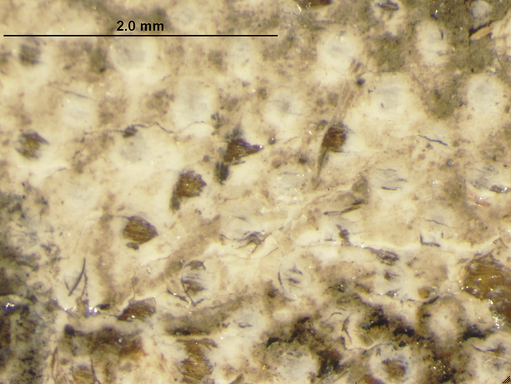
Photomicrograph of the ground in Renoir’s Acrobats at the Cirque Fernando (Francisca and Angelina Wartenberg) (1879) showing marks from palette-knife application. The Art Institute of Chicago, 1922.440.
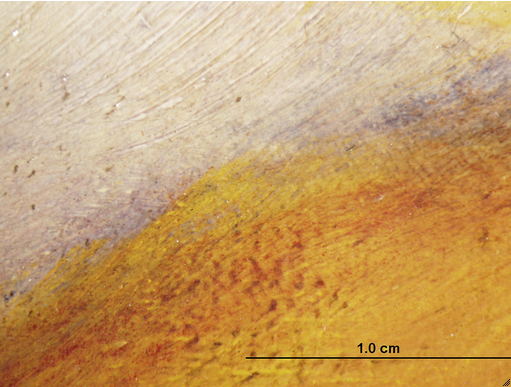
Photomicrograph of Renoir’s Acrobats at the Cirque Fernando (Francisca and Angelina Wartenberg) (1879). The blue, painted underdrawing can be seen blended into the interface between the right figure’s wrist and the oranges she carries. The Art Institute of Chicago, 1922.440.
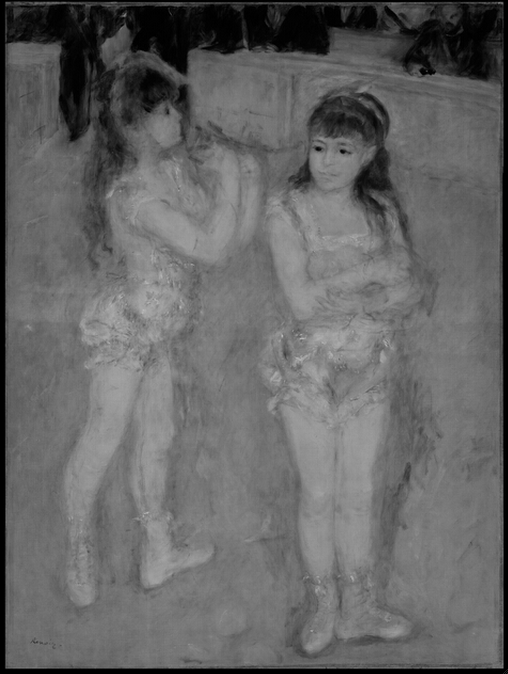
Infrared reflectogram (Goodrich, 0.9–1.7 µm) of Renoir’s Acrobats at the Cirque Fernando (Francisca and Angelina Wartenberg) (1879) showing the artist’s adjustments to the figures. The Art Institute of Chicago, 1922.440.
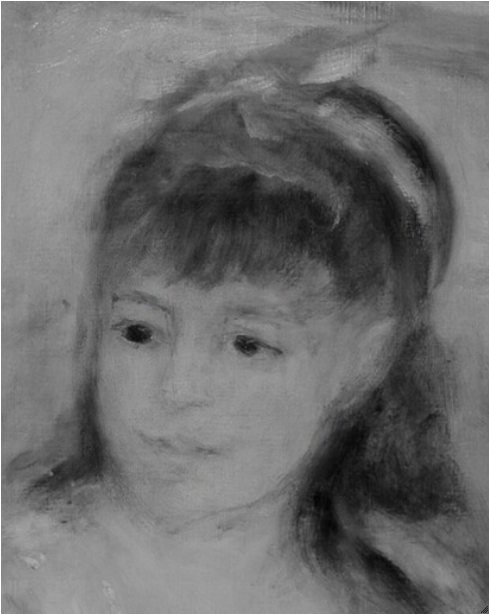
Infrared-reflectogram (Fuji, 1.0–1.1 µm) detail of Renoir’s Acrobats at the Cirque Fernando (Francisca and Angelina Wartenberg) (1879) showing fine, possibly graphite underdrawing lines in the right figure’s face. The Art Institute of Chicago, 1922.440.
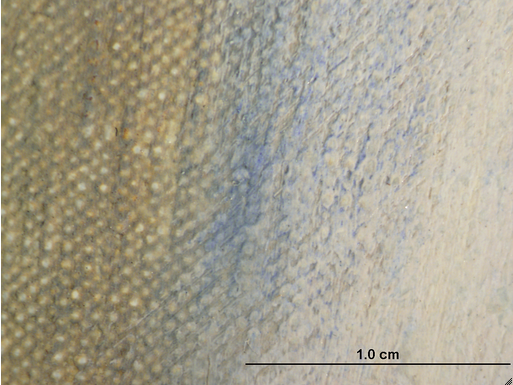
Photomicrograph of the right figure’s right leg in Renoir’s Acrobats at the Cirque Fernando (Francisca and Angelina Wartenberg) (1879) showing the smoothly blended figure-ground transition. The Art Institute of Chicago, 1922.440.
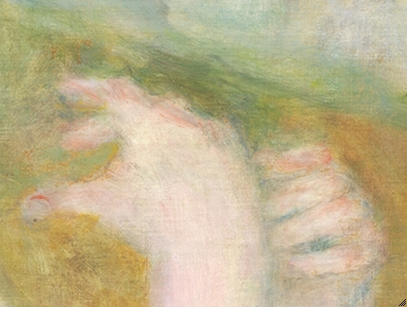
Detail of the left figure’s hands in Renoir’s Acrobats at the Cirque Fernando (Francisca and Angelina Wartenberg) (1879) surrounded by additional, opaque background paint that covers previous compositional changes. The Art Institute of Chicago, 1922.440.
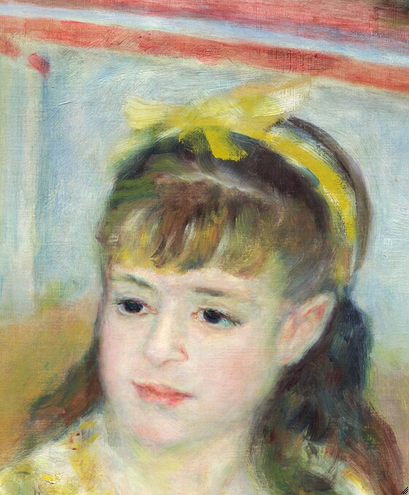
Detail of the right figure’s head in Renoir’s Acrobats at the Cirque Fernando (Francisca and Angelina Wartenberg) (1879). Thick strokes of light paint were applied around the head before the background was painted, to mask compositional changes. The Art Institute of Chicago, 1922.440.
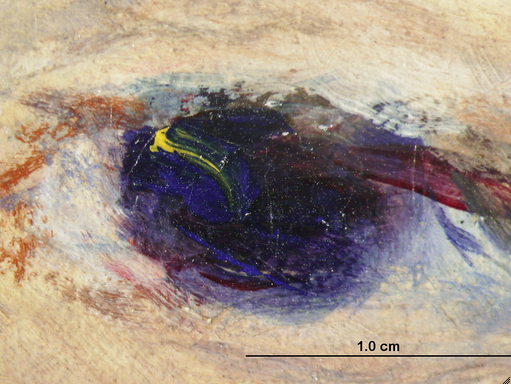
Photomicrograph of the right figure’s left eye in Renoir’s Acrobats at the Cirque Fernando (Francisca and Angelina Wartenberg) (1879) showing vivid, wet-in-wet paint application of many colors at once. The Art Institute of Chicago, 1922.440.
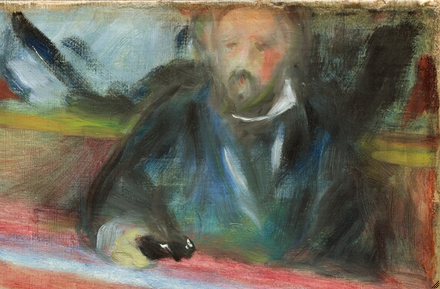
Detail of the background figures on the upper right in Renoir’s Acrobats at the Cirque Fernando (Francisca and Angelina Wartenberg) (1879). The Art Institute of Chicago, 1922.440.
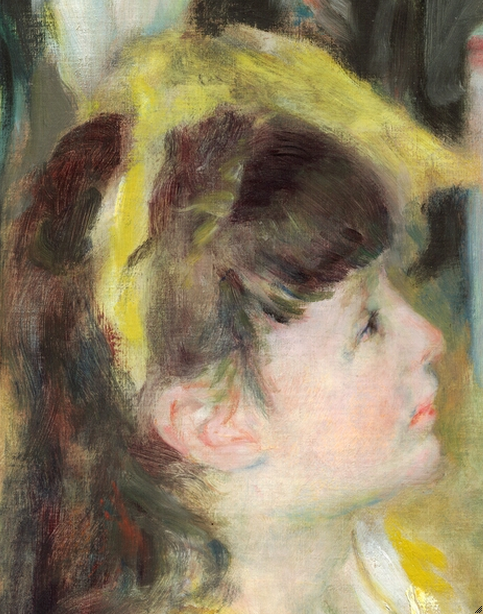
Detail of the left figure’s bow in Renoir’s Acrobats at the Cirque Fernando (Francisca and Angelina Wartenberg) (1879) showing where the artist selectively wiped away paint to give the hair and bow a wispy appearance. The Art Institute of Chicago, 1922.440.
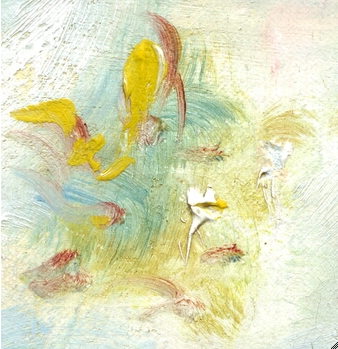
Detail of the right figure’s gold costume embellishments in Renoir’s Acrobats at the Cirque Fernando (Francisca and Angelina Wartenberg) (1879). The Art Institute of Chicago, 1922.440.
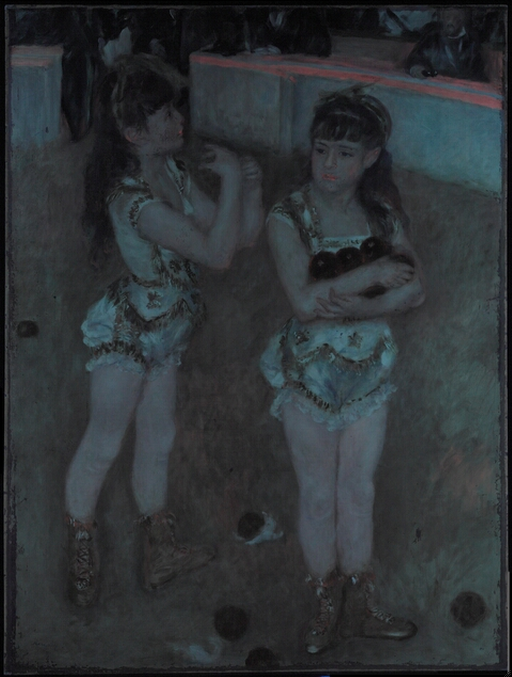
UV image of Renoir’s Acrobats at the Cirque Fernando (Francisca and Angelina Wartenberg) (1879). The Art Institute of Chicago, 1922.440.
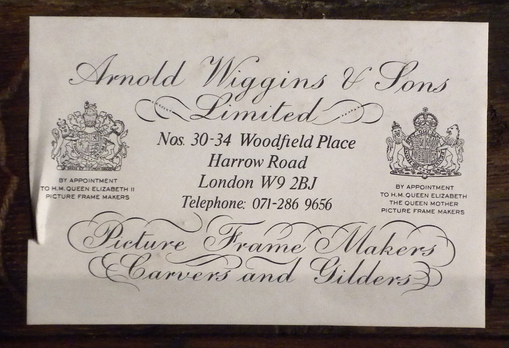
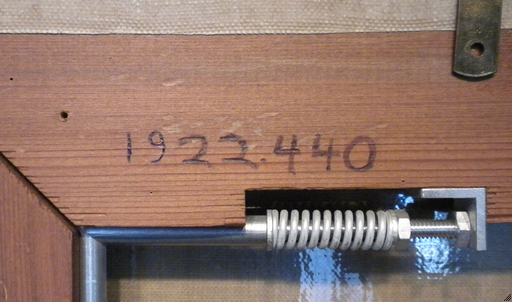
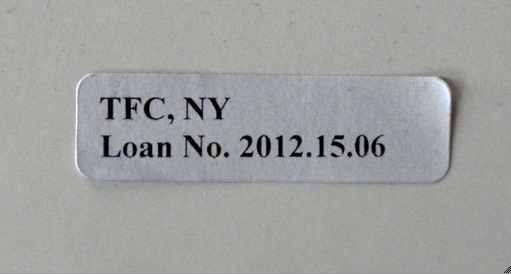
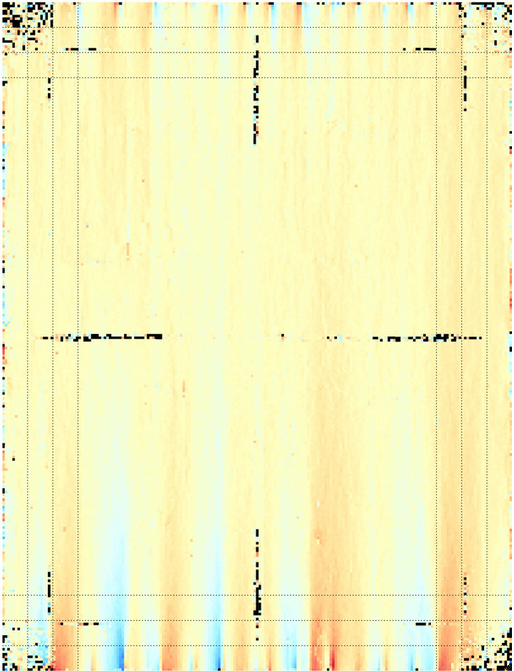
Warp-angle map of Renoir’s Acrobats at the Cirque Fernando (Francisca and Angelina Wartenberg) (1879) showing primary (stronger) cusping along the bottom. The Art Institute of Chicago, 1922.440. Image created by Don H. Johnson using Thread Count Automation Project software.
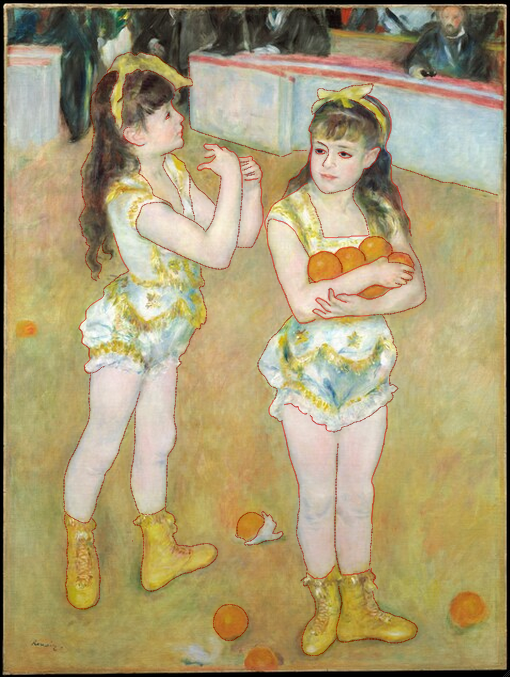
Renoir’s Acrobats at the Cirque Fernando (Francisca and Angelina Wartenberg) (1879). The Art Institute of Chicago, 1922.440. Interactive image.
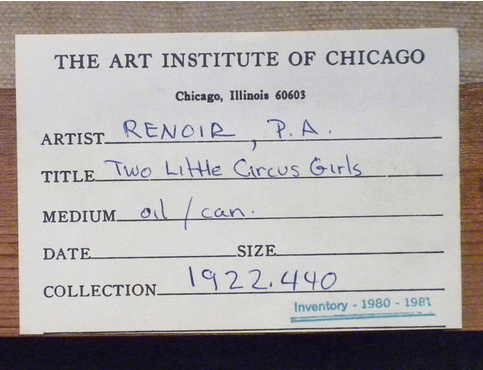
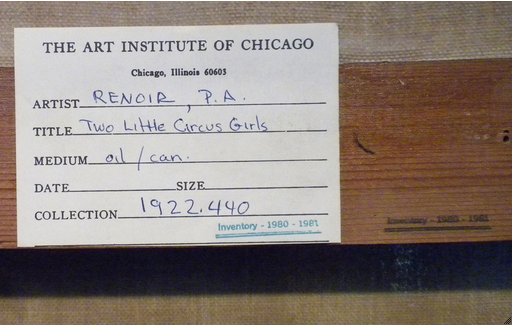
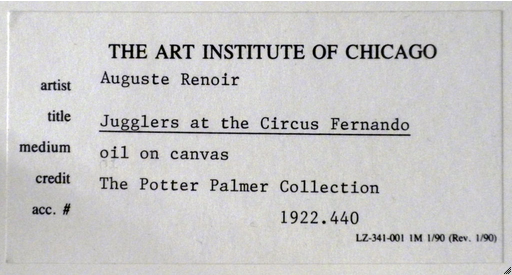
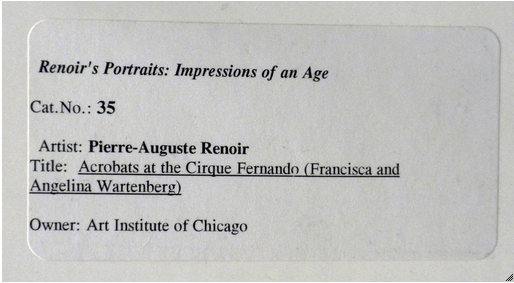
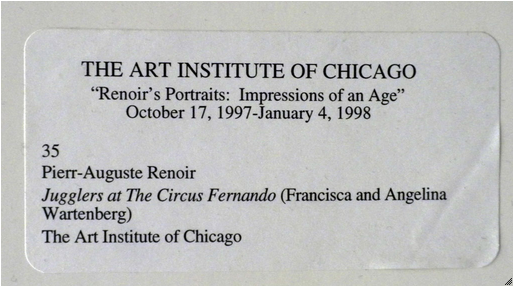
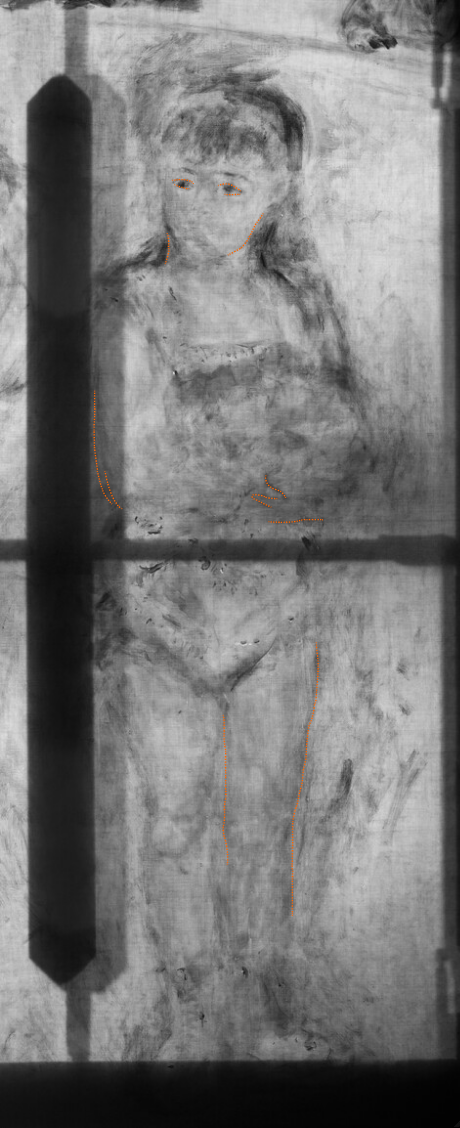
Transmitted-infrared (Fuji, 1.0–1.1 µm), reflected-infrared (Goodrich, 0.9–1.7 µm), and natural-light details of the right figure (Angelina) in Renoir’s Acrobats at the Cirque Fernando (Francisca and Angelina Wartenberg) (1879). The Art Institute of Chicago, 1922.440. Interactive image.
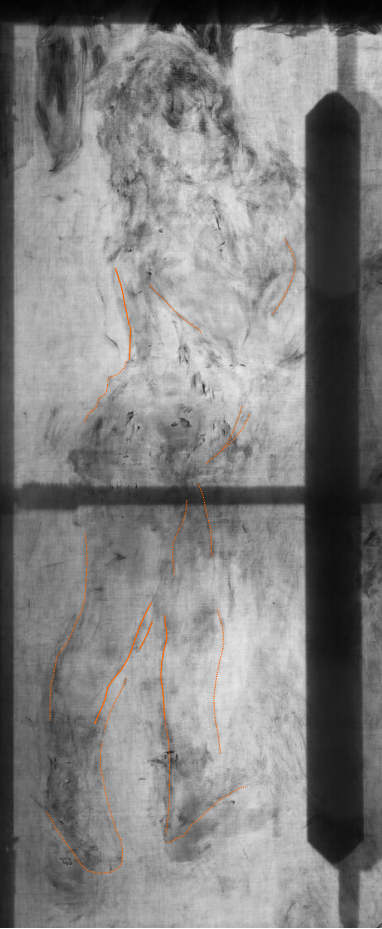
Transmitted-infrared (Fuji, 1.0–1.1 µm), reflected-infrared (Goodrich, 0.9–1.7 µm), and natural-light details of the left figure (Francisca) in Renoir’s Acrobats at the Cirque Fernando (Francisca and Angelina Wartenberg) (1879). The Art Institute of Chicago, 1922.440. Interactive image.
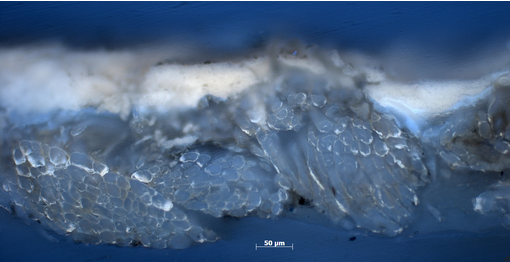
Photomicrograph of a cross section in UV light from Renoir’s Acrobats at the Cirque Fernando (Francisca and Angelina Wartenberg) (1879) showing canvas fibers, sizing, and ground layers. Original magnification: 200×. The Art Institute of Chicago, 1922.440.
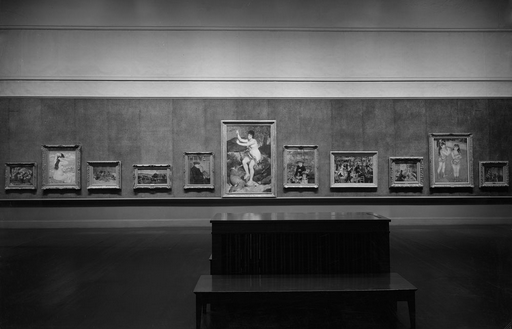
Renoir’s Acrobats at the Cirque Fernando (Francisca and Angelina Wartenberg) (1879), second from right, in a previous frame, installed in “A Century of Progress”: Loan Exhibition of Paintings and Sculpture, Art Institute of Chicago, May 23–Nov. 1, 1933. Institutional Archives, Art Institute of Chicago.
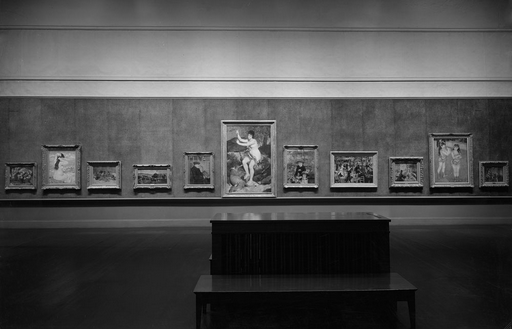
Renoir’s Acrobats at the Cirque Fernando (Francisca and Angelina Wartenberg) (1879), installed in “A Century of Progress”: Loan Exhibition of Paintings and Sculpture, Art Institute of Chicago, May 23–Nov. 1, 1933. Institutional Archives, Art Institute of Chicago.
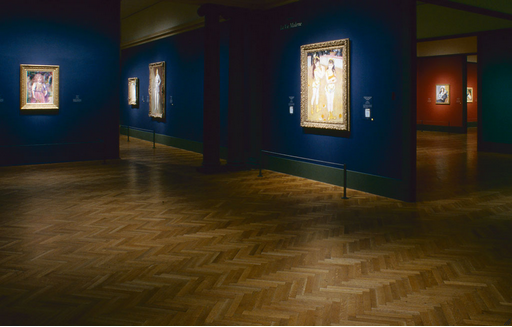
Renoir’s Acrobats at the Cirque Fernando (Francisca and Angelina Wartenberg) (1879) installed in Renoir's Portraits: Impressions of an Age, Art Institute of Chicago, Oct. 17, 1997–Jan. 4, 1998. Institutional Archives, Art Institute of Chicago.
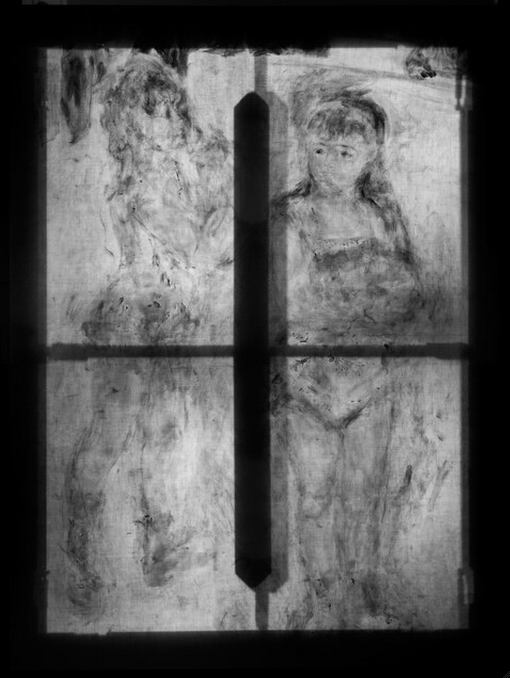
Transmitted-infrared, infrared, and natural-light images of Renoir’s Acrobats at the Cirque Fernando (Francisca and Angelina Wartenberg) (1879), showing initial positioning of the figures. The Art Institute of Chicago, 1922.440. Interactive image.
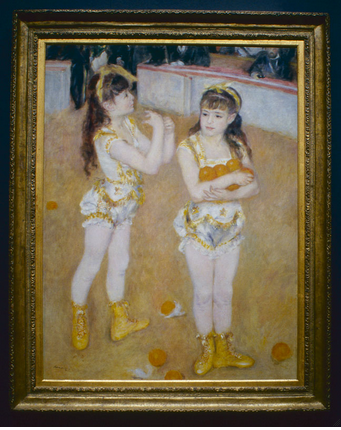
Renoir’s Acrobats at the Cirque Fernando (Francisca and Angelina Wartenberg) (1879) in a previous frame. The Art Institute of Chicago, 1922.440.
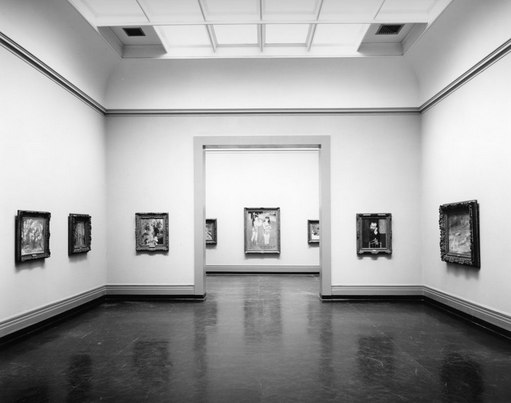
Renoir’s Acrobats at the Cirque Fernando (Francisca and Angelina Wartenberg) (1879), second from right, in a previous frame, gallery installation, c. 1960. Institutional Archives, Art Institute of Chicago.
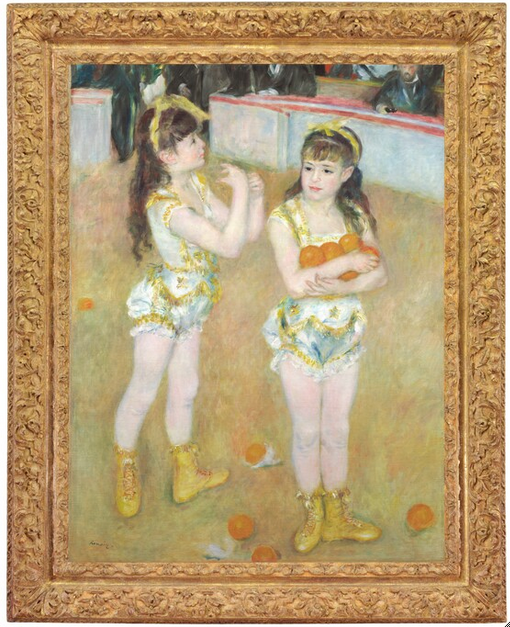
Renoir’s Acrobats at the Cirque Fernando (Francisca and Angelina Wartenberg) (1879) in its current frame. The Art Institute of Chicago, 1922.440.
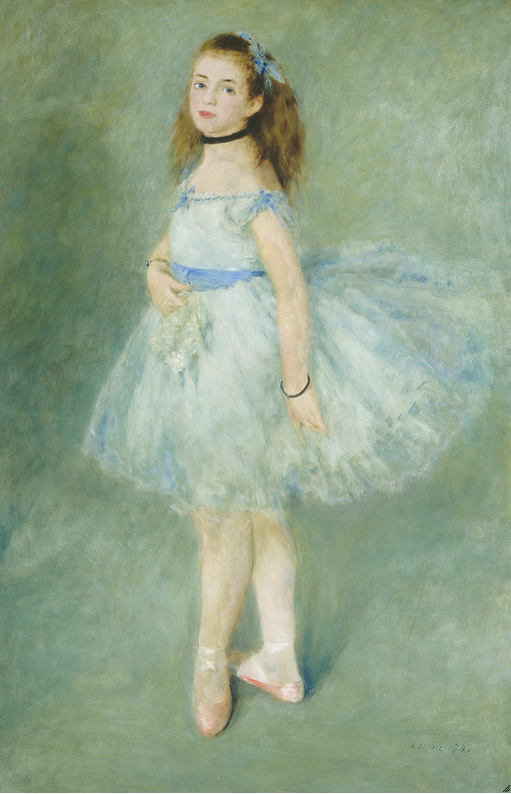
Pierre-Auguste Renoir (French, 1841–1919). The Dancer, 1874. Oil on canvas; 142.5 × 94.5 cm (56 1/8 × 37 3/16 in.). National Gallery of Art, Washington, D.C., Widener Collection, 1942.9.72.
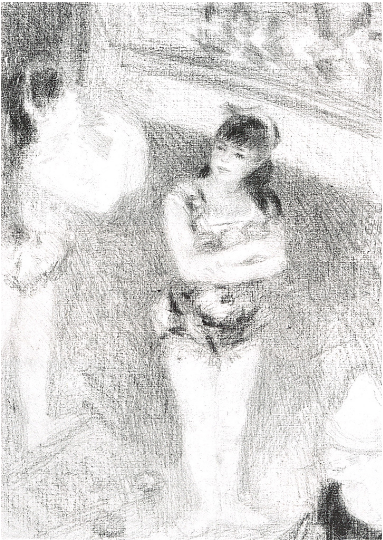
Pierre-Auguste Renoir (French, 1841–1919). The Acrobats, 1874–78. Black chalk on canvas. Private collection.
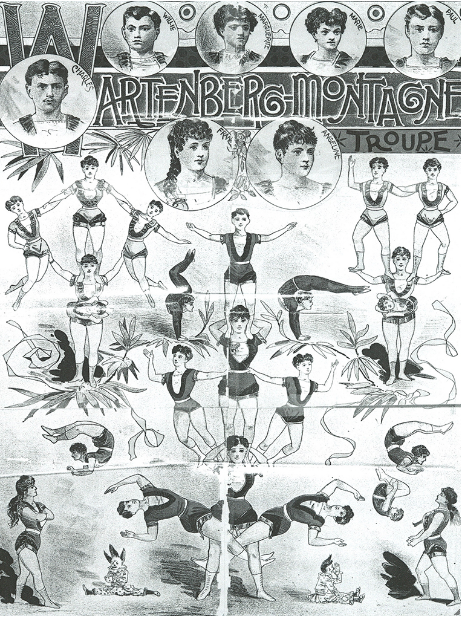
The Wartenberg Montagne Troupe, c. 1885. Color lithograph poster. Private collection.

The Wartenberg Family in Saint Petersburg, Russia, 1880. Private collection.
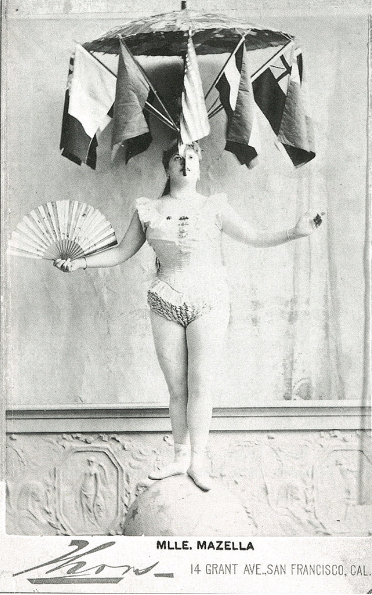
Francisca Wartenberg performing as “Mademoiselle Mazella” in San Francisco, c. 1893. Private collection.
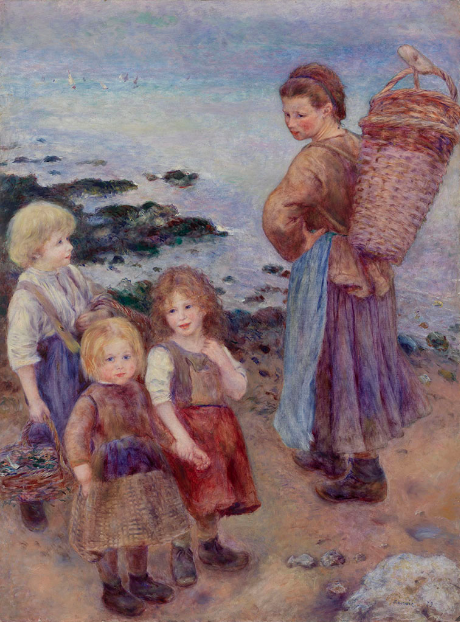
Pierre-Auguste Renoir (French, 1841–1919). Mussel Fishers at Berneval, 1879. Oil on canvas; 176.2 × 130.2 cm (69 3/8 × 51 1/4 in.). Barnes Foundation, Philadelphia, BF989.
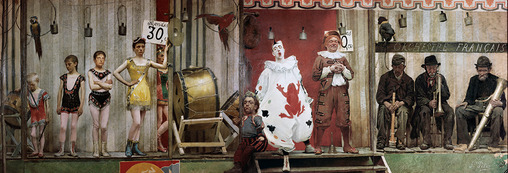
Fernand Pelez (French, 1843–1913). Grimaces and Misery (The Saltimbanques), 1888. Oil on canvas; 114.6 × 292.7 cm (45 1/8 × 115 1/4 in.). Petit Palais, Musée des Beaux-Arts de la Ville de Paris. © RMN-Grand Palais/Agence Bulloz/Art Resource, NY.
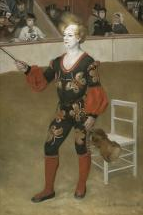
Pierre-Auguste Renoir (French, 1841–1919). The Clown (James Bollinger Mazutreek), 1868. Oil on canvas; 193.5 × 130 cm (76 3/16 × 51 3/16 in.). Kröller-Müller Museum, Otterlo.
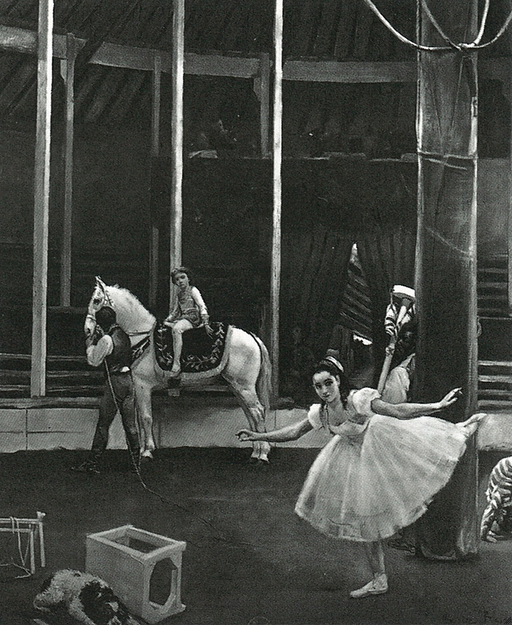
Maurice Blum (French, 1832–1909). Une répétition au Cirque Fernando, 1874. Reproduction from the Bibliothèque Nationale, Département des Estampes.
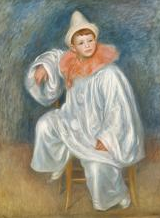
Pierre-Auguste Renoir (French, 1841–1919). The White Pierrot (Jean Renoir), 1901–02. Oil on canvas; 81 × 62 cm (31 7/8 × 24 7/16 in.). The Detroit Institute of Arts, Bequest of Robert H. Tannahill.
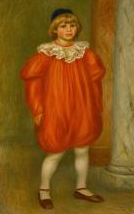
Pierre-Auguste Renoir (French, 1841–1919). The Clown (Claude Renoir), 1909. Oil on canvas; 120 × 77 cm (47 1/4 × 30 5/16 in.). Musée de l’Orangerie, Paris, Jean Walter and Paul Guillaume Collection. Erich Lessing / Art Resource, NY.
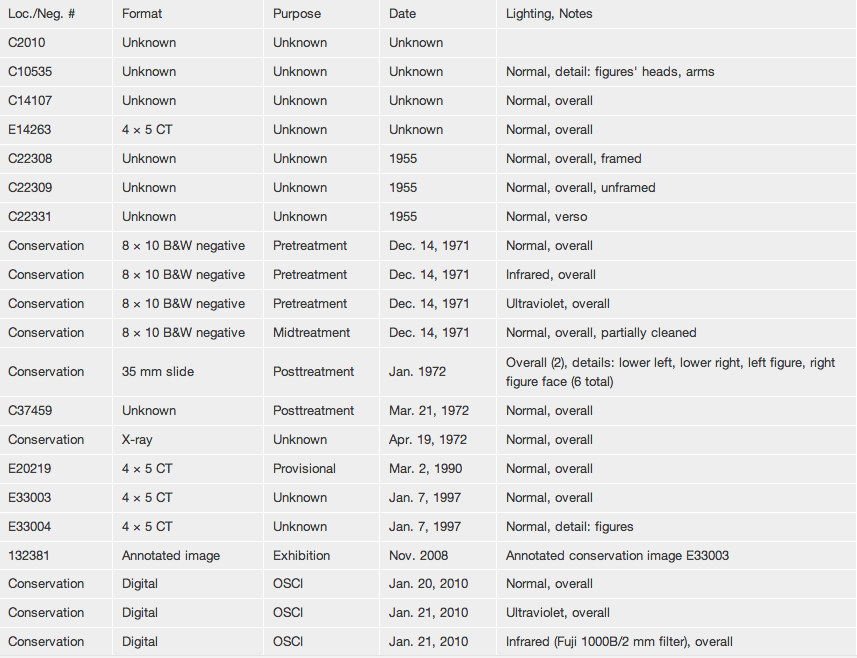
| Loc./Neg. # | Format | Purpose | Date | Lighting, Notes |
| C2010 | Unknown | Unknown | Unknown | |
| C10535 | Unknown | Unknown | Unknown | Normal, detail: figures' heads, arms |
| C14107 | Unknown | Unknown | Unknown | Normal, overall |
| E14263 | 4 × 5 CT | Unknown | Unknown | Normal, overall |
| C22308 | Unknown | Unknown | 1955 | Normal, overall, framed |
| C22309 | Unknown | Unknown | 1955 | Normal, overall, unframed |
| C22331 | Unknown | Unknown | 1955 | Normal, verso |
| Conservation | 8 × 10 B&W negative | Pretreatment | Dec. 14, 1971 | Normal, overall |
| Conservation | 8 × 10 B&W negative | Pretreatment | Dec. 14, 1971 | Infrared, overall |
| Conservation | 8 × 10 B&W negative | Pretreatment | Dec. 14, 1971 | Ultraviolet, overall |
| Conservation | 8 × 10 B&W negative | Midtreatment | Dec. 14, 1971 | Normal, overall, partially cleaned |
| Conservation | 35 mm slide | Posttreatment | Jan. 1972 | Overall (2), details: lower left, lower right, left figure, right figure face (6 total) |
| C37459 | Unknown | Posttreatment | Mar. 21, 1972 | Normal, overall |
| Conservation | X-ray | Unknown | Apr. 19, 1972 | Normal, overall |
| E20219 | 4 × 5 CT | Provisional | Mar. 2, 1990 | Normal, overall |
| E33003 | 4 × 5 CT | Unknown | Jan. 7, 1997 | Normal, overall |
| E33004 | 4 × 5 CT | Unknown | Jan. 7, 1997 | Normal, detail: figures |
| 132381 | Annotated image | Exhibition | Nov. 2008 | Annotated conservation image E33003 |
| Conservation | Digital | OSCI | Jan. 20, 2010 | Normal, overall |
| Conservation | Digital | OSCI | Jan. 21, 2010 | Ultraviolet, overall |
| Conservation | Digital | OSCI | Jan. 21, 2010 | Infrared (Fuji 1000B/2 mm filter), overall |
| Conservation | Digital | OSCI | Jan. 21, 2010 | Details of surface (15 total) |
| Conservation | Digital | OSCI | Jan. 22, 2010 | Details of verso, frame, and labels (6 total) |
| Conservation | Digital | OSCI | Jan. 22, 2010 | Infrared (Inframetrics 1.5–1.73 µm filter), overall; composite |
| Conservation | Digital | OSCI | Jan. 25, 2010 | Raking light, overall |
| Conservation | X-ray | OSCI | Jan. 25, 2010 | X-ray films scanned/digitally composited |
| Conservation | Digital | OSCI | Jan. 28, 2010 | Photomicrographs of surface (11 total) |
| Conservation | Digital | OSCI | Jan. 29, 2010 | Transmitted light, overall; composite |
| Conservation | Digital | OSCI | Jan. 29, 2010 | Transmitted infrared (Fuji 1000B/2 mm filter), overall; composite |
| G33250 | Digital | OSCI | Feb. 8, 2010 | Normal, overall |
| G33251 | Digital | OSCI | Feb. 8, 2010 | Ultraviolet, overall |
| G33252 | Digital | OSCI | Feb. 8, 2010 | Normal, detail: upper figures |
| G33253 | Digital | OSCI | Feb. 8, 2010 | Normal, detail: right figure head |
| G33254 | Digital | OSCI | Feb. 8, 2010 | Normal, detail: left figure's boots |
| G33255 | Digital | OSCI | Feb. 8, 2010 | Normal, frame only |
| G33256 | Digital | OSCI | Feb. 8, 2010 | Normal, composite with frame |
| G39037 | Digital | OSCI | June 7, 2012 | Normal, overall; composite of G41053–G41090 |
| G39038 | Digital | OSCI | June 5, 2012 | Ultraviolet, overall |
| G41053 | Digital | OSCI | June 8, 2012 | Normal, frame only |
| G41054 | Digital | OSCI | June 5, 2012 | Section |
| G41055 | Digital | OSCI | June 5, 2012 | Section |
| G41056 | Digital | OSCI | June 5, 2012 | Section |
| G41057 | Digital | OSCI | June 5, 2012 | Section |
| G41058 | Digital | OSCI | June 5, 2012 | Section |
| G41059 | Digital | OSCI | June 5, 2012 | Section |
| G41060 | Digital | OSCI | June 5, 2012 | Section |
| G41061 | Digital | OSCI | June 5, 2012 | Section |
| G41062 | Digital | OSCI | June 5, 2012 | Section |
| G41063 | Digital | OSCI | June 5, 2012 | Section |
| G41064 | Digital | OSCI | June 5, 2012 | Section |
| G41065 | Digital | OSCI | June 5, 2012 | Section |
| G41066 | Digital | OSCI | June 5, 2012 | Section |
| G41067 | Digital | OSCI | June 5, 2012 | Section |
| G41068 | Digital | OSCI | June 5, 2012 | Section |
| G41069 | Digital | OSCI | June 5, 2012 | Section |
| G41070 | Digital | OSCI | June 5, 2012 | Section |
| G41071 | Digital | OSCI | June 5, 2012 | Section |
| G41072 | Digital | OSCI | June 5, 2012 | Section |
| G41073 | Digital | OSCI | June 5, 2012 | Section |
| G41074 | Digital | OSCI | June 5, 2012 | Section |
| G41075 | Digital | OSCI | June 5, 2012 | Section |
| G41076 | Digital | OSCI | June 5, 2012 | Section |
| G41077 | Digital | OSCI | June 5, 2012 | Section |
| G41078 | Digital | OSCI | June 5, 2012 | Section |
| G41079 | Digital | OSCI | June 5, 2012 | Section |
| G41080 | Digital | OSCI | June 5, 2012 | Section |
| G41081 | Digital | OSCI | June 5, 2012 | Section |
| G41082 | Digital | OSCI | June 5, 2012 | Section |
| G41083 | Digital | OSCI | June 5, 2012 | Section |
| G41084 | Digital | OSCI | June 5, 2012 | Section |
| G41085 | Digital | OSCI | June 5, 2012 | Section |
| G41086 | Digital | OSCI | June 5, 2012 | Section |
| G41087 | Digital | OSCI | June 5, 2012 | Section |
| G41088 | Digital | OSCI | June 5, 2012 | Section |
| G41089 | Digital | OSCI | June 5, 2012 | Section |
| G41090 | Digital | OSCI | June 5, 2012 | Section |
Near the Lake609
1879/80610
Oil on canvas; 47.5 × 56.4 cm (18 11/16 × 22 3/16 in.)
Signed: Renoir. (lower right, in blue paint)
The Art Institute of Chicago, Potter Palmer Collection, 1922.439
A man in a yellow jacket and loose-fitting brown flannel pants takes a moment to linger over a cigarette in the shade, while a young girl in his care leans toward him, her lips parted in conversation. She is restless to his calm, earnestly intent to his contemplative. The casual dress of the male figure—his collarless blue shirt and straw boater hat—identifies him with the canotier, the rowing sportsman whom Renoir depicted frequently from 1875 to 1883, though in this context it may simply reflect a fashion trend. The man’s red moustache and round face are features shared with Alphonse Fournaise, son of the owner of the Restaurant Fournaise on the Île de Chiard, who also modeled for Renoir’s Luncheon of the Boating Party (1880/81; Phillips Collection, Washington, D.C. [Daulte 379; Dauberville 224]).611 The presence of the child distinguishes Near the Lake from that celebrated image of boating and from the earlier Lunch at the Restaurant Fournaise (cat. 2), both of which depict the restaurant occupied only by adults. What is the relationship between the two figures in Near the Lake? The girl’s animated interaction with her companion suggests that he is her father or at least a close family member. In Renoir’s work, children are rarely unrelated to the theme; if he places them in a setting, it is undoubtedly because they belong there. Most often children conjure a joyfulness and timeless innocence that enhance the sense of well-being inherent in his luminous Impressionist style. His major genre painting of 1876, Dance at the Moulin de la Galette (fig. 2.49 [Daulte 209; Dauberville 211]), is a good example of how the presence of a child, seen playing with her mother on the lower left, completely transforms a disreputable Montmartre dance hall into a gathering place for community and family.612 In the case of Near the Lake, the girl, who is located in the center of the composition and wears a fanciful hat decorated with flowers and perhaps blue feathers, contributes enormously to the idyllic mood of the scene. By including children in adult situations without making them appear coy or out of place, Renoir may have been following the example of the French eighteenth-century painter of pastoral scenes, Jean-Antoine Watteau.613
While the man wears the costume of a canotier and bears a resemblance to Alphonse Fournaise, the setting for this painting is not the Seine at Chatou. The work was described as depicting a lake throughout its long history of ownership during Renoir’s lifetime. It was acquired as Au bord du lac by Durand-Ruel, Paris, on September 24, 1886, and exhibited in New York the next year as Near the Lake.614 Indeed, the wooden balustrade against which the figures lean and the low-hanging roof above them are typical of the gazebo or kiosk architecture commonly found near lakes in French municipal parks in the nineteenth century.615 The decorative design of the balustrade is echoed in the two scrolled brackets on either side of a vertical support post behind the man’s left shoulder. Which park and lake are represented have, however, never been identified. One possibility is Lake Enghien, which is a few miles from Argenteuil, where Claude Monet lived from 1871 until 1878. Yet Renoir is not known to have visited Lake Enghien, and by 1886 the hotels and rental houses of Enghien-les-Bains lined the shores of the lake, limiting its potential for the landscape view seen here.616
A more likely candidate for the setting is the Bois de Boulogne, a park consisting of crown lands given to the City of Paris in 1852 by Napoleon III. Despite heavy bombardment during the Prussian siege in 1870, it remains a wooded refuge from the city to this day (fig. 2.50).617 The path by the shoreline of Near the Lake appears to be finished in crushed pink granite, suggesting a level of maintenance that would only be found in a park. Renoir added the path, the figures walking along it, and the boats in the background in the final stages of painting. The unkempt wildness of the tangled vines that hang from the kiosk roof lends a note of rusticity to an otherwise well-manicured landscape. The vines were painted primarily in red over the dried layers of blue and white that make up the water. A desire to suggest the densely wooded setting of Bois de Boulogne parkland might explain why Renoir elevated the tree line beyond the lake so that only a thin band of cloudy sky remains. The more extensive cloud cover can be seen in the top half of the [glossary:X-ray] (fig. 2.6; see Application/technique and artist’s revisions in the technical report). Visible in the infrared image is an object in the left hand of the male figure, possibly a bottle or an umbrella handle, either of which would be appropriate in a public park close to the city when rain was expected or where refreshments were offered (fig. 2.18). Renoir presumably painted this object out because the partial representation read awkwardly.
There are two large lakes in the Bois de Boulogne, the lac Inférieur or Lower Lake and the lac Supérieur or Upper Lake, which have undergone numerous changes in landscaping over the years. Period photographs and illustrations of the chalet built on the island of the Lower Lake reveal that it was originally constructed in an architectural style that incorporated ornamental wooden balustrades and low-hanging eaves of the kind we see in Near the Lake (fig. 2.52, fig. 2.53). The elevation from the terrace of the chalet offers views of the lake and the paths around it that correspond to the raised point of view suggested in the painting, though not precisely to the curved shoreline that Renoir has placed in the background. A curious structure labeled “Photographie” at the north end of the Lower Lake on a period map (fig. 2.54), however, does offer a view that corresponds to the curved shoreline of Near the Lake. No further documentation of this building has yet emerged.
Renoir had earlier made the Bois de Boulogne the subject of at least two paintings. A rare winter scene by the artist, Skaters in the Bois de Boulogne (fig. 2.55 [Dauberville 110]), depicts a snow-covered landscape and crowds of Parisian adults and children enjoying the frozen surface of a lake, probably the Lac pour le patinage (Skating Lake), a small artificial lake in the north part of the Bois.618 The park is also featured in the largest painting Renoir ever made, Riding in the Bois de Boulogne (fig. 2.56 [Daulte 94; Dauberville 247]), intended for the 1873 Salon but relegated to the exhibit of réfusés that year.619 Again the theme is leisure activity involving all ages. A fictional mother and son, modeled by relations of Renoir’s friends—Henriette Darras, wife of Captain Paul-Édouard-Alfred Darras, and thirteen-year-old Joseph Le Coeur (in contrast with the adult male and young girl in Near the Lake)—guide their mounts by one of the park’s two lakes, which offered shoreline promenades.620
As Robert Herbert has pointed out, the picturesque and bucolic scenery of the Bois de Boulogne was in fact a deception; the previously forested land had been transformed into its parklike state for the enjoyment of the citizens of Paris on the model of London’s Hyde Park, which Napoleon III had admired.621 Its vast public spaces were carefully planned and engineered to resemble the countryside. For example, the porous ground underneath the site of the Lower Lake necessitated that the lake be lined with concrete in order to hold water. The Bois de Boulogne thus offered an inviting retreat to an idealized, constructed version of nature. Such a controlled landscape might seem inimical to the Impressionist endeavor to seek out authentic views of nature. But Renoir, by deliberately focusing on an unidentifiable part of the park, was able both to depict the Bois and, by extension, modern Paris, and to suggest a rural environment. Moreover, the Impressionists did frequent the park, for it was as much a part of the experience of Paris as the bustling railway stations and the boulevards of Georges-Eugène Haussmann. Situated near the sixteenth arrondissement, the Bois was easily accessible to such artists as Berthe Morisot, who grew up in the adjacent neighborhood of Passy and built a home in the arrondissement with her husband, which they moved into early in 1883. Prior to that she had found inspiration in the park for her views of women at leisure, such as Le lac du Bois de Boulogne (exhibited at the fifth Impressionist exhibition in 1880 and likely the painting now in the National Gallery, London; see fig. 2.57). Renoir himself also lived in the sixteenth arrondissement for a short time. He listed his address as the avenue d’Eylau (now avenue Victor Hugo) when he exhibited at the Salon of 1865. His friend and fellow artist Alfred Sisley rented an apartment on the avenue de Neuilly near Porte Maillot at the northeast end of the park in 1864.
Near the Lake was painted on a comparatively small, no. 10 portrait ([glossary:figure]) standard-size canvas. Renoir applied paint generously, often mixing color directly on the canvas, for instance, combining red and white for the pink path by the shore, and mixing yellow and green to create a lighter shade of green for the leaves (fig. 2.58, fig. 2.19). The brushwork reflects a high-energy, focused style of execution. Renoir worked with assurance and lyrical randomness as he explored the expressive potential of la tache (literally, “the touch”), a word used in the nineteenth century to describe visible brushwork in a painting and linked with a long-standing and widely known controversy surrounding progressive art.622 La tache was considered a characteristic of preparatory sketches, which tended to have a surface appearance thought unsuitable for finished works of art intended for exhibition. This “sketch” aesthetic was closely identified with the Impressionist movement. At the time of his retrospective exhibition in 1883, Renoir was seen by critics as the prototypical artist who painted using la tache: “His eye sees nothing but la tache, the famous tache that plays such a big role today.”623 Renoir’s touch is everywhere evident in Near the Lake.624
The appearance of la tache in Near the Lake foreshadows Renoir’s theory of irregularity, which emphasized that nature was not ideal but rather composed of an infinite variety of anomalies, and assigned a greater value to the imperfections of the handmade than to the geometrical precision of the machine-made. As Renoir articulated in a letter to his art dealer, Paul Durand-Ruel, in May 1884, “The two eyes of the most beautiful face will always be slightly dissimilar; no nose is ever found exactly above the middle of the mouth; the sections of an orange, the leaves of a tree, the petals of a flower are never identical; it seems even that the beauties of every species draw their charm from this diversity.”625 At that time, the artist had been drafting notes for about a year regarding a group that he called a “Société des Irrégularistes”: “Its aim will be to organize as soon as possible some exhibitions whose participants would be all the artists, painters, decorators, architects, goldsmiths, silversmiths, embroiderers, etc. . . . , who have irregularity as their esthetic principle.”626
Renoir’s own work presumably demonstrated how irregularity manifested itself in painting. Details in Near the Lake suggest that he relished the physicality of paint application and the mark of a loaded brush. The textural contrasts he achieved verge on the sculptural. The rendition of the girl’s hat provides an excellent case study of Renoir’s technique (fig. 3.60). The white highlights at the rear of the hat consist of such thick impasto that they might almost have been applied directly from the tube, with a minimum of subsequent brushwork. Parts of the girl’s smock, however, reflect a more fluid, thin layering of glazes, with wisps of yellow added for the hair over almost dry paint (fig. 2.5). Areas of vivid, wet-in-wet brushwork, where colors were blended directly on the canvas so that they appear swirled together, are typical of Renoir’s painting method in the 1870s, evident in works such as At the Theatre (1876–77; National Gallery, London [Daulte 182; Dauberville 232]) and Young Woman Sewing (cat. 7), among many others.627 Further wet-in-wet paint application can be seen in the man’s face, coat, and trousers, where Renoir was particularly concerned with subduing the tones to suggest shade.
The formidable range of textures evident in Near the Lake was accomplished with the use of a wide variety of brushes and application methods. One of the intriguing characteristics of Renoir’s process is that his brushwork varies across paintings made close together in time, and even within a single canvas. This variety allowed him to consistently prove his sophistication as a colorist even as he drew attention to each painting’s status as a handmade object, thereby enhancing its integrity as a work of art. Evident all across the surface of Near the Lake are Renoir’s love for and obsession with achieving subtle visual effects with a variety of brushes. The leaves of the vine were painted with a single stroke from a wide, flat brush, whereas the feather-like details on the girl’s hat, as well as the modeling of her face and hands, were achieved with a smaller, fine-tip brush.
In Near the Lake Renoir used bold, saturated color and drew on the full range of his usual palette. Contrasts of pure color were established throughout the composition, as in the juxtaposition of red, used for the wood of the structure and for the vine, with the varied greens of the foliage. These are mingled with yellow for reflected sunlight and deep blues for the more shaded leaves and the man’s tunic (see Palette). A slightly darker yellow is used for the straw of the girl’s hat, which contrasts with the more lemony hue of the sunlit foliage just to its left. Strong accents of yellow appear in the landscape and especially as highlights of dappled sun on the man’s clothes and in the leaves hanging from the roof. In his memoir, the painter Jacques-Émile Blanche, who studied with Renoir in 1881 and closely observed his teacher at work, recalled Renoir’s eclecticism. Evoking the debate over la tache and how it affects the application of color, Blanche later wrote: “To relax, he made landscapes, and it was remarkable how he worked, like a pastellist, with interwoven hatch markings. . . . A reddish violet dominated. ‘Like red currant jam’ someone said, but over time the paint surface becomes rich and unified; Renoir apparently knew that garrulous colors would later submit to their neighbors.”628
John Collins
Renoir executed this painting on a [glossary:commercially primed], standard-size, medium-weight [glossary:canvas]. The commercial [glossary:priming] consists of three layers—a chalk ground followed by a double ground of lead white in oil—and as a result it is extremely smooth, filling much of the canvas [glossary:weave]. An additional, possibly artist-applied, layer covers the compositional area, is smooth, further mutes the texture of the canvas, and appears to have been applied with a [glossary:palette knife] and then worked with a brush. Despite the diminished texture resulting from the heavy preparation, the canvas weave is accentuated in many places by Renoir’s technique—he dragged an almost dry brush across the surface, catching only the thread tops. The artist probably chose this canvas and [glossary:ground] preparation for its luminosity, a trait he exploited early in the painting process. He began the painting with very thin washes, now revealed between skips in the thick, upper paint layers. He also blocked in initial forms as thin washes, glazes, and semiglazes for some of the major structural elements, including the wood balustrade across the foreground, the overhang along the top edge, and the wood elements in the upper left.
Various changes to the paint layer can be seen under normal viewing conditions; additional alterations are visible with [glossary:raking light], infrared, and [glossary:X-radiography]. Renoir altered the angle of the male figure’s coat and diminished or changed the perspective of the female figure’s hat. Infrared examination shows an unidentifiable form extending from the male figure’s hand; this form was never completed and was later covered with foliage. In the background, the artist raised the horizon line, leaving only a narrow band of cloudy sky visible. Other areas of the painting show evidence of changes that do not correspond to compositional elements; some of these may be adjustments in [glossary:palette].
Renoir used a relatively limited palette and mixed most colors on the surface of the painting. He also made use of various brushes and thicknesses of paint to achieve textural effects. He appears to have moved systematically around the canvas, working up multiple areas at once. As a result, it is unclear to what extent he established the figures before bringing in the background. The female figure’s hat seems to have been fully articulated, complete with thick, white highlights, before extra background and shading were brought in to alter its shape. Smaller details were added at the end of the process, after much of the painting was dry, including the figures along the lakefront path, the small boats, and the hanging vines.
The multilayer interactive image viewer is designed to facilitate the viewer’s exploration and comparison of the technical images (fig. 2.13).629
Signed: Renoir. (lower right, in blue paint) (fig. 1.2, fig. 1.1).630
Flax (commonly known as linen).631
The original dimensions of the canvas were approximately 46.3 × 54.8 cm, measuring from the apparent original foldover edge.632 This probably corresponds to a no. 10 portrait ([glossary:figure]) standard-size (55 × 46 cm) canvas, turned horizontally.633
[glossary:Plain weave]. Average [glossary:thread count] (standard deviation): 26.0V (0.9) × 29.9H (0.6) threads/cm. The horizontal threads were determined to correspond to the [glossary:warp] and the vertical threads to the [glossary:weft].634
The canvas has mild [glossary:cusping] on all sides, corresponding to the placement of the original tacks.
Current stretching: When the painting was lined in 1971, the original dimensions were slightly increased on all sides (see Conservation History).
Original stretching: Based on cusping visible in the X-ray, the original tacks were placed 5.5–6 cm apart.
Current stretcher: Four-member redwood ICA spring stretcher. Depth: 2.5 cm.
Original stretcher: Five-member keyable stretcher with vertical [glossary:crossbar]. Depth: Approximately 1.3 cm.635
Stamp
Location: verso of original canvas (covered by lining)636
Method: ovular stamp
Content: COULEURS [FINES] [&] TOILES [À] TABLEAUX / P: APRIN / PARIS / [48] RUE DE DOUAI [48] (fig. 2.9, fig. 2.10)
[glossary:Cross-sectional analysis] indicates a thin, brownish layer of material between the paint and the canvas that closely follows the contours of the canvas weave. This material is organic in nature and is estimated to be glue (fig. 2.21).637
The canvas has a very complex preparation: a three-layer commercial priming that extends to the edges of the [glossary:tacking margins], and an additional, possibly artist-applied, preparatory layer covering the compositional area only.638
The commercial preparation extends to the edges of the tacking margins and looks very smooth in consistency. Localized interlayer [glossary:cleavage] in the preparatory layers seems to be within the commercial priming, giving the initial impression that it is a double-layered preparation. Cross-sectional analysis confirms that the commercial ground is a three-layer system with an initial chalk layer filling the interstices of the weave. Under stereomicroscopic examination, it can be seen that this initial layer barely fills the canvas weave and appears rougher in texture, with chunkier chalk particles visible. The upper layers of the commercial preparation are thicker and smoother, greatly diminishing the texture of the canvas weave. All three layers of the commercial ground are relatively thin: the intial chalk-based layer is approximately 1.5–30 µm thick, the lower layer of the commercial priming is approximately 5–35 µm thick, and the upper layer is approximately 10–45 µm thick (fig. 10.61).
Above the commercial preparation, an additional layer covers the area of the composition only and has visible ridges along the original edges of the canvas (fig. 2.20). These ridges have been crushed by the heat and pressure of the lining process, but they suggest that this layer was applied with a palette knife and further worked with a brush (fig. 1.3). The commercial priming fills a good amount of the canvas weave, and the additional ground adds to the overall smoothness and further mutes the canvas texture.
While the canvas has a relatively fine weave and features a complex preparation that serves to even out its texture, in many areas Renoir nevertheless used the weave to create a textural effect. The artist employed thin, translucent washes that sank into this texture or dragged a loaded brush across the surface, catching only the thread tops (fig. 1.4). In some places he repeated this process so that the texture was reinforced with each brushstroke (fig. 2.47). Additionally, he left little of the ground visible in the final composition and probably used its brightness to achieve luminosity rather than as a chromatic element.
The commercially applied preparation was probably white, as there is no microscopic evidence of additional pigments. Because this layer is porous, it has darkened—discolored with grime and saturated by the [glossary:wax-resin lining] material (see Condition Summary). The tacking margins were not cleaned when the painting was treated, and in places once covered by nails in the original stretching, a brighter commercial priming color can be seen (fig. 2.22).
The additional layer covering the compositional area appears warm white, with yellow and dark particles perceptible on the surface under stereomicroscopic examination. Very little of this layer was left visible in the finished composition (fig. 2.29).
The commercial preparation is made of three layers, beginning with a chalk layer directly above the glue [glossary:sizing]. This layer serves to fill the interstices of the weave, with little to none present on the high points of the canvas, and is predominantly chalk with traces of alumina, silica, iron-containing silicates, and occasional magnesium-containing carbonates.639 The middle layer is mostly lead white with calcium sulfate and traces of aluminosilicates, silica, and iron-containing silicates. The upper layer appears more medium rich; it is predominantly lead white with some calcium sulfate and contains traces of yellow silicates and related minerals as well as carbon black.640 The [glossary:binder] for both lead white layers is estimated to be [glossary:oil].641
A single cross section contains a warm-white layer that may correspond to the apparently artist-applied ground (fig. 2.44). This layer is predominantly lead white with some zinc yellow and small amounts of cobalt blue, emerald green, barium sulfate, alumina, and possibly chrome yellow.642 The binder of this layer is estimated to be oil.643
Infrared examination suggests that Renoir may have used thin paint to sketch the female figure’s costume. Sketchy strokes of paint outline the major contours and appear under microscopic examination to be directly above the ground (fig. 2.48).644
Dark-blue paint.
Renoir slightly adjusted the forms of his contour sketch between the drawing and painting stages; however, there do not seem to be adjustments within the compositional planning stage. (See Paint Layer.)
In this painting, Renoir seems to have laid in initial tones in very thin layers, as translucent washes, glazes, and semiglazes, for a few of the major structural elements—including the overhang across the top (fig. 2.11), the wood elements in the upper left, and the railing—and in certain areas around the figures. These layers pass under the edges of the figures to varying degrees, as in the interface between the lower foreground and the left edge of the female figure. The artist achieved a luminous effect by using washes in the underlayers to contrast with thicker, more opaque brushwork in the upper paint layers. Evidence of these washes can be seen not only between skips in the heavier brushwork, but also around the edges of the painting. In several places, the color revealed in the interstices is that of the underlying wash rather than the ground (fig. 2.23). In other areas, the initial layers are relatively opaque, as under the female figure’s hat, where brownish-yellow hues were mixed with white (fig. 2.14).
The X-ray illustrates elements of Renoir’s working process and seems to show specific areas differentiated by their underlayers, some of which are no longer visible. In the top third of the background, toward the right and center of the picture, the X-ray shows two [glossary:radio-opaque] areas with a relatively thinly painted section between them. The topmost of these two bands appears to be white and is an extension of the clouds still visible along the top, just under the overhang of the roof. In partially obscuring this area with the details of the distant hills, the artist moved the horizon line so that only a sliver of sky is now present between the overhang and the land. The function of the second horizontal band in the X-ray is unclear; however, it was painted with a beige color that Renoir created by mixing small amounts of red and a brownish yellow into white to produce very pale colors, worked heavily wet-in-wet.645 These two areas are heavily covered and are not visible on the surface under normal viewing conditions. Between them, the [glossary:radio-transparent], more thinly painted section is almost completely covered by subsequent paint layers, though microscopic examination suggests that it incorporates large amounts of blue. In apparent contrast to the physical reality of the scene being described, the background—including leaves, sky, and water—is very heavily painted, while the most solid and substantial components, the railing and wood elements in the upper left and across the top, are articulated with thin, flat paint (fig. 2.24). UV examination shows that these thinly painted areas contain large amounts of translucent red lake, illustrating the artist’s interest in exploiting the reflective qualities of the almost white preparatory layer (fig. 2.32).
The order in which Renoir constructed his composition is unclear, which suggests a more fluid, less rigid way of working up the entire picture at once. He may have established more of the background and left the figures in a kind of reserve after painting the first layers.646 Raking light and X-ray images indicate changes to the female figure’s hat. Originally, the overall profile was larger, with a fuller crown and a wider, slightly curved brim (fig. 2.25). This larger profile is visible in the X-ray as a radio-transparent area, with the background brought in around it. The degree to which the artist finished the hat before painting the background varies between the front and crown portions and the back brim. Thick, white highlights on the hat indicate that it was fully articulated in its initial form before additional background and shading were brought in to alter its shape and size. After the initial contour of the girl’s smock was outlined, it was created using broader strokes that moved lengthwise down the coat and along the figure’s left sleeve. The sleeve may have been slightly more rounded, especially at the cuff, before the final details and volumetric shading were introduced.
There is also evidence that Renoir made changes to the male figure’s coat, some of which are discernible on the surface of the painting. The left side of the coat was altered from a lower, more closed position to one slightly more open, suggesting that the figure’s hand might be in his pocket (fig. 2.26). Another modification can be seen only in the infrared image: an unidentifiable object extends from the man’s left hand (fig. 2.18). It is unclear what this dark-blue object could be, as the artist did not finish it before covering it with subsequent layers.
Many of the colors were mixed directly on the surface (fig. 2.15); however, this painting has a few admixtures that occur with relative consistency, suggesting that they were mixed on the palette. The brownish-yellow, ocher-colored paint appears under the microscope to contain yellow, red lake, and dark pigment particles (either black or blue),647 while the flesh tones contain red lake and white with a small amount of blue. In raking light, it is clear that pronounced, directional brushwork in some areas that does not correspond to the visible composition may be the result of changes in palette, such as along the upper shoreline and under the female figure’s arm (fig. 2.27). For the most part, it seems that Renoir wanted to minimize the visibility of this brownish-yellow mixture. Instances of the color can be seen throughout the painting, noticeably in the foreground, beneath the arm of the female figure; in the upper portions of the hanging vines; and along the shoreline on the left. It is likely that the upper layers of most of the background sky, shoreline, and water, including the brownish-yellow areas, were painted in a single session, and the artist later went back to add the cool greens along the shoreline (fig. 2.28).
Renoir achieved multiple textural effects through the use of various brushes and thicknesses of paint, at times with added medium. In some places, such as the wet-in-wet flesh tones, very soft brushes and liquid paint created luminous, smooth areas with no specifically defined lines or rigid features (fig. 2.45). For other elements, such as the female figure’s hair, the artist dragged a lightly loaded, stiff-bristle brush across the finished costume, simulating individual strands (fig. 2.46). Smaller brushes and thicker paint combined to create the heavier impasto and more systematic brushwork seen in both figures’ hats.
For the hanging vines, once the heavily textured water and sky were dry, thin lines of red lake and touches of yellow and green were dragged down the surface, often collecting only on the high points of the underlying strokes (fig. 2.30). The X-ray suggests that these clumps of vines were present early in Renoir’s process, as the areas anchoring the tops and bottoms of each are radio transparent and interrupt the heavy background layers. The thin preliminary layers of the vine masses are largely composed of the ocher-colored mixture and were later covered by tones of green to indicate the leaves and change the tonal balance. Details such as the small figures walking along the lakeshore path and the boats were added as a final step (fig. 2.31).
Round, soft-bristle brushes; stiff-bristle brushes of varying widths (strokes up to 0.5 cm wide); palette knife in ground application.
Analysis indicates the presence of the following pigments:648 lead white, cobalt blue, emerald green, viridian, chrome yellow, zinc yellow, vermilion, madder lake, and a second red lake.
Stereomicroscopic examination of the surface suggests that the ocher-colored paint found under the female figure’s arm, along the shoreline, and in the upper part of the hanging vines is a mixture including bright yellow (identified as zinc or chrome yellow), black or blue, and red lake.649
The observation of a characteristic salmon-colored fluorescence under UV light indicates that Renoir used large amounts of fluorescing red lake mixed with other colors to indicate flesh tones, hair, costumes, vines, and other foliage. In the UV image, the railing across the foreground appears to have been painted almost entirely with this lake color (fig. 2.8).650
Oil (estimated).651
The current [glossary:synthetic varnish] was applied during the 1971 treatment (see Conservation History). There is also evidence of previous [glossary:natural-resin varnish] around areas of impasto. The date of application of this natural-resin varnish is unknown.
A 1971 treatment of the painting included removing grime and natural-resin varnish, [glossary:lining], and revarnishing.652 After cleaning, the painting was faced and lined to a secondary canvas with wax resin. The work was remounted on a redwood ICA spring stretcher of slightly larger dimensions, leaving a 0.5–0.8 cm unpainted border around the perimeter. Finally the work was inpainted and given three coats of synthetic varnish (an isolating layer of polyvinyl acetate [PVA] AYAA, followed by methacrylate resin L-46, and a final coat of AYAA).
The painting is in very good condition, lined and planar on a four-member spring stretcher. The [glossary:wax-resin lining] appears to be stable and well adhered; however, the lining material and varnish have saturated the painting. This is most noticeable in areas where the porous commercially applied ground is exposed (around the edges); the color has darkened considerably due to this saturation and to accumulation of grime.
The tacking margins were flattened during the lining process, and a crack has formed along the entire perimeter at the original foldover edge (the interface between the thick artist-applied ground and the commercial priming). Also, ridges along the edges of the artist-applied ground, possibly from application of this layer with a palette knife, have been somewhat crushed, and there is some paint loss in these areas. The paint layer itself has a general network of fine cracks, stretcher creases, and minor losses in areas of rebate abrasion from the frame (see, for example, the small losses at the bottom center). Small, localized losses occur throughout at the intersections of cracks but seem to be stable at this time. Small, white clusters, believed to be lead soaps possibly originating in the artist-applied selective preparatory layer, are visible via stereomicroscopic examination throughout the work, especially where the upper paint layers are very thin. The varnish has been absorbed evenly and gives the work a glossy sheen, slightly saturating the colors and visually enhancing the texture of both the brushstrokes and the canvas weave.
Kelly Keegan
Current frame (2008): The frame is not original to the painting. It is a French (Paris), nineteenth-century, Neoclassical Revival, gilt scotia frame with laurel-and-berry compo ornament. The frame has water and oil gilding over French yellow bole, with red-orange bole applied to the frieze, on gesso and compo ornament. The ornament and sight molding are selectively burnished, and the cove is burnished and retains its original gilding and glue sizing, though the gilding is abraded. A straight-sided back frame was glued to the verso of the original frame; its outer sides were regilded over red bole. The pine molding is mitered and joined with angled, dovetailed splines. The molding, from the perimeter to the interior, is torus with ribbon-and-bead outer molding; scotia side; torus with laurel-and-berry ornament, bordered with fillets, with strapped corners; scotia with beaded end; plain frieze; and ogee with lamb’s-tongue sight molding (fig. 2.59).653
Previous frame (installed mid-1960s, removed 2008): The painting was previously housed in an American, Louis XV reproduction frame of water-gilt, carved basswood (fig. 10.62).654
Previous frame (installed by 1933, removed mid-1960s): The work was previously housed in a late-nineteenth–early-twentieth-century, Louis XIV Revival, convex frame with deeply recessed, cast plaster, alternating flower and pendent bellflower ornament, bracketed by foliate scrolls, with acanthus leaves at the miters.655 The frame had water and oil gilding on a dark red-brown bole over gesso and cast plaster. The sides and frieze were burnished, and the ornament was selectively burnished. The gilding was toned with raw umber and a white wash and speckled overall with black and white. The molding was mitered and nailed. The molding, from the perimeter to the interior, was ovolo with leaf-tip ornament; scotia side; convex face with alternating flower and pendent bellflower ornament, bracketed by foliate scrolls, with acanthus leaves at the miters; hollow frieze; ogee with leaf-tip ornament; cove; and fillet with cove sight edge (fig. 10.63).
Kirk Vuillemot
Acquired from [unknown] by Durand-Ruel, Paris, Sept. 24, 1886.656
Acquired by Durand-Ruel, New York, about 1888.657
Sold by Durand-Ruel, New York, to Potter Palmer, Chicago, Mar. 2, 1892, for $900.658
By descent from Potter Palmer (died 1902), Chicago, to the Palmer family.659
Given by the Palmer family to the Art Institute of Chicago, 1922.
New York, National Academy of Design, Celebrated Paintings by Great French Masters, May 25–June 30, 1887, cat. 185.660
Art Institute of Chicago, “A Century of Progress”: Loan Exhibition of Paintings and Sculpture, May 23–Nov. 1, 1933, cat. 347 (fig. 10.64).661
Art Institute of Chicago, “A Century of Progress”: Loan Exhibition of Paintings and Sculpture for 1934, June 1–Oct. 31, 1934, cat. 236.662
New York, Metropolitan Museum of Art, Apr. 4–May 18, 1952, no cat.663
Art Institute of Chicago, Paintings by Renoir, Feb. 3–Apr. 1, 1973, cat. 29 (ill.).
Washington, D.C., Phillips Collection, Impressionists on the Seine: A Celebration of Renoir’s “Luncheon of the Boating Party,” Sept. 21, 1996–Feb. 23, 1997, cat. 50 (ill.).664
Ottawa, National Gallery of Canada, Renoir’s Portraits: Impressions of an Age, June 27–Sept. 14, 1997, not in cat.; Art Institute of Chicago, Oct. 17, 1997–Jan. 4, 1998; Fort Worth, Tex., Kimbell Art Museum, Feb. 8–Apr. 26, 1998 (Chicago only) (fig. 10.65).665
London, National Gallery, Renoir Landscapes, 1865–1883, Feb. 21–May 20, 2007, cat. 49 (ill.); Ottawa, National Gallery of Canada, June 8–Sept. 9, 2007; Philadelphia Museum of Art, Oct. 4, 2007–Jan. 6, 2008.
Fort Worth, Tex., Kimbell Art Museum, The Impressionists: Master Paintings from the Art Institute of Chicago, June 29–Nov. 2, 2008, cat. 27 (ill.).
American Association for the Promotion and Encouragement of Art, Catalogue of Celebrated Paintings by Great French Masters: Brought to This Country from Paris, for Exhibition Only, exh. cat. (National Academy of Design, New York, 1887), p. 43, no. 185.666
Art Institute of Chicago, Handbook of Sculpture, Architecture, and Paintings, pt. 2, Paintings (Art Institute of Chicago, 1922), p. 69, cat. 846.667
Art Institute of Chicago, “Accessions and Loans,” Bulletin of the Art Institute of Chicago 16, 3 (May 1922), p. 47.
Art Institute of Chicago, A Guide to the Paintings in the Permanent Collection (Art Institute of Chicago, 1925), p. 150, cat. 846.668
M. C., “Renoirs in the Institute,” Bulletin of the Art Institute of Chicago 19, 3 (Mar. 1925), pp. 32 (ill.), 33.
Art Institute of Chicago, Catalogue of “A Century of Progress”: Exhibition of Paintings and Sculpture; Lent from American Collections, ed. Daniel Catton Rich, 3rd ed., exh. cat. (Art Institute of Chicago, 1933), p. 49, cat. 347.
Daniel Catton Rich, “Französische Impressionisten im Art Institute zu Chicago,” Pantheon: Monatsschrift für Freunde und Sammler der Kunst 11, 3 (Mar. 1933), p. 77. Translated by C. C. H. Drechsel as “French Impressionists in the Art Institute of Chicago,” Pantheon/Cicerone (Mar. 1933), p. 18.
Art Institute of Chicago, Catalogue of “A Century of Progress”: Exhibition of Paintings and Sculpture, 1934, ed. Daniel Catton Rich, exh. cat. (Art Institute of Chicago, 1934), p. 40, cat. 236.
“Technique of Painting—II, A Study of Impressionism,” Coronet 6, 2 (June 1, 1939), p. 102 (ill.).
Art Institute of Chicago, “The United States Now an Art Publishing Center,” Bulletin of the Art Institute of Chicago 36, 2 (Feb. 1942), p. 30.
Art Institute of Chicago, Paintings in the Art Institute of Chicago: A Catalogue of the Picture Collection (Art Institute of Chicago, 1961), p. 396.669
François Daulte, Auguste Renoir: Catalogue raisonné de l’oeuvre peint, vol. 1, Figures, 1860–1890 (Durand-Ruel, 1971), pp. 232–33, cat. 306 (ill.).
Art Institute of Chicago, Paintings by Renoir, exh. cat. (Art Institute of Chicago, 1973), pp. 84; 86–87, cat. 29 (ill.).
Art Institute of Chicago, Treasures of 19th- and 20th-Century Painting: The Art Institute of Chicago, with an introduction by James N. Wood (Art Institute of Chicago/Abbeville, 1993), pp. 10, 81 (ill.).
Eliza E. Rathbone, Katherine Rothkopf, Richard R. Brettell, and Charles S. Moffett, Impressionists on the Seine: A Celebration of Renoir’s “Luncheon of the Boating Party,” exh. cat. (Phillips Collection/Counterpoint, 1996), pp. 208, pl. 50; 259.
Eliza E. Rathbone, “Renoir’s Luncheon of the Boating Party: Tradition and the New,” in Eliza E. Rathbone, Katherine Rothkopf, Richard R. Brettell, and Charles S. Moffett, Impressionists on the Seine: A Celebration of Renoir’s “Luncheon of the Boating Party,” exh. cat. (Phillips Collection/Counterpoint, 1996), p. 34.
Douglas W. Druick, Renoir, Artists in Focus (Art Institute of Chicago/Abrams, 1997), pp. 6; 47–48; 72; 81 (detail); 92, pl. 11; 110.
Charles Moffett, “Pierre-Auguste Renoir, Young Women at the Water’s Edge,” in The Bellagio Gallery of Fine Art, Impressionists and Modern Masters, ed. Libby Lumpkin, exh. cat. (Bellagio Gallery of Fine Art, Mirage Resorts, 1998), p. 47.670
Gilles Néret, Renoir: Painter of Happiness, 1841–1919, trans. Josephine Bacon (Taschen, 2001), p. 129 (ill.).
Colin B. Bailey, “‘The Greatest Luminosity, Colour and Harmony’: Renoir’s Landscapes, 1862–1883,” in Renoir Landscapes, 1865–1883, ed. Colin B. Bailey and Christopher Riopelle, exh. cat. (National Gallery, London, 2007), p. 65.
Guy-Patrice Dauberville and Michel Dauberville, with the collaboration of Camille Frémontier-Murphy, Renoir: Catalogue raisonné des tableaux, pastels, dessins et aquarelles, vol. 1, 1858–1881 (Bernheim-Jeune, 2007), p. 260, cat. 216 (ill.).
John Zarobell, “By the Water, 1879–80,” in Renoir Landscapes, 1865–1883, ed. Colin B. Bailey and Christopher Riopelle, exh. cat. (National Gallery, London, 2007), pp. 210–11, cat. 49 (ill.). Translated as John Zarobell, “Au bord de l’eau, 1879–1880,” in Les paysages de Renoir, 1865–1883, ed. Colin B. Bailey and Christopher Riopelle, trans. Marie-Françoise Dispa, Lise-Éliane Pomier, and Laura Meijer, exh. cat. (National Gallery, London/5 Continents, 2007), pp. 210–11, cat. 49 (ill.).
Gloria Groom and Douglas Druick, with the assistance of Dorota Chudzicka and Jill Shaw, The Impressionists: Master Paintings from the Art Institute of Chicago, exh. cat. (Art Institute of Chicago/Kimbell Art Museum, 2008), pp. 72–73, cat. 27 (ill.); 178 (detail). Simultaneously published as Gloria Groom and Douglas Druick, with the assistance of Dorota Chudzicka and Jill Shaw, The Age of Impressionism at the Art Institute of Chicago (Art Institute of Chicago/Yale University Press, 2008), pp. 72–73, cat. 27 (ill.); 178 (detail).671
Pascal Bonafoux, Correspondances impressionnistes, vol. 1 (Diane de Selliers, 2008), p. 99 (ill.).
Inventory number
Stock Durand-Ruel Paris 1340, livre de stock Paris 1884–90672
Inventory number
Stock Durand-Ruel New York 141, livre de stock New York 1888–91673
Inventory number
Stock Durand-Ruel New York 197, livre de stock New York 1888–93674
Stamp
Location: verso of original canvas (covered by lining)676
Method: ovular stamp
Content: COULEURS [FINES] [&] TOILES [À] TABLEAUX / P: APRIN / PARIS / [48] RUE DE DOUAI [48] (fig. 10.66, fig. 2.17)
Label
Location: original stretcher (discarded); preserved in conservation file
Method: handwritten script on printed label
Content: DURAND-RUEL / PARIS, 16, Rue Laffitte / NEW YORK, 315 Fifth Avenue / Renoir No. 197 / “Au Bord / du Lac” (fig. 2.33)
Label
Location: original stretcher (discarded); preserved in conservation file
Method: handwritten script (graphite) on red-and-white label
Content: gss / 141 (fig. 2.34)
Number
Location: stretcher
Method: handwritten script (black ink)
Content: 1922.439 (fig. 2.35)
Number
Location: stretcher
Method: handwritten script (black ink)
Content: 22.439 (fig. 2.36)
Label
Location: stretcher
Method: printed and typed label with blue stamp
Content: FROM / THE ART INSTITUTE OF CHICAGO / CHICAGO ILLINOIS 60603, U.S.A. / To / Renoir, Pierre Auguste / Near the Lake c. 1880 / 1922.439 / [blue stamp, upper right] Inventory—1980–1981 (fig. 2.37)
Stamp
Location: stretcher
Method: blue stamp
Content: Inventory—1980–1981 (fig. 2.38)
Label
Location: backing board
Method: printed and typed label
Content: THE ART INSTITUTE OF CHICAGO / artist Pierre Auguste Renoir / title Near the Lake / medium oil on canvas / credit Potter Palmer Collection / acc. # 1922.439 / LZ-341-001 1M 1/90 (Rev. 1/90) (fig. 2.39)
Label
Location: backing board
Method: printed label
Content: The Phillips Collection / America’s first museum of modern art / 1600 21st Street NW Washington, D.C. 20009-1090 / Impressionists on the Seine: A Celebration / of Renoir’s “Luncheon of the Boating Party” / September 21, 1996–February 9, 1997 / Artist Renoir / Title By the Water / Date 1880 / Medium oil on canvas / Dimensions 18 3/4 x 22 1/8 in. (47.5 x 56.3 cm) / Lender Art Institute of Chicago / Reg # 1996.53.3 Plate # 50 (fig. 2.40)
Label
Location: backing board
Method: printed label
Content: THE NATIONAL GALLERY / Trafalgar Square, London WC2N 5DN / Telephone 020 7839 3321 / Exhibition: Renoir Landscapes 1865–1881 / Venue(s): The National Gallery (London) 21/02/2007 to 20/05/2007 / National Gallery of Canada 08/06/2007 to 09/09/2007 / Philadelphia Museum of Art 30/09/2007 to 06/01/2008 / Number: X5665 Cat No: 49 / Artist: Pierre-Auguste RENOIR / Title: By the Water / Credit Line: The Art Institute of Chicago, Potter Palmer Collection, 1922.439 (fig. 2.41)
Label
Location: backing board
Method: printed label
Content: GLAZING MATERIAL / Schott Amiran TN / Shatterproof-Laminated-Glass (fig. 2.42)
Label
Location: backing board
Method: handwritten script (graphite) on printed label
Content: Panel Insert / Installation Date / 2/5/2007 (fig. 10.67)
Label
Location: frame
Method: printed label (blue ink)
Content: Diego Salazar Antique Frames / 21–25 44th Avenue, / Long Island City, New York 11101 (fig. 2.43)
Westinghouse X-ray unit, scanned on Epson Expressions 10000XL flatbed scanner. Scans were digitally composited by Robert G. Erdmann, University of Arizona.
Inframetrics Infracam with 1.5–1.73 µm filter; Fujifilm S5 Pro with X-Nite 1000B/2 mm filter (1.0–1.1 µm); Goodrich/Sensors Unlimited SU640SDV-1.7RT with H filter (1.1–1.4 µm) and J filter (1.5–1.7 µm).
Fujifilm S5 Pro with X-Nite 1000B/2 mm filter (1.0–1.1 µm).
Natural-light, raking-light, and transmitted-light overalls and macrophotography: Fujifilm S5 Pro with X-NiteCC1 filter.
Fujifilm S5 Pro with X-NiteCC1 filter and Kodak Wratten 2E filter.
Sinar P3 camera with Sinarback eVolution 75 H (X-NiteCC1 filter, Kodak Wratten 2E filter).
Sample and cross-sectional analysis were performed using a Zeiss Axioplan2 research microscope equipped with reflected light/UV fluorescence and a Zeiss AxioCam MRc5 digital camera. Types of illumination used: darkfield, brightfield, differential interference contrast (DIC), and UV. In situ photomicrographs were taken with a Wild Heerbrugg M7A StereoZoom microscope fitted with an Olympus DP71 microscope digital camera.
Several spots on the painting were analyzed in situ with a Bruker/Keymaster TRACeR III-V with rhodium tube.
Zeiss Universal research microscope.
Cross sections were analyzed after carbon coating with a Hitachi S-3400N-II VP-SEM with an Oxford EDS and a Hitachi solid-state BSE detector. Analysis was performed at the Northwestern University Atomic and Nanoscale Characterization Experimental (NUANCE) Center, Electron Probe Instrumentation Center (EPIC) facility.
A Jobin Yvon Horiba LabRAM 300 confocal Raman microscope was used, equipped with an Andor multichannel, Peltier-cooled, open-electrode charge-coupled device detector (Andor DV420-OE322; 1024×256), an Olympus BXFM open microscope frame, a holographic notch filter, and an 1,800-grooves/mm dispersive grating.
The excitation line of an air-cooled, frequency-doubled, He-Ne laser (632.8 nm) was focused through a 20× objective onto the samples, and Raman scattering was back collected through the same microscope objective. Power at the samples was kept very low (never exceeding a few mW) by a series of neutral density filters in order to avoid any thermal damage.677
Thread count and weave information were determined by Thread Count Automation Project software.678
Overlay images were registered using a novel image-based algorithm developed by Damon M. Conover (GW), Dr. John K. Delaney (GW, NGA), and Murray H. Loew (GW) of the George Washington University’s School of Engineering and Applied Science and the National Gallery of Art, Washington, D.C.679
The image inventory compiles records of all known images of the artwork on file in the Conservation Department, the Imaging Department, and the Department of Medieval to Modern European Painting and Sculpture at the Art Institute of Chicago (fig. 10.68).
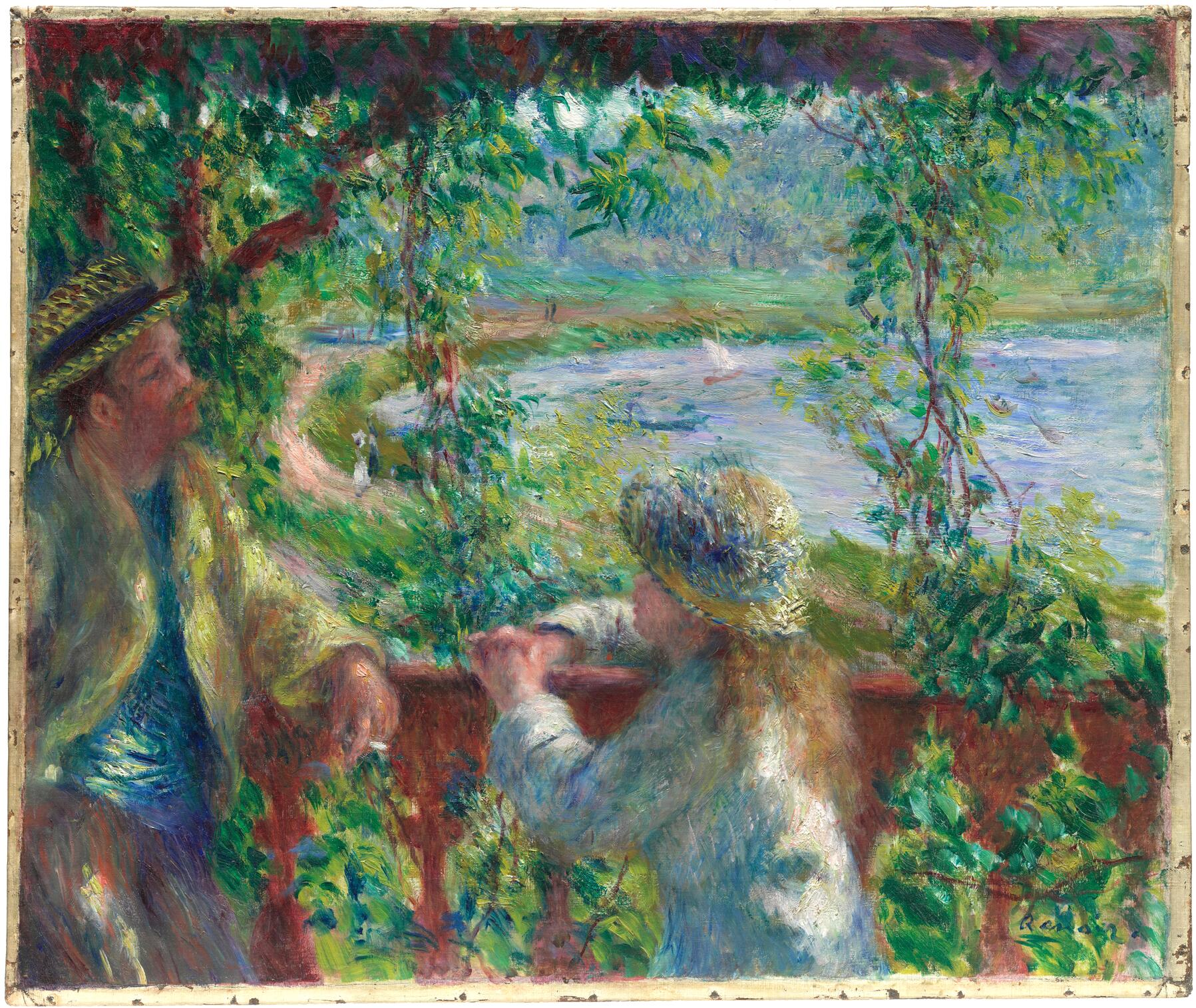
cat. 10 Near the Lake, 1879/80.
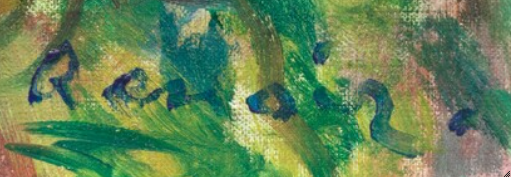
Detail of the signature in Renoir’s Near the Lake (1879/80). The Art Institute of Chicago, 1922.439.
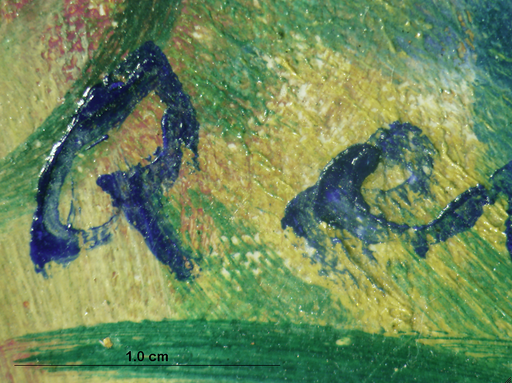
Photomicrograph of the signature in Renoir’s Near the Lake (1879/80). The Art Institute of Chicago, 1922.439.
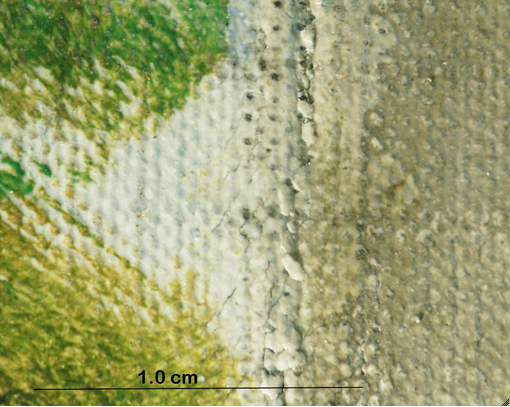
Photomicrograph of the ground in Renoir’s Near the Lake (1879/80) showing the edge of the presumably artist-applied additional preparatory layer. The Art Institute of Chicago, 1922.439.

Detail of the left edge of Renoir’s Near the Lake (1879/80). The original foldover was flattened when the dimensions were extended in a previous treatment, and the edge of the artist-applied additional ground was slightly crushed. The Art Institute of Chicago, 1922.439.
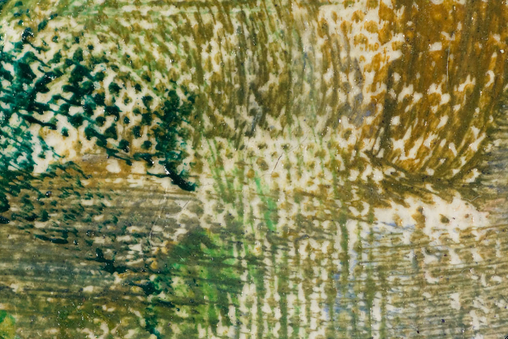
Detail of the background in Renoir’s Near the Lake (1879/80) showing the artist’s manipulation of the canvas texture despite the extremely smooth ground layers. The Art Institute of Chicago, 1922.439.
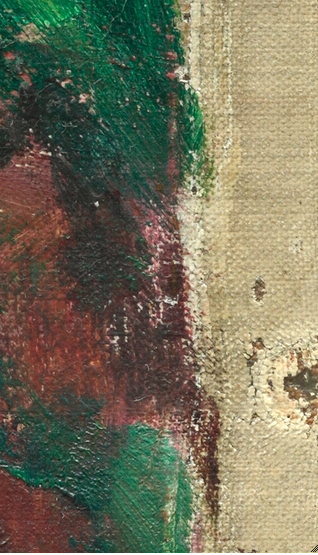
Detail of the right tacking margin of Renoir’s Near the Lake (1879/80) showing the brighter color of the ground where it was protected by a nail. The Art Institute of Chicago, 1922.439.
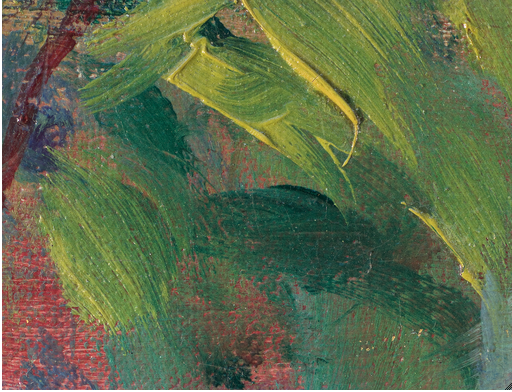
Detail of the foreground balustrade in Renoir’s Near the Lake (1879/80) showing the juxtaposition of translucent and opaque paints seen throughout the work. The Art Institute of Chicago, 1922.439.

Raking-light image of Renoir’s Near the Lake (1879/80) showing the variation in paint thickness throughout the work. The Art Institute of Chicago, 1922.439.
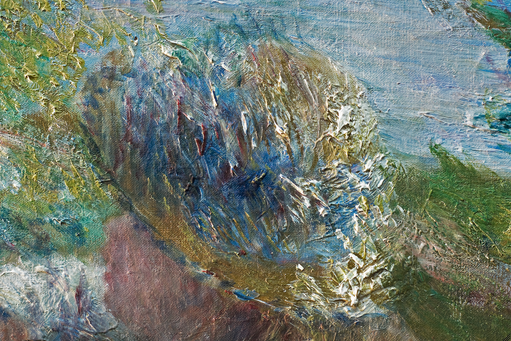
Detail of the girl’s hat in Renoir’s Near the Lake (1879/80). The slightly raking light highlights changes to the hat’s shape. The Art Institute of Chicago, 1922.439.
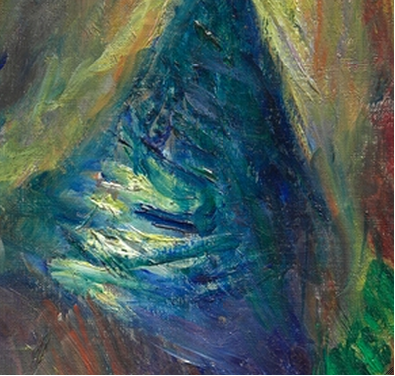
Detail of the male figure’s coat in Renoir’s Near the Lake (1879/80). Evidence of previous compositional choices is visible under normal viewing conditions. The Art Institute of Chicago, 1922.439.
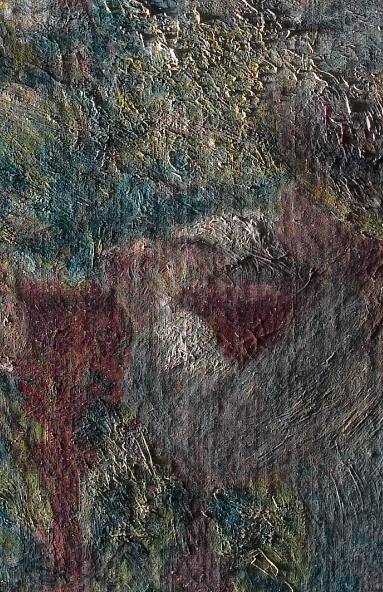
Raking-light detail of the girl in Renoir’s Near the Lake (1879/80) showing the thick, initial brushwork under the background below her arm. The Art Institute of Chicago, 1922.439.
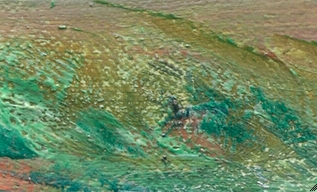
Detail of the background in Renoir’s Near the Lake (1879/80) showing earthy yellow paint covered with cool greens and touches of red. The Art Institute of Chicago, 1922.439.
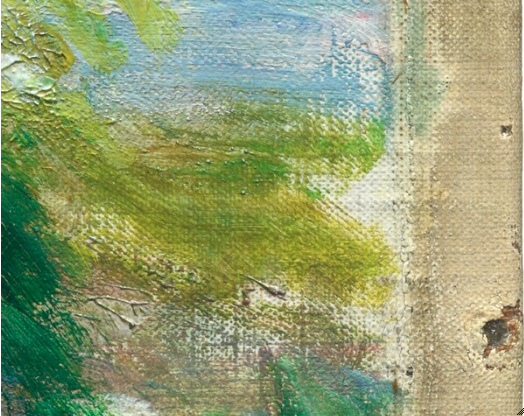
Detail of the right edge of Renoir’s Near the Lake (1879/80) showing the color of the preparatory layers. The Art Institute of Chicago, 1922.439.
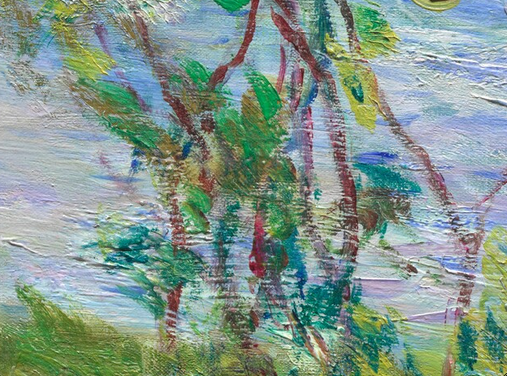
Detail of the hanging vines in Renoir’s Near the Lake (1879/80). These thinly painted vines skip over the underlying texture of the water, indicating that they were painted once the water was dry. The Art Institute of Chicago, 1922.439.
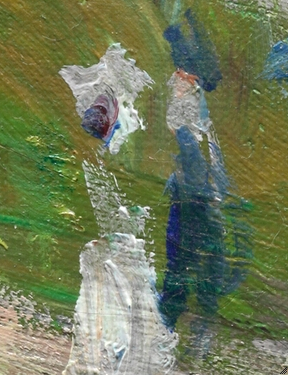
Detail of the couple walking beside the water in Renoir’s Near the Lake (1879/80). These figures were executed with a few quick brushstrokes near the end of the painting process. The Art Institute of Chicago, 1922.439.

Ultraviolet image of Renoir’s Near the Lake (1879/80) showing the widespread use of translucent, fluorescing red lake. The Art Institute of Chicago, 1922.439.
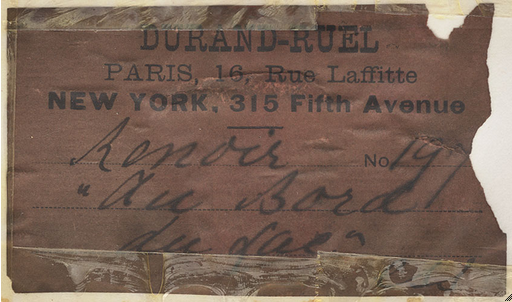
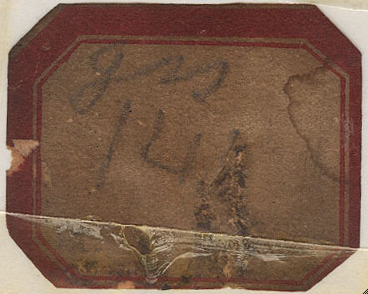
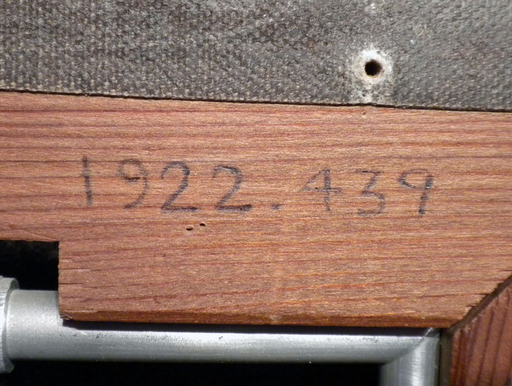
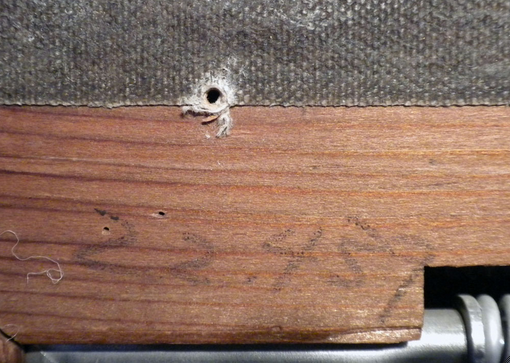
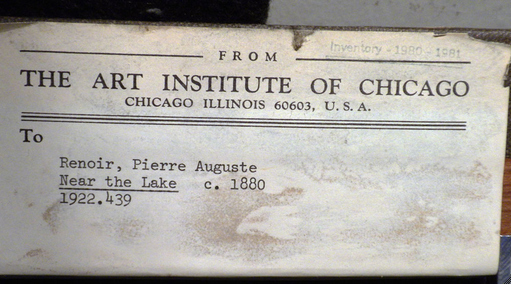
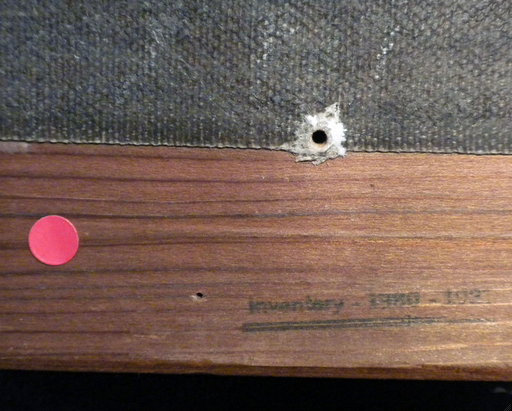
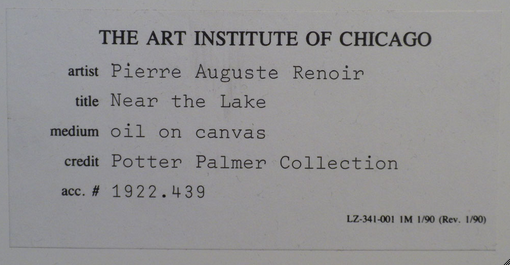
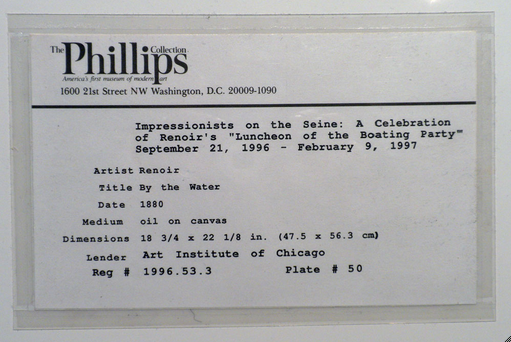
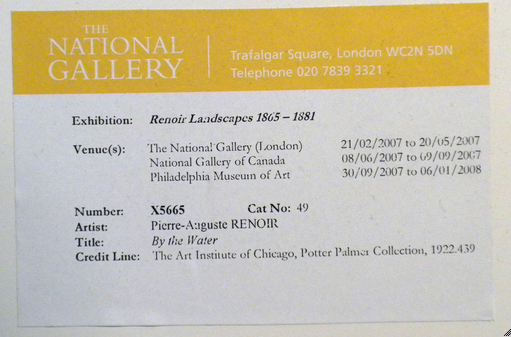
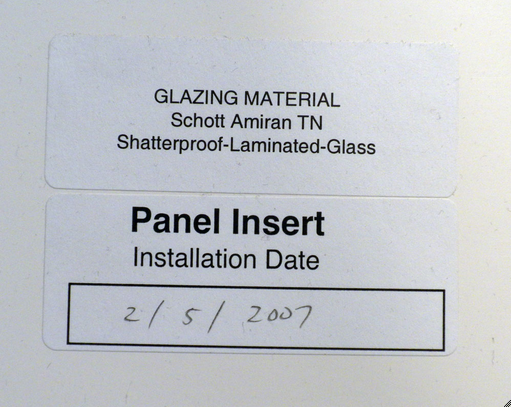
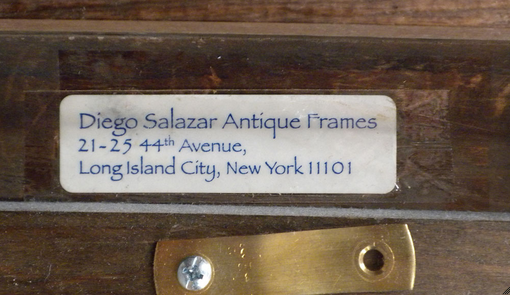
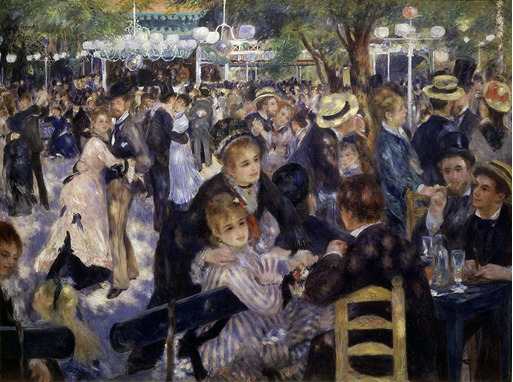
Pierre-Auguste Renoir (French, 1841–1919). Dance at the Moulin de la Galette, 1876. Oil on canvas; 131 × 175 cm (51 9/16 × 68 15/16 in.). Musée d’Orsay, Paris, bequest of Gustave Caillebotte, 1894, RF 2739. Gianni Dagli Orti / The Art Archive at Art Resource, NY.
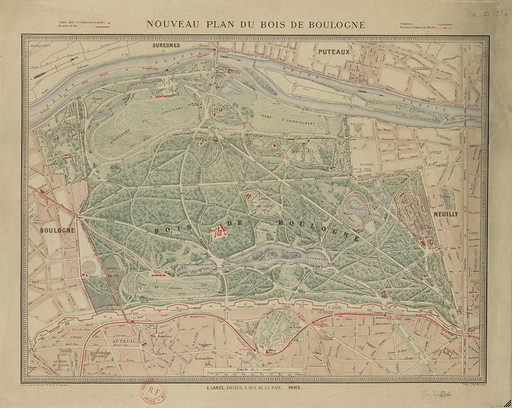
Nouveau Plan du Bois de Boulogne, 1884. Engraved by L. Sonnet, Paris. Printed by Lanée, Paris. Engraving; 51 × 40 cm (20 1/16 × 15 3/4 in.). Bibliothèque nationale de France, FRBNF40680165.
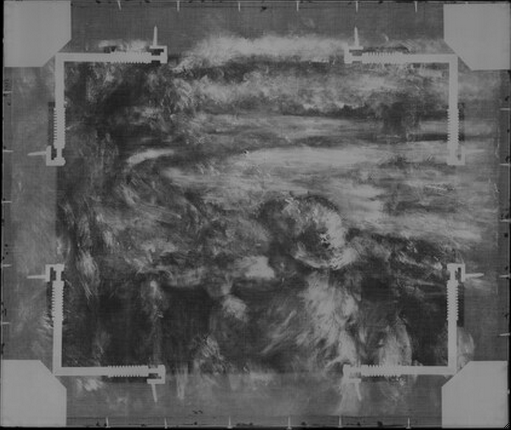
X-ray of Renoir’s Near the Lake (1879/80) showing the now-covered extended cloudy sky that once occupied the upper right. The Art Institute of Chicago, 1922.439. X-ray digitally composited by Robert G. Erdmann, University of Arizona.
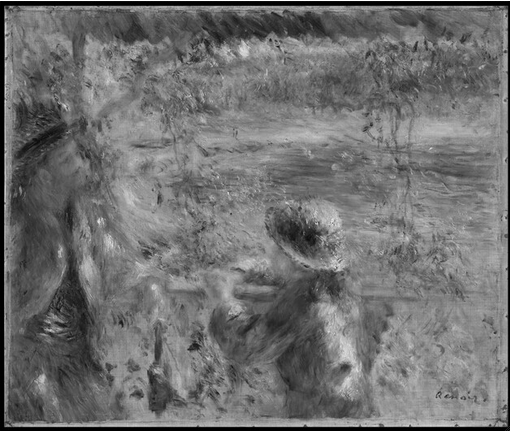
Infrared (Goodrich, 1.5–1.7 µm) image of Renoir’s Near the Lake (1879/80). The Art Institute of Chicago, 1922.439.
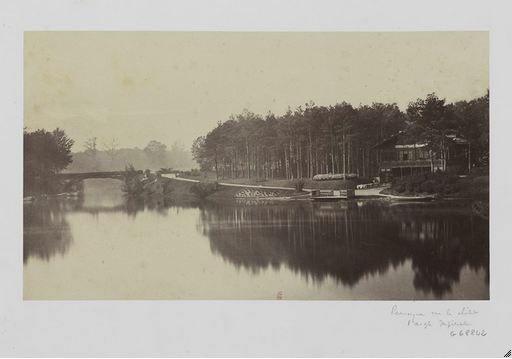
Charles Marville (Charles François Bossu; French, 1813–1879). Plate 12 from Album du Bois de Boulogne, 1858/60. Albumen print; 43 × 63 cm (16 15/16 × 24 13/16 in.). Bibliothèque nationale, Paris, FRBNF42299841.
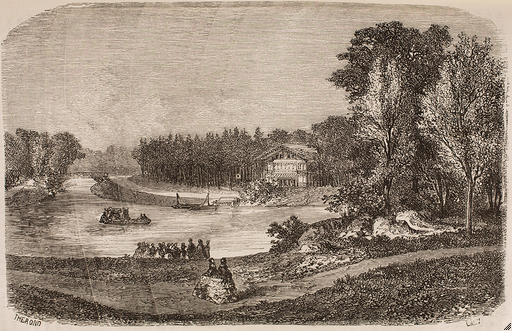
Adolphe Joanne (French, 1813–1881). “Rivière, iles et chalet,” from Paris illustré en 1870 et 1876: Guide de l'étranger et du Parisien, 3rd ed. (Hachette, 1876), p. 119.
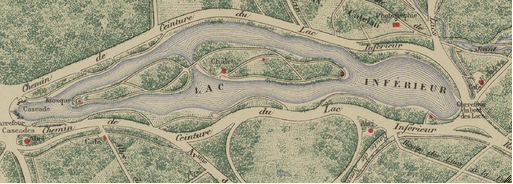
Detail of Nouveau Plan du Bois de Boulogne, 1884, showing the position of the Chalet des Îles, kiosk, and abri (shelters) overlooking the lac Inférieur. Engraved by L. Sonnet, Paris. Printed by Lanée, Paris. Engraving; 51 × 40 cm (20.1 × 15.7 in.). Bibliothèque nationale de France, FRBNF40680165.
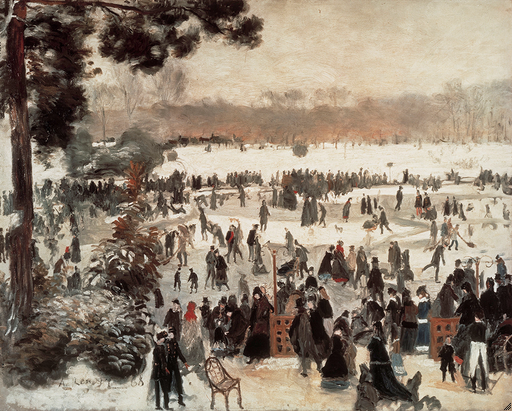
Pierre-Auguste Renoir (French, 1841–1919). Skaters in the Bois de Boulogne, 1868. Oil on canvas; 72 × 90 cm (28 3/8 × 35 7/16 in.). Collection of William I. Koch. Photo: akg images.
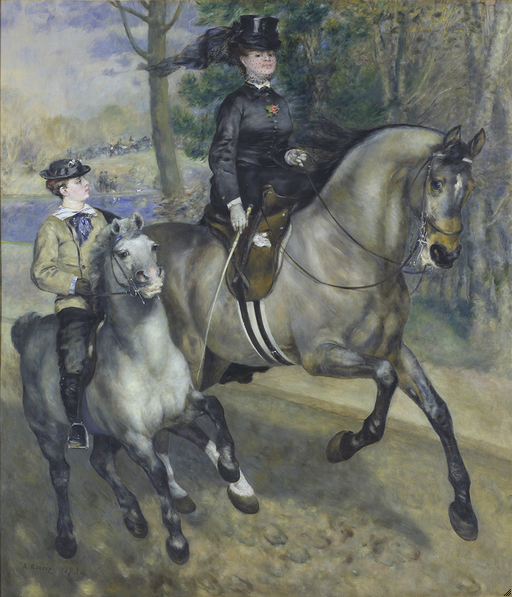
Pierre-Auguste Renoir (French, 1841–1919). Riding in the Bois de Boulogne, 1873. Oil on canvas; 261 × 226 cm (102 3/4 × 89 in.). Hamburger Kunsthalle, Hamburg, 1567. bpk, Berlin/Photo: Elke Walford/Art Resource, NY.
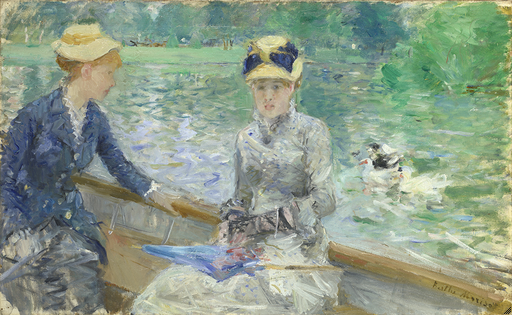
Berthe Morisot (French, 1841–1895). Summer’s Day, c. 1879. Oil on canvas; 45.7 × 75.2 cm (18 × 29 5/8 in.). The National Gallery, London. Lane Bequest, 1917, NG3264. © National Gallery, London/Art Resource, NY.

Detail of the wet-in-wet paint-mixing on the pink path in the background of Renoir’s Near the Lake (1879/80). The Art Institute of Chicago, 1922.439.
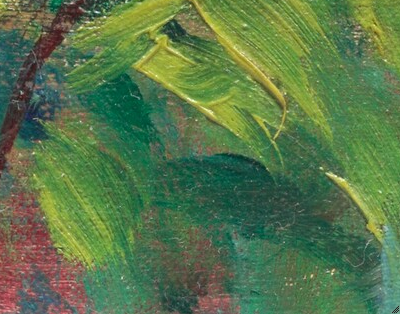
Detail of the foreground foliage in Renoir’s Near the Lake (1879/80) where the artist mixed yellow and green directly on the surface of the painting. The Art Institute of Chicago, 1922.439.
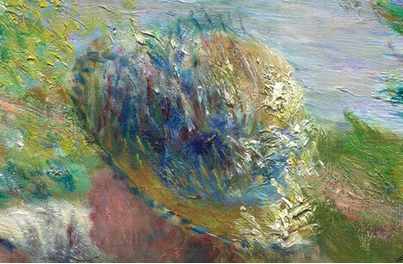
Detail of the girl’s hat from Renoir’s Near the Lake (1879/80). The Art Institute of Chicago, 1922.439.
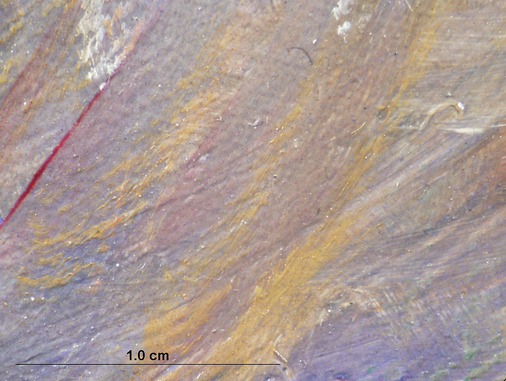
Photomicrograph showing strands of the girl’s hair against her dress, from Renoir’s Near the Lake (1879/80). The Art Institute of Chicago, 1922.439.
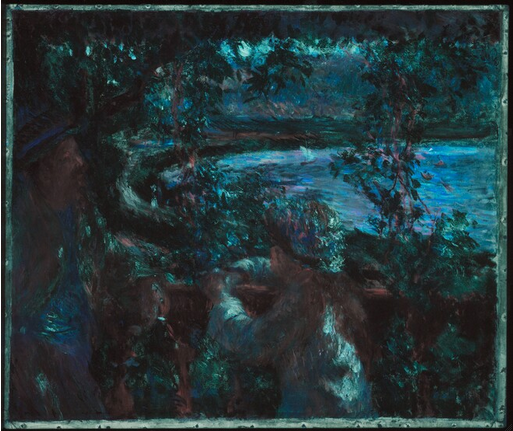
Ultraviolet image of Renoir’s Near the Lake (1879/80). The Art Institute of Chicago, 1922.439.
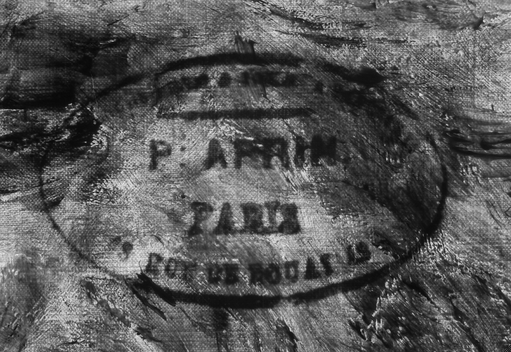
Transmitted-infrared (Fuji, 1.0–1.1 µm) image of the color merchant stamp on the verso of Renoir’s Near the Lake (1879/80). The Art Institute of Chicago, 1922.439.
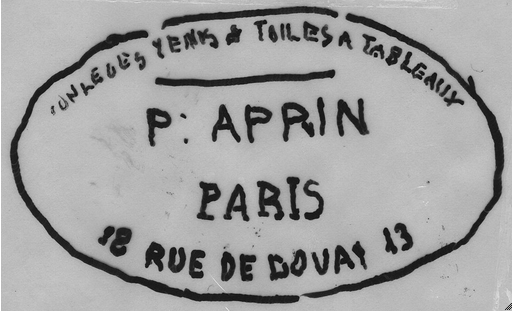
Tracing of the color merchant stamp on the verso of Renoir’s Near the Lake (1879/80). This tracing was made as a record of the verso before the 1971 lining. The Art Institute of Chicago, 1922.439.
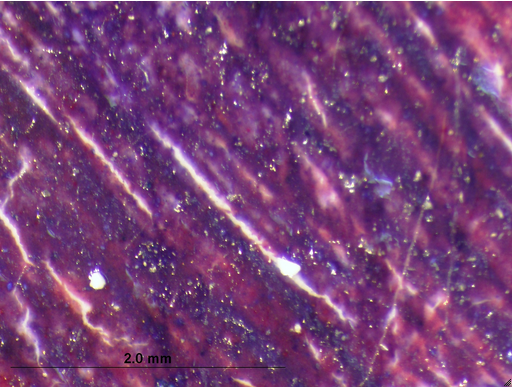
Photomicrograph of the overhang in Renoir’s Near the Lake (1879/80) showing the translucency of the paint. The Art Institute of Chicago, 1922.439.
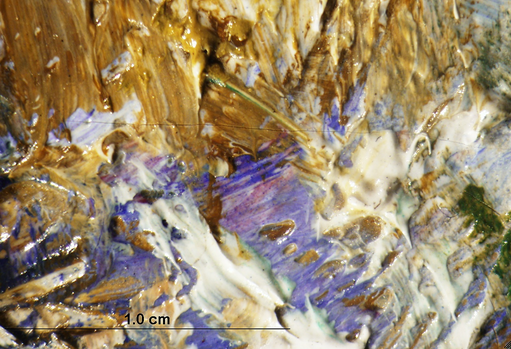
Photomicrograph of the girl’s hat in Renoir’s Near the Lake (1879/80) showing the artist’s use of thicker, opaque underlayers in some areas. The Art Institute of Chicago, 1922.439.
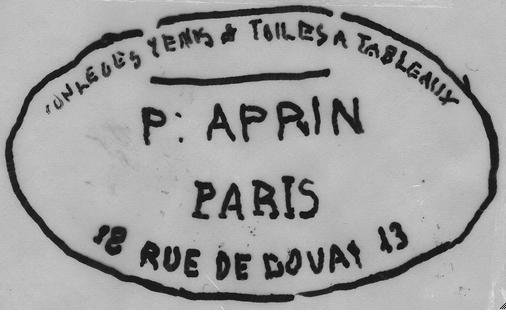
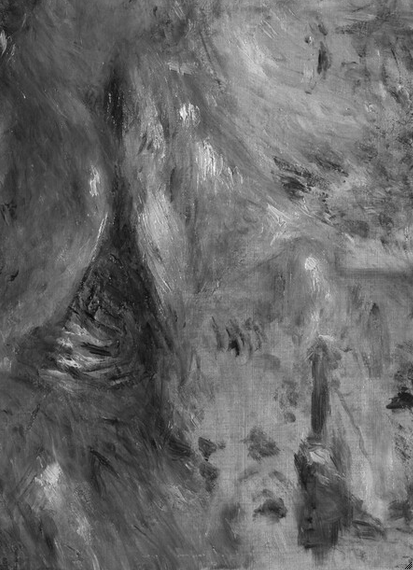
Detail of the male figure in the infrared image (Goodrich, 1.5–1.7 µm) of Renoir’s Near the Lake (1879/80). An unidentifiable object is seen extending from his left hand. The Art Institute of Chicago, 1922.439.
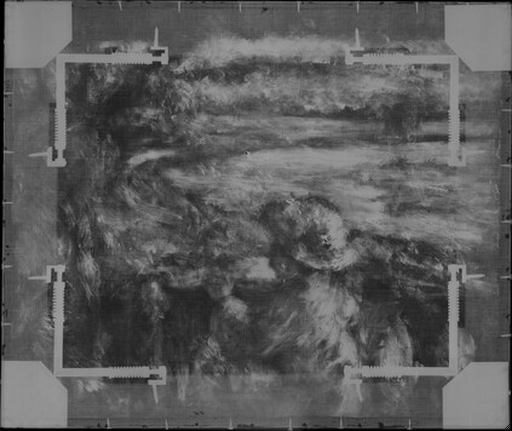
X-ray of Renoir’s Near the Lake (1879/80) showing that the cloudy sky once extended to the upper right in an earlier stage of the composition. The Art Institute of Chicago, 1922.439. X-ray digitally composited by Robert G. Erdmann, University of Arizona.
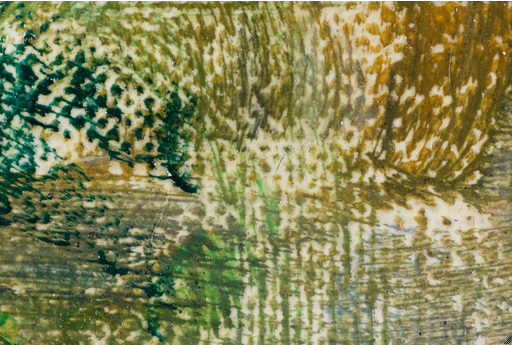
Detail of the background in Renoir’s Near the Lake (1879/80) showing the artist’s manipulation of the canvas texture despite the extremely smooth ground layers. The Art Institute of Chicago, 1922.439.
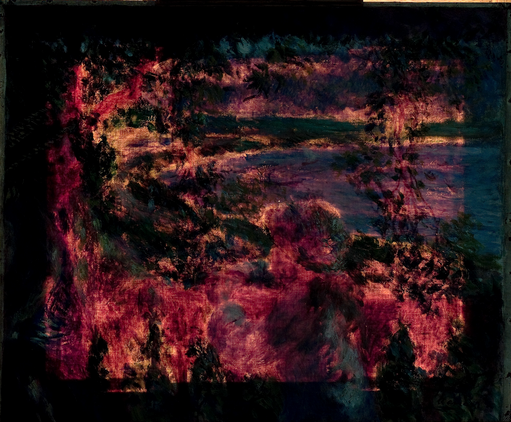
Transmitted light
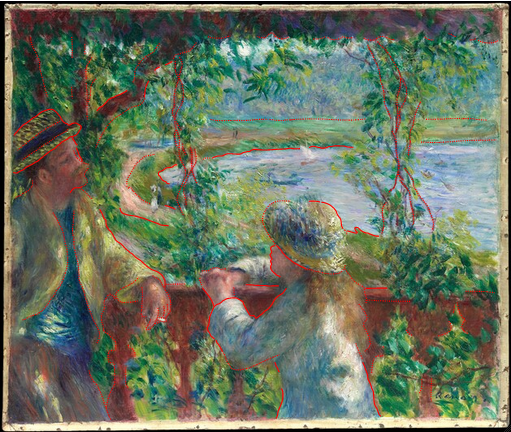
Renoir’s Near the Lake (1879/80). The Art Institute of Chicago, 1922.439. Interactive image.
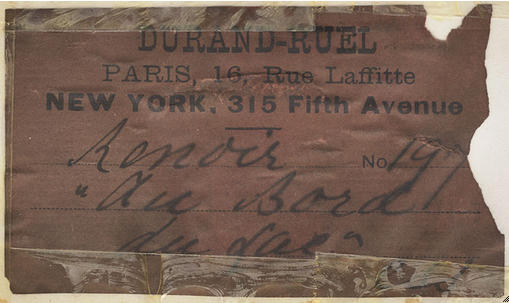
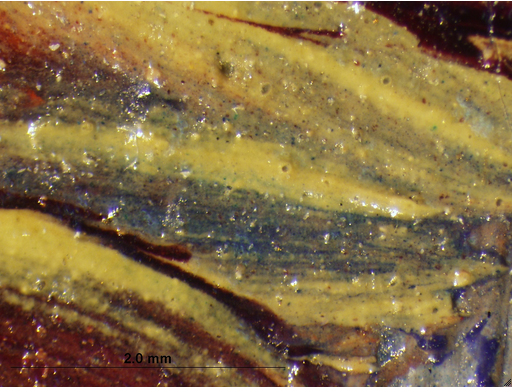
Photomicrograph of the male figure’s hat in Renoir’s Near the Lake (1879/80) showing wet-in-wet paint mixing. The Art Institute of Chicago, 1922.439.
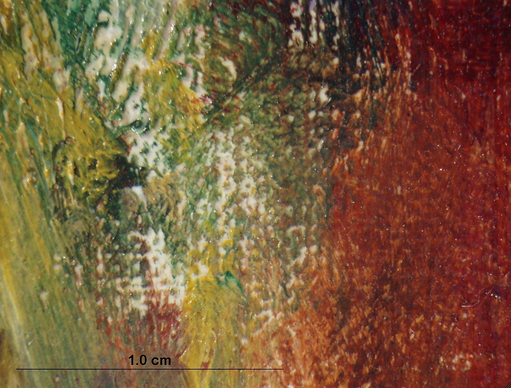
Photomicrograph of the foreground in Renoir’s Near the Lake (1879/80) showing successive brushstrokes catching only the thread tops and reinforcing the canvas texture. The Art Institute of Chicago, 1922.439.
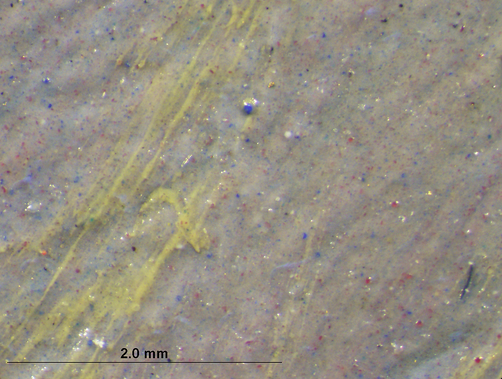
Photomicrograph of the girl’s hair in Renoir’s Near the Lake (1879/80) showing the artist’s articulation of individual strands of hair with a lightly loaded, stiff-bristle brush. The Art Institute of Chicago, 1922.439.
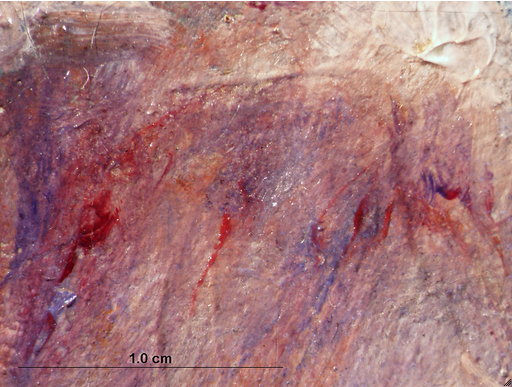
Photomicrograph of the girl’s hand in Renoir’s Near the Lake (1879/80) showing the wet-in-wet brushwork in the flesh tones. The Art Institute of Chicago, 1922.439.
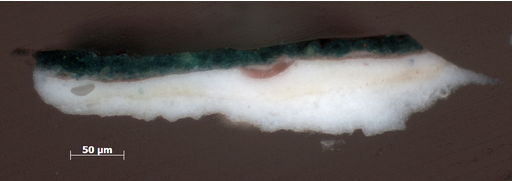
Photomicrograph of a cross section from Renoir’s Near the Lake (1879/80) showing the ground and at least two paint layers (pink and green). Original magnification: 200×. The Art Institute of Chicago, 1922.439.
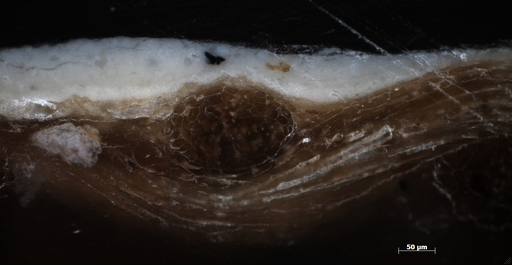
Photomicrograph of a cross section from Renoir’s Near the Lake (1879/80) showing the commercial ground and canvas. Original magnification: 200×. The Art Institute of Chicago, 1922.439.
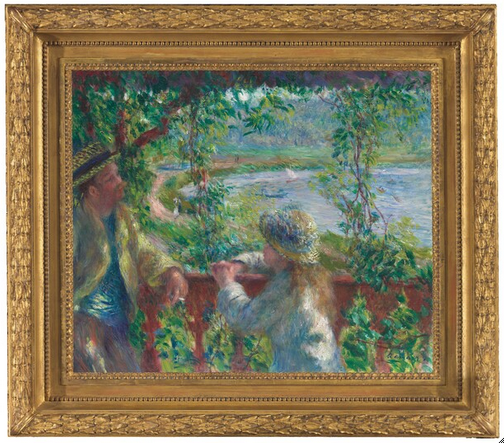
Renoir’s Near the Lake (1879/80) in its current frame. The Art Institute of Chicago, 1922.439.
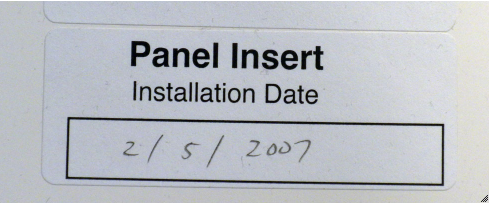
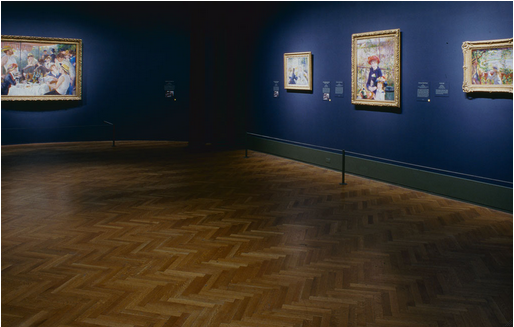
Installation of Monet’s Near the Lake in Renoir’s Portraits: Impressions of an Age, Art Institute of Chicago, Oct. 17, 1997–Jan. 4, 1998. Institutional Archives, Art Institute of Chicago.
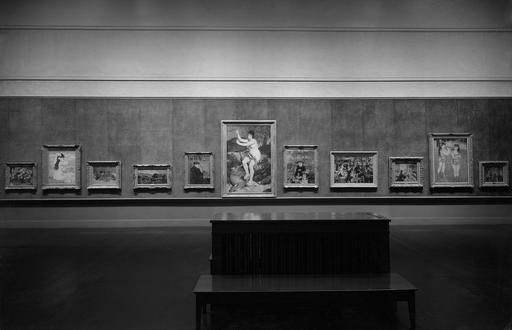
Installation of Renoir’s Near the Lake (1879/80) in “A Century of Progress”: Loan Exhibition of Paintings and Sculpture, Art Institute of Chicago, May 23–Nov. 1, 1933. Institutional Archives, Art Institute of Chicago.
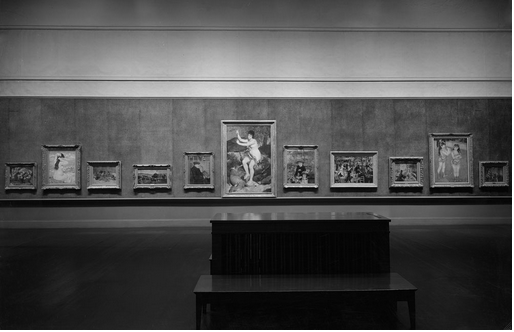
Renoir’s Near the Lake (1879/80) in a previous frame, seen here on the far right, installed in “A Century of Progress”: Loan Exhibition of Paintings and Sculpture, Art Institute of Chicago, May 23–Nov. 1, 1933. Institutional Archives, Art Institute of Chicago.
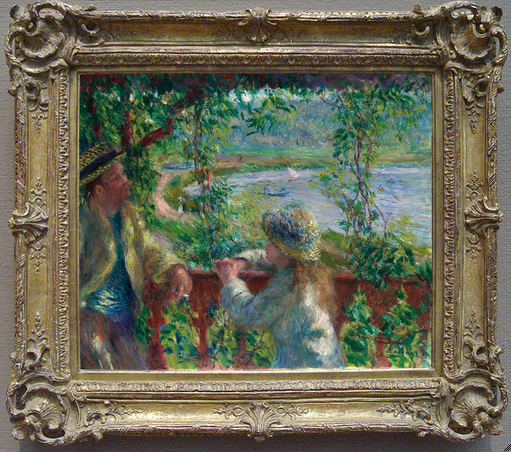
Renoir’s Near the Lake (1879/80) in a previous frame. The Art Institute of Chicago, 1922.439.
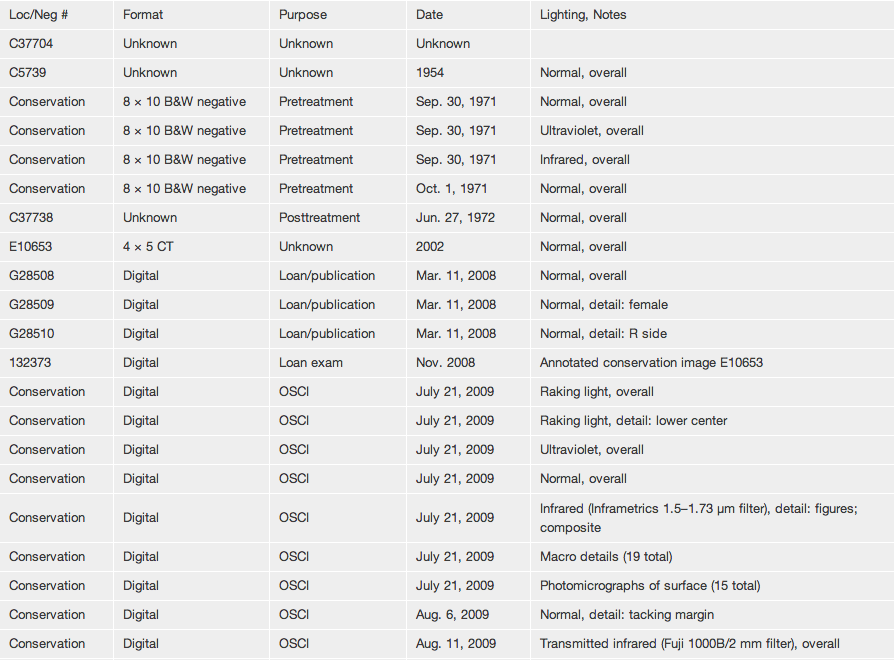
| Loc/Neg # | Format | Purpose | Date | Lighting, Notes |
| C37704 | Unknown | Unknown | Unknown | |
| C5739 | Unknown | Unknown | 1954 | Normal, overall |
| Conservation | 8 × 10 B&W negative | Pretreatment | Sep. 30, 1971 | Normal, overall |
| Conservation | 8 × 10 B&W negative | Pretreatment | Sep. 30, 1971 | Ultraviolet, overall |
| Conservation | 8 × 10 B&W negative | Pretreatment | Sep. 30, 1971 | Infrared, overall |
| Conservation | 8 × 10 B&W negative | Pretreatment | Oct. 1, 1971 | Normal, overall |
| C37738 | Unknown | Posttreatment | Jun. 27, 1972 | Normal, overall |
| E10653 | 4 × 5 CT | Unknown | 2002 | Normal, overall |
| G28508 | Digital | Loan/publication | Mar. 11, 2008 | Normal, overall |
| G28509 | Digital | Loan/publication | Mar. 11, 2008 | Normal, detail: female |
| G28510 | Digital | Loan/publication | Mar. 11, 2008 | Normal, detail: R side |
| 132373 | Digital | Loan exam | Nov. 2008 | Annotated conservation image E10653 |
| Conservation | Digital | OSCI | July 21, 2009 | Raking light, overall |
| Conservation | Digital | OSCI | July 21, 2009 | Raking light, detail: lower center |
| Conservation | Digital | OSCI | July 21, 2009 | Ultraviolet, overall |
| Conservation | Digital | OSCI | July 21, 2009 | Normal, overall |
| Conservation | Digital | OSCI | July 21, 2009 | Infrared (Inframetrics 1.5–1.73 µm filter), detail: figures; composite |
| Conservation | Digital | OSCI | July 21, 2009 | Macro details (19 total) |
| Conservation | Digital | OSCI | July 21, 2009 | Photomicrographs of surface (15 total) |
| Conservation | Digital | OSCI | Aug. 6, 2009 | Normal, detail: tacking margin |
| Conservation | Digital | OSCI | Aug. 11, 2009 | Transmitted infrared (Fuji 1000B/2 mm filter), overall |
| Conservation | Digital | OSCI | Aug. 11, 2009 | Transmitted infrared (Fuji 1000B/2 mm filter), detail: stamp |
| Conservation | X-ray | OSCI | Aug. 12, 2009 | X-ray films scanned/digitally composited, overall |
| G32181 | Digital | OSCI | Aug. 25, 2009 | Normal, frame only |
| G32182 | Digital | OSCI | Aug. 25, 2009 | Normal, composite with frame |
| G32192 | Digital | OSCI | Aug. 25, 2009 | Normal, overall |
| Conservation | Digital | OSCI | Sep. 24, 2009 | Detail images of verso, frame, labels (4 total) |
| Conservation | Digital | OSCI | Jan. 27, 2010 | Photomicrogaph of sample site |
| Conservation | Digital | OSCI | Jan. 29, 2010 | Transmitted light, overall |
| G39508 | Digital | OSCI | Feb. 8, 2012 | Normal, overall |
| G39509 | Digital | OSCI | Feb. 8, 2012 | Section |
| G39510 | Digital | OSCI | Feb. 8, 2012 | Section |
| G39511 | Digital | OSCI | Feb. 8, 2012 | Section |
| G39512 | Digital | OSCI | Feb. 8, 2012 | Section |
| G39513 | Digital | OSCI | Feb. 8, 2012 | Section |
| G39514 | Digital | OSCI | Feb. 8, 2012 | Section |
| G39515 | Digital | OSCI | Feb. 8, 2012 | Section |
| G39516 | Digital | OSCI | Feb. 8, 2012 | Section |
| G39517 | Digital | OSCI | Feb. 8, 2012 | Section |
| G39047 | Digital | OSCI | Feb. 8, 2012 | Normal, overall; composite of G39509–G39517 |
| G39048 | Digital | OSCI | Feb. 8, 2012 | Ultraviolet, overall |
| Conservation | Digital | OSCI | Feb. 10, 2012 | Infrared (Goodrich, 1.5–1.7 µm J filter), overall; composite |
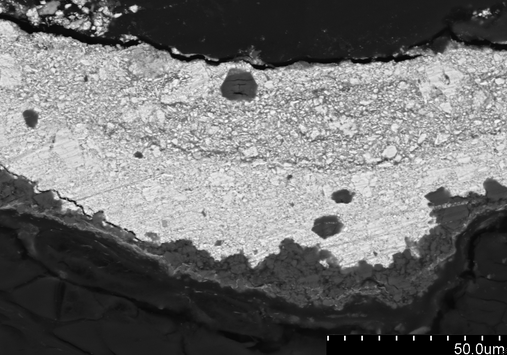
Backscattered electron image of a cross ection of the ground in Renoir’s Near the Lake (1879/80) showing the three-layer commercial ground. Original magnification: 850×. The Art Institute of Chicago, 1922.439.
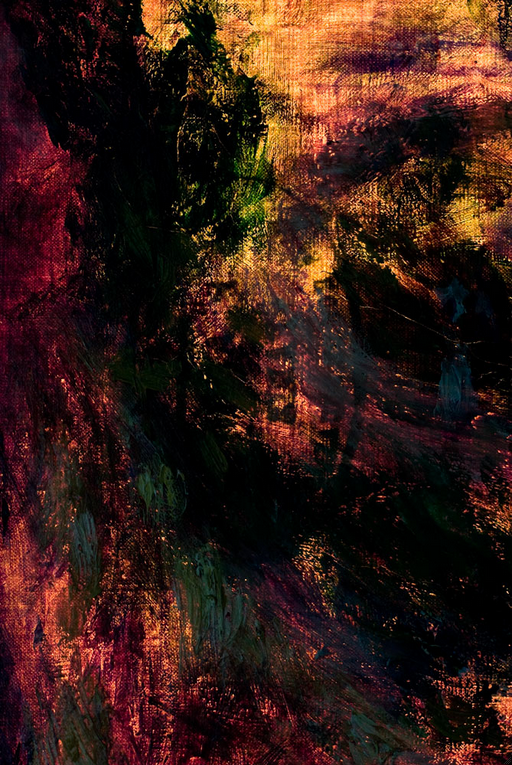
Two Sisters (On the Terrace)680
1881
Oil on canvas; 100.4 × 80.9 cm (39 1/2 × 31 7/8 in.)
Signed: Renoir. 81. (lower right, in blue paint)
The Art Institute of Chicago, Mr. and Mrs. Lewis Larned Coburn Memorial Collection, 1933.455
With its representation of rowing and sailboats moored at the quay and its elevated point of view over a verdant landscape, Two Sisters (On the Terrace) is a colorist’s homage to the pastoral experience of Chatou. The painting brings to a close Renoir’s work at the Restaurant Fournaise painting views of leisure boating along the Seine, a period that began in 1875, the year he painted Lunch at the Restaurant Fournaise (The Rower’s Lunch) (cat. 2). Why the artist abandoned the popular establishment and its convivial owners remains a mystery, as Renoir loved it there and recommended it to others. Writing in the late summer of 1880 to the collector Georges de Bellio, Renoir explained that he was too busy with Luncheon of the Boating Party (fig. 2.58 [Daulte 379; Dauberville 224]) to come to Paris, but he urged de Bellio to visit him at Chatou: “You would do well to choose a day and come to lunch. You will not be sorry you made the trip; this is the most attractive spot in the countryside around Paris.”681 Two Sisters (On the Terrace) is the Primavera (Allegory of Spring) to Luncheon of the Boating Party’s summer bacchanal.682 The leaves are still unfurling on the trees, and bright spring blossoms abound. In a letter to Théodore Duret from Chatou on Easter Monday, April 18, 1881, Renoir again expressed reluctance to leave for a planned trip to England with the art critic because of his work on Two Sisters (On the Terrace): “I am struggling with trees in bloom, with women and children, and wish to see nothing beyond that. . . . The weather is fine and I have my models; that’s my only excuse.”683
Soon after the painting was finished, the art dealer Paul Durand-Ruel purchased it from Renoir as Femme sur une terrasse au bord de la Seine for 1,500 francs, the sum Renoir reportedly had received three years earlier for the substantially larger portrait Madame Georges Charpentier and Her Children (1878; Metropolitan Museum of Art, New York [Daulte 266; Dauberville 239]).684 Given the difficulties Renoir expressed in executing the painting and the high price he received, one could speculate that the work was commissioned by the dealer. The role of Two Sisters (On the Terrace) as a promotional vehicle for Impressionism began almost immediately, when a rare color reproduction was published in late 1881 in L’art de la mode.685 In March 1882 the painting was included in the seventh Impressionist exhibition with the new title Les deux soeurs (see fig. 2.19). Durand-Ruel contributed twenty-five Renoir works from his stock after the artist refused to participate because he perceived Paul Gauguin and Camille Pissarro to be overly political.686 The following year the painting reappeared under a third title—Femme sur une terrasse (Chatou)—in Renoir’s retrospective exhibition organized by Durand-Ruel and held on the boulevard de la Madeleine.687 Although Two Sisters (On the Terrace) was an eminently salable work, Durand-Ruel did not part with it for nearly four and a half decades.688 The painting was reproduced as an etching in a full-page illustration in Georges Lecomte’s 1892 account of Durand-Ruel’s private collection, one of a select number of Impressionist paintings the dealer kept for himself (see fig. 3.60). Not surprisingly, Lecomte presented Durand-Ruel as a visionary who at an early date recognized the innovative accomplishment of the Impressionists even while the French State remained undecided. For Lecomte the works in Durand-Ruel’s private collection offered a complete history of Impressionism and represented the best of each artist’s talent.689 In his discussion of Two Sisters (On the Terrace), Lecomte praised the color in the landscape elements and, in describing the figure of the young woman, commented on Renoir’s evocation of the Old Masters: “The insinuating and crafty grace of her sly face is accentuated by the malicious obliquity and alarming smile in her eyes. She has the look of a modern Mona Lisa who knows all about love and seduction and is shamelessly flirting with you.”690 While the Durand-Ruel family owned the painting, it appeared before the public in at least seventeen exhibitions or gallery displays and was continually reproduced (see Exhibition History and Selected References). It was only after Paul Durand-Ruel’s death in June 1922 that the painting was sold to Mrs. Lewis Larned Coburn of Chicago (see Provenance).
Despite the title Les deux soeurs, assigned to the painting by Durand-Ruel for the 1882 Impressionist exhibition, the little girl was not the sister of the seated figure, who was eighteen-year-old Eugénie Marie Darlaud, known as Jeanne Darlaud, an aspiring actress (see fig. 2.5).691 For his painting Luncheon of the Boating Party, Renoir depicted known habitués of the Restaurant Fournaise as well as an elite group of cultural aficionados, including the actress Jeanne Samary, who had recently been appointed sociétaire of the Comédie Française. In Two Sisters (On the Terrace) he again drew from the Parisian theater world. Here Darlaud played the role of a canotière (rower), a free spirit who divided her time between Parisian dance halls and a life of leisure along the Seine. Such a character was later immortalized in Guy de Maupassant’s novel Yvette (1884), but even in 1881 the canotière had been inspiring writers and poets for some time.692
Paul Durand-Ruel first made the association between this painting and the Darlaud family in 1923, when he mistakenly recalled that the young woman pictured was Jeanne Darlaud’s younger sister Anne (known by her stage name, Jane Demarsy), who also modeled for Renoir. Durand-Ruel’s confusion may have arisen because Anne posed for Renoir in an unknown setting wearing the same boating costume: a blue dress with a cape or hood attached, and a hat of the same design with beige finish around the brim, but blue rather than red (fig. 2.8 [Daulte 424; Dauberville 1060]).693 It was the art historian François Daulte who eventually identified the model as Jeanne.694 The collector and art dealer René Gimpel described the Darlaud sisters as girls of humble origins who worked for Renoir as a necessary source of income.695 As Colin Bailey discovered, they were the daughters of a bookbinder and a brocade weaver, and their grandfather was a cabinetmaker from Limoges who probably knew Renoir’s father, Léonard, a tailor from that city.696 Jeanne Darlaud entered the Conservatoire in August 1882 and soon afterward began a busy career on the French stage, from which she retired in 1899. After her death in 1914, her cash assets totaled more than 574,000 francs, the result of gifts from a wealthy and generous seigneur, apparently the chocolate manufacturer Gaston Menier, who was listed as the trustee of her hôtel particulier on the avenue de Friedland.697
The little girl in the painting has never been identified, and the artist left no clues to the relationship she might share with the young woman, leaving viewers to draw their own conclusions. Difference in age is not enough to explain the lack of engagement, the look of boredom that Lecomte took for crafty grace or the apparent absence of emotion in the child’s expression. Certainly in Madame George Charpentier and Her Children (fig. 2.11), Renoir proved himself capable of conveying warmth and love between family members. That he seems to have made no attempt to do so in Two Sisters (On the Terrace) may have to do with the fact that it is a genre painting, while the other is a portrait commissioned by an important patron. In its treatment of the subject of an adult and a child, Two Sisters (On the Terrace) is conspicuously different from a painting of the same year by Berthe Morisot, Eugène Manet and His Daughter at Bougival (fig. 2.14), which also appeared in the seventh Impressionist exhibition.698
If Two Sisters (On the Terrace) presents an idyllic scene, timeless in its serenity, its composition is quite sophisticated, with surprising contrasts in the figure-ground relationship. For the landscape setting Renoir used loose, expressive brushwork, whereas he rendered the figures with a more controlled brush and precise modeling of solid colors. He painted directly on the canvas, using red lake to outline at least some of the forms, as can be seen around the seated figure’s right eye (fig. 2.18). There are no known preparatory sketches, though the artist had dealt with the theme of a single female figure on a terrace at least twice in the previous two years, in Alphonsine Fournaise in 1879 (fig. 2.9 [Daulte 301; Dauberville 321]) and Young Girl Seated in about 1880 (fig. 2.10 [Daulte 356; Dauberville 323]).699 In the latter painting, the young woman sits in a chair with a fabric back and arms, of comparable design to that in Two Sisters (On the Terrace). Changes to the background to the right of Jeanne Darlaud’s head and above the planter indicate that Renoir wished to subdue objects in the background landscape to give it a more nascent, diaphanous look in keeping with the season. For example, the shoreline path may originally have included two figures above the railing to the left of Jeanne’s head, visible in the infrared image (fig. 2.17). Renoir painted over these in favor of a single rowing figure in a skiff that blends into the line of the river.
In the background, thin layers of pink and blue tones were laid in first for the water, followed by short strokes of denser blues and whites to convey a rich and varied river surface with light playing over the ripples and waves. The foliage and tree branches were painted with the lightest of touches in greens, pale grays, and mauves. So transparent are the paint layers that they seem like a veil through which can be glimpsed skiffs, moored sailboats, and the opposite bank. There is plenty of white or light-colored paint in the background that increases the impression of sparsity in the vegetation, especially along the left side of the canvas. Infrared imaging reveals that Renoir originally painted a second set of curving decorations between the rails of the balcony and halfway down their length. Traces of this decoration are still visible beneath the upper paint layers to the left of the seated figure’s elbow (see fig. 2.46). Their removal allowed the blossoming trees behind to have a fuller and wilder presence.
Compared to the gossamer landscape, the two female figures are finely modeled with generous amounts of paint. This distinctly different treatment of background and figure was a change from Renoir’s work of the 1870s, where he made use of a “pantheistic” brushstroke that did not differentiate between the viewing planes. Alfred Sisley (1876; cat. 4), exhibited at the third Impressionist exhibition of April 1877, is a good example of the stippled brushwork of these 1870s portraits. In contrast, the flesh tones in Two Sisters (On the Terrace) were painted with barely visible strokes that carefully integrated the red and white tones. The deep blue of the young woman’s boating costume appears sculptural against the willowy trees and spring blooms that surround her. The blending of red lake over the blue creates darker shadows in the dress at the elbow, while the highlights of reflected sunlight on her chest result from thin films of yellow. Despite the firmer appearance of the figures, they are no less luminous. There is plenty of lead white in the little girl’s dress, and the flesh tones have a porcelain-like clarity, touched with red to give color to the cheeks. In depicting the young woman wearing a bright red hat with her dark blue dress, Renoir achieved a striking juxtaposition of primary colors. An audacious rendering, but one that may have been inspired by the bold fashions of boaters on the Seine. In his novel Yvette, Guy de Maupassant related that the canotières at this time wore “a dress of blue flannel or red flannel, a parasol, also red or blue, open over their head, brilliant under the hot sun. . . .”700
The basket of wool appears to have been included in order to give the foreground more substance and color. Such an accessory was unlikely to have been found on the premises of the Maison Fournaise, which rented boats and ran a restaurant, unless it was brought by one of the boarding guests. The wool seems of little interest to either of the figures, who interact with it no more than they interact with each other. Colin Bailey has pointed out that criticism of Renoir frequently incorporated references to wool; he surmises that “Renoir incorporates this critical trope in order to deflate it.”701
Two Sisters (On the Terrace) is a genre painting that portrays what Renoir valued most about everyday life along the Seine: the opportunity for enjoyment of nature and good company away from the urban distractions of Paris.
John Collins
The work was executed on a standard-size, commercially prepared [glossary:canvas] with a manufacturer’s stamp on the verso, now only visible in transmitted light due to a subsequent [glossary:lining] (see Conservation History). The canvas is of a fine [glossary:weave] and has a smooth, white [glossary:ground] that moderately fills the weave. While there is no apparent [glossary:underdrawing], examination in transmitted light indicates that Renoir may have outlined some of the major forms at some point early in the painting process. The nature and sequence of these lines is ambiguous, as some appear to have been worked into the upper paint layers while still wet. [glossary:Transmitted-light] and [glossary:X-ray] images also illustrate that changes were made to the figures. The woman’s head and hat were altered and her right arm brought closer to her body. The artist heavily painted out his original placement of the woman’s facial features before settling on the final arrangement, but the faint outline of an eye is visible above and to the right of her left eye, indicating more substantial changes. These images also show something of Renoir’s working method, especially with regard to the child. Here he wiped away flesh-colored paint from the child’s forehead and cheeks and altered the color and texture in these areas with subsequent, much thinner paint layers. The artist used scraping to remove previous compositional choices along the right side of the woman’s collar and in large areas of the background. This reworking is apperent only in the x-ray; there is a no textural evidence of it on the surface. He reworked much of the background, exchanging fuller, more substantial foliage for the finer, more ephemeral leaves and vines now visible.
The multilayer interactive image viewer is designed to facilitate the viewer’s exploration and comparison of the technical images (fig. 2.56).702
Signed and dated: Renoir. 81. (lower right, in blue paint) (fig. 1.2, fig. 1.1).703
Flax (commonly known as linen).704
The original dimensions of the canvas were approximately 100 × 81 cm, according to 1972 pretreatment measurements. This is consistent with measurements from the apparent original [glossary:foldover] and corresponds to a no. 40 portrait ([glossary:figure]) standard-size (100 × 81 cm) canvas.705
[glossary:Plain weave]. Average [glossary:thread count] (standard deviation): 30.9V (0.8) × 25.9H (1.1) threads/cm. The vertical threads were determined to correspond to the [glossary:warp] and the horizontal threads to the [glossary:weft].706
There is mild [glossary:cusping] corresponding to the placement of the original tacks. The thread density along the warp (vertical) threads increases toward the right side of the canvas (fig. 2.20). The warp threads near the right edge of the canvas have [glossary:primary cusping], which indicates that this canvas was near the edge of the preprimed roll during commercial preparation (fig. 1.3).707 Any evidence of an unprimed edge or selvedge was removed from this side before or just after stretching.
Current stretching: When the painting was relined and restretched in 1972, the original dimensions were increased slightly on all sides (see Conservation History).
Original stretching: Based on secondary cusping visible in the X-ray, the original tacks were placed approximately 5–8 cm apart.
Current stretcher: Five-member [glossary:ICA spring stretcher] with a metal horizontal [glossary:crossbar]. Depth: 2.8 cm.
Previous stretcher: Because the painting was already lined when the 1972 treatment was undertaken, it is unclear whether the stretcher that was removed at that time was original to the painting; however, that stretcher was a six-member, keyable, mortise-and-tenon stretcher with vertical and horizontal crossbars. Depth: approximately 1.6 cm.708
Stamp
Location: verso of original canvas (covered by lining)
Method: ovular stamp
Content: [COULEURS FINES & TOILES À TABLEAUX] / P: APRIN / PARIS / [48 RUE DE DOUAI 48] (fig. 1.4, fig. 2.22)709
Not determined (probably glue).710
The painting features a two-layer commercial ground that extends to the edges of the [glossary:tacking margins]. The layer lower is approximately 3–45 µm thick, while the upper layer is approximately 15–75 µm thick. Overall the preparation is smooth and moderately fills the weave. The ground is left visible in some areas of the painting, especially on the upper left.
The upper layer of the ground appears white, with no colored particles visible under stereomicroscopic or cross-sectional examination (fig. 2.23). The lower, chalk-based layer appears creamy white in cross sections.
The commercial preparation is a two-layer priming beginning with a calcium-carbonate (chalk) layer (fig. 2.44); this layer also contains traces of complex silicates (clays).711 The upper layer is predominantly lead white with a small amount of calcium-based white and traces of barium sulfate, silica, alumina, and complex iron-containing silicates (fig. 2.45).712 The [glossary:binder] of the upper layer is estimated to be [glossary:oil].713
No underdrawing was observed with [glossary:infrared reflectography] or under microscopic examination. In transmitted light and transmitted infrared, outlines can be seen around the major forms, but it is unclear at which stage in the painting process these lines were made (fig. 1.4). Close examination of the eyes under the microscope indicates that Renoir may also have used red lake to mark forms in the early painting stages (fig. 2.26).
The X-ray, infrared, and [glossary:transmitted-light] images indicate that Renoir made a number of changes to the composition. They also reveal something of his technique and application of paint. In some areas, evidence of scraping back and painting out earlier forms hints at compositional changes; however, the exact nature of these changes remains hidden. In certain places, the artist seems to have wiped or scraped paint away, then further painted out evidence of earlier choices to give himself a cleaner slate, as in the background to the right of the woman’s head. In many areas of the background, especially immediately around the woman’s head, large strokes resembling heavy tree branches or shrubs, and an unidentified round form on the right, appear to have been painted out in favor of finer, more atmospheric foliage. Immediately behind the figures, heavier greenery, like that still visible on the left above the basket, is still faintly discernible behind the vines and finer strokes of vegetation. On the left, above the railing, Renoir seems to have initially articulated a shoreline path with two walking figures, seen in infrared examination (fig. 2.27), which were subsequently painted out and replaced with a skiff and rower (fig. 2.28). Most of the background itself appears to be underpainted in modulated blues and pinks, perhaps related to the depiction of the water, while the upper layers—including the finer branches, leaves, and vines—were brought in around the figures. For the most part, the upper two thirds of the background were executed with thinned paint and a dry brush, creating an almost feathered effect. The artist also made small changes to compositional elements immediately surrounding the figures. The planter on the right initially had three dark bands across it, resembling a wine cask, and the angle of the chair back immediately to the right of the woman’s shoulder was subtly changed. In the lower left corner, the X-ray shows heavy diagonal strokes where Renoir painted out his initial choice before executing the last skeins of yarn [glossary:wet-in-wet].
The artist made changes to the woman’s face and hat; however, the nature of these changes is not entirely clear. It appears that the profile of the hat was softened and rounded in the later painting stages. The flower embellishments were established early and later partially obscured by the addition of the golden-colored brim (fig. 2.29). The woman’s posture appears slightly altered at the shoulders, her right arm is closer to her body, and her waist is slimmer (fig. 2.30). Heavy diagonal strokes across and around the woman’s head probably indicate previous choices painted out by Renoir (fig. 2.31). Amid these strokes, above and slightly to the right of the eyes, the outline of an earlier left eye is faintly visible, indicating perhaps more radical changes to this figure’s face. The visible composition and the thickness of these diagonal strokes camouflage the nature of these changes. Elsewhere the artist appears to have scraped away paint to change the composition, as seen in the woman’s collar on the right.
Renoir also made changes to the child, slightly altering the silhouette of her hat, moving her hands and possibly her arms, and perhaps thinning her face. The X-ray indicates that the child’s hands may have been slightly closer to the woman, or farther from the viewer in space, while the infrared image suggests that the fingers were initially longer and more relaxed. The X-ray and transmitted-light images also reveal that the artist used wiping to clear away some of the paint on the child’s face, namely on her cheek and parts of her hair (fig. 2.32). The flesh tones appear to have been thinly painted before the heavier tones were applied, and wiping removed the heavy, opaque flesh tones in favor of a more translucent layer that takes advantage of the reflective qualities of the ground. After wiping the cheeks to reveal the thin underpaint, Renoir applied a thin, translucent pink tone over the area to balance the transition (fig. 2.33). There is a notable difference in effect between the child’s cheeks and the woman’s face. The child’s hat was altered in color, decoration, and shape. The artist appears to have begun painting the hat with a paler wet-in-wet mixture of blue and white still visible on either side of the floral decoration. One flower on the left and perhaps two or three on the right appear in the X-ray, while the rest were added later. The crown of the hat was also shortened and is now almost entirely hidden by flowers. The dark-blue, green, and red lake shadows around the underside of the hat were also added in a later painting stage.
Round and flat brushes, mostly fine, with some strokes up to 1 cm wide; cloth for wiping; [glossary:palette knife] for scraping.
Analysis indicates the presence of the following [glossary:pigments]:714 lead white, cobalt blue, ultramarine blue, emerald green, viridian, vermilion, red lake, iron oxide yellow and brown, chrome yellow, and zinc yellow.715
The observation of a characteristic orange [glossary:fluorescence] under [glossary:UV] light indicates that Renoir used large amounts of red lake in the figures’ flesh tones, the woman’s hat, various flowers, the yarn on the lower left, and select portions of the background (fig. 2.34).716
Oil (estimated).717
The current [glossary:synthetic varnish] dates from the 1972 treatment, which removed a previous [glossary:natural-resin varnish]. It is unclear whether this natural-resin varnish was original to the painting or applied during a previous treatment.
The painting was first examined in 1956 and found to have flaking and [glossary:cleavage] along the woman’s collar.718 A loan exam from the following year lists the painting as aqueously lined and sagging, with buckling of the canvas and small losses throughout.719 At this time the painting was also noted as being varnished, having a substantial layer of grime, and being loose within its frame. Preloan treatment was proposed and included relaxing the buckles with local application of wax, [glossary:keying out] the stretcher, and removing the grime layer. It is unclear whether this treatment was ever undertaken.
The painting was treated in 1972 in preparation for exhibition. Conditions noted at the time included a brittle lining, flattened [glossary:impasto] (presumably from the previous lining), and a discolored natural-resin varnish.720 During this treatment, grime, varnish, and the lining were removed, and the work was faced with mulberry-fiber paper and starch paste in preparation for lining. The old six-member stretcher was discarded, and the work was wax-resin lined and then tacked to a four-member ICA spring stretcher of slightly larger dimensions (100 × 81 cm). The work was inpainted and given a synthetic varnish (an isolating layer of polyvinyl acetate [PVA] AYAA, followed by methacrylate resin L-46, inpainting, and a final coat of AYAA).
The work is in good condition, planar with a stable wax-resin lining and few losses. Curiously, during the 1972 treatment, a vertical strip of unidentified white material, containing large amounts of zinc, was applied either to the lining canvas or to the verso of the painting before the lining was applied (fig. 2.35).721 Either before or during the lining process, this material dried and cracked, and the original canvas settled into these cracks during the lining process so that deformations are visible on the surface in raking light (fig. 2.36). As a result of this lining, the original canvas is saturated with wax resin and very dark, and the ground layer also appears darker. [glossary:Retouching] during the 1972 treatment was mostly limited to abrasions on both figures’ faces and on the extended perimeter. Along the bottom edge, the perimeter was extended so that some of the tack holes are now on the front, and previous tearing around these old tack holes was filled and retouched, as in the bottom left corner. There is fine cracking throughout both hats and the woman’s blue dress. Zinc yellow found throughout has darkened slightly, giving it a more earthy hue (fig. 2.7).722 The work has a synthetic varnish that imparts an even gloss and saturation.
Kelly Keegan
Current frame (installed 1997/98): The frame is not original to the painting. It is a French, mid-seventeenth-century, Louis XIII, carved gilt torus frame with laurel-and-berry garlands, flower centers, and corner acanthus leaves. The frame has water gilding over red-brown bole on gesso and retains its original gilding and aged glue [glossary:sizing]. The ornament and sight molding are selectively burnished, and the cove frieze and fillet are burnished. The carved oak molding is mitered and joined with angled, dovetailed splines. The molding, from the perimeter to the interior, is cove; torus face with laurel-and-berry garlands, flower centers, corner acanthus leaves, and strapped corners; cove front frieze bordered with fillets; and ogee with leaf-tip sight molding (fig. 2.52).723
Previous frame (installed mid 1960s, removed 1997/98): The painting was previously housed in an American (APF Master Frame Makers, New York), mid-twentieth-century, Louis XVI reproduction, architrave frame of basswood, mitered and nailed, with water gilding over red bole on sprayed gesso. The molding featured ribbon-and-stave ornament, a lozenge-and-bead sight molding, and an independent gilt liner (fig. 2.53).724
Previous frame (installed prior to 1933, removed mid-1960s): The painting was previously housed in a French (Paris), late-nineteenth-century, Durand-Ruel, Régence Revival, ogee frame with cast foliate center and corner cartouches, and an independent liner.725 The frame had water and oil gilding over bole on cast plaster and gesso. Two different shades of gold were used: one alloy on the outer frame and another on the liner. The bole color was also varied: red bole was used on the perimeter molding, the cast foliate ornament on the ogee and sight moldings, the scotia sides, and the liner; and red-orange bole was used on the sanded frieze and bordering fillets. The ornament and sight molding were selectively burnished, and the liner was burnished. The frame had an overall bronze tone, with casein or gouache raw umber and gray washes. The frame had a glued pine substrate with a cast plaster face. The molding, from perimeter to interior, was fillet with cast, stylized, running, undulating bands with rhomboid center punches; scotia side; ogee face with a cast crosshatched bed and center and corner foliate and floral cartouches with cabochon centers on a double-lined diamond bed with punched centers; fillet; sanded front frieze; fillet; ogee with stylized leaf-tip-and-shell sight molding; and an independent fillet liner with a cove sight edge (fig. 2.12).
Kirk Vuillemot
Sold by the artist to Durand-Ruel, Paris, July 7, 1881, for 1,500 francs.726
Sent by Durand-Ruel, Paris, to Durand-Ruel, New York, 1922.727
Sold by Durand-Ruel, New York, to Mrs. Lewis Larned (Annie Swan) Coburn, Chicago, Feb. 4, 1925, for $100,000.728
Bequeathed by Mrs. Lewis Larned (Annie Swan) Coburn (died 1932) to the Art Institute of Chicago, 1933.
Paris, 251, rue Saint-Honoré, Salons du Panorama de Reischoffen, 7me exposition des artistes independants [seventh Impressionist exhibition], Mar. 1–31, 1882, cat. 138, as Les deux soeurs.729
Paris, Durand-Ruel, Exposition des oeuvres de P.-A. Renoir, Apr. 1–25, 1883, cat. 30, as Femme sur une terrasse (Chatou).730
New York, American Art Galleries, Works in Oil and Pastel by the Impressionists of Paris, Apr. 10–28, 1886, cat. 181; New York, National Academy of Design, May 25–June 30, 1886, as On the Terrace.731
Paris, Durand-Ruel, Exposition A. Renoir, May 1892, cat. 92, as La terrasse. Appartient à M. J. D.732
Berlin, Expo, 1895.733
Saint Petersburg, Internationale de la revue “Le monde artiste à St. Petersbourg,” 1899.734
Paris, Durand-Ruel, Exposition de tableaux de Monet, Pissarro, Renoir & Sisley, Apr. 1899, cat. 81, as Sur la terrasse. 1881.735
Brussels, Libre Esthétique, Exposition des peintres impressionnistes, Feb. 25–Mar. 29, 1904, cat. 130, as Sur la terrasse. Appartient à M. Durand-Ruel.736
Paris, Grand Palais des Champs-Élysées, Salon d’automne, Oct. 15–Nov. 15, 1904, cat. 12, as Sur la terrasse.737
London, Grafton Galleries, Pictures by Boudin, Cézanne, Degas, Manet, Monet, Morisot, Pissarro, Renoir, Sisley, Exhibited by Messrs. Durand-Ruel & Sons, Jan.–Feb. 1905, cat. 239, as On the Terrace. 1881.738
Berlin, Paul Cassirer, Französische Meister, Ferner werke von Max Liebermann, Walter Leistikow, Ulrich Hübner, Constantin Meunier, Mar. 16–mid-June 1906, cat. 30, as Die Terrasse.739
London, Palace of Fine Arts, Franco-British Exhibition, May 14–Oct. 31, 1908, cat. 397, as La terrasse. Appartient à M. Durand-Ruel.740
Munich, Moderne Galerie Heinrich Thannhauser, Ausstellung Auguste Renoir, mid-Jan.–mid-Feb. 1912, cat. 9, as Sur la terrasse. 1881.741
Berlin, Paul Cassirer, VI. Ausstellung, Feb.–Mar. 1912, cat. 9.742
Paris, Manzi, Joyant & Cie, Exposition d’art moderne, June 5–July 6, 1912, cat. 180, as Sur la terrasse.743
Kunsthaus Zurich, Französische Kunst des XIX. u. XX. Jahrhunderts, Oct. 5–Nov. 14, 1917, cat. 169, as Sur la terrasse. Coll. D.-R.744
Paris, Durand-Ruel, Tableaux, pastels-dessins par Renoir (1841–1919), Nov. 29–Dec. 18, 1920, cat. 52.745
Art Institute of Chicago, Exhibition of the Mrs. L. L. Coburn Collection: Modern Paintings and Watercolors, Apr. 6–Oct. 9, 1932, cat. 33 (ill.).
Art Institute of Chicago, “A Century of Progress”: Loan Exhibition of Paintings and Sculpture, May 23–Nov. 1, 1933, cat. 348 (fig. 2.55).746
Art Institute of Chicago, “A Century of Progress” Loan Exhibition of Paintings and Sculpture for 1934, June 1–Oct. 31, 1934, cat. 237.747
Toledo (Ohio) Museum of Art, French Impressionists and Post-Impressionists, Nov. 1934, cat. 15.748
New York, Durand-Ruel, Views of the Seine by Monet, Pissarro, Renoir, Sisley, Jan. 11–30, 1937, cat. 6 (ill.).749
New Haven, Conn., Yale University Gallery of Fine Arts, French Paintings of the Nineteenth Century, Feb. 18–Mar. 4, 1937, cat. 1.
New York, Duveen Galleries, Renoir: Centennial Loan Exhibition, 1841–1941; For the Benefit of the Free French Relief Committee, Nov. 8–Dec. 6, 1941, cat. 35 (ill.).
New York, Wildenstein, Renoir: A Loan Exhibition; For the Benefit of the Citizens’ Committee for Children of New York City, Inc., Apr. 8–May 10, 1958, no. 31 (ill.).
Art Institute of Chicago, Paintings by Renoir, Feb. 3–Apr. 1, 1973, cat. 34 (ill.).
Tokyo, Seibu Museum of Art, Shikago bijutsukan insho-ha ten [The Impressionist tradition: Masterpieces from the Art Institute of Chicago], Oct. 18–Dec. 17, 1985, cat. 35 (ill.); Fukuoka Art Museum, Jan. 5–Feb. 2, 1986; Kyoto Municipal Museum of Art, Mar. 4–Apr. 13, 1986.
Washington, D.C., The Phillips Collection, Impressionists on the Seine: A Celebration of Renoir’s “Luncheon of the Boating Party,” Sept. 21, 1996–Feb. 23, 1997, cat. 58 (ill.).750
Ottawa, National Gallery of Canada, Renoir’s Portraits: Impressions of an Age, June 27–Sept. 14, 1997, cat. 40 (ill.); Art Institute of Chicago, Oct. 17, 1997–Jan. 4, 1998; Fort Worth, Tex., Kimbell Art Museum, Feb. 8–Apr. 26, 1998. (fig. 2.48)
Saint Petersburg, State Hermitage Museum, Auguste Renoir, “The Two Sisters (On the Terrace)”: From the Collection of the Art Institute of Chicago, July 3–Sept. 16, 2001, no cat.751
Wuppertal, Germany, Von der Heydt-Museum, Renoir und die Landschaft des Impressionismus, Oct. 28, 2007–Jan. 27, 2008, no cat. no. (ill.).
Fort Worth, Tex., Kimbell Art Museum, The Impressionists: Master Paintings from the Art Institute of Chicago, June 29–Nov. 2, 2008, cat. 28 (ill.).
Ernest Hoschedé, L’art de la mode (1881), (ill.).752
Catalogue de la 7me exposition des artistes independants, exh. cat. (Morris Pére et Fils, 1882), cat. 138.753
La Fare, “Exposition, des impressionnistes,” Le gaulois, Mar. 2, 1882, p. 2.
Henry Havard, “Exposition des artistes indépendants,” Le siécle, Mar. 2, 1882, p. 2.754
A. Hustin, “L’exposition des peintres indépendants,” L’estafette, Mar. 3, 1882, p. 3. Reprinted in Ruth Berson, ed., The New Painting: Impressionism, 1874–1886; Documentation, vol. 1, Reviews (Fine Arts Museums of San Francisco/University of Washington Press, 1996), p. 395.
Draner, “Une visite aux impressionnistes,” Le charivari, Mar. 9, 1882, p. 3. Reprinted in Ruth Berson, ed., The New Painting: Impressionism, 1874–1886; Documentation, vol. 1, Reviews (Fine Arts Museums of San Francisco/University of Washington Press, 1996), pp. 386, 417.
A. Hustin, “L’exposition des impressionnistes,” Moniteur des arts (Mar. 10, 1882), p. 1. Reprinted in Ruth Berson, ed., The New Painting: Impressionism, 1874–1886; Documentation, vol. 1, Reviews (Fine Arts Museums of San Francisco/University of Washington Press, 1996), p. 396.
Durand-Ruel, Catalogue de l’exposition des oeuvres de P.-A. Renoir, exh. cat. (Pillet & Dumoulin, 1883), p. 12, cat. 30.755
Ph. B. [Philippe Burty], “Les peintures de M. P. Renoir,” La republique française (Apr. 15, 1883), p. 3.
American Art Association, Works in Oil and Pastel by the Impressionists of Paris, exh. cat. (J. J. Little/American Art Galleries, 1886), p. 31, cat. 181.756
American Art Association, Works in Oil and Pastel by the Impressionists of Paris, exh. cat. (National Academy of Design, 1886), p. 45, cat. 181.757
Georges Lecomte, L’art impressionniste d’après la collection privée de M. Durand-Ruel (Chamerot & Renouard, 1892), pp. 137 (ill.), 204, 207.
Durand-Ruel, Paris, Exposition A. Renoir, exh. cat. (Imp. de l’Art/E. Ménard, 1892), pp. 33; 34; 46, cat. 92.758
Richard Muther, The History of Modern Painting, vol. 2 (Henry, 1896), p. 748 (ill.).759
Durand-Ruel, Paris, Exposition de tableaux de Monet, Pissarro, Renoir & Sisley, exh. cat. (Imp. de l’Art, 1899), p. 11, cat. 81.760
Camille Mauclair, “L’oeuvre d’Auguste Renoir,” L’art décoratif 41, pt. 1 (Feb. 1902), pp. 173 (ill.), 179.
Camille Mauclair, “L’oeuvre d’Auguste Renoir,” L’art décoratif 42, pt. 2 (Mar. 1902), p. 224.
Camille Mauclair, The Great French Painters and the Evolution of French Painting from 1830 to the Present Day, trans. P. G. Konody (E. P. Dutton, [1903]), pp. 112, 114 (ill.).
Wynford Dewhurst, Impressionist Painting: Its Genesis and Development (Newnes, 1904), p. 52.
Maurice Hamel, “Le salon d’automne,” Les arts 35 (Nov. 1904), p. 35 (ill.).
Camille Mauclair, L’impressionnisme: Son histoire, son esthétique, ses maîtres, 2nd ed. (Librairie de l’Art Ancien et Moderne, 1904) pp. 112, 137–138. Translated by P. G. Konody as The French Impressionists (1860–1900) (Duckworth/E. P. Dutton, [1903]), pp. 120, 124.
Octave Maus, Exposition des peintres impressionnistes, exh. cat. (Libre Esthétique, 1904), p. 43, cat. 130.761
Léon Plée, “Le salon d’automne,” Les annales politiques & littéraires 43, 1113 (Oct. 23, 1904), pp. 257; 261; (ill.).
Société du Salon d’Automne, Catalogue de peinture, dessin, sculpture, gravure, architecture et arts décoratifs, exh. cat. (Hérissey, 1904), p. 114, no. 12.762
Grafton Galleries, Pictures by Boudin, Cézanne, Degas, Manet, Monet, Morisot, Pissarro, Renoir, Sisley, Exhibited by Messrs. Durand-Ruel & Sons, exh. cat. (Strangeways and Sons, 1905), p. 22, cat. 239.763
Grafton Galleries, A Selection from the Pictures by Boudin, Cézanne, Degas, Manet, Monet, Morisot, Pissarro, Renoir, Sisley (Durand-Ruel and Sons, 1905), p. 35, cat. 239 (ill.).
Henry Morison, “Auguste Renoir, Impressionist,” Brush and Pencil 17, 5 (May 1906), pp. 201, 203.
British Art Committee, Souvenir of the Fine Art Section, Franco-British Exhibition, 1908, Complied by Sir Isidore Spielmann (Bemrose & Sons, 1908), pp. 101; 309.
Franco-British Exhibition, Catalogue of the Fine Art Section, 4th ed., exh. cat. (Bemrose and Sons, 1908), p. 181, no. 397.764
Vittorio Pica, Gl’impressionisti francesi (Istituto Italiano d’Arti Grafiche, 1908), pp. 84 (ill.), 98.
Arsène Alexandre, “Exposition d’art moderne á hotel de la revue ‘Les arts,’” Les arts 128 (Aug. 1912), pp. 5, no. 7 (ill.); 12.
Moderne Galerie Heinrich Thannhauser, Ausstellung Auguste Renoir, exh. cat. (R. Piper, [1912]), cat. 9.765
Manzi, Joyant & Cie, Exposition d’art moderne, exh. cat. (Manzi, Joyant, 1912), cat. 180.
Bernheim-Jeune, Renoir, with a preface by Octave Mirbeau (Bernheim-Jeune, 1913), p. 19.
Zürcher Kunsthaus, Französische Kunst des XIX. u. XX. Jahrhunderts, exh. cat. (Neue Zürcher Zeitung, 1917), p. 24, cat. 169.766
Ambroise Vollard, Tableaux, pastels & dessins de Pierre-Auguste Renoir, vol. 1 (A. Vollard, 1918), pp. 84, no. 334 (ill.); 177.
Georges Lecomte, “L’oeuvre de Renoir,” L’art et les artistes 4, 14 (Jan. 1920), pp. 146, 147 (ill.).
Willy Burger, “August [sic] Renoir,” Die Kunst für Alle 35 (Feb. 9/10, 1920), p. 169 (ill.).
Georges Rivière, Renoir et ses amis (H. Floury, 1921), opp. p. 134 (ill.).
Durand-Ruel, Paris, Tableaux pastels-dessins par Renoir, exh. cat. (Imp. de l’Art, 1920), cat. 52.767
Paul Jamot, “Renoir (1841–1919),” Gazette des beaux-arts 8, 5, pt. 2 (Dec. 1923), pp. 323, 325 (ill.).
François Fosca, Renoir (F. Rieder, 1923), pp. 20; 62; pl. 25. Translated by Hubert Wellington as Renoir, Masters of Modern Art (Dodd, Mead, 1924), pp. 5; 21–22; pl. 18.
Ambroise Vollard, Renoir: An Intimate Record, trans. Harold L Van Doren and Randolph T. Weaver (Knopf, 1925), p. 240.
Royal Cortissoz, Seven Paintings by Renoir (Durand-Ruel, c. 1923), pp. 7, 8, 9, 22–23 (ill.).
Royal Cortissoz, Personalities in Art (Charles Scribner’s Sons, 1925), pp. 279, 281, 282.
Royal Cortissoz, “Auguste Renoir and the Cult for Beauty,” International Studio 90, 375 (Aug. 1928), p. 20.
Julius Meier-Graefe, Renoir (Klinkhardt & Biermann, 1929), p. 142, no. 119 (ill.).
Carroll Carstairs, “Renoir,” Apollo 10, 55 (July 1929), p. 36 (ill.).
Royal Cortissoz, The Painter’s Craft (Charles Scribner’s Sons, 1930), p. 233.
Reginald Howard Wilenski, French Painting (Hale, Cushman & Flint, 1931), p. 262.
“On the Terrace: From a Painting by August [sic] Renoir,” Christian Science Monitor 24, 201 (July 22, 1932), p. 7 (ill).
Daniel Catton Rich, “The Bequest of Mrs. L. L. Coburn,” Bulletin of the Art Institute of Chicago 26, 6 (Nov. 1932), pp. 67 (ill.), 68.
Art Institute of Chicago, Exhibition of the Mrs. L. L. Coburn Collection: Modern Paintings and Watercolors, exh. cat. (Art Institute of Chicago, 1932), pp. 6; 23, no. 33; 51, no. 33 (ill.).
Art Institute of Chicago, Catalogue of “A Century of Progress”: Exhibition of Paintings and Sculpture, exh. cat. (Art Institute of Chicago, 1933), pp. 49–50, cat. 348.
Art Institute of Chicago, Bulletin of the Art Institute of Chicago, Report for the Year Nineteen Hundred Thirty-Two 27, 3, pt. 2 (Mar. 1933), p. 22 (ill.).
Art Institute of Chicago, “The Century of Progress Exhibition of the Fine Arts,” Bulletin of the Art Institute of Chicago 27, 4 (Apr.–May 1933), p. 67.
Art Institute of Chicago, “The Rearrangement of the Paintings Galleries,” Bulletin of the Art Institute of Chicago 27, 7 (Dec. 1933), p. 115.
Daniel Catton Rich, “Art in Chicago,” Vogue 82, 2 (July 15, 1933), p. 38 (ill.).
Daniel Catton Rich, “The Exhibition of French Art: ‘Art Institute’ of Chicago,” Formes 33 (1933), (ill.).
Art Institute of Chicago, Catalogue of “A Century of Progress”: Exhibition of Paintings and Sculpture, 1934, exh. cat. (Art Institute of Chicago, 1934), p. 40, cat. 237.
Clarence Joseph Bulliet, Art Masterpieces in a Century of Progress Fine Arts Exhibition at the Art Institute of Chicago, vol. 2 (Chicago Daily News/North-Mariano Press, 1933), no. 116 (ill.).
Toledo (Ohio) Museum of Art, French Impressionists and Post-Impressionists, exh. cat. (Toledo Museum of Art, 1934), cat. 15.
Albert C. Barnes and Violette de Mazia, The Art of Renoir (Minton, Balch, 1935), pp. 77; 78; 79; 83; 84; 86; 270, no. 119 (ill.); 405–06, no. 119; 453.
Claude Roger-Marx, Renoir, Anciens et Modernes (H. Floury, 1937), p. 85 (ill.).
Durand-Ruel, New York, Views of the Seine by Monet, Pissarro, Renoir, Sisley, exh. cat. (Durand-Ruel, 1937), cat. 6 (ill.).
Yale University Gallery of Fine Arts, An Exhibition of French Paintings of the Nineteenth Century, exh. cat. (Yale University Press, 1937), cat. 1.
Henry McBride, “The Renoirs of America: An Appreciation of the Metropolitan Museum’s Exhibition,” Art News 35, 31 (May 1, 1937), pp. 60, 73 (ill.).
Théodore Duret, Renoir, trans. Madeleine Boyd (Crown, 1937), pl. 3.
Lionello Venturi, Les archives de l’impressionnisme: Lettres de Renoir, Monet, Pissarro, Sisley et autres; Mémoires de Paul Durand-Ruel; Documents, vol. 2 (Durand-Ruel, 1939), p. 268.
Reginald Howard Wilenski, Modern French Painters (Reynal & Hitchcook, [1940]), opp. p. 39, pl. 12; p. 8.768
Charles Terrasse, Cinquante portraits de Renoir (Librairie Floury, 1941), p. 6; pl. 22.
Duveen Galleries, Renoir: Centennial Loan Exhibition, 1841–1941; For the Benefit of the Free French Relief Committee (Vilmorin/Bradford, 1941), pp. 57, cat. 35 (ill.); 139, cat. 35.
Art Institute of Chicago, “Department of Reproductions,” Bulletin of the Art Institute of Chicago 38, 2 (Feb. 1944), p. 28.769
Art Institute of Chicago, “Department of Reproductions,” Bulletin of the Art Institute of Chicago 38, 5 (Sept.–Oct. 1944), p. 85.
Art Institute of Chicago, “Department of Reproductions,” Bulletin of the Art Institute of Chicago 38, 7 (Dec. 1944), p. 116 (ill.).
Art Institute of Chicago, An Illustrated Guide to the Collections of the Art Institute of Chicago (Art Institute of Chicago, 1945), p. 36.770
“Chicago Perfects Its Renoir Group,” Art News 44, 16, pt. 1 (Dec. 1–14, 1945), p. 18.
Hans Huth, “Impressionism Comes to America,” Gazette des beaux-arts 29 (1946), p. 239, n. 22.
Louis Zara, ed., Masterpieces, Home Collection of Great Art 1 (Ziff-Davis, 1950), cover (ill.), pp. 4, 117.
Art Institute of Chicago, Masterpieces in the Art Institute of Chicago (Art Institute of Chicago, 1952), (ill.).
Charles Fabens Kelley, “Chicago: Record Years,” Art News 51, 4 (June–Aug. 1952), p. 54 (ill.).
Dorothy Bridaham, Renoir in the Art Institute of Chicago (Conzett & Huber, 1954), front cover; pl. 5.
M. K. R., “An Exhibition for Paris,” Art Institute of Chicago Quarterly 49, 2 (Apr. 1955), p. 29.
Art Institute of Chicago, “Notes,” Art Institute of Chicago Quarterly 50, 3 (Sept. 15, 1956), p. 59.
Wildenstein, Renoir: A Loan Exhibition for the Benefit of the Citizens’ Committee for Children of New York City, Inc. (Gallery Press, 1958), p. 45, no. 31 (ill.).
François Fosca, Renoir: L’homme et son oeuvre (A. Somogy, 1961), pp. 85, 117 (ill.), 281. Translated by Mary I. Martin as Renoir, His Life and Work (Prentice-Hall, 1962), pp. 85, 113 (ill.), 269.
Art Institute of Chicago, Paintings in the Art Institute of Chicago: A Catalogue of the Picture Collection (Art Institute of Chicago, 1961), pp. 283 (ill.), 396–97.771
René Gimpel, Journal d’un collectionneur, marchand de tableaux (Calmann-Lévy, 1963), pp. 181, 225. Translated by John Rosenberg as Diary of an Art Dealer (Farrar, Straus and Giroux, 1966), pp. 157, 212.
Walter Pach, Pierre-Auguste Renoir, Library of Great Painters (Abrams, [1964]), pp. 70–71 (ill.).772
Frederick A. Sweet, “Great Chicago Collectors,” Apollo 84 (Sept. 1966), p. 203.
Charles C. Cunningham, Instituto de arte de Chicago, El mundo de los museos 2 (Editorial Codex, 1967), pp. 12, ill. 33 and ill. 34; 58, fig. 3; 59 (detail).
André Parinaud, Art Institute of Chicago, Grands musées 2 (Hachette-Filipacchi, [1968]), pp. 36, ill. 3; 37 (detail); 69, ill. 33 and ill. 34.
Elda Fezzi, Renoir (Sadea/Sansoni, 1968), pp. 21; 36; fig. 31. Translated into French by Simone de Vergennes as Renoir, Les petits classiques de l’art (Flammarion, 1969), p. 34; pl. 31.
Charles C. Cunningham and Satoshi Takahashi, Shikago bijutsukan [Art Institute of Chicago], Museums of the World 32 (Kodansha, 1970), pp. 48, pl. 34; 49, pl. 35 (detail); 159.
John Maxon, The Art Institute of Chicago (Abrams, 1970), p. 87 (ill.).773
François Daulte, Auguste Renoir: Catalogue raisonné de l’oeuvre peint, vol. 1, Figures, 1860–1890 (Durand-Ruel, 1971), pp. 268–69, cat. 378 (ill.).
Art Institute of Chicago, “Summer Gallery Talks,” Calendar of the Art Institute of Chicago 65, 3 (May–Aug. 1971), p. 18.
Art Institute of Chicago, “Exhibition Schedule,” Calendar of the Art Institute of Chicago 66, 2 (Mar. 1972), p. 7 (ill.).
Elda Fezzi, L’opera completa di Renoir: Nel periodo impressionista, 1869–1883, Classici dell’arte 59 (Rizzoli, 1972), p. 109, cat. 471 (ill.).774
Art Institute of Chicago, “Lecturer’s Choice,” Bulletin of the Art Institute of Chicago 67, 4 (Jul.–Aug. 1973), p. 11.
Art Institute of Chicago, Paintings by Renoir, exh. cat. (Art Institute of Chicago, 1973), pp. 26; 96–97, cat. 34 (ill.); 210–11; 212; 213 (ill.); 214.
John Rewald, “Jours sombres de l’impressionnisme, Paul Durand-Ruel et l’expostition des impessionnistes, à Londres, en 1905,” L’oeil 223 (Feb. 1974), pp. 15 (ill.), 18.
Art Institute of Chicago, 100 Masterpieces (Art Institute of Chicago, 1978), pp. 102–03, pl. 58.
Patricia Erens, Masterpieces: Famous Chicagoans and Their Paintings (Chicago Review, 1979), p. 57.
J. Patrice Marandel, The Art Institute of Chicago: Favorite Impressionist Paintings (Crown, 1979), front cover (detail), p. 106.
Sophie Monneret, L’impressionnisme et son époque: Dictionnaire international illustré, vol. 2 (Denoël, 1979), pp. 172, 175.
Joel Isaacson, The Crisis of Impressionism, 1878–1882, exh. cat. (University of Michigan Museum of Art, 1980), p. 32.
Diane Kelder, The Great Book of French Impressionism (Abbeville, 1980), pp. 260 (ill.), 261 (detail), 438.775
Diane Kelder, The Great Book of French Impressionism, Tiny Folios (Abbeville, 1980), back cover (ill.); p. 161, pl. 20.
Art Institute of Chicago, “Special Programs,” Bulletin of the Art Institute of Chicago 75, 1 (Jan.–Mar. 1981), p. 19.
Gerd Betz, Auguste Renoir: Leben und Werk (Belser, 1982), pp. 44, 51 (ill.).
Barbara Ehrlich White, Renoir: His Life, Art, and Letters (Abrams, 1984), pp. 104–05 (ill.), 106.
Art Institute of Chicago, Seibu Museum of Art, Kyoto Municipal Museum of Art, and Fukuoka Art Museum, eds. Shikago bijutsukan insho-ha ten [The Impressionist tradition: Masterpieces from the Art Institute of Chicago], trans. Akihiko Inoue, Hideo Namba, Heisaku Harada, and Yoko Maeda, exh. cat. (Nippon Television Network, 1985), front cover (ill.); pp. 18 (ill.); 81, cat. 35 (ill.); 146; 147, cat. 35 (ill.).
Joel Isaacson, “The Painters Called Impressionists,” in The New Painting: Impressionism, 1874–1886, ed. Charles S. Moffett, with Ruth Berson, Barbara Lee Williams, and Fronia E. Wissman, exh. cat. (Fine Arts Museums of San Francisco, 1986), pp. 387, 394, 395.
Richard R. Brettell, French Impressionists (Art Institute of Chicago/Abrams, 1987), pp. 55, 70 (ill.), 71, 119.
Ministry of Culture; State Hermitage Museum; Pushkin State Museum of Fine Arts; Metropolitan Museum of Art, New York; and Art Institute of Chicago, Ot Delakrua do Matissa: Shedevry frantsuzskoi zhivopisi XIX–nachala XX veka, iz Muzeia Metropoliten v N’iu-Iorke i Khudozhestvennogo Instituta v Chikago [From Delacroix to Matisse: Masterpieces of French painting of the nineteenth to the beginning of the twentieth century from the Metropolitan Museum of Art, New York, and the Art Institute of Chicago], trans. from English by Iu. A. Kleiner and A. A. Zhukov, exh. cat. (Avrora, 1988), p. 64.
Sophie Monneret, Renoir, Profils de l’art (Chêne, 1989), p. 153, fig. 15.
Rachel Barnes, ed., Renoir by Renoir, Artists by Themselves (Webb & Bower, 1990), pp. 40–41 (ill.). Translated into Japanese by Reiko Kokatsu as Runowaru (Renoir), Nikkei Pocket Gallery (Nihon Keizai, 1991), pp. 46–47 (ill), 87.
David Bomford, Jo Kirby, John Leighton, and Ashok Roy, Art in the Making: Impressionism exh. cat. (National Gallery, London/Yale University Press, 1990), pp. 190; 191, pl. 200.
Lesley Stevenson, Renoir (Bison Group, 1991), pp. 106–07 (ill.), 109.
Martha Kapos, ed., The Impressionists: A Retrospective (Hugh Lauter Levin/Macmillan, 1991), p. 234, pl. 74.
Anne Distel, Renoir: “Il faut embellir” (Gallimard/Réunion des Musées Nationaux, 1993), pp. 77 (ill. and details), 169. Translated as Renoir: A Sensuous Vision (Thames & Hudson, 1995), pp. 77 (ill. and details), 169.
Art Institute of Chicago, Treasures of 19th- and 20th-Century Painting: The Art Institute of Chicago, with an introduction by James N. Wood (Art Institute of Chicago/Abbeville, 1993), p. 87 (ill.).
Art Institute of Chicago, The Art Institute of Chicago: The Essential Guide, selected by James N. Wood and Teri J. Edelstein, entries written and compiled by Sally Ruth May (Art Institute of Chicago, 1993), p. 157 (ill.).776
Gerhard Gruitrooy, Renoir: A Master of Impressionism (Todtri, 1994), pp. 49, 70 (ill).
Christie’s, New York, Impressionist and Modern Paintings, Drawings and Sculpture (Part I), sales cat. (Christie’s, New York, May 11, 1995), p. 38, fig. 1.
Ruth Berson, ed., The New Painting: Impressionism, 1874–1886; Documentation, vol. 1, Reviews (Fine Arts Museums of San Francisco/University of Washington Press, 1996), pp. 377, 386, 395, 396, 400, 417.
Ruth Berson, ed., The New Painting: Impressionism, 1874–1886; Documentation, vol. 2, Exhibited Works (Fine Arts Museums of San Francisco/University of Washington Press, 1996), pp. 210, 229 (ill.).
Francesca Castellani, Pierre-Auguste Renoir: La vita e l’opera (Mondadori, 1996), pp. 138, 149 (ill.).
Eliza E. Rathbone, “Renoir’s Luncheon of the Boating Party: Tradition and the New,” in Eliza E. Rathbone, Katherine Rothkopf, Richard R. Brettell, and Charles S. Moffett, Impressionists on the Seine: A Celebration of Renoir’s “Luncheon of the Boating Party,” exh. cat. (Phillips Collection/Counterpoint, 1996), p. 49.
Eliza E. Rathbone, Katherine Rothkopf, Richard R. Brettell, and Charles S. Moffett, Impressionists on the Seine: A Celebration of Renoir’s “Luncheon of the Boating Party,” exh. cat. (Phillips Collection/Counterpoint, 1996), pp. 216, pl. 58; 259.
Katherine Rothkopf, “From Argenteuil to Bougival: Life and Leisure on the Seine, 1868–1882,” in Eliza E. Rathbone, Katherine Rothkopf, Richard R. Brettell, and Charles S. Moffett, Impressionists on the Seine: A Celebration of Renoir’s “Luncheon of the Boating Party,” exh. cat. (Phillips Collection/Counterpoint, 1996), p. 64.
Colin B. Bailey, with the assistance of John B. Collins, Renoir’s Portraits: Impressions of an Age, exh. cat. (National Gallery of Canada/Yale University Press, 1997), pp. 175; 186–189, cat. 40 (ill.); 301, n. 14; 308–10, cat. 40. Translated by Danielle Chaput and Julie Desgagné, with support from Nada Kerpan for the texts by Linda Nochlin, as Les portraits de Renoir: Impressions d’une époque, exh. cat. (Gallimard/Musée des Beaux-Arts du Canada, 1997), pp. 175; 186–89, cat. 40 (ill.); 301, n. 14; 308–10, cat. 40.
Douglas W. Druick, Renoir, Artists in Focus (Art Institute of Chicago/Abrams, 1997), front cover (ill.); pp. 6; 43 (detail); 49; 50–51; 54–55; 72; 80; 93, pl. 12; 110.
Sophie Monneret, Sur le pas de impressionnistes (Éd. de la Martinière, 1997), p. 96.
Charles Moffett, “Pierre-Auguste Renoir, Young Women at the Water’s Edge,” in The Bellagio Gallery of Fine Art, Impressionists and Modern Masters, ed. Libby Lumpkin, exh. cat. (Bellagio Gallery of Fine Art, Mirage Resorts, 1998), pp. 47, 50 (ill.).777
Kimbell Art Museum, “Renoir’s Portraits: Impressions of an Age,” Calendar (Aug. 1997–Jan. 1998), p. 14 (ill.).
Art Institute of Chicago, Master Paintings in the Art Institute of Chicago, selected by James N. Wood (Art Institute of Chicago/Hudson Hills, 1999), p. 59 (ill.).
Art Institute of Chicago, Shikago bijutsukan [The Art Institute of Chicago], Museums of the World 22 (Kodansha, 2000), p. 20 (ill.).
Barbara Dayer Gallati, William Merritt Chase: Modern American Space, 1886–1890, exh. cat. (Brooklyn Museum of Art/Abrams, 2000), pp. 42; 43, fig. 11.
Belinda Thomson, Impressionism: Origins, Practice, Reception (Thames & Hudson, 2000), p. 206, ill. 207; 207; 268.
Paul Joannides, Renoir: Sa vie, son oeuvre (Soline, 2000), pp. 1 (detail), 90–91 (ill.).
Art Institute of Chicago, Impressionism and Post-Impressionism in the Art Institute of Chicago, selected by James N. Wood (Art Institute of Chicago/Hudson Hills, 2000), front cover (ill.); pp. 9, 10, 71 (ill.), 76.
Art Institute of Chicago, Treasures from the Art Institute of Chicago, selected by James N. Wood, commentaries by Debra N. Mancoff (Art Institute of Chicago/Hudson Hills, 2000), back cover (ill.); pp. 183, 206 (ill.).
Gilles Néret, Renoir: Painter of Happiness, 1841–1919, trans. Josephine Bacon (Taschen, 2001), pp. 2 (ill.), 440.
Simona Barrolena, Impressionismo (Mondadori Electa, 2002), p. 168 (ill.).
Sculpture Foundation, Solid Impressions: J. Seward Johnson, Jr. (Sculpture Foundation, 2002), pp. 60 (ill.), 70.
Philippe Cros, Pierre-Auguste Renoir (Terrail, 2003), pp. 84, 88–89 (ill.).
Corcoran Gallery of Art, Beyond the Frame: Impressionism Revisited; The Sculptures of J. Seward Johnson, Jr., with an essay by Petra Ten-Doesschate Chu (Bulfinch, 2003), p. 121 (ill.).
Norio Shimada, Inshoha bijutsukan [History of impressionism] (Shogakukan, 2004), p. 436 (ill.).
Aviva Burnstock, Klaas Jan van den Berg, and John House, “Painting Techniques of Pierre-Auguste Renoir: 1868–1919,” Art Matters: Netherlandish Technical Studies in Art 3 (2005), p. 52.
Kyoko Kagawa, Runowaru [Pierre-Auguste Renoir], Seiyo kaiga no kyosho [Great Masters of Western Art] 4 (Shogakukan, 2006), p. 58 (ill.).
Richard R. Brettell and Joachim Pissarro, Manet to Matisse: Impressionist Masters from the Marion and Henry Bloch Collection, exh. cat. (Nelson-Atkins Museum of Art/University of Washington Press, 2007), pp. 97; 98, fig. 33.
Colin B. Bailey, “Rowers at Chatou, 1880–1,” in Renoir Landscapes, 1865–1883, ed. Colin B. Bailey and Christopher Riopelle, exh. cat. (National Gallery, London, 2007), pp. 212, fig. 102; 214. Translated by Marie-Françoise Dispa, Lise-Éliane Pomier, and Laura Meijer as Colin B. Bailey, “Les canotiers à Chatou, 1880–1881,” in Les paysages de Renoir 1865–1883, ed. Colin B. Bailey and Christopher Riopelle), exh. cat. (National Gallery, London/5 Continents, 2007), pp. 212, fig. 102; 214.
Colin B. Bailey, “‘The Greatest Luminosity, Colour and Harmony’: Renoir’s Landscapes, 1862–1883,” in Renoir Landscapes, 1865–1883, ed. Colin B. Bailey and Christopher Riopelle, exh. cat. (National Gallery, London, 2007), pp. 65, 70. Translated as Colin B. Bailey, “‘Un maximum de luminosité; de coloration, et d’harmonie’: Les paysages de Renoir, 1862–1883,” in Les paysages de Renoir 1865–1883, ed. Colin B. Bailey and Christopher Riopelle, trans. Marie-Françoise Dispa, Lise-Éliane Pomier, and Laura Meijer, exh. cat. (National Gallery, London/5 Continents, 2007), pp. 65, 70.
Guy-Patrice Dauberville and Michel Dauberville, with the collaboration of Camille Frémontier-Murphy, Renoir: Catalogue raisonné des tableaux, pastels, dessins et aquarelles, vol. 1, 1858–1881 (Bernheim-Jeune, 2007), pp. 299–300, cat. 254 (ill.).
Peter Kropmanns, “Renoir und der Impressionismus,” in Auguste Renoir und die Landschaft des Impressionismus, ed. Gerhard Finckh, exh. cat. (Von der Heydt-Museum, 2007), pp. 74–75 (ill.).
Gloria Groom and Douglas Druick, with the assistance of Dorota Chudzicka and Jill Shaw, The Impressionists: Master Paintings from the Art Institute of Chicago, exh. cat. (Art Institute of Chicago/Kimbell Art Museum, 2008), pp. 10 (detail); 24 (ill.); 74–75, cat. 28 (ill.). Simultaneously published as Gloria Groom and Douglas Druick, with the assistance of Dorota Chudzicka and Jill Shaw, The Age of Impressionism at the Art Institute of Chicago (Art Institute of Chicago/Yale University Press, 2008), pp. 10 (detail); 24 (ill.); 74–75, cat. 28 (ill.).778
Art Institute of Chicago, The Essential Guide (Art Institute of Chicago, 2009), p. 218 (ill.).
Anne Distel, Renoir (Citadelles & Mazenod, 2009), pp. 194; 195, ill. 181; 239.
Art Institute of Chicago, Master Paintings in the Art Institute of Chicago, selected by James Cuno (Art Institute of Chicago/Yale University Press, 2009), p. 59 (ill.).
Adrien Goetz, Comment Regarder . . . Renoir (Hazan, 2009), p. 135 (ill.).
Marie-Christine Decrooq, “Monet und Durand-Ruel: Die Finanzkrise und die 7. Impressionisten-Ausstellung im Licht ihrer Korrespondenz (Januar bis März 1882) aus dem Archiv Cornebois,” in Claude Monet, ed. Gerhard Finckh, exh. cat. (von der Heydt-Museum Wuppertal, 2009), p. 59 (ill.).
Sylvie Patry, “Renoir, Revolutionary and Classical,” in Sounjou Seo, Renoir: Promise of Happiness, exh. cat. (Seoul Museum of Art, 2009), p. 30, fig. 7.
Caroline Durand-Ruel Godfroy, “Paul Durand-Ruel and Renoir: 47 Years of Friendship,” in Sounjou Seo, Renoir: Promise of Happiness, exh. cat. (Seoul Museum of Art, 2009), pp. 158; 161; 166, n. 13; 167, n. 47; 275; 276; 279, n. 13 and n. 47.
Greg M. Thomas, Impressionist Children: Childhood, Family, and Modern Identity in French Art (Yale University Press, 2010), pp. 50; 51, fig. 56.
Caroline Homes, Impressionists in Their Garden (Antique Collectors’ Club, 2012), pp. 132–33 (ill.).
Debra N. Mancoff, Fashion in Impressionist Paris (Merrell, 2012), pp. 138–39 (ill.), 149.
Bernhard Echte and Walter Feilchenfeldt, eds., with assistance by Petra Cordioli, Kunstsalon Paul Cassirer: Die Ausstellungen 1905–1908 (Nimbus. Kunst und Bücher, 2013), pp. 208 (ill.), 213, 803.
Inventory number
Stock Durand-Ruel, Paris, 1451, Livre de stock Paris 1880–82779
Inventory number
Stock Durand-Ruel, Paris, 1214, Livre de stock Paris 1891780
Inventory number
Deposit Durand-Ruel, New York, 8124, Livre de dépôt Paris 1902–04 and Livre de stock New York 1904–24781
Photograph number
Photo Durand-Ruel Paris 120782
Stamp
Location: verso of original canvas (covered by lining)
Method: ovular stamp
Content: [COULEURS FINES & TOILES À TABLEAUX] / P: APRIN / PARIS / [48 RUE DE DOUAI 48] (fig. 2.37)786
Label
Location: previous backing board (discarded); preserved in conservation file
Method: handwritten script on gray label
Content: ancien titre / No / femme et fillette au bord / de la mer (fig. 2.13)
Label
Location: previous [glossary:backing board] (discarded); preserved in conservation file
Method: handwritten script on brown paper label
Content: Renoir No. 8124 / Sur la terrasse / 1881 (fig. 2.16)
Label
Location: previous backing board (discarded); preserved in conservation file
Method: handwritten script on gray-brown paper label
Content: Re[n]oir No 1214 / Sur la terrace (1881) / [. . .]239[. . .] (fig. 2.15)
Label
Location: previous backing board (discarded); preserved in conservation file
Method: handwritten script on red-and-white label
Content: C11651 / Art Institute / of Chicago (fig. 2.41)
Label
Location: backing board
Method: printed label
Content: The Phillips Collection / America’s first museum of modern art / 1600 21st Street NW Washington, D.C. 20009-1090 / Impressionists on the Seine: A Celebration / of Renoir’s “Luncheon of the Boating Party” / September 21, 1996–February 9, 1997 / Artist Renoir / Title Two Sisters (On the Terrace) / Date 1881 / Medium oil on canvas / Dimensions 39 1/2 × 31 7/8 in. (100.3 × 81 cm) / Lender Art Institute of Chicago / Reg # 1996.53.4 Plate # 58 (fig. 2.42)
Label
Location: backing board
Method: printed and typed label
Content: THE ART INSTITUTE OF CHICAGO / artist Pierre Auguste Renoir / title On The Terrace, 1881 / medium oil on canvas / credit / acc. # 1933.455 / LZ-341-001 1M 1/90 (Rev. 1/90) (fig. 2.43)
Label
Location: backing board
Method: printed label
Content: Renoir’s Portraits: Impressions of an Age / Cat.No.: 40 / Artist: Pierre-Auguste Renoir / Title: Two Sisters (On the Terrace) / Owner: Art Institute of Chicago (fig. 2.49)
Number
Location: stretcher
Method: handwritten script (pen and marker)
Content: 1933.455 (fig. 2.50)
Label
Location: stretcher
Method: printed and typed label with blue stamp
Content: [stamp] Inventory—1980–1981 / FROM / THE ART INSTITUTE OF CHICAGO / CHICAGO, ILLINOIS 60603, U. S. A. / To / Renoir, Pierre Auguste / On the Terrace 1881 / 1933.455 (fig. 2.51)
Stamp
Location: stretcher
Method: blue stamp
Content: Inventory—1980–1981 (fig. 2.47)
Westinghouse X-ray unit, scanned on Epson Expressions 10000XL flatbed scanner. Scans were digitally composited by Robert G. Erdmann, University of Arizona.
Inframetrics Infracam with 1.5–1.73 µm filter; Fujifilm S5 Pro with X-Nite 1000B/2 mm filter (1.0–1.1 µm); Goodrich/Sensors Unlimited SU640SDV-1.7RT with H filter (1.1–1.4 µm) and J filter (1.5–1.7 µm).
Fujifilm S5 Pro with X-Nite 1000B/2 mm filter (1.0–1.1 µm).
Natural-light, raking-light, and transmitted-light overalls and macrophotography: Fujifilm S5 Pro with X-NiteCC1 filter.
Fujifilm S5 Pro with X-NiteCC1 filter and Kodak Wratten 2E filter.
Sinar P3 camera with Sinarback eVolution 75 H (Kodak Wratten 2E filter, PECA 918 UV/IR interference cut filter).
Sample and [glossary:cross-sectional analysis] were performed using a Zeiss Axioplan 2 research microscope equipped with reflected light/[glossary:UV fluorescence] and a Zeiss AxioCam MRc5 digital camera. Types of illumination used: [glossary:darkfield], brightfield, differential interference contrast ([glossary:DIC]), and UV. In situ photomicrographs were taken with a Wild Heerbrugg M7A StereoZoom microscope fitted with an Olympus DP71 microscope digital camera.
Several spots on the painting were analyzed in situ with a Bruker/Keymaster TRACeR III-V with rhodium tube.
Zeiss Universal research microscope.
[glossary:Cross sections] were analyzed after carbon coating with a Hitachi S-3400N-II VPSEM with an Oxford EDS and a Hitachi solid-state [glossary:BSE] detector. Analysis was performed at the Northwestern University Atomic and Nanoscale Characterization Experimental (NUANCE) Center, Electron Probe Instrumentation Center (EPIC) facility.
Applied Research Laboratories (ARL) electron microprobe analyzer. Analysis was carried out at McCrone Associates, Chicago, Illinois.
Thread count and weave information were determined by Thread Count Automation Project software.787
Overlay images were registered using a novel image-based algorithm developed by Damon M. Conover (GW), Dr. John K. Delaney (GW, NGA), and Murray H. Loew (GW) of the George Washington University’s School of Engineering and Applied Science and the National Gallery of Art, Washington, D.C.788
The image inventory compiles records of all known images of the artwork on file in the Conservation Department, the Imaging Department, and the Department of Medieval to Modern European Painting and Sculpture at the Art Institute of Chicago (fig. 2.6).
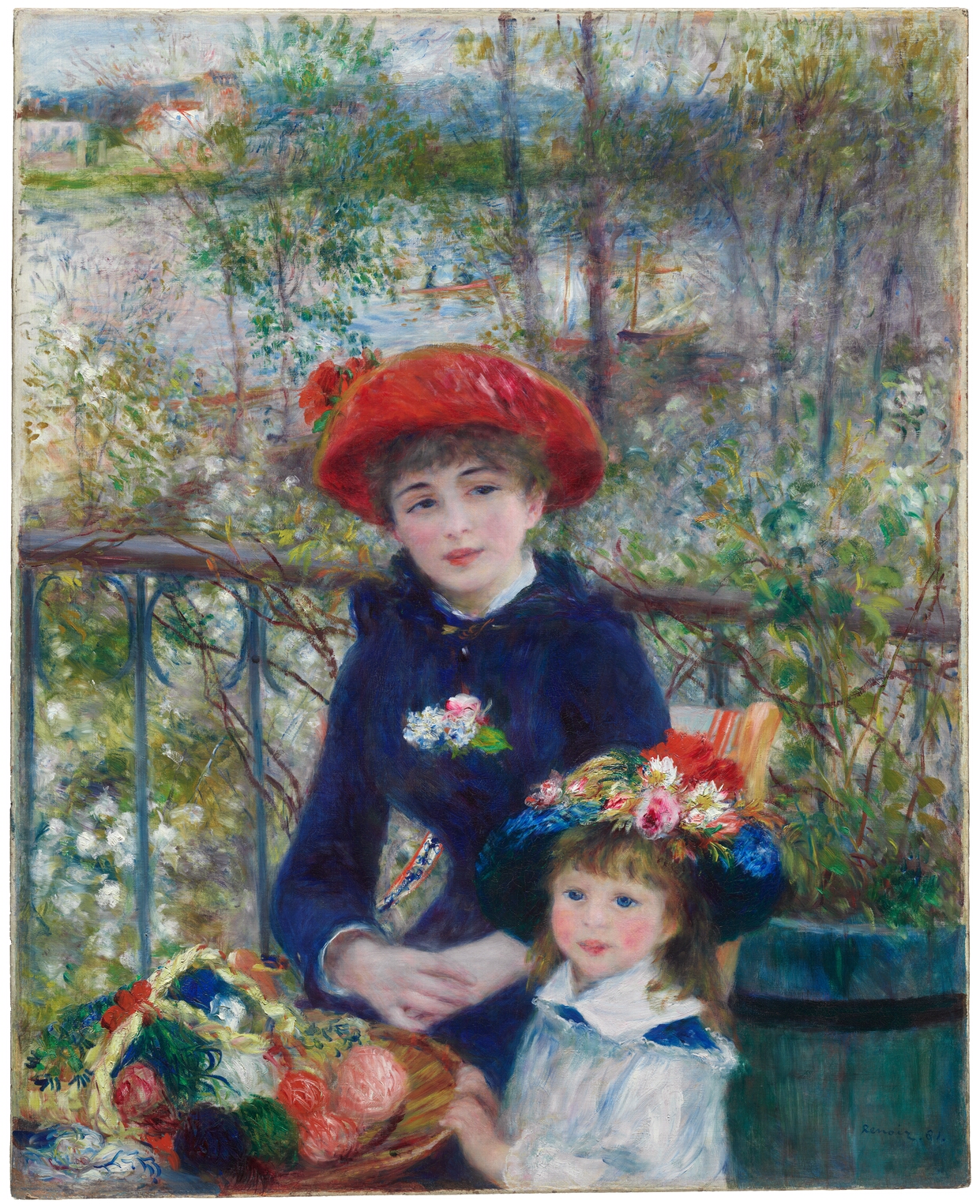
cat. 11 Two Sisters (On the Terrace), 1881.
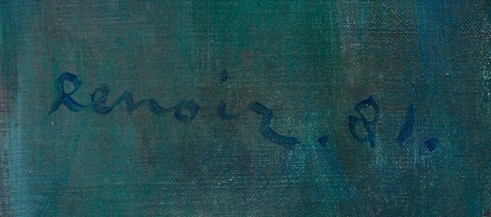
Detail of the signature in Renoir’s Two Sisters (On the Terrace) (1881). The Art Institute of Chicago, 1933.455.
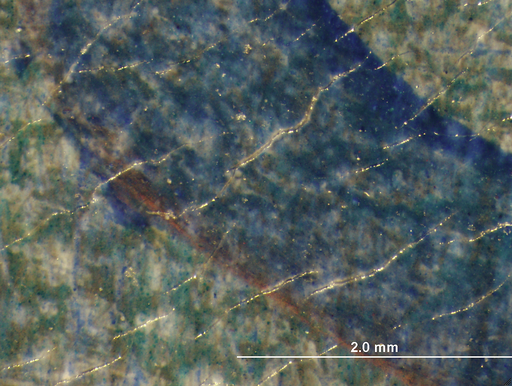
Photomicrograph of the signature in Renoir’s Two Sisters (On the Terrace) (1881) showing the paint mixture. The Art Institute of Chicago, 1933.455
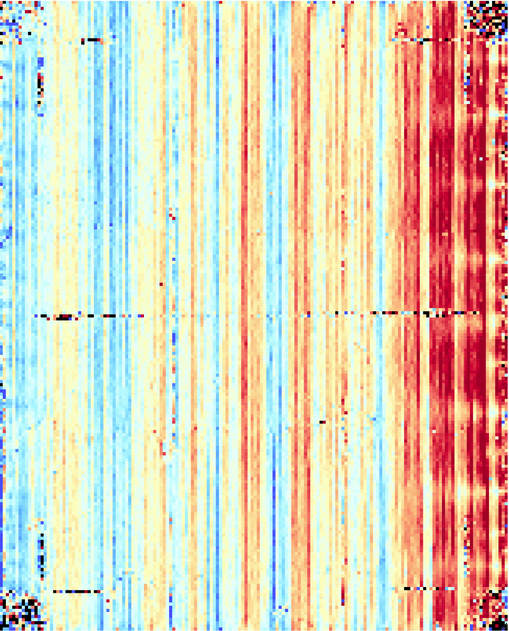
Thread count map of the warp (vertical) threads in Renoir’s Two Sisters (On the Terrace) (1881). The Art Institute of Chicago, 1933.455. Thread count map created by Don H. Johnson using Thread Count Automation Project software.
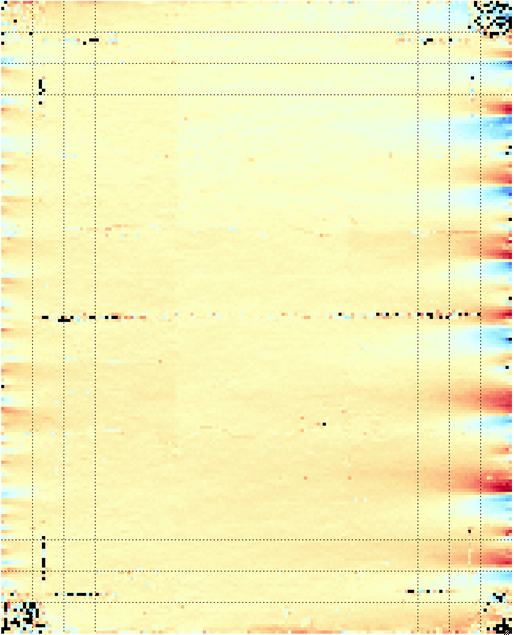
Warp-angle map of Renoir’s Two Sisters (On the Terrace) (1881). Primary cusping from commercial preparation is visible on the right side. The Art Institute of Chicago, 1933.455. Warp-angle map created by Don H. Johnson using Thread Count Automation Project software.
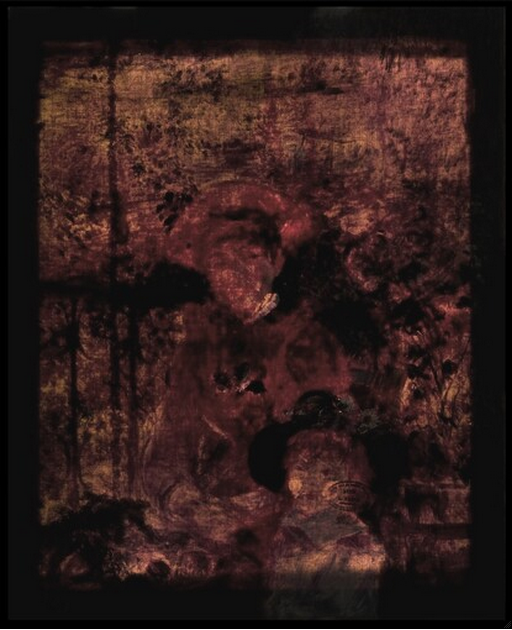
Transmitted-light image of Renoir’s Two Sisters (On the Terrace) (1881). The color merchant’s stamp is visible in the lower right quadrant. The Art Institute of Chicago, 1933.455.

Transmitted-infrared (Fuji, 1.0–1.1 µm) detail of Renoir’s Two Sisters (On the Terrace) (1881) showing the P: Aprin color merchant stamp. The Art Institute of Chicago, 1933.455.
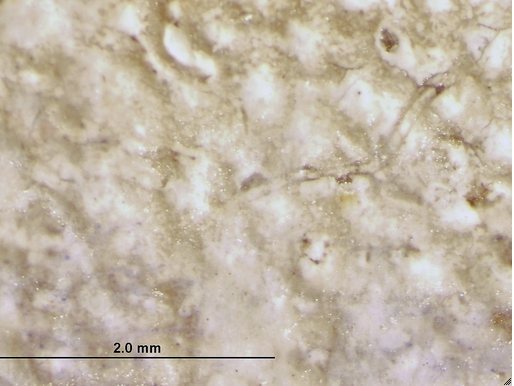
Photomicrograph of the ground in Renoir’s Two Sisters (On the Terrace) (1881). The Art Institute of Chicago, 1933.455.
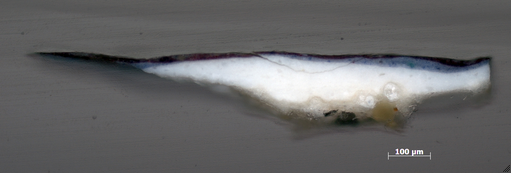
Photomicrograph of a cross section of the ground in Renoir’s Two Sisters (On the Terrace) (1881). Small microfossils are visible in the lower, chalk-based layer. Original magnification: 100×. The Art Institute of Chicago, 1933.455.
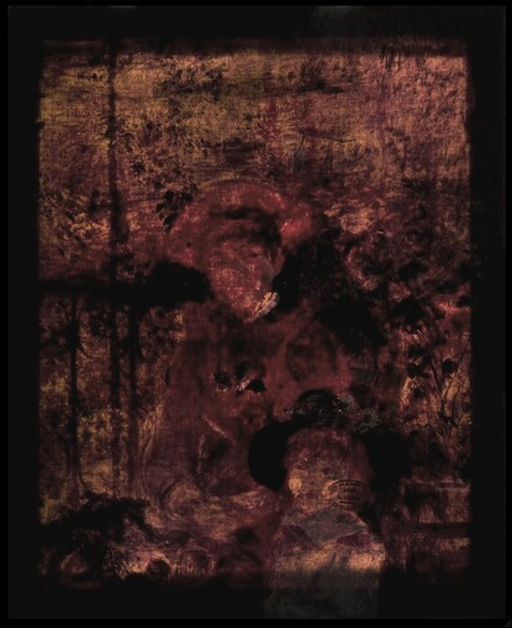
Transmitted-light image of Renoir’s Two Sisters (On the Terrace) (1881) showing the artist’s initial contour lines around the major elements. The Art Institute of Chicago, 1933.455.
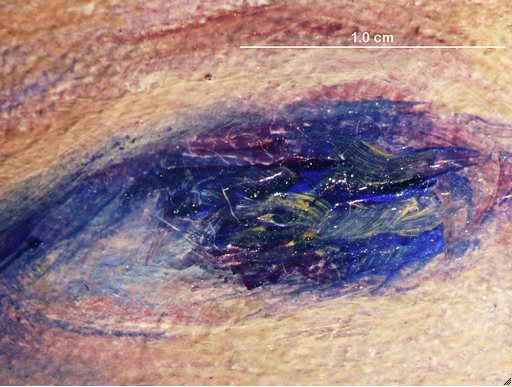
Photomicrograph of the woman’s left eye in Renoir’s Two Sisters (On the Terrace) (1881) showing faint, red contour lines along the edges. The Art Institute of Chicago, 1933.455.
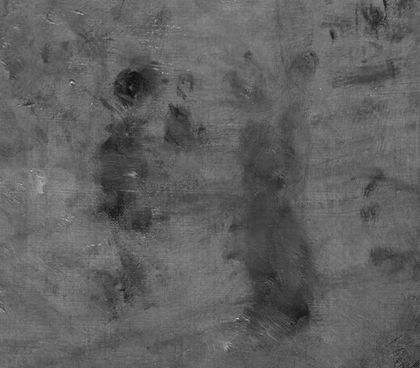
Infrared (Goodrich, 1.5–1.7 µm) detail of the upper left quadrant of Renoir’s Two Sisters (On the Terrace) (1881). The two small figures visible were subsequently painted out. The Art Institute of Chicago, 1933.455.
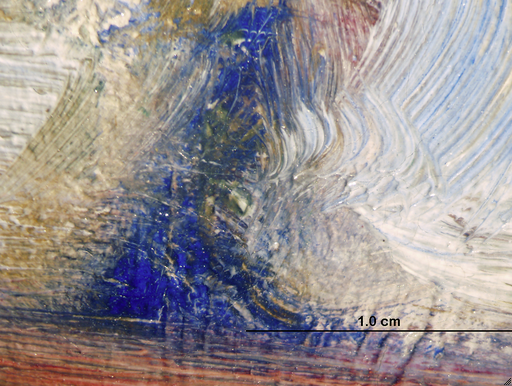
Photomicrograph of the rower on the upper right in Renoir’s Two Sisters (On the Terrace) (1881). The Art Institute of Chicago, 1933.455.
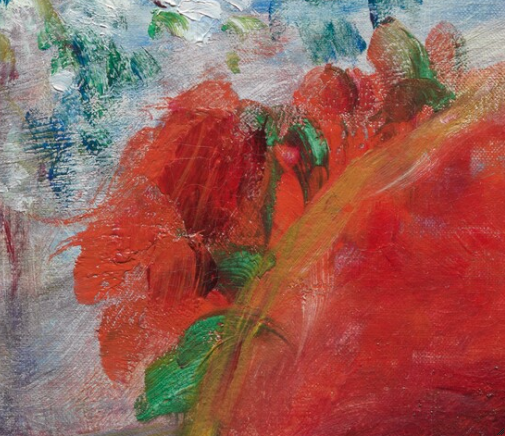
Detail of the woman’s hat brim and flowers in Renoir’s Two Sisters (On the Terrace) (1881). The Art Institute of Chicago, 1933.455.
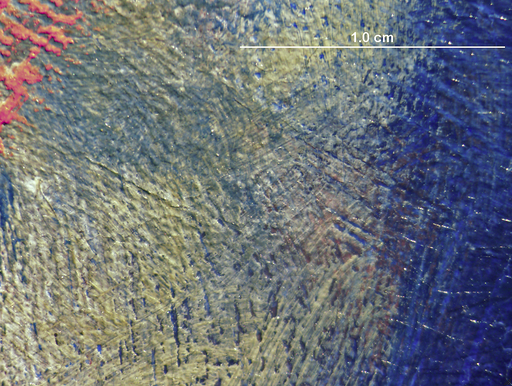
Photomicrograph of the woman’s waist in Renoir’s Two Sisters (On the Terrace) (1881) showing changes to the waistline. The Art Institute of Chicago, 1933.455.
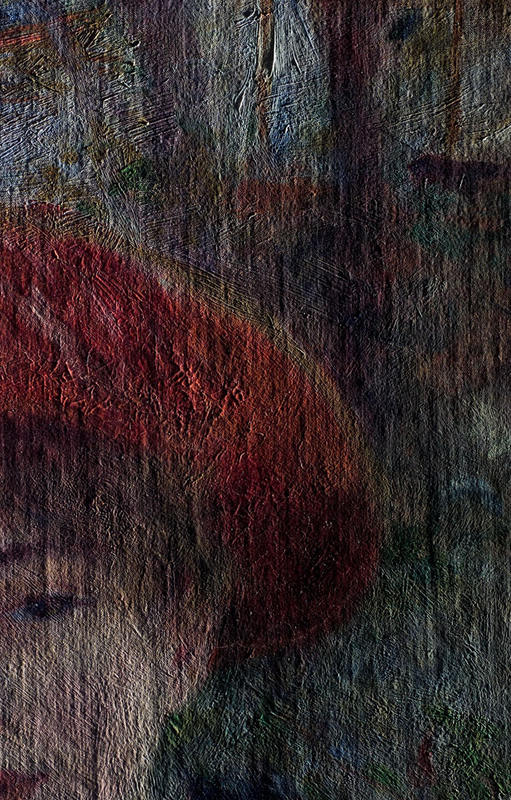
Raking-light detail of the woman’s face in Renoir’s Two Sisters (On the Terrace) (1881) showing heavy diagonal strokes beneath the face, evidence that the artist painted out a previous form. The Art Institute of Chicago, 1933.455.
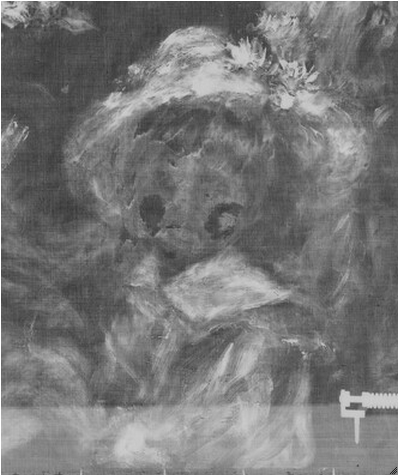
X-ray detail of the child’s face in Renoir’s Two Sisters (On the Terrace) (1881) showing evidence that the artist wiped away paint in the cheeks. The Art Institute of Chicago, 1933.455. X-ray digitally composited by Robert G. Erdmann, University of Arizona.
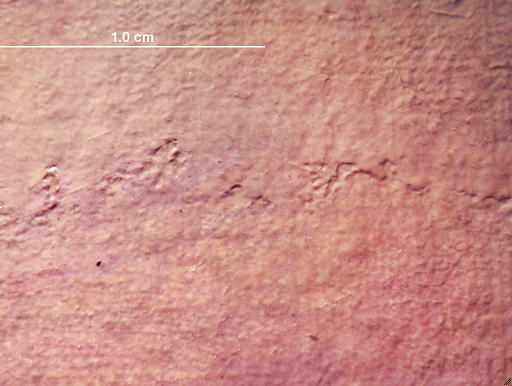
Photomicrograph of the child’s cheek in Renoir’s Two Sisters (On the Terrace) (1881) showing the soft edge of the wiped area and the thin layer of paint covering it. The Art Institute of Chicago, 1933.455.
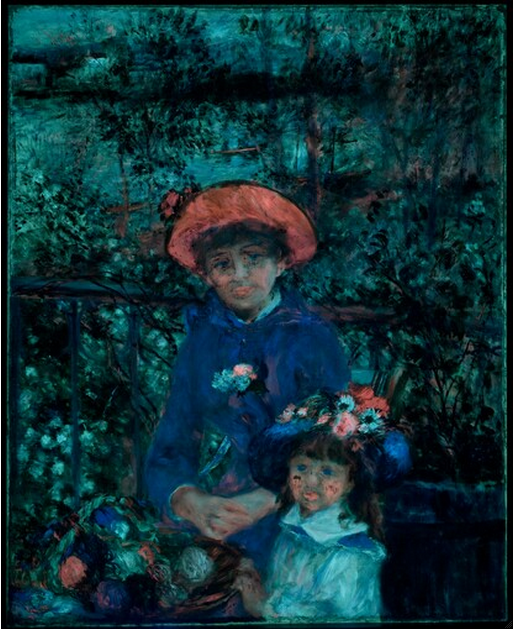
Ultraviolet image of Renoir’s Two Sisters (On the Terrace) (1881). The Art Institute of Chicago, 1933.455.
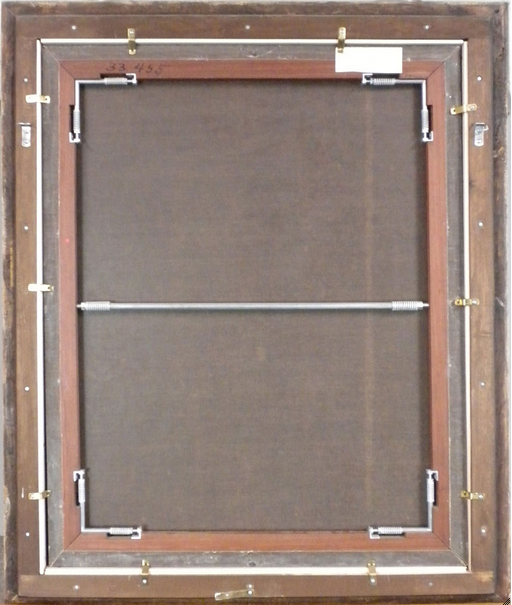
Verso of Renoir’s Two Sisters (On the Terrace) (1881). The Art Institute of Chicago, 1933.455.
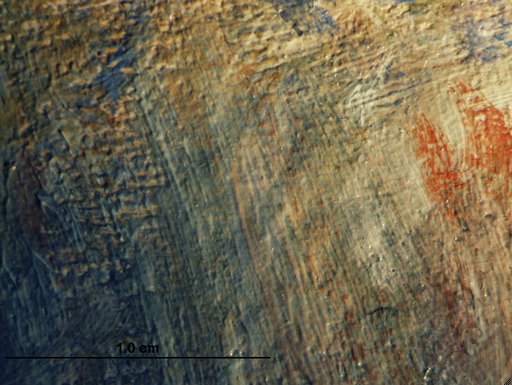
Photomicrograph in raking light of the background in Renoir’s Two Sisters (On the Terrace) (1881) showing paint pressed into cracks in material on the canvas verso. The Art Institute of Chicago, 1933.455.
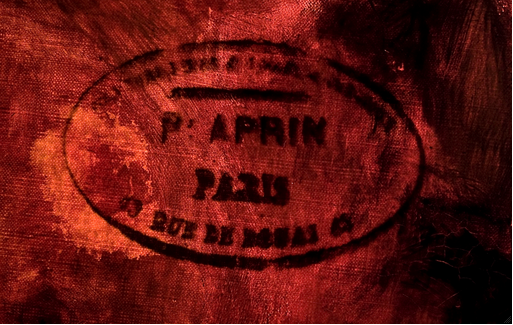
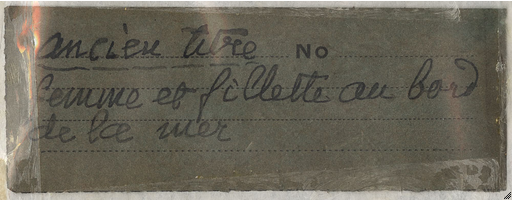
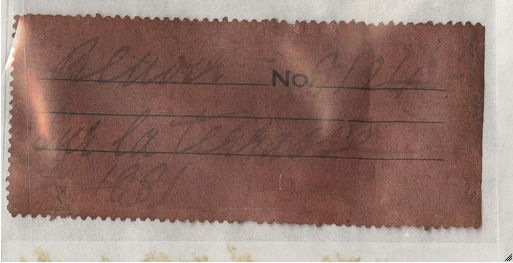
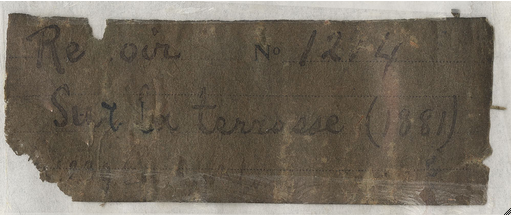
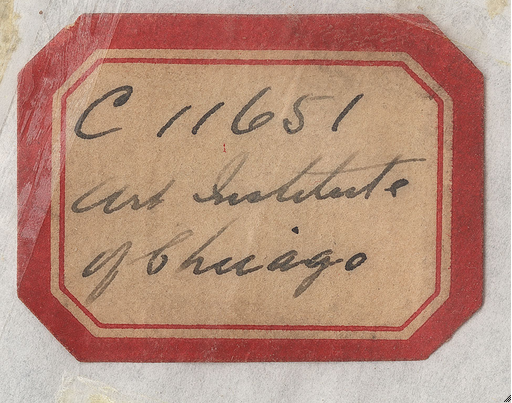
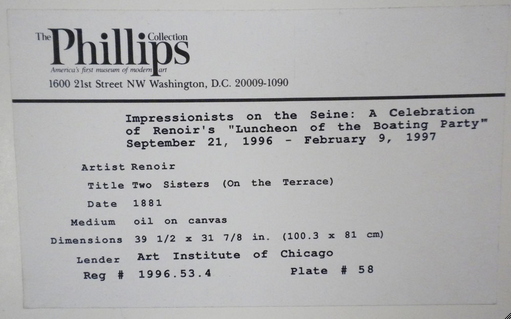
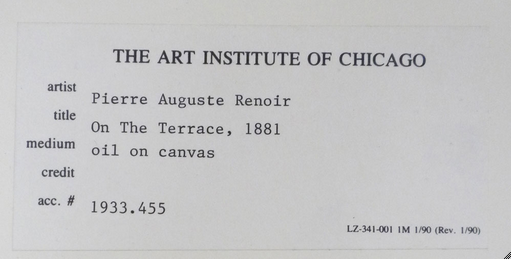
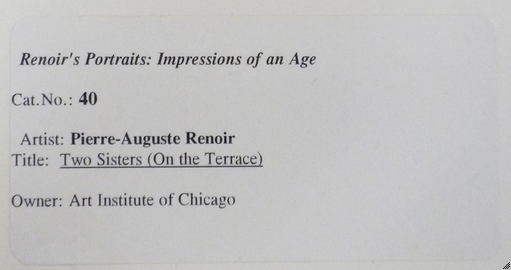
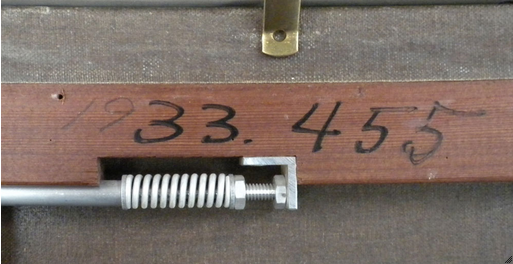
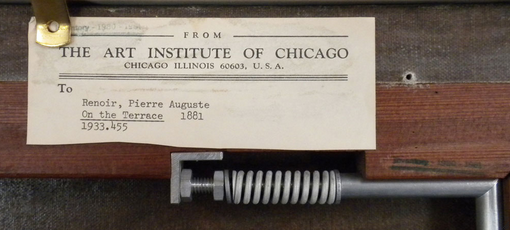
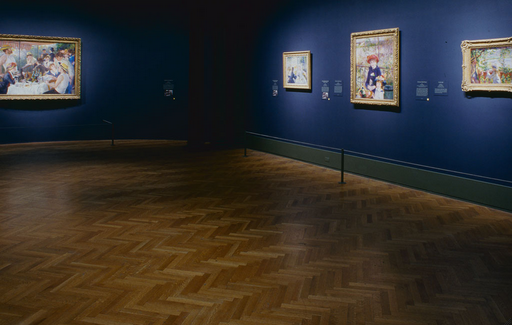
Installation of Renoir’s Two Sisters (On the Terrace) (1881) in Renoir’s Portraits: Impressions of an Age, Art Institute of Chicago, Oct. 17, 1997–Jan. 4, 1998. Institutional Archives, Art Institute of Chicago.
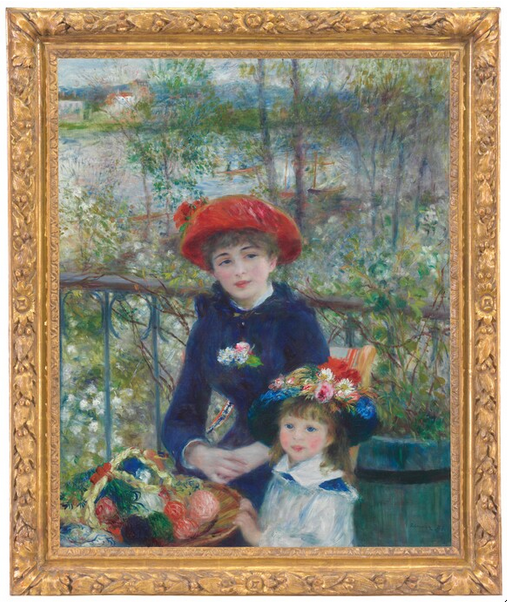
Renoir’s Two Sisters (On the Terrace) (1881) in its current frame. The Art Institute of Chicago, 1933.455.
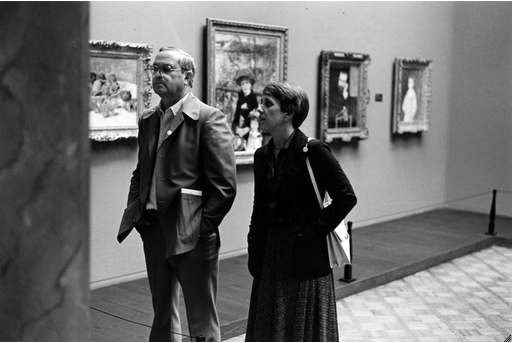
Renoir’s Two Sisters (On the Terrace) (1881) in a previous frame, gallery installation. The Art Institute of Chicago, 1933.455.
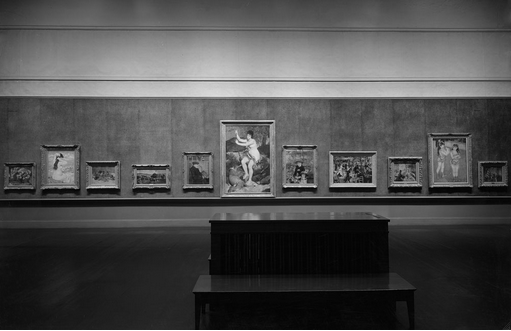
Century of Progress-frame history
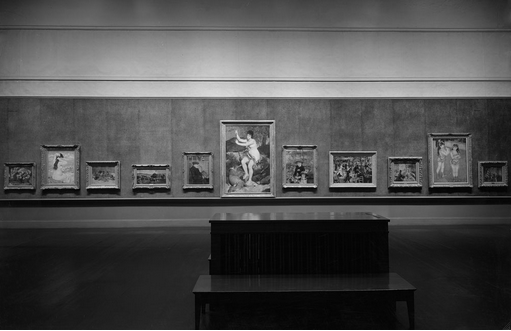
Installation of Renoir’s Two Sisters (On the Terrace) (1881) in “A Century of Progress”: Loan Exhibition of Paintings and Sculpture, May 23–Nov. 1, 1933. Institutional Archives, Art Institute of Chicago.
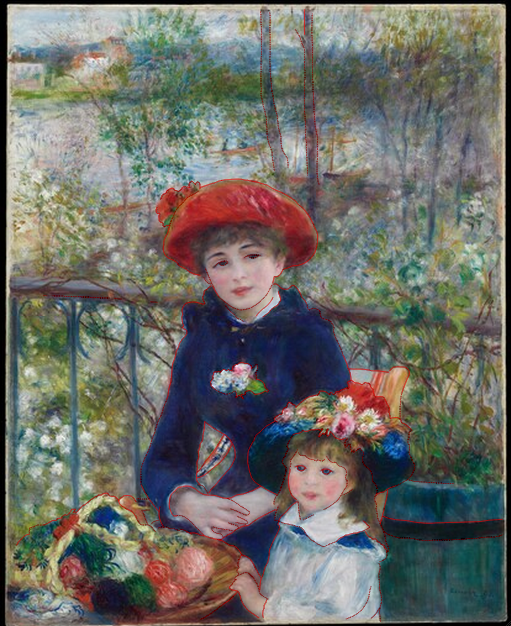
Renoir’s Two Sisters (On the Terrace) (1881). The Art Institute of Chicago, 1933.455. Interactive image.
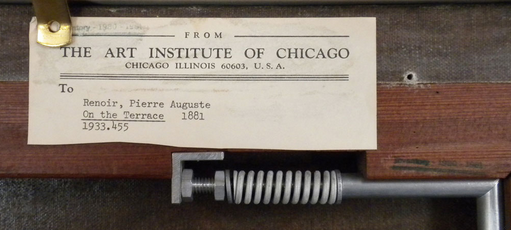
2nd instance in labels
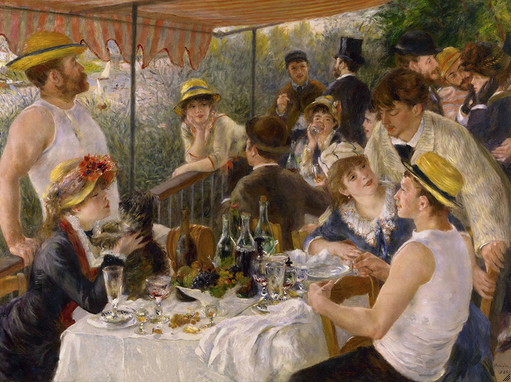
Pierre-Auguste Renoir (French, 1841–1919). Luncheon of the Boating Party, 1880–81. Oil on canvas; 129.5 × 172.7 cm (51 × 68 in.). The Phillips Collection, Washington, DC, 1637. Bridgeman Images.
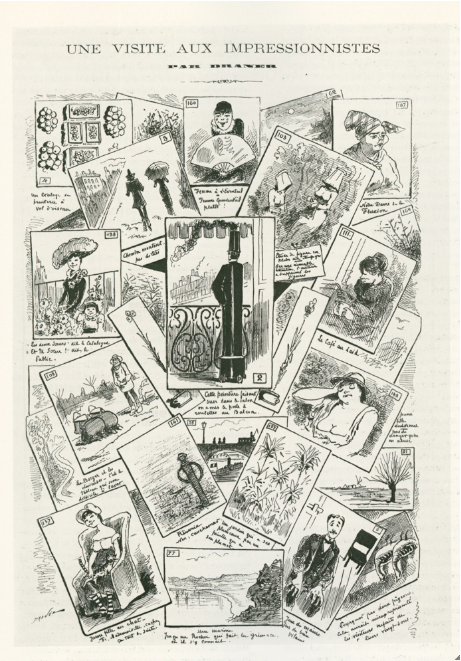
Jules Draner. “Une visite aux impressionnistes,” from Le charivari, Mar. 9, 1882.
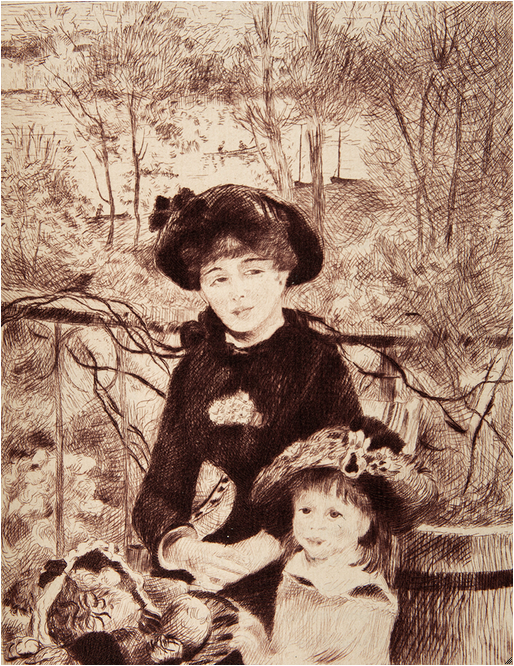
A.-M. Lauzet (French, active 1890s). La terrasse, c. 1892. Etching on paper; 11.5 × 9 cm (4 9/16 × 3 9/16 in.) (image). From Georges Lecomte, L’art impressionniste d’après la collection privée de M. Durand-Ruel (Chamerot et Renouard, 1892), p. 137.
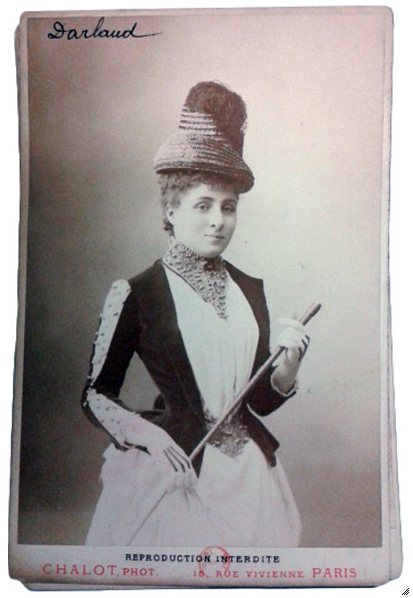
Chalot and Company. Jeanne Darlaud, 1890s. Photograph. Bibliotheque Nationale de France. © BNF.
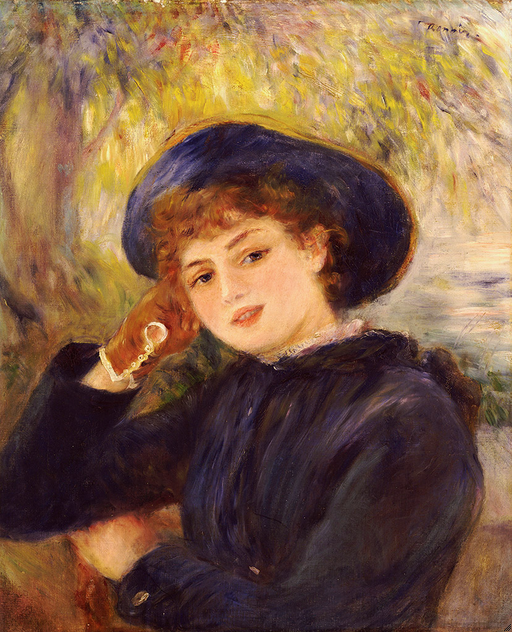
Pierre-Auguste Renoir (French, 1841–1919). Mademoiselle Demarsy (Femme accoudée), 1882. Oil on canvas; 61 × 51 cm (24 × 20 1/6 in.). Private Collection. Photo © Christie’s Images/Bridgeman Images.
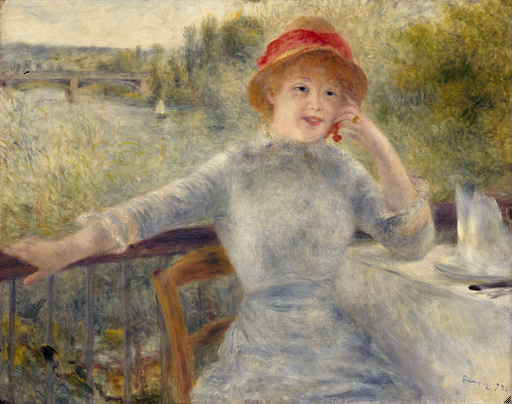
Pierre-Auguste Renoir (French, 1841–1919). Alphonsine Fournaise, 1879. Oil on canvas; 73 × 93 cm (28 3/4 × 36 5/8 in.). Musée d’Orsay, Paris, RF1937-9. © RMN-Grand Palais/Art Resource, NY. Photo: Hervé Lewandowski.
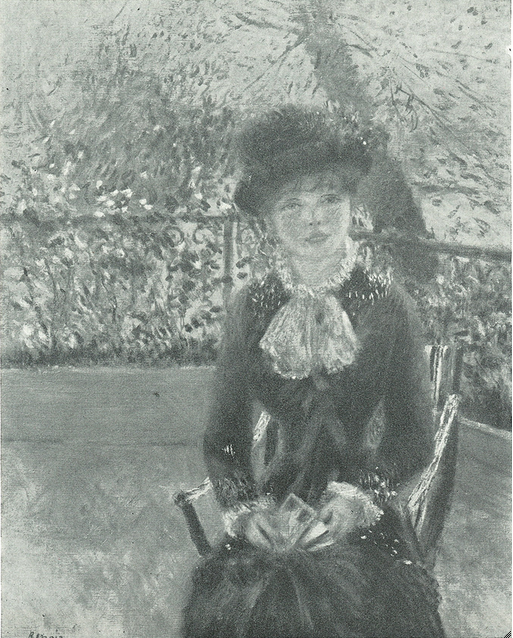
Pierre-Auguste Renoir (French, 1841–1919). Young Girl Seated, 1880. Oil on canvas; 62 × 50 cm (24 7/16 × 19 11/16 in.). Private collection.
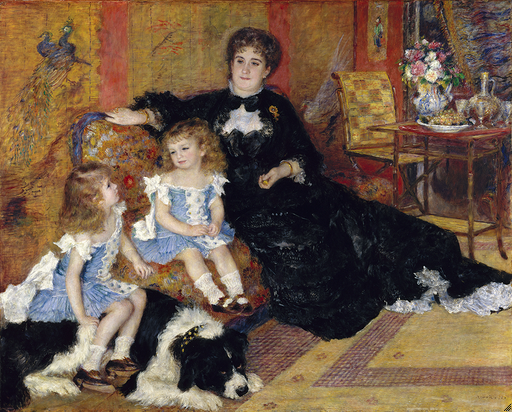
Pierre-Auguste Renoir (French, 1841–1919). Madame Georges Charpentier and Her Children, 1878. Oil on canvas; 153.7 × 190.2 cm (60 1/2 × 74 7/8 in.). The Metropolitan Museum of Art, New York, Catherine Lorillard Wolfe Collection, 07.122. Image copyright © The Metropolitan Museum of Art. Image source: Art Resource, NY.
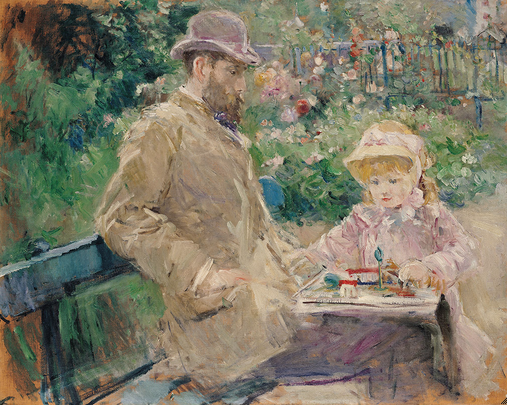
Berthe Morisot (French, 1841–1895). Eugène Manet and His Daughter at Bougival, 1881. Oil on canvas; 73 × 92 cm (28 3/4 × 36 1/4 in.). Musée Marmottan Monet, Paris. Giraudon/Bridgeman Images.
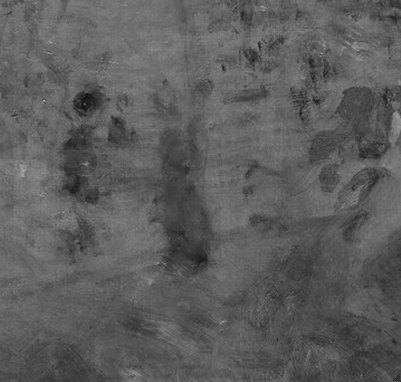
Infrared detail (Goodrich, 1.5–1.7 µm) of Renoir's Two Sisters (On the Terrace) (1881) showing two figures in the background that were painted out. The Art Institute of Chicago, 1933.445.
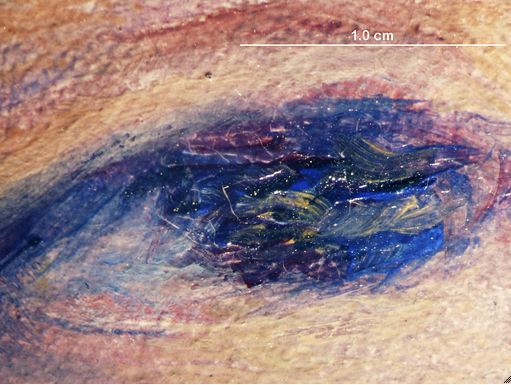
Photomicrograph of the seated figure’s right eye in Renoir’s Two Sisters (On the Terrace)(1881) showing red lake outline of forms. The Art Institute of Chicago, 1933.455.
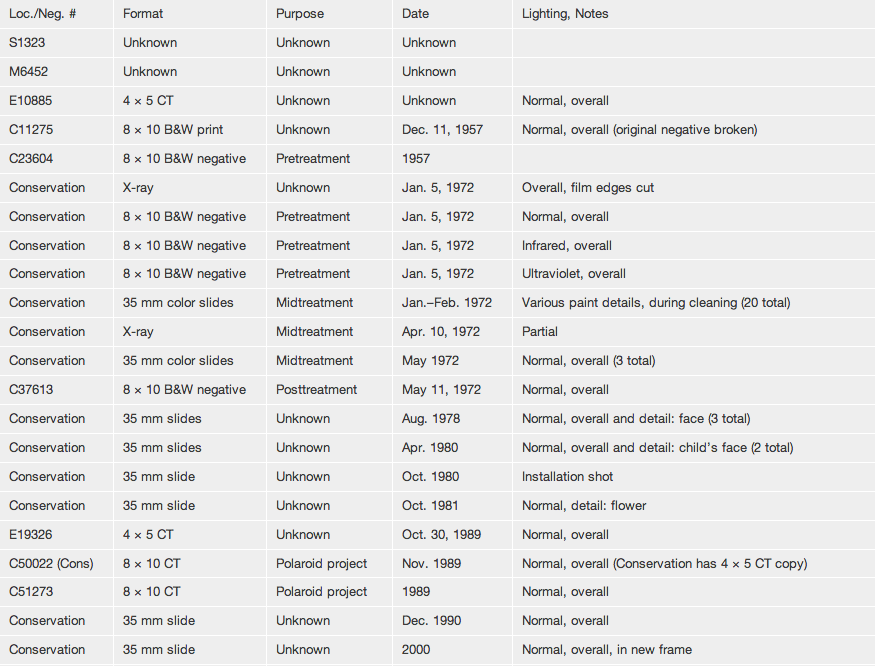
| Loc./Neg. # | Format | Purpose | Date | Lighting, Notes |
| S1323 | Unknown | Unknown | Unknown | |
| M6452 | Unknown | Unknown | Unknown | |
| E10885 | 4 × 5 CT | Unknown | Unknown | Normal, overall |
| C11275 | 8 × 10 B&W print | Unknown | Dec. 11, 1957 | Normal, overall (original negative broken) |
| C23604 | 8 × 10 B&W negative | Pretreatment | 1957 | |
| Conservation | X-ray | Unknown | Jan. 5, 1972 | Overall, film edges cut |
| Conservation | 8 × 10 B&W negative | Pretreatment | Jan. 5, 1972 | Normal, overall |
| Conservation | 8 × 10 B&W negative | Pretreatment | Jan. 5, 1972 | Infrared, overall |
| Conservation | 8 × 10 B&W negative | Pretreatment | Jan. 5, 1972 | Ultraviolet, overall |
| Conservation | 35 mm color slides | Midtreatment | Jan.–Feb. 1972 | Various paint details, during cleaning (20 total) |
| Conservation | X-ray | Midtreatment | Apr. 10, 1972 | Partial |
| Conservation | 35 mm color slides | Midtreatment | May 1972 | Normal, overall (3 total) |
| C37613 | 8 × 10 B&W negative | Posttreatment | May 11, 1972 | Normal, overall |
| Conservation | 35 mm slides | Unknown | Aug. 1978 | Normal, overall and detail: face (3 total) |
| Conservation | 35 mm slides | Unknown | Apr. 1980 | Normal, overall and detail: child’s face (2 total) |
| Conservation | 35 mm slide | Unknown | Oct. 1980 | Installation shot |
| Conservation | 35 mm slide | Unknown | Oct. 1981 | Normal, detail: flower |
| E19326 | 4 × 5 CT | Unknown | Oct. 30, 1989 | Normal, overall |
| C50022 (Cons) | 8 × 10 CT | Polaroid project | Nov. 1989 | Normal, overall (Conservation has 4 × 5 CT copy) |
| C51273 | 8 × 10 CT | Polaroid project | 1989 | Normal, overall |
| Conservation | 35 mm slide | Unknown | Dec. 1990 | Normal, overall |
| Conservation | 35 mm slide | Unknown | 2000 | Normal, overall, in new frame |
| G28511 | Digital | Exhibition | Mar. 11, 2008 | Normal, overall |
| G28512 | Digital | Exhibition | Mar. 11, 2008 | Normal, detail: center (figures) |
| G28513 | Digital | Exhibition | Mar. 11, 2008 | Normal, detail: child |
| 132376 | Digital | Loan exam | Nov. 2008 | Annotated conservation image E19326 |
| Conservation | X-ray | OSCI | Feb. 1, 2010 | X-ray films scanned/digitally composited, overall |
| Conservation | Digital | OSCI | Feb. 2, 2010 | Details of verso, frame, and labels (10 total) |
| Conservation | Digital | OSCI | Feb. 2, 2010 | Normal, overall |
| Conservation | Digital | OSCI | Feb. 2, 2010 | Raking light, overall |
| Conservation | Digital | OSCI | Feb. 2, 2010 | Ultraviolet, overall |
| Conservation | Digital | OSCI | Feb. 2, 2010 | Infrared (Fuji 1000B/2 mm filter), overall |
| Conservation | Digital | OSCI | Feb. 2, 2010 | Transmitted light, overall |
| Conservation | Digital | OSCI | Feb. 2, 2010 | Transmitted light, detail: stamp |
| Conservation | Digital | OSCI | Feb. 3, 2010 | Macro details (19 total) |
| Conservation | Digital | OSCI | Feb. 4, 2010 | Photomicrographs of sample sites and surface (31 total) |
| G39094 | Digital | OSCI | Jan. 24, 2012 | Normal, overall composite of G39382–G39406 |
| G39095 | Digital | OSCI | Jan. 24, 2012 | Normal, frame only |
| G39096 | Digital | OSCI | Jan. 24, 2012 | Ultraviolet, overall |
| G39382 | Digital | OSCI | Jan. 24, 2012 | Section |
| G39383 | Digital | OSCI | Jan. 24, 2012 | Section |
| G39384 | Digital | OSCI | Jan. 24, 2012 | Section |
| G39385 | Digital | OSCI | Jan. 24, 2012 | Section |
| G39386 | Digital | OSCI | Jan. 24, 2012 | Section |
| G39387 | Digital | OSCI | Jan. 24, 2012 | Section |
| G39388 | Digital | OSCI | Jan. 24, 2012 | Section |
| G39389 | Digital | OSCI | Jan. 24, 2012 | Section |
| G39390 | Digital | OSCI | Jan. 24, 2012 | Section |
| G39391 | Digital | OSCI | Jan. 24, 2012 | Section |
| G39392 | Digital | OSCI | Jan. 24, 2012 | Section |
| G39393 | Digital | OSCI | Jan. 24, 2012 | Section |
| G39394 | Digital | OSCI | Jan. 24, 2012 | Section |
| G39395 | Digital | OSCI | Jan. 24, 2012 | Section |
| G39396 | Digital | OSCI | Jan. 24, 2012 | Section |
| G39397 | Digital | OSCI | Jan. 24, 2012 | Section |
| G39398 | Digital | OSCI | Jan. 24, 2012 | Section |
| G39399 | Digital | OSCI | Jan. 24, 2012 | Section |
| G39400 | Digital | OSCI | Jan. 24, 2012 | Section |
| G39401 | Digital | OSCI | Jan. 24, 2012 | Section |
| G39402 | Digital | OSCI | Jan. 24, 2012 | Section |
| G39403 | Digital | OSCI | Jan. 24, 2012 | Section |
| G39404 | Digital | OSCI | Jan. 24, 2012 | Section |
| G39405 | Digital | OSCI | Jan. 24, 2012 | Section |
| G39406 | Digital | OSCI | Jan. 24, 2012 | Section |
| Conservation | Digital | OSCI | Jan. 25, 2012 | Infrared (Goodrich, 1.5–1.7 µm J filter), overall; composite |
| Conservation | Digital | OSCI | Jan. 27, 2012 | Transmitted infrared (Fuji 1000B/2 mm filter), overall |
| Conservation | Digital | OSCI | Jan. 27, 2010 | Transmitted infrared (Fuji 1000B/2 mm filter), detail: stamp |
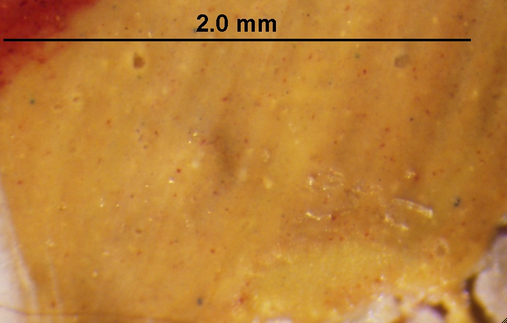
Photomicrograph of a flower on the child’s hat in Renoir’s Two Sisters (On the Terrace) (1881). The slightly brighter zinc yellow paint along the bottom edge of this brushstroke was revealed during sampling and illustrates the level of discoloration of this pigment throughout the painting. The Art Institute of Chicago, 1933.455.
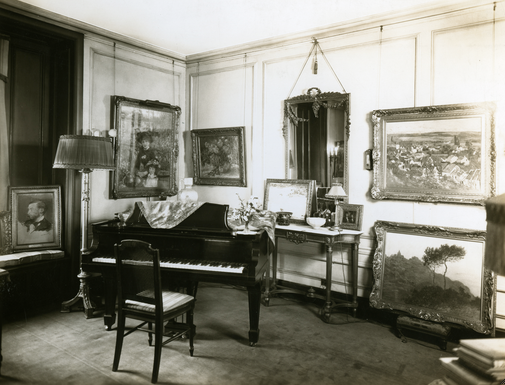
Renoir’s Two Sisters (On the Terrace) (1881) in a previous frame, on display in Mrs. Lewis Larned (Annie Swan) Coburn’s Blackstone Hotel apartment. Institutional Archives, Art Institute of Chicago.
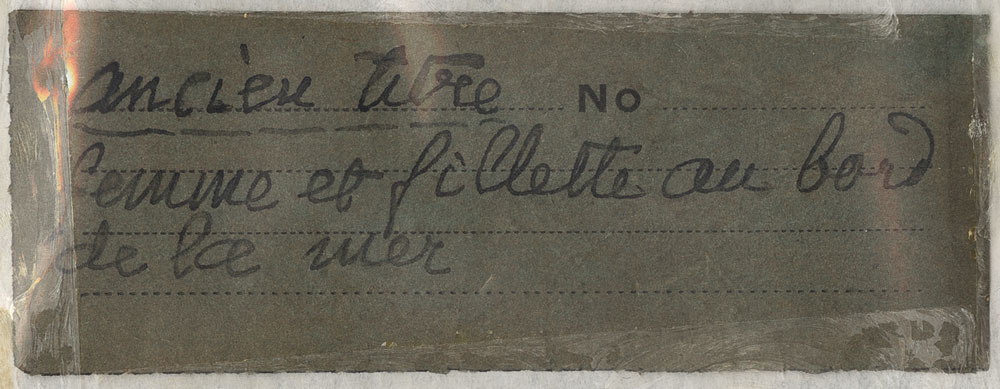
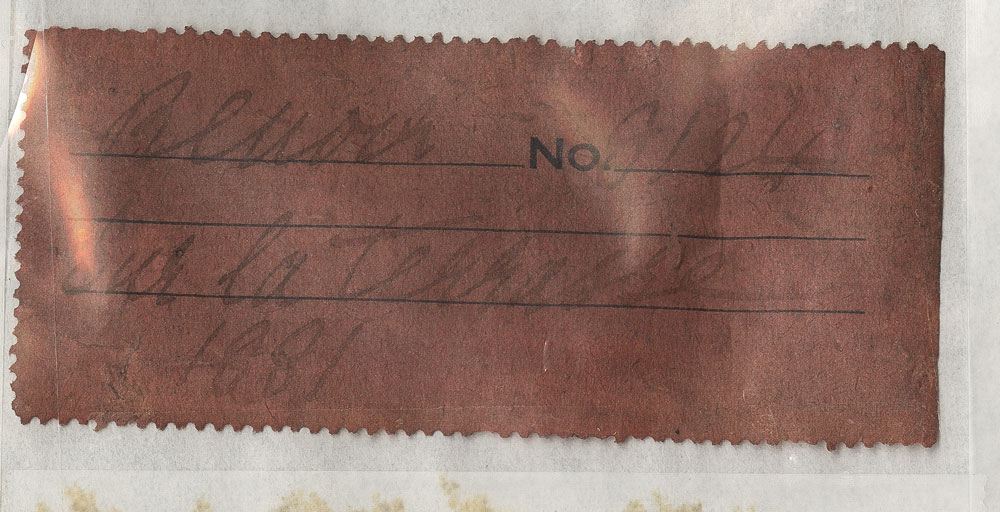
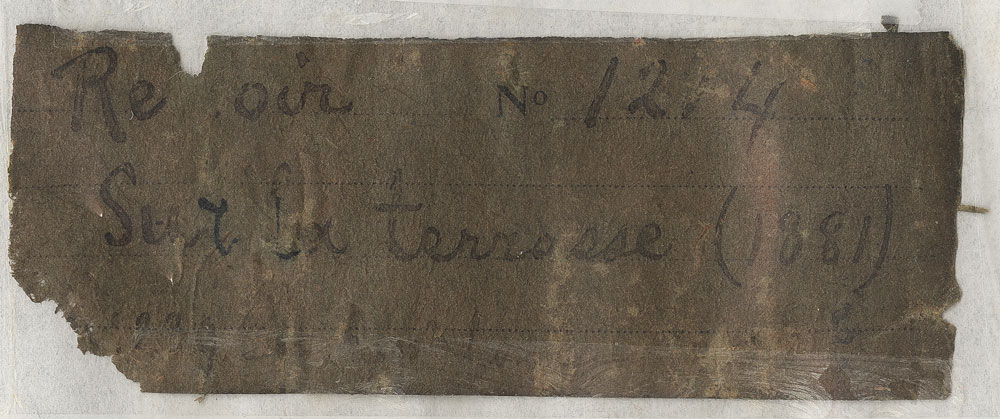
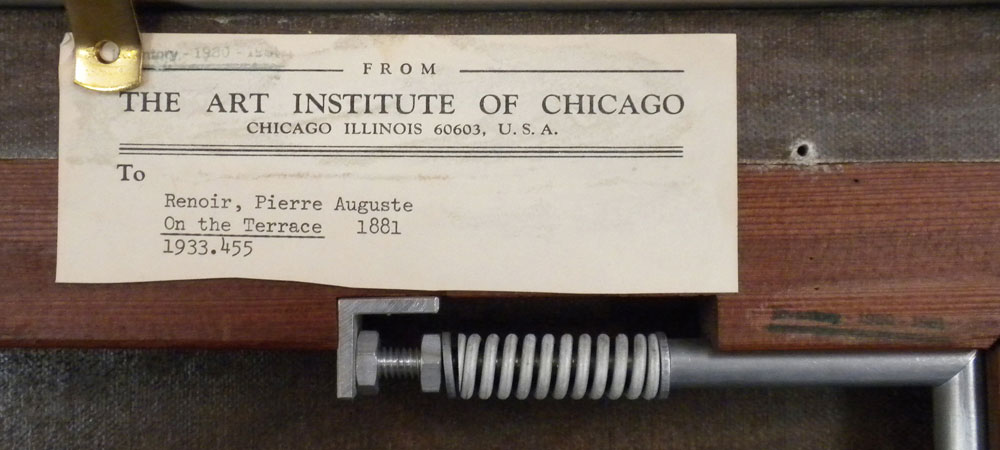
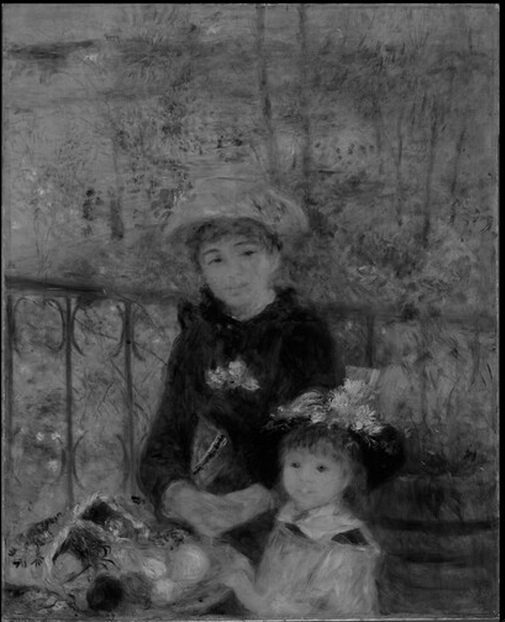
Infrared image (Goodrich, 1.5–1.7 µm) of Renoir's Two Sisters (On the Terrace) (1881) showing decorations in the balcony that were painted out. The Art Institute of Chicago, 1933.445.

Photomicrograph of a cross section of the ground in Renoir’s Two Sisters (On the Terrace) (1881) showing the thin red and blue paint layers. Small microfossils are visible in the lower, chalk-based layer. Original magnification: 200×.
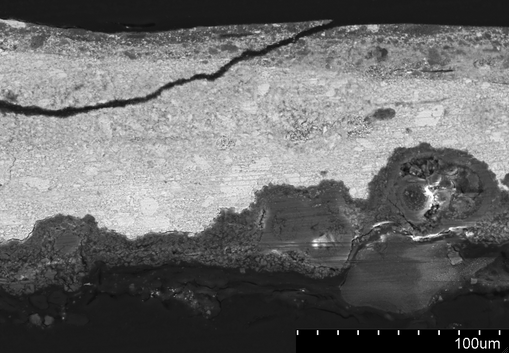
Back-scattered electron image of a cross section of the ground with thin paint layers in Renoir’s Two Sisters (On the Terrace) (1881). Original magnification: 500×. The Art Institute of Chicago, 1933.455.
On the Terrace of a Hotel in Bordighera: The Painter Jean Martin Reviews His Bill (Illustration for Edmond Renoir’s “L’étiquette”)789
1881
Conté crayon, over pen and brush and black ink, on ivory laid paper, discolored to cream; 452 × 354 mm
The Art Institute of Chicago, Helen Regenstein Collection, 1977.491
The Descent from the Summit: Jean Martin Steadies Hélène, the Banker’s Daughter (Illustration for Edmond Renoir’s “L’étiquette”) (recto); Half-Length Sketch of a Woman (verso)790
1881
Black chalk on ivory laid paper, discolored to tan; 492 × 319 mm
The Art Institute of Chicago, gift of Mr. and Mrs. B. E. Bensinger, 1969.870R, 1969.870V
Intended as illustrations for “L’étiquette,” a story written by his brother Edmond, Renoir made these drawings in the south of France where they traveled together in 1881. Although Renoir claimed to dislike depicting men, preferring to work with female models, these sheets prove his conversance with the visual language of masculinity.791 In the first of the two drawings, On the Terrace of a Hotel in Bordighera: The Painter Jean Martin Reviews His Bill (cat. 12), the artist depicted his sitter lounging elegantly on a summer chair, dressed in fashionable loose trousers, with his cap balanced perfectly on his proper right leg.792 Made to accompany the opening passages of the story, the illustration introduces the main character, Jean Martin, and sets the scene by the sea.
The drawing shows Jean Martin as he tries to make sense of an itemized check. Renoir captures the momentary surprise on his face as he puzzles over a particular item. “What could that be? . . . Paper, 3.75 [francs]?” On realizing it was a charge for writing paper, “the oddity of the invention made him smile.”793 The image conveys the character’s impeccable manners; money matters do not ruffle his composure. Essentially, “L’étiquette” is a story of mistaken identity. Jean Martin’s demeanor persuades onlookers of his royal breeding. They assume he is a prince traveling incognito, though he is actually a painter. But the underlying message of the drawing—and of the tale itself—is surely that the Renoir brothers had a high opinion of their artistic vocations.
The making of this drawing was a case of life imitating art. It was Edmond himself who posed for the work, in the garden of a hotel in Menton, situated on the French Riviera.794 Over the course of the vacation, Renoir was very taken with the region and enthused about the light and scenery. Nonetheless, however much he garnered from his immediate experience, he depicted almost all of the details in the image in accordance with the details of his brother’s narrative. Edmond had described his protagonist, Jean Martin, as handsome and about thirty years old. His face was “open, intelligent, pleasant, . . . of a beauty quite rare for a man, in that it didn’t render him ridiculous. The shape of his face, a well-drawn oval, framed black eyes topped with rather arched eyebrows, a straight nose, a naturally smiling mouth adorned with a dark brown moustache . . . cared for enough to show that an effort had been made, but neglected enough so as to in no way infer an excess of vanity on the part of its owner.”795 It is unclear, however, whether Edmond had identified with his creation to the extent that he was the obvious model, or whether (more prosaically), the choice was one of convenience. Perhaps the latter is the more plausible answer; Edmond posed often for his brother. Most famously he sat as the male figure in La loge (fig. 1.3 [Daulte 119; Dauberville 262]) who assesses the auditorium through a lorgnette.796
The first installment of the serially published “L’étiquette” appeared in La vie moderne in December 1883.La vie moderne—intended to champion the Impressionists—was funded initially by Renoir’s patrons Georges and Marguerite Charpentier.797 The Charpentiers’ tastes were broad, and they welcomed young people from the worlds of art and literature into their home each week. They also allowed artists to exhibit their work in the offices of the magazine.798 It was there that Renoir had his first solo show. At this time Edmond wrote a defense of his brother’s art for the journal, praising the way it captured the softer, more poetic side of contemporary life.799 Shortly thereafter he became editor-in-chief of the publication.
In later life, Renoir recalled that Madame Charpentier—a formidable woman—had persuaded her husband to back La vie moderne.800 It is hard to underestimate the gratitude that the artist felt toward his sponsors at this stage of his career; his large-scale portrait of Madame Charpentier and her children (fig. 1.2 [Daulte 266; Dauberville 239]) had been a resounding success and won him considerable acclaim.801 The painting hung in a prime spot at the Salon of 1879, reflecting not only its merits but also the influence and popularity of Renoir’s patron. “If one day I succeed,” Renoir wrote to Georges Charpentier, “it will be entirely thanks to her [Marguerite], because I would certainly have been incapable of doing so on my own.”802
The drawing of Jean Martin, however, has a very different status and function than the grandiose canvas. It was designed for practical use, employing clear tonal contrasts in order to reproduce well in print. The lines that constitute the figure and surroundings are fine and controlled, while a series of loose marks at the bottom of the sheet (including looping circles and haphazard vertical dashes) show how Renoir avoided overloading the nib and brush. He defined most elements of the scene in ink but sporadically added passages of Conté crayon. The resistance provided by the heavy laid paper added character to his shading. As the waxy medium adhered unevenly to the textured support—in areas including the body of Jean Martin’s jacket—it created automatic tonal variation.
The second of the drawings, The Descent from the Summit: Jean Martin Steadies Hélène, the Banker’s Daughter, was published to illustrate an episode in the next installment of “L’étiquette.”803 Jean Martin accompanies his sweetheart on a country stroll, perhaps steadying her as they walk, although the text does not specify this. Hélène’s father disapproves of his daughter’s attachment to a painter, but as a socially ambitious banker, he is charmed when he meets by the supposed prince and encourages the alliance. This misunderstanding makes for a happy—if predictable—conclusion. The young couple gains parental blessing even after the confusion clears. More interesting, however, is the triumph of the princely painter as a reflection of Renoir’s own social ambitions.804 Paul Cézanne, for one, had noticed that the artist was moving in all the right circles at this stage of his career.805
On a compositional level, Renoir seems to have based the drawing on a painting he made in 1870, La promenade (fig. 1.1 [Daulte 55; Dauberville 257]).806 For the illustration, however, the artist reversed the placement of the figures. Whether intentionally or not, this changed the dynamic of the scene; a satyr-like man leads a reluctant woman into the woods in La promenade, while in the drawing, the female figure may take the lead.807 Given that nineteenth-century French artists often placed amorous scenes in country settings, as if to distance them from the constraints of bourgeois domesticity, the suggestion that Hélène encourages Jean Martin would have been risqué. That the image appeared as an illustration, however, lessened its potential to cause offense. Readers of popular magazines were relatively tolerant of sous-entendre.
It is worth noting that in the 1930s critics identified the sitter in On the Terrace as Paul Lhote. Lively and handsome, Lhote was a good friend of the artist and had posed for other works including City Dance (1883; Musée d’Orsay, Paris [Dauberville 1000]) and Country Dance (fig. 2.20 [Dauberville 999]).808 Paul Lhote and Edmond appear to have been of a similar build, with smooth hair and delicate features, but this confusion may also indicate that, just as Renoir had fixed ideas about female physiognomy, he tended toward a generic type in his depictions of men.
It is rather curious that, in speaking of his work for La vie moderne, Renoir complained that he had needed to adapt his methods to suit the materials the publishers provided. “The worst thing of all was that, for our drawings, they made us work on the most disagreeable of papers. You had to use a scraper to produce the whites,” he grumbled to his dealer, Ambroise Vollard. “I never was able to do it.”809 The paper type is unremarkable in the drawings for “L’étiquette” (see cat. 12 Support Characteristics and cat. 13 Support Characteristics) so the comment cannot relate to the sheets in the collection of the Art Institute.
On a financial level, however, La vie moderne generated problems for its contributors. It was hardly a profitable enterprise. “We all collaborated,” Renoir explained to Vollard. “We were to be paid out of the profits to come, that’s to say, not one of us got a single sou.”810
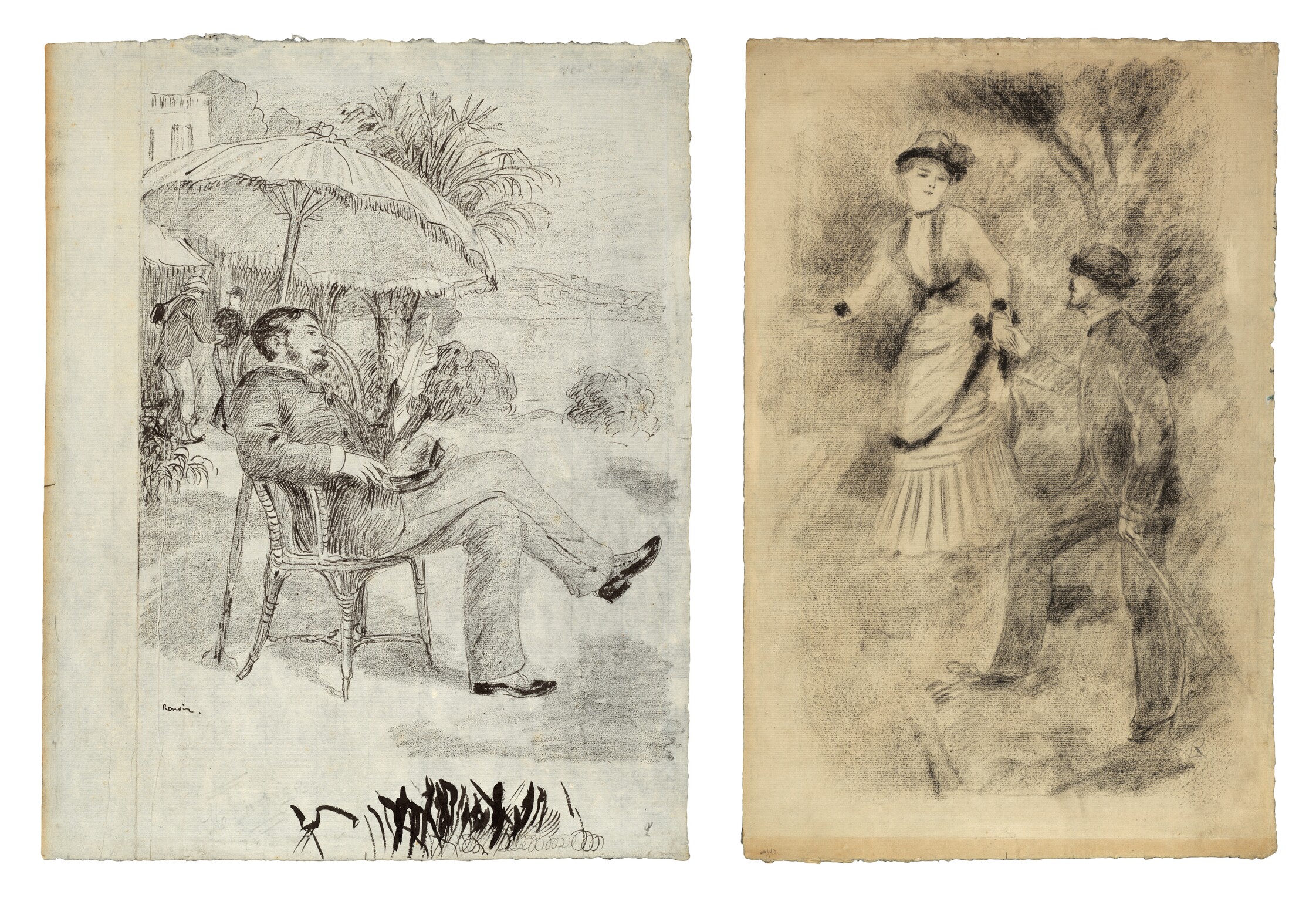
On the Terrace of a Hotel in Bordighera: The Painter Jean Martin Reviews His Bill (Illustration for Edmond Renoir’s “L’étiquette”) (cat. 12); The Descent from the Summit: Jean Martin Steadies Hélène, the Banker’s Daughter (Illustration for Edmond Renoir’s “L’étiquette”) (cat. 13 recto); Half-Length Sketch of a Woman (cat. 13 verso).
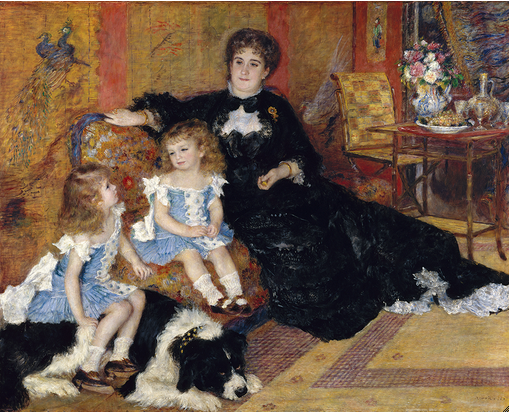
Pierre-Auguste Renoir (French, 1841–1919). Madame Georges Charpentier and Her Children, 1878. Oil on canvas; 153.7 × 190.2 cm (60 1/2 × 74 7/8 in.). The Metropolitan Museum of Art, New York, Catherine Lorillard Wolfe Collection, 07.122. Image copyright © The Metropolitan Museum of Art. Image source: Art Resource, NY.
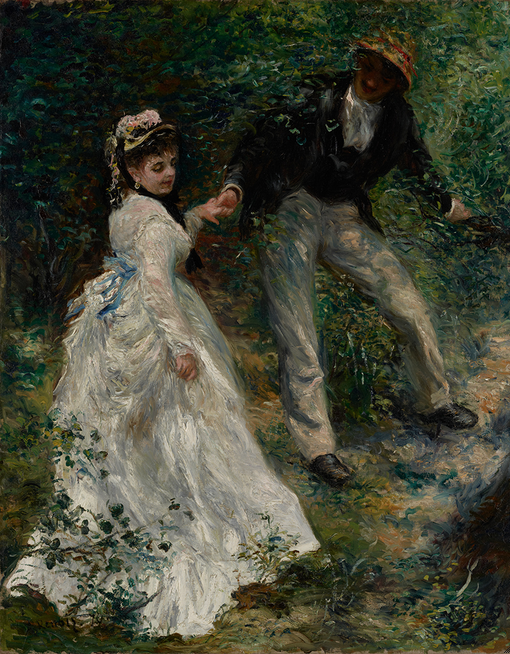
Pierre-Auguste Renoir (French, 1841–1919). La promenade, 1870. Oil on canvas; 81.3 × 64.8 cm (32 × 25 1/2 in.). The J. Paul Getty Museum, 89.PA.41. Digital image courtesy of the Getty's Open Content Program.
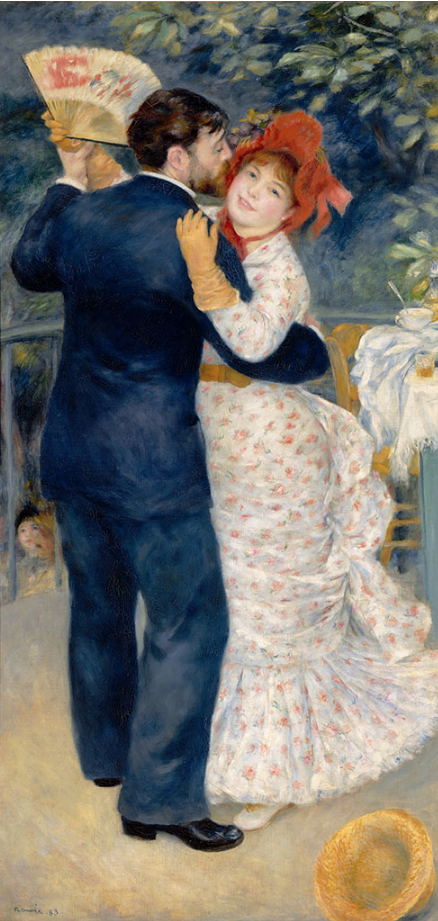
Pierre-Auguste Renoir (French, 1841–1919). Country Dance, 1883. Oil on canvas; 180 × 90 cm (70 7/8 × 35 7/16 in.). Musée d’Orsay, Paris, RF 1979 64. © RMN-Grand Palais/Art Resource, NY. Photograph: Hervé Lewandowski.
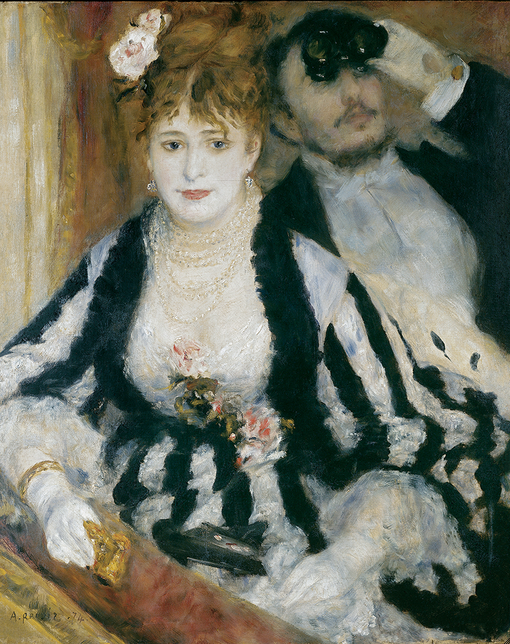
Pierre-Auguste Renoir (French, 1841–1919). La loge, 1874. Oil on canvas; 80 × 63.5 cm (31 1/2 × 25 in.). The Courtauld Gallery, London. © The Samuel Courtauld Trust, The Courtauld Gallery, London.
The Descent from the Summit: Jean Martin Steadies Hélène, the Banker’s Daughter (Illustration for Edmond Renoir’s “L’étiquette”) (recto) Half-Length Sketch of a Woman (verso)
1881
Black chalk on ivory laid paper, discolored to tan; 492 × 319 mm
The Art Institute of Chicago, gift of Mr. and Mrs. B. E. Bensinger, 1969.870R, 1969.870V
The Descent from the Summit: Jean Martin Steadies Hélène, the Banker’s Daughter is executed in black chalk on ivory [glossary:laid paper] that discolored to tan as a result of light exposure and possibly contact with an acidic mount. Renoir worked out his composition with a variety of chalk lines. He established the overall forms of the two figures with fairly thick lines, defined their hands and faces with delicate thin lines, and accentuated the hatbands, dress cuffs, and decorative ribbons with dense, broad strokes (fig. 1.1). The chalk was sufficiently hard to delicately render the clasped figures’ hands. The artist created a sense of space around the two figures by lightly filling in the broad expanses with black chalk, and there is a vague suggestion of background at the upper right. Renoir extended the composition, filling the paper support and working up to 4 cm from the edges. Highlights were established by leaving the light tonality of the paper exposed (fig. 2.20). There is no evidence of [glossary:stumping] or erasure.
There is a faint drawing of a figure in black chalk on the verso (fig. 2.23; infrared detail,fig. 1.3).
Ivory (discolored to tan), medium-thick, moderately textured laid paper.811
L. Berville (right, top edge) (fig. 1.4).
Vertical, 2.8 cm.
8–9 per cm.
Uniform, without visible inclusions or colored fibers.
Even.
There are [glossary:deckle edges] at the top, right, and bottom; the left side is edge torn.
492 × 319 mm.
No artistic surface alterations or coatings are visible under normal conditions, in [glossary:UV] illumination, or with magnification. Under UV illumination, there is a pale-yellow visible-light [glossary:fluorescence] overall on the paper surface that is characteristic of a light gelatin surface [glossary:sizing].
The work was drawn in black chalk. The rich black color and the fine, uniform appearance of the particles under magnification suggest that the chalk was synthetically produced. Various hardnesses of chalk were likely employed, as well. Renoir probably achieved the thin delicate lines in the figures’ hands and faces with a hard black chalk, and he probably used a soft black chalk to accentuate elements of the clothing. There is no evidence of stumping or erasure.
There is a faint drawing of a figure in black chalk on the verso at the bottom of the sheet.
No revisions or changes are visible in the composition in normal conditions or under magnification.
No artistic surface fixative or coatings are visible in normal conditions, under UV illumination, or under magnification.
The ivory paper has discolored overall to tan and is darkest along the bottom edge and on the verso. The bottom edge is creased, possibly from being formerly folded back upon the verso, where the paper was in direct contact with an acidic material that caused the paper to discolor. The paper along the bottom edge of the sheet on the verso, formerly in the interior of the fold, was protected from the acidic material and thus its tonality is preserved. The support was formerly adhered along the edges of the verso to an acidic secondary support, contributing to the pronounced discoloration on the verso. Residual white paper and adhesive are evident on the verso. A few edge tears, visible along the top, the lower right, and the bottom edges of the verso are stabilized by the former mount remnants.
Light media transfer is visible around the perimeter on the recto. It is most pronounced along the top edge. There are stray marks in blue colored pencil (a similar medium to that used in the marks) along the upper half of the right edge.
Kimberly Nichols
Possibly Ambroise Vollard (1867–1939), Paris.812
Purchased jointly by M. Knoedler and Company, New York, and French Art Galleries, New York, Mar. 7, 1949.813
Sold by M. Knoedler and Company, New York, to T. Edward Hanley (1894–1969), Bradford, Pa., May 10, 1949.814
T. Edward Hanley to E. V. Thaw and Company, New York.815
Sold by E. V. Thaw and Company, New York, to Benjamin E. Bensinger (1905–1976), Chicago, Mar. 9, 1967.
Given by Mr. and Mrs. Benjamin E. Bensinger to the Art Institute of Chicago, 1969.
Philadelphia Museum of Art, T. Edward Hanley Collection, 1957.
Buffalo, N.Y., Fine Arts Academy, Albright Art Gallery, The T. Edward Hanley Collection, Jan. 6–Feb. 14, 1960, cat. 110.
New York, Wildenstein and Company, Loan Exhibition of Paintings and Drawings from the Hanley Collection, Nov. 22–Dec. 30, 1961, p. 13, cat. 102.816
Cambridge, Mass., Fogg Art Museum, T. Edward Hanley Exhibition, Jan. 24–Apr. 15, 1962, cat. 104.817
Ambroise Vollard, Tableaux, pastels et dessins de Pierre-Auguste Renoir, vol. 1 (A. Vollard, 1918), p. 10, no. 38 (ill.).
Ambroise Vollard, La vie et l’oeuvre de Pierre-Auguste Renoir (A. Vollard, 1919), p. 180 (ill.).
Walter Pach, Renoir (Abrams, 1950), p. 12 (ill.).
Walter Pach, Auguste Renoir: Leben und Werk (M. Dumont Schauberg, 1976), pp. 26–27, no. 18 (ill.).
Harold Joachim and Sandra Haller Olsen, French Drawings and Sketchbooks of the Nineteenth Century, vol. 2 (University of Chicago Press, 1979), p. 90, no. 5D6.
Douglas W. Druick, Renoir, Artists in Focus (Art Institute of Chicago/Abrams, 1997), pp. 91, no. 10 (ill.), 110.
John House, Pierre-Auguste Renoir: La Promenade (J. Paul Getty Museum, 1997), pp 78–79, fig. 51.
Martha Tedeschi, “Pierre Auguste Renoir, Workers’ Daughters on the Outer Boulevard (Illustration for Emile Zola’s ‘L’Assommoir’), 1877/78,” in “Maineri to Miró: The Regenstein Collection since 1975,” special issue, Art Institute of Chicago Museum Studies 26, 1 (2000), p. 80 (ill.).
Guy-Patrice Dauberville and Michel Dauberville, with the collaboration of Camille Frémontier-Murphy, Renoir: Catalogue raisonné des tableaux, pastels, dessins, et aquarelles, vol. 1, 1858–1881 (Bernheim-Jeune, 2007), p. 612, no. 658 (ill.).
Mark
Location: lower right corner
Method: graphite
Content: R
Mark
Location: left bottom edge
Method: graphite
Content: 29/43
Mark
Location: lower right corner
Method: green-blue crayon
Content: 3914
Mark
Location: left bottom edge
Method: green-blue crayon
Content: WCA 1119
Paper [glossary:support] characteristics identified.
Watermark captured.
Paper mold characteristics identified.
Residual mount adhesive and light surface sizing detected.
Captured faint [glossary:graphite] drawing on verso in the lower area.
Media identified.
The image inventory compiles records of all known images of the artwork on file in the Imaging Department and in the conservation and curatorial files in the Department of Prints and Drawings at the Art Institute of Chicago (fig. 2.22).
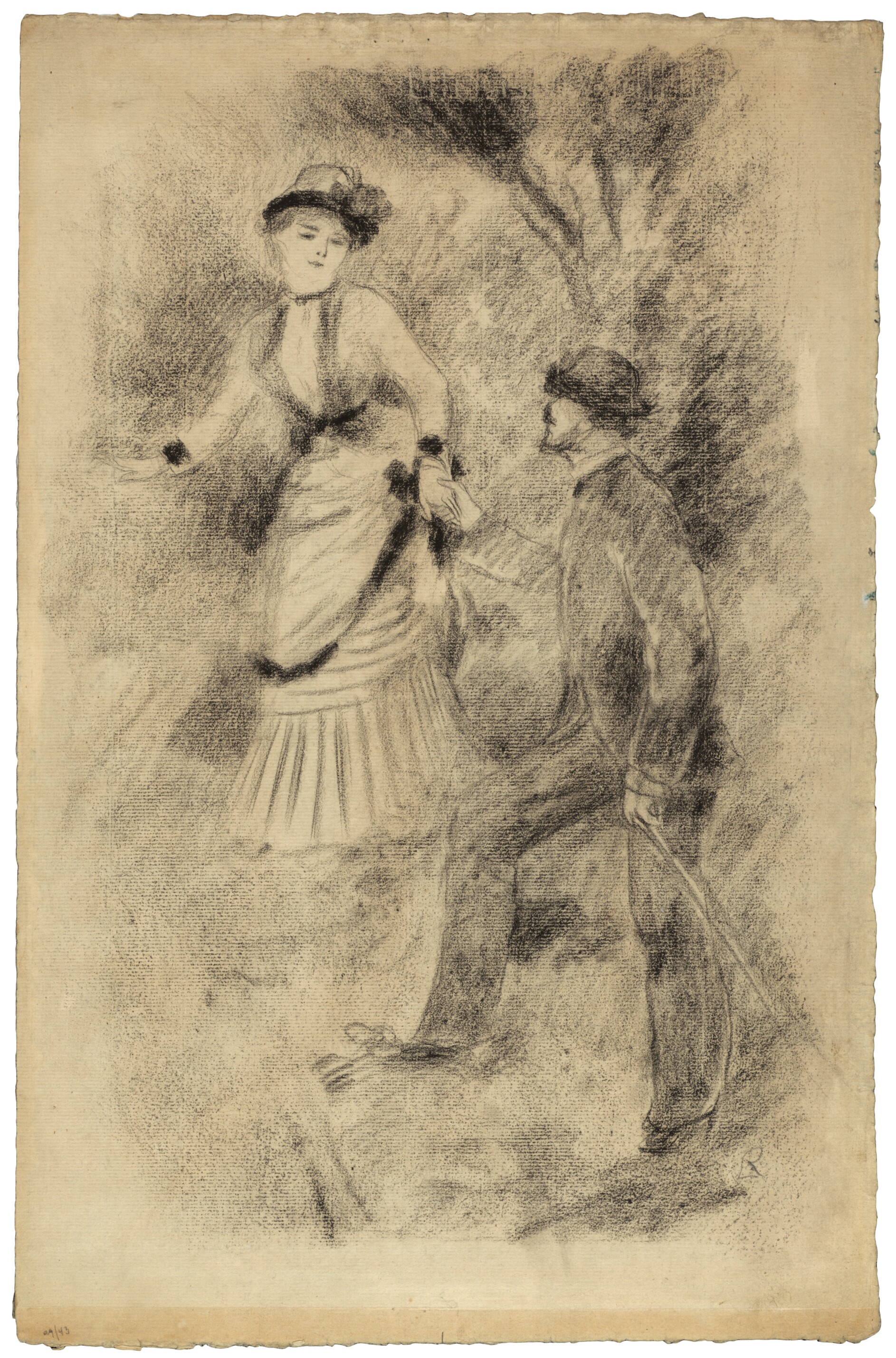
cat. 13 The Descent from the Summit: Jean Martin Steadies Hélène, the Banker's Daughter (Illustration for Edmond Renoir’s “L’étiquette”), 1881 (recto).
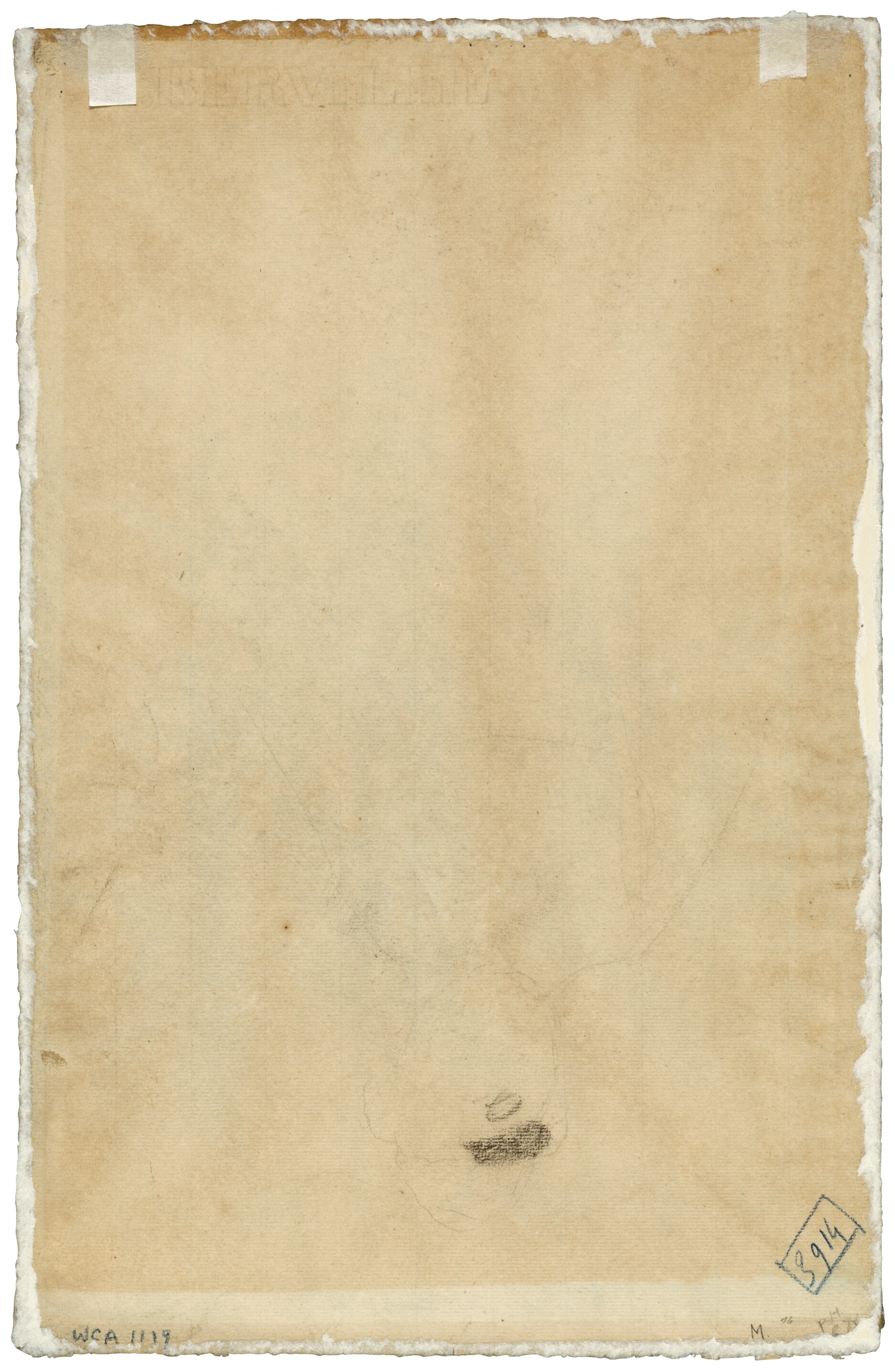
DELETED. Verso of Renoir’s The Descent from the Summit: Jean Martin Steadies Hélène, the Banker’s Daughter (Illustration for Edmond Renoir’s “L’étiquette”) (1881). The Art Institute of Chicago, 1969.870R.
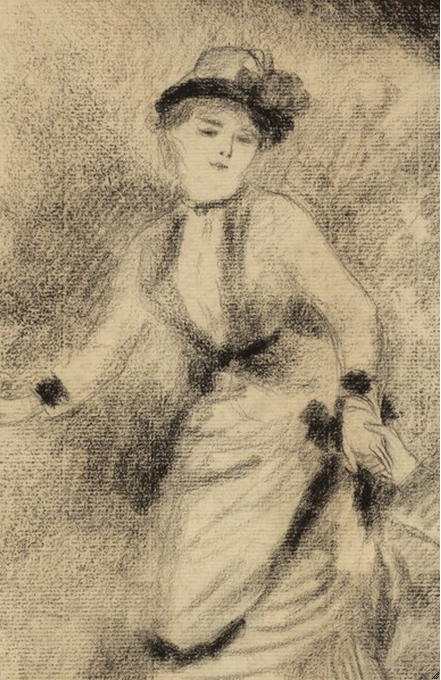
Detail of Renoir’s The Descent from the Summit: Jean Martin Steadies Hélène, the Banker’s Daughter (Illustration for Edmond Renoir’s “L’étiquette”) (1881) showing both the delicate, thin lines in the face and hands and the dense, broad strokes accenting her attire. The Art Institute of Chicago, 1969.870R.
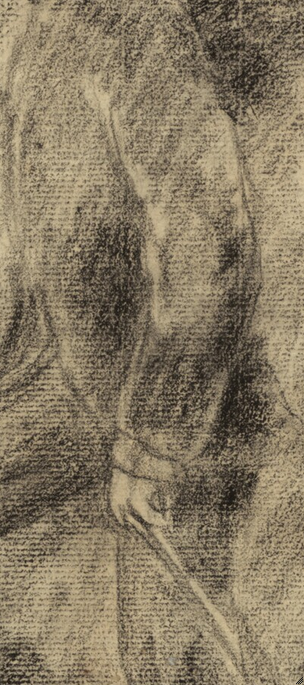
Detail of Renoir’s The Descent from the Summit: Jean Martin Steadies Hélène, the Banker’s Daughter (Illustration for Edmond Renoir’s “L’étiquette”) (1881) showing the highlights created by the absence of black chalk. The Art Institute of Chicago, 1969.870R.
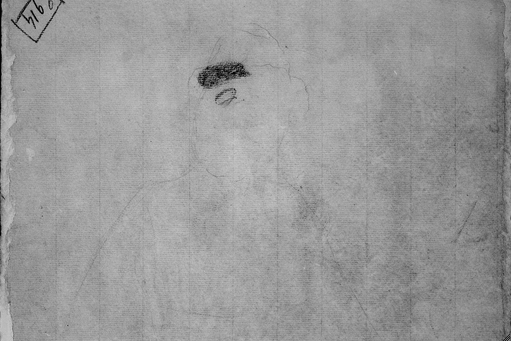
Infrared reflectogram (Fuji, 1.0–1.1 µm) detail of Renoir’s Half-Length Sketch of a Woman (c. 1883) showing the faint drawing lines of a woman. The Art Institute of Chicago, 1969.870V.
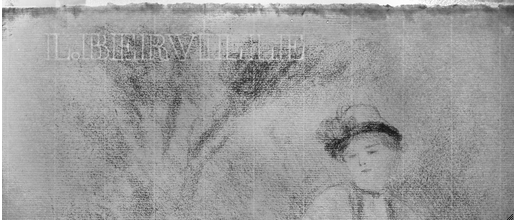
Transmitted-infrared detail (Fuji, 1.0–1.1 µm) (inverted) of Renoir’s The Descent from the Summit: Jean Martin Steadies Hélène, the Banker’s Daughter& (Illustration for Edmond Renoir’s “L’étiquette”) (1881) showing the paper’s watermark. The Art Institute of Chicago, 1969.870R.
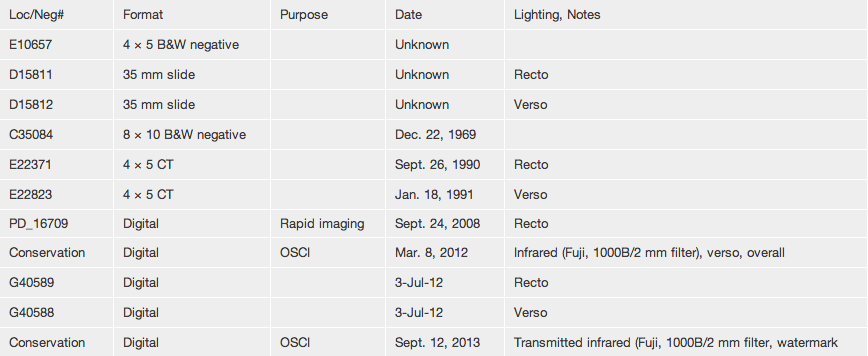
| Loc/Neg# | Format | Purpose | Date | Lighting, Notes |
| E10657 | 4 × 5 B&W negative | Unknown | ||
| D15811 | 35 mm slide | Unknown | Recto | |
| D15812 | 35 mm slide | Unknown | Verso | |
| C35084 | 8 × 10 B&W negative | Dec. 22, 1969 | ||
| E22371 | 4 × 5 CT | Sept. 26, 1990 | Recto | |
| E22823 | 4 × 5 CT | Jan. 18, 1991 | Verso | |
| PD_16709 | Digital | Rapid imaging | Sept. 24, 2008 | Recto |
| Conservation | Digital | OSCI | Mar. 8, 2012 | Infrared (Fuji, 1000B/2 mm filter), verso, overall |
| G40589 | Digital | 3-Jul-12 | Recto | |
| G40588 | Digital | 3-Jul-12 | Verso | |
| Conservation | Digital | OSCI | Sept. 12, 2013 | Transmitted infrared (Fuji, 1000B/2 mm filter, watermark |
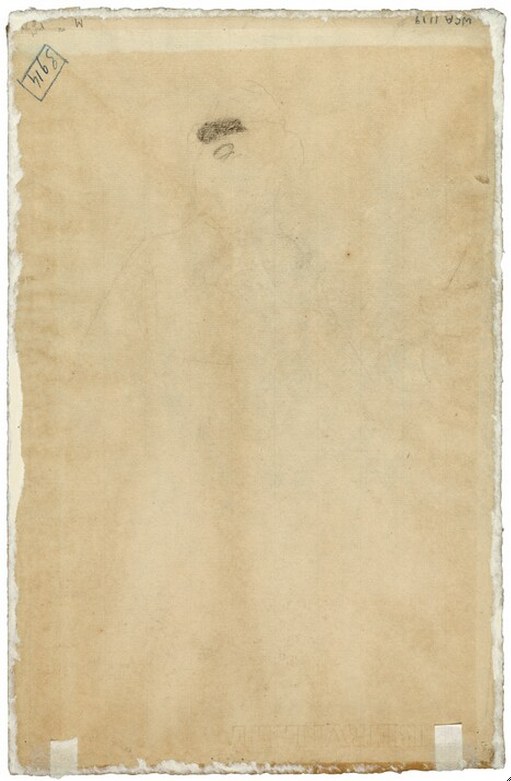
Half-Length Sketch of a Woman (c. 1883), verso of The Descent from the Summit: Jean Martin Steadies Hélène, the Banker's Daughter (Illustration for Edmond Renoir’s “L’étiquette”), 1881. The Art Institute of Chicago, 1969.870V.
On the Terrace of a Hotel in Bordighera: The Painter Jean Martin Reviews His Bill (Illustration for Edmond Renoir’s “L’étiquette”)
1881
Conté crayon, over pen and brush and black ink, on ivory laid paper, discolored to cream; 452 × 354 mm
Signed: Renoir (recto, lower left, in pen and black ink)
The Art Institute of Chicago, Helen Regenstein Collection, 1977.491
Renoir applied his drawing media in a variety of ways to create On the Terrace of a Hotel in Bordighera: The Painter Jean Martin Reviews His Bill (Illustration for Edmond Renoir’s “L’étiquette,” almost completely covering the surface of the ivory-colored [glossary:laid paper]. The compositional lines were worked out primarily in pen and black ink. Fine, delicate lines were used to render the sitter’s delicate facial features and impart the delicate grasp of the bill in his hand (fig. 1.2). In other areas, slightly thicker lines spaced closely together or hatched create shading and tonal passages. Renoir employed brush and black ink to create dark passages in the sitter’s shoes, hair, and hat (fig. 1.1); in the upper left figure’s bag; and in the foreground grass.
The artist then applied [glossary:Conté crayon] to form medium tonal passages in the sitter’s clothing and in the underside of the umbrella as well as to create a sense of depth (fig. 2.20). The Conté crayon picks up the moderate surface texture of the paper, creating a grainy appearance in the tonal passages. Renoir introduced highlights into the composition by leaving the light tonality of the paper exposed in the building facade at the upper left, in the top of the umbrella, and in the foreground, creating the illusion that light is striking these surfaces. The left margin of the sheet is devoid of media and appears to have been formerly folded behind the sheet early on in the drawing’s execution.
Renoir (recto, lower left, in pen and black ink) (fig. 1.3).
Ivory (discolored to cream), medium-thick, moderately textured laid paper.818
Vertical, 2.7–2.8 cm.
9–10 cm.
Uniform, without significant inclusions or colored fibers.
Even, possibly machine made.
[glossary:Deckle edges] are present along the right side, and top and bottom edges; the left edge is cut straight.
452 × 354 mm.
No artistic surface alterations or coatings are visible in normal conditions or under magnification. Under [glossary:UV] illumination, there is a pale-yellow visible-light [glossary:fluorescence] overall on the paper surface that is characteristic of a light gelatin surface [glossary:sizing].
Pen and brush and black ink were used to create the compositional lines, over which Conté crayon was applied to establish broad tonal areas.
There is no drawing on the verso. Two spots of black ink are present in the center left area.
No revisions or changes are visible in the composition in normal conditions or under magnification.
No artistic surface fixatives or coatings are visible in normal conditions, under UV illumination, or under magnification.
The drawing is in relatively good condition overall. The paper [glossary:support] has discolored slightly overall, though it is darkest along the left edge. The paper appears to have been formerly folded along the left margin, forming a crease approximately 5.2 cm from the left edge. It is likely that the fold was created at the time the work was drawn, as there is some accumulation of media along the crease. A fine irregular fold in the paper extends from the left bottom edge up through the image area, terminating just before the top edge. This fold also existed early on, possibly developed after the sheet’s formation; media accumulation is visible at the high points along the fold.
On the verso, in the center left area, there are two spots of black ink that appear to be similar to the drawing medium. These are visible through to the recto when the sheet is placed against a light surface; to minimize or reduce the visibility of these spots, the drawing is hinged against black rag matboard. The work does not appear to have undergone conservation treatment in the past.
Kimberly Nichols
Charlotte Labille (1889–1963), Paris, by Jan. 1, 1925.819
Paul Rosenberg (1881–1959), Paris and Bordeaux, by Sept. 15, 1940.820
Confiscated from Paul Rosenberg, Bordeaux, by the Einsatzstab Reichsleiter Rosenberg (ERR), Sept. 15, 1940.821
Selected by Walter Andreas Hofer (1893–c. 1971) at the Jeu de Paume, Paris, for Hermann Goering (1893–1946) and transferred from the ERR to Goering, Dec. 2, 1941.822
Exchanged by Hermann Goering, with Hans Wendland (born 1880) and Theodor Fischer (1878–1957), Lucerne, via Walter Andreas Hofer, early 1942.823
Returned to Paul Rosenberg, New York, June 3, 1948.824
Probably sold by the Rosenberg family to E. V. Thaw and Company (founded 1950), New York, c. 1977.825
Sold by E. V. Thaw and Company, New York, to the Art Institute of Chicago, 1977.826
Art Institute of Chicago, Great Drawings from The Art Institute of Chicago: The Harold Joachim Years, 1958–1983, July 24–Sept. 30, 1985, cat. 71 (ill.); Saint Louis Art Museum, Mar. 10–May 16, 1986.
Art Institute of Chicago, Masterpieces from the Helen Regenstein Collection, Feb. 2–May 8, 1990, no cat.
Art Institute of Chicago, Maineri to Miro: The Regenstein Collection, Apr. 22–July 16, 2000, no cat.
Vienna, Albertina, Impressionism: Pastels, Watercolors, Drawings, Feb. 9–May 13, 2012, pl. 137.
Edmond Renoir, “L’étiquette,” La vie moderne 50 (Dec. 15, 1883), p. 803 (ill.).
Georges Rivière, Renoir et ses amis (H. Floury, 1921), opposite p. 192 (ill.).
Charles Léger, “Renoir illustrateur,” L’art vivant 168 (Jan. 1933), p. 8 (ill.).
John Rewald, “Auguste Renoir and His Brother,” Gazette des beaux-arts 27 (Mar. 1945), pp. 172, no. 2 (ill.), 186.
John Rewald, Renoir Drawings (H. Bittner, 1946), p. 18, no. 24 (ill.).
Walter Pach, Renoir (Abrams, 1950), p. 20 (ill.).
Phoebe Pool, Impressionism (Oxford University Press, 1969), pp. 152, no. 114 (ill.), 153, 277.
Walter Pach, Auguste Renoir: Leben und Werk (M. Dumont Schauberg, 1976), pp. 72, no. 42 (ill.), 73, 173.
Harold Joachim and Sandra Haller Olsen, French Drawings and Sketchbooks of the Nineteenth Century, vol. 2 (University of Chicago Press, 1979), p. 90, no. 5D7.
Nicholas Wadley, Renoir: A Retrospective (Hugh Lauter Levin, 1987), p. 130 (ill.).
Natalia Brodskaya, Auguste Renoir: He Made Colour Sing (Parkstone, 1996), p. 33 (ill.).
Douglas W. Druick, Renoir, Artists in Focus (Art Institute of Chicago/Abrams, 1997), pp. 41, 44, 90, no. 9 (ill.), 110.
Martha Tedeschi, “Pierre Auguste Renoir, Workers’ Daughters on the Outer Boulevard (Illustration for Emile Zola’s ‘L’Assommoir’), 1877/78,” in “Maineri to Miró: The Regenstein Collection since 1975,” special issue, Art Institute of Chicago Museum Studies 26, 1 (2000), pp. 80–81, no. 35 (ill.).
Suzanne Folds McCullagh, “‘A Lasting Monument’: The Regenstein Collection at the Art Institute of Chicago,” special issue, Art Institute of Chicago Museum Studies 26, 1 (2000), p. 13.
Guy-Patrice Dauberville and Michel Dauberville, with the collaboration of Camille Frémontier-Murphy, Renoir: Catalogue raisonné des tableaux, pastels, dessins, et aquarelles, vol. 1, 1858–1881 (Bernheim-Jeune, 2007), p. 621, no. 672 (ill.).
Mark
Location: bottom left area
Method: graphite or chalk erased, faintly visible in normal conditions and infrared radiation
Content: [illegible] (fig. 1.4)
Stamp
Location: lower right corner
Method: black ink, faint
Content: q
Inscription
Location: back of the old mount (now lost; note in curatorial object file)
Method: pen and blue ink
Content (partial): Le dessin a la plume de P.A. Renoir, mon frere et me representant assis lisant au bord de la mediterranee est la propriete de Charlotte Labille / Paris, 1 janvier 1925 / Edmond Renoir (see transcription)
Paper support characteristics identified.
Paper mold characteristics identified.
Light surface sizing detected.
Inscription on recto, in lower left area, captured.
Media identified.
The image inventory compiles records of all known images of the artwork on file in the Imaging Department and in the conservation and curatorial files in the Department of Prints and Drawings at the Art Institute of Chicago (fig. 2.22).
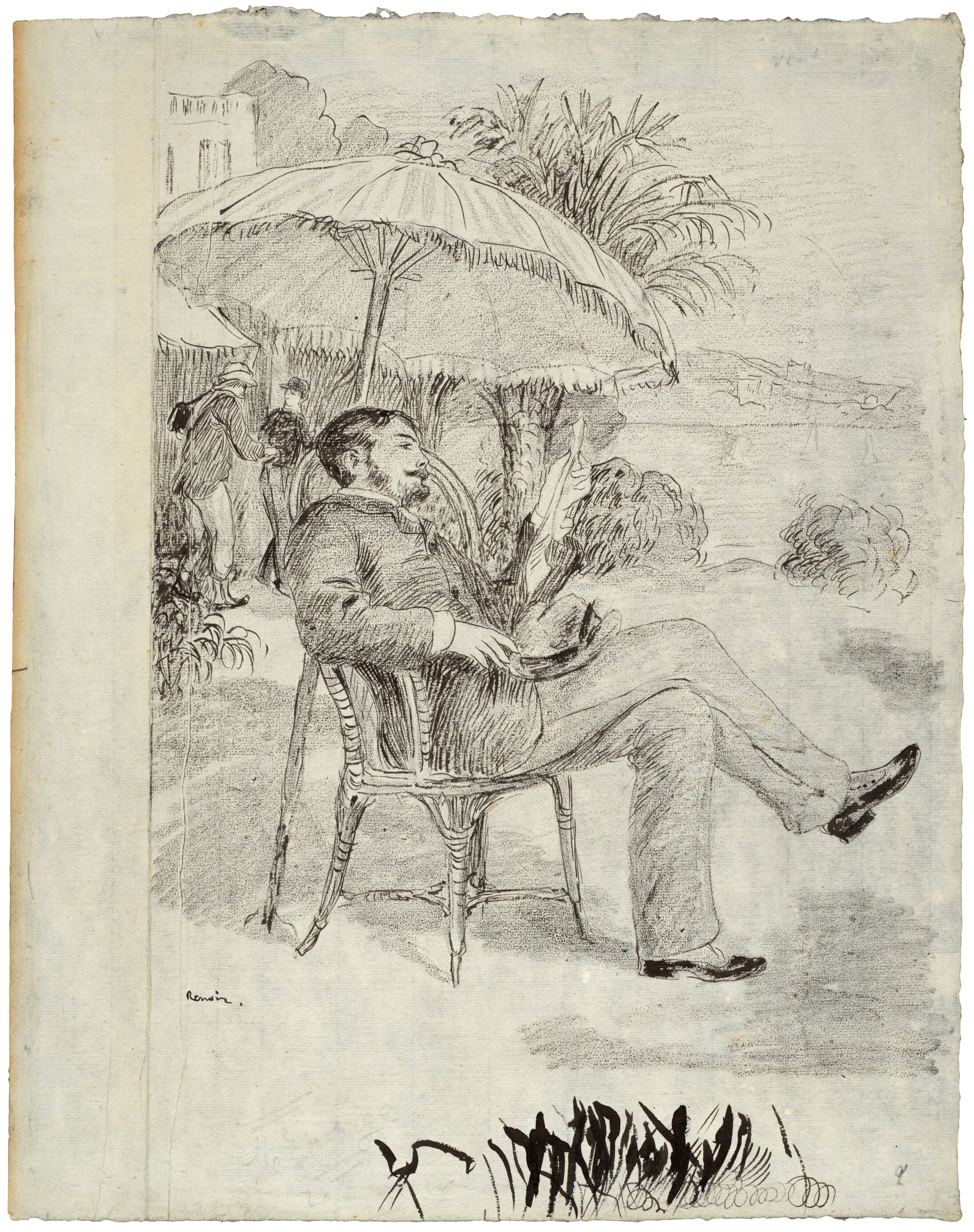
cat. 12 On the Terrace of a Hotel in Bordighera: The Painter Jean Martin Reviews His Bill (Illustration for Edmond Renoir’s “L’étiquette”), 1881.
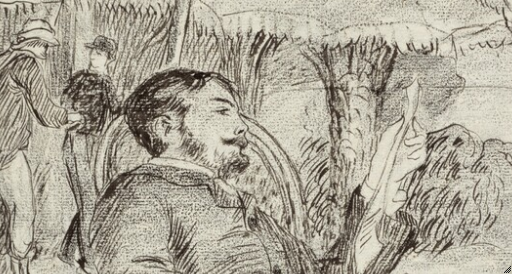
Detail of Renoir’s On the Terrace of a Hotel in Bordighera: The Painter Jean Martin Reviews His Bill (1881) showing the artist’s use of fine pen and ink lines to work out the composition. The Art Institute of Chicago, 1977.841.
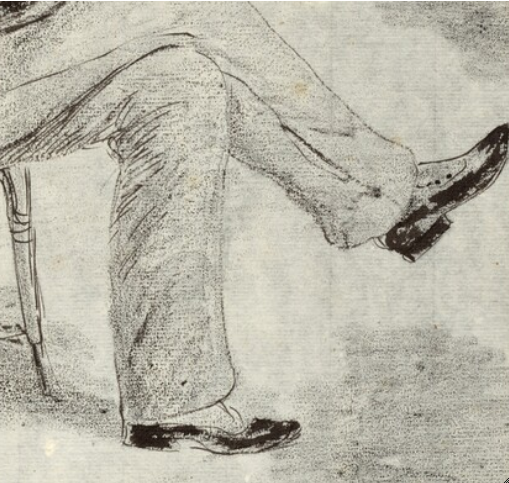
Detail of Renoir’s On the Terrace of a Hotel in Bordighera: The Painter Jean Martin Reviews His Bill (1881) showing the artist’s use of brush and black ink to create dark passages in the sitter’s shoes. The Art Institute of Chicago, 1977.841.
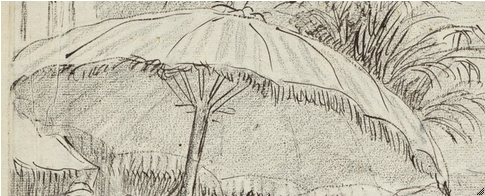
Detail of Renoir's On the Terrace of a Hotel in Bordighera: The Painter Jean Martin Reviews His Bill (1881) showing the artist's use of Conté crayon to establish light tonal passages. The Art Institute of Chicago, 1977.841.
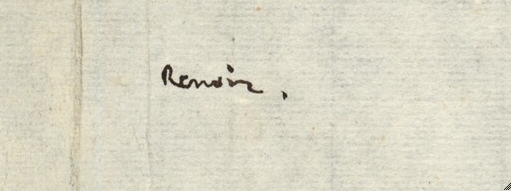
Detail of Renoir’s On the Terrace of a Hotel in Bordighera: The Painter Jean Martin Reviews His Bill (1881) showing Renoir’s signature in pen and brown ink. The Art Institute of Chicago, 1977.841.
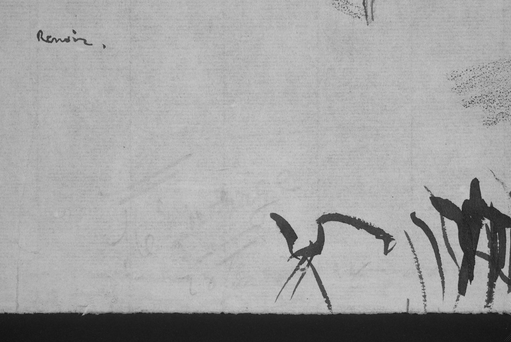
Infrared reflectogram (Fuji, 1.0–1.1 µm) detail of Renoir's On the Terrace of a Hotel in Bordighera: The Painter Jean Martin Reviews His Bill (1881) showing an illegible inscription. The Art Institute of Chicago, 1977.841.
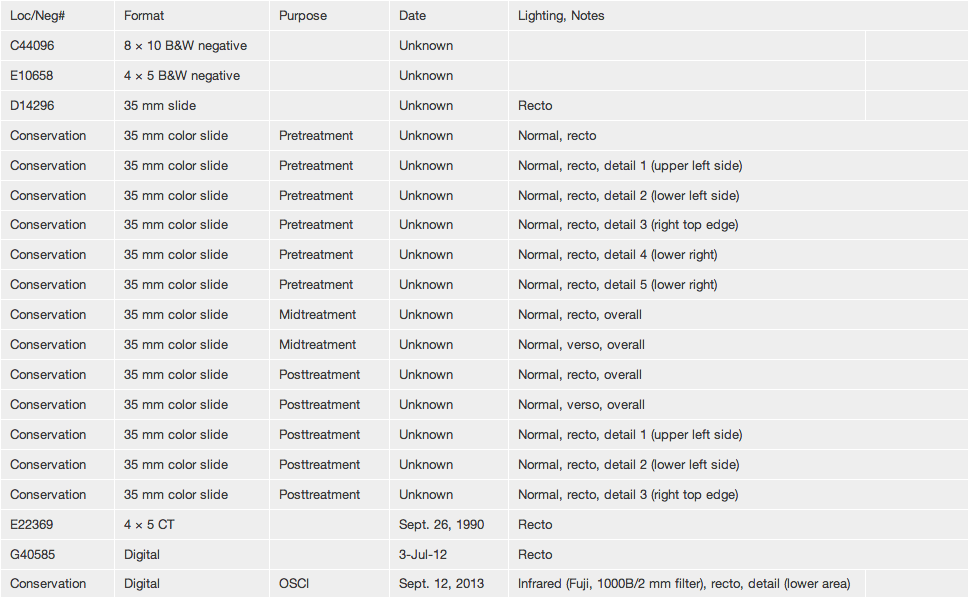
| Loc/Neg# | Format | Purpose | Date | Lighting, Notes | |
| C44096 | 8 × 10 B&W negative | Unknown | |||
| E10658 | 4 × 5 B&W negative | Unknown | |||
| D14296 | 35 mm slide | Unknown | Recto | ||
| Conservation | 35 mm color slide | Pretreatment | Unknown | Normal, recto | |
| Conservation | 35 mm color slide | Pretreatment | Unknown | Normal, recto, detail 1 (upper left side) | |
| Conservation | 35 mm color slide | Pretreatment | Unknown | Normal, recto, detail 2 (lower left side) | |
| Conservation | 35 mm color slide | Pretreatment | Unknown | Normal, recto, detail 3 (right top edge) | |
| Conservation | 35 mm color slide | Pretreatment | Unknown | Normal, recto, detail 4 (lower right) | |
| Conservation | 35 mm color slide | Pretreatment | Unknown | Normal, recto, detail 5 (lower right) | |
| Conservation | 35 mm color slide | Midtreatment | Unknown | Normal, recto, overall | |
| Conservation | 35 mm color slide | Midtreatment | Unknown | Normal, verso, overall | |
| Conservation | 35 mm color slide | Posttreatment | Unknown | Normal, recto, overall | |
| Conservation | 35 mm color slide | Posttreatment | Unknown | Normal, verso, overall | |
| Conservation | 35 mm color slide | Posttreatment | Unknown | Normal, recto, detail 1 (upper left side) | |
| Conservation | 35 mm color slide | Posttreatment | Unknown | Normal, recto, detail 2 (lower left side) | |
| Conservation | 35 mm color slide | Posttreatment | Unknown | Normal, recto, detail 3 (right top edge) | |
| E22369 | 4 × 5 CT | Sept. 26, 1990 | Recto | ||
| G40585 | Digital | 3-Jul-12 | Recto | ||
| Conservation | Digital | OSCI | Sept. 12, 2013 | Infrared (Fuji, 1000B/2 mm filter), recto, detail (lower area) | |
Fruits of the Midi827
1881
Oil on canvas; 51 × 65 cm (20 1/16 × 25 5/8 in.)
Signed and dated: Renoir. 81. (lower left, in dark-blue paint)
The Art Institute of Chicago, Mr. and Mrs. Martin A. Ryerson Collection, 1933.1176
Writing in late November 1881 from Naples to his friend and patron Paul Berard, Renoir revealed a fondness for Italian food: “I’m eating cooking with garlic, which I adore.”828 Part of his enjoyment of travel was learning about local culture: the distinctive art and architecture but also the cuisine of the region.829 In Fruits of the Midi the artist paid tribute to the culture of Italy, composing a still life that features the bounty of the warm Mediterranean climate: peppers, eggplants, tomatoes, pomegranates, citrons, lemons, and oranges.
In Italy Renoir was as much captivated by everyday life and the effects of light on the landscape as he was with the Old Master and Renaissance treasures that were the primary objective of the trip. It was probably his interest in experiencing the everyday that led him to visit the region of Calabria, located at the toe of the boot, then one of the most impoverished and undeveloped parts of the country. Renoir found “wonders” in this little-visited destination, with its age-old traditions and an economy unspoiled by modern industry.830
Though the Chicago still life is rustic in subject, Douglas Druick has suggested that it reflects the classical sense of calm and monumentality that Renoir encountered in the Old Master paintings he saw in Rome. “There is an austerity here that is new in the art of Renoir, signaled by the relative plainness of both tablecloth and background.”831
Barbara White was the first scholar to identify Fruits of the Midi as one of the two still lifes that Renoir mentioned in a letter to his friend and patron Charles Deudon, written in Naples in late November or early December 1881: “I am going to send in a few days one or two still lifes; there is one that is good.”832 The other painting is undoubtedly Onions (fig. 2.52 [Dauberville 58]), inscribed and dated “Naples. 81.”833 The two are closely related in subject matter, handling, use of color, and compositional arrangement. Both were purchased by the art dealer Paul Durand-Ruel in May 1882 as part of a group of seventeen works produced during 1881–82.834 The Chicago still life was almost certainly the work in this group titled Fruits du midi.835
These two paintings could be pendants, if not for the difference in size and format: Fruits of the Midi corresponds to a no. 15 landscape (paysage) standard-size canvas (65 × 50 cm), and Onions to a slightly smaller no. 12 seascape (marine) standard-size canvas (60 × 38 cm). Both works reflect a firm, carefully delineated modeling of the still-life elements with generous amounts of paint applied with a controlled brush—quite distinct from the loose handling seen in works of the 1870s or even in the landscapes he was painting at about the same time, The Bay of Naples (Morning) (fig. 2.53 [Dauberville 166]) and The Bay of Naples (Evening) (fig. 2.54 [Dauberville 167]).836 In both still lifes, Renoir contrasted textures and colors: the papery skins of the onions topped with the crinkled line of dried roots are as convincingly portrayed as the deep aubergine of the eggplant and the brilliant sheen of the buckled and seamed red pepper next to it. In each painting, the arrangement is set on a round table covered with a pristine white cloth. The natural light reflecting off the objects suggests that they are near a window receiving plenty of sunlight. Both backgrounds were built up with longer, directional brushwork more in keeping with a looser style of Impressionism and provide little clue as to setting.
The backgrounds and tablecloths in both paintings are also chromatically harmonized with the still-life objects depicted. The golden yellows of the onions can be seen in muted form throughout the background of Onions, in the same way that the green, mauve, blue, and even red in the background of Fruits of the Midi reflect the richer tones in the eggplant, citron, leaves, and pomegranates. The body and weight of the tablecloth in Fruits of the Midi are suggested by the blending of blue, pink, and mauve, colors found in the still-life objects. Many of the fruits are set upon a platter of traditional design with blue decoration; the onions in turn are collected on a napkin with blue and red trim, while the tablecloth beneath contains yellow highlights that harmonize with the onion skins. Perhaps Renoir was thinking about how Onions and Fruits of the Midi might complement each other when he painted over the original blue, lavender, and mauve in the background of Fruits of the Midi (still visible at the edges of the painting; fig. 2.55) with lighter green and yellow.
Finally, Onions and Fruits of the Midi exhibit a complementary compositional asymmetry. In Onions the main group of bulbs is gathered to the right, with a stray having fallen free of the group to the left. This grouping is mirrored in Fruits of the Midi, where the platter is placed off-center to the left, with a stray pomegranate and pepper to the right.
Fruits of the Midi was probably included in Renoir’s retrospective exhibition of seventy works organized by Durand-Ruel in April 1883, along with Onions and the two views of the Bay of Naples.837 While there is no work titled Fruits du midi in the 1883 exhibition catalogue, critical commentary suggests that a still life resembling it was on display. The reviewer for the Journal des artistes wrote of a still life “gathered together, in a jumble, gherkins and peppers in hard and garish colors”—likely mistaking the citrons in Fruits of the Midi for gherkins.838 These comments were immediately followed by a detailed description of and glowing praise for Onions.839 Such a disparate critical reaction to the two still lifes may shed light on why Onions was purchased by Durand-Ruel for 700 francs while the larger Fruits of the Midi garnered only 600 francs—the brilliant colors used in the latter painting may have been too unsettling.840
In reporting on his crisis of the 1880s to Ambroise Vollard, Renoir recalled that it was in 1883, the year of his retrospective exhibition, that he realized he had reached a dead end with Impressionism and “did not know how to paint or draw.”841 Two years before that, however, when he set out for Italy in the fall of 1881, Renoir was undertaking a pilgrimage that, while a tradition for generations of French artists, was unusual for an Impressionist and may indicate that he was experiencing uncertainty about his artistic direction.842 In many letters written during the trip, Renoir conveyed self-consciousness about embarking on such a journey at the age of forty, well into the middle of his career. In one such missive to Madame Georges Charpentier from Venice in October, there is a subtext of wanting to fulfill expectations of new patrons about his artistic education: “I have suddenly become a traveler, seized by the feverish desire to see the Raphaels. I am therefore in the process of taking in my Italy. Now I shall be able to reply firmly, yes, sir, I have seen the Raphaels. I have seen Venise la belle, etc., etc.”843 As his travels through Italy progressed, Renoir reported that Raphael’s frescoes were “wonderful for simplicity and grandeur,” and he was especially enthusiastic about his discovery of the archaeological museum in Naples and its collection of Roman mural painting.844
It is tempting to see in the brushwork of Fruits of the Midi and in the solidity of its still-life elements the “progress” that Renoir professed to have made after a long period of searching.845 A pronounced linear style is evident in how he modeled the still-life forms with a fine brush, following the contours with a pattern of crosshatching and layering to create highlights of pure color, for example, along the curving top of the red pepper in the foreground, just to the left of center (fig. 2.56). In other areas, he blended his colors to convincingly convey light falling on the surfaces of the objects. The varied textures in Fruits of the Midi establish the painting as a brilliantly conceived study in contrasts: the indented and buckled bodies of the peppers; the smooth, tight skins of the bright-red tomatoes; the yellow and green rind of the citron with its realistically nubby appearance. Renoir built up the glistening skin of the eggplant by layering deep translucent reds and blues over a foundation of brilliant mauves and bright reds (fig. 2.57). So carefully did Renoir model his fruits and vegetables within the initial drawing that radiotransparent “outlines” can be seen in the [glossary:X-ray] around the edges of the forms (fig. 2.58). While these still-life elements convey a sculptural presence, the background and tablecloth revert to an Impressionist style with longer strokes from a wider brush.
Fruits of the Midi may well have inspired the following comment by the American artist Marsden Hartley: “I think of Renoir as a great painter of fruit. It always seems like the journey through the sensuous orchard of the aesthetic soul in Renoir. His flesh is eatable—and his vistas and still lifes so strokable.”846 It is revealing that Renoir’s still life, the colors of which were found to be “garish” in 1883, could inspire a modernist of a younger generation at the turn of the century. While Renoir’s still lifes are often thought of as secondary compared to his figures and landscapes, Fruits of the Midi is clearly the result of careful consideration and amply demonstrates his mastery of color.
John Collins
Using a standard-size [glossary:canvas] that he probably stretched and primed himself,847 Renoir began painting the still-life elements in this composition by outlining the major contours in very fluid, thin red paint. He established the still-life elements and largely finished them before adding the background. These forms are marked by their strong edges, both coloristically and sculpturally separated from their surroundings. In some areas, especially in the foreground, a small margin of unpainted [glossary:ground] is left around the objects, where the [glossary:underdrawing] is revealed. The ground itself appears to have been applied with a brush and then heavily worked into the canvas with a [glossary:palette knife], leaving the thread tops exposed in many areas. The smaller, finer strokes used to build up the still-life elements contrast with the broader, longer diagonals and cross-hatched patterns in the background.
The multilayer interactive image viewer is designed to facilitate the viewer’s exploration and comparison of the technical images (fig. 2.50).848
Signed and dated: Renoir. 81. (lower left, in dark-blue paint) (fig. 1.2).849
The signature was applied in very fluid paint over a dry, heavily textured background and primarily fills the depressions of the brushstrokes (fig. 1.1).
Flax (commonly known as linen).850
The primed area of the canvas is approximately 50 × 64 cm. This closely corresponds to a no. 15 landscape ([glossary:paysage]) standard-size (65 × 50 cm) canvas; this is also the number stamped on the verso of the [glossary:stretcher] (fig. 2.20).851
[glossary:Plain weave]. Average [glossary:thread count] (standard deviation): 22.8V (0.7) × 23.0H (1.1) threads/cm. The vertical threads were determined to correspond to the warp and the horizontal threads to the weft.852
The canvas has very strong [glossary:cusping] on all sides, consistent with deformations seen when the canvas is stretched before the ground is applied.
Current stretching: The work was lined and restretched at an unknown date, at which time the dimensions were increased slightly on all sides.
Original stretching: Based on cusping visible in the [glossary:X-ray], the original tacks were placed approximately 6–8 cm apart.
Though the painting was lined and restretched as part of a previous, undocumented conservation treatment, the patina and standard size stamp suggest that the stretcher is original to the painting (fig. 1.3). It is a five-member, keyable, mortise-and-tenon stretcher with a vertical [glossary:crossbar]. Depth: 1.5 cm.
Stamp
Location: stretcher
Method: black ovular stamp
Content: 15 w (fig. 2.20)
Not determined (probably glue).853
The ground was applied to the compositional area only after the canvas was stretched. It is a single layer with variable thickness ranging approximately 20–90 µm, partially fills the weave, and appears to have been heavily worked into the canvas with a palette knife, leaving the tops of the threads exposed in many areas. The edges are soft and uneven, suggesting that a brush was used to spread the ground after the initial application; the excess was likely removed and the layer smoothed with a palette knife.854 As the ground contains relatively few extenders and covers only the compositional area, it is possible that it was applied by the artist.855
The ground is white; no additional, colored particles were observed under [glossary:stereomicroscopic examination] or [glossary:cross-sectional analysis] (fig. 2.22).
The ground is lead white with traces of alumina, complex silicates, and some calcium-based white.856 The binder is estimated to be [glossary:oil].857
No underdrawing is observed with [glossary:infrared reflectography]; however, careful stereomicroscopic examination suggests that Renoir may have outlined the major forms in very thin, fluid paint.
Evidence of underdrawing is visible only microscopically along the edges of forms and suggests that the artist used a very thin red lake (fig. 2.23).858
As the underdrawing is seen only along the edges of forms and is not seen in infrared reflectography, subsequent paint layers hide any possible changes in this stage of the composition (see Paint Layer).
Renoir painted the still-life elements almost to completion before he brought the background in around them. Instead of blending the edges with the background and moving fluidly between the objects and their environment, Renoir gave each object an accentuated edge, in many cases using both color and texture to do so (fig. 2.24). In some areas, especially the foreground tablecloth and the rising stem in the center, the artist left a small margin of unpainted ground around the objects, increasing the sculptural nature of their edges (fig. 2.25). The light color of the tablecloth atop the white ground allowed these unpainted sections to visually blend with the surroundings. Even many of the smaller elements—the various protruding stems and leaves—appear to have been painted in large part before the background was added. This method of painting makes compositional changes more obvious, especially in the X-ray; these were limited to the possibility of a stem, leaves, or a fold in the tablecloth near the pomegranate on the far right; slight alterations to curve of the foreground eggplant near the stem; and the undersides of the peppers on the far right and to the left of center (fig. 2.26).
The still-life objects themselves were worked up in a series of paint layers, often incorporating vivid [glossary:underpainting] and [glossary:wet-in-wet] modeling. The appearance of certain objects under normal viewing conditions belies the intricacy of Renoir’s working methods. Looking at the foreground eggplant and the pepper to its right, for example, specifically at the thin, glaze-like layers most evident on the surface, there is little visible information to explain the radio-opacity of these forms in the X-ray, where they appear to be the most heavily painted objects in the composition. The eggplant just left of center atop the pile of fruits appears as expected in the X-ray, indicating that it was probably painted primarily with the glaze-like layers most apparent in the foreground example. Closer inspection reveals that the latter was initially painted in mauves and reds, incorporating [glossary:radio-opaque] vermilion and lead white. These tones acted as an underlayer, over which Renoir applied thin layers of translucent pigments such as red lake and cobalt blue to partially expose the initial colors and give the vegetable’s skin depth and coloristic complexity (fig. 2.27).859 Elsewhere, Renoir embraced a more heavy-handed approach, using a palette knife, as well as a brush, to spread thick paint containing opaque pigments across the surface, as in the somewhat bumpy surface of the citron in the center (fig. 2.28).860
The background is marked by relatively long, directional brushstrokes, which contrast with the short, discrete strokes used in the still-life elements. Renoir changed the tonality of the background, first executing this space in an array of cool blue, lavender, and mauve tones that are still visible along the edges of forms and near the perimeter (fig. 2.29). Looking closely at the stem extending upward near the center, it is possible to see the back-and-forth between the objects and their surroundings: first, the initial paint layers of the stem were laid down, including a bright-yellow highlight; then the cool blue and lavender background colors were brought in around the stem; next the chunky white highlight was daubed atop the stem; and finally the new, greener background was applied (fig. 2.30). The tablecloth is largely made up of diagonal strokes of white, with hints of blue and red lake drawn in wet-in-wet to create soft shadows and folds. The vivid colors used in the still life are reflected in the muted tones of the broadly cross-hatched background.
Soft and medium, round and flat brushes with strokes up to 1 cm wide; palette knife.
Analysis indicates the presence of the following [glossary:pigments]:861 lead white, cobalt blue, emerald green, bone black, vermilion, red lake, iron oxide red and/or yellow, zinc yellow, cadmium yellow, and possibly Naples yellow and chrome yellow.
The observation of a characteristic salmon-colored [glossary:fluorescence] under [glossary:UV] light indicates that Renoir used fluorescing red lake on some of the red and purple fruits, as well as in the underdrawing and limited portions of the background (fig. 2.31).862
Oil (estimated).863
The current [glossary:synthetic varnish] was applied during the 1968 treatment and replaced an oil-resin varnish. There are residues of this earlier varnish around areas of [glossary:impasto] (especially the signature). In 1968, residues of an even older, more discolored resin [glossary:varnish] were noted; it is unclear whether this early varnish was original to the painting (see Conservation History).
The painting’s first documented treatment occurred in 1967 and included consolidation of flaking paint and [glossary:retouching].864 A more substantial treatment was undertaken the following year, and pretreatment notes indicate that the painting was already aqueously lined, with a [glossary:natural-resin varnish] and evidence of older, more discolored varnish in areas of impasto.865 As the work seemed in stable structural condition, this treatment was primarily aesthetic and included removal of grime and discolored varnishes. Losses were inpainted with methacrylate paints, and the painting was given a synthetic varnish (an isolating layer of polyvinyl acetate [PVA] AYAA, followed by methacrylate resin L-46, [glossary:inpainting], and a final coat of AYAA).
The painting is in good condition, with a stable [glossary:aqueous lining], and appears to retain its original stretcher.866 There are slight corner draws, but the work is well tensioned and otherwise planar. The canvas has discolored with age and saturation of the lining material, causing the tacking margins and exposed thread tops to appear much darker. Past cleaning and treatment have also exacerbated the abrasion and visibility of the thread tops in areas of exposed ground. There are a few local paint losses, and there is abrasion on the lower left. The stretcher was slightly keyed out and the perimeter expanded during the 1968 treatment; these edges have largely been retouched. This retouching is discolored but largely covered by the frame. The synthetic varnish imparts some saturation and an even gloss to the work and further saturates areas of exposed bare canvas.
Kelly Keegan
Current frame (probably installed mid-1960s): The frame is not original to the painting. It is an American (APF Master Frame Makers, New York), mid-twentieth-century, Louis XV reproduction, gilt scotia frame with swept, pointed sides; carved foliate ornament, foliate center cartouches, and foliate-and-acanthus corner cartouches; and a gilt fillet liner. The the frame has water and oil gilding over red bole on gesso, heavily rubbed and toned with a casein or gouache umber [glossary:wash], gray overwash, and dark flecking. The high points of the ornament are particularly distressed. The ornament and sight molding are selectively burnished. The basswood molding is mitered and nailed. The molding, from the perimeter to the interior, is ovolo with leaf-tip outer molding; scotia side; scotia face with swept, pointed sides and carved foliate ornament, foliate center cartouches, and foliate-and-anthemion corner cartouches, quirked at the frieze; sanded front frieze; ogee sight molding with acanthus leaves on a recut bed; and an independent flat fillet liner with beveled sight edge (fig. 2.32).867
Previous frame (installed by 1933, removed mid-1960s): The painting was previously housed in a late-nineteenth–early-twentieth-century, Louis XIV reproduction, ogee frame with alternating fleur-de-lis and pendent bellflower ornament bracketed by foliate scrolls and cabling and anthemion corner cartouches. The frame had water and oil gilding over gesso and cast plaster. The sides were burnished and the ornament was selectively burnished. The molding was mitered and nailed. The molding, from the perimeter to the interior, was ovolo with leaf-tip ornament; scotia side; convex face with alternating fleur-de-lis and pendent bellflower ornament bracketed by foliate scrolls and cabling and anthemia corner cartouches; fillet; sanded frieze; ogee with leaf-tip-and-flower ornament; cove; and fillet with a cove sight edge (fig. 2.42).
Kirk Vuillemot
Probably sold by the artist to Durand-Ruel, Paris, May 23, 1882, for 600 francs.868
Possibly sold at Moore’s Art Galleries, New York, May 6, 1887, lot 92.869
Acquired by Durand-Ruel, New York, by Nov. 14, 1908.870
Sold by Durand-Ruel, New York, to Martin A. Ryerson, Chicago, Dec. 18, 1915, for $10,200.871
Bequeathed by Martin A. Ryerson (died 1932), Chicago, to the Art Institute of Chicago, 1933.
Probably Paris, Durand-Ruel, Exposition des oeuvres de P.-A. Renoir, Apr. 1–25, 1883, cat. 27, as Nature morte (Naples).872
Possibly New York, National Academy of Design, Celebrated Paintings by Great French Masters, May 25–June 30, 1887, not in cat.873
Possibly New York, Durand-Ruel, Paintings by Claude Monet and Pierre August Renoir, Apr. 1900, cat. 29, as Fruits du midi.874
New York, Durand-Ruel, Exhibition of Paintings by Pierre Auguste Renoir, Nov. 14–Dec. 5, 1908, cat. 8, as Fruits du midi, 1881.875
Possibly New York, Durand-Ruel, Exhibition of Paintings Representing Still Life and Flowers by Manet, Monet, Pissarro, Renoir, Sisley, André d’Espagnat, Dec. 20, 1913–Jan. 8, 1914, cat. 14, as Fruits du midi.
Art Institute of Chicago, “A Century of Progress”: Loan Exhibition of Paintings and Sculpture, May 23–Nov. 1, 1933, cat. 343.876 (fig. 2.43)
Philadelphia, Pennsylvania Museum of Art, Manet and Renoir, Nov. 29, 1933–Jan. 1, 1934, no cat. no.877
Art Institute of Chicago, “A Century of Progress”: Loan Exhibition of Paintings and Sculpture for 1934, June 1–Oct. 31, 1934, cat. 232.878
Cambridge, Mass., Fogg Art Museum, Loan Exhibition of Paintings of Still Life, Apr. 28–May 24, 1947, no cat.879
New York, Acquavella Galleries, Four Masters of Impressionism, Oct. 24–Nov. 30, 1968, cat. 29 (ill.).
Art Institute of Chicago, Paintings by Renoir, Feb. 3–Apr. 1, 1973, cat. 36 (ill.).
Leningrad (now Saint Petersburg), State Hermitage Museum, Ot Delakrua do Matissa: Shedevry frantsuzskoi zhivopisi XIX–nachala XX veka, iz Muzeia Metropoliten v N’iu-Iorke i Khudozhestvennogo Instituta v Chikago [From Delacroix to Matisse: Great masterpieces of French painting of the nineteenth to the beginning of the twentieth century from the Metropolitan Museum of Art, New York, and the Art Institute of Chicago], Mar. 15–May 16, 1988, cat. 22 (ill.); Moscow, Pushkin Museum of Fine Arts, May 30–July 30, 1988.
Art Institute of Chicago, Chicago’s Dream, a World’s Treasure: The Art Institute of Chicago, 1893–1993, Nov. 1, 1993–Jan. 9, 1994, not in cat.880
Possibly Durand-Ruel, Paris, Catalogue de l’exposition des oeuvres de P.-A. Renoir, exh. cat. (Pillet & Dumoulin, 1883), p. 12, cat. 27.881
Possibly Edmond Jacques [Edmond Bazire], “Beaux-arts: Exposition de M. P.-A. Renoir,” L’intransigeant, Apr. 11, 1883, p. 2.
Possibly Paul Gilbert, “Exposition de M. P.-A. Renoir,” Journal des artistes, Apr. 13, 1883, p. 1.
Possibly Durand-Ruel, New York, Exhibition of Paintings by Claude Monet and Pierre Auguste Renoir, exh. cat. (Durand-Ruel, New York, 1900), no. 29.882
Durand-Ruel, New York, Exhibition of Paintings by Pierre Auguste Renoir, exh. cat. (Durand-Ruel, New York, 1908), no. 8.883
Possibly Durand-Ruel, New York, Exhibition of Paintings Representing Still Life and Flowers by Manet, Monet, Pissarro, Renoir, Sisley, André d’Espagnat, exh. cat. (Durand Ruel, New York, [1913]), cat. 14.
Art Institute of Chicago, A Guide to the Paintings in the Permanent Collection (Art Institute of Chicago, 1925), p. 162, cat. 2155.884
M. C., “Renoirs in the Institute (Continued),” Bulletin of the Art Institute of Chicago 19, 4 (Apr. 1925), pp. 47, 49 (ill.).
Ambroise Vollard, Renoir: An Intimate Record, trans. Harold L. Van Doren and Randolph T. Weaver (Knopf, 1925), p. 240.
Julius Meier-Graefe, Renoir (Klinkhardt & Biermann, 1929), p. 153, no. 134.
Art Institute of Chicago, Catalogue of “A Century of Progress”: Exhibition of Paintings and Sculpture; Lent from American Collections, ed. Daniel Catton Rich, exh. cat. (Art Institute of Chicago, 1933), p. 49, cat. 343.
Daniel Catton Rich, “The Paintings of Martin A. Ryerson,” Bulletin of the Art Institute of Chicago 27, 1 (Jan. 1933), p. 9.
Daniel Catton Rich, “Französische Impressionisten im Art Institute zu Chicago,” Pantheon: Monatsschrift für Freunde und Sammler der Kunst 11, 3 (Mar. 1933), p. 78. Translated by C. C. H. Dreschel as “French Impressionists in the Art Institute of Chicago,” Pantheon/Cicerone (Mar. 1933), p. 18.
Pennsylvania Museum of Art, “Manet and Renoir,” Pennsylvania Museum Bulletin 29, 158 (Dec. 1933), p. 19.
Art Institute of Chicago, Catalogue of “A Century of Progress”: Exhibition of Paintings and Sculpture, 1934, ed. Daniel Catton Rich, exh. cat. (Art Institute of Chicago, 1934), p. 39, cat. 232.
Albert C. Barnes and Violette de Mazia, The Art of Renoir (Minton, Balch, 1935), pp. 77; 79; 88; 132; 453, no. 115.
Henry McBride, “The Renoirs of America: An Appreciation of the Metropolitan Museum’s Exhibition,” Art News 35, 31 (May 1, 1937), p. 60.
Rosamund Frost, Pierre August Renoir, Hyperion Art Monographs, ed. Aimèe Crane (Hyperion/Duell, Sloan and Pearce, 1944), p. 43 (ill.).
“Chicago Perfects Its Renoir Group,” Art News 44, 16, pt. 1 (Dec. 1–14, 1945), p. 18 (ill.).
Art Institute of Chicago, An Illustrated Guide to the Collections of the Art Institute of Chicago (Art Institute of Chicago, 1945), p. 36.885
Walter Pach, Pierre-August Renoir, Library of Great Painters (Abrams, 1950), pp. 72–73 (ill.). Translated as Auguste Renoir: Leben und Werk (M. DuMont Schauberg, 1976), pp. 109, pl. 13; 116; 168.886
Dorothy Bridaham, Renoir in the Art Institute of Chicago (Conzett & Huber, 1954), pl. 6.
Michel Drucker, Renoir (Pierre Tisné, 1955), pl. 74; p. 154.
Bruno F. Schneider, Renoir (Safari, [1957]), pp. 61 (ill.), 68, 86. Translated into English by Desmond and Camille Clayton as Renoir (Crown, 1978), pp. 61 (ill.), 68, 86.
Art Institute of Chicago, Paintings in the Art Institute of Chicago: A Catalogue of the Picture Collection (Art Institute of Chicago, 1961), p. 397.887
Acquavella Galleries, Four Master of Impressionism, exh. cat. (Acquavella Galleries, 1968), cat. 29 (ill.).
Barbara Ehrlich White, “Renoir’s Trip to Italy,” Art Bulletin 51, 4 (Dec. 1969), pp. 338; 339; 341; fig. 26; 346, no. 20.
Charles C. Cunningham and Satoshi Takahashi, Shikago bijutsukan [Art Institute of Chicago], Museums of the World 32 (Kodansha, 1970), pp. 52, pl. 38; 160.
Elda Fezzi, L’opera completa di Renoir: Nel periodo impressionista, 1869–1883, Classici dell’arte 59 (Rizzoli, 1972), pp. 72, pl. 56; 110, cat. 486 (ill.).888
Art Institute of Chicago, Paintings by Renoir, exh. cat. (Art Institute of Chicago, 1973), pp. 100–01, cat. 36 (ill.); 210; 211.
Sophie Monneret, L’impressionnisme et son époque: Dictionnaire international illustré, vol. 2 (Denoël, 1979), p. 178 (ill.).
Barbara Ehrlich White, Renoir: His Life, Art, and Letters (Abrams, 1984), p. 166.
Richard R. Brettell, French Impressionists (Art Institute of Chicago/Abrams, 1987), pp. 66–67 (detail), 69 (ill.), 119.
Leningrad (now Saint Petersburg), State Hermitage Museum, Ot Delakrua do Matissa: Shedevry frantsuzskoi zhivopisi XIX–nachala XX veka, iz Muzeia Metropoliten v N’iu-Iorke i Khudozhestvennogo Instituta v Chikago [From Delacroix to Matisse: Great masterpieces of French painting of the nineteenth to the beginning of the twentieth century from the Metropolitan Museum of Art, New York, and the Art Institute of Chicago], exh. cat. (Avrora, 1988), cat. 22 (ill.).
Sophie Monneret, Renoir, Profils de l’art (Chêne, 1989), p. 98, no. 1 (ill.).
Gilles Plazy, Cézanne, Profils de l’art (Chêne, 1991), p. 100, no. 2 (ill.).
Lesley Stevenson, Renoir (Bison, 1991), p. 119 (ill.).
Richard Verdi, Cézanne (Thames & Hudson, 1992), pp. 11, ill. 5; 211.
James Yood, Feasting: A Celebration of Food in Art; Paintings from the Art Institute of Chicago (Art Institute of Chicago/Universe, 1992), pp. 56–57, pl. 19 (ill. and detail).
Art Institute of Chicago, Treasures of 19th- and 20th-Century Painting: The Art Institute of Chicago, with an introduction by James N. Wood (Art Institute of Chicago/Abbeville, 1993), p. 85 (ill.).
Gerhard Gruitrooy, Renoir: A Master of Impressionism (Todtri, 1994), pp. 56–57 (detail), 65 (ill.).
Natalia Brodskaïa, Auguste Renoir: He Made Colour Sing, trans. Paul Williams, Great Painters (Parkstone/Aurora Art, 1996), pp. 134–135, no. 29.
Francesca Castellani, Pierre-Auguste Renoir: La vita e l’opera (Mondadori, 1996), p. 156 (ill.).
Douglas W. Druick, Renoir, Artists in Focus (Art Institute of Chicago/Abrams, 1997), pp. 53 (detail); 54–55; 57; 94, pl. 13; 110.
Pamela Todd, The Impressionists’ Table: A Celebration of Regional French Food through the Palettes of the Great Impressionists (Pavilion, 1997), pp. 156 (ill.), 192.
Art Institute of Chicago, Impressionism and Post-Impressionism in the Art Institute of Chicago, selected by James N. Wood (Art Institute of Chicago/Hudson Hills, 2000), p. 65 (ill.).
Gilles Néret, Renoir: Painter of Happiness, 1841–1919, trans. Josephine Bacon (Taschen, 2001), p. 146 (ill.)
Katsumi Miyazaki, “The Formal Elements of Renoir’s Art and His Relationship with Cézanne,” in Bridgestone Museum of Art and Nagoya City Art Museum, Renoir: From Outsider to Old Master, 1870–1892, trans. Yumiko Yamazaki, exh. cat. (Bridgestone Museum of Art/Nagoya City Art Museum/Chunichi Shimbun, 2001), pp. 183, fig. 64; 184; 237, fig. 64; 238.
Bruce Weber, The Heart of the Matter: The Still Lifes of Marsden Hartley, exh. cat. (Berry-Hill Galleries, 2003), p. 15, fig. 6.
Aviva Burnstock, Klaas Jan van den Berg, and John House, “Painting Techniques of Pierre-Auguste Renoir: 1868–1919,” Art Matters: Netherlandish Technical Studies in Art 3 (2005), p. 52.
Kyoko Kagawa, Runowaru [Pierre-Auguste Renoir], Seiyo Kaiga no Kyosho [Great masters of Western art] 4 (Shogakukan, 2006), p. 97 (ill.).
Guy-Patrice Dauberville and Michel Dauberville, with the collaboration of Camille Frémontier-Murphy, Renoir: Catalogue raisonné des tableaux, pastels, dessins, et aquarelles, vol. 1, 1858–1881 (Bernheim-Jeune, 2007), p. 135, cat. 44 (ill.).
John House, The Genius of Renoir: Paintings from the Clark, with an essay by James A. Ganz, exh. cat. (Sterling and Francine Clark Art Institute/Museo Nacional del Prado/Yale University Press, 2010), p. 96.
Inventory number
Probably stock Durand-Ruel, Paris, 2394889
Inventory number
Stock Durand-Ruel, New York, 115890
Photograph number
Photo Durand-Ruel, New York, A915891
Label (fig. 2.19)
Inscription (fig. 2.36)
Label
Location: stretcher
Method: handwritten script on red-and-white label
Content: 15 / 605 (fig. 2.33)
Number
Location: canvas verso (lining canvas)
Method: handwritten script (red paint)
Content: 33.1176 (fig. 2.34)
Stamp
Location: stretcher
Method: black ovular stamp
Content: 15 w (fig. 2.35)
Inscription
Location: stretcher
Method: handwritten script (graphite)
Content: D.R.N.Y / 115 (fig. 2.36)
Label
Location: stretcher
Method: handwritten script on printed label
Content: Renoir / No. 115 / Fruits du / midi 1881 / mabbb (fig. 2.19)
Number
Location: frame verso
Method: handwritten script (graphite)
Content: 9986 [upside down] (fig. 2.37)
Label
Location: frame verso
Method: handwritten script (red) on white label
Content: CUNNINGHAM (fig. 2.37)
Label
Location: stretcher
Method: printed and typed label with blue stamp
Content: [blue stamp] Inventory—1980–1981 / FROM / THE ART INSTITUTE OF CHICAGO / CHICAGO ILLINOIS 60603, U. S. A. / To / Renoir, Pierre Auguste / Fruits from the Midi 1881 / 1933.1176 (fig. 2.38)
Stamp
Location: stretcher
Method: blue stamp
Content: Inventory—1980–1981 (fig. 2.39)
Number
Location: stretcher
Method: handwritten script
Content: 1933.1176 (fig. 2.39)
Number
Location: frame verso
Method: handwritten script
Content: 1933.1176 (fig. 2.40)
Number
Location: frame verso
Method: handwritten script
Content: 33.1176 (fig. 2.40)
Label
Location: [glossary:backing board]
Method: printed and typed label
Content: THE ART INSTITUTE OF CHICAGO / artist Auguste Renoir / title Fruits from the Midi. 1881 / medium oil on canvas / credit M/M Martin A. Ryerson Collection / acct. # 1933.1176 (fig. 2.41)
Inscription
Location: backing board
Method: handwritten script (graphite)
Content: Fruits 33.1176 (fig. 2.41)
Westinghouse X-ray unit, scanned on Epson Expressions 10000XL flatbed scanner. Scans were digitally composited by Robert G. Erdmann, University of Arizona.
Inframetrics Infracam with 1.5–1.73 µm filter; Fujifilm S5 Pro with X-Nite 1000B/2 mm filter (1.0–1.1 µm); Goodrich/Sensors Unlimited SU640SDV-1.7RT with H filter (1.1–1.4 µm) and J filter (1.5–1.7 µm).
Fujifilm S5 Pro with X-Nite 1000B/2 mm filter (1.0–1.1 µm).
Natural-light, raking-light, and transmitted-light overalls and macrophotography: Fujifilm S5 Pro with X-NiteCC1 filter.
Fujifilm S5 Pro with X-NiteCC1 filter and Kodak Wratten 2E filter.
Sinar P3 camera with Sinarback eVolution 75 H (X-NiteCC1 filter, Kodak Wratten 2E filter).
Sample and [glossary:cross-sectional analysis] were performed using a Zeiss Axioplan 2 research microscope equipped with reflected light/[glossary:UV fluorescence] and a Zeiss AxioCam MRc5 digital camera. Types of illumination used: [glossary:darkfield], brightfield, differential interference contrast ([glossary:DIC]), and UV. In situ photomicrographs were taken with a Wild Heerbrugg M7A StereoZoom microscope fitted with an Olympus DP71 microscope digital camera.
Several spots on the painting were analyzed in situ with a Bruker/Keymaster TRACeR III-V with rhodium tube.
Zeiss Universal research microscope.
Cross sections were analyzed after carbon coating with a Hitachi S-3400N-II VPSEM with an Oxford EDS and a Hitachi solid-state [glossary:BSE] detector. Analysis was performed at the Northwestern University Atomic and Nanoscale Characterization Experimental (NUANCE) Center, Electron Probe Instrumentation Center (EPIC) facility.
A Jobin Yvon Horiba LabRAM 300 confocal Raman microscope was used, equipped with an Andor multichannel, Peltier-cooled, open-electrode charge-coupled device detector (Andor DV420-OE322; 1024×256), an Olympus BXFM open microscope frame, a holographic notch filter, and an 1,800-grooves/mm dispersive grating.
The excitation line of an air-cooled, frequency-doubled, He-Ne laser (632.8 nm) was focused through a 20× objective onto the samples, and Raman scattering was back collected through the same microscope objective. Power at the samples was kept very low (never exceeding a few mW) by a series of neutral density filters in order to avoid any thermal damage.893
Thread count and [glossary:weave] information were determined by Thread Count Automation Project software.894
Overlay images were registered using a novel image-based algorithm developed by Damon M. Conover (GW), Dr. John K. Delaney (GW, NGA), and Murray H. Loew (GW) of the George Washington University’s School of Engineering and Applied Science and the National Gallery of Art, Washington, D.C.895
The image inventory compiles records of all known images of the artwork on file in the Conservation Department, the Imaging Department, and the Department of Medieval to Modern European Painting and Sculpture at the Art Institute of Chicago (fig. 2.51).
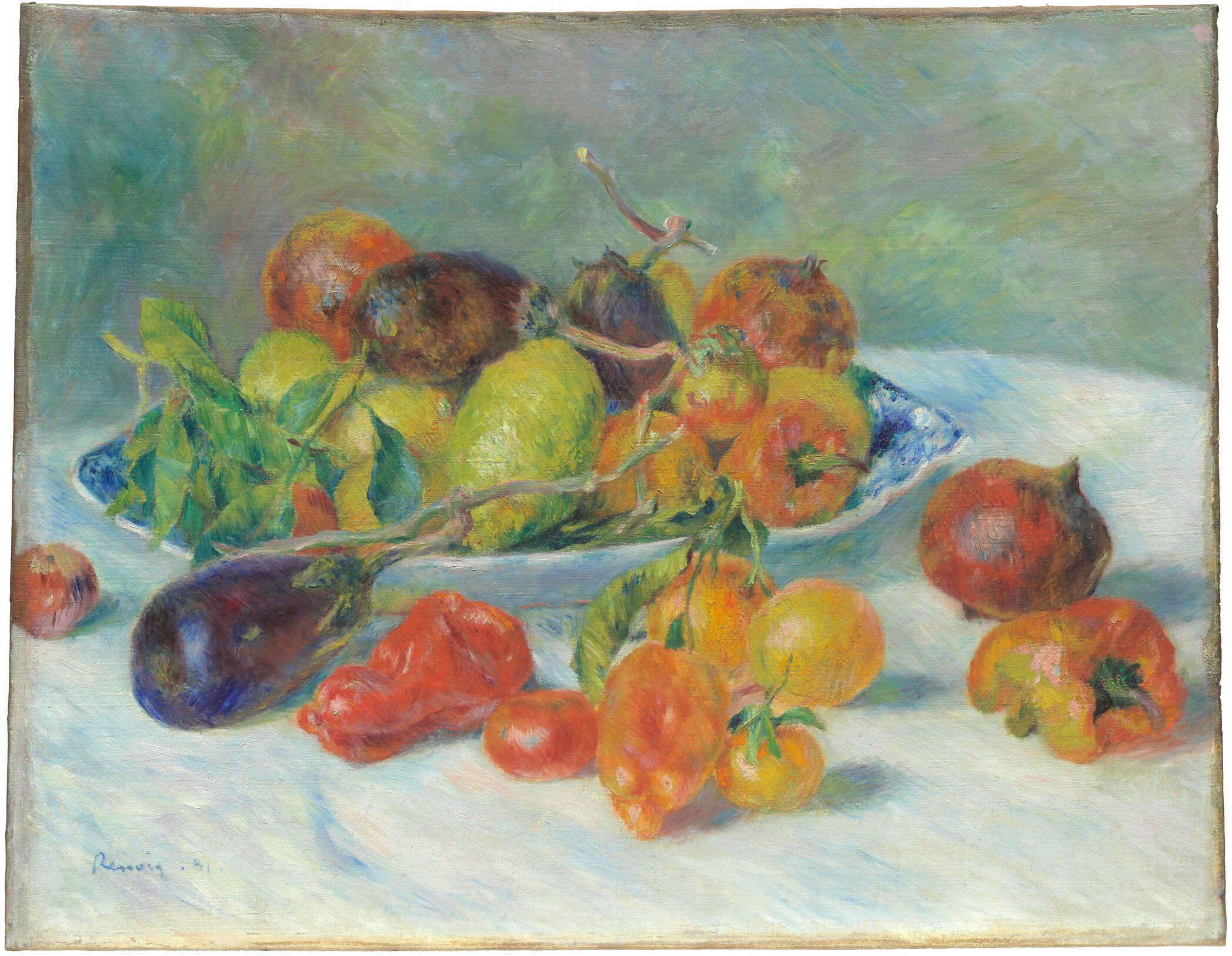
cat. 14 Fruits of the Midi, 1881.
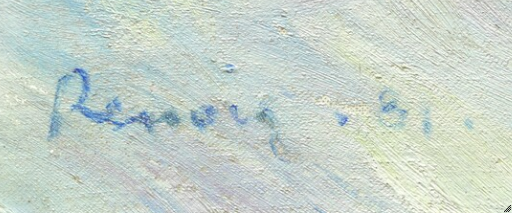
Detail of the artist’s signature in Renoir’s Fruits of the Midi (1881). The Art Institute of Chicago, 1933.1176.
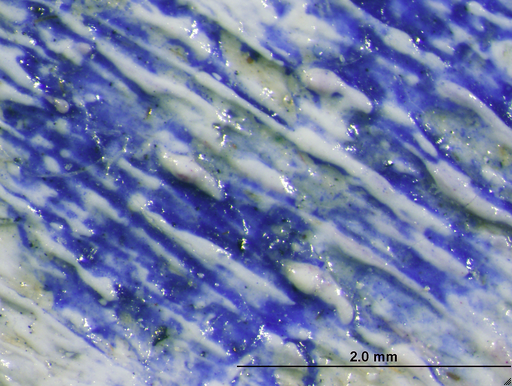
Photomicrograph of the signature in Renoir’s Fruits of the Midi (1881). The Art Institute of Chicago, 1933.1176.
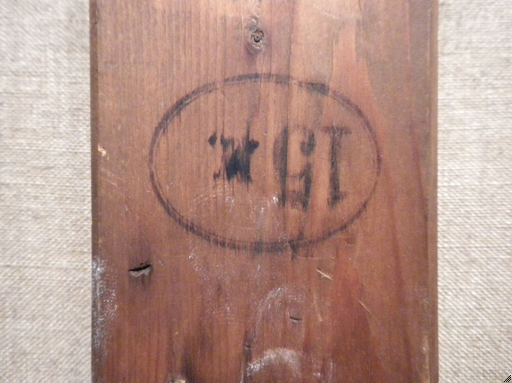
Detail of the standard size stamp on the stretcher on Renoir’s Fruits of the Midi (1881). The Art Institute of Chicago, 1933.1176.
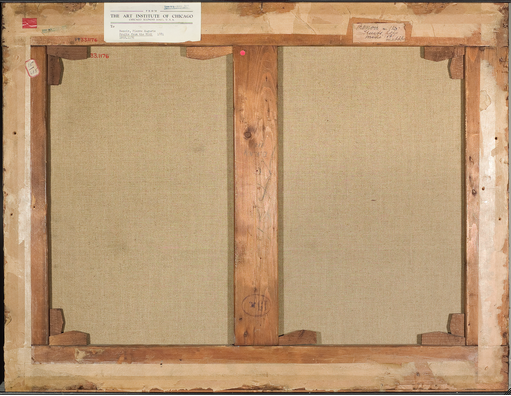
Verso image of Renoir’s Fruits of the Midi (1881). The Art Institute of Chicago, 1933.1176.
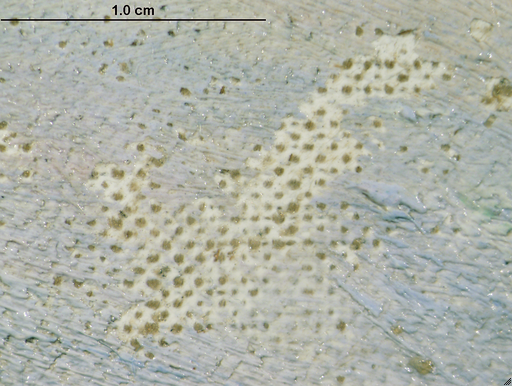
DO NOT INCLDUE
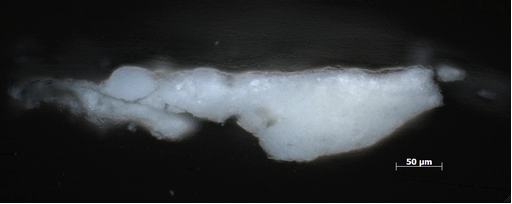
Photomicrograph of a cross section from the ground in Renoir’s Fruits of the Midi (1881). Original magnification: 200×. The Art Institute of Chicago, 1933.1176.
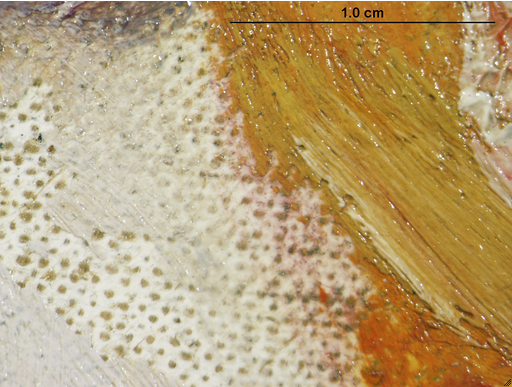
Photomicrograph of the thin, red lake underdrawing along the edge of a pepper in Renoir’s Fruits of the Midi (1881). The Art Institute of Chicago, 1933.1176.
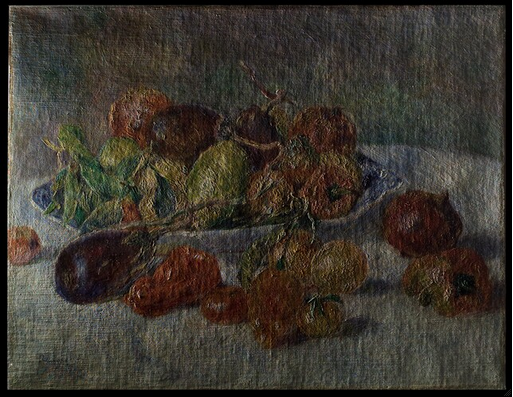
Raking-light image of Renoir’s Fruits of the Midi (1881). The Art Institute of Chicago, 1933.1176.
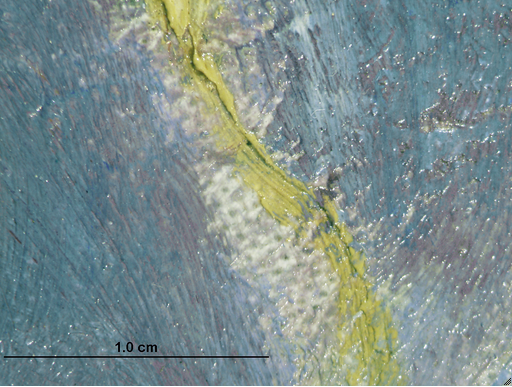
Photomicrograph of the stem, top center, in Renoir’s Fruits of the Midi (1881). The Art Institute of Chicago, 1933.1176.
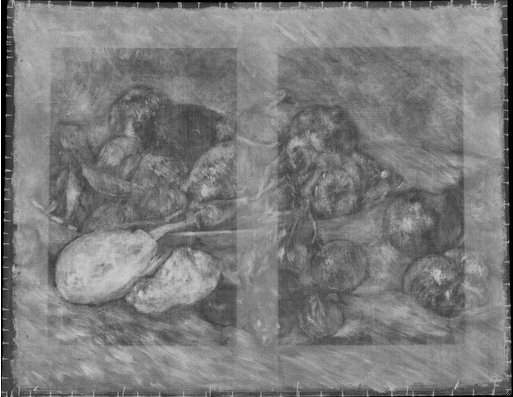
X-ray of Renoir’s Fruits of the Midi (1881). The Art Institute of Chicago, 1933.1176. X-ray digitally composited by Robert G. Erdmann, University of Arizona.
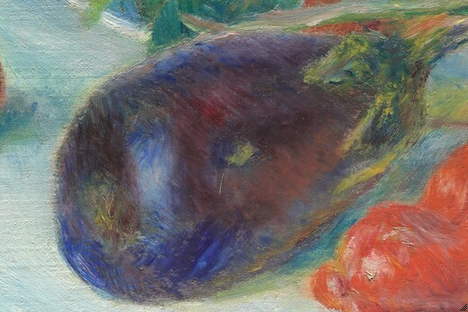
Detail of the eggplant in Renoir’s Fruits of the Midi (1881) showing the complex layering of tones. The Art Institute of Chicago, 1933.1176.
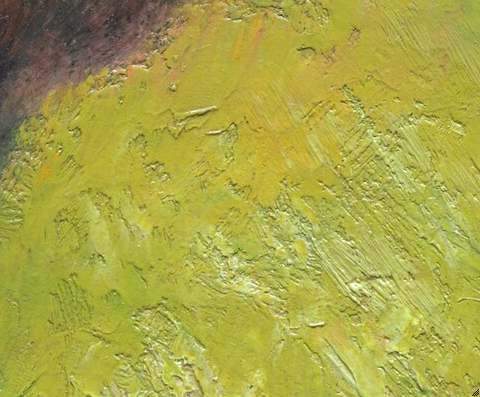
Detail of the citron in the center of Renoir’s Fruits of the Midi (1881) showing the artist’s use of a palette knife to articulate the rind. The Art Institute of Chicago, 1933.1176.
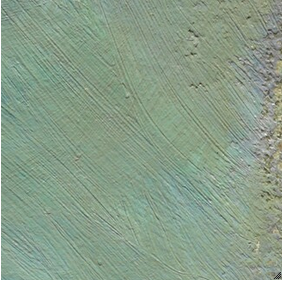
Detail of the right edge of Renoir’s Fruits of the Midi (1881) showing the earlier purple-blue background. The Art Institute of Chicago, 1933.1176.
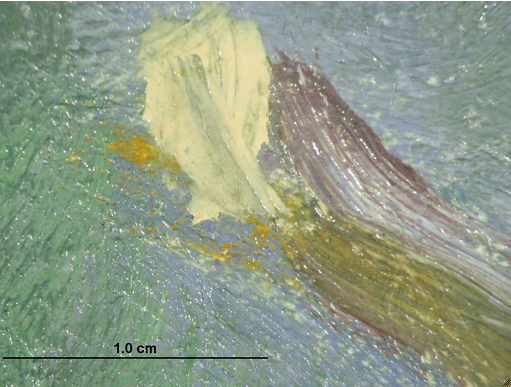
Photomicrograph of the tip of the top-pointing stem near the center in Renoir’s Fruits of the Midi (1881) showing the sequence of paint layering. The Art Institute of Chicago, 1933.1176.
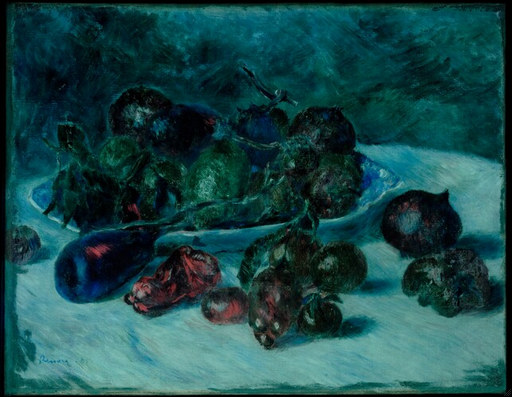
Ultraviolet image of Renoir’s Fruits of the Midi (1881). The Art Institute of Chicago, 1933.1176.
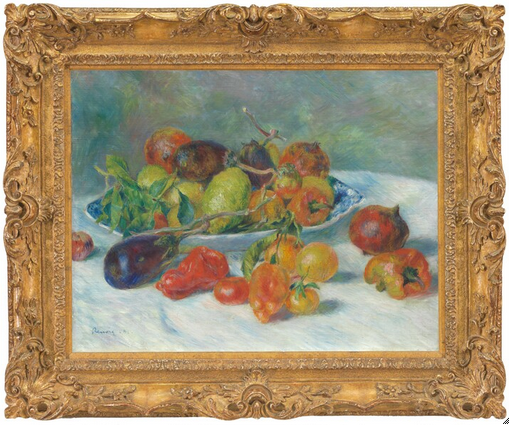
Renoir’s Fruits of the Midi (1881) in its current frame. The Art Institute of Chicago, 1933.1176.
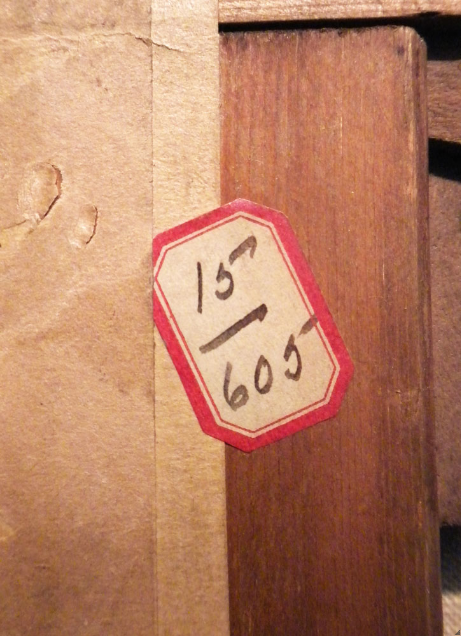
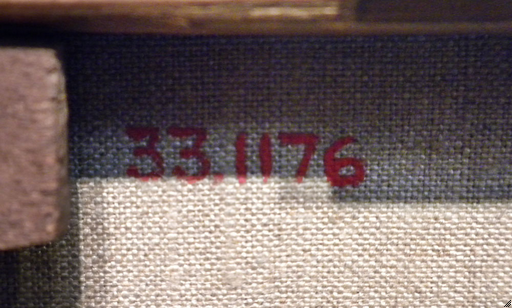
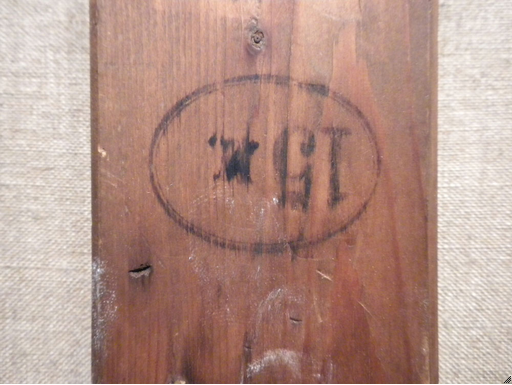
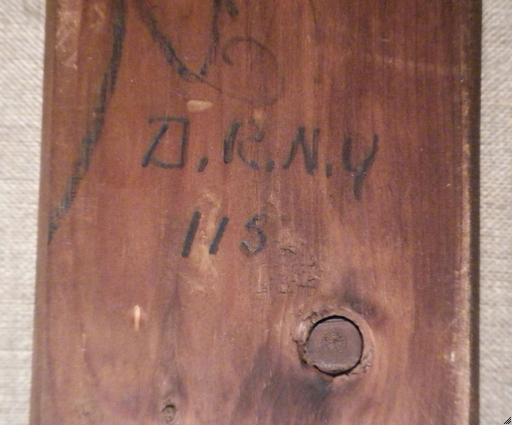
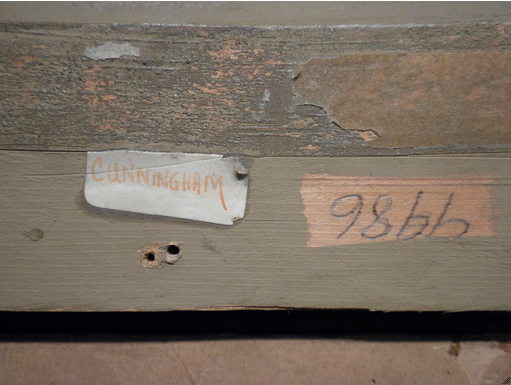
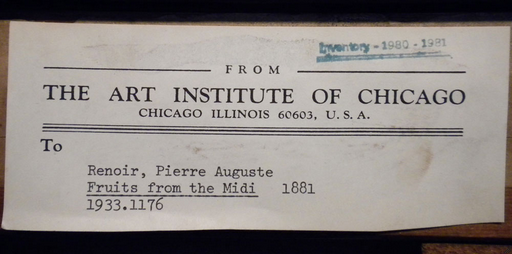
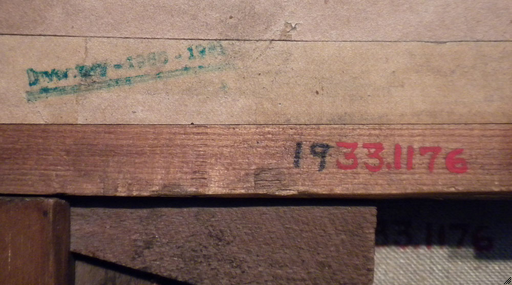
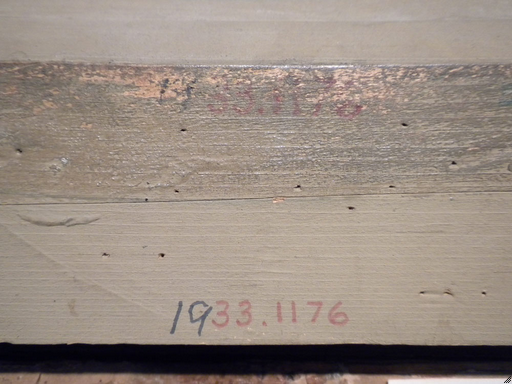
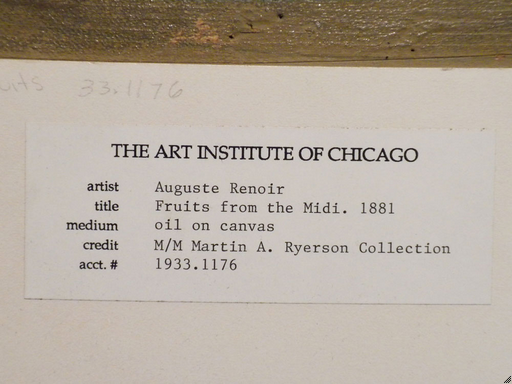
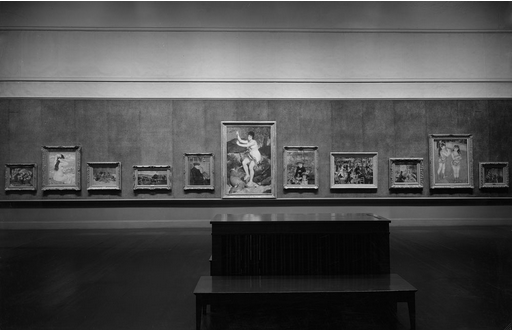
Renoir’s Fruits of the Midi (1881) in a previous frame, installed in “A Century of Progress”: Loan Exhibition of Paintings and Sculpture, Art Institute of Chicago, May 23–Nov. 1, 1933. Institutional Archives, Art Institute of Chicago.
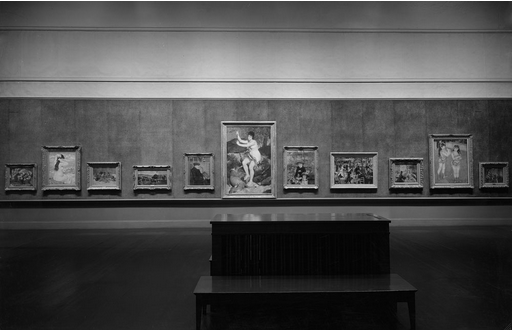
Installation of Renoir’s Fruits of the Midi (1881) in “A Century of Progress”: Loan Exhibition of Paintings and Sculpture, Art Institute of Chicago, May 23–Nov. 1, 1933. Institutional Archives, Art Institute of Chicago.
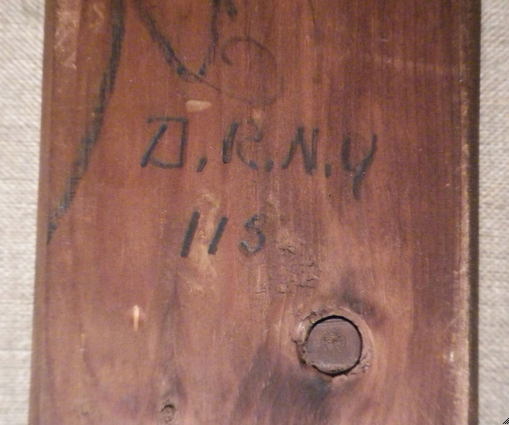
for DR provenance section
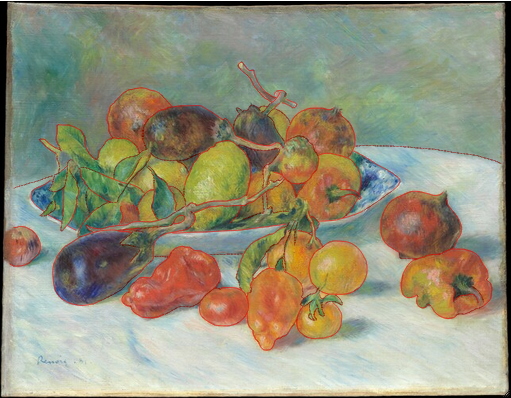
Renoir’s Fruits of the Midi (1881). The Art Institute of Chicago, 1933.1176. Interactive image.
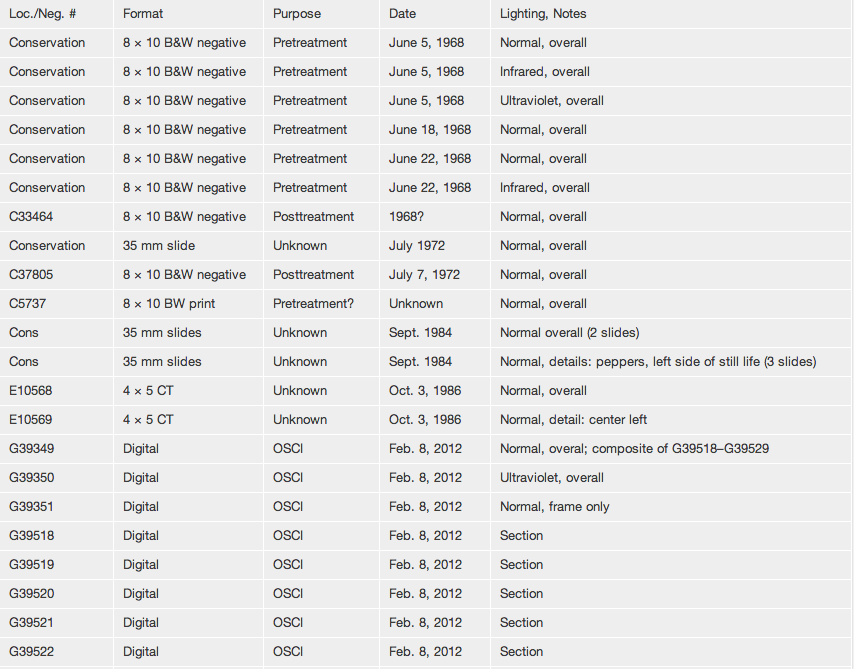
| Loc./Neg. # | Format | Purpose | Date | Lighting, Notes |
| Conservation | 8 × 10 B&W negative | Pretreatment | June 5, 1968 | Normal, overall |
| Conservation | 8 × 10 B&W negative | Pretreatment | June 5, 1968 | Infrared, overall |
| Conservation | 8 × 10 B&W negative | Pretreatment | June 5, 1968 | Ultraviolet, overall |
| Conservation | 8 × 10 B&W negative | Pretreatment | June 18, 1968 | Normal, overall |
| Conservation | 8 × 10 B&W negative | Pretreatment | June 22, 1968 | Normal, overall |
| Conservation | 8 × 10 B&W negative | Pretreatment | June 22, 1968 | Infrared, overall |
| C33464 | 8 × 10 B&W negative | Posttreatment | 1968? | Normal, overall |
| Conservation | 35 mm slide | Unknown | July 1972 | Normal, overall |
| C37805 | 8 × 10 B&W negative | Posttreatment | July 7, 1972 | Normal, overall |
| C5737 | 8 × 10 BW print | Pretreatment? | Unknown | Normal, overall |
| Cons | 35 mm slides | Unknown | Sept. 1984 | Normal overall (2 slides) |
| Cons | 35 mm slides | Unknown | Sept. 1984 | Normal, details: peppers, left side of still life (3 slides) |
| E10568 | 4 × 5 CT | Unknown | Oct. 3, 1986 | Normal, overall |
| E10569 | 4 × 5 CT | Unknown | Oct. 3, 1986 | Normal, detail: center left |
| G39349 | Digital | OSCI | Feb. 8, 2012 | Normal, overal; composite of G39518–G39529 |
| G39350 | Digital | OSCI | Feb. 8, 2012 | Ultraviolet, overall |
| G39351 | Digital | OSCI | Feb. 8, 2012 | Normal, frame only |
| G39518 | Digital | OSCI | Feb. 8, 2012 | Section |
| G39519 | Digital | OSCI | Feb. 8, 2012 | Section |
| G39520 | Digital | OSCI | Feb. 8, 2012 | Section |
| G39521 | Digital | OSCI | Feb. 8, 2012 | Section |
| G39522 | Digital | OSCI | Feb. 8, 2012 | Section |
| G39523 | Digital | OSCI | Feb. 8, 2012 | Section |
| G39524 | Digital | OSCI | Feb. 8, 2012 | Section |
| G39525 | Digital | OSCI | Feb. 8, 2012 | Section |
| G39526 | Digital | OSCI | Feb. 8, 2012 | Section |
| G39527 | Digital | OSCI | Feb. 8, 2012 | Section |
| G39528 | Digital | OSCI | Feb. 8, 2012 | Section |
| G39529 | Digital | OSCI | Feb. 8, 2012 | Section |
| Conservation | X-ray | OSCI | Feb. 16, 2010 | X-ray films scanned/digitally composited, overall |
| Conservation | Digital | OSCI | Feb. 17, 2010 | Details of verso, frame, and labels (14 total) |
| Conservation | Digital | OSCI | Feb. 17, 2010 | Normal, overall |
| Conservation | Digital | OSCI | Feb. 17, 2010 | Raking light, overall |
| Conservation | Digital | OSCI | Feb. 17, 2010 | Infrared (Fuji 1000B/2 mm filter), overall |
| Conservation | Digital | OSCI | Feb. 17, 2010 | Ultraviolet, overall |
| Conservation | Digital | OSCI | Feb. 17, 2010 | Transmitted light, overall |
| Conservation | Digital | OSCI | Feb. 17, 2010 | Transmitted infrared (Fuji 1000B/2 mm filter), overall |
| Conservation | Digital | OSCI | Feb. 17, 2010 | Macro details (7 total) |
| Conservation | Digital | OSCI | Feb. 19, 2010 | Photomicrographs of sample sites and surface (21 total) |
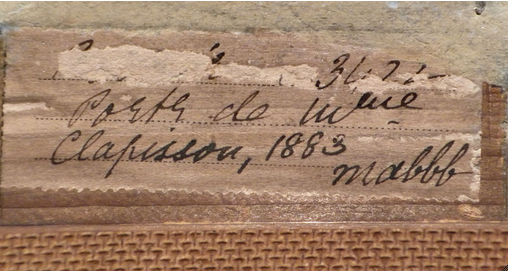
DO NOT INCLUDE -- DELETED
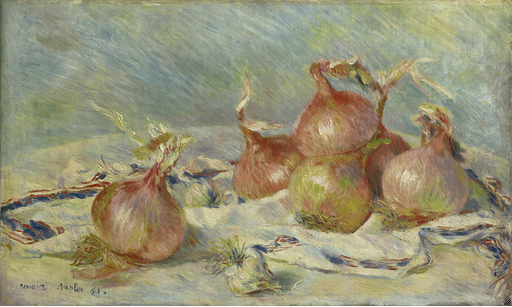
Pierre-Auguste Renoir (French, 1841–1919). Onions, 1881. Oil on canvas; 39.1 × 60.6 cm (15 3/8 × 23 7/8 in.). Sterling and Francine Clark Art Institute, Williamstown, Mass., 1955.588. Bridgeman Images.
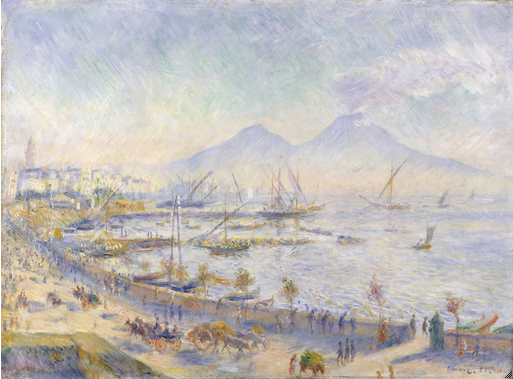
Pierre-Auguste Renoir (French, 1841–1919). The Bay of Naples, 1881. Oil on canvas; 59.7 × 81.3 cm (23 1/2 × 32 in.). The Metropolitan Museum of Art, New York, Bequest of Julia W. Emmons, 1956, 56.135.8. Image copyright © The Metropolitan Museum of Art. Image source: Art Resource, NY.
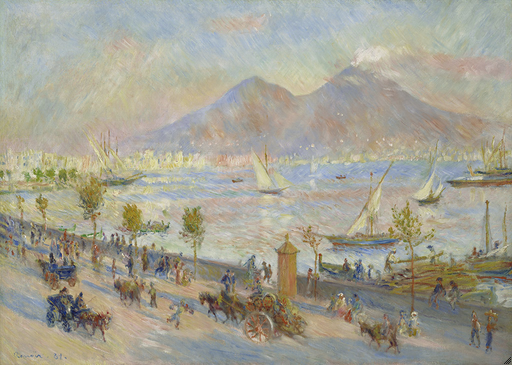
Pierre-Auguste Renoir (French, 1841–1919). Bay of Naples, Evening, 1881. Oil on canvas; 57.9 × 80.8 cm (22 13/16 × 31 13/16 in.). The Sterling and Francine Clark Art Institute, Williamstown, Mass., 1955.587. Bridgeman Images.
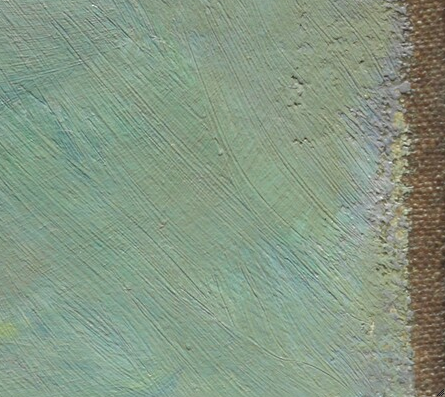
Detail of the background in Renoir’s Fruits of the Midi (1881). The original purple-blue hues are still visible amid the final yellows and greens. The Art Institute of Chicago, 1933.1176.
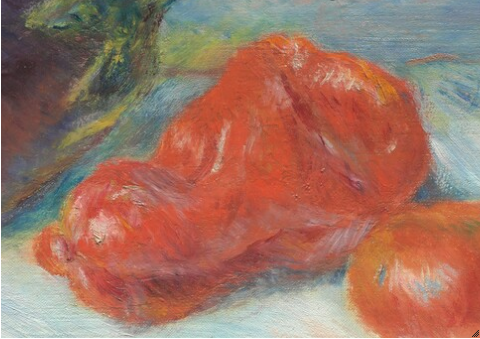
Detail of a pepper in Renoir’s Fruits of the Midi (1881) showing the careful modeling of the forms. The Art Institute of Chicago, 1933.1176

Detail of the eggplant in the foreground of Renoir’s Fruits of the Midi (1881) showing the layers of color. The Art Institute of Chicago, 1933.1176.
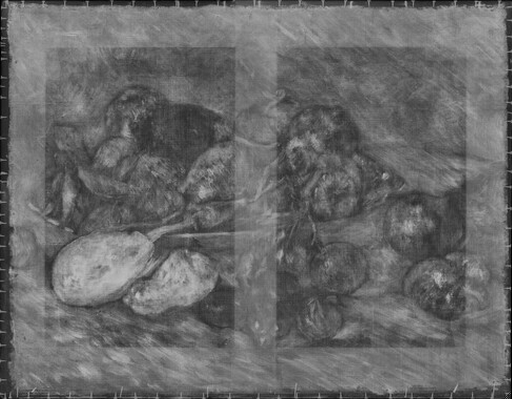
X-ray of Renoir’s Fruits of the Midi (1881). The process of painting within and around an underdrawing can cause the appearance of outlines where the paint is thinnest. The Art Institute of Chicago, 1933.1176.
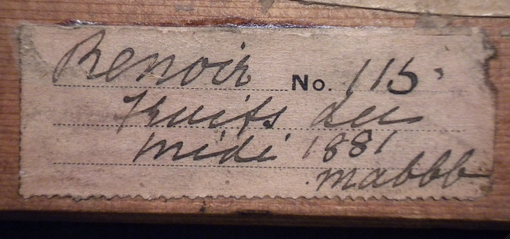
Chrysanthemums896
1881/82897
Oil on canvas; 54.8 × 65.8 cm (21 5/8 × 25 7/8 in.)
Signed: Renoir. (upper right, in dark-blue paint)
The Art Institute of Chicago, Mr. and Mrs. Martin A. Ryerson Collection, 1933.1173
In the fall of 1881 Renoir visited Italy, and the clearer structure of Chrysanthemums reveals a classicism that emerged in his style following the trip. The bouquet is simply contained in an earthenware crock with little indication of setting. The plain design of the vessel acts as a visual pause between the colorful blossoms and the life-size floral pattern of the tablecloth. The composition exhibits an emphatic geometry: the wide oval of the bouquet fills the canvas symmetrically, is reinforced by the central position of the crock, and is echoed in the curve of the table. The painting can be understood as a transitional work between the more spontaneous Impressionism of Peonies (fig. 2.58 [Dauberville 36]), circa 1880, and floral still lifes such as Bouquet of Chrysanthemums (fig. 2.19 [Dauberville 38]), assigned to 1881.898
While Renoir’s still-life work remains an under-studied aspect of his career, the sheer number of documented canvases in this genre indicates how significant a role they played in his development. The catalogue for his first retrospective exhibition, held on the boulevard de la Madeleine in April 1883, includes six still-life paintings among seventy works.899 The proportion of still-life paintings to work in other genres remained roughly the same in his retrospective exhibition organized by the art dealer Paul Durand-Ruel in 1892.900 Three of the still lifes in the 1883 exhibition were identified as specific varieties of flowers: Pivoines, no. 34 (likely Peonies, c. 1880 [Dauberville 36]); Géraniums, no. 55 (fig. 3.60 [Dauberville 35]); and Lilas, no. 64 (Lilacs, 1878 [Dauberville 32]).901 Durand-Ruel bought Chrysanthemums from Renoir in December 1882.
Chrysanthemums makes no reference to setting and may represent one of the bouquets that the artist loved to keep in his home to paint when the impulse came upon him. A light source from the left casts a blue shadow on the wall to the right. This shadow closely follows the curved line of the table suggesting it is located in a circular nook of the kind found in the entrance halls of middle class homes. The table itself is quite small relative to the vase and therefore could only be a side table. Its diameter matches almost exactly the breadth of the floral bouquet.
There is a balanced distribution of white and orange blossoms across the bouquet in Chrysanthemums, while the crock and the patterned tablecloth seem thoughtfully chosen for how they complement the composition.902 There is, however, a certain casualness about the preparation and execution of this canvas. The application of the commercial ground layer is uneven, and the palette knife used to spread it on the canvas caused lumps of already dry material to leave gouged lines in the surface (see Preparatory Layers in the technical report). A number of these are quite prominent (fig. 2.5). Renoir simply painted over them and carried on. Traces of graphite underdrawing are apparent in skips in the upper paint layers. While thin curved lines of brown underdrawing, executed directly on top of the ground, are visible in many areas; the brown lines vaguely outline the form of short, curved petals (fig. 2.8). The underdrawing is selective and Renoir’s rendering of individual blossoms appears intended to rehearse their linear rhythm and assess relative proportions directly on canvas.
As Chrysanthemums attests, Renoir’s interest in the flower as an artistic subject can be dated to at least the early 1880s.903 He may have had the opportunity to admire paintings of the flower by Claude Monet made in 1878 and 1881.904 A bouquet of chrysanthemum blossoms provides an extraordinarily ebullient setting for Renoir’s painting of the red-haired model Jeanne Samary, A Girl with a Fan, circa 1881 (fig. 2.9 [Daulte 360; Dauberville 344]).905 In this case the flowers complement the taste for Japonisme suggested by the fan in Samary’s hand.
First imported to France from the Far East during the French Revolution, chrysanthemums are a late summer flower appreciated for their strong scent and exceptional range of color and shape.906 Referenced in Marcel Proust’s À la recherche du temps perdu (Remembrance of Things Past), in the early twentieth century they were still considered an exotic Japanese feature of French gardens.907 Notably, Renoir’s Chrysanthemums includes two blossom varieties, each with different color and petal shape—the orange starburst variety with a long, straight petal and the white blossom variety with a shorter, denser petal that gives it a spherical appearance. This mixture of blossom varieties is a feature of the celebrated Japanese woodblock print by Hokusai, Chrysanthemums and Bee (fig. 2.10) and further adds to the Japonisme of Renoir’s painting.908 In Hokusai’s print the distinctive flat leaf of the chrysanthemum provides visual contrast with the intricate blossoms. The leaf plays an analogous role in Renoir’s Chrysanthemums, which takes full advantage of the color and textural potential of the celebrated flower to produce a still-life painting of sublime authority.
While his floral still lifes remained popular with collectors, commercial concerns were not Renoir’s only motivation for painting them. Sympathetic critics recognized that his floral still lifes embodied a truly progressive approach to painting. As Renoir’s German biographer, Julius Meier-Graefe, wrote in 1912, Renoir’s flower paintings were like fictions of color that possessed an “immaterial completeness” quite independent from reality.909 Such an expressive freedom is amply demonstrated in the brushwork of the bouquet in Chrysanthemums, which is feathery and gestural. Another of his biographers, Georges Rivière, a close friend from the early 1870s, recorded the artist’s explanation for why floral still lifes afforded the opportunity for risk-taking: “Painting flowers is a form of mental relaxation. I do not need the concentration that I need when I am faced with a model. When I am painting flowers I can experiment boldly with tones and values without worrying about destroying the whole painting. I would not dare to do that with a figure because I would be afraid of spoiling everything. The experience I gain from these experiments can then be applied to my painting.”910
Indeed, a bold experimental approach to floral still-life painting can be seen throughout Chrysanthemums, in the chromatic links that unify the composition and establish a tonal theme. Red, orange, and yellow predominate, with white, blue, and green acting as counterbalance. The intermingling of orange and white blossoms across the bouquet makes the unusual choice of a russet tone for the background less unsettling. Renoir draws upon the ability of the eye to mix colors near one another. Yellow is used for the blossoms, areas of dappled sunlight on the tablecloth, and to brighten the part of the vase facing the light source. Red is used for the background as well as to highlight the radiating line of petals in the yellow blossoms to give them an orange appearance (fig. 2.11). The blues of the tablecloth also appear in the deeper shadows of the bouquet as well as defining the petals of the white blossoms. Julie Manet, the daughter of Impressionist painter Berthe Morisot, who was under the guardianship of Renoir and Edgar Degas after her mother died in 1895, wrote in her diary, “M. Renoir said that one should paint still lifes in order to learn to paint quickly.”911 If speed was a concern for the artist in painting Chrysanthemums, it was also an opportunity to demonstrate his consummate skill as a colorist.
John Collins
This painting is executed on a very rough, unevenly applied preparation layer on a standard-size [glossary:canvas]. The presence of a color merchant’s stamp and standard-size number on the verso of the support may indicate that the canvas was stretched by the [glossary:color merchant], but it is unclear who applied the preparation.912 The [glossary:ground] layer covers the compositional area only and appears very uneven in the [glossary:X-ray] and along the edges. It contains many particulates, probably clumps of dried preparation that were dragged across the surface during application with a [glossary:palette knife], resulting in large gouges; these characteristics may logically point to artist application. However, the composition of the ground, containing a moderate amount of calcium-based extenders, and the presence of the stamps on the verso argue strongly for a color merchant’s preparation. Immediately on top of the ground, Renoir drew some compositional elements in a few different types of media, including individual bloomed chrysanthemums in very fine graphite lines, curving petals of other flowers in dilute brown paint, and possibly the outline of the earthenware crock as a first step of the painting process. The artist did not follow the drawing exactly, but the forms and placement are consistent. In one white flower (above center), the brown [glossary:underdrawing] lines were left exposed on white ground and articulate individual petals. It also appears that the artist painted areas of the background before finishing the flowers, bringing in additional background colors to immediately surround the petals and adding final touches to the flowers over that background at a later stage. In other areas, the background seems to have overlapped white flowers and the artist wiped these colors away, leaving a thin shadowy film in the depressions of the canvas. Edges between major still-life elements, such as the table and pitcher/vase, were blended with the background, and paint was often applied [glossary:wet-in-wet] and mixed on the surface. The work is currently varnished, however it is unclear whether the artist would have varnished this painting.
The multilayer interactive image viewer is designed to facilitate the viewer’s exploration and comparison of the technical images (fig. 2.52).913
Signed: Renoir. (upper right, in dark blue paint) (fig. 1.2, fig. 1.1).914
Flax (commonly known as linen).915
The original dimensions of the canvas were 54.5 × 65.2 cm, according to pretreatment measurements. This corresponds to a no. 15 portrait ([glossary:figure]) standard-size (65 × 54 cm) canvas, turned horizontally.916 The size 15 stamp visible in transmitted infrared is now behind the right side of the painting (fig. 2.6).
[glossary:Plain weave]. Average [glossary:thread count] (standard deviation): 29.7V (0.7) × 27.3H (0.9) threads/cm. The vertical threads were determined to correspond to the [glossary:warp] and the horizontal threads to the [glossary:weft].917
There is strong [glossary:cusping] on all four sides corresponding to original tack placement. Along with the presence of [glossary:priming] only in the compositional area, the strength of this cusping suggests the canvas was stretched before it was prepared.
Current stretching: The canvas was lined and restretched in 1972 (see Conservation History), and the dimensions were increased slightly on all sides.
Original stretching: Based on cusping visible in the X-ray, the original tacks were placed 3–3.5 cm apart.
Current stretcher: Four-member redwood [glossary:ICA spring stretcher]. Depth: 2.7 cm
Original stretcher: Description, construction and labels taken from the previous [glossary:stretcher] suggest it was original. It was a four-member, keyable, mortise-and-tenon stretcher. Depth: Approximately 1.8 cm.918
Stamp
Location: canvas verso (covered by lining)
Method: stamp/stencil
Content: [. . .] FINES [. . .] / TABLEAUX / REY [A] PERROD / [51] Rue de la Rochefoucau[ld] / PARIS (fig. 1.3)919
Stamp
Location: canvas verso (covered by lining)
Method: stamp/stencil
Content: 15 (fig. 2.20)
Not determined (probably glue).920
The ground is applied rather unevenly to the compositional area only; it is a single layer ranging approximately 60–220 µm in thickness. The uneven coverage and lack of priming on the [glossary:tacking margins] would tend to suggest an artist-application, however analytical evidence suggests the ground was applied by the color merchant.921 The nature of the rough edges around the perimeter, abrupt changes in density seen in the X-ray, and various scrape marks on the surface suggest application with a palette knife (fig. 2.22); in some areas, the initial working in with the palette knife was followed by a brush to smooth the texture and extend the priming farther toward the edges (fig. 2.23). The ground itself is granular in nature, with large, chunky white inclusions (fig. 2.24) dragged across the surface during preparation, resulting in curvilinear gouges throughout (fig. 2.25). In some areas, the X-ray indicates that these particles remain in the paint film and appear as radio-opaque spots at the ends of individual gouges. The thickness of the ground varies throughout: in some areas, it was so heavily pressed into the canvas with the palette knife that the tops of the canvas threads are exposed (fig. 2.26).
[glossary:Stereomicroscopic examination] of the surface and [glossary:cross sections] confirms that the ground is white, with no additional or colored particles visible (fig. 2.27).
The ground is predominantly lead white with moderate amounts of calcium carbonate (probably chalk), and traces of alumina and complex silicates (clays).922 The [glossary:binder] is estimated to be [glossary:oil].923
Microscopic and infrared examinations indicate that the artist drew a number of the individual chrysanthemums and other flowers.924 Examination of the work in transmitted light shows that he outlined the earthenware crock, but it is unclear whether this was a separate step in compositional planning or the beginning of the painting stage (fig. 2.28).
Some of the individual yellow chrysanthemums with long, tapering petals are articulated with very fine [glossary:graphite] lines (fig. 2.29). Elsewhere the artist used graphite and thin brown paint to establish the curving edges of at least one white flower (above center) (fig. 2.30). Transmitted light indicates that Renoir also painted the outline of the crock prior to painting the full composition. However, the upper paint layers have obscured the color and texture of these lines.
While Renoir did not follow the fine graphite lines exactly, the individual petals are quite close to the original drawing (fig. 2.57). In some areas, the brown underdrawing lines were left exposed against the white ground, and it is unclear whether they were used regularly throughout. The artist followed the initial outline of the vase/pitcher in the final composition, smoothing the transition between the object and the background as he painted.
It appears that the artist established, through various methods of underdrawing, the space for the still-life elements before painting them. The artist painted the background with stiff-bristle brushes and dilute paint (fig. 2.32), leaving a roughly ovular space for the flowers. He brought in the remaining background with finer strokes to meet the still life once these elements were painted; in these areas the background has a somewhat mottled appearance. In some areas, the ground was left exposed to serve as the white body of the flowers, and thin background paint was wiped away from the edges in some areas while it was still wet. This process left a thin film that settled into the depressions of the canvas weave and the gritty, gouged texture of the preparation, visually functioning as shadow (fig. 2.33). Over this, additional paint, colors, and white [glossary:impasto] were added, sometimes wet-in-wet with the background or while the background was not quite dry. In some areas, like the left side of the tablecloth, the artist added paint to the object edge when he brought the background in to create a soft, blended transition.
The paint throughout varies from very thin areas of the background and initial indications of the flowers to heavy impasto in the final stages (fig. 2.34). Individual colors were applied wet-in-wet over their surroundings, using fine brushes to create visually complicated and finely articulated flower petals (fig. 2.35).
Mostly fine, soft brushes for the individual flower petals and wider, stiff-bristle brushes for the background with strokes up to 1 cm wide; palette knife for ground application.
Analysis indicates the presence of the following [glossary:pigments]:925 lead white, cobalt blue, malachite, viridian, black, iron oxide red and/or yellow, vermilion, carmine lake, second red lake, zinc yellow, cadmium yellow and Naples yellow926
[glossary:UV] examination indicates that Renoir used salmon-fluorescing red lake throughout the chrysanthemums and other flowers and in broad areas of the background (fig. 2.36).927 [glossary:Cross-sectional analysis] of a sample taken from the background indicates the artist also used a second, non fluorescing red lake. As the sample analyzed contained both red lakes, it is unclear whether carmine lake is the fluorescing or non fluorescing variety (fig. 2.37).928
Oil (estimated).929
The painting has a [glossary:synthetic varnish], applied in 1972, with residues of natural resin in areas of impasto. Treatment notes from 1972 mention removal of [glossary:overpaint] and a discolored [glossary:natural-resin varnish] (see Conservation History). It is unclear if this [glossary:varnish] was original.
The first documented treatment occurred in 1972.930 At that time, the painting was described as stretched on a four-member stretcher with a [glossary:hardboard] insert between the painting and the stretcher. Pretreatment conditions also included abrasion, shrinkage cracks, and minor losses with overpaint to hide these damages. The presence of the hardboard and overpaint suggest the painting had been treated in the past. During the 1972 treatment, grime, varnish, and the hardboard mounting were removed, and the work was faced with mulberry fiber paper and starch paste in preparation for [glossary:lining]. The old six-member stretcher was discarded when the work was wax-resin lined, and the lined painting was tacked onto a four-member redwood ICA spring stretcher of slightly larger dimensions (21 1/2 × 25 3/4 in.).931 The work was inpainted with methacrylate paints and given three coats of synthetic varnish (an isolating layer of polyvinyl acetate [PVA] AYAA, followed by methacrylate resin L-46, and a final coat of AYAA).
Widespread cracking, with some associated tenting, appears to come from the ground, rather than from interlayer [glossary:cleavage] between the ground and the paint. There are minimal localized losses in areas where cracks intersect; most have been filled and inpainted. The lining is in good condition, keeping the work relatively planar and with no delamination. The wax-resin lining material has saturated the support, making the canvas appear very dark; however, the thickness of the ground and subsequent paint layers make this affect less apparent in the compositional area. The rough perimeter, resulting from uneven preparation, has been heavily retouched in an attempt to “square” the composition and compensate for the extended dimensions resulting from the 1972 treatment. The work has a glossy synthetic varnish.
Kelly Keegan
The current frame appears to be original to the painting.932 It is a French (Paris), late-nineteenth-century, Durand-Ruel, Régence Revival, gilt ogee frame with cast foliate ornament, center and corner cartouches, and a gilt fillet liner. The frame has water and oil gilding over bole on cast plaster and gesso. The bole color is varied throughout the frame. There is red-orange bole on the sanded frieze and fillets, and red bole on the perimeter molding, sight molding, liner, and scotia sides on the ogee face. The scotia sides and liner are burnished, and the cast foliate ornament and sight molding are selectively burnished. The quadrillage bed on the ogee face has been rubbed selectively to expose the underlying plaster. The gilding is toned with a casein or gouache raw umber [glossary:wash] and gray overwash. The frame has a glued pine substrate with a cast plaster face. At some point in the frame’s history, the original verso was planed flat, removing all construction history and provenance, a back frame was added, and all back and interior surfaces were painted. The molding, from the perimeter to the interior, is fillet with stylized dovetail-pierced egg-and-flower outer molding; scotia side; ogee face with cast foliate and flower ornament on a quadrillage bed, and center and corner foliate scroll cartouches with cabochon centers on a diamond bed; sanded front frieze bordered with fillets; ogee with stylized leaf-tip-and-shell sight molding; and an independent flat fillet liner with cove sight edge (fig. 2.53).
Kirk Vuillemot
Sold by the artist to Durand-Ruel, Paris, Dec. 14, 1882, for 600 francs.933
Transferred by Durand-Ruel, Paris, to Durand-Ruel, New York, 1897.934
Sold by Durand-Ruel, New York, to Martin A. Ryerson, Chicago, Feb. 17, 1915, for $7,500.935
Bequeathed by Martin A. Ryerson (died 1932), to the Art Institute of Chicago, 1933.
Possibly Paris, Grand Palais, Salon d’automne, Oct. 15–Nov. 15, 1904, cat. 30, as Chrysanthèmes.
Possibly New York, Durand-Ruel, Exhibition of Paintings by Pierre Auguste Renoir, Nov. 14–Dec. 5, 1908, cat. 12, as Chrysanthèmes, 1882.936
New York, Durand-Ruel, Exhibition of Paintings by Renoir, Feb. 7–21, 1914, cat. 1.937
Art Institute of Chicago, “A Century of Progress”: Loan Exhibition of Paintings and Sculpture, May 23–Nov. 1, 1933, cat. 340.938 (fig. 2.55)
Art Institute of Chicago, “A Century of Progress” Loan Exhibition of Paintings and Sculpture for 1934, June 1–Oct. 31, 1934, cat. 228.939
Art Institute of Chicago, Paintings by Renoir, Feb. 3–Apr. 1, 1973, cat. 39 (ill.).
Pasadena, Calif., Norton Simon Museum of Art, Jan. 27–Oct. 31, 1978, no cat.940
Tokyo, Isetan Museum of Art, Exposition Renoir, Sept. 26–Nov. 6, 1979, cat. 33 (ill.); Kyoto Municipal Museum, Nov. 10–Dec. 9, 1979.
Albi, Musée Toulouse-Lautrec, Trésors impressionnistes du Musée de Chicago, June 27–Aug. 31, 1980, cat. 22 (ill.).
Santa Barbara (Calif.) Museum of Art, Sept. 13, 1984–June 7, 1985, no cat.941
Tokyo, Seibu Museum of Art, Shikago bijutsukan insho-ha ten [The Impressionist tradition: Masterpieces from the Art Institute of Chicago], Oct. 18–Dec. 17, 1985, cat. 38 (ill.); Fukuoka Art Museum, Jan. 5–Feb. 2, 1986; Kyoto Municipal Museum of Art, Mar. 4–Apr. 13, 1986.
Art Institute of Chicago, Chicago’s Dream, a World’s Treasure: The Art Institute of Chicago, 1893–1993, Nov. 1, 1993–Jan. 9, 1994, not in cat.942
Fort Worth, Tex., Kimbell Art Museum, The Impressionists: Master Paintings from the Art Institute of Chicago, June 29–Nov. 2, 2008, cat. 35 (ill.).
Possibly Société du Salon d’Automne, Catalogue de peinture, dessin, sculpture, gravure, architecture et arts décoratifs, exh. cat. (Hérissey, 1904), p. 115, cat. 30.
Possibly Durand-Ruel, New York, Exhibition of Paintings by Pierre Auguste Renoir, exh. cat. (Durand-Ruel, New York, 1908), no. 12.943
Art Institute of Chicago, A Guide to the Paintings in the Permanent Collection (Art Institute of Chicago, 1925), p. 162, cat. 2154.944
M. C., “Renoirs in the Institute (Continued),” Bulletin of the Art Institute of Chicago 19, 4 (Apr. 1925), pp. 47, 48 (ill.).
Daniel Catton Rich, “Französische Impressionisten im Art Institute zu Chicago,” Pantheon: Monatsschrift für Freunde und Sammler der Kunst 11, 3 (Mar. 1933), p. 78. Translated by C. C. H. Drechsel as “French Impressionists in the Art Institute of Chicago,” Pantheon/Cicerone (Mar. 1933), p. 18.
Art Institute of Chicago, Catalogue of “A Century of Progress”: Exhibition of Paintings and Sculpture; Lent from American Collections, ed. Daniel Catton Rich, exh. cat. (Art Institute of Chicago, 1933), p. 49, cat. 340.
Art Institute of Chicago, Catalogue of “A Century of Progress”: Exhibition of Paintings and Sculpture, 1934, ed. Daniel Catton Rich, exh. cat. (Art Institute of Chicago, 1934), p. 39, cat. 228.
Art Institute of Chicago, An Illustrated Guide to the Collections of the Art Institute of Chicago (Art Institute of Chicago, 1945), p. 36.945
Art Institute of Chicago, Paintings in the Art Institute of Chicago: A Catalogue of the Picture Collection (Art Institute of Chicago, 1961), p. 397.946
Charles C. Cunningham and Satoshi Takahashi, Shikago bijutsukan [Art Institute of Chicago], Museums of the World 32 (Kodansha, 1970), pp. 130, pl. 118; 177.
Elda Fezzi, L’opera completa di Renoir: Nel periodo impressionista, 1869–1883, Classici dell’arte 59 (Rizzoli, 1972), p. 111; 112, cat. 505 (ill.).947
Art Institute of Chicago, Paintings by Renoir, exh. cat. (Art Institute of Chicago, 1973), pp. 74; 106–07, cat. 39 (ill.); 126; 210; 211; 214.
Isetan Museum of Art and Kyoto Municipal Museum, Exposition Renoir, exh. cat. (Isetan Museum of Art/Kyoto Municipal Museum/Yomiuri Shimbun Sha, 1979), cat. 33 (ill.).
Musée Toulouse-Lautrec and Art Institute of Chicago, Trésors impressionnistes du Musée de Chicago, exh. cat. (Musée Toulouse-Lautrec, 1980), pp. 40, no. 22 (ill.); 68.
Art Institute of Chicago, Seibu Museum of Art, Kyoto Municipal Museum of Art, and Fukuoka Art Museum, Shikago bijutsukan insho-ha ten [The Impressionist tradition: Masterpieces from the Art Institute of Chicago], trans. Akihiko Inoue, Hideo Namba, Heisaku Harada, and Yoko Maeda, exh. cat. (Nihon Nippon Television Network, 1985), pp. 84, cat. 38 (ill.); 85 (detail); 148 (ill.).
Nagoya City Art Museum, Renoir Retrospective, exh. cat. (Nagoya City Art Museum/Chunichi Shimbun, 1988), pp. 72, 239.
Gerhard Gruitrooy, Renoir: A Master of Impressionism (Todtri, 1994), p. 52 (ill.).
Douglas W. Druick, Renoir, Artists in Focus (Art Institute of Chicago/Abrams, 1997), pp. 56–57; 63 (detail); 95, pl. 14; 110.
M. Therese Southgate, “The Cover,” JAMA: The Journal of the American Medical Association 281, 7 (Feb. 17, 1999), cover (ill.); p. 591 (ill.).
Art Institute of Chicago, Impressionism and Post-Impressionism in the Art Institute of Chicago, selected by James N. Wood (Art Institute of Chicago/Hudson Hills, 2000), p. 76 (ill.).
Aviva Burnstock, Klaas Jan van den Berg, and John House, “Painting Techniques of Pierre-Auguste Renoir: 1868–1919,” Art Matters: Netherlandish Technical Studies in Art 3 (2005), pp. 52, 54.
Flavie Durand-Ruel, “Pierre-Auguste Renoir (1841–1919) et Paul Durand-Ruel (1831–1922), son ami et marchand,” Renoir et les familiers des Collettes, exh. cat. (Trulli, 2008), p. 89 (ill.).
Galeries Nationales, Grand Palais, Los Angeles County Museum of Art, and Philadelphia Museum of Art, Renoir au XXe siècle, exh. cat. (Réunion des Musées Nationaux/Musée d’Orsay, 2009), p. 103 (ill.).
Los Angeles County Museum of Art and Philadelphia Museum of Art, Renoir in the Twentieth Century, exh. cat. (Los Angeles County Museum of Art/Philadelphia Museum of Art/Hatje Cantz, 2010), p. 103 (ill.).
Gloria Groom and Douglas Druick, with the assistance of Dorota Chudzicka and Jill Shaw, The Impressionists: Master Paintings from the Art Institute of Chicago, exh. cat. (Art Institute of Chicago/Kimbell Art Museum, 2008), p. 83, cat. 35 (ill.). Simultaneously published as Gloria Groom and Douglas Druick, with the assistance of Dorota Chudzicka and Jill Shaw, The Age of Impressionism at the Art Institute of Chicago (Art Institute of Chicago/Yale University Press, 2008), p. 83, cat. 35 (ill.).948
Guy-Patrice Dauberville and Michel Dauberville, Renoir: Catalogue raisonné des tableaux, pastels, dessins et aquarelles, vol. 2, 1882–1894 (Bernheim-Jeune, 2009), p. 15, cat. 701 (ill.).
Sylvie Patin, “De la nature morte au paysage,” in Réunion des Musées Nationaux, Claude Monet, 1840–1926, exh. cat. (Réunion des Musées Nationaux/Musée d’Orsay, 2010), p. 223.
Colin B. Bailey, Renoir, Impressionism, and Full-Length Painting, exh. cat. (Frick Collection/Yale University Press, 2012), p. 103, fig. 19.
Inventory number
Stock Durand-Ruel, Paris, 2650, Paris stock années 1880/84949
Inventory number
Stock Durand-Ruel, Paris, 1787950
Inventory number
Stock Durand-Ruel, New York, 1721951
Photograph number
Photo Durand-Ruel New York A 652952
Label (New York stock no. 1721) (fig. 2.40)953
Label (no. A652) (fig. 2.41)954
Letter
E. C. Holston to Martin A. Ryerson, dated Chicago 11 [sic], 1915956
Letter
Joseph Durand-Ruel, Durand-Ruel, New York, to Georges Durand-Ruel, Durand-Ruel, Paris, Feb. 16, 1915957
Label
Location: frame
Method: handwritten script (faded) on white label
Content: . . . [. . .] 4 . . . 123 (fig. 2.38)
Inscription
Location: frame
Method: handwritten script (graphite)
Content: 33.1173 (fig. 2.39)
Label
Location: previous stretcher (discarded); preserved in conservation file
Method: handwritten script on brown label
Content: Renoir No. 1721 / Chrysanthèmes / 1882 ebbb (fig. 2.17)
Label
Location: previous stretcher (discarded); preserved in conservation file
Method: handwritten script (graphite) on white and gold label
Content: a652 (fig. 2.18)
Label
Location: previous stretcher (discarded); preserved in conservation file
Method: stamped (?) number on craft paper label
Content: 2,650 (fig. 2.42)
Stamp
Location: canvas verso (covered by lining); preserved as a tracing in conservation file
Method: stamp/stencil
Content: [. . .] FINES [. . .] / TABLEAUX / REY [A] PERROD / [51] Rue de la Rochefoucau[ld] / PARIS (fig. 2.43)958
Stamp
Location: canvas verso (covered by lining)
Method: stamp/stencil
Content: 15 (fig. 2.49)
Label
Location: stretcher
Method: handwritten script and blue stamp on printed white label
Content: FROM / [TH]E ART INSTITUTE OF CHICAGO / CHICAGO ILLINOIS 60603, U. S. A. / Renoir, Pierre / Chrysanthemums / 1933.1173 / [right side, blue stamp] Inventory—1980–1981 (fig. 2.50)
Stamp
Location: stretcher
Method: blue stamp (partially removed)
Content: [Inventory]—1980–1981 (fig. 2.51)
Label
Location: [glossary:backing board]
Method: printed label
Content: THE ART INSTITUTE OF CHICAGO / ARTIST: Pierre Auguste Renoir / TITLE: Chrysanthemums (1881–82) / MEDIUM: Oil on canvas / CREDIT: Mr. and Mrs. Martin A. Ryerson Coll. / ACC#: 1933.1173 (fig. 2.48)
Westinghouse X-ray unit, scanned on Epson Expressions 10000XL flatbed scanner. Scans were digitally composited by Robert G. Erdmann, University of Arizona.
Inframetrics Infracam with 1.5–1.73 µm filter; Fujifilm S5 Pro with X-Nite 1000B/2 mm filter (1.0–1.1 µm); Goodrich/Sensors Unlimited SU640SDV-1.7RT with H filter (1.1–1.4 µm) and J filter (1.5–1.7 µm).
Fujifilm S5 Pro with X-Nite 1000B/2 mm filter (1.0–1.1 µm).
Natural-light, raking-light, and [glossary:transmitted-light] overalls and macrophotography: Fujifilm S5 Pro with X-NiteCC1 filter.
Fujifilm S5 Pro with X-NiteCC1 filter and Kodak Wratten 2E filter.
Sinar P3 camera with Sinarback eVolution 75 H (Kodak Wratten 2E filter, PECA 918 UV/IR interference cut filter).
Sample and [glossary:cross-sectional analysis] were performed using a Zeiss Axioplan2 research microscope equipped with reflected light/[glossary:UV fluorescence] and a Zeiss AxioCam MRc5 digital camera. Types of illumination used: [glossary:darkfield], brightfield, differential interference contrast ([glossary:DIC]), and UV. In situ photomicrographs were taken with a Wild Heerbrugg M7A StereoZoom microscope fitted with an Olympus DP71 microscope digital camera.
Several spots on the painting were analyzed in situ with a Bruker/Keymaster TRACeR III-V with rhodium tube.
Zeiss Universal research microscope.
Cross sections were analyzed after carbon coating with a Hitachi S-3400N-II VPSEM with an Oxford EDS and a Hitachi solid-state [glossary:BSE] detector. Analysis was performed at the Northwestern University Atomic and Nanoscale Characterization Experimental (NUANCE) Center, Electron Probe Instrumentation Center (EPIC) facility.
A Jobin Yvon Horiba LabRAM 300 confocal Raman microscope was used, equipped with an Andor multichannel, Peltier cooled, open-electrode charge-coupled device detector (Andor DV420-OE322; 1024×256), an Olympus BXFM open microscope frame, a holographic notch filter, and an 1,800-grooves/mm dispersive grating.
The excitation line of an air-cooled, frequency-doubled, Nd:Yag solid-state laser (532 nm), He-Ne laser (632.8 nm for SERS), or solid-state diode laser (785.7 nm) was focused through a 20×, 50×, or 100× objective onto the samples, and Raman scattering was back-collected through the same microscope objective. Power at the samples was kept very low (never exceeding a few mW) by a series of neutral density filters in order to avoid any thermal damage.959
Thread count and weave information were determined by Thread Count Automation Project software.960
Overlay images were registered using a novel image-based algorithm developed by Damon M. Conover (GW), Dr. John K. Delaney (GW, NGA), and Murray H. Loew (GW) of the George Washington University’s School of Engineering and Applied Science and the National Gallery of Art, Washington, D.C.961
The image inventory compiles records of all known images of the artwork on file in the Conservation Department, the Imaging Department, and the Department of Medieval to Modern European Painting and Sculpture at the Art Institute of Chicago (fig. 2.14).
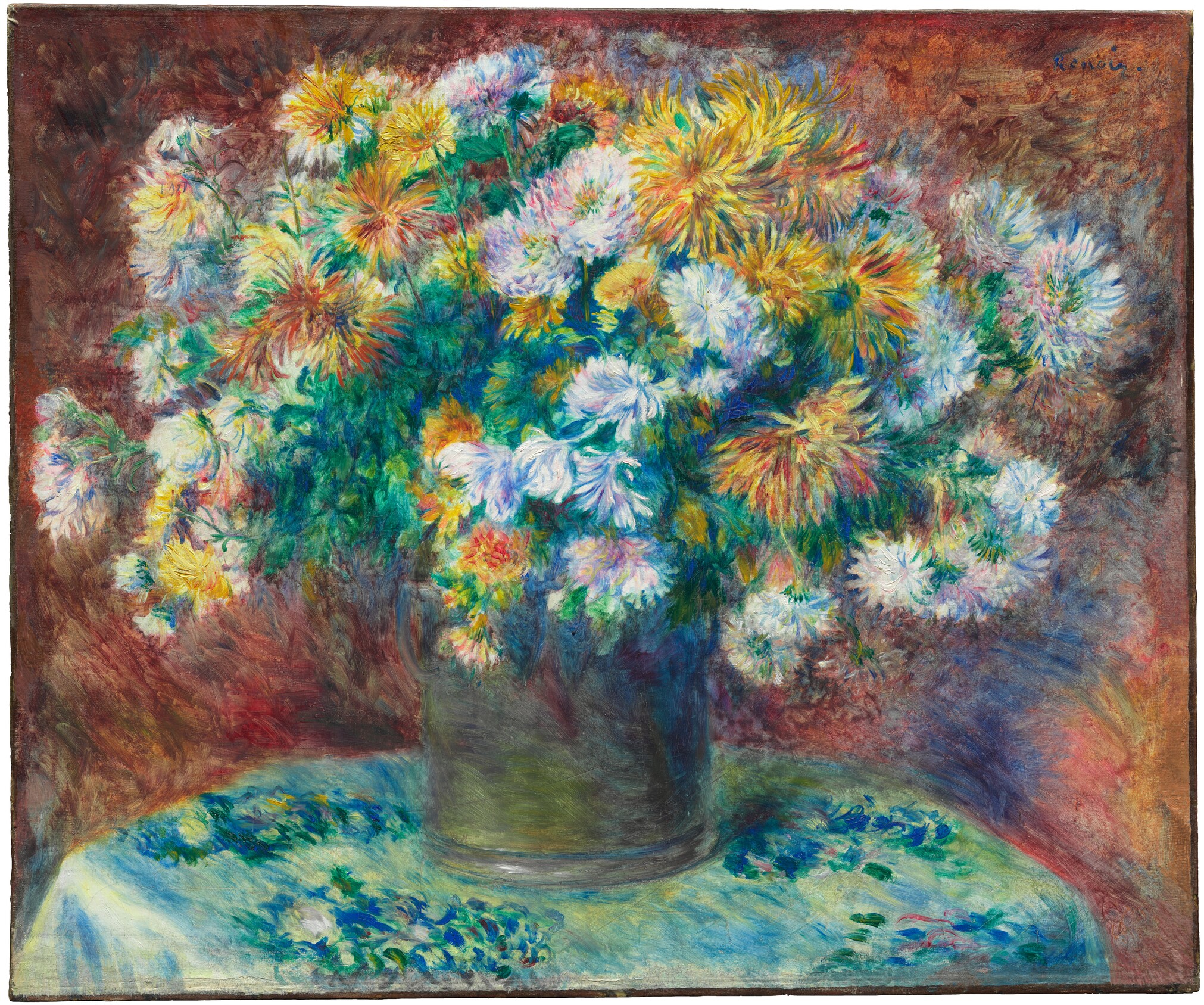
cat. 15 Chrysanthemums, 1881/82.
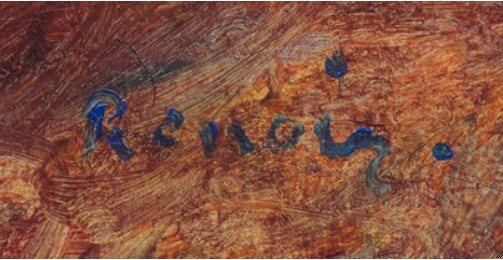
Detail of the signature in Renoir’s Chrysanthemums (1881/82). The Art Institute of Chicago, 1933.1173.
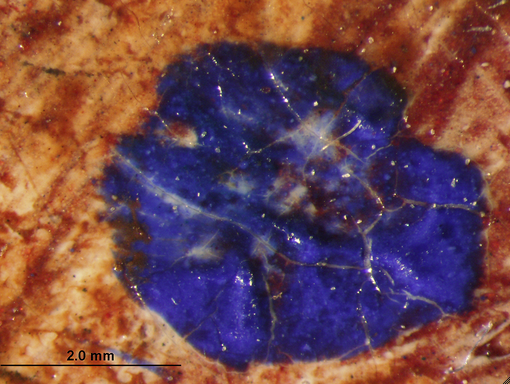
Photomicrograph of the period in the signature in Renoir’s Chrysanthemums (1881/82). The Art Institute of Chicago, 1933.1173.
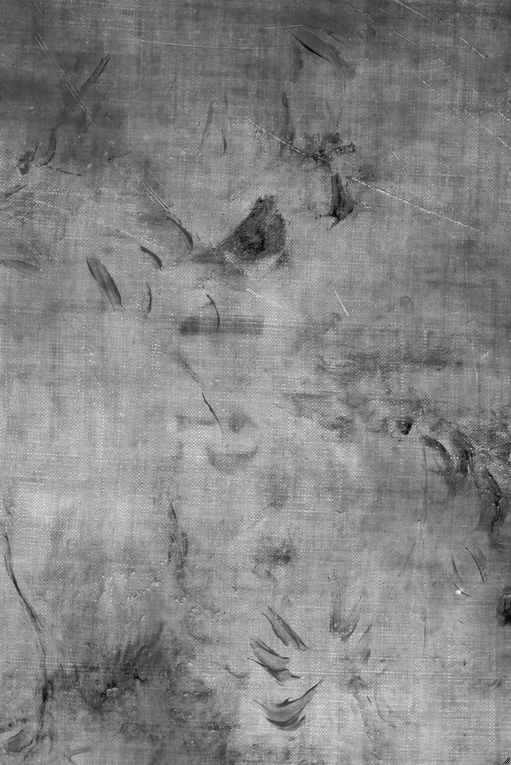
Transmitted infrared detail (Fuji, 1.0–1.1 µm) of the standard size stamp on the verso of Renoir’s Chrysanthemums (1881/82). The Art Institute of Chicago, 1933.1173.
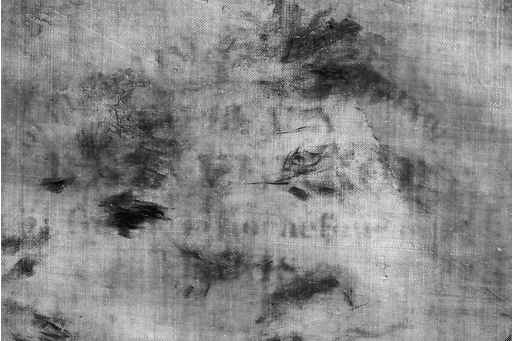
Transmitted infrared detail (Fuji, 1.0–1.1 µm) of the color merchant’s stamp on the verso of Renoir’s Chrysanthemums (1881/82). The Art Institute of Chicago, 1933.1173.
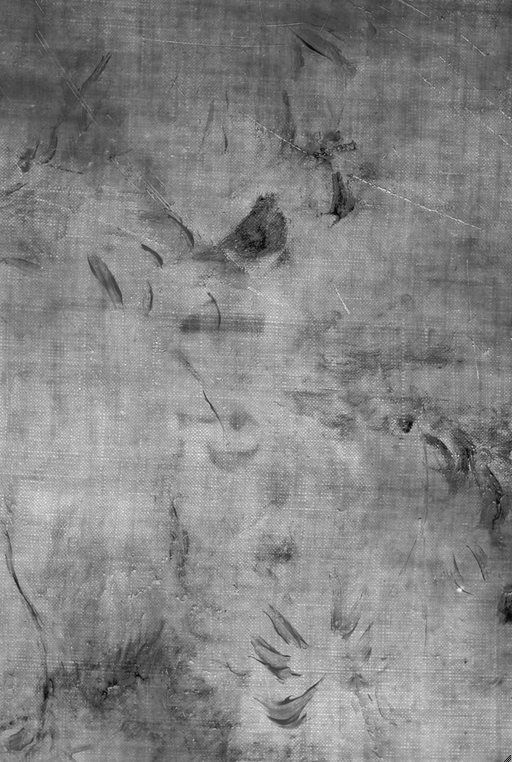
Renoir 33.1173 TRNS IR 15
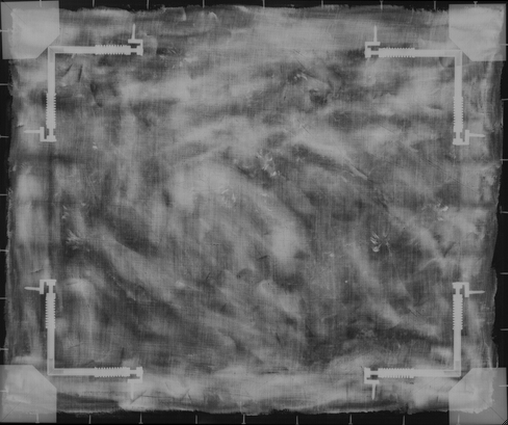
X-ray of Renoir’s Chrysanthemums (1881/82). The Art Institute of Chicago, 1933.1173. X-ray digitally composited by Robert G. Erdmann, University of Arizona.
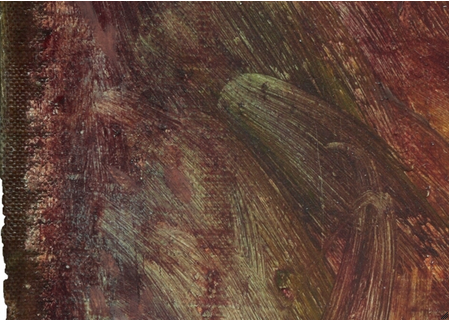
Detail of the left edge of Renoir’s Chrysanthemums (1881/82) showing the edge of the ground layer. The Art Institute of Chicago, 1933.1173.
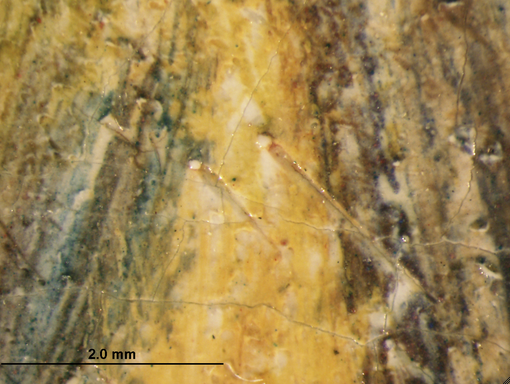
Photomicrograph of the ground in Renoir’s Chrysanthemums (1881/82) showing the chunky inclusions present throughout. The Art Institute of Chicago, 1933.1173.
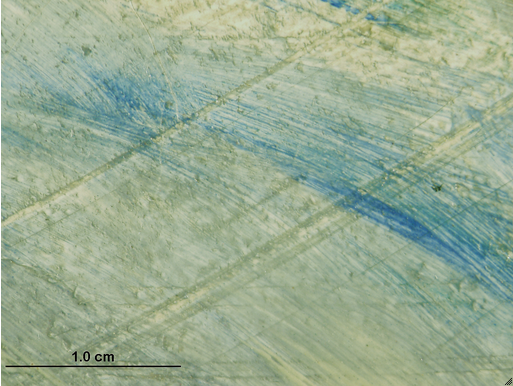
Photomicrograph of the ground in Renoir’s Chrysanthemums (1881/82) showing deep gouges left after inclusions were dragged or pushed across the surface during canvas preparation. The Art Institute of Chicago, 1933.1173.
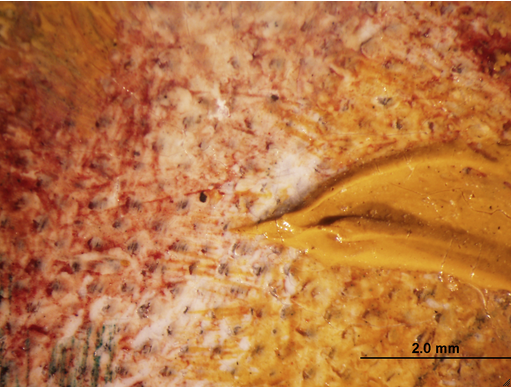
Photomicrograph of the ground in Renoir’s Chrysanthemums (1881/82) showing the variation in ground thickness and the periodic exposure of the canvas thread tops. The Art Institute of Chicago, 1933.1173.

Photomicrograph of a cross section of the ground in Renoir’s Chrysanthemums (1881/82). Original magnification: 100×. The Art Institute of Chicago, 1933.1173.
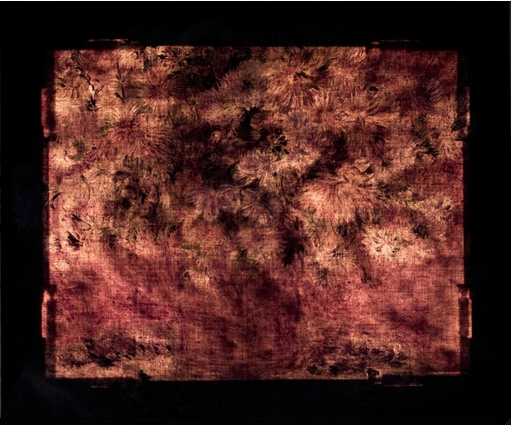
Transmitted-light image of Renoir’s Chrysanthemums (1881/82) showing contour lines around the crock. The Art Institute of Chicago, 1933.1173.
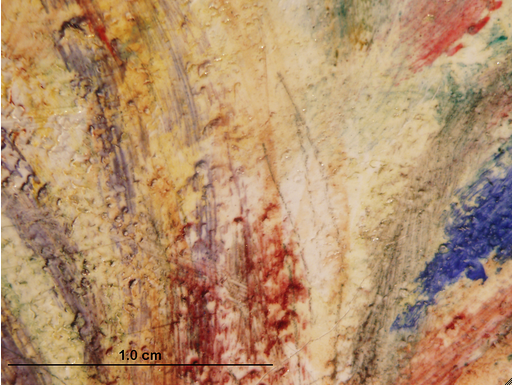
Photomicrograph of graphite underdrawing in Renoir’s Chrysanthemums (1881/82). The Art Institute of Chicago, 1933.1173.
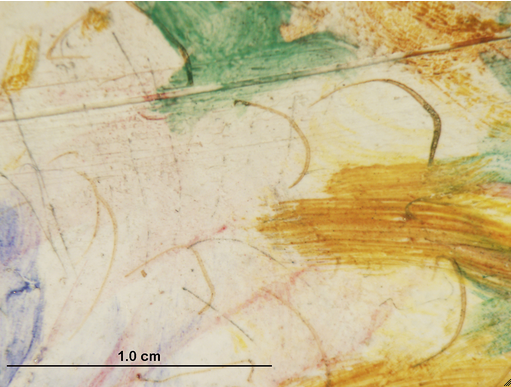
Photomicrograph of the thin, brown underdrawing used for some flowers in Renoir’s Chrysanthemums (1881/82). The Art Institute of Chicago, 1933.1173.
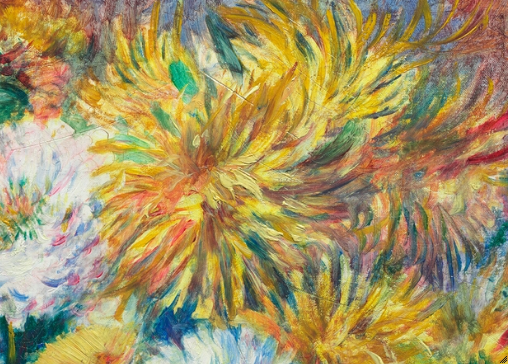
Infrared (Fuji, 1.0–1.1 µm) and natural-light details of a single flower in Renoir’s Chrysanthemums (1881/82). The Art Institute of Chicago, 1933.1173. Interactive image.
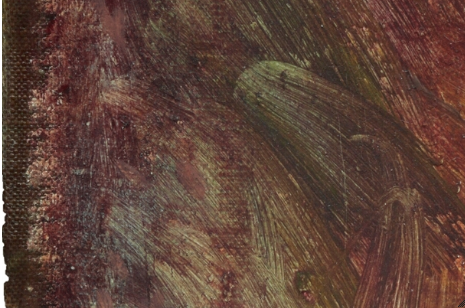
Detail of the left edge of Renoir’s Chrysanthemums (1881/82). The artist used a stiff-bristle brush throughout the background to scratch through fluid paint, exposing the ground. The Art Institute of Chicago, 1933.1173.
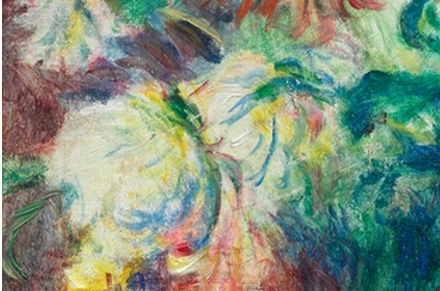
Detail of flowers in Renoir’s Chrysanthemums (1881/82) showing the artist’s use of wiping to create soft shadows. The Art Institute of Chicago, 1933.1173.
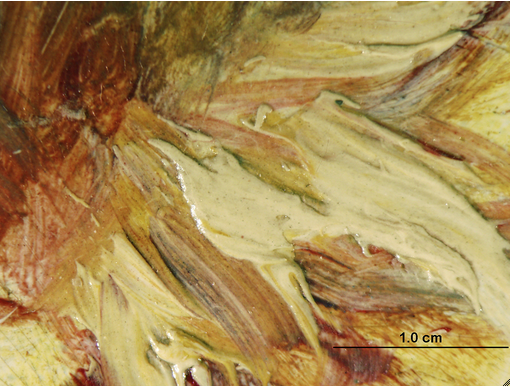
Photomicrograph of the impasto on a single flower in Renoir’s Chrysanthemums (1881/82). The Art Institute of Chicago, 1933.1173.
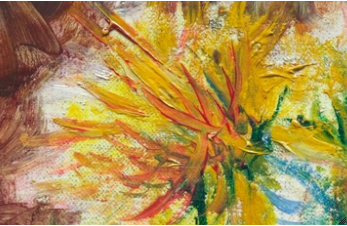
Detail of a flower in Renoir’s Chrysanthemums (1881/82) showing wet-in-wet paint mixing. The Art Institute of Chicago, 1933.1173.
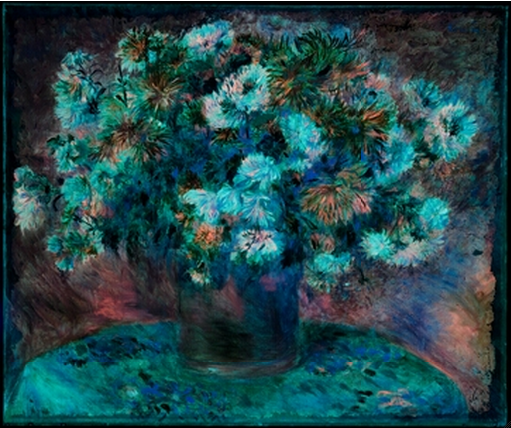
Ultraviolet image of Renoir’s Chrysanthemums (1881/82). The Art Institute of Chicago, 1933.1173.
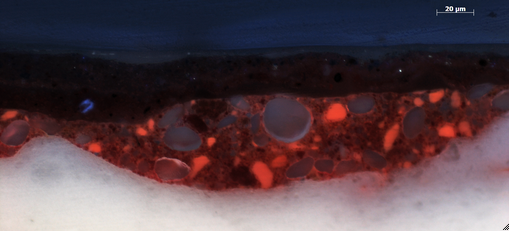
Photomicrograph in UV light of a cross section from Renoir’s Chrysanthemums (1881/82). In the paint layer just above the ground, Renoir's mixture containing both a fluorescing and a nonfluorescing red lake, is visible, in addition to starch grains. Original magnification: 500×. The Art Institute of Chicago, 1933.1173.
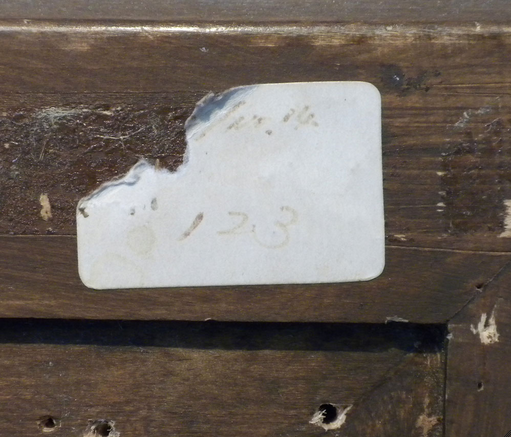
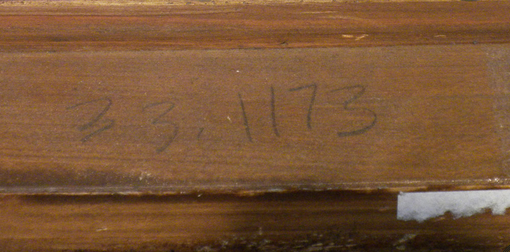
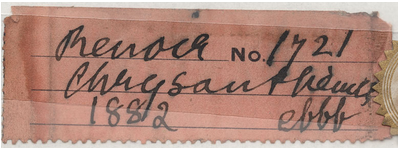
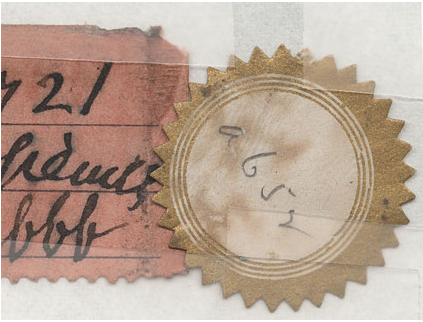
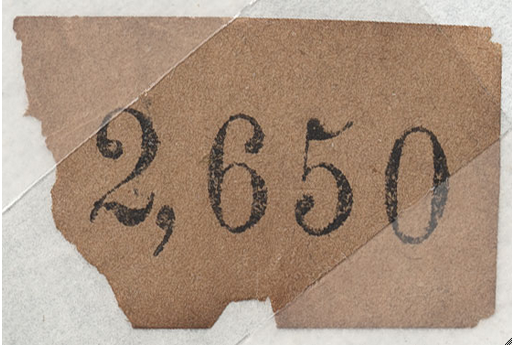
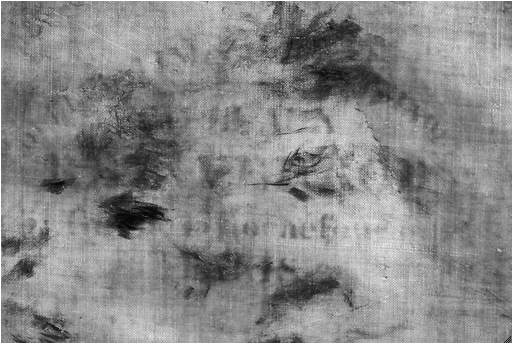
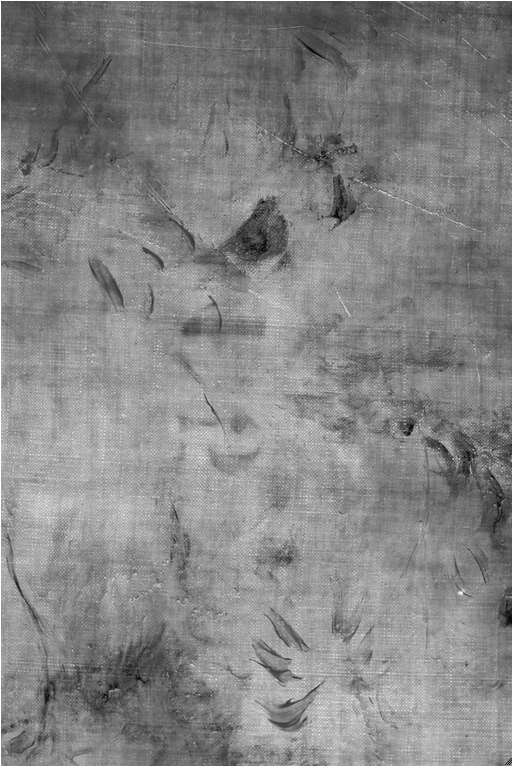
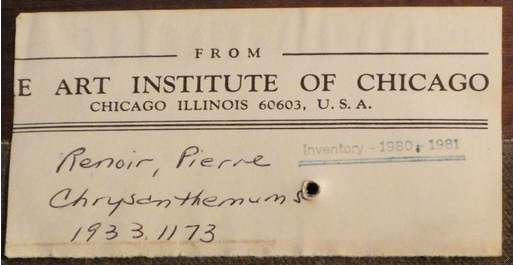
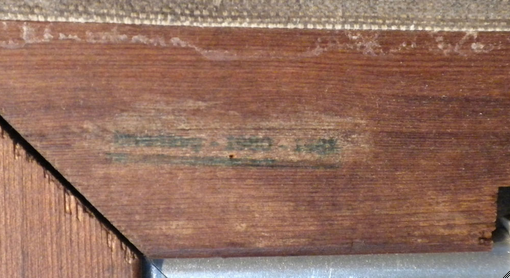
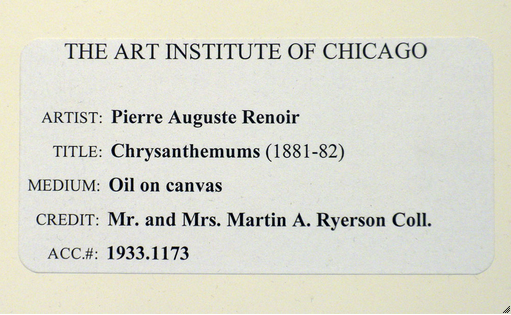
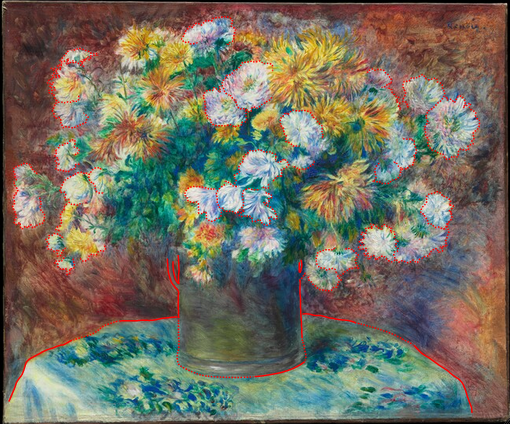
Renoir's Chrysanthemums (1881/2). The Art Institute of Chicago, 1933.1173. Interactive Image.
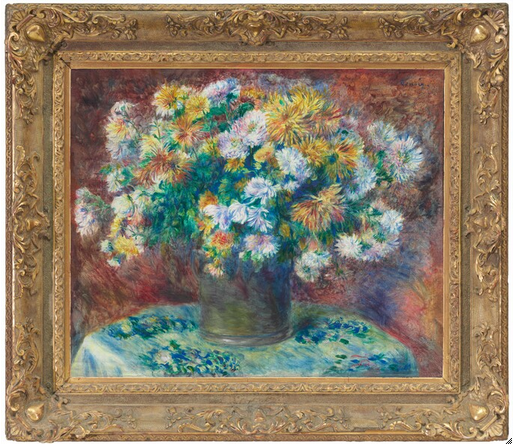
Renoir’s Chrysanthemums (1881/82) in its current, and likely original, frame. The Art Institute of Chicago, 1933.1173.
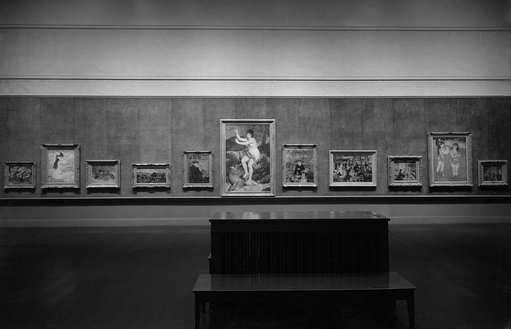
frame history
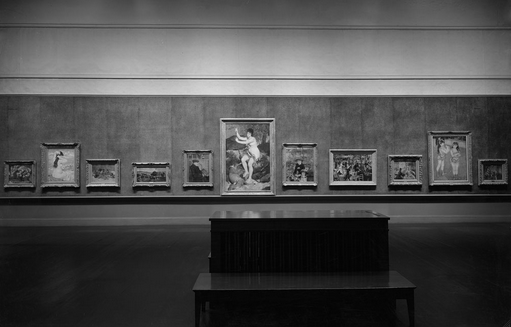
Installation of Renoir’s Chrysanthemums (1881/82), far left, in “A Century of Progress”: Loan Exhibition of Paintings and Sculpture, Art Institute of Chicago, May 23–Nov. 1, 1933. Institutional Archives, Art Institute of Chicago.

for DR documentation
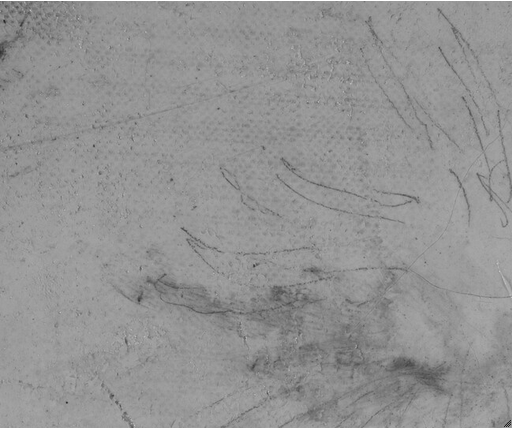
Infrared (Fuji 1.0–1.1 µm) and natural-light details of a single flower in Renoir’s Chrysanthemums (1881/2). The Art Institute of Chicago, 1933.1173. Interactive image.
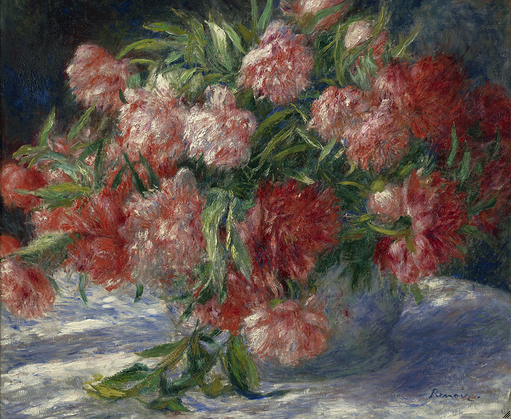
Pierre-Auguste Renoir (French, 1841–1919). Peonies, c. 1880. Oil on canvas; 54.9 × 65.3 cm (21 5/8 × 25 11/16 in.). Sterling and Francine Clark Art Institute, Williamstown, Mass., 1955.585. Bridgeman Images.
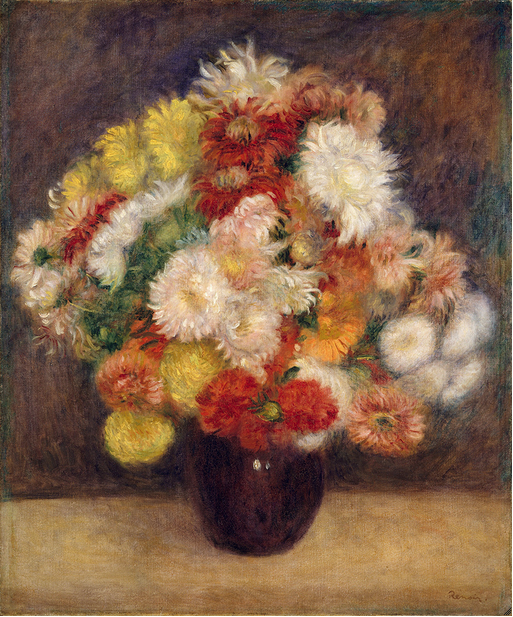
Pierre-Auguste Renoir (French, 1841–1919). Bouquet of Chrysanthemums, 1881. Oil on canvas; 66 × 55.6 cm (26 × 21 7/8 in.). The Metropolitan Museum of Art, New York, The Walter H. and Leonore Annenberg Collection, Bequest of Walter H. Annenberg, 2002, 2003.20.10.
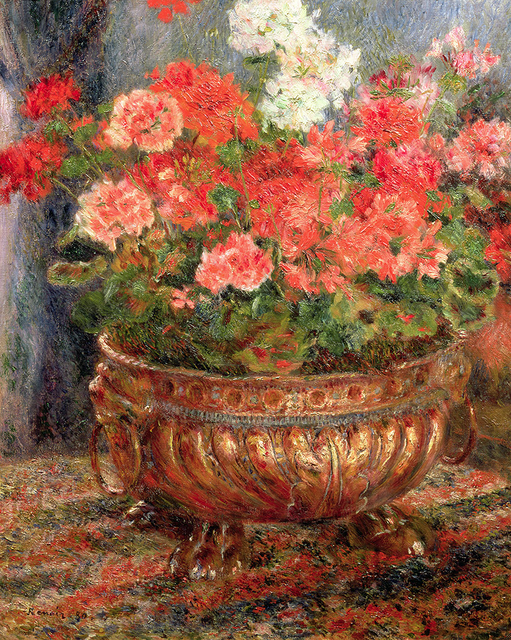
Pierre-Auguste Renoir (French, 1841–1919). Geraniums in a Bronze Bowl, 1880. Oil on canvas; 81 × 65 cm (31 7/8 × 25 5/8 in). Collection of Peter Willi. Peter Willi/ Bridgeman Images.

Detail of Renoir’s Chrysanthemums (1881/82) showing inclusions, probably clumps of dried ground material. The Art Institute of Chicago, 1933.1173.

Detail of Renoir’s Chrysanthemums (1881/82) showing brown underdrawing lines. The Art Institute of Chicago, 1933.1173.
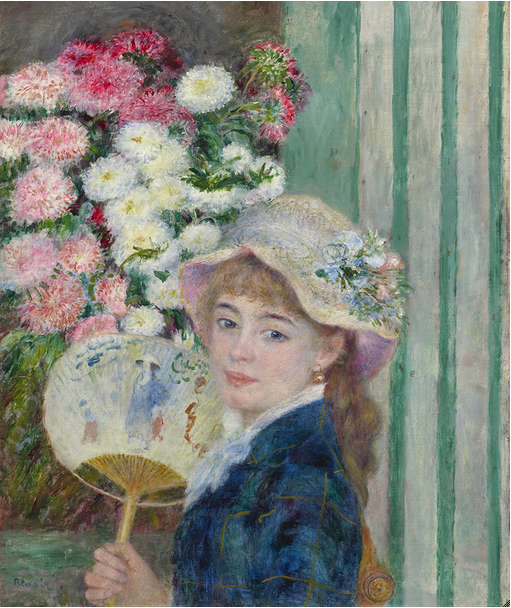
Pierre-Auguste Renoir (French, 1841–1919). A Girl with a Fan, 1881. Oil on canvas; 65 × 54 cm (25 9/16 × 21 1/4 in.). Sterling and Francine Clark Art Institute, Williamstown, Mass., 1955.592. Bridgeman Images.
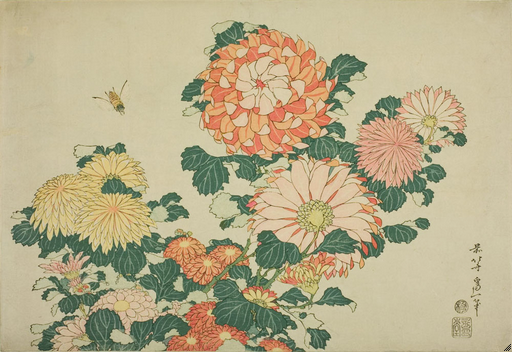
Katsushika Hokusai (Japanese, 1760–1849). Chrysanthemums and Bee, from the untitled series Large Flowers, c. 1833–34. Color woodblock print; 26.5 × 38.8 cm (10 7/16 × 15 5/16 in.). The Art Institute of Chicago, Clarence Buckingham Collection, 1925.3373.
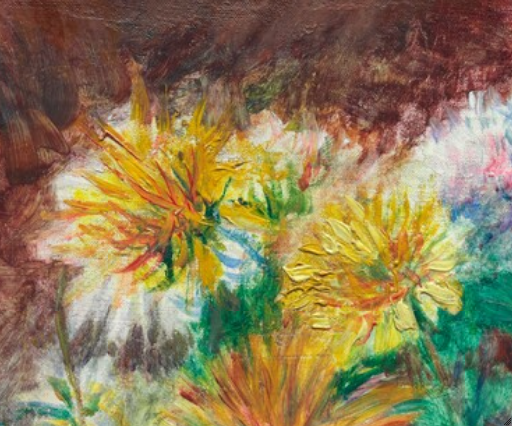
Detail of a flower in Renoir’s Chrysanthemums (1881/82) showing the artist's use of yesllow and red to create the illusion of orange. The Art Institute of Chicago, 1933.1173.
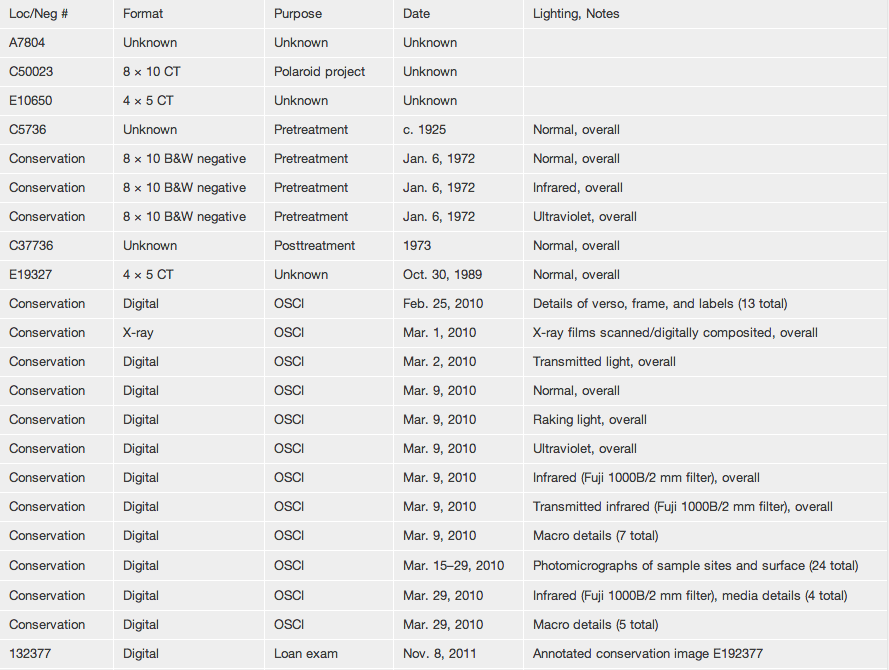
| Loc/Neg # | Format | Purpose | Date | Lighting, Notes |
| A7804 | Unknown | Unknown | Unknown | |
| C50023 | 8 × 10 CT | Polaroid project | Unknown | |
| E10650 | 4 × 5 CT | Unknown | Unknown | |
| C5736 | Unknown | Pretreatment | c. 1925 | Normal, overall |
| Conservation | 8 × 10 B&W negative | Pretreatment | Jan. 6, 1972 | Normal, overall |
| Conservation | 8 × 10 B&W negative | Pretreatment | Jan. 6, 1972 | Infrared, overall |
| Conservation | 8 × 10 B&W negative | Pretreatment | Jan. 6, 1972 | Ultraviolet, overall |
| C37736 | Unknown | Posttreatment | 1973 | Normal, overall |
| E19327 | 4 × 5 CT | Unknown | Oct. 30, 1989 | Normal, overall |
| Conservation | Digital | OSCI | Feb. 25, 2010 | Details of verso, frame, and labels (13 total) |
| Conservation | X-ray | OSCI | Mar. 1, 2010 | X-ray films scanned/digitally composited, overall |
| Conservation | Digital | OSCI | Mar. 2, 2010 | Transmitted light, overall |
| Conservation | Digital | OSCI | Mar. 9, 2010 | Normal, overall |
| Conservation | Digital | OSCI | Mar. 9, 2010 | Raking light, overall |
| Conservation | Digital | OSCI | Mar. 9, 2010 | Ultraviolet, overall |
| Conservation | Digital | OSCI | Mar. 9, 2010 | Infrared (Fuji 1000B/2 mm filter), overall |
| Conservation | Digital | OSCI | Mar. 9, 2010 | Transmitted infrared (Fuji 1000B/2 mm filter), overall |
| Conservation | Digital | OSCI | Mar. 9, 2010 | Macro details (7 total) |
| Conservation | Digital | OSCI | Mar. 15–29, 2010 | Photomicrographs of sample sites and surface (24 total) |
| Conservation | Digital | OSCI | Mar. 29, 2010 | Infrared (Fuji 1000B/2 mm filter), media details (4 total) |
| Conservation | Digital | OSCI | Mar. 29, 2010 | Macro details (5 total) |
| 132377 | Digital | Loan exam | Nov. 8, 2011 | Annotated conservation image E192377 |
| G39031 | Digital | OSCI | Jan. 19, 2012 | Normal, overall; composite of G39270–G39284 |
| G39032 | Digital | OSCI | Jan. 19, 2012 | Ultraviolet, overall |
| G39033 | Digital | OSCI | Jan. 20, 2012 | Normal, frame only |
| Conservation | Digital | OSCI | Jan. 21, 2012 | Infrared (Goodrich, 1.5–1.7 µm J filter), overall composite |
| Conservation | Digital | OSCI | Jan. 21, 2012 | Transmitted infrared (Fuji 1000B/2 mm filter), details: color merchant's and size stamps (2 total) |
| G39270 | Digital | OSCI | Jan. 22, 2012 | Section |
| G39271 | Digital | OSCI | Jan. 22, 2012 | Section |
| G39272 | Digital | OSCI | Jan. 22, 2012 | Section |
| G39273 | Digital | OSCI | Jan. 22, 2012 | Section |
| G39274 | Digital | OSCI | Jan. 22, 2012 | Section |
| G39275 | Digital | OSCI | Jan. 22, 2012 | Section |
| G39276 | Digital | OSCI | Jan. 22, 2012 | Section |
| G39277 | Digital | OSCI | Jan. 22, 2012 | Section |
| G39278 | Digital | OSCI | Jan. 22, 2012 | Section |
| G39279 | Digital | OSCI | Jan. 22, 2012 | Section |
| G39280 | Digital | OSCI | Jan. 22, 2012 | Section |
| G39281 | Digital | OSCI | Jan. 22, 2012 | Section |
| G39282 | Digital | OSCI | Jan. 22, 2012 | Section |
| G39283 | Digital | OSCI | Jan. 22, 2012 | Section |
| G39284 | Digital | OSCI | Jan. 22, 2012 | Section |
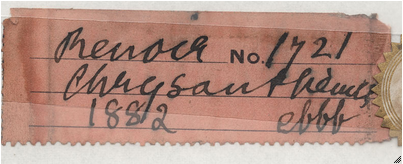
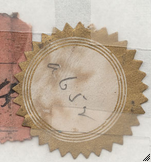
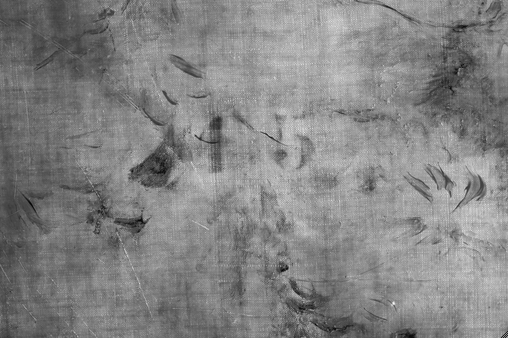
Transmitted infrared detail (Fuji, 1.0–1.1 µm) of the standard size stamp on the verso of Renoir’s Chrysanthemums (1881/82). The Art Institute of Chicago, 1933.1173.
Lucie Berard (Child in White)962
1883
Oil on canvas; 61.3 × 49.8 cm (24 3/8 × 19 5/8 in.)
Signed and dated: Renoir. 83. (upper right, in blue paint)
The Art Institute of Chicago, Mr. and Mrs. Martin A. Ryerson Collection, 1933.1172
The first few months of 1883 were a busy time for Renoir. He was working on his portrait of Madame Clapisson (cat. 17), his sole submission to the Salon that year, requiring approval by its patron and shippment to the jury by the second week of March.963 At the same time, he was preparing for a solo exhibition that was to open April 1 in galleries specially renovated by the art dealer Paul Durand-Ruel on the boulevard de la Madeleine, near the busy traffic hub of the place de la Madeleine.964 Soon after he began Madame Léon Clapisson, Renoir anticipated painting a portrait of two-and-a-half-year-old Lucie Berard. As he wrote to her father, Paul, as early as January or February 1883: “I have begun the second ‘edition’ of Madame Clapisson. . . . This will allow me to get my hand back so that I can start on Lucie as soon as you arrive.”965 It seems certain the portrait of Lucie would have been included in the retrospective exhibition if it had been ready. Colin Bailey has suggested that its execution followed the exhibition and occurred sometime before Renoir’s trip to Guernsey in September, possibly on a quick visit to Wargemont for Lucie’s third birthday on July 10, on his way to nearby Yport that summer.966
In the preface to the catalogue for Renoir’s 1883 retrospective, the art critic Théodore Duret proclaimed the artist to be the figure painter of Impressionism, who portrayed women with delicacy and excelled in portraiture.967 Two full-length dance paintings included in the exhibition, Dance in the City and Dance in the Country (both 1883; Musée d’Orsay, Paris [Daulte 440 and 441; Dauberville 1000 and 999]) were ambitious demonstrations of this particular gift.968 Duret might also have added that Renoir was a skilled painter of childhood, a specialization highlighted in the first gallery of the exhibition, which opened the retrospective with an installation of some twenty-one images and portraits of children. As Edmond Jacques of L’intransigeant commented, “Is it possible to push further the expression of childhood grace than in the series of paintings that fill the first gallery to the left of the entrance?”969 The children featured in this section tended to be very young, such as the subject of the first work in the catalogue, Gypsy Girl (La petite bohémienne) (1879; private collection [Daulte 291; Dauberville 505]), or of the fourth, six-year-old Jeanne Durand-Ruel (1876; Barnes Collection, Philadelphia [Daulte 179; Dauberville 500]).970 Paul Berard lent generously to the exhibition, contributing, among others, four portraits of his children to the first gallery: no. 11, Sketches of Heads (The Berard Children) (Croquis de têtes) (fig. 2.21 [Daulte 365; Dauberville 282]); no. 19, a portrait of Margot (fig. 2.59 [Daulte 286; Dauberville 503]); no. 17, the unidentified Tête d’enfants, possibly a pastel; and no. 20, another unidentified work, simply titled Portrait.971
The year 1883 proved to be a decisive one for Renoir and indeed for the commercial success of the Impressionist movement as a whole. In addition to his retrospective of seventy works—one of a series of exhibitions that included Eugène Boudin, Claude Monet, Camille Pissarro, and Alfred Sisley—he was represented in Impressionist exhibitions organized by Durand-Ruel in London, Boston, and Berlin.972 These exhibitions provided unprecedented exposure for the Impressionists and required considerable capital investment, but resistance to their style persisted, and the press reviews remained predominantly negative and uncomprehending. Despite Durand-Ruel’s promotion of his work, Renoir began to experience self-doubt after he moved into a larger studio yet failed to gain a wider clientele for portraits. Paul Berard and his wife adored their portrait of Lucie but had difficulty convincing others of its merits. In December 1883 Berard confided his concerns to a mutual friend, the collector Charles Deudon: “As far as Renoir, he is having a crisis of confidence. His vast studio horrifies him and he can do nothing about it; except for the portrait of Mme Clapisson, I have seen nothing new and he has no new commissions. . . . I am overwhelmed by the difficulty one encounters trying to have his painting accepted. . . . Unfortunately for Renoir, we cannot get others to derive the pleasure that we do from his work, and this portrait [Lucie Berard (Child in White)], so different from the type that [Jean-Jacques] Henner paints, simply frightens people away.”973
Renoir and Paul Berard had been close friends since 1878, when they probably met at the salon of Marguerite Charpentier.974 The artist soon took on the role of family portraitist, as he had for the Charpentiers prior to that. As a member of a Protestant banking family and a former diplomat, Berard had deep pockets and a more open mind than many of his station. By the time of his death on March 31, 1905, he had amassed a large collection that included works by Renoir as well as Monet, Sisley, Pissarro, Berthe Morisot, and other participants in the Impressionist exhibitions.975 Beginning in the summer of 1879, Renoir made frequent visits to the Berard estate in Normandy, near the village of Wargemont, where Lucie and her sister Margot were born. In addition to portraits of the Berard family, Renoir painted landscapes and genre paintings and decorated the dining room and salon of the chateau with still lifes.976 Of the four Berard children, Lucie would become the most beloved of Renoir. After her birth on July 10, 1880, he portrayed the newborn in a sketch accompanying a letter congratulating Berard for giving him a “nouveau modèle” (fig. 10.67).977 Mary Cassatt also knew the family and made her own pastel likeness of baby Lucie propped uncomfortably in an armchair, dressed in a long presentation gown (fig. 10.65). Family legend has it that Renoir frightened the Berard girls with his teasing and once amused himself by letting the canaries out of their cage, much to girls’ dismay.978
The little girl in the Chicago portrait, Lucie Louise Berard, who evoked for Douglas Druick the “personification of attentive innocence,” would grow up during a tumultuous period in European history, living through both world wars and the rise and fall of Charles de Gaulle, and dying in 1977 at the age of ninety-six.979 In a photograph taken about 1888 (fig. 10.64), she still has the large eyes and unsmiling expression captured in her portrait, but she is now a determined and strong-willed young girl. In April 1905, when she was twenty-four, Lucie wed Jules Edmond David Pieyre Lacombe de Mandiargues, a civil engineer who died at the front in August 1916. She never remarried. One of her two sons, André, became a prominent novelist and poet. Lucie’s husband bought Renoir’s 1883 portrait of her at the sale of the collection of Paul Berard in May 1905—a perfect wedding present and a memento of her father—but the couple did not own it long.980 During the financially difficult period leading up to World War I, the painting was sold, and by February 1913 it was in the collection of Martin A. Ryerson (see Provenance).
A small bust portrait of Lucie wearing a white pinafore, painted in early 1884 (fig. 10.63 [Daulte 456; Dauberville 1231]), marked a significant turning point in Renoir’s career following his crise de découragement in 1883.981 With its emphasis on line, smooth modeling, and controlled brushwork, this portrait is a dramatic departure from the one executed just a year earlier. Writing to inform Berard that it was finished in his “new manner” and would be the “last word in art,” Renoir provided important insight into the resolution of his crisis: “One always thinks one has invented the locomotive until the day when one realizes that it doesn’t work. . . . I’m beginning a little late to know how to wait, having had enough failures like this.”982 This second portrait of Lucie would prove preliminary to Renoir’s valedictory portrait of the Berard sisters, one of the masterpieces of his so-called Ingresque style, Children’s Afternoon at Wargemont (fig. 10.62 [Daulte 457; Dauberville 965]).983 In his final portrayal of Lucie, Renoir shows her standing with a doll looking warily out at the viewer, a child whose innocence derives from her inability to read or embroider, activities with which her sisters are engaged. She can only draw upon imagination to amuse herself. While family friend Jacques-Émile Blanche described the Berard sisters as “unruly savages who refused to write or spell,” here the girls appear quietly absorbed in their activities.984 Thus Renoir ended his series of portraits of the family with a painting that commemorates the graciousness of childhood.
While the audacious Impressionist execution of Lucie’s portrait may have frightened members of the Berards’ social circle, it was not a completely radical break with tradition. In fact the portrait reflects Renoir’s close attention to the art of the past.985 In choosing to show Lucie alone in a half-length format, turned slightly to her right, without any of the usual accessories of childhood, Renoir was inspired by an old master painting: Infanta Margarita (fig. 10.68), from the workshop of seventeenth-century Spanish painter Diego Rodríguez de Silva y Velázquez. In the nineteenth century, this small portrait was considered a highlight of the collection of the Musée du Louvre.986 It shows Velázquez at the height of his power for rendering the soft glow of natural light. For Renoir this painting represented all the ideals he wished to capture in his own painting. Describing it in the early twentieth century to the art dealer Ambroise Vollard, he declared: “What I love so much is that aristocratic quality that you find over and over again in Velázquez, in the smallest detail, the simplest ribbon. . . . The whole of painting is in the little pink bow of Infanta Margarita in the Louvre! How lovely the eyes are and the flesh tones near the eyes! There is not the slightest shadow of sentimentality, of mawkishness!”987 As Lucie shares with the Infanta a pose of graceful serenity, it is clear that childhood innocence without sentimentality was Renoir’s goal as well in the Chicago portrait. Renoir also took on the challenge of the Spanish master’s innovative flesh tones with a colorist’s bravado. Care was taken with finer brushes in the modeling of Lucie’s face in soft pinks and whites; an iridescent, pale yellow is used for shading below her chin and over her neck, possibly in emulation of the glowing flesh tones of the Infanta (see fig. 10.61). Two underdrawing campaigns, the first in black chalk or charcoal and the second in blue paint, hint at changes Renoir might have made to echo Infanta Margarita. The black underdrawing appears to show Lucie’s left forearm raised as if she were holding a doll or toy, but in the blue-painted underdrawing, her arm was moved to hang by her side, closer to the formal pose of the Infanta (fig. 10.66; see Compositional Planning/Underdrawing/Painted Sketch in the technical report).
Renoir’s earlier portrayal of Lucie, in the painting Sketches of Heads (The Berard Children) (fig. 2.21), dated 1881, also references the art of the past. The painting is an exceptional example of collage portraiture, a format that Renoir adopted from the study drawings of eighteenth-century French painter Jean-Antoine Watteau. Here Lucie is portrayed as a sleeping baby (upper left), and awake and looking to her right (just to the right of center). In addition to Lucie, the work also depicts her older brother André (born 1868; lower left); Marthe (born 1870; center, holding a book, and bottom right); and Margot (born 1874; just to the left of center, reading, and upper right).
Compared to the portrait of Madame Clapisson, Renoir’s 1883 Salon submission, there is an informality about the preparation of Lucie Berard (Child in White) that suggests the circumstances of the commission were quite different. This may have something to do with his payment (the amount he received for the painting of Lucie is not known, though he probably asked much less for a child’s portrait than for an adult’s), but it more likely reflects the Berards’ familiarity with the artist and their level of comfort with the Impressionist technique of broken brushwork and color harmonizations. One remarkable aspect of the work is how the texture of the canvas weave is clearly visible to the naked eye (fig. 16.69). The weave can be seen in the reproduction of the portrait in the 1905 sale catalogue (fig. 16.70), so it was likely apparent early in the history of the painting. The weave of this canvas is much looser and coarser than that of the canvas of Madame Léon Clapisson, which reveals how easily Renoir could adapt his technique to different canvas types.988 The canvas edges visible on the back of the stretcher of Lucie’s portrait appear unevenly cut (fig. 16.71), which would be unusual in a canvas prepared by a professional art supplier. The ground layer is pure lead white, does not contain the common additives and extenders found in commercially applied preparations, and was applied only to the compositional area (fig. 16.72; see Preparatory Layers in the technical report). These factors suggest that the artist may have prepared the canvas himself.
Renoir’s use of color in the painting reflects an innovative harmonization. The background progresses from lighter yellows and greens on the right to a deep blue on the left. These background colors resonate with those the artist chose for modeling the figure of Lucie. Could he have intended to suggest an outdoor setting?989 Following the rejection of his first version of the portrait of Madame Clapisson, he vowed never again to paint portraits en plein air; yet he could only have achieved the intense coloration of Lucie’s portrait by placing her under natural light.990 For the Berards, the portrait of Lucie was eminently satisfying. After hanging it in the best spot in his study in a beautiful new frame he had specially made for it, Berard wrote to Deudon that he and his wife, Marguerite, “swoon with pleasure in front of it.”991
John Collins
Renoir began this portrait with a standard-size [glossary:canvas] that he may have prepared himself. The raw, stretched canvas has a heavy [glossary:ground] layer, initially applied with a [glossary:palette knife] and then worked into the canvas to the edges of the compositional area with a brush.992 The thickness of the ground varies throughout and does not hide the canvas texture or its many imperfections, nubs, and varying thread thicknesses. Once the canvas was prepared, the artist made a contour sketch using fine lines in a soft, dry medium, such as natural charcoal or black chalk, to indicate the basic shapes and establish the figure. An additional set of [glossary:underdrawing] lines in fluid blue paint reinforces some of the contours of the head, while changing the arms and the outline of the costume. Renoir moved back and forth between the drawing and painting stages, partially fleshing out at least one earlier position for the arms before returning to establish a new set of contours in blue paint. Parallel to the figure’s right arm, evidence of its previous position—more bent and farther from the body—is visible under normal viewing conditions. This arm was then placed closer to the body, and perhaps pushed backward in space or given a less voluminous sleeve. The figure’s left arm was initially articulated in charcoal farther from the body and bent at the elbow, while a second underdrawing in blue paint places it closer to the body or more forward in space; the artist here settled for a final position between these two earlier placements.
Renoir also made small changes to other areas of the composition, perhaps altering the figure’s hairstyle and raising her eyes from their initial placement in the charcoal drawing. The volume and possibly the shape of the garment near the bottom of the composition were also altered. After establishing the figure, the artist brought in pale background colors immediately around it, perhaps to cover previous compositional choices and underdrawing. These pale colors were then overlaid with heavier paint in tinted blues, making the background appear denser toward the center of the picture.993
The paint is generally full-bodied and paste-like, retaining the mark of the brush and an overall sense of stiff, individual strokes that were applied wet-in-wet and minimally mixed on the canvas, contrasted locally with the smooth, well-blended paint used in the flesh and hair. White impasto highlights for the decorative collar and buttons on the child’s costume appear as final touches to the work.
The multilayer interactive image viewer is designed to facilitate the viewer’s exploration and comparison of the technical images (fig. 2.19).994
Signed and dated: Renoir. 83. (upper right, in blue paint) (fig. 1.2, fig. 2.50).995
Flax (commonly known as linen).996
The original dimensions of the canvas, measuring the primed compositional area, were approximately 60.5 × 49 cm. This corresponds to a no. 12 portrait ([glossary:figure]) standard-size (60 × 50 cm) canvas; this number is also stenciled on the verso of the [glossary:stretcher] (fig. 2.35).997
[glossary:Plain weave]. Average [glossary:thread count] (standard deviation): 19.8V (0.5) × 15.3H (0.7) threads/cm. The vertical threads were determined to correspond to the [glossary:warp] and the horizontal threads to the [glossary:weft].998
The canvas texture is characterized by threads of uneven thickness and numerous nubs and imperfections. Strong [glossary:cusping] around the edges corresponds to the placement of the original tacks. Along with the presence of priming only in the compositional area, the strength of this cusping suggests that the canvas was stretched before it was primed. The [glossary:tacking margins] do not appear to have been trimmed flush with the back edge of the stretcher and bend around to the verso, especially at the top.
Current stretching: The painting was lined and restretched at an unknown date prior to 1968. The dimensions appear to have been increased on all sides and the stretcher tapped out accordingly. The painting was mounted slightly askew, so that paint along the top edge on the right is bent at the foldover. An undated photograph, presumably taken before this lining was applied, shows the painting correctly mounted on its stretcher with no unprimed margin of canvas visible around the edges of the compositional area (see Conservation History) (fig. 2.58).
Original stretching: Based on cusping visible in the X-ray, the original tacks were placed approximately 5.5–7.0 cm apart.
Though the painting was lined and restretched as part of a previous, undocumented conservation treatment, it appears to have retained its original stretcher (see Conservation History). The canvas is tacked to a five-member, blind mortise-and-tenon stretcher with a horizontal [glossary:crossbar] (fig. 1.1). Depth: 2.2 cm.
Number
Location: stretcher
Method: black stamp/stencil
Content: 12 (fig. 2.35)
Not determined (probably glue).999
Renoir applied the ground to the compositional area after the canvas was stretched. The ground is thicker in the center, tapering out toward the perimeter, and may have been applied in successive layers (fig. 16.73).1000 Cross-sectional analysis suggests the ground is generally approximately 10–160 µm thick, and as much as 300 µm thick in some areas. Sharp marks in the [glossary:X-ray] suggest that the thicker areas of the ground were worked into the canvas with a palette knife, but the softness of the perimeter suggests brush application. It is likely that the bulk of the preparation was applied with a palette knife, and then a brush was used to smooth the ground out to the edges and around the various canvas imperfections. Despite the apparent thickness of the ground in some areas, the preparation layer often leaves the canvas texture visible (fig. 2.47).
The ground is white; no colored particles were observed under [glossary:stereomicroscopic examination] or [glossary:cross-sectional analysis].
The ground is lead white with traces of alumina, calcium-based white, and complex silicates (fig. 1.3).1001 The [glossary:binder] is estimated to be [glossary:oil].1002
The artist seems to have outlined the major features of the figure, including the most prominent elements of the face and parts of the costume, directly on top of the ground before painting.
Infrared examination shows that Renoir loosely established the major contours of the figure and costume with long, sweeping, somewhat sketchy lines. Faint lines intermittently outlining the basic shapes are extremely fine and appear wider in some areas where they were reinforced by the artist. This initial set of underdrawing lines appears to have been done in a soft, dry medium, possibly charcoal or chalk (fig. 1.4).1003 This medium contains large black pigment particles that were brought into subsequent paint layers and can be seen microscopically in the whites of the figure’s eyes under normal viewing conditions (fig. 2.48). In some places, the drawing material appears to catch only the thread tops, but in most areas, the softness of the medium allowed it to reach both the high and the low points in the canvas weave.
Elsewhere, and likely after the initial sketch, Renoir outlined some of the features in dark-blue paint, including the contours of the costume. It is unclear, however, whether these outlines were a separate compositional planning stage or the beginning of the painting stage, and therefore less visible in some areas because they were brought into the upper paint layers. At the figure’s left shoulder, a blue outline remains visible through the translucent upper paint layers and can be seen under normal viewing conditions (fig. 2.52).
Renoir seems to have altered the pose of the figure at least twice before settling on the visible arrangement of the arms. After making a very general sketch that established the placement of the figure, the artist continued with thin charcoal or black-chalk lines to define the head and hair, the facial features, and the general outline of the body. The second set of apparent underdrawing lines, in blue paint, seems to indicate a different position of the child’s arms and sleeves. There are also summary lines, both painted and drawn, indicating changes in the volume and shape of the bottom of the child’s garment, though their exact compositional impact is not entirely clear.
After establishing the composition with black lines, Renoir painted the eyes slightly higher than in the drawing, farther away from the nose and mouth (fig. 2.8). Additionally, the positions of both arms appear to have been altered between the drawing and painting stages. Black charcoal or chalk lines indicating the figure’s left arm suggest that it was originally bent, with the hand even higher than the right one. The artist abandoned this choice between the first and second drawing campaigns, as the subsequent sketch in blue paint shows the child’s left arm extended, as in the final composition.
Renoir used blue paint to outline some of the features of the clothing and to alter the positions of the sleeves while leaving the head unchanged. Blue painted lines indicating the figure’s left arm show it both in its current position and farther toward the center of the picture. The figure’s right arm appears to have been articulated at least twice before the artist established its current placement. In one version, the right shoulder appears raised, with the elbow bent so that the arm is farther away from the body and the hand slightly higher than in the final composition. In another version, the shoulder is in the same position as in the final composition, while the sleeve curves and tapers toward the body below the elbow, somewhat mirroring the final orientation of the left arm; compared to this sketch, the final version of the right arm appears to have been pushed backward in space, with less volume in the sleeve (fig. 2.9).
Renoir seems to have moved back and forth between compositional planning and painting throughout the execution of this work, since many of the changes associated with painted lines visible in infrared images and under microscopic examination reveal at least limited heavier brushstrokes in raking and specular light. Additionally, the final placement of the arms has a corresponding underdrawing in thin blue paint. The X-ray, though visually complicated by the vigorous application of the ground, indicates that the artist may initially have parted the child’s hair in the center and swept it off to either side in the front. As a result, the front sections of the hair may have rested farther down on the forehead. The initial set of black underdrawing lines indicates that the eyes were once lower as well. Aside from the possible change in hairstyle and the position of the eyes for the finished composition, there appear to have been no other changes to the head and face.
While Renoir began by sketching in black charcoal or chalk, it appears he reinforced and revised the composition with thin lines in blue paint, some of which appear to have been partially fleshed out in heavier paint before further alteration. Echoes of the earlier placement of the figure’s right shoulder can still be seen running parallel to its final location, despite the addition of background paint in this area. After establishing the figure, the artist probably began the background in thinner, almost wash-like layers of blue, pink, and possibly yellow in a kind of aureole immediately surrounding the figure, before adding heavier layers of darker, tinted blues (fig. 2.20). This initial application of the background may have served to cover varying earlier compositional choices, and as a result, the background appears denser toward the center of the picture (fig. 2.22).1004
In many areas, the paint is of a paste-like consistency that retains brush marks and accentuates the underlying textures of canvas and previous brushstrokes (fig. 2.53). Various colors appear for the most part to have been blended on the canvas rather than on the artist’s palette (fig. 2.54). Renoir complemented the individual strokes seen throughout much of the costume and background with the smoothly blended painting of the flesh tones and the hair (fig. 2.55). Final touches of thick white [glossary:impasto] indicate the decorative collar and buttons on the figure’s garment and the highlights in her eyes (fig. 2.23).
Small to medium brushes, round and flat, with strokes up to about 1 cm wide; palette knife for ground application.
Analysis indicates the presence of the following [glossary:pigments]:1005 lead white, vermilion, two red lakes, cobalt blue, ultramarine blue, bone black, zinc yellow,1006, and iron oxide yellow and/or red and possibly burnt sienna.
The observation of a characteristic salmon-colored [glossary:fluorescence] under [glossary:UV] light suggests the presence of a fluorescing red lake in the hair, flesh tones, and parts of the figure’s dress (fig. 2.10).1007
Polarized light microscopy ([glossary:PLM]) indicates that the background blue is composed of predominantly cobalt blue with some ultramarine blue (fig. 2.56).1008
Oil (estimated).1009
The work was cleaned of a previous [glossary:natural-resin varnish] and coated with its current [glossary:synthetic varnish] during the 1972 treatment (see Conservation History). It is unknown whether the removed natural-resin varnish was original to the painting.1010
The painting’s first documented treatment occurred in 1968, when it was recorded as having an [glossary:aqueous lining] with a [glossary:hardboard] interleaf and a secondary canvas backing.1011 At this time the painting also had widespread cracking and abrasion; abraded areas were overpainted, and the entire painting was coated in a heavy, discolored natural-resin varnish (fig. 2.57). During this treatment, grime was removed and the surface coating was thinned. The work was inpainted with methacrylate paints and given a synthetic varnish (an isolating layer of polyvinyl acetate [PVA] AYAA, followed by methacrylate resin L-46, inpainting, and a final coat of L-46). In 1972 the painting was treated again, and all [glossary:varnish] coatings were removed.1012 The work was inpainted and varnished using the same materials as in the 1968 treatment.
The painting is in good condition, with a secure aqueous lining and hardboard interleaf; deformation of the board over time has caused the painting to have a slight overall concave warp. The lining process accentuated nubs, uneven thread thicknesses, and other canvas imperfections, in addition to increasing the weave impression, especially in the horizontal direction. There also appear to be localized lumps of lining adhesive throughout. The pressure of the lining process caused stress microcracking along the threads, visible under microscopic examination. There are stretcher-bar creases across the center with associated cracking, and there is localized cracking in the figure’s face and costume. The painting has a glossy synthetic varnish that was applied during the 1972 treatment, with residues of a very discolored natural-resin or oil-resin varnish in the depressions of the canvas weave. The effect of this discoloration is especially noticeable in the background, where large areas appear to have a yellow cast. This darkening, combined with underpainting in the background immediately surrounding the figure, gives a false sense of space because the side margins appear more lightly painted than the center. The [glossary:inpainting] is limited to localized losses and abrasions.
Kelly Keegan
The current frame may be original to the painting.1013 It is a French (Paris), late-nineteenth-century, Louis XIV reproduction, gilt ogee frame with cast foliate ornament, center and corner fleur-de-lis cartouches linked by foliate scrolls and strapwork, and pendent bellflowers on a diamond bed. The frame has oil and water gilding over red bole on cast plaster and gesso. The ornament and sight molding are selectively burnished, and the gilding has been heavily rubbed, exposing the bole. The gilding is toned with a casein or gouache raw umber [glossary:wash] with a gray overwash. The pine molding is mitered and nailed. At some point in the frame’s history, the original verso was planed flat, removing all construction history and provenance, a back frame was added, and all back and interior surfaces were painted. The molding, from the perimeter to the interior, is torus with leaf-tip outer molding; scotia side; ogee face with cast center and corner fleur-de-lis cartouches on a diamond bed, linked by foliate scrolls and strapwork on a quadrillage bed, and pendent bellflowers on a diamond bed; sanded front frieze bordered with fillets; and ogee sight molding with strapped, linked foliate scrolls and bellflowers on a recut bed (fig. 2.11, fig. 2.6).
Kirk Vuillemot
Commissioned from the artist by the sitter’s father, Paul Berard (1833–1905), Wargemont and Paris.1014
Sold at the Paul Berard sale, Galerie Georges Petit, Paris, May 8, 1905, lot 20, to the sitter’s husband, J. E. D. Pieyre Lacombe de Mandiargues (1879–1916), for 10,030 francs.1015
Acquired by André Schoeller, Paris, by May 25, 1912.1016
Sold by André Schoeller, Paris, to Bernheim-Jeune, Paris, May 25, 1912, for 11,000 francs.1017
Sold by Bernheim-Jeune, Paris, to Martin A. Ryerson, Chicago, Feb. 26, 1913, for 23,500 francs.1018
Bequeathed by Martin A. Ryerson (died 1932), Chicago, to the Art Institute of Chicago, 1933.
Possibly Paris, Durand-Ruel, Exposition des oeuvres de P.-A. Renoir, Apr. 1–25, 1883, cat. 20, as Portrait. Appartenant à M. Berard.1019
Paris, Grand Palais des Champs-Élysées, Salon d’automne, Oct. 18–Nov. 25, 1905, cat. 1322, as Portrait d’enfant en robe blanche.1020
Paris, Bernheim-Jeune, Exposition Renoir, Mar. 10–29, 1913, cat. 25, as L’enfant en robe blanche. App. à M. R.
Pittsburgh, Carnegie Institute, Paintings: Édouard Manet, Pierre Renoir, Berthe Morisot, Oct. 15–Dec. 1, 1924, cat. 20.
Art Institute of Chicago, “A Century of Progress”: Loan Exhibition of Paintings and Sculpture, May 23–Nov. 1, 1933, cat. 339.1021 (fig. 2.7)
Philadelphia, Pennsylvania Museum of Art, Manet and Renoir, Nov. 29, 1933–Jan. 1, 1934, no cat. no.1022
Art Institute of Chicago, “A Century of Progress”: Loan Exhibition of Paintings and Sculpture for 1934, June 1–Oct. 31, 1934, cat. 227.1023
Art Institute of Chicago, Paintings by Renoir, Feb. 3–Apr. 1, 1973, cat. 46 (ill.).
Sydney, Art Gallery of New South Wales, Modern Masters, Manet to Matisse, Apr. 10–May 11, 1975, cat. 96 (ill.); Melbourne, National Gallery of Victoria, May 28–June 22, 1975; New York, Museum of Modern Art, Aug. 4–Sept. 28, 1975.1024
Tokyo, Seibu Museum of Art, Shikago bijutsukan insho-ha ten [The Impressionist tradition: Masterpieces from the Art Institute of Chicago], Oct. 18–Dec. 17, 1985, cat. 37 (ill.); Fukuoka Art Museum, Jan. 5–Feb. 2, 1986; Kyoto Municipal Museum of Art, Mar. 4–Apr. 13, 1986.
Ottawa, National Gallery of Canada, Renoir’s Portraits: Impressions of an Age, June 27–Sept. 14, 1997, cat. 47 (ill.); Art Institute of Chicago, Oct. 17, 1997–Jan. 4, 1998; Fort Worth, Tex., Kimbell Art Museum, Feb. 8–Apr. 26, 1998. (fig. 2.18)
Rome, Galleria Nazionale d’Arte Moderna e Contemporanea, Aug. 21, 2001–Jan. 23, 2002.1025
Columbia (S.C.) Museum of Art, Renoir!, Apr. 25–Oct. 1, 2007, no cat.1026
Fort Worth, Tex., Kimbell Art Museum, The Impressionists: Master Paintings from the Art Institute of Chicago, June 29–Nov. 2, 2008, cat. 30 (ill.).
Possibly Durand-Ruel, Paris, Catalogue de l’exposition des oeuvres de P.-A. Renoir, exh. cat. (Pillet et Dumoulin, 1883), p. 11, cat. 20.1027
Société du Salon d’Automne, Catalogue de peinture, dessin, sculpture, gravure, architecture et art décoratif, exh. cat. (Cie Français des Papiers-Monnaie, 1905), p. 146, cat. 1322.
Bernheim-Jeune, Paris, Exposition Renoir, exh. cat. (Bernheim-Jeune, 1913), cat. 25.
Bernheim-Jeune, Renoir, with a preface by Octave Mirbeau (Bernheim-Jeune, 1913), opp. p. 22 (ill.), p. 58.
Art Institute of Chicago, General Catalogue of Paintings, Sculpture, and Other Objects in the Museum (Art Institute of Chicago, 1914), p. 211, cat. 2144.
Guillaume Janneau, “Impressions d’Amérique,” Le bulletin de la vie artistique 2, 8 (Apr. 15, 1921), p. 237 (ill.).
Carnegie Institute, Exhibition of Paintings: Edouard Manet, Pierre Renoir, Berthe Morisot, exh. cat. (Carnegie Institute, [1924]), no. 20.
Art Institute of Chicago, A Guide to the Paintings in the Permanent Collection (Art Institute of Chicago, 1925), p. 162, cat. 2153.1028
M. C., “Renoirs in the Institute (Continued),” Bulletin of the Art Institute of Chicago 19, 4 (Apr. 1925), pp. 48, 49 (ill.).
Ambroise Vollard, Renoir: An Intimate Record, trans. Harold L. Van Doren and Randolph T. Weaver (Knopf, 1925), p. 241.
Daniel Catton Rich, “Französische Impressionisten im Art Institute zu Chicago,” Pantheon: Monatsschrift für Freunde und Sammler der Kunst 11, 3 (Mar. 1933), p. 78. Translated by C. C. H. Drechsel as “French Impressionists in the Art Institute of Chicago,” Pantheon/Cicerone (Mar. 1933), p. 18.
Art Institute of Chicago, Catalogue of “A Century of Progress”: Exhibition of Paintings and Sculpture; Lent from American Collections, ed. Daniel Catton Rich, exh. cat. (Art Institute of Chicago, 1933), p. 48, cat. 339.
Pennsylvania Museum of Art, “Manet and Renoir,” Pennsylvania Museum Bulletin 29, 158 (Dec. 1933), p. 19.
Art Institute of Chicago, Catalogue of “A Century of Progress”: Exhibition of Paintings and Sculpture, 1934, ed. Daniel Catton Rich, exh. cat. (Art Institute of Chicago, 1934), p. 38, cat. 227.
Albert C. Barnes and Violette de Mazia, The Art of Renoir (Minton, Balch, 1935), pp. 77; 78; 271, no. 134 (ill.); 455, no. 134.
Maurice Bérard, Une famille du Dauphiné: Les Bérard, notice historique et généalogique (Laroze, 1937), fig. 35.1029
Maurice Bérard, Renoir à Wargemont, Maîtres du XIXe siècle (Larose, [1938]), (ill.).
Reginald Howard Wilenski, Modern French Painters (Reynal & Hitchcook, [1940]), p. 338.1030
Art Institute of Chicago, Masterpieces in the Art Institute of Chicago (Art Institute of Chicago, 1952), (ill.).
Dorothy Bridaham, Renoir in the Art Institute of Chicago (Conzett & Huber, 1954), pl. 7.
Art Institute of Chicago, Paintings in the Art Institute of Chicago: A Catalogue of the Picture Collection (Art Institute of Chicago, 1961), p. 397.1031
John Maxon, The Art Institute of Chicago (Abrams, 1970), pp. 267 (ill.), 285.1032
François Daulte, Auguste Renoir: Catalogue raisonné de l’oeuvre peint, vol. 1, Figures, 1860–1890 (Durand-Ruel, 1971), pp. 306–07, cat. 449 (ill.).
Elda Fezzi, L’opera completa di Renoir: Nel periodo impressionista, 1869–1883, Classici dell’arte 59 (Rizzoli, 1972), pp. 113, cat. 564; 114, cat. 564 (ill.).1033
Art Institute of Chicago, Paintings by Renoir, exh. cat. (Art Institute of Chicago, 1973), pp. 120–21, cat. 46 (ill.); 210; 211.
François Daulte, “Renoir et la famille Berard,” L’oeil 223 (Feb. 1974), p. 5, fig. 7.
William S. Lieberman, ed., Modern Masterpieces: Manet to Matisse, exh. cat. (Museum of Modern Art, 1975), pp. 206–07 (ill.); 267, cat. 96.
Barbara Ehrlich White, Renoir: His Life, Art, and Letters (Abrams, 1984), pp. 129, 132 (ill.), 150.
Art Institute of Chicago, Seibu Museum of Art, Kyoto Municipal Museum of Art, and Fukuoka Art Museum, Shikago bijutsukan insho-ha ten [The Impressionist tradition: Masterpieces from the Art Institute of Chicago], trans. Akihiko Inoue, Hideo Namba, Heisaku Harada, and Yoko Maeda, exh. cat. (Nippon Television Network, 1985), pp. 83, cat. 37 (ill.); 148, cat 37 (ill.).
Anne Distel, “Charles Deudon (1832–1914) collectionneur,” Revue de l’art 86 (1989), p. 62, n. 3.
Art Institute of Chicago, Treasures of 19th- and 20th-Century Painting: The Art Institute of Chicago, with an introduction by James N. Wood (Art Institute of Chicago/Abbeville, 1993), p. 91 (ill.).
Götz Adriani, Renoir, exh. cat. (Kunsthalle Tübinger/DuMont, 1996), p. 227, n. 6.
Douglas W. Druick, Renoir, Artists in Focus (Art Institute of Chicago/Abrams, 1997), pp. 59–60; 97, pl. 16; 110.
Colin B. Bailey, with the assistance of John B. Collins, Renoir’s Portraits: Impressions of an Age, exh. cat. (National Gallery of Canada/Yale University Press, 1997), pp. 184; 204–05, cat. 47 (ill.); 317, cat. 47. Translated by Danielle Chaput and Julie Desgagné, with support from Nada Kerpan for the texts by Linda Nochlin, as Les portraits de Renoir: Impressions d’une époque, exh. cat. (Gallimard/Musée des Beaux-Arts du Canada, 1997), pp. 184; 204–05, cat. 47 (ill.); 317, cat. 47.
Colin B. Bailey, “Portrait of the Artist as a Portrait Painter,” in Colin B. Bailey, with the assistance of John B. Collins, Renoir’s Portraits: Impressions of an Age, exh. cat. (National Gallery of Canada/Yale University Press, 1997), p. 19. Translated as Colin B. Bailey, “Portrait de l’artiste en portraitiste,” in Colin B. Bailey, with the assistance of John B. Collins, Les portraits de Renoir: Impressions d’une époque, trans. Danielle Chaput and Julie Desgagné, exh. cat. (Gallimard/Musée des Beaux-Arts du Canada, 1997), p. 19.
John B. Collins, “Seeking l’Esprit Gaulois: Renoir’s Bal du Moulin de la Galette and Aspects of French Social History and Popular Culture” (Ph.D. diss., McGill University, 2001), p. 86.
Gilles Néret, Renoir: Painter of Happiness, 1841–1919, trans. Josephine Bacon (Taschen, 2001), pp. 246 (ill.), 264.
Sotheby’s, Impressionists and Modern Art Evening Sale, sale cat. (Sotheby’s, London, June 23, 2003), pp. 16, fig. 2; 17.
Robert McDonald Parker, “Topographical Chronology 1860–1883,” in Renoir Landscapes, 1865–1883, ed. Colin B. Bailey and Christopher Riopelle, exh. cat. (National Gallery, London, 2007), p. 279. Translated as Robert McDonald Parker, “Chronologie,” in Les paysages de Renoir, 1865–1883, ed. Colin B. Bailey and Christopher Riopelle, trans. Marie-Françoise Dispa, Lise-Éliane Pomier, and Laura Meijer, exh. cat. (National Gallery, London/5 Continents, 2007), p. 279.
Gloria Groom and Douglas Druick, with the assistance of Dorota Chudzicka and Jill Shaw, The Impressionists: Master Paintings from the Art Institute of Chicago, exh. cat. (Art Institute of Chicago/Kimbell Art Museum, 2008), p. 77, cat. 30 (ill.). Simultaneously published as Gloria Groom and Douglas Druick, with the assistance of Dorota Chudzicka and Jill Shaw, The Age of Impressionism at the Art Institute of Chicago (Art Institute of Chicago/Yale University Press, 2008), p. 77, cat. 30 (ill.).1034
Guy-Patrice Dauberville and Michel Dauberville, Renoir: Catalogue raisonné des tableaux, pastels, dessins et aquarelles, vol. 2, 1882–1894 (Bernheim-Jeune, 2009), p. 335, cat. 1229 (ill.).
Anne Distel, Renoir (Citadelles & Mazenod, 2009), pp. 228–29, ill. 211.
Colin B. Bailey, Renoir, Impressionism, and Full-Length Painting, exh. cat. (Frick Collection/Yale University Press, 2012), p. 199.
Inventory number
Bernheim-Jeune no. 195661035
Photograph number
Photo Bernheim-Jeune no. 107511036
Number
Location: previous backing board (preserved in conservation file)
Method: handwritten script (graphite)
Content: 12 3/4 / 57 / 69 3/4 (fig. 2.24)
Number
Location: previous backing board (preserved in conservation file)
Method: handwritten script (pen)
Content: 1933.1172 (fig. 2.31)
Number
Location: frame verso
Method: handwritten script on white label
Content: 37 / 56 (fig. 2.26)
Number
Location: frame verso
Method: handwritten script (black marker)
Content: 1933.1172 (fig. 2.27)
Label
Location: frame verso
Method: printed label (partial)
Content: cornice (fig. 2.28)
Inscription
Location: stretcher
Method: handwritten script
Content: [15] de haut (fig. 2.29)
Stamp
Location: stretcher
Method: red stamp
Content: F (fig. 2.30)
Number
Location: stretcher
Method: handwritten script (graphite)
Content: 2840 (fig. 2.32)
Number
Location: stretcher
Method: handwritten script
Content: 35 [. . .] (fig. 2.33)
Number
Location: stretcher
Method: handwritten script (graphite)
Content: 20 3/8 × 24 5/16 (fig. 2.44)
Number
Location: stretcher
Method: handwritten script (blue pencil)
Content: 19566 (fig. 2.34)
Number
Location: stretcher
Method: handwritten script (blue pencil)
Content: 5590 (fig. 2.16)
Number
Location: stretcher
Method: black stamp or stencil
Content: 12 (fig. 3.60)
Label
Location: previous backing board (preserved in conservation file)
Method: handwritten script (ink) on pink label
Content: No 19566 / Renoir / enfant en robe blanch[e] / TC0000[. . .] (fig. 2.45)
Label
Location: previous backing board (preserved in conservation file)
Method: handwritten script (ink) on brown label
Content: Renoir No 10950 / l’Enfant en robe / blanche / pobdc (fig. 2.36)
Label
Location: previous backing board (preserved in conservation file)
Method: handwritten script (ink) on brown label
Content: R[en]oir No 19050 / L’enfant blanc / [p . . . d] (fig. 2.37)
Label
Location: previous backing board (preserved in conservation file)
Method: handwritten script (graphite) on printed and typed label
Content: [handwritten] 33.1172 / PENNSYLVANIA MUSEUM OF ART / FAIRMOUNT, PHILADELPHIA / ARTIST Auguste Renoir / TITLE Child in White / INSURANCE VALUE $15,000. / SALES VALUE / LENDER Art Institute of Chicago, Chicago, Ill. / ADDRESS OF LENDER Mr.& Mrs. Martin A. Ryerson Collection / Penn Mus. Form (fig. 2.38)
Label
Location: previous backing board (preserved in conservation file)
Method: printed and typed label
Content: The Museum of Modern Art / 11 West 53 Street, New York, N.Y. 10019 Tel. 956-6100 / Artist RENOIR, Pierre Auguste. French, / 1841–1919. / Title Child in White. / Oil on canvas. / Date 1883. / Museum No. 75.58 (fig. 2.39)
Label
Location: frame
Method: printed and typed label
Content: Museum of Modern Art / LOAN 75.58 / Chiago [sic] (fig. 2.26)
Stamp
Location: previous backing board (preserved in conservation file)
Method: blue stamp
Content: Inventory 1980–1981 (fig. 2.13)
Stamp
Location: stretcher
Method: blue stamp
Content: Inventory—1980–1981 (fig. 2.40)
Label
Location: stretcher
Method: printed and typed label with blue stamp
Content: ART INSTITUTE OF CHICAGO / CHICAGO ILLINOIS 60603, U.S.A. / [blue stamp, center right] Inventory—1980–1981 / Renoir, Pierre Auguste / Lucie Berard, Child in White 1883 / 1933.1172 (fig. 2.30)
Label
Location: backing board
Method: printed and typed label
Content: The Impressionist Tradition: / Masterpieces from / The Art Institute of Chicago / October 18–December 17, 1985 / THE SEIBU MUSEUM OF ART / 1-28-1, Minami-Ikebukuro, Toshima-ku, Tokyo 171, Japan Phone: Toyko981-0111 Cable Address: SEIBUDEPT TOKYO (fig. 2.41)
Label
Location: backing board
Method: handwritten script (red pen) on printed and typed label
Content: FROM / THE ART INSTITUTE OF CHICAGO / CHICAGO ILLINOIS 60603, U.S.A. / To / RENOIR, PIERRE AUGUSTE / “Lucie Berard, Child in White” / 1933.1172 / [handwritten, lower left] 56# (fig. 2.42)
Label
Location: backing board
Method: printed and typed label
Content: [left] NTV / NIPPON / TELEVISION / NETWORK / CORPORATION / 14 Niban-cho, Chiyoda-Ku / Tokyo, Japan 102 / Tel :265-2111 / Cable Address: JOAXNTV / Telex: J24566 / [right] THE IMPRESSIONIST TRADITION: / MASTERPIECES FROM / THE ART INSTITUTE OF CHICAGO / Oct. 18–Dec. 17, 1985 / The Seibu Museum of Art (Tokyo) / Jan. 5–Feb. 2, 1986 / Fukuoka Art Museum / Mar. 4–Apr. 13, 1986 / Kyoto Municipal Museum of Art (fig. 2.43)
Label
Location: backing board
Method: printed label
Content: Renoir’s Portraits: Impressions of an Age / Cat.No.: 47 / Artist: Pierre-Auguste Renoir / Title: Child in a White Dress (Lucie Berard) / Owner: Art Institute of Chicago (fig. 2.49)
Label
Location: backing board
Method: printed label
Content: THE ART INSTITUTE OF CHICAGO / “Renoir’s Portraits: Impressions of an Age” / October 17, 1997–January 4, 1998 / 47 / Pierr-Auguste Renoir [sic] / Child in a White Dress (Lucie Berard) / The Art Institute of Chicago (fig. 2.15)
Westinghouse X-ray unit, scanned on Epson Expressions 10000XL flatbed scanner. Scans were digitally composited by Robert G. Erdmann, University of Arizona.
Inframetrics Infracam with 1.5–1.73 µm filter; Fujifilm S5 Pro with X-Nite 1000B/2 mm filter (1.0–1.1 µm); Goodrich/Sensors Unlimited SU640SDV-1.7RT with H filter (1.1–1.4 µm) and J filter (1.5–1.7 µm).
Fujifilm S5 Pro with X-Nite 1000B/2 mm filter (1.0–1.1 µm).
Natural-light, raking-light, and transmitted-light overalls and macrophotography: Fujifilm S5 Pro with X-NiteCC1 filter.
Fujifilm S5 Pro with X-NiteCC1 filter and Kodak Wratten 2E filter.
Sinar P3 camera with Sinarback eVolution 75 H (X-NiteCC1 filter, Kodak Wratten 2E filter).
Sample and cross-sectional analysis were performed using a Zeiss Axioplan 2 research microscope equipped with reflected light/UV fluorescence and a Zeiss AxioCam MRc5 digital camera. Types of illumination used: darkfield, brightfield, differential interference contrast (DIC), and UV. In situ photomicrographs were taken with a Wild Heerbrugg M7A StereoZoom microscope fitted with an Olympus DP71 microscope digital camera.
Several spots on the painting were analyzed in situ with a Bruker/Keymaster TRACeR III-V with rhodium tube.
Zeiss Universal research microscope.
Cross sections were analyzed after carbon coating with a Hitachi S-3400N-II VP-SEM with an Oxford EDS and a Hitachi solid-state BSE detector. Analysis was performed at the Northwestern University Atomic and Nanoscale Characterization Experimental (NUANCE) Center, Electron Probe Instrumentation Center (EPIC) facility.
Applied Research Laboratories (ARL) electron microprobe analyzer. Analysis was carried out at McCrone Associates, Chicago, Illinois.
Thread count and weave information were determined by Thread Count Automation Project software.1039
Overlay images were registered using a novel image-based algorithm developed by Damon M. Conover (GW), Dr. John K. Delaney (GW, NGA), and Murray H. Loew (GW) of the George Washington University’s School of Engineering and Applied Science and the National Gallery of Art, Washington, D.C.1040
The image inventory compiles records of all known images of the artwork on file in the Conservation Department, the Imaging Department, and the Department of Medieval to Modern European Painting and Sculpture at the Art Institute of Chicago (fig. 16.74).
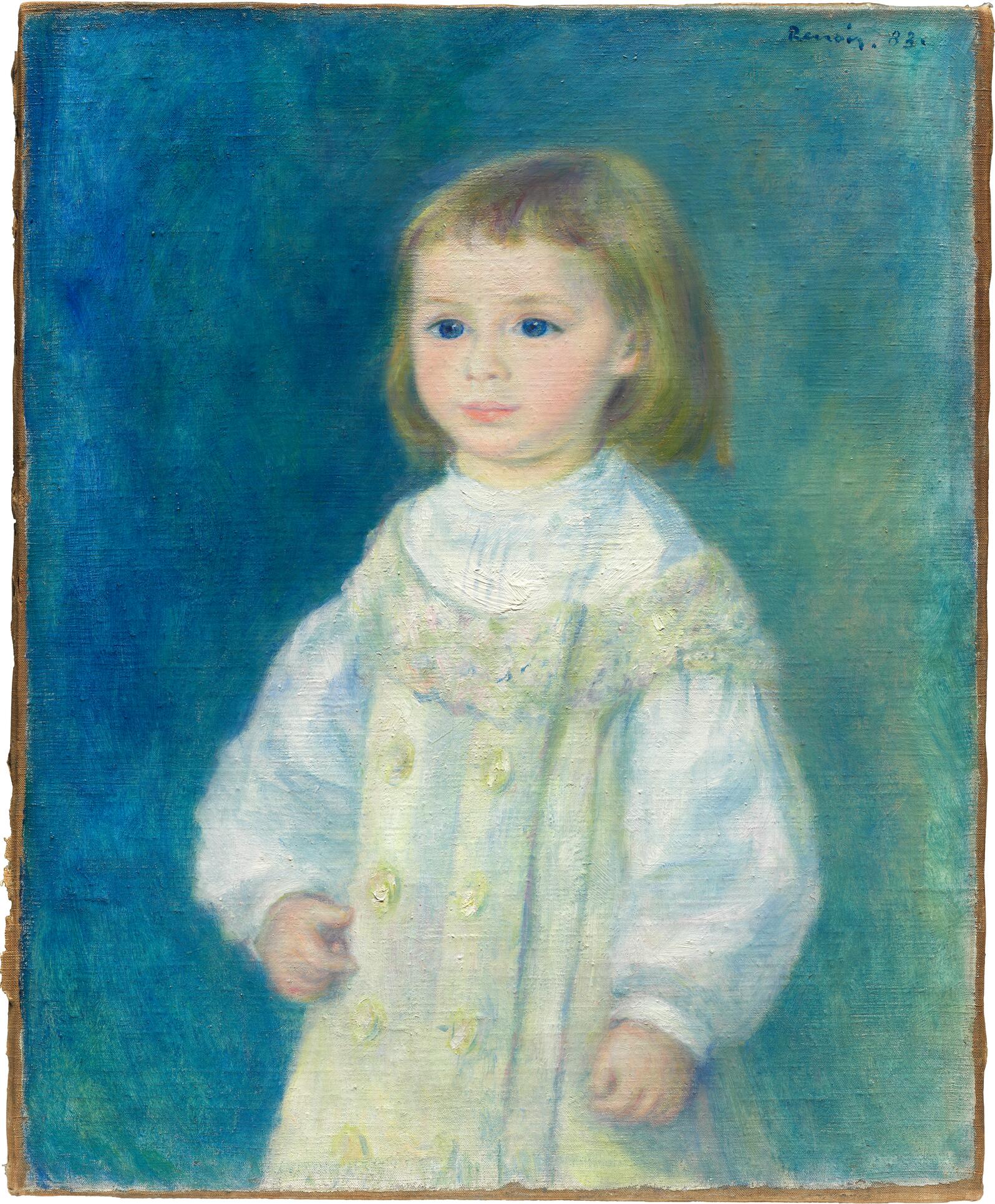
cat. 16 Lucie Berard (Child in White) (1883).

Detail of the signature in Renoir’s Lucie Berard (Child in White) (1883). The Art Institute of Chicago, 1933.1172.
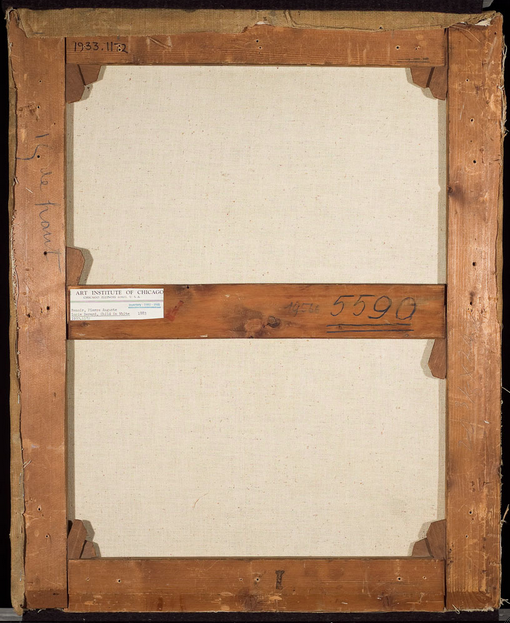
Verso of Renoir’s Lucie Berard (Child in White) (1883). The Art Institute of Chicago, 1933.1172.
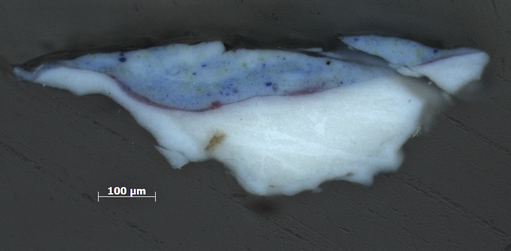
Photomicrograph of a cross section from the background in Renoir’s Lucie Berard (Child in White) (1883) showing the ground and thin red lake and thick, pale-blue paint layers. Original magnification: 100×. The Art Institute of Chicago, 1933.1172.
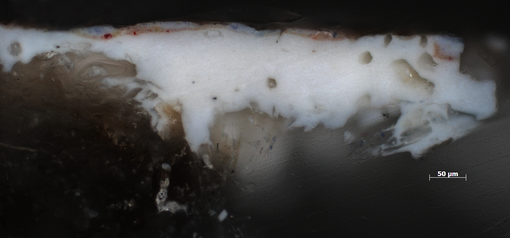
Photomicrograph of a cross section from Renoir’s Lucie Berard (Child in White) (1883) showing the canvas, ground, and thin paint layers. Original magnification: 200×. The Art Institute of Chicago, 1933.1172.
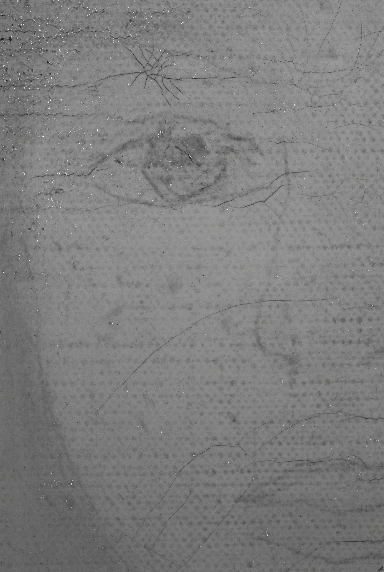
Infrared (Fuji, 1.0–1.1 µm) detail of the figure’s face in Renoir’s Lucie Berard (Child in White) (1883) showing the underdrawing material. The Art Institute of Chicago, 1933.1172.
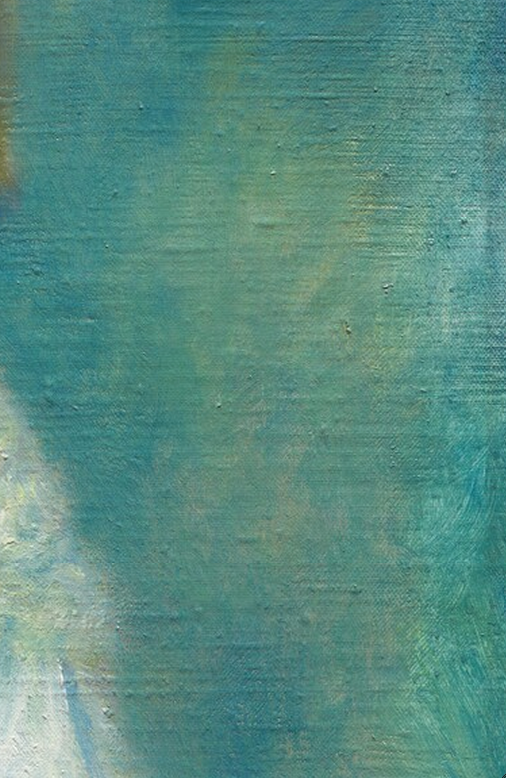
Detail of the background in Renoir’s Lucie Berard (Child in White) (1883) showing the warmer tones immediately around the figure. The Art Institute of Chicago, 1933.1172.
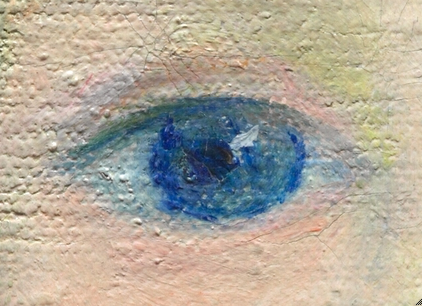
Detail of the figure’s right eye in Renoir’s Lucie Berard (Child in White) (1883) showing the white highlight added as a final touch. The Art Institute of Chicago, 1933.1172.
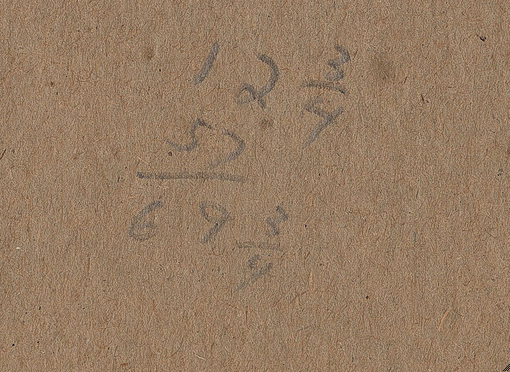
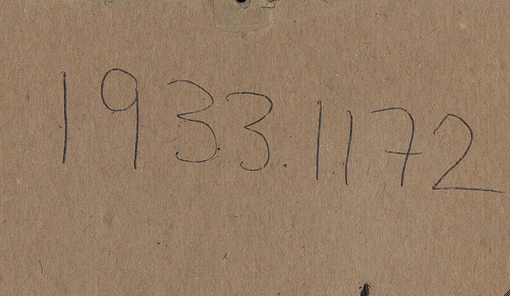
VRS oldbb AIC
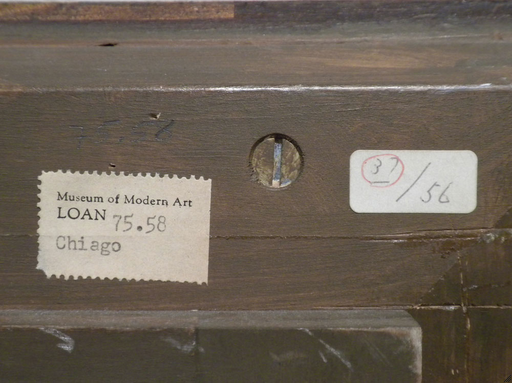
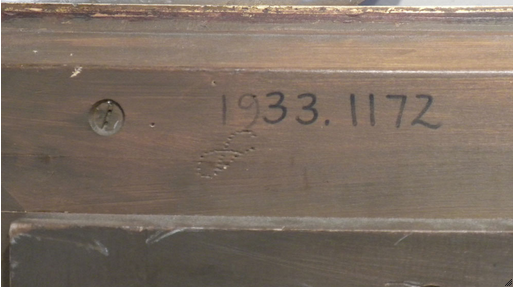
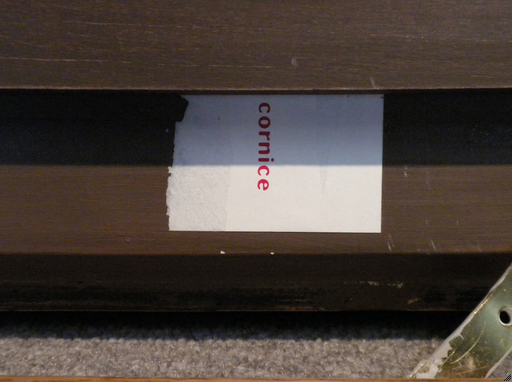
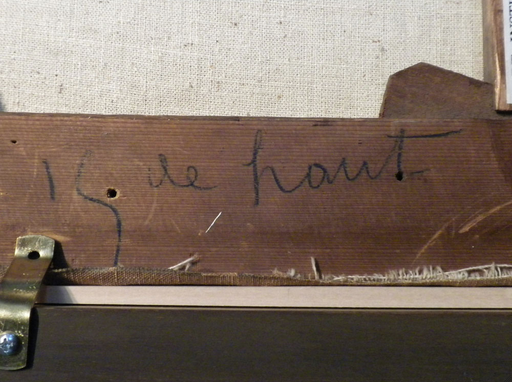
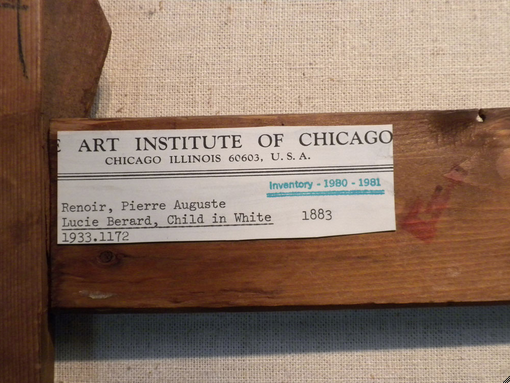
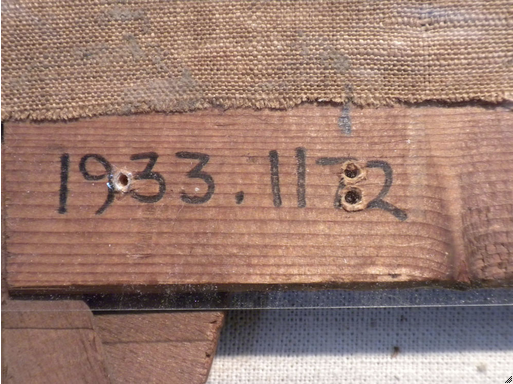
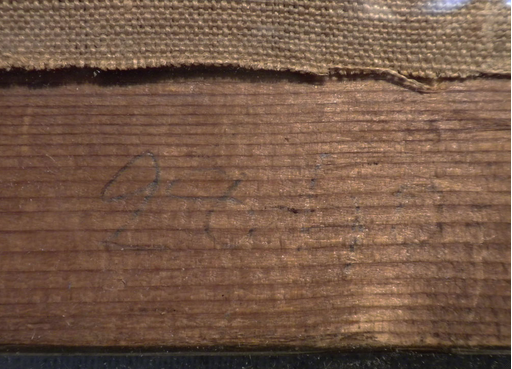
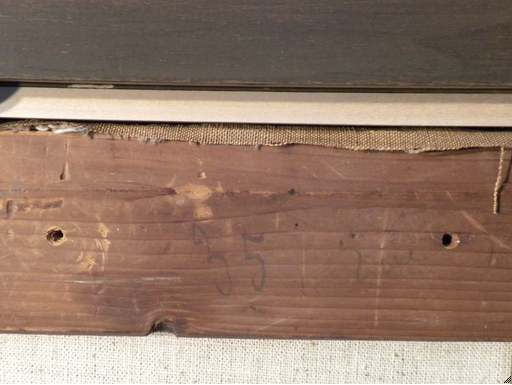
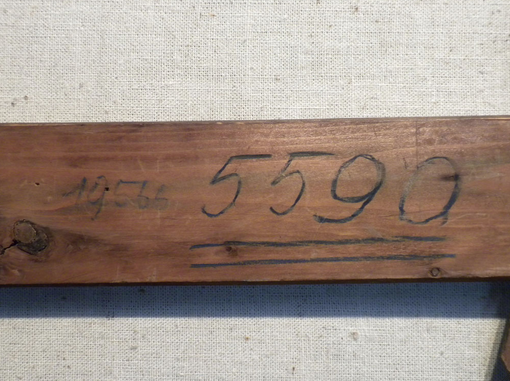
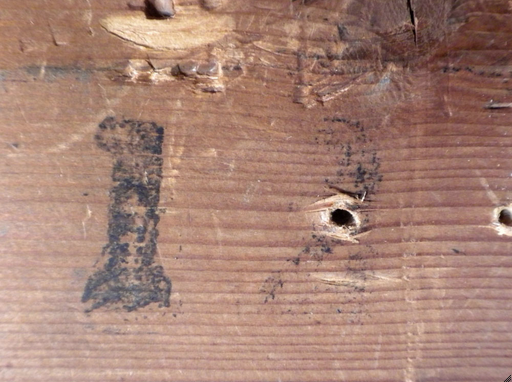
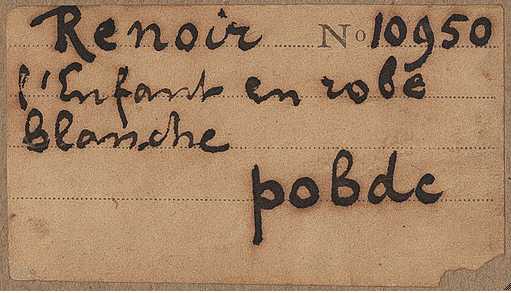
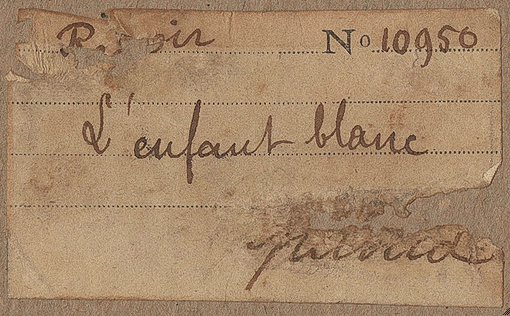
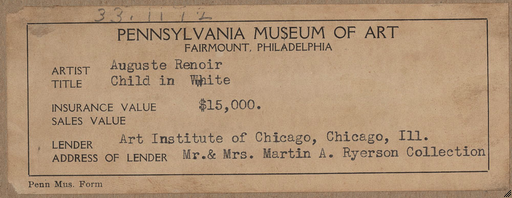
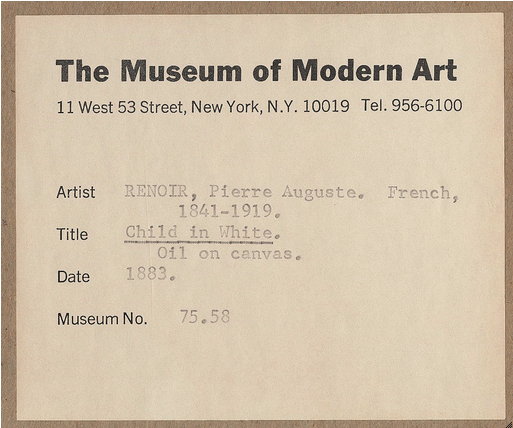
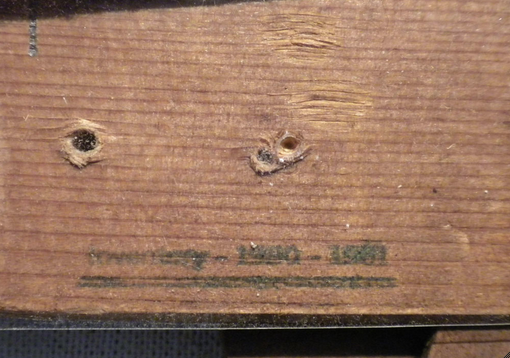
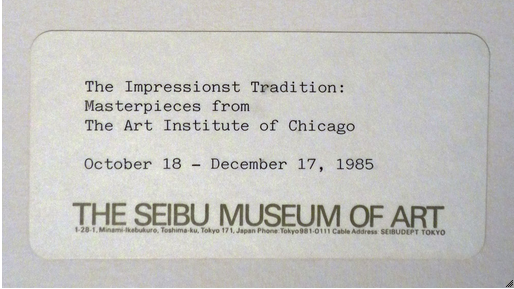
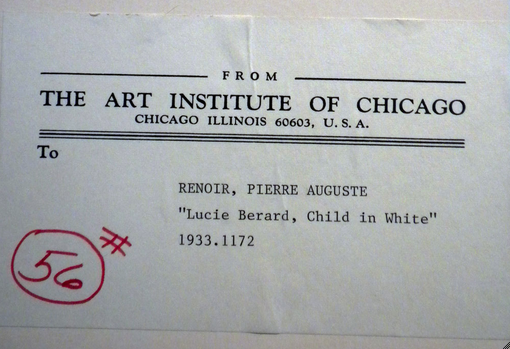
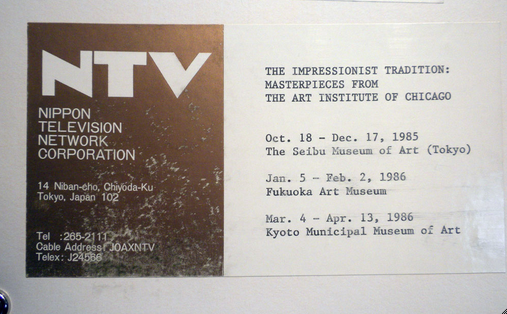
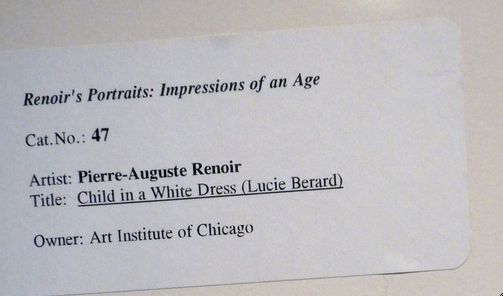
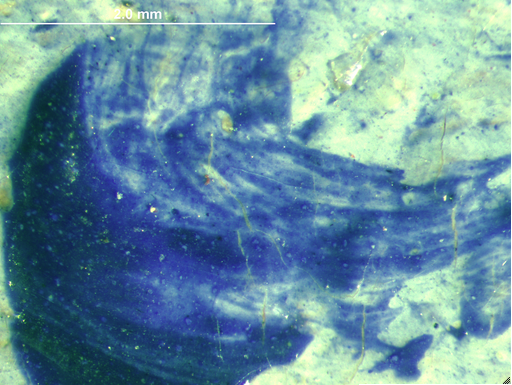
Photomicrograph of the signature in Renoir’s Lucie Berard (Child in White) (1883). The Art Institute of Chicago, 1933.1172.
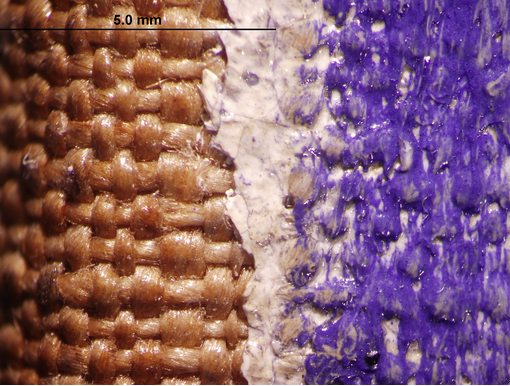
MIC 1
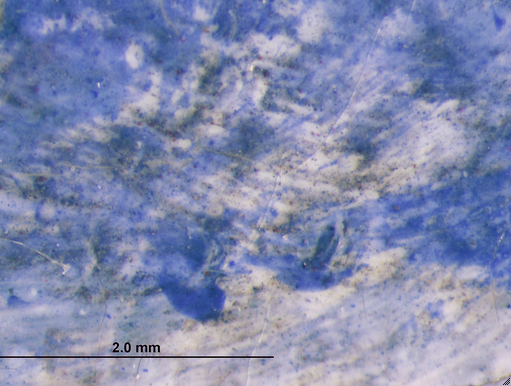
Photomicrograph of the figure’s left eye in Renoir’s Lucie Berard (Child in White) (1883). Particles of black underdrawing material are visible beneath the thin paint layers. The Art Institute of Chicago, 1933.1172.
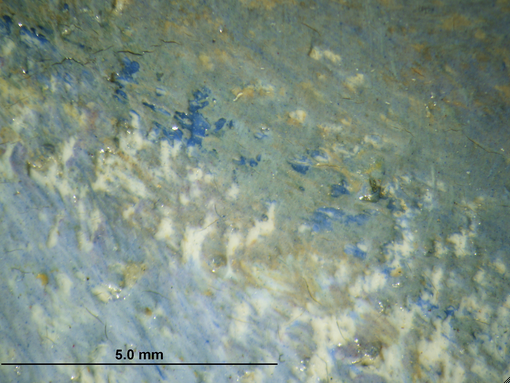
Photomicrograph of the blue painted underdrawing along the figure’s left shoulder in Renoir’s Lucie Berard (Child in White) (1883). The Art Institute of Chicago, 1933.1172.
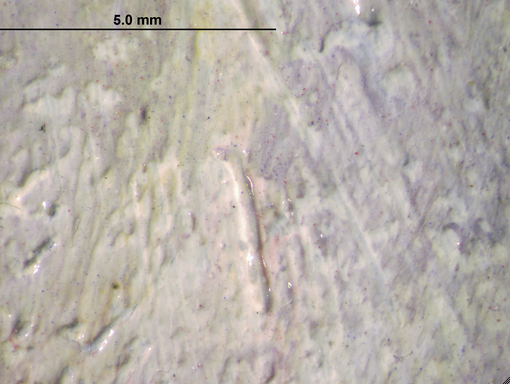
Photomicrograph of the figure’s costume in Renoir’s Lucie Berard (Child in White) (1883) showing paint consistency. The Art Institute of Chicago, 1933.1172.
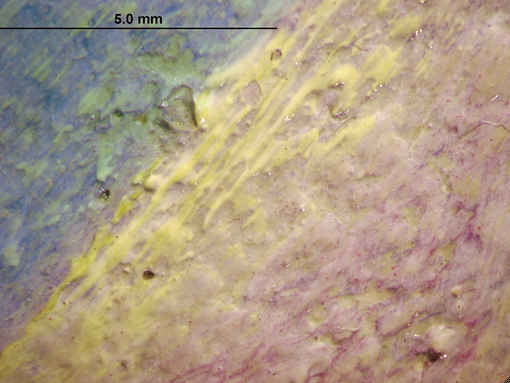
Photomicrograph of the figure’s hair in Renoir’s Lucie Berard (Child in White) (1883) showing wet-in-wet paint mixing. The Art Institute of Chicago, 1933.1172.
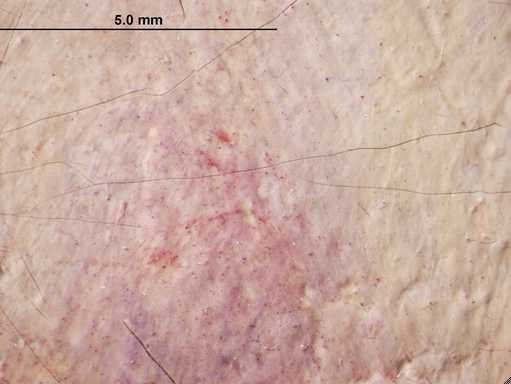
Photomicrograph of the smoothly blended flesh tones in Renoir’s Lucie Berard (Child in White) (1883). The Art Institute of Chicago, 1933.1172.
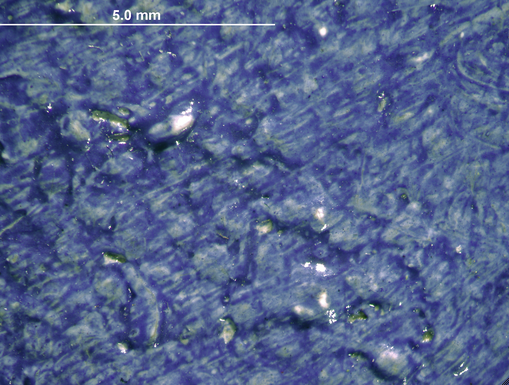
Photomicrograph of the background in Renoir’s Lucie Berard (Child in White) (1883). The Art Institute of Chicago, 1933.1172.
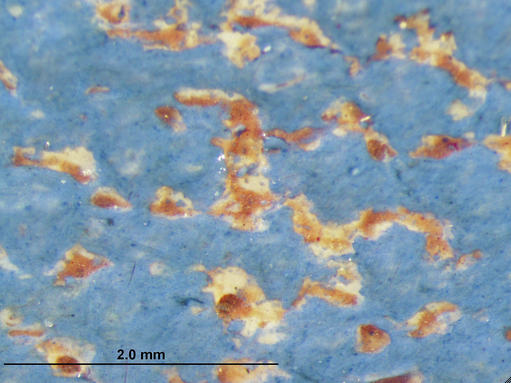
Photomicrograph of the background in Renoir’s Lucie Berard (Child in White) (1883) showing old, discolored varnish in the depressions of the paint. The Art Institute of Chicago, 1933.1172.
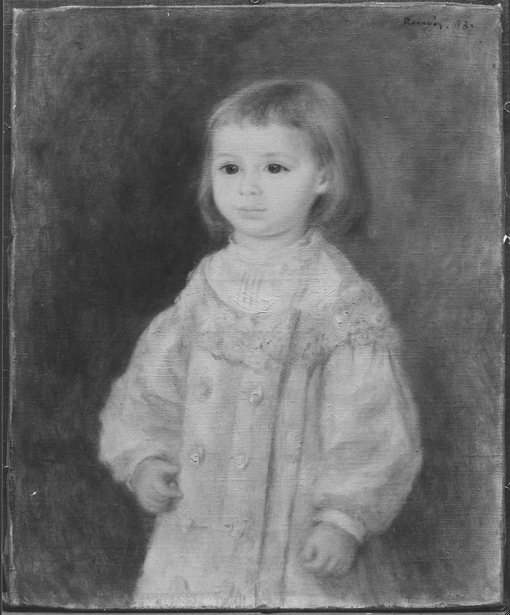
Undated archival photograph of Renoir’s Lucie Berard (Child in White) (1883), curatorial object file, Art Institute of Chicago.
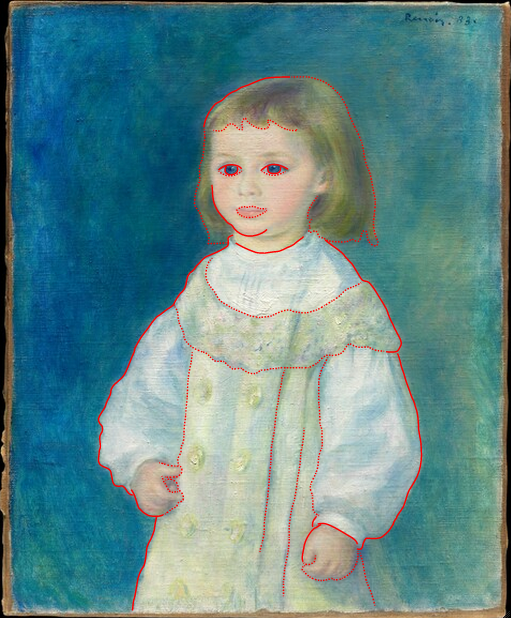
Renoir’s Lucie Berard (Child in White) (1883). The Art Institute of Chicago, 1933.1172. Interactive image.
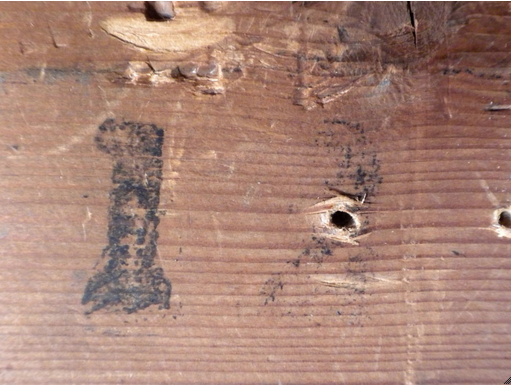
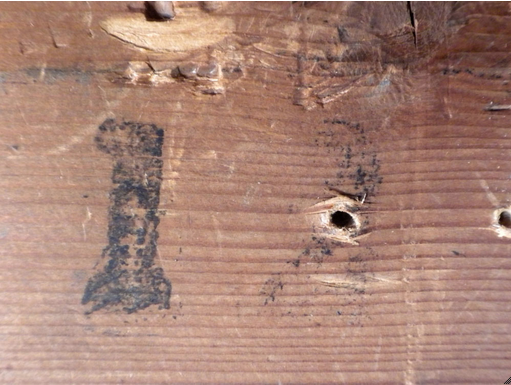
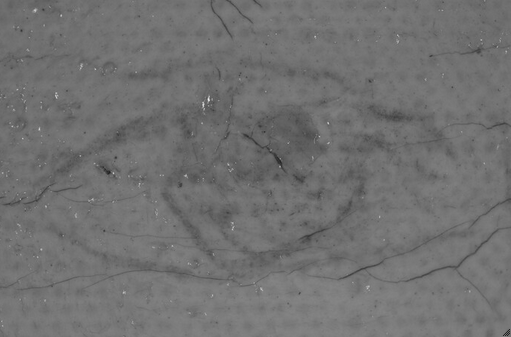
Infrared (Fuji, 1.0–1.1µm) and natural-light details of the figure’s right eye in Renoir’s Lucie Berard (Child in White) (1883). The Art Institute of Chicago, 1933.1172. Interactive image.
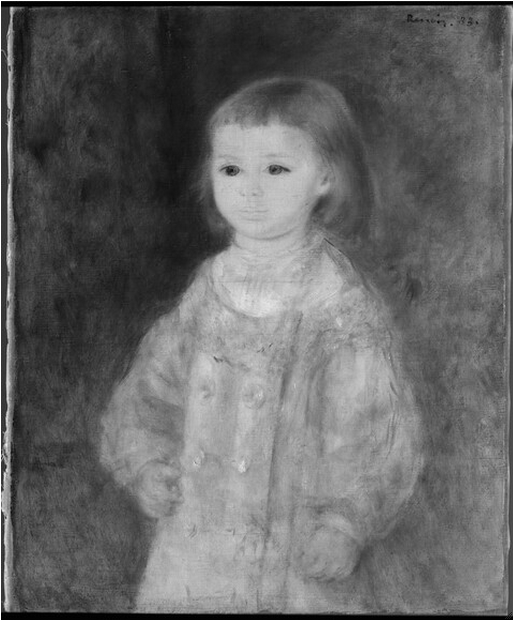
Infrared (Fuji, 1.0–1.1 µm, and Goodrich, 1.1–1.4 µm) and natural-light images of Renoir’s Lucie Berard (Child in White) (1883). The Art Institute of Chicago, 1933.1172. Interactive image.
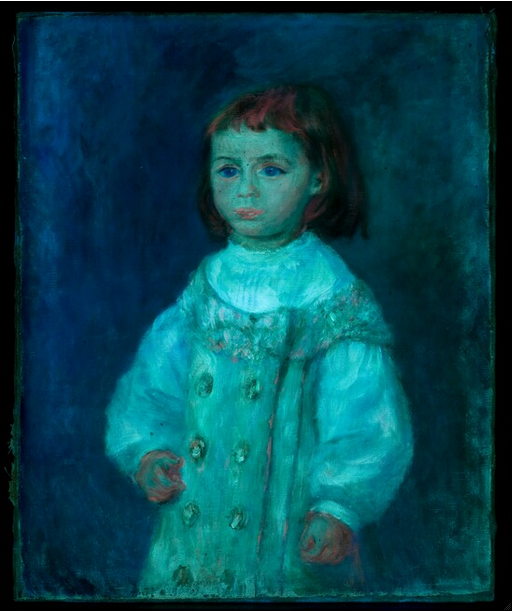
Ultraviolet image of Renoir’s Lucie Berard (Child in White) (1883). The Art Institute of Chicago, 1933.1172.
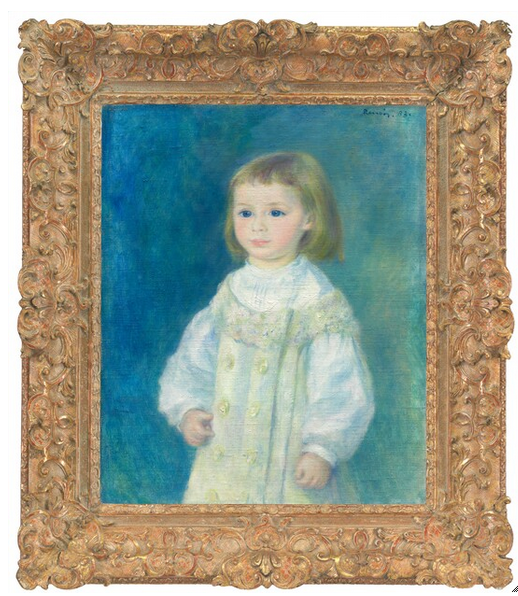
Renoir’s Lucie Berard (Child in White) (1883) in its current frame. The Art Institute of Chicago, 1933.1172.
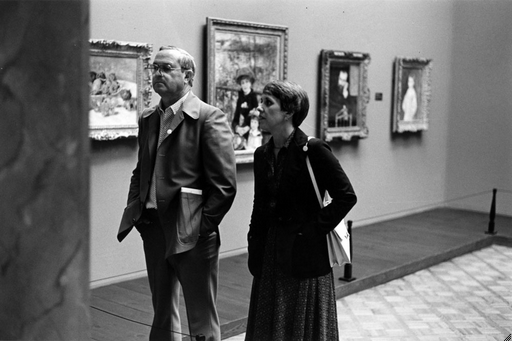
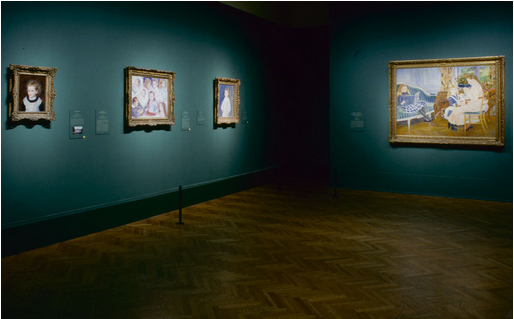
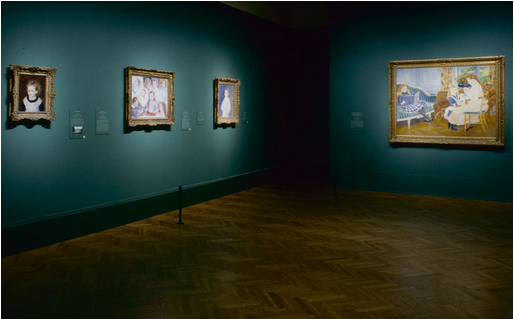
Installation of Renoir’s Lucie Berard (Child in White) (1883) in Renoir’s Portraits: Impressions of an Age, Art Institute of Chicago, Oct. 17, 1997–Jan. 4, 1998. Institutional Archives, Art Institute of Chicago.
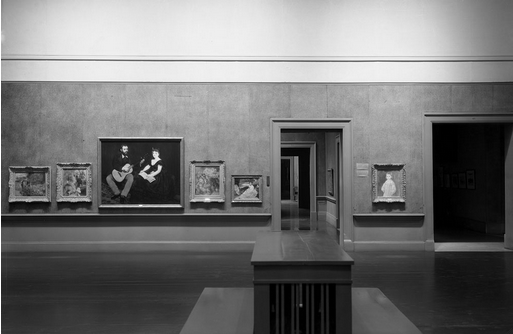
Renoir’s Lucie Berard (Child in White) (1883) in its current frame, seen here on the far right, installed in “A Century of Progress”: Loan Exhibition of Paintings and Sculpture, Art Institute of Chicago, May 23–Nov. 1, 1933. Institutional Archives, Art Institute of Chicago.
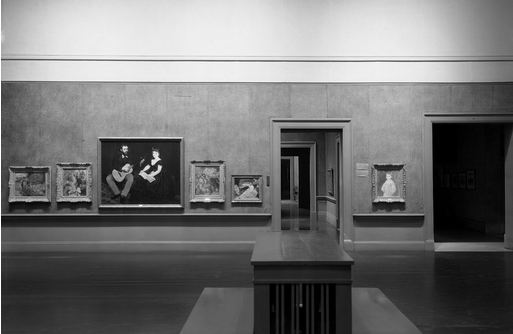
Installation of Renoir’s Lucie Berard (Child in White) (1883) in “A Century of Progress”: Loan Exhibition of Paintings and Sculpture, Art Institute of Chicago, May 23–Nov. 1, 1933. Institutional Archives, Art Institute of Chicago.
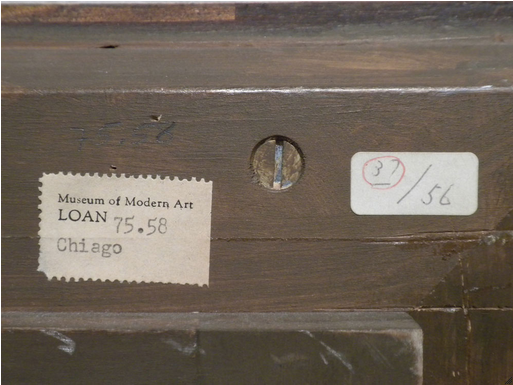
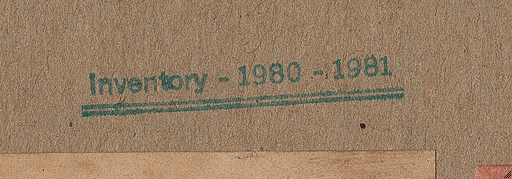
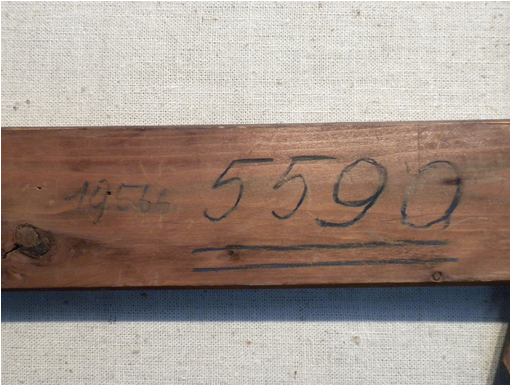
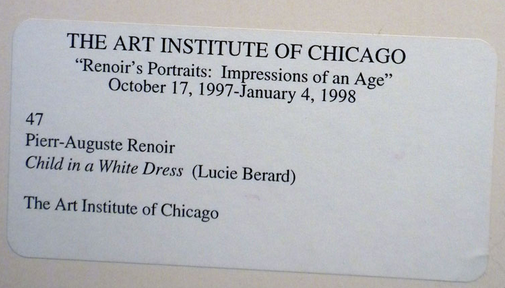
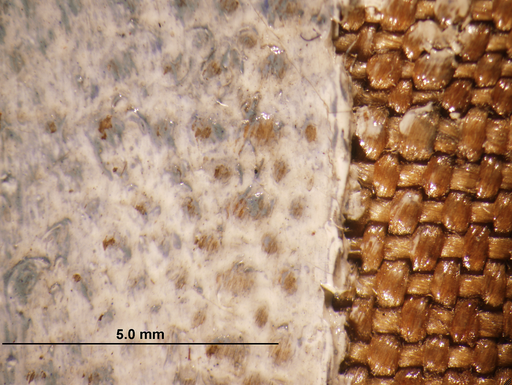
Photomicrograph of the edge of the preparation on Renoir’s Lucie Berard (Child in White) (1883). The Art Institute of Chicago, 1933.1172.
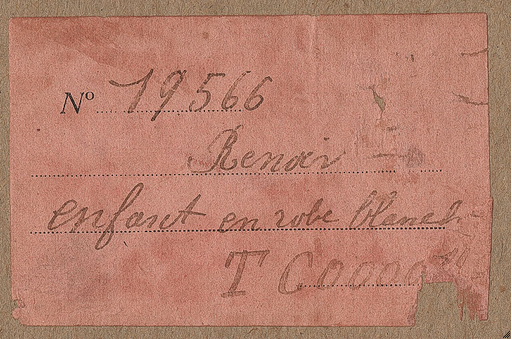
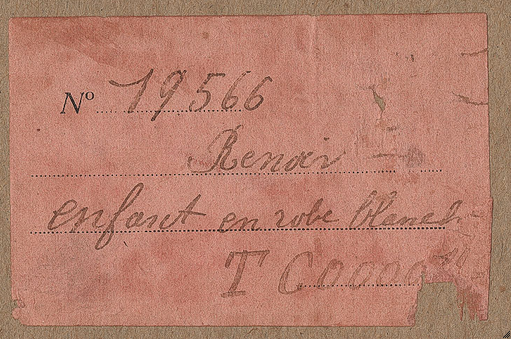
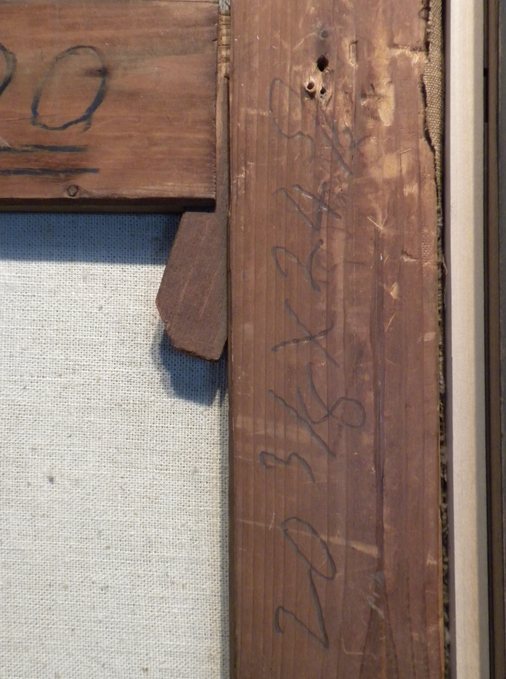
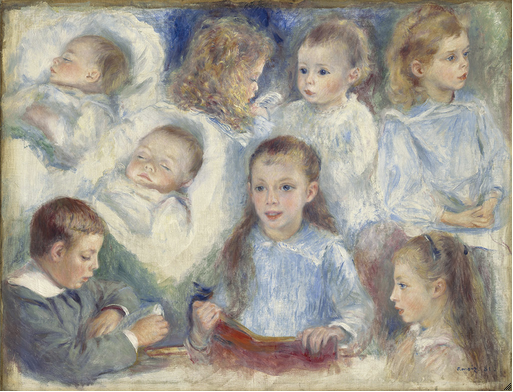
Pierre-Auguste Renoir (French, 1841–1919). Sketches of Heads (The Berard Children), 1881. Oil on canvas; 62.6 × 81.9 cm (24 5/8 × 32 1/4 in.). Sterling and Francine Clark Art Institute, Williamstown, Mass. Bridgeman Images.
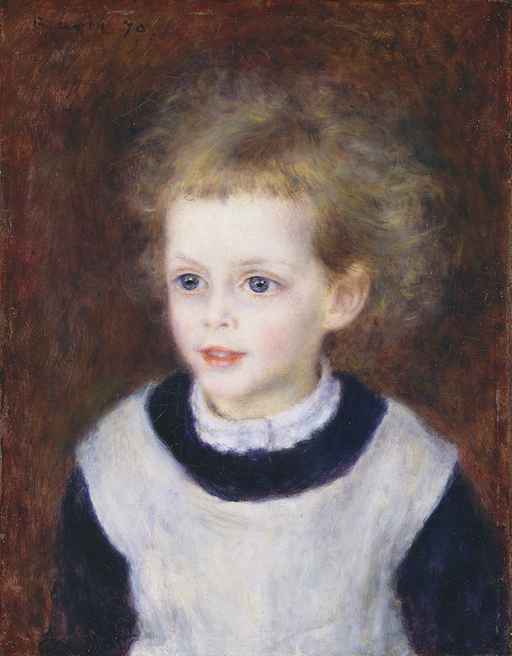
Pierre-Auguste Renoir (French, 1841–1919). Marguerite-Thérèse (Margot) Berard (1874–1956), 1879. Oil on canvas; 41 × 32.4 cm (16 1/8 × 12 3/4 in.). The Metropolitan Museum of Art, New York, Bequest of Stephen C. Clark, 1960, 61.101.15. Image copyright © The Metropolitan Museum of Art. Image source: Art Resource, NY.
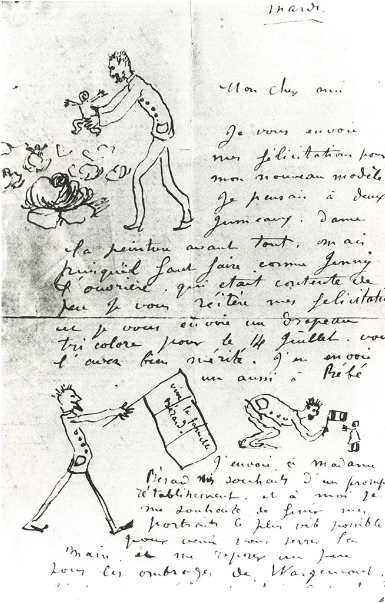
Letter from Renoir to Paul Berard congratulating him on the birth of his daughter Lucie in July 1880. Private collection.
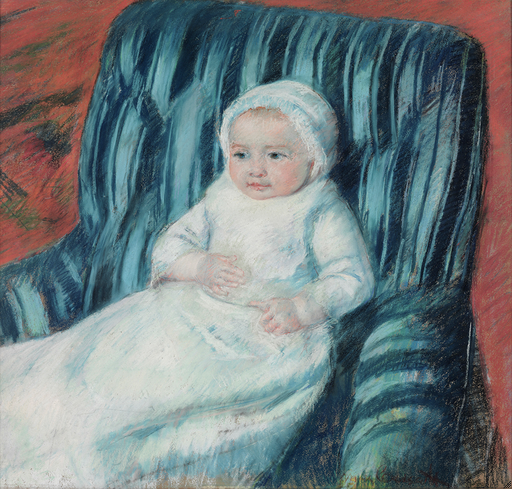
Mary Cassatt (American, 1844–1926). Madame Bérard’s Baby in a Striped Armchair, 1880–81. Pastel on paper; 63.5 × 67.3 cm (25 × 26 1/2 in.). Philadelphia Museum of Art, 2011-58-4, Gift of John C. Haas and Chara C. Haas, 2011. Bridgeman Images.
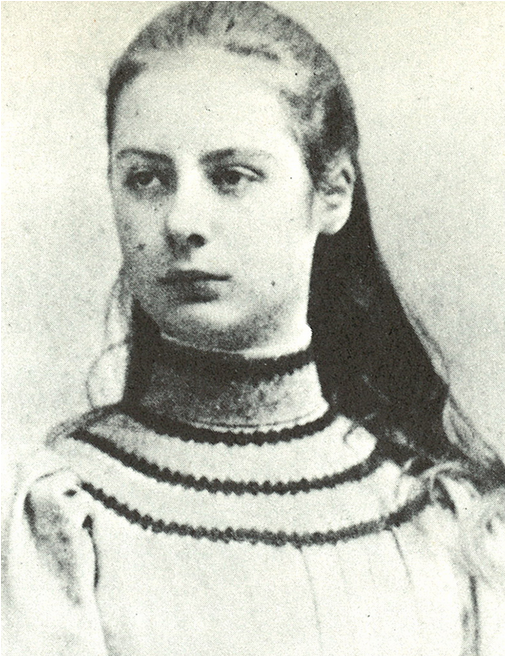
Photograph of Lucie Berard, about 1888. Private collection.
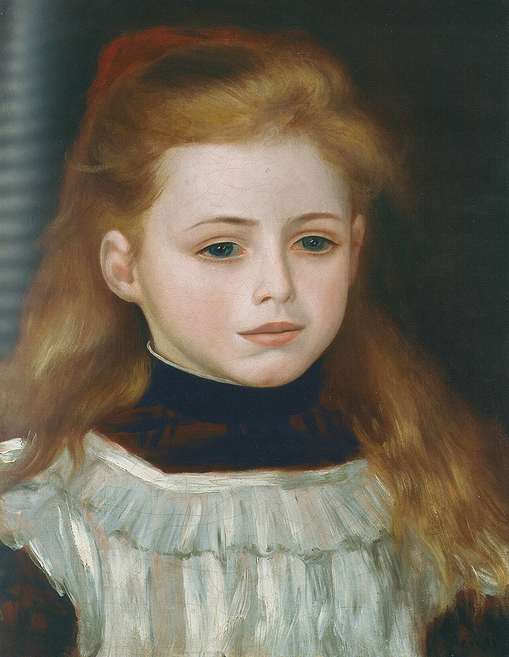
Pierre-Auguste Renoir (French, 1841–1919). Lucie Berard in a White Pinafore, 1884. Oil on canvas; 35 × 27 cm (13 13/16 × 10 5/8 in.). Private collection.
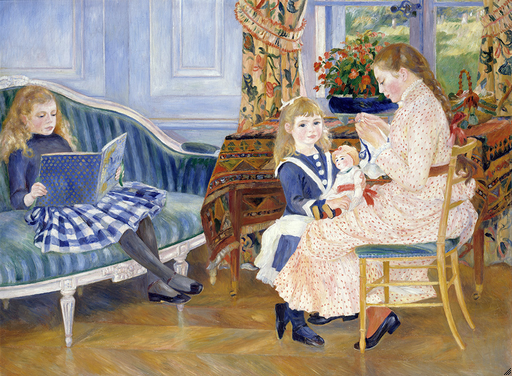
Pierre-Auguste Renoir (French, 1841–1919). Children’s Afternoon at Wargemont, 1884. Oil on canvas; 127 × 173 cm (50 × 68 1/8 in.). Nationalgalerie, Berlin. Photo © AISA / Bridgeman Images.
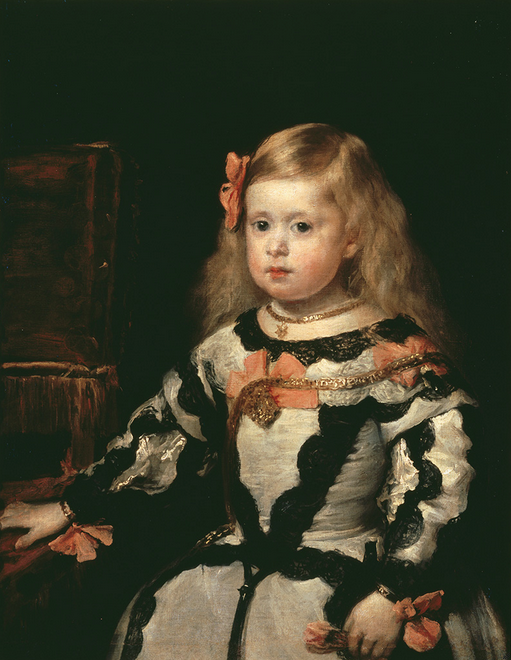
Workshop of Diego Rodríguez de Silva y Velázquez (Spanish, 1599–1660). Infanta Margarita, c. 1653. Oil on canvas; 70 × 58 cm (27 1/2 × 23 in.). Musée du Louvre, Paris, 941. Alinari/Art Resource, NY.
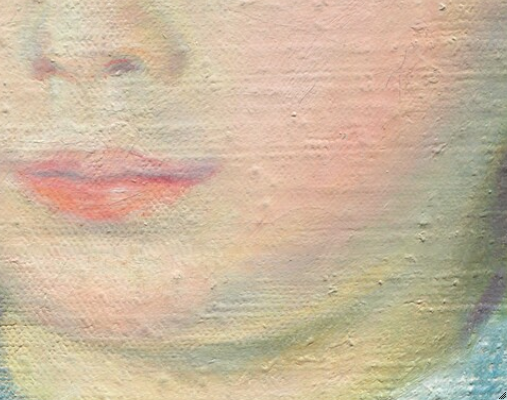
Detail of the figure’s face in Renoir’s Lucie Berard (Child in White) (1883) showing the delicate flesh tones. Art Institute of Chicago, 1933.1172.
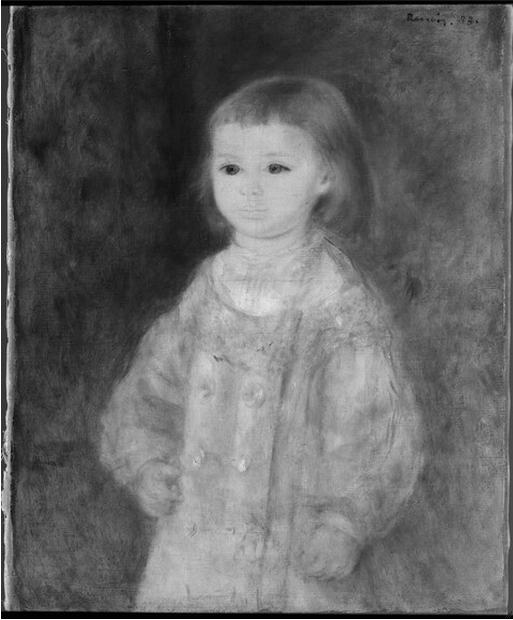
Two infrared (Goodrich, 1.1–1.4 µm, and Fuji, 1.0–1.1) images, each revealing a separate underdrawing campaign, and a natural-light image of Renoir’s Lucie Berard (Child in White) (1883). Art Institute of Chicago, 1933.1172. Interactive image.
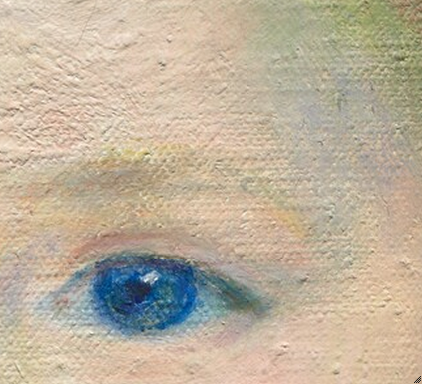
Detail of the figure’s left eye and forehead in Renoir’s Lucie Berard (Child in White) (1883) showing the visibility of the canvas texture. Art Institute of Chicago, 1933.1172.
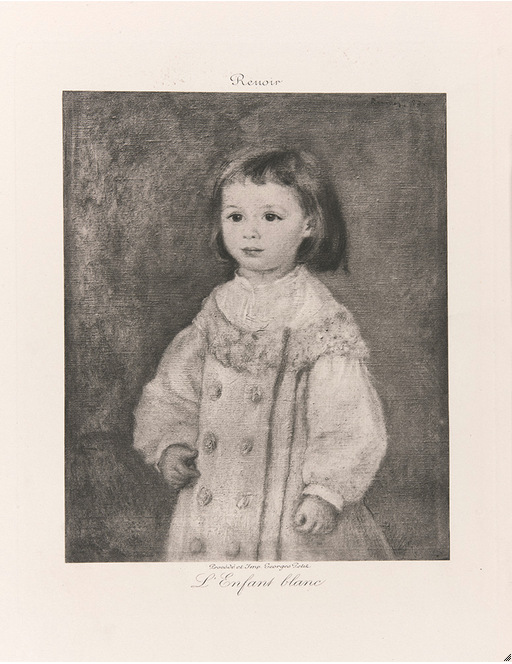
Photograph of Renoir’s Lucie Berard (Child in White) that appeared in Catalogue des tableaux moderne, aquarelles, pastels . . . Provenant de la collection de feu M. Paul Berard, sale cat. (Georges Petit, Paris, May 8–9, 1905), lot no. 20.
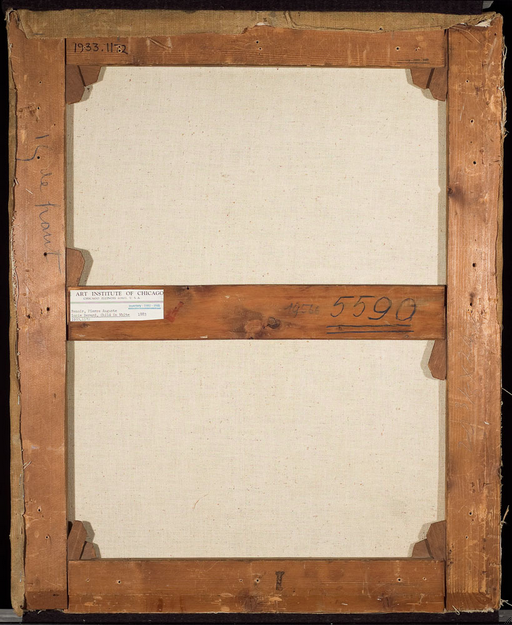
Verso of Renoir’s Lucie Berard (Child in White) (1883) showing the unevenly cut edges of the canvas. Art Institute of Chicago, 1933.1172.
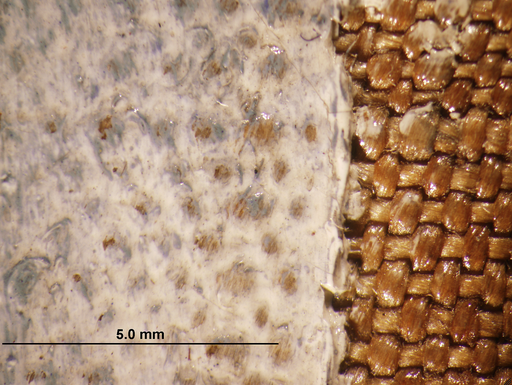
Photomicrograph of Renoir’s Lucie Berard (Child in White) (1883), showing the edge of the ground application. Art Institute of Chicago, 1933.1172.

Backscattered electron image of the ground and paint layers in Renoir’s Lucie Berard (Child in White) (1883). The slight variation in apparent density throughout the ground layer may indicate successive applications. Original magnification: 120×. The Art Institute of Chicago, 1933.1172.
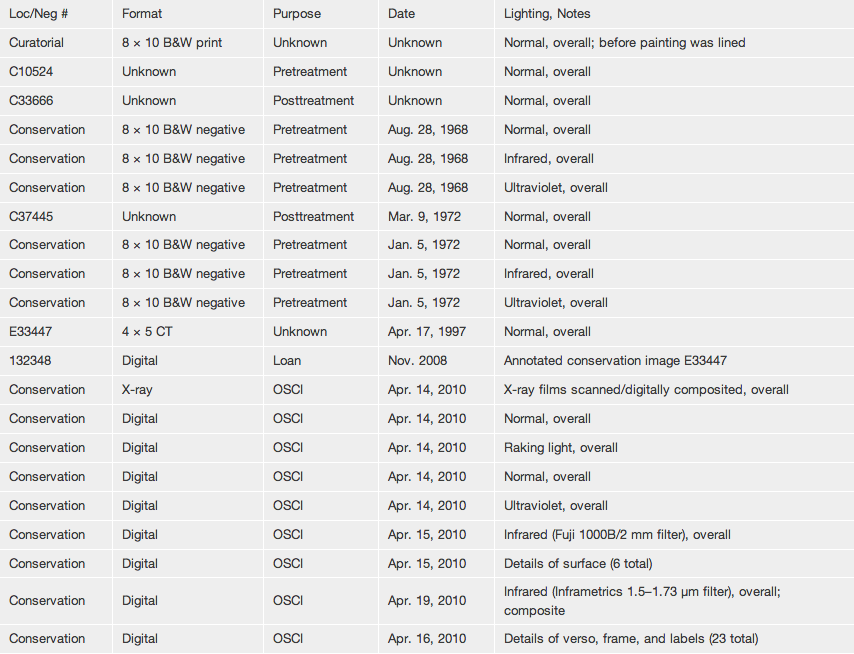
| Loc/Neg # | Format | Purpose | Date | Lighting, Notes |
| Curatorial | 8 × 10 B&W print | Unknown | Unknown | Normal, overall; before painting was lined |
| C10524 | Unknown | Pretreatment | Unknown | Normal, overall |
| C33666 | Unknown | Posttreatment | Unknown | Normal, overall |
| Conservation | 8 × 10 B&W negative | Pretreatment | Aug. 28, 1968 | Normal, overall |
| Conservation | 8 × 10 B&W negative | Pretreatment | Aug. 28, 1968 | Infrared, overall |
| Conservation | 8 × 10 B&W negative | Pretreatment | Aug. 28, 1968 | Ultraviolet, overall |
| C37445 | Unknown | Posttreatment | Mar. 9, 1972 | Normal, overall |
| Conservation | 8 × 10 B&W negative | Pretreatment | Jan. 5, 1972 | Normal, overall |
| Conservation | 8 × 10 B&W negative | Pretreatment | Jan. 5, 1972 | Infrared, overall |
| Conservation | 8 × 10 B&W negative | Pretreatment | Jan. 5, 1972 | Ultraviolet, overall |
| E33447 | 4 × 5 CT | Unknown | Apr. 17, 1997 | Normal, overall |
| 132348 | Digital | Loan | Nov. 2008 | Annotated conservation image E33447 |
| Conservation | X-ray | OSCI | Apr. 14, 2010 | X-ray films scanned/digitally composited, overall |
| Conservation | Digital | OSCI | Apr. 14, 2010 | Normal, overall |
| Conservation | Digital | OSCI | Apr. 14, 2010 | Raking light, overall |
| Conservation | Digital | OSCI | Apr. 14, 2010 | Normal, overall |
| Conservation | Digital | OSCI | Apr. 14, 2010 | Ultraviolet, overall |
| Conservation | Digital | OSCI | Apr. 15, 2010 | Infrared (Fuji 1000B/2 mm filter), overall |
| Conservation | Digital | OSCI | Apr. 15, 2010 | Details of surface (6 total) |
| Conservation | Digital | OSCI | Apr. 19, 2010 | Infrared (Inframetrics 1.5–1.73 µm filter), overall; composite |
| Conservation | Digital | OSCI | Apr. 16, 2010 | Details of verso, frame, and labels (23 total) |
| Conservation | Digital | OSCI | Apr. 21, 2010 | Infrared (Fuji 1000B/2 mm filter), media details (3 total) |
| Conservation | Digital | OSCI | Apr. 22, 2010 | Photomicrographs of sample sites and surface (21 total) |
| Conservation | Digital | OSCI | Apr. 23, 2010 | Specular light, overall |
| G33620 | Digital | OSCI | Apr. 27, 2010 | Normal, overall |
| G33621 | Digital | OSCI | Apr. 27, 2010 | Normal, frame only |
| G33622 | Digital | OSCI | Apr. 27, 2010 | Composite with frame |
| G33623 | Digital | OSCI | Apr. 27, 2010 | Ultraviolet, overall |
| G33624 | Digital | OSCI | Apr. 27, 2010 | Normal, detail: shirt buttons |
| G33625 | Digital | OSCI | Apr. 27, 2010 | Normal, detail: middle right side |
| G33626 | Digital | OSCI | Apr. 27, 2010 | Normal, detail: face |
| G33627 | Digital | OSCI | Apr. 27, 2010 | Normal, detail: signature |
| G39044 | Digital | OSCI | Jan. 31, 2012 | Normal, overall; composite of G39417–G39425 |
| G39045 | Digital | OSCI | Jan. 31, 2012 | Ultraviolet, overall |
| G39046 | Digital | OSCI | Jan. 31, 2012 | Normal, frame only |
| G39417 | Digital | OSCI | Jan. 31, 2012 | Section |
| G39418 | Digital | OSCI | Jan. 31, 2012 | Section |
| G39419 | Digital | OSCI | Jan. 31, 2012 | Section |
| G39420 | Digital | OSCI | Jan. 31, 2012 | Section |
| G39421 | Digital | OSCI | Jan. 31, 2012 | Section |
| G39422 | Digital | OSCI | Jan. 31, 2012 | Section |
| G39423 | Digital | OSCI | Jan. 31, 2012 | Section |
| G39424 | Digital | OSCI | Jan. 31, 2012 | Section |
| G39425 | Digital | OSCI | Jan. 31, 2012 | Section |
Madame Léon Clapisson1041
1883
Oil on canvas; 81.2 × 65.3 cm (32 × 25 3/4 in.)
Signed and dated: Renoir 83. (upper right, in purple paint)
The Art Institute of Chicago, Mr. and Mrs. Martin A. Ryerson Collection, 1933.1174
In a sleeveless gown of deep blue that complements her eye color, this confident socialite, the thirty-three-year-old Marie Henriette Valentine Clapisson, née Billet, is dressed for the ballroom.1042 Her costume is consistent with the elongated silhouette of the ball gowns appearing in the pages of the Journal des demoiselles (fig. 2.10).1043 Featuring a close-fitting bodice, possibly of smooth velvet, the dress strikes a formal note with its simple band of sheer trim running along the neckline and shoulders. The strong line of the bodice contrasts with the exaggerated volumes of the ruffled bustle, also dark blue but made of shimmering, pleated silk accented with translucent red and yellow. Gold, silver, and amber bracelets over gloves the color of chamois leather provide contrasting tones and reflect the light. The white feather fan Madame Clapisson holds echoes her exotic hair adornment in texture and form. As rendered by Renoir, the overall effect of her costume is subtly elegant and seems calculated to demonstrate a progressive fashion sense.
Renoir claimed to have met the Clapissons at a salon hosted by Marguerite Charpentier, wife of publisher Georges Charpentier, a collector of Impressionist art since 1875.1044 The Charpentiers were leaders in matters of taste within their social circle. They lent a bust portrait of Marguerite (1876; Musée d’Orsay, Paris [Daulte 226; Dauberville 465]) to the third Impressionist exhibition, which opened in April 1877, and they would no doubt have alerted their circle to the article by Georges Rivière in the April 21 issue of L’impressionniste urging wives of good Republicans to let an Impressionist paint “a ravishing portrait that will capture the charm with which you are gifted.”1045 In April 1879, Charpentier’s publishing house launched La vie moderne, a literary and social journal edited by Émile Bergerat that featured regular reviews of art exhibitions, including those of the Impressionists, and reproduced illustrations and drawings by Renoir.1046 The gallery of La vie moderne, situated at its offices on the boulevard des Italiens, hosted the first solo exhibition of Renoir’s work (mostly pastels) in June 1879, the fifth in a series devoted to contemporary artists.
The Clapissons were typical of the readers of La vie moderne—culturally broad-minded enough to speculate in Impressionist painting but still supportive of the jury system of the annual Salon and of change from within. Léon Clapisson (fig. 2.11), son of the composer Antoine-Louis Clapisson, was a businessman who dabbled in stocks and real estate and had a passion for art collecting. As Anne Distel discovered, Léon already possessed a considerable fortune when he married Valentine (fig. 2.14), thirteen years his junior, in 1865.1047 Clapisson began collecting seriously in 1879, and by the end of May 1882 he had acquired his first Renoir works from the art dealer Paul Durand-Ruel: three paintings that the artist had brought back from a trip to Algeria in March and April.1048 In a short period Clapisson amassed some 116 works, including works by artists of the Barbizon and Realist Schools. In addition to Renoir, Impressionist artists in his collection included Claude Monet, Gustave Caillebotte, Mary Cassatt, Berthe Morisot, Camille Pissarro, and Alfred Sisley. By 1885, however, Clapisson began selling his collection.1049
Given the pace of Clapisson’s acquiring in the early 1880s, it seems understandable that Renoir may have mistaken this collecting activity for a commitment to the aesthetic principles of Impressionism. However, the commission to paint Madame Clapisson’s portrait proved to be one of the most frustrating of his career: the client rejected his initial attempt, now known as Among the Roses (fig. 2.17 [Daulte 428; Dauberville 1044]), and required him to paint the more conservative second version now in the collection of the Art Institute of Chicago.1050 This second version of Madame Clapisson’s portrait is the “city” to the first version’s “country”; the studied, sensual image of social ambition to the quintessential Impressionist female model in a garden setting—a work “full of gaiety and sunlight,” as Georges Rivière described the style of painting he recommended to potential portrait clients in 1877.1051 Renoir painted Among the Roses in the garden of the recently built Clapisson villa on the rue Charles Laffitte, Neuilly-sur-Seine (fig. 2.18). The artist apparently brought more than one canvas from Paris and stayed in Neuilly for about two weeks.1052 The first portrait, however, was the only painting he completed there.
In this first version of the Clapisson portrait, Renoir’s placement of Valentine in the middle ground and his decision to portray her garden as a rustic, overgrown park in Montmartre turned out to be ill conceived. Perhaps he had in mind Édouard Manet’s melancholic late canvas The Artist’s Garden at Versailles of 1881 (fig. 2.6), just purchased by Léon Clapisson the previous month, though the two could not be further apart in mood and gestural depiction of garden elements. By June 22 his client’s patience had apparently worn thin, and Renoir realized he had taken the wrong approach. He wrote to his friend and patron Paul Berard, including in the letter a quick sketch of his work in progress (fig. 2.7): “This wretched portrait . . . will not work . . . my days are spent taking the canvas back indoors . . . after making this exquisite woman put on a spring dress . . . and every day the same thing.”1053 The sketch reveals that Renoir was already near completion of the work, and the fact that he could describe Madame Clapisson’s costume down to the “lace trim” and “little blue hat with a rooster” indicates that he took some pride in his work, even if his client grew dissatisfied.1054 Though the Clapissons returned the first version to the artist later in the year, it did not languish as a failed portrait but rather was reinvented and circulated in exhibitions for years as a genre painting of contemporary life.1055
By the autumn of 1882 the Clapissons had decided to return the first portrait with the expectation that Renoir would paint another with an indoor setting. This turn of events weighed heavily on the artist. It challenged the artistic ideals he had cultivated over the 1870s and forced him to accept the necessity of compromise if he wished to pursue portrait painting. He complained to Berard of how the commission affected his artistic license: “It’s not going well for the moment. I must begin Mme. Clapisson’s portrait all over again. It’s a big flop. . . . Well, all this takes a lot of thought, and with no exaggeration I must be careful if I don’t want to slip in the public’s esteem.” He continues, expressing with some sarcasm his bitter resignation to the more conventional approach to portraiture epitomized by the successful society portraitist Léon Bonnat: “I’m going to get back on the right path and I’m going to enlist in Bonnat’s studio. In a year or two I’ll be able to make 30,000,000,000,000 francs a year. Don’t talk to me any more about portraits in the sunlight. Nice black backgrounds, that’s the real thing. As soon as I have a minute, I’ll come and copy the portrait [by Bonnat] of M. d’Haubersart [Comte d’Haubersart, Berard’s grandfather].”1056 While Renoir was not so richly compensated as Bonnat, he did receive the respectable sum of 3,000 francs for the Clapisson commission.1057 Renoir’s anxiety over the portrait is perhaps partly explained by the high fee—twice as much as he reportedly earned in 1878 for the much larger Madame Georges Charpentier and Her Children (1878; Metropolitan Museum of Art, New York [Daulte 226; Dauberville 239])—but was probably also due to his fear of alienating potential patrons within the Charpentier-Clapisson circle.1058
The circumstances surrounding the first version of the portrait of Madame Clapisson highlight a crisis in Renoir’s Impressionist enterprise that ultimately led to a remarkable change of technique and the emergence of his “Ingresque” manner, the so-called sour or dry style, the masterpieces of which are Children’s Afternoon at Wargemont (1884; Nationalgalerie, Berlin [Daulte 457; Dauberville 965]) and The Great Bathers (1884–87; Philadelphia Museum of Art [Daulte 514; Dauberville 1292]).1059 To satisfy his clients, Renoir returned to the easel to paint a portrait of Madame Clapisson in a traditional setting with what the art critic Théodore Duret, in his biography of the artist, described as “tons plus sobres.”1060 Though the firmer modeling of the second version can be compared to the academic-style portraits of Jean-Auguste-Dominique Ingres (see fig. 2.12), close examination of the brushstrokes within the dress, hair, fan, and background reveals that Renoir gave up nothing of his gestural randomness (fig. 2.13).
Renoir had used the dark backgrounds commonly seen in conventional society portraiture before, for example, in the series he executed of the Berard children in 1879 (see fig. 2.16 [Daulte 284; Dauberville 502]).1061 The backgrounds of the Berard portraits contain subtle color harmonies and are visually active in their brushwork and distribution of paint. Returning to such a background for the second version of the Clapisson portrait, Renoir proceeded to create a more sober look by first diminishing the luminosity of the white ground with mossy green, rusty red, and earthy yellow colors. These initial background colors were later painted out with the current crosshatched pattern of purples, pinks, and blues. This second background finish once looked much darker than it does today. When the painting is unframed, a small margin of dark red can be seen around the edges of the canvas (fig. 2.15). These edges have been protected from fading by the frame rebate and so retain their original color. The extension of this rich burgundy tone from the margins through some or all of the canvas behind the figure of Madame Clapisson completely alters not only the modulation of color in the background but also our understanding of how Renoir intended the red tone to balance with the dark blue of her dress and the lighter flesh tones.1062
Despite his acceptance of this change in approach for the second version of the portrait of Madame Clapisson, it became a source of frustration for Renoir, who wrote to Berard as it was under way in early 1883: “I cannot tell whether it will turn out to look much like her, since I am no longer capable of judging for myself.”1063 Admonished and having amended his overly bold Impressionist portrait style, the artist sent the finished canvas to the Salon exhibition that opened May 1, 1883, where it was neglected by the many critics who reviewed the show, possibly because they perceived it as a compromise of styles. In spite of this disregard, Renoir had every reason to be optimistic about his career during the first half of 1883, with the completion of his three major full-length dance paintings and the April opening of his retrospective exhibition on the boulevard de la Madeleine, part of a series of solo Impressionist exhibitions organized by Durand-Ruel.1064 In his preface to the catalogue, Duret proclaimed Renoir the figure painter of Impressionism, especially of women, and his reputation as a portraitist seemed assured.1065
Perhaps it was disappointment at the meager return on his investment of time, canvas, and money that affected Renoir’s mood later in the year, but the difficulties he experienced with the Clapisson portrait commission and the cool reception the second version received at the Salon continued to haunt him. John Lewis Brown, who exhibited with the Impressionists in London in 1883, wrote to Durand-Ruel that September, noting that the Salon jury’s issues with the Clapisson portrait were only to Renoir’s credit: “The gentlemen of the jury could not help exclaiming (for the admission) that his painting was a ‘blonde’ Delacroix. What medal equals such appreciation from one’s enemies?”1066 In December 1883 Berard, Renoir’s confidant throughout the trying period of the Clapisson portrait, remarked on the toll it had taken on his friend. Writing to collector Charles Deudon, he expressed his concern: “As far as Renoir, he is in a crisis of discouragement. His vast studio scares him and he can’t do anything there; except for the portrait of Mme Clapisson, I have seen nothing new and he has no new commissions.”1067 While the self-doubt and uncertainty prompted by the Clapisson commission seemed insurmountable at the time, it nevertheless helped Renoir to develop as an artist and move on to further artistic accomplishment. Reflecting on these events decades later with the art dealer Ambroise Vollard, Renoir adopted a rosier perspective: “The charming Madame Clapisson, of whom I did two portraits, with what pleasure!”1068
The Clapisson portrait commission and the correspondence surrounding it provide a valuable case study of how the conflict between his own aspirations and his clients’ expectations played a role in Renoir’s forging of a new style in the 1880s; how he embarked on the commission with evident enthusiasm as a hardy Impressionist, ownreferencing his figures and landscapes of the 1870s by depicting Madame Clapisson in a garden setting, but ended with what John House described as “a remarkable synthesis of the conventions of Neo-Classical portraiture with a colourist palette.”1069 The Clapissons remained cordial with Renoir, adding four more of his works to their collection.1070 After her husband’s death in 1894, Madame Clapisson moved from the Neuilly villa and put most of the remaining Clapisson collection up for sale. The portrait remained in her possession until November 1908, when, apparently pressed for cash, she sold it to Durand-Ruel for 15,000 francs.1071 She lived another twenty-two years, dying on August 30, 1930, two months before her eighty-first birthday.1072
John Collins
Renoir began this portrait of Madame Clapisson on a standard-size, [glossary:commercially primed] [glossary:canvas], to which a second [glossary:ground] was unevenly added over the compositional area.1073 The artist executed a contour [glossary:underdrawing] in thin paint to establish the composition; most notably, he moved the figure’s right arm and hands at least twice during the drawing stage and possibly again during the painting stage before settling on their final position. Renoir then executed the figure, including a large feather ornament in her hair (possibly depicted in a fuller hairstyle at an earlier stage) and a feather fan that at one point took up more of the left side of the composition. These accessories are embellished with the same colors as those originally used in the background: a varied mix of olive green, rusty red, and earthy yellow. In some areas the artist blended these colors with the still-wet flesh tones; this is particularly apparent along the figure’s right arm. Evidence of these earlier colors can be seen in highlights on her skin and in the small halo visible around the figure and her hair. After trimming some previous compositional choices (including the hairstyle and ornament) by bringing in the background, Renoir repainted the hairstyle, hair ornament, and fan and adjusted the figure’s left side; the edges of these forms extend over the earlier background. Late in the process, he modified the background, using [glossary:wet-in-wet] crosshatching of cooler reds and purples with selected areas of green and yellow that recall the rusty, mossy colors underneath. The artist also may have adjusted the chair, as some of the earlier background colors can be seen immediately behind the figure above her bustle; however, the nature of this change is not entirely clear. Changing the tone of the background appears to have been one of the final steps in the painting process, as the signature was executed wet-in-wet in the fresh background paint. A small margin around the edges of the painting, usually covered by the frame, reveals that the red lake used in the background has faded, signifying that the background was probably much darker and more vibrant than it now appears. The work is currently varnished.
The multilayer interactive image viewer is designed to facilitate the viewer’s exploration and comparison of the technical images (fig. 2.58).1074
Signed and dated: Renoir 83. (upper right, in purple paint) (fig. 1.2).1075
The signature was painted wet-in-wet into the upper layers of the background paint (fig. 1.1).
Flax (commonly known as linen).1076
The original dimensions of the canvas were very close to its current measurements, 81.2 × 65.3 cm. This closely corresponds to a no. 25 portrait ([glossary:figure]) standard-size (81 × 65 cm) canvas; this number is also stenciled on the verso of the [glossary:stretcher].1077
[glossary:Plain weave]. Average [glossary:thread count] (standard deviation): 21.7V (0.8) × 21.6H (0.5) threads/cm. The horizontal threads were determined to correspond to the [glossary:warp] and the vertical threads to the [glossary:weft].1078
The canvas shows light [glossary:cusping] on all sides corresponding to the placement of the original tacks. The [glossary:warp-angle map] indicates that the top edge has very strong [glossary:primary cusping] associated with large-scale commercial canvas preparation (fig. 2.20).1079 Any evidence of an unprimed edge or selvedge was probably removed from this side before or just after stretching.
Current stretching: The work was restretched after being mounted to [glossary:hardboard] panel (see Conservation History); its dimensions were kept roughly the same.
Original stretching: Based on cusping visible in the X-ray, the original tacks were placed approximately 3.5–5 cm apart.
The current stretcher is a five-member, keyable, blind mortise-and-tenon stretcher with a horizontal [glossary:crossbar]. Depth: Approximately 1.7 cm.
Although the painting was mounted to a hardboard panel in a previous conservation treatment, the structure and patina of the stretcher suggest that it is original (fig. 2.54). The current orientation of the stretcher—upside down—probably dates from this treatment (see Conservation History).
Stamp
Location: stretcher
Method: black ovular stamp
Content: 25w (fig. 1.3)
Not determined (probably glue).1080
The canvas is commercially primed, with a thin, double-layer preparation extending to the edges of the [glossary:tacking margins]. The lower layer of the commercial ground is approximately 5–65 µm thick, while the very thin upper layer is approximately 3–15 µm thick. Renoir may have added an additional [glossary:priming] layer that appears rather uneven and does not cover the entire compositional area. Wide marks along more [glossary:radio-opaque] regions, perhaps from palette-knife application, are visible in the [glossary:X-ray] along the right side in a long diagonal across the area of the right stretcher bar (fig. 2.53).1081
The commercial preparation appears off-white under [glossary:stereomicroscopic examination], while the additional ground layer is a slightly warmer cream color, with dark and red particles visible under stereomicroscopic examination (fig. 1.4).1082
The two layers of the commercial preparation have a somewhat indistinct dividing line, primarily visible in the backscattered electron ([glossary:BSE]) image (fig. 2.55, fig. 2.46). This soft boundary may indicate that the layers were applied in quick succession as part of the commercial process. Both layers have a similar composition: predominantly lead white with some calcium carbonate, small amounts of iron oxide yellow and associated silicates, silica, and a few large carbon black particles; the upper layer of the commercial ground is distinguished by a slightly higher proportion of calcium carbonate and iron oxide.1083 The composition of the additional preparatory layer could not be determined, as it was not captured in any of the samples taken for this study. The [glossary:binder] in all layers is estimated to be [glossary:oil].1084
Infrared examination suggests that the artist outlined the major forms and contours of the figure and costume.
Infrared examination of the painting indicates that the artist executed the underdrawing in a liquid medium. The paint layer is quite thick, but the bluish shadows visible along the edges of the forms, especially the flesh and gloves, suggest that he used blue paint for the contour drawing.
While it appears that Renoir made many of the identifiable changes in the later painting stages, [glossary:infrared reflectography] indicates that he altered the placement of the figure’s right arm and her hands during the planning stage.
The artist first articulated the figure’s dress with a thin, wash-like layer of fluid, blue paint, which can still be seen in gaps in the translucent paint layers above where they function as highlights (fig. 2.22). Renoir applied somewhat thick, medium-rich, glaze-like layers of translucent cobalt blue and red lake with a flat brush to further articulate the dress (fig. 2.23).1085 Hints of white and yellow provide additional highlights in areas where the thin underpaint has been obscured. Toward the bottom of the composition, beneath the ends of the feathers and the figure’s hands, the artist left a small portion of ground visible; here he brought the dress paint up to the edges of the reserve before adding heavy white paint on top to make the ribbons that trail from the end of the feather fan. The X-ray shows that an additional ribbon or stray feather once extended from the figure’s hands across her lap toward the left edge of the composition; this was painted out.
Renoir initially executed the background in shades of mossy green, rusty red, and earthy yellow that, worked wet-in-wet with one another, create a warm and vibrant backdrop still reflected in the highlights and shadows of the figure’s skin, especially at the chin, neck, and arms (fig. 2.24).1086 This original background was brought in around the compositional forms and covers portions of the feathers in both the fan and the hair ornament. The visible, smaller feathered accents in the figure’s hair were mostly executed on top of this bold background (fig. 2.25). Later in the painting stage, the artist changed the background to its current crosshatched pattern of purples, pinks, and blues, with occasional hints of green referring to the colors underneath. The original background is still visible in many areas of the composition where the new background was not heavily worked, as well as immediately around the forms, creating a kind of halo (fig. 2.26).
Looking at the painting out of its frame, it is apparent that the red lake in the background has faded (fig. 2.27). The intensity of the red lake in the small margins of paint usually covered by the frame and in some depressions and cracks in the paint layer (fig. 2.28) suggests that the newer background was not more muted than the earlier one, as it currently appears, but rather cooler, or less yellow in overall tone.1087 This change in the background appears to have been made very late in the process, as it was still wet when Renoir signed the work (fig. 2.29).
The flesh tones are very smoothly modeled, and the artist used a variety of techniques to smooth the figure-to-ground transition. Along the figure’s right side, the background and flesh colors were mixed while wet, whereas along the top of the dress, he used a thin wash of blue over the flesh tone to mimic this blurred effect. Renoir mixed the early background colors directly into the figure’s hair, creating tendrils of greens and muted reds to frame the figure’s face (fig. 2.30). The X-ray and raking-light images indicate that he made changes to the figure’s arms and hand placement in the painting stage. Infrared examination shows that the waist seemed once somewhat wider, with a bit of the dress visible at the waist between the back of the figure’s left arm and the chair. The artist also moved the figure’s right arm closer to her body after some scraping and addition of more background paint. When he moved the arm closer to the body, he also adjusted the contour of the waist such that the space between the waist and the arm remained roughly the same size. The infrared images and X-ray also reveal that Renoir reduced the size of the figure’s right shoulder and upper arm, and the trim of the dress along either the sleeve or her bust. These adjustments, in combination with bringing in rusty-red background paint along the back side of her left arm, resulted in a significantly slimmer waistline and the appearance of a smaller upper body. The presence of background paint along the back side of the figure’s arm may indicate that the artist changed the placement or design of her chair (fig. 2.31). Above the bustle, wide brushstrokes that do not correspond to visible forms and additional cracking not seen elsewhere in the chair suggest changes; however, the specific nature of these changes is unclear.
Though the X-ray reveals uneven, blotchy marks throughout and alongside the figure’s right arm and through parts of her torso, indicating that Renoir scraped back these parts of the composition, there is no textural evidence of this scraping technique or the previous placement of the arm and torso on the surface. On the hands, however, thick brushstrokes from their previous position can be seen under normal viewing conditions (fig. 2.32). After he moved her right arm, the artist also adjusted the placement of the figure’s gloved hands and fingers, as well as their visibility among the folds of the dress. In the figure’s left hand, heavy strokes of blue and white from the dress and fan are clearly visible beneath the yellow. Additional faint strokes suggest that Renoir may have adjusted the placement of the bracelets early in this phase, as they were first executed in thin blue paint before the heavy yellow-and-white [glossary:impasto] was added as an almost final detail (fig. 2.33).
Flat and round brushes of varying hardness with strokes up to 1.2 cm wide; very fine brushes for details such as the eyes and portions of the hair; [glossary:palette knife] for scraping.
Analysis indicates the presence of the following [glossary:pigments]:1088 lead white, cobalt blue, vermilion, carmine (cochineal) lake,1089 zinc yellow,1090 strontium yellow, a trace of emerald green, and possibly a trace of charcoal black.
Results of the most current analysis suggest that two types of red lake based on the same dyestuff (cochineal) were used in this painting: a lighter one with an aluminum-phosphorus substrate and a darker one on a tin base. The fading does not seem to be associated strictly with the [glossary:substrate] or the dyestuff; therefore, it is not entirely clear why some areas have faded while others have retained their original hue.1091 Looking along the edges of the background, where the painting was covered by the rebate of the frame, it is clear that the level of fading is quite pronounced. The left side of the painting displays a particularly sharp boundary between the protected and unprotected areas, while the top edge shows a gradual fade, illustrating the protection not only of the frame, but of its shadow, as the painting is often lit from above.1092 Near the top, there are areas where the undersides of the impasto and other depressions in the paint layer, as well as edges of paint visible along cracks, still retain some of their original color (fig. 2.34). Conversely, throughout these areas, numerous translucent, apparently unpigmented (but more likely faded) particles can be seen (fig. 2.35). A cross section from the faded area in the upper left quadrant of the background (fig. 2.36) shows a thin skin of faded paint, appearing pale blue from the surface (fig. 2.37), with deep, unfaded red lake particles just beneath it and throughout the rest of the sample. Based on the color revealed along the left and top edges, a digital image with the faded red color restored to the background was generated as a visualization of the painting’s original appearance (fig. 2.38).1093
Oil (estimated).1094
The painting has a [glossary:synthetic varnish] that was applied during the 1972 treatment.1095 This varnish replaced a discolored [glossary:natural-resin varnish] that probably dated from the 1939 treatment of the work, which itself replaced a [glossary:varnish] of unknown composition and origin.1096 It is unclear whether the pre-1939 varnish was original to the painting.
The first documented treatment is associated with a letter dated May 27, 1939, which included payment details for removing varnish, revarnishing, and [glossary:retouching].1097 The letter also mentions that the work was to be “mounted to Masonite.” It was previously thought that the painting was probably aqueously lined to a secondary canvas and then mounted to a Masonite or similar hardboard panel; however, recent examination indicates that the painting is indeed adhered to the hardboard with no apparent [glossary:interleaf]. Labels and inscriptions, including the manufacturer’s size stamp, on the verso suggest that the painting retains its original stretcher. The current orientation of the stretcher—upside down—probably dates from this treatment. The tacking margins were preserved and the edges covered with paper tape.
The painting was treated again in 1972, and at that time it was noted to be structurally sound but with much overpaint hiding various areas of craquelure and a discolored natural-resin varnish.1098 The painting was sampled (including areas of suspected repaint) to determine which areas were likely to be original.1099 It was determined that repainted areas included the figure’s right arm and in and around the chin. Grime, varnish, and most of the repaint were removed, but remnants of retouching can be seen in the depressions of the paint layer throughout the chin (fig. 2.39). The work was inpainted and given a synthetic varnish (an isolating layer of polyvinyl acetate [PVA] AYAA, followed by methacrylate resin L-46, inpainting, and a final coat of L-46). Paper tape was recently removed from the edges to facilitate examination.1100
The painting is in stable condition, aqueously mounted to a Masonite or similar hardboard panel, with a slightly concave overall warp. A stretcher crease runs horizontally across the center of the picture, corresponding to the crossbar on the current stretcher. Much of the figure, dress, and areas immediately surrounding them have a general network of cracks, probably resulting from the thickness of the paint and compositional changes executed in relatively quick succession before the underlayers were completely dry. In some areas these cracks are slightly open, revealing the underpaint; in other areas they have been inpainted. A small margin usually covered by the frame indicates that the red lake used in the background has faded. [glossary:UV] examination reveals the presence of a UV-absorbing material in the figure’s face and chest that seems to correspond to slightly yellow areas in the paint layer. In some portions of the chin and face, this material has been identified as overpaint from a previous treatment, and it is possible that a thin layer of overpaint is extant on the chest as well.1101 The work is varnished to an even sheen.
Kelly Keegan
The current frame may be original to the painting.1102 It is a French (Paris), late-nineteenth-century, Durand-Ruel, Régence Revival, gilt ogee frame with cast foliate ornament, center and corner cartouches, and a gilt fillet liner. The frame has water and oil gilding over bole on cast plaster and gesso. The bole color varies throughout the frame: there is orange bole on the sanded frieze and fillets; red bole on the perimeter molding, sight molding, liner, and ogee face; and black-gray bole on the scotia sides. The scotia sides and liner are burnished, and the cast foliate ornament and sight molding are selectively burnished. The quadrillage bed on the ogee face has been rubbed selectively to expose the underlying plaster. The gilding was toned with a casein or gouache raw umber [glossary:wash] and gray overwash. In 1969, the frame was cleaned, removing most of the original toning and abrading the gold; the gilding on the sight edge of the liner was removed at this time. The frame has a glued pine substrate that is mitered and nailed with a cast plaster face. At some point in the frame’s history, the original verso was planed flat, removing all construction history and provenance, a back frame was added, and all back and interior surfaces were painted. The molding, from the perimeter to the interior, is fillet with stylized dovetail-pierced egg-and-flower outer molding; scotia side; ogee face with cast foliate and flower ornament on a quadrillage bed and center and corner foliate scroll cartouches with cabochon centers on a diamond bed; sanded front frieze bordered with fillets; ogee with stylized leaf-tip-and-shell sight molding; and an independent flat fillet liner with cove sight edge (fig. 3.60, fig. 2.47).
Kirk Vuillemot
Commissioned from the artist by the sitter’s husband, Louis Léon Clapisson, Neuilly, for 3,000 francs.1103
By descent from Louis Léon Clapisson (died 1894), Neuilly, to his wife, Madame Louis Léon Clapisson (née Marie Henriette Valentine Billet), Neuilly, 1894.
Sold by Madame Louis Léon Clapisson (née Marie Henriette Valentine Billet), Neuilly, to Durand-Ruel, Paris, Nov. 12, 1908, for 15,000 francs.1104
Sold by Durand-Ruel, New York, to Martin A. Ryerson, Chicago, July 8, 1913, for $12,000.1105
Bequeathed by Martin A. Ryerson (died 1932), Chicago, to the Art Institute of Chicago, 1933.
Paris, Palais des Champs-Élysées, Société des Artistes Français, Salon, May 1–June, 1883, cat. 2031, as Portrait de Mme C. . . .1106
Paris, Galerie Georges Petit, 5e exposition internationale de peinture et de sculpture, June 15–July 15, 1886, cat. 125, as Portrait de Mme C. Appartient à M. Clapisson.1107
Paris, Durand-Ruel, Tableaux par Monet, C. Pissarro, Renoir, et Sisley, June 1–30, 1910, cat. 43, as Portrait de Mme C. 1883.1108
Possibly New York, Durand-Ruel, Exhibition of Paintings by Renoir, Feb. 14–Mar. 16, 1912, cat. 7, as Jeune femme à l’éventail, 1883.1109
Art Institute of Chicago, “A Century of Progress”: Loan Exhibition of Paintings and Sculpture for 1934, June 1–Oct. 31, 1934, cat. 229.1110
Boston, Museum of Fine Arts, The Sources of Modern Painting: A Loan Exhibition Assembled from American Public and Private Collections, Mar. 2–Apr. 9, 1939; New York, Wildenstein, Apr. 25–May 20, 1939, cat. 5 (ill.) (New York only).1111
Art Institute of Chicago, Paintings by Renoir, Feb. 3–Apr. 1, 1973, cat. 45 (ill.).
New York, Wildenstein, Renoir: The Gentle Rebel; A Loan Exhibition for the Benefit of the Association for Mentally Ill Children, Oct. 24–Nov. 30, 1974, cat. 26 (ill.).
London, Hayward Gallery, Renoir, Jan. 30–Apr. 21, 1985, cat. 70 (ill.); Paris, Galeries Nationales du Grand Palais, May 14–Sept. 2, 1985, cat. 69 (ill.); Boston, Museum of Fine Arts, Oct. 9, 1985–Jan. 5, 1986.
Ottawa, National Gallery of Canada, Renoir’s Portraits: Impressions of an Age, June 27–Sept. 14, 1997, cat. 46 (ill.); Art Institute of Chicago, Oct. 17, 1997–Jan. 4, 1998; Fort Worth, Tex., Kimbell Art Museum, Feb. 8–Apr. 26, 1998. (fig. 2.19)
San Diego Museum of Art, Idol of the Moderns: Pierre-Auguste Renoir and American Painting, June 29–Sept. 15, 2002, cat. 3 (ill.); El Paso (Tex.) Museum of Art, Nov. 3, 2002–Feb. 16, 2003.
Fort Worth, Tex., Kimbell Art Museum, The Impressionists: Master Paintings from the Art Institute of Chicago, June 29–Nov. 2, 2008, cat. 31 (ill.).
Catalogue illustré du Salon, under the direction of F.-G. Dumas, exh. cat. (Librairie d’Art L. Baschet, 1883), p. 44, cat. 2031.1112
Explication des ouvrages de peinture, sculpture, architecture, gravure et lithographie des artistes vivants (Bernard, 1883), p. 185, cat. 2031.1113
Galerie Georges Petit, Exposition internationale de peinture et de sculpture, cinquième année, exh. cat. (Renou & Maulde, 1886), p. 23, cat. 125.1114
Félix Fénéon, “Ve exposition internationale,” La vogue (June 28–July 5, 1886), p. 342.1115
Durand-Ruel, Paris, Tableaux par Monet, C. Pissarro, Renoir, et Sisley, exh. cat. (Durand-Ruel, Paris, 1910), p. 5, cat. 43.1116
“Renoir at Durand-Ruel’s,” American Art News 10, 19 (Feb. 17, 1912), pp. 2, 9 (ill.).
Possibly Durand-Ruel, New York, Exhibition of Paintings by Renoir, exh. cat. (Durand-Ruel, New York, 1912), cat. 7.1117
Art Institute of Chicago, General Catalogue of Paintings Sculpture and Other Objects in the Museum (Art Institute of Chicago, 1914), p. 211, cat. 2142.
Ambroise Vollard, La vie et l’oeuvre de Pierre-Auguste Renoir, vol. 2 (A. Vollard, 1919), p. 92.1118
Ambroise Vollard, “Le salon de Mme Charpentier,” L’art et les artistes 1 (Jan. 1920), p. 164.
François Fosca, Renoir (F. Rieder, 1923), p. 61; pl. 19. Translated by Hubert Wellington as Renoir, Masters of Modern Art (Dodd, Mead, 1924), p. 6; pl. 24.
Théodore Duret, Renoir (Bernheim-Jeune, 1924), p. 70. Translated into English by Madeleine Boyd as Renoir (Crown, 1937), pp. 52; pl. 56.1119
Art Institute of Chicago, A Guide to the Paintings in the Permanent Collection (Art Institute of Chicago, 1925), p. 162, cat. 2157.1120
M. C., “Renoirs in the Institute (Continued),” Bulletin of the Art Institute of Chicago 19, 4 (Apr. 1925), p. 48 (ill.).
Albert André, Renoir, Cahiers d’aujourd’hui (G. Crès, 1928), pl. 15.
Julius Meier-Graefe, Renoir (Klinkhardt & Biermann, 1929), p. 169, no. 163 (ill.).
Reginald Howard Wilenski, French Painting (Hale, Cushman & Flint, 1931), p. 262.
Daniel Catton Rich, “Französische Impressionisten im Art Institute zu Chicago,” Pantheon: Monatsschrift für Freunde und Sammler der Kunst 11, 3 (Mar. 1933), p. 78. Translated by C. C. H. Drechsel as “French Impressionists in the Art Institute of Chicago,” Pantheon/Cicerone (Mar. 1933), p. 18.
Art Institute of Chicago, Catalogue of “A Century of Progress”: Exhibition of Paintings and Sculpture, 1934, exh. cat. (Art Institute of Chicago, 1934), p. 39, cat. 229.
Albert C. Barnes and Violette de Mazia, The Art of Renoir (Minton, Balch, 1935), pp. 77; 78; 455, no. 139.
Ambroise Vollard, En écoutant Cézanne, Degas, Renoir (Bernard Grasset, 1938), p. 193.1121
Institute of Modern Art, The Sources of Modern Painting: A Loan Exhibition Assembled from American Public and Private Collections, exh. cat. (Wildenstein and Co., 1939), p. 22, cat. 5 (ill.).
Reginald Howard Wilenski, Modern French Painters (Reynal & Hitchcook, [1940]), p. 340.1122
Michel Drucker, Renoir, with a preface by Germain Bazin (Pierre Tisné, 1944), p. 186.
Art Institute of Chicago, Paintings in the Art Institute of Chicago: A Catalogue of the Picture Collection (Art Institute of Chicago, 1961), pp. 397–98.1123
François Daulte, Auguste Renoir: Catalogue raisonné de l’oeuvre peint, vol. 1, Figures, 1860–1890 (Durand-Ruel, 1971), pp. 298–99, cat. 433 (ill.).
Elda Fezzi, L’opera completa di Renoir: Nel periodo impressionista, 1869–1883, Classici dell’arte 59 (Rizzoli, 1972), pp. 84; 113; 114, cat. 559 (ill.).1124
Art Institute of Chicago, Paintings by Renoir, exh. cat. (Art Institute of Chicago, 1973), pl. 8; pp. 15; 100; 118–19, cat 45 (ill.); 182; 202; 208 (detail); 209 (detail); 211; 214.
Barbara Ehrlich White, “The Bathers of 1887 and Renoir’s Anti-Impressionism,” Art Bulletin 55, 1 (Mar. 1973), p. 122.
Wildenstein, Renoir: The Gentle Rebel; A Loan Exhibition for the Benefit of the Association for Mentally Ill Children, with a foreword by François Daulte, exh. cat. (Wildenstein, 1974), cat. 26 (ill.).
J. Patrice Marandel, The Art Institute of Chicago: Favorite Impressionist Paintings (Crown, 1979), pp. 74–75 (ill.).
Sophie Monneret, L’impressionnisme et son époque: Dictionnaire international illustré, vol. 1 (Denoël, 1979), p. 138.
Sophie Monneret, L’impressionnisme et son époque: Dictionnaire international illustré, vol. 2 (Denoël, 1979), pp. 173, 175.
Diane Kelder, The Great Book of French Impressionism (Abbeville, 1980), pp. 256 (ill.), 438.1125
Diane Kelder, The Great Book of French Impressionism, Tiny Folios (Abbeville, 1980), p. 163, pl. 22.
Barbara Ehrlich White, Renoir: His Life, Art, and Letters (Abrams, 1984), pp. 126, 129, 132 (ill.), 298.
Hayward Gallery, Galeries Nationales du Grand Palais, Paris, and Museum of Fine Arts, Boston, Renoir, exh. cat. (Arts Council of Great Britain, 1985), pp. 113, cat. 70 (ill.); 221; 238, cat. 70 (ill.); 301.
Hayward Gallery, Galeries Nationales du Grand Palais, Paris, and Museum of Fine Arts, Boston, Renoir, exh. cat. (Réunion des Musées Nationaux, 1985), pp. 176; 224–25, cat. 69 (ill.); 380.
Anne Distel, “Charles Deudon (1832–1914) collectionneur,” Revue de l’art 86 (1989), p. 62, n. 2.
Raffaele De Grada, Renoir (Giorgio Mondadori, 1989), p. 15.
Sophie Monneret, Renoir, Profils de l’art (Chêne, 1989), p. 154, fig. 7.
Nicholas Wadley, ed., Renoir: A Retrospective (Hugh Lauter Levin/Macmillan, 1987), pp. 158, 161, 162 (ill.).
Christie’s, New York, Impressionist and Modern Paintings, Drawings and Sculpture, pt. 2, sale cat. (Christie’s, New York, Nov. 11, 1997), p. 44 (ill.).
Douglas W. Druick, Renoir, Artists in Focus (Art Institute of Chicago/Abrams, 1997), pp. 56; 57–59; 60; 96, pl. 15 (ill.); 110.
Colin B. Bailey, with the assistance of John B. Collins, Renoir’s Portraits: Impressions of an Age, exh. cat. (National Gallery of Canada/Yale University Press, 1997), pp. 202–03, cat. 46 (ill.); 204; 316–17, cat. 46; 319, n. 10. Translated by Danielle Chaput and Julie Desgagné, with support from Nada Kerpan for the texts by Linda Nochlin, as Les portraits de Renoir: Impressions d’une époque, exh. cat. (Gallimard/Musée des Beaux-Arts du Canada, 1997), pp. 202–03, cat. 46 (ill.); 204; 316–17, cat. 46; 319, n. 10.
Colin B. Bailey, “Portrait of the Artist as a Portrait Painter,” in Colin B. Bailey, with the assistance of John B. Collins, Renoir’s Portraits: Impressions of an Age, exh. cat. (National Gallery of Canada/Yale University Press, 1997), pp. 8, 19. Translated as Colin B. Bailey, “Portrait de l’artiste en portraitiste,” in Colin B. Bailey, with the assistance of John B. Collins, Les portraits de Renoir: Impressions d’une époque, trans. Danielle Chaput and Julie Desgagné, exh. cat. (Gallimard/Musée des Beaux-Arts du Canada, 1997), pp. 11, 19.
Anne Distel, “Léon Clapisson: Patron and Collector,” in Colin B. Bailey, with the assistance of John B. Collins, Renoir’s Portraits: Impressions of an Age, exh. cat. (National Gallery of Canada/Yale University Press, 1997), pp. 77; 78, cat. 46 (ill.); 80; 85, n. 33. Translated as Anne Distel, “Portrait de Monsieur Clapisson en mécène,” in Colin B. Bailey, with the assistance of John B. Collins, Les portraits de Renoir: Impressions d’une époque, trans. Danielle Chaput and Julie Desgagné, exh. cat. (Gallimard/Musée des Beaux-Arts du Canada, 1997), pp. 77; 78, cat. 46 (ill.); 80; 86, n. 33.
Anne Distel, “Appendix II: The Notebooks of Léon Clapisson,” in Colin B. Bailey, with the assistance of John B. Collins, Renoir’s Portraits: Impressions of an Age, exh. cat. (National Gallery of Canada/Yale University Press, 1997), p. 354. Translated as Anne Distel, “Annexe II: Les carnets de Léon Clapisson,” in Colin B. Bailey, with the assistance of John B. Collins, Les portraits de Renoir: Impressions d’une époque, trans. Danielle Chaput and Julie Desgagné, exh. cat. (Gallimard/Musée des Beaux-Arts du Canada, 1997), p. 354.
Sona Johnston, with the assistance of Susan Bollendorf, Faces of Impressionism: Portraits from American Collections, exh. cat. (Baltimore Museum of Art/Rizzoli, 1999), p. 25.
Gilles Néret, Renoir: Painter of Happiness, 1841–1919, trans. Josephine Bacon (Taschen, 2001), pp. 207, 210–11 (ill.), 432.
Anne E. Dawson, Idol of the Moderns: Pierre-August Renoir and American Painting, exh. cat. (San Diego Museum of Art, 2002), pp. 22, no. 3 (ill.); 72.
Christie’s, London, Impressionist and Modern Art Evening Sale, sale cat. (Christie’s, London, June 24, 2003), p. 68, fig. 3.
Christie’s, London, Impressionist and Modern Art Evening Sale, sale cat. (Christie’s, London, Feb. 2, 2004), p. 26, fig. 1 (ill.).
Aviva Burnstock, Klaas Jan van den Berg, and John House, “Painting Techniques of Pierre-Auguste Renoir: 1868–1919,” Art Matters: Netherlandish Technical Studies in Art 3 (2005), p. 52.
Robert McDonald Parker, “Topographical Chronology 1860–1883,” in Renoir Landscapes, 1865–1883, ed. Colin B. Bailey and Christopher Riopelle, exh. cat. (National Gallery, London, 2007), p. 278. Translated as Robert McDonald Parker, “Chronologie,” in Les paysages de Renoir, 1865–1883, ed. Colin B. Bailey and Christopher Riopelle, trans. Marie-Françoise Dispa, Lise-Éliane Pomier, and Laura Meijer, exh. cat. (National Gallery, London/5 Continents, 2007), p. 279.
Tamar Garb, The Painted Face: Portraits of Women in France, 1814–1914 (Yale University Press, 2007), p. 32, pl. 28.
Gloria Groom and Douglas Druick, with the assistance of Dorota Chudzicka and Jill Shaw, The Impressionists: Master Paintings from the Art Institute of Chicago, exh. cat. (Art Institute of Chicago/Kimbell Art Museum, 2008), pp. 77; 78, cat. 31 (ill.); 83. Simultaneously published as Gloria Groom and Douglas Druick, with the assistance of Dorota Chudzicka and Jill Shaw, The Age of Impressionism at the Art Institute of Chicago (Art Institute of Chicago/Yale University Press, 2008), pp. 77; 78, cat. 31 (ill.); 83.1126
Anne Distel, Renoir (Citadelles & Mazenod, 2009), pp. 178, ill. 164; 182–83; 186; 240; 380–81.
Guy-Patrice Dauberville and Michel Dauberville, Renoir: Catalogue raisonné des tableaux, pastels, dessins et aquarelles, vol. 2, 1882–1894 (Bernheim-Jeune, 2009), p. 242, cat. 1065 (ill.).
John House, The Genius of Renoir: Paintings from the Clark, with an essay by James A. Ganz, exh. cat. (Sterling and Francine Clark Art Institute/Museo Nacional del Prado/Yale University Press, 2010), p. 77.1127
Julie L’Enfant, Pioneer Modernists: Minnesota’s First Generation of Women Artists (Afton, 2011), p. 161 (ill.).
Colin B. Bailey, Renoir, Impressionism, and Full-Length Painting, exh. cat. (Frick Collection/Yale University Press, 2012), pp. 168; 170, fig. 2.
Inventory number
Stock Durand-Ruel, New York, 3422 (purchase receipt)1128
Photograph number
Photo Durand-Ruel Paris 63721129
Label (fig. 2.5)
Inscription (fig. 2.8)
Inscription (fig. 2.9)
Inscription
Location: frame verso
Method: handwritten script
Content: 33.1174 Madame Clapisson—Renoir (fig. 2.40)
Number
Location: frame verso
Method: handwritten script (marker) on masking tape
Content: C[. . .]4 (fig. 2.41)
Stamp
Location: stretcher
Method: black ovular stamp
Content: 25w (fig. 2.56)
Inscription
Location: stretcher
Method: handwritten script (graphite)
Content: D.R NY / 3422 (fig. 2.42)
Label
Location: stretcher
Method: handwritten script (ink) on cream-colored label
Content: Renoir no 8908 / Portrait de Madame C / (1883 / [J. A. V.] (fig. 2.43)
Label
Location: stretcher
Method: handwritten script (ink) on brown label
Content: [. . .] 34[2]2 / Portr de Mme / Clapisson, 1883 / mabbb (fig. 2.49)
Number
Location: stretcher
Method: handwritten script
Content: [6]3[7]2 (fig. 2.50)
Number
Location: stretcher
Method: handwritten script (red paint)
Content: 33.1174 (fig. 2.51)1130
Stamp
Location: stretcher
Method: blue stamp
Content: Inventory—1980–1981 (fig. 2.48)
Stamp
Location: stretcher
Method: blue stamp
Content: Inventory—1980–1981 (fig. 2.57)
Label
Location: backing board
Method: printed and typed label
Content: THE ART INSTITUTE OF CHICAGO / artist Pierre Auguste Renoir / title Madame Clapisson / medium oil on canvas / credit / acc. # 1933.1174 / LZ-341-001 1M 1/90 (Rev. 1/90) (fig. 2.52)
Label
Location: backing board
Method: printed label
Content: Renoir’s Portraits: Impressions of an Age / Cat.No.: 46 / Artist: Pierre-Auguste Renoir / Title: Madame Clapisson / Owner: Art Institute of Chicago (fig. 2.44)
Label
Location: backing board
Method: printed label
Content: THE ART INSTITUTE OF CHICAGO / “Renoir’s Portraits: Impressions of an Age” / October 17, 1997–January 4, 1998 / 46 / Pierr-Auguste [sic] Renoir / Madame Clapisson / The Art Institute of Chicago (fig. 2.21)
Westinghouse X-ray unit, scanned on Epson Expressions 10000XL flatbed scanner. Scans were digitally composited by Robert G. Erdmann, University of Arizona.
Inframetrics Infracam with 1.5–1.73 µm filter; Fujifilm S5 Pro with X-Nite 1000B/2 mm filter (1.0–1.1 µm); Goodrich/Sensors Unlimited SU640SDV-1.7RT with H filter (1.1–1.4 µm) and J filter (1.5–1.7 µm).
Fujifilm S5 Pro with X-Nite 1000B/2 mm filter (1.0–1.1 µm).
Natural-light, raking-light, and transmitted-light overalls and macrophotography: Fujifilm S5 Pro with X-NiteCC1 filter.
Fujifilm S5 Pro with X-NiteCC1 filter and Kodak Wratten 2E filter.
Sinar P3 camera with Sinarback eVolution 75 H (X-NiteCC1 filter, Kodak Wratten 2E filter).
Sample and cross-sectional analysis were performed using Zeiss Axioplan 2 research microscope equipped with reflected light/UV fluorescence and a Zeiss AxioCam MRc5 digital camera. Types of illumination used: darkfield, brightfield, differential interference contrast (DIC), and UV. In situ photomicrographs were taken with a Wild Heerbrugg M7A StereoZoom microscope fitted with an Olympus DP71 microscope digital camera.
Several spots on the painting were analyzed in situ with a Bruker/Keymaster TRACeR III-V with rhodium tube.
Zeiss Universal research microscope.
Cross sections were analyzed after carbon coating with a Hitachi S-3400N-II VPSEM with an Oxford EDS and a Hitachi solid-state BSE detector. Analysis was performed at the Northwestern University Atomic and Nanoscale Characterization Experimental (NUANCE) Center, Electron Probe Instrumentation Center (EPIC) facility.
A Jobin Yvon Horiba LabRAM 300 confocal Raman microscope was used, equipped with an Andor multichannel, Peltier-cooled, open-electrode charge-coupled device detector (Andor DV420-OE322; 1024×256), an Olympus BXFM open microscope frame, a holographic notch filter, and an 1,800-grooves/mm dispersive grating.
The excitation line of an air-cooled, frequency-doubled, He-Ne laser (632.8 nm) was focused through a 20× objective onto the samples, and Raman scattering was back collected through the same microscope objective. Power at the samples was kept very low (never exceeding a few mW) by a series of neutral density filters in order to avoid any thermal damage.1131
Thread count and weave information were determined by Thread Count Automation Project software.1132
Overlay images were registered using a novel image-based algorithm developed by Damon M. Conover (GW), Dr. John K. Delaney (GW, NGA), and Murray H. Loew (GW) of the George Washington University’s School of Engineering and Applied Science and the National Gallery of Art, Washington, D.C.1133
The image inventory compiles records of all known images of the artwork on file in the Conservation Department, the Imaging Department, and the Department of Medieval to Modern European Painting and Sculpture at the Art Institute of Chicago (fig. 2.45).

cat. 17 Madame Léon Clapisson, 1883.
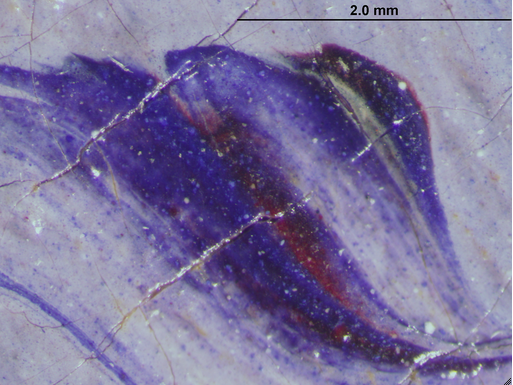
Photomicrograph of the signature in Renoir’s Madame Léon Clapisson (1883) showing the mixture of blue and red lake pigments. The Art Institute of Chicago, 1933.1174.
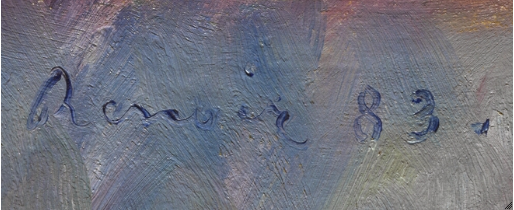
Detail of the signature in Renoir’s Madame Léon Clapisson (1883) showing the wet-in-wet application into the background. The Art Institute of Chicago, 1933.1174.
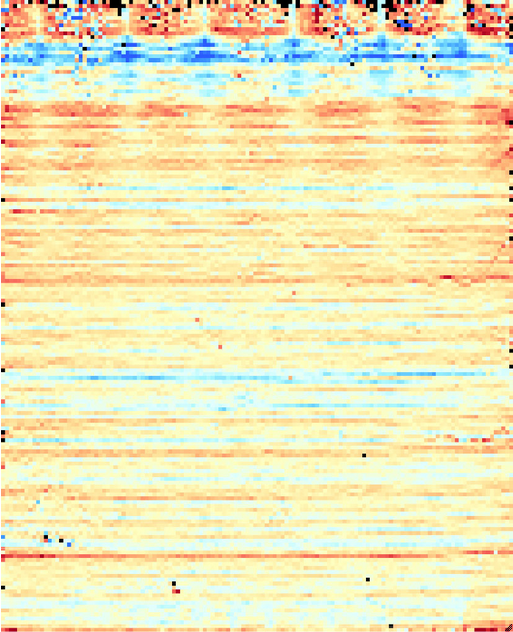
Warp-angle map of Renoir’s Madame Léon Clapisson (1883) showing primary (stronger) cusping of the horizontal threads along the top edge. The Art Institute of Chicago, 1933.1174. Image created by Don H. Johnson using Thread Count Automation Project software.
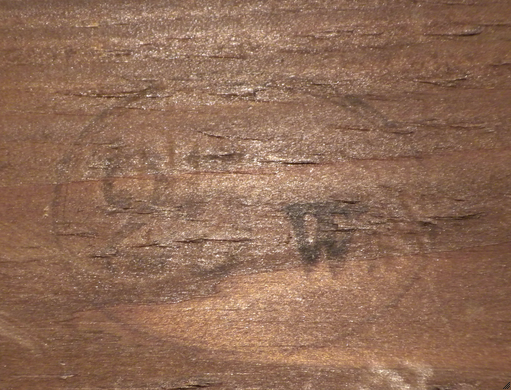
Verso detail of Renoir’s Madame Léon Clapisson (1883) from the central crossbar of the stretcher showing the standard size stamp. The Art Institute of Chicago, 1933.1174.
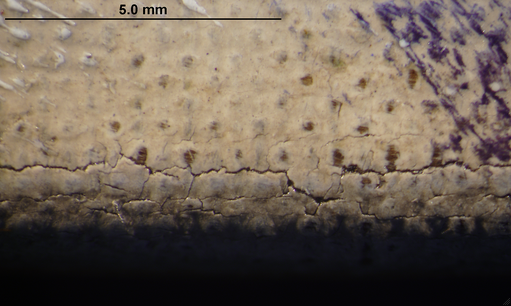
Photomicrograph of Renoir’s Madame Léon Clapisson (1883) showing the additional, toned ground layer. The Art Institute of Chicago, 1933.1174.
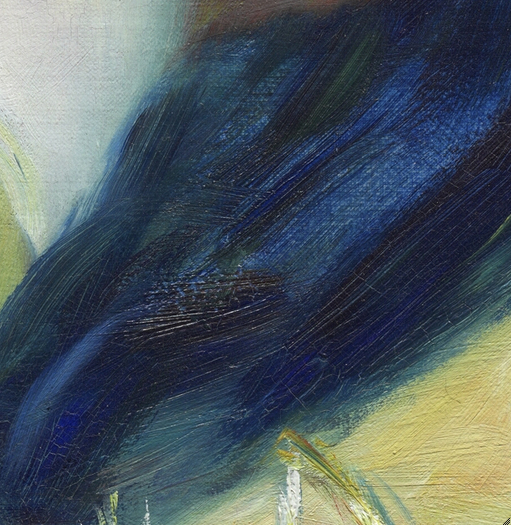
Detail of the figure’s dress in Renoir’s Madame Léon Clapisson (1883) showing the fluid blue paint used for the underdrawing. The Art Institute of Chicago, 1933.1174.
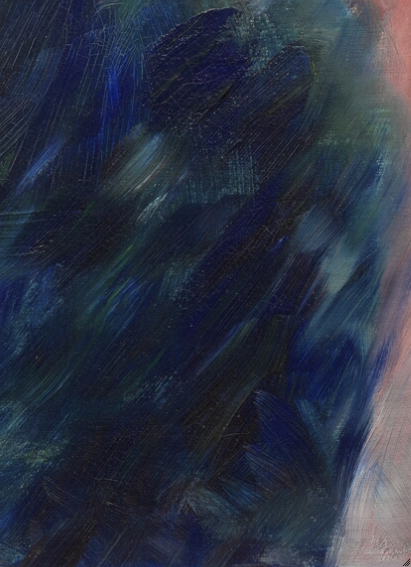
Detail of the figure’s dress in Renoir’s Madame Léon Clapisson (1883) showing the thick, flat brushwork used to articulate the fabric. The Art Institute of Chicago, 1933.1174.
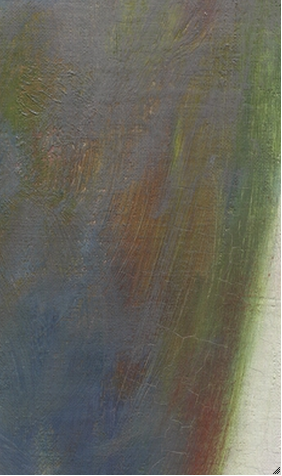
Detail of Renoir’s Madame Léon Clapisson (1883) showing the rusty reds of the original background visible along the figure’s right arm and reflected in the highlights of the flesh tones. The Art Institute of Chicago, 1933.1174.
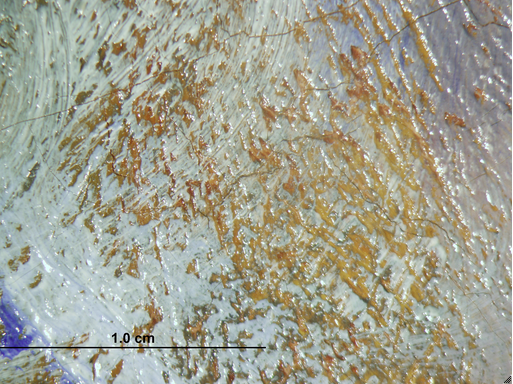
Photomicrograph of the figure’s hair and feathered hair ornament in Renoir’s Madame Léon Clapisson (1883). The feathers were executed over the original rusty-red background. The Art Institute of Chicago, 1933.1174.
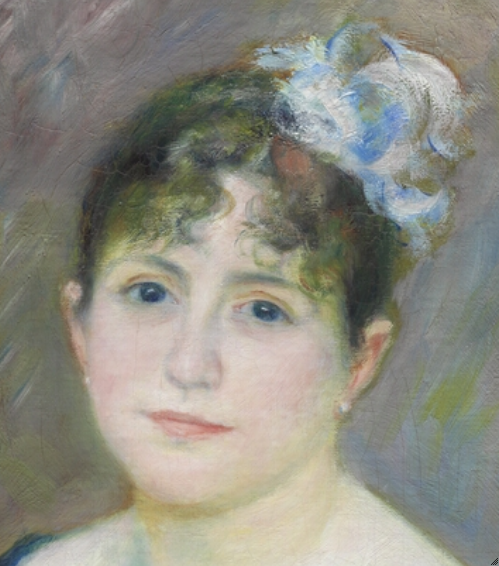
Detail of Renoir’s Madame Léon Clapisson (1883) showing the margin of earlier background left visible around the edges of forms. The Art Institute of Chicago, 1933.1174.
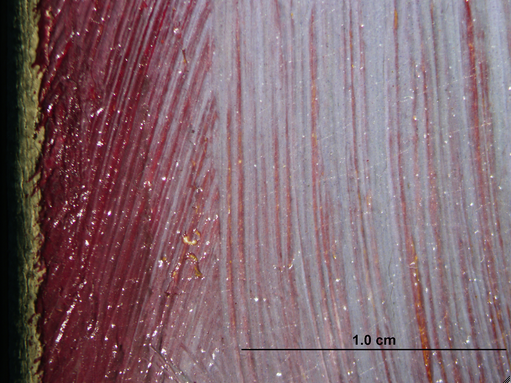
Photomicrograph of the left edge in Renoir’s Madame Léon Clapisson (1883) showing an unfaded area of the background that is usually covered by the frame. The Art Institute of Chicago, 1933.1174.
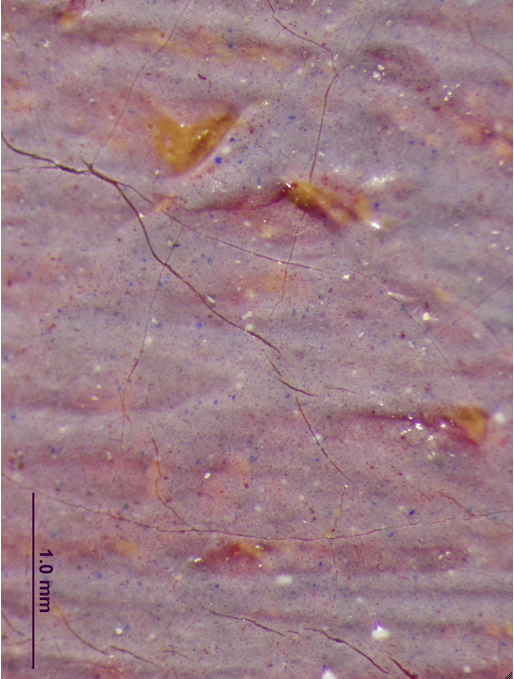
Photomicrograph of the background in Renoir’s Madame Léon Clapisson (1883) showing still-vibrant red lake in some depressions of the paint layer as well as translucent particles of faded red lake on the surface. The Art Institute of Chicago, 1933.1174.
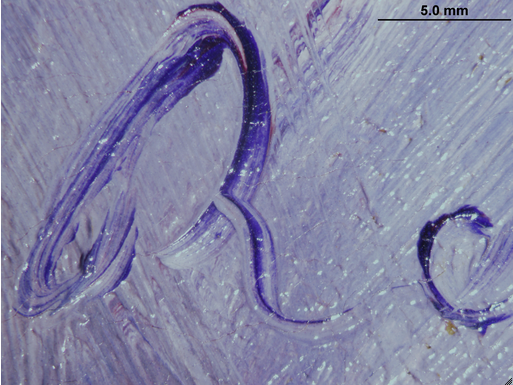
Photomicrograph of the signature in Renoir’s Madame Léon Clapisson (1883) showing the wet-in-wet application into the background. The Art Institute of Chicago, 1933.1174.
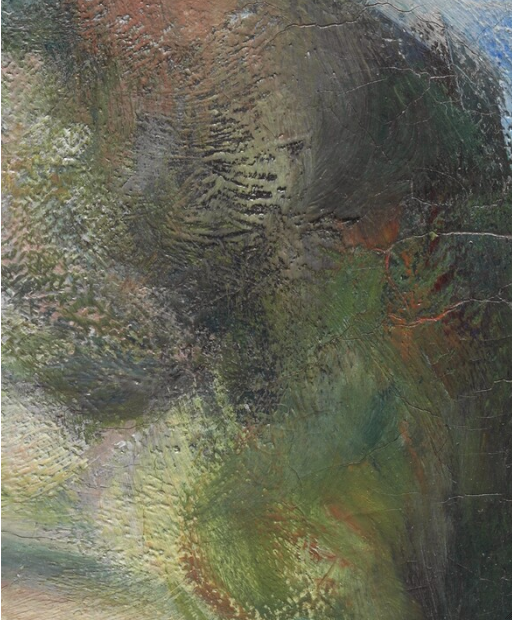
Detail of Renoir’s Madame Léon Clapisson (1883) showing the colors from the original background worked into the brushstrokes of the hair and the feathered hair ornament. The Art Institute of Chicago, 1933.1174.
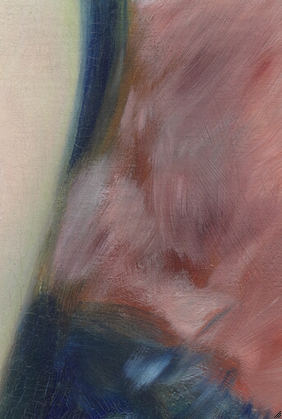
Detail of Renoir’s Madame Léon Clapisson (1883) showing the interface between the figure’s dress and the chair. The Art Institute of Chicago, 1933.1174.

Detail of the figure’s hands in Renoir’s Madame Léon Clapisson (1883) showing the visibility of the earlier position of the hands under normal viewing conditions. The Art Institute of Chicago, 1933.1174.
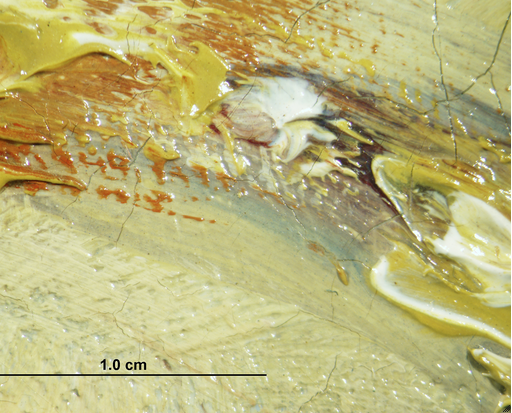
Photomicrograph of the figure’s bracelet in Renoir’s Madame Léon Clapisson (1883) showing the heavy impasto and wet-in-wet mixing of colors. The Art Institute of Chicago, 1933.1174.
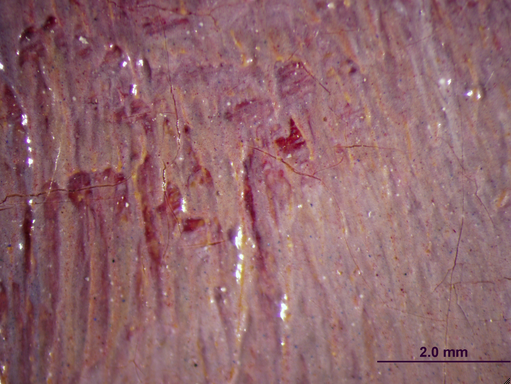
Photomicrograph of the faded background in Renoir’s Madame Léon Clapisson (1883) showing brighter red lake in the depressions and cracks of the paint layer. The Art Institute of Chicago, 1933.1174.
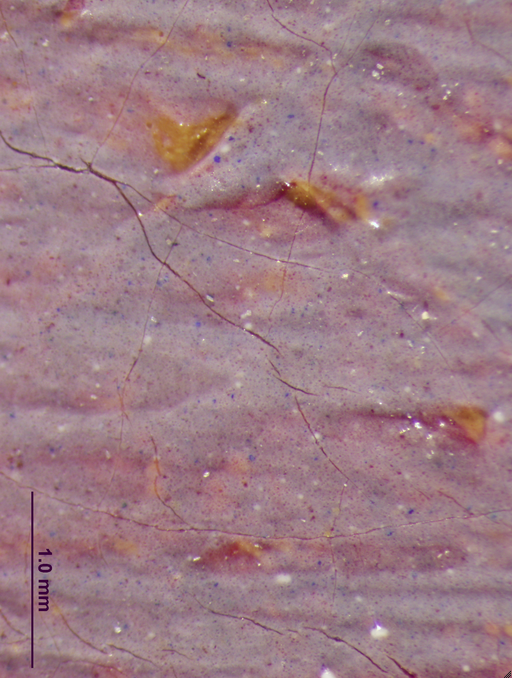
Photomicrograph of the background in Renoir’s Madame Léon Clapisson (1883) showing still-vibrant red lake in some depressions of the paint layer as well as translucent particles of faded red lake on the surface. The Art Institute of Chicago, 1933.1174.
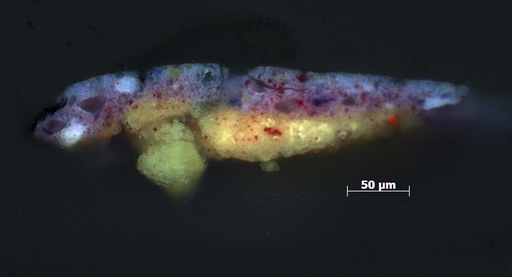
Photomicrograph of a cross section from Renoir’s Madame Léon Clapisson (1883) showing a faded area of the background. Original magnification: 200×. The Art Institute of Chicago, 1933.1174.
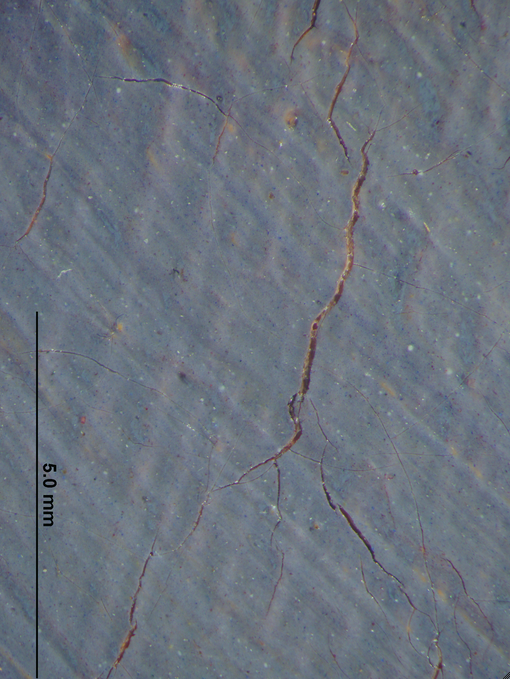
Photomicrograph of Renoir’s Madame Léon Clapisson (1883) showing the sample site in the faded background. The Art Institute of Chicago, 1933.1174.
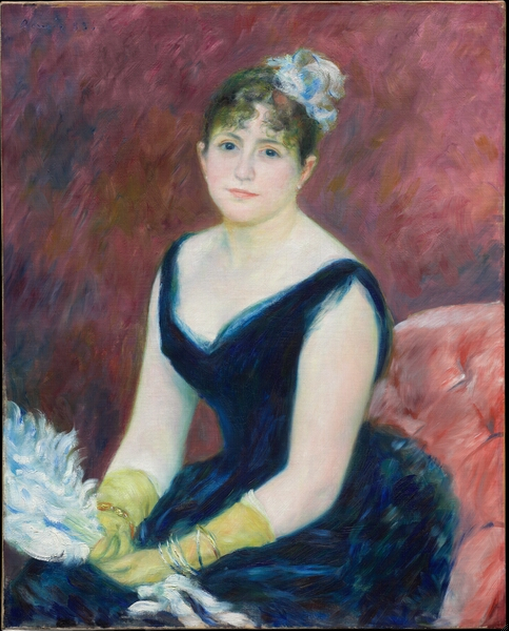
Recolorized visualization and natural-light image of Renoir’s Madame Léon Clapisson (1883). The Art Institute of Chicago, 1933.1174. Interactive image.
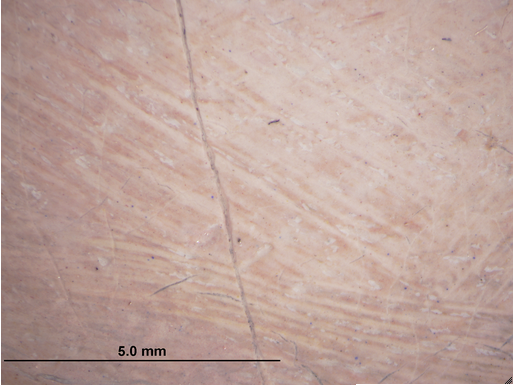
Photomicrograph of Renoir’s Madame Léon Clapisson (1883) showing remnants of retouching in the depressions of the paint layer in the figure’s chin. The Art Institute of Chicago, 1933.1174.
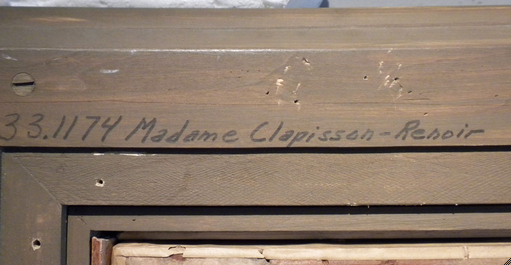
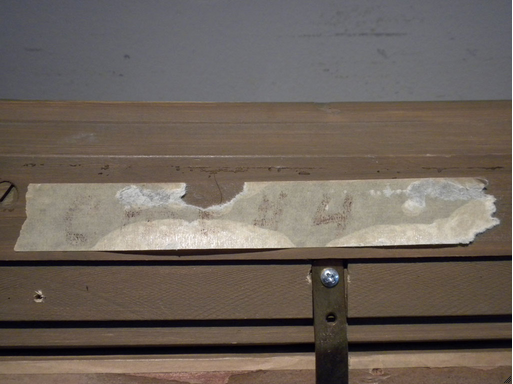
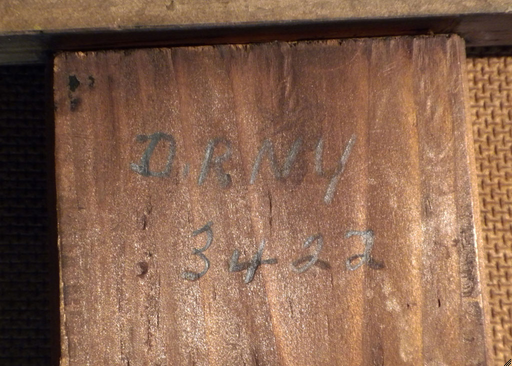
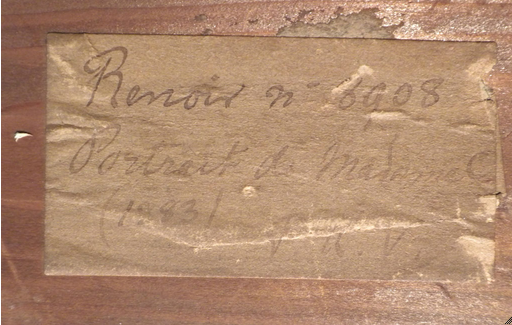
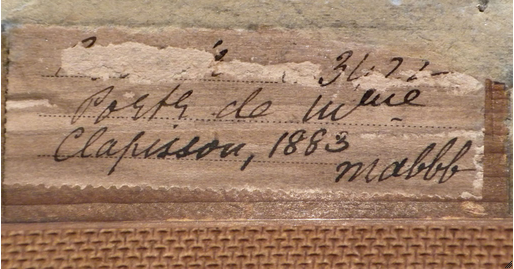
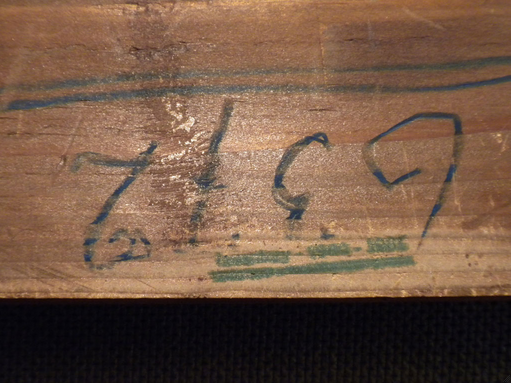
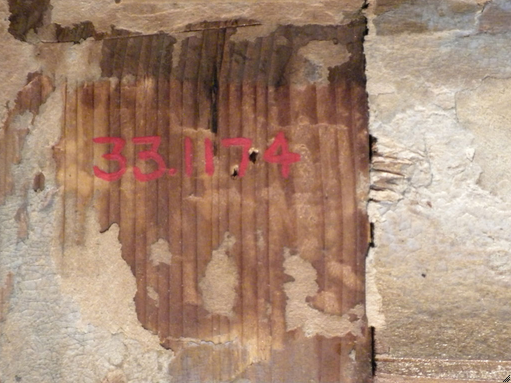
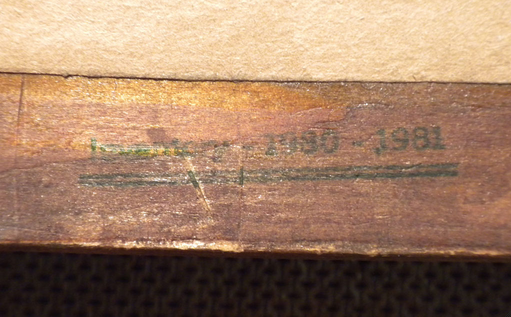
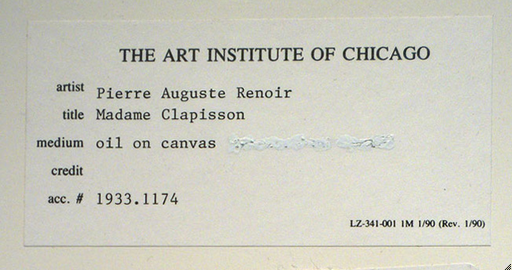
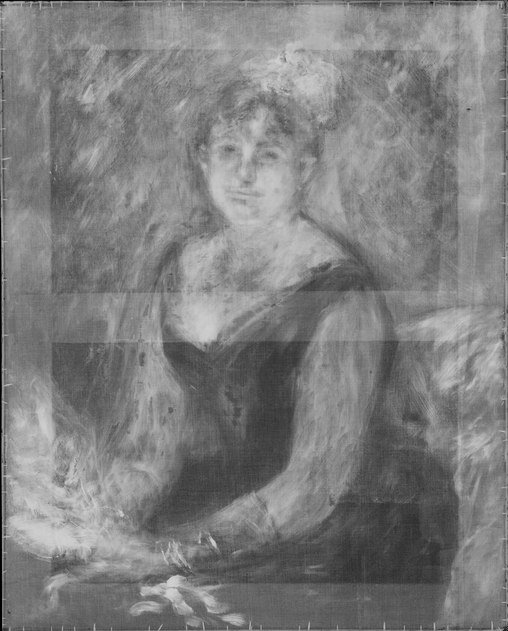
X-ray of Renoir’s Madame Léon Clapisson (1883) showing wide, radio-opaque strokes from the palette-knife application of an additional ground layer. The Art Institute of Chicago, 1933.1174. X-ray digitally composited by Robert G. Erdmann, University of Arizona.
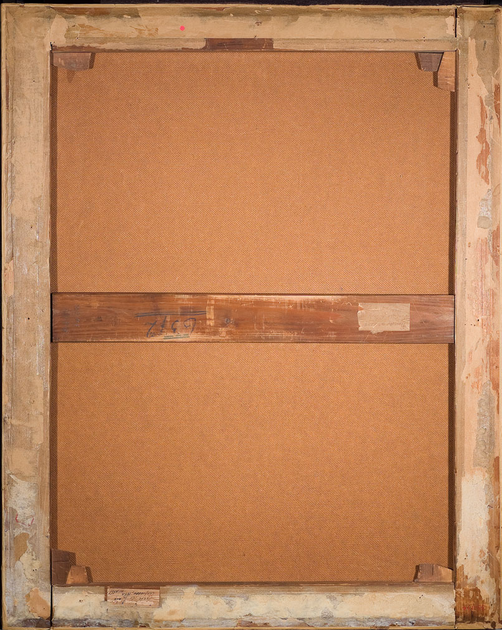
Verso of Renoir’s Madame Léon Clapisson (1883). The patina, labels, and stamps suggest that the stretcher is original to the painting, though it was replaced upside down, probably during the 1939 treatment. The Art Institute of Chicago, 1933.1174.
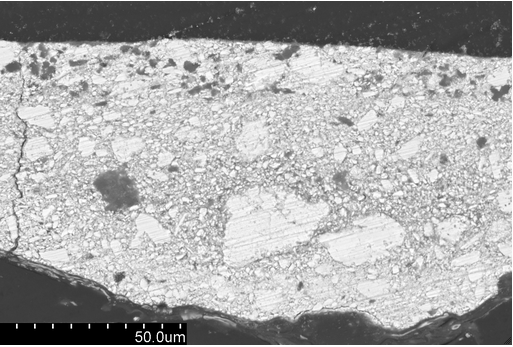
The two layers of the commercial preparation have a somewhat indistinct dividing line, primarily visible in the backscattered electron (BSE) image in Renoir’s Madame Léon Clapisson (1883). Original magnification: 900×. The Art Institute of Chicago, 1933.1174.
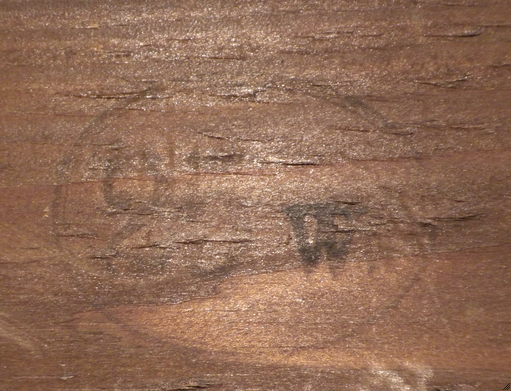
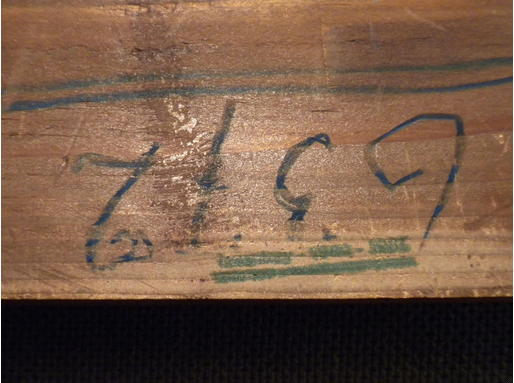
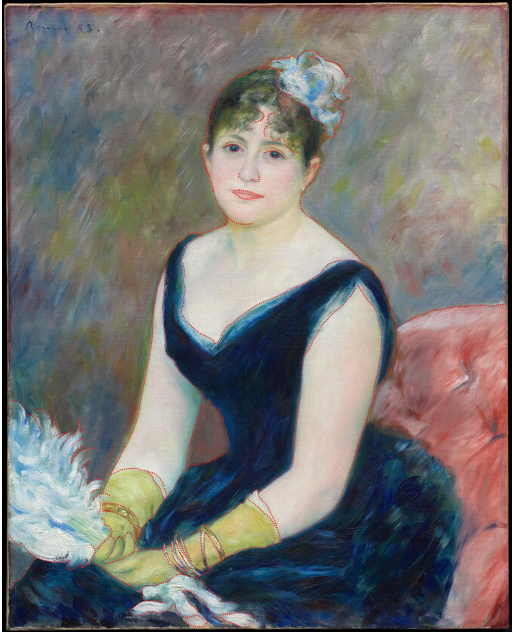
Renoir’s Madame Léon Clapisson (1883). The Art Institute of Chicago, 1933.1174. Interactive image.
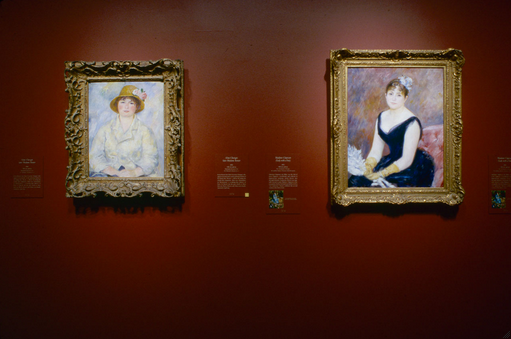
Installation of Renoir’s Madame Léon Clapisson (1883) in Renoir’s Portraits: Impressions of an Age, Art Institute of Chicago, Oct. 17, 1997–Jan. 4, 1998. Institutional Archives, Art Institute of Chicago.
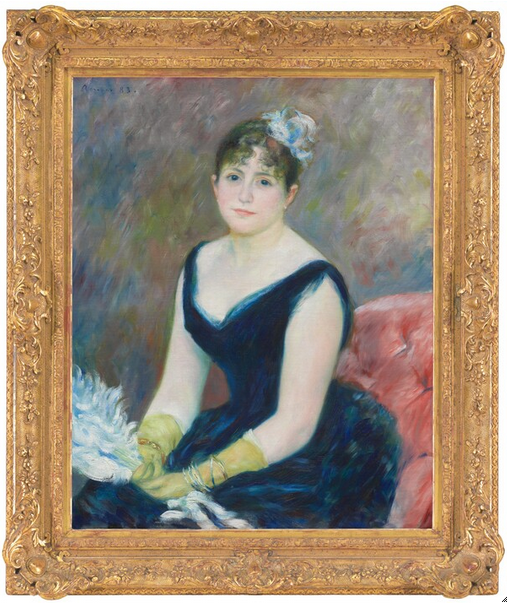
Renoir’s Madame Léon Clapisson (1883) in its current frame. The Art Institute of Chicago, 1933.1174.

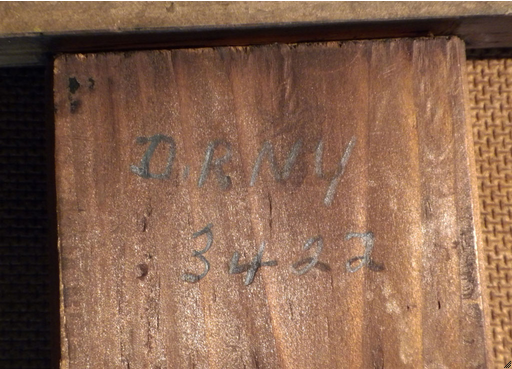
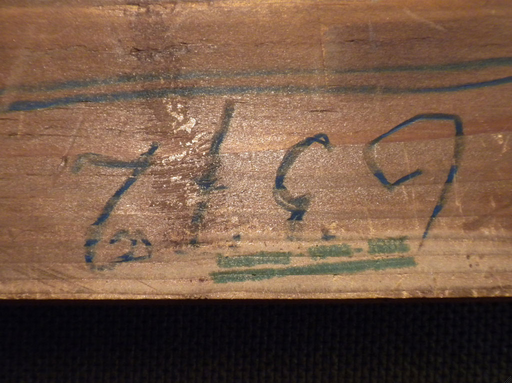
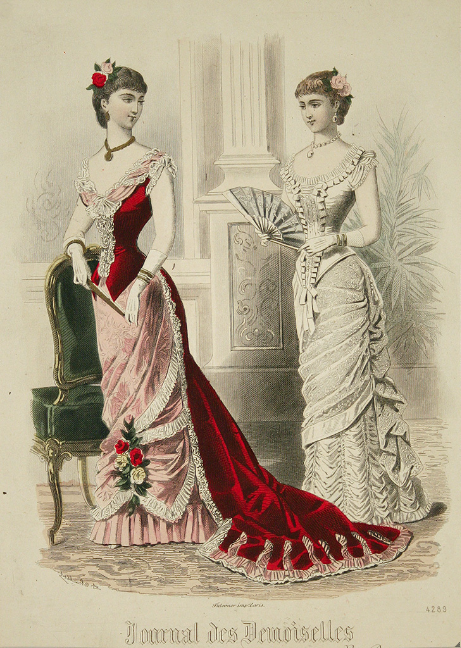
“Two Women in Evening Dresses,” Journal des demoiselles, 1880. Steel engraving with hand coloring; 24.8 × 17.8 cm (9 3/4 × 7 in.). The Metropolitan Museum of Art, New York.
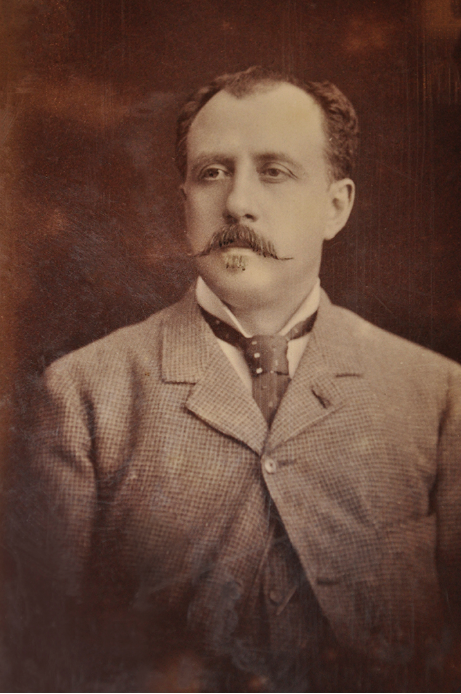
Hippolyte Delié (French, active 1870-79. Léon Clapisson, c. 1875. Private collection.
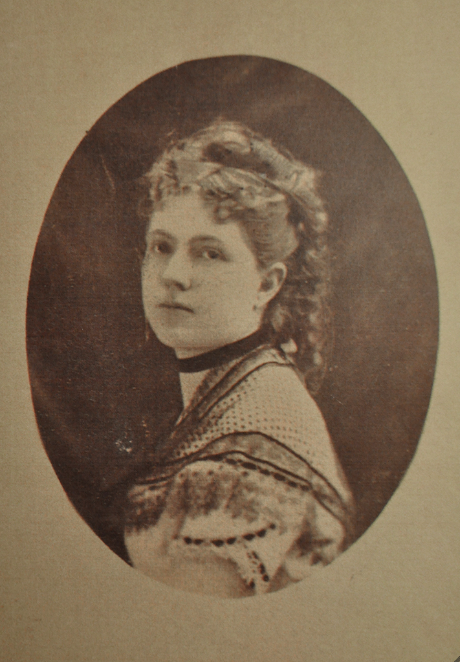
J. C. Tourtin (French, active second half of the 19th Century). Valentine Clapisson, c. 1875. Private collection.
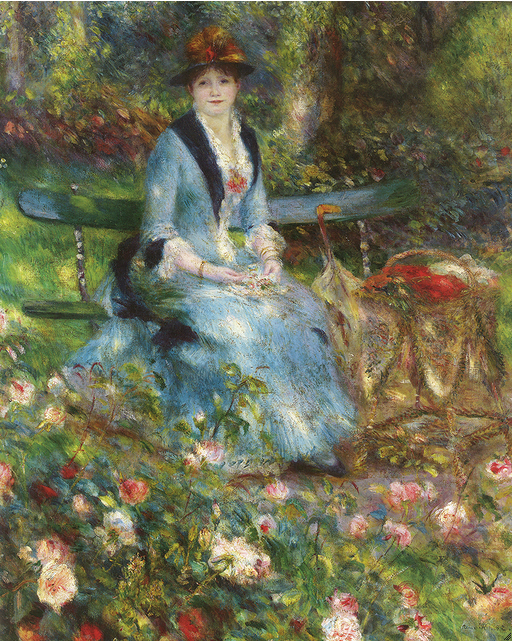
Pierre-Auguste Renoir (French, 1841–1919). Among the Roses (Dans les roses), 1882. Oil on canvas; 99.7 × 81.3 cm (39 1/4 × 32 in.). Private collection.
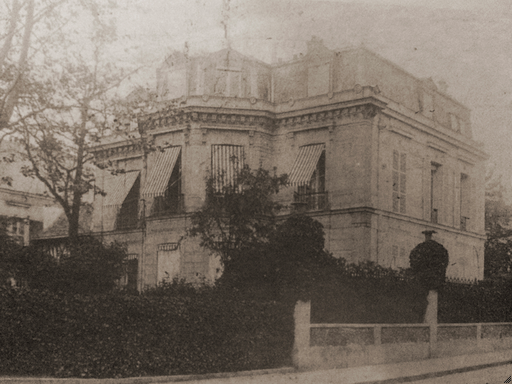
The Clapissons’ hôtel particulier (now destroyed) at 48, rue Charles Laffitte in Neuilly-sur-Seine. Private collection.
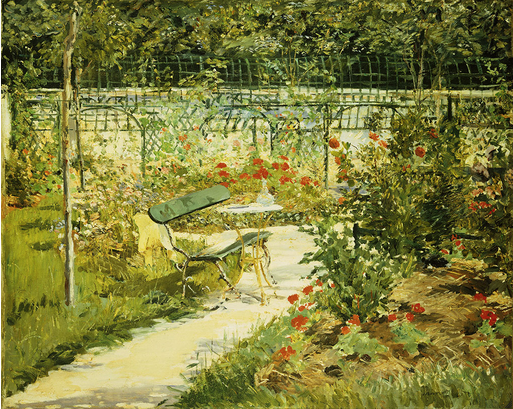
Édouard Manet (French, 1832–1883). The Artist’s Garden at Versailles, 1881. Oil on canvas; 65 × 80.6 cm (25 5/8 × 31 3/4 in.). Private collection. Photo © Christie’s Images/The Bridgeman Art Library.
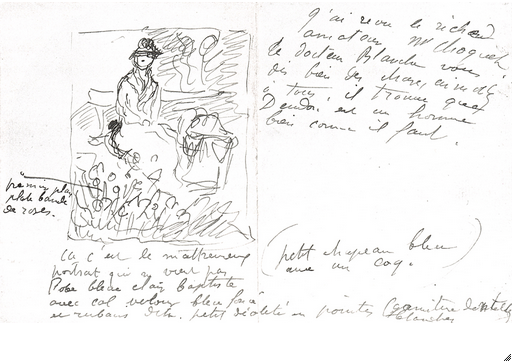
Pierre-Auguste Renoir (French, 1841–1919). Pen sketch for the first portrait of Madame Clapisson, from a letter to Paul Berard, June 22, 1882. Private collection.

Jean-Auguste-Dominique Ingres (French, 1780–1867). Madame de Senonnes, née Marie-Geneviève-Marguerite Marcoz, later Vicomtesse de Senonnes, 1814. Oil on canvas; 106 × 84 cm (41 3/4 × 33 1/16 in.). Musée des Beaux-Arts, Nantes. Photo: Gérard Blot © RMN-Grand Palais/Art Resource, NY.
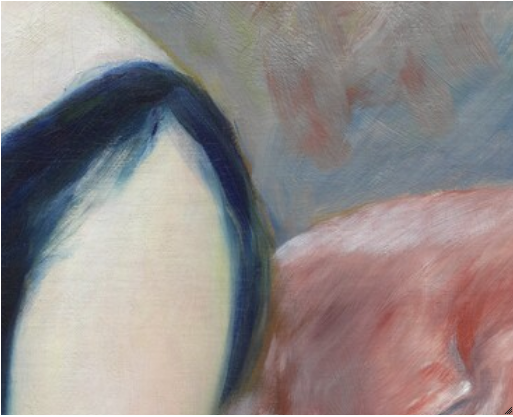
Detail of Renoir’s Madame Léon Clapisson (1883) showing the artist’s gestural brushstrokes. The Art Institute of Chicago, 1933.1174.
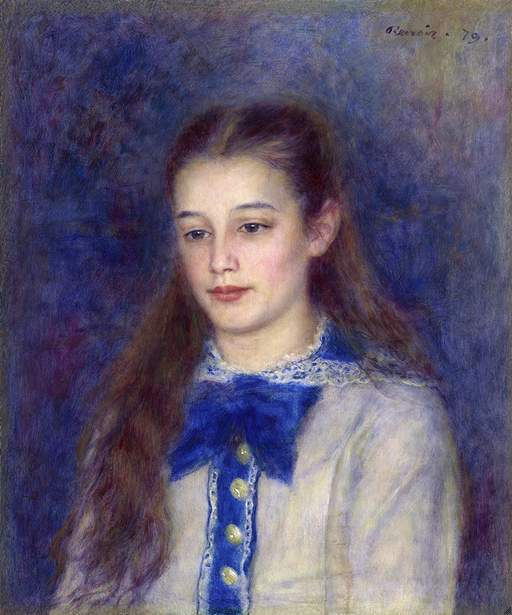
Pierre-Auguste Renoir (French, 1841–1919). Thérèse Berard, 1879. Oil on canvas; 55.9 × 46.8 cm (22 × 18 7/16 in.). Sterling and Francine Clark Art Institute, Williamstown, Mass., 1955.593. Bridgeman Images.
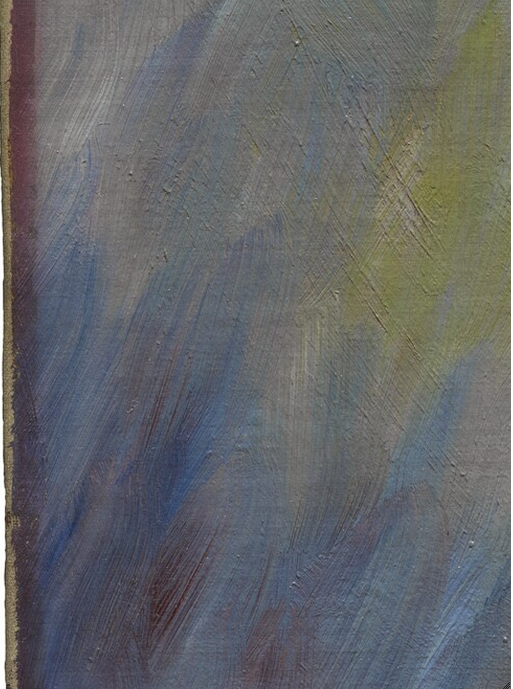
Detail of Renoir’s Madame Léon Clapisson (1883) showing the unfaded red paint along the edge of the painting. The Art Institute of Chicago, 1933.1174.
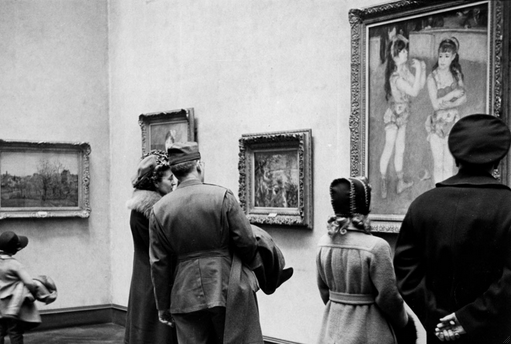
Renoir’s Madame Léon Clapisson (1883) in its current frame, gallery installation. The Art Institute of Chicago, 1933.1174.
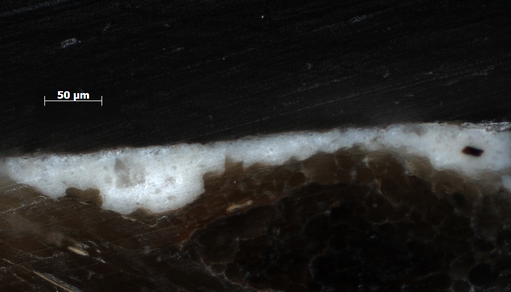
Photomicrograph of a cross section of the ground and canvas from Renoir’s Madame Léon Clapisson (1883). Original magnification: 200×. The Art Institute of Chicago, 1933.1174.
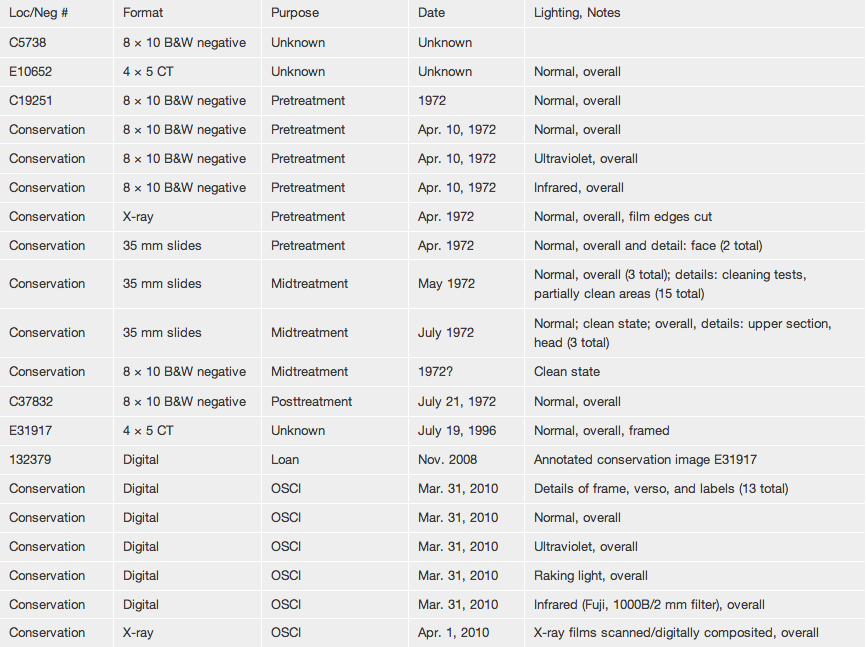
| Loc/Neg # | Format | Purpose | Date | Lighting, Notes |
| C5738 | 8 × 10 B&W negative | Unknown | Unknown | |
| E10652 | 4 × 5 CT | Unknown | Unknown | Normal, overall |
| C19251 | 8 × 10 B&W negative | Pretreatment | 1972 | Normal, overall |
| Conservation | 8 × 10 B&W negative | Pretreatment | Apr. 10, 1972 | Normal, overall |
| Conservation | 8 × 10 B&W negative | Pretreatment | Apr. 10, 1972 | Ultraviolet, overall |
| Conservation | 8 × 10 B&W negative | Pretreatment | Apr. 10, 1972 | Infrared, overall |
| Conservation | X-ray | Pretreatment | Apr. 1972 | Normal, overall, film edges cut |
| Conservation | 35 mm slides | Pretreatment | Apr. 1972 | Normal, overall and detail: face (2 total) |
| Conservation | 35 mm slides | Midtreatment | May 1972 | Normal, overall (3 total); details: cleaning tests, partially clean areas (15 total) |
| Conservation | 35 mm slides | Midtreatment | July 1972 | Normal; clean state; overall, details: upper section, head (3 total) |
| Conservation | 8 × 10 B&W negative | Midtreatment | 1972? | Clean state |
| C37832 | 8 × 10 B&W negative | Posttreatment | July 21, 1972 | Normal, overall |
| E31917 | 4 × 5 CT | Unknown | July 19, 1996 | Normal, overall, framed |
| 132379 | Digital | Loan | Nov. 2008 | Annotated conservation image E31917 |
| Conservation | Digital | OSCI | Mar. 31, 2010 | Details of frame, verso, and labels (13 total) |
| Conservation | Digital | OSCI | Mar. 31, 2010 | Normal, overall |
| Conservation | Digital | OSCI | Mar. 31, 2010 | Ultraviolet, overall |
| Conservation | Digital | OSCI | Mar. 31, 2010 | Raking light, overall |
| Conservation | Digital | OSCI | Mar. 31, 2010 | Infrared (Fuji, 1000B/2 mm filter), overall |
| Conservation | X-ray | OSCI | Apr. 1, 2010 | X-ray films scanned/digitally composited, overall |
| Conservation | Digital | OSCI | Apr. 1, 2010 | Macro details of surface (11 total) |
| Conservation | Digital | OSCI | Apr. 5, 2010 | Photomicrographs of sample sites, surface (24 total) |
| Conservation | Digital | OSCI | Apr. 8, 2010 | Infrared (Inframetrics, 1.5–1.73 µm filter), overall |
| Conservation | Digital | OSCI | Apr. 12, 2010 | Macro details of surface (3 total) |
| Conservation | Digital | OSCI | Apr. 13, 2010 | Photomicrographs of sample sites (8 total) |
| G39020 | Digital | OSCI | Dec. 20, 2011 | Normal, overall; composite of G39073–G39087 |
| G39021 | Digital | OSCI | Dec. 20, 2011 | Ultraviolet, overall |
| G39022 | Digital | OSCI | Dec. 20, 2011 | Normal, frame only |
| G39072 | Digital | OSCI | Dec. 20, 2011 | Section |
| G39073 | Digital | OSCI | Dec. 20, 2011 | Section |
| G39074 | Digital | OSCI | Dec. 20, 2011 | Section |
| G39075 | Digital | OSCI | Dec. 20, 2011 | Section |
| G39076 | Digital | OSCI | Dec. 20, 2011 | Section |
| G39077 | Digital | OSCI | Dec. 20, 2011 | Section |
| G39078 | Digital | OSCI | Dec. 20, 2011 | Section |
| G39079 | Digital | OSCI | Dec. 20, 2011 | Section |
| G39080 | Digital | OSCI | Dec. 20, 2011 | Section |
| G39081 | Digital | OSCI | Dec. 20, 2011 | Section |
| G39082 | Digital | OSCI | Dec. 20, 2011 | Section |
| G39083 | Digital | OSCI | Dec. 20, 2011 | Section |
| G39084 | Digital | OSCI | Dec. 20, 2011 | Section |
| G39085 | Digital | OSCI | Dec. 20, 2011 | Section |
| G39086 | Digital | OSCI | Dec. 20, 2011 | Section |
| G39087 | Digital | OSCI | Dec. 20, 2011 | Section |
| Conservation | Digital | OSCI | Dec. 21, 2011 | Infrared (Goodrich, J filter 1.5–1.7 µm), overall |
| Conservation | Digital | OSCI | Dec. 21, 2011 | Infrared (Goodrich, H filter 1.1–1.4 µm), overall |
| Conservation | Digital | OSCI | Dec. 12, 2013 | Photomicrographs of background (6 total) |
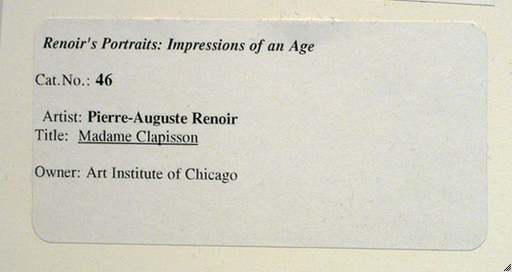
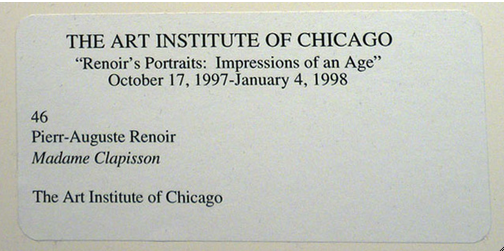
Woman Seated in a Chair (recto); Woman Seated in a Chair, Seen from the Back (verso)1134
c. 1883
Charcoal, with graphite and touches of stumping and erasure (recto), and graphite (verso) on ivory wove paper; 362 × 310 mm
Stamp: Renoir. (lower right, in brown-black ink)
The Art Institute of Chicago, Samuel P. Avery Fund, 1943.520R, 1943.520V
Executed quickly—as the energetic shading and loose lines suggest—this study exudes casualness. Seated cross-legged in a rocking chair, the model turns her head toward the viewer, her nonchalant gaze cast down. The description of her features is cursory, their reiterated contours inexact despite the use of pencil around the eye sockets, lids, and collar. The treatment of the woman’s body, meanwhile, is spare. Drawn in charcoal, its profile is distinct, but the modeling of the dress is minimal. The sitter’s right arm, bent at the elbow to rest across her stomach, fades into the barest suggestion of a hand. The soft, remaining marks give the impression that the medium was somehow transferred onto the page rather than applied directly. Aside from an area of shading to the right of the woman's face, and a few strokes that extend parallel to the nape of her neck, the background is empty, providing little sense of context.
The model is dressed in contemporary clothing, which indicates that the work was produced before Renoir changed his style—and, to a degree, his values—in the mid-1880s. One of the first pictures he had shown with the Impressionist group in 1874, The Parisienne (fig. 2.22 [Daulte 102; Dauberville 299]), delights in the sitter’s elaborate costume, and he produced several other images of modern women in the following years.1135 Although the clothes are not described in detail in the present image, they do place the sitter in a metropolitan environment. From the middle of the decade onward, Renoir tended to avoid details that were specifically contemporary, possibly in reaction to female emancipation.1136
The artist seems to have taken as much pleasure in describing the chair as he did its occupant. Arabesques form its sides, curling up at either end in satisfying curves. A searching line on the level of the rockers suggests a shadow below, conveying a sense of movement, as if prompted by the blurred (and so presumably agitated) feet.
Technical examination of the sheet by Art Institute paper conservator Kimberly Nichols revealed another Renoir drawing on its verso (see Technical Report). Akin to the Buste de danseuse of around 1883–85 (fig. 2.23 [Dauberville 1446]), this second image shows the torso of a seated female figure, seen from behind, in a state of partial undress (fig. 2.24), quite unlike the Woman Seated in a Chair.1137 Renoir seems to have drawn the model’s profil perdu with a single gesture, and the twisted knot of her hair and gentle slope of the shoulders are described in clear, delicate lines. This image may relate to the series of bather drawings that the artist made in the mid-1880s, but, despite its visual appeal, he did not complete the work.1138 Perhaps the suggestion of clothing tied the figure too closely to contemporary life at a moment when Renoir more often sought to create figures that harked back to antiquity.
Nancy Ireson
Renoir executed Woman Seated in a Chair primarily in charcoal on ivory, moderately thick, slightly textured [glossary:wove] paper. Soft charcoal lines and broad areas of shading loosely define the figure’s body and the rocking chair. The slight texture of the paper surface is revealed in the broadly drawn passages. The figure’s hair is the most modeled part of the composition; here Renoir used both charcoal and [glossary:graphite] with touches of [glossary:stumping] or erasure to achieve further tonal variation (fig. 1.2). In contrast, the figure’s face and neck sash are carefully defined with hard graphite lines. Erasure may also have been used to further emphasize the placement of the figure’s hands in her lap. The seated woman fills the center area of the paper support, and there is little development of the background: only a faint shaded area to the right of the face and a straight horizontal line across the lower area of the sheet suggest a sense of space.
On the verso, a faint unfinished graphite sketch depicts the upper half of a woman, viewed from behind, with her hair in a bun and a towel or shawl draped loosely around her back (fig. 1.1).1139 The image is most clearly seen with the aid of [glossary:infrared reflectography] (fig. 1.4).
Stamp: Renoir. (lower right, in brown-black ink) (fig. 2.20).
Ivory, moderately thick, slightly textured wove paper.1140
J. Whatman, Turkey Mill, 1881 (complete, horizontal orientation across top of sheet) (fig. 1.3).
Uniform, without visible inclusions or colored fibers.
Even.
A deckle edge is preserved along the top of the sheet. The side edges appear to be edge-torn, exhibiting slight irregularities, and the bottom edge is trimmed straight.
362 × 310 mm.
No artistic surface alterations or coatings are visible in normal conditions or under magnification. Under [glossary:UV] illumination, there is a pale-yellow visible-light [glossary:fluorescence] that is characteristic of a light gelatin [glossary:sizing].
The work is drawn in charcoal, with selective use of graphite to define the upper portion of the figure, including the hair, face, and clothing around the neck. There appear to be touches of stumping or erasure, which create tonal variation in the figure’s hair. Erasure may also have been used to selectively highlight the figure’s hands, crossed in her lap.
On the verso, a faint graphite drawing depicts the upper half of a woman, viewed from behind, with her hair in a bun and a towel or shawl draped loosely around her back.
No revisions or changes are visible in the composition in normal conditions or under magnification.
No artistic surface alterations or coatings are visible in normal conditions, under UV illumination, or under magnification.
The drawing [glossary:support] exhibits soft undulations around the perimeter of the sheet. There is small tear at the center top edge. Traces of adhesive residue and staining are faintly visible along the left edge. The charcoal medium appears sunk in and lightly smudged in some areas. The verso of the drawing exhibits small thinned areas, most concentrated on the lower right, and small spots of brown material that suggest former removal of the drawing from a mount.
Under UV illumination, the drawing support reveals several large, irregularly ringed areas of bright-yellow visible-light fluorescence adjacent to slightly UV-absorbing areas in the upper third of the drawing support. It is likely that these areas correspond to former contact with moisture or liquid that caused movement of components in the paper, including the gelatin sizing. It is likely that staining developed in these areas but was formerly reduced through conservation treatment; under normal conditions traces of the staining are currently visible only in the upper right area of the sheet.
Kimberly Nichols
Estate of the artist, from 1919.1141
Sold by the artist’s estate to André Schoeller: Paris.1142
André Schoeller, probably to at least July 27, 1939.1138
Sold by Justin K. Thannhauser, New York, to the Art Institute of Chicago, 1943.
Art Institute of Chicago, Drawings: Old and New, 1946, p. 22, cat. 44 (ill.).
Birmingham (Ala.) Museum of Art, Exhibition of French Drawings (Le Fin du Siècle), Oct. 5–Nov. 1, 1952, no cat.
Tokyo, National Art Center, Renoir: Tradition and Innovation, Jan. 20–Apr. 5, 2010, pp. 96–97 (ill.), cat. 31, 251 (ill.); Osaka, National Museum of Art, Apr. 17–June 27, 2010.
John Rewald, Renoir Drawings (H. Bittner, 1946), p. 18, no. 26 (ill.).
Hans Tietze, European Master Drawings in the United States (J. J. Augustin, 1947), pp. 290–91, no. 145 (ill.).
Regina Shoolman and Charles E. Slatkin, Six Centuries of French Master Drawings in America (Oxford University Press, 1950), p. 202, no. 114 (ill.).
Ira Moskowitz, Great Drawings of All Time, vol. 3 (Shorewood, 1962), no. 801 (ill.).
Harold Joachim and Sandra Haller Olsen, French Drawings and Sketchbooks of the Nineteenth Century, vol. 2 (University of Chicago Press, 1979), p. 91, no. 5D8.
Guy-Patrice Dauberville and Michel Dauberville, Renoir: Catalogue raisonné des tableaux, pastels, dessins et aquarelles, vol. 2, 1882–1894 (Bernheim-Jeune, 2009), p. 476, cat. 1445 (ill.).
Framer’s mark
Location: bottom, right of center
Method: handwritten script, graphite
Content: [erased] vue 30 × 32 / [erased] verre 39 × 41 / no. 13[?] / [erased] 3 [?]
Paper support characteristics identified.
Watermark captured.
Paper mold characteristics identified.
Former staining detected.
Graphite drawing on verso captured (Nov. 14, 2011).
Media identified.
The image inventory compiles records of all known images of the artwork on file in the Imaging Department and in the conservation and curatorial files in the Department of Prints and Drawings at the Art Institute of Chicago (fig. 2.25).
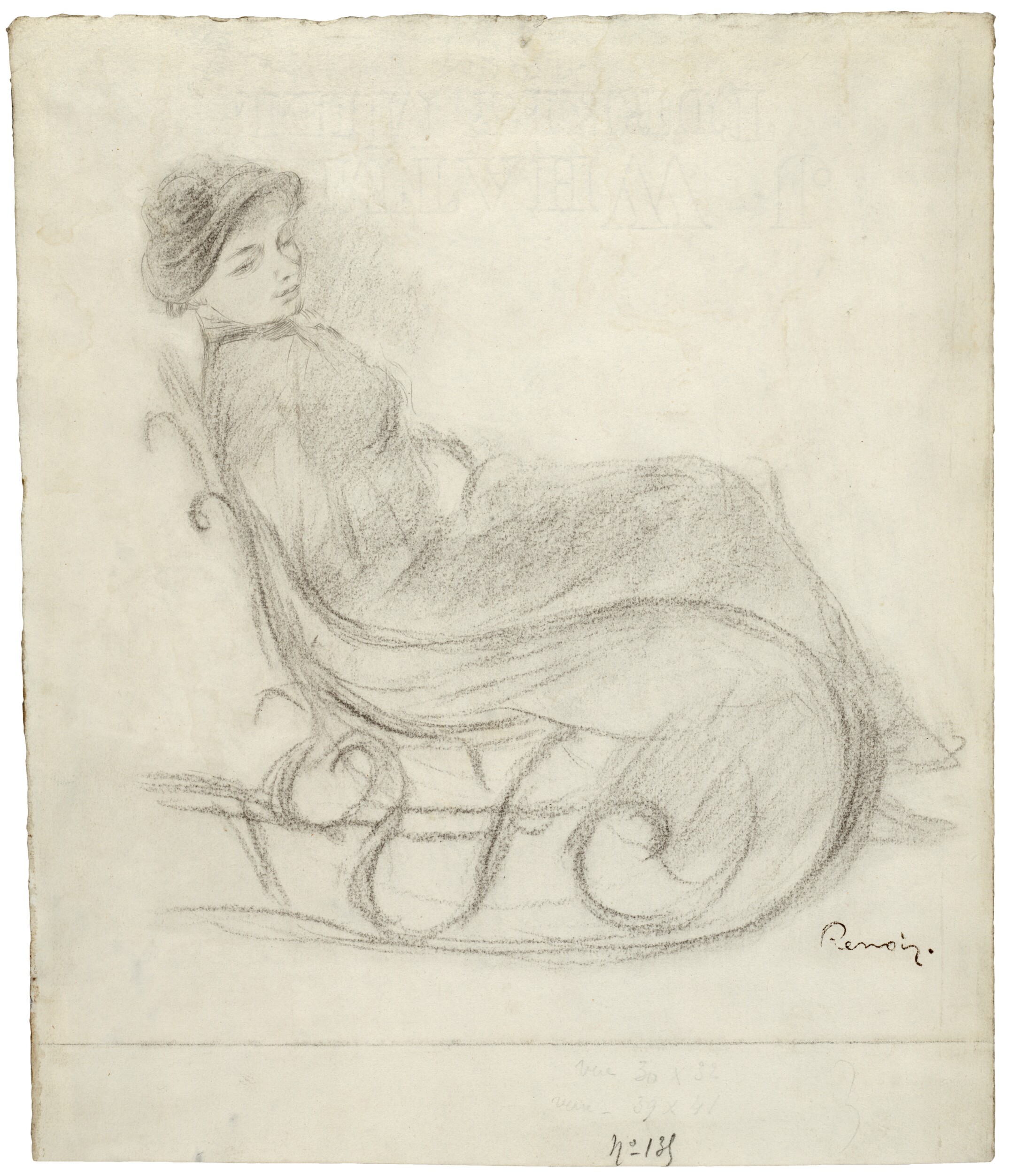
cat. 18 Woman Seated in a Chair (recto), c. 1883.
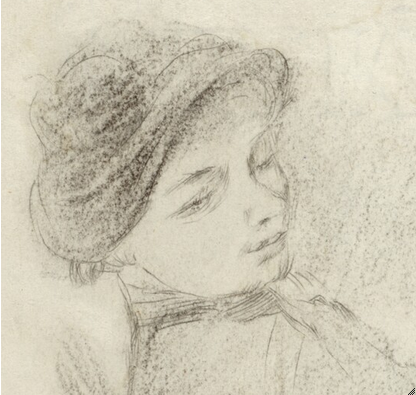
Detail of Renoir’s Woman Seated in a Chair (c. 1883) showing the use of stumping and erasure to create tonal variation. The Art Institute of Chicago, 1943.520R.
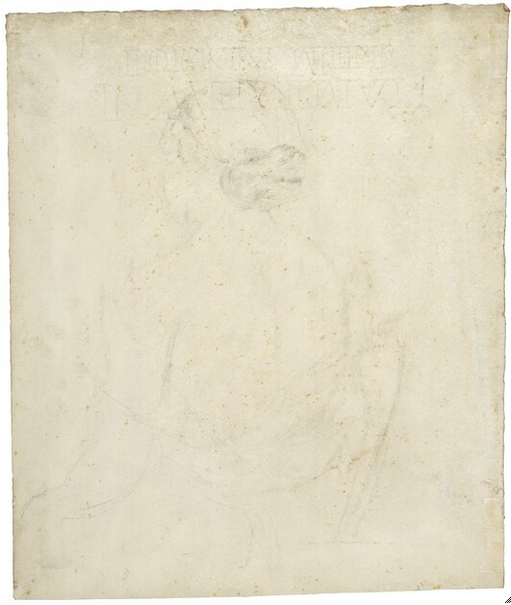
Renoir’s Woman Seated in a Chair, Seen from the Back (c. 1883) showing faint figural drawing lines. The Art Institute of Chicago, 1943.520V.
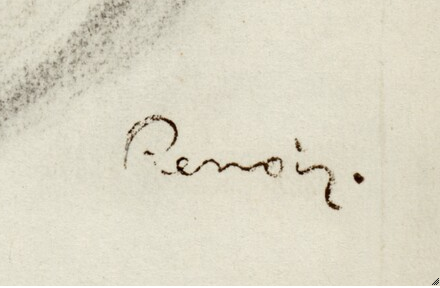
Detail of Renoir’s Woman Seated in a Chair (c. 1883) showing Renoir’s estate stamp in brown-black ink. The Art Institute of Chicago, 1943.520R.
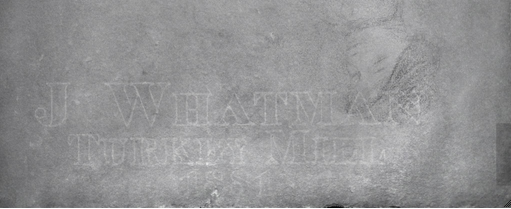
Transmitted-infrared detail (Fuji, 1.0–1.1 µm) of the top portion of Renoir’s Woman Seated in a Chair (c. 1883) showing the paper’s watermark as seen. The Art Institute of Chicago, 1943.520R.
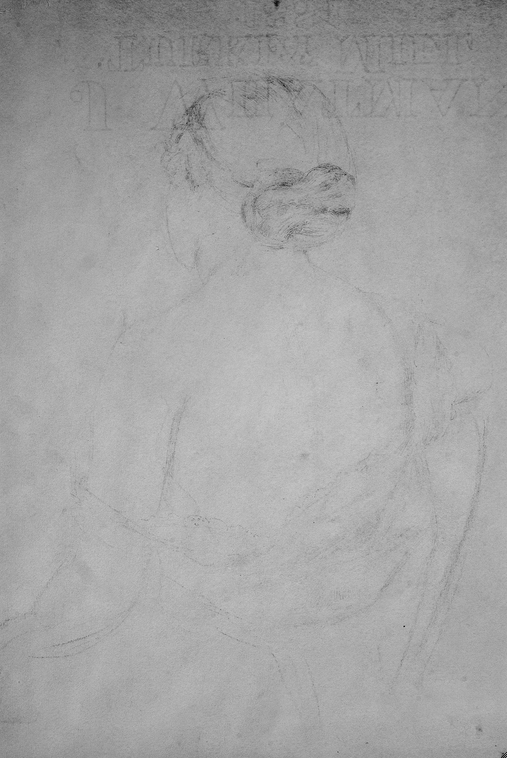
Infrared image (Fuji, 1.0–1.1 µm) of Renoir’s Woman Seated in a Chair, Seen from the Back (c. 1883) revealing the faint figural drawing lines. The Art Institute of Chicago, 1943.520V.
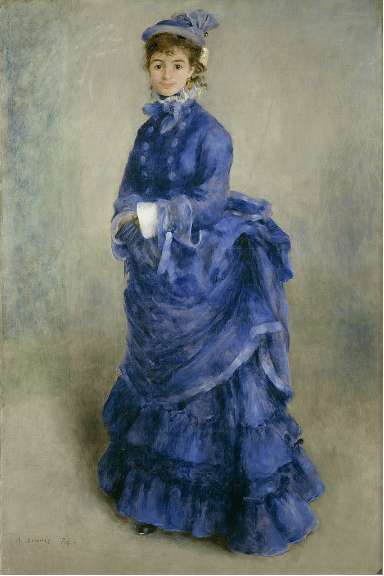
Pierre-Auguste Renoir (French, 1841–1919). The Parisienne, 1874. Oil on canvas; 160 × 106 cm (63 × 41 3/4 in.). National Museum of Wales, Cardiff.
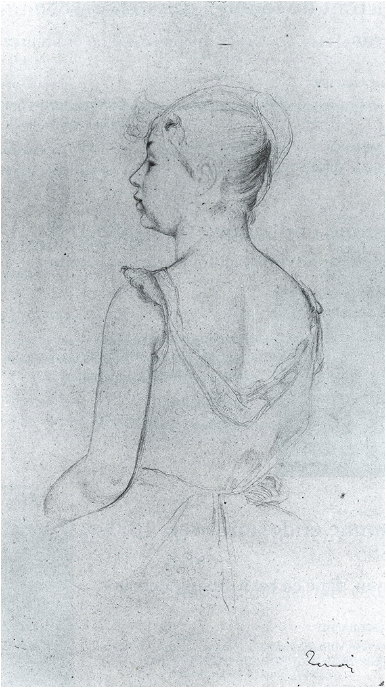
Pierre-Auguste Renoir (French, 1841–1919). Buste de danseuse, c. 1883–85. Graphite on paper; 29 × 14 cm (11 7/19 × 5 1/2 in.). Bernheim-Jeune, Paris.
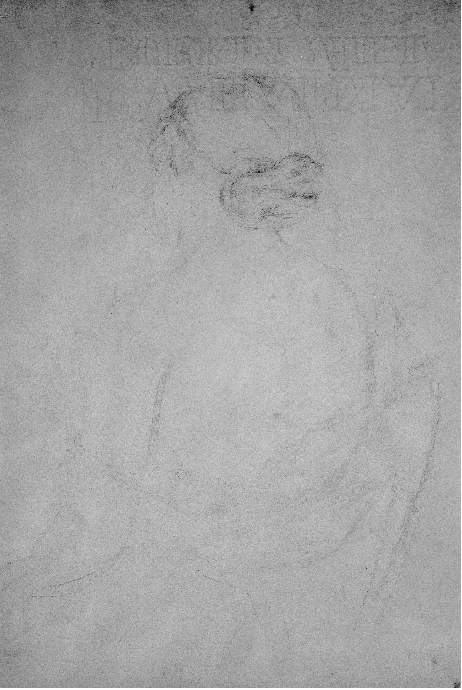
Infrared image (Fuji, 1.0–1.1 µm) of Renoir’s Woman Seated in a Chair, Seen from the Back (c. 1883). The Art Institute of Chicago, 1943.520V.
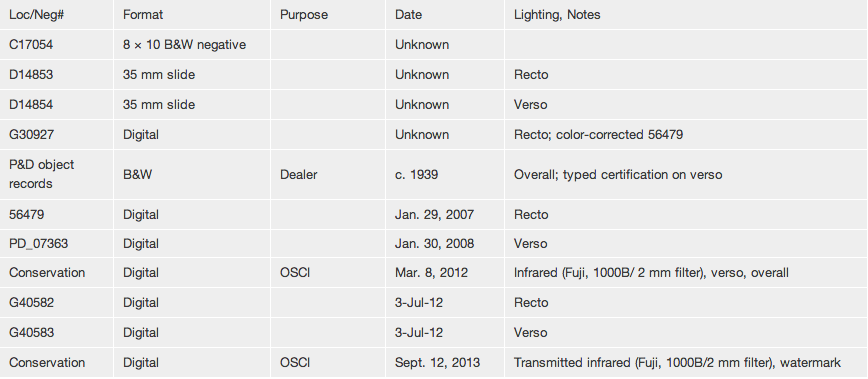
| Loc/Neg# | Format | Purpose | Date | Lighting, Notes |
| C17054 | 8 × 10 B&W negative | Unknown | ||
| D14853 | 35 mm slide | Unknown | Recto | |
| D14854 | 35 mm slide | Unknown | Verso | |
| G30927 | Digital | Unknown | Recto; color-corrected 56479 | |
| P&D object records | B&W | Dealer | c. 1939 | Overall; typed certification on verso |
| 56479 | Digital | Jan. 29, 2007 | Recto | |
| PD_07363 | Digital | Jan. 30, 2008 | Verso | |
| Conservation | Digital | OSCI | Mar. 8, 2012 | Infrared (Fuji, 1000B/ 2 mm filter), verso, overall |
| G40582 | Digital | 3-Jul-12 | Recto | |
| G40583 | Digital | 3-Jul-12 | Verso | |
| Conservation | Digital | OSCI | Sept. 12, 2013 | Transmitted infrared (Fuji, 1000B/2 mm filter), watermark |
Splashing Figure (Study for “The Large Bathers”)1143
1884/85
Red, white, and black chalk, with stumping, and black Conté crayon, on tan wove (tracing) paper, laid down on canvas; 989 × 635 mm
The Art Institute of Chicago, bequest of Kate L. Brewster, 1949.514
Renoir made this important figure study in the mid-1880s as part of an extensive body of work in preparation for The Large Bathers (fig. 2.23 [Daulte 514; Dauberville 1292]).1144 That painting, now in the Philadelphia Museum of Art, proved pivotal in his career; it signaled the artist’s move away from Impressionism and his increased interest in the art of the past. The theme of the major work is in many respects timeless: three women wash and rest in the foreground of a wooded landscape, while two others, far smaller in scale, relax in the water beyond.
The Bathers project evolved during a period in which Renoir experimented with techniques and ultimately distanced himself from the methods employed by his Impressionist peers. Although he had exhibited alongside them for more than a decade, the group had become less cohesive by the mid-1880s, and its members had dispersed. Also at this stage, Renoir sought more affluent patrons in order to ease his pressing financial worries.1145 In his adoption of Classical form—and the theme of bathers specifically—he sought to create works that would appeal to wealthy buyers.
The original inspiration for the three-quarter-length figure in the present work may have been an eighteenth-century relief sculpture made by François Girardon for the Allée des Marmousets of the Palace of Versailles.1146 As Douglas Druick has noted, Renoir managed to evoke a sense of the sculptural on the sheet by creating a halo of white around the bather.1147 Though the artist used a limited palette, he achieved a wide range of effects, adding layers of medium before blending or removing them with a stump or rag. Applied over the white chalk, the blacks look almost blue, suggestive of veins beneath flesh. Reds convey the warmth of skin; smooth white highlights provide luminosity. The dryness of chalk also seems to have informed the development of the painting, for, at this moment of his career, Renoir preferred fresco-like finishes when he worked in oil. The texture of the canvas in The Large Bathers and the grain of the paper in the Art Institute’s sheet remain pronounced, even beneath successive applications of color.
The Large Bathers was clearly a test of Renoir’s technical mastery. The range of his preparations seems to have impressed Impressionist painter Berthe Morisot, who wrote of her admiration for the artist’s draftsmanship, with mention of a “whole series done from the same model and with about the same movement” that she saw in his studio in 1886. Morisot believed that knowledge of this tireless process would challenge the public’s assumption that “the Impressionists work in a very casual way.”1148 Upon its completion, however, opinion varied regarding its merit. When the canvas was first displayed in 1887, for instance, the artist Camille Pissarro complained to his son Lucien that Renoir had “only wanted to concern himself with line; the figures are detached from one another with no thought for the harmonies, so it’s incomprehensible.”1149 He suggested that Renoir’s focus on the individual figures (as typified by Splashing Figure) had been to the detriment of the overall composition.
Certainly, the project was more labored than any the artist had attempted previously. Other studies for The Large Bathers indicate that, before deciding on the pose of the woman in the Art Institute’s sheet, Renoir toyed with the idea of showing the splashing figure from the front.1150 Even when he did settle on a view from behind, he experimented with a different model (fig. 2.24 [Dauberville 1521]): Nude Woman, Study for the “Great Bathers” shows a fuller-figured woman in a similar position, who Guy Patrice and Michel Dauberville have suggested is Suzanne Valadon.1151 The model for this figure in Three Bathers by the Water (fig. 2.25 [Dauberville 1562]), whose physique falls between that of the Splashing Figure and the Nude Woman, is also viewed from behind.1152 Her hands are cupped, and she has a similar tilt to her head.1153
Drawings in the Fogg Museum (fig. 2.26 [Dauberville 1567]) and the Hugo Perls Collection (fig. 2.30 [Dauberville 1568]), joined together, might offer the closest compositional arrangement to that of The Large Bathers.1154 The former features the two more voluptuous women who appear on the left and in the middle of the painting, while the latter includes an equivalent to the Splashing Figure (leaning slightly farther forward, with a more pronounced shoulder blade), the toe of the bather to her left, and a variant of the background group.
However, technical examination reveals that the Art Institute’s sheet is more intimately related to the completed painting than is initially apparent, which may mean that it succeeded the Hugo Perls work in the sequence of preparatory drawings for the project. The figure in the present sheet resembles her counterpart in the finished work more closely. Furthermore, when Art Institute paper conservator Kimberly Nichols examined the drawing under ultraviolet light, it became evident that a foot had originally appeared to the left of the model. This detail was erased at some point: perhaps by Renoir himself, if he preferred the look of the isolated figure on the page, or perhaps by someone else, who cut the drawing from a larger sheet to make one or more salable works.
The Bathers series may have marked a departure from Renoir’s earlier stylistic choices but, inevitably, there remain certain traits of his previous practice in Splashing Figure. The artist struggled to depict hands eloquently, and, as the awkward, pointed digits here indicate, this instance was no exception. But elsewhere, in the strands of flyaway hair beside the ear or in the thick coils of the braid, his confidence is evident. Such details suggest why, in later life, Renoir would still look back on The Large Bathers as his masterpiece.1155
Nancy Ireson
Numerous studies in graphite, Conté crayon, pastel, and oil were created in preparation for The Large Bathers (fig. 2.23 [Daulte 514; Dauberville 1292]).1156 Splashing Figure is one of three known studies of the figure at far right in the painting. The drawing employs the traditional use of trois crayon, a combination of white, red, and black chalks, in creating the composition, which is centered on a sheet of smooth, thin tan paper laid down on [glossary:canvas]. The figure appears to have been initially defined with black chalk, over which a base layer of white chalk was applied in the general shape of the figure’s form. This white underlayer appears to have been worked into the paper surface with a [glossary:stump] or rag; some streaks of chalk radiate outward from the image. This underlayer set the figure apart from the tan tonality of the paper and allowed Renoir to work from dark to light to create luminosity and tonal variation in the figure. This technique may have drawn upon the artist’s early experiences working with porcelain.
Black chalk applied over the underlying white chalk defines the general shape of the figure and establishes the flesh tones. Red and black chalks applied interchangeably establish the middle and dark tones. Volume is established by broad tonal passages of red chalk stumped or blended with the white chalk. To create subtle highlights and tonal transitions, a subtractive technique was used whereby red-chalk passages were rubbed down or away to further expose the underlying layer of white chalk. In some areas, the white underlayer is almost completely exposed, creating highlights; this is most noticeable in the face (fig. 1.2). In the shoulder, the chalk layers were rubbed away to such a degree that the paper fibers are exposed and slightly abraded (fig. 1.1). Finally, both red and black chalks were used to create strands of hair and establish facial features and details. A strong horizontal black line at the bottom of the composition suggests the waterline seen in other study drawings for this figure.1157
Some areas of the composition are slightly reworked, and the pentimenti are visible under normal conditions. Almost apparent, the figure’s hands were reworked to form a more acute cupped shape, placed slightly higher than in the original rendering (fig. 2.20).1158 The former lines appear to have been rubbed out or blended; it is not clear whether additional white chalk was applied to mask the initial drawn lines before reworking them. [glossary:Infrared reflectography] (IRR) reveals that the arms were initially modeled with black chalk and the buttocks were reworked. The ear, lips, chin, and neck were also reworked to tilt the head back a bit more (fig. 1.3). In addition, a faint rendering of a foot, formerly erased, is visible with IRR and under [glossary:UV] at the lower left side of the sheet (fig. 2.22). The presence of this foot suggests that the composition once extended further at the left side but was at some point cut down.1159
Though Splashing Figure most certainly relates to The Large Bathers, close study of the technical findings and other works of the same subject reveals that Splashing Figure most closely corresponds to The Great Bathers (fig. 2.28 [Dauberville 1291]) and its preparatory drawing, Three Bathers by the Water (fig. 2.25 [Dauberville 1562]).1160 Indeed, Christopher Riopelle has suggested that these two works may be the first fully realized figural arrangements for The Large Bathers.1161 In the painting and study, the center figure’s proper left arm reaches up for a tree branch, and it may be this figure’s reach that is represented by the parallel lines in the upper left corner of Splashing Figure. By contrast both of the center figure’s arms reach downward in The Large Bathers. In addition, the hands of the far right “splashing figure” are cupped in all three works, but are flat in The Large Bathers. Furthermore, the erased foot that is observed in IRR/UV entering from the left side of Splashing Figure exhibits the same orientation as the proper left foot of the reclining figure on the far left in Three Bathers by the Water and The Large Bathers—whereas it is the proper right foot that extends from the center figure in The Large Bathers. There are also no additional figures in the background of Three Bathers by the Water and Splashing Figure, though some are represented in another study of the “splashing figure”: Study, Three Right Figures and Part of a Foot (fig. 2.30 [Dauberville 1568]).1162 Lastly, the paper supports of both drawings are almost identical in height, suggesting that they may originate from the same period of the artist’s work.
Tan, thin, smooth [glossary:wove] paper.1163
Leyand E-Paul a Gemens (ISERE) is partially visible along the center bottom edge of the [glossary:support], above the strainer, with infrared reflectography (fig. 1.4). Documentation for this [glossary:watermark] could not be found; Gemens likely refers to a parish, and Isere to the river in southeastern France that was important for paper production starting in the sixteenth century.
Highly uniform, with some dark fiber-bark inclusions.
Even, machine made.
The edges of the paper support are wrapped with paper tape and not visible.
Approx. 989 × 635 mm (the edges of the sheet are not visible).
Canvas: Most likely linen, [glossary:plain weave]. There is not enough exposed [glossary:weave] to provide an accurate weave count.1164 The primary paper support is adhered overall to the canvas. The weave structure has transferred to the paper, most likely due to strong pressure or moisture introduced during the mounting process; this texture is most apparent in raking illumination. There are no labels or marks on the verso. Dimensions: 1025× 6073 mm.
Stretcher: Seven-member keyable wooden [glossary:stretcher] with one vertical and two horizontal half-lap cross-braces. The dimensions are standard for nineteenth-century French stretchers.1165 The paper and canvas supports are wrapped taut around the stretcher and nailed along the sides at intervals of approximately 1.5–2 cm. The sides of the stretcher are wrapped with brown gummed paper tape that hides the nail heads; the paper tape extends 5 cm over the recto of the support and wraps over the side edges, overlapping to varying degrees onto the verso. There are remnants of various materials around the perimeter of the stretcher, including a former dark blue-green paper on the verso; there is also evidence of pressure-sensitive tape and adhesive residue. There are no labels or marks on the verso. Dimensions: 100.0 × 65.0 × 17 cm.
There does not appear to be any surface material or preparation overall; an irregular application of white chalk is evident in the area below the figure.
Under UV illumination, the paper surface emits a pale yellow visible-light [glossary:fluorescence] that is characteristic of a gelatin sizing in the paper.
The figure was drawn in red, white, and black chalk. Analysis indicates the presence of iron oxide and possibly calcium carbonate and carbon black.1166 The form was first generally worked out in black chalk, over which a layer of white chalk was laid down in the center area and extending just beyond the figure. It appears to have been blended overall with a stump or rag, as the chalk is worked into the interstices of the paper fibers rather than simply resting in clumps on the surface. Some streaks of white chalk radiate outward from the image. Black chalk was applied over the underlying white-chalk layer to define the general shape of the form. Red and black chalks were then applied interchangeably to establish middle and dark tones. Passages of red chalk were blended into the white chalk to create volume in the figure’s body and subtle tonal transitions in the face. Some areas were then rubbed away, further exposing the underlying layer of white chalk to create highlights and subtle tonal transitions; in some chalk passages the rubbing caused some surface disruption of the paper fibers. Black chalk (possibly dampened) or [glossary:Conté crayon] were used to create fine, detailed lines in the head, face, and hands.
The composition was reworked in some areas by rubbing away previously drawn lines and applying new lines in black and red chalk. Under magnification, white and red chalk are blended together on the surface of the reworked passages; there are no pure strokes of white chalk on the surface to confirm that additional white chalk was added to conceal former drawing lines. Most noticeably, the figure’s proper right hand at the lower left area was adjusted to create a more cupped form set at almost ninety-degree angle to her arm, and hidden almost completely by her proper left hand. The figure’s proper right arm was also reworked to raise it slightly higher than it was initially drawn. Some areas of her torso, including her back, buttocks, stomach, and arms were slightly reworked. The ear, lips, chin, and neck were also shifted slightly up and back to tilt the head back a bit more. In addition, examination under UV and infrared reflectography revealed that another figure’s foot once entered the composition at the lower left side of the support but was formerly erased (fig. 2.22). The presence of this foot also suggests that the composition was once larger, extending further on the left side, but was at some point cut down.
In raking illumination, an irregular, transparent, light-reflectance is visible on the paper surface in areas not covered by media; it is unclear whether this reflectance is due to a light-working fixative applied to the drawing at an early stage of its development, or simply is evidence of a heavy sizing applied to the paper surface before the composition was executed. Under magnification, areas of media appear quite powdery and do not reveal any trace of a fine particulate that would suggest that a surface fixative was applied upon completion of the drawing. The paper surface emits a faint visible-light fluorescence under UV illumination that is also characteristic of a gelatin [glossary:sizing] in the paper; the visible-light fluorescence is less prominent in areas where the paper was not protected from increased oxidation by the [glossary:strainer]. There are numerous, small, irregular areas of absorption that could be the result of retouched surface alterations. Fingerprints and residue from the adhesive used to mount the paper to the canvas also emit a bright yellowish-white visible-light fluorescence.
The paper, originally a light tan tone, exhibits moderate overall discoloration. There are small, irregular surface alterations throughout, although most concentrated along the perimeter that may be areas of [glossary:retouching]. There is a dark streak along the right side, and the perimeter exhibits some darkening and surface soiling. Some small losses are visible in thickly applied areas of media, and there are some small scratches. Most notably there are fine horizontal creases that exhibit some media loss and darkening.
The drawing appears stable overall and well adhered to its mount and stretcher. There are loose and unraveled threads along the canvas edge.
Kimberly Nichols
Ambroise Vollard (1866–1939), Paris.1167
Sold by Adrien Hébrard (1833–1914), Paris, to Bernheim-Jeune & Cie., Paris, May 29, 1925.1168
Sold by Bernheim-Jeune & Cie., Paris, to Walter S. Brewster (1872–1954) and Kate L. Brewster (c. 1879–1947), Lake Forest, Ill., Mar. 19, 1926.1169
Bequeathed by Kate L. Brewster to the Art Institute of Chicago, 1949.
Chicago, Arts Club, A Loan Exhibition of Some Modern Paintings, Dec. 21, 1926–Jan 21, 1927, cat. 13.
Chicago, home of Mr. and Mrs. Walter Brewster, Special View for the Benefit of Chicago Public School Art Society of the Collection of Mr. and Mrs. Walter S. Brewster, Jan. 20–22, 1933, cat. 24.
Paris, Musée de l’Orangerie, De David à Toulouse-Lautrec: Chefs-d’oeuvre des collections americaines, 1955, cat. 87 (ill.).
New York, Wildenstein and Company, Master Drawings from the Art Institute of Chicago, Oct. 17–Nov. 30, 1963, cat. 113 (ill.).
Paris, Musée du Louvre, Dessins français de l’Art Institute de Chicago de Watteau à Picasso, Oct.15, 1976–Jan. 17, 1977, cat. 68 (ill.).
Frankfurt am Main, Germany, Städtische Galerie im Städelschen Kunstinstitut, Französische Zeichnungen aus dem Art Institute of Chicago, Feb. 10–Apr. 10, 1977, cat. 61 (ill.).
Tokyo, Isetan Museum of Art, Auguste Renoir, Sept. 22–Nov. 6, 1979, cat. 90 (ill.); Kyoto Municipal Museum of Art, Nov. 10–Dec. 9, 1979.
Art Institute of Chicago, Undressed: The Fashion of Privacy, June 22–Sept. 29, 2013, no cat.
Julius Meier-Graefe, Renoir (H. Floury, 1912), p. 193 (ill.).
C. J. Bulliet, Apples and Madonnas: Emotional Expression in Modern Art (Covici Friede, 1930) (ill.).
Michel Drucker, Renoir (Pierre Tisné, 1944), pl. 4, no. 2.
John Rewald, Renoir Drawings (H. Bittner, 1946), p. 20, no. 41 (ill.).
Graham Reynolds, Nineteenth-Century Drawings (Pleiades, 1949), no. 11 (ill.).
Art Institute of Chicago Quarterly 49, 2 (Apr. 1955), p. 29.
François Daulte, Pierre-Auguste Renoir: Water-colours, Pastels, and Drawings in Colour, trans. Robert Allen (Faber & Faber, 1959), no. 7 (ill.).
Ira Moskowitz, Great Drawings of All Time, vol. 2 (Shorewood, 1962), no. 802 (ill.)
Maurice Sérullaz and Arlette Sérullaz, L’ottocento francese (Fratelli Fabbri, 1970), pp. 73, no. 28 (ill.) and 91.
John Maxon, The Art Institute of Chicago (Thames & Hudson, 1970), pp. 159–60 (ill.).
Mike Samuels and Nancy Samuels, Seeing with the Mind’s Eye: The History, Techniques, and Uses of Visualization (Random House, 1975) (ill.).
Anthea Callen, Renoir (Oresko, 1978), p. 88, no. 71 (ill.).
Harold Joachim and Sandra Haller Olsen, French Drawings and Sketchbooks of the Nineteenth Century, vol. 2 (University of Chicago Press, 1979), p. 91, no. 5D9.
Richard R. Brettell, French Impressionists (Art Institute of Chicago, 1987), pp. 84–85, 119 (ill.).
Horst Keller, Auguste Renoir (Bruckmann München, 1987), p. 127, no. 102 (ill.).
Mosaic: Survey of the Art Institute of Chicago (May–June 1987), p. 7 (ill.).
Christopher Riopelle, “Renoir: The Great Bathers,” Philadelphia Museum of Art Bulletin 86 (Fall 1990), pp. 27–28, fig. 29.
Anne Distel, Renoir: A Sensuous Vision (Thames & Hudson, 1995), p. 95 (ill.).
Barbara Ehrlich White, Impressionists Side by Side: Their Friendships, Rivalries, and Artistic Exchanges (Knopf, 1996), p. 228 (ill.).
Douglas W. Druick, Renoir, Artists in Focus (Art Institute of Chicago/Abrams, 1997) pp. 61, 64, 98, no. 17 (ill.), 111.
Susan Rayfield, First Impressions: Pierre-Auguste Renoir (Abrams, 1998), p. 69 (ill.)
Guy-Patrice Dauberville and Michel Dauberville, Renoir: Catalogue raisonné des tableaux, pastels, dessins, et aquarelles, vol. 2, 1882–1894 (Bernheim-Jeune, 2009), p. 515, no. 1517 (ill.).
Christopher Lloyd, Impressionism: Pastels, Watercolors, Drawings, exh. cat. (Milwaukee Art Museum, 2011), pp. 50–51, fig. 17.
Paper support characteristics identified.
Paper mold characteristics identified.
Application of surface films examined.
Corrections and/or changes in the initial composition identified; watermark at center bottom edge of support identified.
Media and technical development identified.
Identified iron oxide and calcium-based pigments. Several spots on the drawing were analyzed in situ with a Bruker/Keymaster TRACeR III-V with rhodium tube.
The image inventory compiles records of all known images of the artwork on file in the Imaging Department and in the conservation and curatorial files in the Department of Prints and Drawings at the Art Institute of Chicago (fig. 2.29).
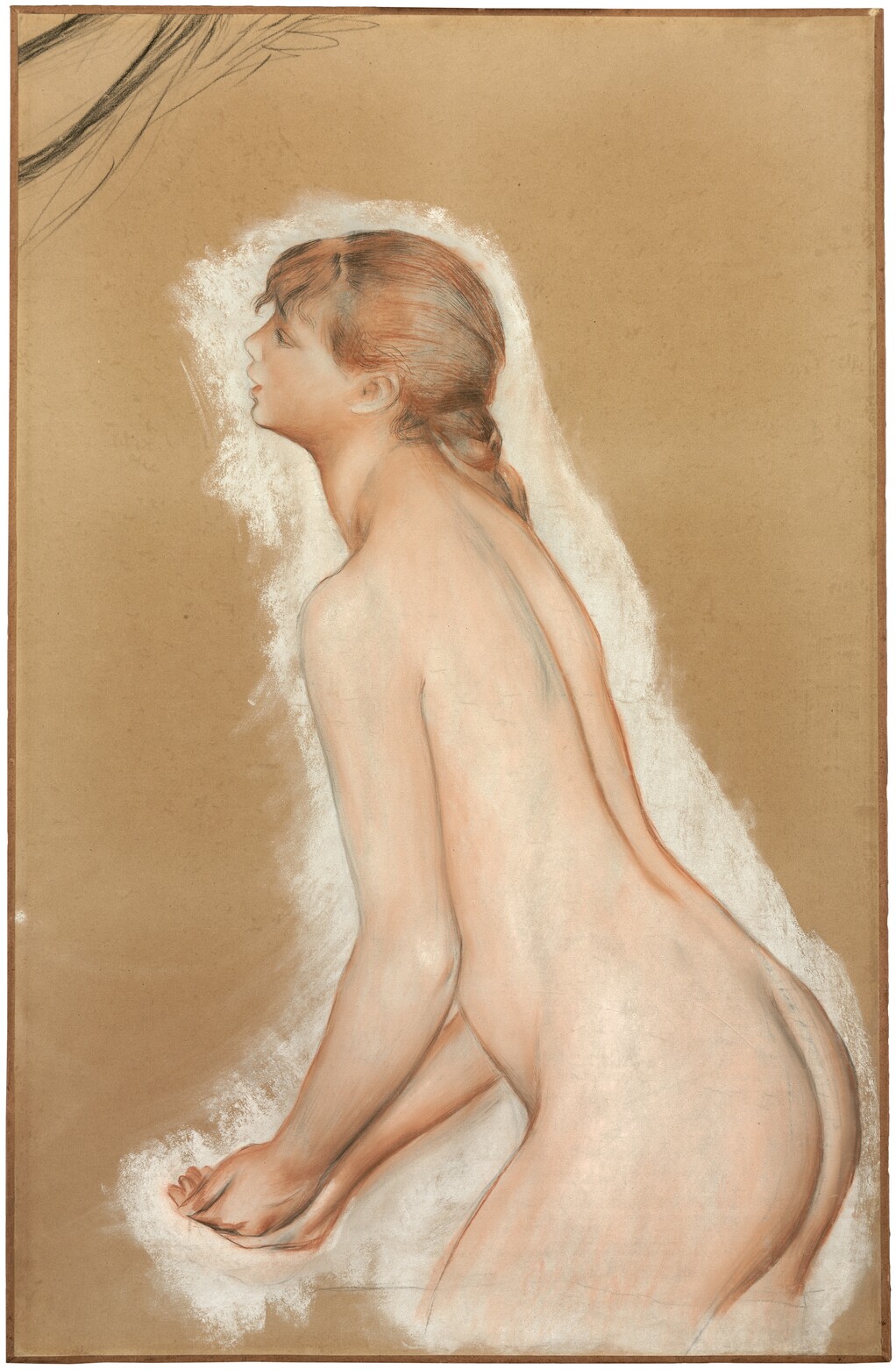
cat. 19 Splashing Figure (Study for “The Large Bathers”), 1884/85.
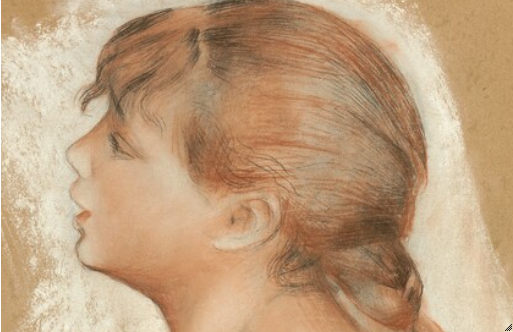
Detail of Renoir’s Splashing Figure (Study for “The Large Bathers”) (1884/85) showing an area where the artist rubbed away the red-chalk passage to expose the underlying layer of white chalk to create highlights. The Art Institute of Chicago, 1949.514.
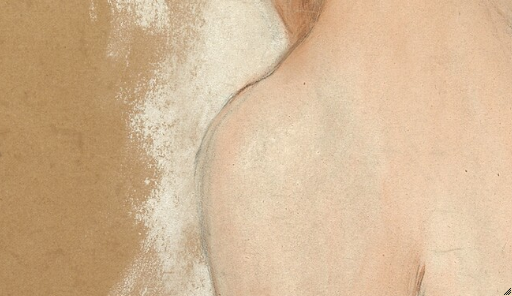
Detail of Renoir’s Splashing Figure (Study for “The Large Bathers”) (1884/85) showing an area where the chalk layers were rubbed away to such a degree that the paper fibers are exposed. The Art Institute of Chicago, 1949.514.
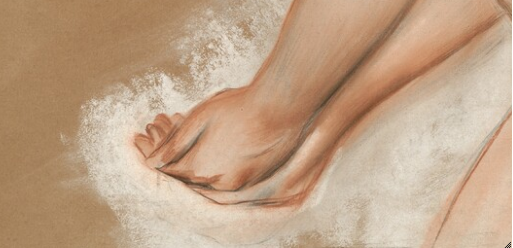
Detail of Renoir’s Splashing Figure (Study for “The Large Bathers”) (1884/85) showing the pentimenti where the artist reworked the hands. The Art Institute of Chicago, 1949.514.
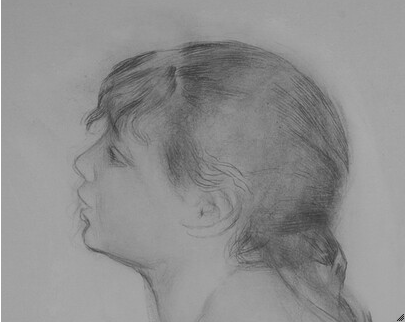
Infrared reflectogram detail (Fuji, 1.0–1.1 µm) of Renoir’s Splashing Figure (Study for “The Large Bathers”) (1884/85) showing the reworking of the face and the placement of the ear. The Art Institute of Chicago, 1949.514.
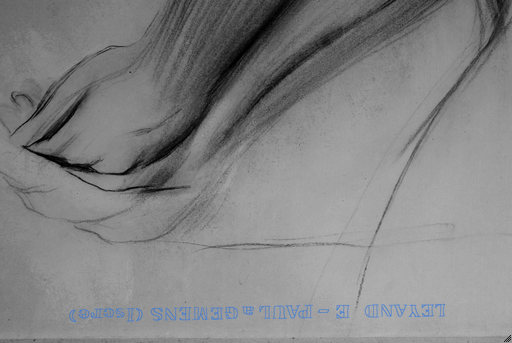
Infrared reflectogram detail (Fuji, 1.0–1.1 µm) of Renoir’s Splashing Figure (Study for “The Large Bathers”) (1884/85) showing the paper's watermark. The Art Institute of Chicago, 1949.514.
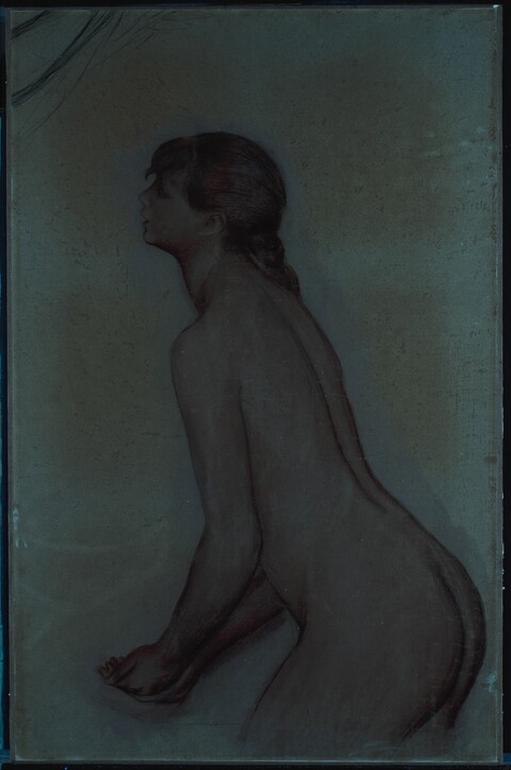
Ultraviolet, infrared-reflectogram (Fuji, 1.0–1.1 µm), and natural-light images of Renoir’s Splashing Figure (Study for “The Large Bathers”) (1884/85) showing an earlier compositional drawing in the lower area. The Art Institute of Chicago, 1949.514. Interactive image.
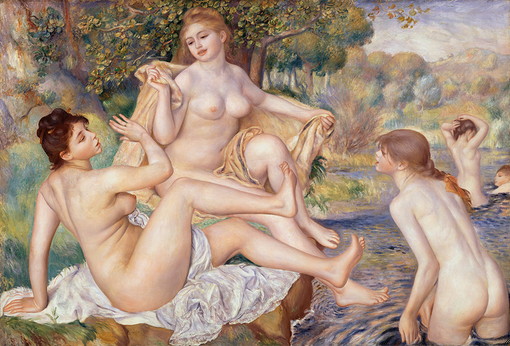
Pierre-Auguste Renoir (French, 1841–1919). The Large Bathers, 1884/87. Oil on canvas; 117.8 × 170.8 cm (46 3/8 × 67 1/4 in.). The Philadelphia Museum of Art, The Mr. and Mrs. Carroll S. Tyson, Jr., Collection, 1963, 1963-116-13. Bridgeman Images.
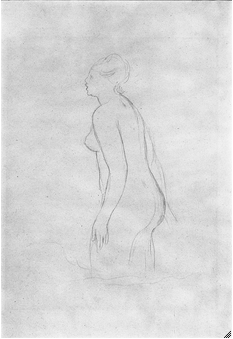
Pierre-Auguste Renoir (French, 1841–1919). Nude Woman, Study for the “Great Bathers,” c. 1884–87. Graphite on off-white wove paper; 31.1 × 20.2 cm (12 1/4 × 7 15/16 cm). Harvard Art Museums/Fogg Museum, Gift of Mr. and Mrs. John Rewald, 1959.131. Imaging Department © President and Fellows of Harvard College.

Pierre-Auguste Renoir (French, 1841–1919). Three Bathers by the Water, c. 1882. Red chalk and black crayon, with white chalk highlights; 108 × 162 cm. Musée du Louvre, Paris, RF 29660. © RMN-Grand Palais/Art Resource, NY. Photograph: Michèle Bellot.
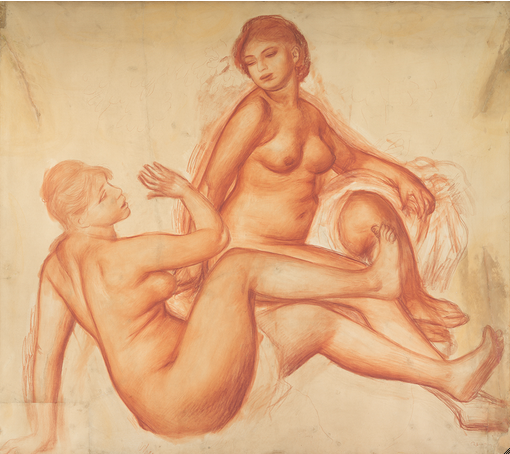
Pierre Auguste Renoir (French, 1841–1919). Two Nude Women, Study for “The Great Bathers”), c. 1884/87. Red and white chalk on buff wove paper, yellowed; 110.6 × 124.7 cm. Harvard Art Museums/Fogg Museum, Bequest from the Collection of Maurice Wertheim, Class of 1906, 1951.77. Imaging Department © President and Fellows of Harvard College.
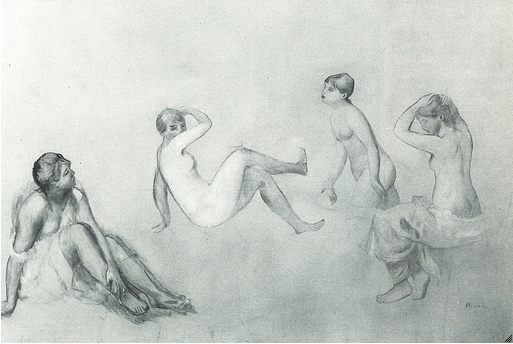
Pierre-Auguste Renoir (French, 1841-1919). Study for “The Great Bathers,” c. 1884-87. Oil on canvas; 62 × 95 cm (24 3/8 × 37 3/8 in.). Private collection, Paris.
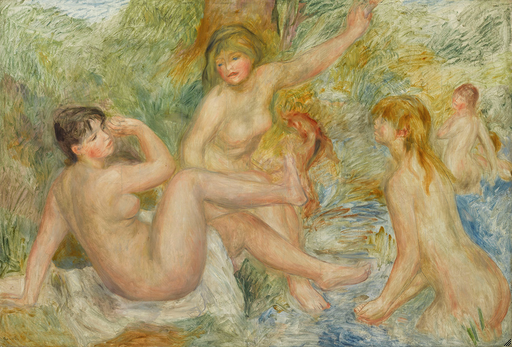
Pierre-Auguste Renoir (French, 1841-1919). The Great Bathers, c. 1886, reworked 1901-02. Oil on canvas; 115 × 168 cm (45 1/4 × 66 1/8 in.). Musée Renoir, Dépôt de l’État, Cagnes-Sur-Mer.
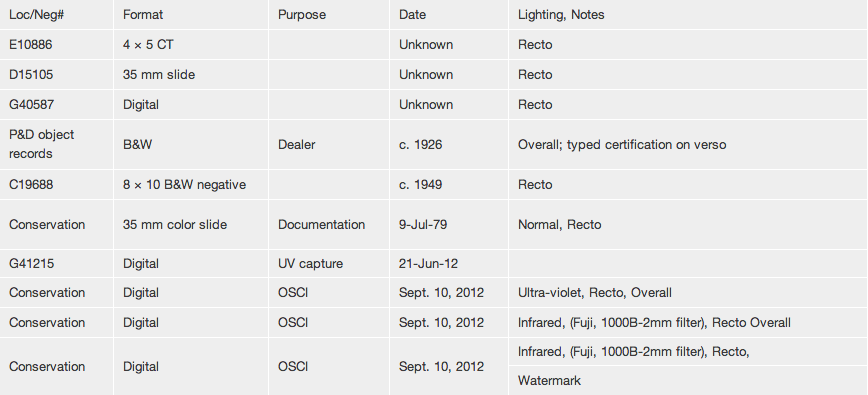
| Loc/Neg# | Format | Purpose | Date | Lighting, Notes |
| E10886 | 4 × 5 CT | Unknown | Recto | |
| D15105 | 35 mm slide | Unknown | Recto | |
| G40587 | Digital | Unknown | Recto | |
| P&D object records | B&W | Dealer | c. 1926 | Overall; typed certification on verso |
| C19688 | 8 × 10 B&W negative | c. 1949 | Recto | |
| Conservation | 35 mm color slide | Documentation | 9-Jul-79 | Normal, Recto |
| G41215 | Digital | UV capture | 21-Jun-12 | |
| Conservation | Digital | OSCI | Sept. 10, 2012 | Ultra-violet, Recto, Overall |
| Conservation | Digital | OSCI | Sept. 10, 2012 | Infrared, (Fuji, 1000B-2mm filter), Recto Overall |
| Conservation | Digital | OSCI | Sept. 10, 2012 | Infrared, (Fuji, 1000B-2mm filter), Recto, |
| Watermark |
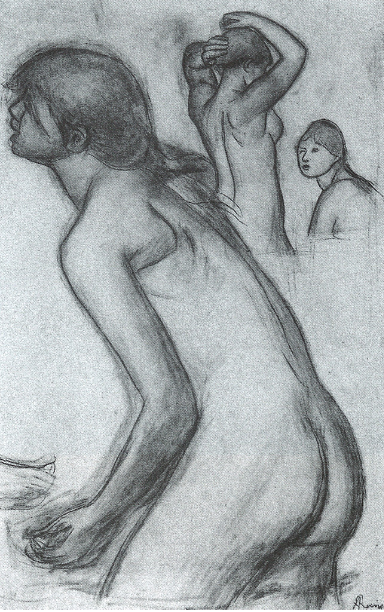
Pierre-Auguste Renoir (French, 1841–1919). Study, Three Right Figures and Part of Foot, c. 1885. Red chalk and charcoal with white highlights; 83 × 53 cm (32 11/16 × 20 7/8 in.). Hugo Perls Collection, Berlin.
Studies of Trees and Foliage1170
1884/87
Pen and black ink, with opaque and transparent watercolor, on ivory wove paper; 497 × 309 mm
The Art Institute of Chicago, gift of Mrs. Potter Palmer, 1948.75
The small clusters of detail on this sheet, which the artist developed to different degrees of completion, may have been produced on separate occasions. The delicate draftsmanship of the group in the upper left, for instance, contrasts markedly with the freer, brightly colored areas at center right and right.
It was common for Renoir to work on a single page intermittently. An example of this is his Study of an Iris and a Tree (1883/85; collection of Mrs. G. B. Springwell, in which the motifs are quite distinct from one another. It is possible that this working method helped him to hone his ideas (as had been the case in his Sheet of Studies [fig. 1.4] [Dauberville 1621] for The Great Bathers).1171 However, since the Art Institute’s sheet bears no strong connection to a more substantial work, it may have been a playful exercise that served no serious purpose.
Contrasts in style and handling across the page might even suggest that, in addition to drawing the respective clusters at different moments, Renoir revisited some of them repeatedly. For instance, if the small looped lines he used to sketch the trees at the lower left of the page resemble the marks he made in his Study of a Tree (fig. 2.22), the faint yellow wash and touches of brighter blue and green convey a different mood. Perhaps they belong to a later moment. They are casual, as are the red and purple dots he added to their lower right.
Renoir applied color directly to the largest painted area in this work. He established the contours of the foliage in blue, perhaps mindful of his friend Paul Cézanne, who used this strategy often in his painting.1172 The artists had worked together in the south of France in the mid-1880s.1173 Certainly, the tonality here is Mediterranean in feel; against a fresh blue background, warm reds and oranges enliven the more predictable touches of green.
Nancy Ireson
In Studies of Trees and Foliage, Renoir created five individual studies in pen and black ink and watercolor, distributing them fairly evenly apart on the moderately thick, ivory [glossary:wove] paper. The studies were executed with a similar handling and style, but they range in development. Opaque (gouache) and transparent watercolors were applied by brush to varying degrees in the four studies in the lower half of the sheet. The study in the upper left quadrant was drawn directly in pen and black ink (fig. 1.2), whereas the study just below it, in the lower left quadrant, was rendered more realistically, with broad applications of transparent yellow [glossary:wash] and touches of blue watercolor over the pen and ink (fig. 1.1). At center bottom, there is a small area of brightly colored watercolor washes that may be initial attempts at rendering the landscape or perhaps a purely technical exploration (fig. 1.3).
In contrast to the more direct work in pen and ink on the left side, Renoir created three richly decorative studies at the center right side of the sheet by layering transparent and opaque watercolor with a fine brush (fig. 2.20). The two smallest studies were created by applying watercolor over the pen and black ink lines, whereas the largest was created entirely in watercolor by laying down lines of red and blue watercolor and small dabs of varying colors.
Ivory, moderately thick, moderately textured wove paper.1174
Uniform, without significant inclusions or colored fibers.
Even, machine made.
[glossary:Deckle edges] are present along the left, top, and bottom edges; the right edge is trimmed straight.
497 × 309 mm
No artistic surface alterations or coatings are visible under normal conditions or under magnification. Under ultraviolet ([glossary:UV]) illumination, there is a pale-yellow visible-light [glossary:fluorescence] overall on the paper surface that is characteristic of a light gelatin surface [glossary:sizing]; the fluorescence is most pronounced around the perimeter of the paper sheet where the window mat protected it from exposure to light.
Pen and black ink was used to lay out four of the five compositional studies. The study at the upper left was created entirely in pen and black ink. Opaque (gouache) and transparent watercolors were used to varying degrees in the remaining four studies in the lower half of the sheet. Watercolor was applied over pen and brush in three of these studies, whereas the largest study at the center right side was executed entirely in watercolor.
There is no drawing on the verso.
No revisions or changes to the composition are visible under normal conditions or magnification other than intended experimentation with coloring.
No artistic surface fixatives or coatings are visible under normal conditions, UV illumination, or magnification.
The drawing exhibits light discoloration overall that is darkest at the edges. Surface soiling and light handling dents appear around the perimeter due to general handling of the sheet. The edges are particularly soiled, and the lower right edge is irregularly formed and slightly indented. A small indentation is visible in the support surface at lower left. In the upper right area, there is a yellowish-brown stain that is approximately .02 cm in diameter.
On the verso, there are three areas of residual material or adhesive along the right edge that slightly absorb UV radiation and likely relate to former hinging spots. There are undulations along the left edge that also likely relate to former hinging.
Kimberly Nichols
Ambroise Vollard (1866–1939), Paris.1175
Fraysse collection, Paris, by 1938.1176
Sold by Durlacher Brothers, New York, to Philip Hofer (1898–1984), Cambridge, Mass., Nov. 28, 1938.1177
Consigned by Phillip Hofer to Durlacher Brothers, New York, Oct. 1947.1178
Sold by Durlacher Brothers, New York, to the Art Institute of Chicago, 1948.
Paris, Galeries Durand-Ruel, Aquarelles, pastels et dessins par Renoir, Apr. 4–23, 1921, cat. 16.1179
Cambridge, Mass., Fogg Museum, Harvard Art Museums, 1944–1947.1180
Santa Barbara (Calif.) Museum of Art, Painted Papers: Watercolors from Dürer to the Present, Mar. 15–Apr. 15, 1962, cat. 69.
Paris, Musée du Louvre, Dessins français de l’Art Institute de Chicago de Watteau à Picasso, Oct. 15, 1976–Jan. 17, 1977, cat. 69 (ill.).
Frankfurt am Main, Germany, Städtische Galerie im Städelschen Kunstinstitut, Französische Zeichnungen aus dem Art Institute of Chicago, Feb. 10–Apr. 10, 1977, cat. 62 (ill.).
Tokyo, Isetan Museum of Art, Exposition Renoir, Sept. 26–Nov. 6, 1979, cat. 91 (ill.); and the Kyoto Municipal Museum, Nov. 10–Dec. 9, 1979.
John Rewald, Renoir Drawings (H. Bittner, 1946), p. 21, no. 50 (ill.).
Harold Joachim and Sandra Haller Olsen, French Drawings and Sketchbooks of the Nineteenth Century, vol. 2 (University of Chicago Press, 1979), p. 92, no. 5D11.
Douglas W. Druick, Renoir, Artists in Focus (Art Institute of Chicago/Abrams, 1997), pp. 71, 91, 111, no. 18 (ill.).
Guy-Patrice Dauberville and Michel Dauberville, Renoir: Catalogue raisonné des tableaux, pastels, dessins et aquarelles, vol. 2, 1882–1894 (Bernheim-Jeune, 2009), p. 579, no. 1630 (ill.).
Inscription
Location: lower right corner
Method: [glossary:graphite]
Content: 132- (?) [partially erased]
Inscription
Location: upper right corner
Method: stamped in pale red ink
Content: Douanes Exposition Paris
Mark
Location: center left
Method: graphite
Content: No 130
Mark
Location: upper center area
Method: graphite
Content: M129
Paper [glossary:support] characteristics identified.
Paper mold characteristics identified.
Light surface sizing detected, most visible at the perimeter.
Media identified.
The image inventory compiles records of all known images of the artwork on file in the Imaging Department and in the conservation and curatorial files in the Department of Prints and Drawings at the Art Institute of Chicago (fig. 2.23).
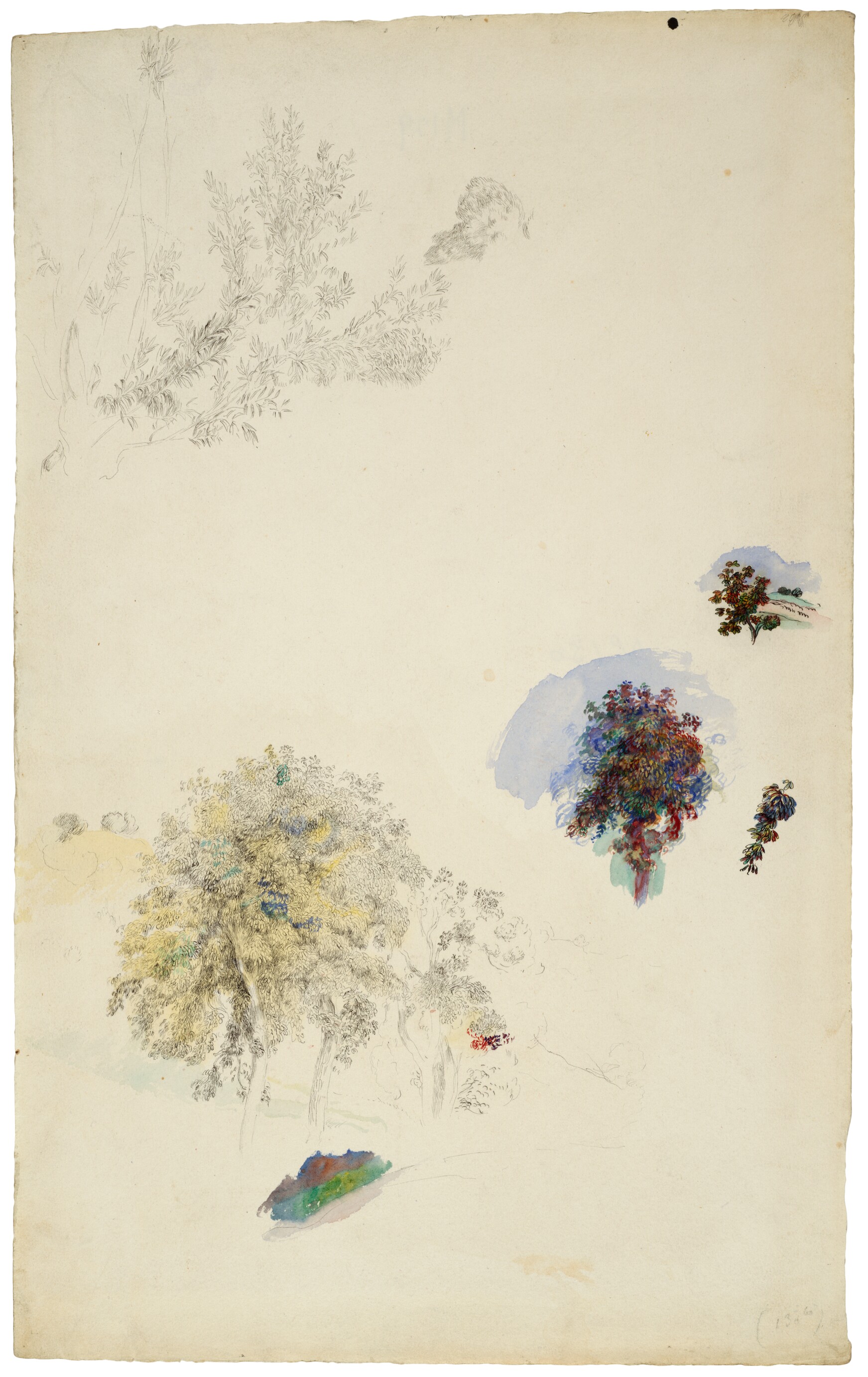
cat. 20 Studies of Trees and Foliage, 1884/87.
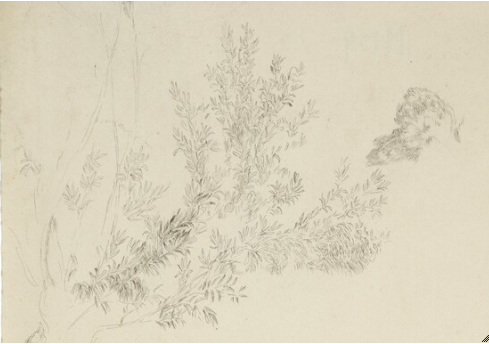
Detail of Renoir’s Studies of Trees and Foliage (1884/87) showing one of the studies in pen and black ink. The Art Institute of Chicago, 1948.75.
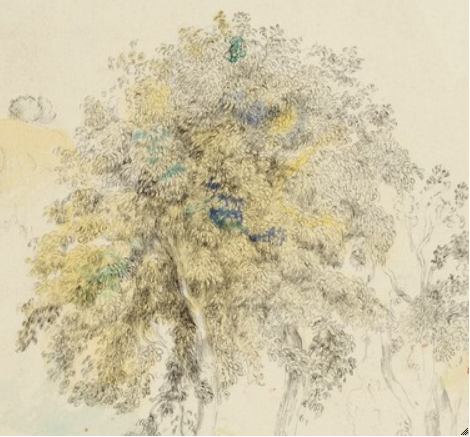
Detail of Renoir’s Studies of Trees and Foliage (1884/87) showing the addition of transparent watercolor over the pen and ink lines. The Art Institute of Chicago, 1948.75.
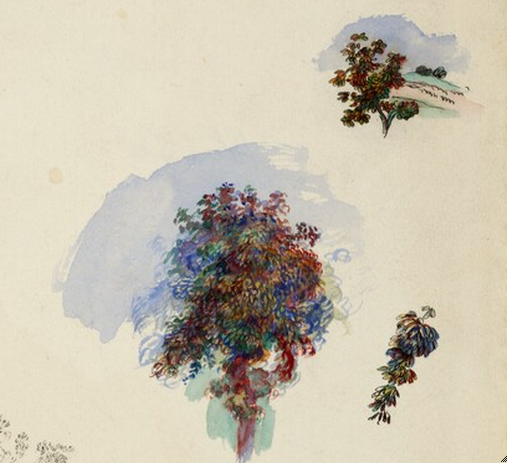
Detail of Renoir’s Studies of Trees and Foliage (1884/87) illustrating the dense layering of both transparent and opaque watercolor. The Art Institute of Chicago, 1948.75.
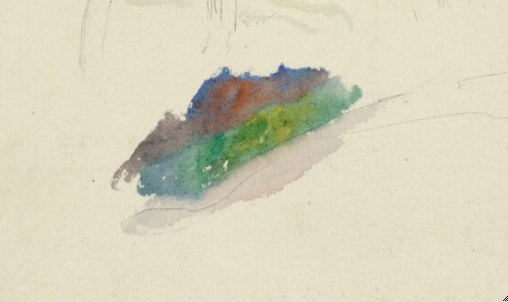
Detail of Renoir’s Studies of Trees and Foliage (1884/87) showing explorations in brightly colored watercolor washes. The Art Institute of Chicago, 1948.75.
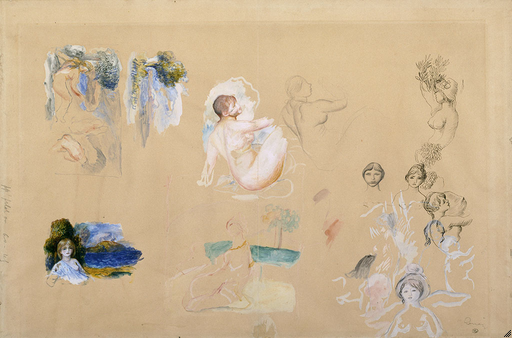
Pierre-Auguste Renoir (French, 1841–1919). Sheet of Studies, 1885/86. Pen and black ink, pencil, and watercolor, on beige paper; 32.5 × 49.5 cm (12 13/16 × 19 1/2 in.). Musée du Louvre, Paris, RF 28657, recto.
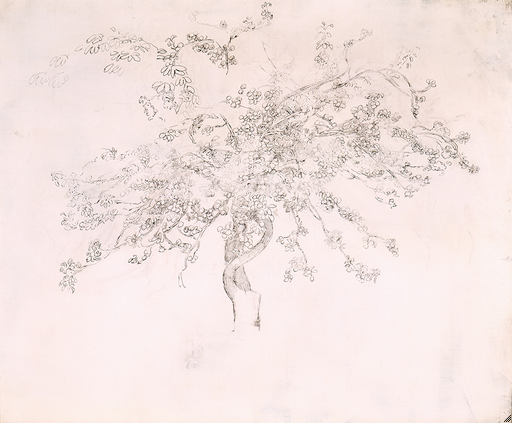
Pierre-Auguste Renoir (French, 1841–1919). Study of a Tree, c. 1884–86. Pen and india ink on canvas; 54 × 64.8 cm (20 × 24 1/2 in.). New Orleans Museum of Art, The Muriel Bultman Francis Collection, 86.285.

| Loc/Neg# | Format | Purpose | Date | Lighting, Notes |
| E10656 | 4 × 5 CT | Unknown | ||
| D14146 | 35 mm slide | Unknown | Recto | |
| Conservation | 35 mm color slide | Pretreatment | 9-Jul-97 | Normal, recto |
| Conservation | 35 mm color slide | Pretreatment | 9-Jul-97 | Normal, verso |
| Conservation | 35 mm color slide | Pretreatment | 9-Jul-97 | Raking, recto |
| E22370 | 4 × 5 CT | Sept. 26, 1990 | ||
| G28600 | Digital | Mar. 28, 2008 | Recto | |
| G40586 | Digital | 3-Jul-12 | Recto |
Bather1181
c. 1885
Red chalk, with traces of graphite, on cream laid paper; 427 × 314 mm
The Art Institute of Chicago, gift of Robert Allerton, 1937.18
The subject of the female nude—the bather in particular—dominated much of Renoir’s work in the 1880s. This cursory sketch is an exercise in capturing physical movement: the woman leans forward as she bends down slightly, a towel clutched to her chest, one arm thrust forward as if to steady her balance. This is but one of many gestures that the artist explored during these years, as he developed his monumental work The Large Bathers (fig. 1.4 [Daulte 514; Dauberville 1292]).1182 The present sheet does not connect with the Philadelphia canvas directly, but it may have helped Renoir to hone his ideas in the preparatory stages. The uncertainty of particular details conveys an experimental quality: the hesitant placement of the woman’s proper right leg, for instance, or the multiple attempts to situate the outstretched arm.
Executed in red chalk on a highly textured paper, the drawing appears in some respects timeless. Renoir’s choice of media was as historicizing as the theme; eighteenth-century draftsmen used red chalk frequently, and Renoir had a deep admiration for Rococo artists Jean-Antoine Watteau and François Boucher. The pose here also invites time-honored associations. Crouching as if to hide her body, the female figure recalls the main protagonist in the Biblical story of Susanna and the Elders (Dan. 13), depicted by artists as diverse as Tintoretto and Peter Paul Rubens in centuries past. The bather motif was also popular in the contemporary art of the era; it was a favorite with the Impressionists as well as with the more conservative artists who exhibited in the state-sponsored Salon.1183
Indeed, in some respects, the preference that this drawing reveals for sensual materials and subject matter reflects Renoir’s view that modern art should not always dwell on the harsher aspects of daily life. The artist’s son recalled that his father felt the need to “caress and stroke the motif.”1184 This might explain the attention Renoir paid to details such as the dimpled thigh and upswept hair in a study where he chose not to resolve the hands and feet.
Nancy Ireson
Renoir drew Bather right in the center of the cream-colored [glossary:laid paper] support using a relatively hard red chalk to create crisp, fine lines. He formed the fine figural lines with a minimum of long, fluid strokes. In some cases, the artist reinforced existing lines or used additional strokes to develop the bather’s form. This is most visible in her arms and legs. Renoir created volume with minimal shading. A few linear, hatched strokes form the neck and proper right shoulder (fig. 1.2), and a single broad stroke made by positioning the chalk at a slight angle to the support suggests a shadow in the proper left thigh (fig. 1.1). There is no blending of the chalk to create volume in the figure.
The drawing may have been taken from a sketchbook or album, as the sheet appears to have residual adhesive along its torn left edge. There are also smaller figural sketches in [glossary:graphite] at the center bottom of the sheet, most easily seen with the aid of infrared radiation (fig. 2.20). It is not possible to determine when the additional figures were placed on the sheet, although they do not appear to directly relate to the current subject.
Cream, moderately thick, moderately textured laid paper.1185
Gerhard Loeber (complete, horizontal orientation, through lower center of sheet) (fig. 1.3).
Vertical, 2.8–2.9 cm.
8–9 per cm.
Uniform, without visible inclusions or colored fibers.
Even, possibly machine made.
The paper exhibits a clean, straight cut along the right side; the remaining sides are edge-torn and have slight irregularities. There appear to be traces of adhesive residue along the left edge, possibly from a former binding in a sketchbook or block.
427 × 314 mm
No artistic surface alterations or coatings are visible under normal conditions or magnification. Under ultraviolet ([glossary:UV]) illumination, there is a pale-yellow visible-light [glossary:fluorescence] that is characteristic of a light gelatin surface [glossary:sizing].
The figure is drawn directly in red chalk; it is likely that a relatively hard, or possibly dampened, red chalk was used to create the crisp, fine figural lines. There is no [glossary:stumping]. Traces of graphite form smaller figures in the bottom area and stray marks to the right of the figure, most easily seen with the aid of [glossary:infrared reflectography] (fig. 2.20). There is no drawing media on the verso.
No revisions or changes to the composition are visible under normal conditions or magnification. Some lines have been reinforced with a second stroke in the same red chalk.
No artistic surface fixatives or coatings are visible under normal conditions, UV illumination, or magnification. A light gelatin sizing is visible under UV illumination.
The drawing was recently conserved to reduce significant surface soiling around the perimeter (including pronounced mat burn) and discoloration overall. In the upper left area, a large oval-shaped liquid stain, approximately 6.5 cm in diameter, was reduced. There was discolored residual adhesive along the left edge as well as surface undulations at the lower left edge, which suggest the sheet might have been formerly bound or attached to a secondary support along the left edge. Framer’s notations (37 × 48 at center bottom, in graphite) were reduced. On the verso, residual brush-applied adhesive and brown paper remnants from a former mount were reduced.
Kimberly Nichols
Pierre Renoir (1885–1952), Paris.1186
Sent by Valentine Gallery, New York, to the Art Institute of Chicago, Jan. 25, 1937.1187
Sold by Valentine Gallery, New York, to the Art Institute of Chicago, Apr. 30, 1937.1188
Chicago, Renaissance Society, University of Chicago, Original Drawings by Masters of the Sixteenth, Seventeenth, and Eighteenth Centuries and Artists of the Present Day, Jan. 9–31, 1940, no cat.1189
Exposition Park, Los Angeles County Museum, Pierre Auguste Renoir: 1841–1919, July 14–Aug. 21, 1955, cat. 103 (ill.); Civic Center, San Francisco Museum of Art, Sept. 1–Oct. 2, 1955.
Iowa City, University of Iowa, Art Department, Drawing and the Human Figure: 1400–1964, 1964, cat. 106.
John Rewald, Renoir Drawings (H. Bittner, 1946), p. 19, no. 29 (ill.).
Harold Joachim and Sandra Haller Olsen, French Drawings and Sketchbooks of the Nineteenth Century, vol. 2 (Univesity of Chicago Press, 1979), p. 91, no. 5D10.
Guy-Patrice Dauberville and Michel Dauberville, Renoir: Catalogue raisonné des tableaux, pastels, dessins, et aquarelles, vol. 2, 1884–1892 (Bernheim-Jeune, 2009), p. 541, no. 1569 (ill.).
Number
Location: left bottom edge
Method: graphite
Content: 69 [within a circle marked out with intersecting lines]
Number
Location: right bottom edge
Method: graphite
Content: 69 [within a circle]
Mark
Location: left top edge
Method: black ink
Content: short vertical line
Stamp
Location: center
Method: brown ink
Content: The Art / Institute of / Chicago
[glossary:Support] characteristics identified.
Watermark captured.
Paper mold characteristics identified.
Light surface size detected.
Traces of graphite drawing on the recto in lower right area and bottom examined and captured.
Media identified.
The image inventory compiles records of all known images of the artwork on file in the Imaging Department and in the conservation and curatorial files in the Department of Prints and Drawings at the Art Institute of Chicago (fig. 2.22).
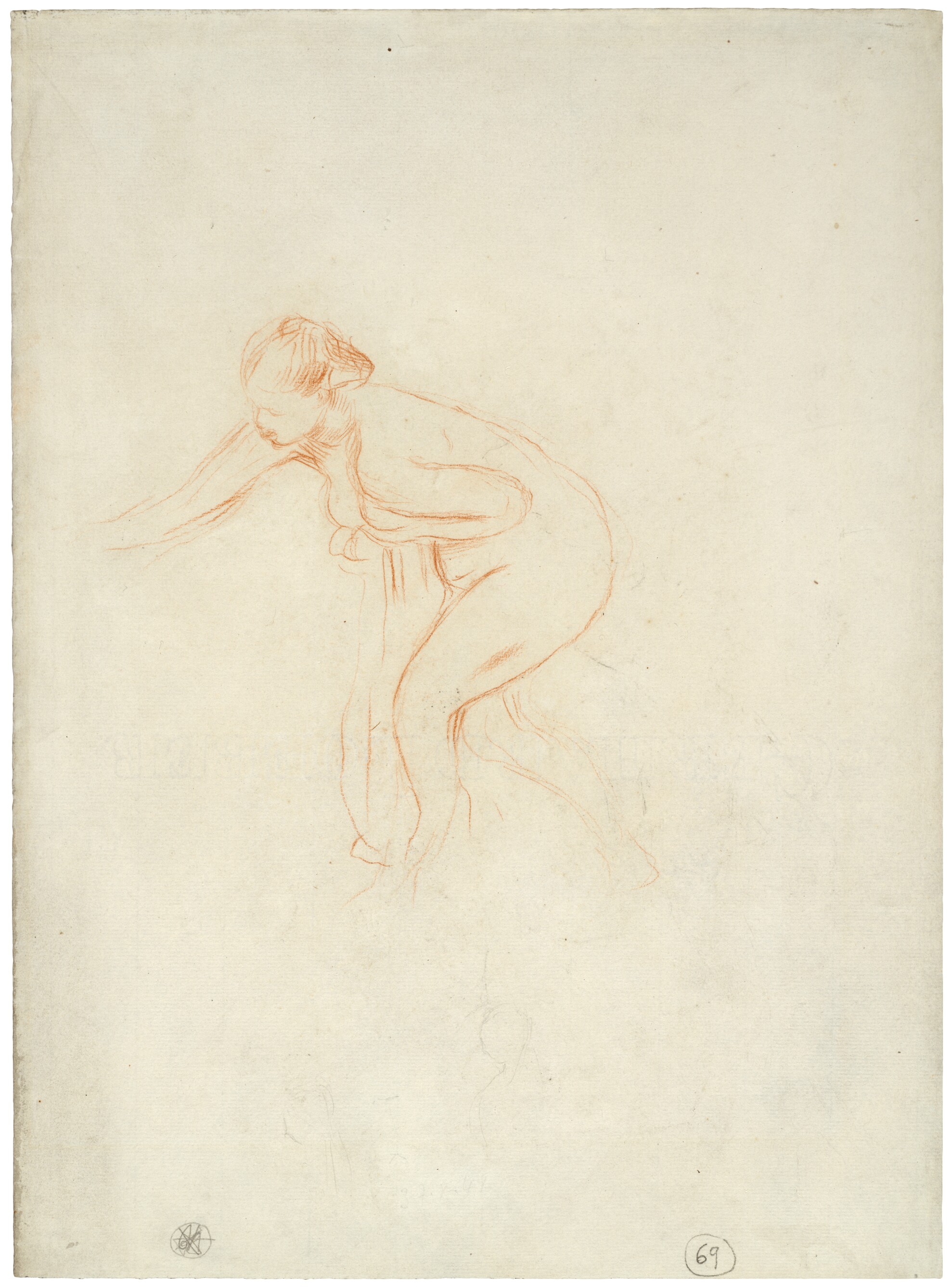
cat. 21 Bather, c. 1885.
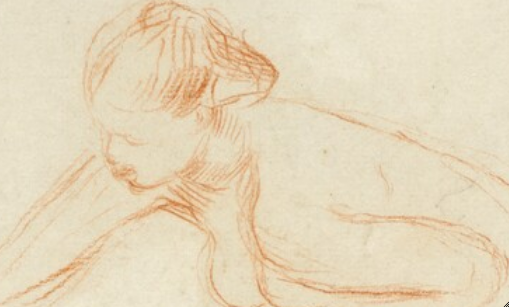
Detail of Renoir’s Bather (c. 1885) showing linear hatched strokes of chalk that form the shadow in the figure's neck. The Art Institute of Chicago, 1937.18.
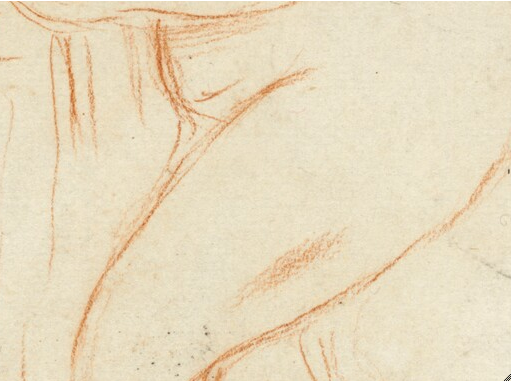
Detail of Renoir’s Bather (c. 1885) showing the use of a broad angled stroke of chalk to form the shadow in the figure's thigh. The Art Institute of Chicago, 1937.18.
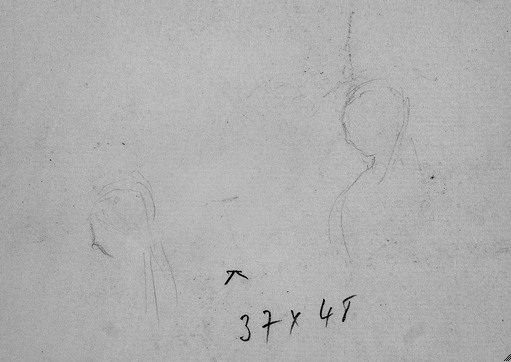
Infrared reflectogram detail (Fuji, 1.0–1.1 µm) of Renoir’s Bather (c. 1885) showing faint figural sketches in graphite. The Art Institute of Chicago, 1937.18.
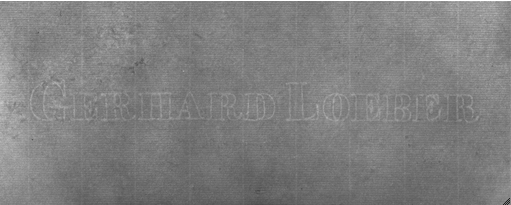
Transmitted-infrared detail (Fuji, 1.0–1.1 µm) of Renoir’s Bather (c. 1885) revealing the paper's watermark. The Art Institute of Chicago, 1937.18.
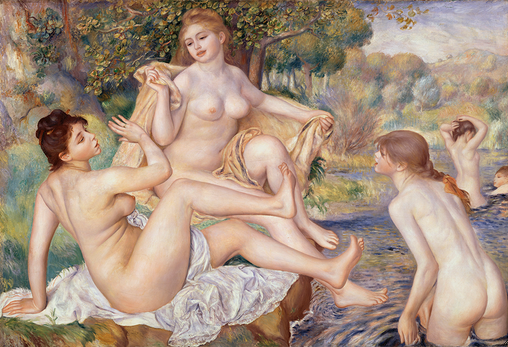
Pierre-Auguste Renoir (French, 1841–1919). The Large Bathers, 1884/87. Oil on canvas; 117.8 × 170.8 cm (46 3/8 × 67 1/4 in.). The Philadelphia Museum of Art, The Mr. and Mrs. Carroll S. Tyson, Jr., Collection, 1963, 1963-116-13.
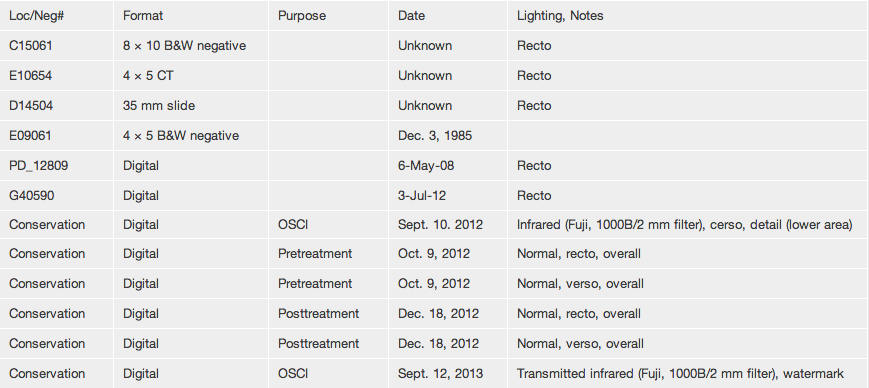
| Loc/Neg# | Format | Purpose | Date | Lighting, Notes |
| C15061 | 8 × 10 B&W negative | Unknown | Recto | |
| E10654 | 4 × 5 CT | Unknown | Recto | |
| D14504 | 35 mm slide | Unknown | Recto | |
| E09061 | 4 × 5 B&W negative | Dec. 3, 1985 | ||
| PD_12809 | Digital | 6-May-08 | Recto | |
| G40590 | Digital | 3-Jul-12 | Recto | |
| Conservation | Digital | OSCI | Sept. 10. 2012 | Infrared (Fuji, 1000B/2 mm filter), cerso, detail (lower area) |
| Conservation | Digital | Pretreatment | Oct. 9, 2012 | Normal, recto, overall |
| Conservation | Digital | Pretreatment | Oct. 9, 2012 | Normal, verso, overall |
| Conservation | Digital | Posttreatment | Dec. 18, 2012 | Normal, recto, overall |
| Conservation | Digital | Posttreatment | Dec. 18, 2012 | Normal, verso, overall |
| Conservation | Digital | OSCI | Sept. 12, 2013 | Transmitted infrared (Fuji, 1000B/2 mm filter), watermark |
Grove of Trees
1888/90
Opaque and transparent watercolor, on cream wove paper;
246 × 179 mm
The Art Institute of Chicago, bequest of William McCormick Blair, 1982.1827
From the late 1880s onward, as Renoir overcame his creative crisis of 1883–85, he created many studies in the manner of the present sheet. A rendition of a similar motif is evident in his Landscape with a Path between Trees (fig. 1.4), which shares the same flickering brushwork, although neither seems to have led directly into a more developed composition.
Characterized by a heightened palette and a subtle overlaying of washes, Grove of Trees shows Renoir’s ability to work with concentrated and dilute shades alike. While the foreground is described in the softest of hues, to add definition to the tree trunks, he reiterated the contours with opaque medium. These thin strokes, which reveal the use of a fine brush, extend into the forest canopy. There, they intermingle with bright greens and yellows; small dashes of broken color indicate leaves, while the brilliance of the smooth cream paper adds an occasional highlight. The watercolor gives an overall impression of spontaneity; small holes at the corners of the sheet suggest that Renoir might have pinned it to a board in order to work directly from nature. It seems as if he drew in paint; close observation reveals no sign of graphite underdrawing (see Technical Report). A comparable handling of media is on view in his Landscape, thought to be from the same period (fig. 2.22).1190
The choice of rich oranges and browns in the Art Institute’s sheet might indicate the influence of fellow artist and friend Paul Cézanne. Renoir’s attitude to landscape seemed to change in the early 1880s; he visited Cézanne in Aix-en-Provence in 1882 and made paintings that were indebted to the artist’s visions of the area (e.g., fig. 2.23 [Dauberville 774]).1191 Renoir traveled extensively during this period, in France and to the Channel Islands off the coast of Normandy, but also to Italy and North Africa. As Colin Bailey has noted, the landscapes the artist made between 1881 and 1883 are distinct, in their audacious use of color, from much of his later work.1192
This sheet seems to recall the energy of that moment. The artist headed south again in 1888, to see Cézanne once more, and painted at least three canvases depicting Montagne Sainte-Victoire during his stay.1193 It is clear that Renoir’s admiration for his friend was enduring; far later, French Symbolist Maurice Denis recalled that the artist had collected works by Cézanne and had helped him to secure patronage.1194 If the location of the grove depicted here is unknown, the palette is distinctly Mediterranean.
Nancy Ireson
Renoir created Grove of Trees directly in watercolor on a relatively smooth [glossary:wove] paper, utilizing most of the sheet. Infrared examination confirmed that there is no evidence of [glossary:underdrawing] or preliminary work (fig. 1.3). Rather, the artist worked directly from light to dark, layering a variety of opaque and transparent watercolors over one another, reserving the darkest purples and greens for final touches in the trees (fig. 1.2). Fine-tipped brushes were used to render the slender tree trunks with thin vertical lines and the delicate leaves with tiny dots. Some passages were blended to create recesses in the grove of trees. The composition was brought to completion with the addition of broad transparent washes to create grass in the foreground and place the grove in context along a hillside meadow.
Renoir (recto, lower right corner, in graphite) (fig. 1.1)
Cream, moderately thick, smooth or slightly textured wove paper.1195
J. Whatman (near complete, vertical orientation, along right edge) (fig. 2.20).
Uniform, without visible inclusions or colored fibers.
Even.
The edges are all trimmed; the top edge is cut slightly irregularly. There are small pinholes in all four corners with faint graphite lines connecting the pinholes in some areas.
246 × 179 mm.
There is a transparent white [glossary:wash] underlying the composition in the center of the [glossary:support] that fluoresces a yellowish-green visible light when exposed to ultraviolet ([glossary:UV]) radiation. There may also be a faint pinkish-white coating overall on the sheet that extends to the edges of the support.
Under UV illumination, there is a light yellow visible-light [glossary:fluorescence] overall on the paper surface that is characteristic of a light gelatin surface [glossary:sizing].
The composition was drawn with brush and opaque and transparent watercolor. Fine brushstrokes of opaque watercolor (gouache) were first applied layered upon one another to form the dense grove of trees. This direct additive process involved little blending, except in the foreground of the composition. Broad washes of transparent watercolor were added at the left edge and in the foreground to form the grassy hillside.
In the center of the image, there is a circular area of brush-applied translucent white medium that reemits a bright yellow-green visible light under UV illumination.
There is no drawing on the verso.
No revisions or changes are visible in the composition in normal conditions or under magnification (fig. 1.3).
No artistic surface fixatives or coatings are visible in normal conditions or under magnification. There is a light yellow visible-light fluorescence under UV illumination that suggests the presence of a light gelatin surface sizing.
The drawing is in very good condition overall. There is light surface soiling and discoloration overall; smudges from handling are evident at the upper and lower right edge. Light discoloration is visible overall, except along the very edges of the paper where it was likely protected from light exposure by a former window mat. The paper support was formerly edge mounted to a secondary support. Brown paper remnants and residual adhesive are visible along the perimeter on the verso. There are small absences or voids of watercolor medium within thickly applied passages; magnification reveals that these areas are not losses, but rather places where the media did not adhere to the underlying support when applied.
Kimberly Nichols
Jacques Rosenthal (1854–1937), Munich.1196
Sold by Richard Zinser, Forest Hills, Long Island, New York, to William McCormick Blair (1884–1982), Chicago, Oct. 1969.1197
Bequeathed by William McCormick Blair to the Art Institute of Chicago, 1982.
Douglas W. Druick, Renoir, Artists in Focus (Art Institute of Chicago/Abrams, 1997), p. 68, no. 20 (ill.).
Paper support characteristics identified.
Paper mold characteristics identified.
Watermark captured.
Bright yellow-green fluorescence observed in translucent white medium.
No underdrawing detected.
Media type/application identified.
The image inventory compiles records of all known images of the artwork on file in the Imaging Department and in the conservation and curatorial files in the Department of Prints and Drawings at the Art Institute of Chicago (fig. 2.24).
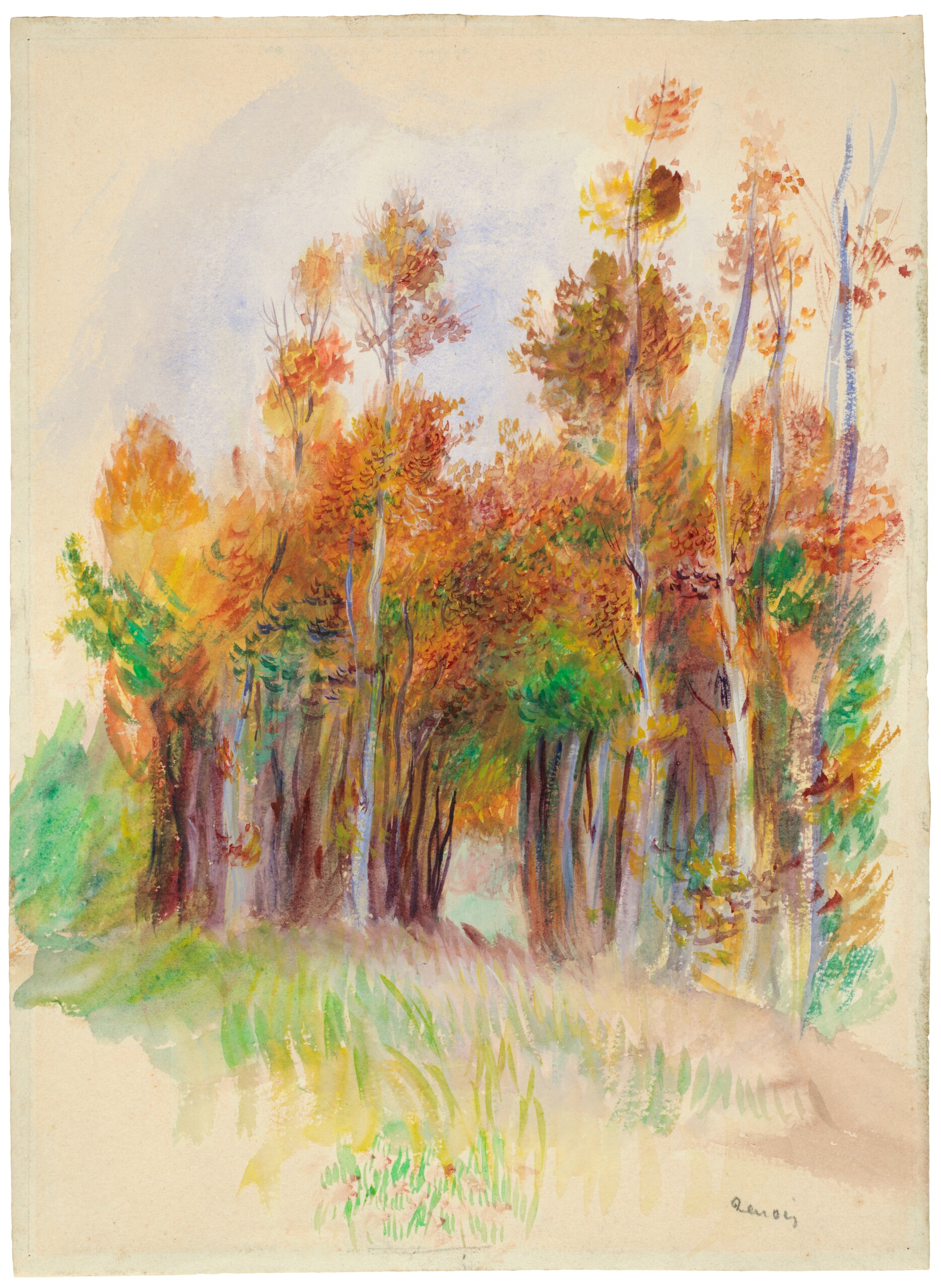
cat. 22 Grove of Trees, 1888/90.
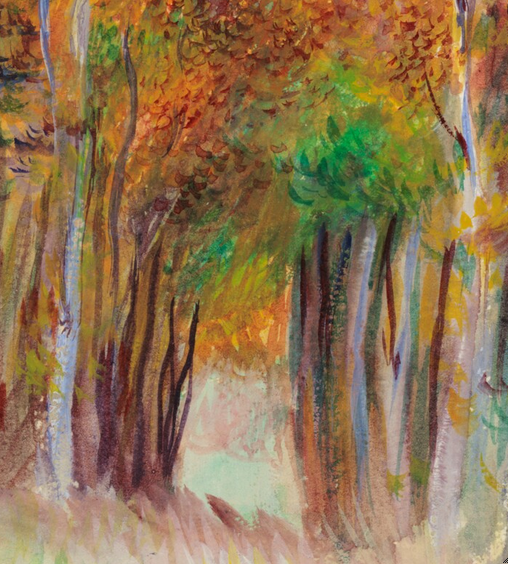
Detail of Renoir’s Grove of Trees (1888/90) showing the layering of opaque and transparent watercolor. The Art Institute of Chicago, 1982.1827.

Detail of Renoir’s Grove of Trees (1888/90) showing Renoir’s signature in graphite. The Art Institute of Chicago, 1982.1827.
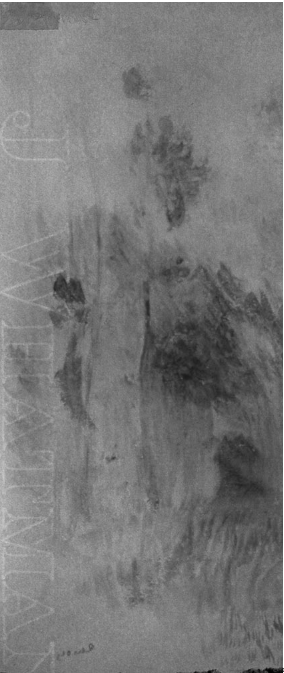
Transmitted-infrared detail (Fuji, 1.0–1.1 µm) of the verso of Renoir’s Grove of Trees (1888/90) showing the paper’s watermark. The Art Institute of Chicago, 1982.1827.
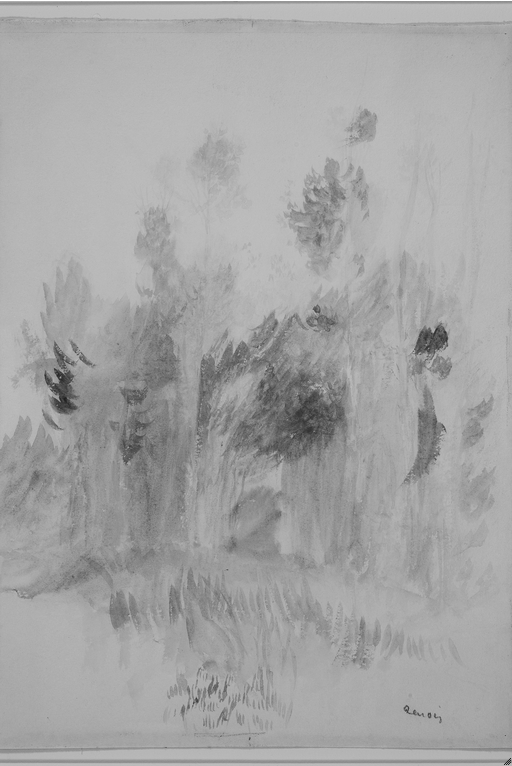
Infrared image (Fuji, 1.0–1.1 µm) of Renoir’s Grove of Trees (1888/90) showing the absence of underdrawing below the watercolor. The Art Institute of Chicago, 1982.1827.
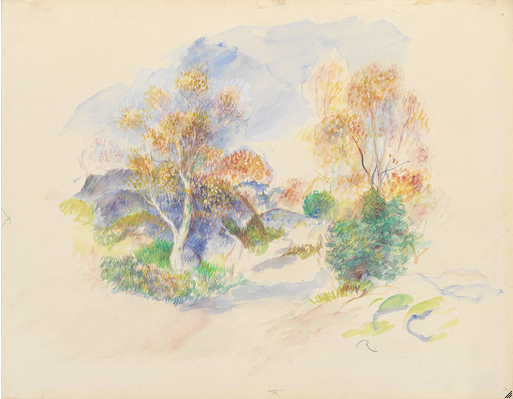
Pierre-Auguste Renoir (French, 1841–1919). Landscape with a Path between Trees, c. 1886. Watercolor; sheet: 27.4 × 35.1 cm (10 13/16 × 13 13/16 in.). The Metropolitan Museum of Art, New York, The Walter H. and Leonore Annenberg Collection, Bequest of Walter H. Annenberg, 2002, 2003.20.11. Image copyright © The Metropolitan Museum of Art. Image source: Art Resource, NY.
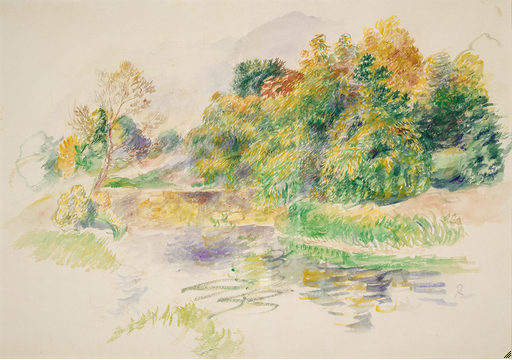
Pierre-Auguste Renoir (French, 1841–1919). Landscape, c. 1878-80. Watercolor on paper; 28.2 × 39.5 cm (11 1/8 × 15 9/16 in.). The Seattle Art Museum, gift of R. D. Merrill, 52.140. Photograph: Paul Macapia.
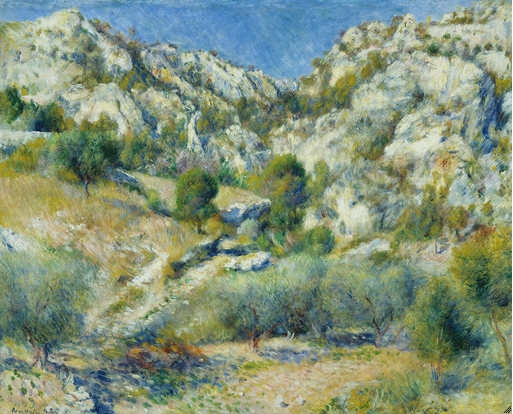
Pierre-Auguste Renoir (French, 1841–1919). Rocky Crags at l’Estaque, 1882. Oil on canvas; 66.4 × 81 cm (26 1/8 × 31 7/8 in.). Museum of Fine Arts, Boston, Cherry Edwards Collection, 39.678. Photograph: © 2014 Museum of Fine Arts, Boston.

| Loc/Neg# | Format | Purpose | Date | Lighting, Notes |
| E10659 | 4 × 5 CT | Unknown | Recto | |
| D14311 | Digital | Unknown | Recto | |
| PD_12813 | Digital | 6-May-08 | Recto | |
| G40584 | Digital | 3-Jul-12 | Recto | |
| Conservation | Digital | OSCI | Sept. 10, 2012 | Infrared (Fuji, 1000B/2 mm filter), recto overall |
| Conservation | Digital | OSCI | Sept. 12, 2013 | Transmitted infrared (Fuji, 1000B/2 mm filter), watermark |
Study for “Bathers in the Forest,” 1198
1895/97
Graphite, on tan wove paper, laid down on ivory Japanese paper; 638 × 944 mm
The Art Institute of Chicago, gift of Dorothy Braude Edinburg to the Harry B. and Bessie K. Braude Memorial Collection, 2013.1010
Executed on very thin paper that exhibits signs of studio wear and tear, Study for “Bathers in the Forest” is clearly one of Renoir’s working drawings. It bears a close relationship to the painting Bathers in the Forest, in the collection of the Barnes Foundation, executed around 1897 (fig. 2.22 [Dauberville 2407]).1199 Curiously, however, the Art Institute’s sheet does not appear to have served in the genesis of that work.1200 Instead of showing signs of alterations and edits, as would be customary for a preparatory study, its composition is almost identical. Bathers in the Forest might be a tracing from the finished painting. Art Institute paper conservator Kimberly Nichols has compared the lines of the sheet with a scaled image of the painting and found that the placement of the figures is remarkably similar (see Technical Report). The facial features are also very similar; movement of the paper during the tracing process could account for the slight degree of variation.
If the present drawing is a tracing, it might explain Renoir’s choice of graphite, which adheres to a wet support. As the sheet’s uneven surface indicates, it was wetted at some point probably before Renoir committed the image to paper. Dampening the sheet would have made it malleable enough to stretch across the canvas; it could also have offered the transparency Renoir would have needed to view the original composition through the sheet. Once dry, unlike conventional tracing paper, the page would have withstood reworking. Little patches of abrasion, tears, and pinholes at its edges offer further evidence that the thin sheet was not destined for formal display (see Technical Report).
All of this makes for an image that is idiosyncratic in Renoir’s oeuvre. More typically, in his drawings, the artist’s line was intricate (as in his Workers’ Daughters on the Outer Boulevard [cat. 5] [Dauberville 664]) or soft (as in his Splashing Figure [cat. 19] [Dauberville 1517]).1201 Here, in contrast, the pencil marks are firm and inexpressive. This, too, suggests that the function of the drawing was primarily practical. As a record of the Barnes Foundation’s Bathers in the Forest, Renoir could have kept the Art Institute’s work as a point of reference for future variations on the theme. Given that the campaign was something of a return—the artist had made an important series of bathers some ten years previously—such a plan would seem logical.1202 Indeed, in an article on the subject of the earlier series, Barbara Ehrlich White argued that Renoir traced works to develop compositions in the mid-1880s.1203
The content of the scene is rather curious. In a clearing, created by the tree trunks to the left, young women rest and play. The arrangement is highly implausible as a real-life scenario that Renoir could have observed (although he did claim that, when he traveled to Guernsey in the Channel Islands in the early 1880s, men and women bathed together in the nude).1204 The drawing’s characters range from the woman fixing her hair at right in the foreground (seated on drapery and seemingly unaware of the viewer) to a rather androgynous youth who lounges beside the water (although, in the painting, the figure is obviously female). Two girls at center-right collude to splash their companions, and one shields her face in anticipation of the water. Even in the Barnes Foundation canvas, which clarifies the context and is unified by evenly dispersed touches of color, the relationships among the women look staged. The backs of the outlying figures, balanced by the overhanging branches, form a frame of sorts.
The poses of the recoiling woman and the companion who cups a hand over her shoulder seem to be adapted from those in the famed Diana and Actaeon that Titian painted around 1556–59 for King Phillip II of Spain (fig. 2.23). The two indications of tree trunks in the background also appear in comparable places. The figures in Renoir’s composition are reversed, however, so he probably knew the work from a print. Critics and scholars have long connected the artist with the Old Masters he admired, and in the Barnes canvas the soft, jewel-like shades, applied with a fluid virtuosity, do seem to owe something to Venetian precedents.1205 It is worth recalling that one of Renoir’s earliest large-scale works was on the theme of Diana the huntress (fig. 2.24 [Daulte 30; Dauberville 578]).1206
Nonetheless, if Renoir’s choice of the bathers motif was historicizing, it did not constitute a retreat from the contemporary world. Instead, as John House has argued, it revealed Renoir’s sympathies with then-current idealizations of prerevolutionary France. The earthy, rounded models in Bathers in the Forest are the antithesis of the emaciated urban girls that had featured in Impressionist works of the 1870s (such as the Parisienne; fig. 2.25 [Daulte 102; Dauberville 299]).1207 Similarly, at the end of the nineteenth century, the countryside itself seemed to offer an escape from the apparent depravity of the city.1208
House posited that Renoir’s dissatisfaction with late-nineteenth-century female emancipation is discernible in his Large Bathers (fig. 2.26 [Daulte 514; Dauberville 1292]).1209 In an age in which women enjoyed increased social freedom, the models in that image inhabit an impossibly small space, which comes under the surveillance of the male viewer.1210 The same seems true of Bathers in the Forest, although here Renoir set the women at a distance from the onlooker. This last observation might lend a further dimension to Renoir’s visual quotation of Diana and Actaeon. If in Ovid’s account Actaeon was seen and punished by the goddess for his voyeurism, in Renoir’s drawing the viewer observes the beauties undisturbed, shielded by the lounging figure in the foreground.
Nancy Ireson
Study for “Bathers in the Forest” was drawn directly in [glossary:graphite] on a tan, smooth, machine-made [glossary:wove] paper. The uniform surface of the paper enabled the graphite to glide across in uninterrupted lines. The figures in the composition form a circular arrangement, and the drawing is virtually absent of background development. Only the slightest suggestion of water intersects the figure’s thighs in the center, and two vertical lines suggest trees at the upper left. The graphite lines are deliberate, laid down as if the forms and composition were already conceived. There is no reworking, but the lines are drawn over one another to reinforce or work over the figural contours (fig. 1.2). Faint erasure is visible on both sides of most drawn lines, and was possibly done to remove the transfer of loose graphite particles across the paper and sharpen the lines (fig. 1.1). It is unclear, however, whether the erasure is an original artistic gesture or a later restoration. There is no [glossary:modeling] in the figures, either from erasure or [glossary:stumping]; only a few lines suggest shadows along the figure’s spines and shoulder blades (fig. 2.20). Although there are no significant compositional changes, the features of the figure on the far right may have been slightly altered. The drawing exhibits extensive structural breaks and losses, as well as pinholes, evidence of its use as a working drawing.
As a digital image overlay (fig. 1.4) has shown, the composition of the drawing matches that of the painting Bathers in the Forest (c. 1897; Barnes Foundation, Philadelphia). Not only do the general figural arrangements correspond, but the figural details (such as facial features, limbs, and toes, as well as the shading along the figure’s spine at the right side) relate as well. There is a slight shift in the relative compositional relationship at the far right, but the subjects remain similar in scale and detail, and the shift can be accounted for by adjusting the overlay slightly from side to side. The almost complete correspondence between the two works and the deliberate placement of line in the drawing suggest that the drawing was either used for transfer to the [glossary:canvas] or made after the painting, as a tracing, possibly for documentation or technical experimentation. There is no indication of pricking or embossing to confirm that the drawing was used for transfer; nor is there clear evidence of transfer material on the verso.1211 In addition, an [glossary:infrared reflectography] (IRR) capture of the oil painting reveals no evidence of graphite (in either an underdrawing or a transferred drawing) to confirm a relationship between the drawing and the painting. In fact, the [glossary:infrared reflectogram] identified features in the early stages of the painting composition that are present neither in the finished painting nor the drawing.1212 It thus seems most likely that the drawing documents the finished painting composition, perhaps part of the artist’s technical process.1213
Renoir (lower right, in graphite) (fig. 1.3).
Tan, medium thick, smooth wove paper.1214
Uniform, without visible inclusions or colored fibers.
Even, machine made.
All edges are trimmed straight.
638 × 984 mm.
Ivory, medium-thick, slightly textured Japanese paper lining. Dimensions: 69.0 × 103.0 cm.
No artistic surface alterations or coatings are visible under normal conditions or under magnification. Under [glossary:UV] illumination, there is a pale-yellow visible-light [glossary:fluorescence] overall on the paper surface that is characteristic of a light gelatin surface [glossary:sizing]; the fluorescence is most pronounced around the perimeter of the paper sheet where the window mat protected it from exposure to light.
The work was drawn directly in graphite, with lines laid over one another to strengthen the figural contours. Faint erasure is visible on both sides of most of the drawn lines and was presumably done to reduce graphite migration and sharpen the lines.
No significant revisions or changes to the composition are visible under normal conditions, UV illumination, or magnification. It is possible that some features in the faces of the figures at the far right and third from the right were altered slightly. Overall, the drawn lines are deliberate, as if already conceived.
No artistic surface fixatives or coatings are visible under normal conditions, UV illumination, or magnification. A light gelatin sizing is visible under UV illumination.
The drawing [glossary:support] exhibits ingrained surface soiling or media that imparts a streaked appearance overall; there is a prominent dark streak that runs vertically along the left side on the verso. The soiling or grayish-blue material is faintly visible overall, although most concentrated in the upper area, and may have resulted from exposure to moisture during the artist’s use. The material is absent along the top edge, possibly due to a former attachment. A few pinholes are also present at the upper and lower sides and center bottom and top edges are likely evidence of use or artistic process.
The paper exhibits pronounced structural damage, including numerous breaks and losses throughout that may also have resulted from use. The losses vary in size and may be the result of insect damage or removal of a former mount; they are filled with wove paper of a slightly darker tone than the drawing support. These losses are most visible under UV radiation, as they strongly absorb visible light and appear dark. The upper right corner exhibits the most significant area of damage, with large losses, breaks, and possibly reattachment of a darkened fragment. The overall work is supported on the verso with a [glossary:Japanese paper] [glossary:lining] that was joined vertically through the center; the lining has delaminated in large areas through the center, and there are undulations around the perimeter of the sheet. In general, the pattern of structural damage and streaks of soiling, particularly along the right side, suggests that the work may have been stored rolled at one point, receiving its greatest damage at the outermost exposed right edge. The support is discolored overall, most visibly within the window mat (where it was exposed to light) and along the bottom edge, and there are reddish brown stains or foxing, concentrated around the perimeter.
A surface material in the upper right corner emits a faint, white visible-light fluorescence under UV illumination; this is likely a masking material that was applied over the damaged areas. The top edge also emits a yellowish-orange visible-light fluorescence, possibly due to a former adhesive layer.
Kimberly Nichols
Sold, Galerie Charpentier, Paris, Jan. 31, 1966.1215
Galerie Robert Schmit, Paris, by 1985.1216
Galerie Hopkins-Thomas, Paris, by April 1985.1217
Grob Gallery, London, by September 1990.1218
Sold, Sotheby’s, London, Dec. 3, 1991, lot 28, to Dorothy Braude Edinburg.
Given by Dorothy Braude Edinburg to the Art Institute of Chicago, 2013.
Paris, Galerie Hopkins-Thomas, Dessins et aquarelles de Renoir, Apr. 25–June 30, 1985, cat. 17; Artis Monte-Carlo, July 18–Sept. 14, 1985.
Philadelphia Museum of Art, Renoir: The Great Bathers, Sept. 3–Nov. 25, 1990, no cat.1219
Art Institute of Chicago, Drawings in Dialogue: Old Master through Modern; The Harry B. and Bessie K. Braude Memorial Collection, June 3–July 30, 2006, cat. 103 (ill.).
Art Institute of Chicago, The Thrill of the Chase: Drawings for the Harry B. and Bessie K. Braude Memorial Collection, Mar. 15–June 15, 2014, no cat.
Ambroise Vollard, La vie et l’oeuvre de Pierre Auguste Renoir (L’auteur, 1919), p. 271 (ill.).
Paul Haesaerts, Renoir: Sculptor (Reynal & Hitchcock, 1947), pp. 11 (detail ill.), 20 (detail ill.).
François Daulte, Auguste Renoir: Catalogue raisonné de l’oeuvre peint, vol. 1 (Durand-Ruel, 1971), p. 18 (ill.).
Galerie Hopkins-Thomas, Dessins et aquarelles de Renoir, exh. cat. (Galerie Hopkins-Thomas, 1985).
Françoise Daulte, “Renoir dessinateur et aquarelliste,” L’oeil 358 (May 1985), p. 64 (ill.).
Christopher Riopelle, “Renoir: The Great Bathers,” Philadelphia Museum of Art Bulletin 86, 367–68 (Fall 1990), pp. 18, 20, fig. 19.
Guy-Patrice Dauberville and Michel Dauberville, Renoir: Catalogue raisonné des tableaux, pastels, dessins, et aquarelles, vol. 3, 1895–1902 (Bernheim-Jeune, 2010), p. 500, no. 2570 (ill.).
Mark
Location: lower right
Method: graphite
Content: 100 × 67
It is not possible to confirm inscriptions or marks, as the visibility is obscured by the lining.
Paper support characteristics identified.
Paper mold characteristics identified.
Light surface sizing detected; former restorations were revealed.
Media identified.
The image inventory compiles records of all known images of the artwork on file in the Imaging Department and in the conservation and curatorial files in the Department of Prints and Drawings at the Art Institute of Chicago (fig. 2.27).
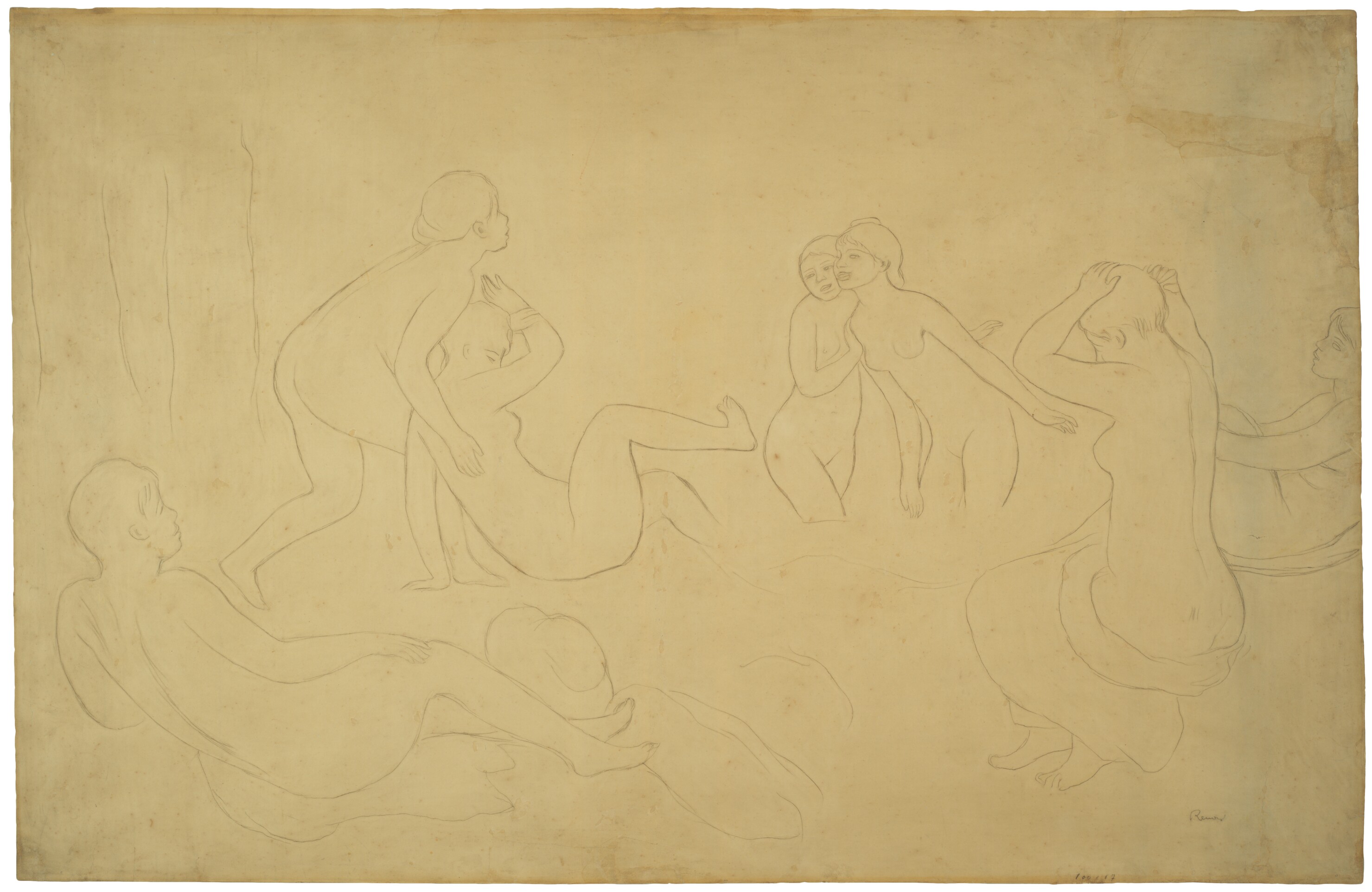
cat. 23 Study for “Bathers in the Forest,” 1895/97.
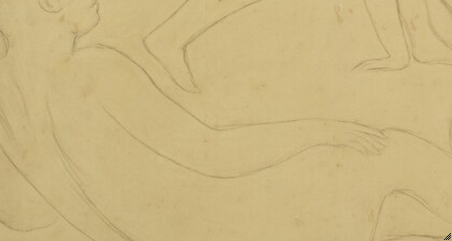
Detail of Renoir’s Study for “Bathers in theForest” (1895/97) showing the use of erasure along either side of the graphite lines. The Art Institute of Chicago, 2013.1010.
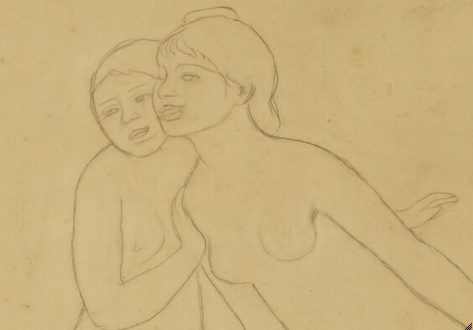
Detail of Renoir’s Study for “Bathers in the Forest” (1895/97) showing the deliberate graphite lines, absent of any reworking. The Art Institute of Chicago, 2013.1010.
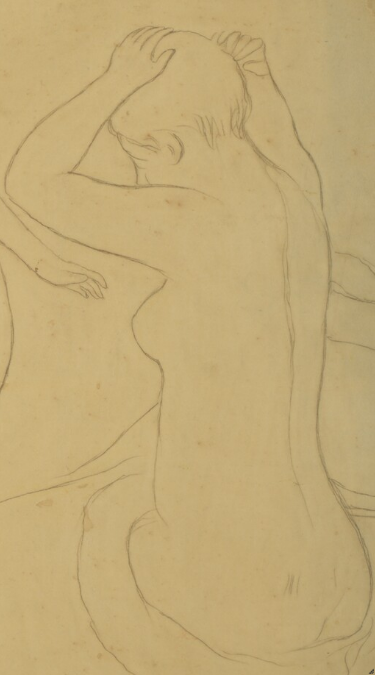
Detail of Renoir’s Study for “Bathers in the Forest’ (1895/97) showing the absence of modeling in the figure. The Art Institute of Chicago, 2013.1010.
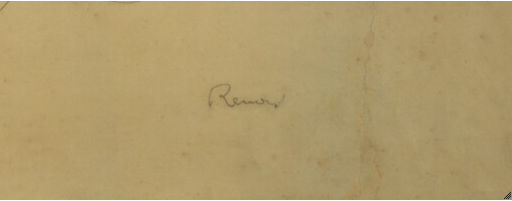
Detail of Renoir’s Study for “Bathers in the Forest’ (1895/97) showing the artist’s signature. The Art Institute of Chicago, 2013.1010.
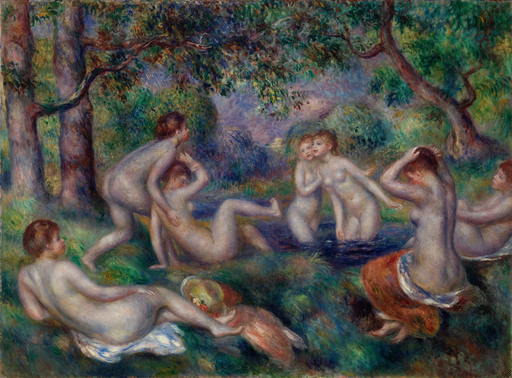
Overlay of natural-light image of Renoir’s Study for “Bathers in the Forest” (1985/97) and natural-light image and infrared reflectogram of Renoir’s Bathers in the Forest (1897; Barnes Foundation) showing the compositional relationships. Image © 2014 The Barnes Foundation. Interactive image.
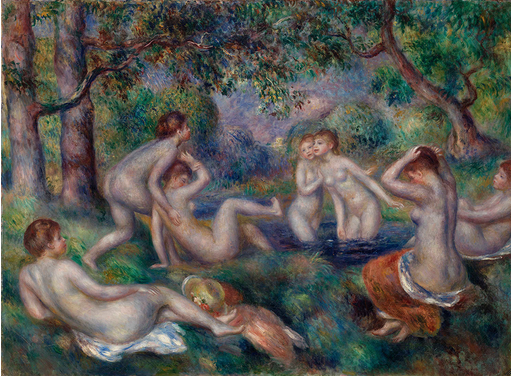
Pierre-Auguste Renoir (French, 1841–1919). Bathers in the Forest, c. 1897. Oil on canvas; 74 × 100 cm (29 1/8 × 39 3/8 in.). Barnes Foundation, Philadelphia, BF901. Image © 2014 The Barnes Foundation.
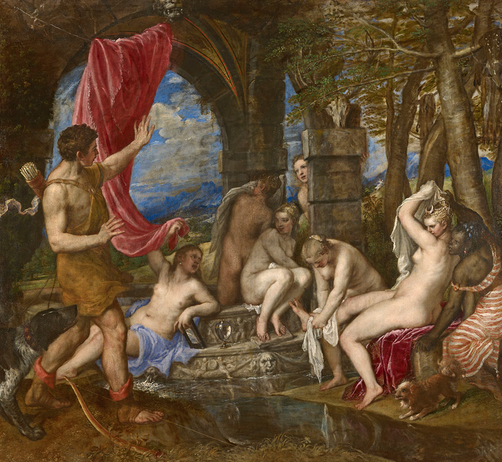
Titian (Italian, 1477–1576). Diana and Actaeon, 1556–59. Oil on canvas; 184.5 × 202.2 cm (73 × 79 1/4 in.). National Gallery, London, bought jointly by the National Gallery and National Galleries of Scotland with contributions from the Scottish Government, the National Heritage Memorial Fund, The Monument Trust, The Art Fund (with a contribution from the Wolfson Foundation), Artemis Investment Management Ltd., Binks Trust, Mr Busson on behalf of the EIM Group, Dunard Fund, The Fuserna Foundation, Gordon Getty, The Hintze Family Charitable Foundation, J. Paul Getty Jnr. Charitable Trust, John Dodd, Northwood Charitable Trust, The Rothschild Foundation, Sir Siegmund Warburg’s Voluntary Settlement and through public appeal, 2009, NG6611. National Galleries of Scotland, Dist. RMN-Grand Palais/Art Resource, NY.
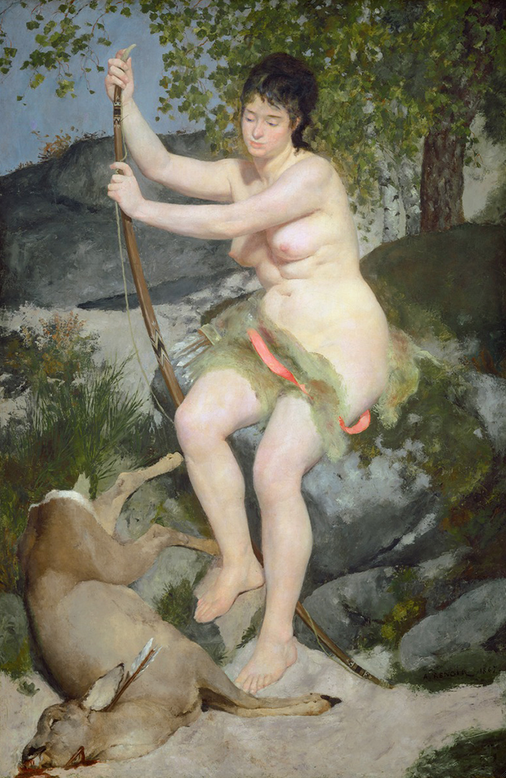
Pierre-Auguste Renoir (French, 1841–1919). Diana, 1867. Oil on canvas; 199.5 × 129.5 cm (78 9/16 × 51 in.). National Gallery of Art, Washington D.C., Chester Dale Collection, 1963.10.205. Image courtesy the National Gallery of Art, Washington.
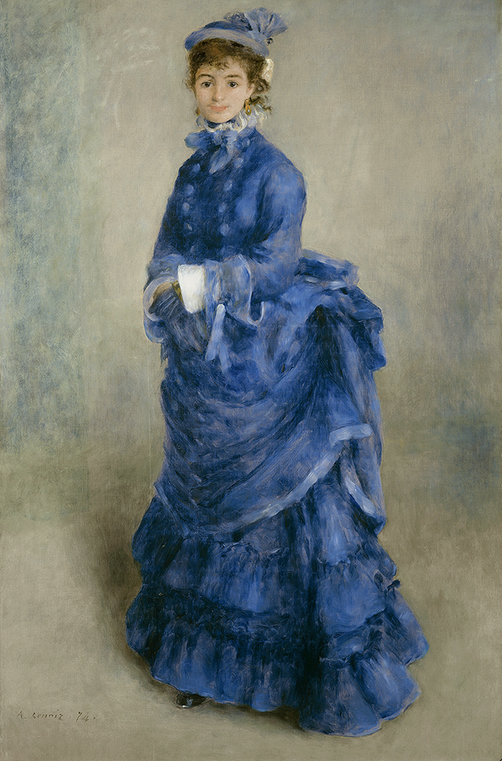
Pierre-Auguste Renoir (French, 1841–1919). The Parisienne, 1874. Oil on canvas; 160 × 106 cm (63 × 41 3/4 in.). National Museum of Wales, Cardiff.
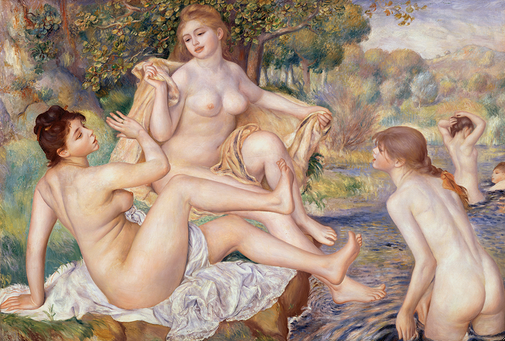
Pierre-Auguste Renoir (French, 1841–1919). The Large Bathers, 1884–87. Oil on canvas; 117.8 × 170.8 cm (46 3/8 × 67 1/4 in.). Philadelphia Museum of Art, the Mr. and Mrs. Carroll S. Tyson, Jr., Collection, 1963, 1963-116-13. Bridgeman Images.
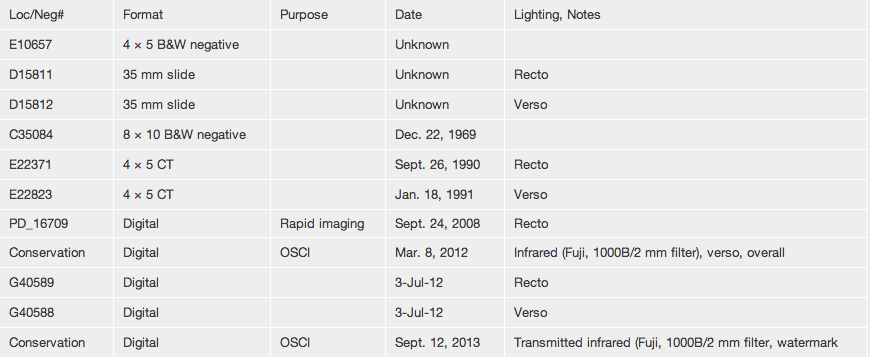
| Loc/Neg# | Format | Purpose | Date | Lighting, Notes |
| E10657 | 4 × 5 B&W negative | Unknown | ||
| D15811 | 35 mm slide | Unknown | Recto | |
| D15812 | 35 mm slide | Unknown | Verso | |
| C35084 | 8 × 10 B&W negative | Dec. 22, 1969 | ||
| E22371 | 4 × 5 CT | Sept. 26, 1990 | Recto | |
| E22823 | 4 × 5 CT | Jan. 18, 1991 | Verso | |
| PD_16709 | Digital | Rapid imaging | Sept. 24, 2008 | Recto |
| Conservation | Digital | OSCI | Mar. 8, 2012 | Infrared (Fuji, 1000B/2 mm filter), verso, overall |
| G40589 | Digital | 3-Jul-12 | Recto | |
| G40588 | Digital | 3-Jul-12 | Verso | |
| Conservation | Digital | OSCI | Sept. 12, 2013 | Transmitted infrared (Fuji, 1000B/2 mm filter, watermark |
Jean Renoir Sewing1220
1899/19001221
Oil on canvas; 55.4 × 46.3 cm (21 3/4 × 18 1/4 in.)
Signed and dated: Renoir. (lower left, in brown paint)
The Art Institute of Chicago, Mr. and Mrs. Martin A. Ryerson Collection, 1937.1027
In his biography of his father, Jean Renoir wrote, “I remember quite clearly all the preparations for the picture now in the Art Institute in Chicago, showing me sewing. It was executed at Magagnosc, near Grasse, where my parents had rented a pretty villa on the side of the mountain.”1222 Indeed, in January 1900 Renoir’s wife, Aline; their five-year-old son, Jean; his nanny, Gabrielle; and “La Boulangère” (Marie Dupuis, who served as both family cook and artist’s model) joined the artist at the Villa Raynaud, near Magagnosc, for a four-month stay.1223 Renoir had been spending winters in the south of France for many years, seeking in the milder climate some relief from his advancing rheumatoid arthritis. His residence in Magagnosc followed treatment for this illness in Aix-les-Bains in the Savoie, which he procured on the advice of his doctor, Émile Baudot.1224
The year 1900 would prove a remarkable one for the artist. In January the Bernheim-Jeune brothers, Gaston and Josse, held their first Renoir exhibition of sixty-eight works in Paris; by March Renoir promised his art dealer, Paul Durand-Ruel, a crate of paintings for an exhibition planned the next year;1225 and in May and June eleven of the artist’s paintings were featured at the Exposition Universelle in Paris. That August the artist was officially recognized by the French State with the prestigious Chevalier de la Légion d’Honneur. He then returned to Magagnosc with his family in November, where they apparently stayed until March or April 1901.1226
Jean was accustomed to modeling for his father (see, for example, fig. 2.49 [Dauberville 2377]), though when the boy was little Renoir would often wait until he was occupied with something on his own and then take the opportunity to capture the moment.1227 As Jean later recorded, these impromptu sessions gave rise to paintings of him eating soup, playing with toy soldiers, or building blocks, looking at a picture book, and other such scenes of daily life.1228
In January 1900 Renoir presented a portrait of Jean (fig. 2.50 [Dauberville 2380]) to the mayor of Limoges, the city of the artist’s birth.1229 Signed and dated 1899, this simple bust portrait seems a conservative choice for the second French public collection in which the renowned Impressionist painter was to be represented.1230 However, Renoir ably demonstrates his skill as a colorist in this portrait, playing up the correspondence between Jean’s red-gold hair and the pink tones of the blouse, both of which contrast with the blue collar and the boy's large blue eyes.
Compared to the Limoges portrait, Jean Renoir Sewing shows the artist’s son more informally dressed in a pink smock. Here Jean is perhaps posed near a window, as he appears to be bathed in natural light. The boy is shown sewing, a subject Renoir usually reserved for female sitters in genre paintings.1231 Jean later recalled that it was Gabrielle who suggested that, to keep himself occupied during this particular modeling session, he should sew a satinette coat for the painted tin camel given to him by Monsieur Raynaud, the owner of the villa in Magagnosc.1232
The Renoirs followed the bourgeois fashion of letting the hair of preschool-age boys grow long over the shoulders, and the artist took advantage of the opportunities for coloristic exploration afforded by his son’s abundant red-gold hair. While Jean’s parents thought nothing of tying the boy’s hair back with a brightly colored ribbon to keep it out of his eyes, Jean’s recollection of being teased about his long hair by the neighborhood children suggests that the Renoir family may have taken the fashion to an extreme.1233 In Jean Renoir Sewing, Renoir combined a variety of earth tones with touches of rose and bright yellow highlights to give Jean’s hair an angelic glow, and the yellow of the bow serves as a striking accent.
The entire household was present in 1901 when seven-year-old Jean’s hair was cut, as required for his entry into the Jesuit Collège Sainte-Croix in Neuilly that autumn.1234 This dramatic rite of passage in which Jean lost the beautiful red-gold locks that had obsessed his father did not diminish Jean’s charm as a young boy nor exempt him from further modeling duties. In October 1901 Renoir and his family moved into an apartment at 43, rue Caulaincourt, in Montmartre, where Jean remembered posing most frequently.1235 One of the paintings executed there showing Jean with his schoolboy look, Jean Renoir Drawing (fig. 2.51 [Dauberville 2389]), is dominated by subdued earth tones—a concession, perhaps, to the reality that Jean’s hair could no longer inspire a colorist’s vivid palette.1236
In its dual role as portrait and genre scene, Jean Renoir Sewing was planned as a more ambitious undertaking than the smaller bust portrait of Jean that Renoir gave to Limoges. The artist chose a half-length format to portray his subject. The additional area of a no. 10 portrait (figure) standard-size canvas enabled him to accommodate the arms, the hands, and a larger portion of the torso. The positions of the arms anchor the composition, and apparent alterations to the arms, including narrowing the right sleeve to make it less voluminous and moving the left arm slightly outward (see Application/technique and artist’s revisions in the technical report), served to strengthen the triangular symmetry of the pose. Renoir originally painted a larger bow, as in the Limoges portrait. The long, animated tails are still visible through the blue background paint used to cover them. Reducing the size of the bow further enhanced the triangular line of the composition.
There exists a second version of Jean Renoir Sewing (fig. 2.48 [Dauberville 2375]), which now resides in the Wallraf-Richartz Museum in Cologne.1237 Renoir made multiple versions of a painting on a few occasions. In 1876 he made a second version of Dance at the Moulin de la Galette (1876; Musée d’Orsay, Paris [Daulte 438; Dauberville 211]) that was acquired by the collector Victor Chocquet, and in 1892 he prepared five variations of Girls at the Piano for selection by Henri Roujon, the Minister of Fine Arts.1238 There is no record of why Renoir felt compelled to paint two versions of Jean Renoir Sewing. The two paintings are generally thought to have been executed at about the same time.1239 Both canvas supports are coated with two layers of commercially prepared ground and have very similar thread counts and variations in weave density, indicating that the canvases were probably purchased at the same time (see Weave in the technical report). Both paintings also feature numerous adjustments and compositional changes, which would not be expected in a later copy.1240
A close stylistic comparison of the two paintings reveals subtle differences. The poses vary slightly, and revisions indicate that the artist altered the composition in both works, specifically in the bow, hair, sleeves, hands, chin, and chair. Both also show evidence of similar techniques, such as scraping, repainting, and wrinkling of the paint due to the application of more paint before the previous layer had dried. Variations in brushwork, color, and modeling can also be seen in both works, for example, in the face and the hair around it (fig. 2.52). In the Chicago version Renoir used cooler tones to indicate shadows under the chin and around the nose and eyes. The warmth of these shadows in the Wallraf-Richartz version minimizes their abruptness, and as a result the details of the face appear more evenly blended and less sharply delineated. In the Chicago painting, the shadows are more saturated and there is greater red tonality in the smock and hair. In comparison, the flesh tones in the Wallraf-Richartz version appear subdued to a pinkish tone, with an overall lighter tonality in the face and smock. The backgrounds, too, are different; Renoir applied thin, translucent blue layers across the background in the Wallraf-Richartz painting, leaving some of the white ground visible for a watercolor-like appearance. In the Chicago version the background is slightly darker and more opaque, with less light on the right side of the picture. Perhaps the most striking difference between the portraits is the intensity and angle of the light: the Chicago version exhibits directional, almost raking light from the top left; in the Wallraf-Richartz version the figure is bathed in even, almost ambient light. The overall effect of the execution in the Wallraf-Richartz version is a more harmonious relationship between the figure and the ground.
Throughout his career Renoir excelled at painting children, from the portrait of the nine-year-old Romaine Lacaux in 1864 (fig. 2.53 [Daulte 12; Dauberville 489]) to the inclusion of children in adult situations or genre paintings, such as Two Sisters (On the Terrace) (1881; cat. 11), which enhances the subject’s theme of lighthearted leisure.1241 Renoir’s great gift as a painter of children was recognized at his first retrospective exhibition in April 1883, organized by Durand-Ruel, where the first gallery was devoted exclusively to images of children.1242 Despite critical approval, not everyone understood Renoir’s portraits of children. The artist’s friend and patron Paul Berard claimed that Renoir’s 1883 portrait of his daughter Lucie (cat. 16) left visitors to his apartment with a feeling of unease, in spite of its privileged location in a prime spot in his study and its presentation in a specially made frame.1243 Unlike children whose portraits were painted in the more traditional styles of the time, whose likenesses would perhaps have been more pleasing to Berard’s visitors, Renoir’s children occupy a world apart, a utopian realm free of adult expectations or responsibilities, an Impressionist world filled with light and color.
John Collins
Renoir began this portrait of his son Jean on a no. 10 portrait ([glossary:figure]) standard-size [glossary:canvas] that was [glossary:commercially primed] with a double preparation; now darkened from age and treatment, the ground was probably once a soft or semitranslucent white.1244 A few lines visible in the infrared images suggest that the artist began with a contour sketch, possibly in charcoal or black chalk, but subsequent rubbing and scraping of the paint layers obscured the extent of this process and the exact nature of the [glossary:underdrawing] material. The work is marked by changes and reconsiderations, as Renoir repeatedly scraped back and painted over previous compositional choices throughout.1245 In many places, the surface exhibits a strange, pockmarked texture that is the result of this scraping process: the paint covering the high points of the canvas was preferentially removed, leaving hard-edged, circular depressions. Elsewhere the high medium content and repeated applications of paint are evident in widespread wrinkling, especially in Jean’s hair. Renoir made numerous changes to the figure, including the placement of the hands and fingers, the curve of the arms and the volume of the sleeves, the length and arrangement of the child’s curls and bow, and the angle of his face. The painting is signed by the artist at the lower left and is currently lined and varnished.
The multilayer interactive image viewer is designed to facilitate the viewer’s exploration and comparison of the technical images (fig. 1.2).1246
Signed and dated: Renoir. (lower left, in brown paint) (fig. 1.1, fig. 2.20).1247
Flax (commonly known as linen).1248
The original dimensions of the canvas were approximately 55 × 46.3 cm, according to 1968 pretreatment measurements.1249 This closely corresponds to a no. 10 portrait (figure) standard-size (55 × 46 cm) canvas.1250
[glossary:Plain weave]. Average [glossary:thread count] (standard deviation): 20.1V (0.5) × 16.4H (0.6) threads/cm. The vertical threads were determined to correspond to the [glossary:warp] and the horizontal threads to the [glossary:weft].1251
[glossary:Cusping] corresponds to the placement of the original tacks.
Current stretching: When the painting was lined in 1972, the original dimensions were increased slightly on all sides (see Conservation History).
Original stretching: Based on cusping visible in the [glossary:X-ray], the original tacks were placed approximately 5–7 cm apart.
Current stretcher: Four-member redwood [glossary:ICA spring stretcher]. Depth: 2.4 cm.
Original stretcher: Five-member, blind mortise-and-tenon stretcher with a horizontal [glossary:crossbar].1252 Depth: Approximately 1.4 cm.
Stamp
Location: original stretcher (discarded); partial transcription in conservation file
Method: ovular stamp/stencil
Content: 35 Rue Victor-Mosse [sic] (fig. 1.3)1253
Not determined (probably glue).1254
The [glossary:ground] is a two-layer commercial preparation that extends to the edges of the [glossary:tacking margins]. The first layer varies in thickness (approximately 5–60 µm) and somewhat fills the interstices of the weave, while the second is thicker (approximately 20–85 µm) and moderately coats the high points of the canvas (fig. 1.4).
Due to saturation by both the ground medium and the [glossary:wax-resin lining] material, the first ground layer, revealed mostly over the thread tops in areas of abrasion, appears translucent under [glossary:stereomicroscopic examination]. This layer has a whitish haze and is heavily influenced by the color of the underlying canvas. The second ground layer appears almost beige; this is largely the combined effect of the darkening of the medium, the accumulation of grime, and saturation from the lining material and varnish, as almost no colored particles are visible under stereomicroscopic examination (fig. 2.55, fig. 2.54). Additionally, the perception of the translucent layers is affected by the color of the canvas, and the ground appears warmer as a result. It is likely that the ground was a brighter, but still soft, semitranslucent white during the artist’s lifetime (fig. 2.22).1255
The first ground layer is composed primarily of calcium carbonate (chalk) with traces of complex magnesium- and aluminum-containing silicates, or clays. The second ground layer is a mixture of lead white and calcium carbonate (natural chalk with associated microfossils), with traces of associated complex silicates, silica, and alumina.1256 The [glossary:binder] is estimated to be [glossary:oil].1257
The infrared image shows a few stray lines in a thin, dark medium that could be an underdrawing, but Renoir’s technique of scraping back the paint to make compositional changes obscured the nature of these lines as well as their prevalence (fig. 2.23). The lines appear predominantly in the figure’s lower curls and around his eyes.
The infrared image suggests that the possible underdrawing consists of a very thin, dark medium, possibly charcoal or black chalk. It is, however, unclear at this time whether the material was applied in a dry or fluid medium.1258
There is no evidence of changes in the compositional planning stage (see Paint Layer).
Renoir made numerous changes throughout the execution of this portrait of his son Jean, constantly painting over previous work, scraping back paint, and repainting.1259 In many cases the sequence of changes is not immediately apparent; it is, however, clear that the artist made numerous small adjustments to the figure’s arms, smock-like garment, fingers, hair, and bow, as well as to the angle of his head. Repeated scraping to remove earlier compositional choices resulted in a strange, almost pockmarked surface texture in which the high points of the canvas weave form the low points in the painting: as the palette knife cut across the surface, the paint on the high points of the canvas was preferentially removed, while that in the interstices remained and was built up above the neighboring thread tops in successive layers (fig. 2.24). In other areas, Renoir used scraping to return to previous compositional choices he had painted out, as seen in the child’s hair bow (fig. 2.25). The artist also varied the medium content and the working of his paint, employing extra oil and using a soft brush for the flat first layers of the child’s hair, the flesh tones, and the blue background; thicker, paste-like paint and stiffer, flat brushes for the highlights throughout the hair and garment; and paint thinned with spirits, which sank into the preexisting paint and canvas textures, in the deep red and brown shadows in the garment.
The infrared, [glossary:transmitted-infrared], and X-ray images indicate that Renoir moved Jean’s arms many times, subtly adjusting them to bring the right arm closer to the body, while moving the left arm slightly away. The X-ray and transmitted-infrared images most clearly show the changes related to the figure’s right sleeve and arm: originally the sleeve was wider, extended further to the left, and belled out lower. Although scraped back and covered with blue background paint, some of the wider profile is still visible along the right edge of the sleeve (fig. 2.26). The child’s hands were at one point slightly to the right of their current position, with his left fingers more curled, and the fabric he sews covering more of his lap. Some hints of the fingers’ previous position can be seen under normal viewing conditions, especially around the thumbs (fig. 2.27). Jean’s left sleeve originally appeared slightly less voluminous and may have had a few more folds along the edges, as opposed to the generally round outline in the final composition. In addition to scraping back paint to adjust the volume and position of the sleeves, Renoir periodically reinforced the new contours with additional highlights. Stereomicroscopic examination of the surface also indicates that the child’s garment extended farther to the right near the bottom edge but was scraped back by the artist and painted over with yellow-brown paint (fig. 2.28). The chair, as well as the brown area on the lower left, may have been added later, as the blue background is visible beneath them in many areas, including to the immediate right of Jean’s shoulder. On the lower left, the volume of the garment was adjusted again and made larger, so that it covers both the blue background and earlier earthy browns.
Renoir also adjusted the angle of Jean’s face, as well as the volume and arrangement of his curls and the size and shape of the yellow bow in his hair. Faint underdrawing lines visible in the infrared image suggest that the curls were slightly longer initially; the infrared and transmitted-infrared images also indicate that the hair had slightly less volume on the right and more on the left and near the crown of the head. To the right of the head, thinly painted, gauzy curls were added on top of the preexisting background. On the left, the bow was adjusted and the hair was brought in more tightly toward it. The size and arrangement of the yellow bow may have been changed several times; it appears largest in the X-ray, with a prominent, round loop on the left and a long, diagonal piece of ribbon extending down to the level of the child’s chin. As the artist rearranged Jean’s curls to obscure more of the bow, he partially scraped back some of the earlier choices, then brought in additional blue background paint. Ultimately Renoir settled somewhere in the middle, scraping back some of the added blue paint to reveal the upper loop of the bow. The hair itself appears thickly painted and was adjusted numerous times. The extent of the wrinkling in the hair suggests that the artist did not scrape in this area but merely continued to add paint on top of still-soft, medium-rich paint layers to achieve the desired arrangement; the bright orange and yellow highlights throughout the hair, as well as the added ear on the right, show the most wrinkling (fig. 2.29).
Jean’s head appears slightly wider and perhaps more tucked toward his chest in the transmitted- and reflected-infrared images. His collar started lower and may have been more substantial, with a stiff, diagonal edge visible on the left. Other features of his face, especially the mouth, were probably adjusted as Renoir changed the angle of the head; the infrared images seem to show pentimenti in this area, but the specific nature of these changes is unclear.
Flat and round brushes with strokes up to 0.5 cm wide; very fine, soft brushes used for details such as the eyelashes; [glossary:palette knife] for scraping.
Analysis indicates the presence of the following [glossary:pigments]:1260 lead white, cobalt blue, Naples yellow,1261 iron oxide yellow, terre verte, vermilion, red lake,1262 and bone black.1263
Pigment analysis suggests that the mixtures vary greatly in complexity, with some, such as those used in the child’s garment, quite simple. Three separate samples of the garment indicate the presence of vermilion, red lake, and lead white in various combinations. The flesh tones, similarly, are predominantly vermilion and lead white with possible additions of Naples yellow and trace amounts of black. The gray area of the fabric Jean sews, however, is a complex mixture including lead white, Naples yellow light, bone black, iron oxide yellow, cobalt blue, and vermilion.1264
Oil (estimated).1265
The painting has a [glossary:synthetic varnish] with residues of [glossary:natural-resin varnish] in the interstices of the paint layer. The natural-resin varnish was applied at an unknown date and removed in 1972.1266 It is unclear whether Renoir himself would have varnished this painting.1267
The painting’s condition was first documented in 1955, when it was described as having [glossary:rebate] abrasion around the perimeter and very thin paint overall.1268 In September 1956, abrasion around the edges and paint losses along the right edge from contact with the frame rebate were noted, and the painting was keyed out to alleviate canvas buckling.1269 At this time a white substance was seen to be accumulating in the interstices along the figure’s left elbow.1270 In 1968, prior to treatment, the painting was more thoroughly examined and found to be attached to a five-member stretcher with a horizontal crossbar, and to have a discolored natural-resin varnish and an abraded, overpainted surface. The painting was grime cleaned, its surface coatings and retouching were thinned, and a synthetic varnish was applied. The work was treated again in 1972 to address both structural and aesthetic issues.1271 Much of the garment and the fabric being sewn was extremely abraded and still much overpainted. During this treatment, grime and varnish were removed; some retouching was removed (particularly on the figure), while some was left intact; and the work was faced with mulberry-fiber paper and starch paste in preparation for [glossary:lining]. The old stretcher was discarded when the work was wax-resin lined, and the lined painting was tacked to a four-member redwood ICA spring stretcher. The work was inpainted and given a synthetic varnish (an isolating layer of polyvinyl acetate [PVA] AYAA, inpainting, followed by methacrylate resin L-46, and a final coat of AYAA).
The painting is in stable condition, wax-resin lined and planar; the texture of the [glossary:weave] is visually pronounced due to both the artist’s scraping technique and damage from the lining procedure. The canvas along the [glossary:foldover] edges is splitting on both sides but appears to be held in place by the lining at this time. An open tear just inside the right foldover along the chair back is also held by the lining and has associated fill and [glossary:retouching] material. The work has pronounced rebate abrasion around the perimeter from contact with the frame, especially along the sides and bottom edge. There are spots of retouching throughout to address areas of heavier abrasion, and some areas of matte retouching in the figure’s hair on the right. There may also be remnants throughout the painting of preexisting [glossary:overpaint] that was not removed in earlier treatments. The painting has a relatively even, semiglossy synthetic varnish, with light residues of natural-resin varnish in areas of [glossary:impasto].
Kelly Keegan
The current frame appears to be original to the painting.1272 It is a French, late-nineteenth-century, Durand-Ruel, Louis XVI Revival, gilt architrave frame with cast ribbon-and-stave ornament and beaded fillet sight molding. The frame has oil and water gilding over bole on cast plaster and gesso. The bole color varies throughout: there is red bole on the perimeter molding, cast ribbon-and-stave ornament, and beaded fillet sight molding; and orange bole on the fillet face. The gilding is toned with a casein or gouache raw umber [glossary:wash] with a gray overwash and whitish-gray flecking. At some point in its history, the frame was cleaned, removing most of the original surface and toning and damaging portions of the gilding. The pine molding is mitered and nailed. At some point the original verso was planed flat, removing all construction history and provenance, a back frame was added, and all back and interior surfaces were painted. The molding, from the perimeter to the interior, is fillet; cove side; fillet face with cast ribbon-and-stave ornament; and beaded fillet sight molding (fig. 2.30).
Kirk Vuillemot
Possibly acquired from [unknown] by Durand-Ruel, Paris, by Apr. 1912.1273
Sold by Durand-Ruel, New York, to Martin A. Ryerson, Chicago, 1914.1274
By descent from Martin A. Ryerson (died 1932), Chicago, to his wife, Mrs. Martin A. Ryerson, Chicago.
Bequeathed by Mrs. Martin A. Ryerson (died 1937), to the Art Institute of Chicago, 1937.
Paris, Durand-Ruel, Exposition de tableaux par Renoir, Apr. 27–May 15, 1912, cat. 14, as Portrait de Jean, 1900.1275
Paris, Durand-Ruel, Portraits par Renoir, June 5–20, 1912, cat. 16, as Portrait de Jean Renoir, 1900.1276
Renaissance Society of the University of Chicago, Some Modern Primitives: International Exhibition of Paintings and Prints, Summer 1931, July 2–Aug. 16, 1931, cat. 72.1277
Toledo (Ohio) Museum of Art, Paintings by French Impressionists and Post-Impressionists, Nov. 7–Dec. 12, 1937, cat. 23 (ill.).
Los Angeles County Museum, Pierre Auguste Renoir 1841–1919: Paintings, Drawings, Prints and Sculpture, July 14–Aug. 21, 1955, cat. 58 (ill.); San Francisco Museum of Art, Sept. 1–Oct. 2, 1955.
Denver Art Museum, The Turn of the Century: Exhibition of Masterpieces, 1880–1920, Oct. 1–Nov. 18, 1956, cat. 38.
Art Institute of Chicago, Paintings by Renoir, Feb. 3–Apr. 1, 1973, cat. 69 (ill.).
Birmingham (Ala.) Museum of Art, Fifty Years of French Painting: The Emergence of Modern Art, Feb.1–Mar. 30, 1980, cat. 14 (ill.).
Ottawa, National Gallery of Canada, Renoir’s Portraits: Impressions of an Age, June 27–Sept. 14, 1997, not in cat.; Art Institute of Chicago, Oct. 17, 1997–Jan. 4, 1998; Fort Worth, Tex., Kimbell Art Museum, Feb. 8–Apr. 26, 1998 (Chicago and Fort Worth only).1278 (fig. 2.41)
Sakura, Kawamura Memorial Museum of Art, Runowāru ten/Renoir: Modern Eyes, Apr. 3–May 16, 1999, cat. 67 (ill.); Sendai, Miyagi Museum of Art, May 25–July 4, 1999; Sapporo, Hokkaido Museum of Modern Art, July 15–Aug. 29, 1999.
Columbia (S.C.) Museum of Art, Renoir!, Apr. 25–Oct. 1, 2007, no cat.1279
Cologne, Wallraf-Richartz-Museum & Fondation Corboud, Impressionismus: Wie das Licht auf die Leinwand kam, Feb. 29–June 22, 2008, cat. 155 (ill.); Florence, Palazzo Strozzi, as Impressionismo: Dipingere la luce, le tecniche nascoste di Monet, Renoir, e van Gogh, July 11–Sept. 28, 2008 (Cologne only).
Fort Worth, Tex., Kimbell Art Museum, The Impressionists: Master Paintings from the Art Institute of Chicago, June 29–Nov. 2, 2008, cat. 32 (ill.).
Durand-Ruel, Paris, Exposition de tableaux par Renoir, exh. cat. (Durand-Ruel, Paris, 1912), p. 4, no. 14.1280
Durand-Ruel, Paris, Portraits par Renoir, exh. cat. (Durand-Ruel, Paris, 1912), p. 4, no. 16.1281
Art Institute of Chicago, “Notes,” Bulletin of the Art Institute of Chicago 9, 3 (Mar. 1, 1915), p. 40.1282
Renaissance Society of the University of Chicago, Some Modern Primitives: International Exhibition of Paintings and Prints, Summer 1931, exh. cat. (Renaissance Society of the University of Chicago, 1931), cat. 72.
Claude Roger-Marx, Renoir (H. Floury, 1933), p. 157.1283
Michel Florisoone, Renoir (Hypérion, 1937), pp. 69 (ill.), 166. Translated by into English by George Frederic Lees as Renoir (Hyperion, 1938), pp. 69 (ill.), 166.
Toledo (Ohio) Museum of Art, Paintings by French Impressionists and Post-Impressionists, exh. cat. (Toledo Museum of Art, 1937), cat. 23 (ill.).
Art Institute of Chicago, “Exhibition of the Ryerson Gift,” Bulletin of the Art Institute of Chicago 32, 1 (Jan. 1938), p. 4.
Josephine L. Allen, “The Entire Ryerson Collection Goes to the Chicago Art Institute,” Art News 36, 21 (Feb. 19, 1938), p. 11.
Art Digest 16, 17 (June 1, 1942), p. 15 (ill.).
Art Institute of Chicago, “Notes,” Bulletin of the Art Institute of Chicago 42, 2, pt. 1 (Feb. 1948), p. 28 (ill.).
Peyton Boswell, “Comments,” Art Digest 23, 10 (Feb. 15, 1949), p. 8 (ill.).
Dorothy Bridaham, Renoir in the Art Institute of Chicago (Conzett & Huber, 1954), pl. 8.
Los Angeles County Museum and San Francisco Museum of Art, Pierre Auguste Renoir, 1841–1919: Paintings, Drawings, Prints, and Sculpture, exh. cat. (Los Angeles County Museum, 1955), pp. 17, cat. 58 (ill.); 52.
Denver Art Museum, The Turn of the Century: Exhibition of Masterpieces, 1880–1920, exh. cat. (Denver Art Museum, 1956), cat. 38.
Bruno F. Schneider, Renoir (Safari, [1957]), p. 79 (ill.). Translated into English by Desmond and Camille Clayton as Renoir (Crown, 1978), p. 79 (ill.).
Raymond Cogniat, Renoir: Enfants (Fernand Hazan, 1958), pl. 3.
Art Institute of Chicago, Paintings in the Art Institute of Chicago: A Catalogue of the Picture Collection (Art Institute of Chicago, 1961), p. 398.
Jean Renoir, Renoir (Hachette, 1962), p. 390. Translated by Randolph and Dorothy Weaver as Renoir: My Father (Little, Brown, 1962), p. 391.
François Daulte, “Renoir: Son oeuvre regardé sous l’angle d’un album de famille,” Connaissance des arts 153 (Nov. 1964), p. 78, fig. 16.
Thomas Willis, “Renoir on Renoir,” Chicago Tribune, Jan. 28, 1973, p. K55 (ill.).
Art Institute of Chicago, Paintings by Renoir, exh. cat. (Art Institute of Chicago, 1973), pp. 164–65, cat. 69 (ill.); 184.
Roger Ebert, “Renoir’s Last, Fond Testament,” Chicago Sun Times, Aug. 30, 1974, p. 49 (ill.).
Walter Pach, Auguste Renoir: Leben und Werk (M. DuMont Schauberg, 1976), pp. 175; 183, fig. 75.
Birmingham (Ala.) Museum of Art, Fifty Years of French Painting: The Emergence of Modern Art, with a text by Barbara Chenoweth Shelton, exh. cat. (Birmingham Museum of Art, 1980), cat. 14 (ill.).
A. James Speyer and Courtney Graham Donnell, Twentieth-Century European Paintings (University of Chicago Press, 1980), pp. 12; 66, cat. 3E9; microfiche 3, no. E9 (ill.).
Douglas W. Druick, Renoir, Artists in Focus (Art Institute of Chicago/Abrams, 1997), pp. 69; 72; 102, pl. 21; 111.
Kawamura Memorial Museum of Art, Miyagi Museum of Art, and Hokkaido Museum of Modern Art, Runowāru ten/Renoir: Modern Eyes, exh. cat. (Hokkaido Shinbunsha, 1999), pp. 160–61, cat. 67 (ill.).
Gail Carolyn Sirna, In Praise of the Needlewoman: Embroiderers, Knitters, Lacemakers, and Weavers in Art (Merrell, 2006), pp. 138–39 (ill.).
Iris Schaefer, Caroline von Saint-George, and Katja Lewerentz, Impressionismus: Wie das Licht auf die Leinwand kam, exh. cat. (Wallraf-Richartz-Museum & Fondation Corboud/Skira, 2008), pp. 144; 147, fig. 155; 235. Translated as Iris Schaefer, Caroline von Saint-George, and Katja Lewerentz, Painting Light: The Hidden Techniques of the Impressionists, exh. cat. (Wallraf-Richartz-Museum & Fondation Corboud/Skira, 2008), pp. 147, ill. 155; 151; 235.
Iris Schaefer, Caroline von Saint-George, and Katja Lewerentz, Impressionismo: Dipingere la luce, le tecniche nascoste de Monet, Renoir, e van Gogh, ed. Monica Maroni, exh. cat. (Foundazione Palazzo Strozzi/Wallraf-Richartz-Museum & Foundation Corboud/Skira, 2008), pp. 144; 147, ill. 155; 235.
Gloria Groom and Douglas Druick, with the assistance of Dorota Chudzicka and Jill Shaw, The Impressionists: Master Paintings from the Art Institute of Chicago, exh. cat. (Art Institute of Chicago/Kimbell Art Museum, 2008), p. 79, cat. 32 (ill.). Simultaneously published as Gloria Groom and Douglas Druick, with the assistance of Dorota Chudzicka and Jill Shaw, The Age of Impressionism at the Art Institute of Chicago (Art Institute of Chicago/Yale University Press, 2008), p. 79, cat. 32 (ill.).1284
Katja Lewerentz, “Brief Report on Technology and Condition: Pierre-Auguste Renoir, Jean Renoir Sewing,” in Research Project: Painting Techniques of Impressionism and Postimpressionism (Wallraf-Richartz-Museum & Fondation Corboud/University of Applied Sciences, Cologne Institute for Conservation Sciences, 2008), pp. 2; 16, fig. 14 and fig. 15.1285
Guy-Patrice Dauberville and Michel Dauberville, Renoir: Catalogue raisonné des tableaux, pastels, dessins et aquarelles, vol. 3, 1895–1902 (Bernheim-Jeune, 2010), p. 391, cat. 2376 (ill.).
Daniel Marchesseau, Pierre-Auguste Renoir: Revoir Renoir, with contributions by Cécile Bertran, Augustin de Butler, Caroline Durand-Ruel Godfroy, et al., exh. cat. (Fondation Pierre Gianadda, 2014), p. 210 (ill.).
Number
Location: stretcher
Method: handwritten script (graphite and black marker)
Content: 1937.1027 (fig. 2.31)
Label
Location: stretcher
Method: handwritten script (black pen?) on printed label
Content: THE ART INSTITUTE OF CHICAGO / CHICAGO ILLINOIS 60603, U. S. A. / To RENOIR, Pierre A / FRENCH 19th c. / The Artist’s Son Jean / 1937.1027 (fig. 2.33)
Label
Location: original stretcher (discarded); preserved in conservation file
Method: handwritten script (ink) on brown paper label
Content: Renoir n: [b or 6]005 / Portrait de Jean (fig. 2.34)
Label
Location: original stretcher (discarded); preserved in conservation file
Method: handwritten script (ink) on red-and-white paper label
Content: 14 / 718 (fig. 2.35)
Stamp
Location: original stretcher (discarded); partial transcription in conservation file
Method: ovular stamp/stencil
Content: 35 Rue Victor-Mosse [sic] (fig. 2.36)1286
Stamp
Location: stretcher (on AIC label)
Method: blue stamp
Content: Inventory— 1980–1981 (fig. 2.37)
Stamp
Location: stretcher
Method: blue stamp
Content: Inventory—1980–1981 (fig. 2.38)
Label
Location: backing board
Method: printed label
Content: Kimbell Art Museum / . . . serving the Fort Worth/Dallas metropolitan community / 3333 Camp Bowie Boulevard / Fort Worth, Texas 76107-2792 / RENOIR’S PORTRAITS: IMPRESSIONS OF AN AGE / February 8–April 26, 1998 / Pierre-Auguste Renoir / Jean Renoir Sewing, 1898 / Oil on canvas / 21-3/4 × 18-1/4" / The Art Institute of Chicago / Crate No. 53 (fig. 2.39)
Label
Location: backing board
Method: printed and typed label
Content: THE ART INSTITUTE OF CHICAGO / artist Pierre-Auguste Renoir / title Jean Renoir Sewing / medium oil on canvas / credit / acc. # 1937.1027 / LZ-341-001 1M 1/90 (Rev. 1/90) (fig. 2.42)
Label
Location: backing board
Method: printed label
Content: [logo] No. 67 / [Japanese characters] (fig. 2.40)
Westinghouse X-ray unit, scanned on Epson Expressions 10000XL flatbed scanner. Scans were digitally composited by Robert G. Erdmann, University of Arizona.
Inframetrics Infracam with 1.5–1.73 µm filter; Fujifilm S5 Pro with X-Nite 1000B/2 mm filter (1.0–1.1 µm); Goodrich/Sensors Unlimited SU640SDV-1.7RT with H filter (1.1–1.4 µm) and J filter (1.5–1.7 µm).
Fujifilm S5 Pro with X-Nite 1000B/2 mm filter (1.0–1.1 µm).
Natural-light, raking-light, and transmitted-light overalls and macrophotography: Fujifilm S5 Pro with X-NiteCC1 filter.
Fujifilm S5 Pro with X-NiteCC1 filter and Kodak Wratten 2E filter.
Sinar P3 camera with Sinarback eVolution 75 H (Kodak Wratten 2E filter, PECA 918 UV/IR interference cut filter).
Sample and cross-sectional analysis were performed using a Zeiss Axioplan 2 research microscope equipped with reflected light/UV fluorescence and a Zeiss AxioCam MRc5 digital camera. Types of illumination used: darkfield, brightfield, differential interference contrast (DIC), and UV. In situ photomicrographs were taken with a Wild Heerbrugg M7A StereoZoom microscope fitted with an Olympus DP71 microscope digital camera.
Several spots on the painting were analyzed in situ with a Bruker/Keymaster TRACeR III-V with rhodium tube.
Zeiss Universal research microscope.
Cross sections were analyzed after carbon coating with a Hitachi S-3400N-II VPSEM with an Oxford EDS and a Hitachi solid-state BSE detector. Analysis was performed at the Northwestern University Atomic and Nanoscale Characterization Experimental (NUANCE) Center, Electron Probe Instrumentation Center (EPIC) facility.
Thread count and weave information were determined by Thread Count Automation Project software.1287
Overlay images were registered using a novel image-based algorithm developed by Damon M. Conover (GW), Dr. John K. Delaney (GW, NGA), and Murray H. Loew (GW) of the George Washington University’s School of Engineering and Applied Science and the National Gallery of Art, Washington, D.C.1288
The image inventory compiles records of all known images of the artwork on file in the Conservation Department, the Imaging Department, and the Department of Medieval to Modern European Painting and Sculpture at the Art Institute of Chicago (fig. 2.43).
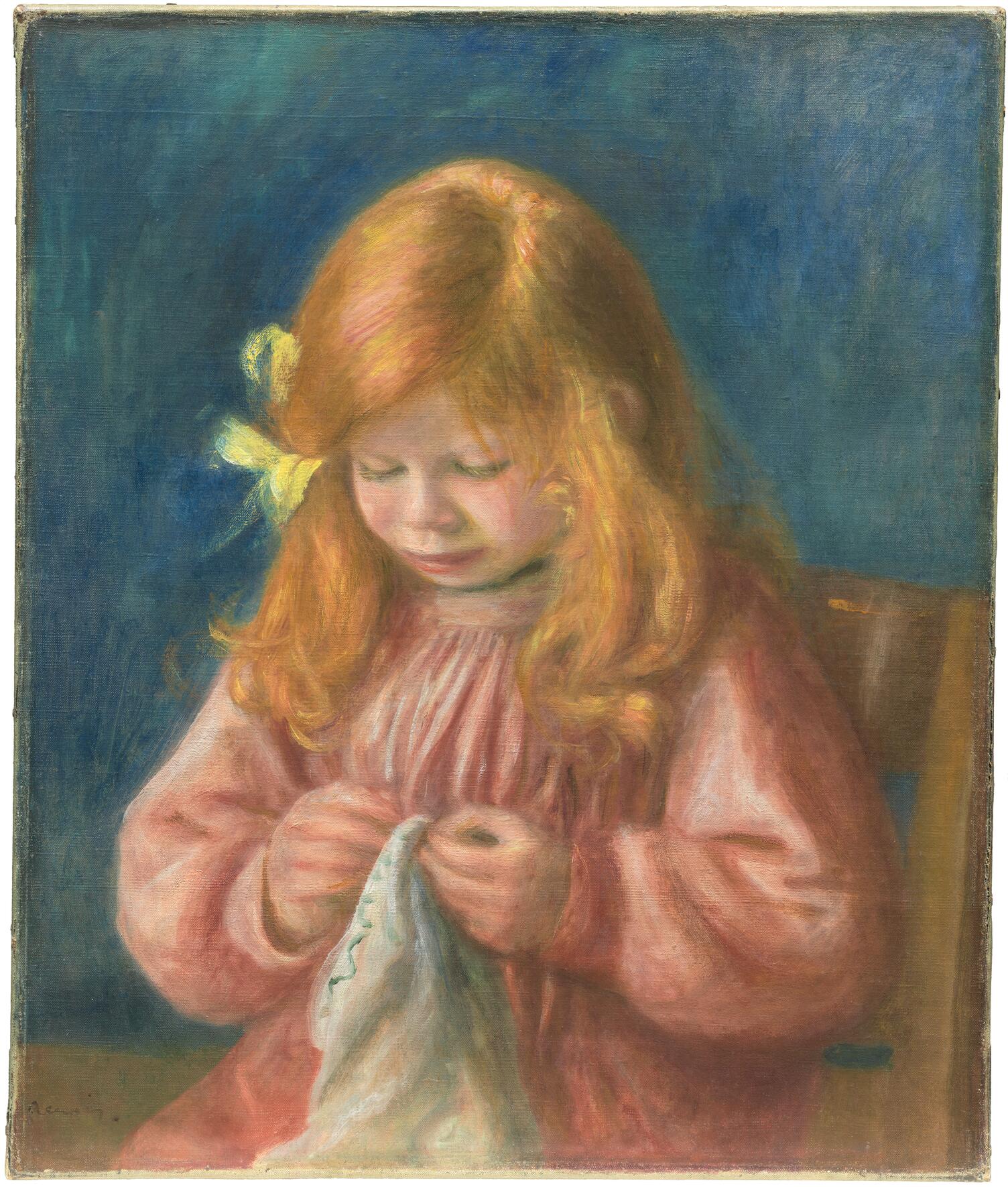
cat. 24 Jean Renoir Sewing, 1899/1900.
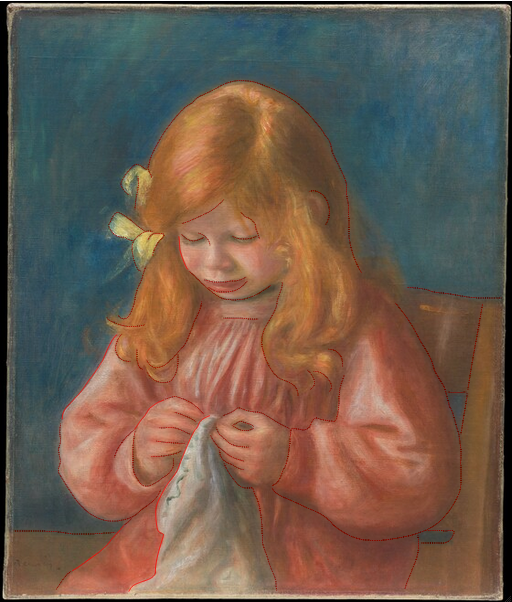
Renoir’s Jean Renoir Sewing (1899/1900). The Art Institute of Chicago, 1937.1027. Interactive image.
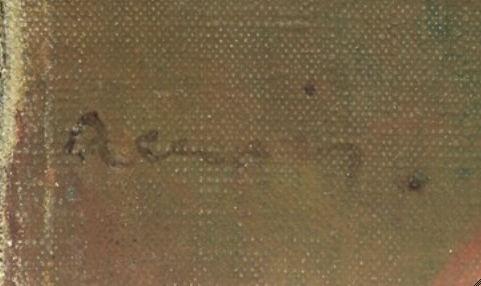
Detail of the artist’s signature in Renoir’s Jean Renoir Sewing (1899/1900). The Art Institute of Chicago, 1937.1027.
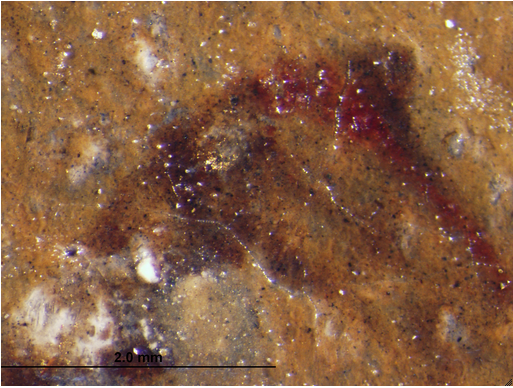
Photomicrograph of the signature in Renoir’s Jean Renoir Sewing (1899/1900). The Art Institute of Chicago, 1937.1027.
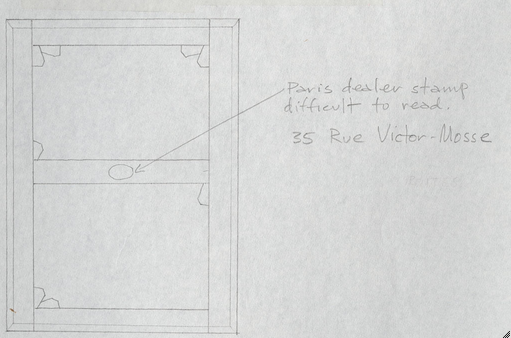
Transcription of the color merchant’s stamp from the original stretcher of Renoir’s Jean Renoir Sewing (1899/1900), on file in the Conservation Department, Art Institute of Chicago. The Art Institute of Chicago, 1937.1027.
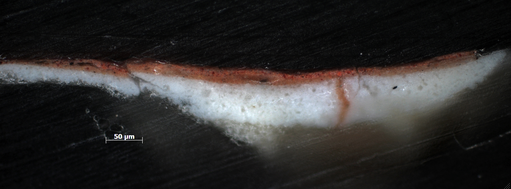
Photomicrograph of a cross section of red paint and ground in Renoir’s Jean Renoir Sewing (1899/1900). The lower layer of the commercial preparation is visible near the center of this sample. Original magnification: 200×. The Art Institute of Chicago, 1937.1027.
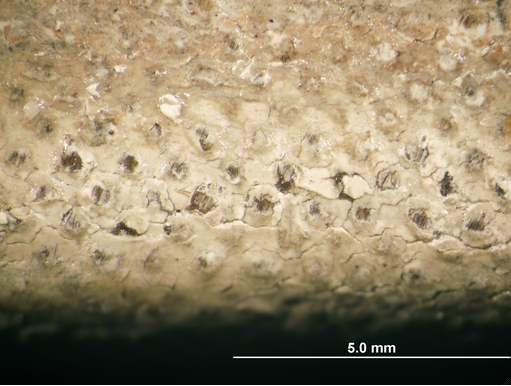
Photomicrograph of the ground in Renoir’s Jean Renoir Sewing (1899/1900). The Art Institute of Chicago, 1937.1027.
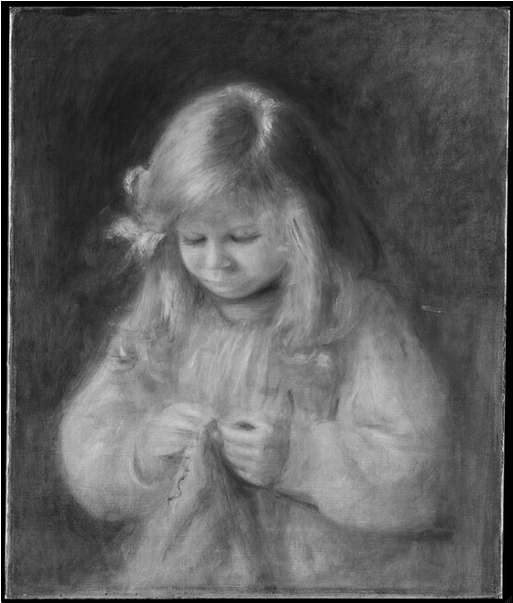
Infrared image (Goodrich, 1.1–1.4 µm) of Renoir’s Jean Renoir Sewing (1899/1900). The Art Institute of Chicago, 1937.1027.
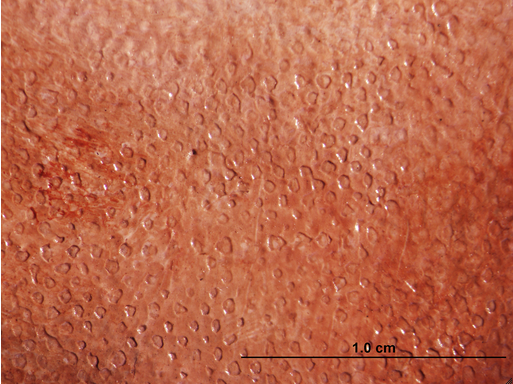
Photomicrograph of the figure’s garment in Renoir’s Jean Renoir Sewing (1899/1900) showing the textural buildup of paint. The Art Institute of Chicago, 1937.1027.
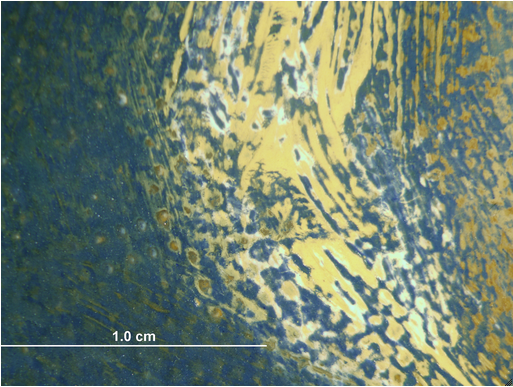
Photomicrograph of the scraped, yellow ribbon in Renoir’s Jean Renoir Sewing (1899/1900). The Art Institute of Chicago, 1937.1027.
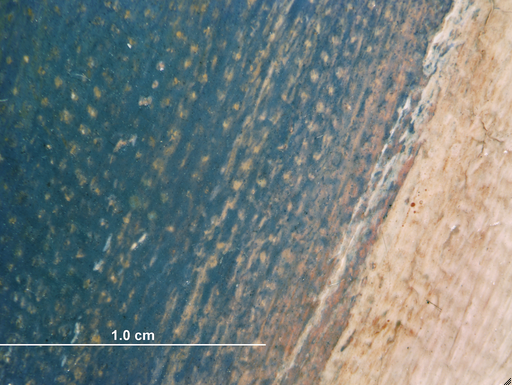
Photomicrograph of the outer edge of the figure’s right sleeve in Renoir’s Jean Renoir Sewing (1899/1900) showing artist’s revisions. The Art Institute of Chicago, 1937.1027.
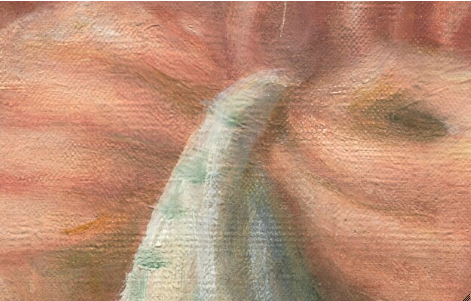
Detail of the figure’s hands in Renoir’s Jean Renoir Sewing (1899/1900) showing artist’s revisions. The Art Institute of Chicago, 1937.1027.
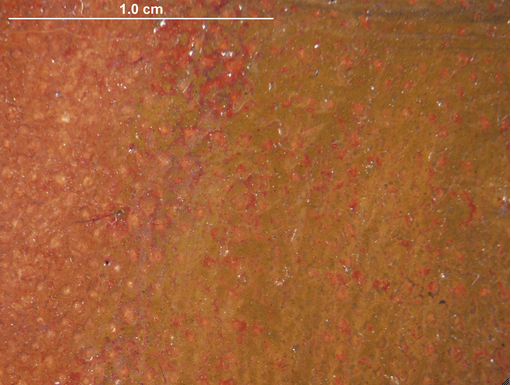
Photomicrograph of the figure’s garment and the chair in Renoir’s Jean Renoir Sewing (1899/1900) showing artist’s revisions. The Art Institute of Chicago, 1937.1027.

Photomicrograph of the figure’s hair in Renoir’s Jean Renoir Sewing (1899/1900) showing the wrinkling of paint. The Art Institute of Chicago, 1937.1027.
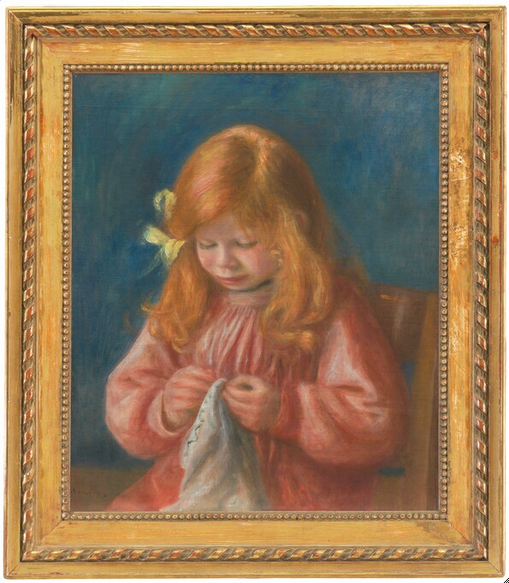
Renoir’s Jean Renoir Sewing (1899/1900) in its original frame. The Art Institute of Chicago, 1937.1027.
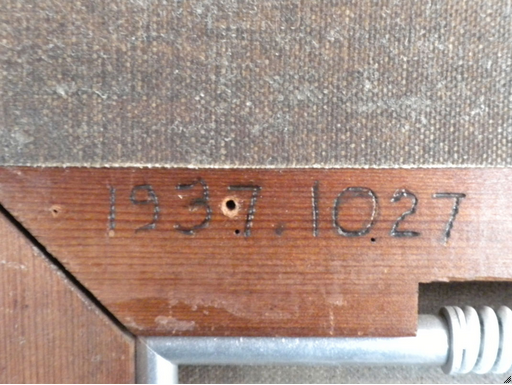
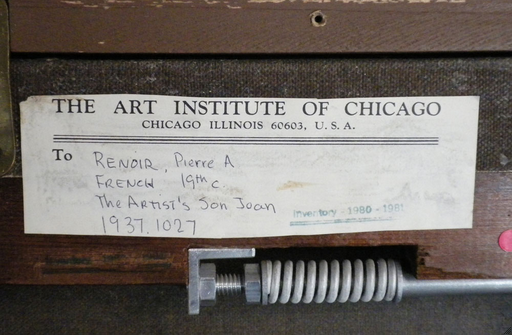
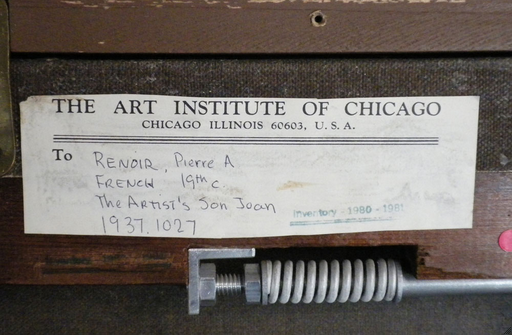
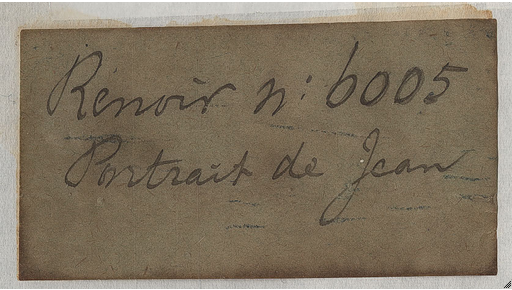
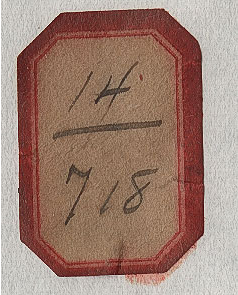
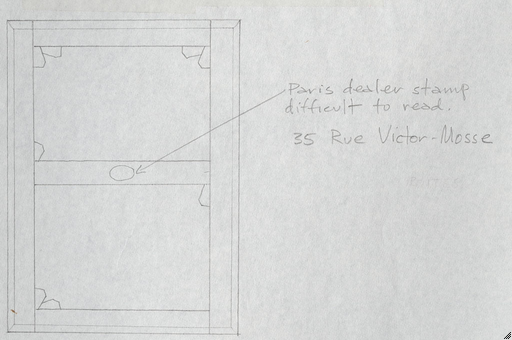
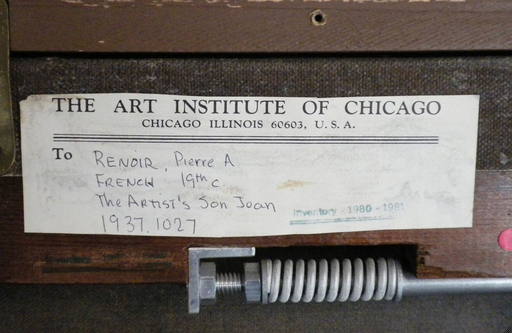
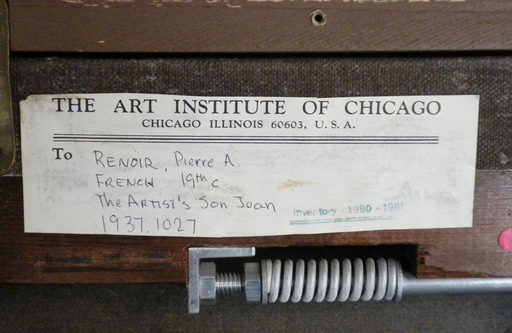
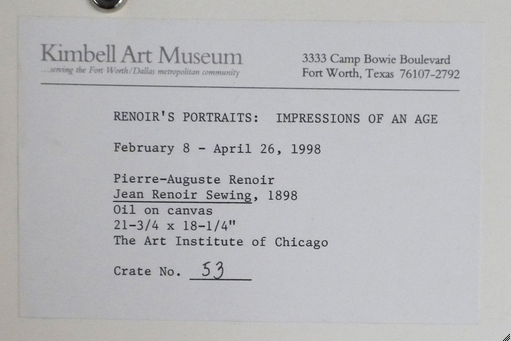
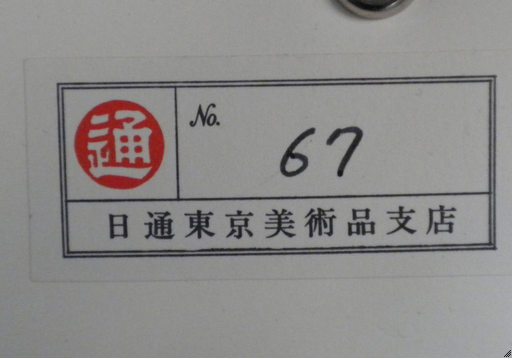
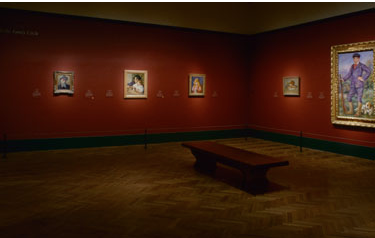
Installation of Renoir’s Jean Renoir Sewing (1899/1900) in Renoir’s Portraits: Impressions of an Age, Art Institute of Chicago, Oct. 17, 1997–Jan. 4, 1998. Institutional Archives, Art Institute of Chicago.
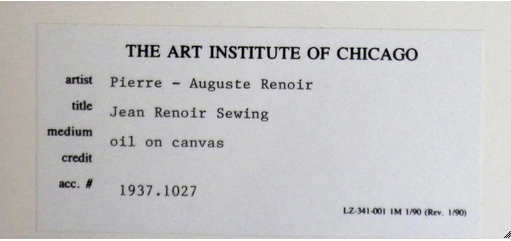
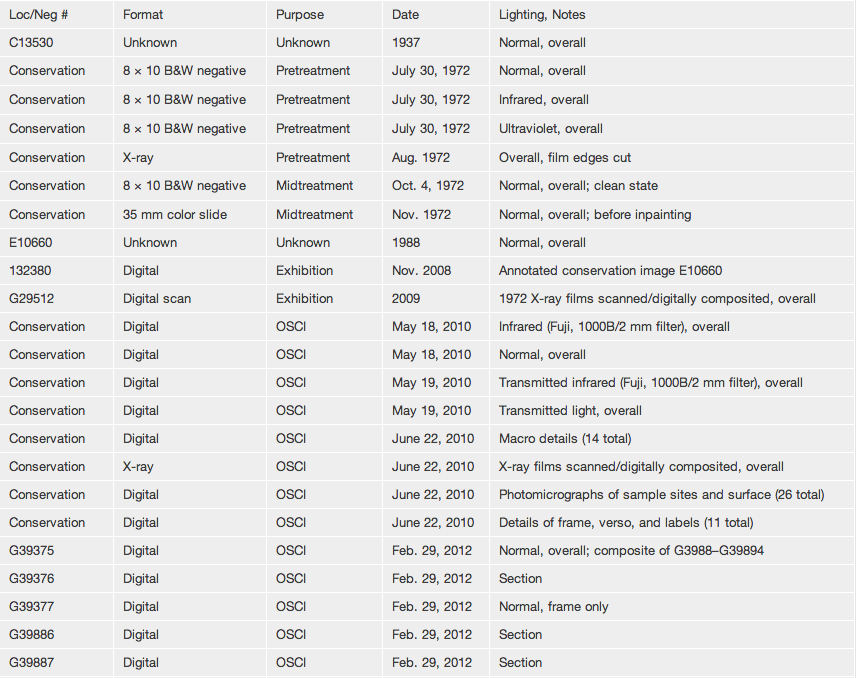
| Loc/Neg # | Format | Purpose | Date | Lighting, Notes |
| C13530 | Unknown | Unknown | 1937 | Normal, overall |
| Conservation | 8 × 10 B&W negative | Pretreatment | July 30, 1972 | Normal, overall |
| Conservation | 8 × 10 B&W negative | Pretreatment | July 30, 1972 | Infrared, overall |
| Conservation | 8 × 10 B&W negative | Pretreatment | July 30, 1972 | Ultraviolet, overall |
| Conservation | X-ray | Pretreatment | Aug. 1972 | Overall, film edges cut |
| Conservation | 8 × 10 B&W negative | Midtreatment | Oct. 4, 1972 | Normal, overall; clean state |
| Conservation | 35 mm color slide | Midtreatment | Nov. 1972 | Normal, overall; before inpainting |
| E10660 | Unknown | Unknown | 1988 | Normal, overall |
| 132380 | Digital | Exhibition | Nov. 2008 | Annotated conservation image E10660 |
| G29512 | Digital scan | Exhibition | 2009 | 1972 X-ray films scanned/digitally composited, overall |
| Conservation | Digital | OSCI | May 18, 2010 | Infrared (Fuji, 1000B/2 mm filter), overall |
| Conservation | Digital | OSCI | May 18, 2010 | Normal, overall |
| Conservation | Digital | OSCI | May 19, 2010 | Transmitted infrared (Fuji, 1000B/2 mm filter), overall |
| Conservation | Digital | OSCI | May 19, 2010 | Transmitted light, overall |
| Conservation | Digital | OSCI | June 22, 2010 | Macro details (14 total) |
| Conservation | X-ray | OSCI | June 22, 2010 | X-ray films scanned/digitally composited, overall |
| Conservation | Digital | OSCI | June 22, 2010 | Photomicrographs of sample sites and surface (26 total) |
| Conservation | Digital | OSCI | June 22, 2010 | Details of frame, verso, and labels (11 total) |
| G39375 | Digital | OSCI | Feb. 29, 2012 | Normal, overall; composite of G3988–G39894 |
| G39376 | Digital | OSCI | Feb. 29, 2012 | Section |
| G39377 | Digital | OSCI | Feb. 29, 2012 | Normal, frame only |
| G39886 | Digital | OSCI | Feb. 29, 2012 | Section |
| G39887 | Digital | OSCI | Feb. 29, 2012 | Section |
| G39888 | Digital | OSCI | Feb. 29, 2012 | Section |
| G39889 | Digital | OSCI | Feb. 29, 2012 | Section |
| G39890 | Digital | OSCI | Feb. 29, 2012 | Section |
| G39891 | Digital | OSCI | Feb. 29, 2012 | Section |
| G39892 | Digital | OSCI | Feb. 29, 2012 | Section |
| G39893 | Digital | OSCI | Feb. 29, 2012 | Section |
| G40436 | Digital | OSCI | July 2, 2012 | Ultraviolet, overall |
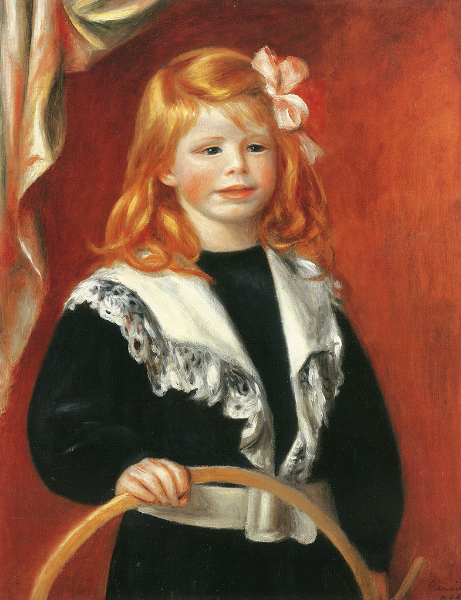
Pierre-Auguste Renoir (French, 1841–1919). Child with a Hoop, Jean Renoir, 1898. Oil on canvas; 65 × 50 cm (25 5/8 × 19 5/8 in.). Private collection.
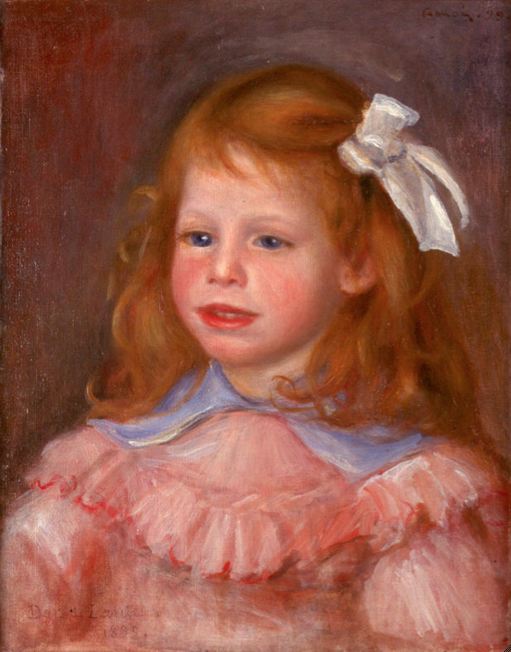
Pierre-Auguste Renoir (French, 1841–1919). Portrait de Jean Renoir, 1899. Oil on canvas; 41.5 × 33 cm (16 3/8 × 13 in.). Musée Municipal de l’Evêché, Limoges.
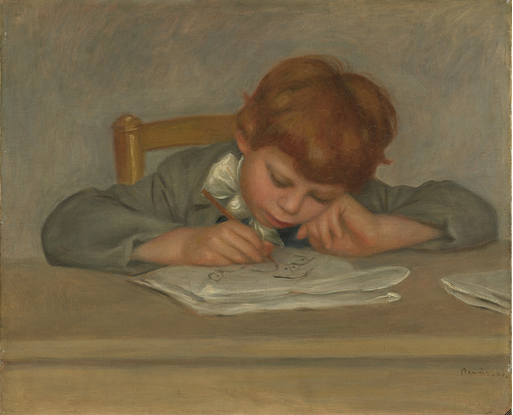
Pierre-Auguste Renoir (French, 1841–1919). The Artist’s Son, Jean, Drawing (Jean Renoir Dessinant), 1901. Oil on canvas; 45.1 × 54.5 cm (17 3/4 × 21 1/2 in.). Virginia Museum of Fine Arts, Richmond, Collection of Mr. and Mrs. Paul Mellon, 83.48.
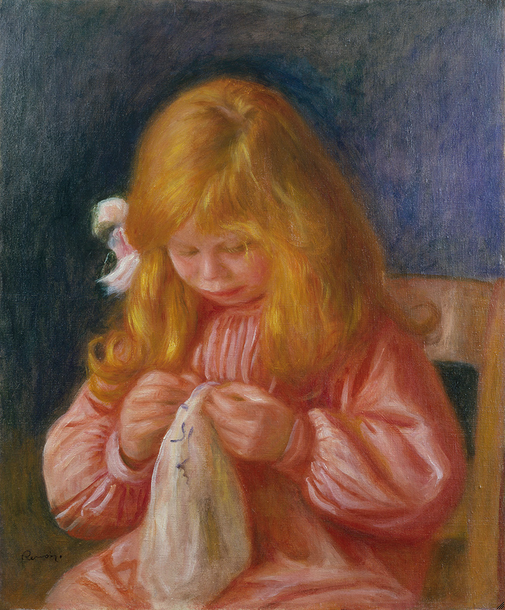
Pierre-Auguste Renoir (French, 1841–1919). Jean Renoir Sewing, c. 1900. Oil on canvas; 55.5 × 46.4 cm (21 7/8 × 18 1/4 in.). Wallraf-Richartz Museum and Fondation Corboud, Cologne. Photograph: © Rheinisches Bildarchiv, rba_c016043.
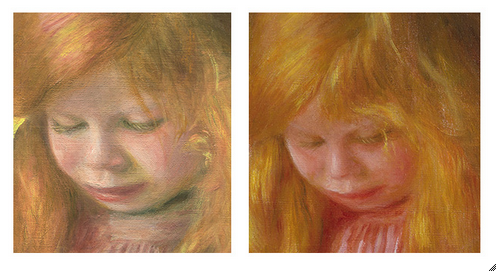
Detail of the figure’s face in the two versions of Renoir’s Jean Renoir Sewing. Left, Renoir’s Jean Renoir Sewing (1899/1900). The Art Institute of Chicago, 1937.1027. Right, Renoir’s Jean Renoir Sewing (c. 1900). Wallraf-Richartz Museum and Fondation Corboud, Cologne. Photograph: © Rheinisches Bildarchiv, rba_c016043.
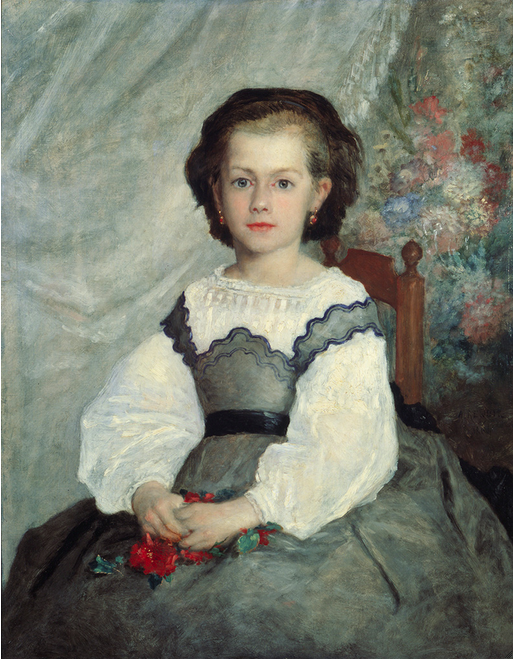
Pierre-Auguste Renoir (French, 1841–1919). Mademoiselle Romaine Lacaux, 1864. Oil on canvas; 81 × 65 cm (31 7/8 × 25 5/8 in.) The Cleveland Museum of Art, Gift of the Hanna Fund, 42.1065. Bridgeman-Giraudon/Art Resource, NY.

Backscattered electron image of a cross section of the ground and canvas in Renoir’s Jean Renoir Sewing (1899/1900) showing the two priming layers. Original magnification: 270×. The Art Institute of Chicago, 1937.1027.
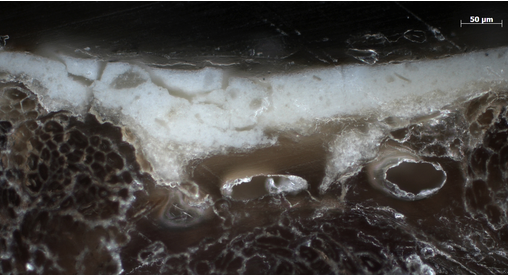
Photomicrograph of a cross section of the ground and canvas from Renoir’s Jean Renoir Sewing (1899/1900). Saturation of the canvas and ground by the wax-resin lining material makes the lower ground layer almost invisible. Original magnification: 200×. The Art Institute of Chicago, 1937.1027.
Seated Bather1289
1914
Oil on canvas; 81.1 × 67.2 cm (31 7/8 × 26 7/8 in.)
Signed and dated: Renoir. 1914. (lower left, in black or brown paint)
The Art Institute of Chicago, Mr. and Mrs. Lewis Larned Coburn Endowment; through prior bequest of Annie Swan Coburn to the Mr. and Mrs. Lewis Larned Coburn Memorial Fund; through prior acquisition of the R. A. Waller Fund, 1945.27
Following a visit to Renoir’s Paris studio in January 1886, Berthe Morisot noted in her journal: “Two drawings of nude women going into the sea delight me as much as those of Ingres. He said that nudes seemed to him to be one of the essential forms of art.”1290 Indeed, the nude would come to dominate Renoir’s work for the next three decades and define his late period style. Later in life the artist was candid about his obsession with the theme. As he told his son Jean shortly before he died: “Perhaps I have painted the same three or four pictures all my life. But one thing is certain: ever since my trip to Italy I have been concentrating on the same problems.”1291
The pneumatic form of the model in Seated Bather, characteristic of Renoir’s late figure paintings, verges on the surreal. During the artist’s lifetime these late nudes, whose rhythmic contours follow no prescribed canon of beauty, provoked extreme reactions, and it is hard to believe that Renoir remained unaware of the controversy surrounding them. Mary Cassatt, who exhibited with the Impressionists, visited Renoir in Cagnes several times in 1913 and early 1914 and became alarmed by his increasing frailty and apparent isolation. In a letter to the American collector Louisine Havemeyer, Cassatt wrote scathingly: “He is doing the most awful pictures or rather studies of enormously fat red women with very small heads. Vollard persuades himself that they are fine. J[oseph] Durand-Ruel knows better.”1292
If the Durand-Ruel family held any reservations about this work, it did not stop them from actively buying from Renoir. Between 1908 and 1914 they acquired nearly two hundred paintings from the artist (presumably most were recent) for a total of nearly 500,000 francs, a sum that does not include additional purchases made by collectors and other art dealers such as Ambroise Vollard.1293 The deposit of Seated Bather with Durand-Ruel in August 1914, likely not long after it was painted, reflects an unabated demand for Renoir’s latest interpretation of the nude.1294
The most passionate aficionados of late Renoir nudes were leading artists of the avant-garde working in Paris. In July 1919 the art dealer Paul Rosenberg wrote Renoir that Pablo Picasso desired to meet with him during a planned visit to Paris the following month, though it is assumed that Renoir’s poor health prevented this rendezvous from taking place.1295 After Picasso made a trip to Italy in 1917, he entered a classical period of his own and was especially attracted to Renoir’s late bathers. Picasso’s Large Bather of 1921 (Musée de l’Orangerie, Paris) openly confesses admiration of the elder artist and seems to emulate Seated Bather in the pose and the model’s voluminous shoulders, arms, and legs. The poet and critic Guillaume Apollinaire wrote glowingly of how Renoir “uses his last days to paint these fabulous, voluptuous nudes which will be admired in years to come.”1296 Henri Matisse and Pierre Bonnard were among the many visitors the artist welcomed in Cagnes in the later years of his life, and they came to see the work, not to pay homage to an Impressionist pioneer.1297 The ubiquity of the bather theme in the work of these two younger artists owes as much to Renoir’s example as to Jean-Auguste-Dominique Ingres or Paul Cézanne.
Endorsement by collectors and these luminaries of Modernism transformed late Renoir paintings in the eyes of critics. His late work came to represent a new beginning for twentieth century art, rather than a final flourishing of nineteenth century naturalism. When Seated Bather appeared in a benefit exhibition organized by Durand-Ruel, New York, in April 1942, the New York Times wrote: “Renoir’s final effort at its very best, the magnificent nude called ‘Baigneuse Assise,’ dated 1914. This is one of the greatest paintings created in our time.”1298 Not all were convinced, however. A frequent visitor to the Durand-Ruel gallery in New York at the time of the exhibition, Robert Sterling Clark, grandson of the business partner of Isaac Singer, refused to add a late nude to his collection of about thirty Renoirs, most dating to before 1900. When Clark learned in June 1944 that the Art Institute of Chicago was interested in acquiring Seated Bather, he dismissed it as “a great big mushy gelatinous fat woman with a sad face strawberry tint, has no bones only fat.”1299 Indeed, by the time Clark was writing, this response typified attitudes toward the late nudes.1300
The model for Seated Bather is probably Madeleine Bruno, a young girl from Cagnes, who began working for Renoir in early 1914 and assisted in his care as he grew more infirm. She appears quite petite and slim in a photograph taken in the garden of Renoir’s home at Les Collettes in April or May 1914 (fig. 2.54).1301 Renoir’s regular model, Gabrielle Renard, had joined the Renoir household a month before the birth of Jean Renoir in September 1894 and had been posing nude for Renoir since 1900. She left in late 1913 after quarrelling with Renoir’s wife, Aline.1302 Madeleine continued to work for Renoir until at least 1916, when she posed as a standing bather of equally large scale (The Bathers, 1916; private collection [Dauberville 4281]).1303 When asked about her role as a Renoir model in the 1970s, Madeleine found it difficult to recognize herself in the curvilinear forms of his figures.1304
Renoir’s interest in and admiration for the art of Ancient Greece is clearly articulated in the preface he prepared in 1909–10 for the reprinting of Cennino Cennini’s Renaissance treatise on painting.1305 As Robert Herbert has pointed out, Renoir’s long draft for the Cennini preface, which was edited for publication in the Catholic journal L’Occident, refers continually to how the power of Greek art is derived from religion: “Conscious of their weakness, ancient peoples felt the need to shelter themselves behind divine power.”1306 The year the Cennini treatise was published, the Thurneyssen family of Munich commissioned from Renoir a portrait of their son Alexander as an Arcadian shepherd (fig. 2.55 [Dauberville 4267]), completed the next year in a pose that makes explicit reference to the figure of Dionysus on the east pediment of the Parthenon on the Acropolis in Athens (fig. 2.56).1307
The monumental gods of the Parthenon pediment may also be a source for the pose in Seated Bather, painted three years after the Thurneyssen portrait. The figure’s massive scale can be compared with the formidable proportions of the three goddesses (Hestia, Dione, and Aphrodite), who observe the birth of Athena on the east pediment (fig. 2.57). As Kenneth Clark observed of Renoir’s late nudes: “In the unselfconscious acceptance of their nudity they are perhaps more Greek than any nudes painted since the Renaissance, and come closest to attaining the antique balance between truth and ideal.” Clark reproduces Seated Bather to illustrate his point that in the early part of the twentieth century Renoir developed “a new race of women, massive, ruddy, unseductive but with the weight and unity of great sculpture.”1308
While Renoir liked to think of his art as rooted in nature and not based in art theory of any kind, the exaggerated proportions of these late nudes raise the question of whether they are simply erotic fantasies or reflect a complex artistic goal in tune with the times. In particular, Renoir’s late nudes can be understood in the context of a psychology of style, part of a broader movement toward spirituality and a definition of the beautiful that lay outside accepted academic practice. In his emulation of the solid proportions of ancient Greek sculpture, Renoir sought a path to the mystical source of the southern classical tradition. Just as the artist endeavored in the 1870s to find universal truths in the popular culture of bohemian youth, in these late nudes he pursued a timeless classicism that he imagined to originate with the inhabitants of an earthly paradise at the “primitive” beginning of the Western tradition. Toward the end of his life Renoir marveled: “What admirable beings those Greeks. Their existence was so happy that they imagined that the gods, to find their paradise and to love, descended to the earth. . . . Yes, the earth was the paradise of the gods. There, that is what I wish to paint.”1309
The Parisian artist Albert André first visited Renoir in the south of France about 1902 and became a devoted promoter of the artist’s work and one of the most observant of his late biographers. His book on Renoir appeared about May 1919, the month he sent a copy to the artist. In it he describes the artist’s working procedures:
He launches into his canvas, when the subject is simple, by tracing with the brush, generally with reddish brown [Jean Renoir refers to burnt sienna], a few very quick guidelines to see the proportions of the elements that will constitute his painting. “Les volumes . . .”, he says a little sarcastically. Then immediately, in pure colors diluted with spirit, as if he were working in watercolor, he rapidly rubs the canvas and one sees something imprecise and iridescent appear, the tones flowing into each other, something that delights you even before it is clear how the image will appear.1310
What André describes is Renoir’s habit of working quickly with a long handled, fine brush soaked in color thinned with spirits, the way one might use a crayon or pencil. Once the artist applied an initial paint layer, he ended his first session at the canvas. After the underpaint had dried a little, according to André, Renoir returned with more color and applied pure white to the areas he wanted to be luminous. The thin, transparent tones that resulted were the envy of Henri Matisse.1311
Renoir executed Seated Bather in a manner consistent with André’s description of his working procedure. The paint is quite translucent overall. The flesh tones were blended while they were still in a liquid state. That resulting surface appears to exhibit endless variation in tone. Renoir explained to the American artist and critic Walter Pach his goal as a colorist in painting flesh tones: “I look at a nude; there are myriads of tiny tints. I must find the ones that will make the flesh on my canvas live and quiver.”1312 Additional white highlights in the flesh tones of Seated Bather were also added at a late stage to increase the luminosity (fig. 2.58). Renoir’s extensive use of thin layers of color throughout the painting is further exemplified in the blending of the background foliage. He dragged thin, liquid yellow and green across existing textured strokes in yellow and white; the thinner paint sank into the depressions (fig. 2.19). Areas of layered impasto are evident in the face and hair and are especially conspicuous in the application of yellow over the reddish-brown hair color (fig. 3.60).
While alluding to Greek sculpture with his principal figure in Seated Bather, Renoir placed the painting in a contemporary context by showing the model wearing tiny earrings and with her hair pulled back into a bun, as well as by adding two nudes in the background who appear engaged in typical post-bath activities: drying off with a towel and adjusting one’s hair. The rugged mountainous landscape setting is reminiscent of Provence, the region in the south of France where Renoir lived out his days. The area’s plentiful reminders of a Greco-Roman heritage cannot be underestimated as a potent source for Renoir’s updated vision of antiquity. Although the late style of Renoir is more controlled and classical in its expression of form, Seated Bather demonstrates that, in these last years, he lost nothing of the ingenious blending of color and luminosity that characterizes his earlier Impressionist painting.
John Collins
Renoir began this work by lightly sketching this composition in [glossary:graphite] on a commercially prepared, standard-size, relatively coarse [glossary:canvas].1313 The artist reinforced the outlines in some areas several times, and the repeated contours of the figures at the right make specific changes to their placements less obvious. The central figure’s face was lightly sketched prior to painting, unlike the rest of the figure, and Renoir shifted the gaze, lifting her right eye and adjusting her mouth in the final painting. There may also be discrete sketched elements between the paint layers functioning almost like shading, as in the center-right figure. The central figure is largely outlined in reddish-brown paint; it is unclear, however, whether this was an initial planning step or executed later in the painting stage. The paint layer is quite translucent overall, making use of paint thinned with additional oil and turpentine to achieve a very liquid state. The artist also appears to have rubbed areas of the painting with a cloth or his hand, both to wipe back areas of change, as in the figure’s left arm, and to blend the transition between figure and ground. The flesh tones of the central figure appear largely blended via wiping, and the sense of individual brushstrokes seen in the face and the two figures at the right is muted by this method. The painting appears to have been worked up as a whole, with no discrete sequence of execution, and it is currently unvarnished.1314
The multilayer interactive image viewer is designed to facilitate the viewer’s exploration and comparison of the technical images (fig. 2.30).1315
Signed and dated: Renoir. 1914. (lower left, in black or brown paint) (fig. 1.2, fig. 1.3).
Flax (commonly known as linen).1316
The earliest documented dimensions of the painting are inscribed on the verso of an undated Durand-Ruel photograph of the work: 32 × 26 5/8 in. [81.28 × 67.63 cm];1317 it is unclear whether these measurements predate the [glossary:lining]. Measuring from the apparent foldovers on all four sides, the original dimensions appear to be approximately 80 × 66.5 cm. This probably corresponds to a no. 25 portrait ([glossary:figure]) standard-size (81 × 65 cm) canvas.1318
[glossary:Plain weave]. Average [glossary:thread count] (standard deviation): 16.8V (0.3) × 12.0H (0.5) threads/cm. The vertical threads were determined to correspond to the [glossary:warp] and the horizontal threads to the [glossary:weft].1319
[glossary:Cusping] is most visible in the [glossary:X-ray] and it present only on the sides, where it is relatively pronounced; it appears to correspond to tack holes along the [glossary:foldover] placed approximately 5–7cm apart.1320 Tacks along the edges of the compositional space would not have functioned to attach the work to a [glossary:stretcher] and may indicate the work was removed from its stretcher, or had another secondary [glossary:support] such as a board (fig. 1.1).
Current stretching: The work was restretched as part of the 1953 lining, and the perimeter was extended on all sides.
Original stretching: Uncertain; may have been tacked to a board or on the face of a stretcher during or immediately after execution.1321
Current stretcher: Five-member keyable stretcher with horizontal [glossary:crossbar]. Depth: 2.3 cm.
Original stretcher: Unknown.
No manufacturer’s or supplier’s marks were observed during the current examination or documented in previous examinations.
Not determined (probably glue).1322
A single-layer commercial preparation extends to the edges of the [glossary:tacking margins], is relatively smooth, and ranges approximately 25–160 µm in thickness. Interestingly, the [glossary:ground] appears very thin across the tops of the canvas threads, in some cases not coating the threads enough to mask the sense of individual fibers within the thread even under additional paint (fig. 2.20). The thinness of the ground in combination with the artist’s rubbing and wiping of the paint layer left thread tops exposed in many areas; these are especially sensitive and prone to additional abrasion.
The ground appears to be a dull white in [glossary:stereomicroscopic examination], however [glossary:cross-sectional analysis] revealed no colored [glossary:pigments] to be present (see Materials/composition). Also, the pigment and medium content do not suggest the ground to be a translucent or semi-translucent layer easily affected by treatments such as lining (fig. 2.5). With these facts in mind, it is not entirely clear whether this current appearance is due to the quality or manufacture of the ground materials themselves or possible discoloration from another unknown source. As the painting is currently unvarnished and was recently cleaned, these visual affects cannot be attributed to surface coatings or grime (see Conservation History) (fig. 1.4).
The ground is predominantly lead white with trace amounts of alumina, silica, calcium carbonate and various complex silicates, some containing iron.1323 The [glossary:binder] is estimated to be [glossary:oil].1324
There is a very sketchy [glossary:underdrawing] of the figures at right and of the face of the central figure, marked by a lack of fine detail and executed with an unsteady hand.1325 The nature of the drawing suggests broad movement of the artist’s arm, with sweeping contours and repeated movements, especially for the figures on the right (fig. 2.49). Limited drawing of the central figure’s face is more distinct, though these lines also show a lack of fine detail. The lines themselves were lightly applied, and their direction is often affected by the canvas [glossary:weave]; in some places, the graphite only skimmed the thread tops or was thrown in a different direction by the bumpy texture of the weave. There are periodically stray graphite lines that do not appear to correspond to specific forms, such as the diagonal across the central figure’s forehead.
Graphite.
The roughness and uncertain quality of the sketch make smaller changes less discernable; however, it does appear that Renoir shifted the level of the eyes and modified the placement of the figures at the right (fig. 2.50).
This painting is executed in a series of layered washes and semi-glazes with limited [glossary:impasto].1326 It appears that Renoir’s paint was quite fluid, thinned with solvent or a solvent/oil mixture and often rubbed back with a cloth or possibly his hand so that the color sits mostly in the interstices of the canvas with the appearance of a stain.1327 The [glossary:X-ray] shows very little of the visible composition, as the paint is so thin in most areas that only the overall ground and lighter, thicker highlights register. In some areas, the artist layered this rubbing over an existing color. In the background, for example, a thin layer of green was applied and allowed to dry, over which the artist applied thin reds and yellows, wiping them back to reveal the green painted thread tops (fig. 2.22). In other areas, the underlying paint was quite thick and textured when he added a thin veil of contrasting color (fig. 2.23). Renoir also dragged thicker paint of a pastelike consistency across thin underpaint so that only the crests of the weave are coated creating a kind of contrast effect (fig. 2.28). The artist reserved oil-rich glazes for specific sections of the figure’s hair and upper eyelids, combining red lake with black to create deep-crimson shadows (fig. 2.24); a slight saturation and gloss is still present in these shadows despite a lack of varnish.
Renoir’s most prominent use of rubbing or wiping appears in his [glossary:modeling] of the central figure. Comparing her flesh tones to those of the figures at right, the central figure appears smoother, with many tones indistinctly blended and an earthy, reddish-brown outline. The artist applied many colors side by side throughout this figure’s flesh, and wiped or rubbed them in their still-liquid state to create smooth modeling and to blur the figure-ground transition. Some distinct brushwork is still visible in the thicker paint of this figure’s face.
This fluid technique yielded a painting that appears to have been worked up as a whole, with the transitions between figure and ground very smooth and sometimes rubbed; the sequence of forms is indistinct. Once the general elements were articulated, the artist went back into specific areas to add details. He also wiped back the paint to make subtle compositional changes, such as the outer edge of the figure’s right arm (fig. 2.25). Layers of translucent washes and glazes make up the hair, while a fine brush with thicker paint was employed for final details such as the eyes (fig. 2.26). In some areas, it appears that Renoir sketched additional lines between and above painted layers; the lines along the back of the center-right figure function almost like hatched shading (fig. 2.27). The presence of impasto in some of the lower layers indicates Renoir executed the painting in multiple sessions, allowing the earlier layers to dry between campaigns. While limited impasto is visible beneath the surface, in many areas it was added as a final touch, as in the white highlights in the drapery.
Fine, soft-bristle brushes; limited stiff-bristle, flat brushes (strokes up to 1 cm wide); possible cloth for rubbing; graphite.
Analysis indicates the presence of the following pigments: lead white, zinc white, red lake, vermilion, bone black, viridian, terre verte, cobalt blue, Naples yellow, yellow ochre, and possibly zinc yellow.1328
Oil (estimated).1329
The painting is currently unvarnished with no residues of previous [glossary:varnish] layers.
The painting was damaged while on loan in 1952 and cut from its stretcher; it was subsequently lined in 1953.1330 In 1972 the painting was noted as being abraded and having a heavy, discolored natural resin varnish. The work was cleaned of grime and given a [glossary:synthetic varnish] of polyvinyl acetate (PVA) AYAA.1331 In 2004–05 the work was cleaned and all varnish layers and [glossary:retouching] was removed.1332 The tear and some additional abrasion were minimally retouched, and after examination of related paintings, the painting was left unvarnished.1333
The work is in stable condition, planar and aqueously lined and unvarnished. During the lining process, it was attached to the stretcher slightly askew, so that a small amount of compositional paint is bent over the bottom edge at left. There is a series of small holes in the canvas along the foldovers on both sides. Retouching is limited to areas of abrasion and the tear resulting from the 1952 damage. The work has an overall abraded appearance due to age, previous treatments and the artist’s rubbing technique. There are a few localized superficial creases at the lower left and over the figure’s right hand.
Kelly Keegan
Current frame (installed after 1975): The frame is not original to the painting. It is an American (APF Master Frame Makers, New York), mid-twentieth-century, Louis VI reproduction, architrave frame with carved rolled-leaf-and-stave ornament and a lozenge-and-bead sight molding. The frame has oil and water gilding over red bole on gesso with induced [glossary:craquelure]. The white gold gilding is burnished selectively on the ornament and fillet. The gilding is heavily rubbed and toned with washes of oil paint and casein or gouache with dark flecking overall. The basswood molding is mitered and nailed. The molding, from the perimeter to the interior, is fillet; torus with carved rolled-leaf-and-stave ornament; fillet; and lozenge-and-bead sight molding (fig. 2.31).1334
Previous frame (installed by 1975, removed at an unknown date): The work was previously housed in an American, mid-twentieth-century, L-shaped narrow frame with a gilded face on a mahogany molding with exposed splines at the miters (fig. 2.32). The frame may have been a design by James L. Speyer.
Kirk Vuillemot
Placed on deposit by the artist with Durand-Ruel, Paris, Aug. 1914.1335
Sold by the artist jointly to Bernheim-Jeune, Paris, Ambroise Vollard, Paris, and Durand-Ruel, Paris, Aug. 2, 1917.1336
All shares transferred from Bernheim-Jeune, Paris, and Ambroise Vollard, Paris, to Durand-Ruel, Paris, Oct. 2, 1917.1337
Sold by Durand-Ruel, New York, to the Art Institute of Chicago, Feb. 23, 1945.1338
New York, Durand-Ruel, Exhibition of Paintings by Renoir, Feb. 19–Mar. 9, 1918, cat. 16, as Baigneuse assise, 1914.1339
Possibly New York, Durand-Ruel, Exhibition of Paintings by the Master Impressionists, Oct. 15–Nov. 10, 1934, cat. 27.1340
Museum of Modern Art Gallery of Washington (D.C.), Cézanne, Gauguin, Seurat, Renoir, Van Gogh, Nov. 15–Dec. 5, 1937, cat. 19.1341
Philadelphia, Pennsylvania Museum of Art, Renoir: Later Phases, Apr. 16–May 29, 1938, no cat.1342
Worcester (Mass.) Art Museum, The Art of the Third Republic: French Painting, 1870–1940, Feb. 22–Mar. 16, 1941, cat. 11 (ill.).
New York, Durand-Ruel, Exhibition of Masterpieces by Renoir after 1900: For the Benefit of Children’s Aid Society, Apr. 1–25, 1942, cat. 10 (ill.).
New York, Museum of Modern Art, Art in Progress: Painting, Prints, Sculpture, May 24–Oct. 15, 1944, no cat. no. (ill.).1343
Art Institute of Chicago, Masterpiece of the Month, Feb. 1946, no cat.1344
Cincinnati Art Museum, Paintings: 1900–1925, Feb. 2–Mar. 4, 1951, cat. 4 (ill.).
Pittsburgh, Carnegie Institute, French Painting, 1110–1900, Oct. 18–Dec. 2, 1951, cat. 118 (ill.).
Paris, Musée National d’Art Moderne, L’oeuvre du XXe siecle, May–June 1952, cat. 93 (ill.); London, Tate Gallery, as Twentieth Century Masterpieces: An Exhibition of Paintings and Sculpture, July 15–Aug. 17, 1952 (Paris only).1345
Art Institute of Chicago, Paintings by Renoir, Feb. 3–Apr. 1, 1973, cat. 84 (ill.).
London, Hayward Gallery, Renoir, Jan. 30–Apr. 21, 1985, cat. 121 (ill.); Paris, Galeries Nationales du Grand Palais, May 14–Sept. 2, 1985, cat. 119 (ill.); Boston, Museum of Fine Arts, Oct. 9, 1985–Jan. 5, 1986.
Atlanta, High Museum of Art, Inspiring Impressionism: The Impressionists and the Art of the Past, Oct. 16, 2007–Jan. 13, 2008, cat. 90 (ill.); Denver Art Museum, Feb. 23–May 25, 2008; Seattle Art Museum, June 19–Sept. 21, 2008.
Paris, Galeries Nationales, Grand Palais, Renoir au XXe siècle, Sept. 23, 2009–Jan. 4, 2010, cat. 62 (ill.); Los Angeles, Los Angeles County Museum of Art, as Renoir in the 20th Century, Feb. 14–May 9, 2010; Philadelphia Museum of Art, as Late Renoir, June 17–Sept. 6, 2010.
Durand-Ruel, New York, Exhibition of Paintings by Renoir, exh. cat. (Durand-Ruel, New York, 1918), p. 3, cat. 16.
Gustave Coquiot, Renoir (A. Michel, 1925), opp. p. 216 (ill.).
Possibly Durand-Ruel, New York, Exhibition of Paintings by the Master Impressionists, exh. cat. (Durand-Ruel, New York, 1934), cat. 27.1346
Edward Alden Jewell, “Gallery to Open in Capital Today,” New York Times, Nov. 14, 1937, p. 51.
Museum of Modern Art Gallery of Washington (D.C.), Cézanne, Gauguin, Seurat, Renoir, Van Gogh, exh. cat. (Museum of Modern Art Gallery of Washington, [1937]), no. 19.
Martha Davidson, “Poetic View of the Late Renoir,” Art News 36, 31 (Apr. 30, 1938), p. 22.
Worcester Art Museum, Art of the Third Republic: French Painting, 1870–1940, exh. cat. (Worcester Art Museum, 1941), cat. 11 (ill.).
Edward Alden Jewell, “21 Renoir Works Shown as Benefit,” New York Times, Apr. 2, 1942, p. 28.
Edward Alden Jewell, “The Last Two Decades of Renoir,” New York Times, Apr. 5, 1942, p. X5 (ill.).1347
Durand-Ruel, New York, Exhibition of Masterpieces by Renoir after 1900: For the Benefit of Children’s Aid Society, with an essay by Lionello Venturi, exh. cat. (Durand-Ruel, New York, 1942), no. 10 (ill.).
Museum of Modern Art, New York, Art in Progress: A Survey Prepared for the Fifteenth Anniversary of the Museum of Modern Art, New York, exh. cat. (Museum of Modern Art, 1944), pp. 23 (ill.), 223.
“Chicago Perfects Its Renoir Group,” Art News 44, 16, pt. 1 (Dec. 1–14, 1945), pp. 18, 19 (ill.).
“Famous Renoir Nude Goes to Chicago.” Art Digest 20, 6 (Dec. 15, 1945), p. 6 (ill.).
Art Institute of Chicago, An Illustrated Guide to the Collections of the Art Institute of Chicago (Art Institute of Chicago, 1945), p. 36 (ill.).1348
Florence Hope, “A Late Renoir Recently Added to the Institute’s Collection,” Bulletin of the Art Institute of Chicago 39, 7 (Dec. 1945), front cover (ill.), pp. 99, 100 (detail), 101.
John Rewald, The History of Impressionism (Museum of Modern Art/Simon & Schuster, 1946), p. 429 (ill.).
Art Institute of Chicago, “Exhibitions,” Bulletin of the Art Institute of Chicago 40, 1 (Jan. 1946), p. 2.
Art Institute of Chicago, “Exhibitions,” Bulletin of the Art Institute of Chicago 40, 2, pt. 2 (Feb. 1946), p. 18.
Art Institute of Chicago, “Do You Know,” Bulletin of the Art Institute of Chicago 40, 3 (Mar. 1946), p. 32.
Art Institute of Chicago, “Great Drawings and Paintings Added in 1945,” Bulletin of the Art Institute of Chicago: The Year 1945 40, 4, pt. 3 (Apr.–May 1946), p. 6 (ill.).
“Vernissage,” Art News 44, 18 (Jan. 1–14, 1946), p. 11.
“Art News of the Year,” in “Art News Annual 1946–47,” special issue, Art News 45, 10, section 2 (Dec. 1946), p. 161 (ill.).
Carnegie Institute, French Painting, 1110–1900, exh. cat. (Carnegie Institute, 1951), pl. 118.
Cincinnati Art Museum, Paintings: 1900–1925, exh. cat. (Cincinnati Art Museum, 1951), cat. 4 (ill.).
Musée National d’Art Moderne, L’oeuvre du XXe siècle, exh. cat. (Musée National d’Art Moderne, 1952), cat. 93/pl. 8.
“Youths Caught Stealing Famous Paintings in Paris,” New York Times, June 28, 1952, p. 11.
Marcelle Berr de Turique, Renoir (Phaidon, [1953]), pl. 98.
Dorothy Bridaham, Renoir in the Art Institute of Chicago (Conzett & Huber, 1954), pl. 9.
Kenneth Clark, The Nude: A Study of Ideal Art (John Murray, 1957), pp. 159; 160, ill. 123.1349
Art Institute of Chicago, Paintings in the Art Institute of Chicago: A Catalogue of the Picture Collection (Art Institute of Chicago, 1961), p. 398.1350
George Heard Hamilton, Painting and Sculpture in Europe: 1880–1940, Pelican History of Art, ed. Nikolaus Pevsner (Penguin, 1967), pp. xi; 14; pl. 4B.1351
Charles C. Cunningham and Satoshi Takahashi, Shikago bijutsukan [Art Institute of Chicago], Museums of the World, 32 (Kodansha, 1970), pp. 128, pl. 116; 177.
Art Institute of Chicago, Paintings by Renoir, exh. cat. (Art Institute of Chicago, 1973), pp. 27; 194–95, cat. 84 (ill.); 202; 211; 214.
A. James Speyer and Courtney Graham Donnell, Twentieth-Century European Paintings (University of Chicago Press, 1980), pp. 12, 66, cat. 3E11; microfiche 3, no. E10 (ill.).
Hayward Gallery, Galeries Nationales du Grand Palais, Paris, and Museum of Fine Arts, Boston, Renoir, exh. cat. (Arts Council of Great Britain, 1985), pp. 173, cat. 121 (ill.); 285; 286, cat. 121 (ill.); 288; 289.
Hayward Gallery, Galeries Nationales du Grand Palais, Paris, and Museum of Fine Arts, Boston, Renoir, exh. cat. (Réunion des Musées Nationaux, 1985), pp. 348; 350–53, cat. 119 (ill. and detail); 360.
Rachel Barnes, ed., Renoir by Renoir, Artists by Themselves (Webb & Bower, 1990), pp. 72–73 (ill.). Translated into Japanese by Reiko Kokatsu as Runowaru (Renoir), Nikkei Pocket Gallery (Nihon Keizai Shimbun, 1991), pp. 78–79 (ill.), 88.
Martha Kapos, ed., The Impressionists: A Retrospective (Hugh Lauter Levin/Macmillan, 1991), p. 232, pl. 72.
Romy Golan, Modernity and Nostalgia: Art and Politics in France between the Wars (Yale University Press, 1995), pp. 19, 20–21 (ill.).
Steven Kern, “A Passion for Renoir,” in A Passion for Renoir: Sterling and Francine Clark Collect, 1916–1951, ed. Margaret Donovan, exh. cat. (Sterling and Francine Clark Institute/ Abrams, 1996), p. 24.
Douglas W. Druick, Renoir, Artists in Focus (Art Institute of Chicago/Abrams, 1997), pp. 13; 74; 77–79; 107, pl. 26; 111.
Renaud Temperini, “Estetiche della modernità,” in La pittura Francese, vol. 3, ed. Pierre Rosenberg, trans. Cosima Campagnolo, Valentina Palombi, and Stefano Salpietro (Electra, 1999), p. 821.1352
Gilles Néret, Renoir: Painter of Happiness, 1841–1919, trans. Josephine Bacon (Taschen, 2001), pp. 340 (ill.), 341 (detail), 342.
Aviva Burnstock, Klass Jan van den Berg, and John House, “Painting Techniques of Pierre-Auguste Renoir: 1868–1919,” Art Matters: Netherlandish Technical Studies in Art 3 (2005), p. 52.
Markus Schöb, “Femme s’essuyant,” in Kunstmuseum Winterthur: Katalog der Gemälde und Skulpturen, vol. 2, ed. Dieter Schwarz (Kunstmuseum Wintherthur/Richter, 2008), pp. 60, 61 (ill.)
Ann Dumas, “Old Art into New: The Impressionists and the Reinvention of Tradition,” in Inspiring Impressionism: The Impressionists and the Art of the Past, ed. Ann Dumas, exh. cat. (Denver Art Museum/Yale University Press, 2007), pp. 71; 74–75, cat. 90 (ill.).
Ann Dumas, ed., Inspiring Impressionism: The Impressionists and the Art of the Past, exh. cat. (Denver Art Museum/Yale University Press, 2007), p. 261.
Jon Kear, The Treasures of the Impressionists (Andre Deutch/Carlton Books, 2008), p. 56 (ill.).
Anne Distel, Renoir (Citadelles & Mazenod, 2009), p. 366, ill. 324.
Adrien Goetz, Comment Regarder . . . Renoir (Hazan, 2009), pp. 168–69 (ill).
Galeries Nationales, Grand Palais, Los Angeles County Museum of Art, and Philadelphia Museum of Art, Renoir au XXe siècle, exh. cat. (Réunion des Musées Nationaux/Musée d’Orsay, 2009), pp. 296–97; 301, cat. 62 (ill.).
Los Angeles County Museum of Art and Philadelphia Museum of Art, Renoir in the 20th Century, with essays by Roger Benjamin, Guy Cogeval, Claudia Einecke, Isabelle Gaëtan, et al., exh. cat. (Los Angeles County Museum of Art/Philadelphia Museum of Art/Hatje Cantz, 2010), pp. 296–97; 301, cat. 62 (ill.).
Laurence Madeline, “Picasso 1917–1924: Une crise ‘renoirienne,’” in Galeries Nationales, Grand Palais, Los Angeles County Museum of Art, and Philadelphia Museum of Art, Renoir au XXe siècle, exh. cat. (Réunion des Musées Nationaux/Musée d’Orsay, 2009), p. 128.
Laurence Madeline, “Picasso 1917 to 1924: A ‘Renoirian’ Crisis,” in Los Angeles County Museum of Art and Philadelphia Museum of Art, Renoir in the 20th Century, with essays by Roger Benjamin, Guy Cogeval, Claudia Einecke, Isabelle Gaëtan, et al., exh. cat. (Los Angeles County Museum of Art/Philadelphia Museum of Art/Hatje Cantz, 2010), p. 128.
Sylvie Patry, “‘On doit faire la peinture de son temps,’” in Galeries Nationales, Grand Palais, Los Angeles County Museum of Art, and Philadelphia Museum of Art, Renoir au XXe siècle, exh. cat. (Réunion des Musées Nationaux/Musée d’Orsay, 2009), p. 360.
Sylvie Patry, “‘One Must Do the Painting of One’s Time,’” in Los Angeles County Museum of Art and Philadelphia Museum of Art, Renoir in the 20th Century, with essays by Roger Benjamin, Guy Cogeval, Claudia Einecke, Isabelle Gaëtan, et al., exh. cat. (Los Angeles County Museum of Art/Philadelphia Museum of Art/Hatje Cantz, 2010), p. 360.
Sylvie Patry, “Renoir et la décoration, ‘un plaisir sans pareil,’” in Galeries Nationales, Grand Palais, Los Angeles County Museum of Art, and Philadelphia Museum of Art, Renoir au XXe siècle, exh. cat. (Réunion des Musées Nationaux/Musée d’Orsay, 2009), pp. 55.
Sylvie Patry, “Renoir and Decorative Art: ‘A Pleasure without Compare,’” in Los Angeles County Museum of Art and Philadelphia Museum of Art, Renoir in the 20th Century, with essays by Roger Benjamin, Guy Cogeval, Claudia Einecke, Isabelle Gaëtan, et al., exh. cat. (Los Angeles County Museum of Art/Philadelphia Museum of Art/Hatje Cantz, 2010), p. 56.
Thomas Schlesser, “Renoir et sa dernière manière, les figures,” in “Renoir au XXe siècle: Exposition aux Galeries Nationales du Grand Palais,” ed. Jeanne Faton-Boyancé, special issue, L’estampille l’object d’art 46 (2009), p. 48 (ill.).
Martha Lucy and John House, Renoir in the Barnes Foundation (Barnes Foundation/Yale University Press, 2012), p. 181, fig. 1.
Guy-Patrice Dauberville and Michel Dauberville, Renoir: Catalogue raisonné des tableaux, pastels, dessins et aquarelles, vol. 5, 1911–1919 & Ier supplément (Bernheim-Jeune, 2014), pp. 387–88, cat. 4280 (ill.).
Inventory number
Bernheim-Jeune stock no. 209401353
Photograph number
Photo Berhnheim-Jeune no. 18461354
Inventory number
Stock Durand-Ruel, New York, 41071355
Photograph number
Photo Durand-Ruel New York 80421356
Photograph number
Photo Durand-Ruel New York a16361357
Inscription (fig. 2.37)
Inscription (fig. 2.36)
Label (fig. 2.34)
Number
Location: original canvas tacking margin
Method: hand-painted script (black)
Content: 45.27 (fig. 2.33)
Label
Location: stretcher
Method: handwritten script (graphite) on red and white circular label
Content: N [. . .] (fig. 2.40)
Inscription
Location: stretcher
Method: handwritten script
Content: RENOIR SEATED FIG (fig. 2.35)
Inscription
Location: stretcher
Method: handwritten script (blue pencil)
Content: PhA1636 (fig. 2.8)
Inscription
Location: stretcher
Method: handwritten script (blue pencil)
Content: Ph 8042 (fig. 2.51)
Stamp
Location: stretcher
Method: red stamp
Content: Ä [superimposed]• (fig. 2.38)
Label
Location: stretcher
Method: handwritten script (ink) on brown paper label
Content: Renoir no. 11005 / Baigneuse assise / (1914) (fig. 2.39)
Label
Location: stretcher
Method: typed label
Content: Museum of Modern Art / LOAN / 44.1078 / Durand-Ruel (fig. 2.41)
Label
Location: stretcher
Method: handwritten script on printed label
Content: Renoir No. [ ] 07 / Baigneuse assise / 1914 / [crossed-out script] (fig. 2.48)
Label
Location: backing board
Method: typed label
Content: THE ART INSTITUTE OF CHICAGO / artist Pierre Auguste Renoir / title Seated Bathers, 1914 / medium oil on canvas / credit Mr. and Mrs. Lewis Larned Coburn / acc. # 1945.27 / LZ-341-001 1M 1/90 (Rev. 1/90) (fig. 2.42)
Label
Location: backing board
Method: digitally printed label
Content: rmn [logo] / RENOIR au XXème siècle / 21 septembre 2009 < 4 janvier 2010 / Galeries nationales du Grand Palais / Renoir / Beigneuse assise / EX. 2331.77 / No INV. 1945.27 / Chicago / The Art Institute of Chicago / 64 (fig. 2.43)
Westinghouse X-ray unit, scanned on Epson Expressions 10000XL flatbed scanner. Scans were digitally composited by Robert G. Erdmann, University of Arizona.
Inframetrics Infracam with 1.5–1.73 µm filter; Fujifilm S5 Pro with X-Nite 1000B/2 mm filter (1.0–1.1 µm); Goodrich/Sensors Unlimited SU640SDV-1.7RT with H filter (1.1–1.4 µm) and J filter (1.5–1.7 µm).
Fujifilm S5 Pro with X-Nite 1000B/2 mm filter (1.0–1.1 µm).
Natural-light, raking-light, and transmitted-light overalls and macrophotography: Fujifilm S5 Pro with X-NiteCC1 filter.
Fujifilm S5 Pro with X-NiteCC1 filter and Kodak Wratten 2E filter.
Sinar P3 camera with Sinarback eVolution 75 H (Kodak Wratten 2E filter and PECA 918 UV/IR interference cut filter)
Sample and cross-sectional analysis were performed using a Zeiss Axioplan 2 research microscope equipped with reflected light/UV fluorescence and a Zeiss AxioCam MRc5 digital camera. Types of illumination used: darkfield, brightfield, differential interference contrast (DIC), and UV. In situ photomicrographs were taken with a Wild Heerbrugg M7A StereoZoom microscope fitted with an Olympus DP71 microscope digital camera.
Several spots on the painting were analyzed in situ with a Bruker/Keymaster TRACeR III-V with rhodium tube.
Zeiss Universal research microscope.
Cross sections were analyzed after carbon coating with a Hitachi S-3400N-II VPSEM with an Oxford EDS and a Hitachi solid-state BSE detector. Analysis was performed at the Northwestern University Atomic and Nanoscale Characterization Experimental (NUANCE) Center, Electron Probe Instrumentation Center (EPIC) facility.
Thread count and weave information were determined by Thread Count Automation Project software.1358
Overlay images were registered using a novel image-based algorithm developed by Damon M. Conover (GW), Dr. John K. Delaney (GW, NGA), and Murray H. Loew (GW) of the George Washington University’s School of Engineering and Applied Science and the National Gallery of Art, Washington, D.C.1359
The image inventory compiles records of all known images of the artwork on file in the Conservation Department, the Imaging Department, and the Department of Medieval to Modern European Painting and Sculpture at the Art Institute of Chicago (fig. 2.52).
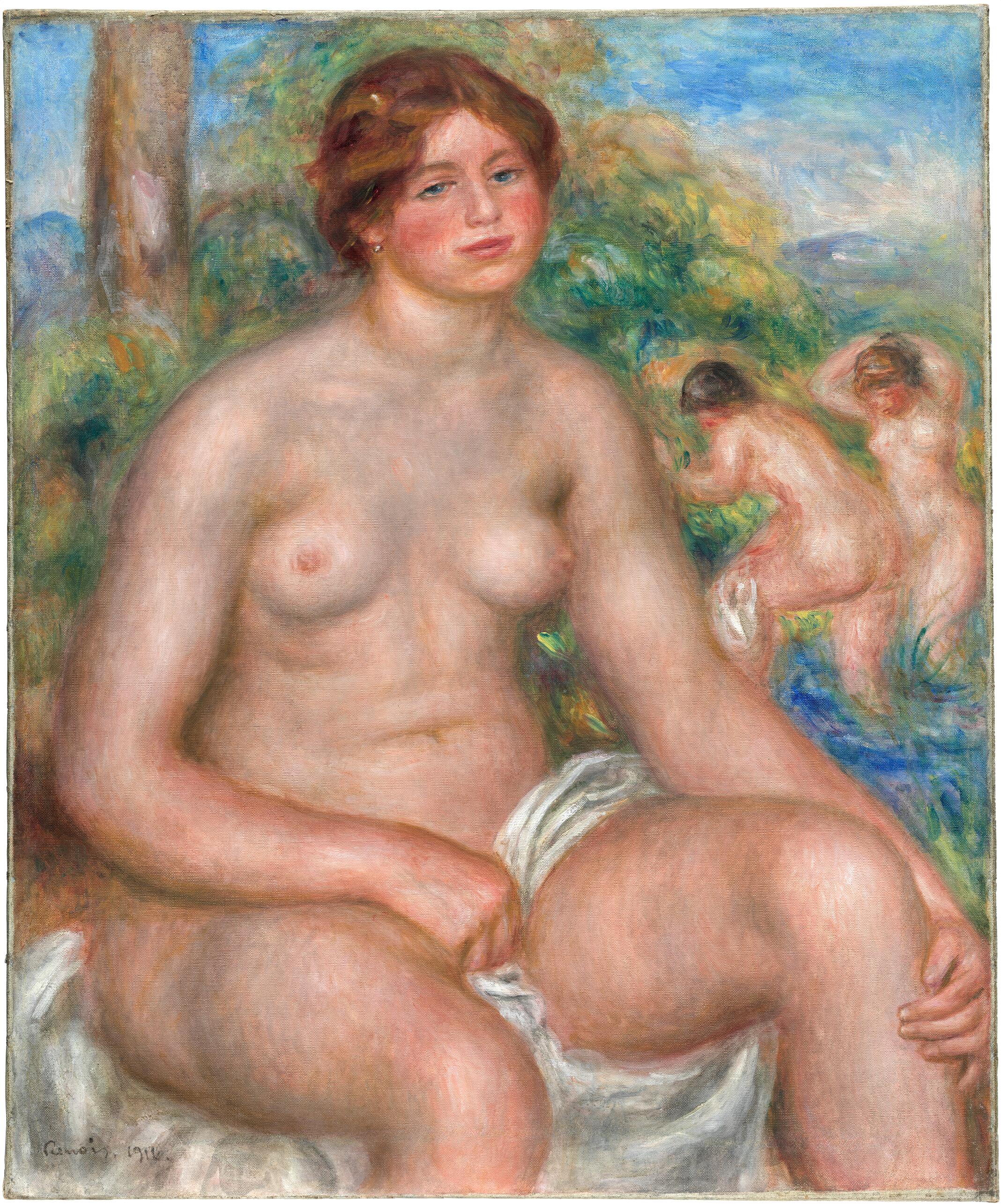
cat. 25 Seated Bather, 1914.
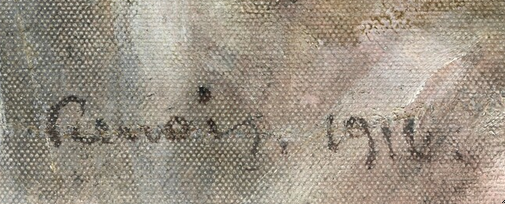
Detail of the artist’s signature in Renoir’s Seated Bather (1914). The Art Institute of Chicago, 1945.27.
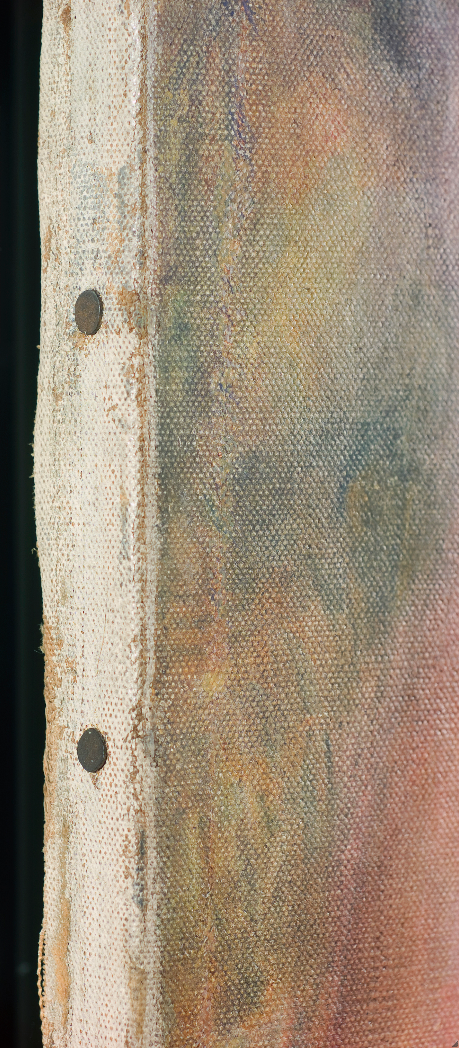
Detail of the tack holes along the left foldover of Renoir’s Seated Bather (1914). The Art Institute of Chicago, 1945.27.
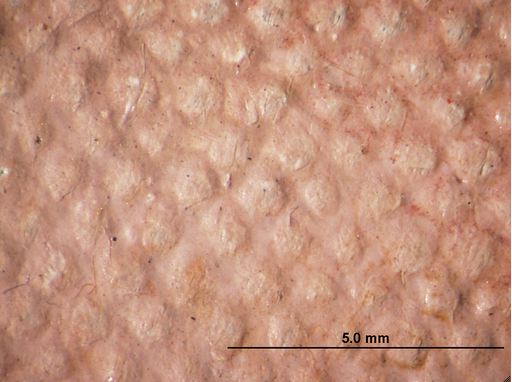
Photomicrograph of the ground and canvas beneath thin paint layers in Renoir’s Seated Bather (1914). The Art Institute of Chicago, 1945.27.
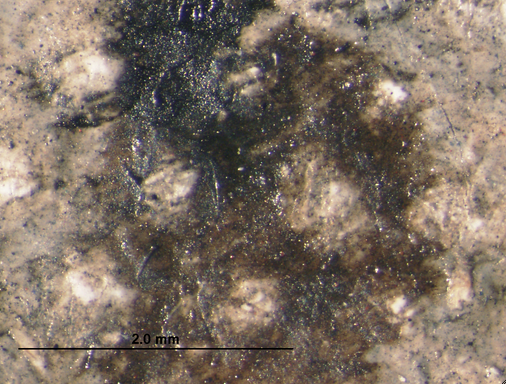
Photomicrograph of the signature in Renoir’s Seated Bather (1914). The Art Institute of Chicago, 1945.27.
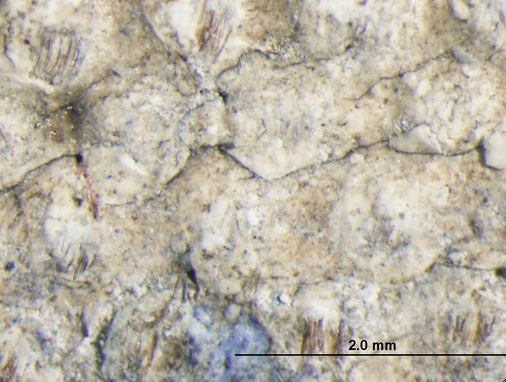
Photomicrograph of the ground in Renoir’s Seated Bather (1914). The Art Institute of Chicago, 1945.27.
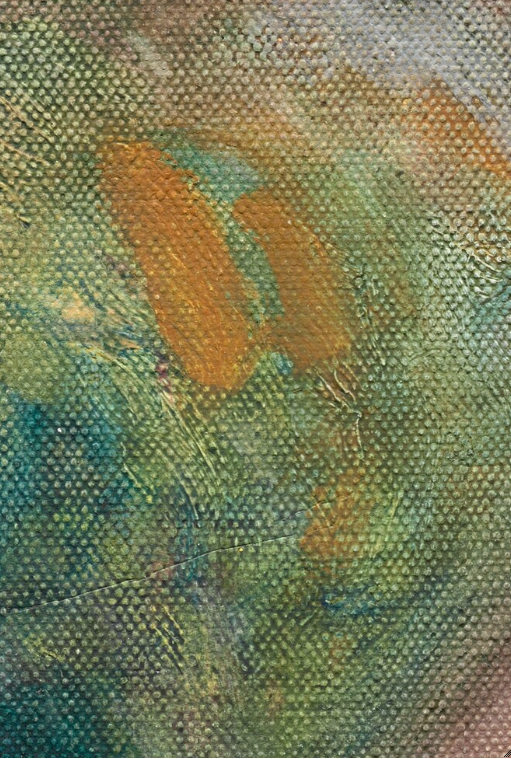
Detail of the background in Renoir’s Seated Bather (1914) showing the layering and wiping away of paint by the artist. The Art Institute of Chicago, 1945.27.
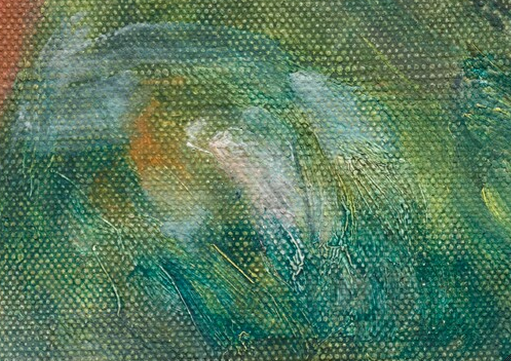
Detail of the background in Renoir’s Seated Bather (1914) showing where the artist applied a wash over heavily textured paint. The Art Institute of Chicago, 1945.27.
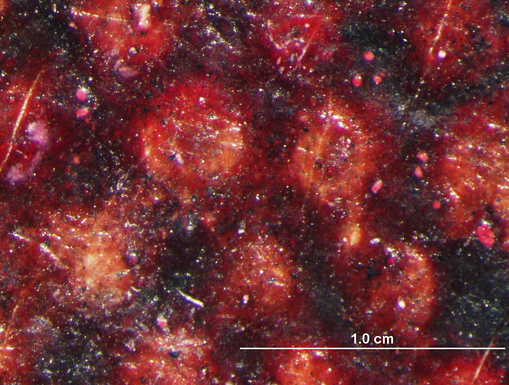
Photomicrograph of the deep-red paint mixture used for shadows in Renoir’s Seated Bather (1914). The Art Institute of Chicago, 1945.27.
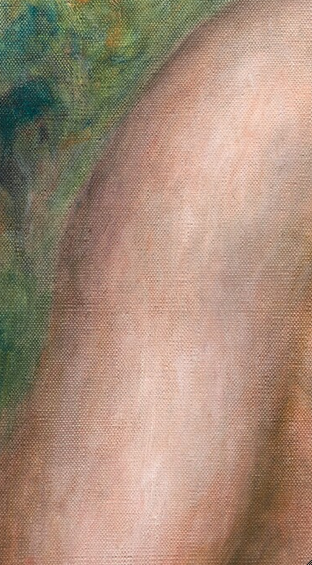
Detail of the figure’s right arm in Renoir’s Seated Bather (1914) showing artist’s revisions. The Art Institute of Chicago, 1945.27.
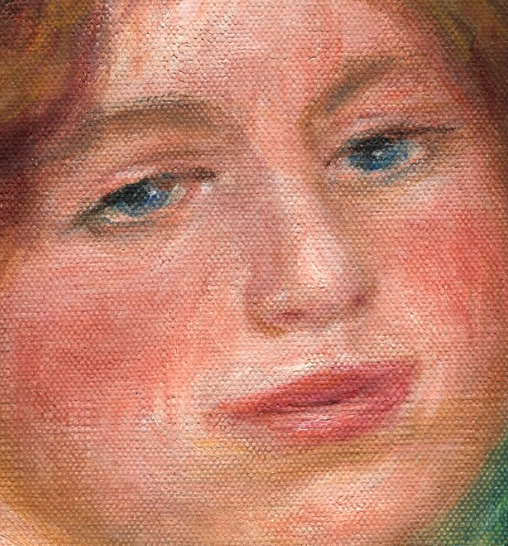
Detail of the figure’s face in Renoir’s Seated Bather (1914) showing the artist’s use of washes and glazes. The Art Institute of Chicago, 1945.27.
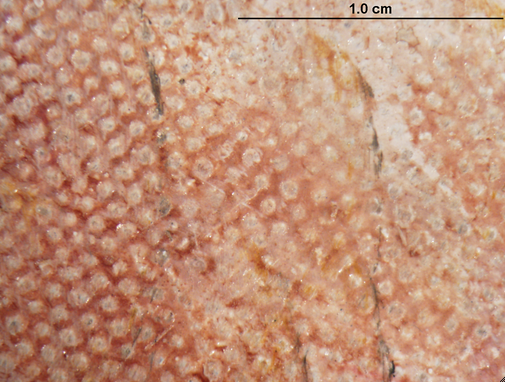
Photomicrograph of Renoir’s Seated Bather (1914) showing graphite lines used for shading the figures on the right. The Art Institute of Chicago, 1945.27.
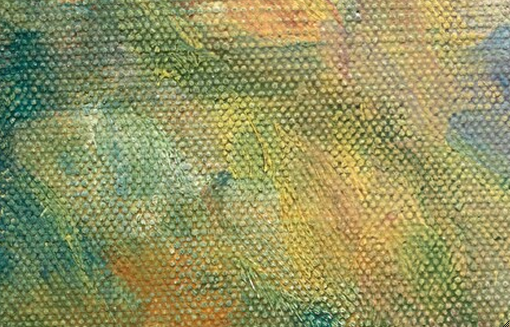
Detail of the background foliage in Renoir’s Seated Bather (1914) showing the artist’s layering of contrasting colors. The Art Institute of Chicago, 1945.27.
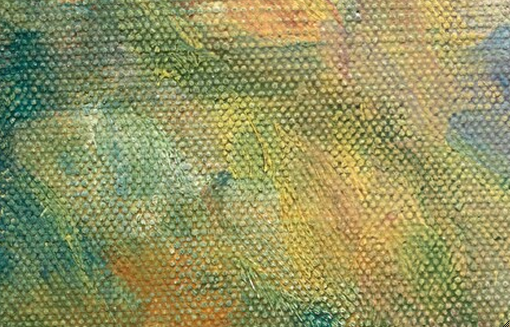
Detail of the background foliage in Renoir’s Seated Bather (1914) showing the artist’s layering of contrasting colors. The Art Institute of Chicago, 1945.27. MAC 20 for curatorial
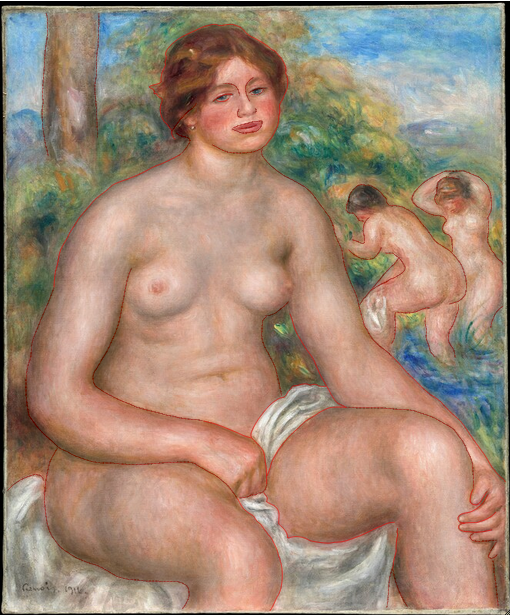
Renoir’s Seated Bather (1914). The Art Institute of Chicago, 1945.27. Interactive image.
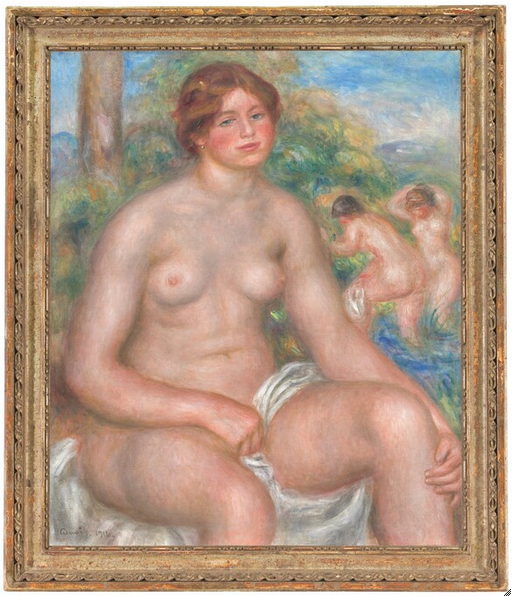
Renoir’s Seated Bather (1914) in its current frame. The Art Institute of Chicago, 1945.27.
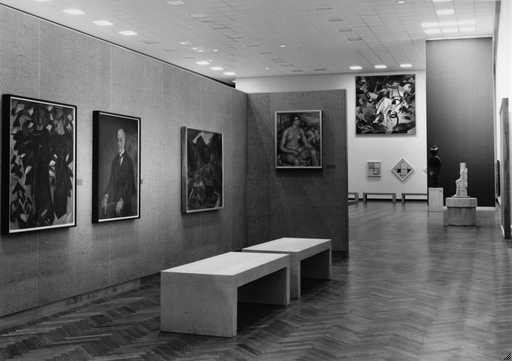
Renoir’s Seated Bather (1914) in a previous frame, gallery installation, late 1970s–early 1980s. The Art Institute of Chicago, 1945.27.

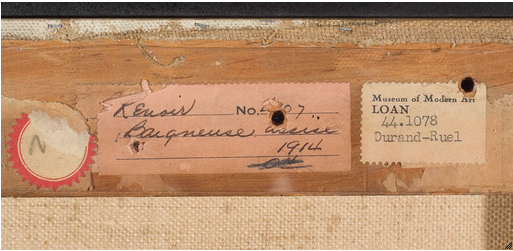

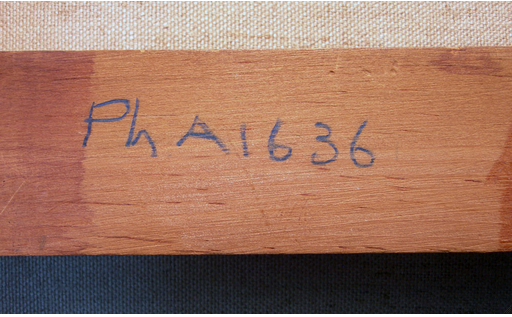
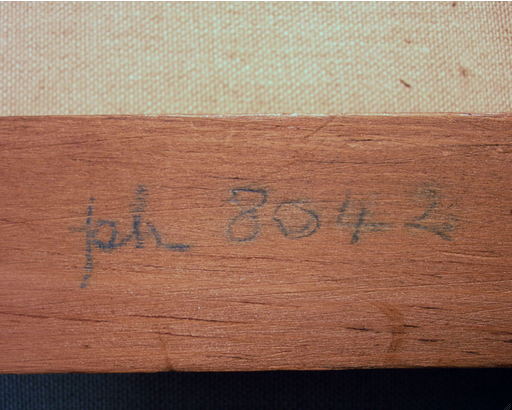
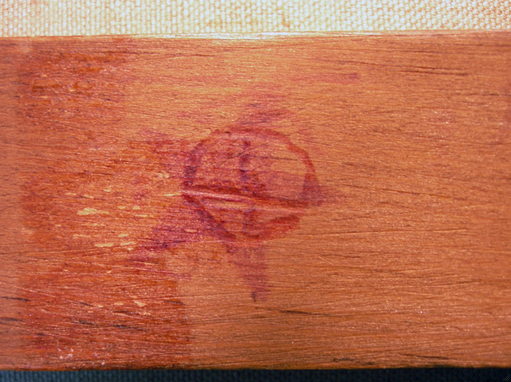
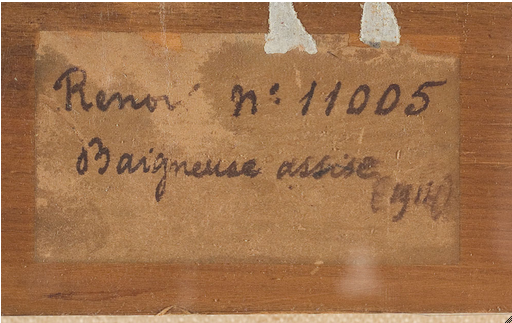
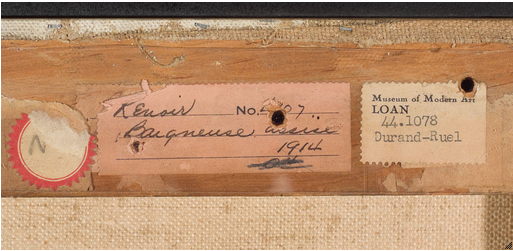
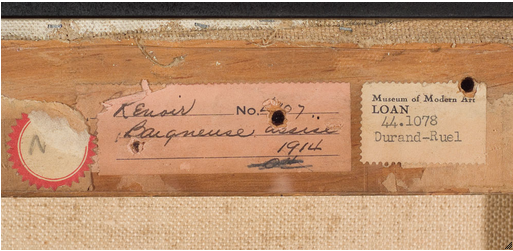
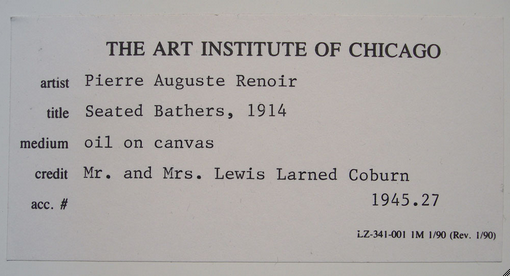
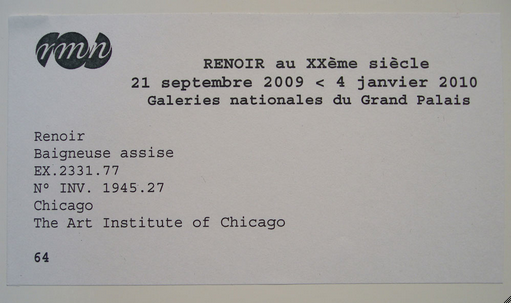
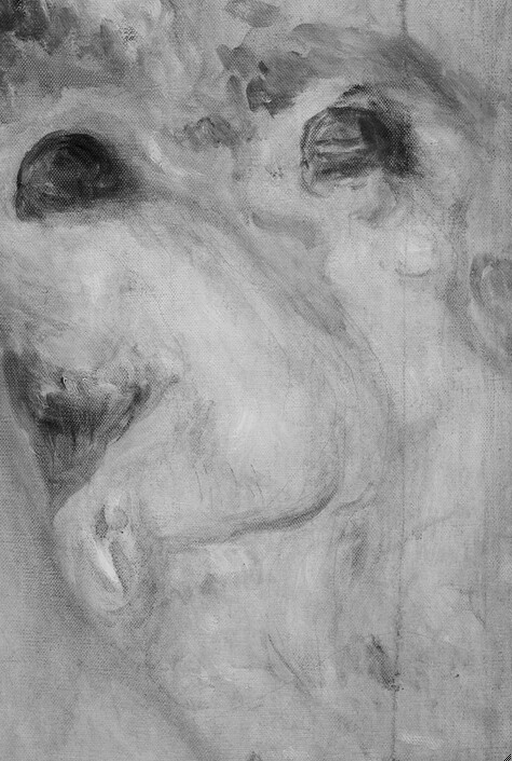
Infrared (Fuji, 1.0–1.1 µm) and natural-light details of the background figures on the right in Renoir’s Seated Bather (1914). The Art Institute of Chicago, 1945.27. Interactive image.
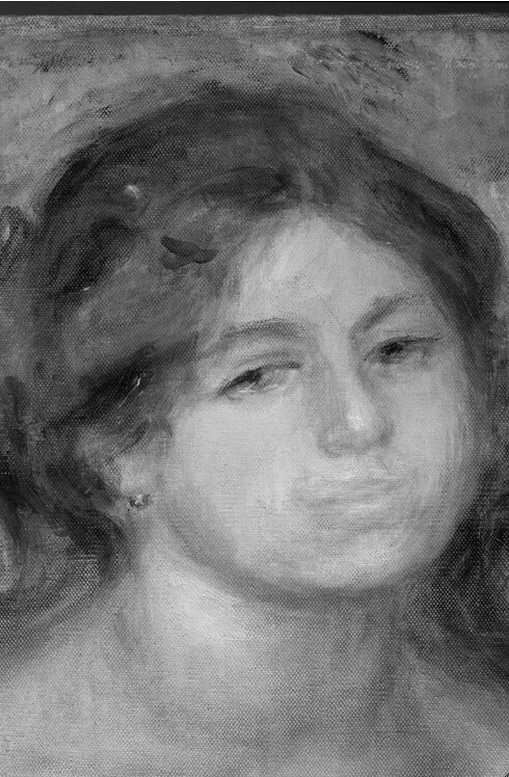
Infrared (Fuji, 1.0–1.1 µm) and natural-light details of the figure’s head in Renoir’s Seated Bather (1914). The Art Institute of Chicago, 1945.27. Interactive image.
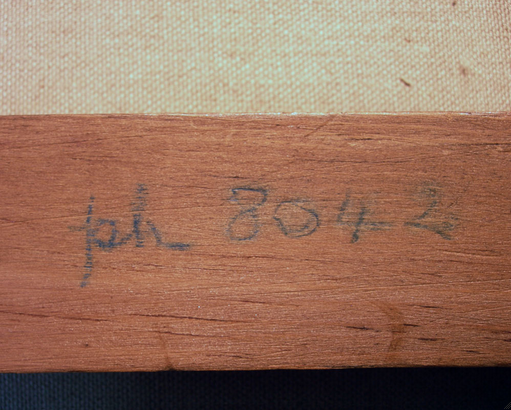
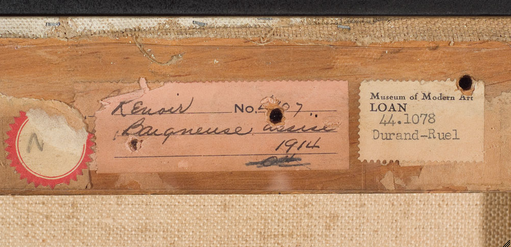
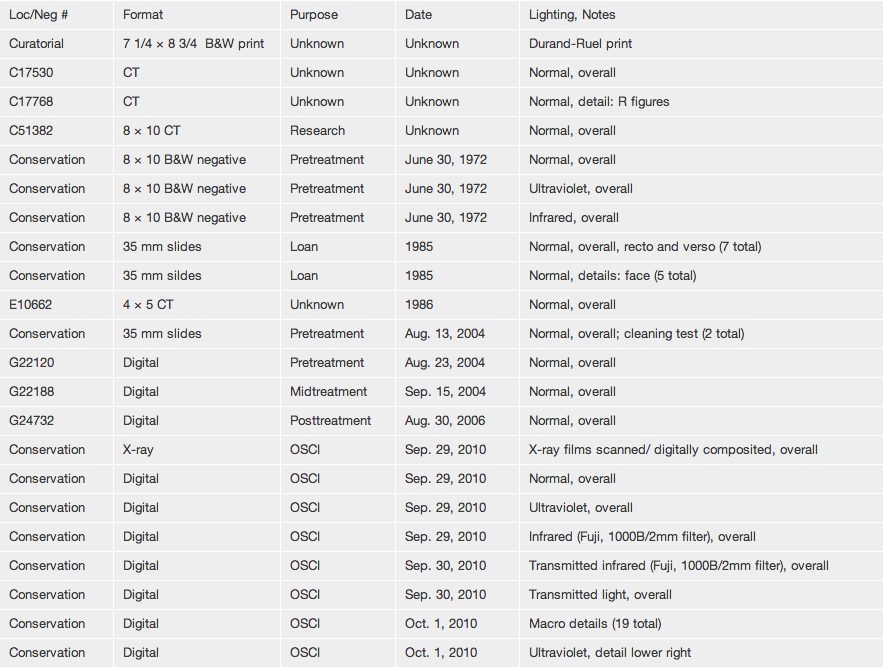
| Loc/Neg # | Format | Purpose | Date | Lighting, Notes |
| Curatorial | 7 1/4 × 8 3/4 B&W print | Unknown | Unknown | Durand-Ruel print |
| C17530 | CT | Unknown | Unknown | Normal, overall |
| C17768 | CT | Unknown | Unknown | Normal, detail: R figures |
| C51382 | 8 × 10 CT | Research | Unknown | Normal, overall |
| Conservation | 8 × 10 B&W negative | Pretreatment | June 30, 1972 | Normal, overall |
| Conservation | 8 × 10 B&W negative | Pretreatment | June 30, 1972 | Ultraviolet, overall |
| Conservation | 8 × 10 B&W negative | Pretreatment | June 30, 1972 | Infrared, overall |
| Conservation | 35 mm slides | Loan | 1985 | Normal, overall, recto and verso (7 total) |
| Conservation | 35 mm sildes | Loan | 1985 | Normal, details: face (5 total) |
| E10662 | 4 × 5 CT | Unknown | 1986 | Normal, overall |
| Conservation | 35 mm slides | Pretreatment | Aug. 13, 2004 | Normal, overall; cleaning test (2 total) |
| G22120 | Digital | Pretreatment | Aug. 23, 2004 | Normal, overall |
| G22188 | Digital | Midtreatment | Sep. 15, 2004 | Normal, overall |
| G24732 | Digital | Posttreatment | Aug. 30, 2006 | Normal, overall |
| Conservation | X-ray | OSCI | Sep. 29, 2010 | X-ray films scanned/ digitally composited, overall |
| Conservation | Digital | OSCI | Sep. 29, 2010 | Normal, overall |
| Conservation | Digital | OSCI | Sep. 29, 2010 | Ultraviolet, overall |
| Conservation | Digital | OSCI | Sep. 29, 2010 | Infrared (Fuji, 1000B/2mm filter), overall |
| Conservation | Digital | OSCI | Sep. 30, 2010 | Transmitted infrared (Fuji, 1000B/2mm filter), overall |
| Conservation | Digital | OSCI | Sep. 30, 2010 | Transmitted light, overall |
| Conservation | Digital | OSCI | Oct. 1, 2010 | Macro details (19 total) |
| Conservation | Digital | OSCI | Oct. 1, 2010 | Ultraviolet, detail lower right |
| Conservation | Digital | OSCI | Oct. 1, 2010 | Details of frame, verso, and labels (11 total) |
| Conservation | Digital | OSCI | Oct. 5, 2010 | Infrared (Fuji, 1000B/2 mm filter), details: head, R figures, face |
| Conservation | Digital | OSCI | Oct. 8–20, 2010 | Photomicrographs of sample sites and surface (17 total) |
| G39769 | Digital | OSCI | Feb. 22, 2012 | Section |
| G39770 | Digital | OSCI | Feb. 22, 2012 | Section |
| G39771 | Digital | OSCI | Feb. 22, 2012 | Section |
| G39772 | Digital | OSCI | Feb. 22, 2012 | Section |
| G39773 | Digital | OSCI | Feb. 22, 2012 | Section |
| G39774 | Digital | OSCI | Feb. 22, 2012 | Section |
| G39775 | Digital | OSCI | Feb. 22, 2012 | Section |
| G39776 | Digital | OSCI | Feb. 22, 2012 | Section |
| G39777 | Digital | OSCI | Feb. 22, 2012 | Section |
| G39778 | Digital | OSCI | Feb. 22, 2012 | Section |
| G39779 | Digital | OSCI | Feb. 22, 2012 | Section |
| G39780 | Digital | OSCI | Feb. 22, 2012 | Section |
| G39781 | Digital | OSCI | Feb. 22, 2012 | Section |
| G39782 | Digital | OSCI | Feb. 22, 2012 | Section |
| G39783 | Digital | OSCI | Feb. 22, 2012 | Section |
| G39784 | Digital | OSCI | Feb. 22, 2012 | Section |
| G39366 | Digital | OSCI | Feb. 23, 2012 | Normal, overall; composite of G39769–G39784 |
| G39368 | Digital | OSCI | Feb. 23, 2012 | Normal, frame only |
| G39367 | Digital | OSCI | May. 15, 2012 | Ultraviolet, overall |
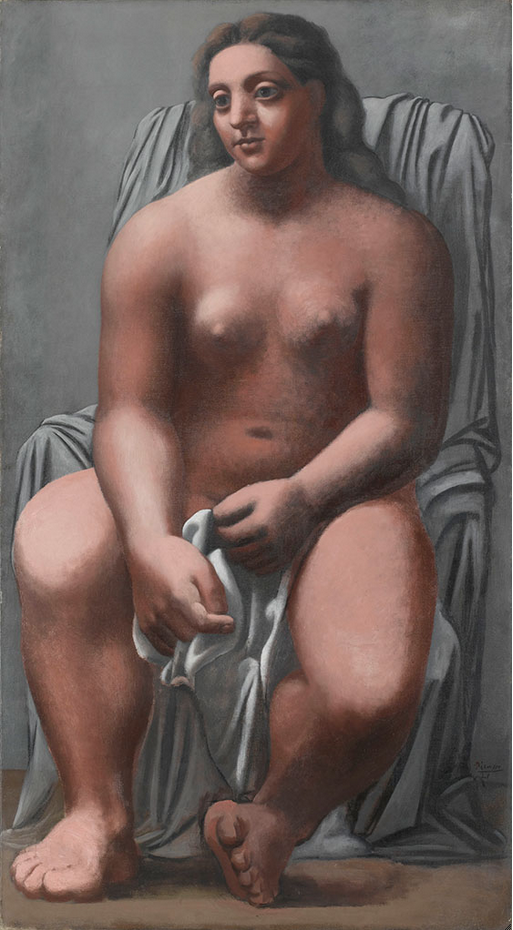
REMOVED PENDING PERMISSION. Pablo Picasso (Spanish, 1881–1973). Large Bather, 1921. Oil on canvas; 182.0 × 101.5 cm (### × ### in.). Musée de l’Orangerie, Paris, © RMN-Grand Palais / Art Resource, NY.
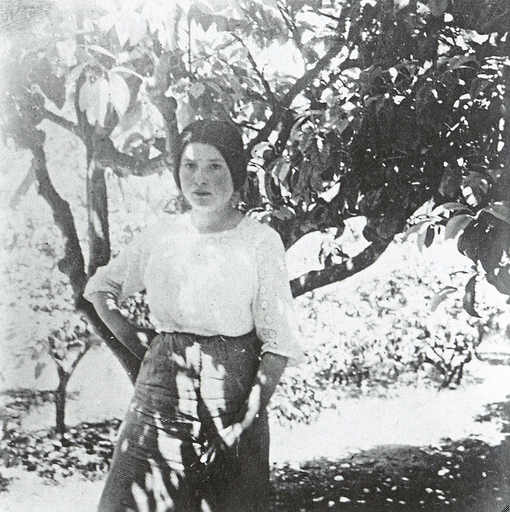
Konrad Ferdinand Edmund von Freyhold (German, 1878–1944). Madeleine Bruno, Renoir’s model, in the garden of Les Collettes at Cagnes, April–May 1914. Gelatin-silver print; 9 × 8.5 cm (3 1/2 × 3 3/8 in.). Collection Roland Stark.
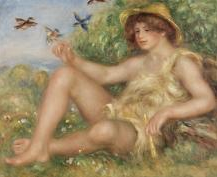
Pierre-Auguste Renoir (French, 1841–1919). Young Shepherd in Repose (Alexander Thurneyssen), 1911. Oil on canvas; 73 × 91.1 cm (28 13/16 × 25 7/8 in.). RISD Museum, Providence, Rhode Island, Museum Works of Art Fund 45.199. Photography by Erik Gould, courtesy of the Museum of Art, Rhode Island School of Design, Providence.
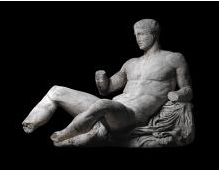
East Pediment of the Parthenon, the Acropolis, Athens, 438–432 B.C. Herakles or Dionysus. Marble; length: 1.30 m. The British Museum, London. Photo Art Resource. © The Trustees of the British Museum/Art Resource, NY.
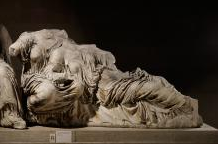
East Pediment of the Parthenon, the Acropolis, Athens, 438–432 B.C. Hestia, Dione or Themis, and Aphrodite. Marble; 1.73 m. The British Museum, London. © The Trustees of the British Museum / Art Resource, NY.
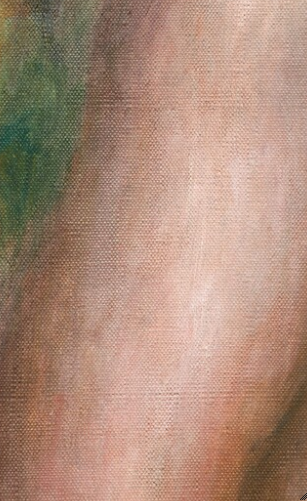
Detail of the figure’s right arm in Renoir’s Seated Bather (1914) showing white highlights in the flesh tones. The Art Institute of Chicago, 1945.27.
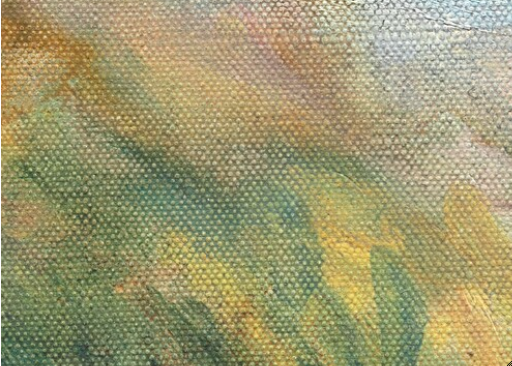
Detail of the background in Renoir’s Seated Bather (1914). The Art Institute of Chicago, 1945.27.
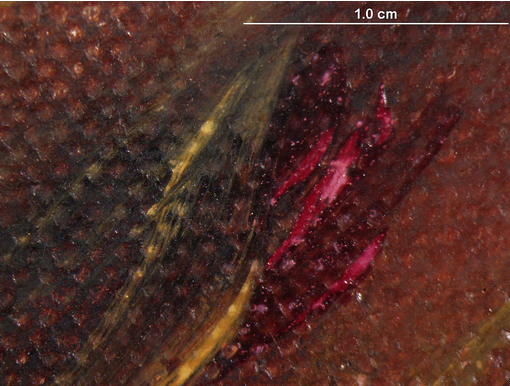
Photomicrograph of the figure’s hair in Renoir’s Seated Bather (1914) showing layered impasto. The Art Institute of Chicago, 1945.27.
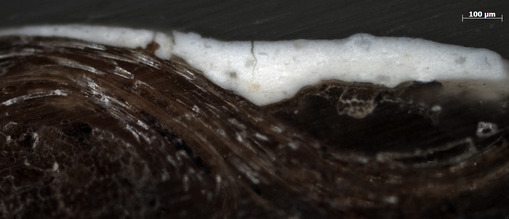
Photomicrograph of a cross section of the ground and canvas in Renoir’s Seated Bather (1914). Original magnification: 1000×. The Art Institute of Chicago, 1945.27.
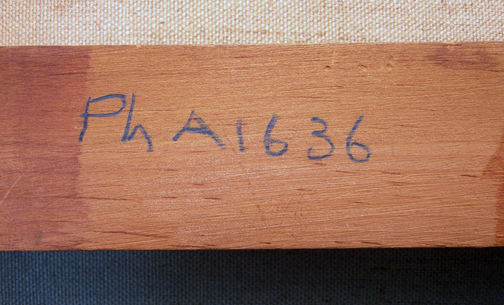
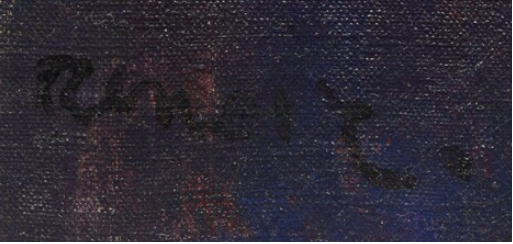
Detail of the signature in Renoir’s Alfred Sisley (1876). The Art Institute of Chicago, 1933.453. See cat. 4.
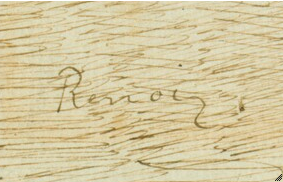
Detail of the signature in Renoir’s Workers' Daughters on the Outer Boulevard (Illustration for Emile Zola's L'Assommoir) (1877/78). The Art Institute of Chicago, 1986.420. See cat. 5.
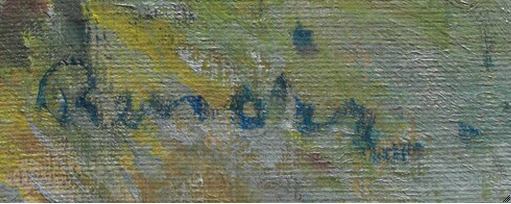
Detail of the signature in Renoir’s The Laundress (1877/79). The Art Institute of Chicago, 1947.102. See cat. 6.

Detail of the signature in Renoir’s Young Woman Sewing (1879). The Art Institute of Chicago, 1933.452. See cat. 7.
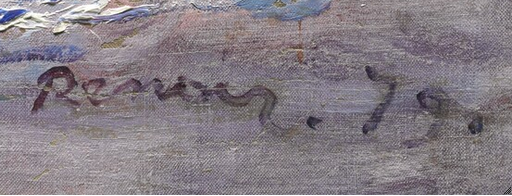
Detail of the signature in Renoir’s Seascape (1879). The Art Institute of Chicago, 1922.438. See cat. 8.
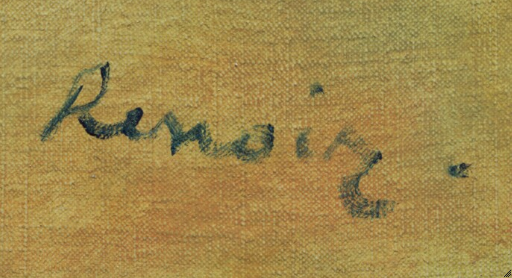
Detail of the signature in Renoir’s Acrobats at the Cirque Fernando (Francisca and Angelina Wartenberg) (1879). The Art Institute of Chicago, 1922.438. See cat. 9.
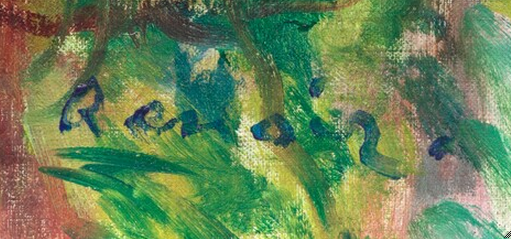
Detail of the signature in Renoir’s Near the Lake (1879/80). The Art Institute of Chicago, 1922.439. See cat. 10.

Detail of the signature in Renoir’s Two Sisters (On the Terrace) (1881). The Art Institute of Chicago, 1933.455. See cat. 11.
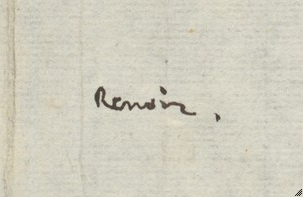
Detail of the signature in Renoir’s On the Terrace of a Hotel in Bordighera: The Painter Jean Martin Reviews his Bill (1881). The Art Institute of Chicago, 1977.491. See cat. 12.
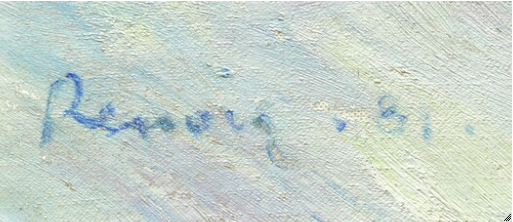
Detail of the signature in Renoir’s Fruits of the Midi (1881). The Art Institute of Chicago, 1933.1176. See cat. 14.
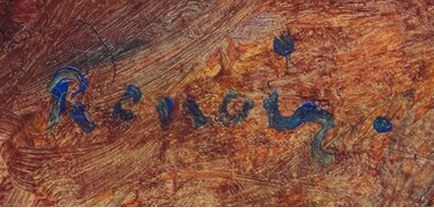
Detail of the signature in Renoir’s Chrysanthemums (1881/2). The Art Institute of Chicago, 1933.1173. See cat. 15.

Detail of the signature in Renoir’s Lucie Berard (Child in White) (1883). The Art Institute of Chicago, 1933.1172. See cat. 16.
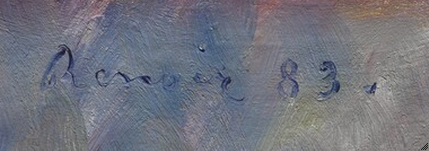
Detail of the signature in Renoir’s Madame Léon Clapisson (1883). The Art Institute of Chicago, 1933.1174. See cat. 17.
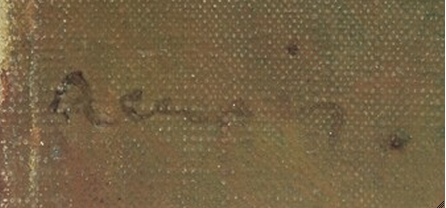
Detail of the signature in Renoir’s Jean Renoir Sewing (1899/1900). The Art Institute of Chicago, 1937.1027. See cat. 24.
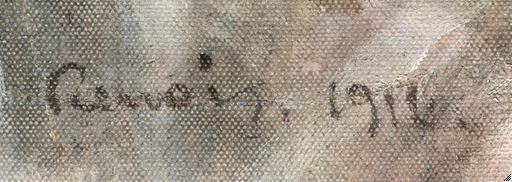
Detail of the signature in Renoir’s Seated Bather (1914). The Art Institute of Chicago, 1945.27. See cat. 25.

Detail of the signature in Renoir’s Woman at the Piano (1875/76). The Art Institute of Chicago, 1922.437. See cat. 3.
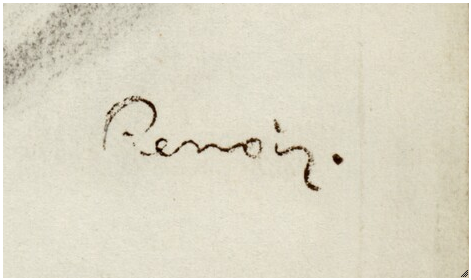
Detail of the signature in Renoir's Woman Seated in a Chair (recto) (c. 1883). The Art Institute of Chicago, 1943.520R. See cat. 18.
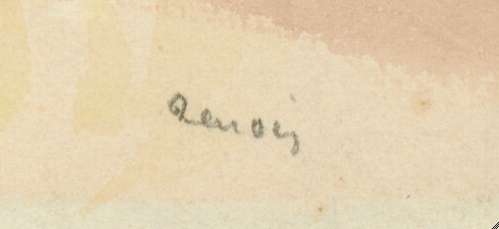
Detail of the signature in Renoir's Grove of Trees (1888/90). The Art Institute of Chicago, 1982.1827. See cat. 22.

Detail of the signature in Renoir's Study for "Bathers in a Forest" (1895/97). The Art Institute of Chicago, 2013.1010. See cat. 23.
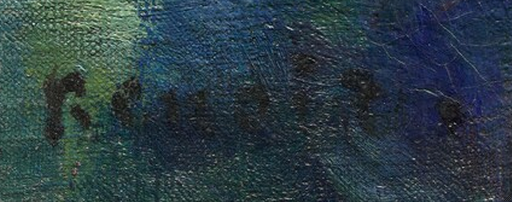
Detail of the signature in Renoir’s Lunch at the Restaurant Fournaise (the Rowers' Lunch) (1875). The Art Institute of Chicago, 1922.437. See cat. 2.

X-ray and natural-light details of Renoir’s Lunch at the Restaurant Fournaise (The Rowers’ Lunch) (1875) showing changes to the figure on the right. The Art Institute of Chicago, 1922.437. Interactive image.

Detail of Renoir’s Vase of Flowers (1857) showing the fine graphite lines. The Art Institute of Chicago, 2013.1011.

Detail of Renoir’s Vase of Flowers (1857) showing sketchbook binding holes. The Art Institute of Chicago, 2013.1011.

Pretreatment image from 1971 of the verso of Renoir’s Lunch at the Restaurant Fournaise (The Rowers’ Lunch) (1875) showing the original stretcher. The Art Institute of Chicago, 1922.437.

Detail of Renoir’s Vase of Flowers (1857) showing the inscribed date. The Art Institute of Chicago, 2013.1011.

| Loc/Neg# | Format | Purpose | Date | Lighting, Notes |
| 40380 | Digital | Unknown | Recto | |
| G22529 | Digital | Nov. 29, 2004 | Recto | |
| G40580 | Digital | 5-Jul-12 | Recto | |
| Conservation | Digital | OSCI | Dec. 10, 2012 | Recto, detail |

Photomicrograph of the right edge of Renoir’s Lunch at the Restaurant Fournaise (The Rowers’ Lunch) (1875) showing the edge of the artist-applied ground. The Art Institute of Chicago, 1922.437.

Photomicrograph of the background in Renoir’s Lunch at the Restaurant Fournaise (The Rowers’ Lunch) (1875). The tint of the ground is especially apparent when it is seen next to white paint. The Art Institute of Chicago, 1922.437.

Detail of the background in Renoir’s Lunch at the Restaurant Fournaise (The Rowers’ Lunch) (1875) showing an area of exposed ground and the artist’s exaggeration of the canvas texture. The Art Institute of Chicago, 1922.437.

Infrared reflectogram (Fuji, 1.0–1.1 µm) of Renoir’s Lunch at the Restaurant Fournaise (The Rowers’ Lunch) (1875). The Art Institute of Chicago, 1922.437.

Infrared-reflectogram (Fuji, 1.0–1.1 µm) detail of Renoir’s Lunch at the Restaurant Fournaise (The Rowers’ Lunch) (1875) showing the media used for the underdrawing. The Art Institute of Chicago, 1922.437.

X-ray detail of Renoir’s Lunch at the Restaurant Fournaise (The Rowers’ Lunch) (1875) showing the background paint coming up to and around the currently visible female figure’s head. The Art Institute of Chicago, 1922.437. X-ray digitally composited by Robert G. Erdmann, University of Arizona.

Detail of the bottom left quadrant of Renoir’s Lunch at the Restaurant Fournaise (The Rowers’ Lunch) (1875). Heavy brushstrokes from the earlier figure are visible under normal viewing conditions. The Art Institute of Chicago, 1922.437.

X-ray, raking-light, and natural-light details of the figures on the left in Renoir’s Lunch at the Restaurant Fournaise (The Rowers’ Lunch) (1875). The Art Institute of Chicago, 1922.437. Interactive image.

Detail of the hand and arm of the figure on the right in Renoir’s Lunch at the Restaurant Fournaise (The Rowers’ Lunch) (1875). The Art Institute of Chicago, 1922.437.

Detail of the background in Renoir’s Lunch at the Restaurant Fournaise (The Rowers’ Lunch) (1875) showing thick strokes of the water under the trellis and foliage. The Art Institute of Chicago, 1922.437.

Detail of the chair on the left in Renoir’s Lunch at the Restaurant Fournaise (The Rowers’ Lunch) (1875) showing wet-in-wet paint mixing. The Art Institute of Chicago, 1922.437.

Photomicrograph of a cross section from Renoir’s Lunch at the Restaurant Fournaise (The Rowers’ Lunch) (1875) showing the lighter blue from the earlier figure’s costume below the currently visible dark blue. Original magnification 200×. The Art Institute of Chicago, 1922.437.

Detail of the far left figure in Renoir’s Lunch at the Restaurant Fournaise (The Rowers’ Lunch) (1875) showing heavy underlying brushwork where the artist painted out previous compositional choices. The Art Institute of Chicago, 1922.437.
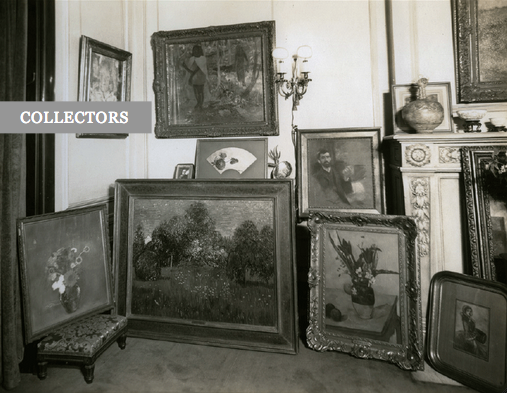
Born in 1856 in Fremont, Illinois, Annie Swan Coburn moved to Chicago with her family by 1871 and lived in the city until her death in May 1932 (fig. 1.2).1360 In 1880 she married Lewis Larned Coburn, a prominent patent attorney and one of the founders (and first president) of the Union League Club of Chicago. Upon his death in 1910, Mrs. Coburn began to collect art, initially purchasing American works and gradually expanding her collection to include French Impressionist paintings. Around the same time, she moved into an apartment in the Blackstone Hotel. Although wall space was limited in her new home, she continued to collect works of art, which she displayed in her own unique and intimate way (fig. 1.1, fig. 2.20, fig. 1.3, fig. 1.4, and fig. 2.23).1361
From April 6 to October 9, 1932, the Art Institute of Chicago (under the auspices of its Antiquarian Society) held a special exhibition of more than sixty paintings, watercolors, drawings, and pastels from Mrs. Coburn’s collection.1362 Just two months after the opening of the exhibition—which included Édouard Manet’s Woman Reading (fig. 2.22), one of her last major acquisitions—Mrs. Coburn died, leaving the Art Institute more than one hundred works of art. The Fogg Museum at Harvard University and Smith College also received portions of her collection.
The Beach at Sainte-Adresse (cat. 13)
Cliff Walk at Pourville (cat. 19)
Stacks of Wheat (End of Day, Autumn) (cat. 28)
Water Lily Pond (cat. 37)
Vétheuil (cat. 42)
Venice, Palazzo Dario (cat. 45)
Champ de coquelicots (Poppy Field)1363
Citrons sur une branche (Lemons on a Branch)1364
Église de Varengeville, temps gris (The Church at Varengeville, Gray Weather)1365
Portrait de Léon Peltier1366
Alfred Sisley (cat. 4)
Young Woman Sewing (cat. 7)
Two Sisters (On the Terrace) (cat. 11)
La cueillette des fleurs (Picking Flowers)1367
L’algérienne (The Algerian Girl)1368
Pivoines (Peonies)1369
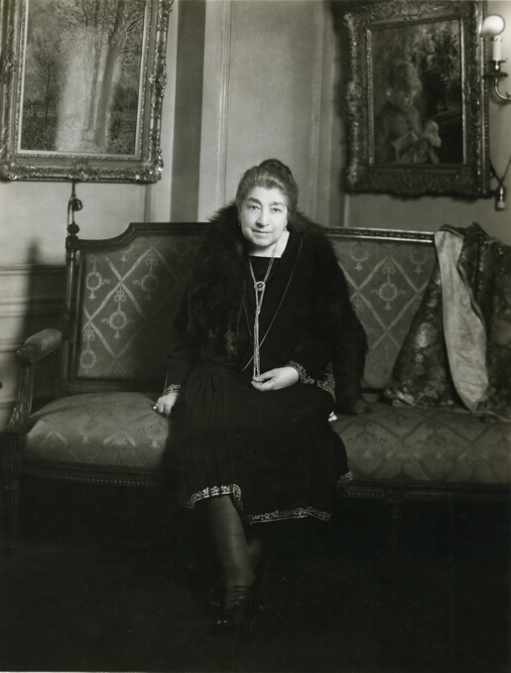
Mrs. Lewis Larned (Annie Swan) Coburn
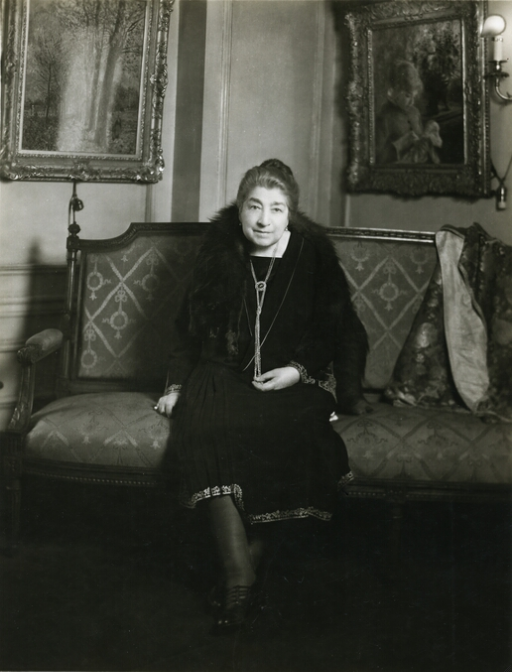
Mrs. Lewis Larned (Annie Swan) Coburn (1856–1932) seated in her Blackstone Hotel apartment in Chicago. Displayed works include (1) Pierre-Auguste Renoir (French, 1841–1919). Young Woman Sewing, 1879. Oil on canvas; 61.4 × 50.5 cm. The Art Institute of Chicago, Mr. and Mrs. Lewis Larned Coburn Memorial Collection, 1933.452. See cat. 7. Institutional Archives, Art Institute of Chicago.
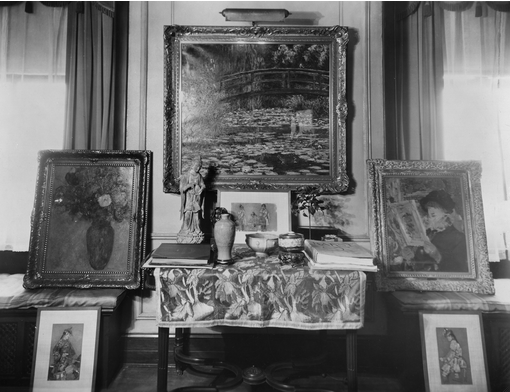
Interior of Mrs. Lewis Larned (Annie Swan) Coburn’s Blackstone Hotel apartment in Chicago. Displayed works include (1) Claude Monet (French, 1840–1926). Water Lily Pond, 1900. Oil on canvas; 89.8 × 101 cm. The Art Institute of Chicago, Mr. and Mrs. Lewis Larned Coburn Memorial Collection, 1933.441. See cat. 37 in Monet Paintings and Drawings at the Art Institute of Chicago. Institutional Archives, Art Institute of Chicago.
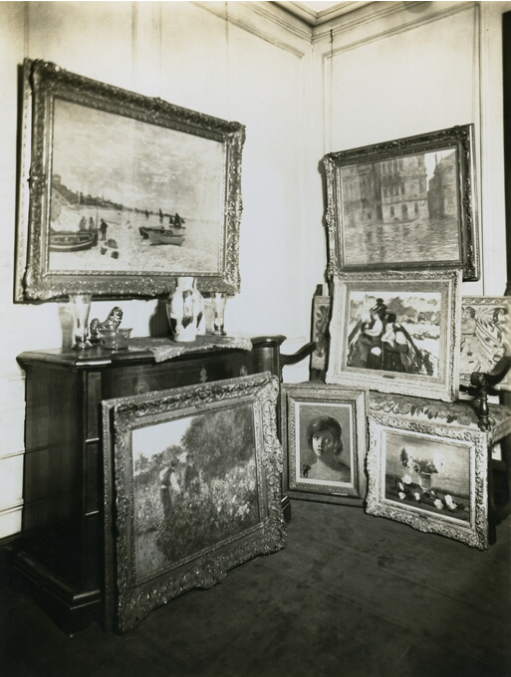
Interior of Mrs. Lewis Larned (Annie Swan) Coburn’s Blackstone Hotel apartment in Chicago. Displayed works include (1) Claude Monet (French, 1840–1926). The Beach at Sainte-Adresse, 1867. Oil on canvas; 75.8 × 102.5 cm. The Art Institute of Chicago, Mr. and Mrs. Lewis Larned Coburn Memorial Collection, 1933.439. See cat. 13 in Monet Paintings and Drawings at the Art Institute of Chicago. (2) Claude Monet (French, 1840–1926). Venice, Palazzo Dario, 1908. Oil on canvas; 66.2 × 81.8 cm. The Art Institute of Chicago, Mr. and Mrs. Lewis Larned Coburn Memorial Collection, 1933.446. See cat. 45 in Monet Paintings and Drawings at the Art Institute of Chicago. (3) Pierre-Auguste Renoir (French, 1841–1919). La Cueillette des fleurs (Picking Flowers). Formerly 1933.454 in the Art Institute of Chicago’s collection; deaccessioned in 1947. Institutional Archives, Art Institute of Chicago.
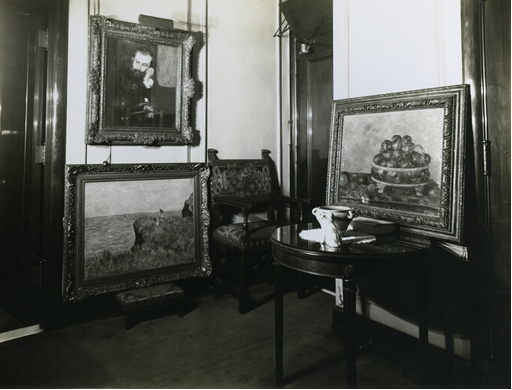
Interior of Mrs. Lewis Larned (Annie Swan) Coburn’s Blackstone Hotel apartment in Chicago. Displayed works include (1) Pierre-Auguste Renoir (French, 1841–1919). Alfred Sisley, 1876. Oil on canvas; 66.2 × 54.8 cm. The Art Institute of Chicago, Mr. and Mrs. Lewis Larned Coburn Memorial Collection, 1933.453. See cat. 4. (2) Claude Monet (French, 1840–1926). Cliff Walk at Pourville, 1882. Oil on canvas, 66.5 × 82.3 cm. The Art Institute of Chicago, Mr. and Mrs. Lewis Larned Coburn Memorial Collection, 1933.443. See cat. 19 in Monet Paintings and Drawings at the Art Institute of Chicago. Institutional Archives, Art Institute of Chicago.
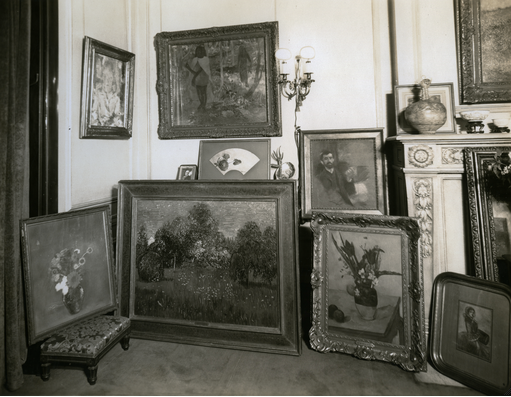
Interior of Mrs. Lewis Larned (Annie Swan) Coburn’s Blackstone Hotel apartment in Chicago. Institutional Archives, Art Institute of Chicago.
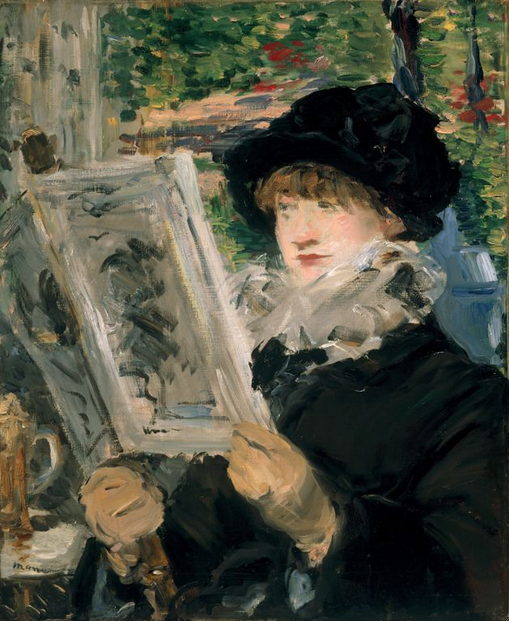
Édouard Manet (French, 1832–1883). Woman Reading, 1879/80. Oil on canvas; 61.2 × 50.7 cm. The Art Institute of Chicago, Mr. and Mrs. Lewis Larned Coburn Memorial Collection, 1933.435.
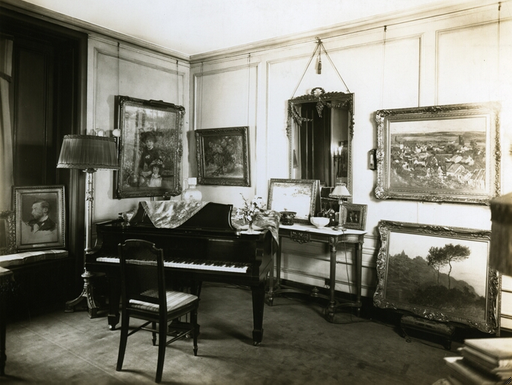
Interior of Mrs. Lewis Larned (Annie Swan) Coburn’s Blackstone Hotel apartment in Chicago. Displayed works include (1) Pierre-Auguste Renoir (French, 1841–1919). Two Sisters (On the Terrace), 1881. Oil on canvas; 100.4 × 80.9 cm. The Art Institute of Chicago, Mr. and Mrs. Lewis Larned Coburn Memorial Collection, 1933.455. See cat. 11. (2) Pierre-Auguste Renoir (French, 1841–1919). Pivoines (Peonies). Formerly 1933.456 in the Art Institute’s collection; deaccessioned in 1942. (3) Claude Monet (French, 1840–1926). Église de Varengeville, temps gris (The Church at Varengeville, Gray Weather). Formerly 1933.442 in the Art Institute’s collection; deaccessioned in 1944. Institutional Archives, Art Institute of Chicago.
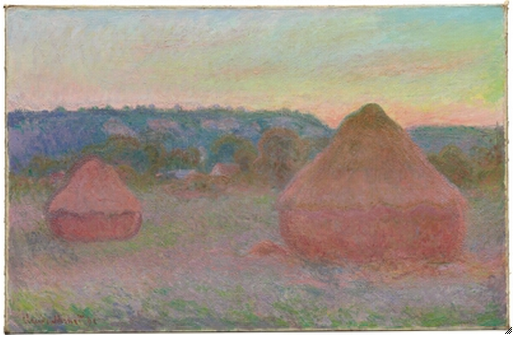
Claude Monet (French, 1840–1926). Stacks of Wheat (End of Day, Autumn), 1890/91. Oil on canvas; 65.8 × 101 cm. The Art Institute of Chicago, Mr. and Mrs. Lewis Larned Coburn Memorial Collection, 1933.444. See cat. 28.
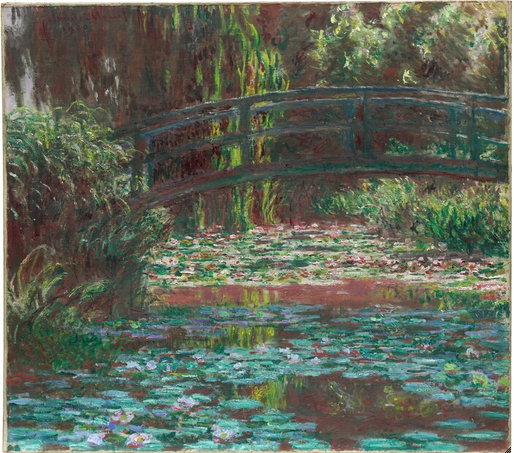
Claude Monet (French, 1840–1926). Water Lily Pond, 1900. Oil on canvas; 89.8 × 101 cm. The Art Institute of Chicago, Mr. and Mrs. Lewis Larned Coburn Memorial Collection, 1933.441. See cat. 37.
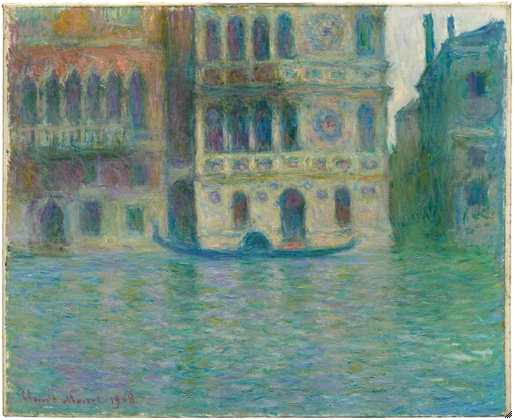
Claude Monet (French, 1840–1926). Venice, Palazzo Dario, 1908. Oil on canvas; 64.8 × 78.8 cm. The Art Institute of Chicago, Mr. and Mrs. Lewis Larned Coburn Memorial Collection, 1933.446. See cat. 45.
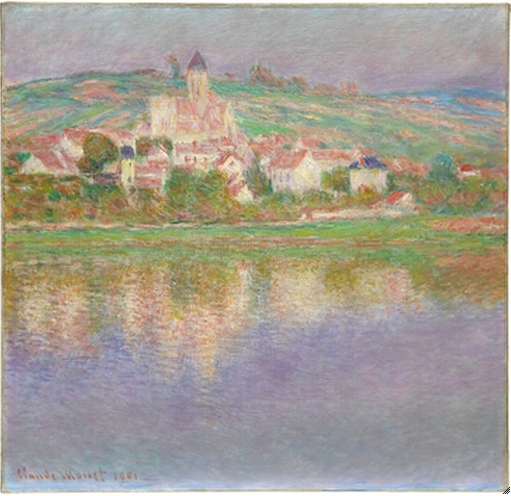
Claude Monet (French, 1840–1926). Vétheuil, 1901. Oil on canvas; 90.2 × 93.4 cm. The Art Institute of Chicago, Mr. and Mrs. Lewis Larned Coburn Memorial Collection, 1933.447. See cat. 42.
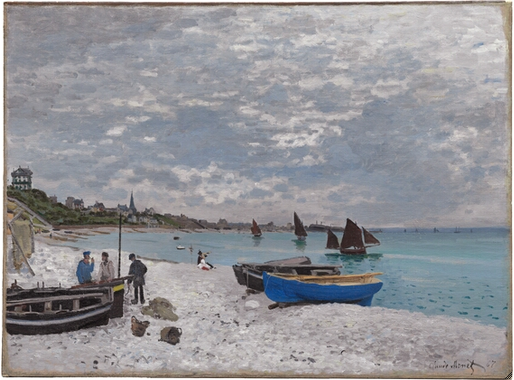
Claude Monet (French, 1840–1926). The Beach at Sainte-Adresse, 1867. Oil on canvas; 75.8 × 102.5 cm. The Art Institute of Chicago, Mr. and Mrs. Lewis Larned Coburn Memorial Collection, 1933.439. See cat. 13.
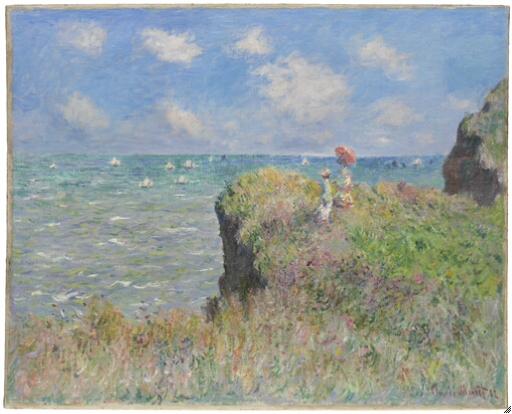
Claude Monet (French, 1840–1926). Cliff Walk at Pourville, 1882. Oil on canvas; 66.5 × 82.3 cm. The Art Institute of Chicago, Mr. and Mrs. Lewis Larned Coburn Memorial Collection, 1933.443. See cat. 19.
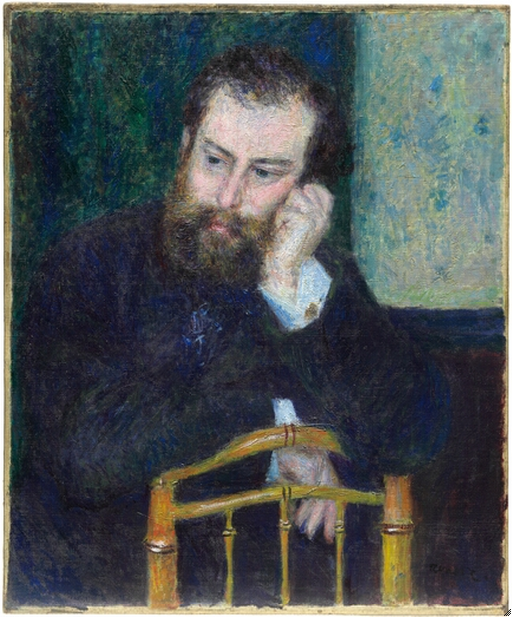
Pierre-Auguste Renoir (French, 1841–1919). Alfred Sisley, 1876. Oil on canvas, mounted on composition board; 66.4 × 54.8 cm. The Art Institute of Chicago, Mr. and Mrs. Lewis Larned Coburn Memorial Collection, 1933.453. See cat. 4.
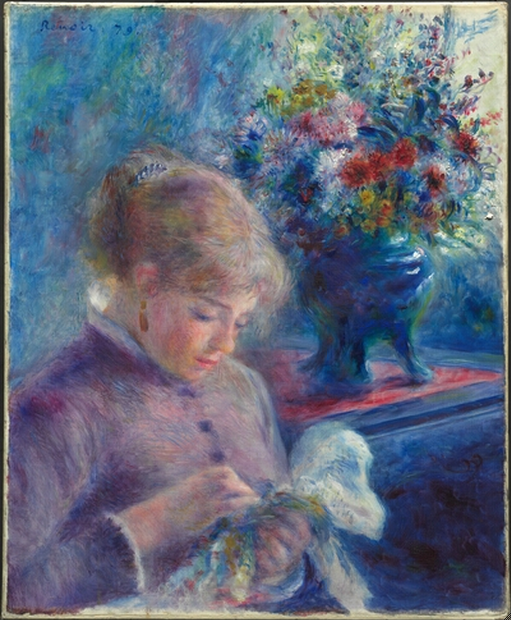
Pierre-Auguste Renoir (French, 1841–1919). Young Woman Sewing, 1879. Oil on canvas; 61.5 × 50.3 cm. The Art Institute of Chicago, Mr. and Mrs. Lewis Larned Coburn Memorial Collection, 1933.452. See cat. 7.
Pierre-Auguste Renoir (French, 1841–1919). Two Sisters (On the Terrace), 1881. Oil on canvas; 100.5 × 81 cm. The Art Institute of Chicago, Mr. and Mrs. Lewis Larned Coburn Memorial Collection, 1933.455.
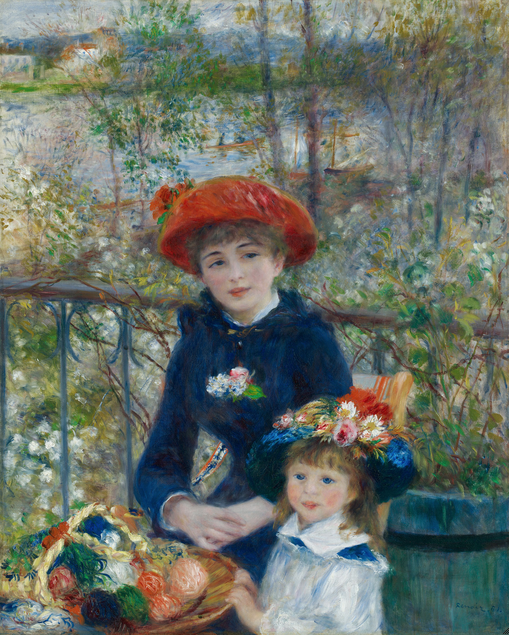
Pierre-Auguste Renoir (French, 1841–1919). Two Sisters (On the Terrace), 1881. Oil on canvas; 100.5 × 81 cm. The Art Institute of Chicago, Mr. and Mrs. Lewis Larned Coburn Memorial Collection, 1933.455. See cat. 11.
In 1922, the Art Institute of Chicago acquired much of the collection of Bertha Palmer (1849–1918; fig. 1.2) and her husband, Potter Palmer (1826–1902; fig. 1.1). The core of their collection was their Impressionist paintings, which included works by artists such as Claude Monet, Pierre-Auguste Renoir, Camille Pissarro, and Edgar Degas. Many of these paintings are now among the highlights of the museum’s permanent collection; when the Palmers began collecting Impressionist art in the 1890s, however, it was considered radical, even controversial. It is due to Mrs. Palmer’s forward thinking, influence, and willingness to pursue her own taste rather than follow trends that Chicago is home to one of the greatest collections of Impressionism in the world.
Bertha Mathilde Honoré moved to Chicago at the age of six, when her family left their native Kentucky. On July 29, 1870, she married Potter Palmer, the merchant magnate who had created the dry goods store Potter Palmer & Company and would soon become the largest landowner in Chicago.1370 They honeymooned in Europe but did not visit Paris due to the ongoing Franco-Prussian War. As a gift to his bride, Mr. Palmer built the opulent Palmer House Hotel (completed in 1871), which included a suite where the couple would live (fig. 2.20).1371 The Palmers moved in and began raising a family: their sons, Honoré and Potter, Jr., were born on February 1, 1874, and October 8, 1875, respectively.
Eventually the bustle of living downtown became too much for the Palmers, and in the early 1880s they began looking for somewhere to move. At the time, the most fashionable neighborhood in the city was on the South Side, on Prairie Avenue, but the Palmers instead decided to move to an undeveloped area on the North Side. Before the end of the decade, the wealthiest Chicagoans followed the Palmers to the neighborhood that became known as the Gold Coast. In 1885 the Palmers’ house on Lake Shore Drive was completed after two years of construction and a reported cost of $1 million.1372 Due to both its composite Romanesque–English Gothic architectural style and its opulence, the house earned the nickname “The Castle” throughout Chicago (fig. 1.3 and fig. 1.4). One contemporary described the decadent interior in detail: “In the end, the Palmers had the largest, finest, costliest home in Chicago. It had a great tapestried hall, an eighty-foot tower reached by a spiral staircase, marble mosaic floors, a Louis XVI drawing room and a grand staircase of carved oak with newel posts bearing the Honoré coat of arms. Bertha Palmer’s Moorish bathroom was ebony and gold; her dressing room contained a sunken tub shaped like a swan. She slept in a Louis XVI bed and washed her face in a mother-of-pearl basin.”1373
By the time she moved to the Gold Coast, Mrs. Palmer had become the reigning queen of Chicago high society. Her charity balls and New Year’s Day parties were considered the events of the season. She was actively involved in many clubs and associations throughout the city, including the Chicago Woman’s Club and the Saddle and Cycle Club, and she was a founding member of the Chicago Society of Decorative Arts, which in 1889 changed its name to the Antiquarian Society of the Art Institute. When Chicago won the right to host the 1893 World’s Columbian Exposition, Mrs. Palmer was named the president of the Board of Lady Managers and oversaw the creation of an entire building devoted to women (fig. 2.22). She also hosted several events and parties at her home as fund raisers before, and celebrations during, the fair. Not without reason did she consider herself “the nation’s hostess and the nation’s head woman servant.”1374
Most of Mrs. Palmer’s collection of Impressionist paintings was purchased in 1891 and 1892, while she was traveling Europe to help organize the World’s Columbian Exposition. But the Palmers’ interest in the arts and collecting dates to much earlier. In 1873, Mr. Palmer met Sarah Tyson Hallowell, secretary of the art department of the Inter-State Industrial Exposition, and she would come to serve as the couple’s art advisor.1375 In 1889 Hallowell introduced the Palmers to Paul Durand-Ruel—the Impressionist art dealer and agent for Édouard Manet, Monet, and Renoir—and later to the artist Mary Cassatt.1376 That same year, Mrs. Palmer purchased her first Impressionist work, On the Stage by Edgar Degas, for $500 (fig. 2.23).1377 Although Mr. Palmer has often been understood as only the financial support behind his wife’s art collection, he did have an appreciation for art. Mr. Palmer was one of a small group of men who worked both before and after the Great Chicago Fire to foster interest in an art school and exhibitions of paintings. He actively participated in the reorganization of the Chicago Academy of Design (which would eventually become the Art Institute of Chicago), and he was appointed to its board in 1877.1378 Nevertheless, it was Mrs. Palmer who decided what works would be purchased, and he happily deferred to his wife’s taste. Mrs. Palmer actively sought Hallowell’s advice about talent and purchases, but she ultimately based her choices on her own opinions. Mrs. Palmer’s sister Ida Honoré Grant believed that her art collection was a true expression of her nature.1379 She read everything available on Impressionism and became knowledgeable enough to give talks at the Art Institute.1380
Mrs. Palmer was an incredibly active collector, owning as many as ninety works by Monet alone during her lifetime (see fig. 2.24). She was, however, almost as much of a dealer as a collector, often selling her paintings, sometimes very soon after purchasing them. She was motivated by a desire both to maintain balance and consistency in her holdings and to make a profit in order to further upgrade her collection.1381 As her husband did with real estate, Mrs. Palmer used her vanguard instincts to establish new tastes among the Chicago elite, and she sold her own property to meet the demand.
In order to accommodate her ever-growing collection, Mrs. Palmer added a ninety-foot-long combination ballroom and picture gallery to the Castle in 1893, in time for the parade of visitors she received during the World’s Columbian Exposition. Displayed against a rose-red velvet background, her paintings hung in three tiers, each representing a different school: one for Romanticism, one for the Barbizon, and one for Impressionism (fig. 2.25, fig. 2.26, and fig. 2.27).1382 Perhaps included in her Impressionist tier were Mrs. Palmer’s six works from Monet’s Stacks of Wheat series, which she purchased following the artist’s 1891 exhibition at Galerie Durand-Ruel in Paris, Exposition d’oeuvres récentes de Claude Monet.1383 Mrs. Palmer was quick to recognize the poetic power of Monet’s variations on a theme, and she is credited with introducing the concept of such series to America. Unfortunately, little documentation survives to indicate how the group of paintings was displayed in her home.1384
Mrs. Palmer’s art collection was large enough to decorate the rest of the house as well. In her bedroom, she displayed her favorite painting, Renoir’s Acrobats at the Cirque Fernando, which she loved so much that she always took it with her when she traveled in Europe (fig. 2.28 [cat. 9]).1385 During her years as a collector, Mrs. Palmer made a strong impression not just on other collectors but also on the artists themselves. She is the only American woman to have been immortalized by Auguste Rodin.1386 Furthermore, in 1891, the artist James McNeill Whistler returned from his only visit to Rome and remembered the city as “a bit of an old ruin alongside a railway station where I saw Mrs. Potter Palmer.”1387
Mr. Palmer died at home on May 4, 1902. In his honor, Mrs. Palmer established a medal and a cash award for American art at the Art Institute of Chicago’s annual exhibition.1388 After her husband’s death, she ceased purchasing paintings but continued to collect sculpture, furniture, and other kinds of art. The rest of her life she divided her time between her homes in London, Paris, Chicago, and Sarasota, Florida.
Mrs. Palmer died in Florida on May 5, 1918. In her will, she made two bequests to the Art Institute valued at $100,000 and $400,000; these funds were to be used to purchase artworks from her collection. The works were chosen and evaluated by the museum’s trustees, including her sons, Honoré Palmer and Potter Palmer, Jr. (fig. 2.29).1389 Her sons supplemented the bequest with a donation of thirty-two additional paintings and pastels. In 1922 the Palmer collection was installed in galleries 25 and 26 (present-day galleries 206 and 207, respectively, in the museum’s Allerton Building).1390 These paintings have constituted the core of the Art Institute’s Impressionist holdings ever since. Many other Impressionist paintings in the collection might never have come to the museum if Mrs. Palmer had not first blazed the trail for collecting art that was considered radical. Her impact on Chicago is such that years later, when a visitor remarked on the cost of buying all the Renoirs in the gallery, the president of the Art Institute could reply, “In Chicago we don’t buy Renoirs. We inherit them from our grandmothers.”1391
On the Bank of the Seine, Bennecourt (cat. 14)
Bordighera (cat. 20)
The Departure of the Boats, Étretat (cat. 23)
The Petite Creuse River (cat. 25)
Stacks of Wheat (Sunset, Snow Effect) (cat. 29)
Matin à Éretat (Morning at Étretat)1392
Sous les peupliers (Under the Poplars)1393
Lunch at the Restaurant Fournaise (The Rowers’ Lunch) (cat. 2)
Seascape (cat. 8)
Acrobats at the Cirque Fernando (Francisca and Angelina Wartenberg) (cat. 9)
Near the Lake (cat. 10)
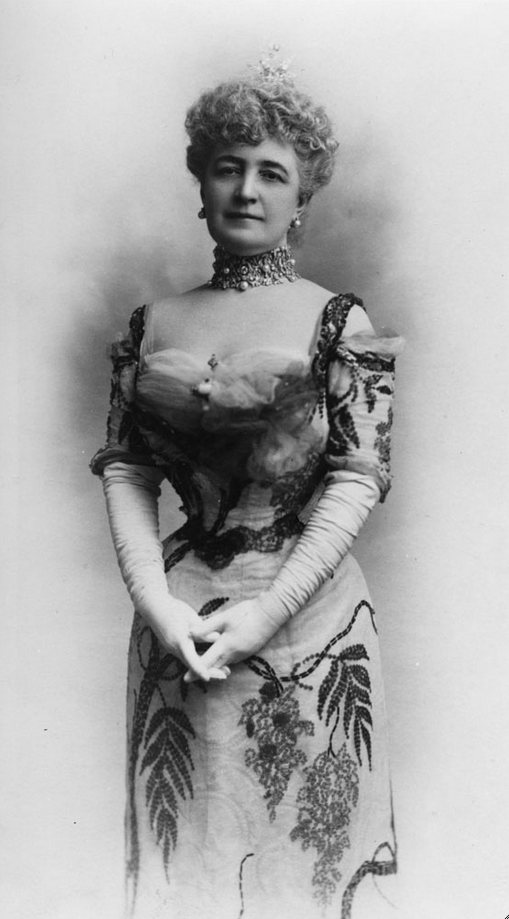
Mrs. Potter (Bertha Honoré) Palmer (1849–1918).
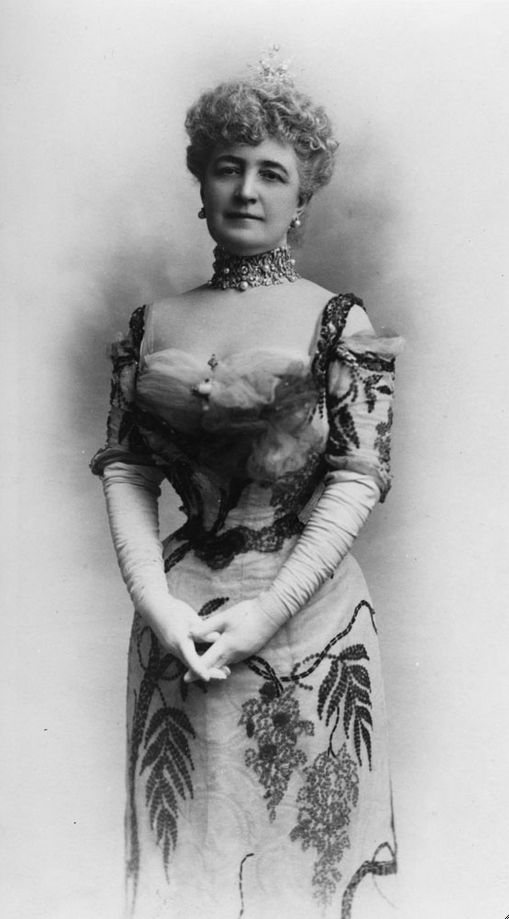
Mrs. Potter (Bertha Honoré) Palmer. Institutional Archives, Art Institute of Chicago.
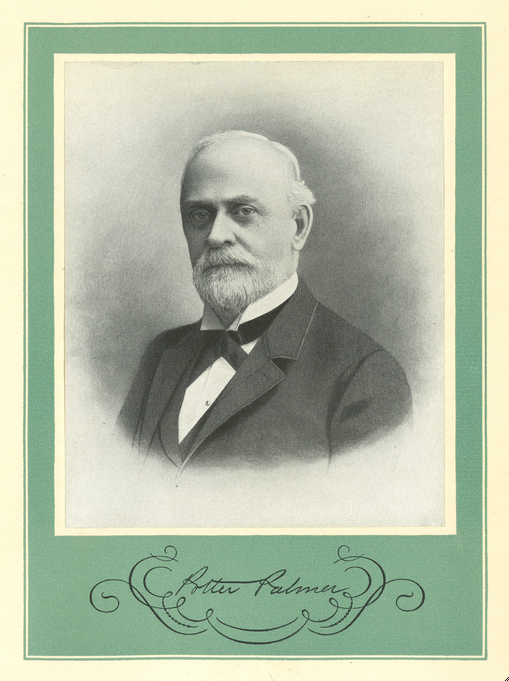
Mr. Potter Palmer (1826–1902). Chicago Tribune historical photo.
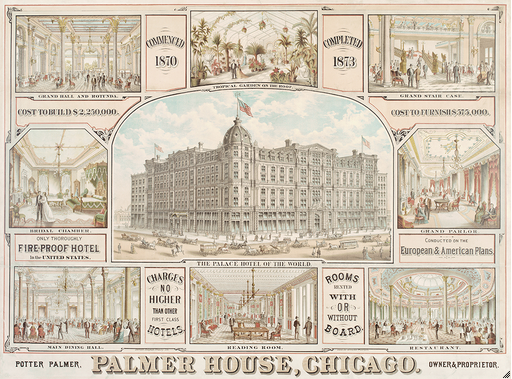
The Palmer House, Chicago, 1873. Lithograph by the American Oliograph Company. Chicago History Museum, ichi-39476.
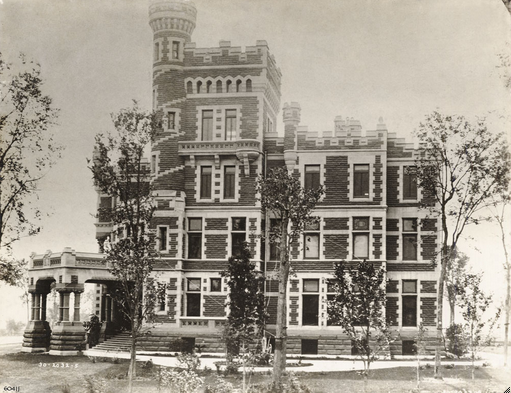
The Palmers’ home, “The Castle,” at 1350 North Lake Shore Drive, 1890/1910. Institutional Archives, Art Institute of Chicago.
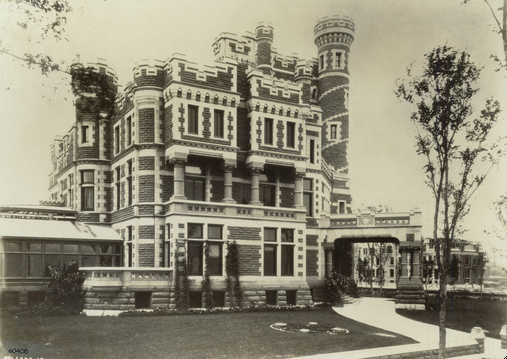
The Palmers’ home, “The Castle,” at 1350 North Lake Shore Drive, 1890/91. Institutional Archives, Art Institute of Chicago.
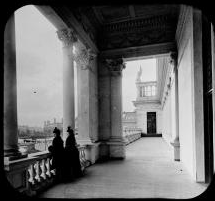
Exterior of the Woman’s Building at the World’s Columbian Exposition, 1893. As president of the fair’s Board of Lady Managers, Mrs. Potter (Bertha Honoré) Palmer oversaw the creation of this building. Institutional Archives, Art Institute of Chicago.
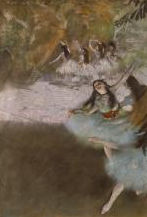
Edgar Degas (French, 1834–1917). On the Stage, 1876–77. Pastel and essence over monotype on cream laid paper, laid down on board; 59.2 × 42.8 cm. The Art Institute of Chicago, Potter Palmer Collection, 1922.423.
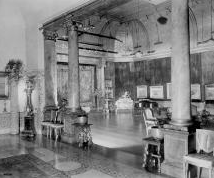
Interior of Mrs. Potter (Bertha Honoré) Palmer’s home at 1350 North Lake Shore Drive. Displayed works include (1) Claude Monet (French, 1840–1926). Stack of Wheat, 1890/91. Oil on canvas; 65.8 × 92.3 cm. The Art Institute of Chicago, restricted gift of the Searle Family Trust; Major Acquisitions Centennial Endowment; through prior acquisitions of the Mr. and Mrs. Martin A. Ryerson and Potter Palmer collections; through prior bequest of Jerome Friedman, 1983.29. See cat. 31 in Monet Paintings and Drawings at the Art Institute of Chicago. Mrs. Palmer bequeathed this painting to her sons, and it remained in the Palmer family collection until it entered the museum in 1983.
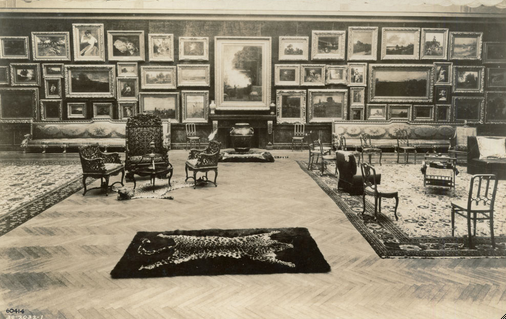
Interior of Mrs. Potter (Bertha Honoré) Palmer’s picture gallery in her home at 1350 North Lake Shore Drive. Institutional Archives, Art Institute of Chicago.
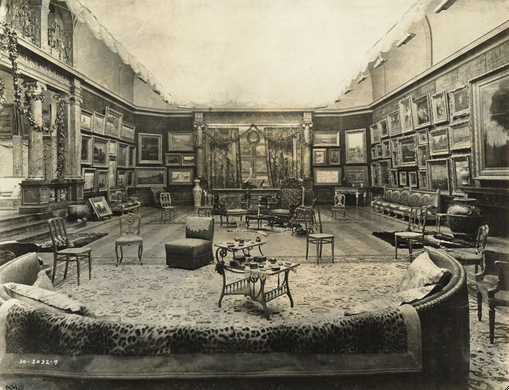
Interior of Mrs. Potter (Bertha Honoré) Palmer’s picture gallery in her home at 1350 North Lake Shore Drive. Institutional Archives, Art Institute of Chicago.
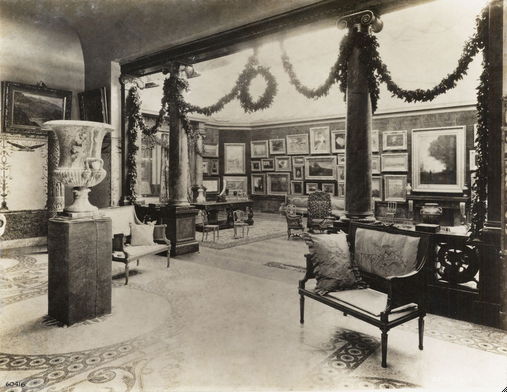
Interior of Mrs. Potter (Bertha Honoré) Palmer’s picture gallery in her home at 1350 North Lake Shore Drive. Displayed works include (1) Claude Monet (French, 1840–1926). The Petite Creuse River, 1889. Oil on canvas; 65.9 × 93.1 cm. The Art Institute of Chicago, Potter Palmer Collection, 1922.432. Art Institute of Chicago Archives. See cat. 25 in Monet Painting and Drawings the Art Institute of Chicago. Institutional Archives, Art Institute of Chicago.
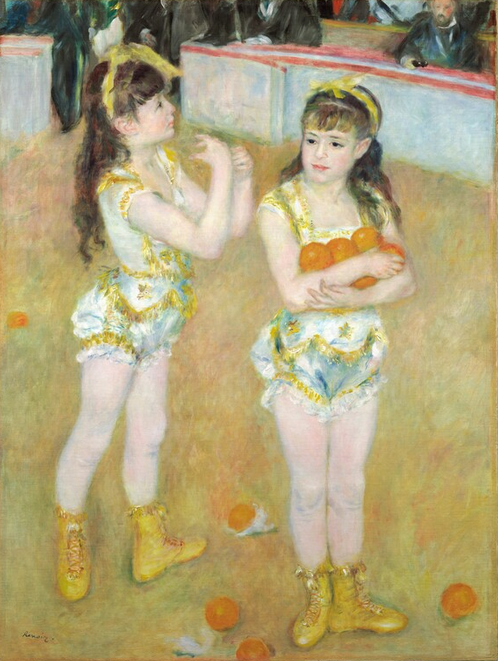
Pierre-Auguste Renoir (French, 1841–1919). Acrobats at the Cirque Fernando (Francisca and Angelina Wartenberg), 1879. Oil on canvas; 131.2 × 99.2 cm. The Art Institute of Chicago, Potter Palmer Collection, 1922.440. See cat. 9.
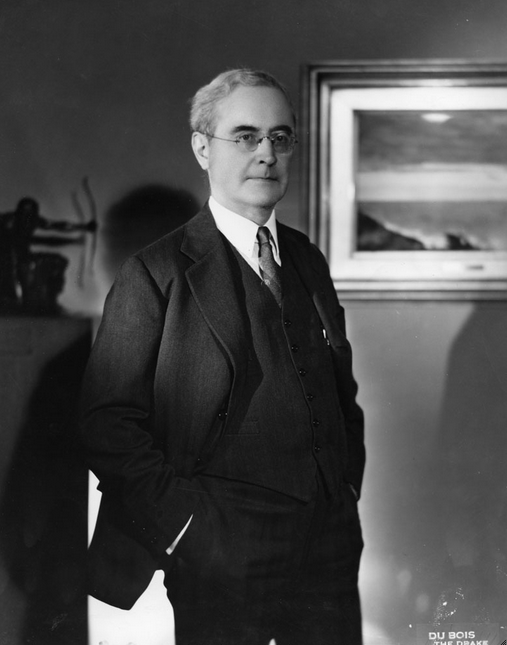
Mr. and Mrs. Potter Palmer’s son, Potter Palmer, Jr., who was a trustee of the Art Institute of Chicago from 1920 to 1943 and served as the museum’s president from 1925 to 1943. Institutional Archives, Art Institute of Chicago.
In 1947 Charles H. (1864–1956; fig. 1.2) and Mary F. S. (née Mary Foster Southwell; 1861–1954) Worcester donated seventy paintings, drawings, and sculptures from their collection to the Art Institute of Chicago.1394 Longtime patrons of the museum, the Worcesters had supported the Art Institute in significant ways for many years prior to this gift. They had loaned parts of their collection for exhibition and had generously supported the museum’s programming efforts, donating a fund to support the educational Gallery of Art Interpretation and contributing to the children’s fund. The Worcesters, who began donating important works of art to the Art Institute by 1925, collected broadly with the museum in mind; their 1947 donation—much of which stayed in their 1323 North State Street home until they died—included European and American works from the fourteenth to the twentieth century. According to former Art Institute curator and director Daniel Catton Rich: “In 1926, after a certain number of paintings had been acquired, Mr. and Mrs. Worcester indicated to Mr. Robert B. Harshe, Director of The Art Institute of Chicago, that they generously wished to contribute to the collections of the Institute. ‘What did the Museum need?’ ‘In what fields should it be strengthened?’ Together with Mr. Harshe they surveyed the Department of Paintings and . . . they set out at once to supply these lacks.”1395
In addition to their collecting efforts, the Worcesters volunteered extensive service to the Art Institute.1396 Having become a member in 1897, Mr. Worcester—a leader in the lumber and paper-product industries—went on to serve as a trustee (1925–49), vice president (1932–37), and honorary president (1938–56) (fig. 2.20). Originally from Detroit, Michigan, he was also an amateur painter (fig. 1.1). Mrs. Worcester—born in Fort Atkinson, Wisconsin, where her grandparents were founding settlers and she (as well as her parents) supported many local institutions, especially the town’s public library—was an honorary member of the Art Institute’s Woman’s Board. A supporter of many causes, Mrs. Worcester bequeathed approximately $5 million of her estate to numerous charities.1397 The Art Institute continues to benefit from the Worcesters’ philanthropy. Upon their deaths, they left the museum significant acquisition funds that have been used to purchase important Impressionist paintings such as Gustave Caillebotte’s Paris Street; Rainy Day, acquired by the Art Institute in 1964 (fig. 1.3).
Boats on the Beach at Étretat (cat. 22)
The Laundress (cat. 6)
La couseuse (Femme cousant dans un jardin) (The Seamstress [Woman Sewing in a Garden])1398
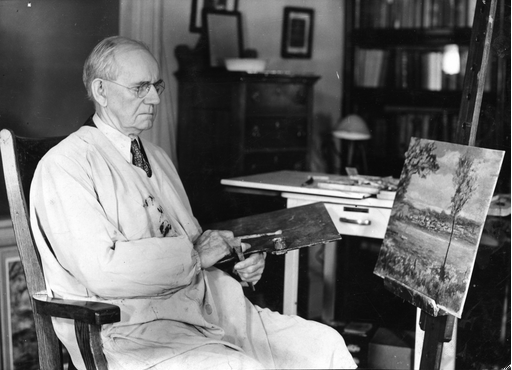
Charles H. Worcester
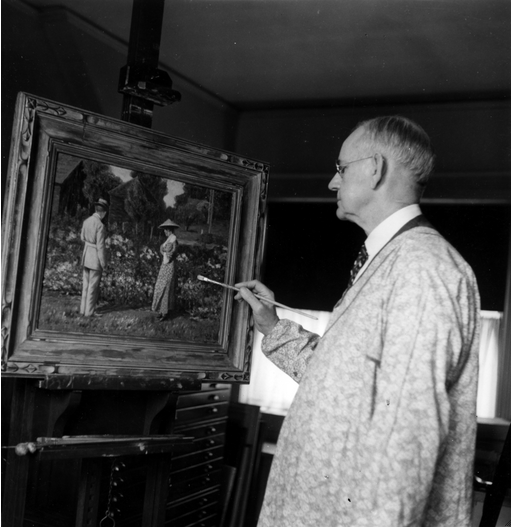
Mr. Charles H. Worcester (1864–1956) at his easel. Institutional Archives, Art Institiute of Chicago.
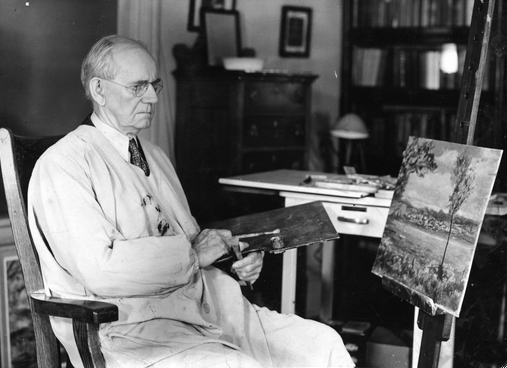
Mr. Charles H. Worcester (1864–1956) at his easel. Institutional Archives, Art Institiute of Chicago.
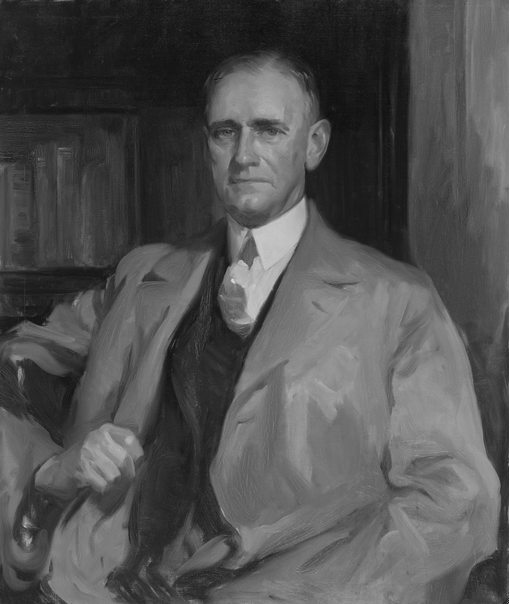
Wayman Adams (American, 1883–1959). Portrait of Charles H. Worcester, c. 1920. Oil on canvas; 96.8 × 81.6 cm. The Art Institute of Chicago, Charles H. and Mary F. S. Worcester Collection, 1947.51.
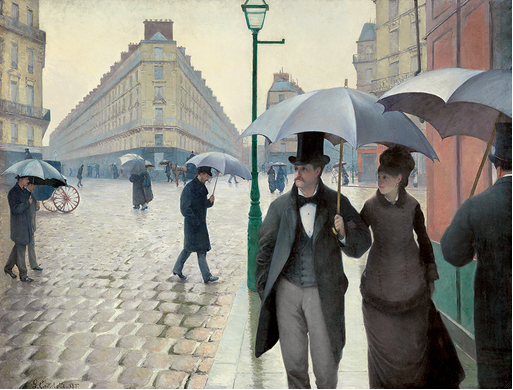
Gustave Caillebotte (French, 1848–1894). Paris Street; Rainy Day, 1877. Oil on canvas; 212.2 × 276.2 cm. The Art Institute of Chicago, Charles H. and Mary F. S. Worcester Collection, 1964.336. See cat. 2 in Caillebotte Paintings and Drawings at the Art Institute of Chicago.
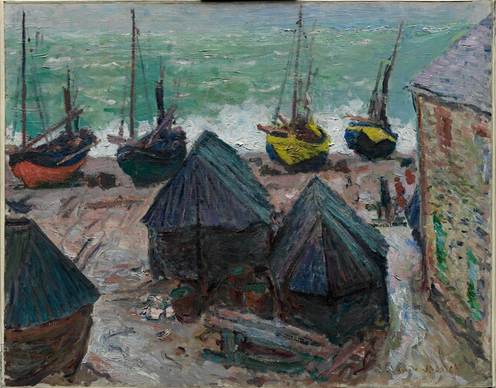
Claude Monet (French, 1840–1926). Boats on the Beach at Étretat, 1885. Oil on canvas; 65.5 × 81.3 cm. The Art Institute of Chicago, Charles H. and Mary F. S. Worcester Collection, 1947.95. See cat. 22.
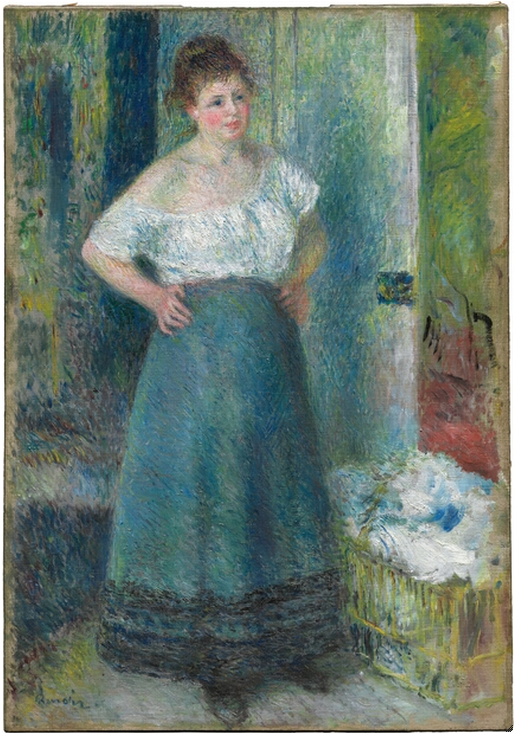
Pierre-Auguste Renoir (French, 1841–1919). The Laundress, 1877/79. Oil on canvas; 80.8 × 56.5 cm. The Art Institute of Chicago, Charles H. and Mary F. S. Worcester Collection, 1947.102. See cat. 6.
Gloria Groom, Senior Curator and David and Mary Winton Green Curator of Nineteenth-Century European Painting and Sculpture, Department of Medieval to Modern European Painting and Sculpture
Jill Shaw, formerly Research Associate, Department of Medieval to Modern European Painting and Sculpture
John Collins, Ottawa, Canada
Gloria Groom, Senior Curator and David and Mary Winton Green Curator of Nineteenth-Century European Painting and Sculpture, Department of Medieval to Modern European Painting and Sculpture
Nancy Ireson, Rothman Family Associate Curator of Prints and Drawings, Department of Prints and Drawings
Kelly Keegan, Assistant Paintings Conservator, Department of Conservation
Kimberly Nichols, Associate Paper Conservator, Department of Prints and Drawings
Jill Shaw, formerly Research Associate, Department of Medieval to Modern European Painting and Sculpture
Colin Bailey, Director, Fine Arts Museums of San Francisco
Inge Fiedler, Associate Research Microscopist, Department of Conservation
Genevieve Westerby, Online Scholarly Catalogue Initiative Research Assistant, Department of Medieval to Modern European Painting and Sculpture
Francesca Casadio, Andrew W. Mellon Senior Conservation Scientist, Department of Conservation
Damon M. Conover, The George Washington University, Washington, D.C.
John K. Delaney, National Gallery of Art, Washington, D.C.
Robert G. Erdmann, University of Arizona, Tucson, Arizona
Melissa Gustin, Research Associate, Department of Prints and Drawings
C. Richard Johnson, Jr., Cornell University, Ithaca, N.Y.
Don H. Johnson, Rice University, Houston
Murray H. Loew, The George Washington University, Washington, D.C.
Kimberely Muir, Assistant Research Conservator, Department of Conservation
Federica Pozzi, Andrew W. Mellon Fellow in Conservation Science, Department of Conservation
Kate Venmar, Northwestern University, Evanston, Ill.
Marc Vermeulen, formerly Assistant Conservation Scientist, Department of Conservation
Anna Vila-Espuña, formerly Andrew W. Mellon Fellow, Department of Conservation
Emily Vokt Ziemba, Collection and Exhibitions Manager, Department of Prints and Drawings
Kirk Vuillemot, Assistant Conservator for Framing and Preparation, Department of Conservation
Frank Zuccari, Grainger Executive Director of Conservation and Senior Paintings Conservator, Department of Conservation
Elizabeth Neely, formerly Director, Department of Digital Experience and Access
Amy Parkolap, Project Coordinator for the Online Scholarly Catalogue Initiative, Publications Department
D. Samuel Quigley, formerly Vice President for Collections Management, Imaging, and Information Technology/Chief Information Officer
Tina Shah, Senior Systems Analyst for Collections, Department of Information Services
Susan Weidemeyer Davidson, formerly Assistant Editor, Publications Department
Lara Ditkoff, Online Scholarly Catalogue Initiative Assistant, Publications Department
Jenni Fry, Proofreader
Sarah E. Guernsey, Director, Publications Department
Stacey Hendricks, Financial and Administrative Coordinator
Beata Hosea, Digital Catalogue Designer, Publications Department
Lauren Makholm, Photography Editor, Publications Department
Wilson McBee, Assistant Editor, Publications Department
Hey J Min, formerly Digital Catalogue Designer, Publications Department
Joseph Mohan, Production Coordinator, Publications Department
Jael Montellano, Editorial Assistant
Amy Peltz, Editor, Publications Department
Maia M. Rigas, Editor, Publications Department
Susan F. Rossen, formerly Executive Director, Publications Department
Christine Schwab, Assistant Editor, Publications Department
Robert V. Sharp, formerly Executive Director, Publications Department
Chris Gallagher, Director of Imaging, Department of Imaging
Bob Hashimoto, Senior Photographer for 3-D, Department of Imaging
Robert Lifson, Senior Photographer for 2-D, Department of Imaging
Jonathan Mathias, Post-Production Technician, Department of Imaging
Louis Meluso, Director of Imaging Technology, Department of Imaging
P. D. Young, Production Coordinator, Department of Imaging
Amy Zavaleta, Photographic Archive Coordinator, Department of Imaging
Welcome to an exciting new development at the intersection of publishing, scholarship, and technology. This digital publication represents, we believe, a model for the future of museum publishing that brings together current scholarship and state-of-the-art imaging technology in the service of one of the world’s great collections of Impressionist art. It is our belief that this innovative online platform will make the important curatorial and conservation research that is part of every museum’s mission more broadly accessible and illuminating.
Featured in exhibitions around the globe and in numerous scholarly and popular publications, as well as in our own galleries, the Art Institute of Chicago’s Impressionist collection is world renowned. The museum has contributed significantly to the scholarship on its own Impressionist holdings, as well as on nineteenth-century art in general, by organizing groundbreaking exhibitions focused on the material history of particular works, including Van Gogh and Gauguin: The Studio of the South (2001) and Seurat and the Making of “La Grande Jatte” (2004). But a comprehensive, systematic research project devoted to our Impressionist paintings and drawings had yet to be undertaken. This digital volume—on the work of Pierre-Auguste Renoir—is the second in the series Paintings and Drawings by Artists of the Impressionist Circle at the Art Institute of Chicago.
We have long desired to publish a scholarly catalogue of our nineteenth-century holdings; our plans to do so began in earnest in 1999 with the establishment of the Art Institute’s David and Mary Winton Green Research Fund. Parallel to this research, concern was growing within museums about the increasingly prohibitive costs of scholarly collection catalogues, their modest circulation in print, and the inability to update information once they have been released. These issues were the subject of a session on the fate of the permanent collection catalogue at the 2008 meeting of the Association of Art Museum Curators. Fortunately, the Getty Foundation chose this moment to launch its Online Scholarly Catalogue Initiative (OSCI) to explore the possibilities of presenting collection research in new ways. It brought together a consortium of nine museums, including the Art Institute of Chicago, to develop sustainable and replicable models for online scholarly collection catalogues and assess how a change in the way museums think about publishing might impact institutional structures. Our Monet and Renoir catalogues embody the Art Institute’s contribution to this effort. In addition to our gratitude to the Getty Foundation for its vision and generosity, we want to acknowledge major support from Mary Green, who with her husband, David, endowed the research fund that bears their names. The Art Institute has also received generous funding from the Samuel H. Kress Foundation and the Andrew W. Mellon Foundation, organizations that are committed to facilitating the productive collaboration of art history with technology.
The Art Institute’s publishing model for the OSCI project is the result of numerous discussions with our in-house team as well as with colleagues in the larger OSCI consortium. Our primary challenge was twofold: first, we wanted to build a model that would address the requirements of scholars to have an authoritative, permanent, and citable research reference and would maintain the high standards of the Art Institute’s collection catalogues in print. Beyond that, however, we thought strategically about the potential benefits of an online publication and how to take full advantage of features that are available only in the digital realm. Indeed, our concept evolved through many hours of consideration; the specifics of our discussions are put forth by Gloria Groom in the project overview and acknowledgments of the Monet and Renoir catalogues. Always at the core of our conversations was the importance of contributing vital scholarship to the field and demanding that our online catalogue display the same academic rigor, curatorial insight, and editorial professionalism as its printed counterparts.
This project truly has been a collaborative endeavor. The curatorial dimension was overseen by Gloria Groom, Senior Curator and David and Mary Winton Green Curator of Nineteenth-Century European Painting and Sculpture in the Department of Medieval to Modern European Painting and Sculpture, with Jill Shaw, formerly Research Associate in the department and now Senior Curator of Collections at the Picker Art Gallery at Colgate University. Conservation efforts were led by Frank Zuccari, Grainger Executive Director of Conservation; Kimberley Muir, Assistant Research Conservator; and Kelly Keegan, Andrew W. Mellon Fellow of Paintings Conservation. Former heads of Publications, Susan F. Rossen and her successor, Robert V. Sharp, and Sarah E. Guernsey, Director of Publications, have been critical to the success of this project. The efforts of D. Samuel Quigley, formerly the Art Institute’s Vice President for Collections Management, Imaging, and Information Technology/Chief Information Officer and now Director of the Lyman Allyn Art Museum in New London, Connecticut; Elizabeth Neely, formerly Director of Digital Information and Access; and members of the staff of the IMA Lab at the Indianapolis Museum of Art were vital to the technological strides that we have made. Having developed this model using open-source software, we hope that it will serve as a springboard for future online publications within the museum community and in the humanities more broadly.
Douglas Druick
President and Eloise W. Martin Director
The Art Institute of Chicago
The very definition of an online scholarly publication suggests accessibility and functionalities beyond print—a complex and groundbreaking endeavor entailing many challenges and opportunities. In developing these volumes for the series Paintings and Drawings by Artists of the Impressionist Circle at the Art Institute of Chicago, our goal was to produce a publication that would embrace the new, exciting digital world without leaving behind the heft and authority conventionally ascribed to the printed book. To this end, we recognized that first and foremost we would need to think about how to make the digital format familiar or comfortable enough for readers so that our catalogues would find a place among both scholars—those who primarily use the Art Institute of Chicago’s collection catalogues—and a wider range of users who would enter them via our museum’s website.
The next challenge was to come up with a format that would not only be acceptable (and citable) as a scholarly resource but would also take advantage of the capabilities of technology to develop a new way to present research. Initially, we aimed to produce a book based on our established print format and provide a link to a digitized, noninteractive version from our website. After much reflection, we shifted to an all-inclusive approach, for which we considered providing essential and nonessential documentary materials, from which readers could draw their own conclusions. In the end, we chose to pursue a hybrid of the two approaches: the catalogue is written from the perspective of the curators and conservators of the Art Institute, and only necessary photographs and documentary materials are provided. Nevertheless, we have developed a structure in which the reader can selectively read the catalogue in many different ways, and we prepared an interactive imaging tool so that readers can test the hypotheses we offer. With this strategic approach in mind, we also identified certain key concepts and features of printed books that were critical to our goal:
The content must speak to a scholarly audience and incorporate all of the categories of research—including new, extensive technical information—and high scholarly standards that have been used in print catalogues published by the Art Institute. Along the same lines, all content must be edited in the same rigorous manner as it is for printed books.
A high-resolution color image of the plate accompanying each catalogue entry must be easily accessible at all times throughout the entry so that the reader can refer to it in order to review or challenge our assessments.
The responsibility to footnote is essential to any scholarly catalogue, including digital ones, so we created a “drawer” for footnotes that can be opened and viewed or tucked away at any time.
Note taking is an important component of using print publications for research. To relieve anxiety over the loss of marginalia on the printed page, we wanted readers to be able to personalize their copies of the digital catalogues, allowing them to bookmark pages of interest and write notes on simulated Post-its.
Page numbering is key to navigation of the printed book. But in the fluid environment of reading online, we have found that paragraph numbers provide a more reliable means of identifying locations and text. Without the tangible sensation of turning pages, however, readers could become disoriented. Recognizing how essential it is for readers always to have a sense of where they were in the catalogues, we included a moving bar across the bottom of the page that indicates how much text is left in a particular entry.
Consistency and flexibility are also important. Although we tried to maintain a certain consistency in the publications’ appearance, we recognized that we were developing a model not only for our collection of nineteenth-century paintings and drawings but also for other areas of the Art Institute’s holdings. To this end, we wanted to build in flexibility so that future online books could have their own distinct design and organization.
Finally, another critical issue for us was the citability of these online catalogues. We wanted them to have a permanent, fixed publication date that could be recorded easily and reliably by scholars.
Along with these booklike elements, we hoped to build a scholarly publication that would be technologically innovative. We wanted our readers to be able to access and explore the primary documentation we used to make our conclusions. This meant that we (as authors) needed to learn what technology could do. This was perhaps the greatest lesson of all, since we had also to provide to the technology teams at both the Art Institute and the IMA Lab of the Indianapolis Museum of Art a clear sense of the intricacies of the research process. This labor-intensive but fully satisfying exchange enabled the technology teams to develop a prototype based on our experience as researchers, authors, and editors. We spent hours with the teams within our museum and from the IMA Lab, either in the same room or in conference calls, sharing our methodology for conducting research on and writing about works of art.
From the beginning, we conceived of a digital publication that would fully utilize and incorporate conservation documentation, allowing us for the first time to widely share the vast number of images generated through the varied examination processes. Our entries inform the existing art-historical literature with critical new research based on conservators’ findings. In this respect, we were exhilarated by the possibilities for presenting comparative, technical, and archival illustrations. We dedicated many hours to honing our examination methodology and report format with the conservation team. This component of the project had a precedent established in earlier printed scholarly publications issued by the museum, but there was no guidebook for the presentation of extensive conservation imaging. The interactive imaging tool, which has made the multilayering of images possible, developed as a result of thoughtful discussions about what various researchers (especially conservators, scientists, and art historians) and general readers would find useful and meaningful. By introducing the technical images in this way, we know that we are presenting to our readers the raw materials—photographs, photomicrographs, overlays, and interactive imaging tools—from which we have drawn our conclusions. In addition to curatorial and conservation reports, we have included information about collectors, a glossary, links to PDFs of early museum publications, and other documentation to provide a fuller understanding of any given object and its history at the Art Institute.
Our many conversations with the team at the IMA Lab were absolutely critical to developing the concept for this series. In considering our needs, they brought to the table examples of online tools from diverse sources, including sci-fi zines, sports sites, and CNN, that they thought might bring to life our wish list of requirements. At each stage of the brainstorming process, we were allowed to test-drive the results, ensuring that each step forward fit into the practical, philosophical, and aesthetic concept for the project.
Faced with unlimited possibilities, we nonetheless chose to impose certain limits on our publication. In order to focus on the development of the technological components of these catalogues, we decided to feature initially the works of two artists: Claude Monet and Pierre-Auguste Renoir. We also had to make a number of decisions, from the amount of documentary material to provide—photographs or photographic details, for example, from prior conservation work or from the museum’s archives that directly related to the historical importance of these artworks—to the word limits necessitated by certain aspects of the design of these publications. It was gratifying, however, to know that we were forging something that would not only display research but also be the basis for further content that would use the functionalities for sorting, searching, and tagging that we were developing. We wanted to avoid the pitfall of allowing the digital platforms to shape the research component of a project. Starting from the ground up, we built a sophisticated digital vehicle that bears all the hallmarks of the scholarly research and print publishing worlds and immerses us in an even richer contextual, factual, and visual sphere from which to consider the artwork itself.
For instigating and nurturing this multifaceted digital project, we have many people to thank. Most important are the major funders, beginning with the Getty Foundation, which offered the raison d’être and ongoing financial support. We extend our sincere gratitude and admiration especially to Deborah Marrow, Director of the Getty Foundation; Joan Weinstein, Deputy Director; Rebecca Martin, Associate Director; and Anne Helmreich, Senior Program Officer. The David and Mary Winton Green Research Fund has also provided tremendous financial support for the research expenses, and for this we wish to thank Mary Winton Green, who has closely followed and applauded our progress. We also thank Max Marmor, Director of the Samuel H. Kress Foundation, for appreciating the potential value of the marriage of art history and technology, and providing valuable financial support for a digital assets and research assistant and a Kress Fellow in Paintings Conservation. Scientific research on materials and the technical study of paintings was supported by the Andrew W. Mellon Foundation. We would also like to thank the support of the late Eloise W. Martin and the Community Associates of the Art Institute for their support of the X-ray fluorescence analyzers that have enabled noninvasive palette determination for the paintings. The Community Associates also supported the purchase of a new infrared camera, greatly enhancing our ability to study the works.
In its early stages, the project was supported by the Art Institute’s former director, James Cuno, who has since been appointed President and Chief Executive Officer of the J. Paul Getty Trust, and by Susan F. Rossen, the former head of the museum’s Publications Department, whose success in publishing scholarly printed catalogues was a crucial factor in the Getty’s consideration of the Art Institute for its initiative. Critical at all stages of the project were the insight and support of Douglas Druick, in both his former roles as Searle Chair and Curator of the Department of Medieval to Modern European Painting and Sculpture and Prince Trust Curator and Chair of the Department of Prints and Drawings, and now as President and Eloise W. Martin Director of the Art Institute. We are also grateful to Martha Tedeschi, Deputy Director for Art and Research, for her support of the OSCI program, and to Sylvain Bellenger, Searle Chair and Curator, Department of Medieval to Modern European Painting and Sculpture. Our special thanks go to Jill Shaw, formerly Research Associate in the Department of Medieval to Modern European Painting and Sculpture and now Senior Curator of Collections at the Picker Art Gallery at Colgate University, who was the first to translate our original ideas for accessing multiple research disciplines into a visual model that allowed us to articulate our expectations with the technological teams in the early stages of the project. In addition to her primary role as catalogue researcher and author, she tirelessly served as the project’s first coordinator. Ably assisting her with every aspect of the curatorial research and content production was Genevieve Westerby, formerly Digital Assets and Research Assistant and now OSCI Research Assistant. Her unremitting diligence and passion for the project was critical to its success especially as her duties grew after Jill Shaw's departure. Samantha Schroeder and Stacy Kammert provided important assistance in the final stages.
Essential to the critical conservation component of the project has been the support and guidance of Frank Zuccari, Grainger Executive Director of Conservation and Senior Paintings Conservator. Kimberley Muir, Assistant Research Conservator, and Kelly Keegan, Andrew W. Mellon Fellow from 2010 to 2012 and presently Assistant Paintings Conservator, worked unflaggingly to complete examinations, analyses, and writing, in addition to creating the annotated overlays and photomicrographs for the digital format that so brilliantly reveal the artist’s working process. Kelly Keegan was also responsible for completing the exceedingly difficult taks of compositing and registering hundreds of images for the interactive image overlay tool. Thanks are also owed to Kirk Vuillemot, Assistant Conservator for Framing and Preparation, for his detailed descriptions of the picture frames. As much as possible, this project has incorporated the most up-to-date analyses of pigments and grounds, and for this we are grateful to Francesca Casadio, Andrew W. Mellon Senior Conservation Scientist, and Inge Fiedler, Associate Research Microscopist. A number of junior scientists also contributed on many of the paintings: Gwénaëlle Gautier, Associate Conservation Scientist; Sonia Maccagnola, graduate intern in Conservation Science; Federica Pozzi, Andrew W. Mellon Fellow in Conservation Science; Marc Vermeulen, formerly Assistant Conservation Scientist; and Anna Vila-Espuña, formerly Andrew W. Mellon Fellow in Conservation.
The same intensity of examination, technical reporting, and imaging that has taken place for oil paintings has also been applied to the artists’ works on paper under the supervision of Suzanne Folds McCullagh, Anne Vogt Fuller and Marion Titus Searle Chair and Curator of Prints and Drawings. The talented team that has worked on the various OSCI volumes includes Antoinette Owen, Senior Paper Conservator; Harriet Stratis, Senior Research Paper Conservator; Kimberly Nichols, Associate Paper Conservator; and Dawn Jaros, formerly Andrew W. Mellon Fellow in Paper Conservation. Research and writing have been the charge of Nancy Ireson, Rothman Family Associate Curator of Prints and Drawings, and James A. Ganz of the Achenbach Foundation for Graphic Arts in San Francisco. Critical research assistance has been provided by Emily Vokt Ziemba, Collection and Exhibition Manager in Prints and Drawings; Melissa Gustin, Research Associate; and Mel Becker, Catalogue/Research Associate.
We also wish to extend a special thanks an eminent scholar who served as reader and provided important counsel and critique: Colin Bailey, Director, Fine Arts Museums of San Francisco.
The project would not have been feasible without the expertise and support of the Art Institute’s technological team. Our deepest gratitude goes to D. Samuel Quigley, formerly Vice President for Collections Management, Imaging, and Information Technology/Chief Information Officer, and now Director of the Lyman Allyn Art Museum in New London, Connecticut. We are grateful for his leadership as we developed the project's concept, for connecting us with the IMA Lab, and for continuing to integrate this project with the larger technological initiatives of the museum. Special thanks go to Elizabeth Neely, formerly Director of Digital Experience and Access, for serving as our main conduit with the IMA Lab and expertly guiding the team through the murkiness of the new (digital) world order; Carissa Kowalski Dougherty, Manager of Collection Information and Technology, for her behind-the-scenes support; Amy Parkolap, Project Coordinator, formerly of Digital Experience and Access and now a member of the Publications Department; and the newest member of the team, Tina Shah, Senior Systems Analyst for Collections. Those overseeing the deeper infrastructure deserve our thanks for maintaining the security and reliability of servers on the back end: Raphael Jaffey, Director of Network Services; Stefano Cossu, Director of Application Services, Collections; and Mike Bingaman, Web Technology Coordinator.
For the magnificent high-resolution color images, the ultraviolet light captures, and the archival photography of the works in these volumes, there are several members of the Imaging Department to whom we owe thanks: Louis Meluso, Director of Imaging Technology; Chris Gallagher, Director of Imaging; Bob Hashimoto, Senior Photographer for 3-D; Robert Lifson, Senior Photographer for 2-D; Amy Zavaleta, Photographic Archive Coordinator; and P. D. Young, Production Coordinator. We are also grateful to Jonathan Mathias, Post-Production Technician, and to a former member of the Imaging team, Casey Gibbs.
To the IMA Lab at the Indianapolis Museum of Art, we extend our gratitude and congratulations for turning our ideas for the ideal research and publications tool into a reality that will serve as a template not only for these volumes but also for the future of online scholarly publishing at the Art Institute and elsewhere. We are especially grateful to two former members of the IMA Lab team: Robert Stein, then Deputy Director for Research, Technology, and Engagement; and Charles Moad, formerly Director of the IMA Lab. Since their departure from Indianapolis, we have relied upon others there who have been personally involved with us at the Art Institute, principally Kyle Jaebker, Director; Gray Bowman, Lead Software Architect; and Matt Gipson, Senior Digital Graphic Designer.
This new hybrid of scholarly publication and technological interactivity has demanded an innovative publishing template that has been developed under the leadership of Robert V. Sharp, former Executive Director of Publications, and Sarah E. Guernsey, Director of Publications. Susan Weidemeyer Davidson, formerly of the Publications Department, was the first editor to master the new platform for editing and linking in the digital format, and she saw us through the beta release in 2011. Since that time, every member of the department’s talented editorial team has been involved in the preparation of the Renoir catalogue: Christine Schwab, with the invaluable assistance of Maia M. Rigas and critical backup by Wilson McBee and Amy Peltz, and the dedicated efforts of Lara Ditkoff, Stacey Hendricks, Jael Montellano, and proofreader Jenni Fry in the late stages of the project. We are grateful to Hey J Min and Beata Hosea for their excellent design work in the online presentation of these catalogues. At all stages, the print-to-digital project has been assisted by Lauren Makholm, Photography Editor, and Joseph Mohan, Production Coordinator.
A project of this magnitude would not have been possible without full access to and understanding of archival materials. Our deepest thanks go to Jack Perry Brown, former Director of the Ryerson and Burnham Libraries, and Bart H. Ryckbosch, Glasser and Rosenthal Archivist, both of whom followed this project from its beginnings and have provided invaluable suggestions and resources. We are also extremely grateful to Melanie Emerson and Autumn Mather for their handling of interlibrary loan requests.
Among the many challenges we faced at the instigation of this project were legal issues, for which we continue to rely on the expertise of Julie Getzels, Executive Vice President, General Counsel and Secretary; and Troy Klyber, Intellectual Property Manager. We would like to thank as well Jennifer Oatess, Director of Foundation and Government Grants, for her continued help with reports and grant applications; as well as Jeanne Ladd, Vice President for Museum Finance; Helena Burke-Bevan, Director of Museum Finance for Compliance and Reporting; and Celeste Diaz, Budget Analyst, for guiding us through the complicated budgets that this ever-expanding project has entailed. We are also grateful to Michael Nicolai, Vice President for Human Resources, for his patience in helping us navigate the corporate waters of employing outside experts.
Also at the museum a number of individuals offered their valuable time, expertise, and encouragement and deserve our sincere thanks: David Thurm, Chief Operating Officer; Dorothy Schroeder, Vice President for Exhibitions and Museum Administration; Erin Hogan, formerly Director of Public Affairs and Communications and now Head of Interpretation; Chai Lee, formerly Associate Director of Public Affairs; and Jeff Wonderland, Director of Graphic Design. We are also grateful to Pat Loiko, formerly Executive Director of Museum Registration; Jennifer Draffen, Executive Director of Museum Registration; Senior Registrar Darrell Green and Registrar Greg Tschann; and volunteer Susanna Rudofsky, who generously offered her translating skills.
We are also grateful to many past and present members of the Department of Medieval to Modern European Painting and Sculpture who have been vital to our pursuit of our goals: Katharine Baetjer, Geri Banik, Robert Burnier, Florence Cazenave, Cole Chickering, Margaret Crosland, Stephanie D’Alessandro, Adrienne Jeske, Stacy Kammert, Marina Kliger, Elizabeth McGoey, Renée DeVoe Mertz, Jane Neet, Jennifer Paoletti, Allison Perelman, Aza Quinn-Brauner, Eve Straussman-Pflanzer, Stephanie Strother, Jonathan Tavares, Heather Whitehead, and Martha Wolff, as well as volunteers Erin Kirk and Morgane Magnin. We also wish to extend a special thanks to colleagues and volunteers within the museum who have provided support, encouragement, and assistance for this project, including Susan Augustine, Christopher Brooks, Gwénaëlle Gautier, Christina Giles, Faye Gleisser, Allison Langley, Leonard Leibowitz, Kristin Lister, Curtis Osmun, Charles Pietraszewski, Jann Trujillo, Seth Vanek, Sara Wohler, and Faye Wrubel, as well as the staff of the Ryerson and Burnham Libraries.
Although this volume constitutes a team effort, the team was located not only within the walls of the museum; it involved many others whom we would also like to thank. For keeping the project on target and assisting in our periodic presentations at the Getty, we thank Christina Lopez and the highly supportive Nik Honeysett, Head of Administration at the J. Paul Getty Museum, as well as two former members of the Getty team, Nancy Micklewright and Hilary Walter. We also wish to acknowledge Maureen Whalen, Associate General Counsel at the Getty Trust; Kristin Kelly, who served as a consultant on the OSCI project; and Holly Witchey, for her part in the preparation of the 2011 interim report. Special thanks are due to the team of scientists whose expertise and innovative research contributed to the project in a number of ways. The accurate registration of images for overlays and annotations employed technology developed by John K. Delaney, Senior Imaging Scientist at the National Gallery of Art, Washington, D.C., and the School of Engineering and Applied Sciences at the George Washington University, Washington, D.C.; and Murray H. Loew, Professor, and Damon M. Conover, Graduate Research Assistant, Department of Electrical and Computer Engineering, the George Washington University, Washington, D.C. This challenging task, accomplished using a novel image-based algorithm that they had previously developed, was essential to making the overlay tool fully functional. C. Richard Johnson, Jr., Cornell University, Ithaca, N.Y.; Don H. Johnson, J. S. Abercrombie Professor Emeritus, Rice University, Houston; and Robert G. Erdmann, Assistant Professor, Department of Materials Science and Engineering and Program in Applied Mathematics, University of Arizona, Tucson, contributed to the project, providing automated thread counts and weave analyses that have enabled us to compare canvas weaves among works, greatly enhancing our understanding of the sources of artist’s materials. We are also grateful to Robert Erdmann for assembling the digital X-ray composites for most of the paintings. The capabilities for scientific analysis at the Art Institute have been enhanced by access to instrumentation and expertise at Northwestern University, thanks to our longstanding institutional collaboration in conservation science. In particular, we are grateful to Benjamin D. Myers, Electron Microsopist and SEM/FIB Manager, and Kate Venmar, former SEM/FIB Manager, of the Northwestern University Atomic and Nanoscale Characterization Experimental Center (NUANCE) Electron Probe Instrumentation Center (EPIC) facility, Evanston, Ill., for their help with scanning electron microscopy. NUANCE has received support from the MRSEC program (NSF DMR-1121262) at the Materials Research Center, and the Nanoscale Science and Engineering Center (EEC-0118025/003), both programs of the National Science Foundation; the State of Illinois; and Northwestern University. We thank Professor Richard P. Van Duyne of Northwestern University for opening his laboratory to Federica Pozzi for the red lake pigment analysis with surface-enhanced Raman spectroscopy.
In terms of the scope of our research, we would like to thank first the Durand-Ruel family—Flavie; her father, Paul-Louis Durand-Ruel; and Claire Durand-Ruel Snollaerts—for their valuable assistance in correcting or confirming provenance of works, which, in many cases, were sold through the gallery of their eminent relative, Paul Durand-Ruel. Thanks also to the many individuals outside the Art Institute who were always willing to share with us their insights and information, whether centered on the history of art or the technical aspects of our project: Susan K. Anderson, The Martha Hamilton Morris Archivist, Philadelphia Museum of Art; Claire Barry, Kimbell Art Museum, Fort Worth, Tex.; Todd Behrens, Sioux City (Iowa) Art Center; David Brenneman, High Museum of Art, Atlanta; Richard R. Brettell, University of Texas at Dallas; Elizabeth Tufts Brown, Carnegie Museum of Art, Pittsburgh; Barbara Buckley, the Barnes Collection, Philadelphia; Anthea Callen, author and independent art historian; Guy Cogeval, Musée d’Orsay, Paris; Sylvie Crussard, Fondation Wildenstein; Guy-Patrice Dauberville, Galerie Bernheim-Jeune, Paris; Claire Denis, catalogue raisonné Maurice Denis; Michele Derrick, Museum of Fine Arts, Boston; Anne Distel, independent art historian; Judith Dolkart, Barnes Foundation, Philadelphia; Isabelle Gaëtan, Musée d’Orsay, Paris; Paul Galvez, Gauguin catalogue raisonné; James Grebl, Ph.D., Manager, Library & Archives, San Diego Museum of Art; Charlotte Hale, the Metropolitan Museum of Art, New York; Ann Hoenigswald, National Gallery of Art, Washington, D.C.; Kelly Holbert, Exhibition Coordinator, Smith College Museum of Art, Northampton, Mass; John House, the Courtauld Institute of Art, London; Uri Kupferschmidt, University of Haifa; Geraldine Lefebvre, Musée d’Art Moderne André Malraux, Le Havre; Deborah Lenert, Barnes Foundation, Philadelphia; Teresa Lignelli, Philadelphia Museum of Art; Connie Meyer, Dwight Foster Public Library, Fort Atkinson, Wisc.; Joe Mikuliak, Philadelphia Museum of Art; Erin Murphy, Archivist/Records Manager, Harvard Art Museums; Monique Nonne, independent art historian; Kori Oberle, Hoard Historical Museum, Fort Atkinson, Wisc.; Karen O’Connor, Hoard Historical Museum, Fort Atkinson, Wisc.; Paola Ricciardi, Fitzwilliam Museum (formerly National Gallery of Art, Washington, D.C.); Anne Roquebert, Musée d’Orsay, Paris; Ashok Roy, National Gallery, London; Anne H. Simmons, National Gallery of Art, Washington, D.C.; Marcia Steele, the Cleveland Museum of Art; and Guy Wildenstein and Joseph Baillio, Wildenstein and Company, New York. Thanks also to Iris Schaefer and Caroline von Saint-George, Wallraf-Richartz-Museum & Fondation Corboud, Cologne, for their guidance in shaping the technical report sections.
It has taken a veritable village of talented and supportive individuals to see this project through its first phase, and we happily anticipate that this community will expand exponentially as we venture into future volumes.
Gloria Groom
Senior Curator and David and Mary Winton Green Curator of Nineteenth-Century European Painting and Sculpture
Department of Medieval to Modern European Painting and Sculpture
The Art Institute of Chicago
A short demonstrating video on how to maximize the catalogue’s features and tools can be found here.
We recommend using the latest version of Chrome, Safari, or Firefox.
We welcome your questions and comments about the publication at OnlineCatalogueFeedback@artic.edu.
© 2014 The Art Institute of Chicago. All rights reserved.
ISBN: 978-0-86559-270-4
Published by:
The Art Institute of Chicago
111 South Michigan Avenue
Chicago, Illinois 60603-6404
www.artic.edu
All photographs of artworks appear by permission of the lenders mentioned in the captions, unless otherwise stated. Every effort has been made to contact and acknowledge copyright holders for all reproductions; additional rights holders are encouraged to contact the Art Institute of Chicago.
Unless otherwise noted, all photographs of the works in this catalogue were made by the Department of Imaging at the Art Institute of Chicago, Christopher Gallagher, Director of Photography, Lou Meluso, Director of Imaging Technology, and are copyrighted by the Art Institute of Chicago.
Due to the pioneering publishing platform of this catalogue, we are including the following citation guide for your reference.
Gloria Groom and Jill Shaw, “Cat. 6: The Laundress, 1877/79: Curatorial Entry” in Renoir Paintings and Drawings at the Art Institute of Chicago, ed. Gloria Groom and Jill Shaw (Art Institute of Chicago, 2014), para X.
Kelly Keegan, “Cat. 6: The Laundress, 1877/79: Technical Report,” in Renoir Paintings and Drawings at the Art Institute of Chicago, ed. Gloria Groom and Jill Shaw (Art Institute of Chicago, 2014), para X.
"Cat. 6: The Laundress: Provenance," in Renoir Paintings and Drawings at the Art Institute of Chicago, ed. Gloria Groom and Jill Shaw (Art Institute of Chicago, 2014), para X.
“Cat. 6: The Laundress, 1877/79: Exhibition History,” in Renoir Paintings and Drawings at the Art Institute of Chicago, ed. Gloria Groom and Jill Shaw (Art Institute of Chicago, 2014), para X.
“Cat. 6: The Laundress, 1877/79: Selected References,” in Renoir Paintings and Drawings at the Art Institute of Chicago, ed. Gloria Groom and Jill Shaw (Art Institute of Chicago, 2014), para X.
“Cat. 6: The Laundress, 1877/79: Other Documentation,” in Renoir Paintings and Drawings at the Art Institute of Chicago, ed. Gloria Groom and Jill Shaw (Art Institute of Chicago, 2014), para X.
“Mrs. Lewis Larned (Annie Swan) Coburn,” in Renoir Paintings and Drawings at the Art Institute of Chicago, ed. Gloria Groom and Jill Shaw (Art Institute of Chicago, 2014), para. X.
The Art Institute of Chicago wishes to acknowledge the support of The Getty Foundation. Our project was undertaken as part of the Foundation’s Online Scholarly Catalogue Initiative, that includes a group of nine museums working together to develop models for the publication of scholarly collection catalogues in an online environment.
The Getty Foundation fulfills the philanthropic mission of the Getty Trust by supporting individuals and institutions committed to advancing the understanding and preservation of the visual arts locally and throughout the world. Through strategic grants and programs, the Foundation strengthens art history as a global discipline, promotes the interdisciplinary practice of conservation, increases access to museum and archival collections, and develops current and future leaders in the visual arts. The Foundation carries out its work in collaboration with the Getty Museum, Research Institute, and Conservation Institute to ensure that the Getty programs achieve maximum impact.
This digital publication is powered by ChicagoCodeX (CCX), an open source suite of software tools which provides an authoring and publishing environment for online catalogues with full scholarly apparatus; intuitive book-like navigation; robust presentation tools for complex, multilayered images; and personalized reader annotation tools.
The OSCI team at the Art Institute of Chicago conceived and managed the project and the development of the ChicagoCodex, which served as the foundation of the open-sourced, digital publishing platform OSCI Toolkit (oscitoolkit.com). The project’s impetus and funding came from the Getty Foundation. The initial coding and technical implementation was researched and executed by the IMA Lab, a Web design and development consultancy of the Indianapolis Museum of Art.
